['Species Protection']
['Endangered Species']
11/10/2024
...
§17.95 Critical habitat - fish and wildlife. (Continued)
(f) Clams and Snails.
Canoe Creek Clubshell (Pleurobema athearni)
(1) Critical habitat units are depicted for St. Clair and Etowah Counties, Alabama, on the maps in this entry.
(2) Within these areas, the physical or biological features essential to the conservation of the Canoe Creek clubshell consist of the following components:
(i) Suitable substrates and connected instream habitats, characterized by a geomorphically stable stream channel (a channel that maintains its lateral dimensions, longitudinal profile, and spatial pattern over time without aggrading or degrading bed elevation) and connected instream habitats (such as stable riffle-run-pool habitats that provide flow refuges consisting of silt-free gravel and coarse sand substrates).
(ii) A hydrologic flow regime (i.e., the magnitude, frequency, duration, and seasonality of discharge over time) necessary to maintain benthic habitats where the species is found; to maintain connectivity of streams with the floodplain; and to provide for normal behavior, growth, and survival of all life stages of Canoe Creek clubshell mussels and their fish hosts.
(iii) Water quality (including, but not limited to, temperature, conductivity, hardness, turbidity, ammonia, heavy metals, oxygen content, and other chemical characteristics) necessary to sustain natural physiological processes for normal behavior, growth, and viability of all life stages of Canoe Creek clubshell mussels and their fish hosts.
(iv) Sediment quality (including, but not limited to, coarse sand and/or gravel substrates with low to moderate amounts of fine sediment, low amounts of attached filamentous algae, and other physical and chemical characteristics) necessary for normal behavior, growth, and viability of all life stages of Canoe Creek clubshell mussels and their fish hosts.
(v) The presence and abundance of fish hosts, which may include the tricolor shiner (Cyprinella trichroistia), Alabama shiner (C. callistia), and striped shiner (Luxilus chrysocephalus), necessary for recruitment of the Canoe Creek clubshell mussel.
(3) Critical habitat does not include manmade structures (such as buildings, aqueducts, runways, roads, and other paved areas) and the land on which they are located existing within the legal boundaries on the effective date of the final rule.
(4) Data layers defining map units were created from the National Hydrography High Resolution Dataset, and critical habit units were mapped using North American Datum (NAD) 1983 Universal Transverse Mercator (UTM) Zone 16N coordinates. The maps in this entry, as modified by any accompanying regulatory text, establish the boundaries of the critical habitat designation. The coordinates or plot points or both on which each map is based are available to the public at the Service's internet site at https://www.fws.gov/daphne, at https://www.regulations.gov at Docket No. FWS-R4-ES-2020-0078, and at the field office responsible for this designation. You may obtain field office location information by contacting one of the Service regional offices, the addresses of which are listed at 50 CFR 2.2.
(5) Index map follows:
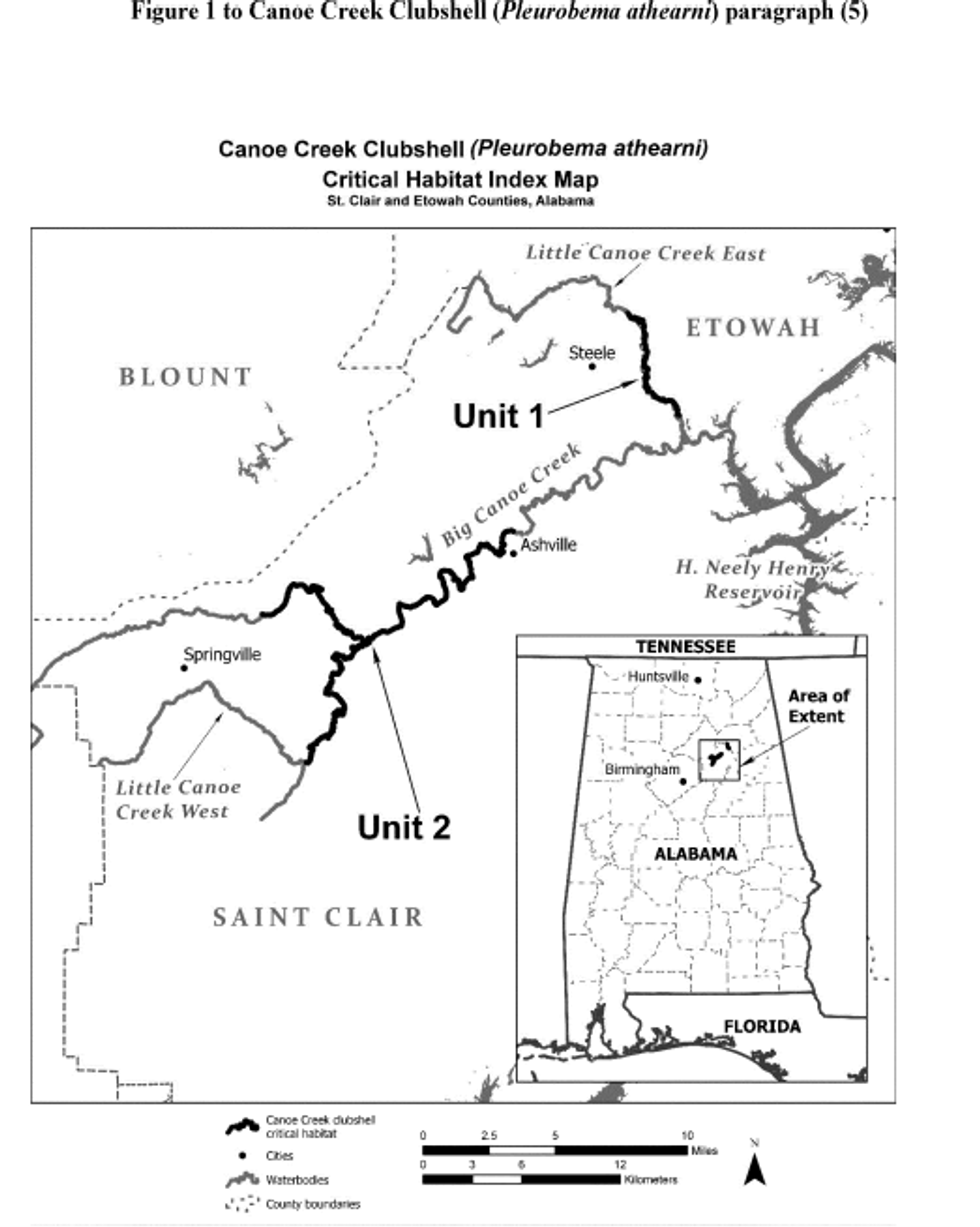
(6) Unit 1: Little Canoe Creek East, St. Clair and Etowah Counties, Alabama.
(i) Unit 1 consists of 9.7 river km (6.0 river mi) of Little Canoe Creek East, due east of the Town of Steele, in St. Clair and Etowah Counties, Alabama.
(ii) Map of Unit 1 follows:
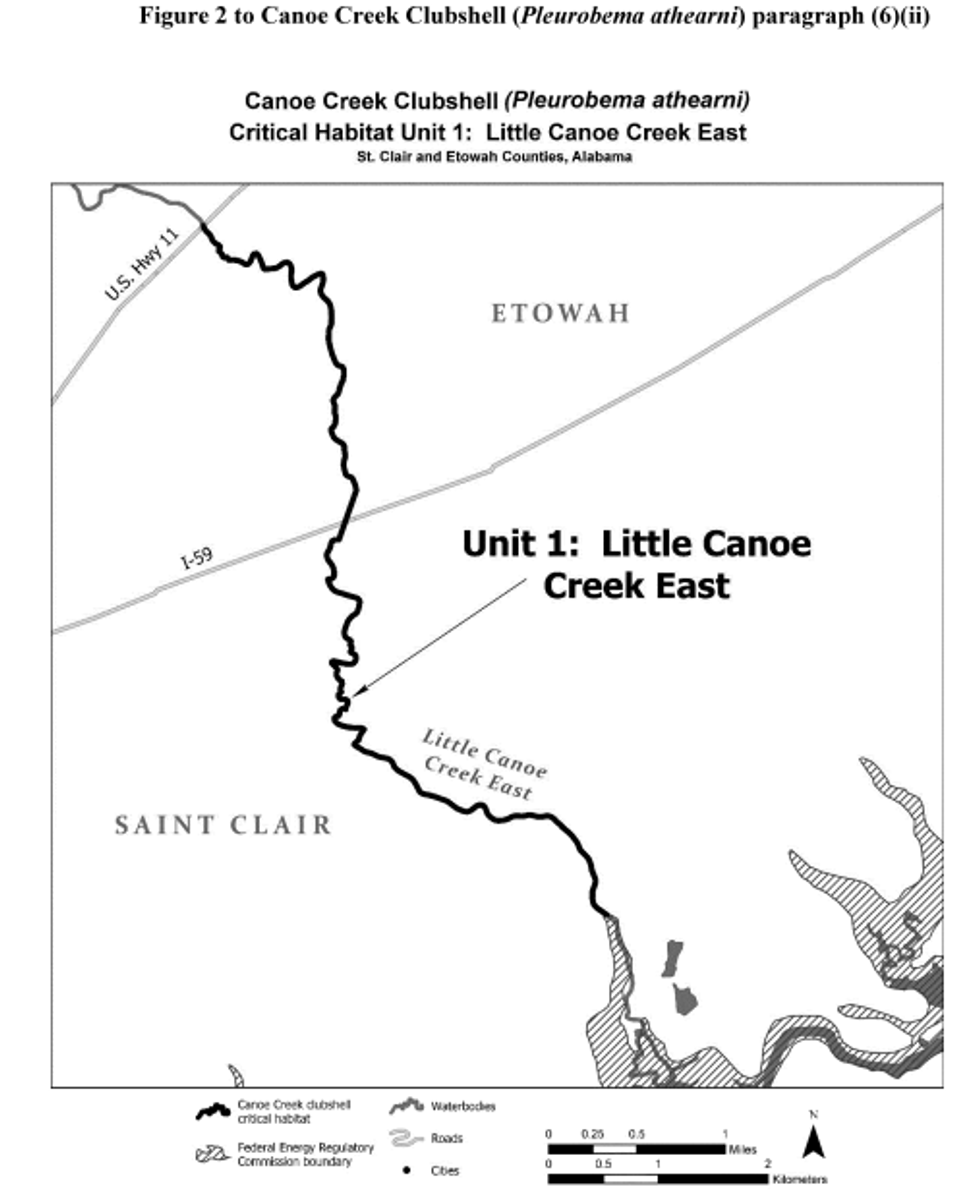
(7) Unit 2: Big Canoe Creek/Little Canoe Creek West, St. Clair County, Alabama.
(i) Unit 2 consists of 48.8 river km (30.3 river mi) of Big Canoe Creek and its tributary Little Canoe Creek West.
(ii) Map of Unit 2 follows:

Appalachian Elktoe (Alasmidonta raveneliana)
(1) Critical habitat units are described below and depicted in the maps that follow, with the lateral extent of each designated unit bounded by the ordinary high-water line. The maps provided are for informational purposes only.
(i) Index map follows:
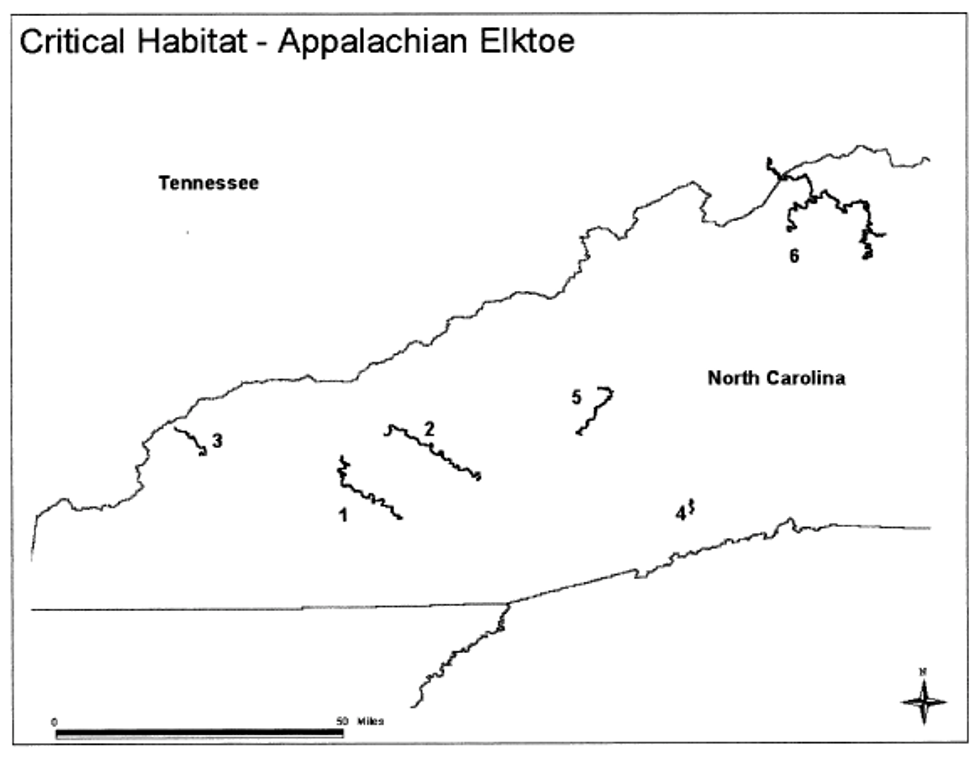
(2) Unit 1.
(i) Macon County and Swain County, NC - the main stem of the Little Tennessee River (Tennessee River system), from the Lake Emory Dam at Franklin, Macon County, NC, downstream to the backwaters of Fontana Reservoir in Swain County, NC.
(3) Unit 2.
(i) Jackson County and Swain County, NC - the main stem of the Tuckasegee River (Little Tennessee River system), from the N.C. State Route 1002 Bridge in Cullowhee, Jackson County, NC, downstream to the N.C. Highway 19 Bridge, north of Bryson City, Swain County, NC.
(ii) Map of Unit 1 and Unit 2 follows:
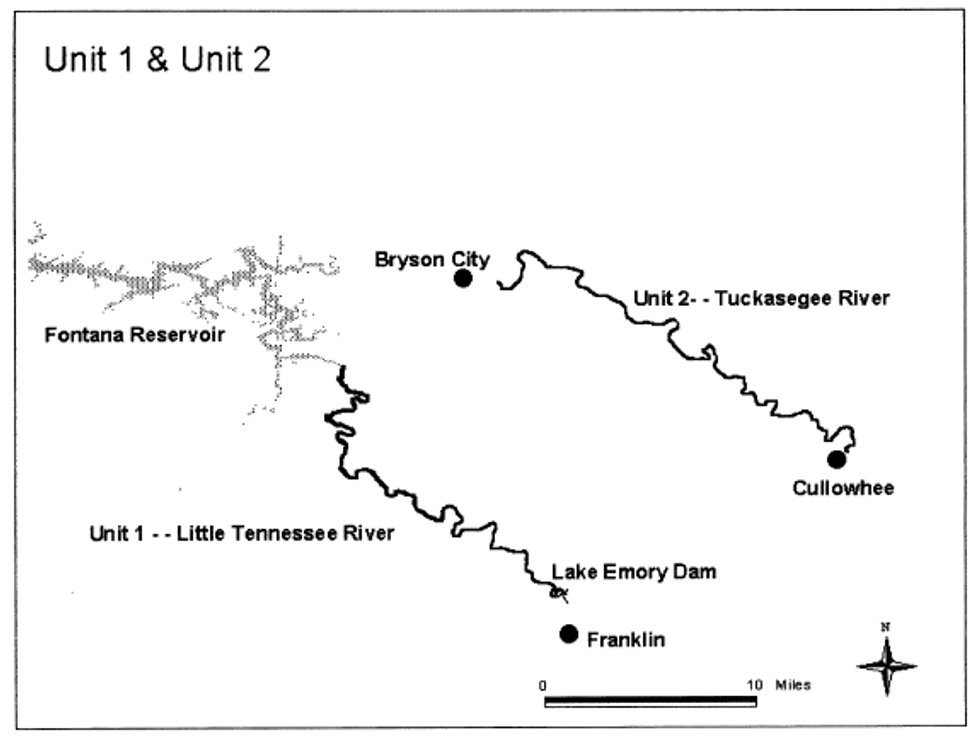
(4) Unit 3.
(i) Graham County, NC - the main stem of the Cheoah River (Little Tennessee River system), from the Santeetlah Dam, downstream to its confluence with the Little Tennessee River.
(ii) Map of Unit 3 follows:
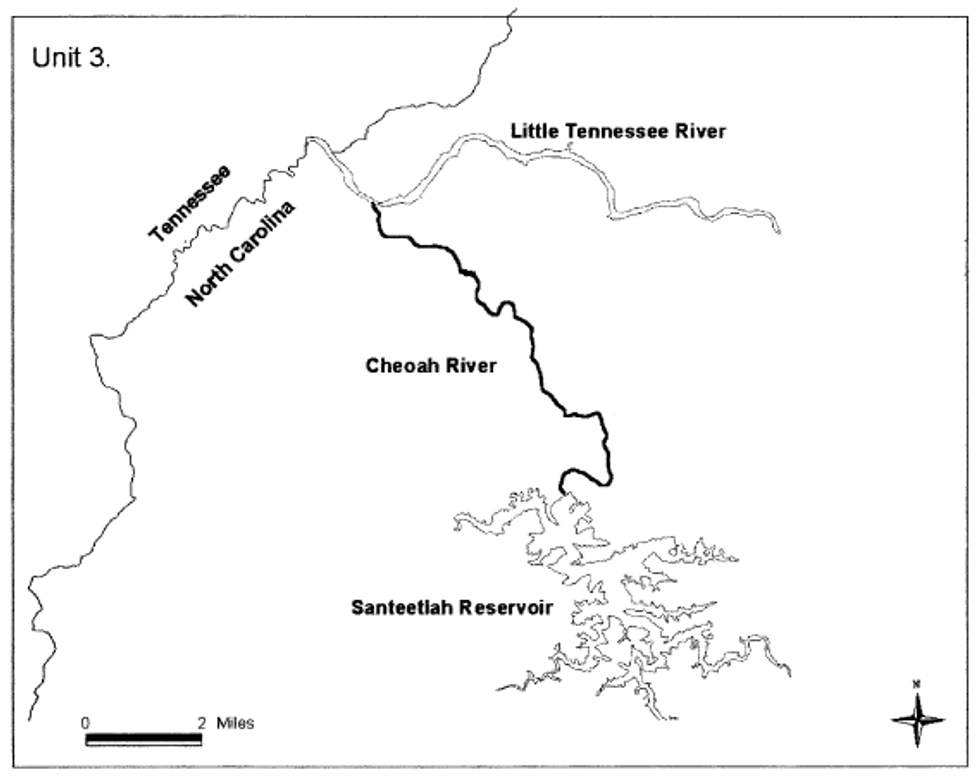
(5) Unit 4.
(i) Transylvania County, NC - the main stem of the Little River (French Broad River system), from the Cascade Lake Power Plant, downstream to its confluence with the French Broad River.
(ii) Map of Unit 4 follows:
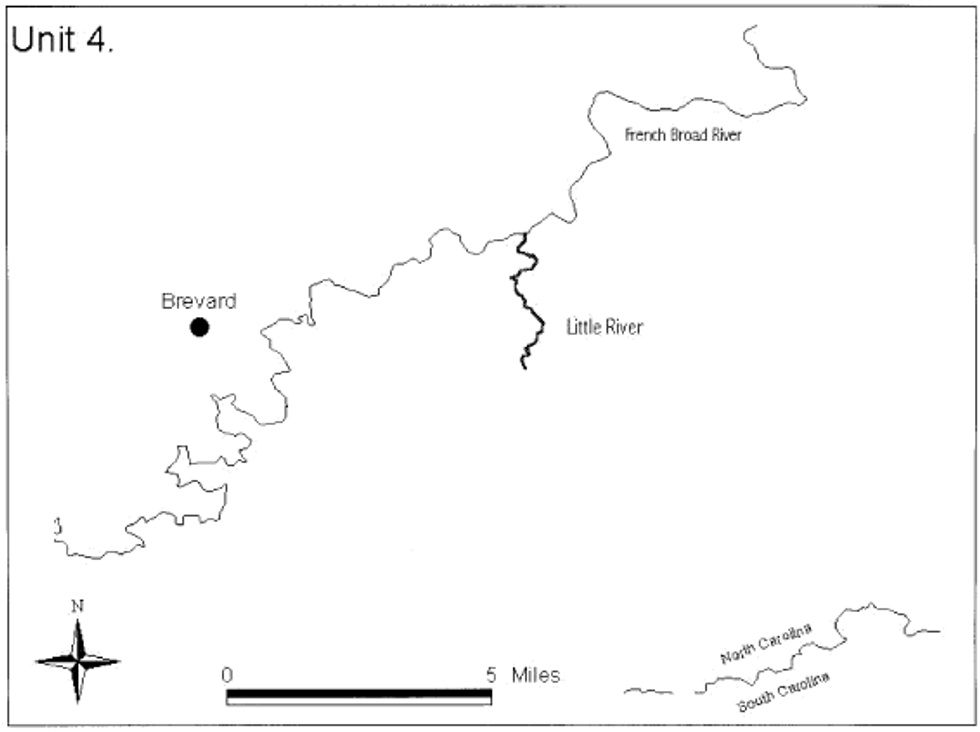
(6) Unit 5.
(i) Haywood County, NC - the main stem of the West Fork Pigeon River (French Broad River system), from the confluence of the Little East Fork Pigeon River, downstream to the confluence of the East Fork Pigeon River, and the main stem of the Pigeon River, from the confluence of the West Fork Pigeon River and the East Fork Pigeon River, downstream to the N.C. Highway 215 Bridge crossing, south of Canton, NC.
(ii) Map of Unit 5 follows:
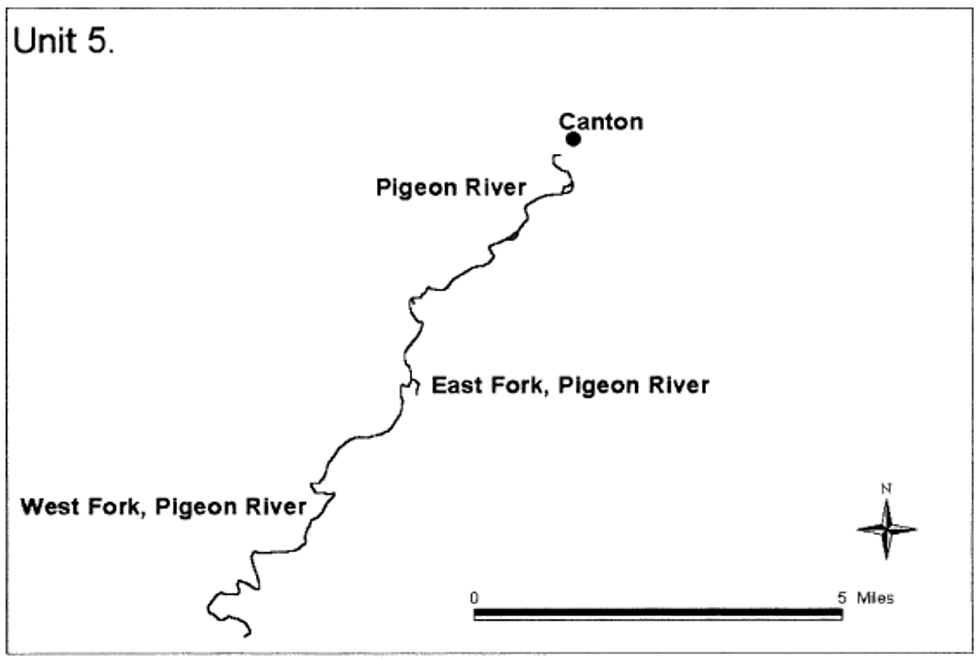
(7) Unit 6.
(i) Yancey County and Mitchell County, NC, and Unicoi County, TN - the main stem of the North Toe River, Yancey and Mitchell Counties, NC, from the confluence of Big Crabtree Creek, downstream to the confluence of the South Toe River; the main stem of the South Toe River, Yancey County, NC, from the N.C. State Route 1152 Bridge, downstream to its confluence with the North Toe River; the main stem of the Toe River, Yancey and Mitchell Counties, NC, from the confluence of the North Toe River and the South Toe River, downstream to the confluence of the Cane River; the main stem of the Cane River, Yancey County, NC, from the N.C. State Route 1381 Bridge, downstream to its confluence with the Toe River; and the main stem of the Nolichucky River from the confluence of the Toe River and the Cane River in Yancey County and Mitchell County, NC, downstream to the U.S. Highway 23/19W Bridge southwest of Erwin, Unicoi County, TN.
(ii) Map of Unit 6 follows:
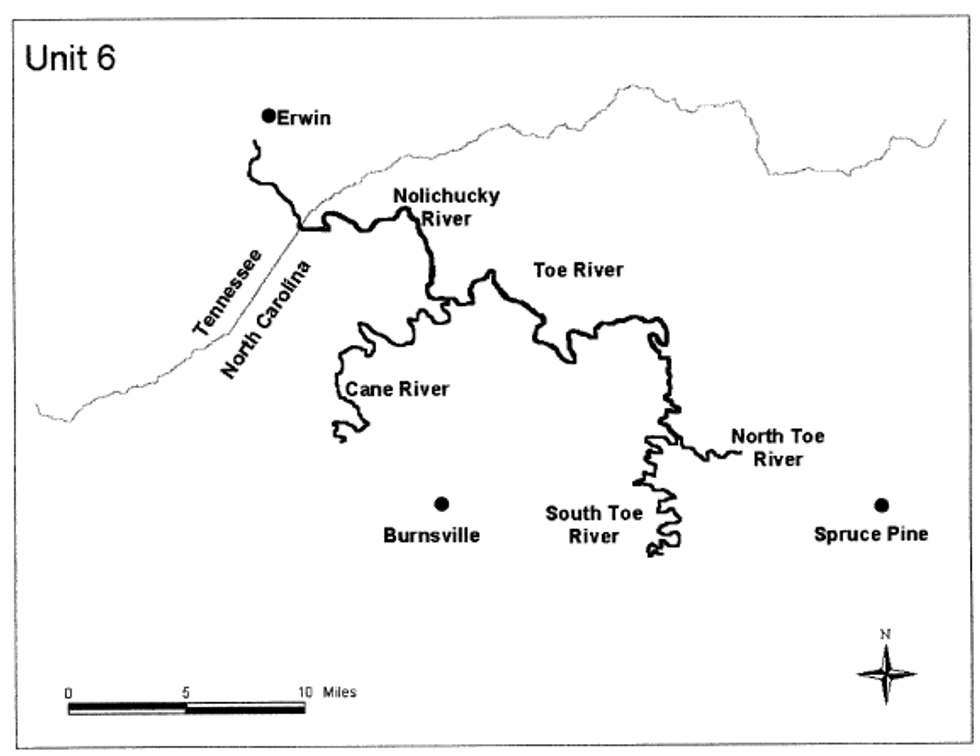
(8) Within these areas, the primary constituent elements include:
(i) Permanent, flowing, cool, clean water;
(ii) Geomorphically stable stream channels and banks;
(iii) Pool, riffle, and run sequences within the channel;
(iv) Stable sand, gravel, cobble, boulder, and bedrock substrates with no more than low amounts of fine sediment;
(v) Moderate to high stream gradient;
(vi) Periodic natural flooding; and
(vii) Fish hosts, with adequate living, foraging, and spawning areas for them.
Guadalupe Fatmucket (Lampsilis bergmanni)
(1) A critical habitat unit is depicted for Kendall and Kerr Counties, Texas, on the map in this entry.
(2) Within this area, the physical or biological features essential to the conservation of Guadalupe fatmucket consist of the following components within waters and streambeds up to the ordinary high-water mark:
(i) Flowing water at moderate to high rates with sufficient depth to remain sufficiently cool and oxygenated during low-flow periods;
(ii) Substrate including bedrock and boulder crevices, point bars, and vegetated run habitat comprising sand, gravel, and larger cobbles;
(iii) Green sunfish (Lepomis cyanellus), bluegill (L. macrochirus), largemouth bass (Micropterus salmoides), and Guadalupe bass (M. treculii) present; and
(iv) Water quality parameters within the following ranges:
(A) Dissolved oxygen greater than 2 milligrams per liter (mg/L);
(B) Salinity less than 2 parts per thousand;
(C) Total ammonia less than 0.77 mg/L total ammonia nitrogen;
(D) Water temperature below 29 °C (84.2 °F); and
(E) Low levels of contaminants.
(3) Critical habitat does not include manmade structures (such as buildings, aqueducts, runways, roads, and other paved areas) and the land on which they are located existing within the legal boundaries on July 5, 2024.
(4) Data layers defining the map unit were created on a base of U.S. Geological Survey digital ortho-photo quarter-quadrangles, and the critical habitat unit was then mapped using Universal Transverse Mercator (UTM) Zone 14N coordinates. The map in this entry, as modified by any accompanying regulatory text, establishes the boundaries of the critical habitat designation. The coordinates or plot points or both on which the map is based are available to the public at the Service's internet site at https://www.fws.gov/office/austin-ecological-services , at https://www.regulations.gov at Docket No. FWS-R2-ES-2019-0061, and at the field office responsible for this designation. You may obtain field office location information by contacting one of the Service regional offices, the addresses of which are listed at 50 CFR 2.2.
(5) Unit GUFM-1: Guadalupe River Unit; Kendall and Kerr Counties, Texas.
(i) Unit GUFM-1 consists of three subunits:
(A) Subunit GUFM-1a (North Fork Guadalupe River) consists of 6.9 river miles (mi) (11.0 kilometers (km)) in Kerr County, Texas. All of the riparian lands that border this subunit are in private ownership.
(B) Subunit GUFM-1b (Johnson Creek) consists of 10.1 river mi (16.3 km) in Kerr County, Texas. All of the riparian lands that border this subunit are in private ownership.
(C) Subunit GUFM-1c (Guadalupe River) consists of 35.2 river mi (56.7 km) in Kendall and Kerr Counties, Texas. This subunit is composed of lands in State/local government (7 percent) and private (93 percent) ownership.
(ii) Unit GUFM-1 includes stream channel up to bankfull height.
(iii) Map of Unit GUFM-1 follows:
Figure 1 to Guadalupe Fatmucket (Lampsilis bergmanni) paragraph (5)(iii)

Texas Fatmucket (Lampsilis bracteata)
(1) Critical habitat units are depicted for Blanco, Gillespie, Hays, Kimble, Llano, Mason, McCulloch, Menard, Runnels, San Saba, Sutton, and Travis Counties, Texas, on the maps in this entry.
(2) Within these areas, the physical or biological features essential to the conservation of Texas fatmucket consist of the following components within waters and streambeds up to the ordinary high-water mark:
(i) Flowing water at moderate to high rates with sufficient depth to remain sufficiently cool and oxygenated during low-flow periods;
(ii) Substrate including bedrock and boulder crevices, point bars, and vegetated run habitat comprising sand, gravel, and larger cobbles;
(iii) Green sunfish (Lepomis cyanellus), bluegill (L. macrochirus), largemouth bass (Micropterus salmoides), and Guadalupe bass (M. treculii) present; and
(iv) Water quality parameters within the following ranges:
(A) Dissolved oxygen greater than 2 milligrams per liter (mg/L);
(B) Salinity less than 2 parts per thousand;
(C) Total ammonia less than 0.77 mg/L total ammonia nitrogen;
(D) Water temperature below 29 °C (84.2 °F); and
(E) Low levels of contaminants.
(3) Critical habitat does not include manmade structures (such as buildings, aqueducts, runways, roads, and other paved areas) and the land on which they are located existing within the legal boundaries on July 5, 2024.
(4) Data layers defining the map units were created on a base of U.S. Geological Survey digital ortho-photo quarter-quadrangles, and the critical habitat units were then mapped using Universal Transverse Mercator (UTM) Zone 14N coordinates. The maps in this entry, as modified by any accompanying regulatory text, establish the boundaries of the critical habitat designation. The coordinates or plot points or both on which the maps are based are available to the public at the Service's internet site at https://www.fws.gov/office/austin-ecological-services , at https://www.regulations.gov at Docket No. FWS-R2-ES-2019-0061, and at the field office responsible for this designation. You may obtain field office location information by contacting one of the Service regional offices, the addresses of which are listed at 50 CFR 2.2.
(5) Index map of critical habitat units for the Texas fatmucket follows:
Figure 1 to Texas Fatmucket (Lampsilis bracteata) paragraph (5)

(6) Unit TXFM-1: Elm Creek Unit; Runnels County, Texas.
(i) Unit TXFM-1 consists of three subunits:
(A) Subunit TXFM-1a (Bluff Creek) consists of 11.6 river miles (mi) (18.7 river kilometers (km)) in Runnels County, Texas. All of the riparian lands that border this subunit are in private ownership.
(B) Subunit TXFM-1b (Lower Elm Creek) consists of 12.3 river mi (19.8 km) in Runnels County, Texas. This subunit is composed of lands in State/local government (3 percent) and private (97 percent) ownership.
(C) Subunit TXFM-1c (Upper Elm Creek) consists of 8.9 river mi (14.4 km) in Runnels County, Texas. All of the riparian lands that border this subunit are in private ownership.
(ii) Unit TXFM-1 includes stream channel up to bankfull height.
(iii) Map of Unit TXFM-1 follows:
Figure 2 to Texas Fatmucket (Lampsilis bracteata) paragraph (6)(iii)

(7) Unit TXFM-2: San Saba River Unit; Mason, McCulloch, Menard, and San Saba Counties, Texas.
(i) Unit TXFM-2 consists of 90.8 river mi (146.1 km) in Mason, McCulloch, Menard, and San Saba Counties, Texas. All of the riparian lands that border this unit are in private ownership.
(ii) Unit TXFM-2 includes stream channel up to bankfull height.
(iii) Map of TXFM-2 follows:
Figure 3 to Texas Fatmucket (Lampsilis bracteata) paragraph (7)(iii)

(8) Unit TXFM-3: Cherokee Creek Unit; San Saba County, Texas.
(i) Unit TXFM-3 consists of 17.8 river mi (28.6 km) in San Saba County, Texas. All of the riparian lands that border this unit are in private ownership.
(ii) Unit TXFM-3 includes stream channel up to bankfull height.
(iii) Map of Unit TXFM-3 follows:
Figure 4 to Texas Fatmucket (Lampsilis bracteata) paragraph (8)(iii)

(9) Unit TXFM-4: Llano River Unit; Gillespie, Kimble, Llano, Mason, and Sutton Counites, Texas.
(i) Unit TXFM-4 consists of six subunits:
(A) Subunit TXFM-4a (North Llano River) consists of 30.2 river mi (48.7 km) in Sutton and Kimble Counties, Texas. All of the riparian lands that border this subunit are in private ownership.
(B) Subunit TXFM-4b (South Llano River) consists of 22.5 river mi (36.2 km) in Kimble County, Texas. This subunit is composed of lands in State/local government (10 percent) and private (90 percent) ownership.
(C) Subunit TXFM-4c (Llano River) consists of 90.9 river mi (146.4 km) in Kimble, Llano, and Mason Counties, Texas. This subunit is composed of lands in State/local government (0.5 percent) and private (99.5 percent) ownership.
(D) Subunit TXFM-4d (James River) consists of 18.3 river mi (29.4 km) in Kimble and Mason Counties, Texas. All of the riparian lands that border this subunit are in private ownership.
(E) Subunit TXFM-4e (Threadgill Creek) consists of 8.1 river mi (13.1 km) in Gillespie and Mason Counties, Texas. All of the riparian lands that border this subunit are in private ownership.
(F) Subunit TXFM-4f (Beaver Creek) consists of 12.7 river mi (20.5 km) in Mason County, Texas. All of the riparian lands that border this subunit are in private ownership.
(ii) Unit TXFM-4 includes stream channel up to bankfull height.
(iii) Map of Unit TXFM-4 follows:
Figure 5 to Texas Fatmucket (Lampsilis bracteata) paragraph (9)(iii)

(10) Unit TXFM-5: Pedernales River Unit: Blanco, Gillespie, Hays, and Travis Counties, Texas.
(i) Unit TXFM-5 consists of two subunits:
(A) Subunit TXFM-5a (Pedernales River) consists of 78.2 river mi (125.8 km) in Blanco, Gillespie, Hays, and Travis Counties, Texas. This subunit is composed of lands in State/local government (10 percent), Federal Government (3 percent), and private (87 percent) ownership.
(B) Subunit TXFM-5b (Live Oak Creek) consists of 2.6 river mi (4.2 km) in Gillespie County, Texas. This subunit is composed of lands in State/local government (54 percent) and private (46 percent) ownership.
(ii) Unit TXFM-5 includes stream channel up to bankfull height.
(iii) Map of Unit TXFM-5 follows:
Figure 6 to Texas Fatmucket (Lampsilis bracteata) paragraph (10)(iii)

(11) Unit TXFM-6: Onion Creek Unit; Travis County, Texas.
(i) Unit TXFM-6 consists of 23.5 river mi (37.8 km) in Travis County, Texas. This subunit is composed of lands in State/local government (56 percent) and private (44 percent) ownership.
(ii) Unit TXFM-6 includes stream channel up to bankfull height.
(iii) Map of Unit TXFM-6 follows:
Figure 7 to Texas Fatmucket (Lampsilis bracteata) paragraph (11)(iii)

Texas Fawnsfoot (Truncilla macrodon)
(1) Critical habitat units are depicted for Lampasas, Mills, Palo Pinto, Parker, San Saba, Shackelford, Stephens, and Throckmorton Counties, Texas, on the maps in this entry.
(2) Within these areas, the physical or biological features essential to the conservation of Texas fawnsfoot consist of the following components within waters and streambeds up to the ordinary high-water mark:
(i) Flowing water at rates suitable to prevent excess sedimentation but not so high as to dislodge individuals or sediment;
(ii) Stable bank and riffle habitats with gravel, sand, silt, and mud substrates that are clean swept by flushing flows;
(iii) Freshwater drum (Aplodinotus grunniens) present; and
(iv) Water quality parameters within the following ranges:
(A) Dissolved oxygen greater than 2 milligrams per liter (mg/L);
(B) Salinity less than 2 parts per thousand;
(C) Total ammonia less than 0.77 mg/L total ammonia nitrogen;
(D) Water temperature below 29 °C (84.2 °F); and
(E) Low levels of contaminants.
(3) Critical habitat does not include manmade structures (such as buildings, aqueducts, runways, roads, and other paved areas) and the land on which they are located existing within the legal boundaries on July 5, 2024.
(4) Data layers defining the map units were created on a base of U.S. Geological Survey digital ortho-photo quarter-quadrangles, and the critical habitat units were then mapped using Universal Transverse Mercator (UTM) Zone 14N coordinates. The maps in this entry, as modified by any accompanying regulatory text, establish the boundaries of the critical habitat designation. The coordinates or plot points or both on which the maps are based are available to the public at the Service's internet site at https://www.fws.gov/office/austin-ecological-services , at https://www.regulations.gov at Docket No. FWS-R2-ES-2019-0061, and at the field office responsible for this designation. You may obtain field office location information by contacting one of the Service regional offices, the addresses of which are listed at 50 CFR 2.2.
(5) Index map of critical habitat units for the Texas fawnsfoot follows:
Figure 1 to Texas Fawnsfoot (Truncilla macrodon) paragraph (5)

(6) Unit TXFF-1: Clear Fork of the Brazos River Unit; Shackelford, Stephens, and Throckmorton Counties, Texas.
(i) Unit TXFF-1 consists of two subunits:
(A) Subunit TXFF-1a (Upper Clear Fork Brazos River) consists of 27.3 river miles (mi) (44.0 kilometers (km)) in Shackelford and Throckmorton Counties, Texas. All of the riparian lands that border this subunit are in private ownership.
(B) Subunit TXFF-1b (Lower Clear Fork Brazos River) consists of 27.9 river mi (45.0 km) in Shackelford and Stephens Counties, Texas. This subunit is composed of lands in State/local government (1 percent) and private (99 percent) ownership.
(ii) Unit TXFF-1 includes stream channel up to bankfull height.
(iii) Map of Unit TXFF-1 follows:
Figure 2 to Texas Fawnsfoot (Truncilla macrodon) paragraph (6)(iii)

(7) Unit TXFF-2: Upper Brazos River Unit; Palo Pinto and Parker Counties, Texas.
(i) Unit TXFF-2 consists of 78.0 river mi (125.5 km) in Palo Pinto and Parker Counties, Texas. All of the riparian lands that border this unit are in private ownership.
(ii) Unit TXFF-2 includes stream channel up to bankfull height.
(iii) Map of Unit TXFF-2 follows:
Figure 3 to Texas Fawnsfoot (Truncilla macrodon) paragraph (7)(iii)

(8) Units TXFF-3 and TXFF-4 are excluded from the designation pursuant to section 4(b)(2) of the Act.
(9) Unit TXFF-5: Lower San Saba River and Upper Colorado River Unit; Lampasas, Mills, and San Saba Counties, Texas.
(i) Unit TXFF-5 consists of two subunits:
(A) Subunit TXFF-5a (Lower San Saba River) consists of 49.2 river mi (79.1 km) in San Saba County, Texas. The riparian lands that border this subunit are in State/local government (1 percent) and private (99 percent) ownership.
(B) Subunit TXFF-5b (Upper Colorado River) consists of 10.3 river mi (16.6 km) in Lampasas, Mills, and San Saba Counties, Texas. All of the riparian lands that border this unit are in private ownership.
(ii) Unit TXFF-5 includes stream channel up to bankfull height.
(iii) Map of Unit TXFF-5 follows:
Figure 4 to Texas Fawnsfoot (Truncilla macrodon) paragraph (9)(iii)

Carolina Heelsplitter (Lasmigona decorata)
(1) Critical habitat units are described below and depicted in the maps that follow, with the lateral extent of each designated unit bounded by the ordinary high-water line. The maps provided are for informational purposes only.
(2) Unit 1.
(i) Union County, NC - main stem of Goose Creek (Pee Dee River system) from the N.C. Highway 218 Bridge, downstream to its confluence with the Rocky River, and the main stem of Duck Creek, from the Mecklenburg/Union County line, downstream to its confluence with Goose Creek.
(ii) Map of Unit 1 follows:
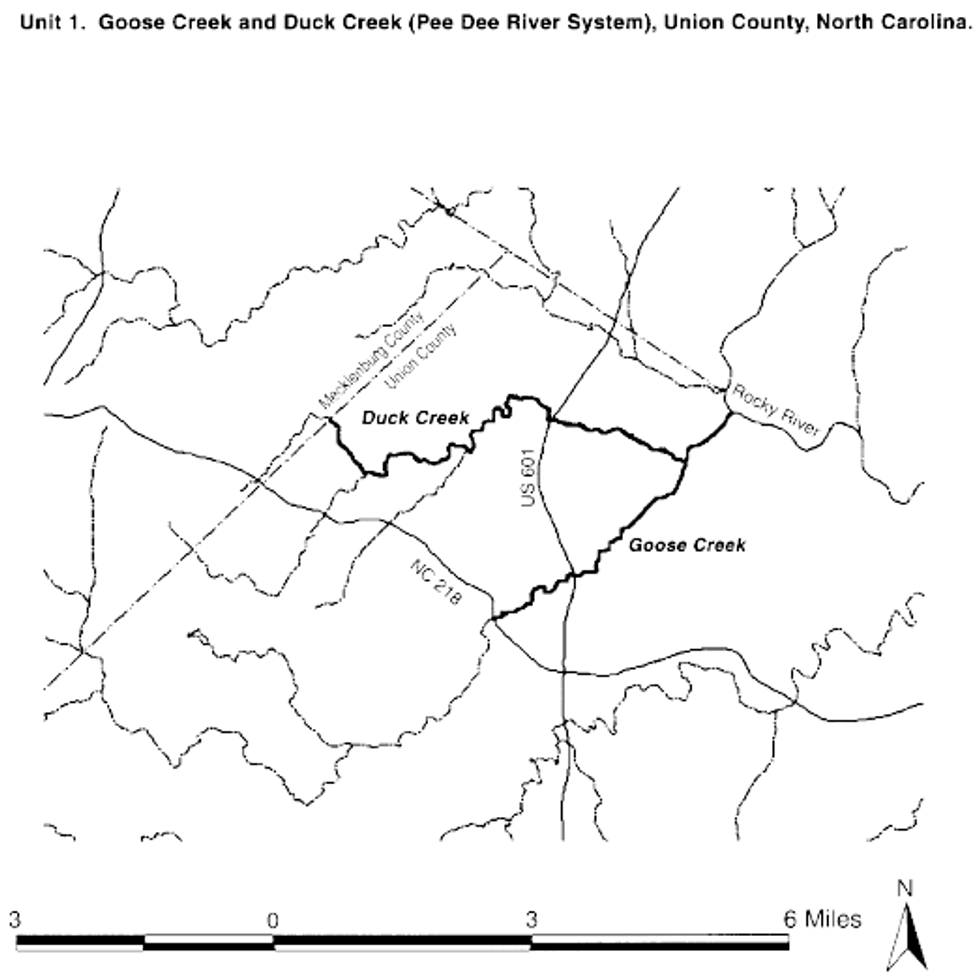
(3) Unit 2.
(i) Union County, NC - main stem of Waxhaw Creek (Catawba River system) from the N.C. Highway 200 Bridge, downstream to the North Carolina/South Carolina State line.
(ii) Map of Unit 2 follows:
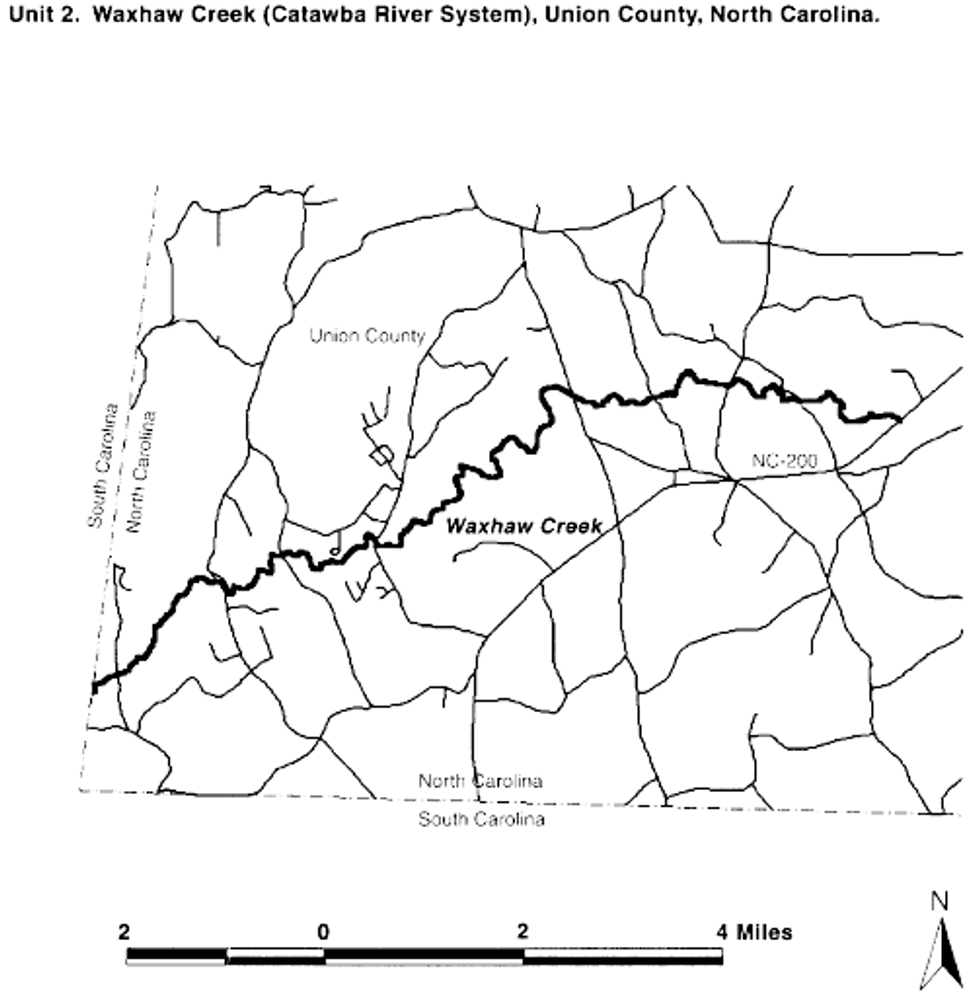
(4) Unit 3.
(i) Lancaster County, SC - main stem of Gills Creek (Catawba River system) from the County Route S-29-875, downstream to the S.C. Route 51 Bridge, east of the city of Lancaster.
(ii) Map of Unit 3 follows:
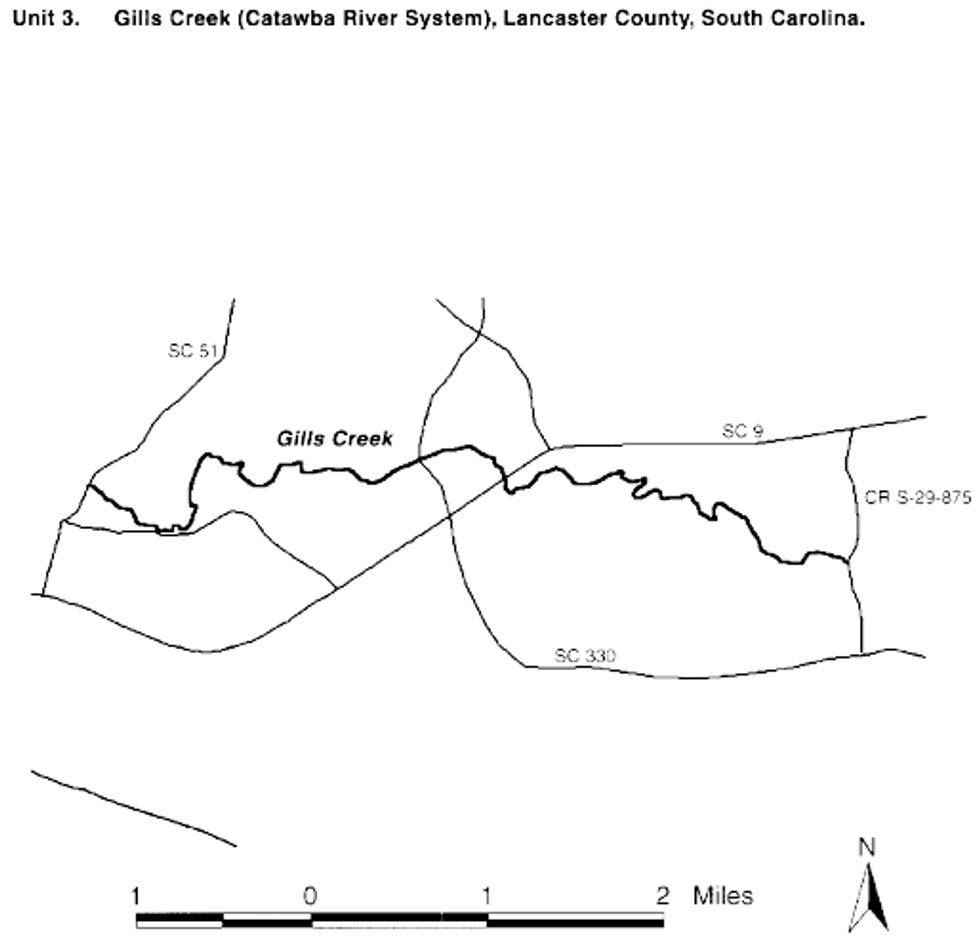
(5) Unit 4.
(i) Lancaster, Chesterfield, and Kershaw Counties, SC - main stem of Flat Creek (Pee Dee River system), Lancaster County, from the S.C. Route 204 Bridge, downstream to its confluence with Lynches River, and the main stem of the Lynches River, Lancaster and Chesterfield Counties, from the confluence of Belk Branch, Lancaster County, northeast (upstream) of the U.S. Highway 601 Bridge, downstream to the S.C. Highway 903 Bridge in Kershaw County.
(ii) Map of Unit 4 follows:
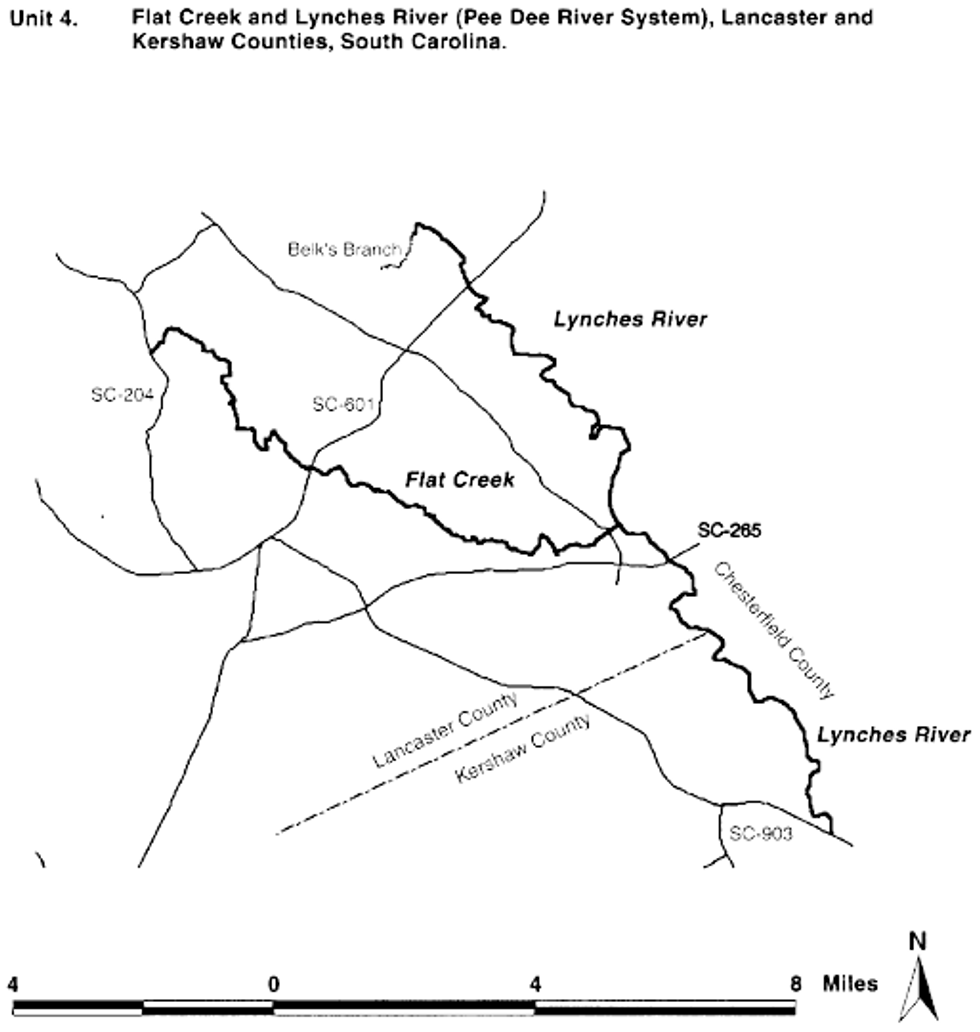
(6) Unit 5.
(i) Edgefield and McCormick Counties, SC - main stem of Mountain Creek (Savannah River system), Edgefield County, SC, from the S.C. Route 36 Bridge, downstream to its confluence with Turkey Creek; Beaverdam Creek, Edgefield County, from the S.C. Route 51 Bridge, downstream to its confluence with Turkey Creek; and Turkey Creek, from the S.C. Route 36 Bridge, Edgefield County, downstream to the S.C. Route 68 Bridge, Edgefield and McCormick Counties.
(ii) Map of Unit 5 follows:
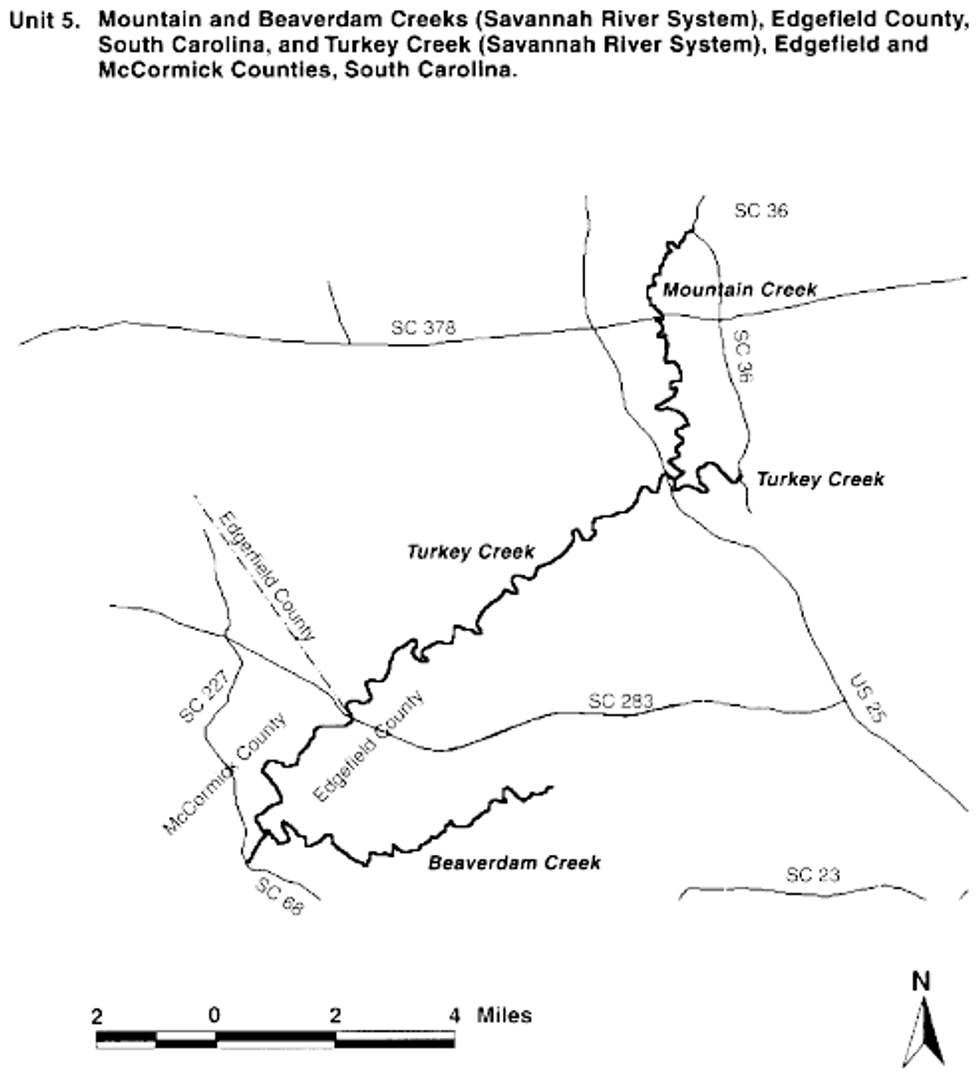
(7) Unit 6.
(i) Greenwood and McCormick Counties, SC - main stem of Cuffytown Creek (Savannah River system), from the confluence of Horsepen Creek, northeast (upstream) of the S.C. Route 62 Bridge in Greenwood County, downstream to the U.S. Highway 378 Bridge in McCormick County.
(ii) Map of Unit 6 follows:
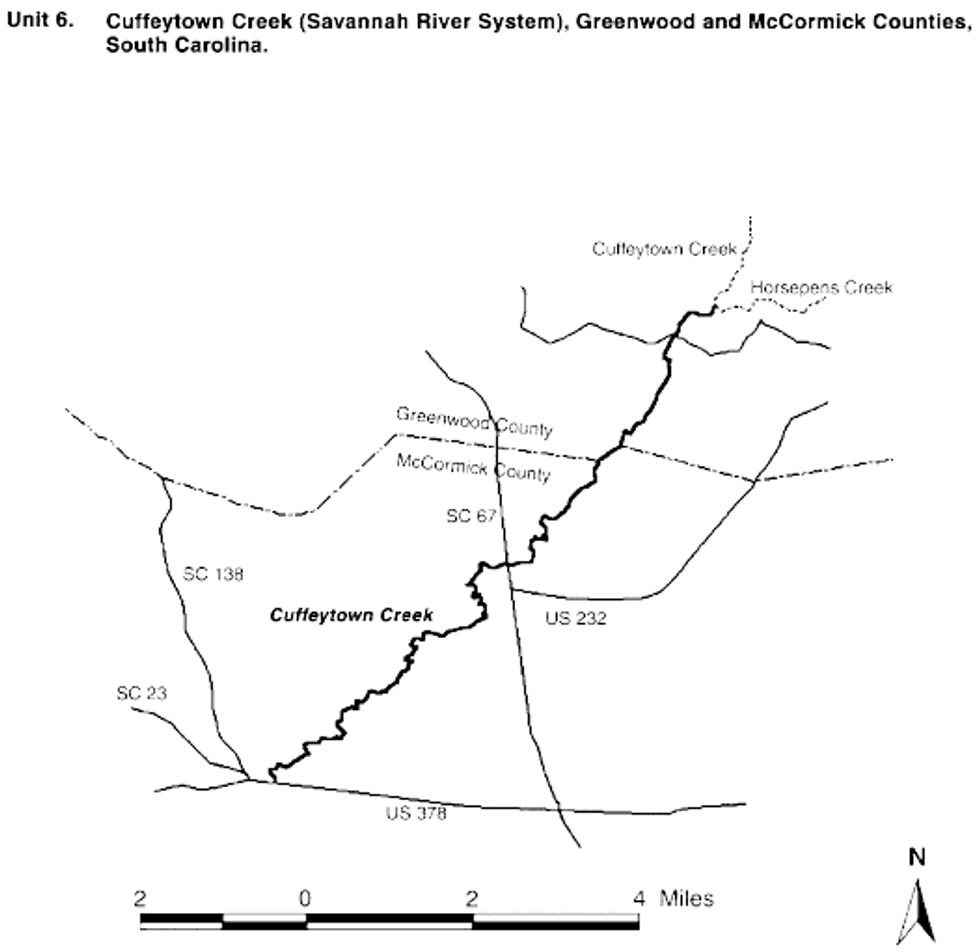
(8) Within these areas, the primary constituent elements include:
(i) Permanent, flowing, cool, clean water;
(ii) Geomorphically stable stream and river channels and banks;
(iii) Pool, riffle, and run sequences within the channel;
(iv) Stable substrates with no more than low amounts of fine sediment;
(v) Moderate stream gradient;
(vi) Periodic natural flooding; and
(vii) Fish hosts, with adequate living, foraging, and spawning areas for them.
Guadalupe Orb (Cyclonaias necki)
(1) Critical habitat units are depicted for Caldwell, Comal, DeWitt, Gonzales, Guadalupe, Kendall, Kerr, and Victoria Counties, Texas, on the maps in this entry.
(2) Within these areas, the physical or biological features essential to the conservation of Guadalupe orb consist of the following components within waters and streambeds up to the ordinary high-water mark:
(i) Flowing water at rates suitable to keep riffle habitats wetted and well-oxygenated and to prevent excess sedimentation or scour during high-flow events but not so high as to dislodge individuals;
(ii) Stable riffles and runs with substrate composed of cobble, gravel, and fine sediments;
(iii) Channel catfish (Ictalurus punctatus), flathead catfish (Pylodictis olivaris), and tadpole madtom (Noturus gyrinus) present; and
(iv) Water quality parameters within the following ranges:
(A) Dissolved oxygen greater than 2 milligrams per liter (mg/L);
(B) Salinity less than 2 parts per thousand;
(C) Total ammonia less than 0.77 mg/L total ammonia nitrogen;
(D) Water temperature below 29 °C (84.2 °F); and
(E) Low levels of contaminants.
(3) Critical habitat does not include manmade structures (such as buildings, aqueducts, runways, roads, and other paved areas) and the land on which they are located existing within the legal boundaries on July 5, 2024.
(4) Data layers defining the map units were created on a base of U.S. Geological Survey digital ortho-photo quarter-quadrangles, and the critical habitat units were then mapped using Universal Transverse Mercator (UTM) Zone 14N coordinates. The maps in this entry, as modified by any accompanying regulatory text, establish the boundaries of the critical habitat designation. The coordinates or plot points or both on which the maps are based are available to the public at the Service's internet site at https://www.fws.gov/office/austin-ecological-services , at https://www.regulations.gov at Docket No. FWS-R2-ES-2019-0061, and at the field office responsible for this designation. You may obtain field office location information by contacting one of the Service regional offices, the addresses of which are listed at 50 CFR 2.2.
(5) Index map of critical habitat units for the Guadalupe orb follows:
Figure 1 to Guadalupe Orb (Cyclonaias necki) paragraph (5)

(6) Unit GORB-1: Upper Guadalupe River; Comal, Kendall, and Kerr Counties, Texas.
(i) Unit GORB-1 consists of two subunits:
(A) Subunit GORB-1a (South Fork Guadalupe River) consists of 5.1 river miles (mi) (8.2 kilometers (km)) in Kerr County, Texas. All of the riparian lands that border this unit are in private ownership.
(B) Subunit GORB-1b (Upper Guadalupe River) consists of 97.1 river mi (156.3 km) of the Guadalupe River in Comal, Kendall, and Kerr Counties, Texas. The riparian lands that border this subunit are in State/local government (5 percent) and private (95 percent) ownership.
(ii) Unit GORB-1 includes stream channel up to bankfull height.
(iii) Map of Unit GORB-1 follows:
Figure 2 to Guadalupe Orb (Cyclonaias necki) paragraph (6)(iii)

(7) Unit GORB-2: Lower Guadalupe River; Caldwell, DeWitt, Gonzales, Guadalupe, and Victoria Counties, Texas.
(i) Unit GORB-2 consists of two subunits:
(A) Subunit GORB-2a (San Marcos River) consists of 63.9 river mi (102.8 km) in Caldwell, Gonzales, and Guadalupe Counties, Texas. The riparian lands that border this subunit are in State/local government (6 percent) and private (94 percent) ownership.
(B) Subunit GORB-2b (Lower Guadalupe River) consists of 122.4 river mi (197.0 km) in DeWitt, Gonzales, and Victoria Counties, Texas. The riparian lands that border this subunit are in State/local government (5 percent) and private (95 percent) ownership.
(ii) Unit GORB-2 includes stream channel up to bankfull height.
(iii) Map of Unit GORB-2 follows:
Figure 3 to Guadalupe Orb (Cyclonaias necki) paragraph (7)(iii)

“Ouachita” Fanshell (Cyprogenia cf. aberti)
(1) Critical habitat units are depicted for Ashley, Bradley, Clark, Cleveland, Dallas, Drew, Grant, Nevada, and Ouachita Counties, Arkansas, on the maps in this entry.
(2) Within these areas, the physical or biological features essential to the conservation of “Ouachita” fanshell consist of the following components:
(i) Adequate flows, or a hydrologic flow regime (magnitude, timing, frequency, duration, rate of change, and overall seasonality of discharge over time), necessary to maintain benthic habitats where the species is found and to maintain stream connectivity, specifically providing for the exchange of nutrients and sediment for maintenance of the mussel's and fish hosts' habitat and food availability, maintenance of spawning habitat for native host fishes, and the ability for newly transformed juveniles to settle and become established in their habitats. Adequate flows ensure delivery of oxygen, enable reproduction, deliver food to filter-feeding mussels, and reduce contaminants and fine sediments from interstitial spaces.
(ii) Suitable substrates and connected instream habitats, characterized by geomorphically stable stream channels and banks (that is, channels that maintain lateral dimensions, longitudinal profiles, and sinuosity patterns over time without an aggrading or degrading bed elevation) with habitats that support adiversity of freshwater mussel and native fish (such as stable riffle-run-pool habitats that provide flow refuges consisting of silt-free gravel and coarse sand substrates).
(iii) Water and sediment quality necessary to sustain natural physiological processes for normal behavior, growth, and viability of all life stages, including, but not limited to, dissolved oxygen (generally above 3 parts per million (ppm)) and water temperature (generally below 80 degrees Fahrenheit (°F) (27 degrees Celsius (°C)). Additionally, water and sediment should be low in ammonia (generally below 1.0 ppm total ammonia-nitrogen) and heavy metals, and lack excessive total suspended solids and other pollutants.
(iv) The presence and abundance of fish hosts necessary for recruitment of the “Ouachita” fanshell, including logperch (Percina caprodes), slenderhead darter (Percina phoxocephala), or orangebelly darter (Etheostoma radiosum).
(3) Critical habitat does not include manmade structures (such as buildings, aqueducts, runways, roads, and other paved areas) and the land on which they are located existing within the legal boundaries on July 27, 2023.
(4) Data layers defining map units were created by overlaying Natural Heritage Element Occurrence data and U.S. Geological Survey hydrologic data for stream reaches using ESRI ArcGIS mapping software. Critical habitat unit upstream and downstream limits were delineated at the nearest road crossing or stream confluence of each occupied reach. Data layers defining map units were created with U.S. Geological Survey National Hydrography Dataset (NHD) Medium Flowline data. ArcGIS was also used to calculate river kilometers and river miles from the NHD dataset, and it was used to determine longitude and latitude coordinates in decimal degrees. The projection used in mapping and calculating distances and locations within the units was EPSG:4269–NAD83 Geographic. Natural Heritage program and State mussel database species presence data from Arkansas were used to select specific river and stream segments for inclusion in the critical habitat layer. The maps in this entry, as modified by any accompanying regulatory text, establish the boundaries of the critical habitat designation. The coordinates or plot points or both on which each map is based are available to the public at the Service's internet site at https://www.fws.gov/species/ouachita-fanshell-cyprogenia-sp-cf-aberti, at https://www.regulations.gov at Docket No. FWS–R3–ES–2021–0061, and at the field office responsible for this designation. You may obtain field office location information by contacting one of the Service regional offices, the addresses of which are listed at 50 CFR 2.2.
(5) Index map for “Ouachita” fanshell critical habitat units follows:
Figure 1 to “Ouachita” Fanshell (Cyprogenia cf. aberti) paragraph (5)
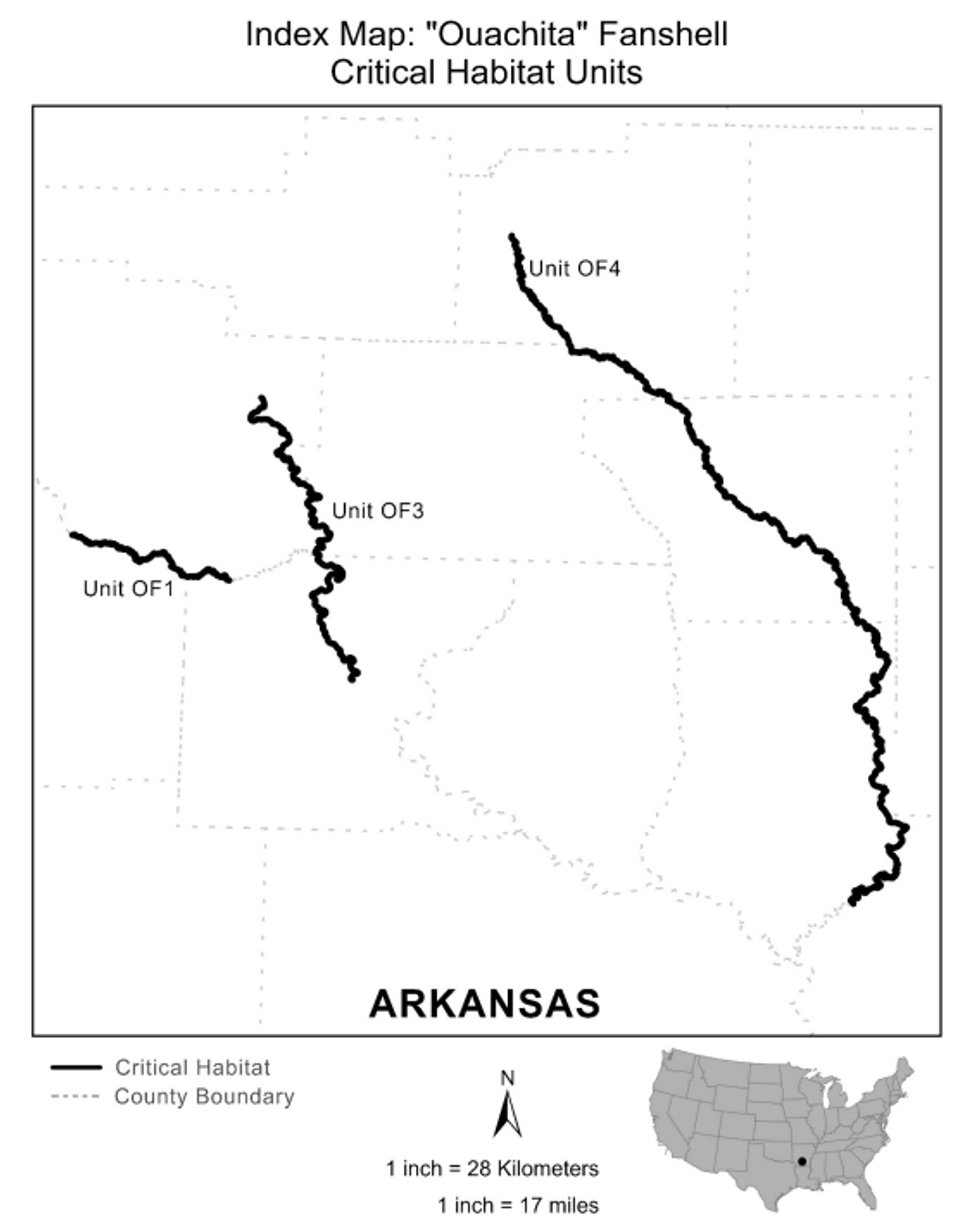
(6) Unit OF 1: Little Missouri River; Clark, Nevada, and Ouachita Counties, Arkansas.
(i) Unit OF 1 consists of 22.9 river miles (mi) (36.9 kilometers (km)) of Little Missouri River in Clark, Nevada, and Ouachita Counties, Arkansas, from the mouth of Garland Creek northeast of Prescott, Nevada County, downstream to the mouth of Horse Branch north of Red Hill, Ouachita County. Unit OF 1 includes the river channel up to the ordinary high water mark. Approximately 100 percent of the riparian lands that border the unit are in private ownership.
(ii) Map of Unit OF 1 follows:
Figure 2 to “Ouachita” Fanshell (Cyprogenia cf. aberti) paragraph (6)(ii)
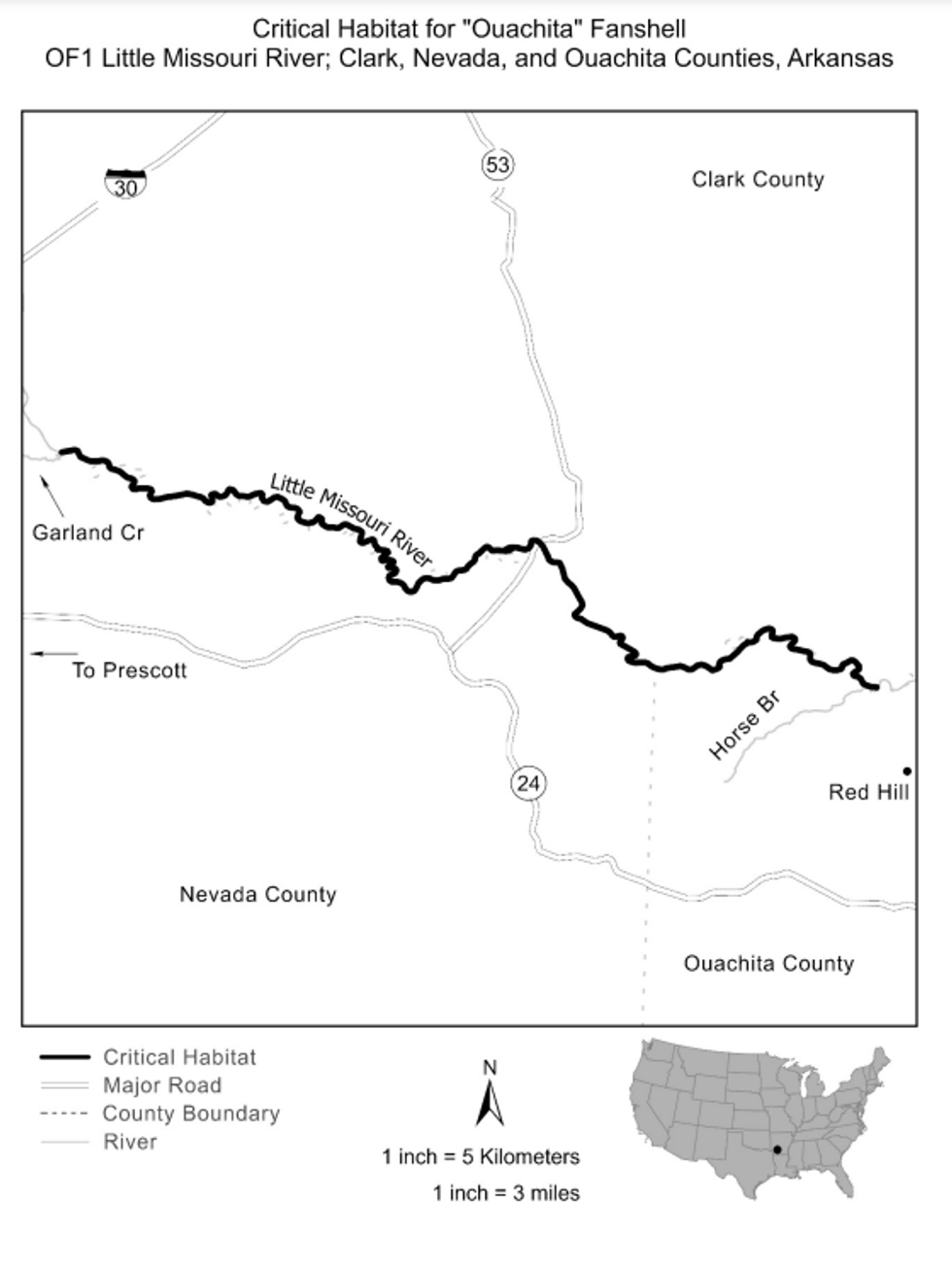
(7) Unit OF 2 has been excluded from this critical habitat designation.
(8) Unit OF 3: Ouachita River; Clark, Dallas, and Ouachita Counties, Arkansas.
(i) Unit OF 3 consists of 53.5 river mi (86.1 km) of Ouachita River in Clark, Dallas, and Ouachita Counties, Arkansas, from the mouth of L'Eau Frais Creek southeast of Arkadelphia, Clark County, downstream to the mouth of Ecore Fabre Bayou north of Camden, Ouachita County. Unit OF 3 includes the river channel up to the ordinary high water mark. Approximately 100 percent of the riparian lands that border the unit are in private ownership. There is a Wetlands Reserve Program easement within the unit.
(ii) Map of Unit OF 3 follows:
Figure 3 to “Ouachita” Fanshell (Cyprogenia cf. aberti) paragraph (8)(ii)
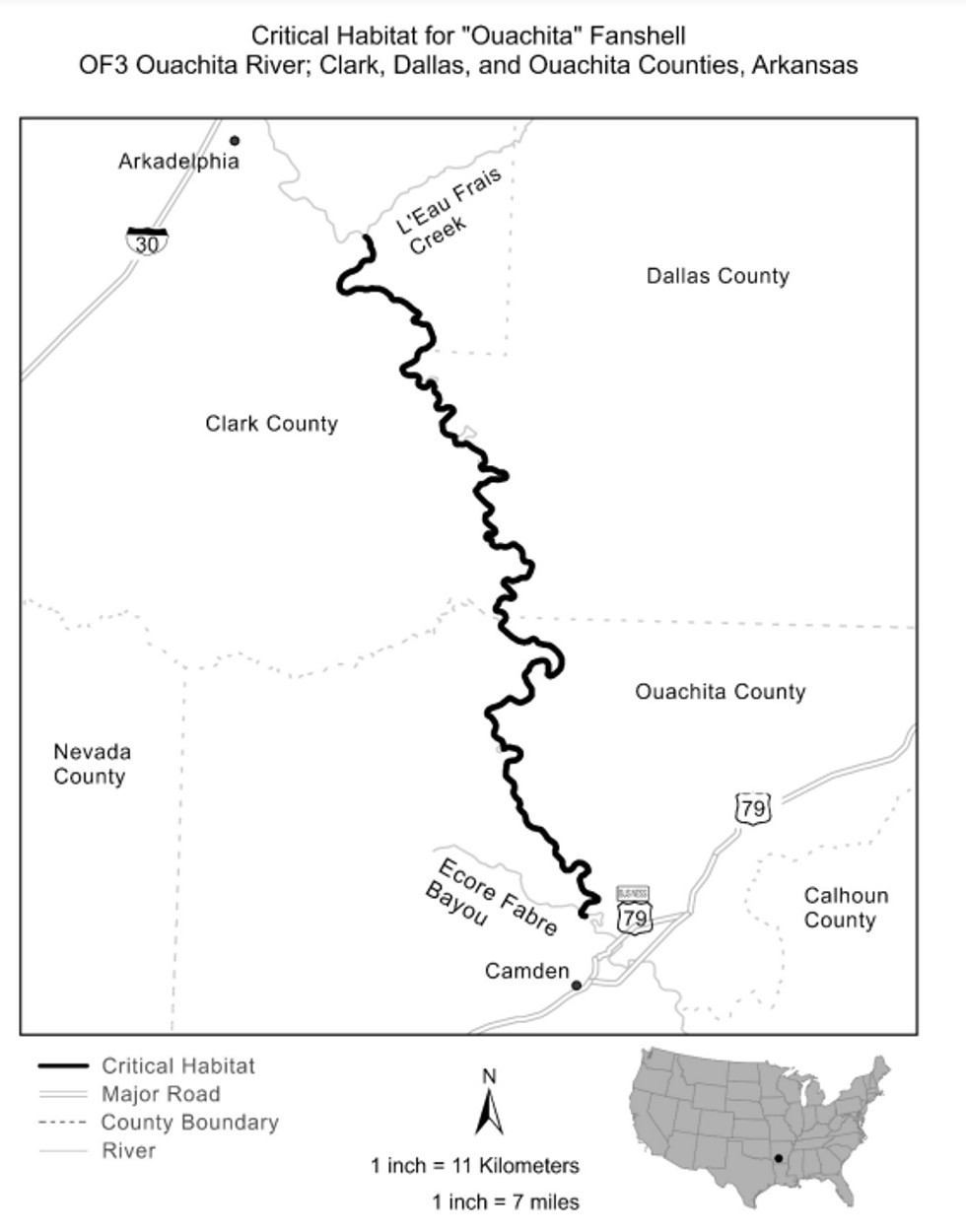
(9) Unit OF 4: Saline River; Ashley, Bradley, Cleveland, Dallas, Drew, and Grant Counties, Arkansas.
(i) Unit OF 4 consists of 151.3 river mi (243.5 km) of Saline River in Ashley, Bradley, Cleveland, Dallas, Drew, and Grant Counties, Arkansas, from U.S. Highway 270 east of Poyen, Grant County, downstream to the mouth of Mill Creek north of Stillions, Ashley County. Unit OF 4 includes the river channel up to the ordinary high water mark. Approximately 100 percent of the riparian lands that border the unit are in private ownership, and less than 1 percent is in public ownership. The public ownership in this unit is State-owned land associated with Jenkins Ferry State Park.
(ii) Map of Unit OF 4 follows:
Figure 4 to “Ouachita” Fanshell (Cyprogenia cf. aberti) paragraph (9)(ii)
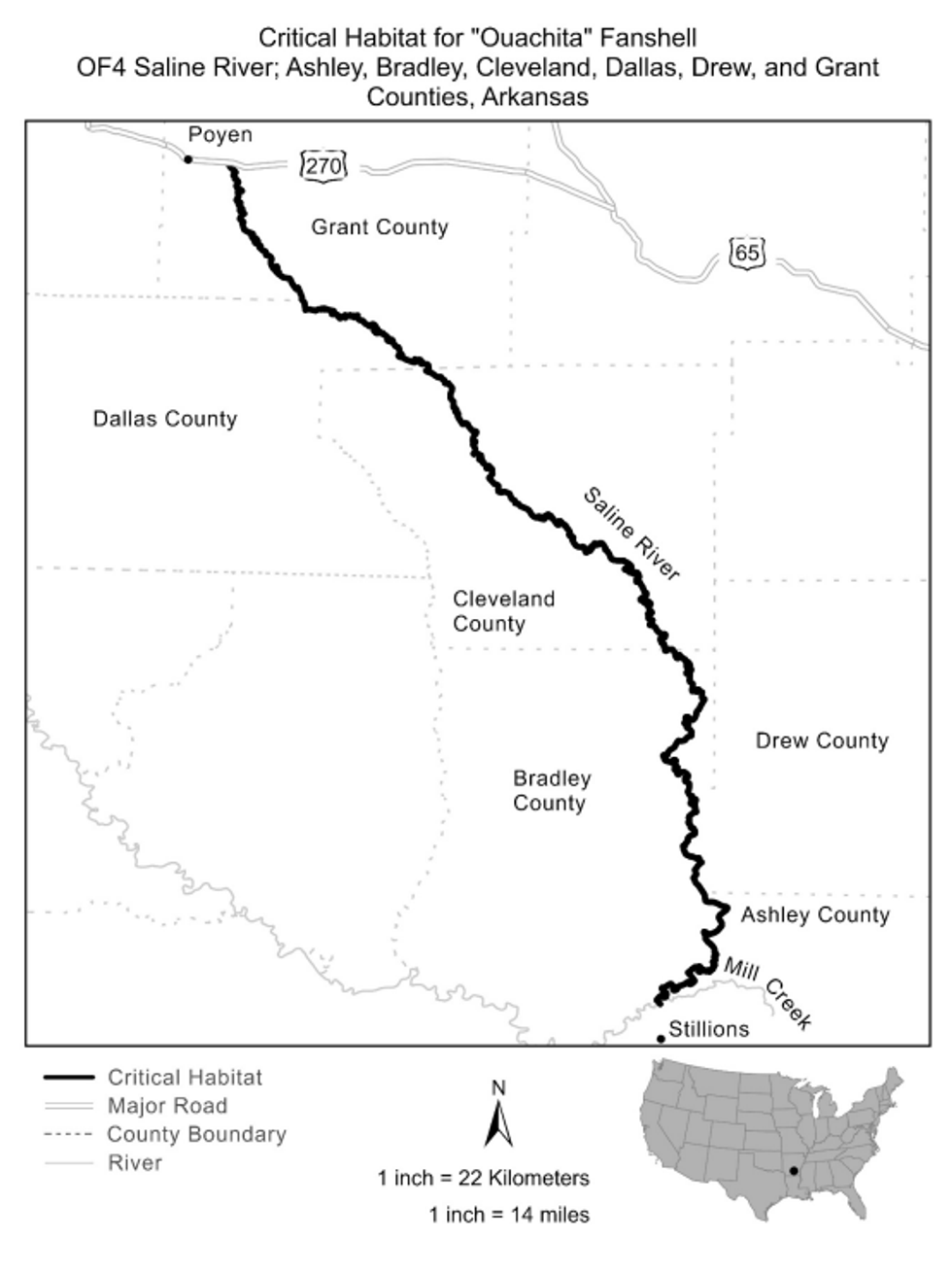
Western Fanshell (Cyprogenia aberti)
(1) Critical habitat units are depicted for Fulton, Independence, Jackson, Lawrence, Randolph, and Sharp Counties, Arkansas, and Butler, Jasper, Madison, and Wayne Counties, Missouri, on the maps in this entry.
(2) Within these areas, the physical or biological features essential to the conservation of western fanshell consist of the following components:
(i) Adequate flows, or a hydrologic flow regime (magnitude, timing, frequency, duration, rate of change, and overall seasonality of discharge over time), necessary to maintain benthic habitats where the species is found and to maintain stream connectivity, specifically providing for the exchange of nutrients and sediment for maintenance of the mussel's and fish hosts' habitat and food availability, maintenance of spawning habitat for native host fishes, and the ability for newly transformed juveniles to settle and become established in their habitats. Adequate flows ensure delivery of oxygen, enable reproduction, deliver food to filter-feeding mussels, and reduce contaminants and fine sediments from interstitial spaces.
(ii) Suitable substrates and connected instream habitats, characterized by geomorphically stable stream channels and banks (that is, channels that maintain lateral dimensions, longitudinal profiles, and sinuosity patterns over time without an aggrading or degrading bed elevation) with habitats that support a diversity of freshwater mussel and native fish (such as stable riffle-run-pool habitats that provide flow refuges consisting of silt-free gravel and coarse sand substrates).
(iii) Water and sediment quality necessary to sustain natural physiological processes for normal behavior, growth, and viability of all life stages, including, but not limited to: dissolved oxygen (generally above 3 parts per million (ppm)) and water temperature (generally below 80 degrees Fahrenheit (°F) (27 degrees Celsius (°C)). Additionally, water and sediment should be low in ammonia (generally below 1.0 ppm total ammonia-nitrogen) and heavy metals, and lack excessive total suspended solids and other pollutants.
(iv) The presence and abundance of fish hosts necessary for recruitment of the western fanshell, including logperch (Percina caprodes), rainbow darter (Etheostoma caeruleum), slenderhead darter (Percina phoxocephala), fantail darter (Etheostoma flabellare), or orangebelly darter (Etheostoma radiosum).
(3) Critical habitat does not include manmade structures (such as buildings, aqueducts, runways, roads, and other paved areas) and the land on which they are located existing within the legal boundaries on July 27, 2023.
(4) Data layers defining map units were created by overlaying Natural Heritage Element Occurrence data and U.S. Geological Survey hydrologic data for stream reaches using ESRI ArcGIS mapping software. Critical habitat unit upstream and downstream limits were delineated at the nearest road crossing or stream confluence of each occupied reach. Data layers defining map units were created with U.S. Geological Survey National Hydrography Dataset (NHD) Medium Flowline data. ArcGIS was also used to calculate river kilometers and river miles from the NHD dataset, and it was used to determine longitude and latitude coordinates in decimal degrees. The projection used in mapping and calculating distances and locations within the units was EPSG:4269–NAD83 Geographic. Natural Heritage program and State mussel database species presence data from Arkansas and Missouri were used to select specific river and stream segments for inclusion in the critical habitat layer. The maps in this entry, as modified by any accompanying regulatory text, establish the boundaries of the critical habitat designation. The coordinates or plot points or both on which each map is based are available to the public at the Service's internet site at https://www.fws.gov/species/western-fanshell-cyprogenia-aberti, at https://www.regulations.gov at Docket No. FWS–R3–ES–2021–0061, and at the field office responsible for this designation. You may obtain field office location information by contacting one of the Service regional offices, the addresses of which are listed at 50 CFR 2.2.
(5) Index map for western fanshell critical habitat units follows:
Figure 1 to Western Fanshell (Cyprogenia aberti) paragraph (5)
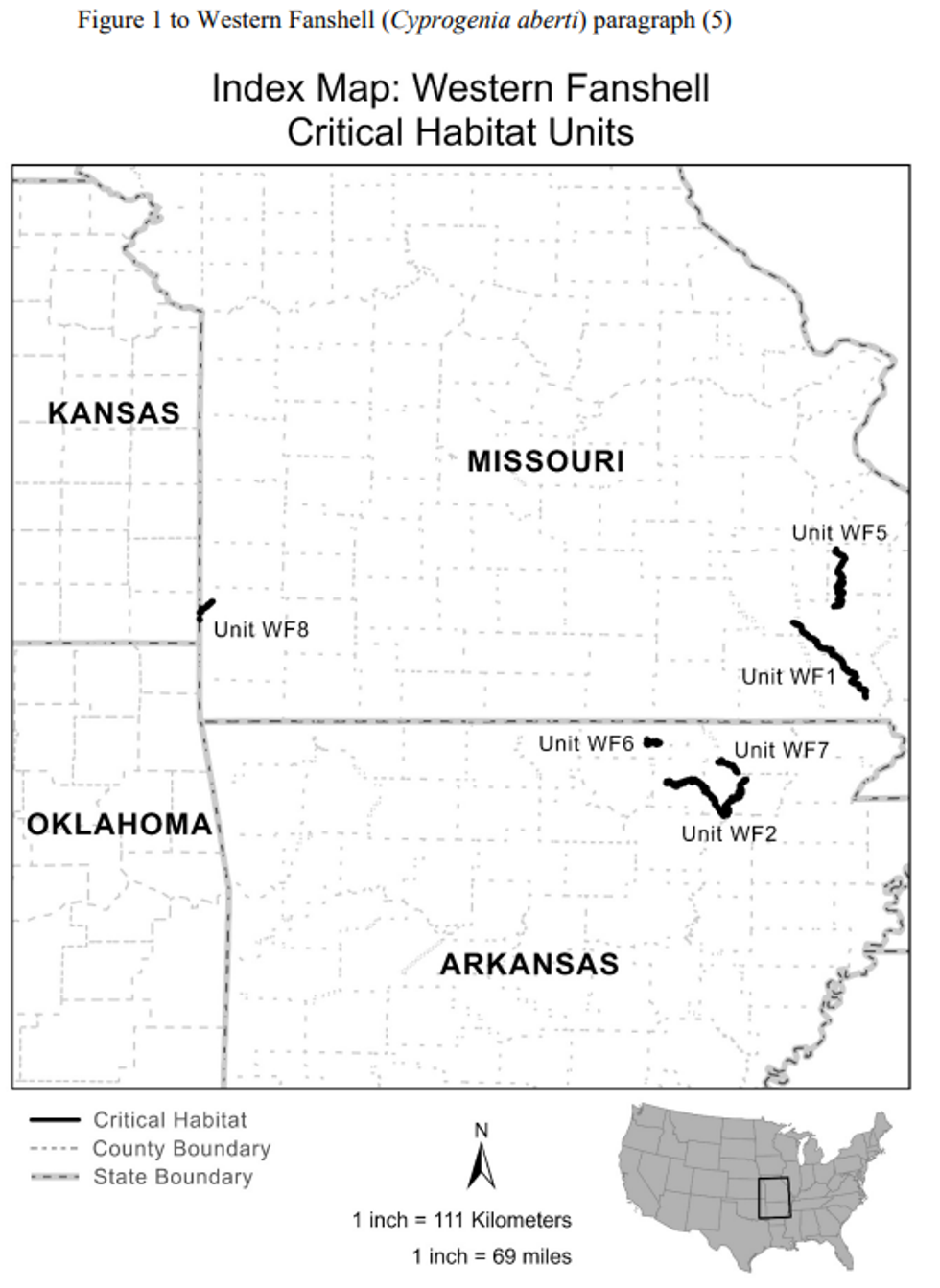
(6) Unit WF 1: Upper Black River; Butler and Wayne Counties, Missouri.
(i) Unit WF 1 consists of 64.7 river miles (mi) (104.1 kilometers (km)) of Black River in Butler and Wayne Counties, Missouri, from Clearwater Dam southwest of Piedmont, Wayne County, extending downstream to Butler County Road 658 crossing southeast of Poplar Bluff, Butler County. Unit WF 1 includes the river channel up to the ordinary high water mark. Riparian lands that border the unit include approximately 51 river mi (82.1 km; 79 percent) in private ownership and 13.7 river mi (22 km; 21 percent) in public (Federal or State) ownership. Approximately 2.7 miles of the public ownership in this unit are State lands associated with Missouri Department of Conservation's (MDC) Bradley A. Hammer Memorial Conservation Area, Dan River Access, Hilliard Access, and Stephen J. Sun Conservation Area. Eleven miles are Federal land associated with the U.S. Forest Service's (USFS) Mark Twain National Forest and U.S. Army Corps of Engineers' Clearwater Recreation Area.
(ii) Map of Unit WF 1 follows:
Figure 2 to Western Fanshell (Cyprogenia aberti) paragraph (6)(ii)
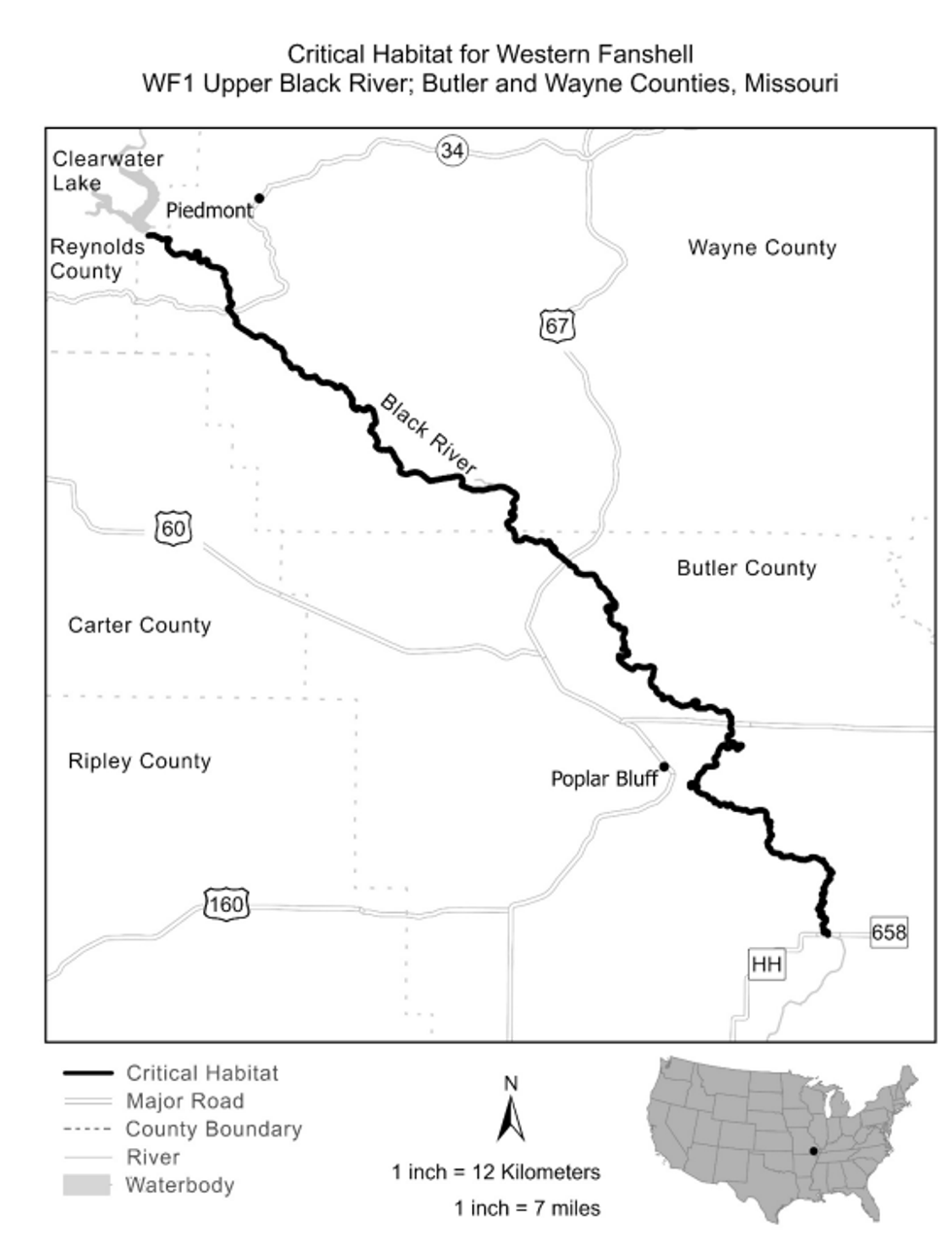
(7) Unit WF 2: Lower Black/Strawberry River; Independence, Jackson, Lawrence, and Sharp Counties, Arkansas.
(i) Unit WF 2 consists of 111.3 river mi (179.1 km) of Black River and Strawberry River in Independence, Jackson, Lawrence, and Sharp Counties in Arkansas. Unit WF 2 includes the river channel up to the ordinary high water mark. Black River makes up 54.6 river mi (87.9 km) from the mouth of Spring River northeast of Black Rock, extending downstream to the mouth of Strawberry River northeast of Dowdy, Independence County. Strawberry River makes up 56.7 river mi (91.2 km) from the mouth of Lave Creek north of Evening Shade, Sharp County, extending downstream to the confluence with Black River northeast of Dowdy, Independence County. Riparian lands that border the unit include approximately 100.4 river mi (161.6 km; 90 percent) in private ownership and 10.9 river mi (17.5 km; 10 percent) in public (State) ownership. The public land ownership in this unit is associated with Arkansas Game and Fish Commission's Shirey Bay Rainey Brake Wildlife Management Area on Black River. The Nature Conservancy's Strawberry River Preserve and Ranch on Strawberry River is also in this unit.
(ii) Map of Unit WF 2 follows:
Figure 3 to Western Fanshell (Cyprogenia aberti) paragraph (7)(ii)
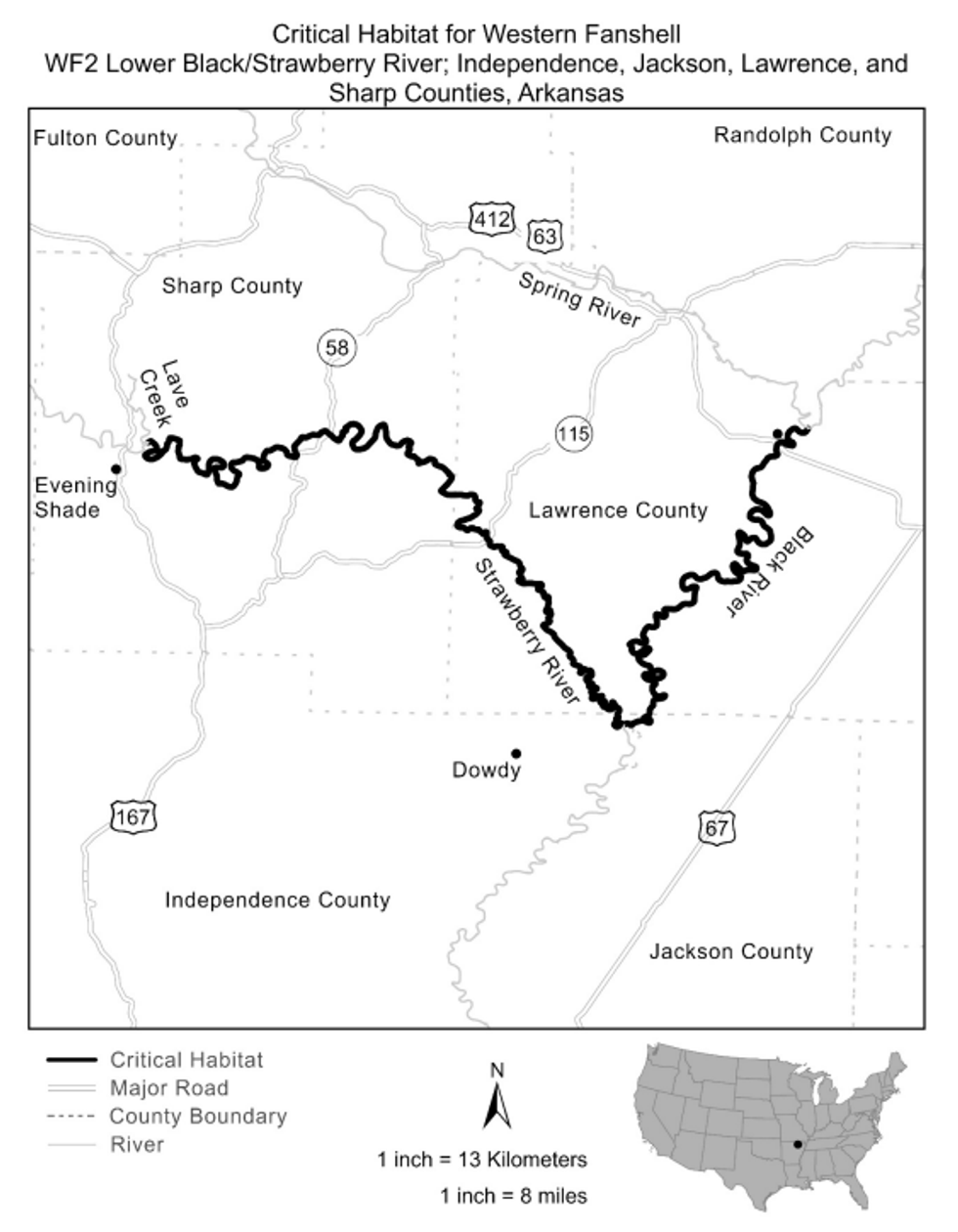
(8) Units WF 3 and WF 4 have been excluded from this critical habitat designation.
(9) Unit WF 5: St. Francis River; Madison and Wayne Counties, Missouri.
(i) Unit WF 5 consists of 49.3 river mi (79.3 km) of St. Francis River in Madison and Wayne Counties, Missouri, extending from the mouth of Wachita Creek west of Fredericktown, Madison County, downstream to the mouth of Big Creek northwest of Silva, Wayne County. Unit WF 5 includes the river channel up to the ordinary high water mark. Riparian lands that border the unit include approximately 36.7 river mi (59.1 km; 74 percent) in private ownership and 12.6 river mi (20.2 km; 26 percent) in public (Federal or State) ownership. Approximately 2.4 river mi of the public ownership in this unit are State lands associated with MDC's Coldwater Conservation Area, Mill Stream Gardens, and Roselle Access. Ten miles are Federal land associated with the USFS's Mark Twain National Forest.
(ii) Map of Unit WF 5 follows:
Figure 4 to Western Fanshell (Cyprogenia aberti) paragraph (9)(ii)
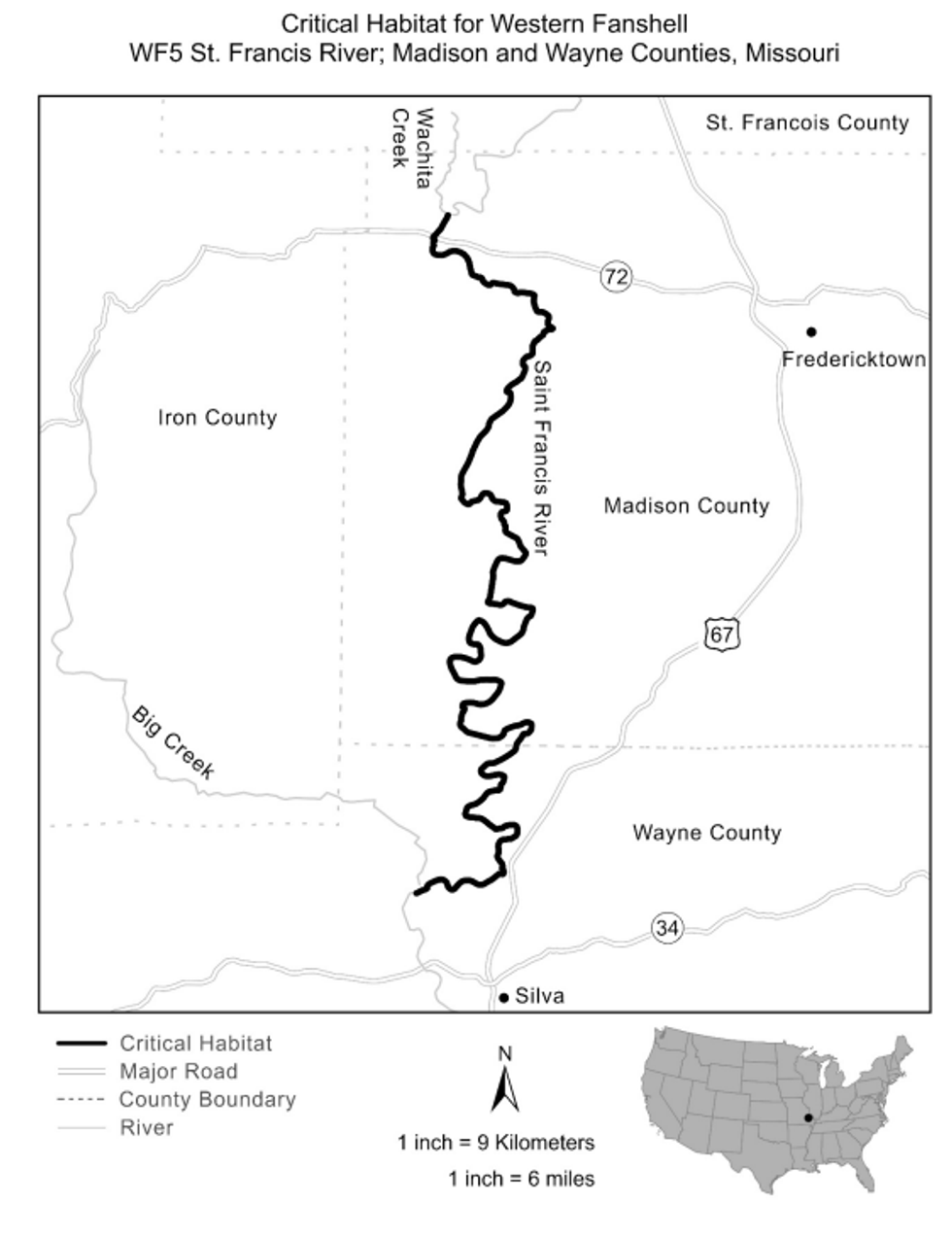
(10) Unit WF 6: South Fork Spring River; Fulton County, Arkansas.
(i) Unit WF 6 consists of 13.4 river mi (21.6 km) of South Fork Spring River in Fulton County, Arkansas, from the mouth of Camp Creek east of Salem, Fulton County, extending downstream to the Arkansas Highway 289 crossing northwest of Cherokee Village, Fulton County. Unit WF 6 includes the river channel up to the ordinary high water mark. Approximately 100 percent of the riparian lands that border the unit are in private ownership.
(ii) Map of Unit WF 6 follows:
Figure 5 to Western Fanshell (Cyprogenia aberti) paragraph (10)(ii)
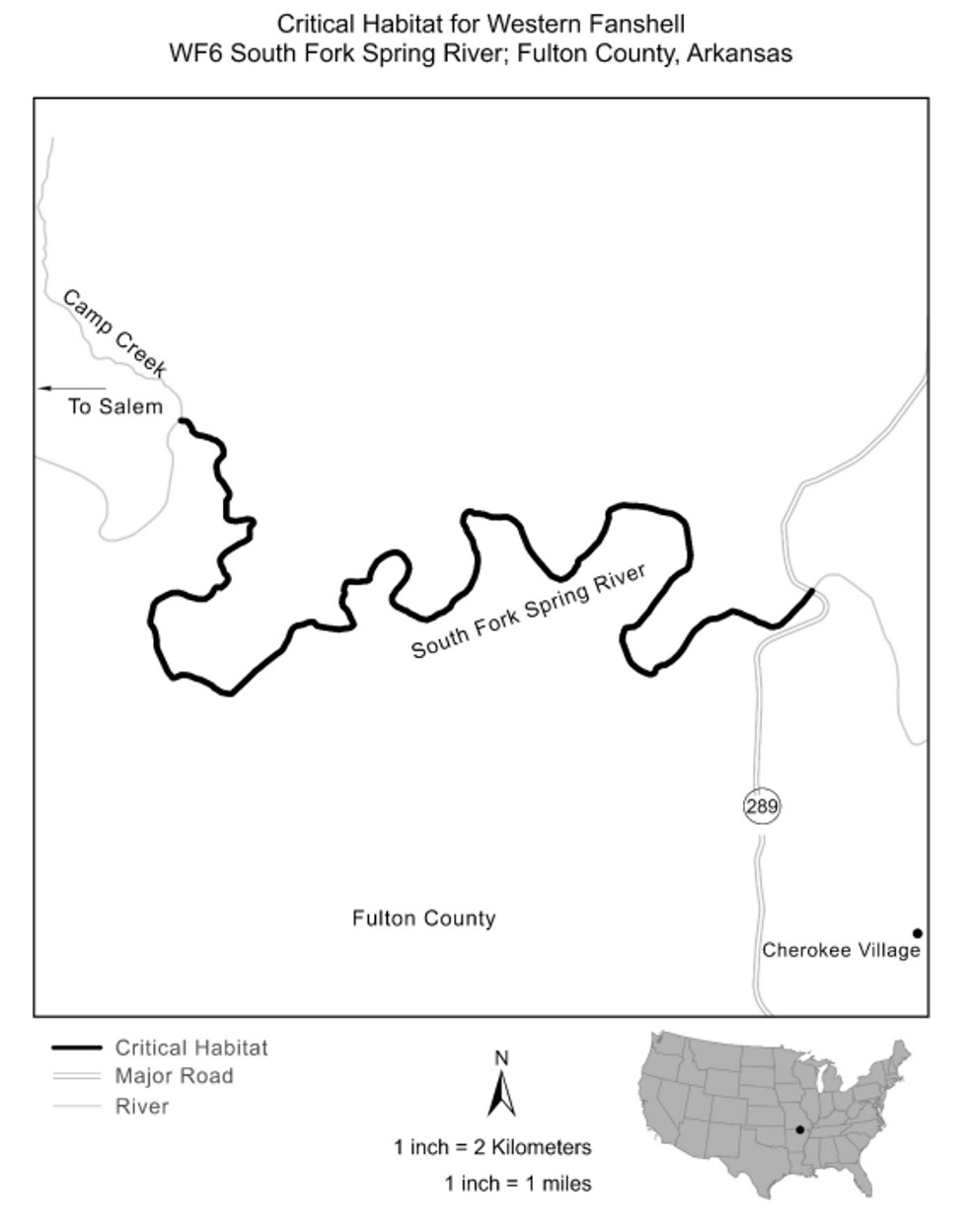
(11) Unit WF 7: Spring River (AR); Lawrence and Randolph Counties, Arkansas.
(i) Unit WF 7 consists of 14.2 river mi (22.9 km) of Spring River in Lawrence and Randolph Counties, Arkansas, from the mouth of Wells Creek at Ravenden, extending downstream to the mouth of Stennitt Creek southeast of Imboden, Lawrence County. Unit WF 7 includes the river channel up to the ordinary high water mark. Approximately 100 percent of the riparian lands that border the unit are in private ownership.
(ii) Map of Unit WF 7 follows:
Figure 6 to Western Fanshell (Cyprogenia aberti) paragraph (11)(ii)
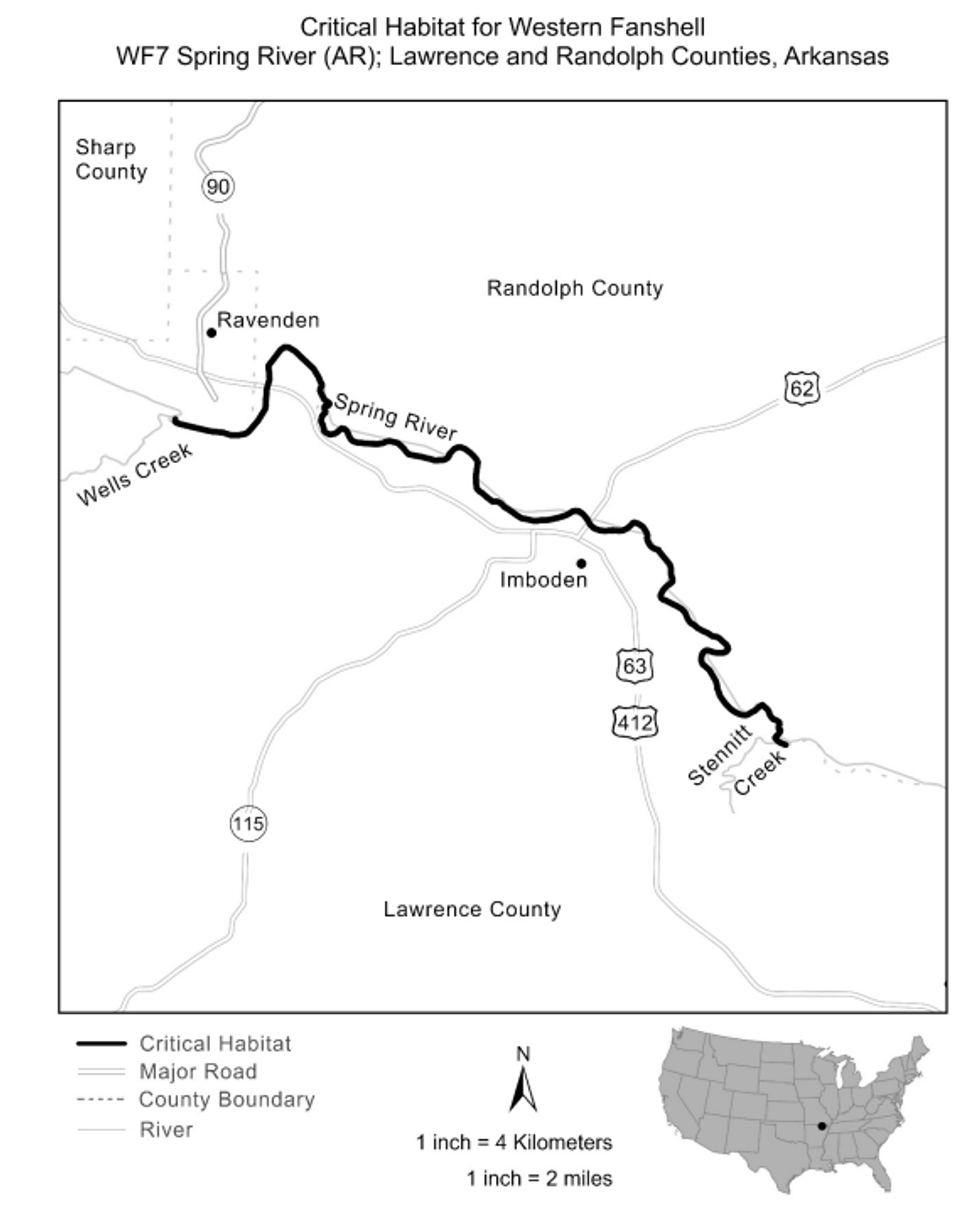
(12) Unit WF 8: Spring River (MO); Jasper County, Missouri.
(i) Unit WF 8 consists of 8.5 river mi (13.7 km) of Spring River in Jasper County, Missouri, from the mouth of North Fork Spring River east of Asbury, Jasper County, Missouri, extending downstream to the Kansas State line, then from where it reenters Missouri to the mouth of Center Creek west of Carl Junction, Jasper County, Missouri. Unit WF 8 includes the river channel up to the ordinary high water mark. Approximately 100 percent of the riparian lands that border the unit are in private ownership.
(ii) Map of Unit WF 8 follows:
Figure 7 to Western Fanshell (Cyprogenia aberti) paragraph (12)(ii)
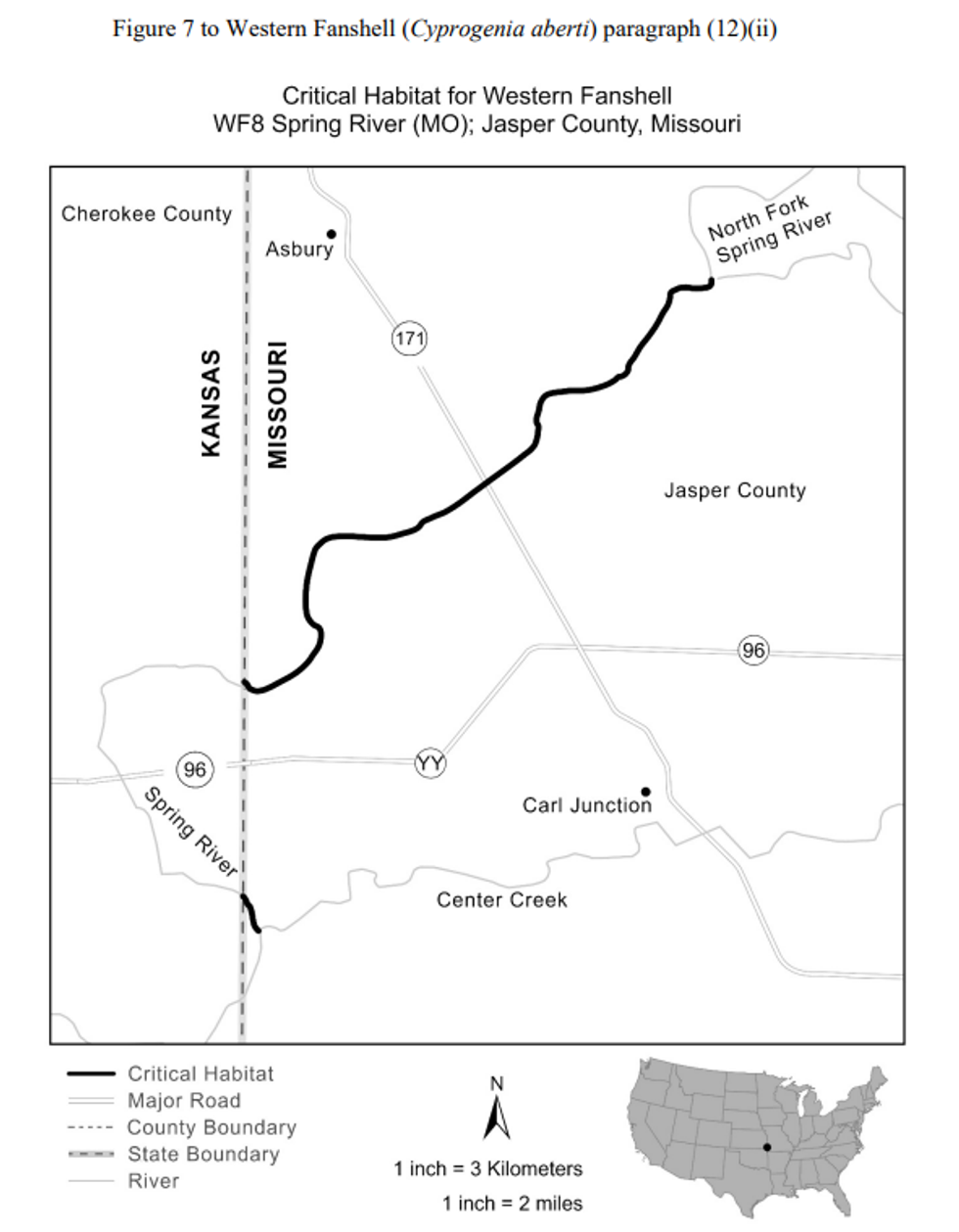
(13) Unit WF 9 has been excluded from this critical habitat designation.
Round Hickorynut (Obovaria subrotunda)
(1) Critical habitat units for the round hickorynut are depicted on the maps in this entry for Jackson, Madison, and Marshall Counties, Alabama; Fulton, Marshall, Pulaski, and Starke Counties, Indiana; Bath, Butler, Campbell, Edmonson, Fleming, Green, Harrison, Hart, Kenton, Laurel, Morgan, Nicholas, Pendleton, Pulaski, Rockcastle, Robertson, Rowan, and Warren Counties, Kentucky; Montgomery County, Mississippi; Bedford, Marshall, and Maury Counties, Tennessee; Ashtabula, Lake, and Trumbull Counties, Ohio; Crawford and Mercer Counties, Pennsylvania; and Braxton, Calhoun, Clay, Doddridge, Fayette, Gilmer, Kanawha, Pleasants, Ritchie, Tyler, and Wood Counties, West Virginia.
(2) Within these areas, the physical or biological features essential to the conservation of the round hickorynut consist of the following components:
(i) Adequate flows, or a hydrologic flow regime (magnitude, timing, frequency, duration, rate of change, and overall seasonality of discharge over time), necessary to maintain benthic habitats where the species is found and to maintain stream connectivity, specifically providing for the exchange of nutrients and sediment for maintenance of the mussel's and fish host's habitat and food availability, maintenance of spawning habitat for native fishes, and the ability for newly transformed juveniles to settle and become established in their habitats. Adequate flows ensure delivery of oxygen, enable reproduction, deliver food to filter-feeding mussels, and reduce contaminants and fine sediments from interstitial spaces. Stream velocity is not static over time, and variations may be attributed to seasonal changes (with higher flows in winter/spring and lower flows in summer/fall), extreme weather events (e.g., drought or floods), or anthropogenic influence (e.g., flow regulation via impoundments).
(ii) Suitable substrates and connected instream habitats, characterized by geomorphically stable stream channels and banks (i.e., channels that maintain lateral dimensions, longitudinal profiles, and sinuosity patterns over time without an aggrading or degrading bed elevation) with habitats that support a diversity of freshwater mussel and native fish (such as, stable riffle-run-pool habitats that provide flow refuges consisting of predominantly silt-free, stable sand, gravel, and cobble substrates).
(iii) Water and sediment quality necessary to sustain natural physiological processes for normal behavior, growth, and viability of all life stages, including (but not limited to): Dissolved oxygen (generally above 2 to 3 parts per million (ppm)), salinity (generally below 2 to 4 ppm), and temperature (generally below 86°F (°F) (30 °Celsius (°C)). Additionally, water and sediment should be low in ammonia (generally below 0.5 ppm total ammonia-nitrogen) and heavy metal concentrations, and lack excessive total suspended solids and other pollutants.
(iv) The presence and abundance of fish hosts necessary for recruitment of the round hickorynut (i.e., eastern sand darter (Ammocrypta pellucida), emerald darter (Etheostoma baileyi), greenside darter (E. blennioides), Iowa darter (E. exile), fantail darter (E. flabellare), Cumberland darter (E. susanae), spangled darter (E. obama), variegate darter (E. variatum), blackside darter (Percina maculata), frecklebelly darter (P. stictogaster), and banded sculpin (Cottus carolinae)).
(3) Critical habitat does not include manmade structures (such as buildings, aqueducts, runways, roads, and other paved areas) and the land on which they are located existing within the legal boundaries on April 10, 2023.
(4) Data layers defining map units were created by overlaying Natural Heritage Element Occurrence data and U.S. Geological Survey hydrologic data for stream reaches. The hydrologic data used in the critical habitat maps were extracted from the U.S. Geological Survey 1:1M scale nationwide hydrologic layer (https://www.usgs.gov/core-science-systems/ngp/national-hydrography) with a projection of EPSG:4269—NAD83 Geographic. Natural Heritage program and State mussel database species presence data from Pennsylvania, Ohio, Indiana, West Virginia, Kentucky, Tennessee, Alabama, and Mississippi were used to select specific river and stream segments for inclusion in the critical habitat layer. The maps in this entry, as modified by any accompanying regulatory text, establish the boundaries of the critical habitat designation. The coordinates or plot points or both on which each map is based are available to the public at the Service's internet site at https://www.regulations.gov at Docket No. FWS-R4-ES-2020-0010, and at the field office responsible for this designation. You may obtain field office location information by contacting one of the Service regional offices, the addresses of which are listed at 50 CFR 2.2.
(5) Index map for the round hickorynut follows:
Figure 1 to Round Hickorynut (Obovaria subrotunda) paragraph (5)

(6) Unit RH 1: Shenango River; Crawford and Mercer Counties, Pennsylvania.
(i) Unit RH 1 consists of 22 river miles (mi) (35.5 kilometers (km)) of the Shenango River in Crawford County, Pennsylvania, from Pymatuning Dam downstream to the point of inundation by Shenango River Lake near Big Bend, Mercer County, Pennsylvania. Approximately 15 river mi (24.3 km; 68 percent) of riparian lands that border the unit are private ownership, and 7 river mi (11.1 km; 32 percent) are public (Federal or State) ownership. This unit is immediately downstream from Pymatuning Dam, which is owned by the State of Pennsylvania.
(ii) Map of Unit RH 1 follows:
Figure 2 to Round Hickorynut (Obovaria subrotunda) paragraph (6)(ii)
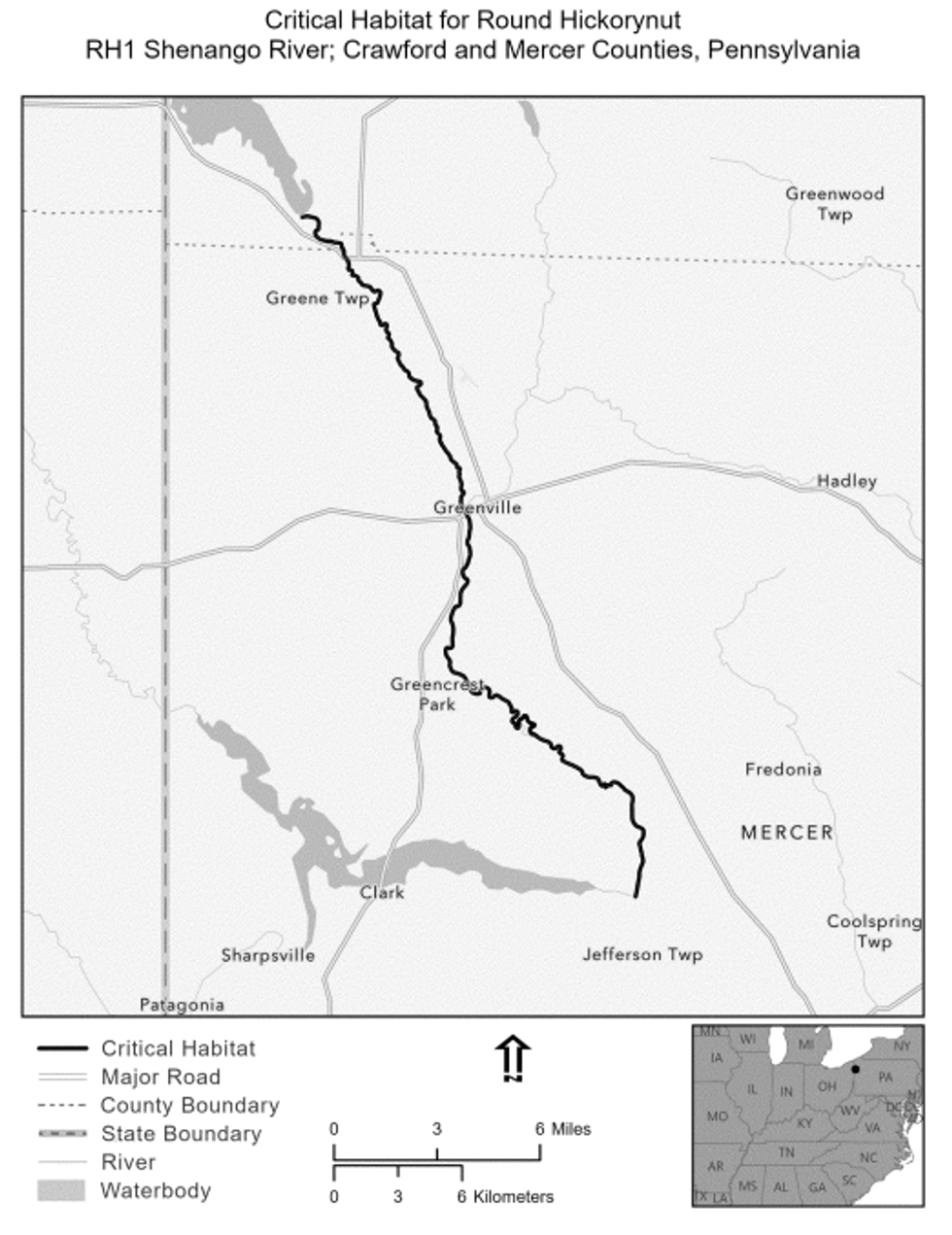
(7) Unit RH 2: Grand River; Ashtabula, Lake, and Trumbull Counties, Ohio.
(i) Unit RH 2 consists of 92 river mi (148.2 km) of the Grand River in Ashtabula, Lake, and Trumbull Counties, Ohio. Approximately 59 river mi (95.2 km; 64 percent) of riparian lands that border the unit are private ownership, and 33 river mi (53 km; 36 percent) are public (State or local) ownership. The Grand River is a State Wild and Scenic River. The Wild River designation includes approximately 23 river mi (37 km) from the Harpersfield Covered Bridge downstream to the Norfolk and Western Railroad Trestle in Lake County, and approximately 33 mi (53 km) from the U.S. Route 322 Bridge in Ashtabula County downstream to the Harpersfield Covered Bridge. Harpersfield Dam within this unit is operated by the U.S. Army Corps of Engineers.
(ii) Map of Unit RH 2 follows:
Figure 3 to Round Hickorynut (Obovaria subrotunda) paragraph (7)(ii)
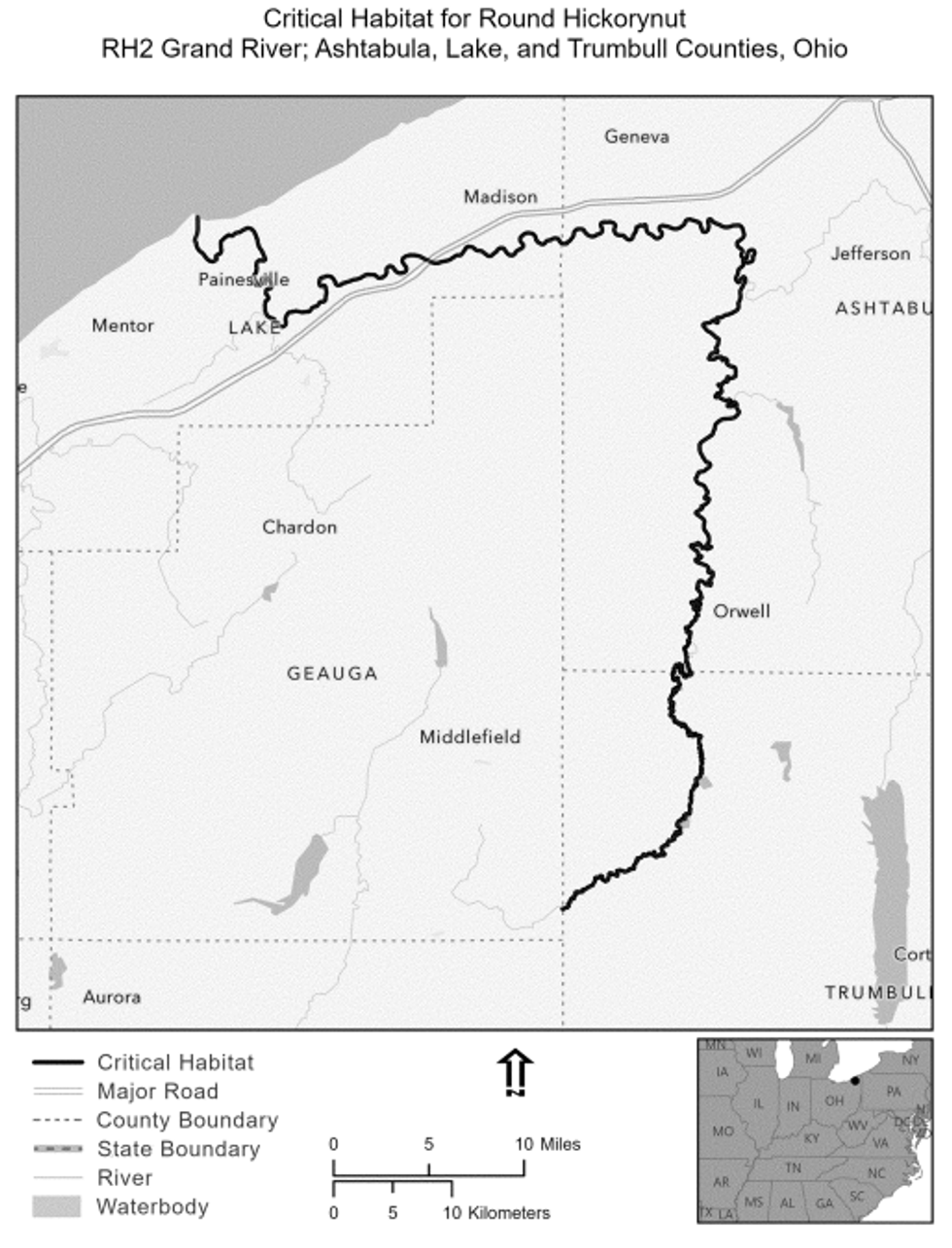
(8) Unit RH 3: Tippecanoe River; Fulton, Marshall, Pulaski, and Starke Counties, Indiana.
(i) Unit RH 3 consists of 75 river mi (120.8 km) of the Tippecanoe River in Fulton, Marshall, Pulaski, and Starke Counties, Indiana. Approximately 66 river mi (105.6 km; 89 percent) of riparian lands that border the unit are private ownership, and 9 river mi (14.5 km; 11 percent) are public (State or easement) ownership.
(ii) Map of Unit RH 3 follows:
Figure 4 to Round Hickorynut (Obovaria subrotunda) paragraph (8)(ii)
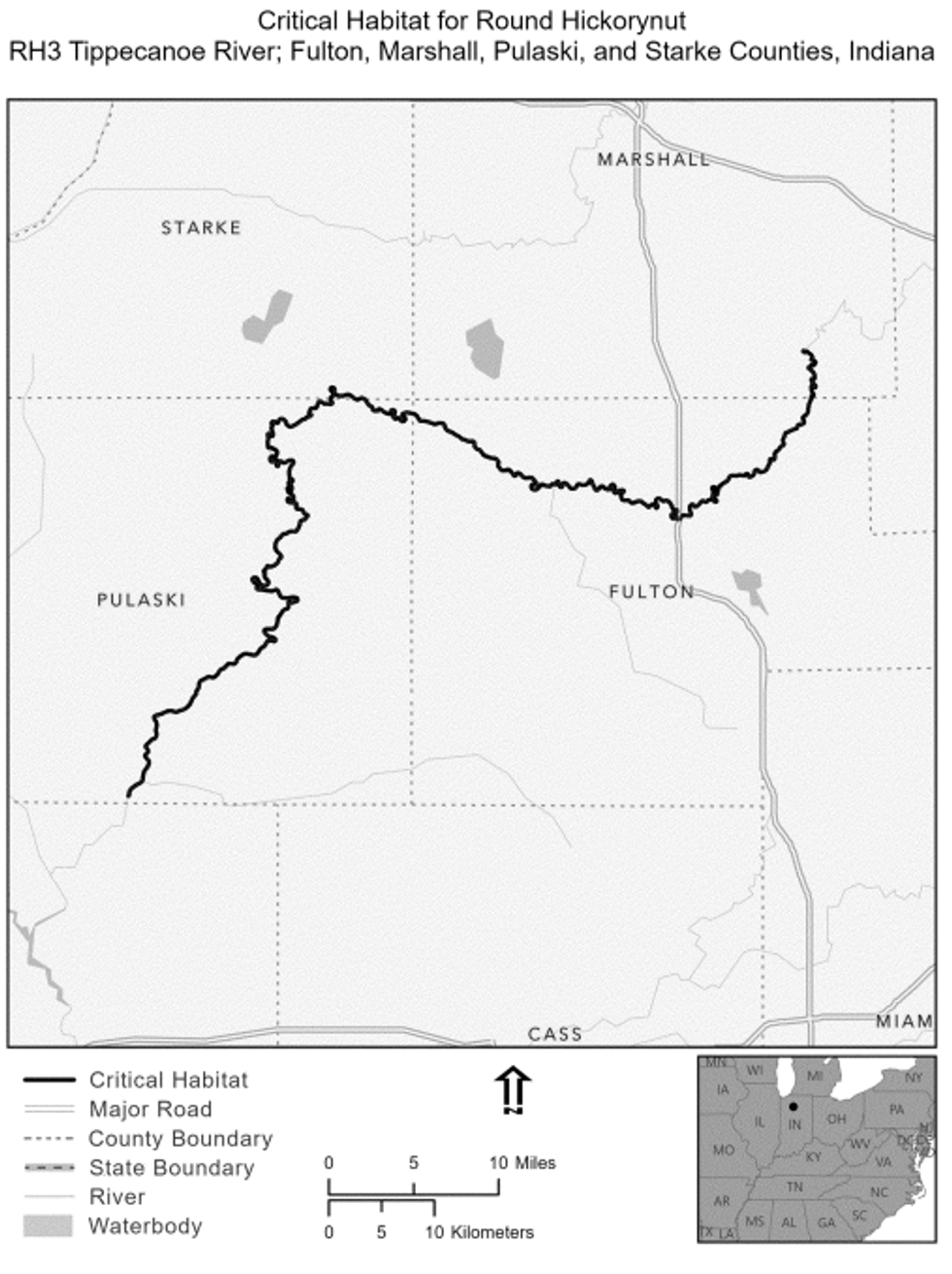
(9) Unit RH 4: Middle Island Creek; Doddridge, Pleasants, and Tyler Counties, West Virginia.
(i) Unit RH 4 consists of 75 stream mi (120.8 km) of Middle Island Creek in Doddridge, Pleasants, and Tyler Counties, West Virginia. Approximately 74.8 stream mi (120.4 km; 99 percent) of riparian lands that border the unit are private ownership, and 0.2 stream mi (0.4 km; less than 1 percent) is public ownership.
(ii) Map of Unit RH 4 follows:
Figure 5 to Round Hickorynut (Obovaria subrotunda) paragraph (9)(ii)
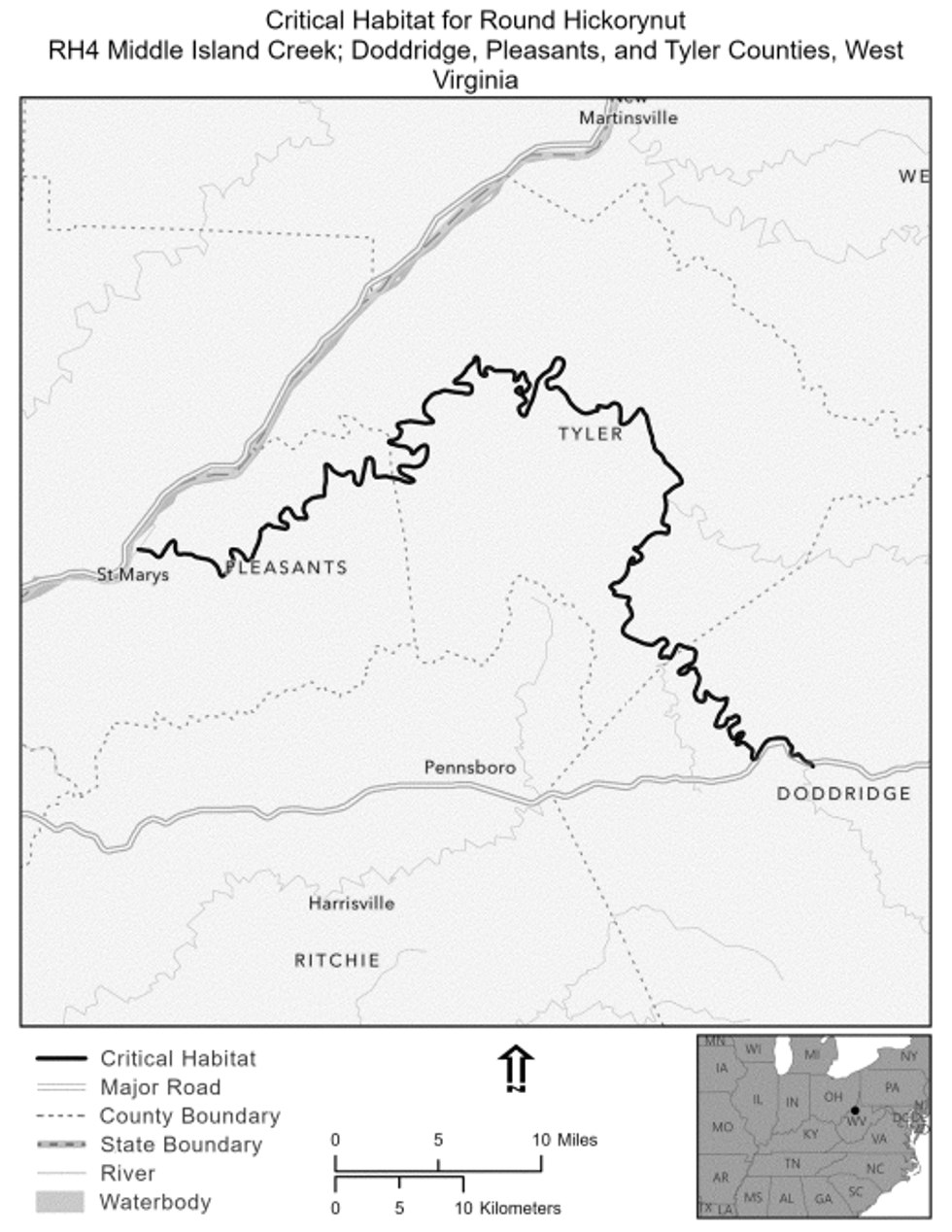
(10) Unit RH 5: Little Kanawha River; Calhoun, Gilmer, Ritchie, and Wood Counties, West Virginia.
(i) Unit RH 5 consists of 110 stream mi (176.6 km) of the Little Kanawha River in Calhoun, Gilmer, Ritchie, and Wood Counties, West Virginia. Approximately 109 river mi (175.4 km; 99 percent) of riparian lands that border the unit are private ownership, and 0.7 river mi (1.2 km; 1 percent) are public (Federal, State, or local) ownership. This unit is directly below Burnsville Dam, which is operated by the U.S. Army Corps of Engineers.
(ii) Map of Unit RH 5 follows:
Figure 6 to Round Hickorynut (Obovaria subrotunda) paragraph (10)(ii)
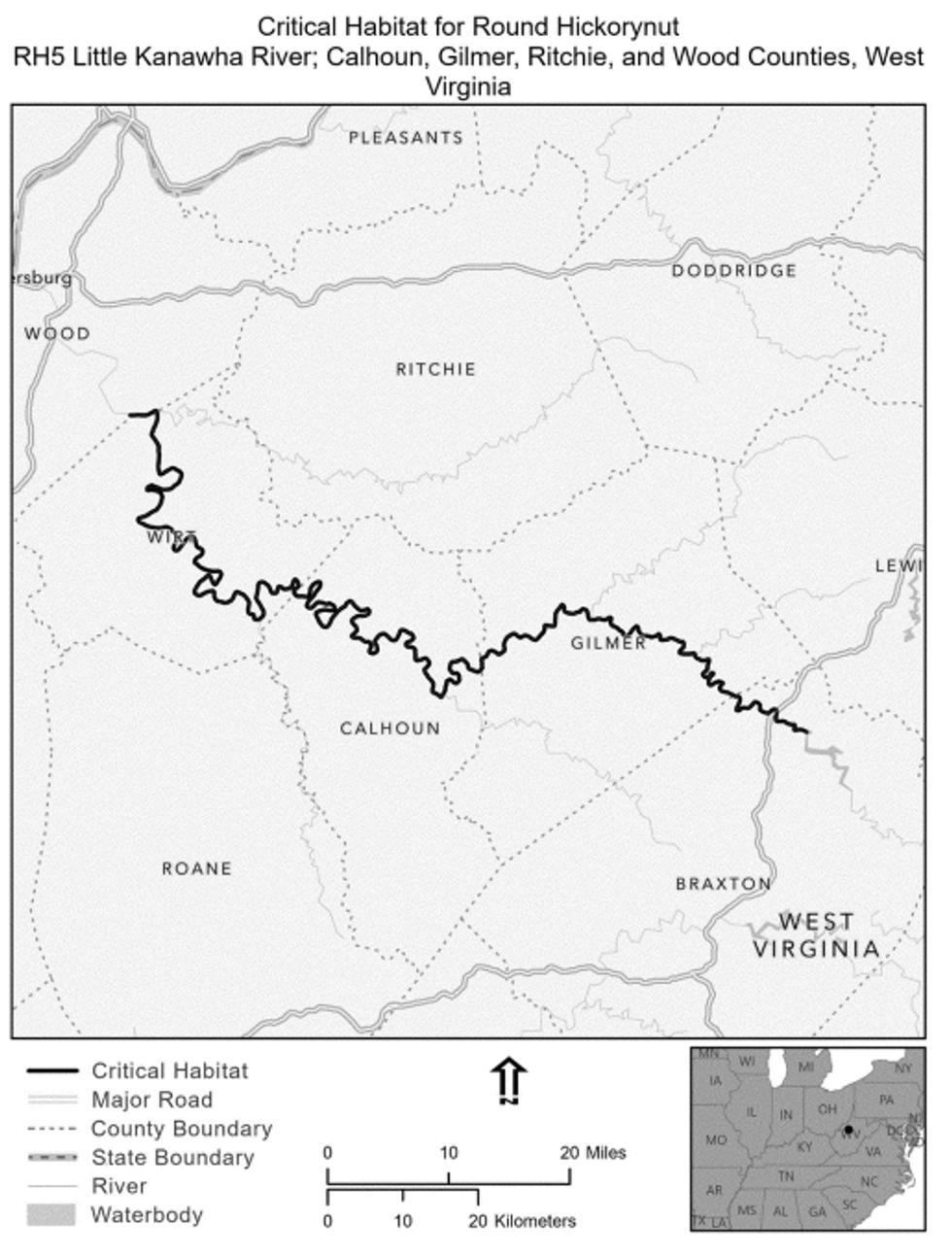
(11) Unit RH 6: Elk River; Braxton, Clay, and Kanawha Counties, West Virginia.
(i) Unit RH 6 consists of 101 river mi (163 km) of the Elk River in Braxton, Clay, and Kanawha Counties, West Virginia. Approximately 93 river mi (150.3 km; 92 percent) of riparian lands that border the unit are private ownership, and 7 river mi (12.7 km; 8 percent) are public (Federal, State, or local) ownership. This unit is immediately below Sutton Dam, which is operated by the U.S. Army Corps of Engineers.
(ii) Map of Unit RH 6 follows:
Figure 7 to Round Hickorynut (Obovaria subrotunda) paragraph (11)(ii)
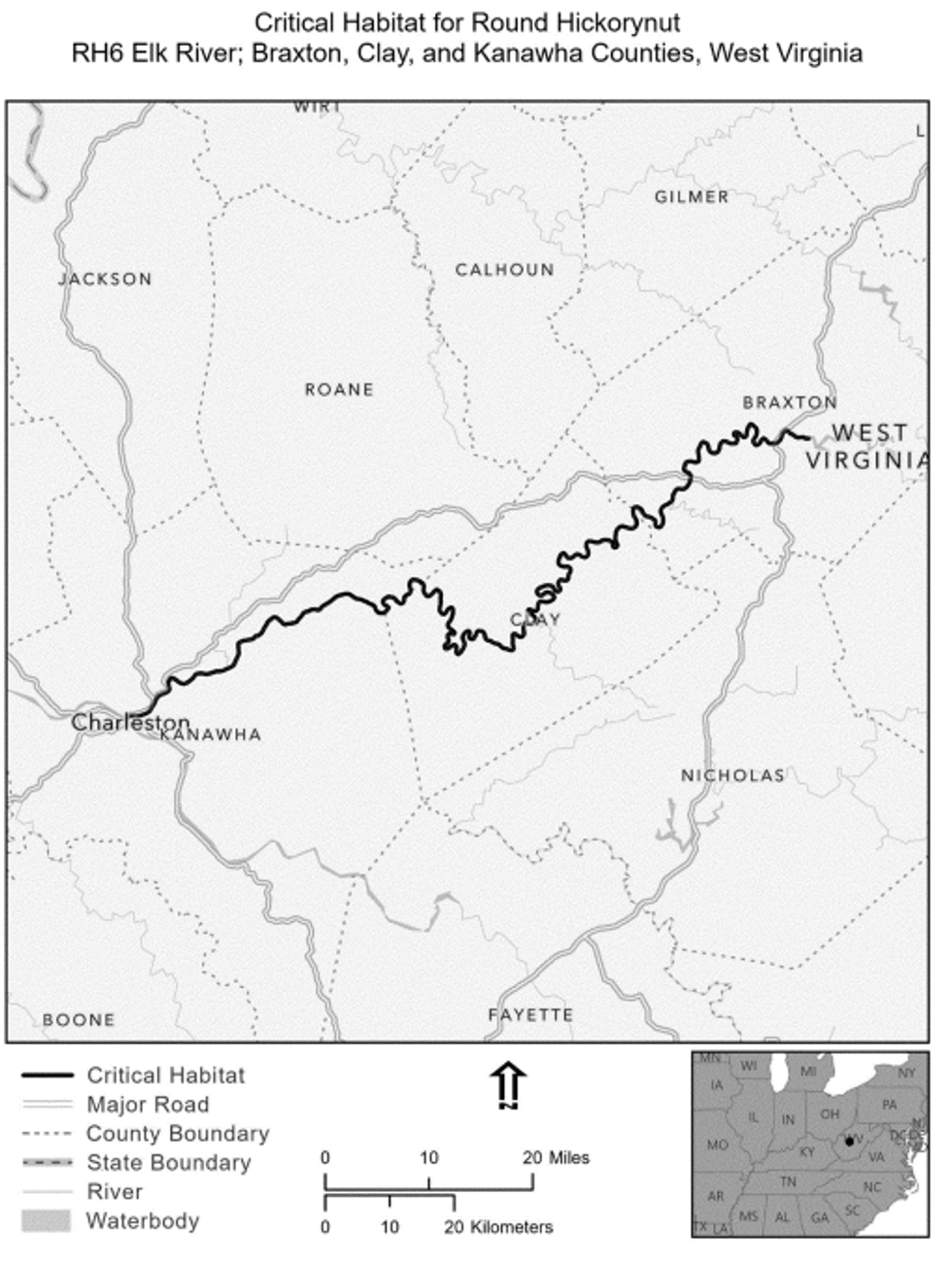
(12) Unit RH 7: Kanawha River; Fayette and Kanawha Counties, West Virginia.
(i) Unit RH 7 consists of 37.5 river mi (60.4 km) of the Kanawha River in Fayette and Kanawha Counties, West Virginia. Approximately 33 river mi (53.2 km; 90 percent) of riparian lands that border the unit are private ownership, and 4 river mi (7.2 km; 10 percent) are public (Federal, State, or local) ownership. London and Marmet locks and dams within this unit are operated by the U.S. Army Corps of Engineers.
(ii) Map of Unit RH 7 follows:
Figure 8 to Round Hickorynut (Obovaria subrotunda) paragraph (12)(ii)
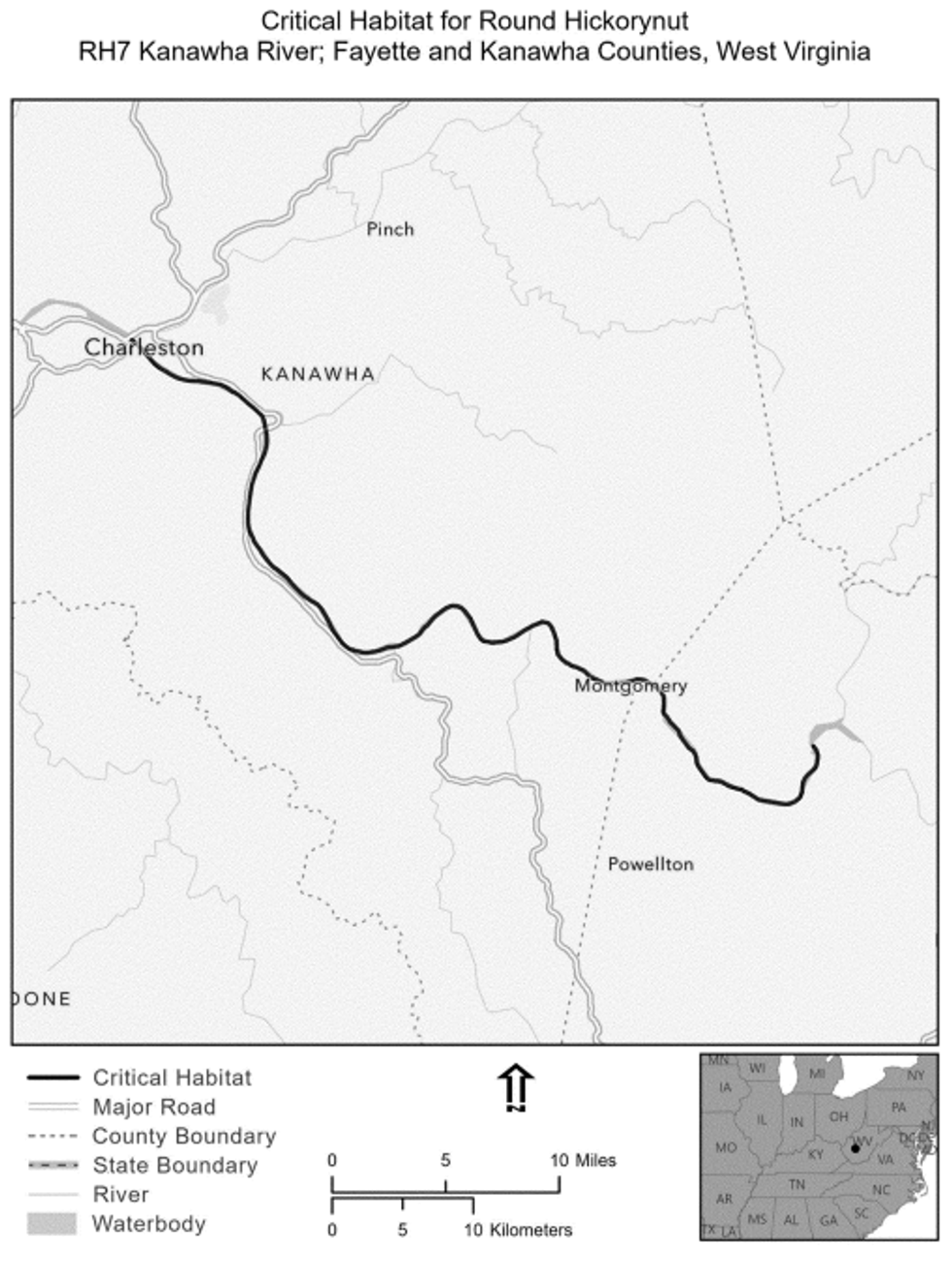
(13) Unit RH 8: Licking River; Bath, Campbell, Fleming, Harrison, Kenton, Morgan, Nicholas, Pendleton, Robertson, and Rowan Counties, Kentucky.
(i) Unit RH 8 consists of 150 river mi (241.9 km) of the Licking River in Bath, Campbell, Fleming, Harrison, Kenton, Morgan, Nicholas, Pendleton, Robertson, and Rowan Counties, Kentucky. Approximately 131 river mi (211.8 km; 87 percent) of riparian lands that border the unit are private ownership, and 18 river mi (30 km; 13 percent) are public (Federal, State, or local) ownership. This unit is directly below Cave Run Dam, which is operated by the U.S. Army Corps of Engineers.
(ii) Map of Unit RH 8 follows:
Figure 9 to Round Hickorynut (Obovaria subrotunda) paragraph (13)(ii)
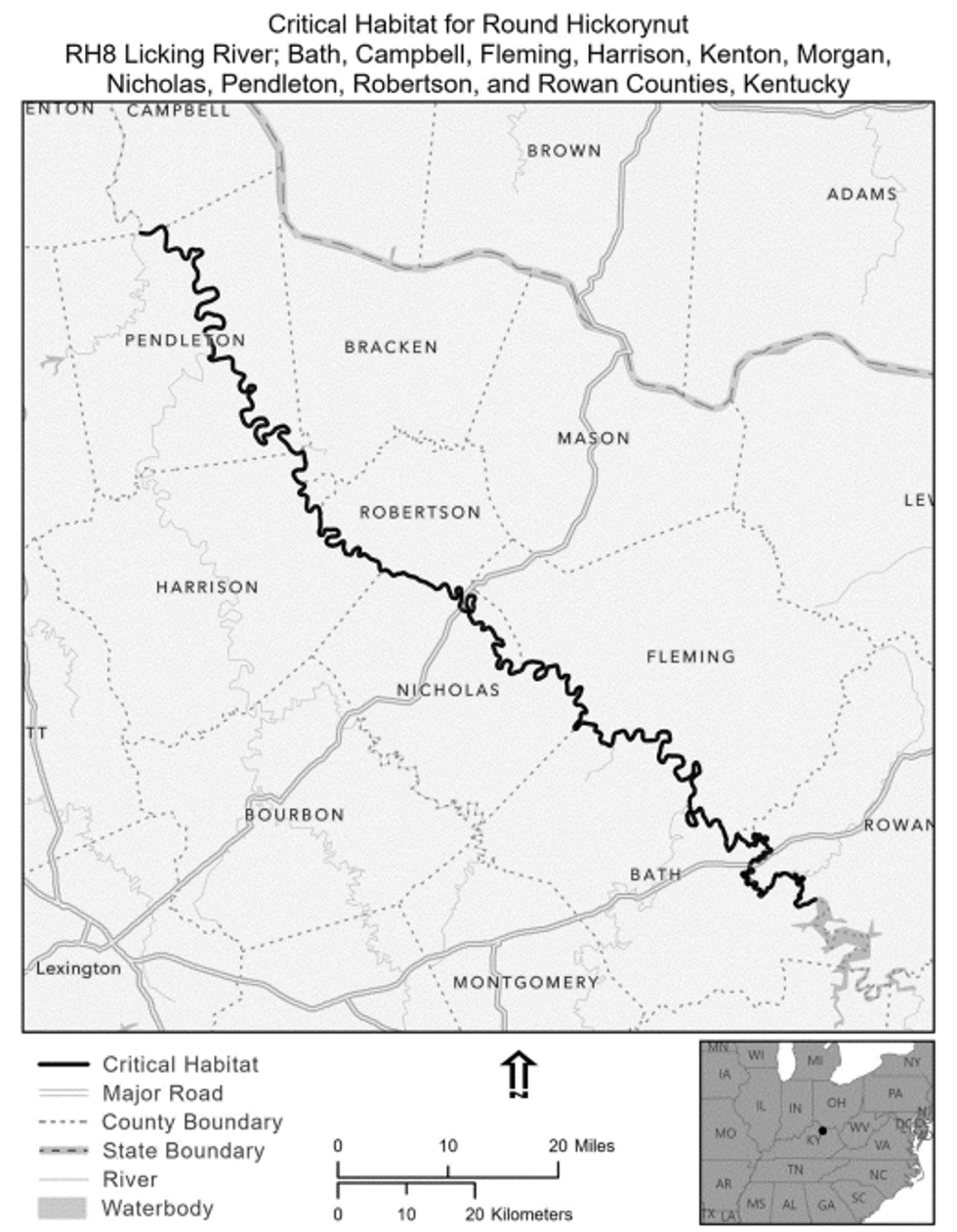
(14) Unit RH 9: Rockcastle River; Laurel, Pulaski, and Rockcastle Counties, Kentucky.
(i) Unit RH 9 consists of 15.3 river mi (24.6 km) of the Rockcastle River in Laurel, Pulaski, and Rockcastle Counties, Kentucky. Approximately 0.3 river mi (0.4 km; 1 percent) of riparian lands that border the unit is private ownership, and 15 river mi (24.2 km; 99 percent) are public (Federal; Daniel Boone National Forest) ownership.
(ii) Map of Unit RH 9 follows:
Figure 10 to Round Hickorynut (Obovaria subrotunda) paragraph (14)(ii)
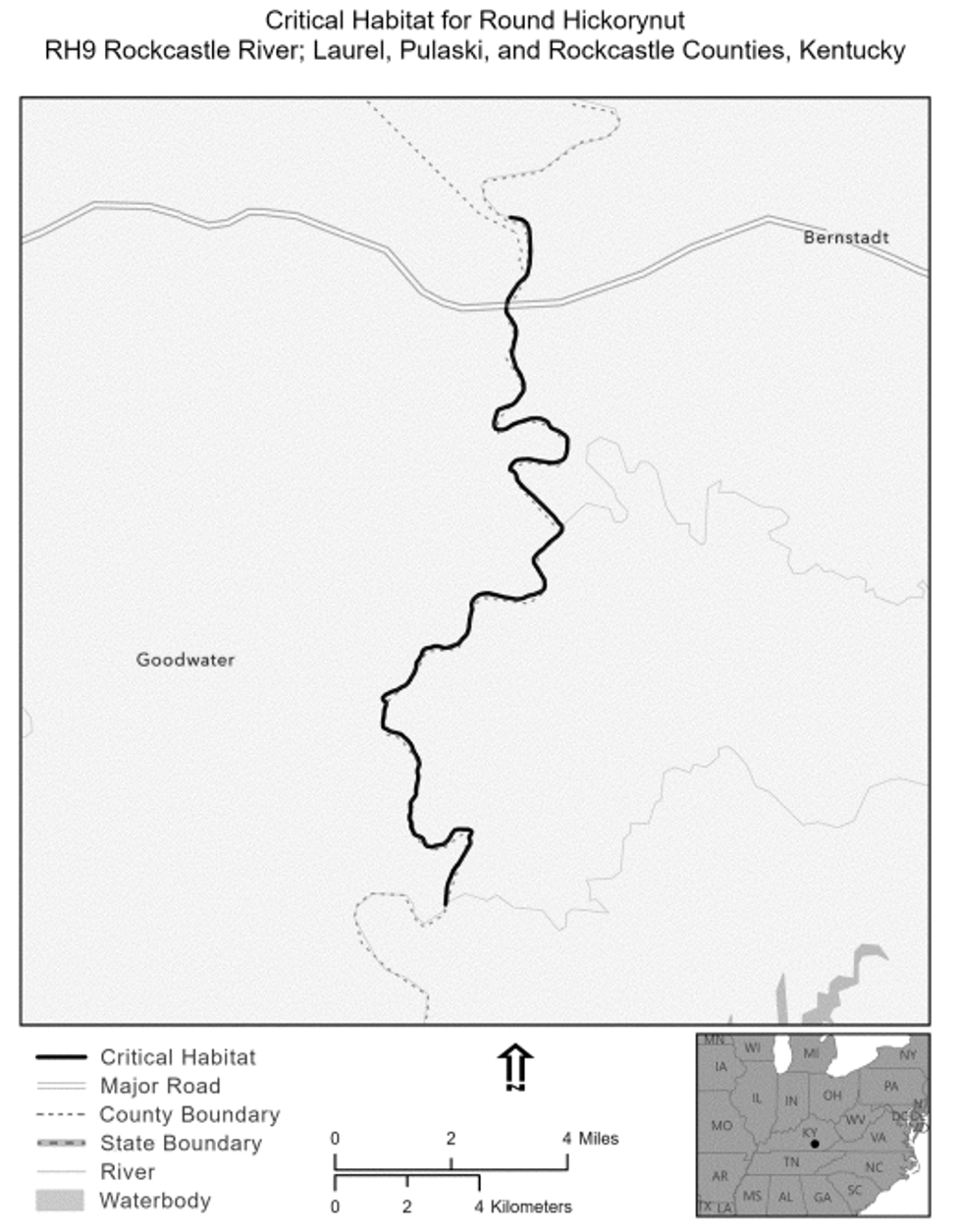
(15) Unit RH 10: Buck Creek; Pulaski County, Kentucky.
(i) Unit RH 10 consists of 36 stream mi (58.1 km) of Buck Creek in Pulaski County, Kentucky. Approximately 33 stream mi (52.6 km; 92 percent) of riparian lands that border the unit are private ownership, and 3 stream mi (5.5 km; 8 percent) are public (State or local) ownership.
(ii) Map of Unit RH 10 follows:
Figure 11 to Round Hickorynut (Obovaria subrotunda) paragraph (15)(ii)
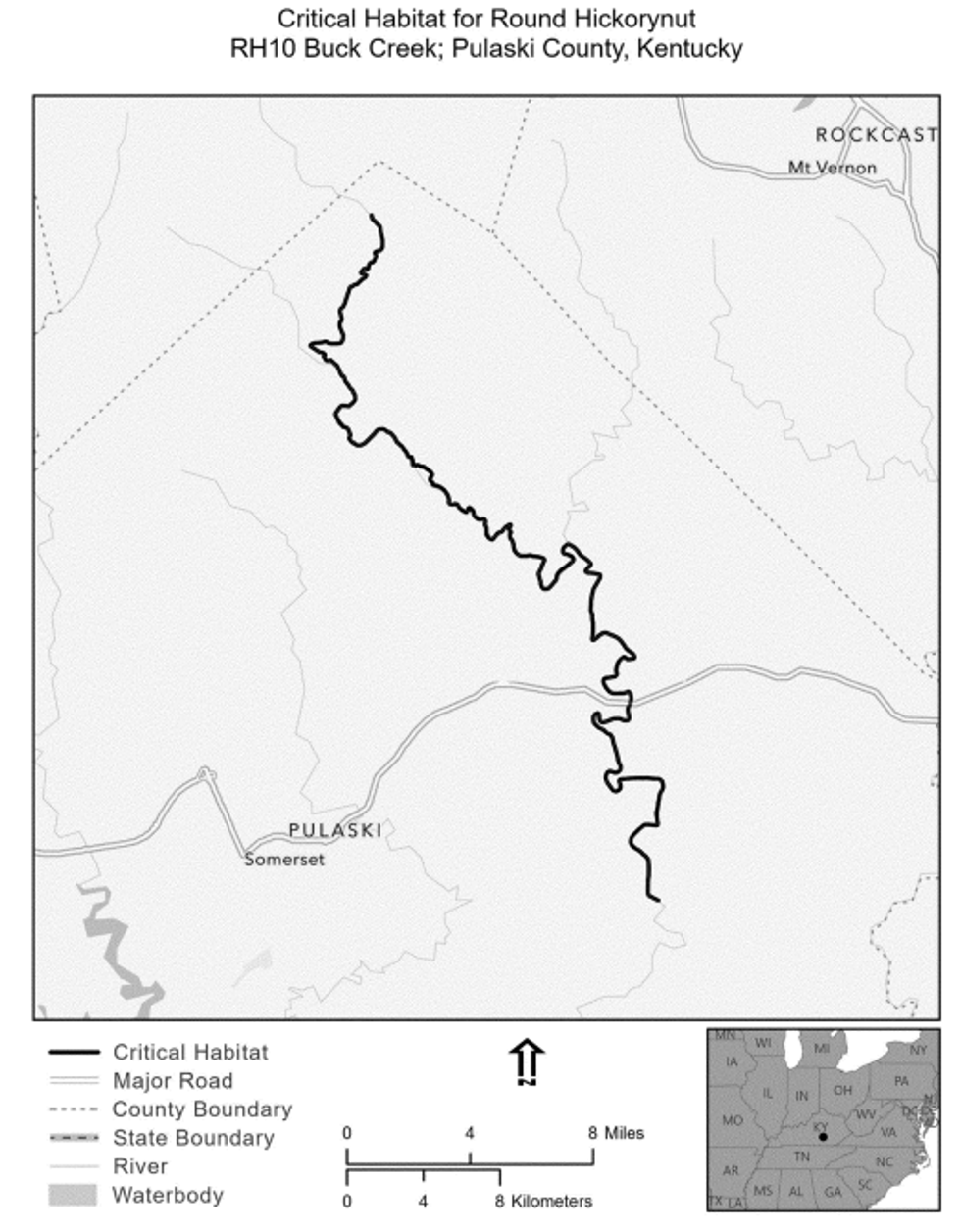
(16) Unit RH 11: Green River; Hart, Edmonson, Green, Butler, and Warren Counties, Kentucky.
(i) Unit RH 11 consists of 98 river mi (157.7 km) of the Green River in Butler, Edmonson, Green, Hart, and Warren Counties, Kentucky. Approximately 61 river mi (98.4 km; 62 percent) of riparian lands that border the unit are private ownership, and 37 river mi (59.4 km; 38 percent) are public (Federal or State) ownership, including portions of Mammoth Cave National Park. This unit is located directly below Green River Lake Dam, which is operated by the U.S. Army Corps of Engineers.
(ii) Map of Unit RH 11 follows:
Figure 12 to Round Hickorynut (Obovaria subrotunda) paragraph (16)(ii)
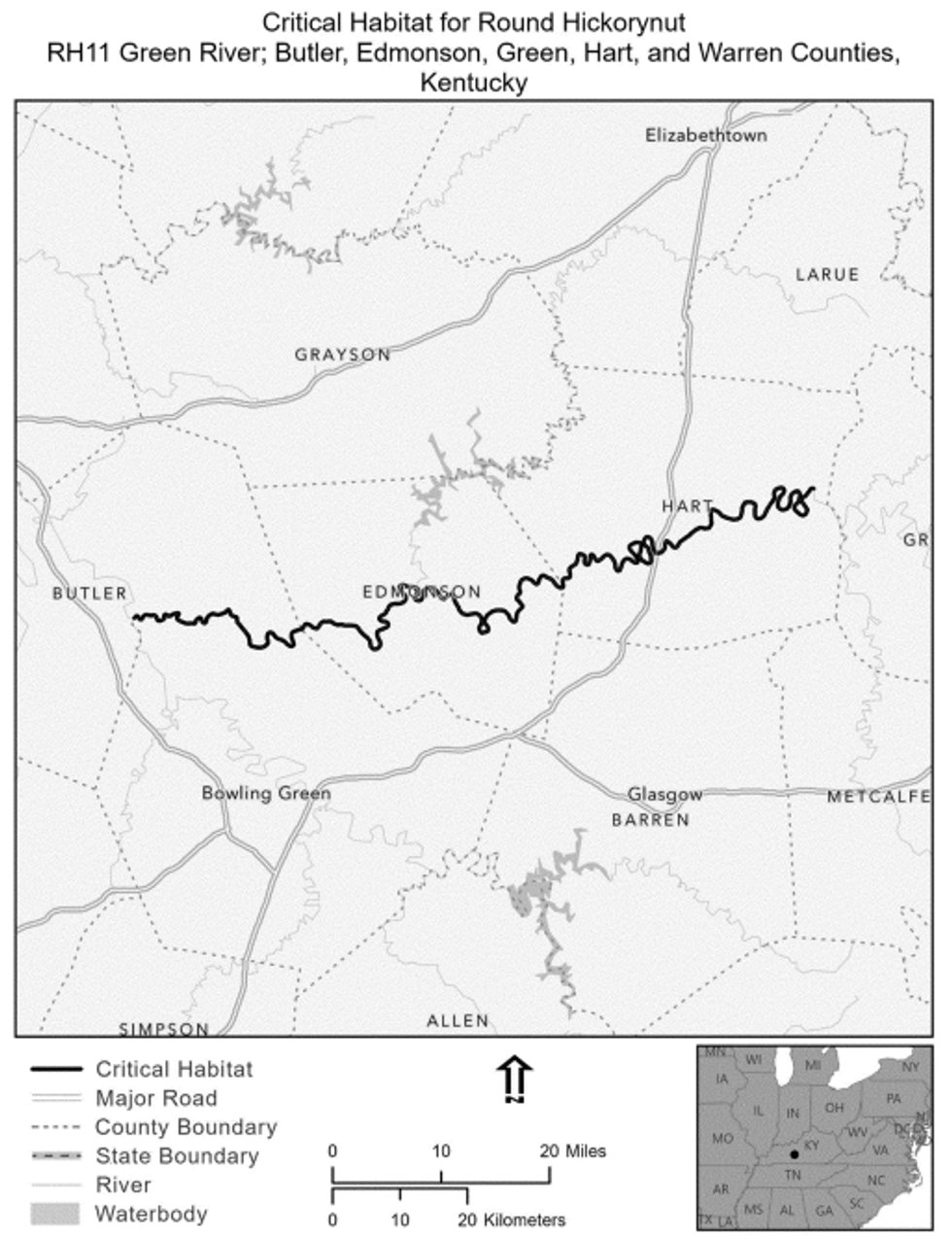
(17) Unit RH 12: Paint Rock River; Jackson, Madison, and Marshall Counties, Alabama.
(i) Unit RH 12 consists of 48 river mi (77.5 km) of the Paint Rock River in Jackson, Madison, and Marshall Counties, Alabama. Approximately 2 river mi (4.1 km; 2 percent) of riparian lands that border the unit are private ownership, and 46 river mi (73.4 km; 98 percent) are public (Federal or State) ownership.
(ii) Map of Unit RH 12 follows:
Figure 13 to Round Hickorynut (Obovaria subrotunda) paragraph (17)(ii)
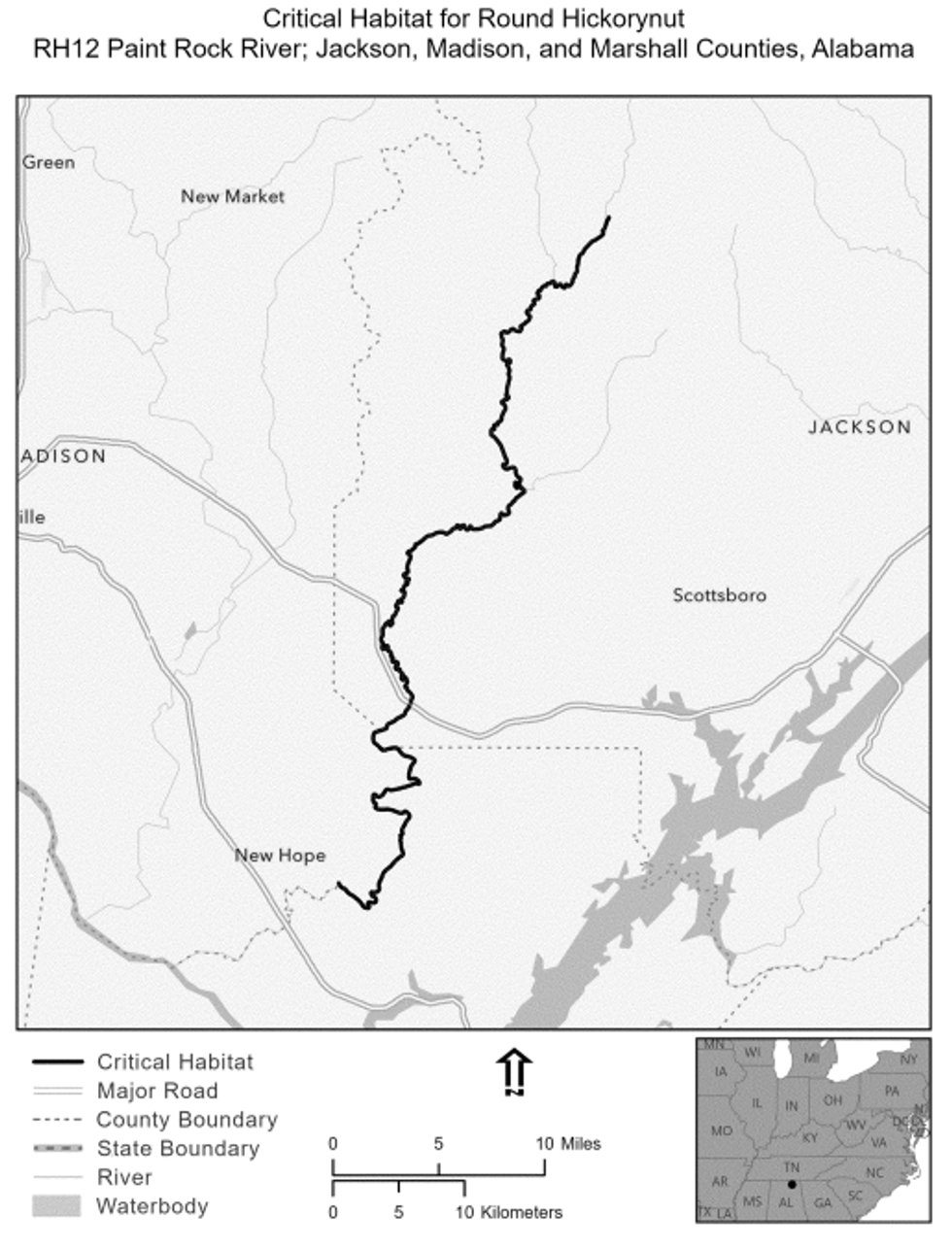
(18) Unit RH 13: Duck River; Bedford, Marshall, and Maury Counties, Tennessee.
(i) Unit RH 13 consists of 59 river mi (94.8 km) of the Duck River in Bedford, Marshall, and Maury Counties, Tennessee. Approximately 27 river mi (43.7 km; 47 percent) of riparian lands that border the unit are private ownership, and 32 river mi (51.1 km; 53 percent) are public (State or local) ownership.
(ii) Map of Unit RH 13 follows:
Figure 14 to Round Hickorynut (Obovaria subrotunda) paragraph (18)(ii)
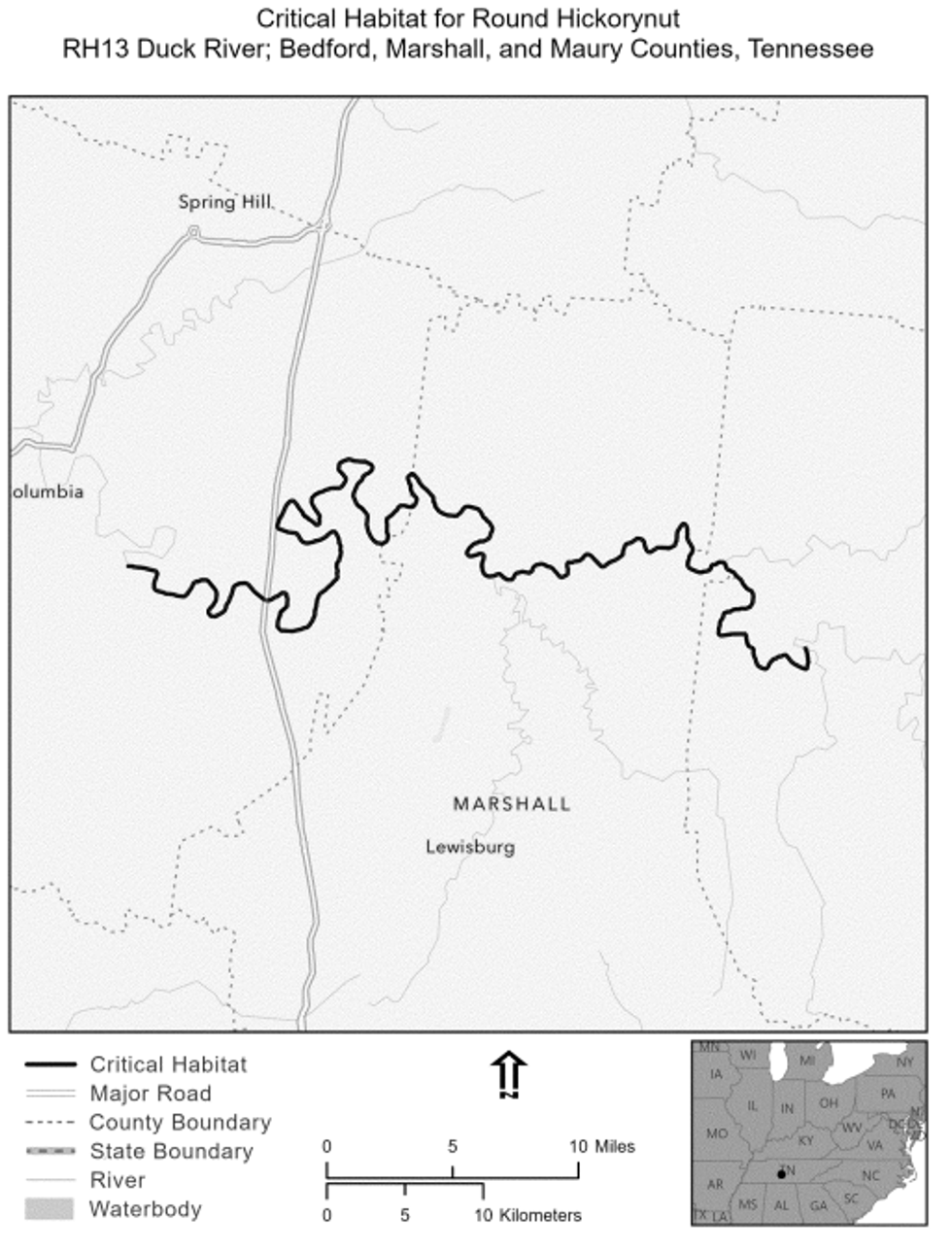
(19) Unit RH 14: Big Black River; Montgomery County, Mississippi.
(i) Unit RH 14 consists of 4 river mi (7 km) of the Big Black River in Montgomery County, Mississippi. All of riparian lands that border the unit are private ownership.
(ii) Map of Unit RH 14 follows:
Figure 15 to Round Hickorynut (Obovaria subrotunda) paragraph (19)(ii)
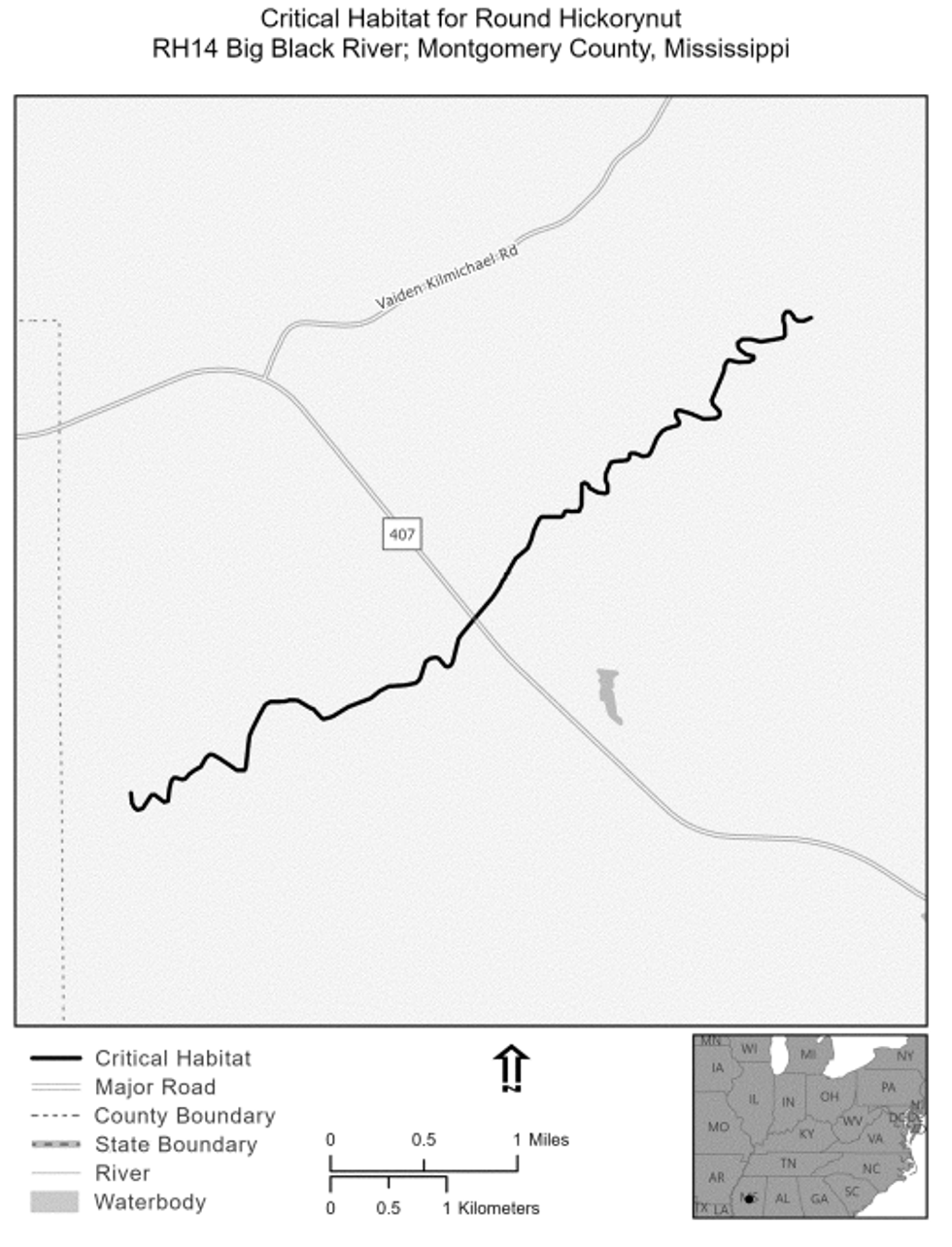
Longsolid (Fusconaia subrotunda)
(1) Critical habitat units for the longsolid are depicted on the maps in this entry for Jackson, Madison, and Marshall Counties, Alabama; Bath, Butler, Campbell, Edmonson, Fleming, Green, Harrison, Hart, Kenton, Morgan, Nicholas, Pendleton, Robertson, Rowan, Taylor, and Warren Counties, Kentucky; Clarion, Crawford, Erie, Forest, Mercer, Venango, and Warren Counties, Pennsylvania; Claiborne, Hancock, Hawkins, Smith, Trousdale, and Wilson Counties, Tennessee; Russell, Scott, Tazewell, and Wise Counties, Virginia; and Braxton, Calhoun, Clay, Doddridge, Fayette, Gilmer, Kanawha, Ritchie, Tyler, and Wood Counties, West Virginia.
(2) Within these areas, the physical or biological features essential to the conservation of the longsolid consist of the following components:
(i) Adequate flows, or a hydrologic flow regime (magnitude, timing, frequency, duration, rate of change, and overall seasonality of discharge over time), necessary to maintain benthic habitats where the species is found and to maintain stream connectivity, specifically providing for the exchange of nutrients and sediment for maintenance of the mussel's and fish host's habitat and food availability, maintenance of spawning habitat for native fishes, and the ability for newly transformed juveniles to settle and become established in their habitats. Adequate flows ensure delivery of oxygen, enable reproduction, deliver food to filter-feeding mussels, and reduce contaminants and fine sediments from interstitial spaces. Stream velocity is not static over time, and variations may be attributed to seasonal changes (with higher flows in winter/spring and lower flows in summer/fall), extreme weather events (e.g., drought or floods), or anthropogenic influence (e.g., flow regulation via impoundments).
(ii) Suitable substrates and connected instream habitats, characterized by geomorphically stable stream channels and banks (i.e., channels that maintain lateral dimensions, longitudinal profiles, and sinuosity patterns over time without an aggrading or degrading bed elevation) with habitats that support a diversity of freshwater mussel and native fish (such as, stable riffle-run-pool habitats that provide flow refuges consisting of predominantly silt-free, stable sand, gravel, and cobble substrates).
(iii) Water and sediment quality necessary to sustain natural physiological processes for normal behavior, growth, and viability of all life stages, including (but not limited to): Dissolved oxygen (generally above 2 to 3 parts per million (ppm)), salinity (generally below 2 to 4 ppm), and temperature (generally below 86°Fahrenheit (°F) (30 °Celsius (°C)). Additionally, water and sediment should be low in ammonia (generally below 0.5 ppm total ammonia-nitrogen) and heavy metal concentrations, and lack excessive total suspended solids and other pollutants.
(iv) The presence and abundance of fish hosts necessary for recruitment of the longsolid (currently unknown, likely includes the minnows of the family Cyprinidae and banded sculpin (Cottus carolinae)).
(3) Critical habitat does not include manmade structures (such as buildings, aqueducts, runways, roads, and other paved areas) and the land on which they are located existing within the legal boundaries on April 10, 2023.
(4) Data layers defining map units were created by overlaying Natural Heritage Element Occurrence data and U.S. Geological Survey hydrologic data for stream reaches. The hydrologic data used in the critical habitat maps were extracted from the U.S. Geological Survey 1:1M scale nationwide hydrologic layer (https://www.usgs.gov/core-science-systems/ngp/national-hydrography) with a projection of EPSG:4269—NAD83 Geographic. Natural Heritage program and State mussel database species presence data from Pennsylvania, West Virginia, Virginia, Kentucky, Tennessee, and Alabama were used to select specific river and stream segments for inclusion in the critical habitat layer. The maps in this entry, as modified by any accompanying regulatory text, establish the boundaries of the critical habitat designation. The coordinates or plot points or both on which each map is based are available to the public at the Service's internet site at https://www.regulations.gov at Docket No. FWS-R4-ES-2020-0010, and at the field office responsible for this designation. You may obtain field office location information by contacting one of the Service regional offices, the addresses of which are listed at 50 CFR 2.2.
(5) Index map for the longsolid follows:
Figure 1 to Longsolid (Fusconaia subrotunda) paragraph (5)
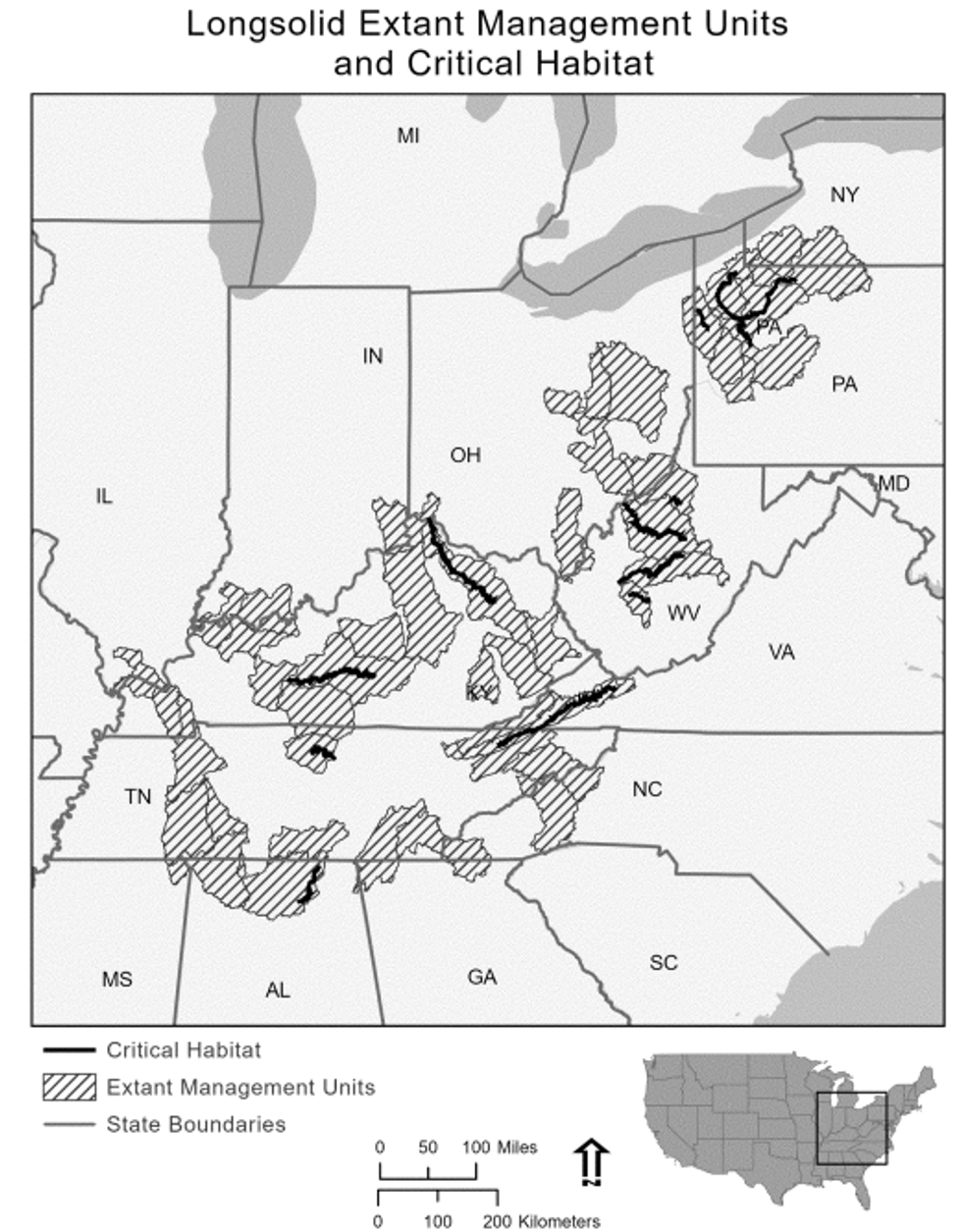
(6) Unit LS 1: French Creek; Crawford, Erie, Mercer, and Venango Counties, Pennsylvania.
(i) Unit LS 1 consists of 120 stream mi (191.5 km) of French Creek in Crawford, Erie, Mercer, and Venango Counties, Pennsylvania. Approximately 106 stream mi (170.6 km; 76 percent) of riparian lands that border the unit are private ownership, and 14 stream mi (22.1 km; 24 percent) are public (Federal or State) ownership. This unit begins immediately downstream of the Union City Dam, which is operated by the U.S. Army Corps of Engineers.
(ii) Map of Unit LS 1 follows:
Figure 2 to Longsolid (Fusconaia subrotunda) paragraph (6)(ii)
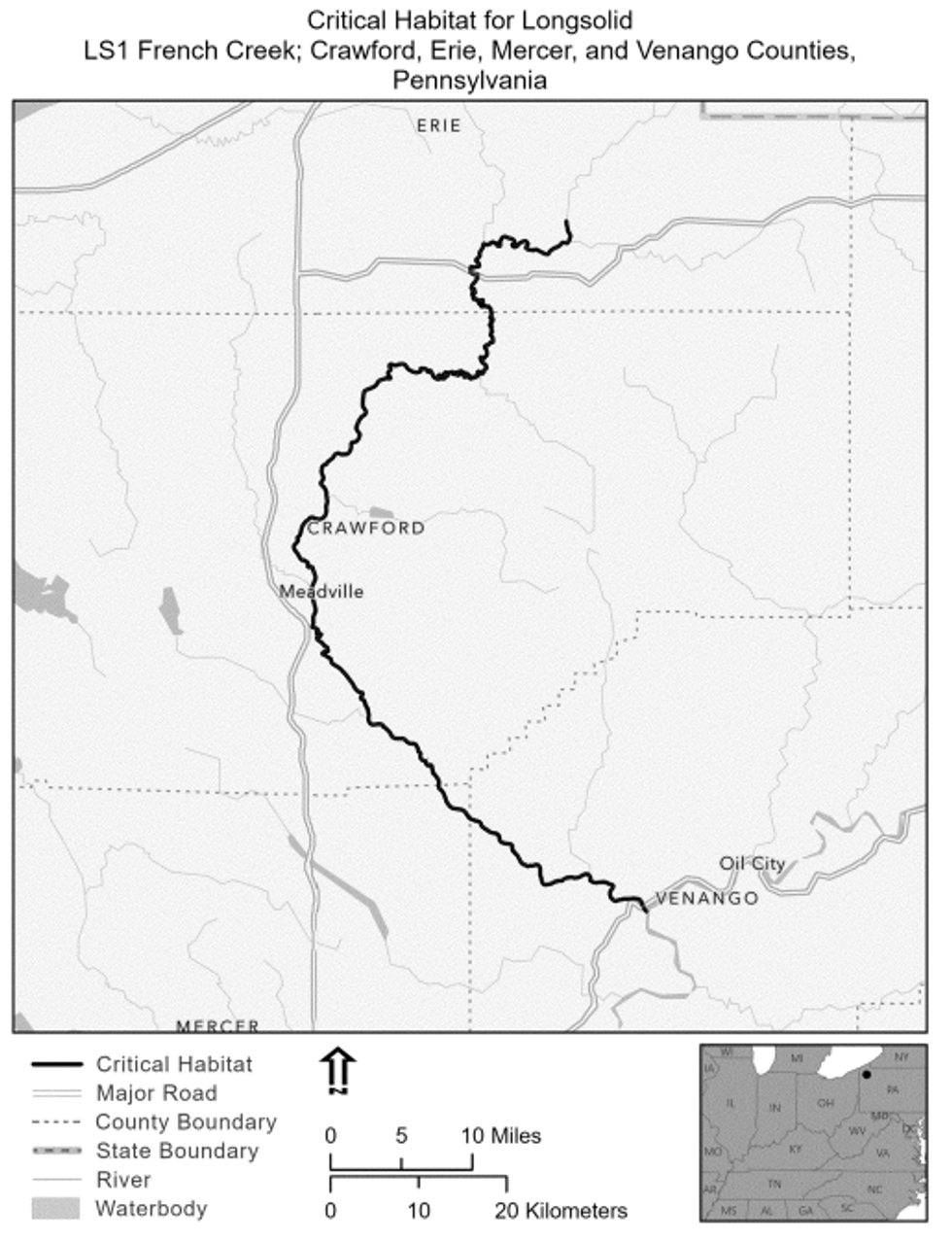
(7) Unit LS 2: Allegheny River; Clarion, Crawford, Forest, Venango, and Warren Counties, Pennsylvania.
(i) Unit LS 2 consists of 99 river mi (159.3 km) of the Allegheny River in Clarion, Crawford, Forest, Venango, and Warren Counties, Pennsylvania. Approximately 15 river mi (24.1 km; 14 percent) of riparian lands that border the unit are private ownership, and 84 river mi (135.8 km; 86 percent) are public (Federal or State; primarily Allegheny National Forest) ownership. This unit is immediately downstream of Kinzua Dam, which is operated by the U.S. Army Corps of Engineers.
(ii) Map of Unit LS 2 follows:
Figure 3 to Longsolid (Fusconaia subrotunda) paragraph (7)(ii)
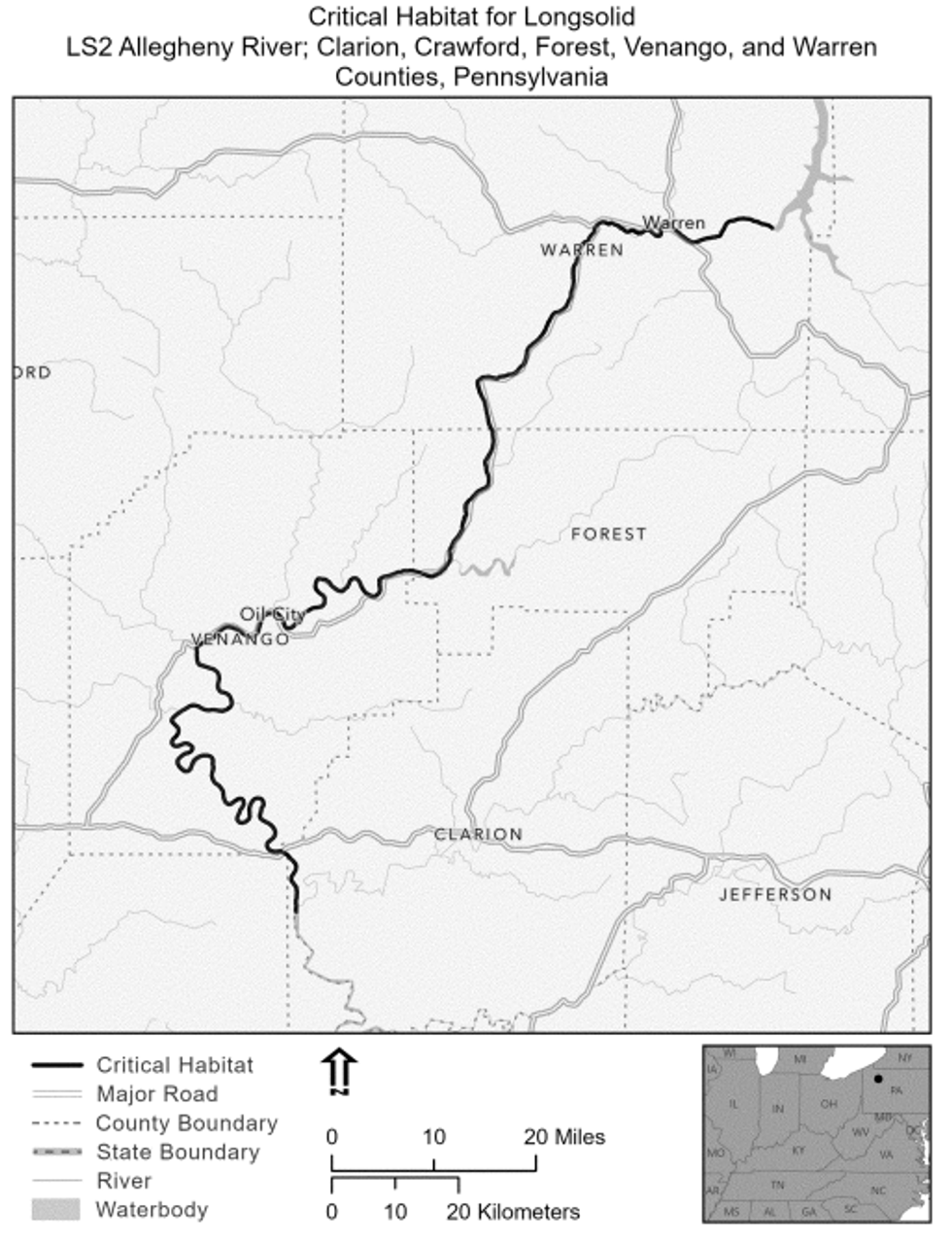
(8) Unit LS 3: Shenango River; Crawford and Mercer Counties, Pennsylvania.
(i) Unit LS 3 consists of 22 river miles (mi) (35.5 kilometers (km)) of the Shenango River in Crawford County, Pennsylvania, from Pymatuning Dam downstream to the point of inundation by Shenango River Lake near Big Bend, Mercer County, Pennsylvania. Approximately 15 river mi (24.3 km; 68 percent) of riparian lands that border the unit are private ownership, and 7 river mi (11.3 km; 32 percent) are public (Federal or State) ownership. This unit is immediately downstream from the Pymatuning Dam, which is owned by the State of Pennsylvania.
(ii) Map of Unit LS 3 follows:
Figure 4 to Longsolid (Fusconaia subrotunda) paragraph (8)(ii)
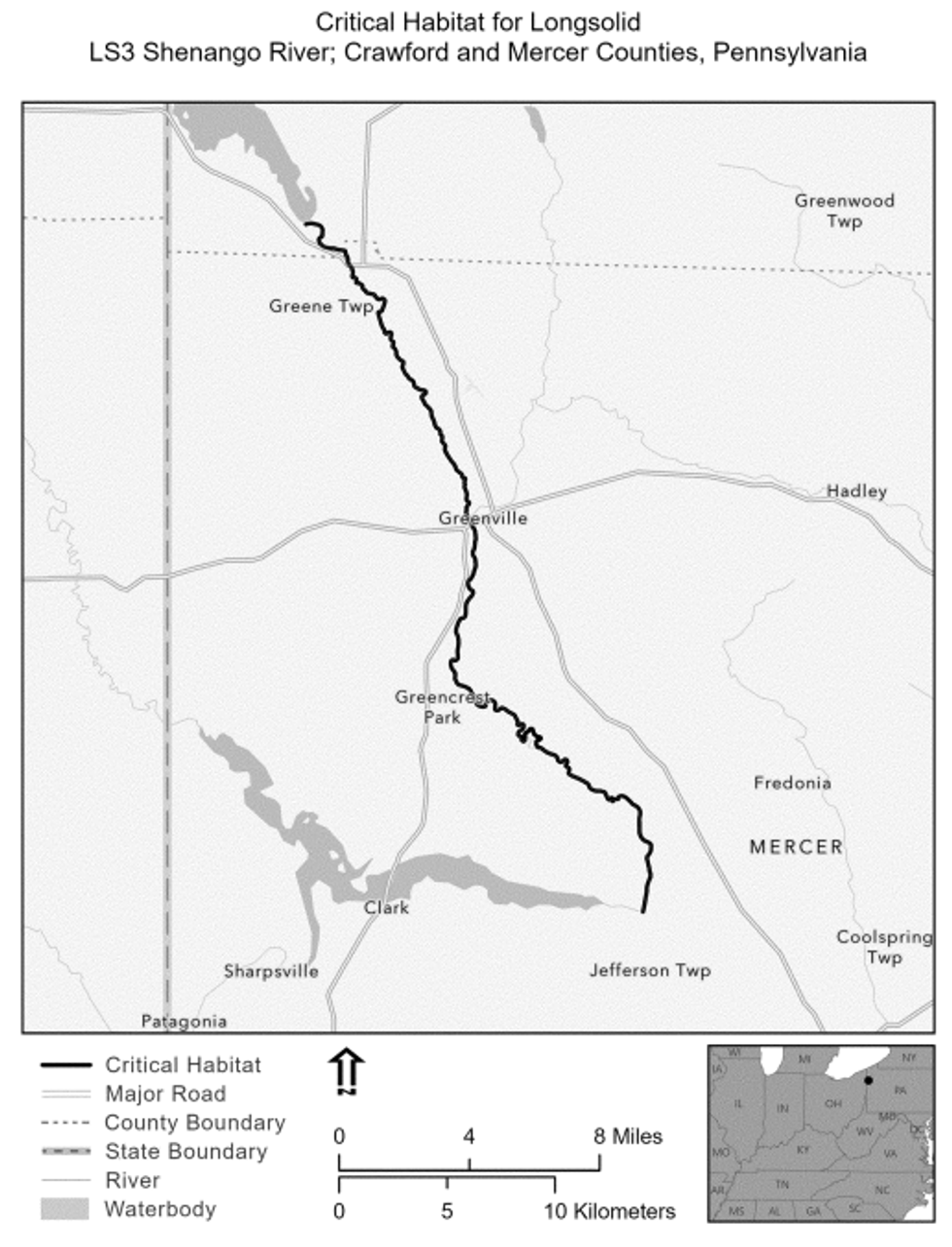
(9) Unit LS 4: Middle Island Creek; Doddridge and Tyler Counties, West Virginia.
(i) Unit LS 4 consists of 14 stream mi (23.7 km) of Middle Island Creek in Doddridge and Tyler Counties, West Virginia. Approximately 14 stream mi (23.5 km; 99 percent) of riparian lands that border the unit are private ownership, and 0.1 stream mi (0.2 km; less than 1 percent) are public (local) ownership.
(ii) Map of Unit LS 4 follows:
Figure 5 to Longsolid (Fusconaia subrotunda) paragraph (9)(ii)
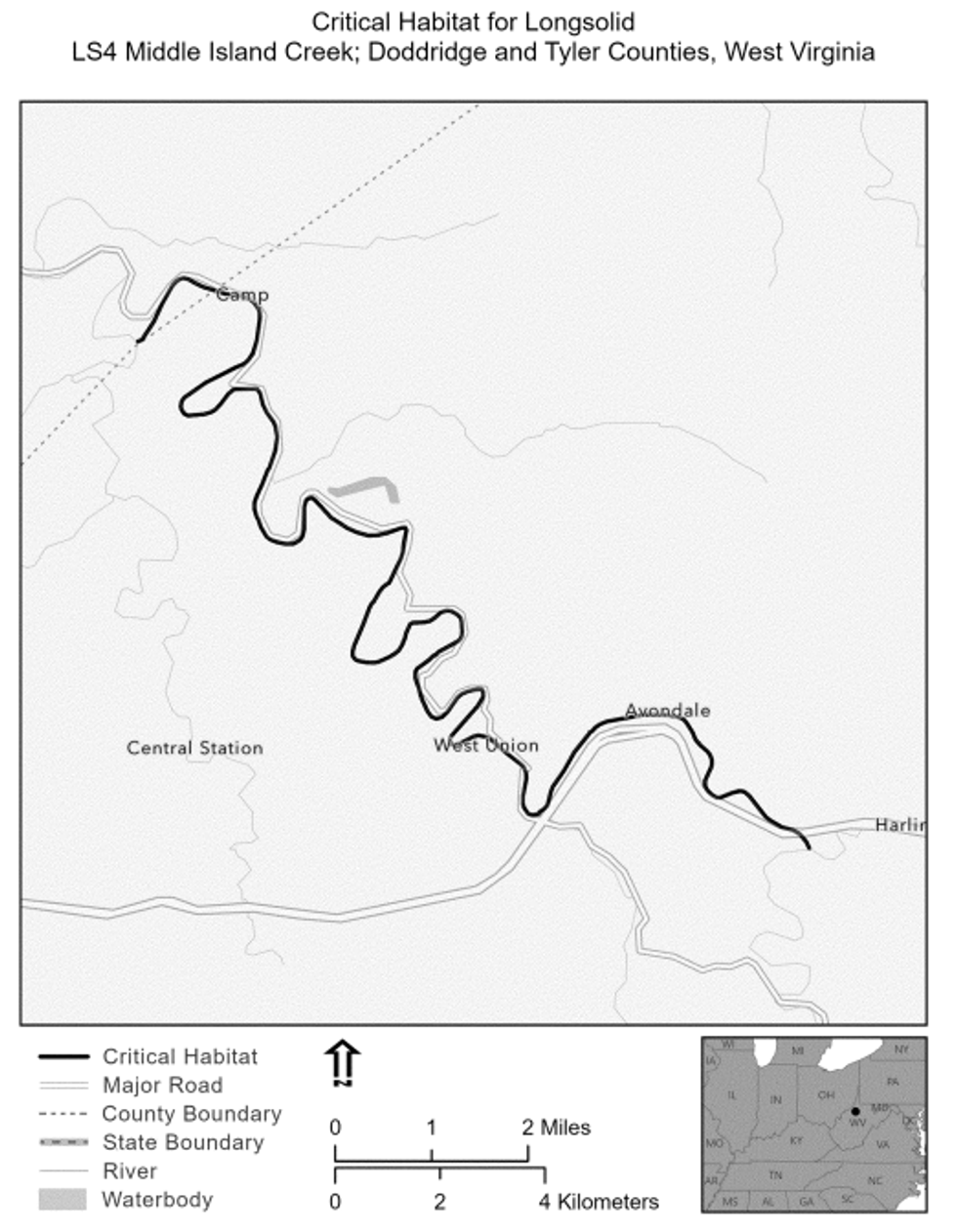
(10) Unit LS 5: Little Kanawha River; Calhoun, Gilmer, Ritchie, and Wood Counties, West Virginia.
(i) Unit LS 5 consists of 123 river mi (198 km) of the Little Kanawha River in Calhoun, Gilmer, Ritchie, and Wood Counties, West Virginia. Approximately 122 river mi (197.2 km; 99 percent) are private ownership, and 0.53 river mi (0.9 km; 1 percent) are public (Federal or State) ownership. This unit is directly below the Burnsville Dam, which is operated by the U.S. Army Corps of Engineers.
(ii) Map of Unit LS 5 follows:
Figure 6 to Longsolid (Fusconaia subrotunda) paragraph (10)(ii)
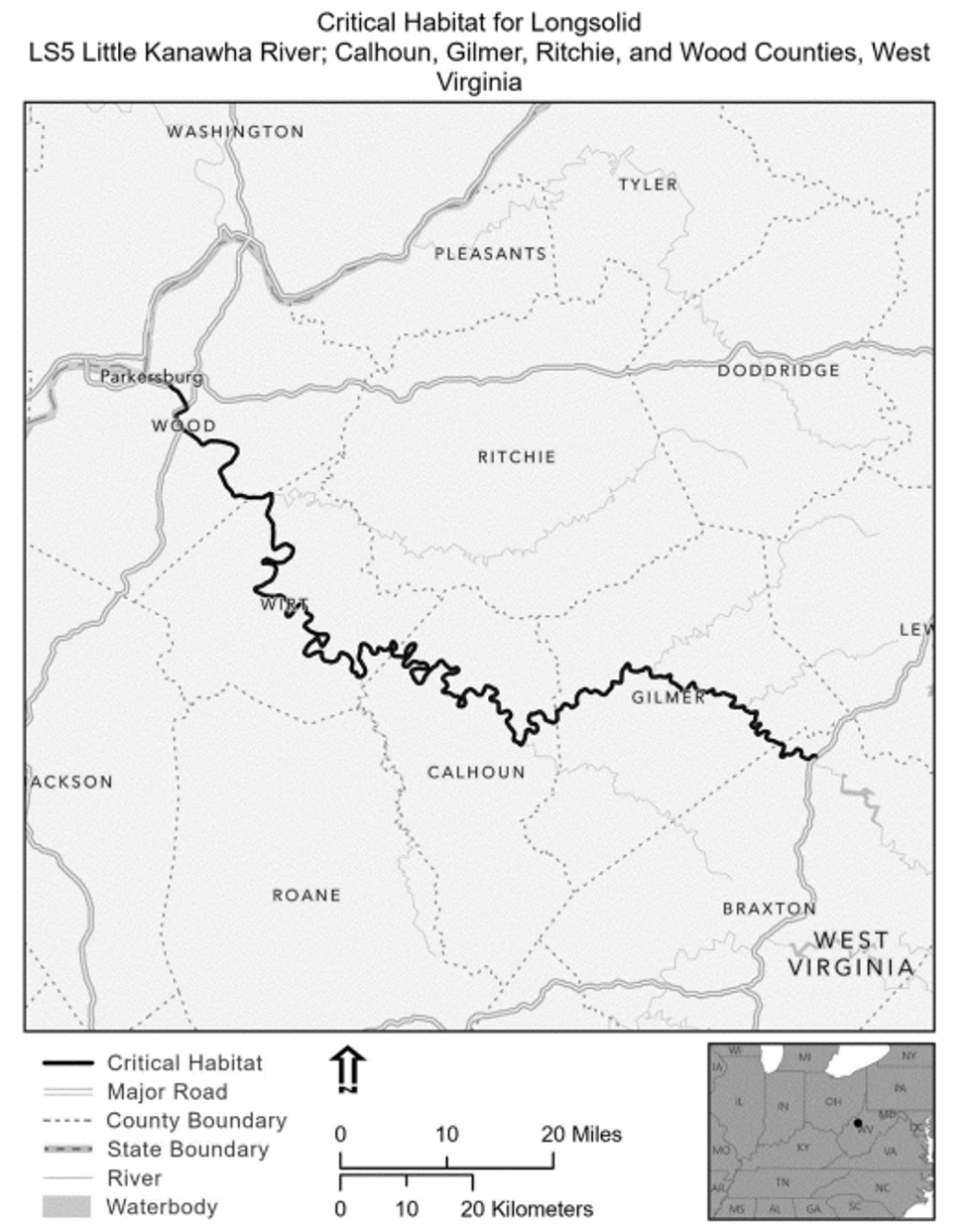
(11) Unit LS 6: Elk River; Braxton, Clay, and Kanawha Counties, West Virginia.
(i) Unit LS 6 consists of 101 river mi (163 km) of the Elk River in Braxton, Clay, and Kanawha Counties, West Virginia. Approximately 93 river mi (150.3 km; 92 percent) of riparian lands that border the unit are private ownership, and 7 river mi (12.7 km; 8 percent) are public (Federal, State, or local) ownership. This unit is directly below Sutton Dam, which is operated by the U.S. Army Corps of Engineers.
(ii) Map of Unit LS 6 follows:
Figure 7 to Longsolid (Fusconaia subrotunda) paragraph (11)(ii)
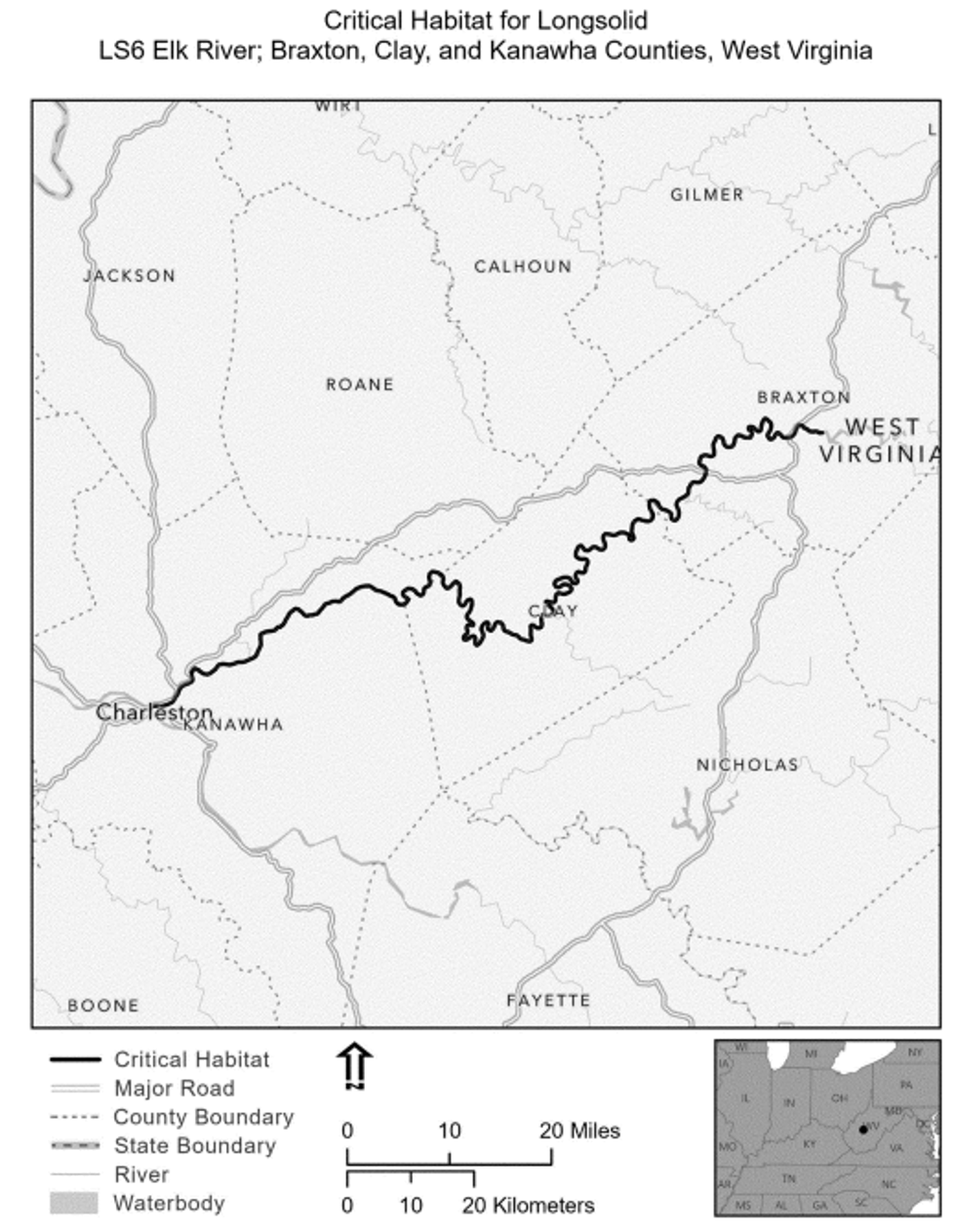
(12) Unit LS 7: Kanawha River; Fayette and Kanawha Counties, West Virginia.
(i) Unit LS 7 consists of 21 river mi (33.9 km) of the Kanawha River in Fayette and Kanawha Counties, West Virginia. Approximately 18 river mi (29.3 km; 90 percent) of riparian lands that border the unit are private ownership, and 2 river mi (4.6 km; 10 percent) are public (Federal, State, or local) ownership. London and Marmet locks and dams within this unit are operated by the U.S. Army Corps of Engineers.
(ii) Map of Unit LS 7 follows:
Figure 8 to Longsolid (Fusconaia subrotunda) paragraph (12)(ii)
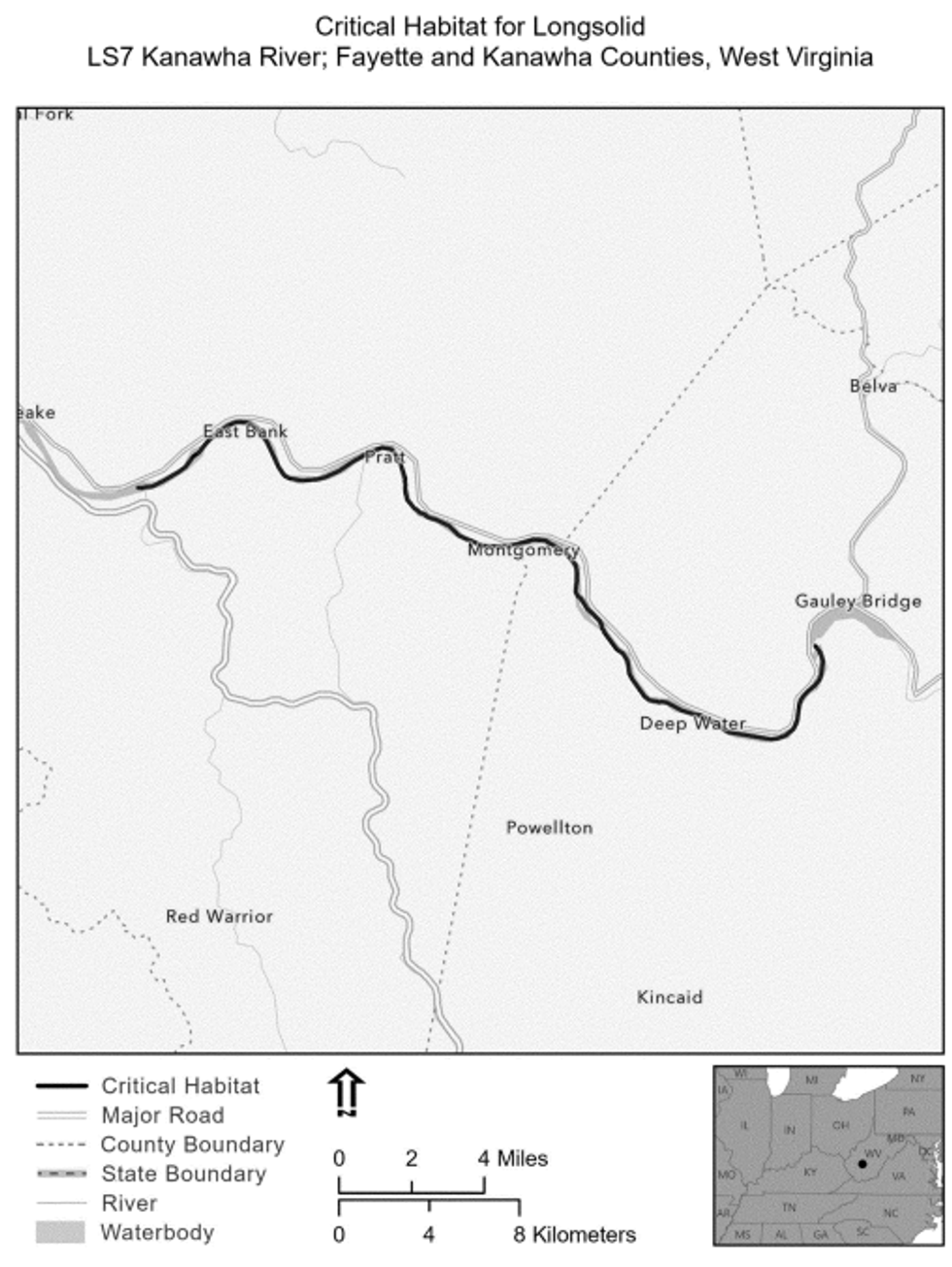
(13) Unit LS 8: Licking River; Bath, Campbell, Fleming, Harrison, Kenton, Morgan, Nicholas, Pendleton, Robertson, and Rowan Counties, Kentucky.
(i) Unit LS 8 consists of 181 river mi (291.5 km) of the Licking River in Bath, Campbell, Fleming, Harrison, Kenton, Morgan, Nicholas, Pendleton, Robertson, and Rowan Counties, Kentucky. Approximately 161 river mi (259.7 km; 90 percent) of riparian lands that border the unit are private ownership, and 19 river mi (31.7 km; 10 percent) are public (Federal, State, or local) ownership. This unit is directly below Cave Run Dam, which is operated by the U.S. Army Corps of Engineers.
(ii) Map of Unit LS 8 follows:
Figure 9 to Longsolid (Fusconaia subrotunda) paragraph (13)(ii)
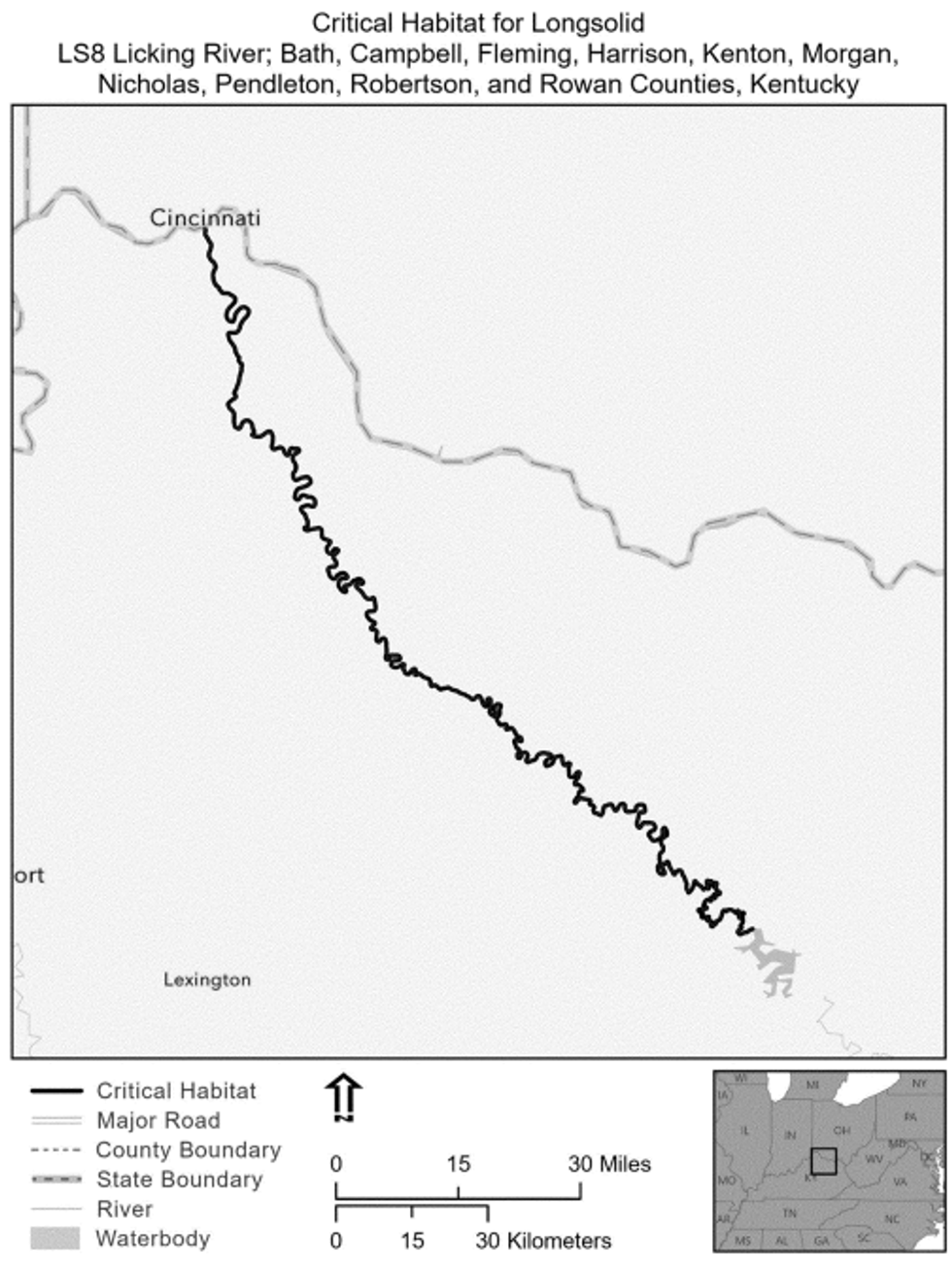
(14) Unit LS 9: Green River; Butler, Edmonson, Green, Hart, Taylor, and Warren Counties, Kentucky.
(i) Unit LS 9 consists of 156 river mi (251.6 km) of the Green River in Butler, Edmonson, Green, Hart, Taylor, and Warren Counties, Kentucky. Approximately 105 river mi (169.2 km; 67 percent) of riparian lands that border the unit are private ownership, and 51 river mi (82.4 km; 33 percent) are public (Federal, State, or local) ownership, including Mammoth Cave National Park. This unit is directly below Green River Dam, which is operated by the U.S. Army Corps of Engineers.
(ii) Map of Unit LS 9 follows:
Figure 10 to Longsolid (Fusconaia subrotunda) paragraph (14)(ii)
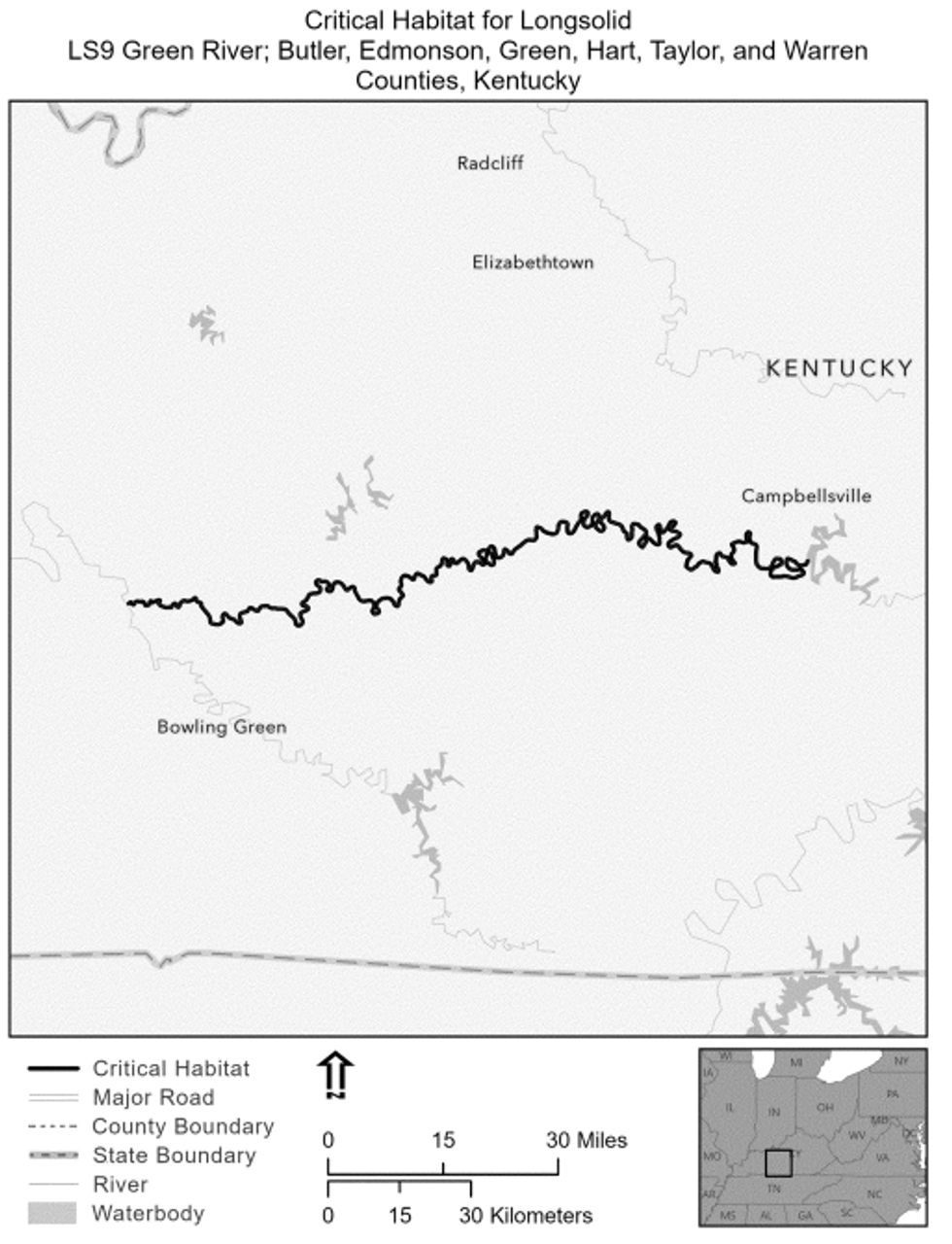
(15) Unit LS 10: Cumberland River; Smith, Trousdale, and Wilson Counties, Tennessee.
(i) Unit LS 10 consists of 48 river mi (77.5 km) of the Cumberland River in Smith, Trousdale, and Wilson Counties, Tennessee. All riparian lands that border the river are owned by the U.S. Army Corps of Engineers (Federal; 48 river mi (77.5 km)). This unit also falls within the Tennessee Wildlife Resources Agency's Rome Landing Sanctuary. Cordell Hull and Old Hickory Dams, upstream and downstream of this unit, respectively, are operated by the U.S. Army Corps of Engineers.
(ii) Map of Unit LS 10 follows:
Figure 11 to Longsolid (Fusconaia subrotunda) paragraph (15)(ii)
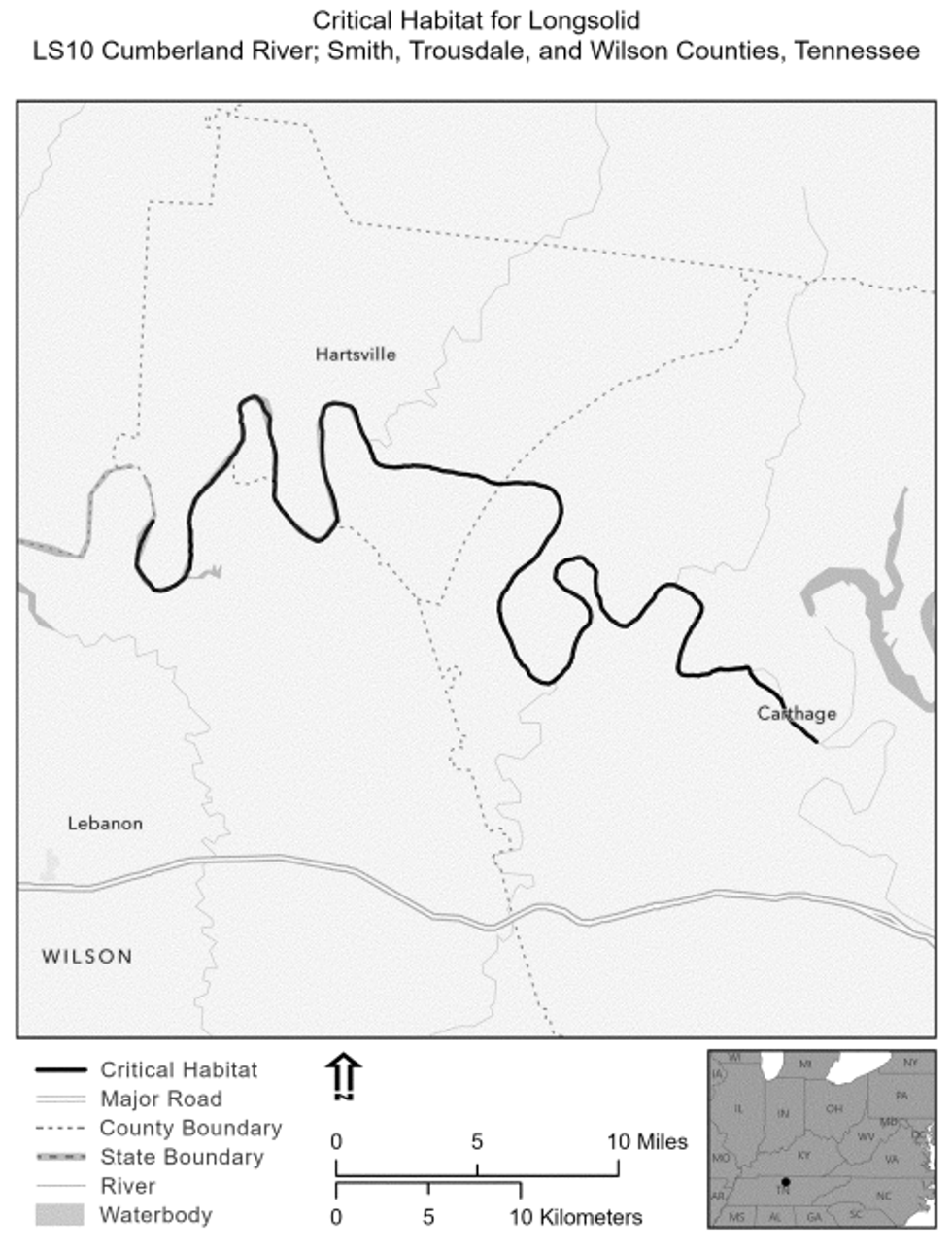
(16) Unit LS 11: Clinch River; Russell, Scott, Tazewell, and Wise Counties, Virginia; Claiborne, Hancock, and Hawkins Counties, Tennessee.
(i) Unit LS 11 consists of 177 river mi (286.1 km) of the Clinch River in Russell, Scott, Tazewell, and Wise Counties, Virginia, and Claiborne, Hancock, and Hawkins Counties, Tennessee. Approximately 160 river mi (258.8 km; 90 percent) of riparian lands that border the unit are private ownership, and 17 river mi (27.3 km; 10 percent) are public (Federal or State) ownership. The Tennessee portion of this unit is encompassed by the Tennessee Wildlife Resources Agency's Clinch River Sanctuary.
(ii) Map of Unit LS 11 follows:
Figure 12 to Longsolid (Fusconaia subrotunda) paragraph (16)(ii)
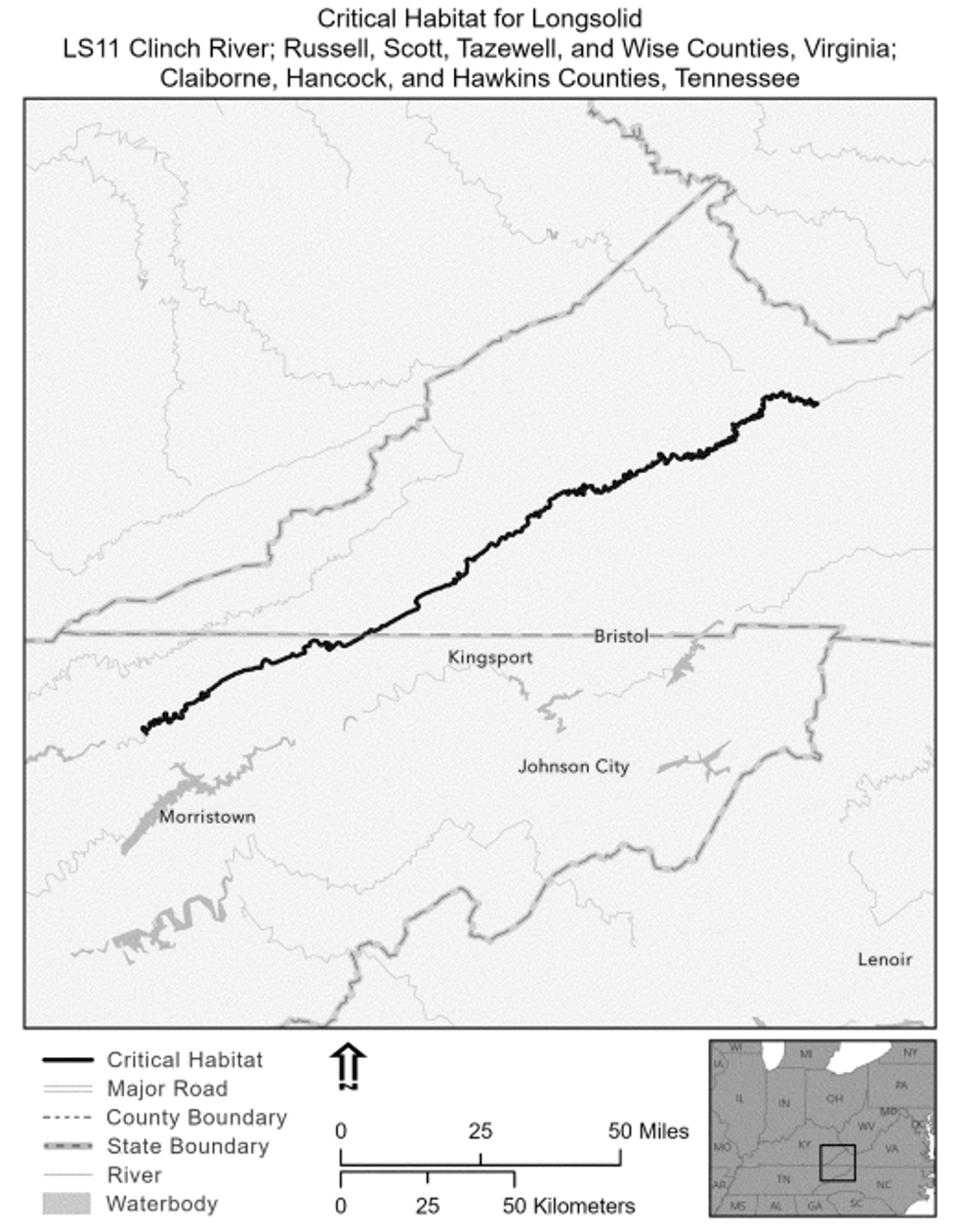
(17) Unit LS 12: Paint Rock River; Jackson, Madison, and Marshall Counties, Alabama.
(i) Unit LS 12 consists of 58 river mi (94.5 km) of the Paint Rock River in Jackson, Madison, and Marshall Counties, Alabama. Approximately 2 river mi (4.1 km; 3 percent) of riparian lands that border the unit are private ownership, and 56 river mi (90.4 km; 97 percent) are public (Federal or State) ownership.
(ii) Map of Unit LS 12 follows:
Figure 13 to Longsolid (Fusconaia subrotunda) paragraph (17)(ii)
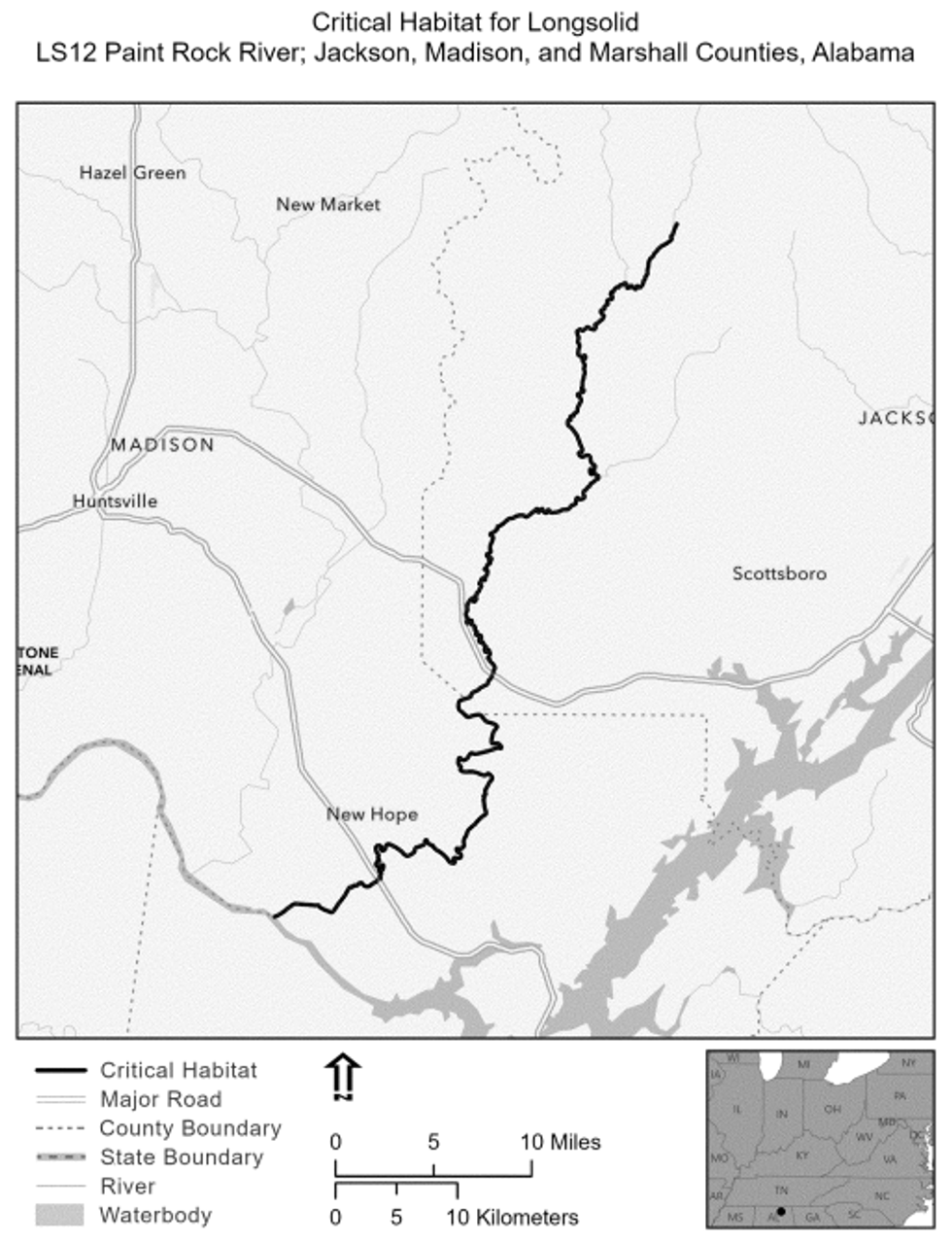
Nine Mobile River Basin Mussel Species: Ovate Clubshell (Pleurobema Perovatum), Southern Clubshell (Pleurobema Decisum), Triangular Kidneyshell (Ptychobranchus Greenii), Alabama Moccasinshell (Medionidus Acutissimus), Coosa Moccasinshell (Medionidus Parvulus), Orange-Nacre Mucket (Hamiota Perovalis), Dark Pigtoe (Pleurobema Furvum), Southern Pigtoe (Pleurobema Georgianum), and Fine-Lined Pocketbook (Hamiota Altilis)
(1) The primary constituent elements essential for the conservation of the ovate clubshell ( Pleurobema perovatum ), southern clubshell ( Pleurobema decisum ), triangular kidneyshell ( Ptychobranchus greenii ), Alabama moccasinshell ( Medionidus acutissimus ), Coosa moccasinshell ( Medionidus parvulus ), orange-nacre mucket ( Hamiota perovalis ), dark pigtoe ( Pleurobema furvum ), southern pigtoe ( Pleurobema georgianum ), and fine-lined pocketbook ( Hamiota altilis ) are those habitat components that support feeding, sheltering, reproduction, and physical features for maintaining the natural processes that support these habitat components. The primary constituent elements include:
(i) Geomorphically stable stream and river channels and banks;
(ii) A flow regime (i.e., the magnitude, frequency, duration, and seasonality of discharge over time) necessary for normal behavior, growth, and survival of all life stages of mussels and their fish hosts in the river environment;
(iii) Water quality, including temperature, pH, hardness, turbidity, oxygen content, and other chemical characteristics, necessary for normal behavior, growth, and viability of all life stages;
(iv) Sand, gravel, and/or cobble substrates with low to moderate amounts of fine sediment, low amounts of attached filamentous algae, and other physical and chemical characteristics necessary for normal behavior, growth, and viability of all life stages;
(v) Fish hosts, with adequate living, foraging, and spawning areas for them; and
(vi) Few or no competitive nonnative species present.
(2) Critical habitat unit descriptions and maps. The maps provided are for informational purposes only.
(i) Index map. The index map showing critical habitat units in the States of Mississippi, Alabama, Georgia, and Tennessee for the nine Mobile River Basin mussel species follows:
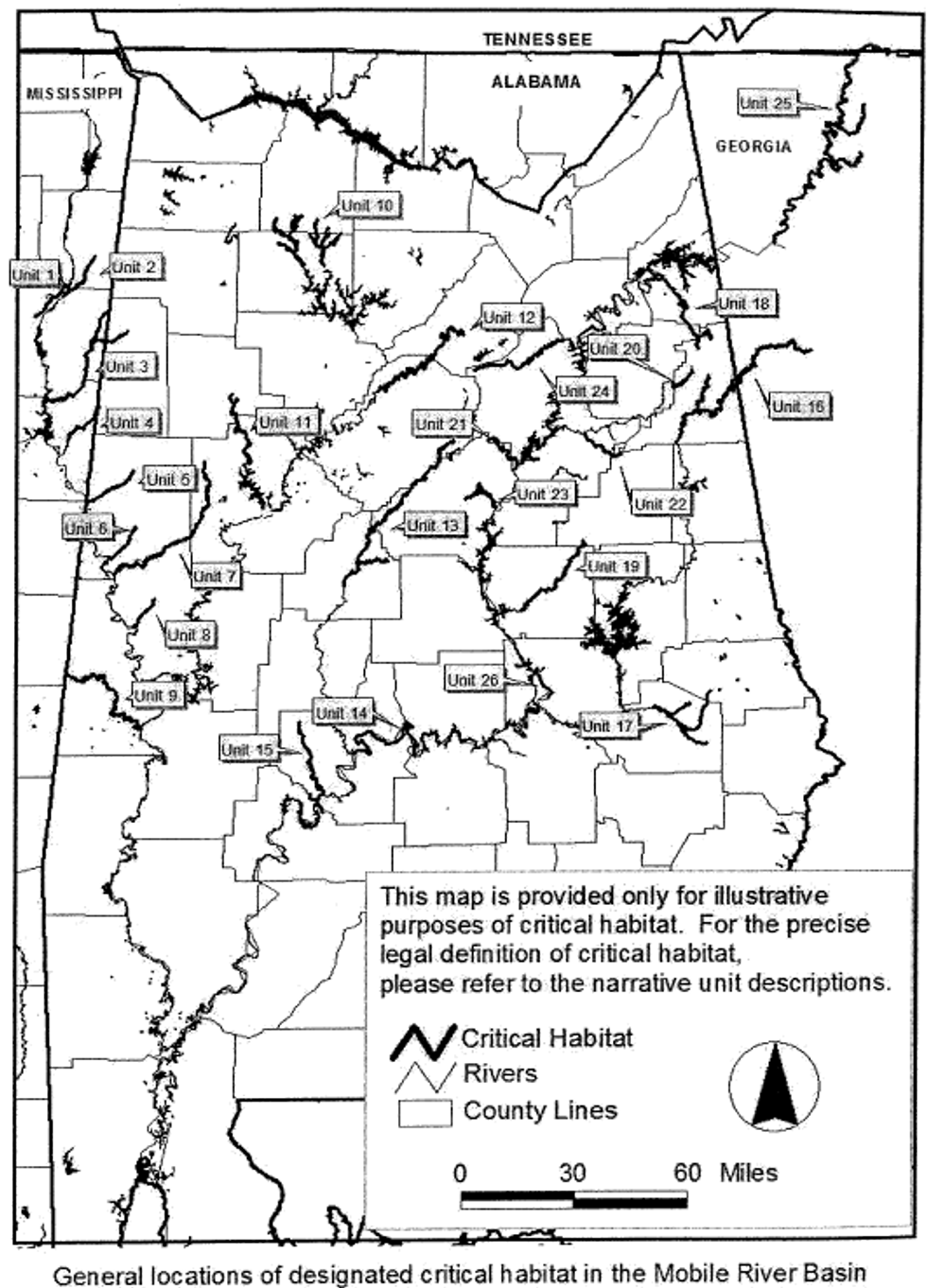
(ii) Protected species and critical habitat units. A table listing the protected species, their respective critical habitat units, and the States that contain those habitat units follows. Detailed critical habitat unit descriptions and maps appear below the table.
| Species | Critical habitat units | States |
|---|---|---|
| Ovate clubshell ( Pleurobema perovatum ) | Units 1, 2, 3, 4, 5, 6, 7, 8, 9, 10, 11, 12, 13, 17, 18, 19, 21, 24, 25, 26 | AL, GA, MS, TN. |
| Southern clubshell ( Pleurobema decisum ) | Units 1, 2, 3, 4, 5, 6, 7, 8, 9, 13, 14, 15, 17, 18, 19, 21, 24, 25, 26 | AL, GA, MS, TN. |
| Triangular kidneyshell ( Ptychobranchus greenii ) | Units 10, 11, 12, 13, 18, 19, 20, 21, 22, 23, 24, 25, 26 | AL, GA, TN. |
| Alabama moccasinshell ( Medionidus acutissimus ) | Units 1, 2, 3, 4, 5, 6, 7, 8, 9, 10, 11, 12, 13, 15, 25, 26 | AL, GA, MS, TN. |
| Coosa moccasinshell ( Medionidus parvulus ) | Units 18, 19, 20, 21, 22, 23, 24, 25, 26 | AL, GA, TN. |
| Orange-nacre mucket ( Hamiota perovalis ) | Units 1, 2, 3, 4, 5, 6, 7, 8, 9, 10, 11, 12, 13, 14, 15 | AL, MS. |
| Dark pigtoe ( Pleurobema furvum ) | Units 10, 11, 12 | AL. |
| Southern pigtoe ( Pleurobema georgianum ) | Units 18, 19, 20, 21, 22, 23, 24, 25, 26 | AL, GA, TN. |
| Fine-lined pocketbook ( Hamiota altilis ) | Units 13, 16, 17, 18, 19, 20, 21, 22, 23, 24, 25, 26 | AL, GA, TN. |
(iii) Unit 1. East Fork Tombigbee River, Monroe, Itawamba County, Mississippi. This is a critical habitat unit for the ovate clubshell, southern clubshell, Alabama moccasinshell, and orange-nacre mucket.
(A) Unit 1 includes the East Fork Tombigbee River main stem from Mississippi Highway 278 (T13S R7E S3), Monroe County, upstream to the confluence of Mill Creek (T11S R8E S24), Itawamba County, Mississippi.
(B) Map of Unit 1 follows:
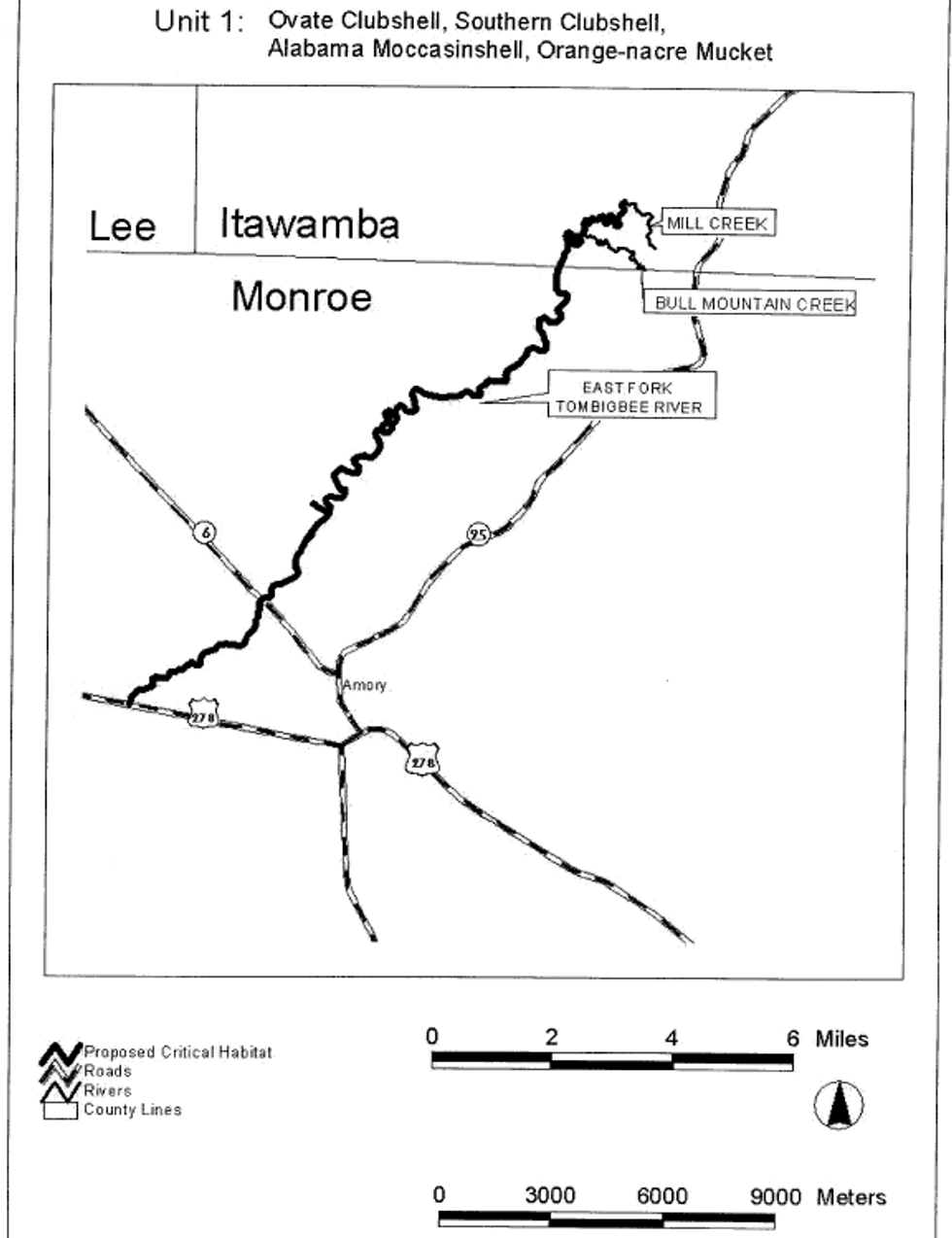
(iv) Unit 2. Bull Mountain Creek, Itawamba County, Mississippi. This is a critical habitat unit for the ovate clubshell, southern clubshell, Alabama moccasinshell, and orange-nacre mucket.
(A) Unit 2 includes the main stem of Bull Mountain Creek from Mississippi Highway 25 (T11S R9E S30), upstream to U.S. Highway 78 (T10S R10E S6), Itawamba County, Mississippi.
(B) Map of Unit 2 follows:
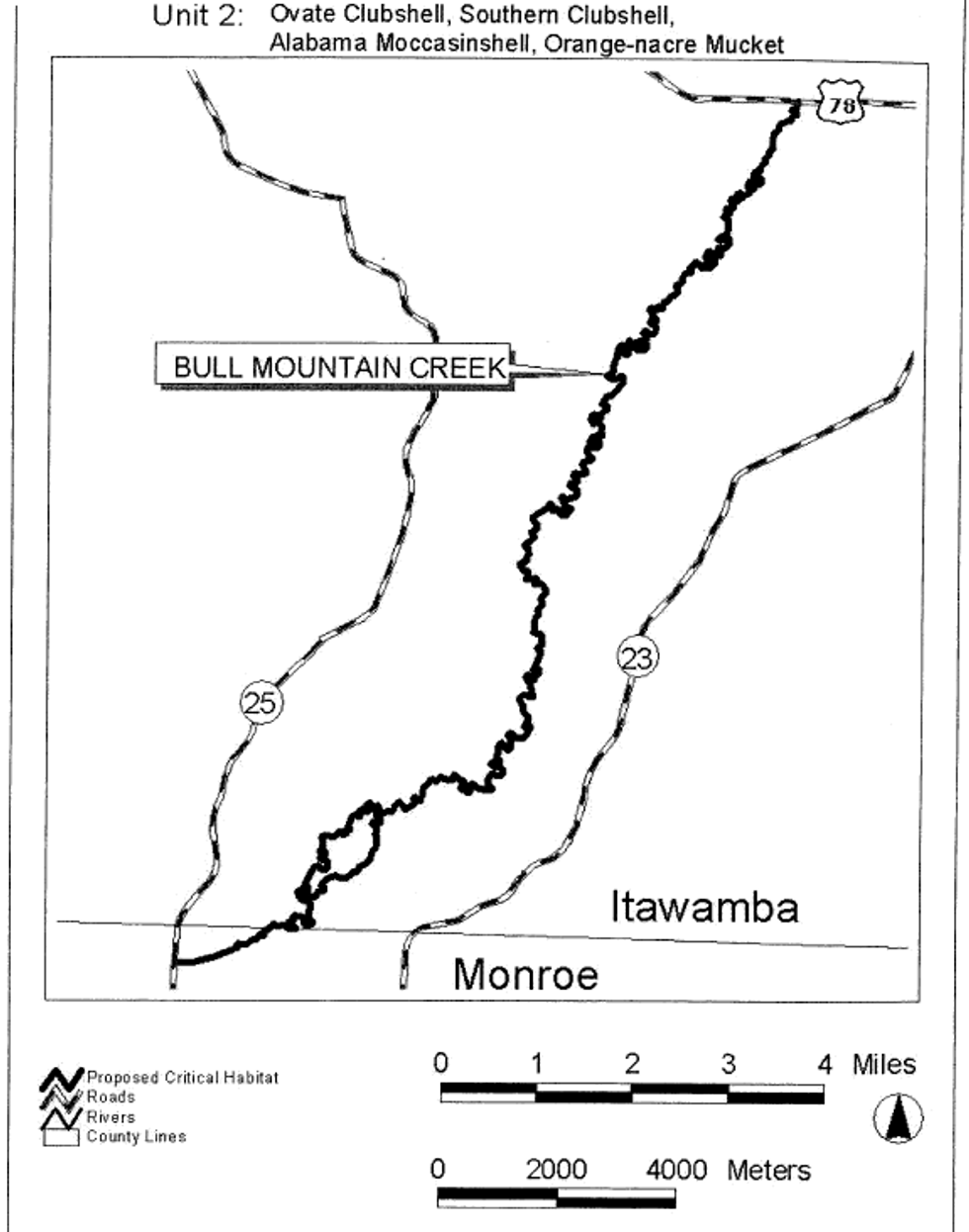
(v) Unit 3. Buttahatchee River and Sipsey Creek, Lowndes/Monroe County, Mississippi; Lamar County, Alabama. This is a critical habitat unit for the ovate clubshell, southern clubshell, Alabama moccasinshell, and orange-nacre mucket.
(A) Unit 3 includes the Buttahatchee River main stem from its confluence with the impounded waters of Columbus Lake (Tombigbee River, T16S R19W S23), Lowndes/Monroe County, Mississippi, upstream to the confluence of Beaver Creek (T13S R15W S17), Lamar County, Alabama; and Sipsey Creek, from its confluence with the Buttahatchee River (T14S R17W S2), upstream to the Mississippi/Alabama State Line (T12S R10E S21), Monroe County, Mississippi.
(B) Map of Unit 3 follows:
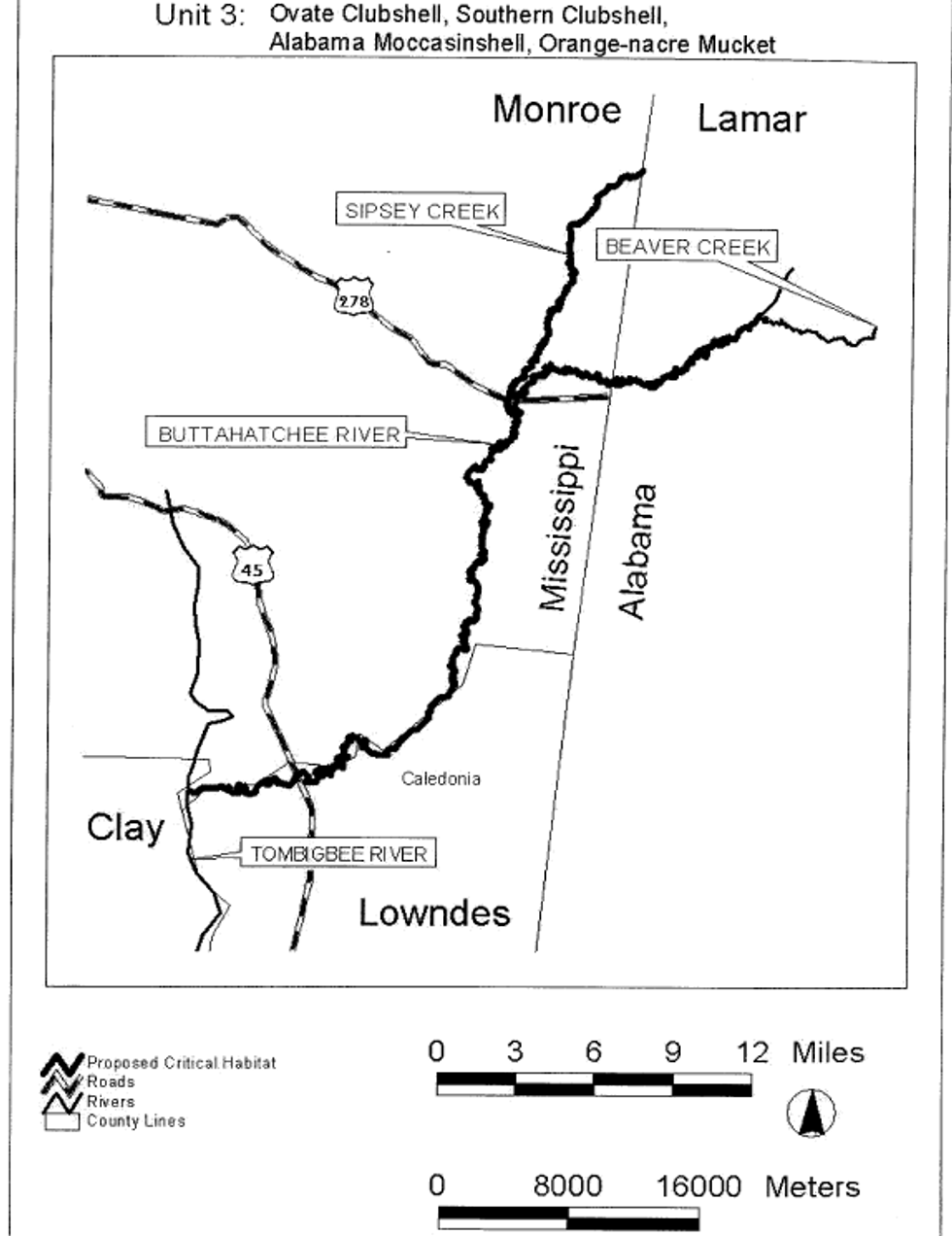
(vi) Unit 4. Luxapalila Creek and Yellow Creek, Lowndes County, Mississippi; Lamar County, Alabama. This is a critical habitat unit for the ovate clubshell, southern clubshell, Alabama moccasinshell, and orange-nacre mucket.
(A) Unit 4 includes the Luxapalila Creek main stem from Waterworks Road (T18S R18W S11), Columbus, Mississippi, upstream to approximately 1.0 km (0.6 mi) above Steens Road (T17S R17W S27), Lowndes County, Mississippi; and the Yellow Creek main stem from its confluence with Luxapalila Creek (T17S R17W S21), Lowndes County, Mississippi, upstream to the confluence of Cut Bank Creek (T16S R16W S30), Lamar County, Alabama.
(B) Map of Unit 4 follows:
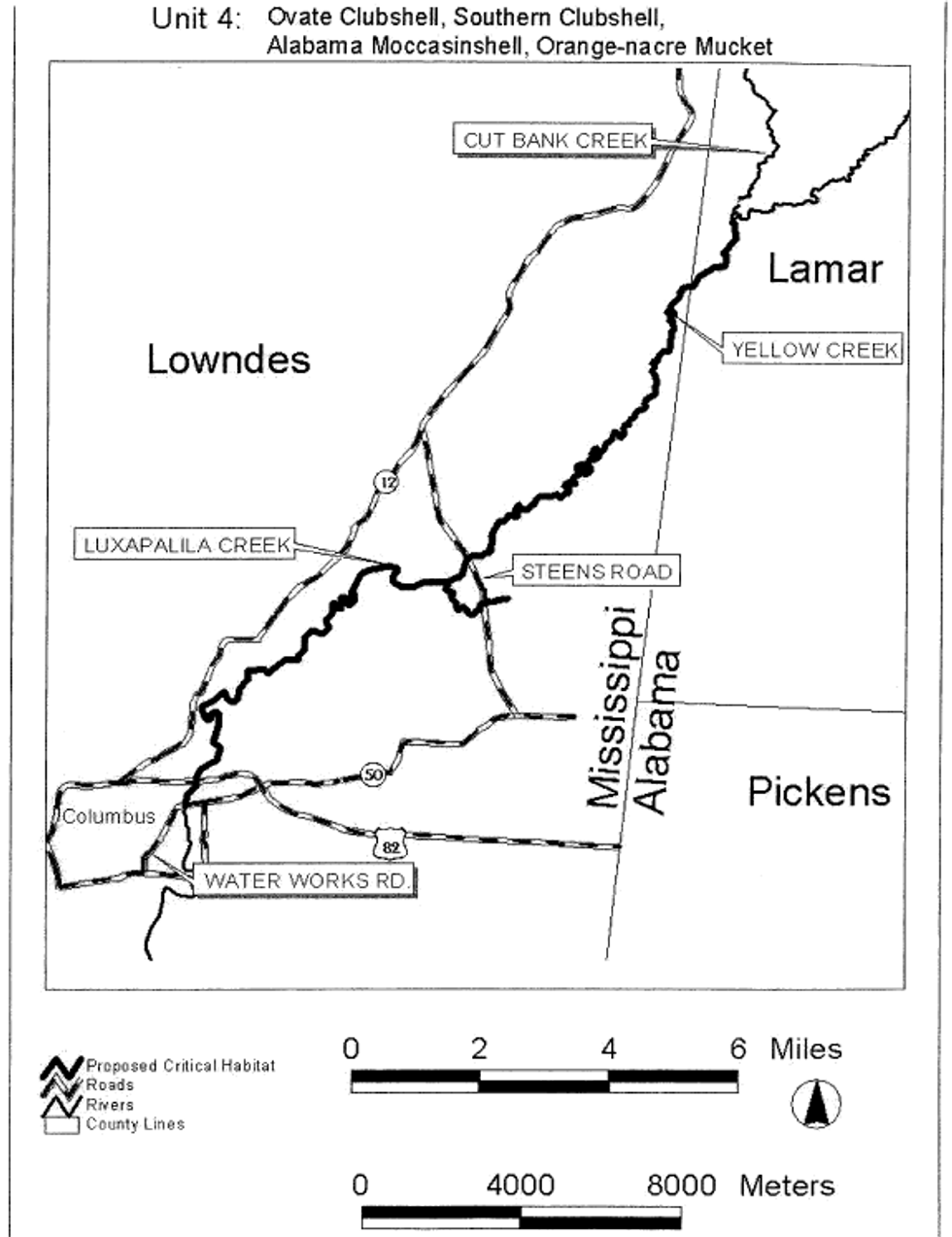
(vii) Unit 5. Coalfire Creek, Pickens County, Alabama. This is a critical habitat unit for the ovate clubshell, southern clubshell, Alabama moccasinshell, and orange-nacre mucket.
(A) Unit 5 includes the Coalfire Creek main stem from its confluence with the impounded waters of Aliceville Lake (Tombigbee River, T20S R17W S26), upstream to U.S. Highway 82 (T19S R15W S15), Pickens County, Alabama.
(B) Map of Unit 5 follows:
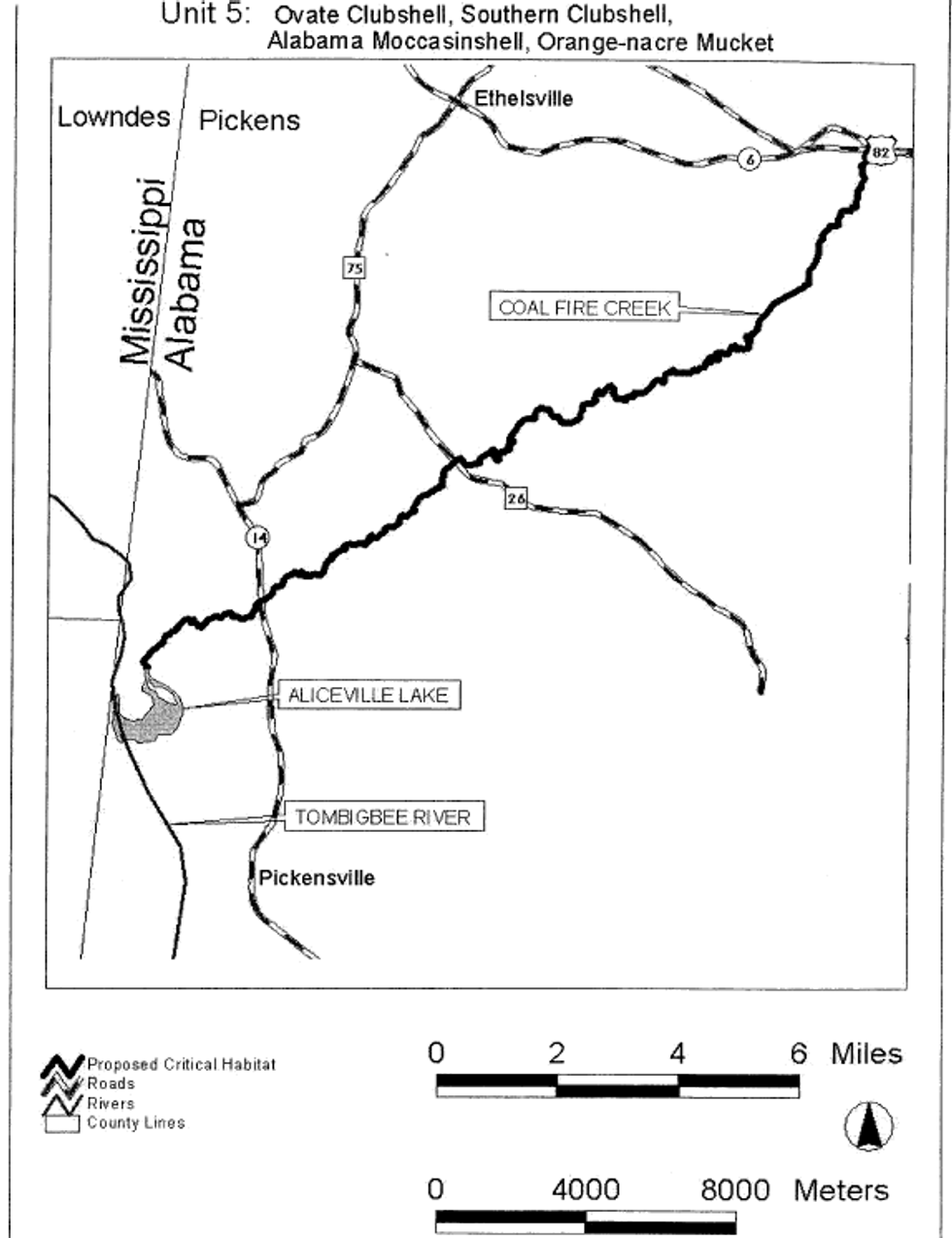
(viii) Unit 6. Lubbub Creek, Pickens County, Alabama. This is a critical habitat unit for the ovate clubshell, southern clubshell, Alabama moccasinshell, and orange-nacre mucket.
(A) Unit 6 includes the main stem of Lubbub Creek from its confluence with the impounded waters of Gainesville Lake (Tombigbee River, T24N R2W S11), upstream to the confluence of Little Lubbub Creek (T21S R1W S34), Pickens County, Alabama.
(B) Map of Unit 6 follows:
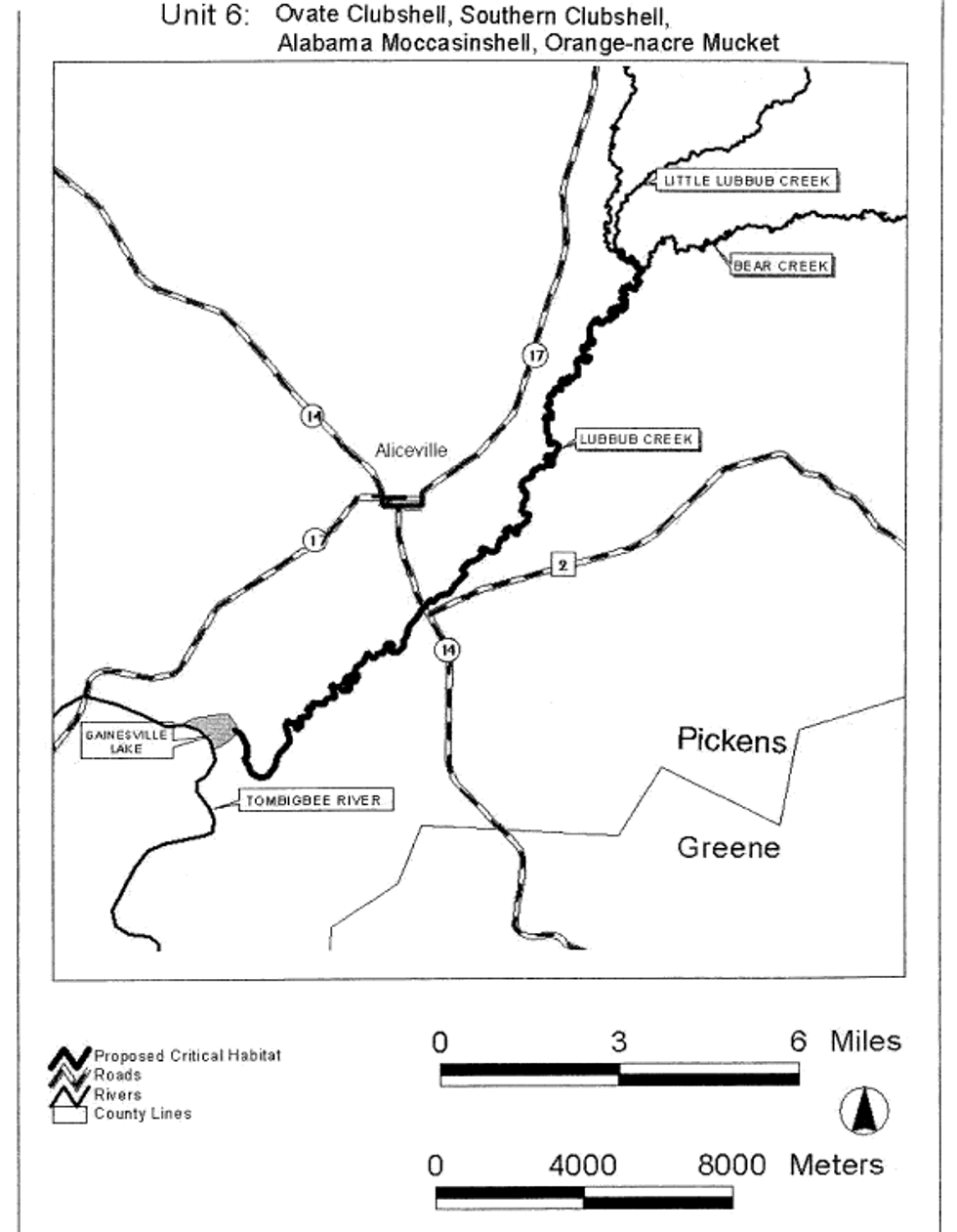
(ix) Unit 7. Sipsey River, Greene/Pickens, Tuscaloosa Counties, Alabama. This is a critical habitat unit for the ovate clubshell, southern clubshell, Alabama moccasinshell, and orange-nacre mucket.
(A) Unit 7 includes the Sipsey River main stem from its confluence with impounded waters of Gainesville Lake (Tombigbee River, T24N R1W S30), Greene/Pickens County, upstream to Alabama Highway 171 crossing (T18S R12W S34), Tuscaloosa County, Alabama.
(B) Map of Unit 7 follows:
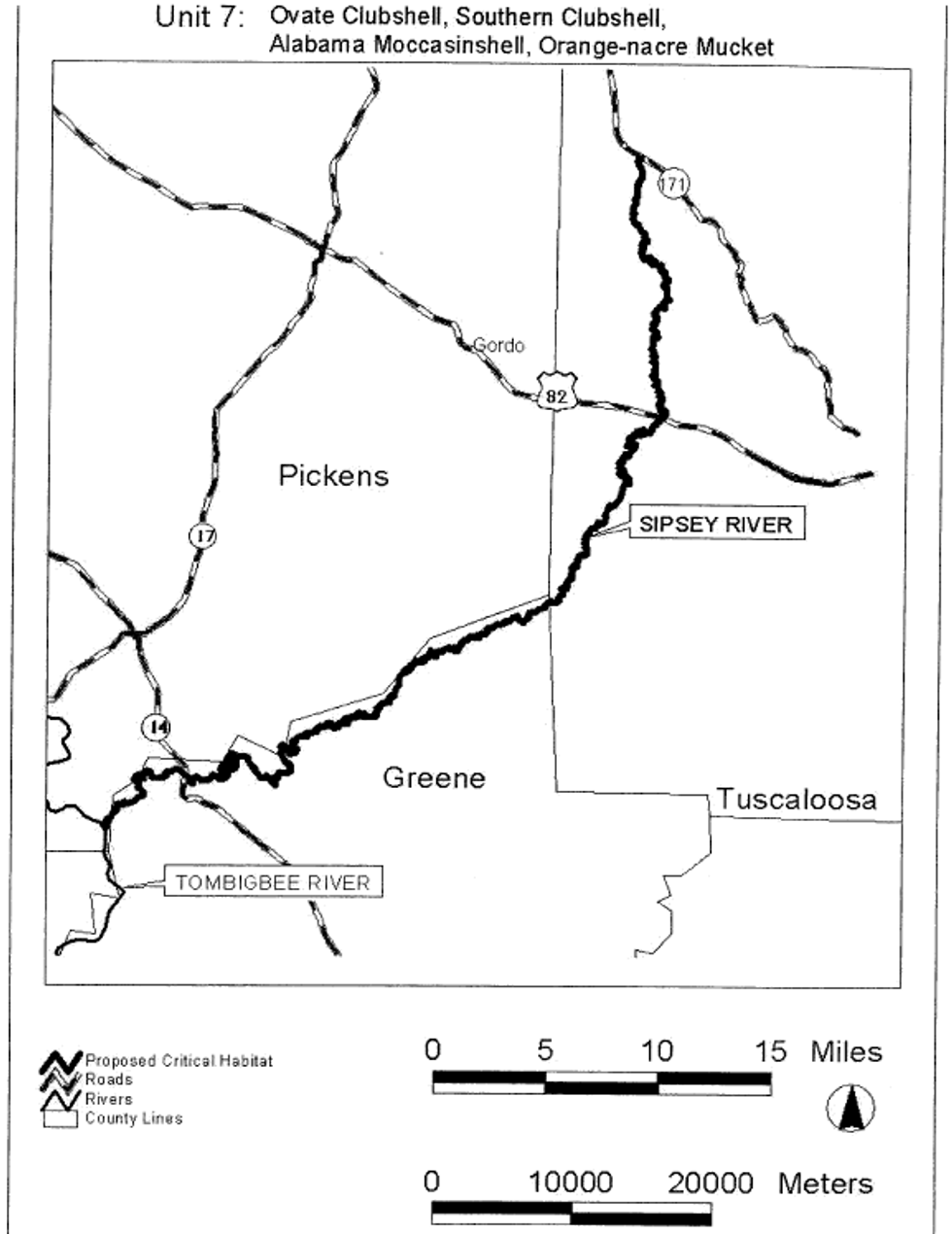
(x) Unit 8. Trussels Creek, Greene County, Alabama. This is a critical habitat unit for the ovate clubshell, southern clubshell, Alabama moccasinshell, and orange-nacre mucket.
(A) Unit 8 includes the Trussels Creek main stem from its confluence with the impounded waters of Demopolis Lake (Tombigbee River, T21N R2W S15), upstream to Alabama Highway 14 (T22N R1E S4), Greene County, Alabama.
(B) Map of Unit 8 follows:

(xi) Unit 9. Sucarnoochee River, Sumter County, Alabama. This is a critical habitat unit for the ovate clubshell, southern clubshell, Alabama moccasinshell, and orange-nacre mucket.
(A) Unit 9 includes the Sucarnoochee River main stem from its confluence with the Tombigbee River (T17N R1W S26), upstream to the Mississippi/Alabama State Line (T19N R4W S15), Sumter County, Alabama.
(B) Map of Unit 9 follows:
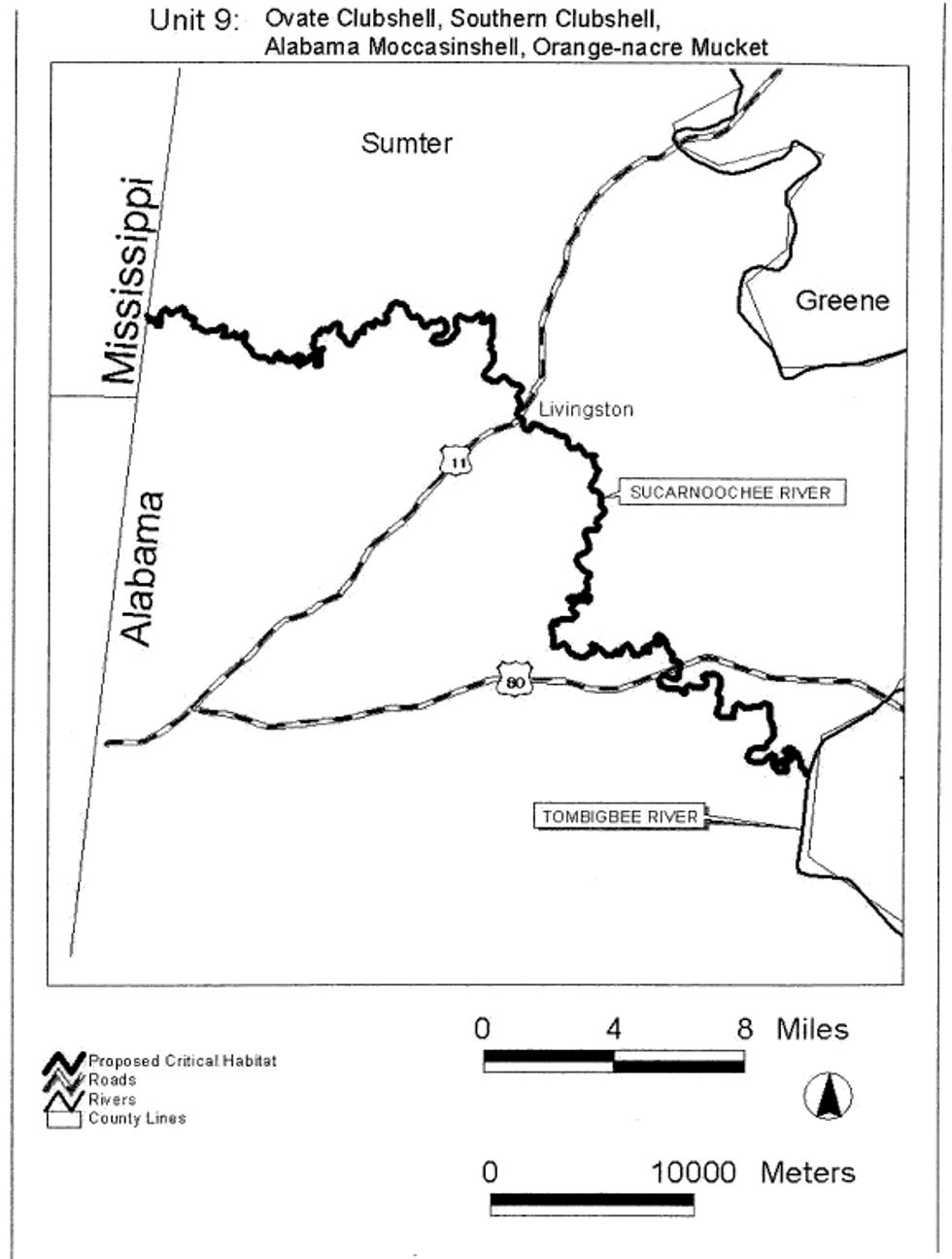
(xii) Unit 10. Sipsey Fork and tributaries, Winston, Lawrence Counties, Alabama. This is a critical habitat unit for the ovate clubshell, triangular kidneyshell, Alabama moccasinshell, orange-nacre mucket, and dark pigtoe.
(A) Unit 10 includes the Sipsey Fork main stem from the section 11/12 line (T10S R8W), Winston County, Alabama, upstream to the confluence of Hubbard Creek (T8S R9W S27), Lawrence County, Alabama; Thompson Creek, from its confluence with Hubbard Creek (T8S R9W S27), upstream to section 2 line (T8S R9W) Lawrence County; Brushy Creek, from the confluence of Glover Creek (T10S R7W S11), Winston County, upstream to section 9 (T8S R7W), Lawrence County; Capsey Creek, from confluence with Brushy Creek (T9S R7W S23), Winston County, upstream to the confluence of Turkey Creek (T8S R6W S33), Lawrence County; Rush Creek, from confluence with Brushy Creek (T9S R7W S15), upstream to Winston/Lawrence County Line (T9S R7W S1), Winston County; Brown Creek, from confluence with Rush Creek (T9S R7W S2), Winston County, upstream to section 24 line (T8S R7W), Lawrence County; Beech Creek, from confluence with Brushy Creek (T9S R7W S8), to confluence of East and West Forks (T9S R7W S6), Winston County; Caney Creek and North Fork Caney Creek, from confluence with Sipsey Fork (T9S R8W S28), upstream to section 14 line (T9S R9W), Winston County; Borden Creek, from confluence with Sipsey Fork (T8S R8W S5), Winston County, upstream to the confluence of Montgomery Creek (T8S R8W S10), Lawrence County; and Flannagin Creek, from confluence with Borden Creek (T8S R8W S28), upstream to confluence of Dry Creek (T8S R8W S4), Lawrence County.
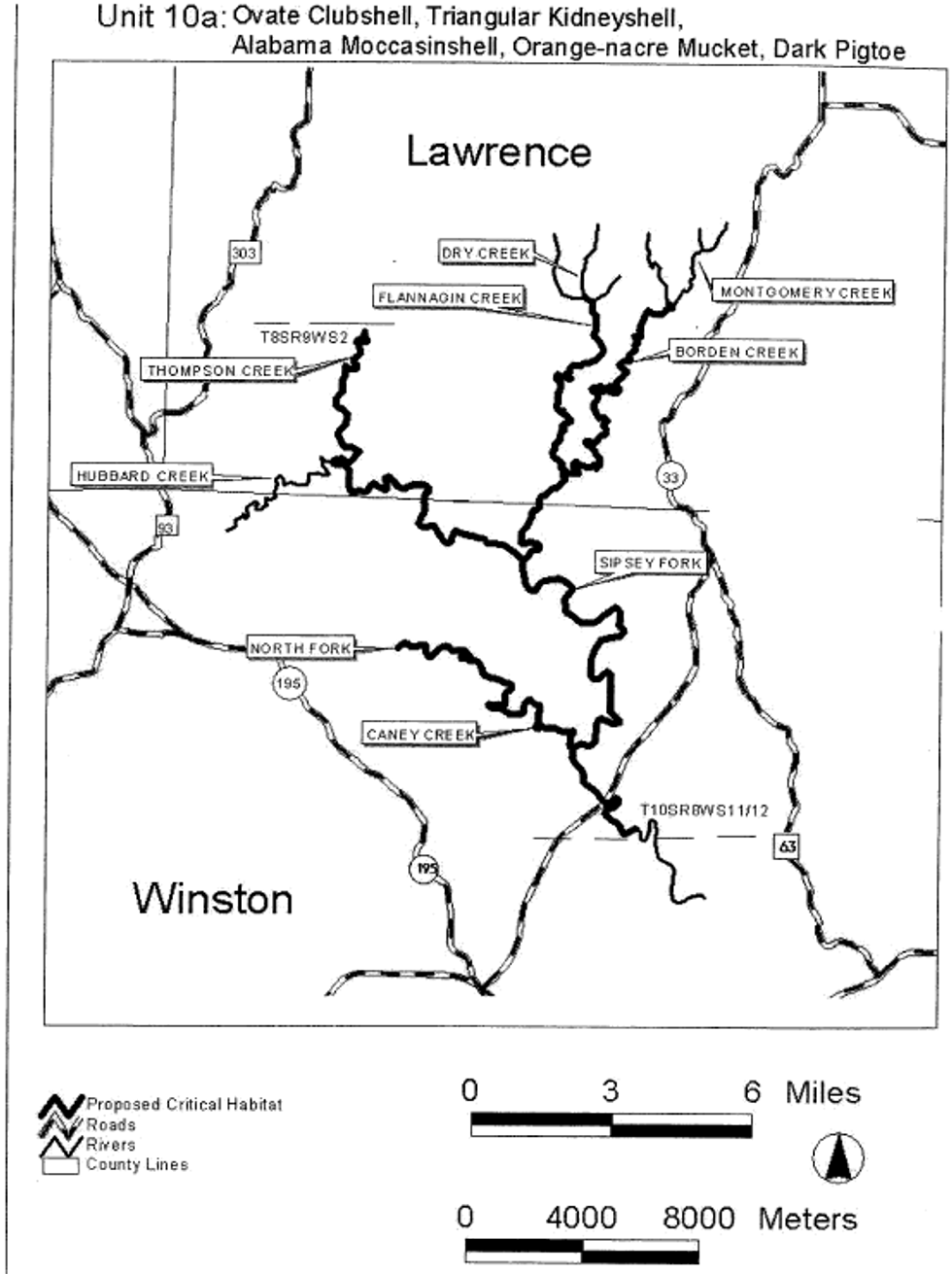
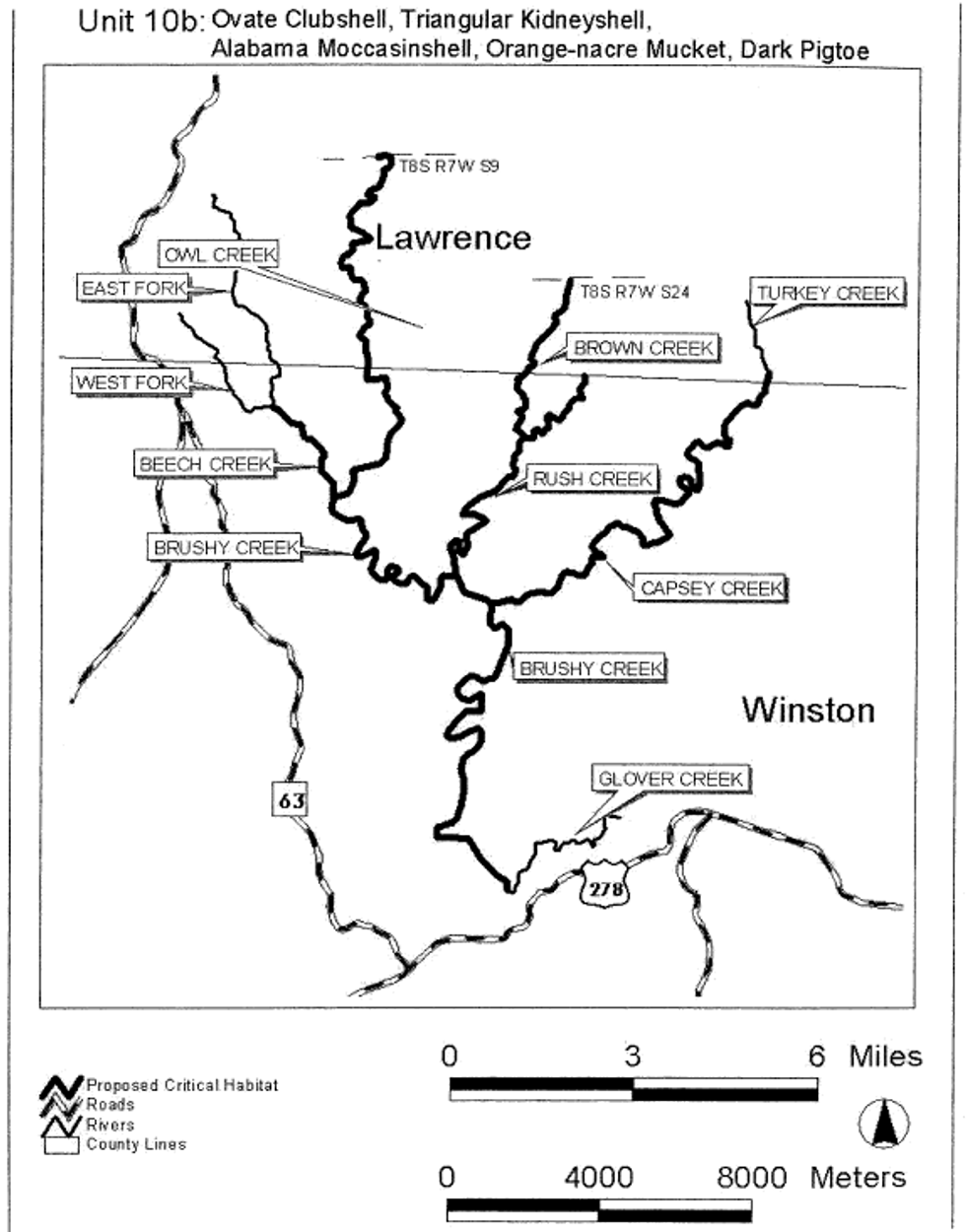
(xiii) Unit 11. North River and Clear Creek, Tuscaloosa, Fayette Counties, Alabama. This is a critical habitat unit for the ovate clubshell, triangular kidneyshell, Alabama moccasinshell, orange-nacre mucket, and dark pigtoe.
(A) Unit 11 includes the main stem of the North River from Tuscaloosa County Road 38 (T18S R10W S16), Tuscaloosa County, upstream to confluence of Ellis Creek (T16S R10W S6), Fayette County, Alabama; and Clear Creek from its confluence with North River (T16S R11W S13) to Bays Lake Dam (T16S R11W S2), Fayette County, Alabama.
(B) Map of Unit 11 follows:
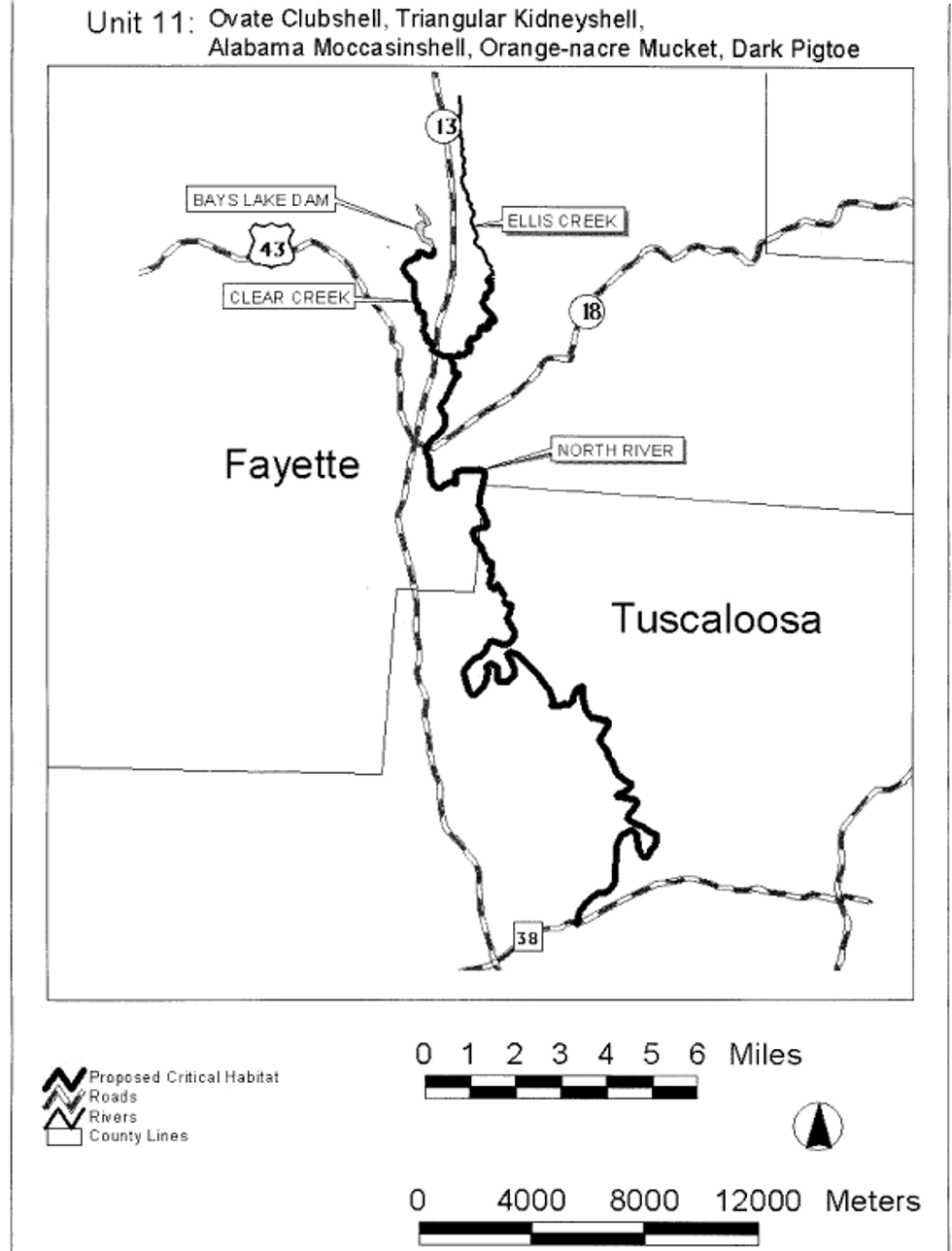
(xiv) Unit 12. Locust Fork and Little Warrior Rivers, Jefferson, Blount Counties, Alabama. This is a critical habitat unit for the ovate clubshell, triangular kidneyshell, Alabama moccasinshell, orange-nacre mucket, and dark pigtoe.
(A) Unit 12 includes the Locust Fork main stem from U.S. Highway 78 (T15S R4W S30), Jefferson County, upstream to the confluence of Little Warrior River (T13S R1W S3), Blount County, Alabama; and Little Warrior River from its confluence with the Locust Fork (T13S R1W S3), upstream to the confluence of Calvert Prong and Blackburn Fork (T13S R1W S12), Blount County, Alabama.
(B) Map of Unit 12 follows:
Figure 14 to Nine Mobile River Basin Mussel Species Paragraph (2)(xiv)(B)
Unit 12: Ovate Clubshell, Triangular Kidneyshell, Alabama Moccasinshell, Orange-Nacre Mucket, Dark Pigtoe
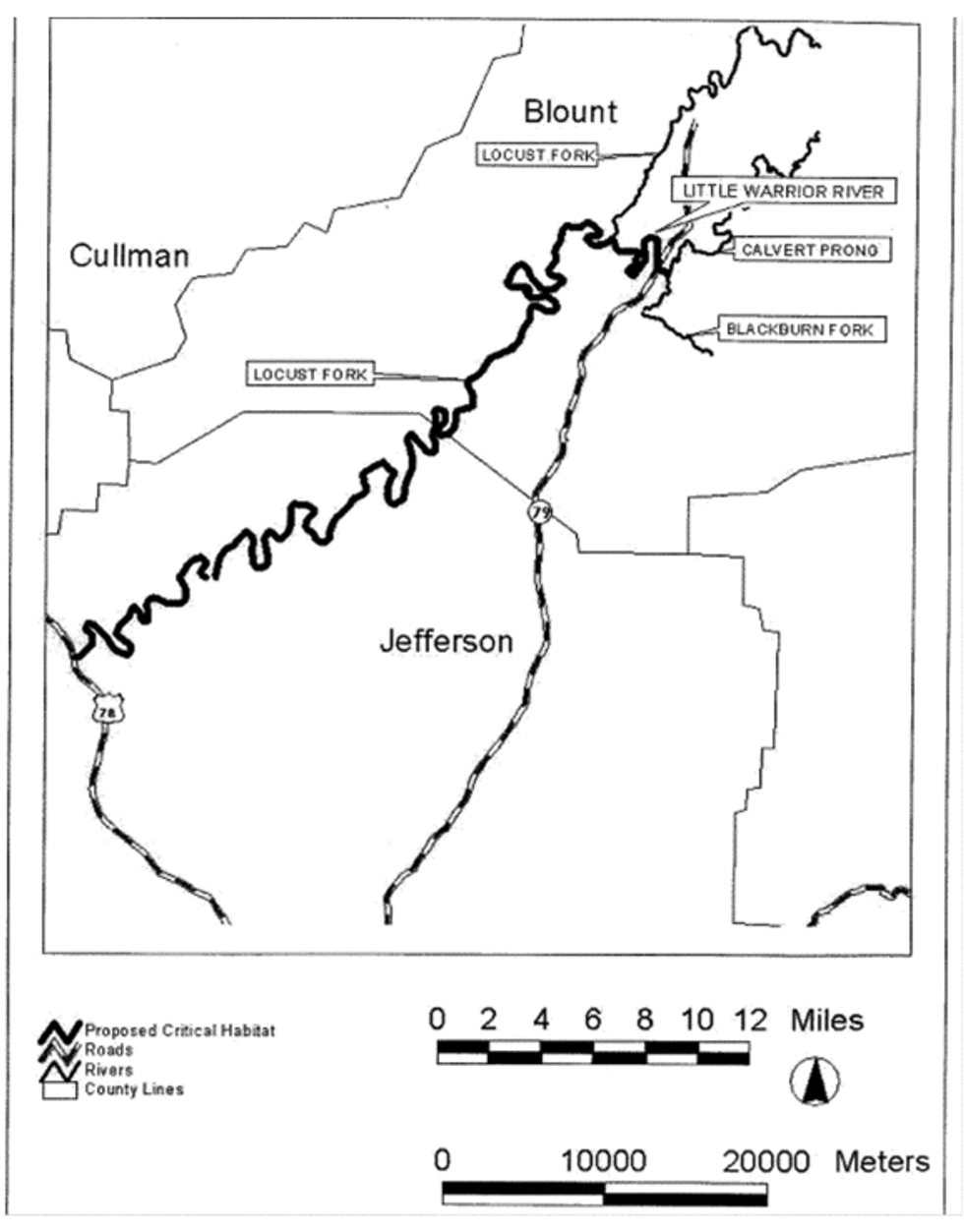
(xv) Unit 13. Cahaba River and Little Cahaba River, Jefferson, Shelby, Bibb Counties, Alabama. This is a critical habitat unit for the ovate clubshell, southern clubshell, triangular kidneyshell, Alabama moccasinshell, orange-nacre mucket, and fine-lined pocketbook.
(A) Unit 13 includes the Cahaba River from U.S. Highway 82 (T23N R9E S26), Centerville, Bibb County, upstream to Jefferson County Road 143 (T18S R1E S33), Jefferson County, Alabama; and the Little Cahaba River from its confluence with the Cahaba River (T24N R10E S21), upstream to the confluence of Mahan and Shoal Creeks (T24N R11E S14), Bibb County, Alabama.
(B) Map of Unit 13 follows:
Figure 15 to Nine Mobile River Basin Mussel Species Paragraph (2)(xv)(B)
Unit 13: Ovate Clubshell, Southern Clubshell, Triangular Kidneyshell, Alabama Moccasinshell, Orange-Nacre Mucket, Fine-Lined Pocketbook
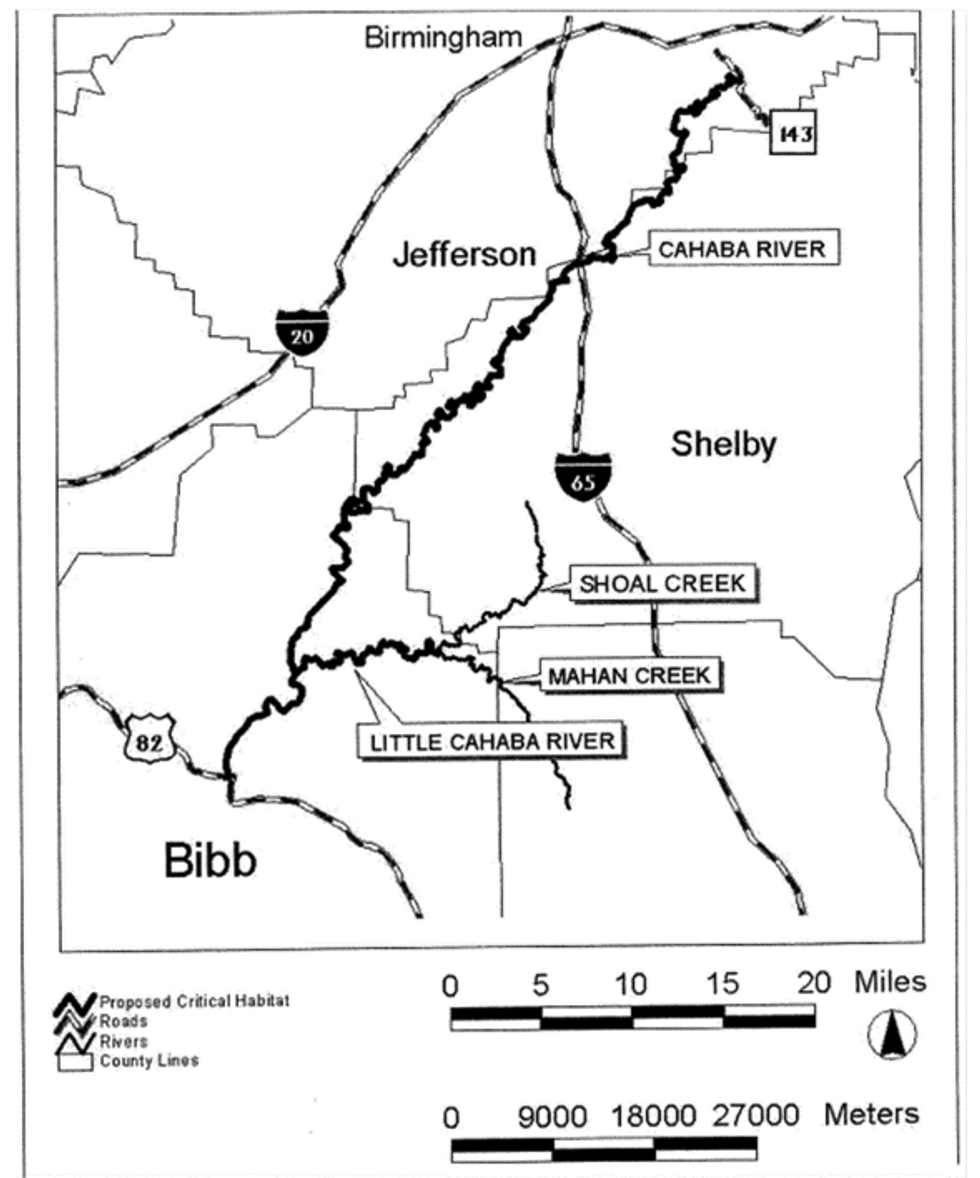
(xvi) Unit 14. Alabama River, Autauga, Lowndes, Dallas Counties, Alabama. This is a critical habitat unit for the southern clubshell and orange-nacre mucket.
(A) Unit 14 includes the Alabama River from the confluence of the Cahaba River (T16N R10E S32), Dallas County, upstream to the confluence of Big Swamp Creek (T15N R12E S1), Lowndes County, Alabama.
(B) Map of Unit 14 follows:
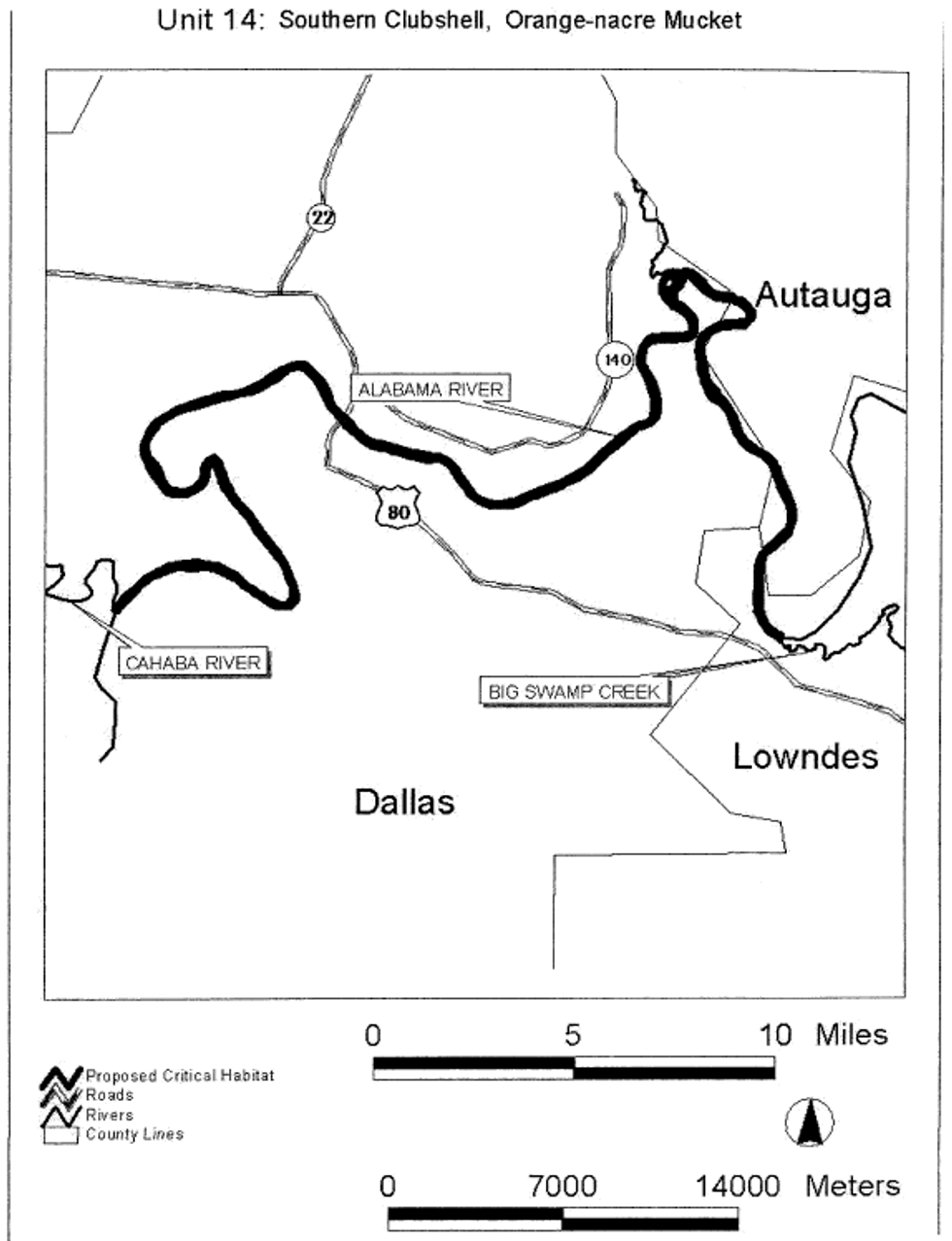
(xvii) Unit 15. Bogue Chitto Creek, Dallas County, Alabama. This is a critical habitat unit for the southern clubshell, Alabama moccasinshell, and orange-nacre mucket.
(A) Unit 15 includes the Bogue Chitto Creek main stem from its confluence with the Alabama River (T14N R8E S24), Dallas County, upstream to U.S. Highway 80 (T17N R7E S24), Dallas County, Alabama.
(B) Map of Unit 15 follows:
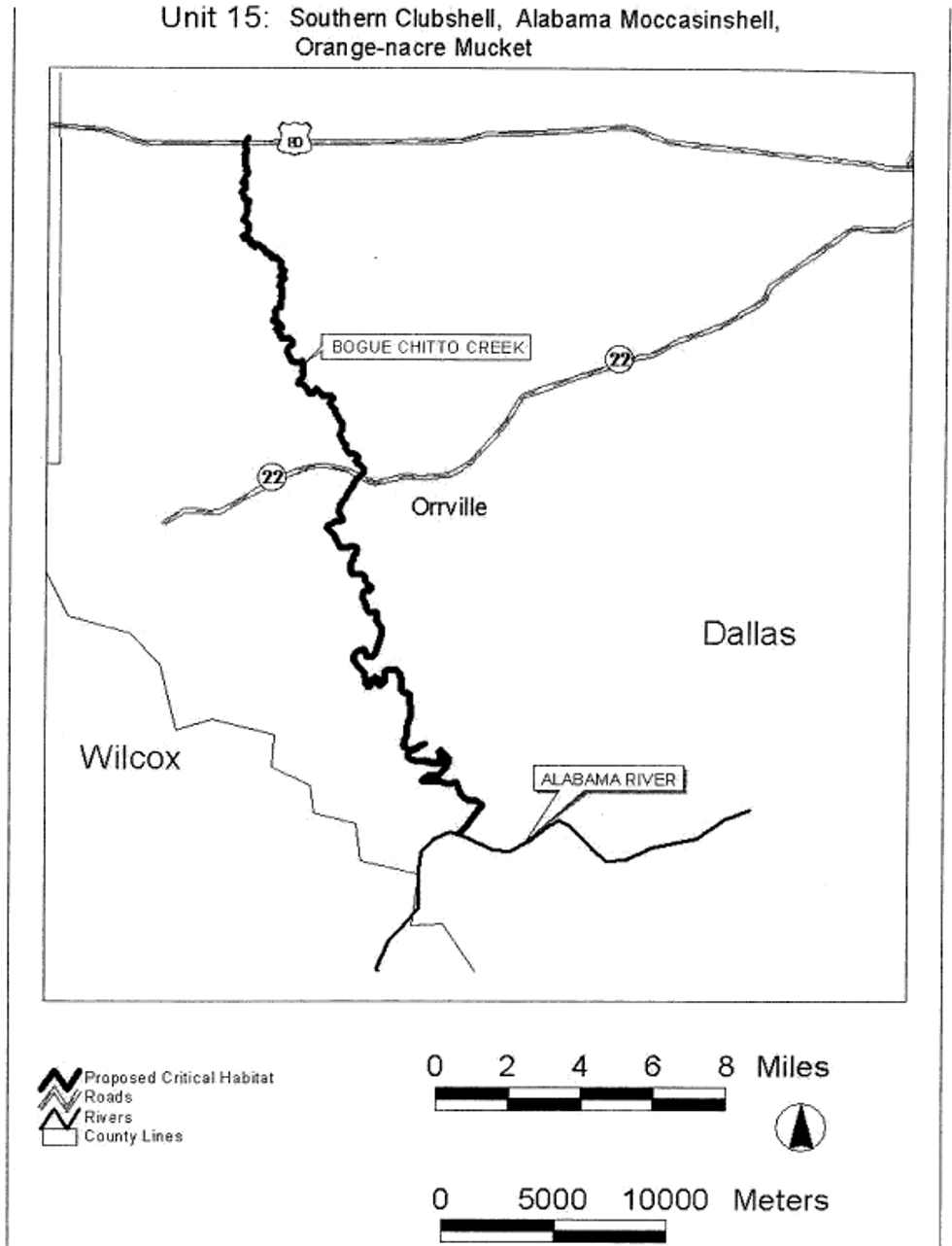
(xviii) Unit 16. Tallapoosa River, Cleburne County, Alabama, and Paulding, Haralson Counties, Georgia; Cane Creek, Cleburne County, Alabama. This is a critical habitat unit for the fine-lined pocketbook.
(A) Unit 16 includes the main stem Tallapoosa River from U.S. Highway 431 (T17S R10E S31), Cleburne County, Alabama, upstream to the confluence of McClendon and Mud Creeks (33°50′43″ N 85°00′45″ W), Paulding County, Georgia; and Cane Creek from its confluence with Tallapoosa River (T16S R10E S24), upstream to section 33/4 Line (T15S, R11E), Cleburne County, Alabama.
(B) Map of Unit 16 follows:
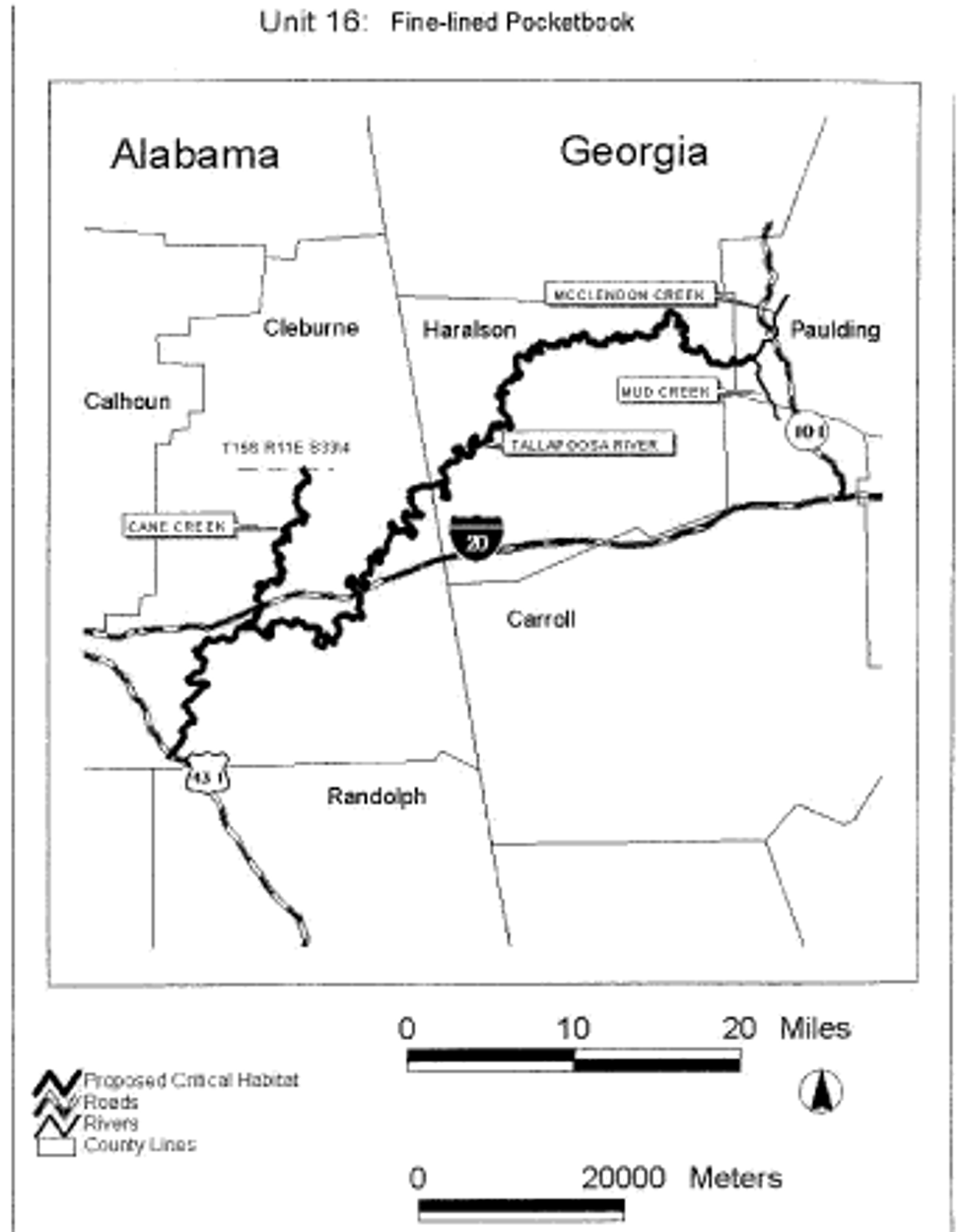
(xix) Unit 17. Uphapee, Choctafaula, and Chewacla Creeks, Macon, Lee Counties, Alabama. This is a critical habitat unit for the ovate clubshell, southern clubshell, and fine-lined pocketbook.
(A) Unit 17 includes the mainstem of Uphapee Creek from Alabama Highway 199 (T17N R23E S3), upstream to the confluence of Opintlocco and Chewacla Creeks (T17N R24E S26), Macon County, Alabama; Choctafaula Creek, from confluence with Uphapee Creek (T17N R24E S8), upstream to Macon County Road 54 (T18N R 25E S31), Macon County, Alabama; Chewacla Creek, from confluence with Opintlocco Creek (T17N R24E S26), Macon County, Alabama, upstream to Lee County Road 159 (T18N R26E S18), Lee County, Alabama; Opintlocco Creek, from confluence with Chewacla Creek (T17N R24E S26), upstream to Macon County Road 79 (T16N R25E S25) Macon County, Alabama.
(B) Map of Unit 17 follows:
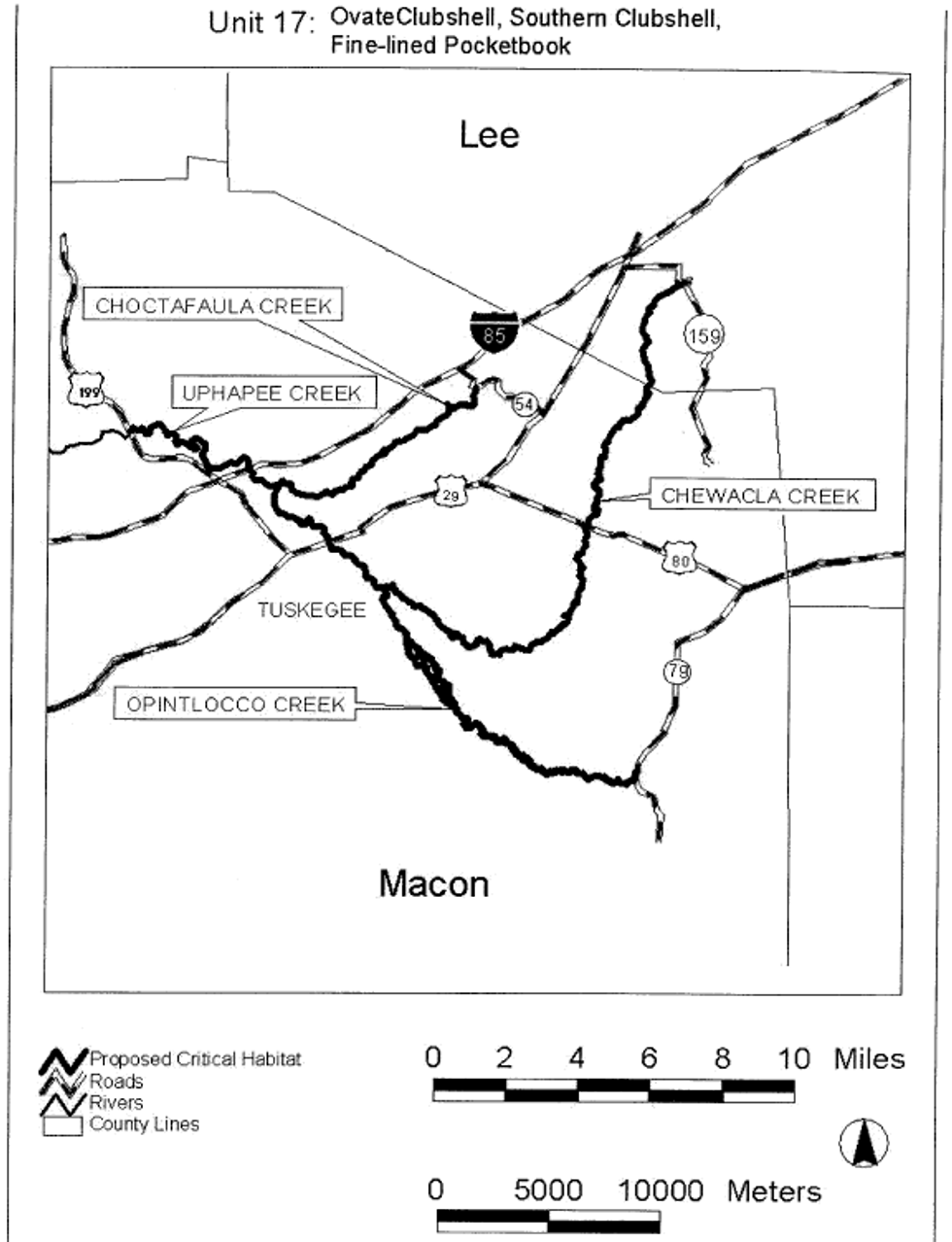
(xx) Unit 18. Coosa River (Old River Channel) and Terrapin Creek, Cherokee, Calhoun, Cleburne Counties, Alabama. This is a critical habitat unit for the ovate clubshell, southern clubshell, triangular kidneyshell, Coosa moccasinshell, southern pigtoe, and fine-lined pocketbook.
(A) Unit 18 includes the Coosa River main stem from the power line crossing southeast of Maple Grove, Alabama (T10S R8E S35), upstream to Weiss Dam (T10S R8E S13), Cherokee County, Alabama; Terrapin Creek, 53 km (33 mi) extending from its confluence with the Old Coosa River channel (T10S R9E S28), Cherokee County, upstream to Cleburne County Road 49 (T13S R11E S15), Cleburne County, Alabama; South Fork Terrapin Creek, 7 km (4 mi), from its confluence with Terrapin Creek (T13S R11E S18), upstream to Cleburne County Road 55 (T13S R11E S30), Cleburne County, Alabama.
(B) Map of Unit 18 follows:
Figure 20 to Nine Mobile River Basin Mussel Species Paragraph (2)(xx)(B)
Unit 18: Ovate Clubshell, Southern Clubshell, Triangular Kidneyshell, Coosa Moccasinshell, Southern Pigtoe, Fine-Lined Pocketbook
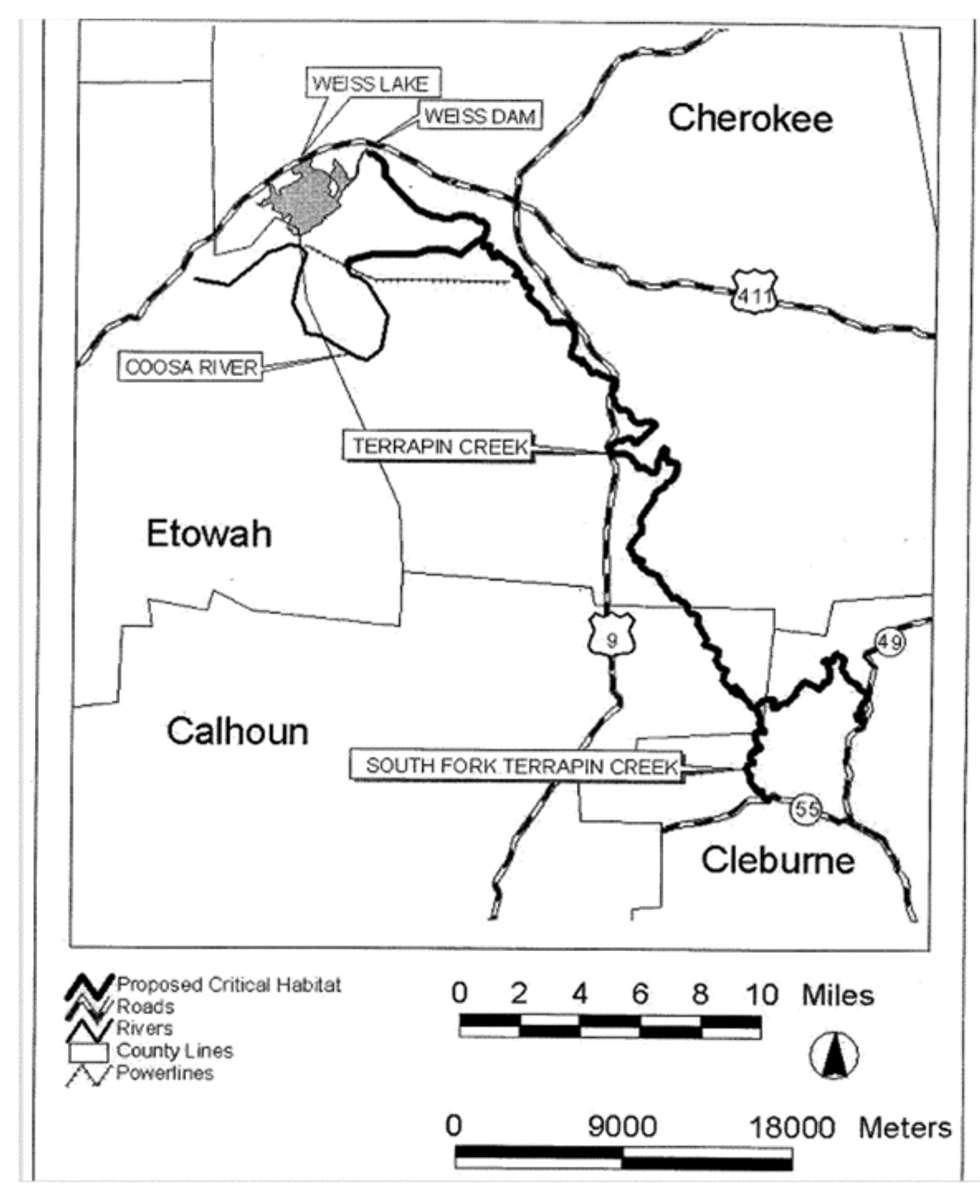
(xxi) Unit 19. Hatchet Creek, Coosa, Clay Counties, Alabama. This is a critical habitat unit for the ovate clubshell, southern clubshell, triangular kidneyshell, Coosa moccasinshell, southern pigtoe, and fine-lined pocketbook.
(A) Unit 19 includes the main stem of Hatchet Creek from the confluence of Swamp Creek at Coosa County Road 29 (T22N R17E S26), Coosa County, Alabama, upstream to Clay County Road 4 (T22S R6E S17) Clay County, Alabama.
(B) Map of Unit 19 follows:
Figure 21 to Nine Mobile River Basin Mussel Species Paragraph (2)(xxi)(B)
Unit 19: Ovate Clubshell, Southern Clubshell, Triangular Kidneyshell, Coosa Moccasinshell, Southern Pigtoe, Fine-Lined Pocketbook
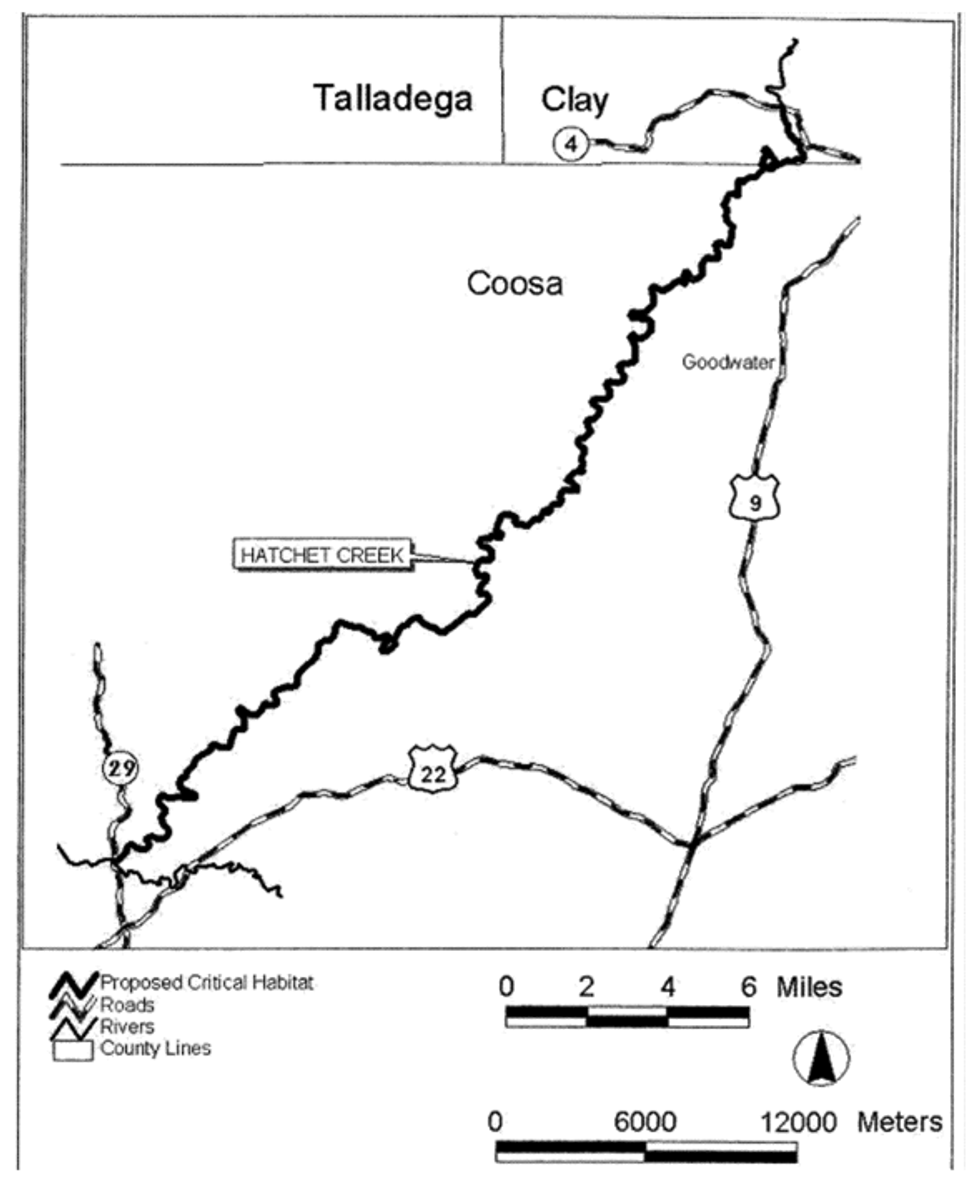
(xxii) Unit 20. Shoal Creek, Calhoun, Cleburne Counties, Alabama. This is a critical habitat unit for the triangular kidneyshell, Coosa moccasinshell, southern pigtoe, and fine-lined pocketbook.
(A) Unit 20 includes the main stem of Shoal Creek from the headwater of Whitesides Mill Lake (T15S R9E S12), Calhoun County, Alabama, upstream to the tailwater of Coleman Lake Dam (T14S R10E S26), Cleburne County, Alabama.
(B) Map of Unit 20 follows:
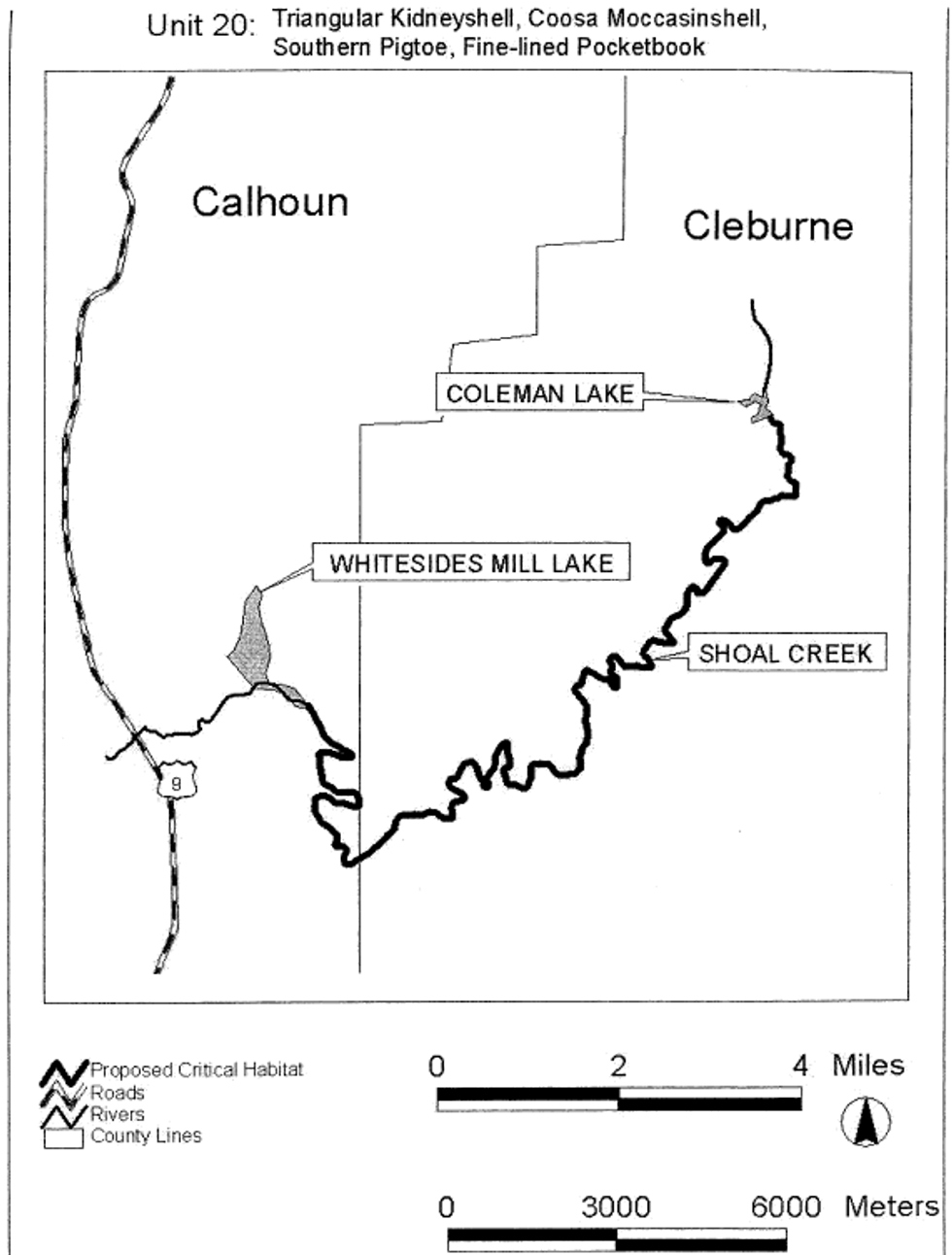
(xxiii) Unit 21. Kelly Creek and Shoal Creek, Shelby, St. Clair Counties, Alabama. This is a critical habitat unit for the ovate clubshell, southern clubshell, triangular kidneyshell, Coosa moccasinshell, southern pigtoe, and fine-lined pocketbook.
(A) Unit 21 includes the Kelly Creek main stem extending from the confluence with the Coosa River (T19S R3E S5), upstream to the confluence of Shoal Creek (T17S R2E S28), St. Clair County, Alabama; and the main stem of Shoal Creek from the confluence with Kelly Creek (T17S R2E S28), St. Clair County, Alabama, upstream to the St. Clair/Shelby County Line (T17S R2E S30), St. Clair County, Alabama.
(B) Map of Unit 21 follows:
Figure 23 to Nine Mobile River Basin Mussel Species Paragraph (2)(xxiii)(B)
Unit 21: Ovate Clubshell, Southern Clubshell, Triangular Kidneyshell, Coosa Moccasinshell, Southern Pigtoe, Fine-Lined Pocketbook
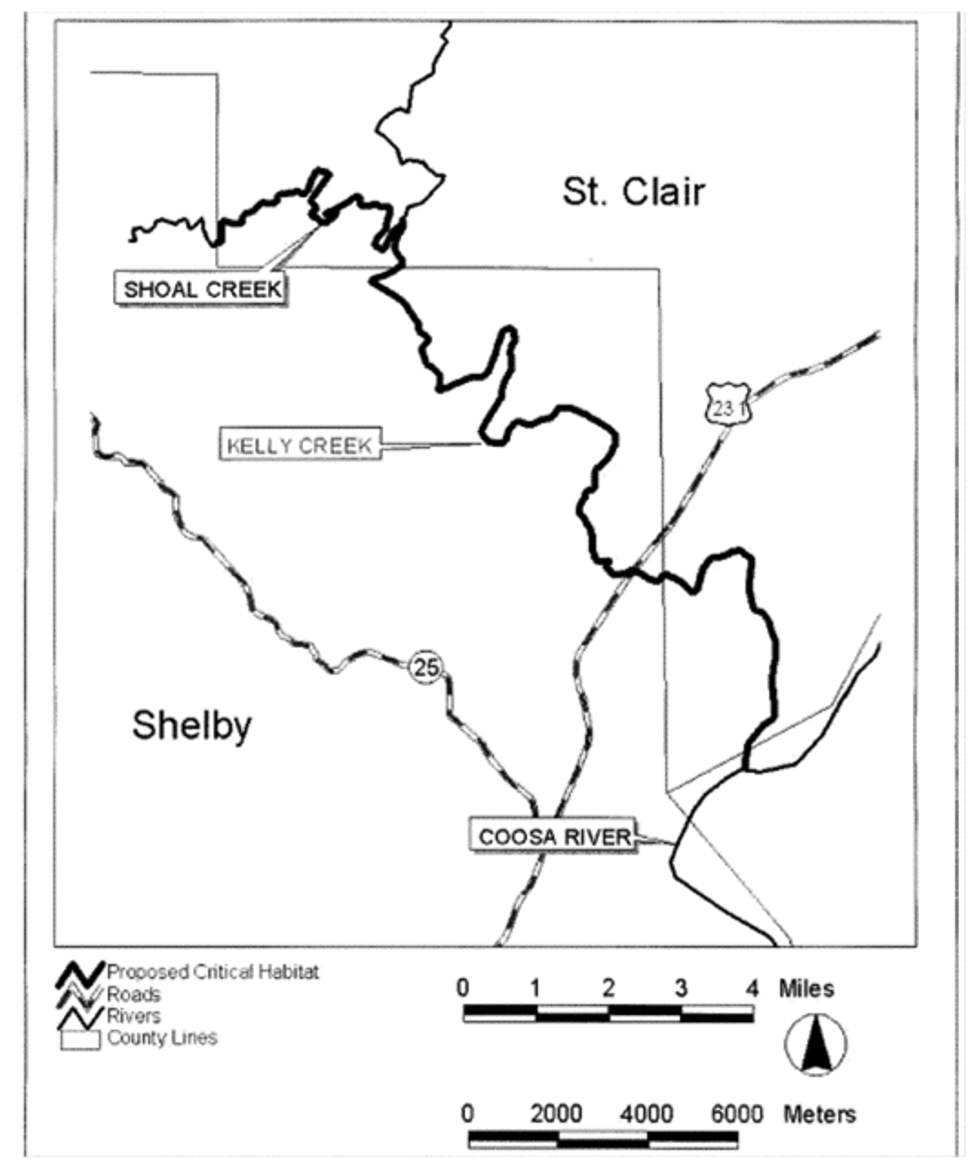
(xxiv) Unit 22. Cheaha Creek, Talladega, Clay Counties, Alabama. This is a critical habitat unit for the triangular kidneyshell, Coosa moccasinshell, southern pigtoe, and fine-lined pocketbook.
(A) Unit 22 includes the main stem of Cheaha Creek from its confluence with Choccolocco Creek (T17S R6E S19), Talladega County, Alabama, upstream to the tailwater of Chinnabee Lake Dam (T18S R7E S14), Clay County, Alabama.
(B) Map of Unit 22 follows:
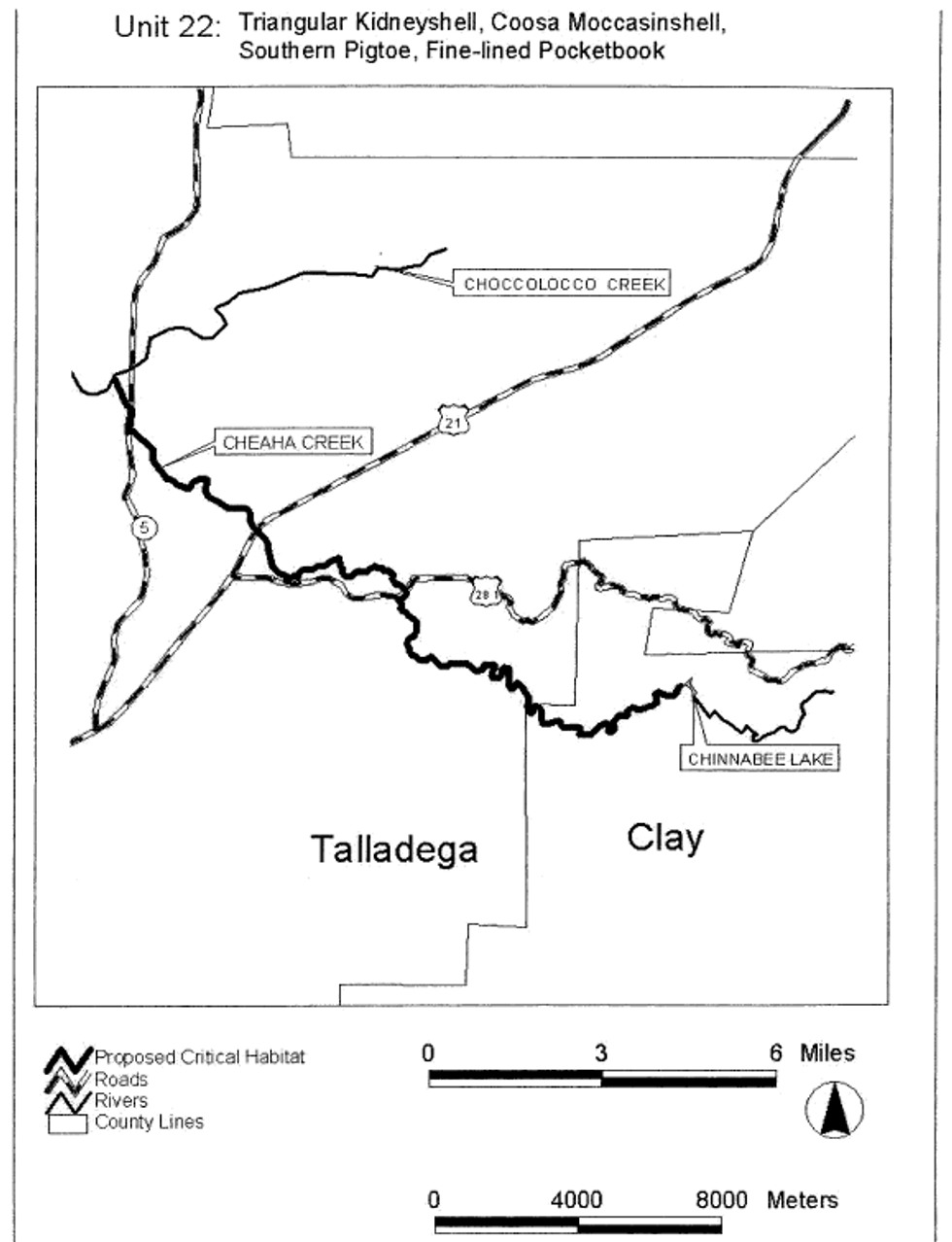
(xxv) Unit 23. Yellowleaf Creek and Mud Creek, Shelby County, Alabama. This is a critical habitat unit for the triangular kidneyshell, Coosa moccasinshell, southern pigtoe, and fine-lined pocketbook.
(A) Unit 23 includes the Yellowleaf Creek main stem from Alabama Highway 25 (T20S R2E S29), upstream to Shelby County Road 49 (T20S R1W S13); and the Muddy Prong main stem extending from its confluence with Yellowleaf Creek (T20S R1E S1), upstream to U.S. Highway 280 (T19S R1E S28), Shelby County, Alabama.
(B) Map of Unit 23 follows:
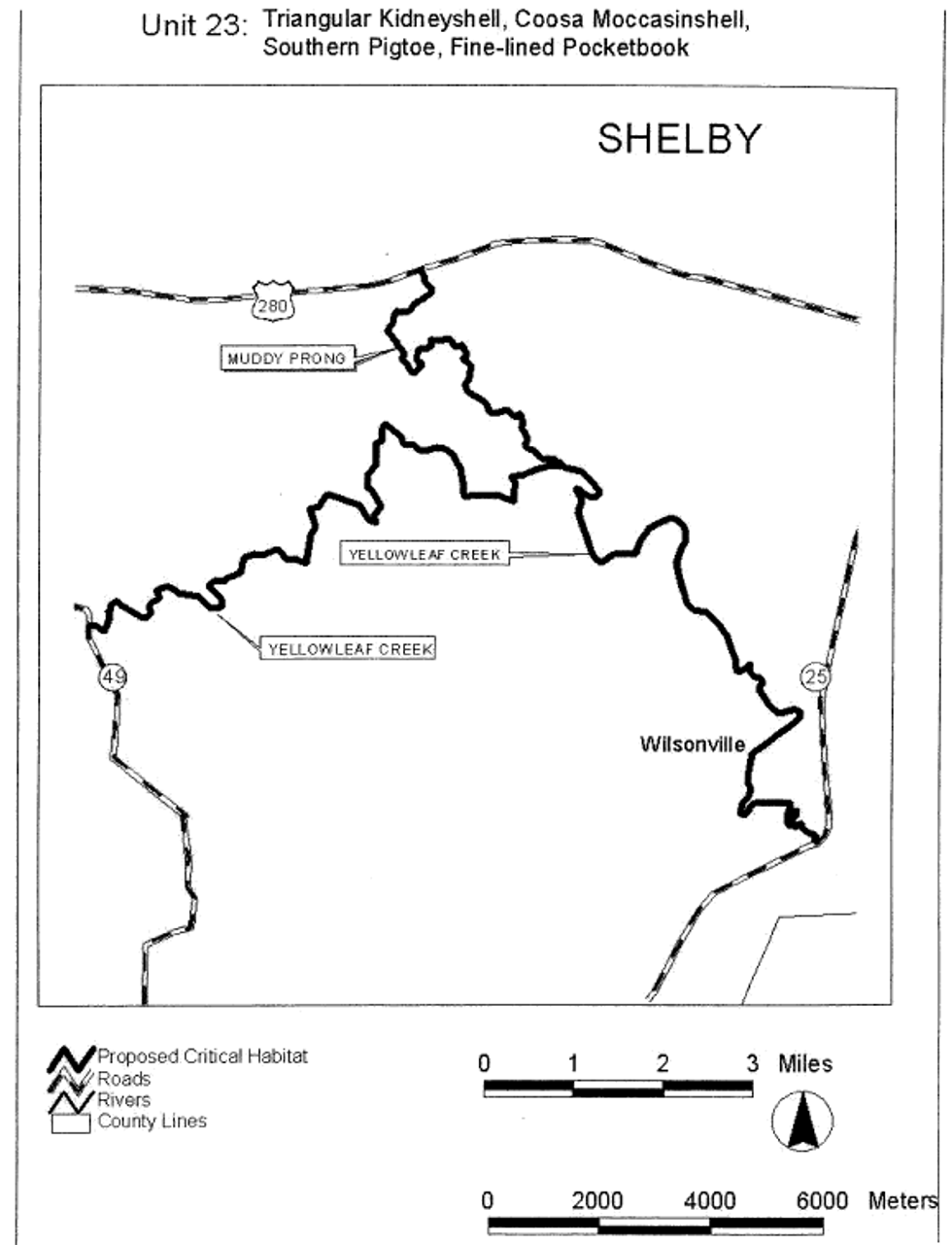
(xxvi) Unit 24. Big Canoe Creek, St. Clair County, Alabama. This is a critical habitat unit for the ovate clubshell, southern clubshell, triangular kidneyshell, Coosa moccasinshell, southern pigtoe, and fine-lined pocketbook.
(A) Unit 24 includes the main stem of Big Canoe Creek from its confluence with Little Canoe Creek at the St. Clair/Etowah County line (T13S R5E S17), St. Clair County, upstream to the confluence of Fall Branch (T14S R1E S28) St. Clair County, Alabama.
(B) Map of Unit 24 follows:
Figure 26 to Nine Mobile River Basin Mussel Species Paragraph (2)(xxvi)(B)
Unit 24: Ovate Clubshell, Southern Clubshell, Triangular Kidneyshell, Coosa Moccasinshell, Southern Pigtoe, Fine-Lined Pocketbook
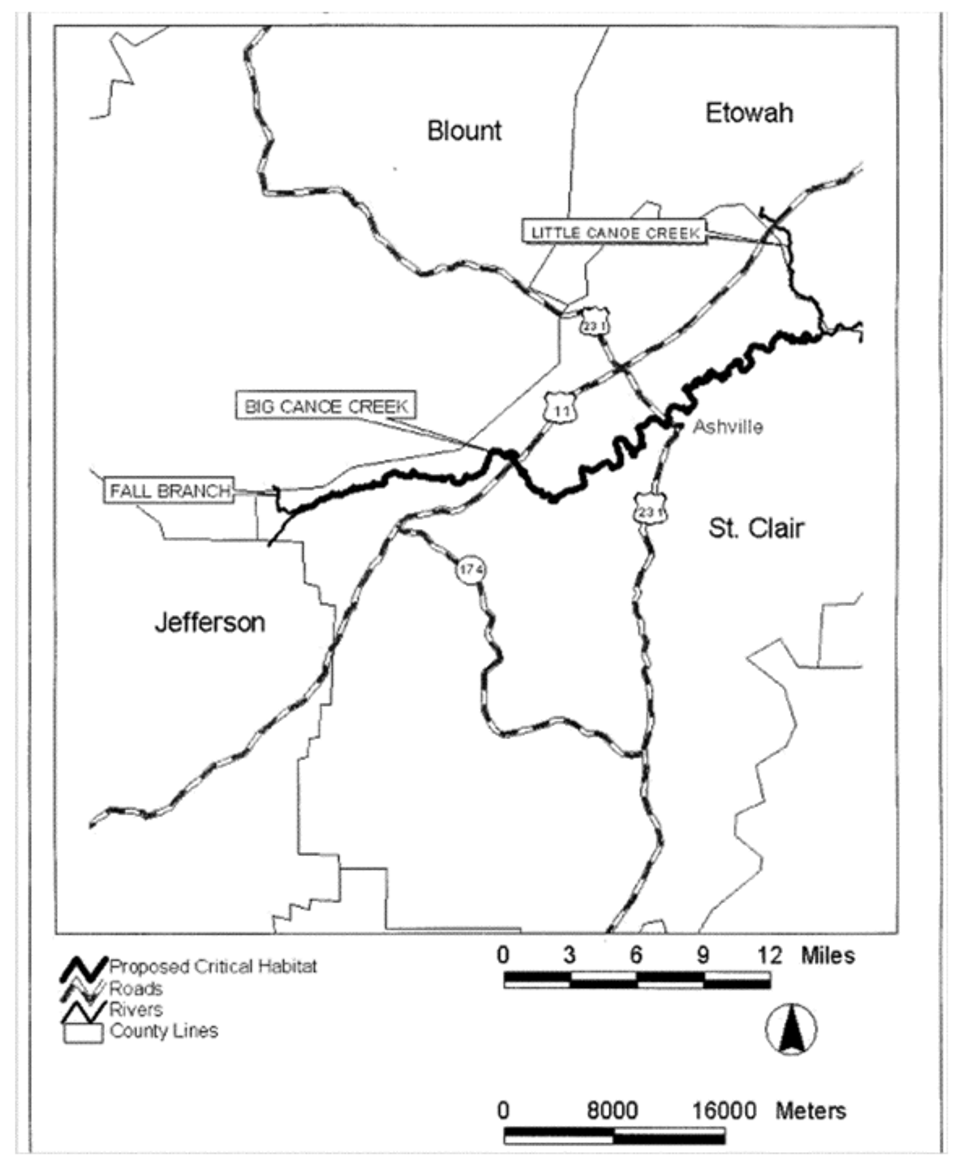
(xxvii) Unit 25. Oostanaula, Coosawattee, and Conasauga Rivers, and Holly Creek, Floyd, Gordon, Whitfield, Murray Counties, Georgia; Bradley, Polk Counties, Tennessee. This is a critical habitat unit for the ovate clubshell, southern clubshell, triangular kidneyshell, Alabama moccasinshell, Coosa moccasinshell, southern pigtoe, and fine-lined pocketbook.
(A) Unit 25 includes the Oostanaula River main stem from its confluence with the Etowah River, Floyd County, Georgia (34°15′13″ N, 85°10′35″ W), upstream to the confluence of the Conasauga and Coosawattee River, Gordon County, Georgia (34°32′32″ N, 84°54′12″ W); the Coosawattee River main stem from its confluence with the Conasauga River (34°32′32″ N, 84°54′12″ W), upstream to Georgia State Highway 136, Gordon County, Georgia (34°36′49″ N, 84°46′43″ W); the Conasauga River main stem from confluence with the Coosawattee River (34°32′32″ N, 84°54′13″ W), Gordon County, Georgia, upstream through Bradley and Polk Counties, Tennessee, to Murray County Road 2 (34°58′27″ N, 84°38′43″ W), Murray County, Georgia; and the mainstem of Holly Creek from its confluence with the Conasauga River (34°42′12″ N, 84°53′29″ W), upstream to its confluence with Rock Creek, Murray County, Georgia (34°46′59″ N, 84°45′25″ W).
(B) Map of Unit 25 follows:
Figure 27 to Nine Mobile River Basin Mussel Species Paragraph (2)(xxvii)(B)
Unit 25: Ovate Clubshell, Southern Clubshell, Triangular Kidneyshell, Alabama Moccasinshell, Coosa Moccasinshell, Southern Pigtoe, Fine-Lined Pocketbook
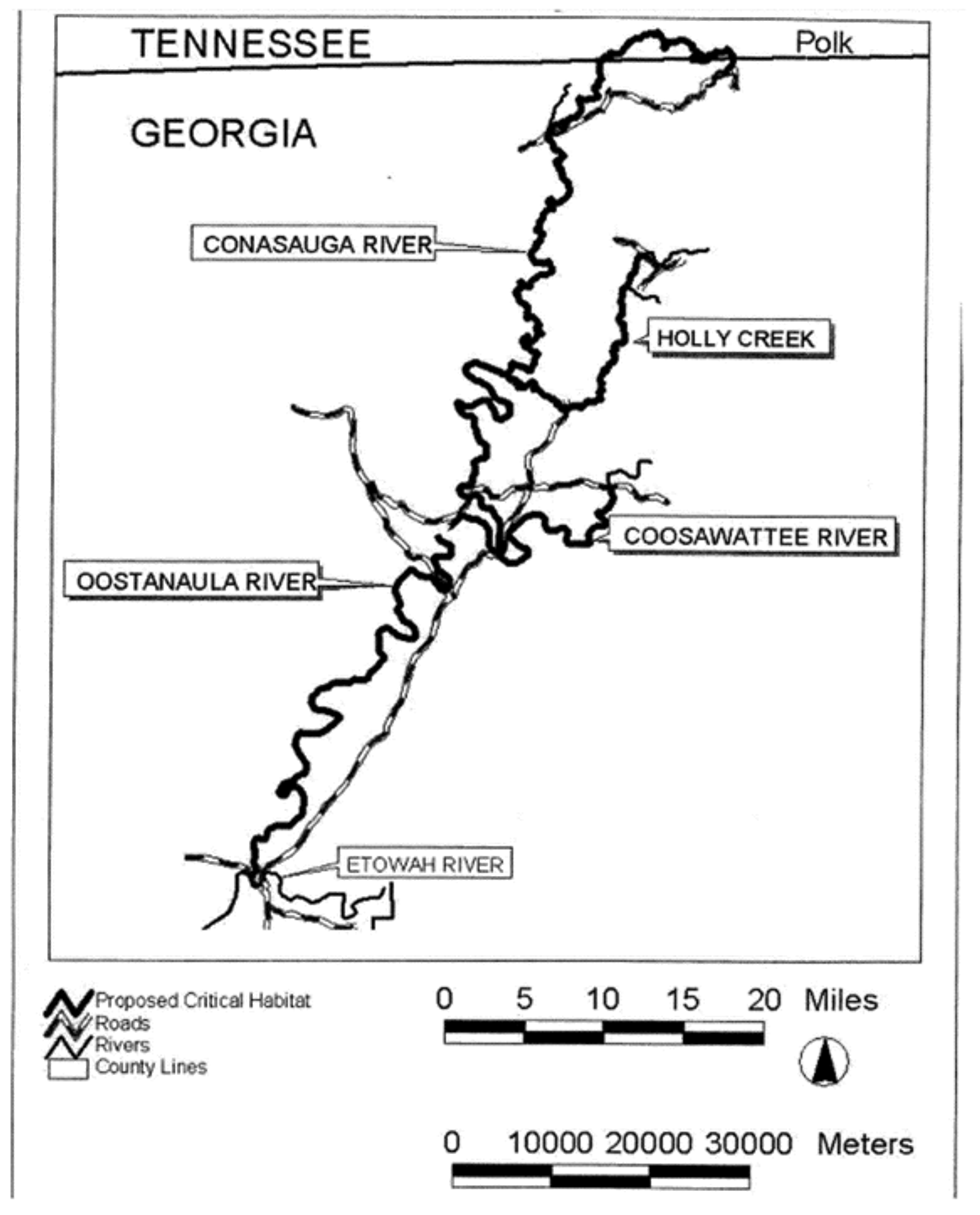
(xxviii) Unit 26. Lower Coosa River, Elmore County, Alabama. This is a critical habitat unit for the ovate clubshell, southern clubshell, triangular kidneyshell, Alabama moccasinshell, Coosa moccasinshell, southern pigtoe, and fine-lined pocketbook.
(A) Unit 26 includes the Coosa River main stem from Alabama State Highway 111 bridge (T18N R18/19E S24/19), upstream to Jordan Dam (T19N R18E S22), Elmore County, Alabama.
(B) Map of Unit 26 follows:
Figure 28 to Nine Mobile River Basin Mussel Species Paragraph (2)(xxviii)(B)
Unit 26: Ovate Clubshell, Southern Clubshell, Triangular Kidneyshell, Alabama Moccasinshell, Coosa Moccasinshell, Southern Pigtoe, Fine-Lined Pocketbook
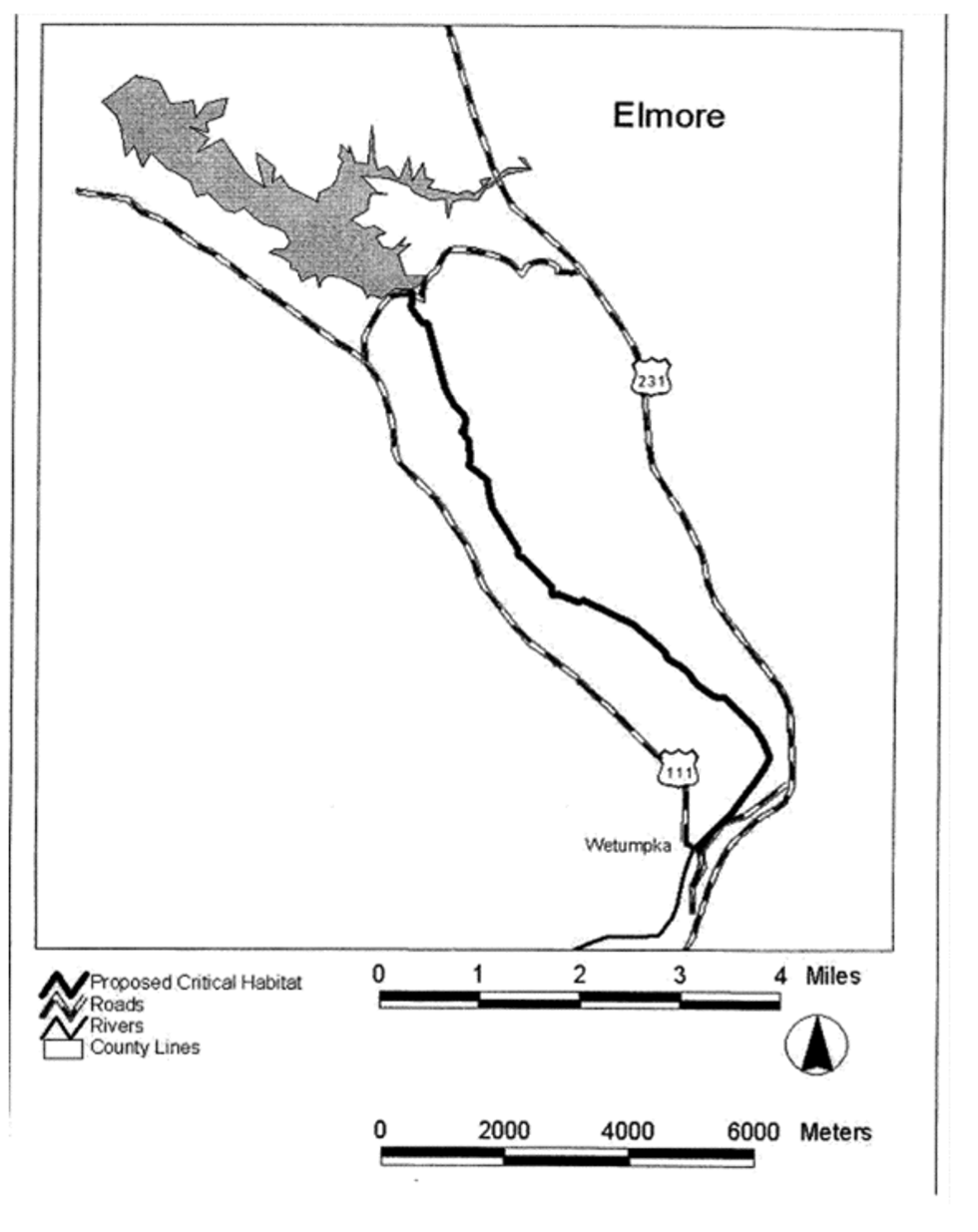
(1) The primary constituent elements essential for the conservation of the purple bean (Villosa perpurpurea), Cumberlandian combshell (Epioblasma brevidens), Cumberland elktoe (Alasmidonta atropurpurea), oyster mussel (Epioblasma capsaeformis), and rough rabbitsfoot (Quadrula cylindrica strigillata) are those habitat components that support feeding, sheltering, reproduction, and physical features for maintaining the natural processes that support these habitat components. The primary constituent elements include:
(i) Permanent, flowing stream reaches with a flow regime (i.e, the magnitude, frequency, duration, and seasonality of discharge over time) necessary for normal behavior, growth, and survival of all life stages of the five mussels and their host fish;
(ii) Geomorphically stable stream and river channels and banks;
(iii) Stable substrates consisting of mud, sand, gravel, and/or cobble/boulder, with low amounts of fine sediments or attached filamentous algae;
(iv) Water quality (including temperature, turbidity, oxygen content, and other characteristics) necessary for the normal behavior, growth, and survival of all life stages of the five mussels and their host fish; and
(v) Fish hosts with adequate living, foraging, and spawning areas for them.
(2) Critical habitat unit descriptions and maps. The maps provided are for informational purposes only.
(i) Index map. The index map showing critical habitat units in the States of Mississippi, Alabama, Tennessee, Kentucky, and Virginia for the five Tennessee and Cumberland River Basin mussels follows:
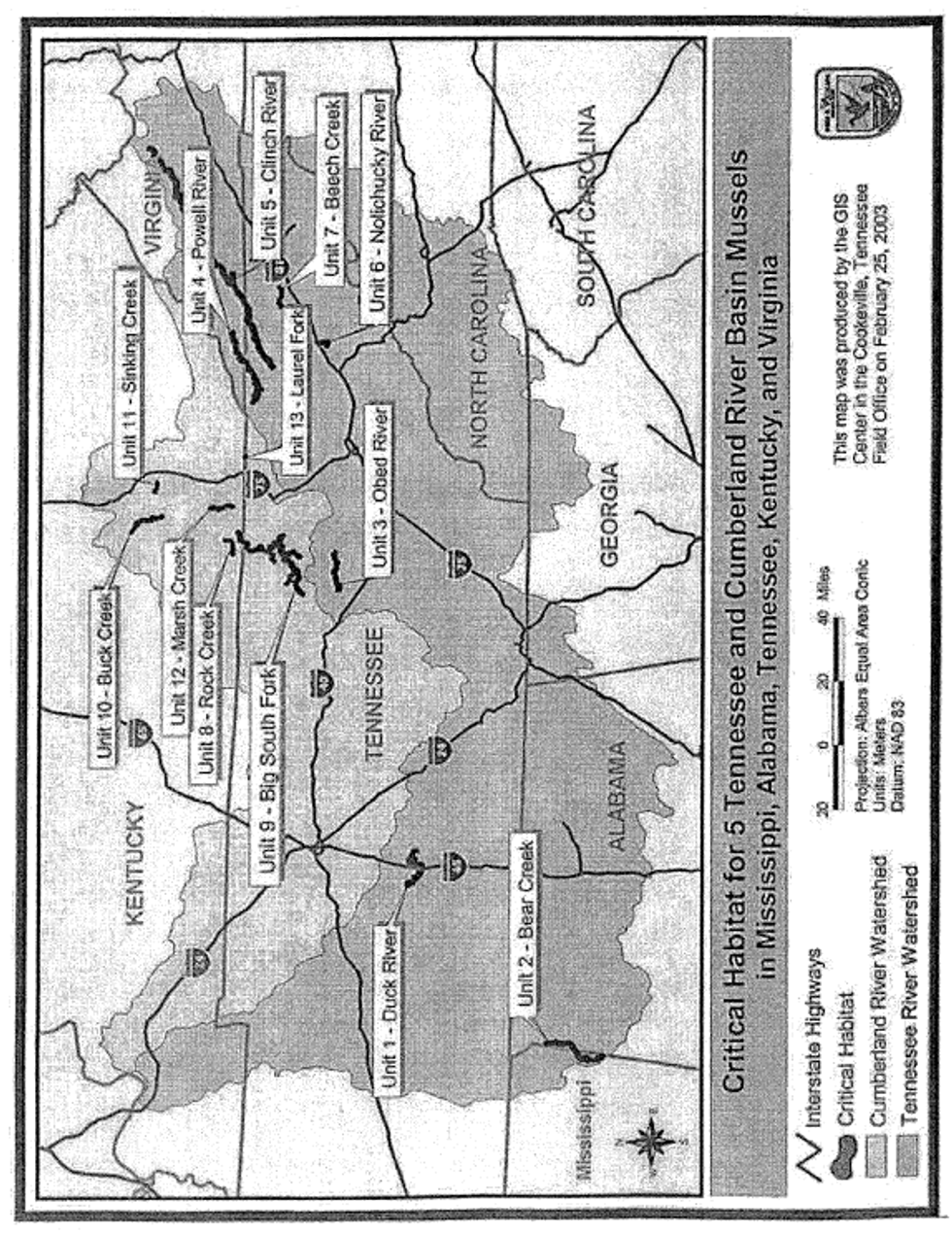
(ii) Table of protected species and critical habitat units. A table listing the protected species, their respective critical habitat units, and the States that contain those habitat units follows. Detailed critical habitat unit descriptions and maps appear below the table.
| Species | Critical habitat units | States |
|---|---|---|
| purple bean (Villosa perpurpurea) | Units 3, 4, 5, 7 | TN, VA |
| Cumberlandian combshell (Epioblasma brevidens) | Units 1, 2, 4, 5, 6, 9, 10 | AL, KY, MS, TN, VA |
| Cumberland elktoe (Alasmidonta atropurpurea) | Units 8, 9, 11, 12, 13 | KY, TN |
| oyster mussel (Epioblasma capsaeformis) | Units 1, 2, 4, 5, 6, 9,10 | AL, KY, MS, TN, VA |
| rough rabbitsfoot (Quadrula cylindrica strigillata) | Units 4, 5 | TN, VA |
(iii) Unit 1. Duck River, Marshall and Maury Counties, Tennessee. This is a critical habitat unit for the oyster mussel and Cumberlandian combshell.
(A) Unit 1 includes the main stem of the Duck River from rkm 214 (rmi 133) (0.3 rkm (0.2 rmi) upstream of the First Street Bridge) (−87.03 longitude, 35.63 latitude) in the City of Columbia, Maury County, Tennessee, upstream to Lillard Mill Dam at rkm 288 (rmi 179) (−86.78 longitude, 35.58 latitude), Marshall County, Tennessee.
(B) Map of Unit 1 follows:
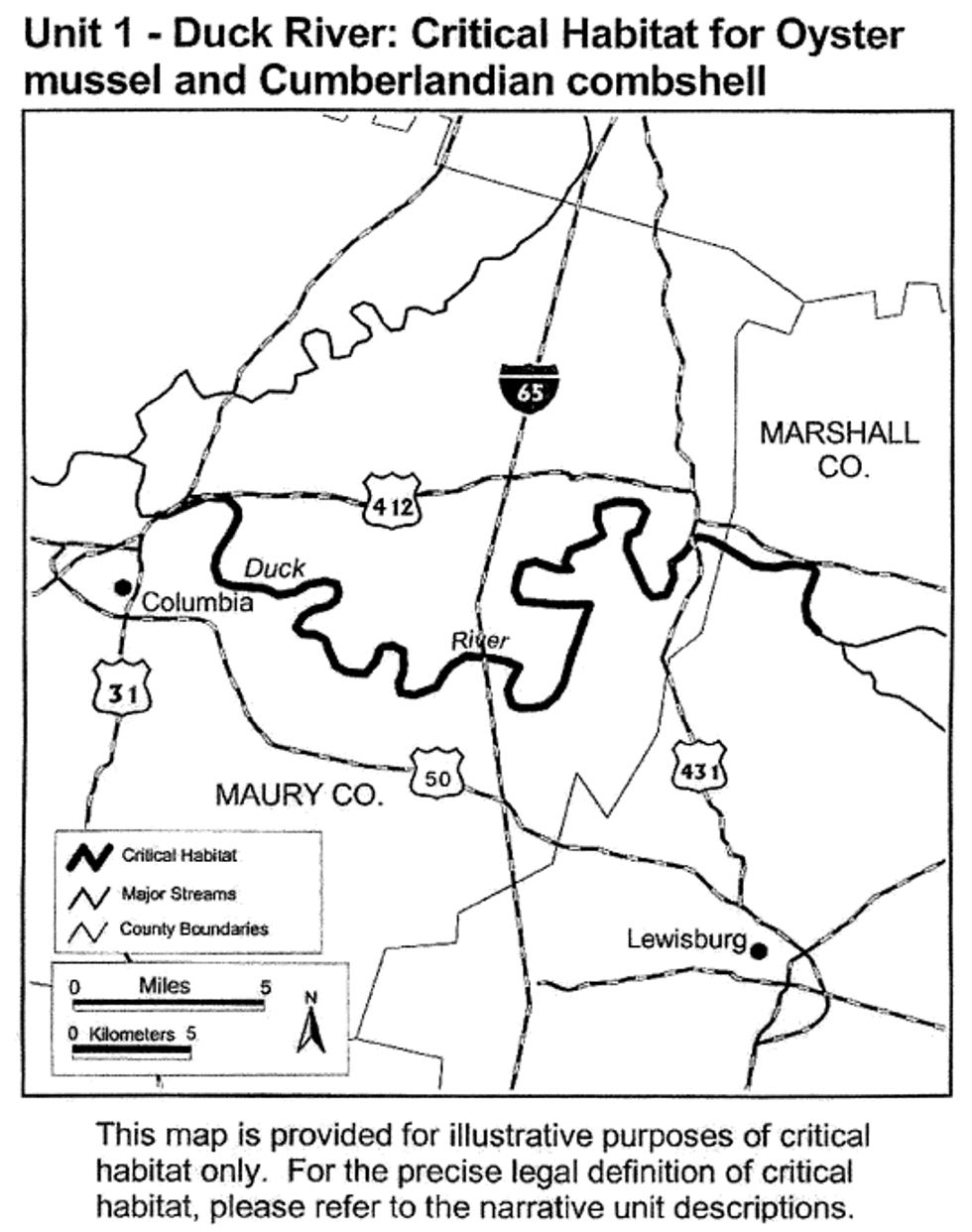
(iv) Unit 2. Bear Creek, Colbert County, Alabama, and Tishomingo County, Mississippi. This is a critical habitat unit for the oyster mussel and Cumberlandian combshell.
(A) Unit 2 consists of the main stem of Bear Creek from the backwaters of Pickwick Lake at rkm 37 (rmi 23) (-88.09 longitude, 34.81 latitude), Colbert County, Alabama, upstream through Tishomingo County, Mississippi, ending at the Mississippi/Alabama State line.
(B) Map of Unit 2 follows:
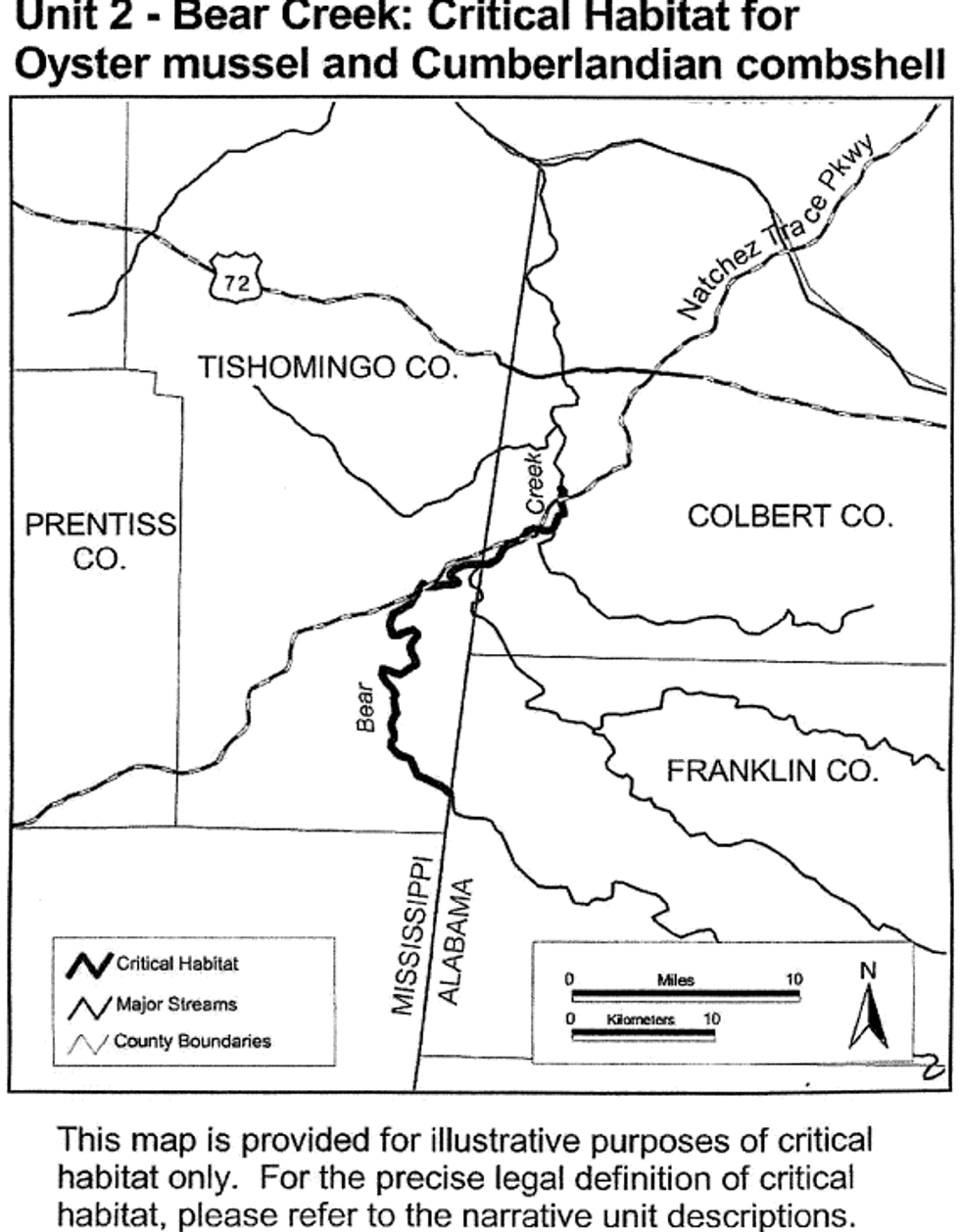
(v) Unit 3. Obed River, Cumberland and Morgan Counties, Tennessee. This is a critical habitat unit for the purple bean.
(A) Unit 3 includes the Obed River main stem from its confluence with the Emory River (-84.69 longitude, 36.09 latitude), Morgan County, Tennessee, upstream to Adams Bridge, Cumberland County, Tennessee (-84.95 longitude, 36.07 latitude).
(B) Map of Unit 3 follows:
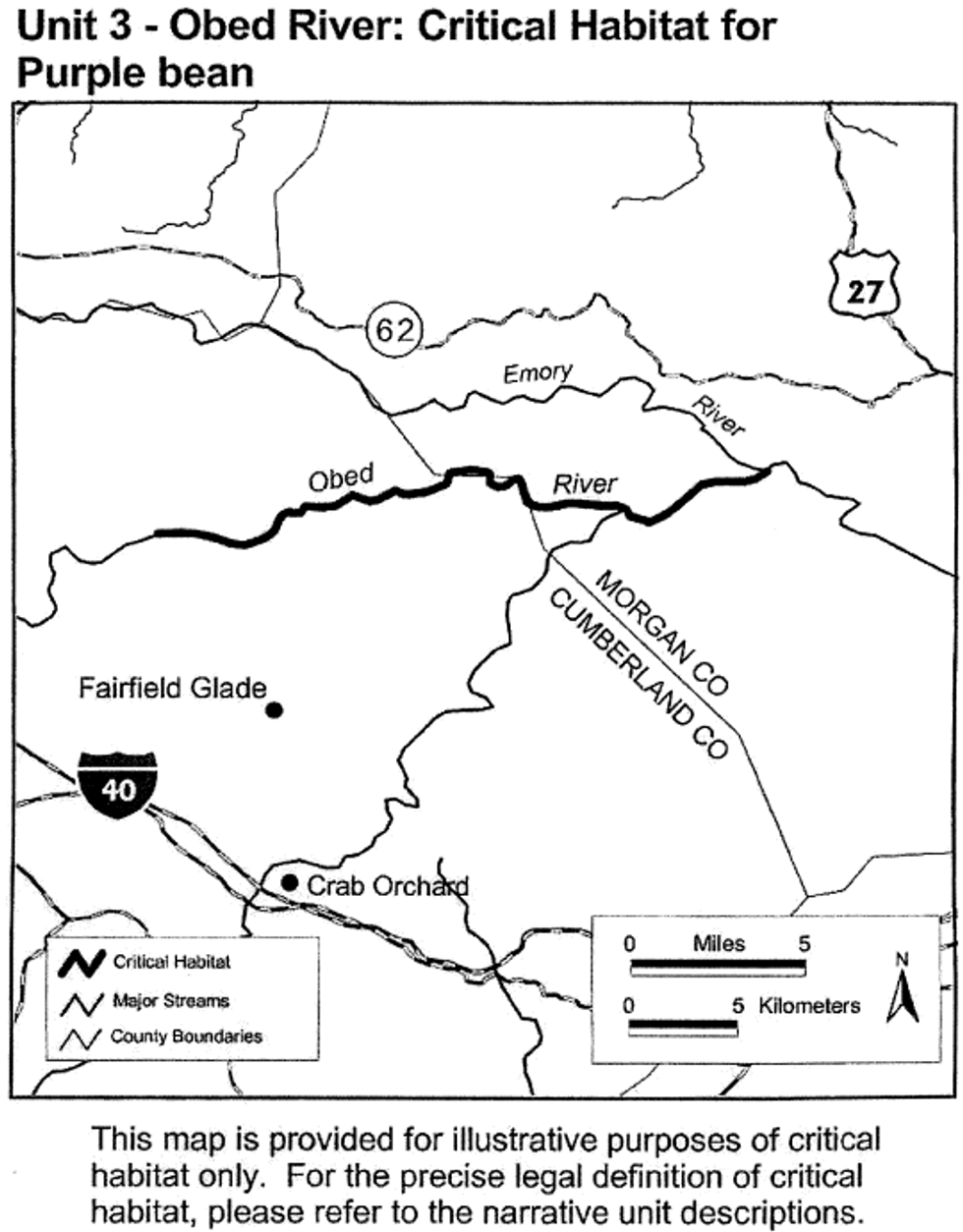
(vi) Unit 4. Powell River, Claiborne and Hancock Counties, Tennessee, and Lee County, Virginia. This is a critical habitat unit for the purple bean, Cumberlandian combshell, oyster mussel, and rough rabbitsfoot.
(A) Unit 4 includes the main stem of the Powell River from the U.S. 25E bridge in Claiborne County, Tennessee (-83.63 longitude, 36.53 latitude), upstream to river mile 159 (upstream of Rock Island in the vicinity of Pughs) Lee County, Virginia.
(B) Map of Unit 4 follows:
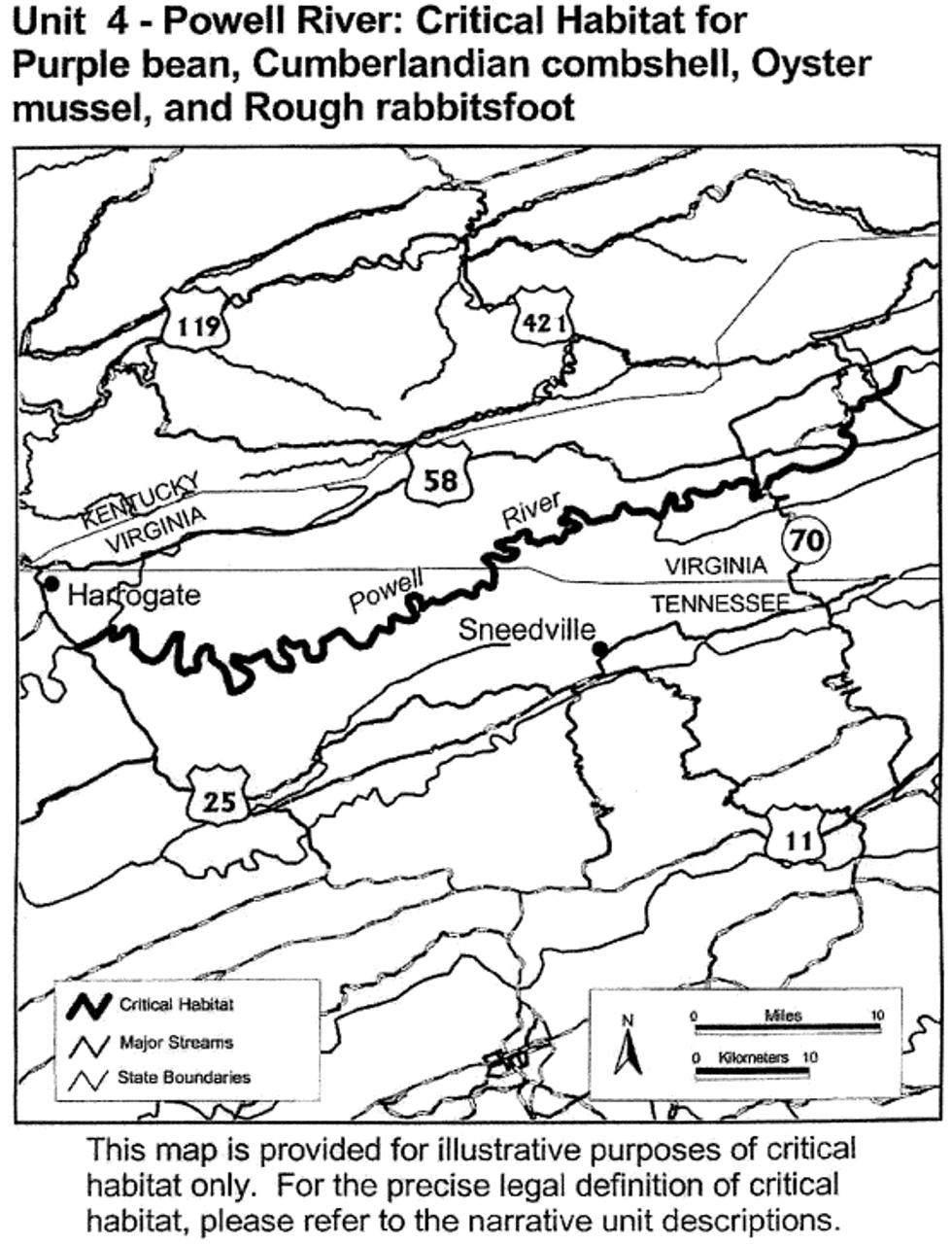
(vii) Unit 5. Clinch River, Hancock County, Tennessee, and Scott, Russell, and Tazewell Counties, Virginia; Copper Creek, Scott County, Virginia; and Indian Creek, Tazewell County, Virginia. This is a critical habitat unit for the purple bean, Cumberlandian combshell, oyster mussel, and rough rabbitsfoot.
(A) Unit 5 includes the Clinch River main stem from rkm 255 (rmi 159) (−83.36 longitude, 36.43 latitude) immediately below Grissom Island, Hancock County, Tennessee, upstream to its confluence with Indian Creek in Cedar Bluff, Tazewell County, Virginia (−81.80 longitude, 37.10 latitude); Copper Creek in Scott County, Virginia, from its confluence with the Clinch River (−82.74 longitude, 36.67 latitude) upstream to Virginia State Route 72 (−82.56 longitude, 36.68 latitude); and Indian Creek from its confluence with the Clinch River upstream to the fourth Norfolk Southern Railroad crossing at Van Dyke, Tazewell County, Virginia (−81.77 longitude, 37.14 latitude).
(B) Map of Unit 5 follows:
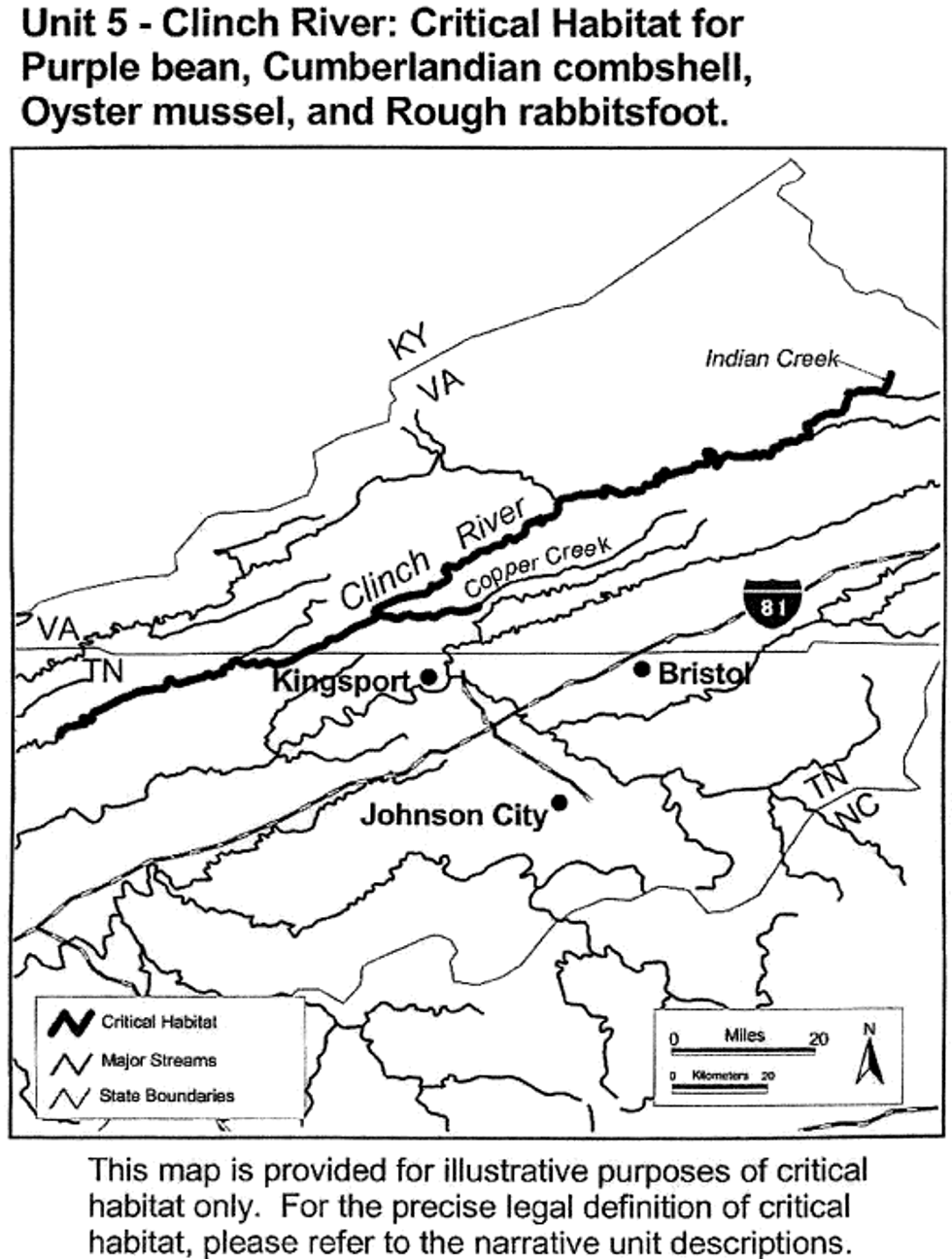
(viii) Unit 6. Nolichucky River, Hamblen and Cocke Counties, Tennessee. This is a critical habitat unit for the Cumberlandian combshell and oyster mussel.
(A) Unit 6 consists of the main stem of the Nolichucky River from rkm 14 (rmi 9) (−83.18 longitude, 36.18 latitude) (approximately 0.6 rkm (0.4 rmi) upstream of Enka Dam) upstream to Susong Bridge (−83.20 longitude, 36.14 latitude) in Hamblen and Cocke Counties, Tennessee.
(B) Map of Unit 6 follows:
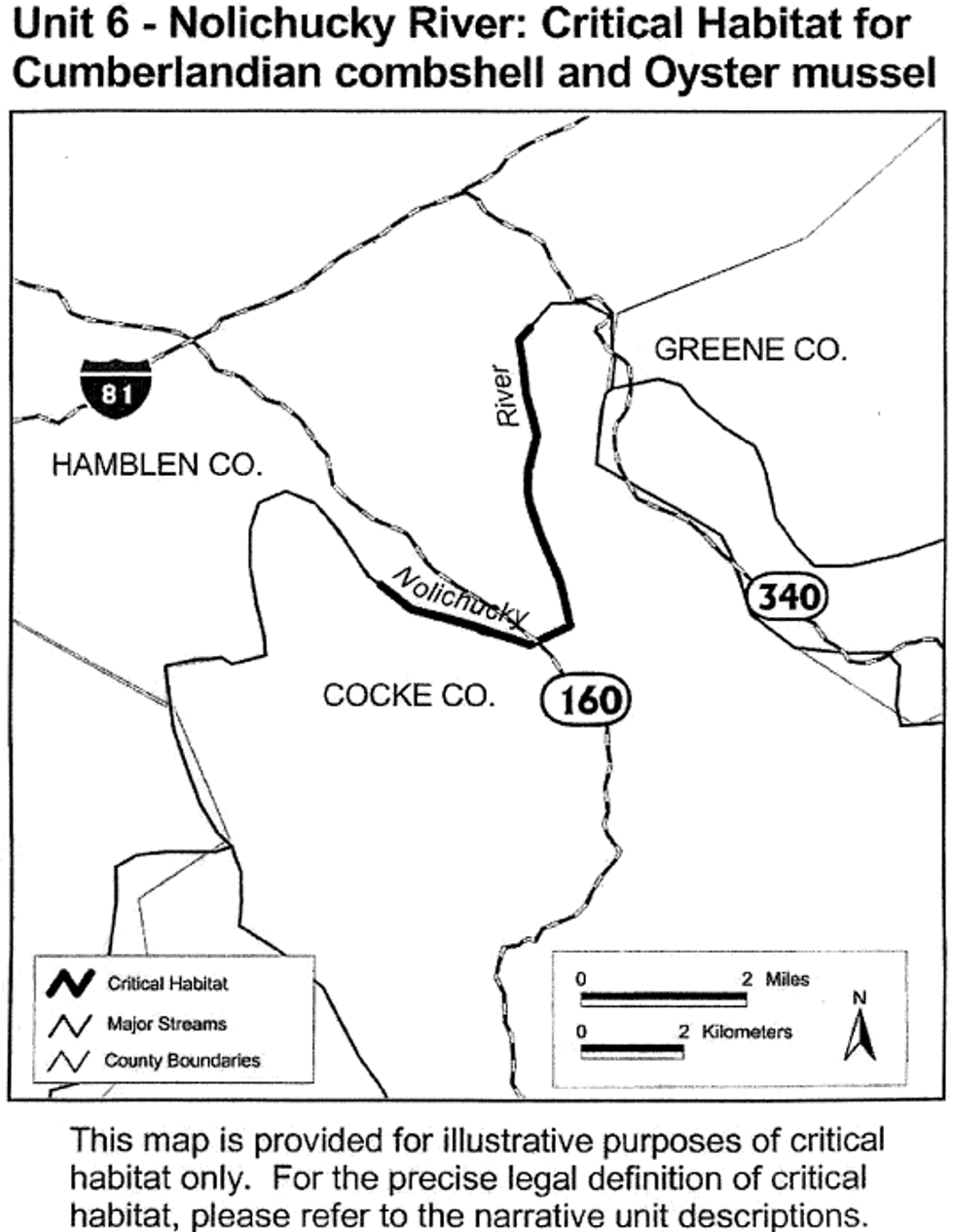
(ix) Unit 7. Beech Creek, Hawkins County, Tennessee. This is a critical habitat unit for the purple bean.
(A) Unit 7 includes the Beech Creek main stem from rkm 4 (rmi 2) (−82.92 longitude, 36.40 latitude) of Beech Creek (in the vicinity of Slide, Tennessee) upstream to the dismantled railroad bridge at rkm 27 (rmi 16) (−82.77 longitude, 36.40 latitude).
(B) Map of Unit 7 follows:
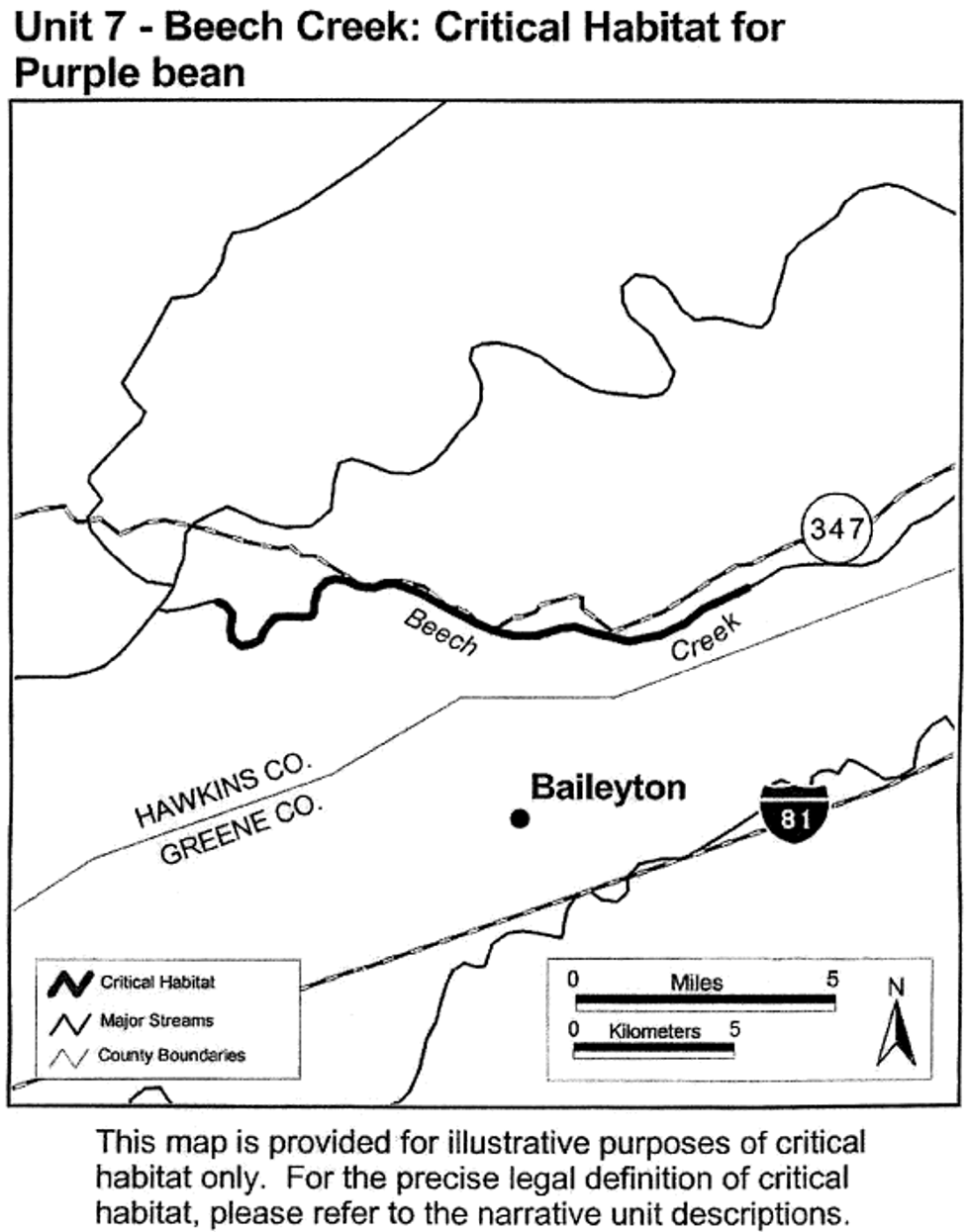
(x) Unit 8. Rock Creek, McCreary County, Kentucky. This is a critical habitat unit for the Cumberland elktoe.
(A) Unit 8 includes the main stem of Rock Creek from its confluence with White Oak Creek (−84.59 longitude, 36.71 latitude), upstream to the low-water crossing at rkm 25.6 (rmi 15.9) approximately 2.6 km (1.6 mi) southwest of Bell Farm (−84.69 longitude, 36.65 latitude), McCreary County, Kentucky.
(B) Map of Unit 8 follows:

(xi) Unit 9. Big South Fork of the Cumberland River and its tributaries, Fentress, Morgan, and Scott Counties, Tennessee, and McCreary County, Kentucky. This is a critical habitat unit for the Cumberlandian combshell, Cumberland elktoe, and oyster mussel.
(A) Unit 9 consists of the Big South Fork of the Cumberland River main stem from its confluence with Laurel Crossing Branch (−84.54 longitude, 36.64 latitude), McCreary County, Kentucky, upstream to its confluence with the New River and Clear Fork, Scott County, Tennessee; North White Oak Creek from its confluence with the Big South Fork upstream to Panther Branch (−84.75 longitude, 36.42 latitude), Fentress County, Tennessee; New River from its confluence with Clear Fork upstream to U.S. Highway 27 (−84.55 longitude, 36.38 latitude), Scott County, Tennessee; Clear Fork from its confluence with the New River upstream to its confluence with North Prong Clear Fork, Morgan and Fentress Counties, Tennessee; White Oak Creek from its confluence with Clear Fork upstream to its confluence with Bone Camp Creek, Morgan County, Tennessee; Bone Camp Creek from its confluence with White Oak Creek upstream to Massengale Branch (−84.71 longitude, 36.28 latitude), Morgan County, Tennessee; Crooked Creek from its confluence with Clear Fork upstream to Buttermilk Branch (−84.92 longitude, 36.36 latitude), Fentress County, Tennessee; and North Prong Clear Fork from its confluence with Clear Fork upstream to Shoal Creek (−84.97 longitude, 36.26 latitude), Fentress County, Tennessee.
(B) Maps of Unit 9 follow:
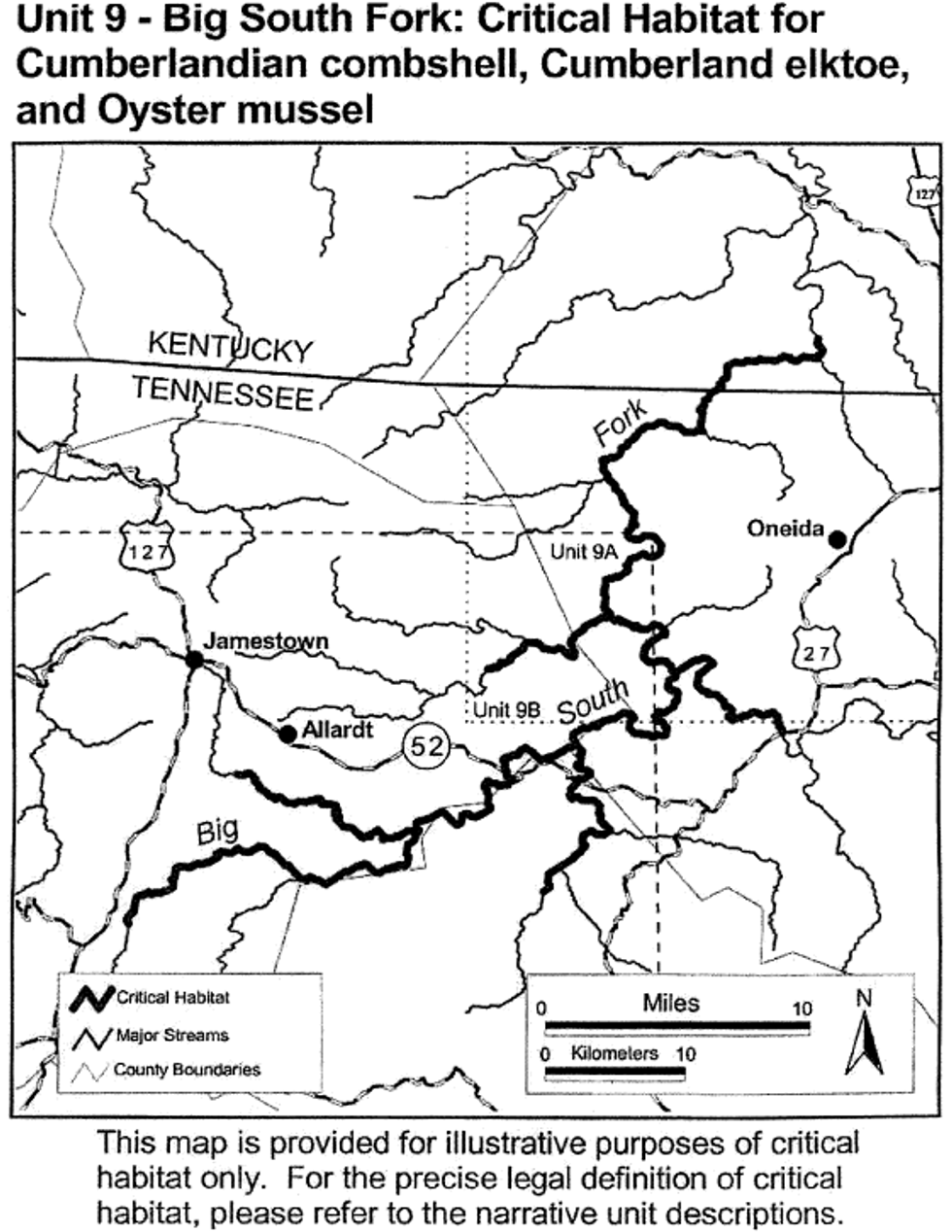
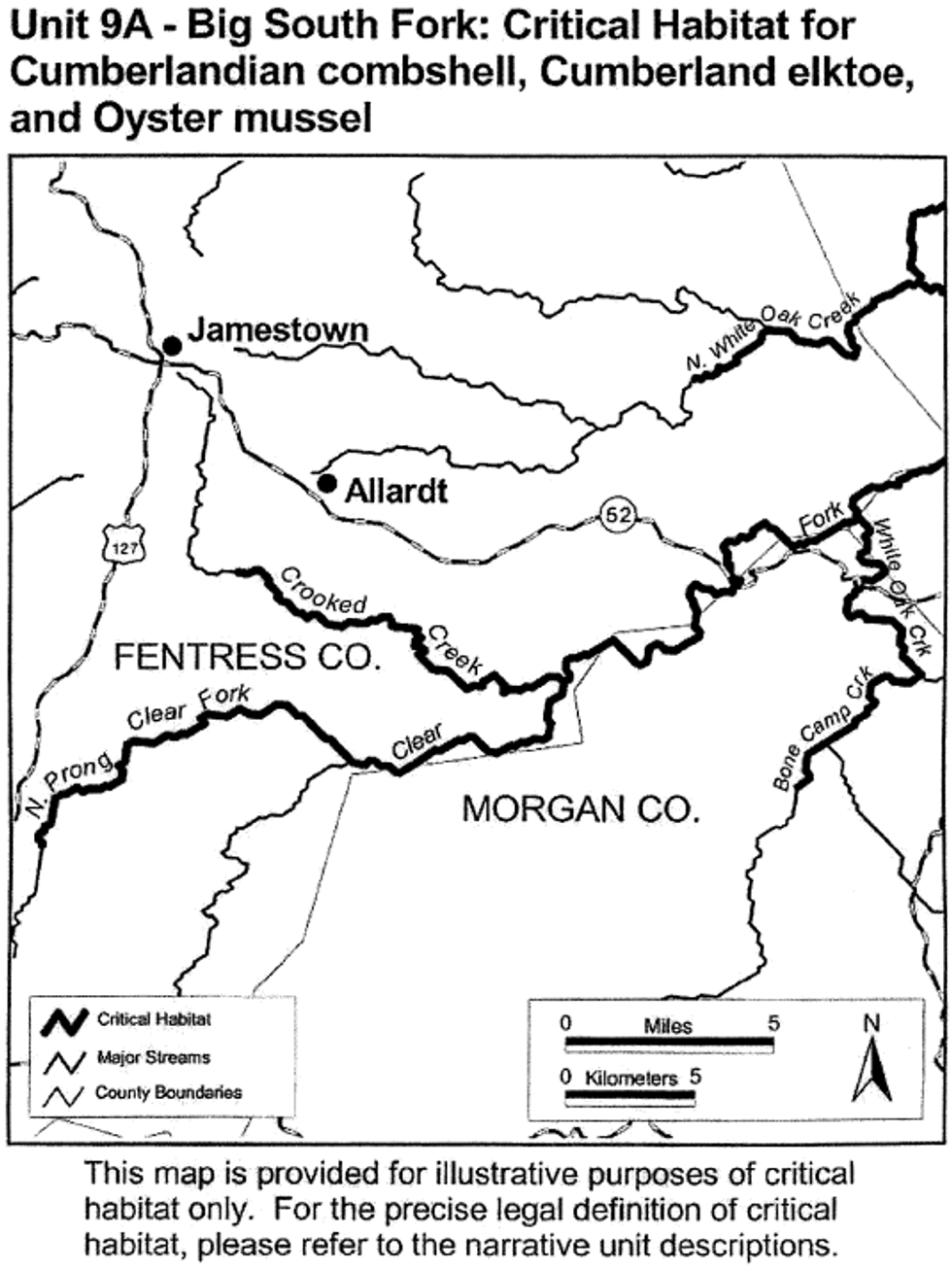
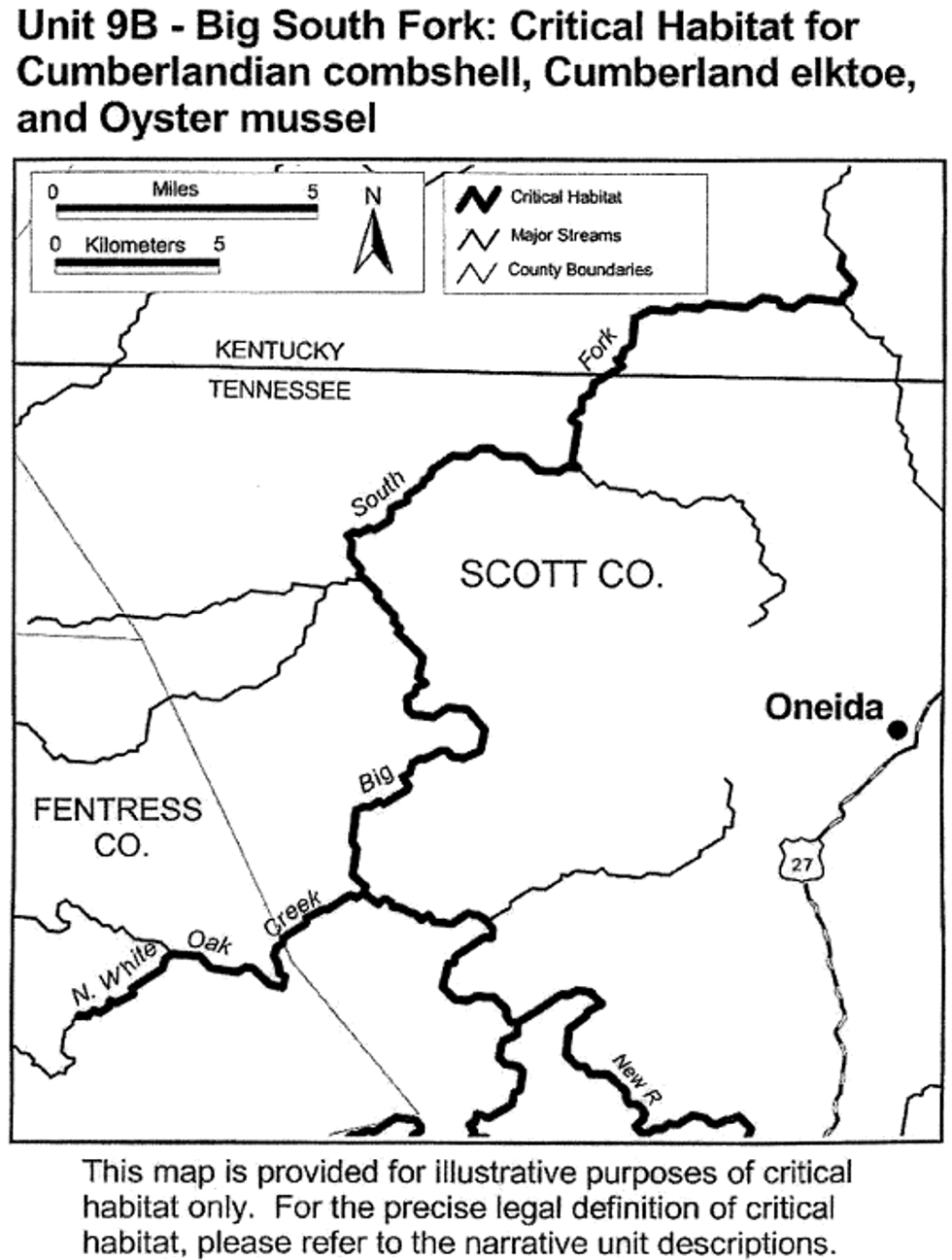
(xii) Unit 10. Buck Creek, Pulaski County, Kentucky. This is a critical habitat unit for the Cumberlandian combshell and oyster mussel.
(A) Unit 10 includes the Buck Creek main stem from the State Road 192 Bridge (−84.43 longitude, 37.06 latitude) upstream to the State Road 328 Bridge (−84.56 longitude, 37.32 latitude) in Pulaski County, Kentucky.
(B) Map of Unit 10 follows:
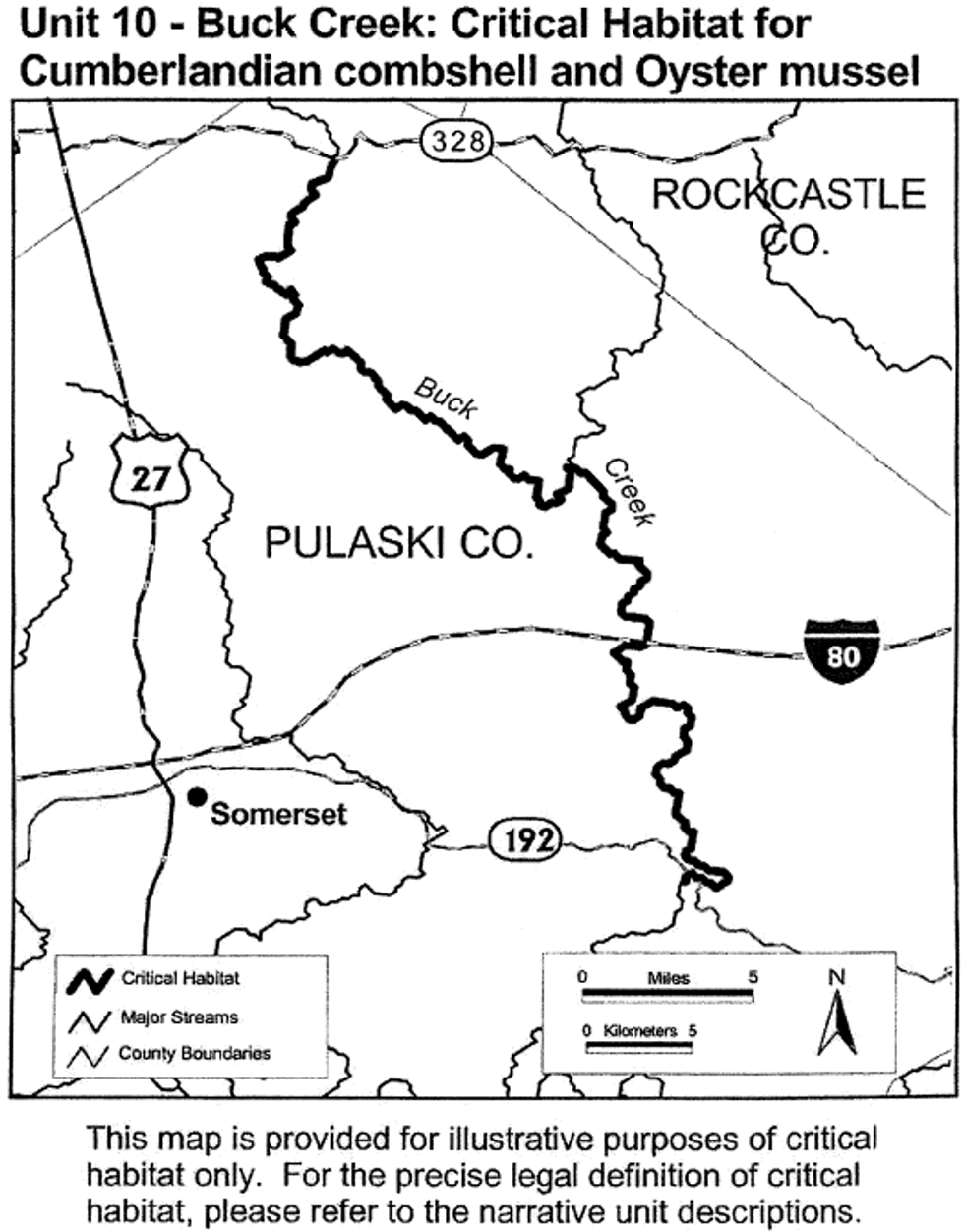
(xiii) Unit 11. Sinking Creek, Laurel County, Kentucky. This is a critical habitat unit for the Cumberland elktoe.
(A) Unit 11 includes the main stem of Sinking Creek from its confluence with the Rockcastle River (−84.28 longitude, 37.10 latitude) upstream to its confluence with Laurel Branch (−84.17 longitude, 37.09 latitude) in Laurel County, Kentucky.
(B) Map of Unit 11 follows:
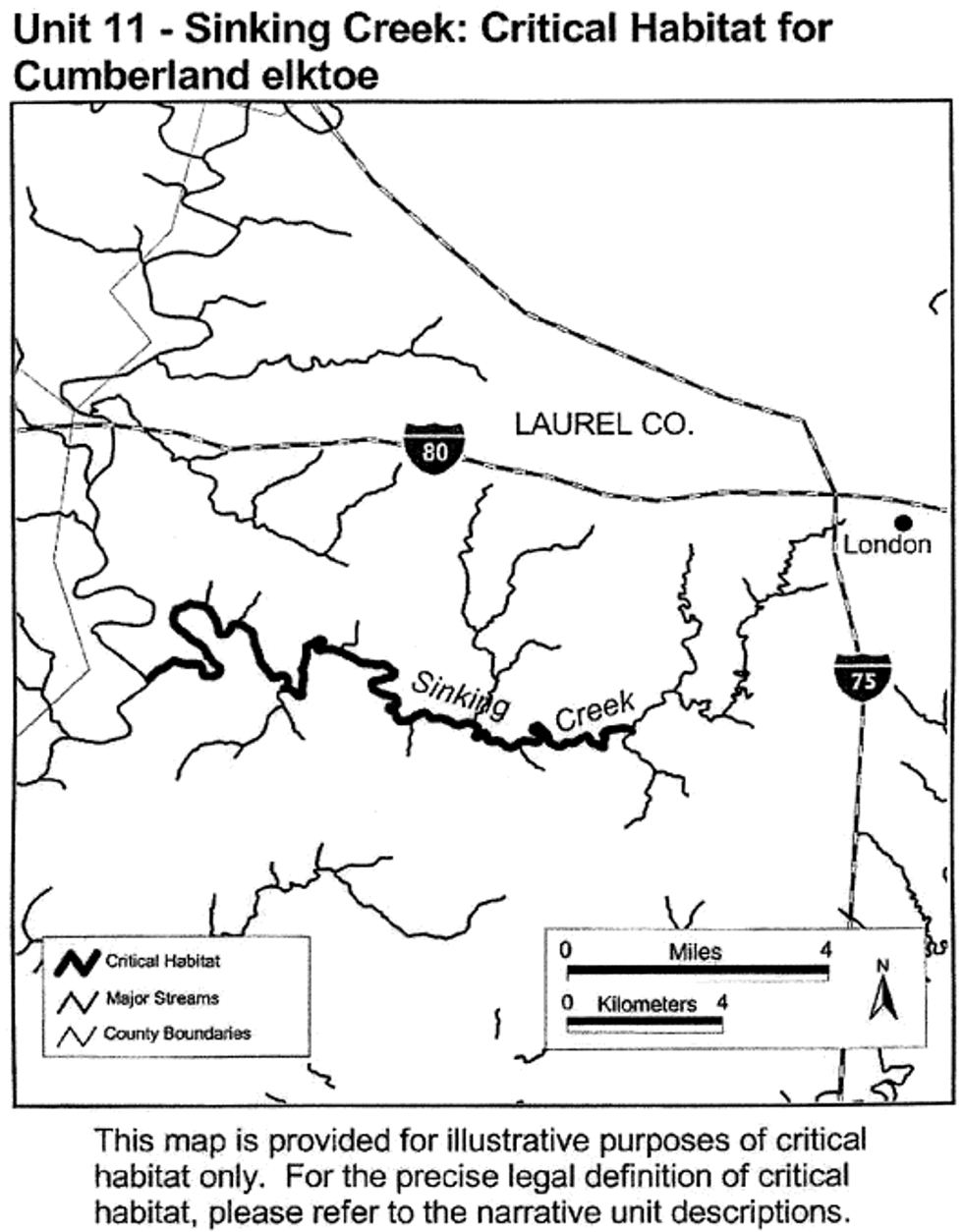
(xiv) Unit 12. Marsh Creek, McCreary County, Kentucky. This is a critical habitat unit for the Cumberland elktoe.
(A) Unit 12 includes the Marsh Creek main stem from its confluence with the Cumberland River (−84.35 longitude, 36.78 latitude) upstream to State Road 92 Bridge (−84.35 longitude, 36.66 latitude) in McCreary County, Kentucky.
(B) Map of Unit 12 follows:
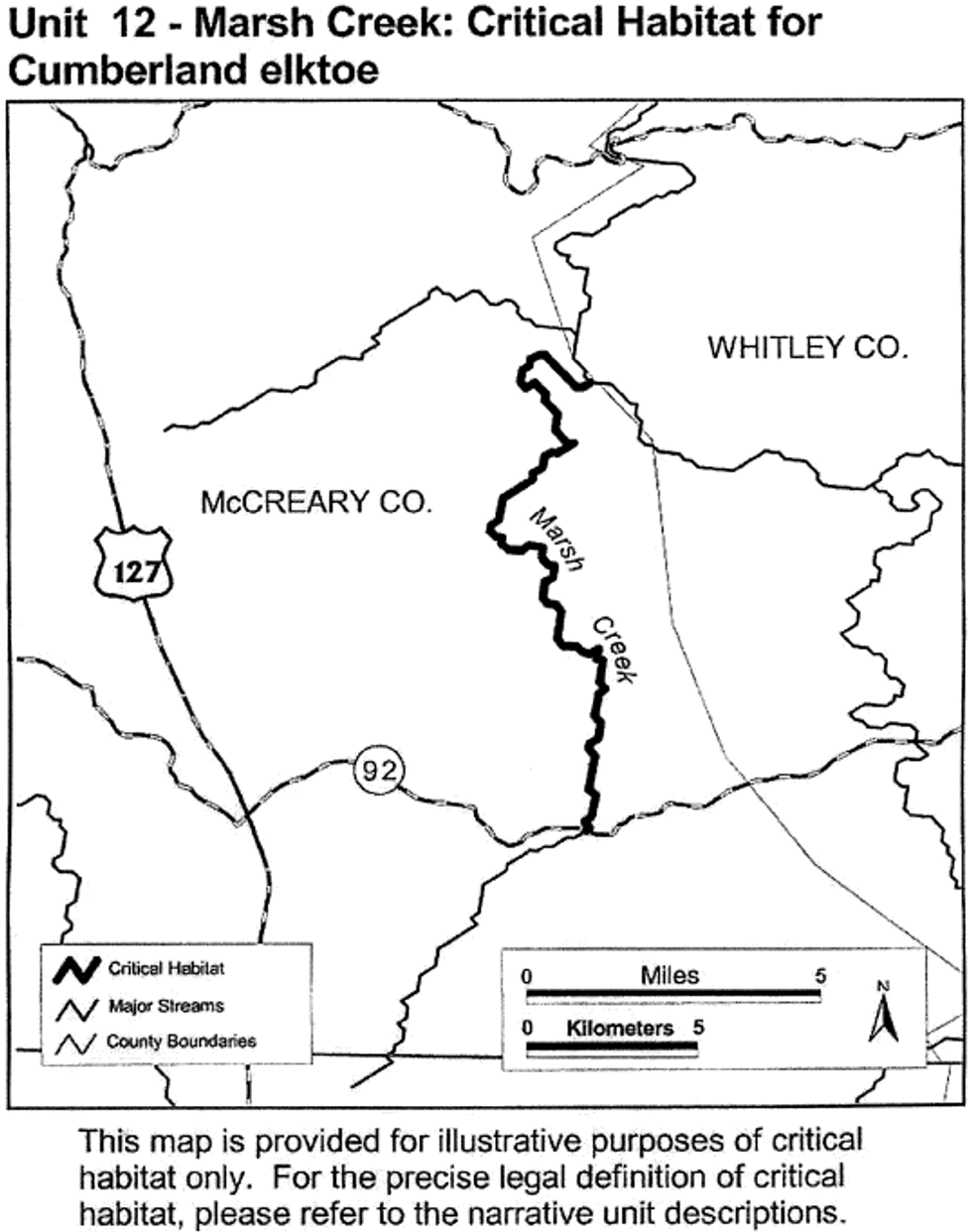
(xv) Unit 13. Laurel Fork, Claiborne County, Tennessee, and Whitley County, Kentucky. This is a critical habitat unit for the Cumberland elktoe.
(A) Unit 13 includes the main stem of the Laurel Fork of the Cumberland River from the boundary between Claiborne and Campbell Counties (−84.00 longitude, 36.58 latitude) upstream to rkm 11 (rmi 6.85) in Whitley County, Kentucky. The upstream terminus is 3 rkm (2 rmi) upstream of the Kentucky/Tennessee State line (−84.00 longitude, 36.60 latitude).
(B) Map of Unit 13 follows:
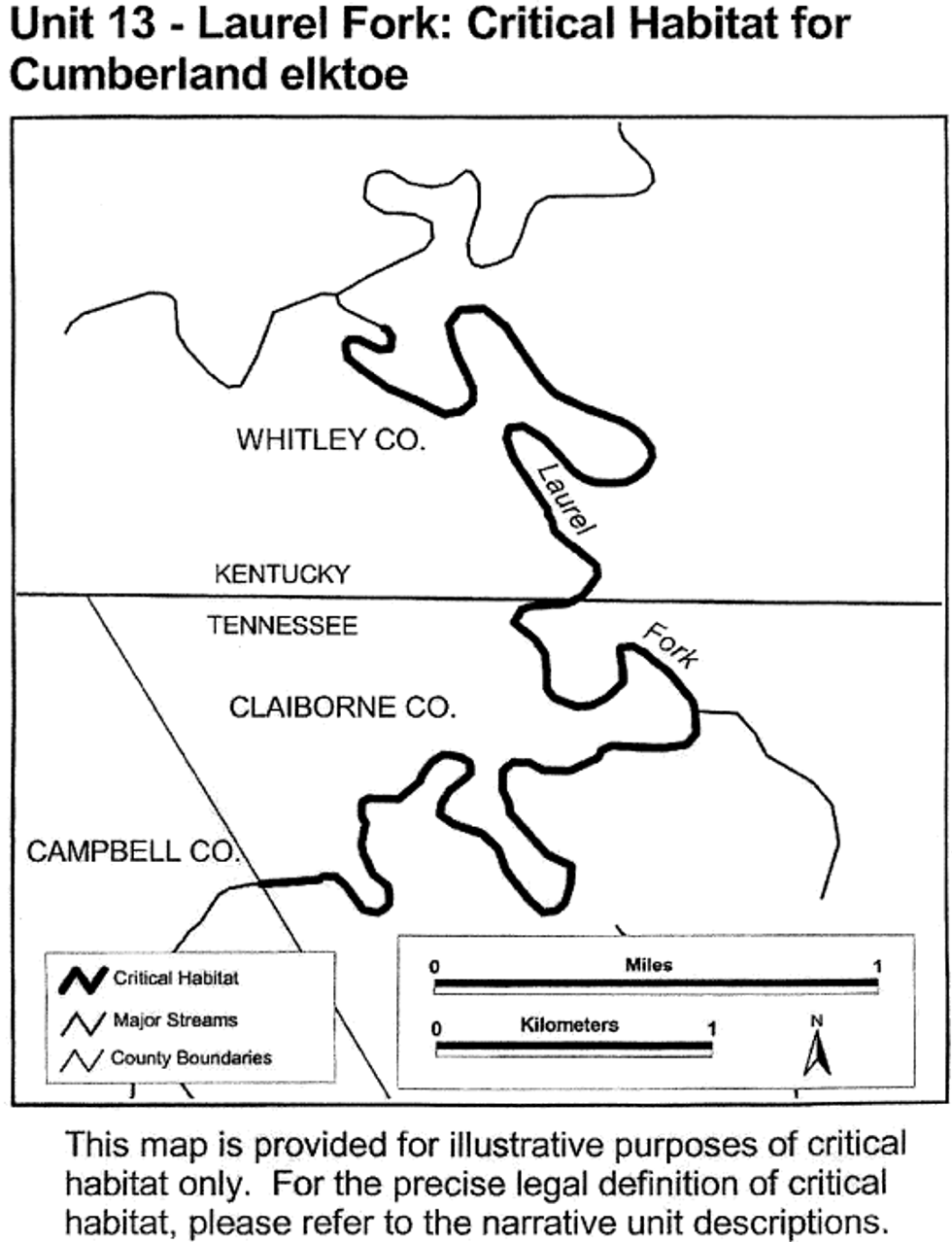
Seven mussel species (in four northeast Gulf of Mexico drainages): Purple bankclimber (Elliptoideus sloatianus), Gulf moccasinshell (Medionidus penicillatus), Ochlockonee moccasinshell (Medionidus simpsonianus), oval pigtoe (Pleurobema pyriforme), shinyrayed pocketbook (Hamiota subangulata), Chipola slabshell (Elliptio chipolaensis), and fat threeridge (Amblema neislerii)
(1) Critical habitat units are depicted on the maps below for the following counties:
(i) Alabama: Houston and Russell;
(ii) Florida: Alachua, Bay, Bradford, Calhoun, Columbia, Franklin, Gadsden, Gulf, Jackson, Leon, Liberty, Union, Wakulla, and Washington; and
(iii) Georgia: Baker, Calhoun, Coweta, Crawford, Crisp, Decatur, Dooly, Dougherty, Early, Fayette, Grady, Lee, Macon, Marion, Meriwether, Miller, Mitchell, Peach, Pike, Schley, Spalding, Sumter, Talbot, Taylor, Terrell, Thomas, Upson, Webster, and Worth.
(2) The primary constituent elements of critical habitat for the purple bankclimber (Elliptoideus sloatianus), Gulf moccasinshell (Medionidus penicillatus), Ochlockonee moccasinshell (Medionidus simpsonianus), oval pigtoe (Pleurobema pyriforme), shinyrayed pocketbook (Hamiota subangulata), Chipola slabshell (Elliptio chipolaensis), and fat threeridge (Amblema neislerii) are:
(i) A geomorphically stable stream channel (a channel that maintains its lateral dimensions, longitudinal profile, and spatial pattern over time without a consistent aggrading or degrading bed elevation);
(ii) A predominantly sand, gravel, and/or cobble stream substrate with low to moderate amounts of silt and clay;
(iii) Permanently flowing water;
(iv) Water quality (including temperature, turbidity, dissolved oxygen, and chemical constituents) that meets or exceeds the current aquatic life criteria established under the Clean Water Act (33 U.S.C. 1251-1387); and
(v) Fish hosts (such as largemouth bass, sailfin shiner, brown darter) that support the larval life stages of the seven mussels.
(3) Critical habitat does not include manmade structures (such as buildings, aqueducts, airports, roads, and other paved areas) and the land on which they are located existing within the legal boundaries on the effective date of this rule and not containing one or more of the primary constituent elements.
(4) Critical habitat unit maps. Data layers defining map units were created with USGS National Hydrography Dataset (NHD) GIS data. The 1:100,000 river reach (route) files were used to calculate river kilometers and miles. The following data sources were referenced to identify upstream and downstream extents of critical habitat units: USGS 7.5' quadrangles; Georgia Department of Transportation county highway maps; U.S. Census Bureau 1:100,000 TIGER line road data; 1993 Georgia digital orthographic quarter quads (DOQQs); 2004 Florida DOQQs; and DeLorme Atlas and Gazetteers for Alabama, Florida, and Georgia. The projection used in mapping all units was Universal Transverse Mercator (UTM), NAD 83, Zone 16 North.
(5) Note: Index map of critical habitat units in the States of Alabama, Florida, and Georgia for the seven mussels follows:
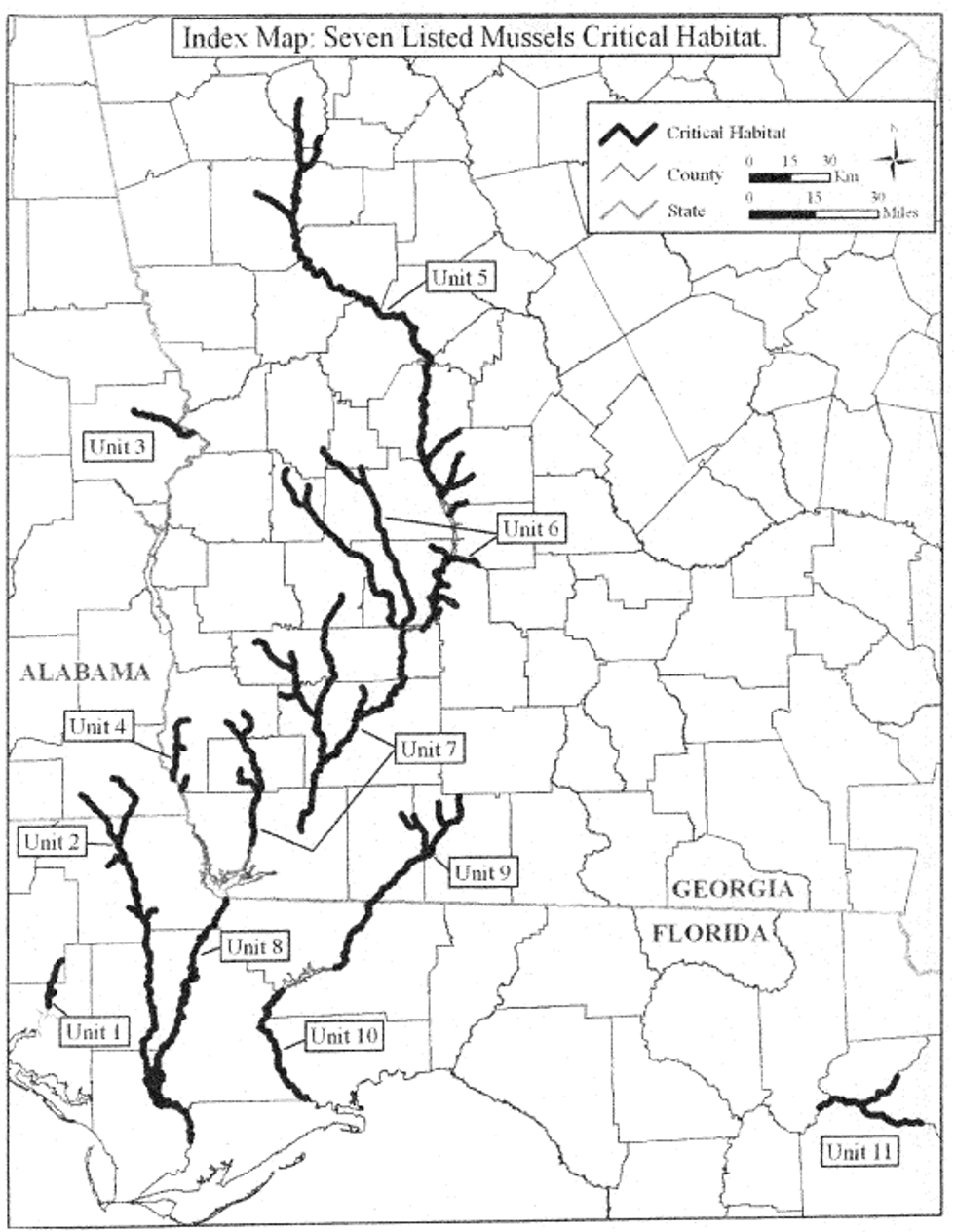
(6) Table of listed species and critical habitat units. A table showing the listed species, their respective critical habitat units, and the States that contain those habitat units follows. Detailed critical habitat unit descriptions and maps appear below in paragraphs (7) through (17).
| Species | Critical habitat units | States |
|---|---|---|
| Purple bankclimber (Elliptoideus sloatianus) | Units 5, 6, 7, 8, 9, 10 | AL, FL, GA |
| Gulf moccasinshell (Medionidus penicillatus) | Units 1, 2, 4, 5, 6, 7 | AL, FL, GA |
| Ochlockonee moccasinshell (Medionidus simpsonianus) | Unit 9 | FL, GA |
| Oval pigtoe (Pleurobema pyriforme) | Units 1, 2, 4, 5, 6, 7, 9, 11 | AL, FL, GA |
| Shinyrayed pocketbook (Hamiota subangulata) | Units 2, 3, 4, 5, 6, 7, 9 | AL, FL, GA |
| Chipola slabshell (Elliptio chipolaensis) | Unit 2 | AL, FL |
| Fat threeridge (mussel) (Amblema neislerii) | Units 2, 7, 8 | AL, FL, GA |
(7) Unit 1. Econfina and Moccasin creeks, Bay and Washington Counties, Florida. This is a critical habitat unit for the Gulf moccasinshell and oval pigtoe.
(i) General Description: Unit 1 includes the main stem of Econfina Creek and one of its tributaries, Moccasin Creek, encompassing a total stream length of 31.4 kilometers (km) (19.5 miles (mi)). The main stem of Econfina Creek extends from its confluence with Deer Point Lake at the powerline crossing located 3.8 km (2.3 mi) downstream of Bay County Highway 388 (−85.56 longitude, 30.36 latitude), Bay County, Florida, upstream 28.6 km (17.8 mi) to Tenmile Creek (−85.50 longitude, 30.51 latitude), Washington County, Florida; and Moccasin Creek from its confluence with Econfina Creek upstream 2.8 km (1.7 mi) to Ellis Branch (−85.53 longitude, 30.41 latitude), Bay County, Florida.
(ii) Unit 1 map follows:
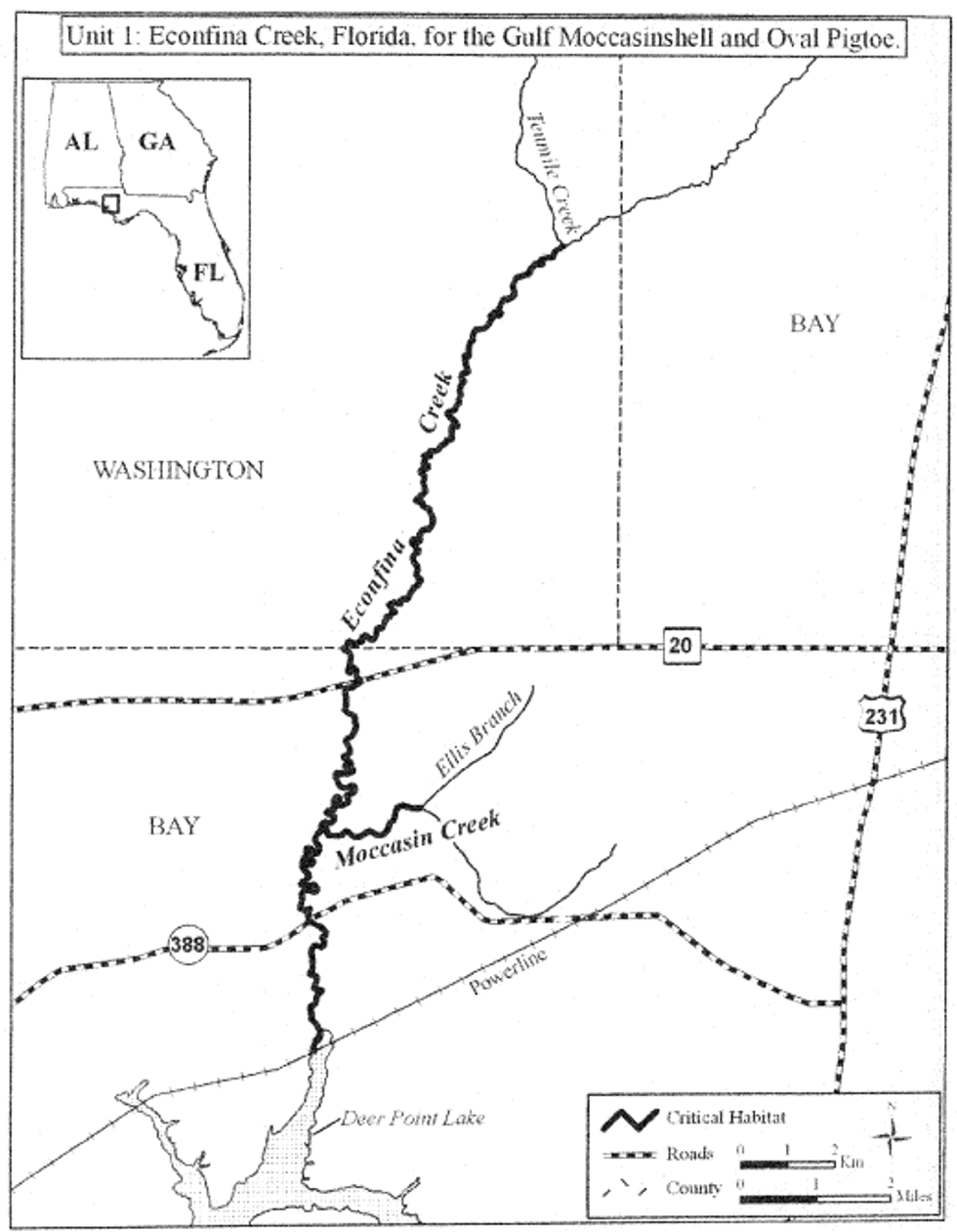
(8) Unit 2. Chipola River and Dry, Rocky, Waddells Mill, Baker, Marshall, Big, and Cowarts Creeks in Houston County, Alabama, and in Calhoun, Gulf, and Jackson counties, Florida. This is a critical habitat unit for the fat threeridge, shinyrayed pocketbook, Gulf moccasinshell, oval pigtoe, and Chipola slabshell.
(i) General Description: Unit 2 includes the main stem of the Chipola River and seven of its tributaries, encompassing a total stream length of 228.7 km (142.1 mi). The main stem of the Chipola River extends from its confluence with the Apalachicola River (−85.09 longitude, 30.01 latitude) in Gulf County, Florida, upstream 144.9 river km (90.0 river mi), including the reach known as Dead Lake, to the confluence of Marshall and Cowarts creeks (−85.27 longitude, 30.91 latitude) in Jackson County, Florida; Dry Creek from the Chipola River upstream 7.6 river km (4.7 river mi) to Ditch Branch (−85.24 longitude, 30.69 latitude), Jackson County, Florida; Rocky Creek from the Chipola River upstream 7.1 river km (4.4 river mi) to Little Rocky Creek (−85.13 longitude, 30.68 latitude), Jackson County, Florida; Waddells Mill Creek from the Chipola River upstream 3.7 river km (2.3 river mi) to Russ Mill Creek (−85.29 longitude, 30.87 latitude), Jackson County, Florida; Baker Creek from Waddells Mill Creek upstream 5.3 river km (3.3 river mi) to Tanner Springs (−85.32 longitude, 30.83 latitude), Jackson County, Florida; Marshall Creek from the Chipola River upstream 13.7 river km (8.5 river mi) to the Alabama-Florida State line (−85.33 longitude, 31.00 latitude), Jackson County, Florida; Cowarts Creek from the Chipola River in Jackson County, Florida, upstream 33.5 river km (20.8 river mi) to the Edgar Smith Road bridge (−85.29 longitude, 31.13 latitude), Houston County, Alabama; and Big Creek from the Alabama-Florida State line upstream 13.0 river km (8.1 river mi) to Limestone Creek (−85.42 longitude, 31.08 latitude), Houston County, Alabama. The short segment of the Chipola River that flows underground within the boundaries of Florida Caverns State Park is not included within this unit.
(ii) Unit 2 map follows:
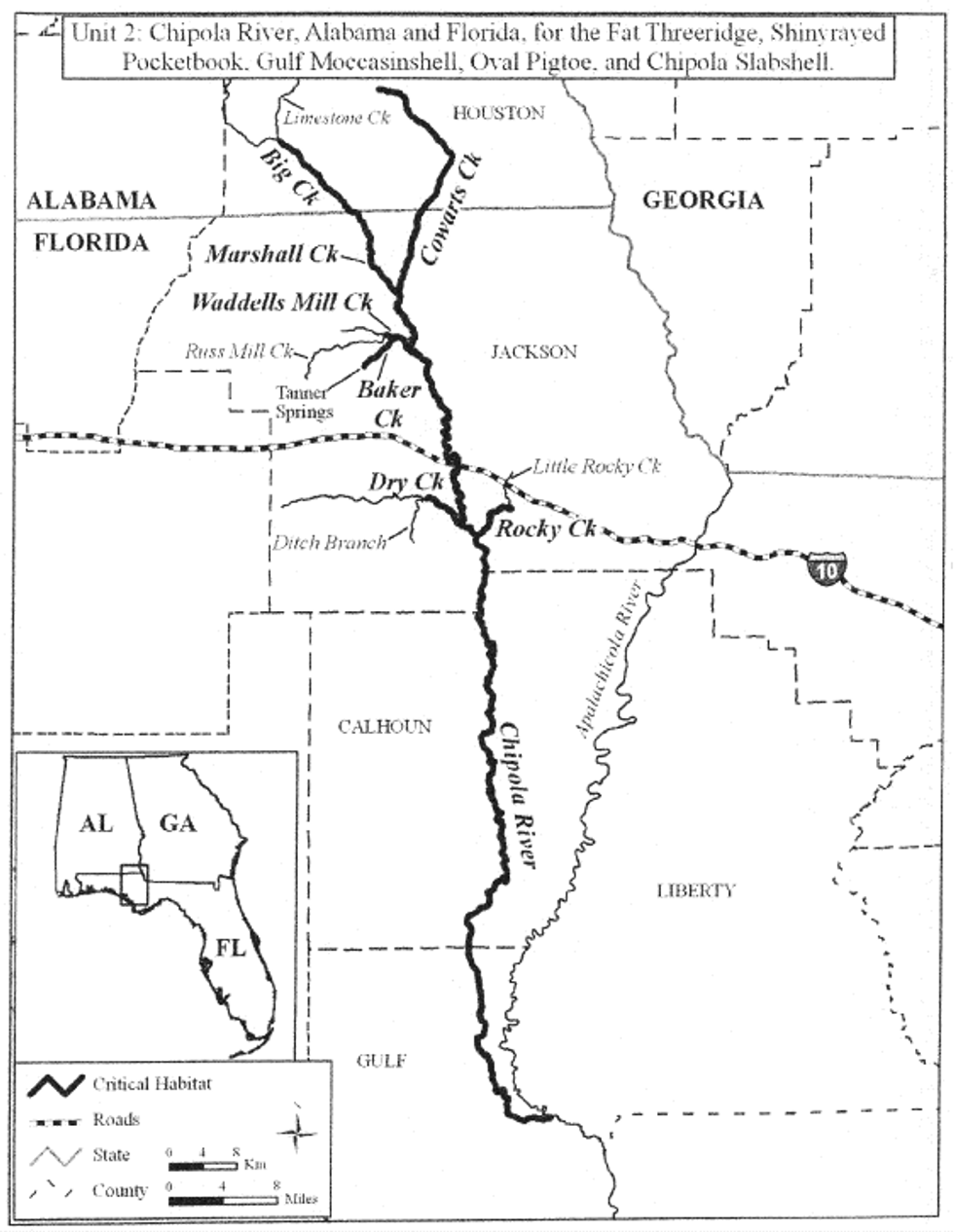
(9) Unit 3. Uchee Creek, Russell County, Alabama. This is a critical habitat unit for the shinyrayed pocketbook.
(i) General Description: Unit 3 includes the main stem of Uchee Creek from its confluence with the Chattahoochee River upstream 34.2 km (21.2 mi) to Island Creek (−85.18 longitude, 32.38 latitude), Russell County, Alabama, encompassing a total stream length of 34.2 km (21.2 mi).
(ii) Unit 3 map follows:
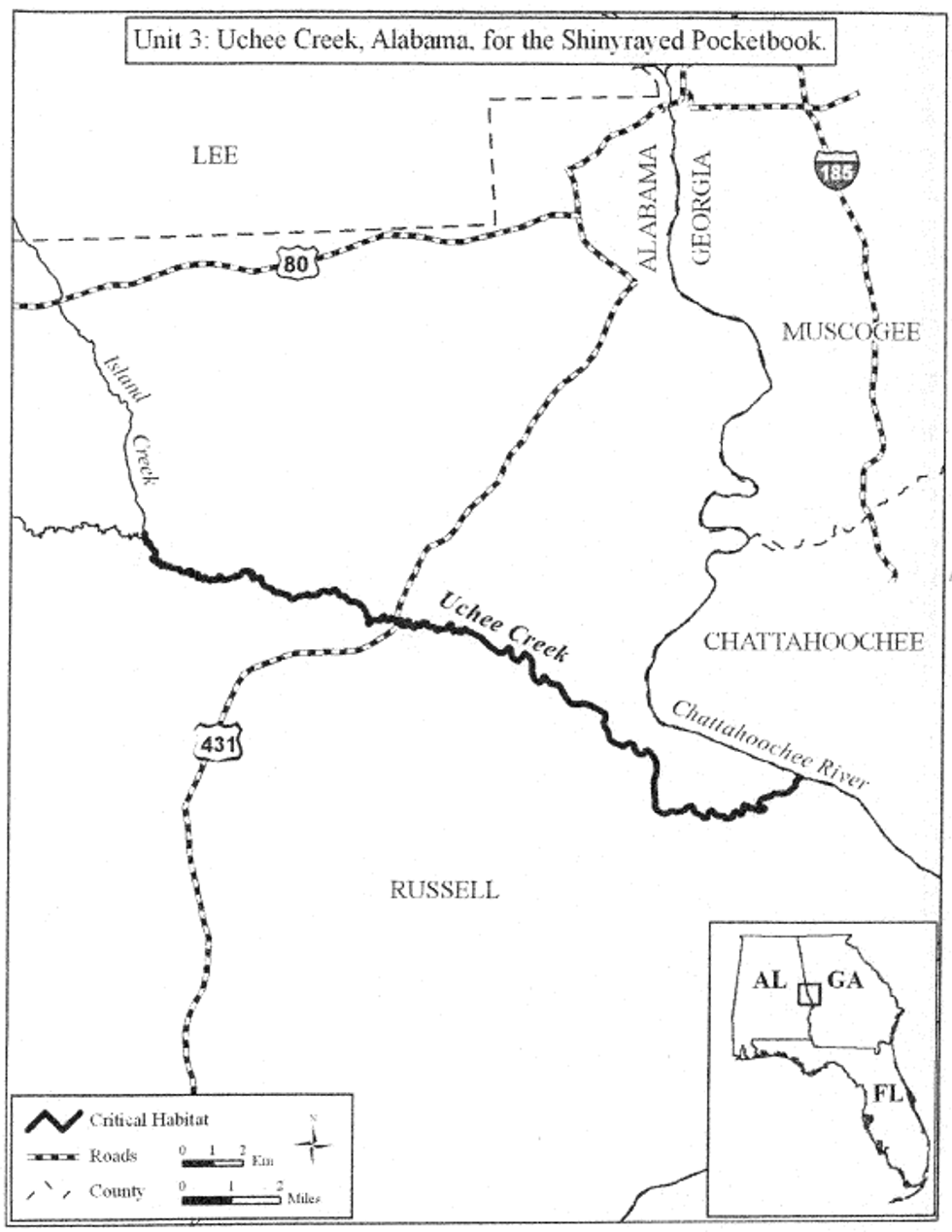
(10) Unit 4. Sawhatchee, Sheffield Mill, and Kirkland creeks, Early County, Georgia. This is a critical habitat unit for the shinyrayed pocketbook, Gulf moccasinshell, and oval pigtoe.
(i) General Description: Unit 4 includes the main stems of Sawhatchee and Kirkland creeks, and one tributary, encompassing a total stream length of 37.8 km (23.5 mi). Unit 4 includes Sawhatchee Creek from its confluence with the Chattahoochee River upstream 28.6 km (17.8 mi) to the powerline crossing located 1.4 km (0.87 mi) upstream of Early County Road 15 (−84.99 longitude, 31.32 latitude); Sheffield Mill Creek, the tributary, from its confluence with Sawhatchee Creek upstream 3.1 km (1.9 mi) to the powerline crossing located 2.3 km (1.4 mi) upstream of Sowhatchee Road (−85.01 longitude, 31.23 latitude); Kirkland Creek from its confluence with the Chattahoochee River upstream 6.1 km (3.8 mi) to Dry Creek (−85.00 longitude, 31.13 latitude).
(ii) Unit 4 map follows:
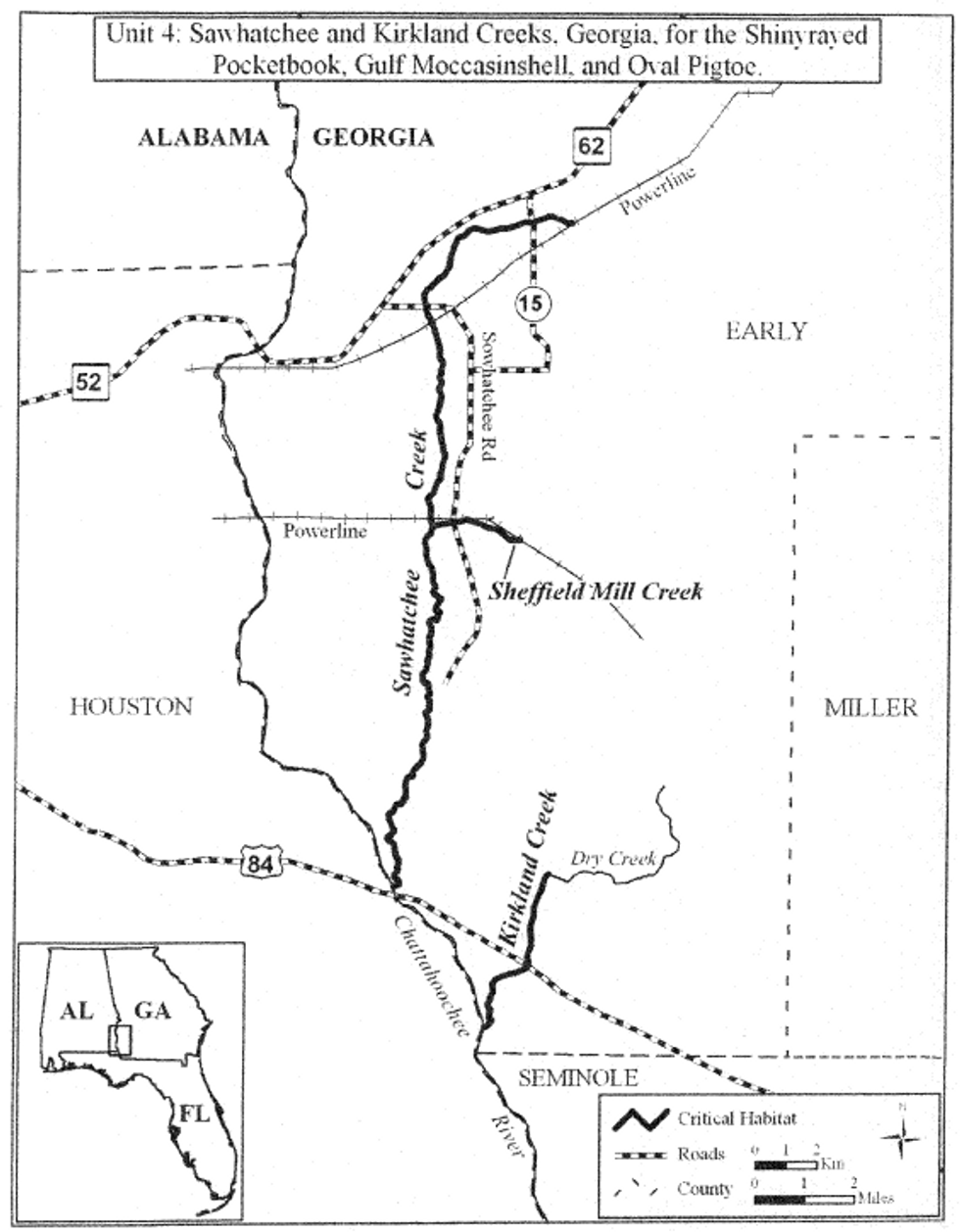
(11) Unit 5. Upper Flint River and Swift, Limestone, Turkey, Pennahatchee, Little Pennahatchee, Hogcrawl, Red Oak, Line, and Whitewater creeks in Coweta, Crawford, Crisp, Dooly, Fayette, Macon, Meriwether, Peach, Pike, Spalding, Sumter, Talbot, Taylor, Upson, and Worth counties, Georgia. This is a critical habitat unit for the shinyrayed pocketbook, Gulf moccasinshell, oval pigtoe, and purple bankclimber.
(i) General Description: Unit 5 encompasses a total stream length of 380.4 km (236.4 mi) and includes the Flint River from the State Highway 27 bridge (Vienna Road) (−83.98 longitude, 32.06 latitude) in Dooly and Sumter counties, Georgia (the river is the county boundary), upstream 247.4 km (153.7 mi) through Macon, Peach, Taylor, Crawford, Talbot, Upson, Pike, Meriwether, and Coweta counties, to Horton Creek (−84.42 longitude, 33.29 latitude) in Fayette and Spalding counties, Georgia (the river is the county boundary); Swift Creek from Lake Blackshear upstream 11.3 km (7 mi) to Rattlesnake Branch (−83.84 longitude, 31.82 latitude), Crisp and Worth counties, Georgia (the creek is the county boundary); Limestone Creek from Lake Blackshear, Crisp County, Georgia, upstream 8.8 km (5.5 mi) to County Road 89 (−83.88 longitude, 32.04 latitude), Dooly County, Georgia; Turkey Creek from the Flint River upstream 21.7 km (13.5 mi) to Rogers Branch (−83.89 longitude, 32.20 latitude), in Dooly County, Georgia; Pennahatchee Creek from Turkey Creek upstream 4.8 km (3 mi) to Little Pennahatchee Creek (−83.89 longitude, 32.10 latitude), Dooly County, Georgia; Little Pennahatchee Creek from Pennahatchee Creek upstream 5.8 km (3.6 mi) to Rock Hill Creek (−83.85 longitude, 32.13 latitude), Dooly County, Georgia; Hogcrawl Creek from the Flint River upstream 21.6 km (13.4 mi) to Little Creek (−83.90 longitude, 32.28 latitude), Dooly and Macon counties, Georgia (the creek is the county boundary); Red Oak Creek from the Flint River upstream 21.7 km (13.5 mi) to Brittens Creek (−84.68 longitude, 33.11 latitude), Meriwether County, Georgia; Line Creek from the Flint River upstream 15.8 km (9.8 mi) to Whitewater Creek (−84.51 longitude, 33.28 latitude), Coweta and Fayette counties, Georgia (the creek is the county boundary); and Whitewater Creek from Line Creek upstream 21.5 km (13.4 mi) to Ginger Cake Creek (−84.49 longitude, 33.42 latitude), Fayette County, Georgia.
(ii) Two maps of unit 5 - northern part of unit 5 and - southern part of unit 5 follow:
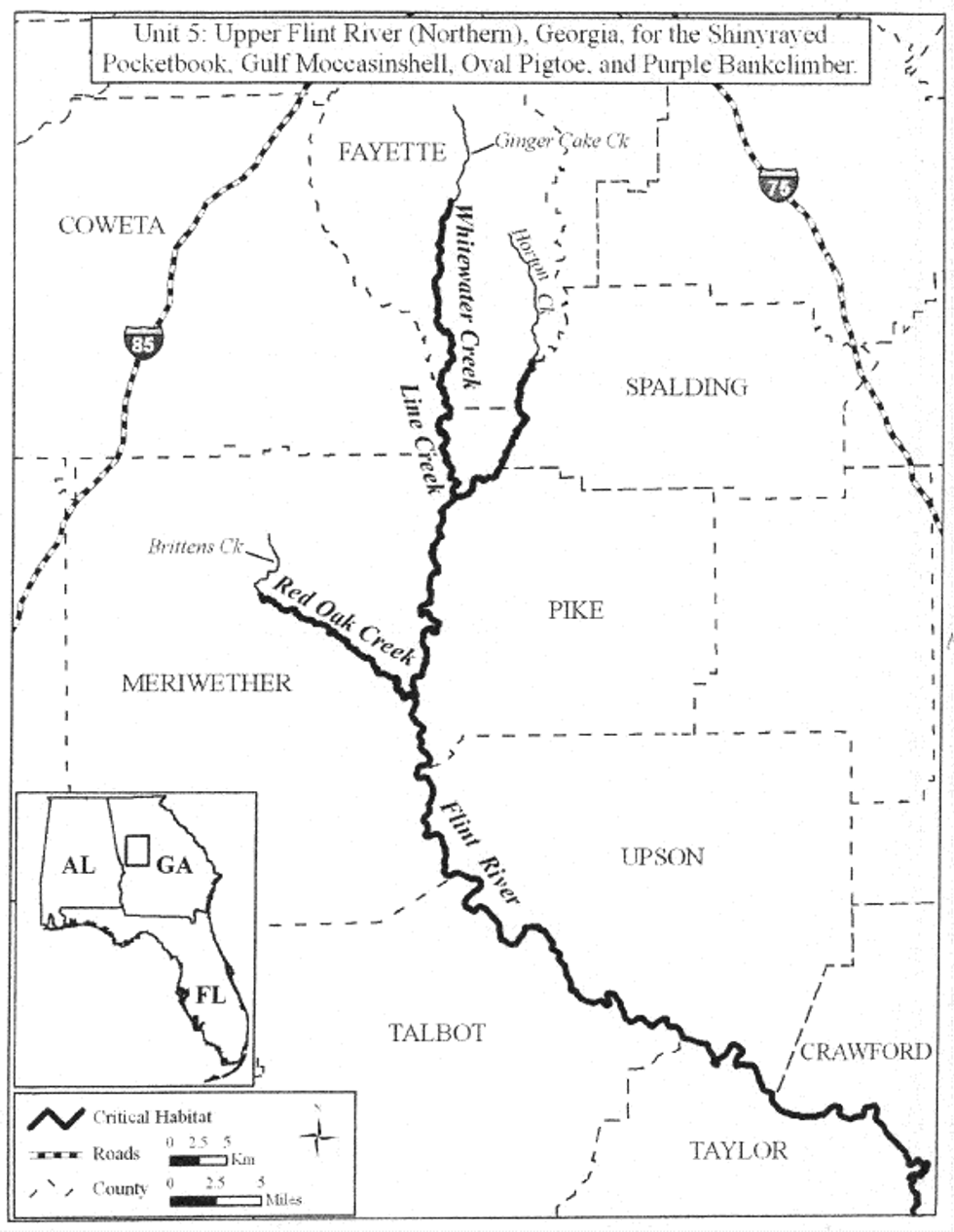
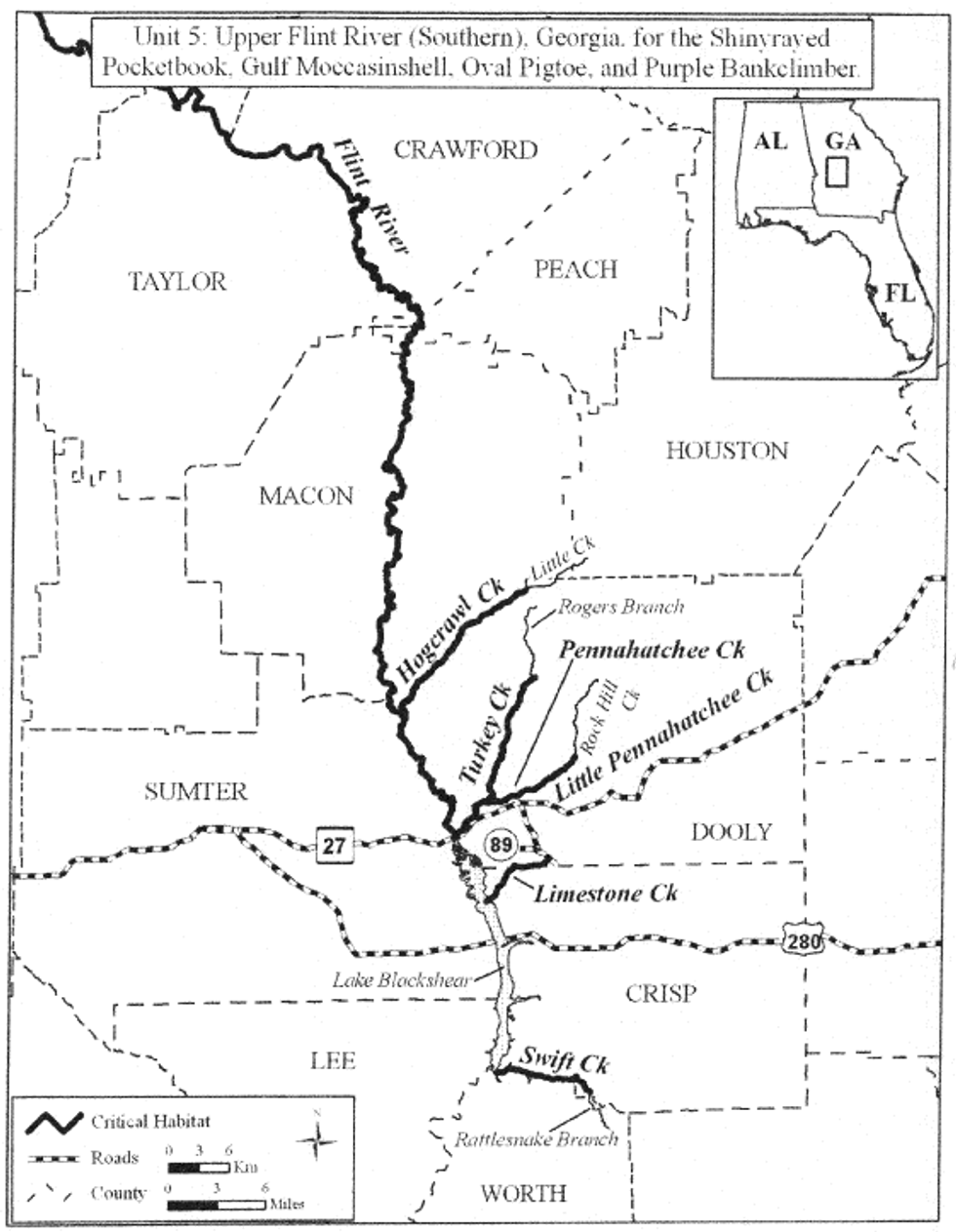
(12) Unit 6. Middle Flint River and Kinchafoonee, Lanahassee, Muckalee, Little Muckalee, Mill, Mercer Mill Pond, Abrams, Jones, and Chokee creeks in Dougherty, Lee, Marion, Schley, Sumter, Terrell, Webster, and Worth counties, Georgia. This is a critical habitat unit for the shinyrayed pocketbook, Gulf moccasinshell, oval pigtoe, and purple bankclimber.
(i) General Description: Unit 6 encompasses a total stream length of 302.3 km (187.8 mi) and includes the Flint River from Piney Woods Creek (−84.06 longitude, 31.61 latitude) in Dougherty County, Georgia (the upstream extent of Lake Worth), upstream 39.9 km (24.8 mi) to the Warwick Dam (−83.94 longitude, 31.85 latitude), Lee and Worth counties, Georgia; Kinchafoonee Creek from its confluence with Lake Worth at the Lee - Dougherty county line (−84.17 longitude, 31.62 latitude), upstream 107.6 km (66.8 mi) through Terrell and Sumter Counties, Georgia, to Dry Creek (−84.58 longitude, 32.17 latitude), Webster County, Georgia; Lanahassee Creek from Kinchafoonee Creek upstream 9.3 km (5.8 mi) to West Fork Lanahassee Creek (−84.50 longitude, 32.11 latitude), Webster County, Georgia; Muckalee Creek, from its confluence with Lake Worth at the Lee - Dougherty county line (−84.14 longitude, 31.62 latitude), upstream 104.5 km (64.9 mi) to County Road 114 (−84.44 longitude, 32.23 latitude), Marion County, Georgia; Little Muckalee Creek, from Muckalee Creek in Sumter County, Georgia, upstream 7.2 km (4.5 mi) to Galey Creek (−84.29 longitude, 32.17 latitude), Schley County, Georgia; Mill Creek from the Flint River upstream 3.2 km (2 mi) to Mercer Millpond Creek (−83.99 longitude, 31.67 latitude), Worth County, Georgia; Mercer Millpond Creek from Mill Creek upstream 0.45 km (0.28 mi) to Mercer Mill Pond (−83.99 longitude, 31.68 latitude), Worth County, Georgia; Abrams Creek from the Flint River upstream 15.9 km (9.9 mi) to County Road 123 (−83.93 longitude, 31.68 latitude), Worth County, Georgia; Jones Creek from the Flint River upstream 3.8 km (2.4 mi) to County Road 123 (−83.96 longitude, 31.76 latitude), Worth County, Georgia; and Chokee Creek, from the Flint River upstream 10.5 km (6.5 mi) to Dry Branch Creek (−84.02 longitude, 31.89 latitude), Lee County, Georgia.
(ii) Two maps of unit 6 - western part of unit 6 and - eastern part of unit 6 follow:
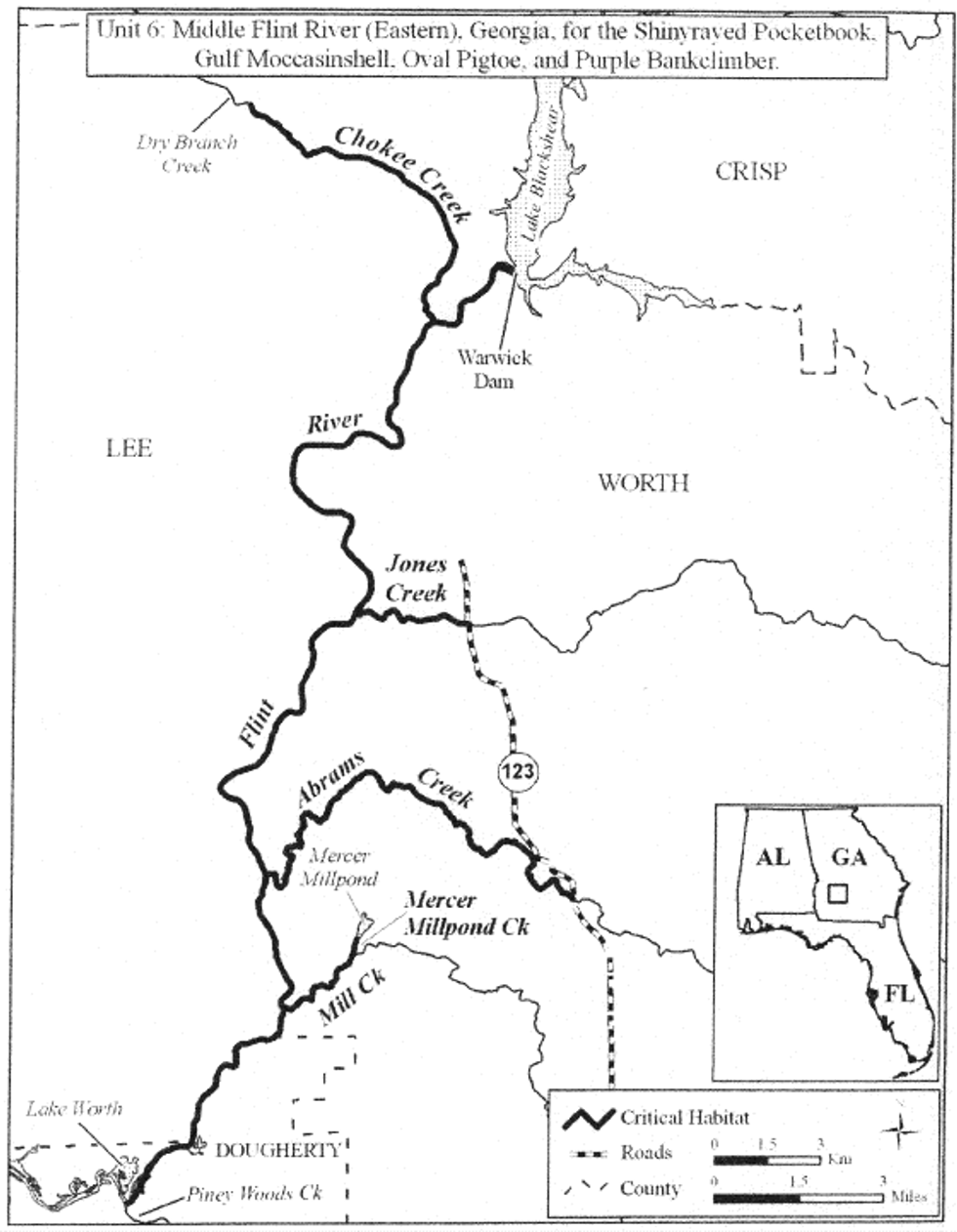
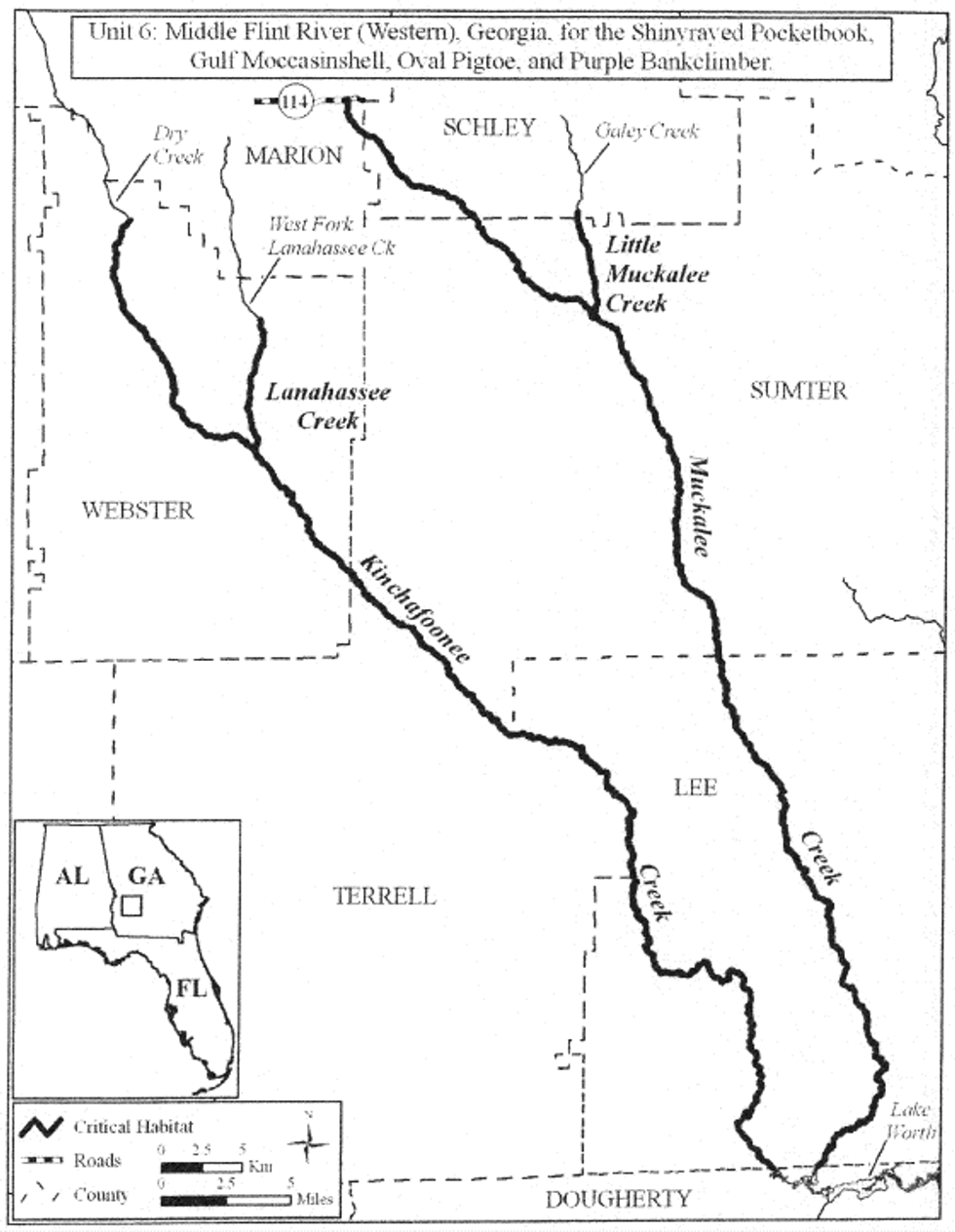
(13) Unit 7. Lower Flint River and Spring, Aycocks, Dry, Ichawaynochaway, Mill, Pachitla, Little Pachitla, Chickasawhatchee, and Cooleewahee creeks in Baker, Calhoun, Decatur, Dougherty, Early, Miller, Mitchell, and Terrell counties, Georgia. This is a critical habitat unit for the fat threeridge, shinyrayed pocketbook, Gulf moccasinshell, oval pigtoe, and purple bankclimber.
(i) General Description: Unit 7 encompasses a total stream length of 396.7 km (246.5 mi) and includes the Flint River from its confluence with Big Slough (−84.56 longitude, 30.93 latitude), Decatur County, Georgia, upstream 116.4 km (72.3 mi) through Baker and Mitchell Counties, Georgia, to the Flint River Dam (which impounds Lake Worth) (−84.14 longitude, 31.60 latitude), Dougherty County, Georgia; Spring Creek, from its confluence with Lake Seminole at Smith Landing (−84.75 longitude, 30.89 latitude), Decatur County, Georgia, upstream 74.2 km (46.1 mi) to County Road 35 (−84.78 longitude, 31.34 latitude), Early County, Georgia; Aycocks Creek from Spring Creek upstream 15.9 km (9.9 mi) to Cypress Creek (−84.79 longitude, 31.15 latitude), Miller County, Georgia; Dry Creek from Spring Creek upstream 9.9 km (6.1 mi) to Wamble Creek (−84.84 longitude, 31.31 latitude), Early County, Georgia; Ichawaynochaway Creek from the Flint River, Baker County, Georgia, upstream 68.6 km (42.6 mi) to Merrett Creek (−84.58 longitude, 31.54 latitude), Calhoun County, Georgia; Mill Creek from Ichawaynochaway Creek upstream 7.4 km (4.6 mi) to County Road 163 (−84.63 longitude, 31.40 latitude), Baker County, Georgia; Pachitla Creek, from Ichawaynochaway Creek upstream 18.9 km (11.8 mi) to Little Pachitla Creek (−84.68 longitude, 31.56 latitude), Calhoun County, Georgia; Little Pachitla Creek from Pachitla Creek upstream 5.8 km (3.6 mi) to Bear Branch (−84.72 longitude, 31.58 latitude), Calhoun County, Georgia; Chickasawhatchee Creek from Ichawaynochaway Creek, Baker County, Georgia, upstream 64.5 km (40.1 mi) to U.S. Highway 82 (−84.38 longitude, 31.74 latitude), Terrell County, Georgia; and Cooleewahee Creek from the Flint River upstream 15.1 km (9.4 mi) to Piney Woods Branch (−84.31 longitude, 31.42 latitude), Baker County, Georgia.
(ii) Two maps of unit 7 - western part of unit 7 and - eastern part of unit 7 follow:
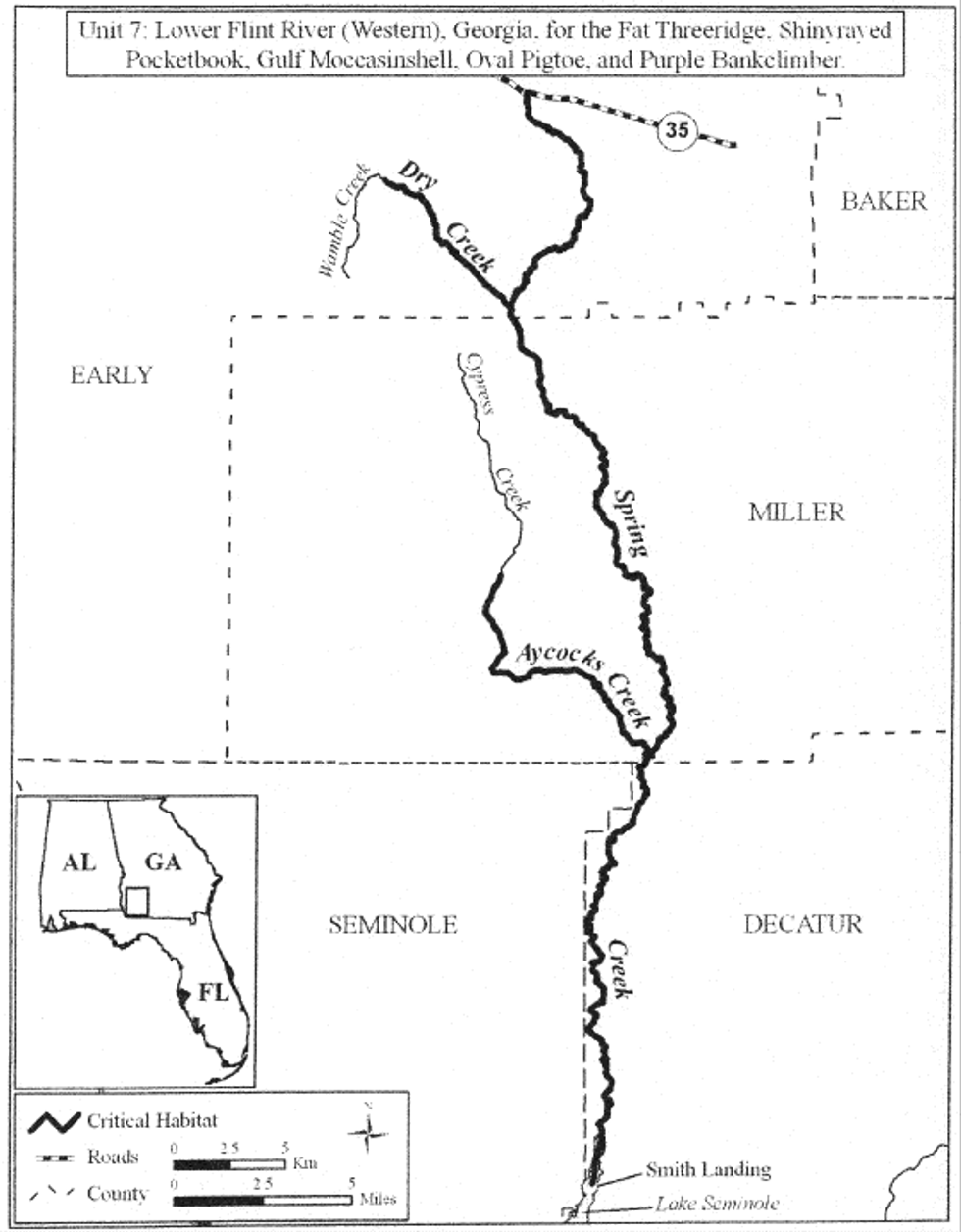
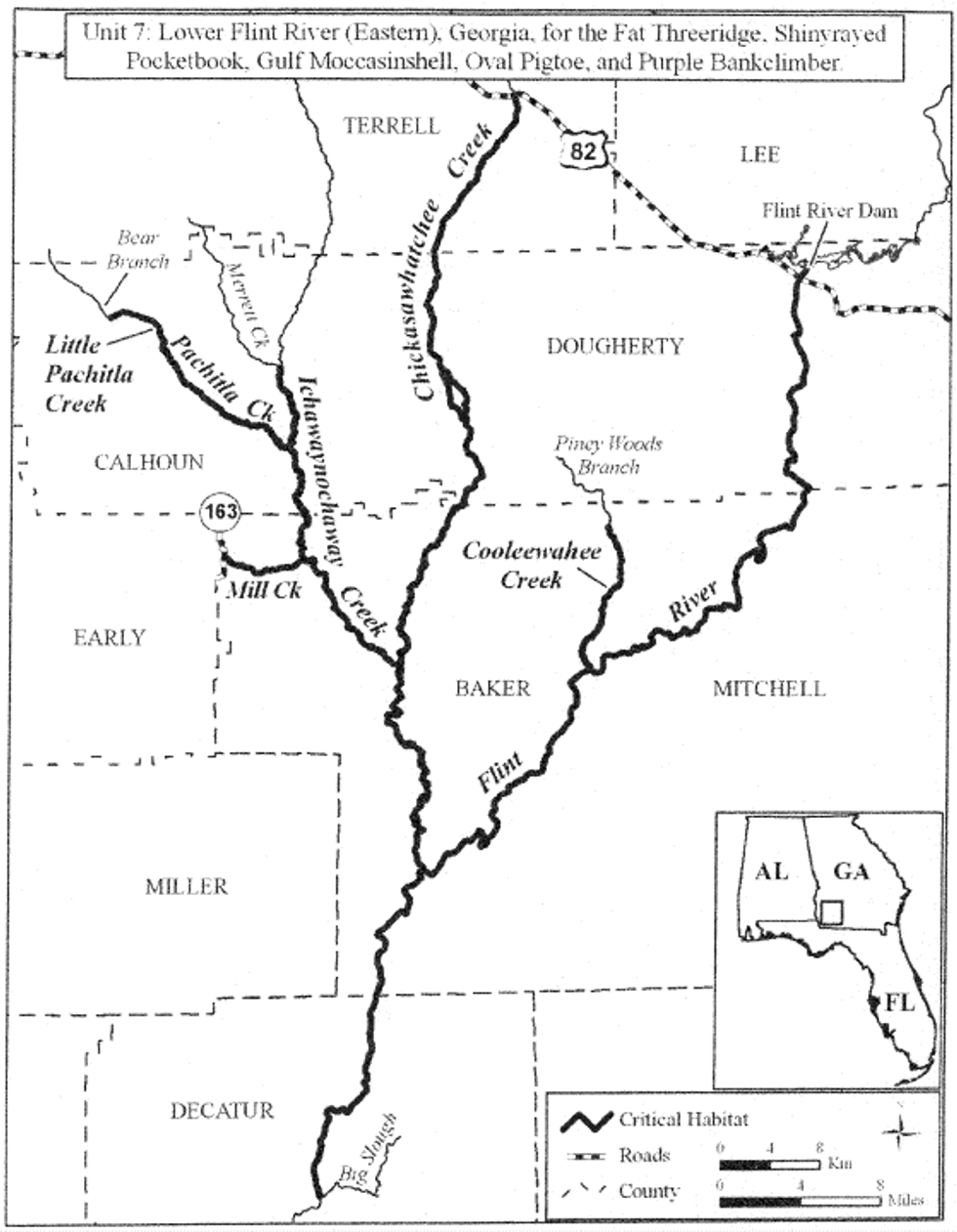
(14) Unit 8. Apalachicola River, Chipola Cutoff, Swift Slough, River Styx, Kennedy Slough, and Kennedy Creek in Calhoun, Franklin, Gadsden, Gulf, Jackson, and Liberty Counties, Florida. This is a critical habitat unit for the fat threeridge and purple bankclimber.
(i) General Description: Unit 8 includes the main stem of the Apalachicola River, two of its distributaries, Chipola Cutoff and Swift Slough, and three of its tributaries, River Styx, Kennedy Slough, and Kennedy Creek, encompassing a total length of 161.2 river km (100.2 river mi). The main stem of the Apalachicola River extends from the downstream end of Bloody Bluff Island (river mile 15.3 on U.S. Army Corps of Engineers Navigation Charts) (−85.01 longitude, 29.88 latitude), Franklin County, Florida, through Calhoun and Liberty Counties, Florida, upstream to the Jim Woodruff Lock and Dam (which impounds Lake Seminole) (−84.86 longitude, 30.71 latitude), Gadsden and Jackson Counties, Florida; Chipola Cutoff from the Apalachicola River in Gulf County, Florida, downstream 4.5 river km (2.8 river mi) to its confluence with the Chipola River; Swift Slough from the Apalachicola River in Liberty County, Florida, downstream 3.6 river km (2.2 river mi) to its confluence with the River Styx (−85.12 longitude, 30.10 latitude); River Styx from the mouth of Swift Slough (−85.12 longitude, 30.10 latitude) in Liberty County, Florida, downstream 3.8 river km (2.4 river mi) to its confluence with the Apalachicola River; Kennedy Slough from −85.07 longitude, 30.01 latitude in Liberty County, Florida, downstream 0.9 river km (0.5 river mi) to its confluence with Kennedy Creek; and Kennedy Creek from Brushy Creek Feeder (−85.06 longitude, 30.01 latitude) in Liberty County, Florida, downstream 1.1 river km (0.7 river mi) to its confluence with the Apalachicola River.
(ii) Unit 8 map follows:
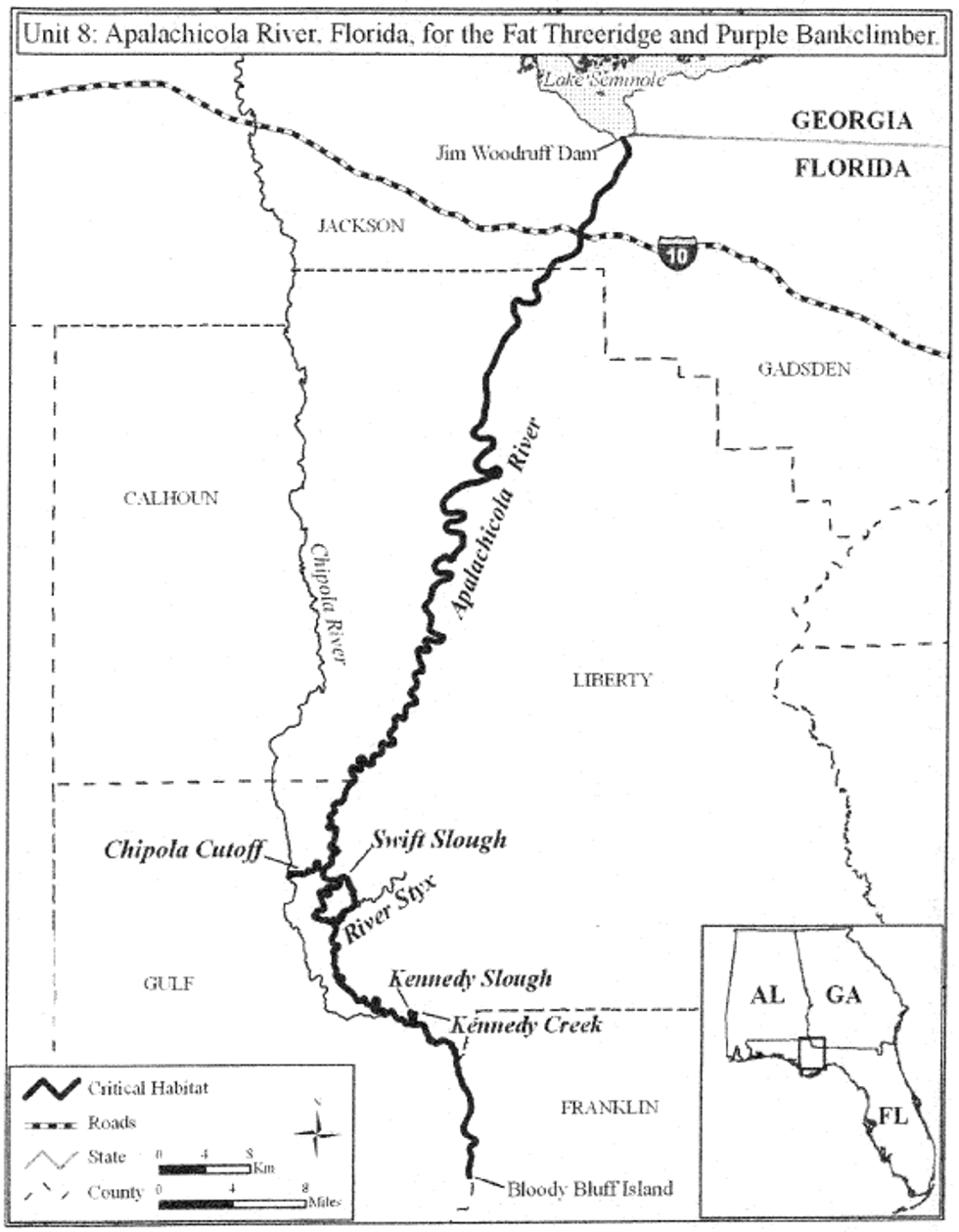
(15) Unit 9. Upper Ochlockonee River and Barnetts and West Barnetts creeks, and the Little Ochlockonee River in Gadsden and Leon counties, Florida, and in Grady and Thomas counties, Georgia. This is a critical habitat unit for the shinyrayed pocketbook, Ochlockonee moccasinshell, oval pigtoe, and purple bankclimber.
(i) General Description: Unit 9 includes the main stem of the Ochlockonee River upstream of Lake Talquin and three tributaries encompassing a total stream length of 177.3 km (110.2 mi). The main stem of the Ochlockonee River extends from its confluence with Gulley Branch (the approximate upstream extent of Lake Talquin) (−84.44 longitude, 30.46 latitude), Gadsden and Leon counties, Florida, upstream 134.0 km (83.3 mi) to Bee Line Road/County Road 306 (−83.94 longitude, 31.03 latitude), Thomas County, Georgia; Barnetts Creek from the Ochlockonee River upstream 20 km (12.4 mi) to Grady County Road 170/Thomas County Road 74 (−84.12 longitude, 30.98 latitude), Grady and Thomas counties, Georgia; West Barnetts Creek from Barnetts Creek upstream 10 km (6.2 mi) to Georgia Highway 111 (−84.17 longitude, 30.98 latitude), Grady County, Georgia; and the Little Ochlockonee River from the Ochlockonee River upstream 13.3 km (8.3 mi) to Roup Road/County Road 33 (−84.02 longitude, 31.02 latitude), Thomas County, Georgia.
(ii) Unit 9 map follows:
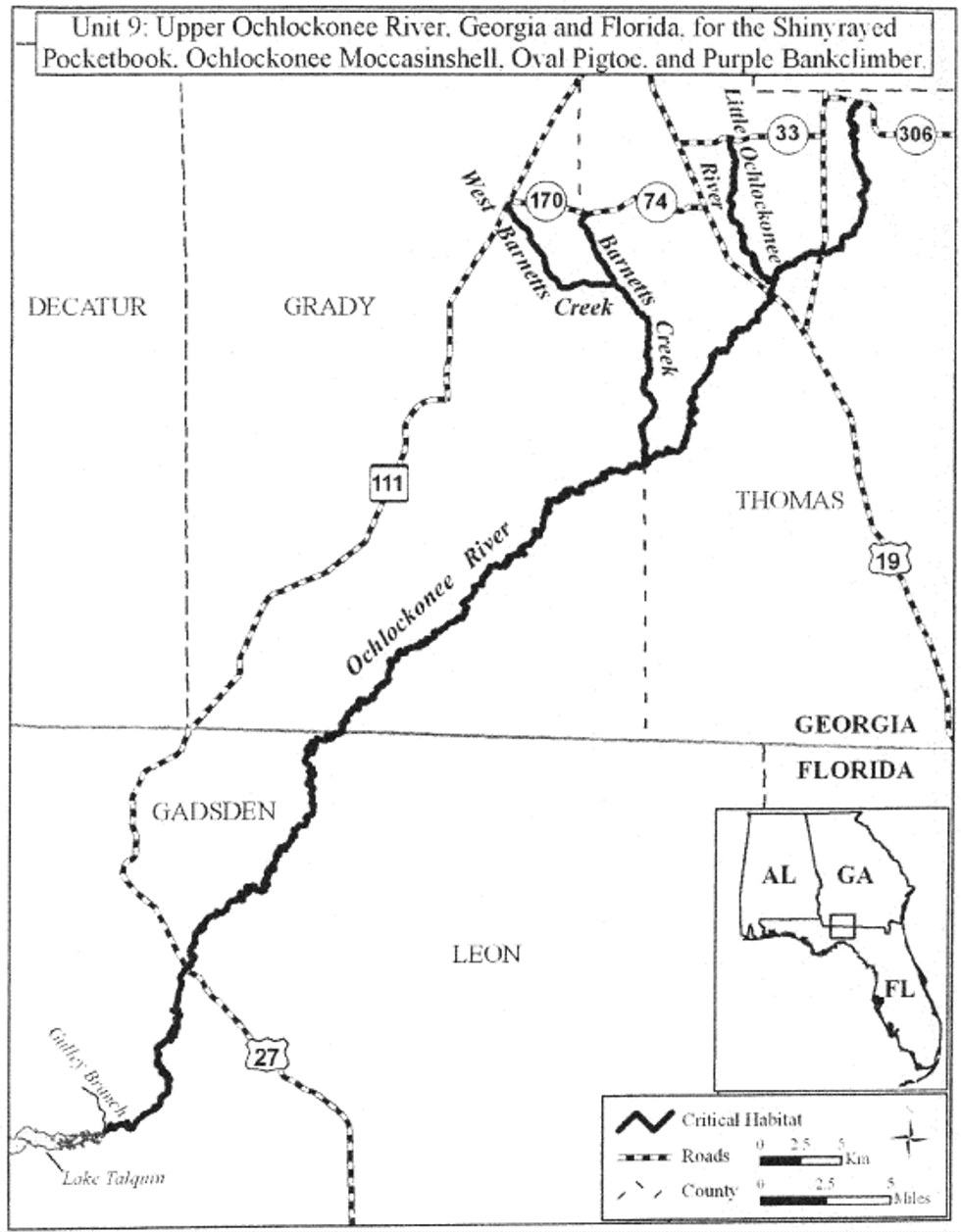
(16) Unit 10. Lower Ochlockonee River in Leon, Liberty, and Wakulla counties, Florida. This is a critical habitat unit for the purple bankclimber.
(i) General Description: Unit 10 encompasses a total stream length of 75.4 km (46.9 mi) and includes the main stem of the Ochlockonee River from its confluence with Syfrett Creek (−84.56 longitude, 30.02 latitude), Wakulla County, Florida, upstream 75.4 km (46.9 mi) to the Jackson Bluff Dam (which impounds Lake Talquin) (−84.65 longitude, 30.39 latitude), Leon and Liberty counties, Florida.
(ii) Unit 10 map follows:
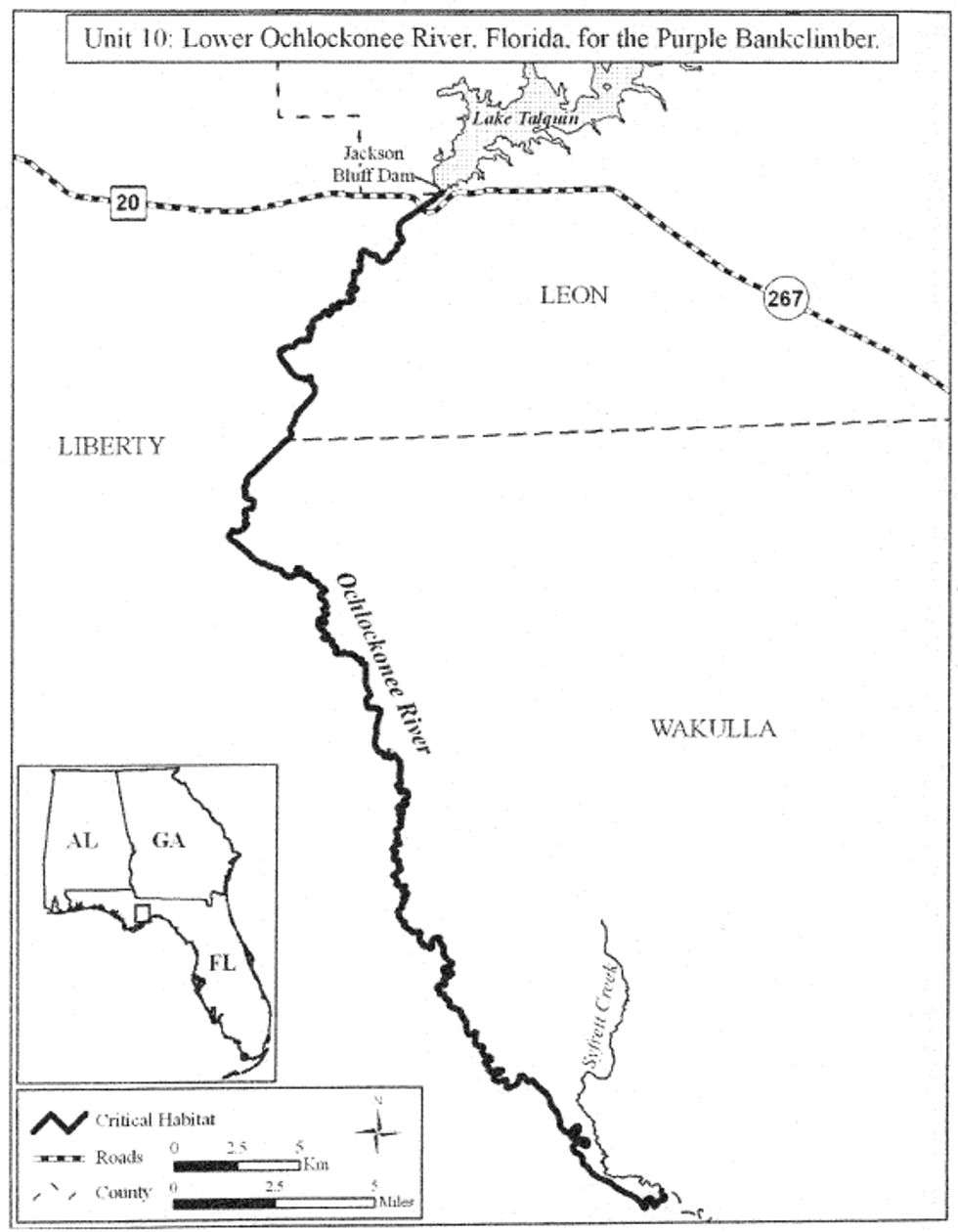
(17) Unit 11. Santa Fe River and New River in Alachua, Bradford, Columbia, and Union counties, Florida. This is a critical habitat unit for the oval pigtoe.
(i) General Description: Unit 11 includes the main stem of the Santa Fe River and its tributary the New River encompassing a total stream length of 83.1 km (51.6 mi). The main channel of the Santa Fe River extends from where the river goes underground in O'Leno State Park (−82.57 longitude, 29.91 latitude), Alachua and Columbia counties, Florida, upstream 60.2 km (37.4 mi) to the powerline crossing located 1.9 km (1.2 mi) downstream from the U.S. Highway 301 bridge (−82.18 longitude, 29.84 latitude) in Alachua and Bradford counties, Florida; and the New River from its confluence with the Santa Fe River at the junction of Alachua, Bradford, and Union counties, Florida, upstream 22.9 km (14.2 mi) to McKinney Branch (−82.27 longitude, 30.01 latitude) in Bradford and Union counties, Florida.
(ii) Unit 11 map follows:
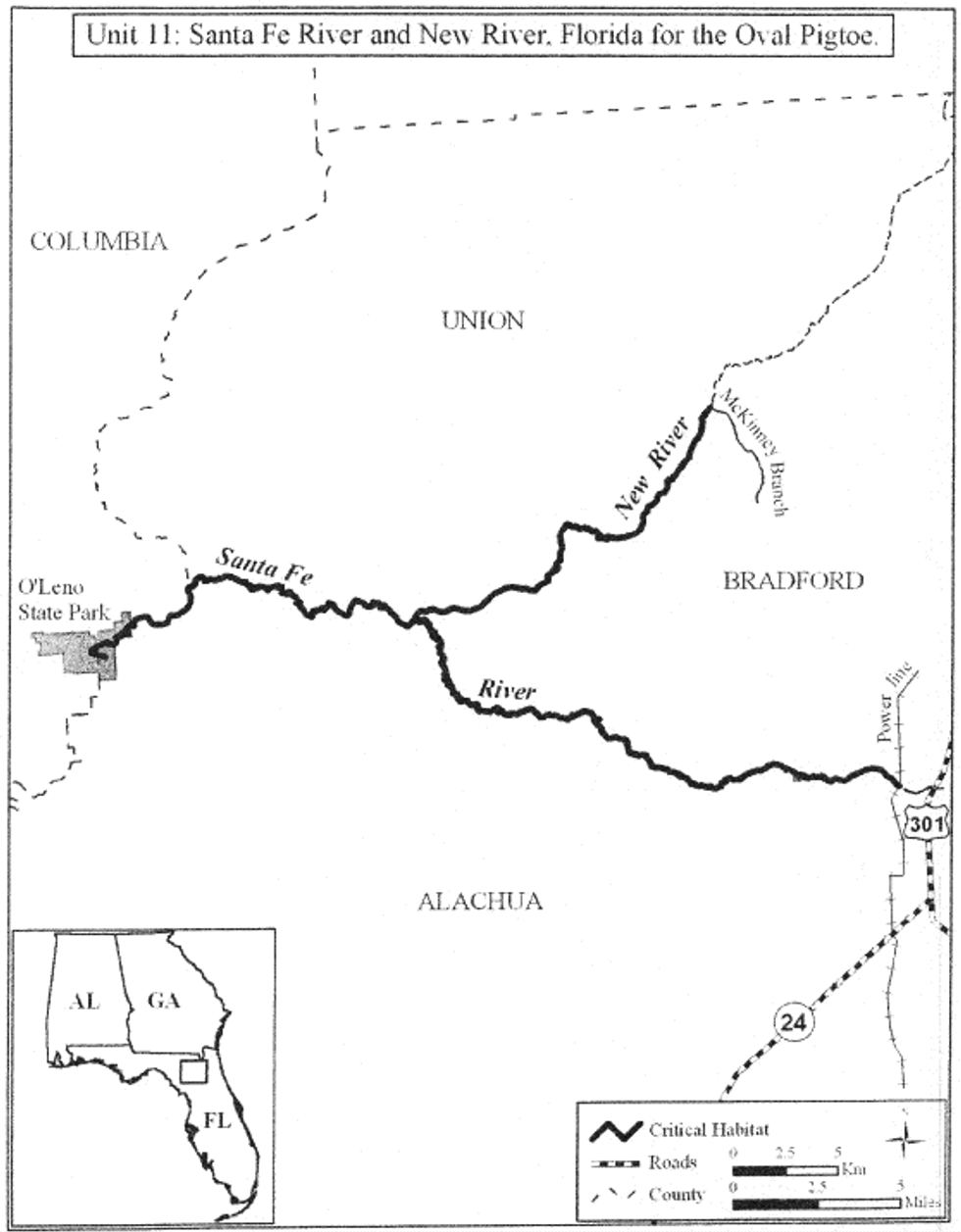
Eight mussel species in four northeast Gulf of Mexico drainages: Choctaw bean (Obovaria choctawensis), round ebonyshell (Reginaia rotulata), southern kidneyshell (Ptychobranchus jonesi), Alabama pearlshell (Margaritifera marrianae), fuzzy pigtoe (Pleurobema strodeanum), narrow pigtoe (Fusconaia escambia), tapered pigtoe (Fusconaia burkei), and southern sandshell (Hamiota australis)
(1) Critical habitat units are depicted for the following counties:
(i) Alabama. Barbour, Bullock, Butler, Coffee, Conecuh, Covington, Crenshaw, Dale, Escambia, Geneva, Henry, Houston, Monroe, and Pike Counties.
(ii) Florida. Bay, Escambia, Holmes, Jackson, Okaloosa, Santa Rosa, Walton, and Washington Counties.
(2) Within these areas, the primary constituent elements of the physical or biological features essential to the conservation of the Alabama pearlshell, round ebonyshell, southern kidneyshell, Choctaw bean, tapered pigtoe, narrow pigtoe, southern sandshell, and fuzzy pigtoe consist of five components:
(i) Geomorphically stable stream and river channels and banks (channels that maintain lateral dimensions, longitudinal profiles, and sinuosity patterns over time without an aggrading or degrading bed elevation).
(ii) Stable substrates of sand or mixtures of sand with clay or gravel with low to moderate amounts of fine sediment and attached filamentous algae.
(iii) A hydrologic flow regime (magnitude, frequency, duration, and seasonality of discharge over time) necessary to maintain benthic habitats where the species are found, and to maintain connectivity of rivers with the floodplain, allowing the exchange of nutrients and sediment for habitat maintenance, food availability, and spawning habitat for native fishes.
(iv) Water quality, including temperature (not greater than 32°C), pH (between 6.0 to 8.5), oxygen content (not less than 5.0 milligrams per liter), hardness, turbidity, and other chemical characteristics necessary for normal behavior, growth, and viability of all life stages.
(v) The presence of fish hosts. Diverse assemblages of native fish species will serve as a potential indication of host fish presence until appropriate host fishes can be identified. For the fuzzy pigtoe and tapered pigtoe, the presence of blacktail shiner (Cyprinella venusta) will serve as a potential indication of fish host presence.
(3) Critical habitat does not include manmade structures (such as buildings, aqueducts, runways, dams, roads, and other paved areas) and the land on which they are located existing within the legal boundaries on November 9, 2012, with the exception of the impoundments created by Point A and Gantt Lake dams (impounded water, not the actual dam structures).
(4) Critical habitat map units. Data layers defining map units were created with USGS National Hydrography Dataset (NHD) GIS data. The 1:100,000 river reach (route) files were used to calculate river kilometers and miles. ESRIs ArcGIS 9.3.1 software was used to determine longitude and latitude coordinates using decimal degrees. The projection used in mapping all units was Universal Transverse Mercator (UTM), NAD 83, Zone 16 North. The following data sources were referenced to identify features (like roads and streams) used to delineate the upstream and downstream extents of critical habitat units: NHD data, Washington County USFWS National Wetlands Inventory, 1999 Florida Department of Transportation Roads Characteristics Inventory (RCI) dataset, U.S. Census Bureau 2000 TIGER line waterbody data, ESRIs World Street Map Service, Florida Department of Transportation General Highway Maps, DeLorme Atlas and Gazetteers, and USGS 7.5 minute topographic maps. The maps in this entry, as modified by any accompanying regulatory text, establish the boundaries of the critical habitat designation. The coordinates or plot points or both on which each map is based are available to the public at the Service's internet site, http://www.fws.gov/PanamaCity, http://www.regulations.gov at Docket No. FWS-R4-ES-2011-0050, and at the field office responsible for this designation. You may obtain field office location information by contacting one of the Service regional offices, the addresses of which are listed at 50 CFR 2.2.
(5) Index maps follow (Map 1 for the Alabama pearlshell, and Map 2 for the round ebonyshell, southern kidneyshell, Choctaw bean, tapered pigtoe, narrow pigtoe, southern sandshell, and fuzzy pigtoe):
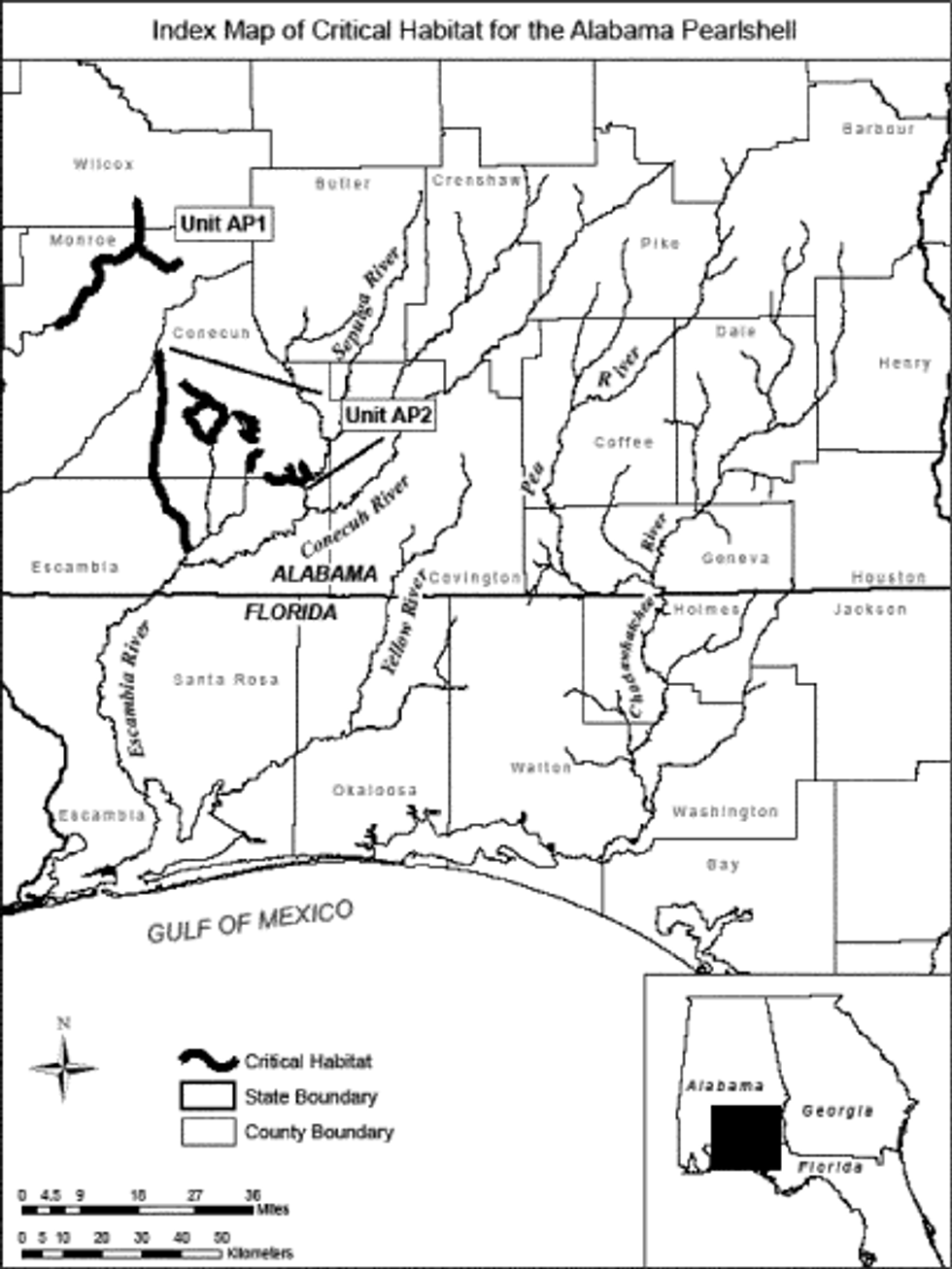
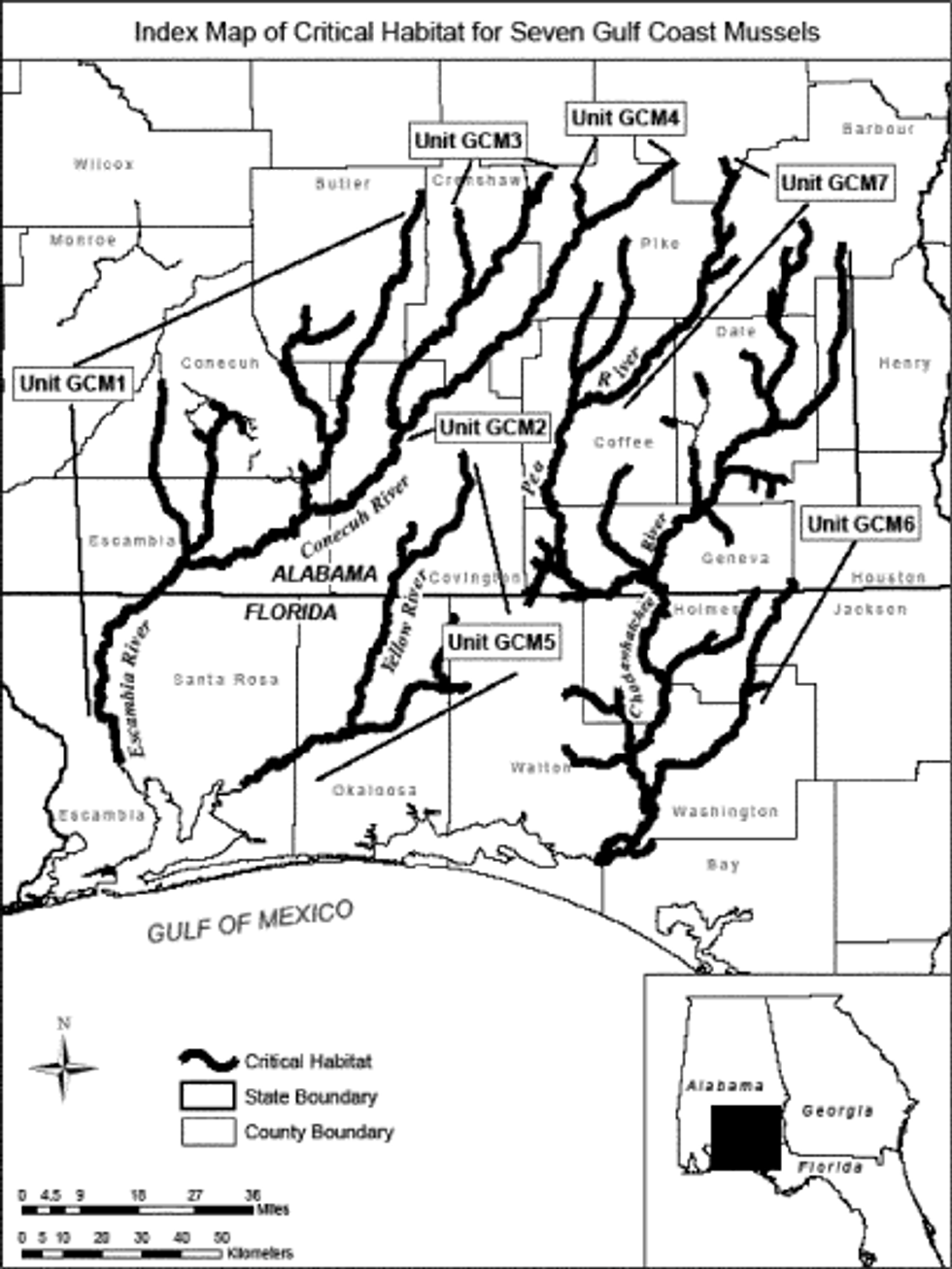
(6) Unit AP1: Big Flat Creek Drainage, Monroe and Wilcox Counties, AL. This unit is critical habitat for the Alabama pearlshell.
(i) The unit includes the mainstem of Big Flat Creek from State Route 41 upstream 56 kilometers (km) (35 miles (mi)), Monroe County, AL; Flat Creek from its confluence with Big Flat Creek upstream 20 km (12 mi), Monroe County, AL; and Dailey Creek from its confluence Flat Creek upstream 17 km (11 mi), Monroe and Wilcox Counties, AL.
(ii) Map of Unit AP1, Big Flat Creek Drainage, and Unit AP2, Burnt Corn Creek, Murder Creek, and Sepulga River drainages, follows:
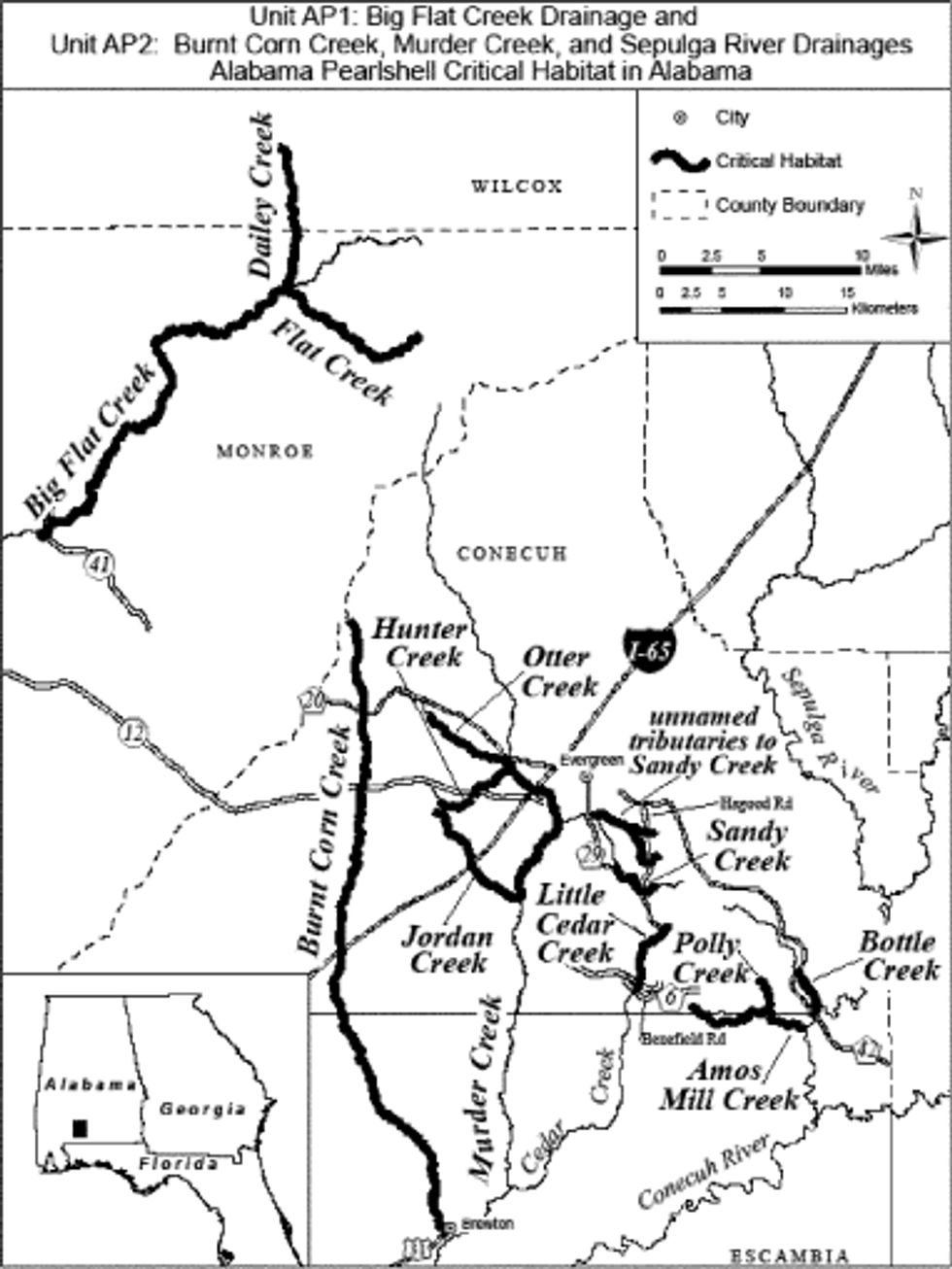
(7) Unit AP2: Burnt Corn Creek, Murder Creek, and Sepulga River. Drainages, Escambia and Conecuh Counties, AL. This unit is critical habitat for the Alabama pearlshell.
(i) The unit includes the mainstem of Burnt Corn Creek from its confluence with Murder Creek upstream 66 km (41 mi), Conecuh County, AL; the mainstem of Murder Creek from its confluence with Jordan Creek upstream 17 km (11 mi) to the confluence of Otter Creek, Conecuh County, AL; Jordan Creek from its confluence with Murder Creek upstream 12 km (7 mi), Conecuh County, AL; Otter Creek from its confluence with Murder Creek, upstream 9 km (5.5 mi), Conecuh County, AL; Hunter Creek from its confluence with Murder Creek upstream 4.4 km (2.7 mi) to the Navy Outlying Field (NOLF) Evergreen northern boundary, Conecuh County, AL; Hunter Creek from the NOLF Evergreen southern boundary upstream 3.0 km (1.9 mi), Conecuh County, AL; Sandy Creek from County Road 29 upstream 5 km (3.5 mi), Conecuh County, AL; two unnamed tributaries to Sandy Creek - one from its confluence with Sandy Creek upstream 8.5 km (5.0 mi) to just above Hagood Road, and the other from it confluence with the previous unnamed tributary upstream 2.5 km (1.5 mi) to just above Hagood Road; Little Cedar Creek from County Road 6 upstream 8 km (5 mi), Conecuh County, AL; Amos Mill Creek from its confluence with the Sepulga River upstream 12 km (8 mi), Escambia and Conecuh Counties, AL; Polly Creek from its confluence with Amos Mill Creek upstream 3 km (2 mi), Conecuh County, AL; and Bottle Creek from its confluence with the Sepulga River upstream 5.5 km (3.5 mi) to County Road 42, Conecuh County, AL.
(ii) Map of Unit AP1, Big Flat Creek Drainage, and Unit AP2, Burnt Corn Creek, Murder Creek, and Sepulga River Drainages is provided at paragraph (6)(ii) of this entry.
(8) Unit GCM1: Lower Escambia River Drainage in Escambia and Santa Rosa counties, FL, and Escambia, Covington, Conecuh, and Butler Counties, AL. This unit is critical habitat for the round ebonyshell, southern kidneyshell, Choctaw bean, narrow pigtoe, southern sandshell, and fuzzy pigtoe.
(i) The unit includes the Escambia-Conecuh River mainstem from the confluence of Spanish Mill Creek Escambia and Santa Rosa Counties, FL, upstream 204 km (127 mi) to the Point A Lake dam, Covington County, AL; Murder Creek from its confluence with the Conecuh River, Escambia County, AL, upstream 62 km (38 mi) to the confluence of Cane Creek, Conecuh County, AL; Burnt Corn Creek from its confluence with Murder Creek, Escambia County, AL, upstream 59 km (37 mi) to County Road 20, Conecuh County, AL; Jordan Creek from its confluence with Murder Creek, upstream 5.5 km (3.5 mi) to Interstate 65, Conecuh County, AL; Mill Creek from its confluence with Murder Creek upstream 2.5 km (1.5 mi) to the confluence of Sandy Creek, Conecuh County, AL; Sandy Creek from its confluence with Mill Creek upstream 5.5 km (3.5 mi) to County Road 29, Conecuh County, AL; Sepulga River from its confluence with the Conecuh River upstream 69 km (43 mi) to the confluence of Persimmon Creek, Conecuh County, AL; Bottle Creek from its confluence with the Sepulga River upstream 5.5 km (3.5 mi) to County Road 42, Conecuh County, AL; Persimmon Creek from its confluence with the Sepulga River, Conecuh County, upstream 36 km (22 mi) to the confluence of Mashy Creek, Butler County, AL; Panther Creek from its confluence with Persimmon Creek upstream 11 km (7 mi) to State Route 106, Butler County, AL; Pigeon Creek from its confluence with the Sepulga River, Conecuh and Covington Counties, upstream 89 km (55 mi) to the confluence of Three Run Creek, Butler County, AL; and Three Run Creek from its confluence with Pigeon Creek upstream 9 km (5.5 mi) to the confluence of Spring Creek, Butler County, AL.
(ii) Map of Unit GCM1, Lower Escambia River, follows (to preserve detail, the map is divided into south and north sections):
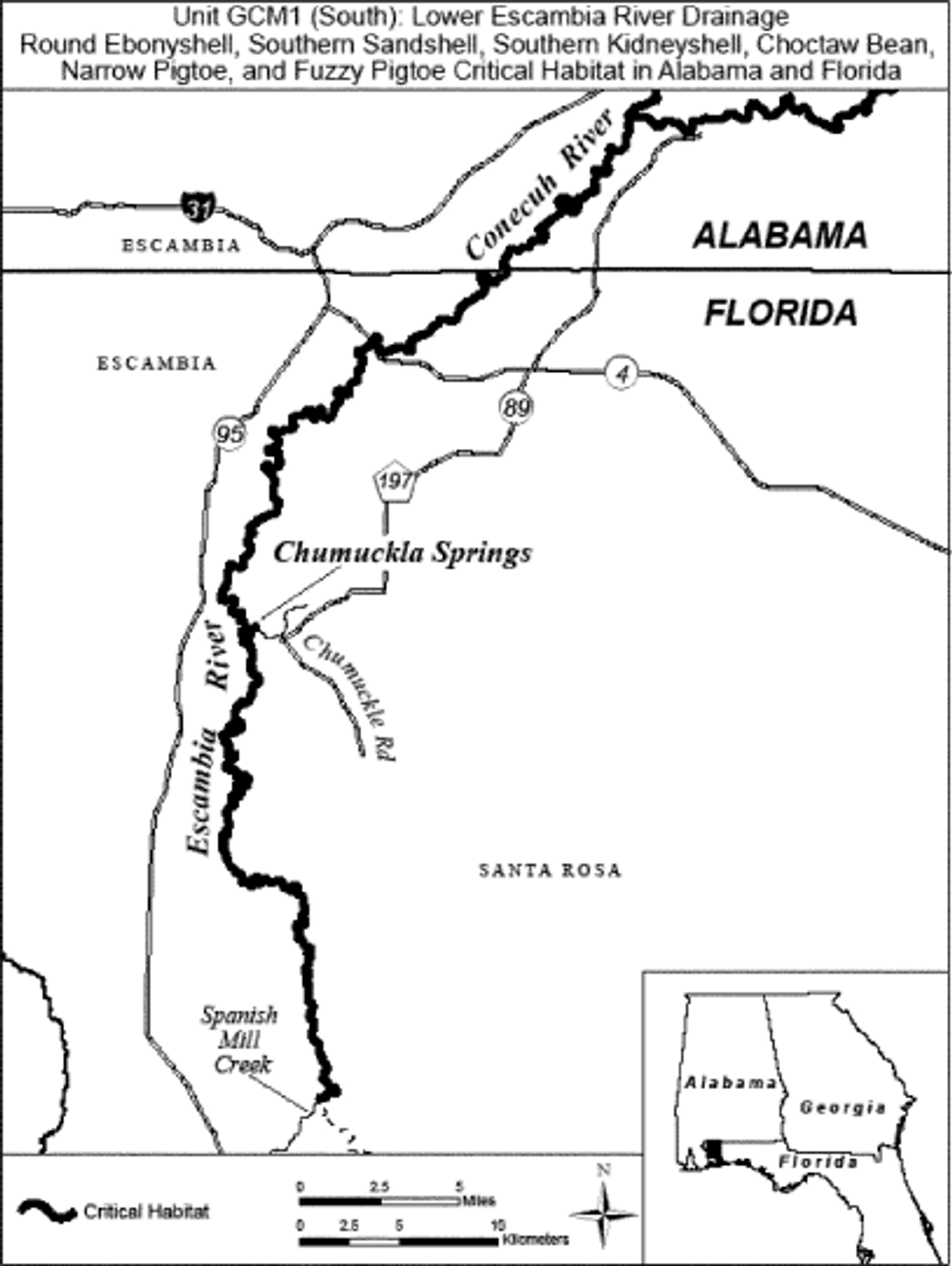
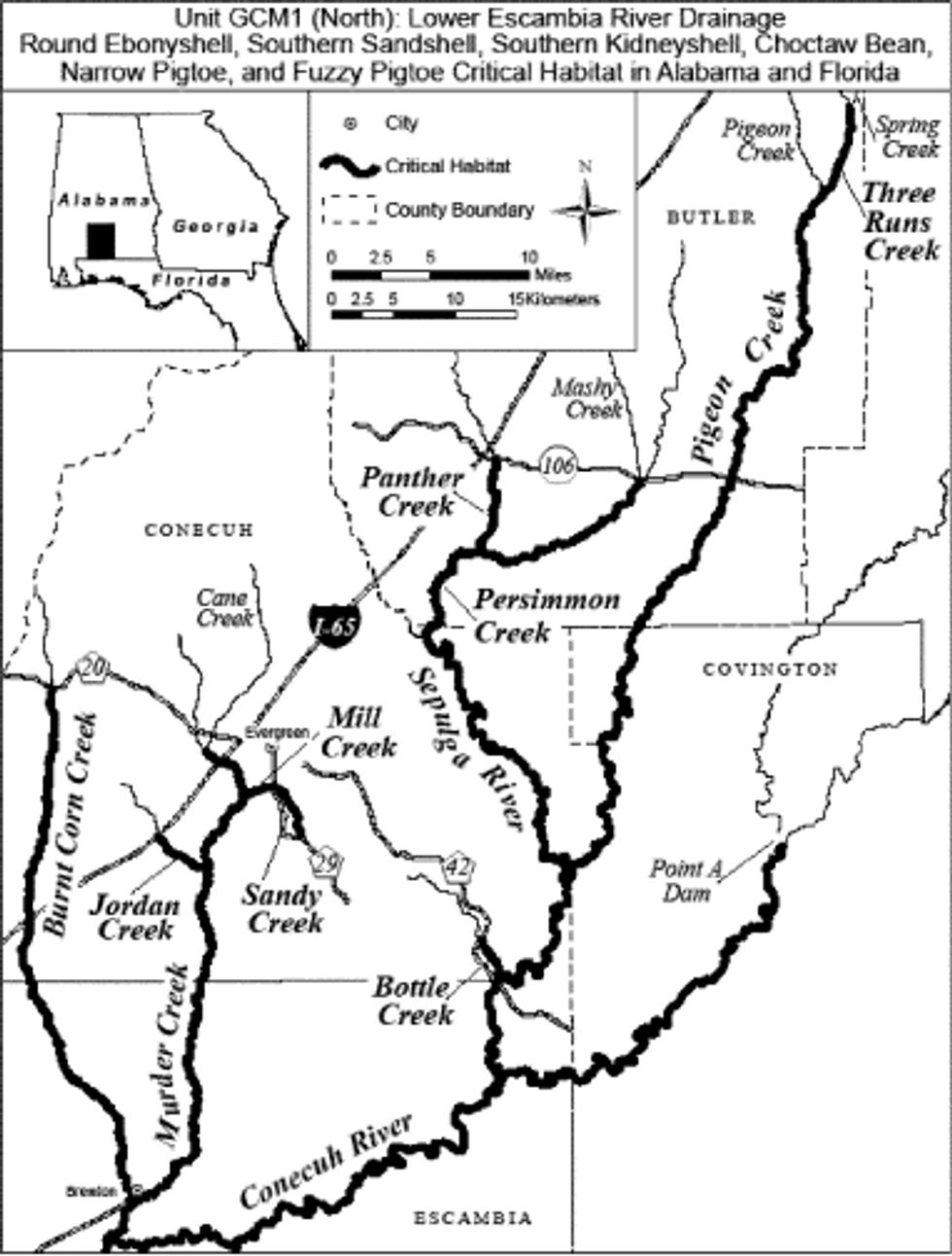
(9) Unit GCM2: Point A Lake and Gantt Lake Reservoirs in Covington County, AL. This unit is critical habitat for the narrow pigtoe.
(i) The unit extends from Point A Dam, Covington County, upstream 21 km (13 mi) to the Covington-Crenshaw County line, AL.
(ii) Map of Unit GCM2, Point A Lake and Gantt Lake Reservoirs, follows:
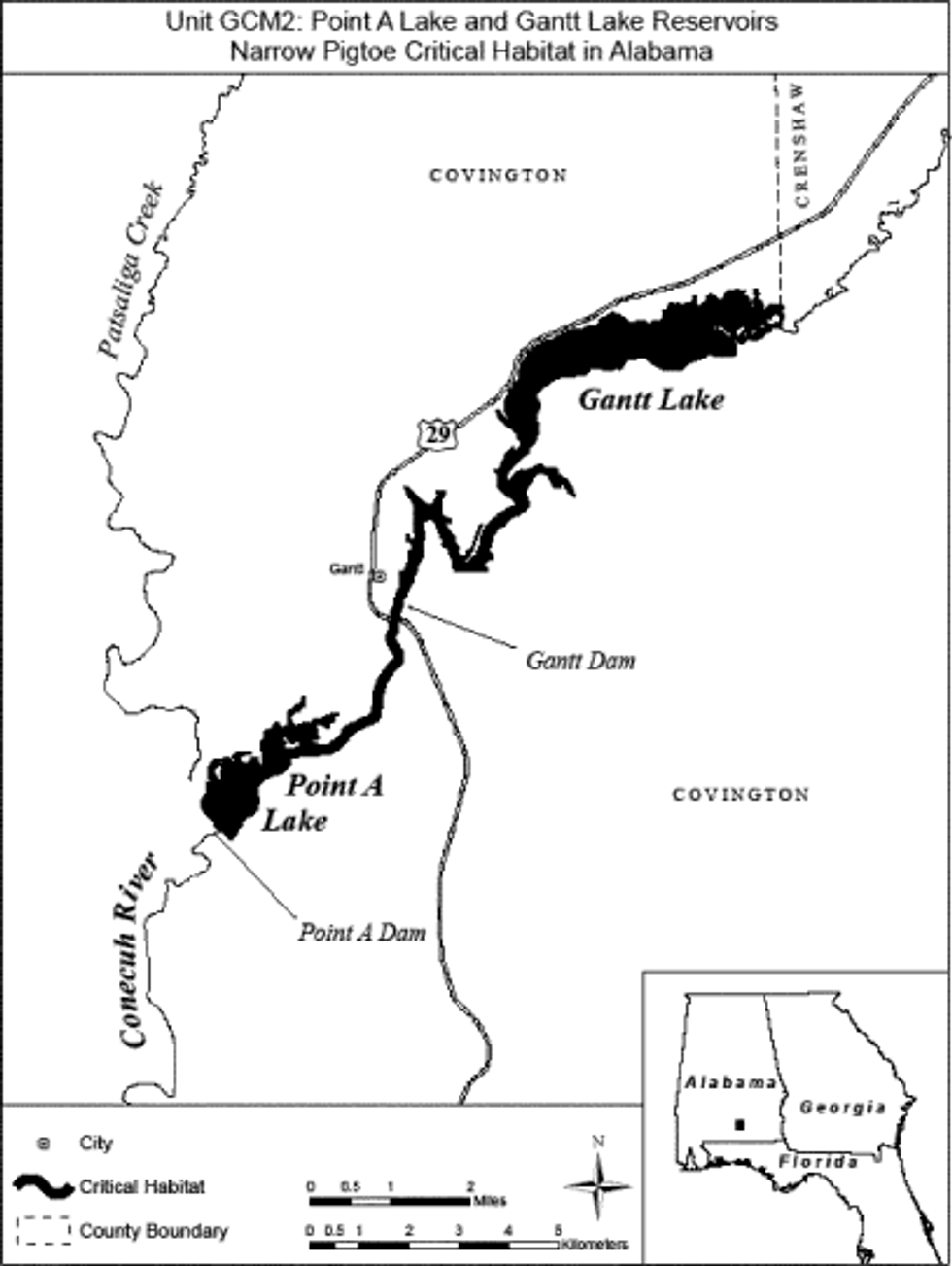
(10) Unit GCM3: Patsaliga Creek Drainage in Covington, Crenshaw, and Pike Counties, AL. The Patsaliga Creek drainage is within the Escambia River basin. This unit is critical habitat for the southern kidneyshell, Choctaw bean, narrow pigtoe, southern sandshell, and fuzzy pigtoe.
(i) The unit includes Patsaliga Creek from its confluence with Point A Lake at County Road 59, Covington County, AL, upstream 108 km (67 mi) to Crenshaw County Road 66-Pike County Road 1, AL; Little Patsaliga Creek from its confluence with Patsaliga Creek upstream 28 km (17 mi) to Mary Daniel Road, Crenshaw County, AL; and Olustee Creek from its confluence with Patsaliga Creek upstream 12 km (8 mi) to County Road 5, Pike County, AL.
(ii) Map of Unit GCM3, Patsaliga Creek Drainage follows:
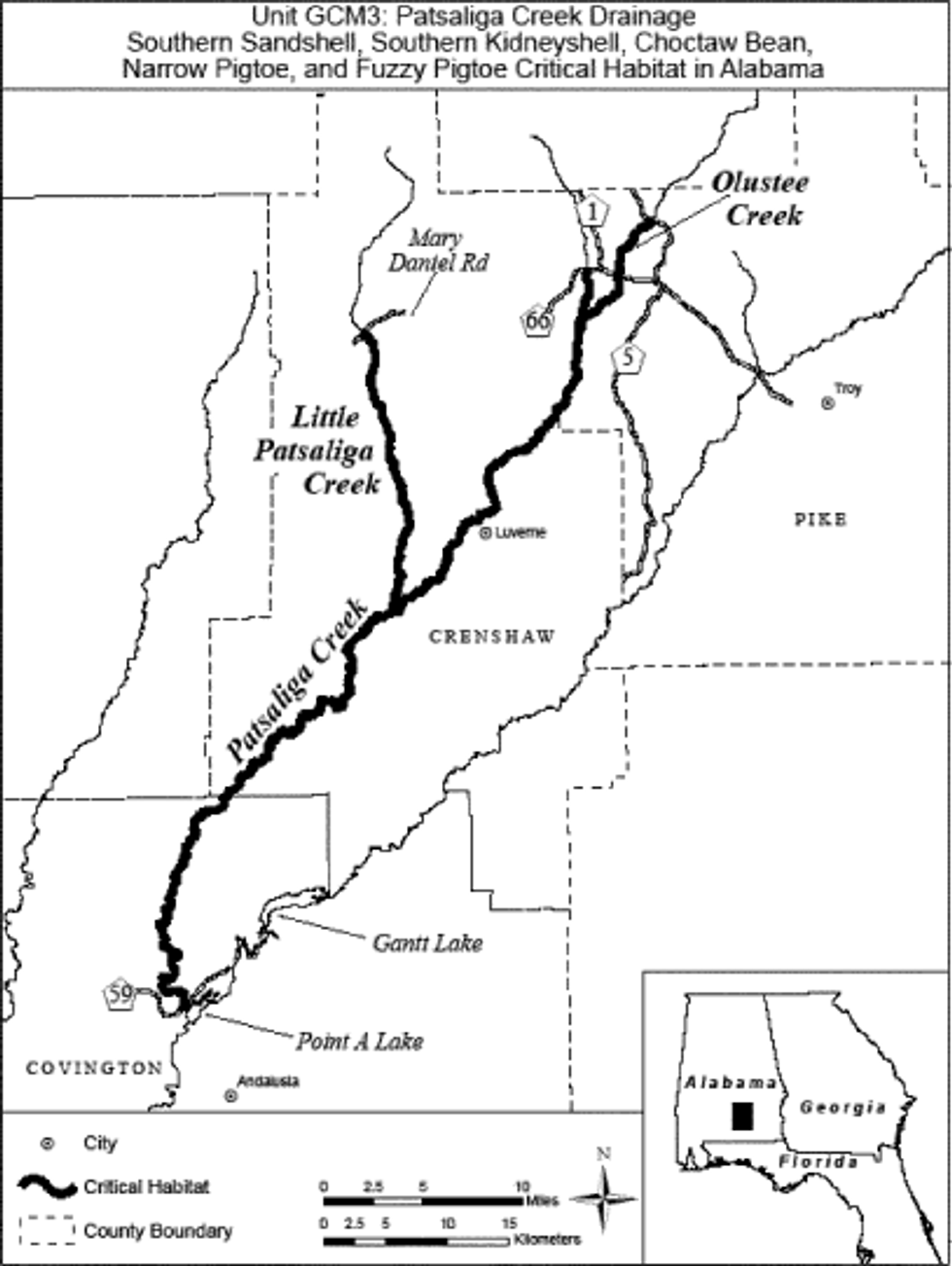
(11) Unit GCM4: Upper Escambia River Drainage in Covington, Crenshaw, Pike, and Bullock Counties, AL. This unit is critical habitat for the southern kidneyshell, Choctaw bean, narrow pigtoe, southern sandshell, and fuzzy pigtoe.
(i) The unit includes the Conecuh River from its confluence with Gantt Lake reservoir at the Covington-Crenshaw County line upstream 126 km (78 mi) to County Road 8, Bullock County, AL; Beeman Creek from its confluence with the Conecuh River upstream 6.5 km (4 mi) to the confluence of Mill Creek, Pike County, AL; and Mill Creek from its confluence with Beeman Creek, upstream 4.5 km (3 mi) to County Road 13, Pike County, AL.
(ii) Map of Unit GCM 4, Upper Escambia River Drainage, follows:
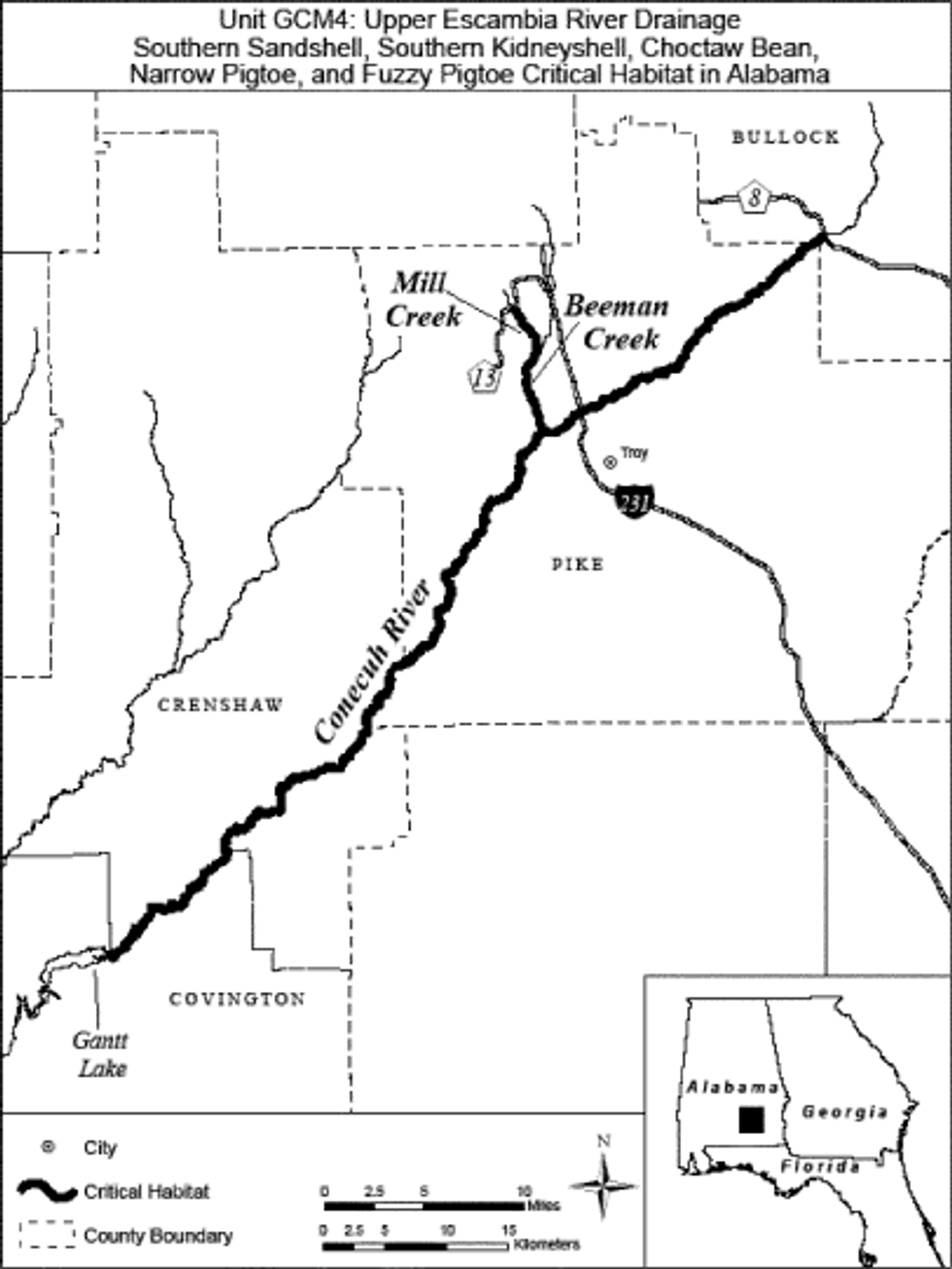
(12) Unit GCM5: Yellow River Drainage in Santa Rosa, Okaloosa, and Walton Counties, FL, and Covington County, AL. This unit is critical habitat for the Choctaw bean, narrow pigtoe, southern sandshell, and fuzzy pigtoe.
(i) The unit includes the Yellow River mainstem from the confluence of Weaver River (a distributary located 0.9 km (0.6 mi), downstream of State Route 87), Santa Rosa County, FL, upstream 157 km (97 mi) to County Road 42, Covington County, AL; the Shoal River mainstem from its confluence with the Yellow River upstream 51 km (32 mi) to the confluence of Mossy Head Branch, Walton County, FL; Pond Creek from its confluence with the Shoal River upstream 24 km (15 mi) to the confluence of Fleming Creek, Walton County, FL; and Five Runs Creek from its confluence with the Yellow River upstream 15 km (9.5 mi) to County Road 31, Covington County, AL.
(ii) Map of Unit GCM5, Yellow River Drainage, follows:
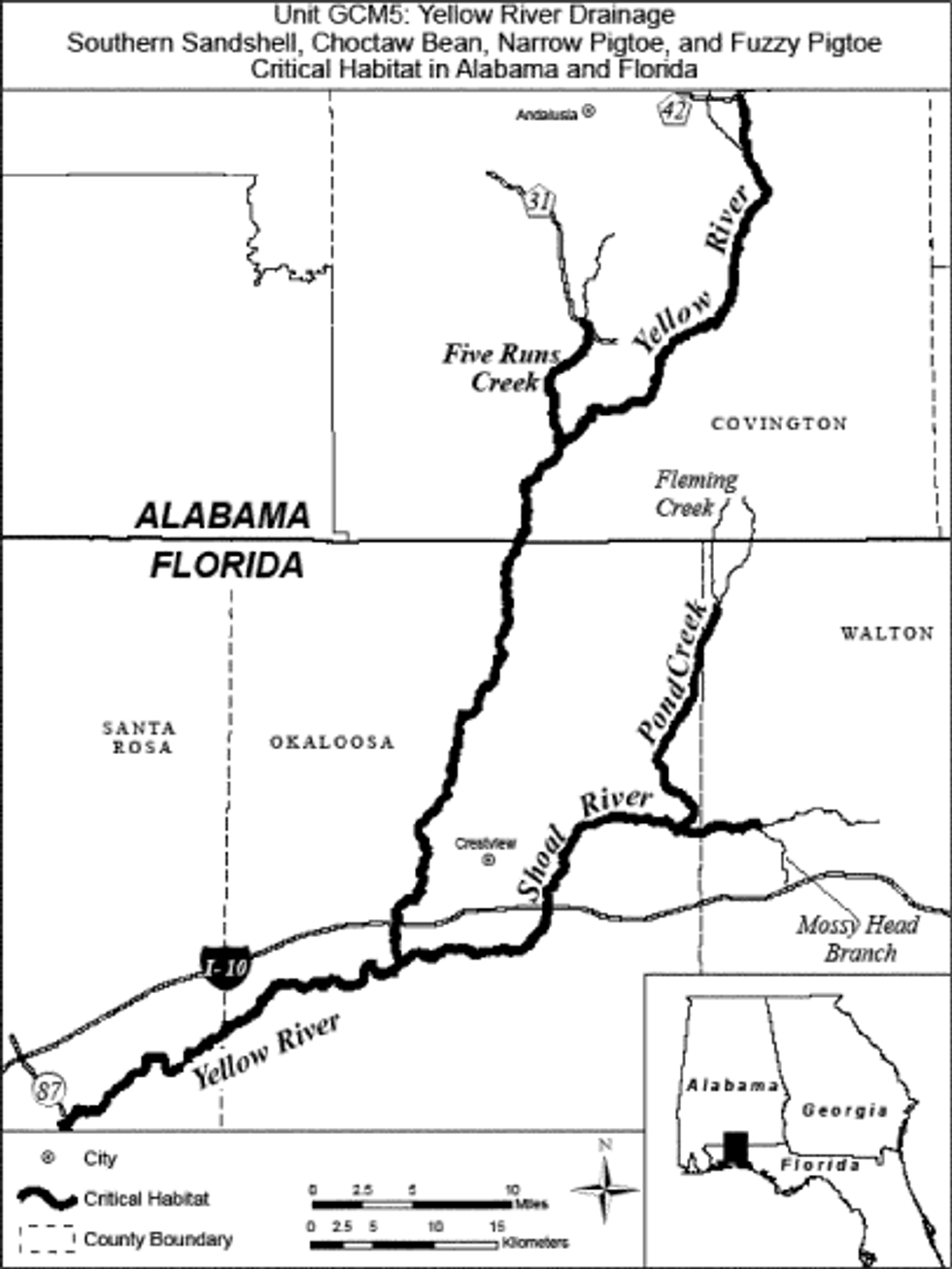
(13) Unit GCM6: Choctawhatchee River and Lower Pea River Drainages in Walton, Washington, Bay, Holmes, and Jackson Counties, FL, and Geneva, Coffee, Dale, Houston, Henry, Pike, and Barbour Counties, AL. This unit is critical habitat for the southern kidneyshell, Choctaw bean, tapered pigtoe, southern sandshell, and fuzzy pigtoe.
(i) The unit includes the Choctawhatchee River mainstem from the confluence of Pine Log Creek, Walton County, FL, upstream 200 km (125 mi) to the point the river splits into the West Fork Choctawhatchee and East Fork Choctawhatchee rivers, Barbour County, AL; Pine Log Creek from its confluence with the Choctawhatchee River, Walton County, upstream 19 km (12 mi) to Ditch Branch, Washington and Bay Counties, FL; an unnamed channel forming Cowford Island from its downstream confluence with the Choctawhatchee River upstream 3 km (2 mi) to its upstream confluence with the river, Washington County, FL; Crews Lake from its western terminus 1.5 km (1 mi) to its eastern terminus, Washington County, FL (Crews Lake is a relic channel southwest of Cowford Island, and is disconnected from the Cowford Island channel, except during high flows); Holmes Creek from its confluence with the Choctawhatchee River, Washington County, FL, upstream 98 km (61 mi) to County Road 4, Geneva County, AL; Alligator Creek from its confluence with Holmes Creek upstream 6.5 km (4 mi) to County Road 166, Washington County, FL; Bruce Creek from its confluence with the Choctawhatchee River upstream 25 km (16 mi) to the confluence of an unnamed tributary, Walton County, FL; Sandy Creek from its confluence with the Choctawhatchee River, upstream 30 km (18 mi) to the confluence of West Sandy Creek, Holmes and Walton Counties, FL; Blue Creek from its confluence with Sandy Creek, upstream 7 km (4.5 mi) to the confluence of Goose Branch, Holmes County, FL; West Sandy Creek from its confluence with Sandy Creek, upstream 5.5 km (3.5 mi) to the confluence of an unnamed tributary, Walton County, FL; Wrights Creek from its confluence with the Choctawhatchee River, Holmes County, FL, upstream 43 km (27 mi) to County Road 4, Geneva County, AL; Tenmile Creek from its confluence with Wrights Creek upstream 6 km (3.5 mi) to the confluence of Rice Machine Branch, Holmes County, FL; West Pittman Creek from its confluence with the Choctawhatchee River, upstream 6.5 km (4 mi) to Fowler Branch, Holmes County, FL; East Pittman Creek from its confluence with the Choctawhatchee River upstream 4.5 km (3 mi) to County Road 179, Holmes County, FL; Parrot Creek from its confluence with the Choctawhatchee River upstream 6 km (4 mi) to Tommy Lane, Holmes County, FL; the Pea River from its confluence with the Choctawhatchee River, Geneva County, AL, upstream 91 km (57 mi) to the Elba Dam, Coffee County, AL; Limestone Creek from its confluence with the Pea River upstream 8.5 km (5 mi) to Woods Road, Walton County, FL; Flat Creek from the Pea River upstream 17 km (10 mi) to the confluence of Panther Creek, Geneva County, AL; Eightmile Creek from its confluence with Flat Creek, Geneva County, AL, upstream 15 km (9 mi) to the confluence of Dry Branch (first tributary upstream of County Road 181), Walton County, FL; Corner Creek from its confluence with Eightmile Creek, upstream 5 km (3 mi) to State Route 54, Geneva County, AL; Natural Bridge Creek from its confluence with Eightmile Creek, Geneva County, AL, upstream 4 km (2.5 mi) to the Covington-Geneva County line, AL; Double Bridges Creek from its confluence with the Choctawhatchee River, Geneva County, AL, upstream 46 km (29 mi) to the confluence of Blanket Creek, Coffee County, AL; Claybank Creek from its confluence with the Choctawhatchee River, Geneva County, AL, upstream 22 km (14 mi) to the Fort Rucker military reservation southern boundary, Dale County, AL; Claybank Creek from the Fort Rucker military reservation northern boundary, upstream 6 km (4 mi) to County Road 36, Dale County, AL; Steep Head Creek from the Fort Rucker military reservation western boundary, upstream 4 km (2.5 mi) to County Road 156, Coffee County, AL; Hurricane Creek from its confluence with the Choctawhatchee River upstream 14 km (8.5 mi) to State Route 52, Geneva County, AL; Little Choctawhatchee River from its confluence with the Choctawhatchee River, Dale and Houston Counties, upstream 20 km (13 mi) to the confluence of Newton Creek, Houston County, AL; Panther Creek from its confluence with Little Choctawhatchee River, upstream 4.5 km (2.5 mi) to the confluence of Gilley Mill Branch, Houston County, AL; Bear Creek from its confluence with the Little Choctawhatchee River, upstream 5.5 km (3.5 mi) to County Road 40 (Fortner Street), Houston County, AL; West Fork Choctawhatchee River from its confluence with the Choctawhatchee River, Dale County, AL, upstream 54 km (33 mi) to the fork of Pauls Creek and Lindsey Creek, Barbour County, AL; Judy Creek from its confluence with West Fork Choctawhatchee River upstream 17 km (11 mi) to County Road 13, Dale County, AL; Sikes Creek from its confluence with West Fork Choctawhatchee River Dale County, AL, upstream 8.5 km (5.5 mi) to State Route 10, Barbour County, AL; Pauls Creek from its confluence with West Fork Choctawhatchee River upstream 7 km (4.5 mi) to one mile upstream of County Road 20, Barbour County, AL; Lindsey Creek from its confluence with West Fork Choctawhatchee River upstream 14 km (8.5 mi) to the confluence of an unnamed tributary, Barbour County, AL; an unnamed tributary to Lindsey Creek from its confluence with Lindsey Creek upstream 2.5 km (1.5 mi) to 1.0 mile upstream of County Road 53, Barbour County, AL; and East Fork Choctawhatchee River from its confluence with the Choctawhatchee River, Dale County, AL, upstream 71 km (44 mi) to County Road 71, Barbour County, AL.
(ii) Map of Unit GCM6, Choctawhatchee River and Lower Pea River Drainages, follows (to preserve detail, the map is divided into south, central, and north sections):
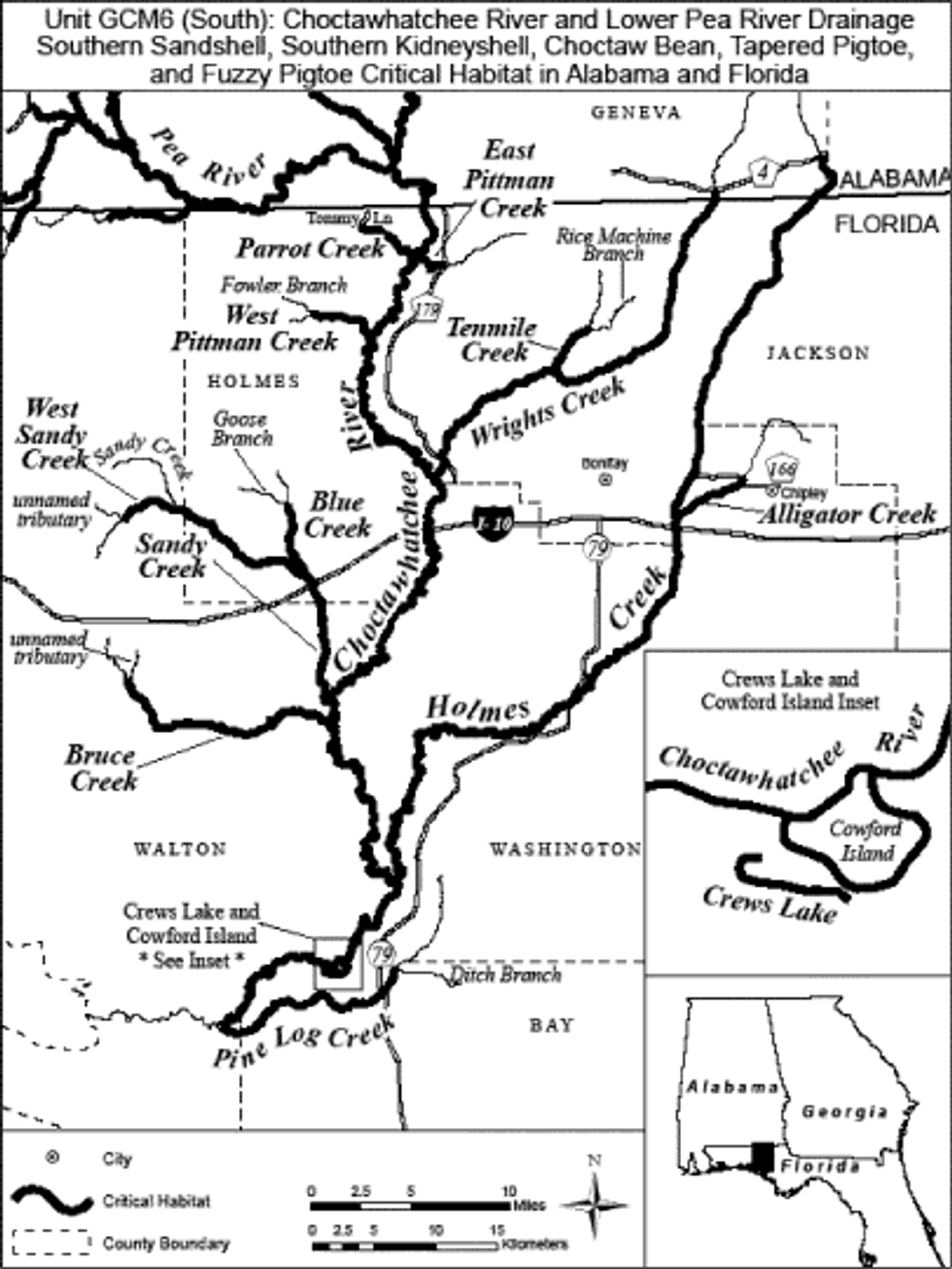
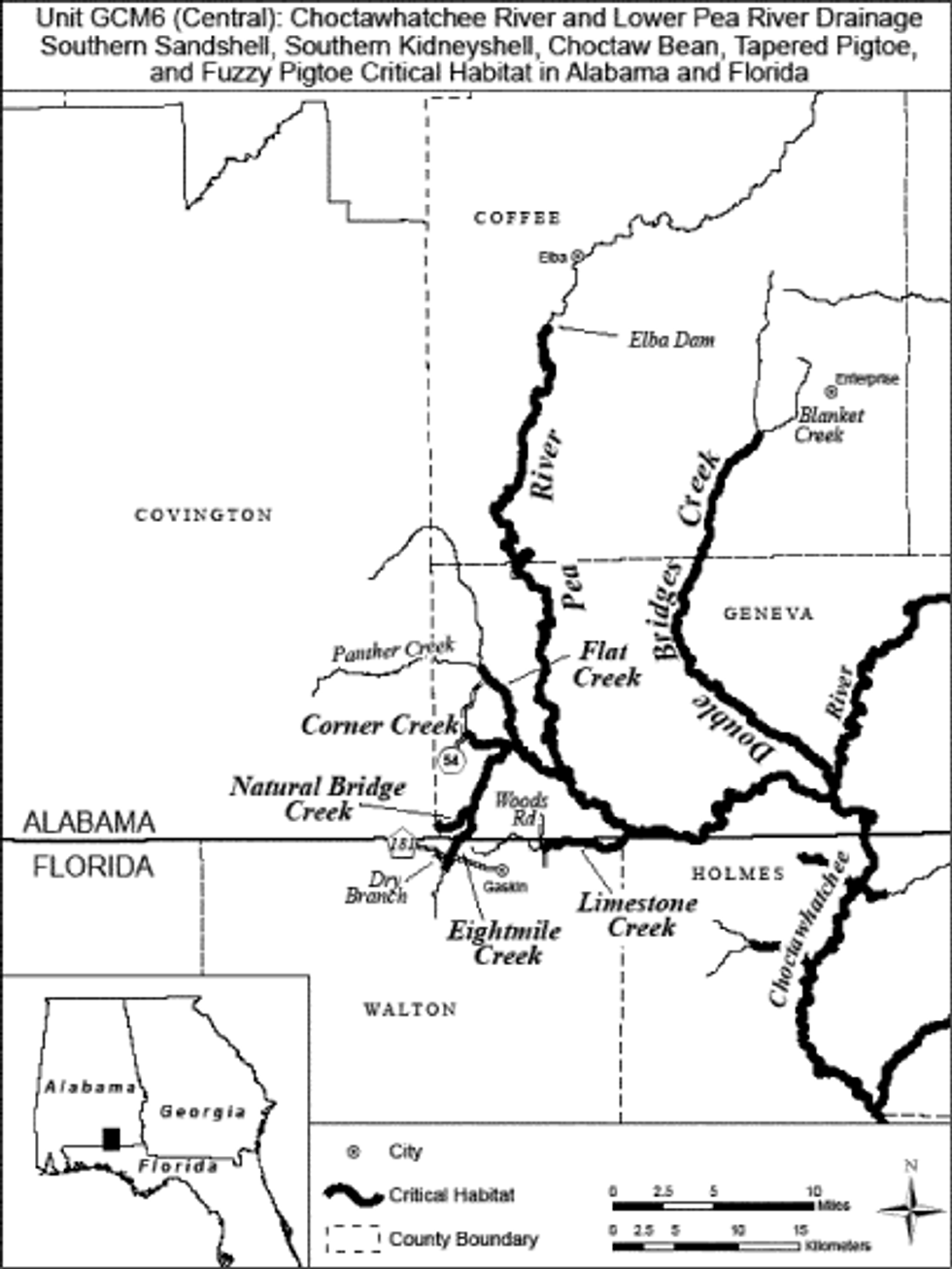
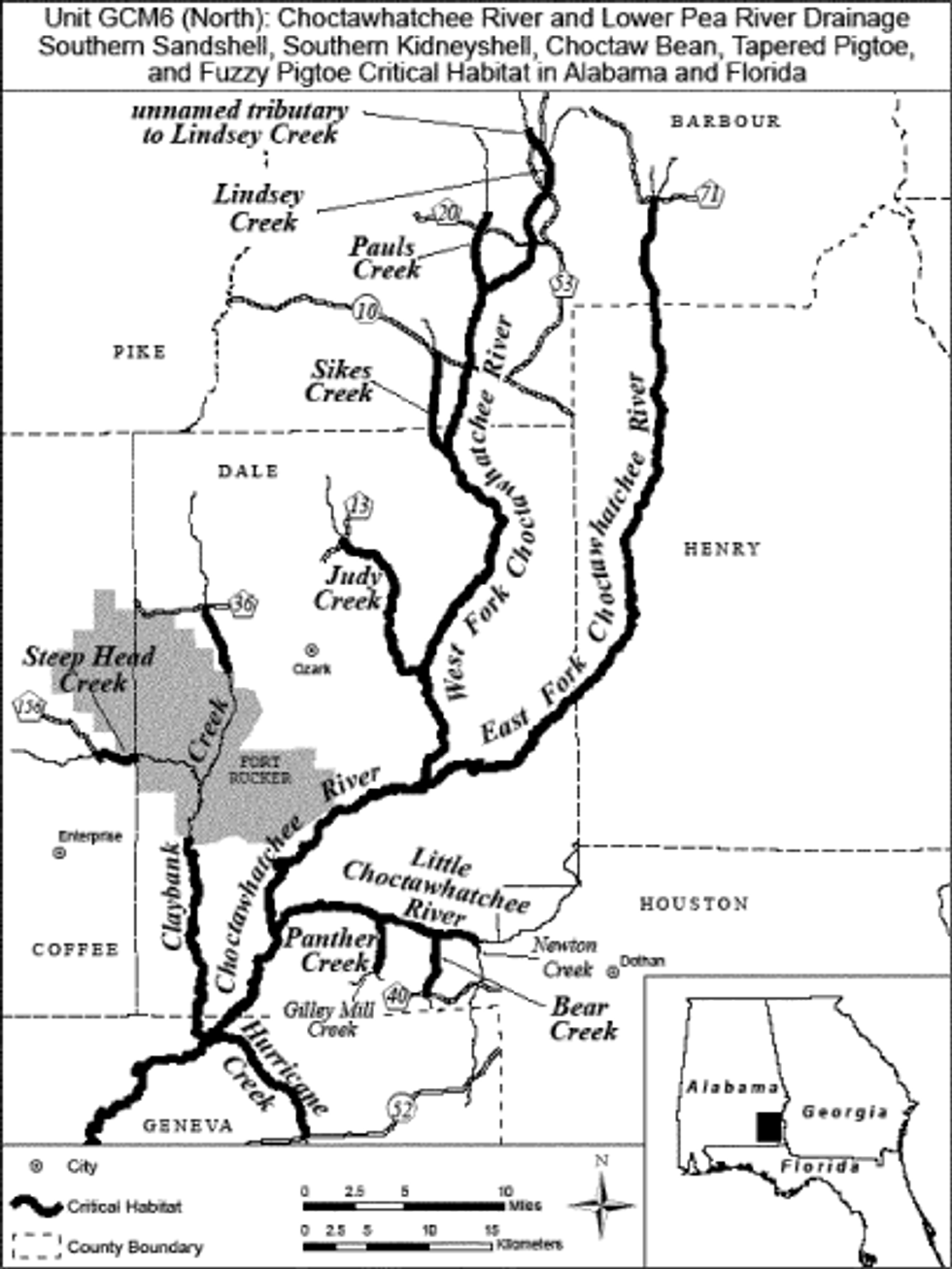
(14) Unit GCM7: Upper Pea River Drainage in Coffee, Dale, Pike, Barbour, and Bullock Counties, AL. The Pea River drainage is within the Choctawhatchee River Basin. This unit is critical habitat for the southern kidneyshell, Choctaw bean, tapered pigtoe, southern sandshell, and fuzzy pigtoe.
(i) The unit includes the Pea River mainstem from the Elba Dam, Coffee County, upstream 123 km (76 mi) to State Route 239, Bullock and Barbour Counties, AL; Whitewater Creek from its confluence with the Pea River, Coffee County, upstream 45 km (28 mi) to the confluence of Walnut Creek, Pike County, AL; Walnut Creek from its confluence with Whitewater Creek upstream 14 km (9 mi) to County Road 26, Pike County, AL; Big Creek (Coffee County) from its confluence with Whitewater Creek, Coffee County, upstream 30 km (18 mi) to the confluence of Smart Branch, Pike County, AL; Big Creek (Barbour County) from its confluence with the Pea River upstream 10 km (6 mi) to the confluence of Sand Creek, Barbour County, AL; Pea Creek from its confluence with the Pea River upstream 6 km (4 mi) to the confluence of Hurricane Creek, Barbour County, AL; and Big Sandy Creek from its confluence with the Pea River upstream 6.5 km (4 mi) to County Road 14, Bullock County, AL.
(ii) Map of Unit GCM7, Upper Pea River Drainage, follows:
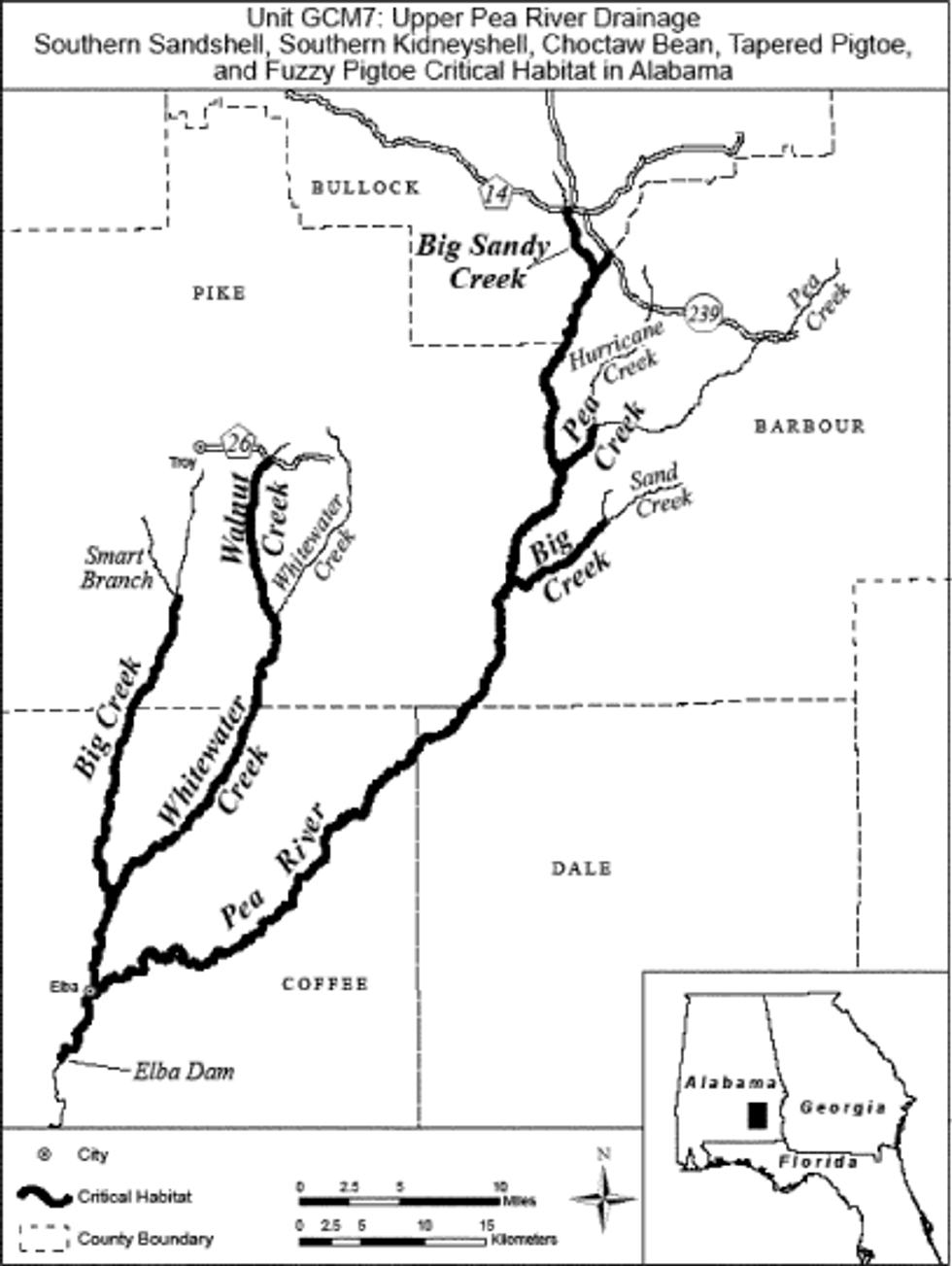
Georgia Pigtoe (Pleurobema hanleyianum)
(1) Critical habitat units are depicted for Cherokee, Coosa, and Clay Counties, Alabama; Murray and Whitfield Counties, Georgia; and Bradley and Polk Counties, Tennessee, on the maps below.
(2) The primary constituent elements (PCEs) of critical habitat for the Georgia pigtoe are the habitat components that provide:
(i) Geomorphically stable stream and river channels and banks (channels that maintain lateral dimensions, longitudinal profiles, and sinuosity patterns over time without an aggrading or degrading bed elevation).
(ii) A hydrologic flow regime (the magnitude, frequency, duration, and seasonality of discharge over time) necessary to maintain benthic habitats where the species is found. Unless other information becomes available, existing conditions at locations where the species occurs will be considered as minimal flow requirements for survival.
(iii) Water quality (including temperature, pH, hardness, turbidity, oxygen content, and chemical constituents) that meets or exceeds the current aquatic life criteria established under the Clean Water Act (33 U.S.C. 1251-1387).
(iv) Sand, gravel, cobble, boulder, or bedrock substrates with low to moderate amounts of fine sediment and attached filamentous algae.
(v) The presence of fish host(s) for the Georgia pigtoe (species currently unknown). Diverse assemblages of native fish will serve as a potential indication of presence of host fish.
(3) Critical habitat does not include manmade structures existing on the effective date of this rule and not containing one or more of the PCEs, such as buildings, bridges, aqueducts, airports, and roads, and the land on which such structures are located.
(4) Critical habitat unit maps. Maps were developed from USGS 7.5′ quadrangles. Critical habitat unit upstream and downstream limits were then identified by longitude and latitude using decimal degrees and converted to Universal Transverse Mercator (UTM) zone 16, coordinates.
(5) Note: Index map of critical habitat units for the Georgia pigtoe follows:
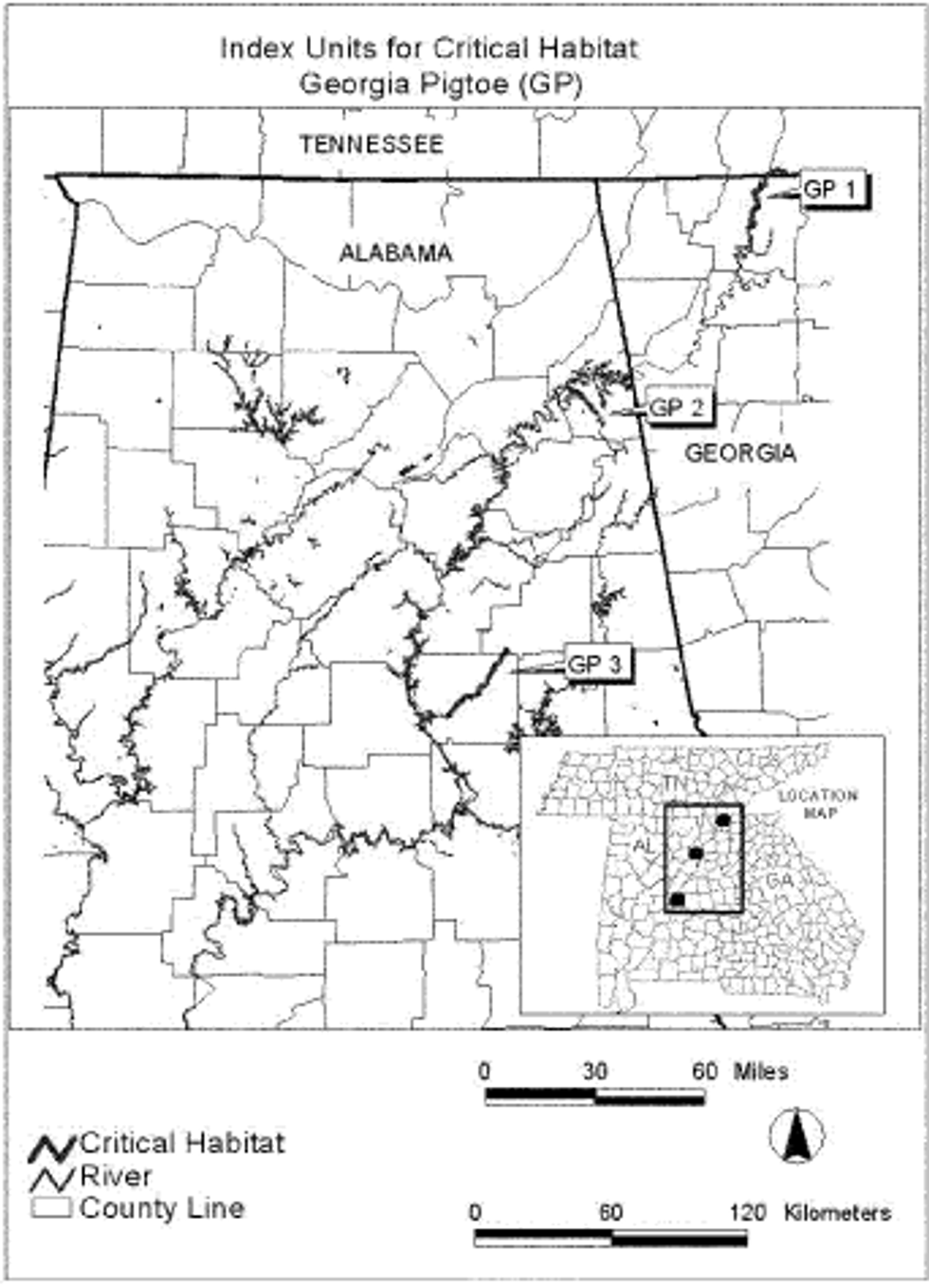
(6) Unit 1 for Georgia pigtoe (GP 1): Conasauga River, Bradley and Polk Counties, Tennessee; Murray and Whitfield Counties, Georgia.
(i) Unit GP 1 includes the channel of the Conasauga River from the confluence of Minnewaga Creek (710752.23E, 3875891.03N), Polk County, Tennessee, downstream to U.S. Highway 76 (694611.06E, 3851057.36N), Murray/Whitfield County, Georgia.
(ii) Map of Unit 1 (GP 1) for Georgia pigtoe (Conasauga River) follows:
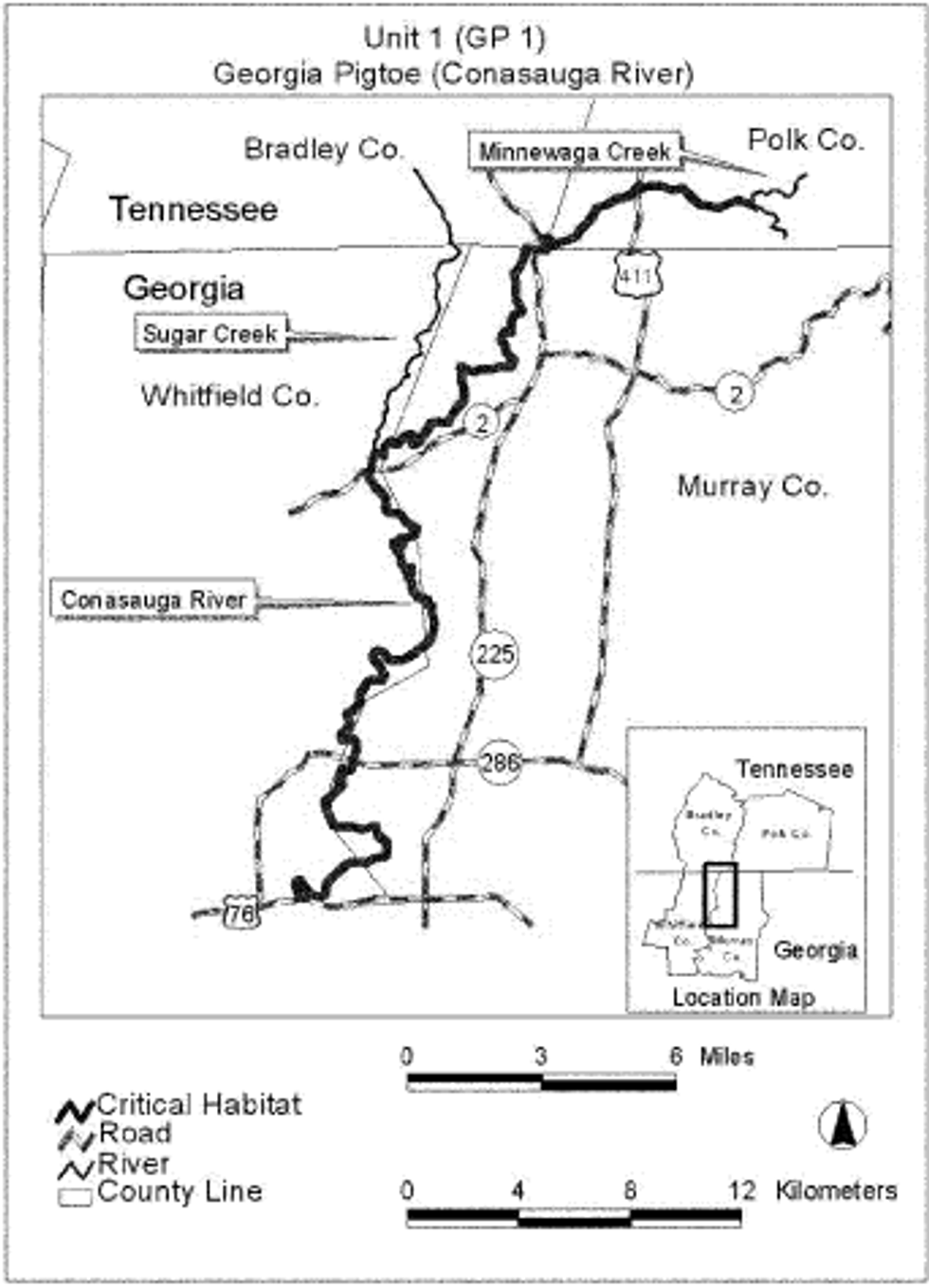
(7) Unit 2 for Georgia pigtoe (GP 2), Terrapin Creek and Coosa River, Cherokee County, Alabama.
(i) Unit GP 2 includes the channel of Terrapin Creek from Alabama Highway 9 (628065.76E, 3770007.078N), downstream to the confluence with the Coosa River (621001.27E, 3777441.03N), Cherokee County, Alabama; and the Coosa River channel from Weiss Dam (614866.54E, 3781969.16N), downstream to a point 1.6 km (1 mi) below the confluence of Terrapin Creek (619751.69E, 3776654.79N), Cherokee County, Alabama.
(ii) Map of Unit 2 (GP 2) for Georgia pigtoe (Terrapin Creek, Coosa River) follows:
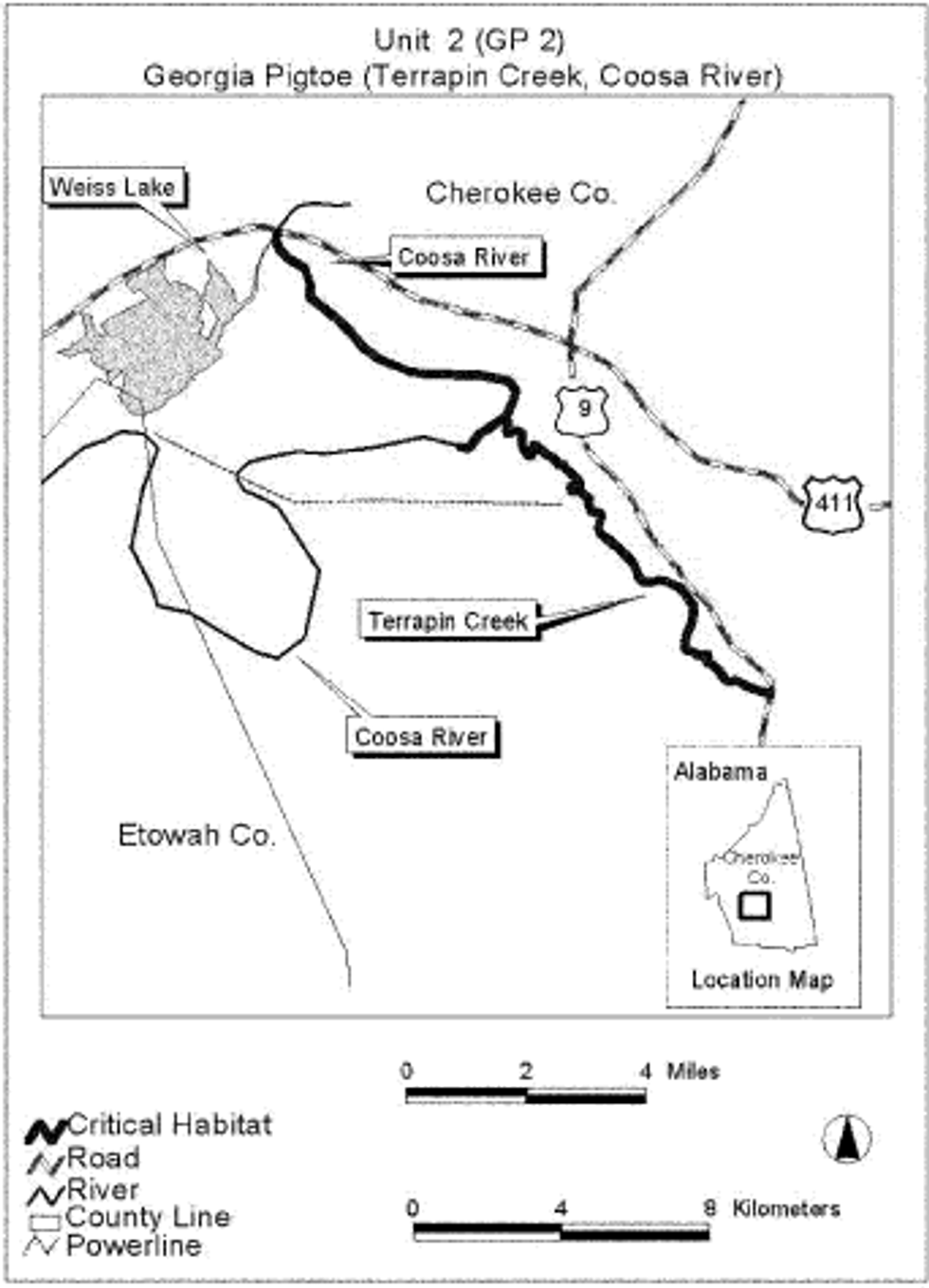
(8) Unit 3 for Georgia pigtoe (GP 3): Hatchet Creek, Coosa and Clay Counties, Alabama.
(i) Unit GP 3 includes the channel of Hatchet Creek from Clay County Road 4 (588215.16E, 3666038.46N), Clay County, downstream to the confluence of Swamp Creek at Coosa County Road 29 (561904.90E, 3636065.37N), Coosa County, Alabama.
(ii) Map of Unit 3 (GP 3) for Georgia pigtoe (Hatchet Creek) follows:
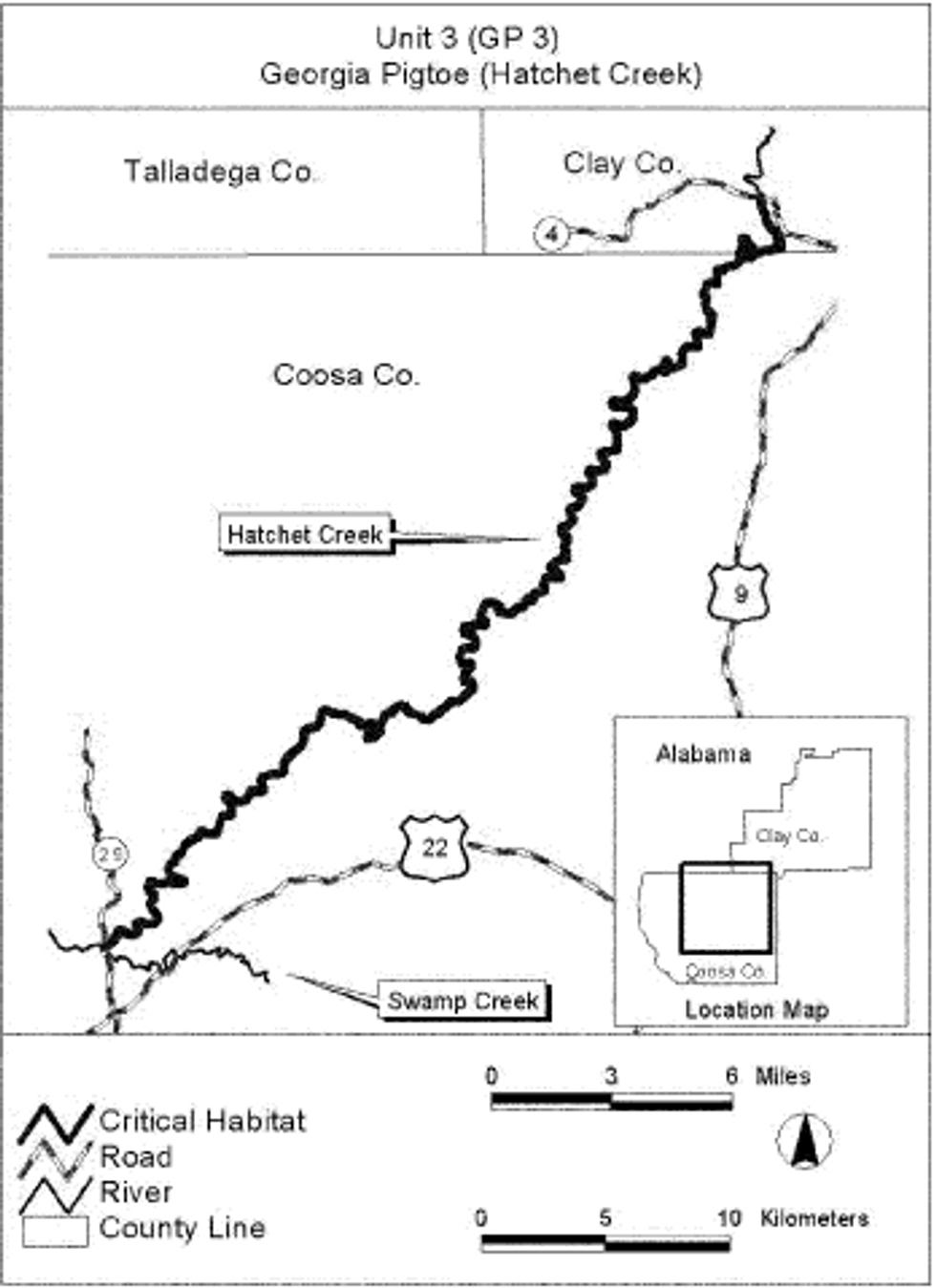
Guadalupe Orb (Cyclonaias necki)
(1) Critical habitat units are depicted for Caldwell, Comal, DeWitt, Gonzales, Guadalupe, Kendall, Kerr, and Victoria Counties, Texas, on the maps in this entry.
(2) Within these areas, the physical or biological features essential to the conservation of Guadalupe orb consist of the following components within waters and streambeds up to the ordinary high-water mark:
(i) Flowing water at rates suitable to keep riffle habitats wetted and well-oxygenated and to prevent excess sedimentation or scour during high-flow events but not so high as to dislodge individuals;
(ii) Stable riffles and runs with substrate composed of cobble, gravel, and fine sediments;
(iii) Channel catfish (Ictalurus punctatus), flathead catfish (Pylodictis olivaris), and tadpole madtom (Noturus gyrinus) present; and
(iv) Water quality parameters within the following ranges:
(A) Dissolved oxygen greater than 2 milligrams per liter (mg/L);
(B) Salinity less than 2 parts per thousand;
(C) Total ammonia less than 0.77 mg/L total ammonia nitrogen;
(D) Water temperature below 29 °C (84.2 °F); and
(E) Low levels of contaminants.
(3) Critical habitat does not include manmade structures (such as buildings, aqueducts, runways, roads, and other paved areas) and the land on which they are located existing within the legal boundaries on July 5, 2024.
(4) Data layers defining the map units were created on a base of U.S. Geological Survey digital ortho-photo quarter-quadrangles, and the critical habitat units were then mapped using Universal Transverse Mercator (UTM) Zone 14N coordinates. The maps in this entry, as modified by any accompanying regulatory text, establish the boundaries of the critical habitat designation. The coordinates or plot points or both on which the maps are based are available to the public at the Service's internet site at https://www.fws.gov/office/austin-ecological-services , at https://www.regulations.gov at Docket No. FWS-R2-ES-2019-0061, and at the field office responsible for this designation. You may obtain field office location information by contacting one of the Service regional offices, the addresses of which are listed at 50 CFR 2.2.
(5) Index map of critical habitat units for the Guadalupe orb follows:
Figure 1 to Guadalupe Orb (Cyclonaias necki) paragraph (5)

(6) Unit GORB-1: Upper Guadalupe River; Comal, Kendall, and Kerr Counties, Texas.
(i) Unit GORB-1 consists of two subunits:
(A) Subunit GORB-1a (South Fork Guadalupe River) consists of 5.1 river miles (mi) (8.2 kilometers (km)) in Kerr County, Texas. All of the riparian lands that border this unit are in private ownership.
(B) Subunit GORB-1b (Upper Guadalupe River) consists of 97.1 river mi (156.3 km) of the Guadalupe River in Comal, Kendall, and Kerr Counties, Texas. The riparian lands that border this subunit are in State/local government (5 percent) and private (95 percent) ownership.
(ii) Unit GORB-1 includes stream channel up to bankfull height.
(iii) Map of Unit GORB-1 follows:
Figure 2 to Guadalupe Orb (Cyclonaias necki) paragraph (6)(iii)

(7) Unit GORB-2: Lower Guadalupe River; Caldwell, DeWitt, Gonzales, Guadalupe, and Victoria Counties, Texas.
(i) Unit GORB-2 consists of two subunits:
(A) Subunit GORB-2a (San Marcos River) consists of 63.9 river mi (102.8 km) in Caldwell, Gonzales, and Guadalupe Counties, Texas. The riparian lands that border this subunit are in State/local government (6 percent) and private (94 percent) ownership.
(B) Subunit GORB-2b (Lower Guadalupe River) consists of 122.4 river mi (197.0 km) in DeWitt, Gonzales, and Victoria Counties, Texas. The riparian lands that border this subunit are in State/local government (5 percent) and private (95 percent) ownership.
(ii) Unit GORB-2 includes stream channel up to bankfull height.
(iii) Map of Unit GORB-2 follows:
Figure 3 to Guadalupe Orb (Cyclonaias necki) paragraph (7)(iii)

Altamaha spinymussel (Elliptio spinosa).
(1) Critical habitat units are depicted for Appling, Ben Hill, Coffee, Jeff Davis, Long, Montgomery, Tattnall, Telfair, Toombs, Wayne, and Wheeler Counties, Georgia, on the maps below.
(2) The primary constituent elements (PCEs) of critical habitat for the Altamaha spinymussel are the habitat components that provide:
(i) Geomorphically stable river channels and banks (channels that maintain lateral dimensions, longitudinal profiles, and sinuosity patterns over time without an aggrading or degrading bed elevation) with stable sandbar, slough, and mid-channel-island habitats of coarse-to-fine sand substrates with low to moderate amounts of fine sediment and attached filamentous algae.
(ii) A hydrologic flow regime (the magnitude, frequency, duration, and seasonality of discharge over time) necessary to maintain benthic habitats where the species are found and to maintain connectivity of rivers with the floodplain, allowing the exchange of nutrients and sediment for sand bar maintenance, food availability, and spawning habitat for native fishes.
(iii) Water quality necessary for normal behavior, growth, and viability of all life stages, including specifically temperature (less than 32.6°C (90.68°) with less than 2°C (3.6°F) daily fluctuation), pH (6.1 to 7.7), oxygen content (daily average DO concentration of 5.0 mg/l and a minimum of 4.0 mg/l), an ammonia level not exceeding 1.5 mg N/L, 0.22 mg N/L (normalized to pH 8 and 25°C (77°F)), and other chemical characteristics.
(iv) The presence of fish hosts (currently unknown) necessary for recruitment of the Altamaha spinymussel. The continued occurrence of diverse native fish assemblages currently occurring in the basin will serve as an indication of host fish presence until appropriate host fishes can be identified for the Altamaha spinymussel.
(3) Critical habitat does not include manmade structures existing on the effective date of this rule and not containing one or more of the PCEs, such as buildings, bridges, aqueducts, airports, and roads, and the land on which such structures are located.
(4) Critical habitat unit maps. Maps were developed from USGS 7.5 minute quadrangles, and critical habitat unit upstream and downstream limits were then identified by longitude and latitude using decimal degrees.
(5) Note: Index map of critical habitat units for the Altamaha spinymussel follows:
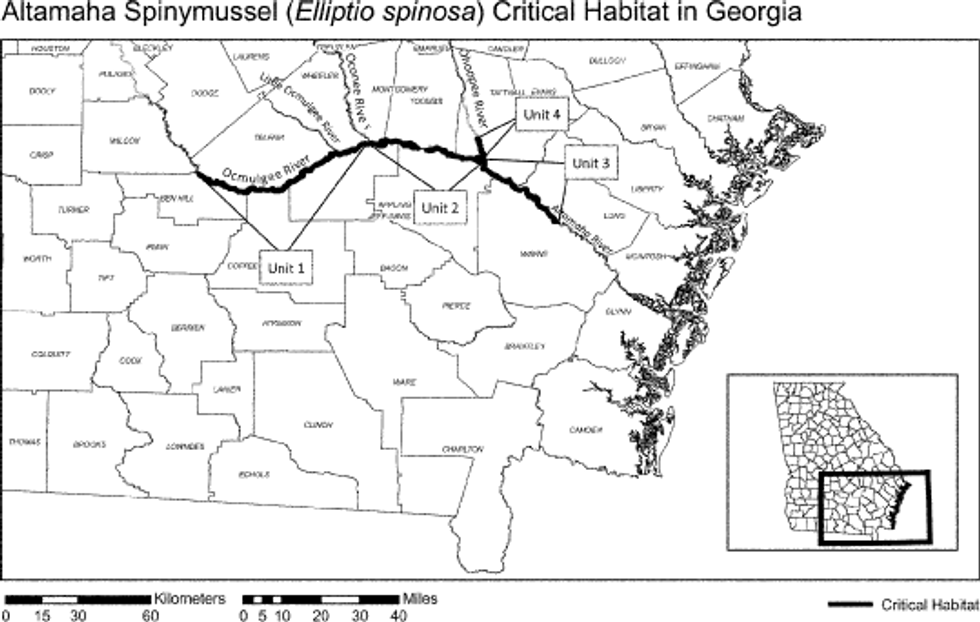
(6) Unit 1: Ocmulgee River, Ben Hill, Telfair, Coffee, and Jeff Davis Counties, Georgia.
(i) Unit 1 includes the channel of the Ocmulgee River from the confluence of House Creek with the Ocmulgee at Red Bluff Landing (longitude −83.18, latitude 31.85), Ben Hill and Telfair Counties, Georgia, downstream to Altamaha River (longitude −82.54, latitude 31.96), at the confluence of the Oconee and Ocmulgee Rivers, Jeff Davis and Telfair Counties, Georgia.
(ii) Map of Unit 1 (Ocmulgee River) follows:
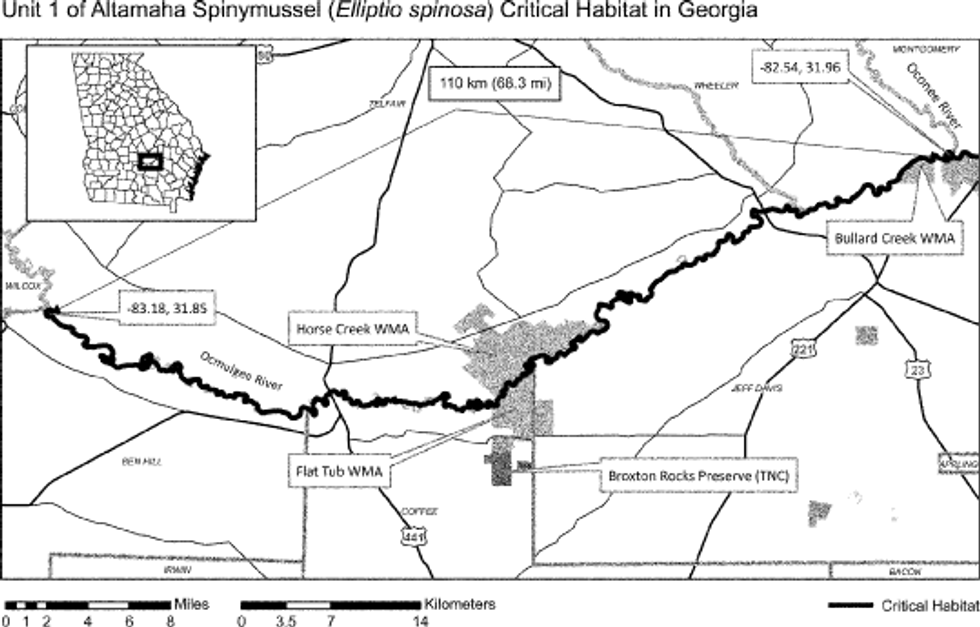
(7) Unit 2: Upper Altamaha River, Wheeler, Toombs, Montgomery, Jeff Davis, Appling, and Tattnall Counties, Georgia.
(i) Unit 2 includes the channel of the Altamaha River from the confluence of the Ocmulgee and Oconee Rivers (longitude −82.54, latitude 31.96), Wheeler and Jeff Davis Counties, Georgia, downstream to the US 1 crossing (longitude −82.36, latitude 31.94), and from the western edge of Moody Forest (longitude −82.33, latitude 31.93) downstream to the confluence of the Altamaha and Ohoopee Rivers (longitude −82.11, latitude 31.90), Appling and Tattnall Counties, Georgia.
(ii) Map of Unit 2 (Upper Altamaha River) follows:
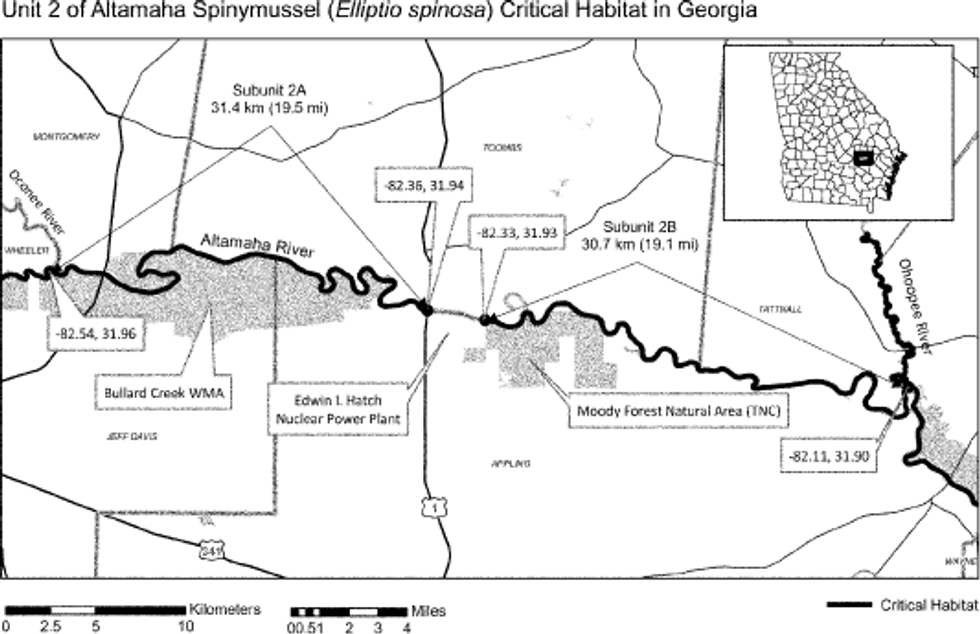
(8) Unit 3: Middle Altamaha River, Tattnall, Appling, Wayne, and Long Counties, Georgia.
(i) Unit 3 includes the channel of Altamaha River, extending from the confluence with the Ohoopee (longitude −82.11, latitude 31.90), Tattnall and Appling Counties, Georgia, downstream to U.S. Route 301 (longitude −81.84, latitude 31.67), Wayne and Long Counties, Georgia.
(ii) Map of Unit 3 (Middle Altamaha River) follows:
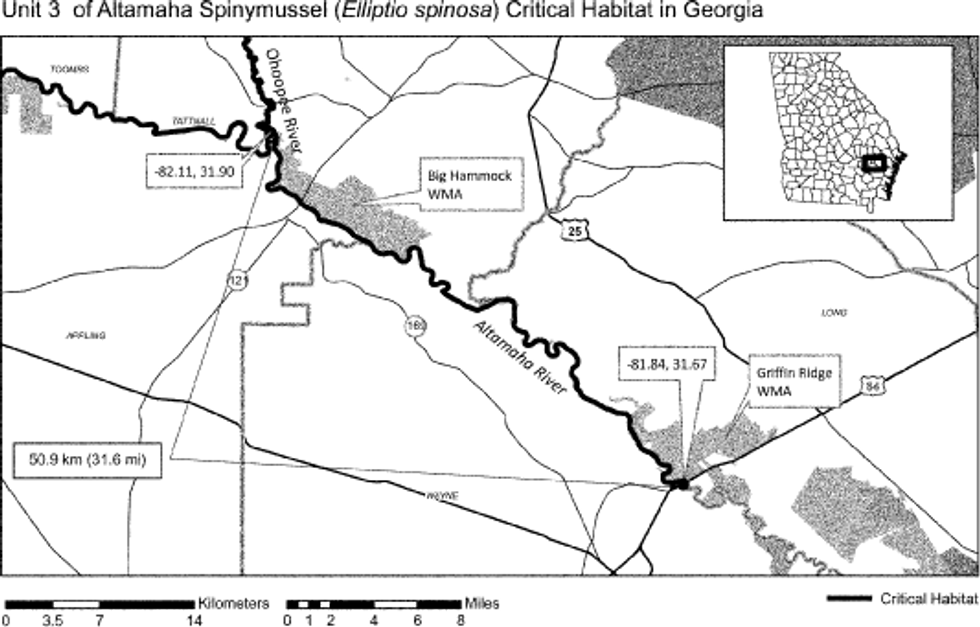
(9) Unit 4: Lower Ohoopee River, Tattnall County, Georgia.
(i) Unit 4 includes the channel of the Ohoopee River, starting 2.2 km (1.3 mi) upstream of Tattnall County Road 191 (longitude −82.14, latitude 31.98), Tattnall County, Georgia, downstream to the confluence of the Ohoopee River with the Altamaha River (longitude −82.11, latitude 31.90), Tattnall County, Georgia.
(ii) Map of Unit 4 (Lower Ohoopee River) follows:
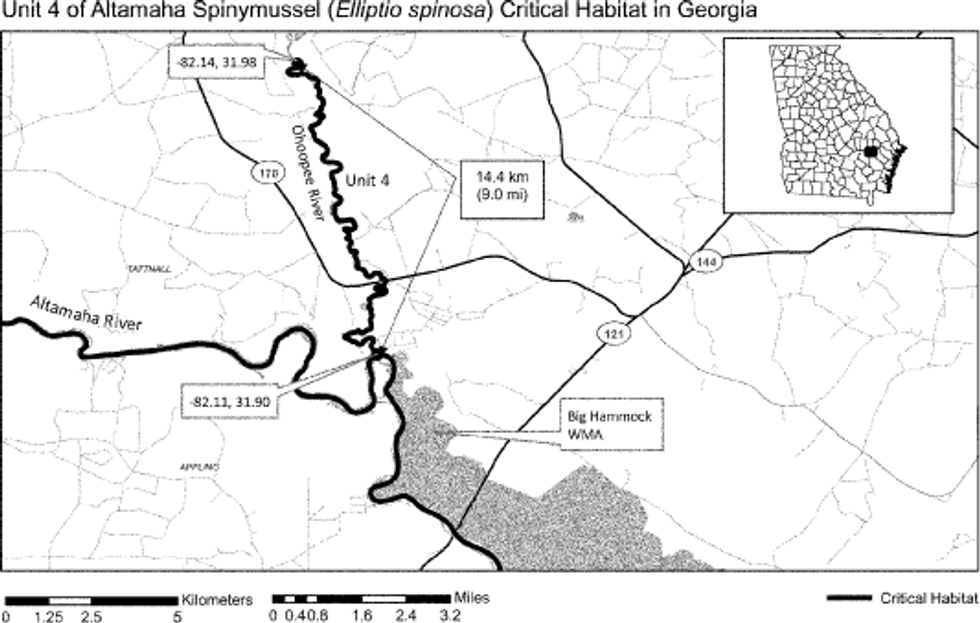
Fluted Kidneyshell (Ptychobranchus subtentus)
(1) Critical habitat units are depicted on the maps below for Limestone County, Alabama; Jackson, Laurel, McCreary, Pulaski, Rockcastle, and Wayne Counties, Kentucky; Bedford, Claiborne, Cocke, Fentress, Franklin, Giles, Grainger, Greene, Hamblen, Hancock, Hickman, Humphreys, Jefferson, Knox, Lincoln, Marshall, Maury, Moore, Morgan, Overton, Perry, Pickett, Polk, Scott, and Sevier Counties, Tennessee; and Bland, Lee, Russell, Scott, Smyth, Tazewell, Washington, and Wythe Counties, Virginia.
(2) Within these areas, the primary constituent elements of the physical or biological features essential to the conservation of fluted kidneyshell consist of five components:
(i) Riffle habitats within large, geomorphically stable stream channels (channels that maintain lateral dimensions, longitudinal profiles, and sinuosity patterns over time without an aggrading or degrading bed elevation).
(ii) Stable substrates of sand, gravel, and cobble with low to moderate amounts of fine sediment and containing flow refugia with low shear stress.
(iii) A natural hydrologic flow regime (magnitude, frequency, duration, and seasonality of discharge over time) necessary to maintain benthic habitats where the species is found, and connectivity of rivers with the floodplain, allowing the exchange of nutrients and sediment for habitat maintenance, food availability for all life stages, and spawning habitat for native fishes.
(iv) Water quality with low levels of pollutants and including a natural temperature regime, pH (between 6.0 to 8.5), oxygen content (not less than 5.0 milligrams/liter), hardness, and turbidity necessary for normal behavior, growth, and viability of all life stages.
(v) The presence of abundant fish hosts, which may include the barcheek darter, fantail darter, rainbow darter, redline darter, bluebreast darter, dusky darter and banded sculpin, necessary for recruitment of the fluted kidneyshell.
(3) Critical habitat does not include manmade structures (such as buildings, aqueducts, dams, roads, and other paved areas) and the land on which they are located existing within the legal boundaries on October 28, 2013.
(4) Critical habitat map units. Data layers defining map units were created with USGS National Hydrography Dataset (NHD+) GIS data. The 1:100,000 river reach (route) files were used to calculate river kilometers and miles. ESRIs ArcGIS 10.0 software was used to determine longitude and latitude coordinates using decimal degrees. The projection used in mapping all units was USA Contiguous Albers Equal Area Conic USGS version, NAD 83, meters. The following data sources were referenced to identify features (like roads and streams) used to delineate the upstream and downstream extents of critical habitat units: NHD+ flowline and waterbody data, 2011 Navteq roads data, USA Topo ESRI online basemap service, DeLorme Atlas and Gazetteers, and USGS 7.5 minute topographic maps. The maps in this entry, as modified by any accompanying regulatory text, establish the boundaries of the critical habitat designation. The coordinates or plot points or both on which each map is based are available to the public at the field office Internet site (http://www.fws.gov/cookeville), at http://www.regulations.gov at Docket No. FWS-R4-ES-2013-0026, and at the Service's Tennessee Fish and Wildlife Office. You may obtain field office location information by contacting one of the Service regional offices, the addresses of which are listed at 50 CFR 2.2.
(5) An overview of critical habitat locations for the fluted kidneyshell in Alabama, Tennessee, Kentucky, and Virginia follows:
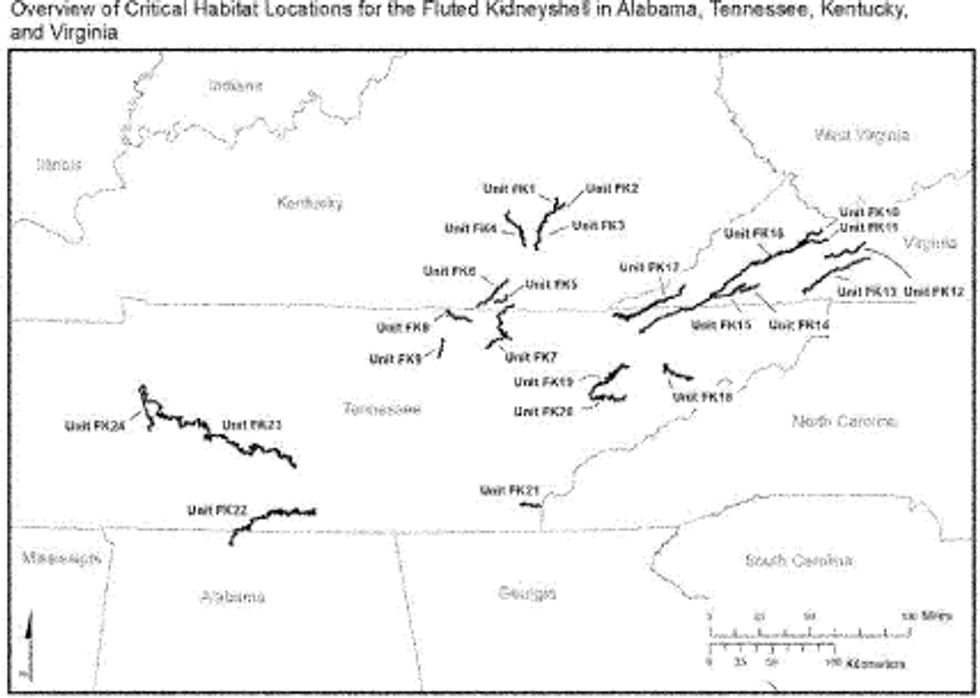
(6) Unit FK1: Horse Lick Creek, Rockcastle and Jackson Counties, Kentucky.
(i) The unit includes approximately 19 river kilometers (rkm) (12 river miles (rmi)) of Horse Lick Creek, in Rockcastle and Jackson Counties, KY. It includes the mainstem of Horse Lick Creek from its confluence with the Rockcastle River (−84.13780, 37.31991) upstream to Clover Bottom Creek (−84.12200, 37.40879).
(ii) Map of Units FK1 and FK2 follows:
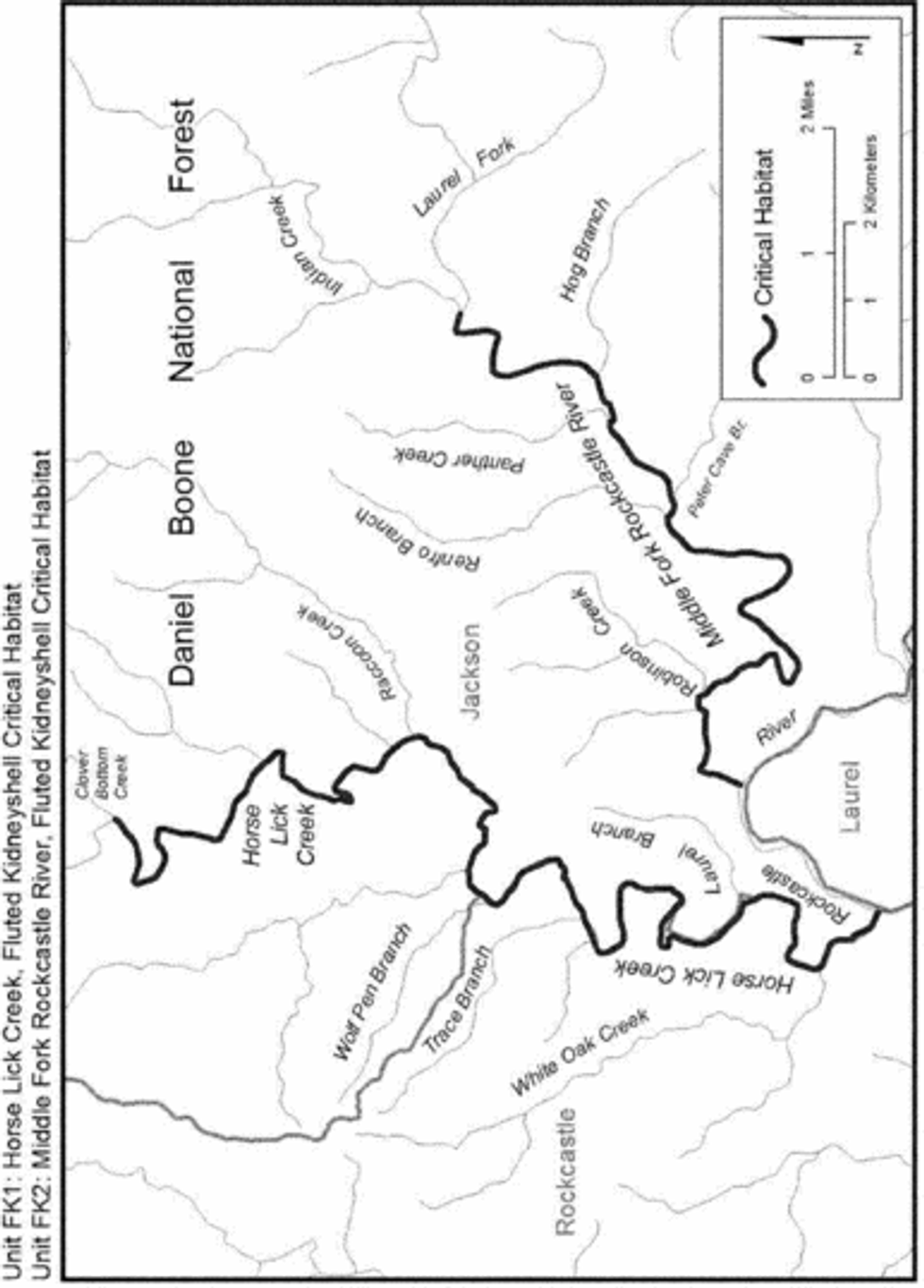
(7) Unit FK2: Middle Fork Rockcastle River, Jackson County, Kentucky.
(i) The unit includes 12.5 rkm (7.7 rmi) of the Middle Fork Rockcastle River from its confluence with the Rockcastle River (−84.11895, 37.33581) upstream to its confluence with Indian Creek and Laurel Fork (−84.04897, 37.36765) in Jackson County, KY.
(ii) Map of Units FK1 and FK2 is provided at paragraph (6)(ii) of this entry.
(8) Unit FK3: Rockcastle River, Pulaski, Laurel, and Rockcastle Counties, Kentucky.
(i) The unit includes approximately 70 rkm (43 rmi) of the Rockcastle River from the backwaters of Lake Cumberland near its confluence with Cane Creek along the Laurel and Pulaski County line, KY (−84.30594, 37.03423), upstream to its confluence with Horse Lick Creek along the Laurel and Rockcastle County line, KY (−84.13766, 37.31944).
(ii) Map of Unit FK3 follows:
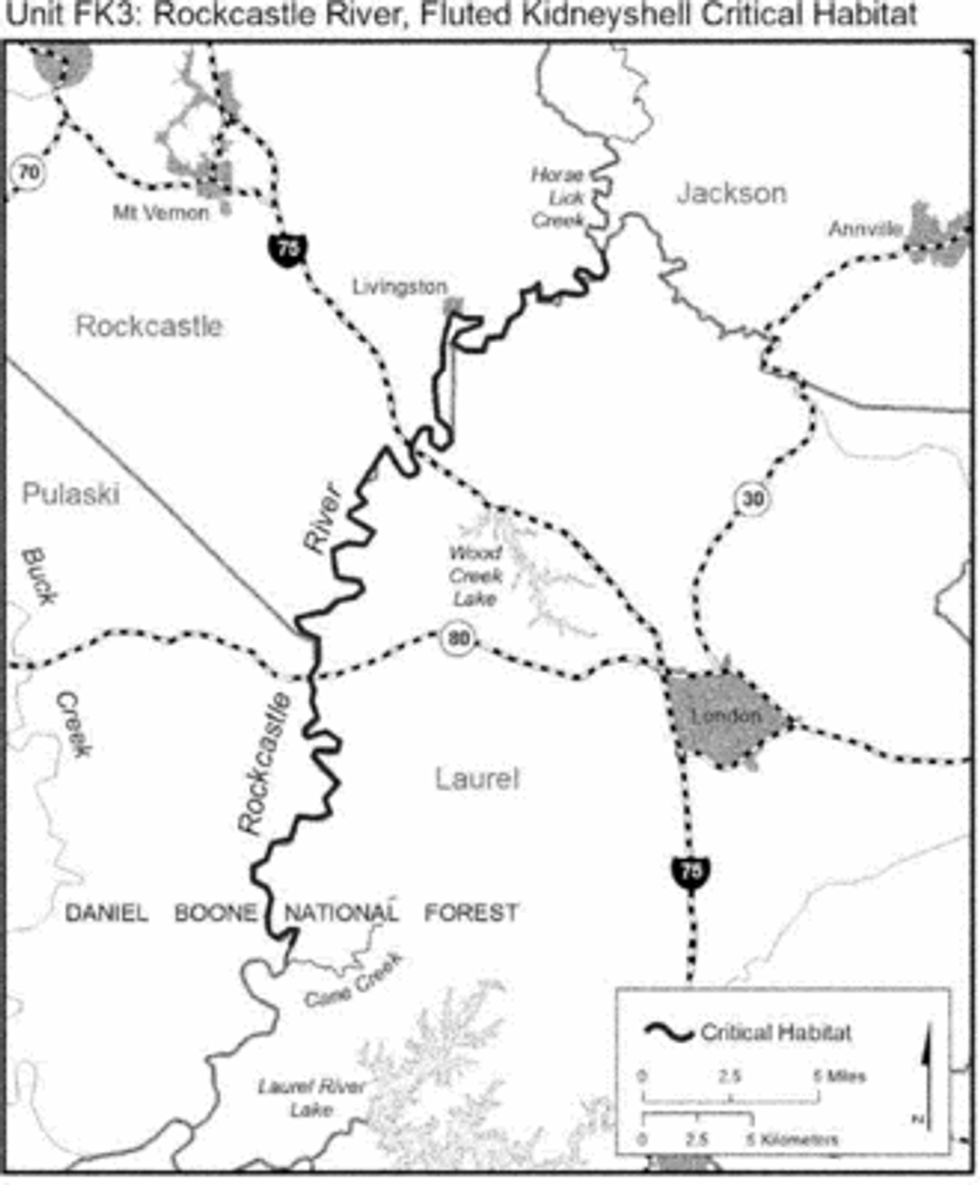
(9) Unit FK4: Buck Creek, Pulaski County, Kentucky.
(i) This unit includes 61 rkm (38 rmi) of Buck Creek from State Route 192 (−84.42681, 37.05977) upstream to Route 328 (−84.55492, 37.32430), Pulaski County, KY.
(ii) Map of Unit FK4 follows:
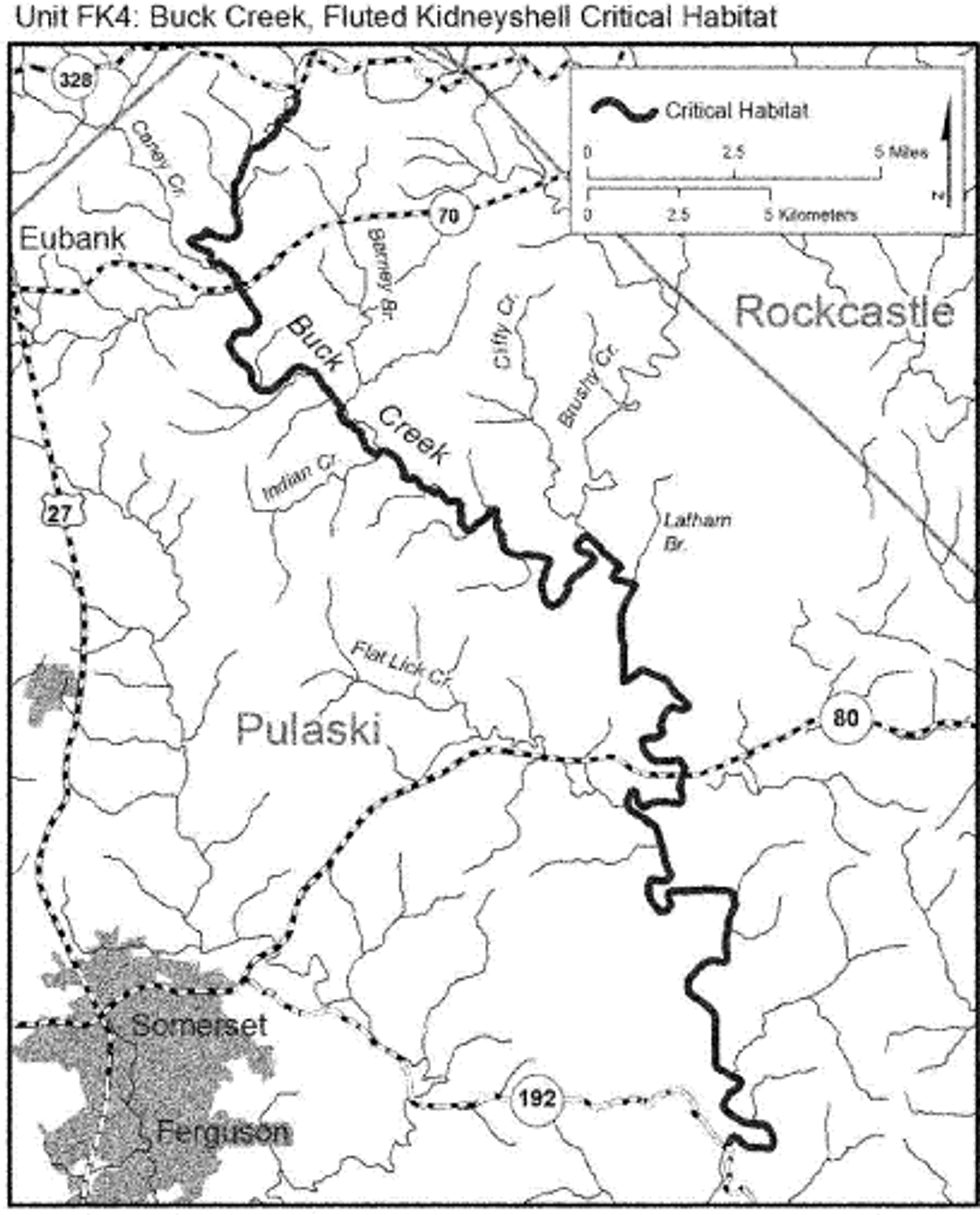
(10) Unit FK5: Rock Creek, McCreary County, Kentucky.
(i) The unit includes approximately 19 rkm (12 rmi) of Rock Creek from its confluence with White Oak Creek (−84.69103, 36.65145) upstream to the low water crossing at rkm 25.6 (rmi 15.9) (−84.58888, 36.70800) in McCreary County, KY.
(ii) Map of Units FK5 and FK6 follows:
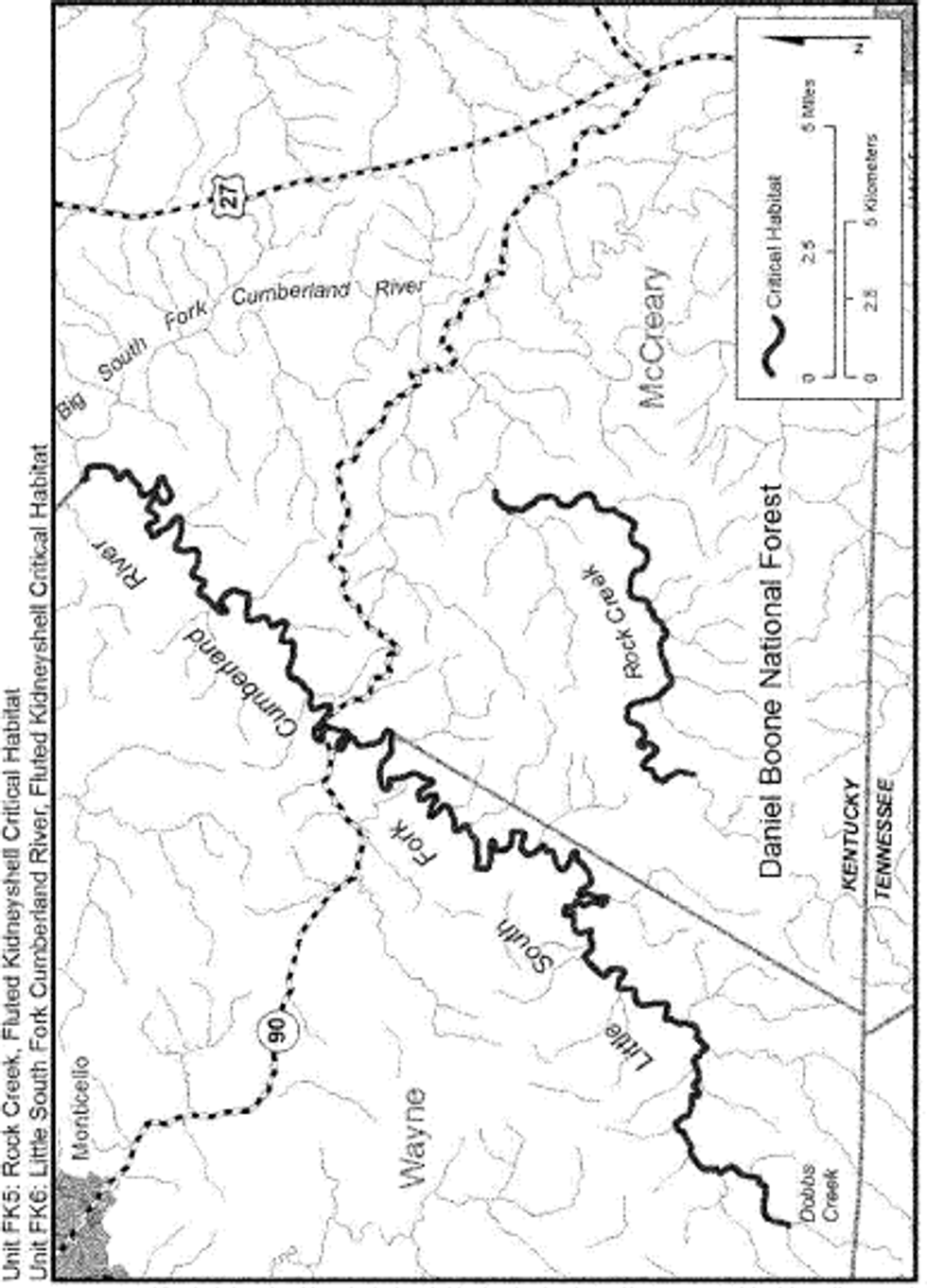
(11) Unit FK6: Little South Fork Cumberland River, McCreary and Wayne Counties, Kentucky.
(i) The unit includes 65.5 rkm (40.7 rmi) of the Little South Fork Cumberland River from its confluence with the Big South Fork Cumberland River (−84.58269, 36.82690), where it is the dividing line between Wayne and McCreary Counties, upstream to its confluence with Dobbs Creek (−84.85344, 36.62588) in Wayne County, KY.
(ii) Map of Units FK5 and FK6 is provided at paragraph (10)(ii) of this entry.
(12) Unit FK7: Big South Fork Cumberland River, Fentress, Morgan, and Scott Counties, Tennessee, and McCreary County, Kentucky.
(i) The unit includes approximately 45 rkm (28 rmi) of the Big South Fork of the Cumberland River from its confluence with Laurel Crossing Branch downstream of Big Shoals (−84.53642, 36.64114), McCreary County, KY, upstream to its confluence with Clear Fork and New River (−84.62394, 36.42475), Scott County, TN. This unit also includes 32.3 rkm (20.0 rmi) of Clear Fork from its confluence with the Big South Fork and New River (−84.62394, 36.42475) in Scott County, TN, upstream to its confluence with Crooked Creek (−84.78637, 36.32533) along the Fentress and Morgan County line, TN. This unit also includes 14.7 rkm (9.1 rmi) of the New River from its confluence with the Big South Fork (−84.62394, 36.42475) upstream to the Highway 27 Bridge crossing (−84.55290, 36.38279) in Scott County, TN.
(ii) Map of Unit FK7 follows:
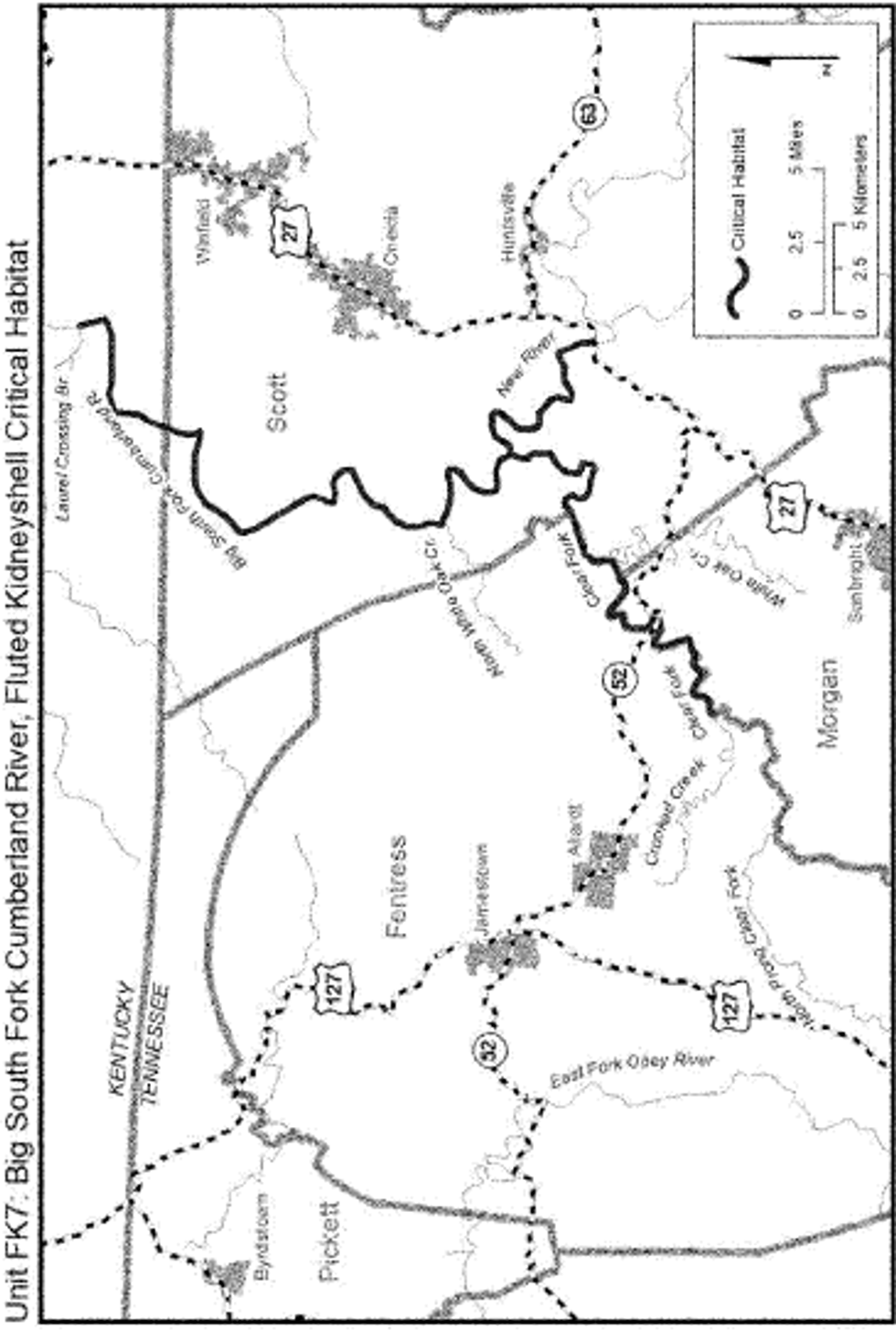
(13) Unit FK8: Wolf River and Town Branch, Pickett and Fentress Counties, Tennessee.
(i) The unit includes 41.0 rkm (25.5 rmi) of the Wolf River from its inundation at Dale Hollow Lake (−85.14414, 36.60670) in Pickett County, TN, upstream to its confluence with Delk Creek (−84.91064, 36.52784) in Fentress County, TN. This unit also includes 3.4 rkm (2.0 rmi) of Town Branch from its confluence with Wolf River (−85.11787, 36.58321) upstream to its headwaters (−85.12136, 36.55947) in Pickett County, TN.
(ii) Map of Unit FK8 follows:
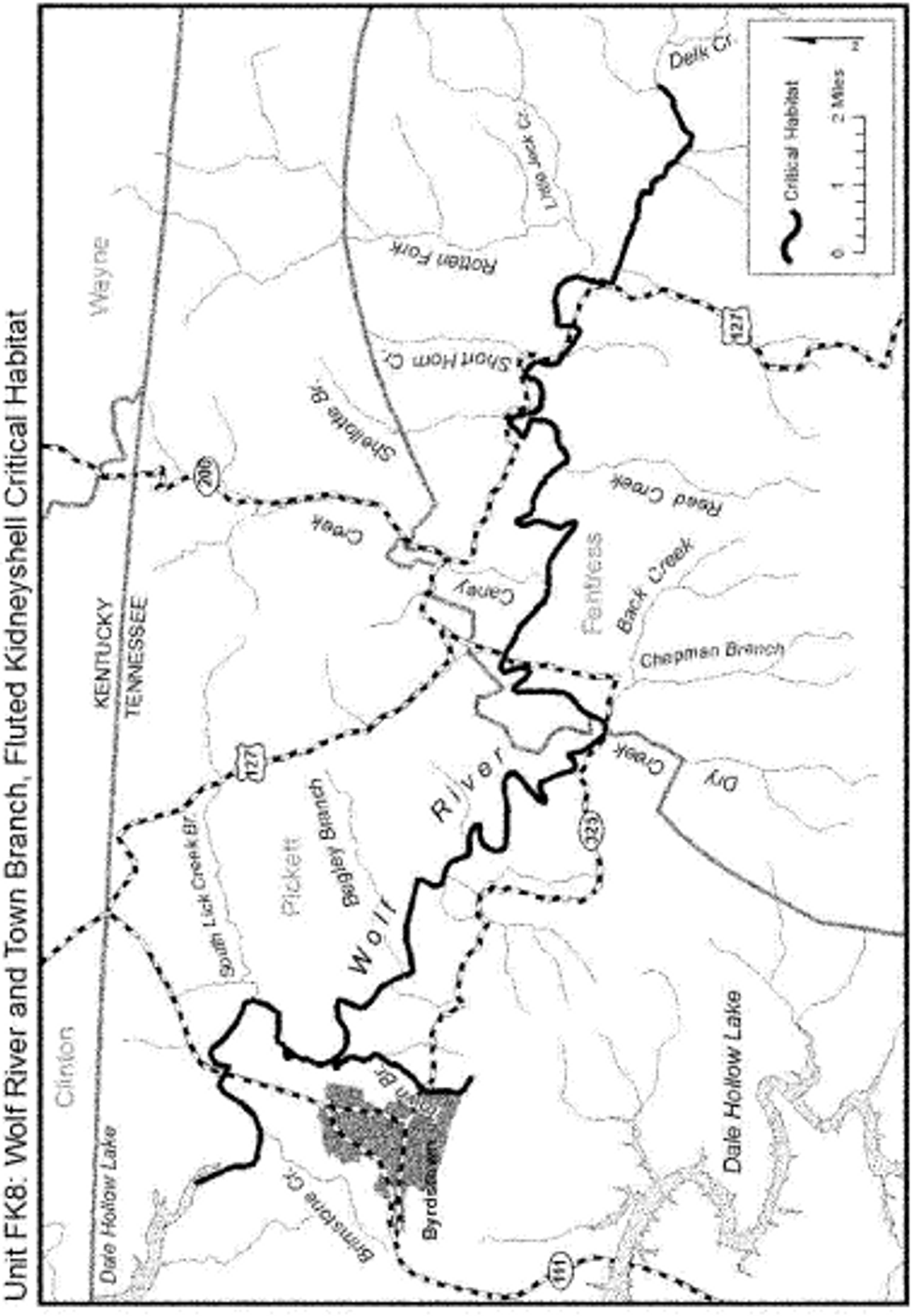
(14) Unit FK9: West Fork Obey River, Overton County, Tennessee.
(i) The unit includes approximately 19 rkm (12 rmi) of the West Fork Obey River from the Highway 52 Bridge crossing (−85.17410, 36.39731) upstream to its confluence with Dry Hollow Creek (−85.20747, 36.25989) in Overton County, TN.
(ii) Map of Unit FK9 follows:
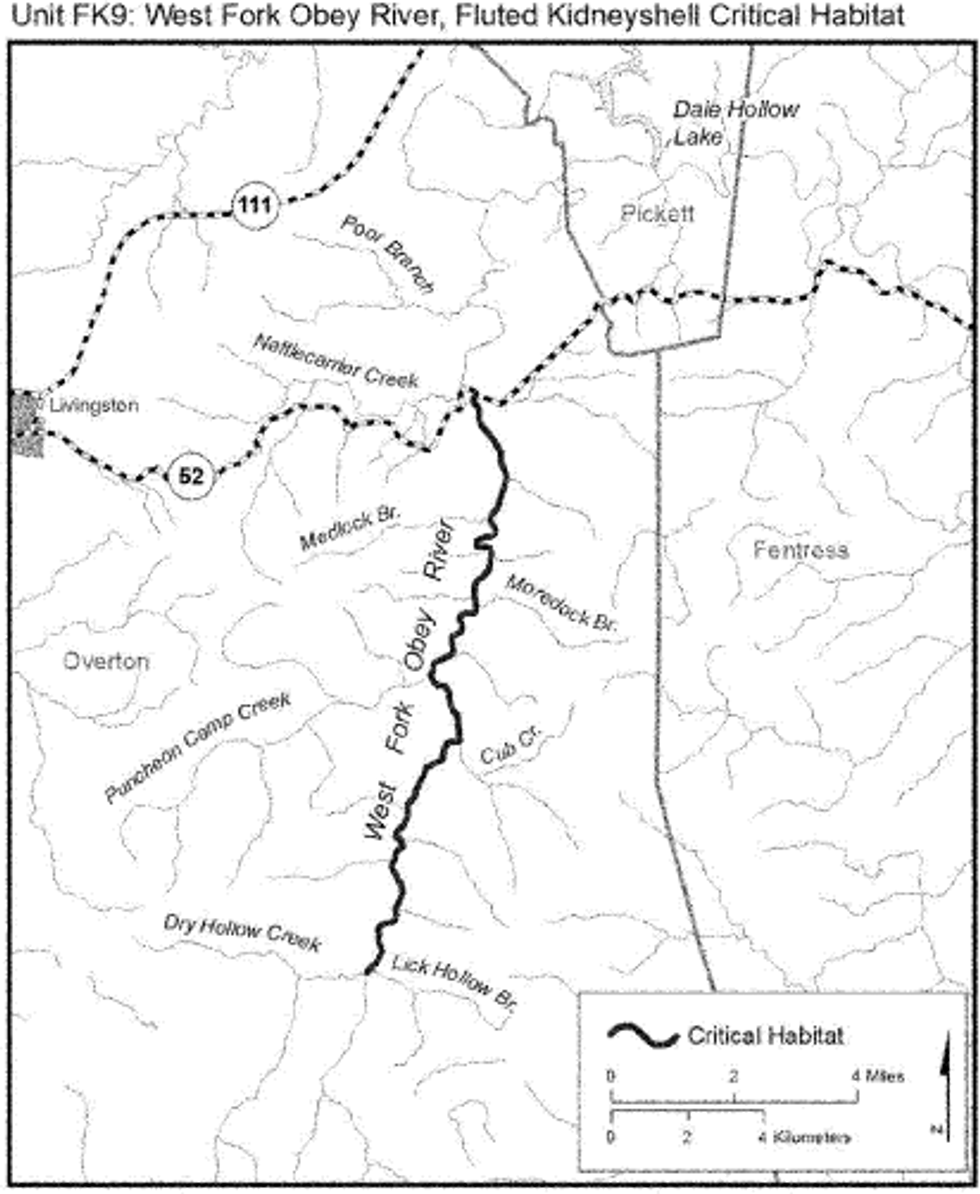
(15) Unit FK10: Indian Creek, Tazewell County, Virginia.
(i) The unit includes 6.7 rkm (4.2 rmi) of Indian Creek from its confluence with the Clinch River (−81.76608, 37.08893) upstream to the fourth Norfolk Southern Railroad crossing at Van Dyke (−81.71975, 37.11206) in Tazewell County, VA.
(ii) Map of Units FK10 and FK11 follows:
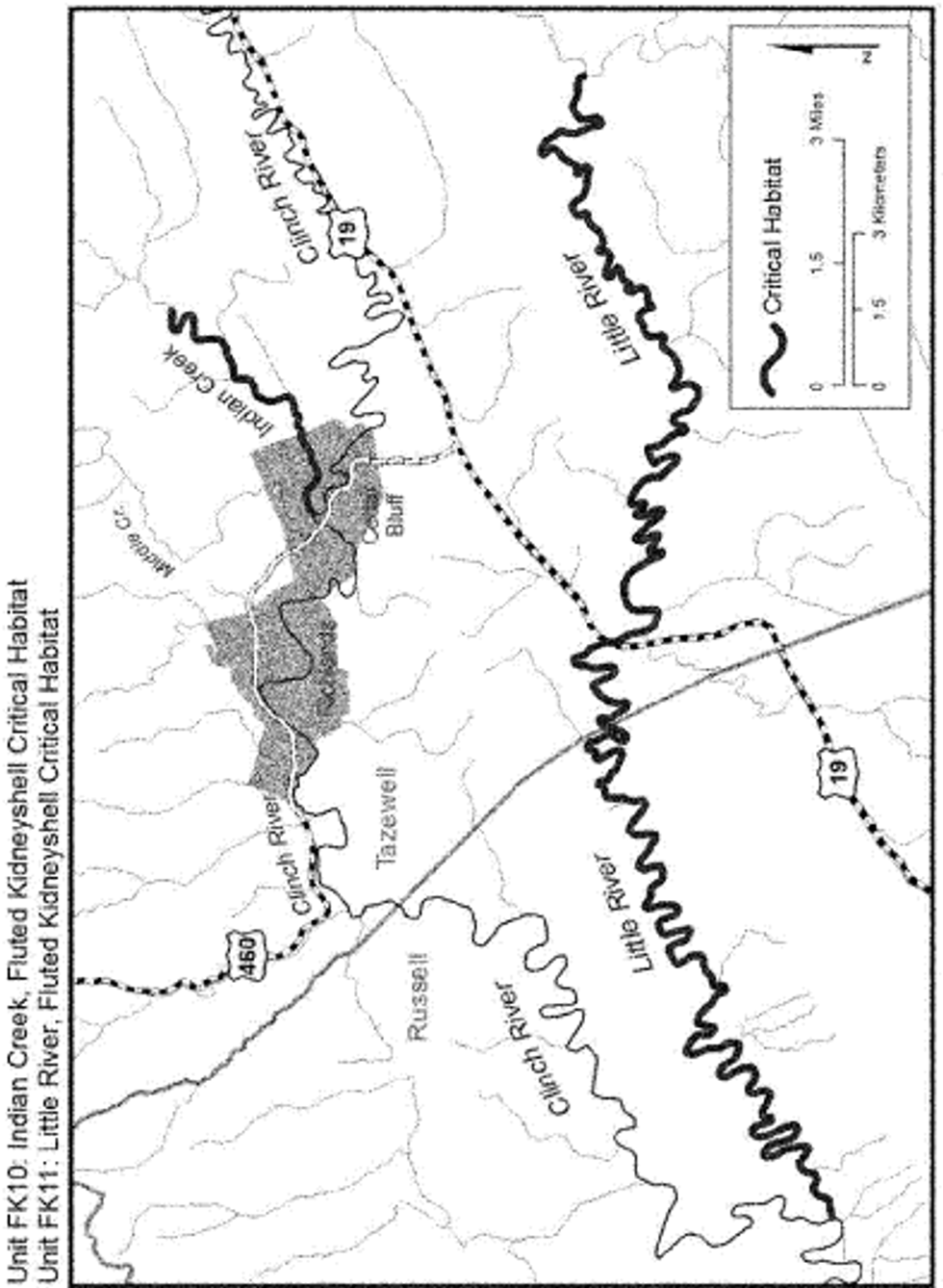
(16) Unit FK11: Little River, Russell and Tazewell Counties, Virginia.
(i) The unit includes approximately 50 rkm (31 rmi) of Little River from its confluence with the Clinch River (−81.92582, 37.00223) in Russell County, VA, upstream to its confluence with Liberty and Maiden Spring Creeks (−81.67240, 37.03760) in Tazewell County, VA.
(ii) Map of Units FK10 and FK11 is provided at paragraph (15)(ii) of this entry.
(17) Unit FK12: North Fork Holston River, Smyth and Bland Counties, Virginia.
(i) The unit includes approximately 67 rkm (42 rmi) of the North Fork Holston River from its confluence with Beaver Creek (−81.70277, 36.90825), upstream of Saltville, in Smyth County, VA, upstream to Ceres (−81.33775, 37.01035), Bland County, VA.
(ii) Map of Unit FK12 follows:
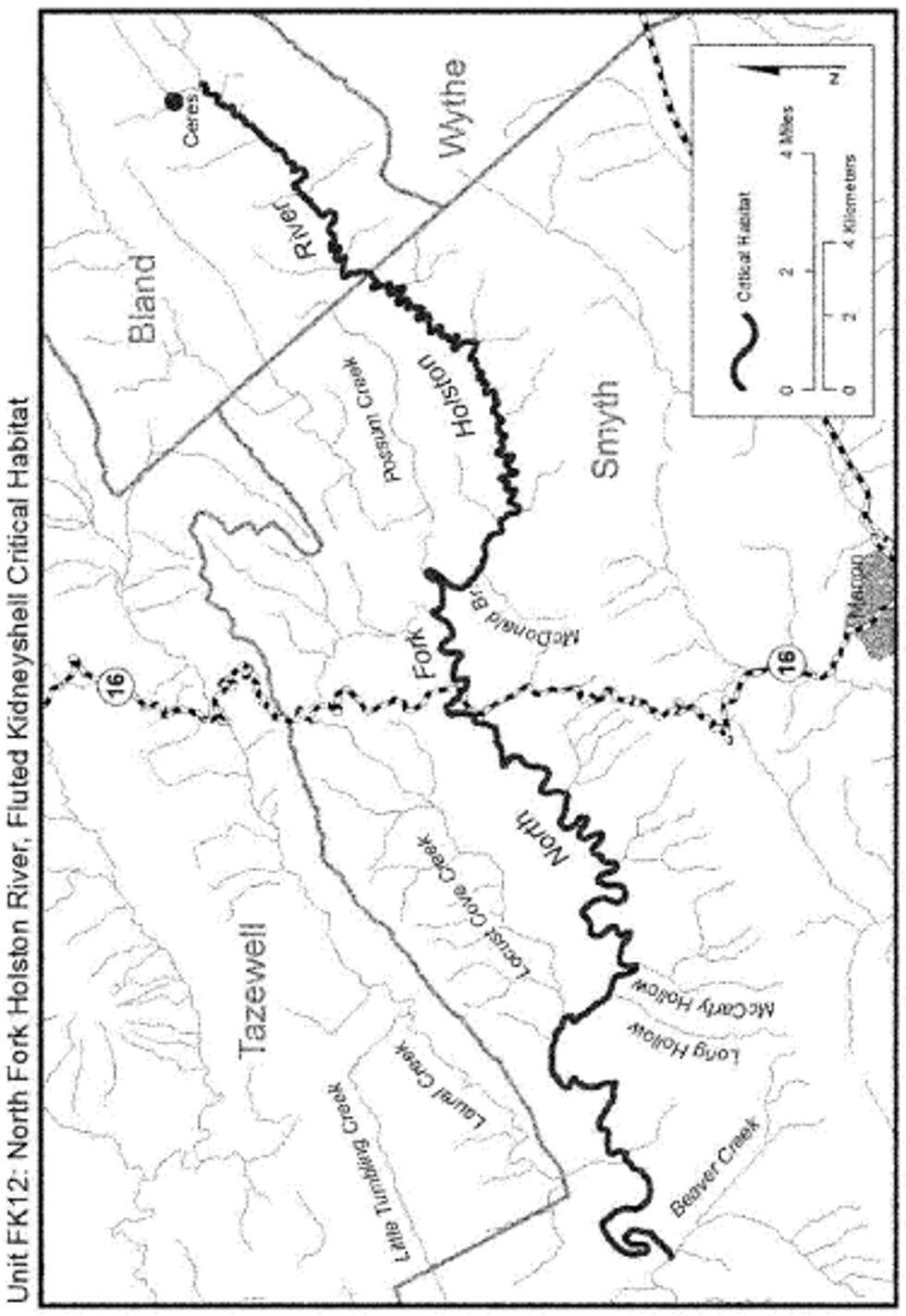
(18) Unit FK13: Middle Fork Holston River, Washington, Smyth, and Wythe Counties, Virginia.
(i) The unit includes approximately 89 rkm (55 rmi) of the Middle Fork Holston River from its inundation at South Holston Lake (−81.90427, 36.66338) in Washington County, VA, upstream to its headwaters (−81.31345, 36.88666) in Wythe County, VA.
(ii) Map of Unit FK13 follows:
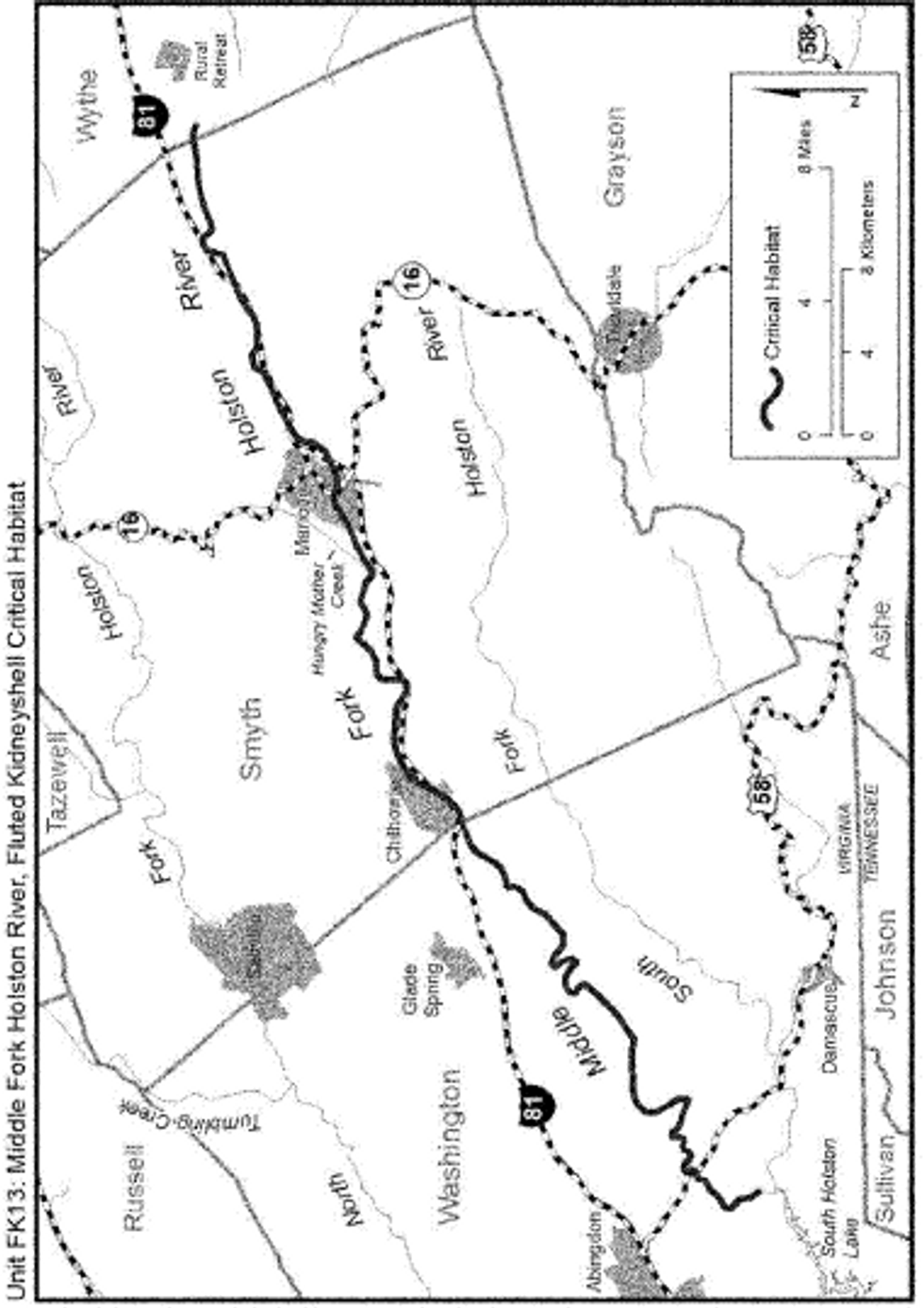
(19) Unit FK14: Big Moccasin Creek, Scott and Russell Counties, Virginia.
(i) The unit includes approximately 33 rkm (21 rmi) of Big Moccasin Creek from the Highway 71 Bridge crossing (−82.48361, 36.69109) in Scott County, VA, upstream to the Route 612 Bridge crossing (−82.32348, 36.73740) near Collinwood in Russell County, VA.
(ii) Map of Unit FK14 follows:
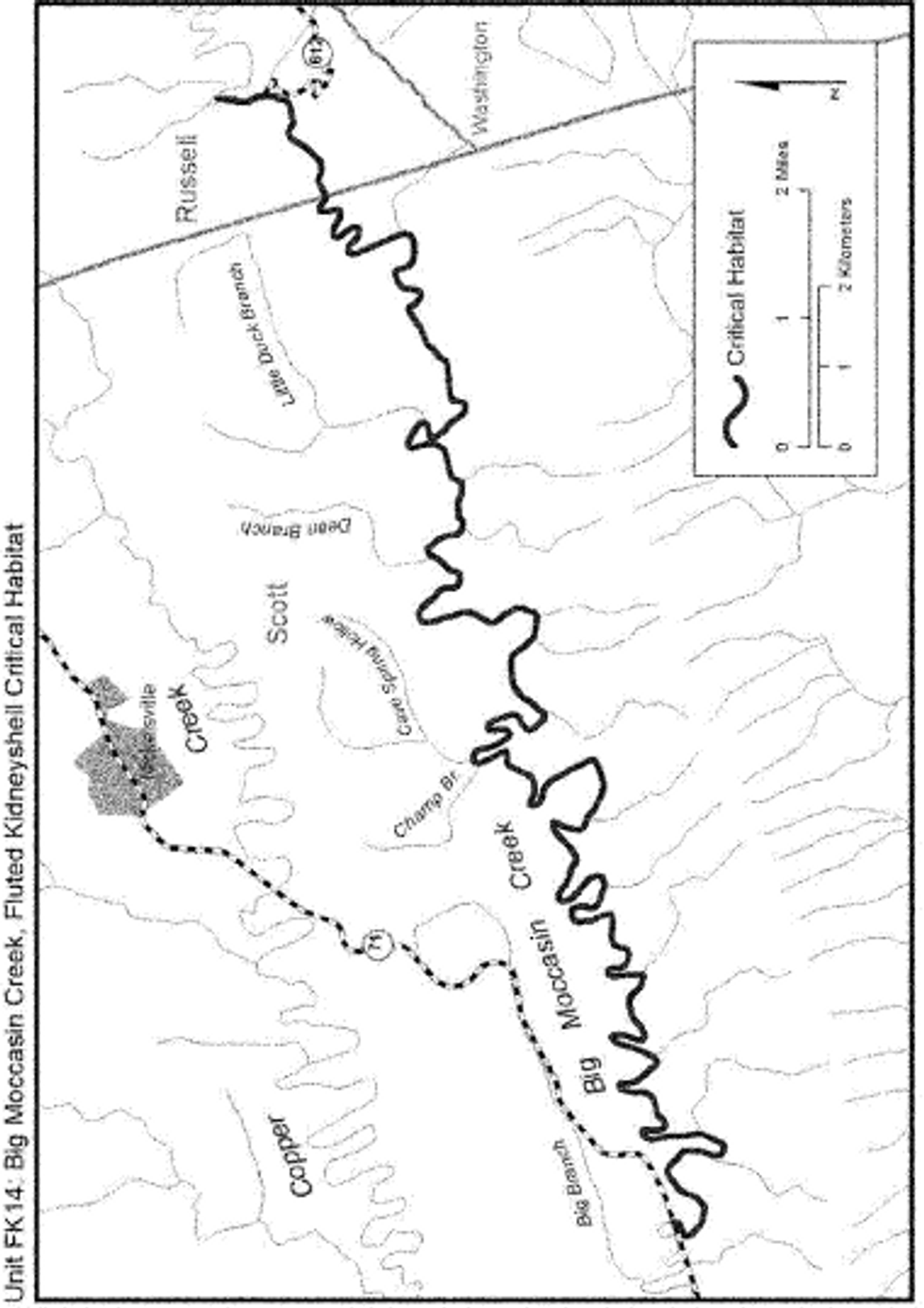
(20) Unit FK15: Copper Creek, Scott County, Virginia.
(i) The unit includes 55.5 rkm (34.5 rmi) of Copper Creek from its confluence with the Clinch River (−82.74538, 36.65544) upstream to the Highway 71 Bridge crossing (−82.43514, 36.73473) in Scott County, VA.
(ii) Map of Unit FK15 follows:
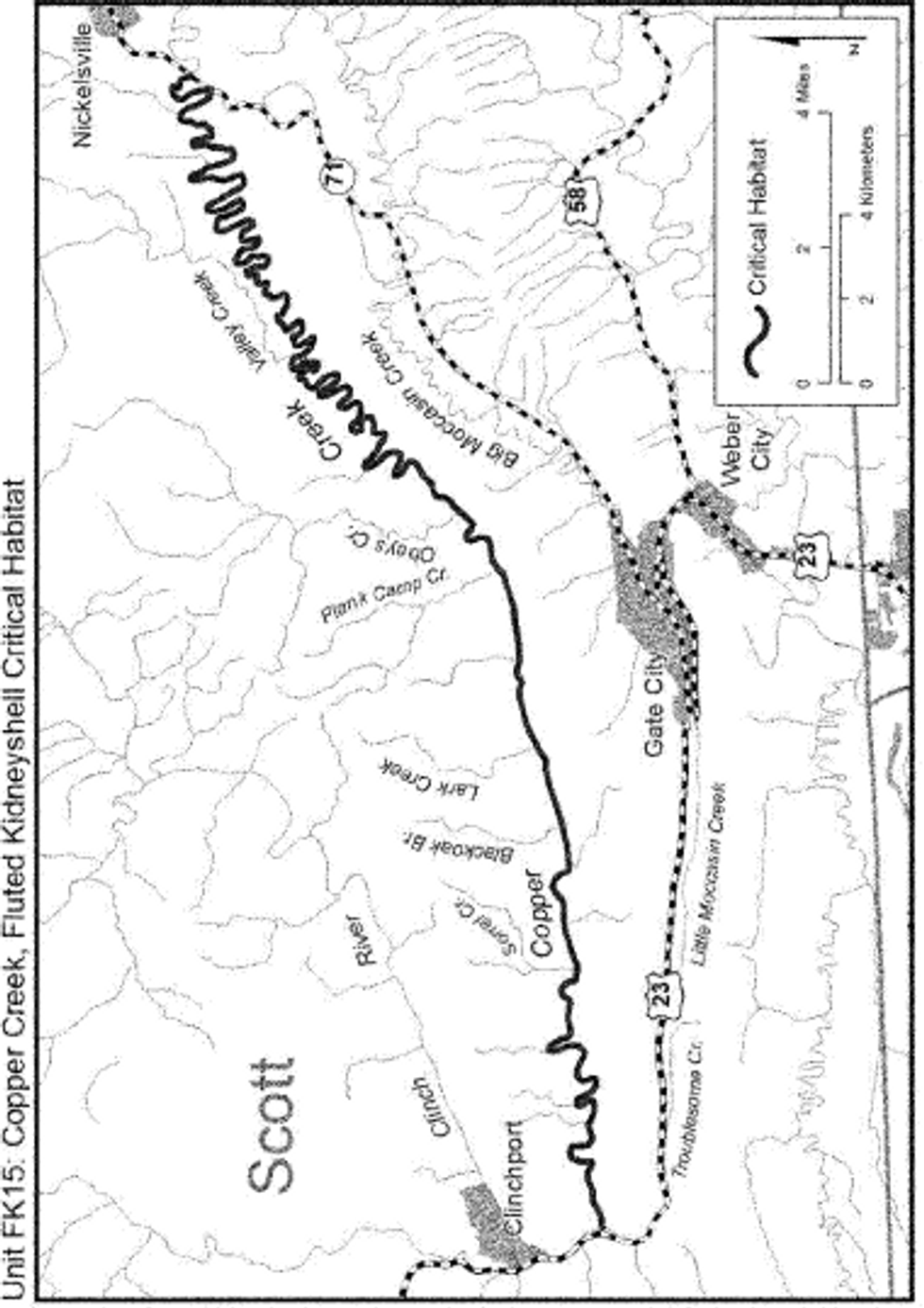
(21) Unit FK16: Clinch River, Hancock County, Tennessee, and Scott, Russell, and Tazewell Counties, Virginia.
(i) The unit includes approximately 263 rkm (163 rmi) of the Clinch River from rkm 255 (rmi 159) immediately below Grissom Island (−83.40106, 36.43081) in Hancock County, TN, upstream to its confluence with Indian Creek near Cedar Bluff (−81.74999, 37.07995), Tazewell County, VA.
(ii) Map of Unit FK16 follows:
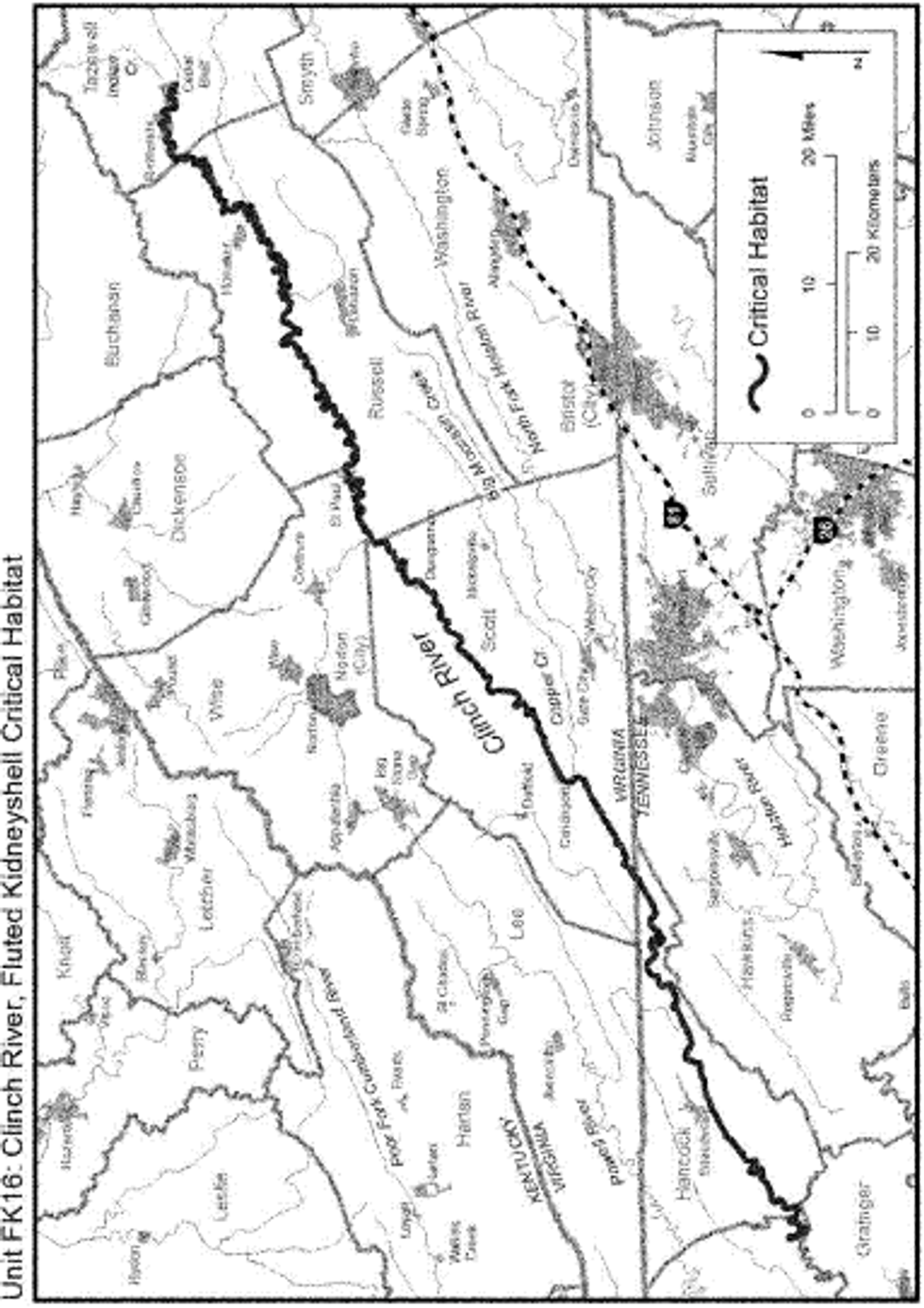
(22) Unit FK17: Powell River, Claiborne and Hancock Counties, Tennessee, and Lee County, Virginia.
(i) The unit includes approximately 153 rkm (95 rmi) of the Powell River from the U.S. 25E Bridge (−83.63102, 36.54143) in Claiborne County, TN, upstream to rkm 256 (rmi 159) (−82.98111, 36.75730, upstream of Rock Island in the vicinity of Pughs) in Lee County, VA.
(ii) Map of Unit FK17 follows:

(23) Unit FK18: Nolichucky River, Cocke, Hamblen, and Greene Counties, Tennessee.
(i) The unit includes approximately 52 rkm (32 rmi) of the Nolichucky River from rkm 14 (rmi 9), approximately 0.6 rkm (0.4 rmi) upstream of Enka Dam (−83.19630, 36.12970), where it divides Hamblen and Cocke Counties, TN, upstream to its confluence with Pigeon Creek, just upstream of the Highway 321 Bridge crossing (−82.92926, 36.07545), in Greene County, TN.
(ii) Map of Unit FK18 follows:
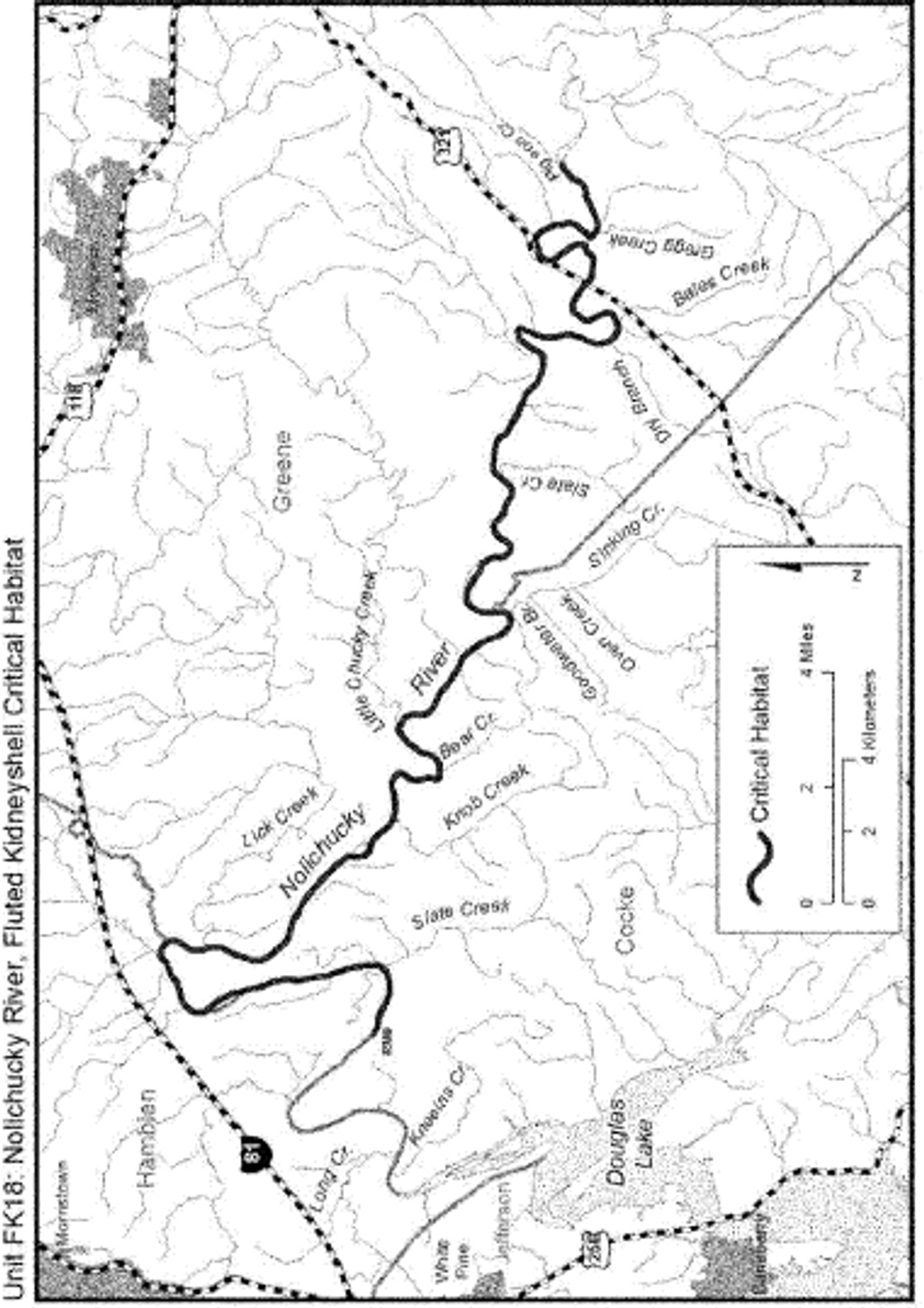
(24) Unit FK19: Holston River, Knox, Grainger, and Jefferson Counties, Tennessee.
(i) The unit includes approximately 85 rkm (53 rmi) of the Holston River from its confluence with the French Broad River (−83.84967, 35.95903) in Knox County, TN, upstream to the base of Cherokee Dam at rkm 83.7 (rmi 52.3) (−83.49855, 36.16666) along the Grainger and Jefferson County, TN, line.
(ii) Map of Units FK19 and FK20 follows:
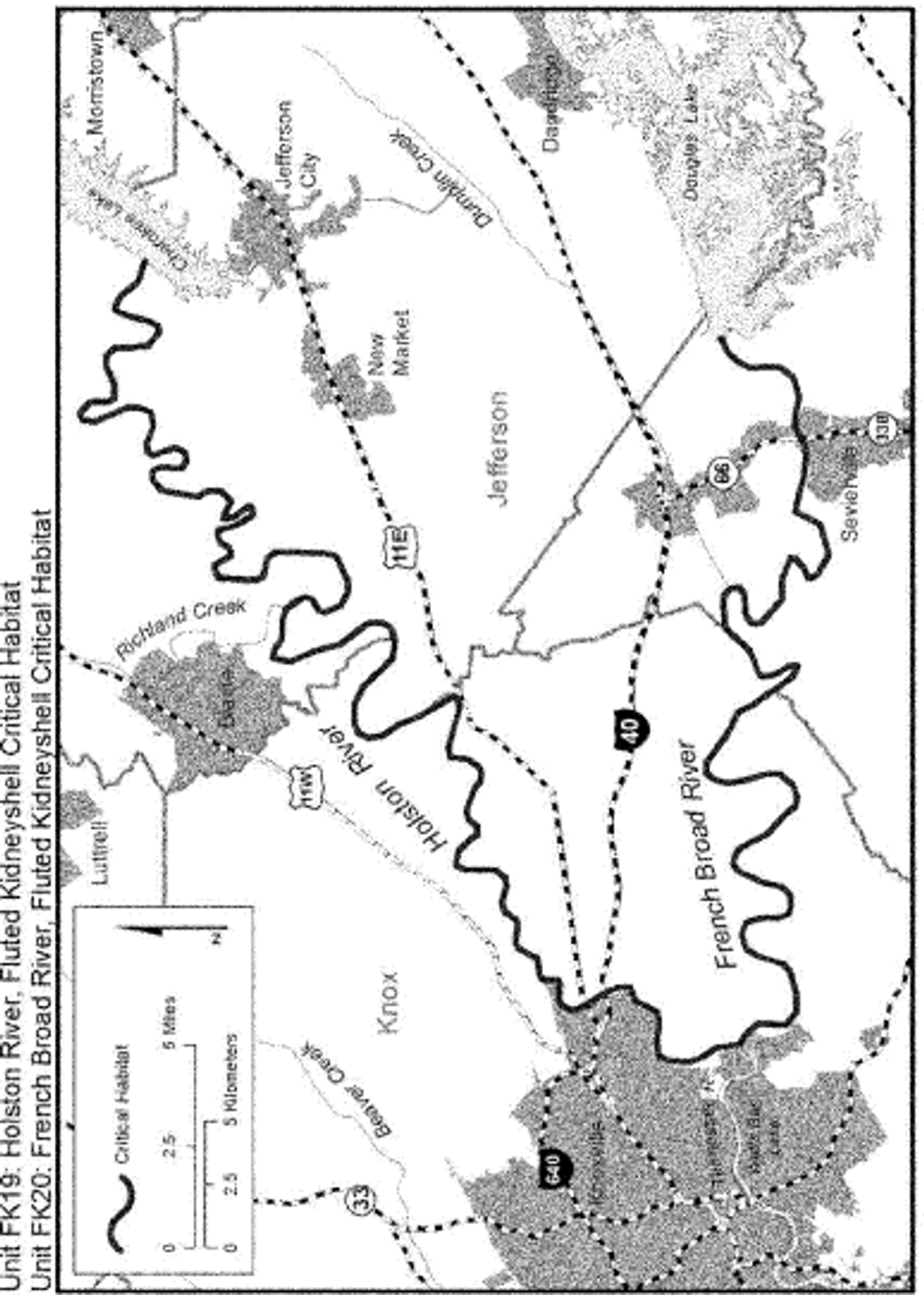
(25) Unit FK20: French Broad River, Knox and Sevier Counties, Tennessee.
(i) The unit includes approximately 56 rkm (35 rmi) of the French Broad River from its confluence with the Holston River (−83.84967, 35.95903) in Knox County, TN, upstream to the base of Douglas Dam at rkm 51.7 (rmi 32.3) (−83.53821, 35.96073) in Sevier County, TN.
(ii) Map of Units FK19 and FK20 is provided at paragraph (24)(ii) of this entry.
(26) Unit FK21: Hiwassee River, Polk County, Tennessee.
(i) The unit includes approximately 24 rkm (15 rmi) of the Hiwassee River from the Highway 315 Bridge crossing (−84.50234, 35.18875) upstream to the Highway 68 Bridge crossing (−84.31728, 35.16811) in Polk County, TN.
(ii) Map of Unit FK21 follows:
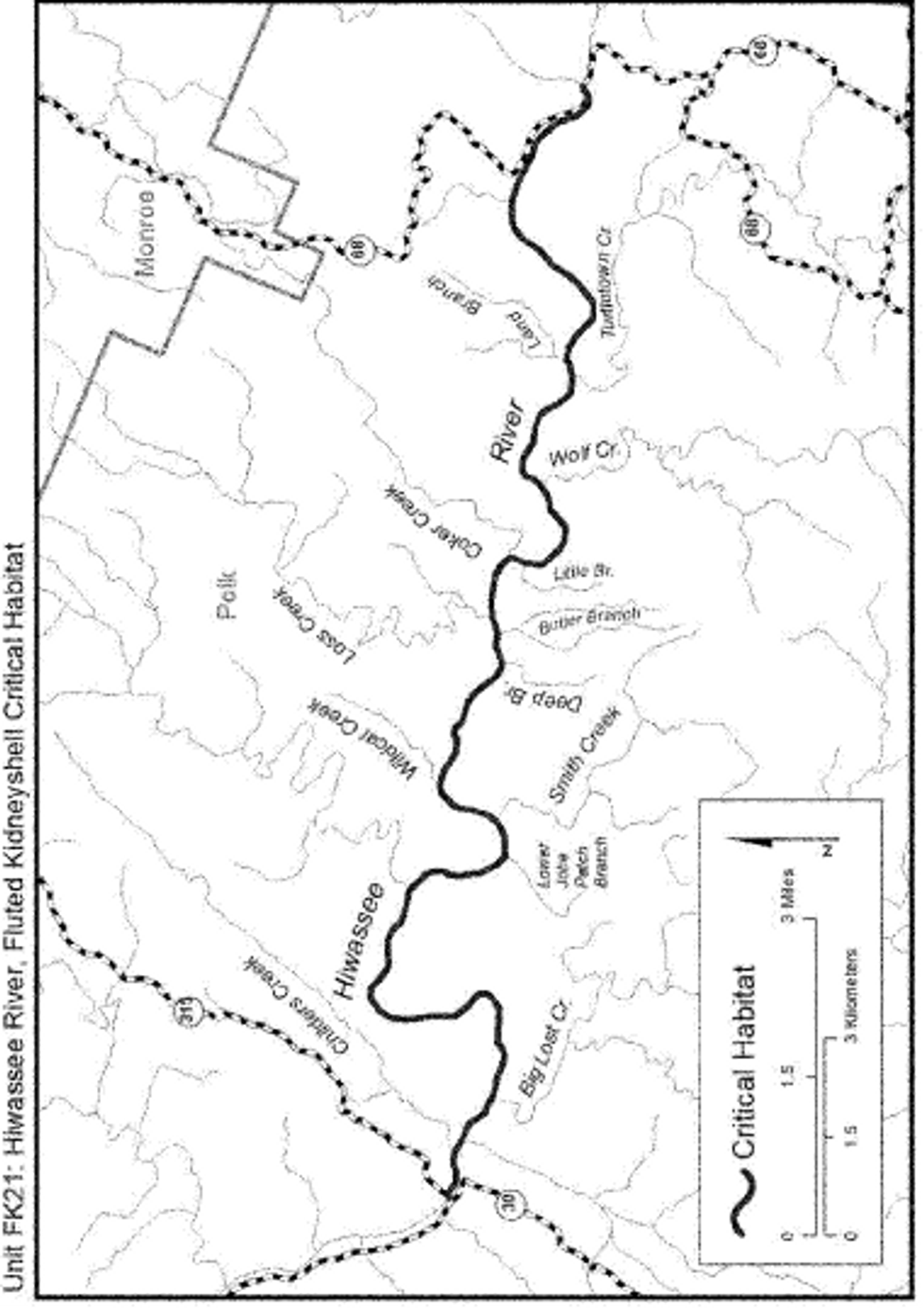
(27) Unit FK22: Elk River, Limestone County, Alabama, and Giles, Lincoln, Franklin, and Moore Counties, Tennessee.
(i) The unit includes approximately 164 rkm (102 rmi) of the Elk River from its inundation at Wheeler Lake (−87.06503, 34.89788) in Limestone County, AL, upstream to its confluence with Farris Creek (−86.31996, 35.16288) at the dividing line between Franklin and Moore Counties, TN.
(ii) Map of Unit FK22 follows:
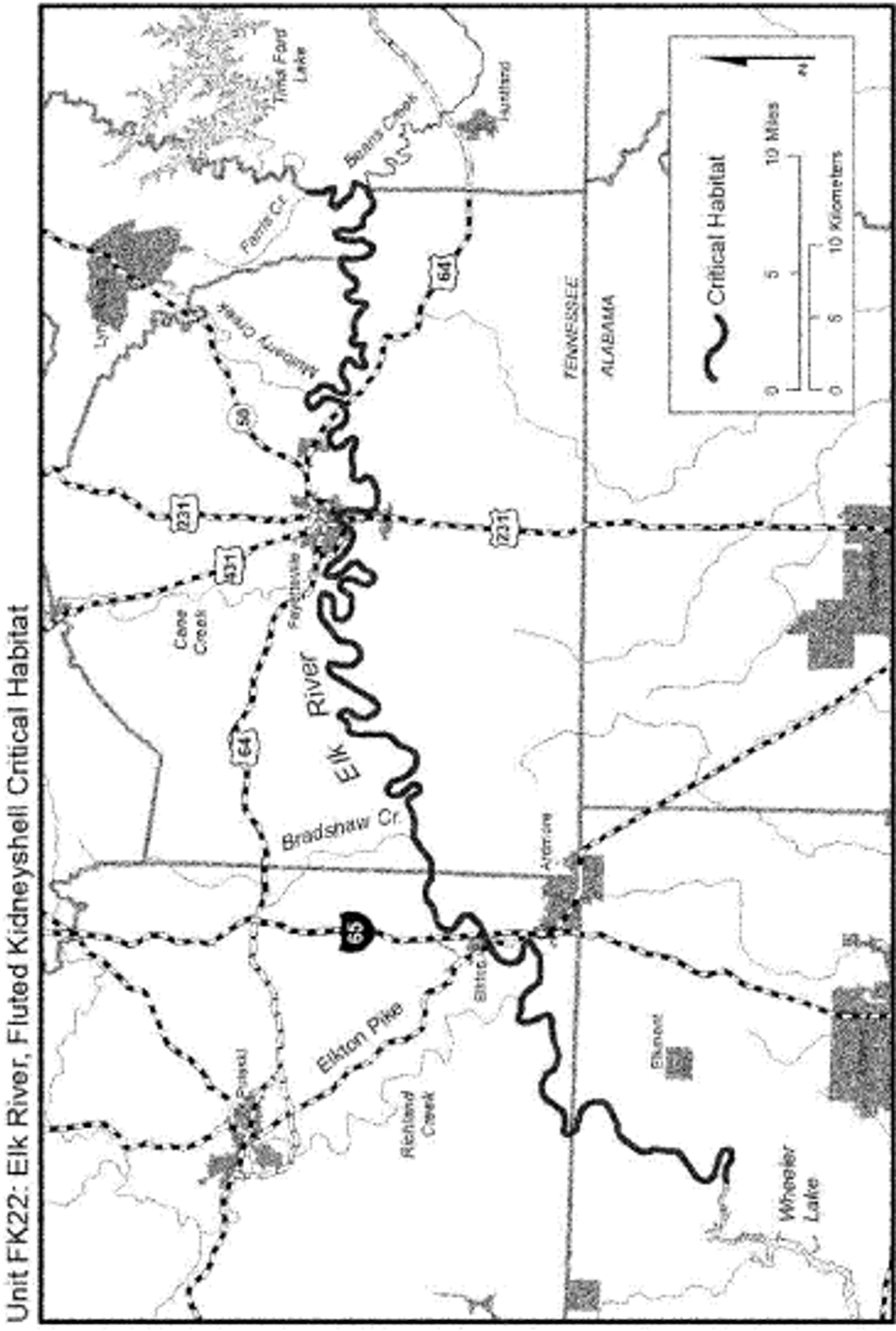
(28) Unit FK23: Duck River, Humphreys, Perry, Hickman, Maury, Marshall, and Bedford Counties, Tennessee.
(i) The unit includes approximately 348 rkm (216 rmi) of the Duck River from its inundation at Kentucky Lake (−87.88011, 36.00244) in Humphreys County, TN, upstream to its confluence with Flat Creek (−86.48778, 35.47209) near Shelbyville in Bedford County, TN.
(ii) Map of Unit FK23 follows:
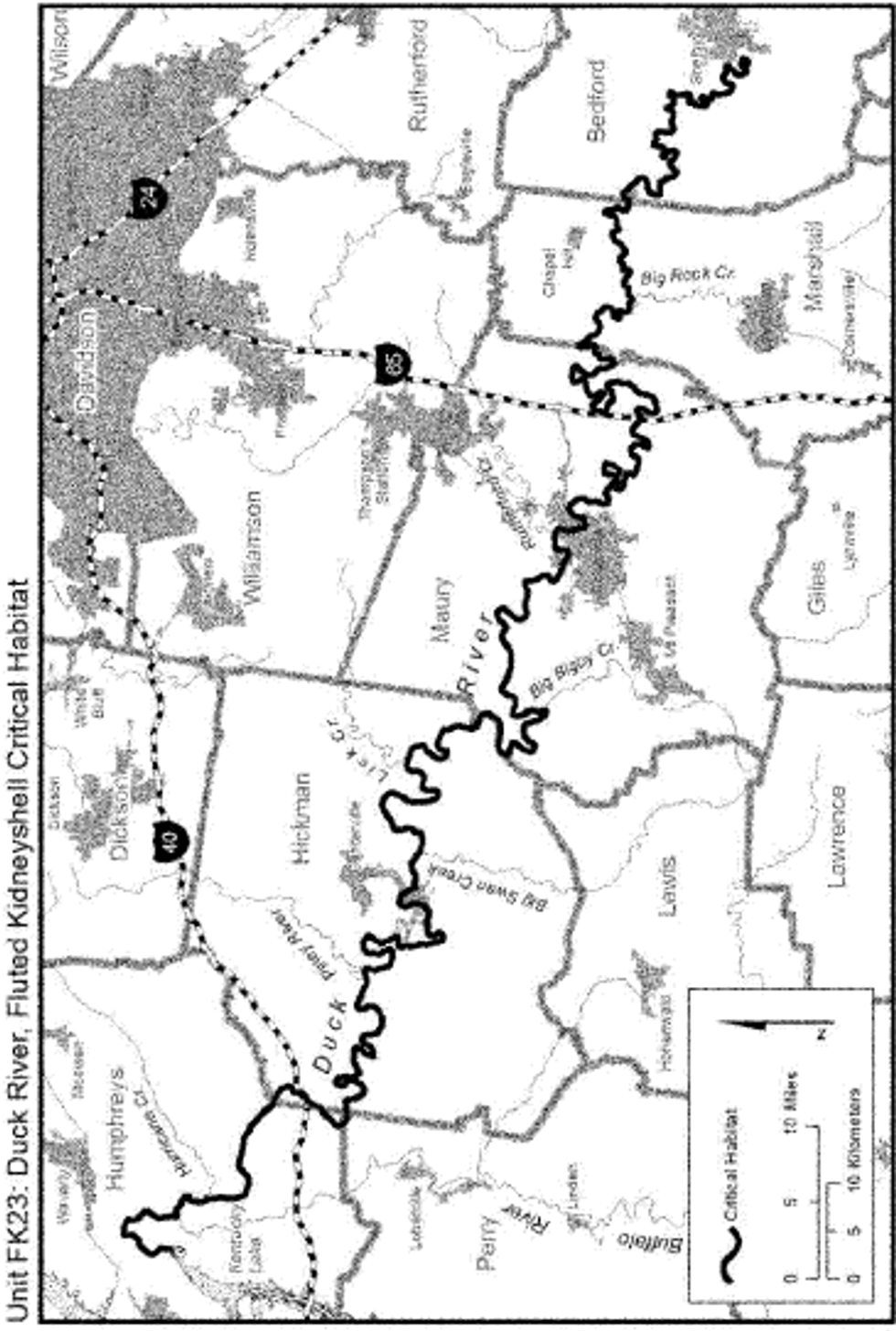
(29) Unit FK24: Buffalo River, Humphreys and Perry Counties, Tennessee.
(i) The unit includes 50 rkm (31 rmi) of the Buffalo River from its confluence with the Duck River (−87.84261, 35.99477) in Humphreys County, TN, upstream to its confluence with Cane Creek (−87.78718, 35.72298) in Perry County, TN.
(ii) Map of Unit FK24 follows:
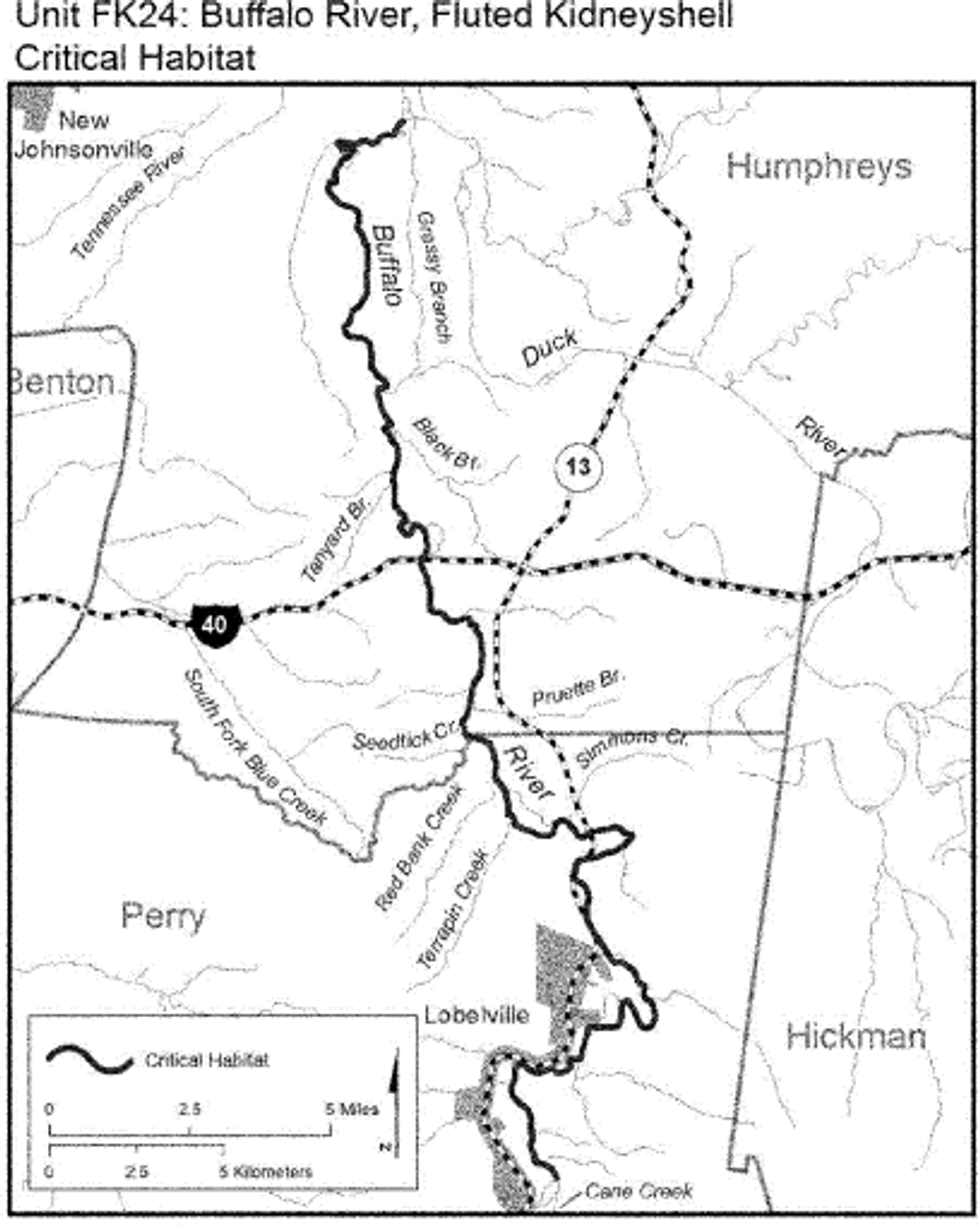
Suwannee Moccasinshell (Medionidus walkeri)
(1) Critical habitat units are depicted on the maps in this entry for Alachua, Bradford, Columbia, Dixie, Gilchrist, Hamilton, Lafayette, Madison, Suwannee, and Union Counties, Florida; and Brooks and Lowndes Counties, Georgia.
(2) Within these areas, the physical or biological features essential to the conservation of Suwannee moccasinshell consist of the following components:
(i) Geomorphically stable stream channels (channels that maintain lateral dimensions, longitudinal profiles, and sinuosity patterns over time without an aggrading or degrading bed elevation).
(ii) Stable substrates of muddy sand or mixtures of sand and gravel, and with little to no accumulation of unconsolidated sediments and low amounts of filamentous algae.
(iii) A natural hydrologic flow regime (magnitude, frequency, duration, and seasonality of discharge over time) necessary to maintain benthic habitats where the species is found, and connectivity of stream channels with the floodplain, allowing the exchange of nutrients and sediment for habitat maintenance, food availability, and spawning habitat for native fishes.
(iv) Water quality conditions needed to sustain healthy Suwannee moccasinshell populations, including low pollutant levels (not less than State criteria), a natural temperature regime, pH (between 6.0 to 8.5), adequate oxygen content (not less than State criteria), hardness, turbidity, and other chemical characteristics necessary for normal behavior, growth, and viability of all life stages.
(v) The presence of fish hosts necessary for recruitment of the Suwannee moccasinshell. The presence of blackbanded darters (Percina nigrofasciata) and brown darters (Etheostoma edwini) will serve as an indication of fish host presence.
(3) Critical habitat does not include manmade structures (such as buildings, aqueducts, dams, roads, and other paved areas) and the land on which they are located existing within the legal boundaries on August 2, 2021.
(4) Data layers defining map units were created with U.S. Geological Survey National Hydrography Dataset GIS data. The high-resolution 1:24,000 flowlines were used to calculate river kilometers and miles. ESRIs ArcGIS 10.2.2 software was used to determine longitude and latitude coordinates using decimal degrees. The projection used in mapping all units was Universal Transverse Mercator, NAD 83, Zone 16 North. The maps in this entry, as modified by any accompanying regulatory text, establish the boundaries of the critical habitat designation. The coordinates on which each map is based are available at http://www.regulations.gov at Docket No. FWS-R4-ES-2019-0059, the Service's internet site (https://www.fws.gov/panamacity), and at the field office responsible for this designation. You may obtain field office location by contacting one of the Service regional offices, the addresses of which are listed at 50 CFR 2.2.
(5) Note: Index map of critical habitat units for the Suwannee moccasinshell in Florida and Georgia follows:
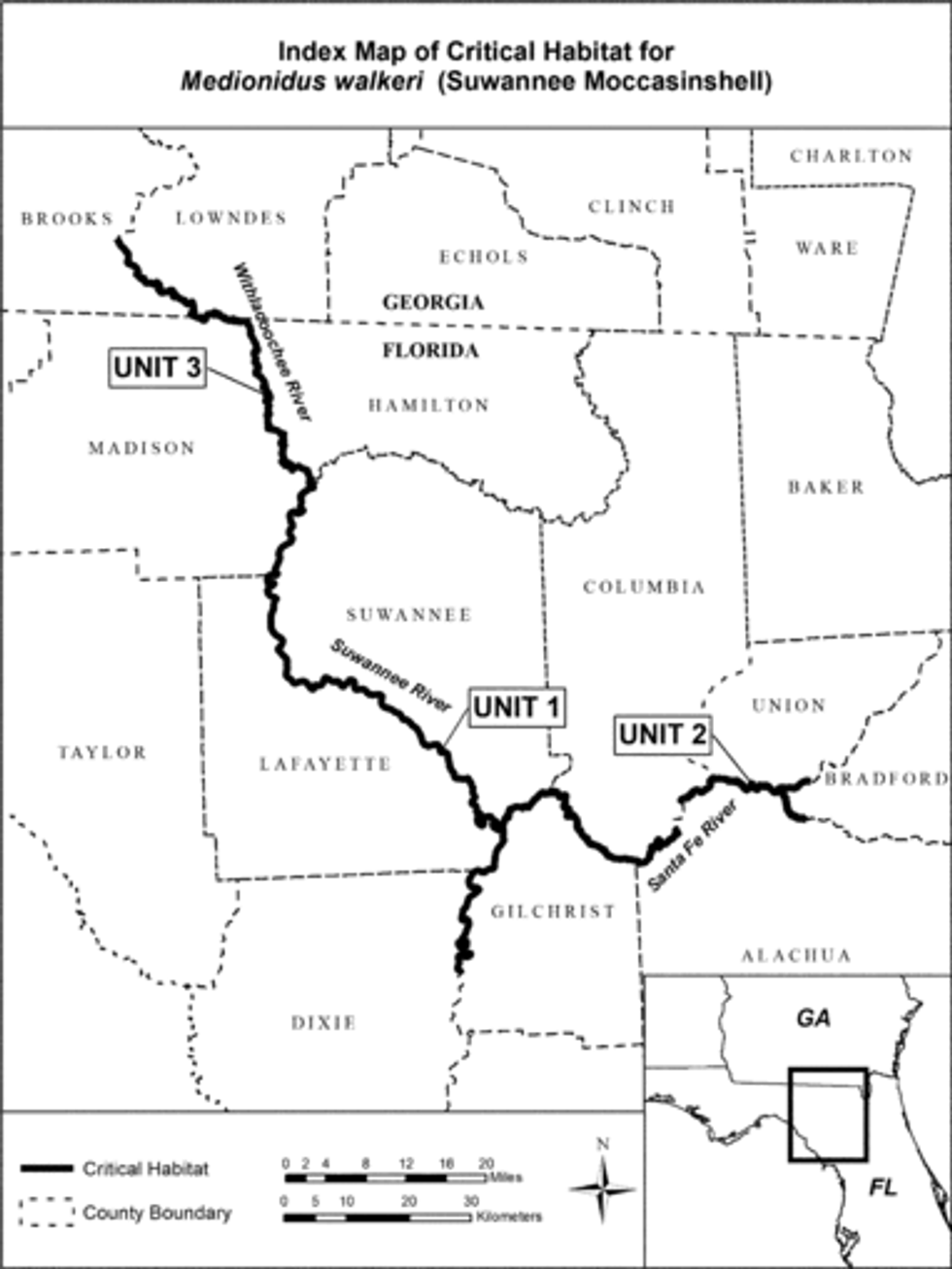
(6) Unit 1: Suwannee River in Alachua, Columbia, Dixie, Gilchrist, Lafayette, Madison, and Suwannee Counties, Florida.
(i) Unit 1 consists of approximately 187 kilometers (km) (116 miles (mi)) of the Suwannee River and lower Santa Fe River in Alachua, Columbia, Dixie, Gilchrist, Lafayette, Madison, and Suwannee Counties, Florida. The unit includes the Suwannee River mainstem from the confluence of Hart Springs in Dixie and Gilchrist Counties, upstream 137 km (85 mi) to the confluence of the Withlacoochee River in Madison and Suwannee Counties; and the Santa Fe River from its confluence with the Suwannee River in Suwannee and Gilchrist Counties, upstream 50 km (31 mi) to the river's rise (the Santa Fe River runs underground for more than 3 miles, emerging at River Rise Preserve State Park) in Alachua County.
(ii) Map of Unit 1, Suwannee River, follows:
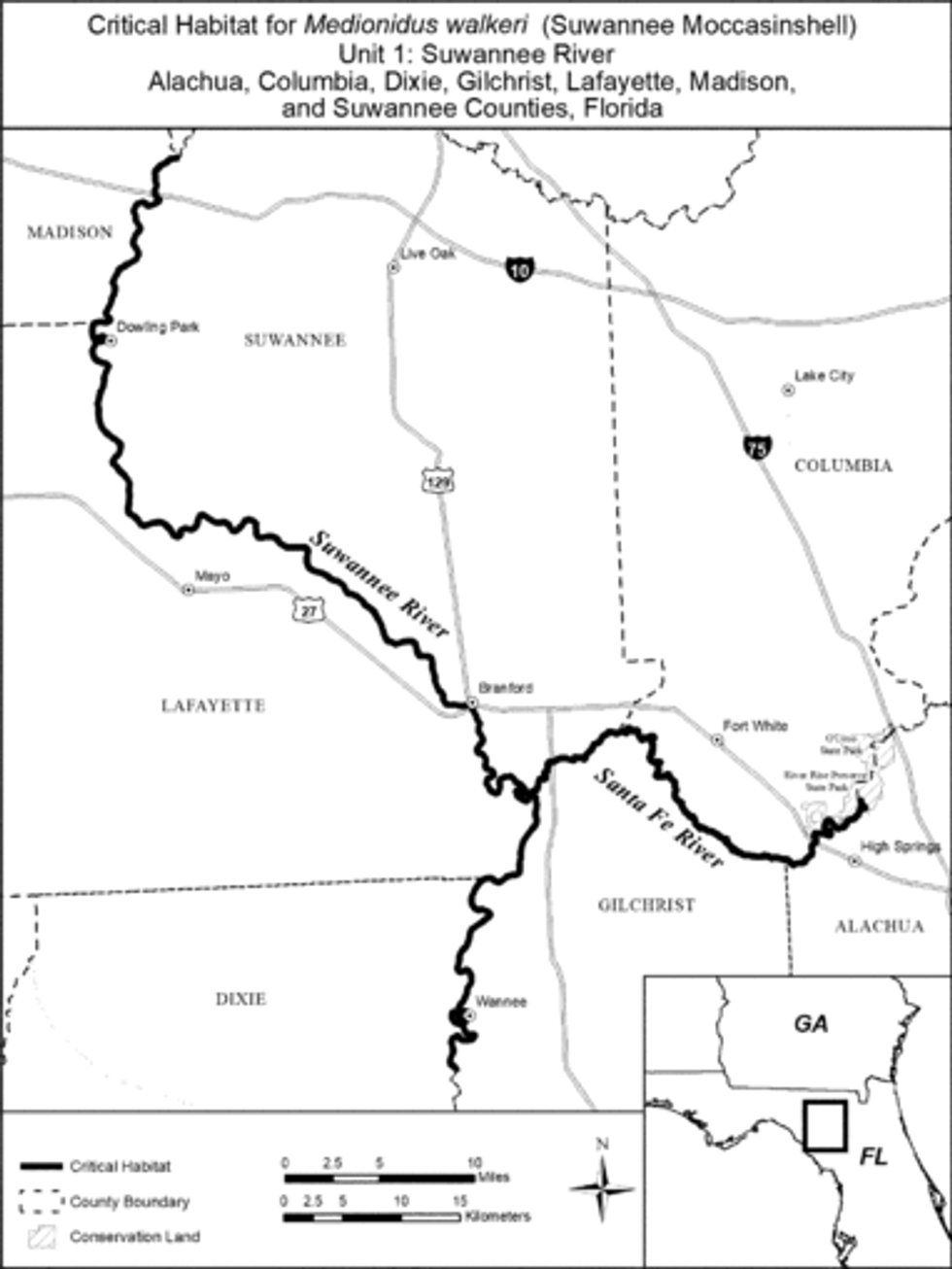
(7) Unit 2: Upper Santa Fe River in Alachua, Bradford, Columbia, and Union, Counties, Florida.
(i) The Upper Santa Fe River Unit consists of approximately 43 km (27 mi) of the Santa Fe River and New River in Alachua, Bradford, Columbia, and Union Counties, Florida. The unit includes the Santa Fe River from the river's sink in Alachua County, upstream 36.5 km (23 mi) to the confluence of Rocky Creek in Bradford and Alachua Counties; and the New River from its confluence with the Santa Fe River, upstream 6.5 km (4 mi) to the confluence of Five Mile Creek in Union and Bradford Counties.
(ii) Map of Unit 2, Upper Santa Fe River, follows:
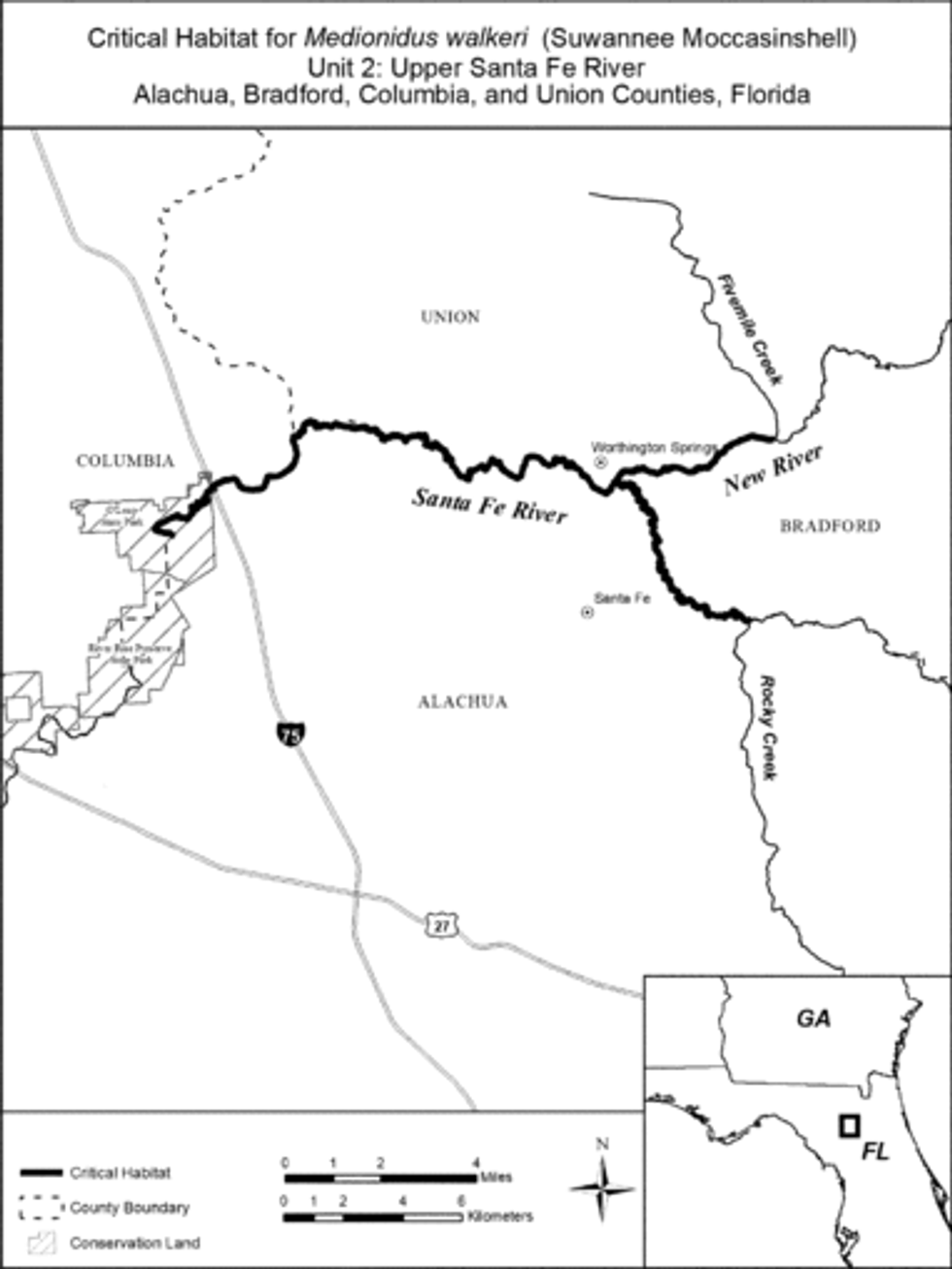
(8) Unit 3: Withlacoochee River in Hamilton and Madison Counties, Florida; Brooks and Lowndes Counties, Georgia.
(i) The Withlacoochee River Unit consists of approximately 75.5 km (47 mi) of the Withlacoochee River in Hamilton and Madison Counties, Florida, and Brooks and Lowndes Counties, Georgia. The unit includes the Withlacoochee River from its confluence with the Suwannee River in Madison and Hamilton Counties, FL, upstream 75.5 km (47 mi) to the confluence of Okapilco Creek in Brooks and Lowndes Counties, GA.
(ii) Map of Unit 3, Withlacoochee River, follows:
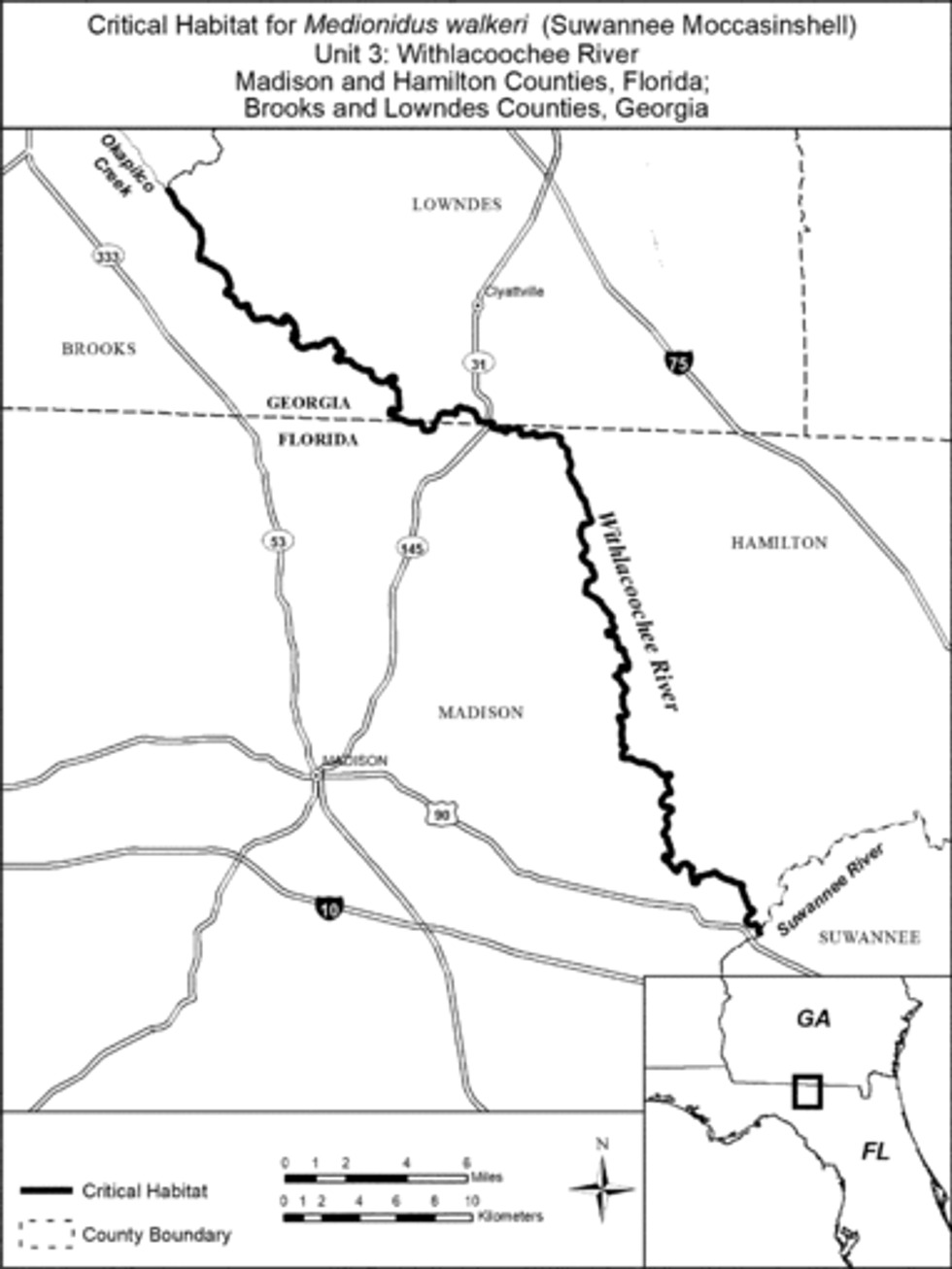
Slabside Pearlymussel (Pleuronaia dolabelloides)
(1) Critical habitat units are depicted on the maps below for Colbert, Jackson, Limestone, Madison, and Marshall Counties, Alabama; Tishomingo County, Mississippi; Bedford, Bledsoe, Claiborne, Cocke, Franklin, Giles, Greene, Hamblen, Hancock, Hickman, Humphreys, Lincoln, Marion, Marshall, Maury, Moore, Perry, Polk, and Sequatchie Counties, Tennessee; and Bland, Lee, Russell, Scott, Smyth, Tazewell, Washington, and Wythe Counties, Virginia.
(2) Within these areas, the primary constituent elements of the physical or biological features essential to the conservation of slabside pearlymussel consist of five components:
(i) Riffle habitats within large, geomorphically stable stream channels (channels that maintain lateral dimensions, longitudinal profiles, and sinuosity patterns over time without an aggrading or degrading bed elevation).
(ii) Stable substrates of sand, gravel, and cobble with low to moderate amounts of fine sediment and containing flow refugia with low shear stress.
(iii) A natural hydrologic flow regime (magnitude, frequency, duration, and seasonality of discharge over time) necessary to maintain benthic habitats where the species is found, and connectivity of rivers with the floodplain, allowing the exchange of nutrients and sediment for habitat maintenance, food availability for all life stages, and spawning habitat for native fishes.
(iv) Water quality with low levels of pollutants and including a natural temperature regime, pH (between 6.0 to 8.5), oxygen content (not less than 5.0 milligrams/liter), hardness, and turbidity necessary for normal behavior, growth, and viability of all life stages.
(v) The presence of abundant fish hosts, which may include the popeye shiner, rosyface shiner, saffron shiner, silver shiner, telescope shiner, Tennessee shiner, whitetail shiner, white shiner, and eastern blacknose dace, necessary for recruitment of the slabside pearlymussel.
(3) Critical habitat does not include manmade structures (such as buildings, aqueducts, dams, roads, and other paved areas) and the land on which they are located existing within the legal boundaries on October 28, 2013.
(4) Critical habitat map units. Data layers defining map units were created with USGS National Hydrography Dataset (NHD+) GIS data. The 1:100,000 river reach (route) files were used to calculate river kilometers and miles. ESRIs ArcGIS 10.0 software was used to determine longitude and latitude coordinates using decimal degrees. The projection used in mapping all units was USA Contiguous Albers Equal Area Conic USGS version, NAD 83, meters. The following data sources were referenced to identify features (like roads and streams) used to delineate the upstream and downstream extents of critical habitat units: NHD+ flowline and waterbody data, 2011 Navteq roads data, USA Topo ESRI online basemap service, DeLorme Atlas and Gazetteers, and USGS 7.5 minute topographic maps. The maps in this entry, as modified by any accompanying regulatory text, establish the boundaries of the critical habitat designation. The coordinates or plot points or both on which each map is based are available to the public at the field office Internet site (http://www.fws.gov/cookeville), at http://www.regulations.gov at Docket No. FWS-R4-ES-2013-0026, and at the Service's Tennessee Fish and Wildlife Office. You may obtain field office location information by contacting one of the Service regional offices, the addresses of which are listed at 50 CFR 2.2.
(5) An overview of critical habitat locations for the slabside pearlymussel in Mississippi, Alabama, Tennessee, and Virginia follows:
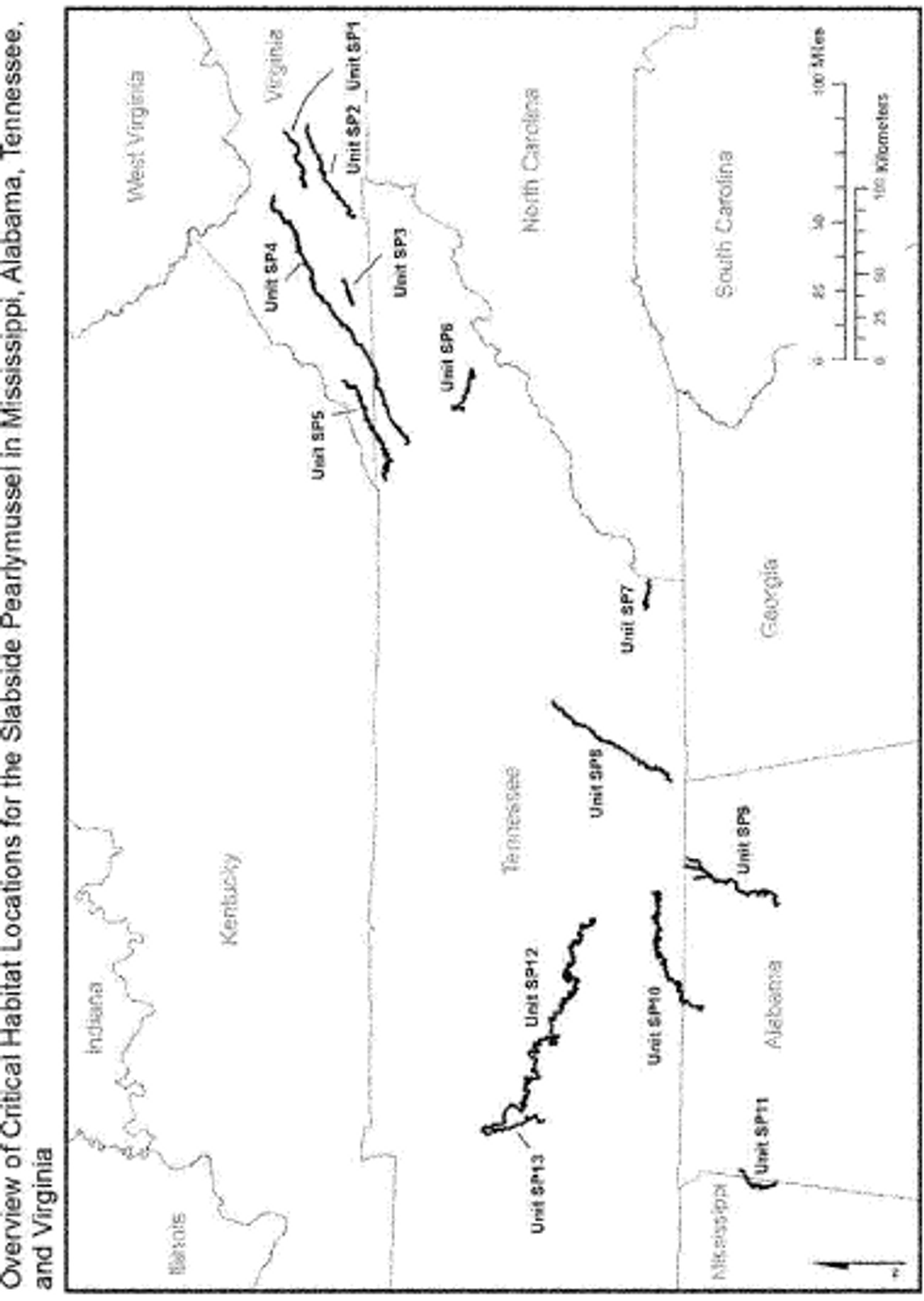
(6) Unit SP1: North Fork Holston River, Smyth and Bland Counties, Virginia.
(i) The unit includes approximately 67 river kilometers (rkm) (42 river miles (rmi)) of the North Fork Holston River from its confluence with Beaver Creek (−81.70277, 36.90825), upstream of Saltville, in Smyth County, VA, upstream to Ceres (−81.33775, 37.01035), Bland County, VA.
(ii) Map of Unit SP1 follows:
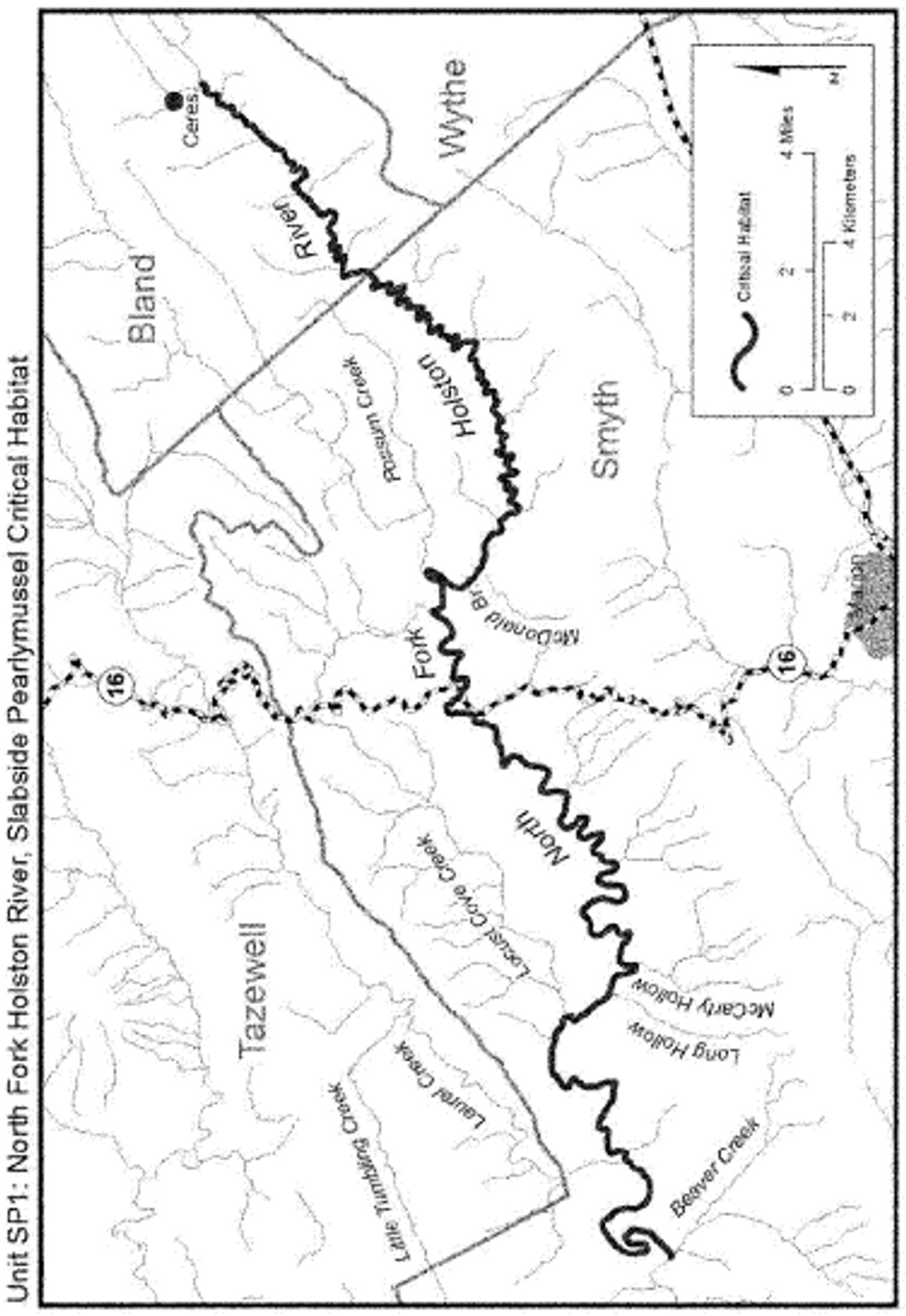
(7) Unit SP2: Middle Fork Holston River, Washington, Smyth, and Wythe Counties, Virginia.
(i) The unit includes approximately 89 rkm (55 rmi) of the Middle Fork Holston River from its inundation at South Holston Lake (−81.90427, 36.66338) in Washington County, VA, upstream to its headwaters (−81.31345, 36.88666) in Wythe County, VA.
(ii) Map of Unit SP2 follows:
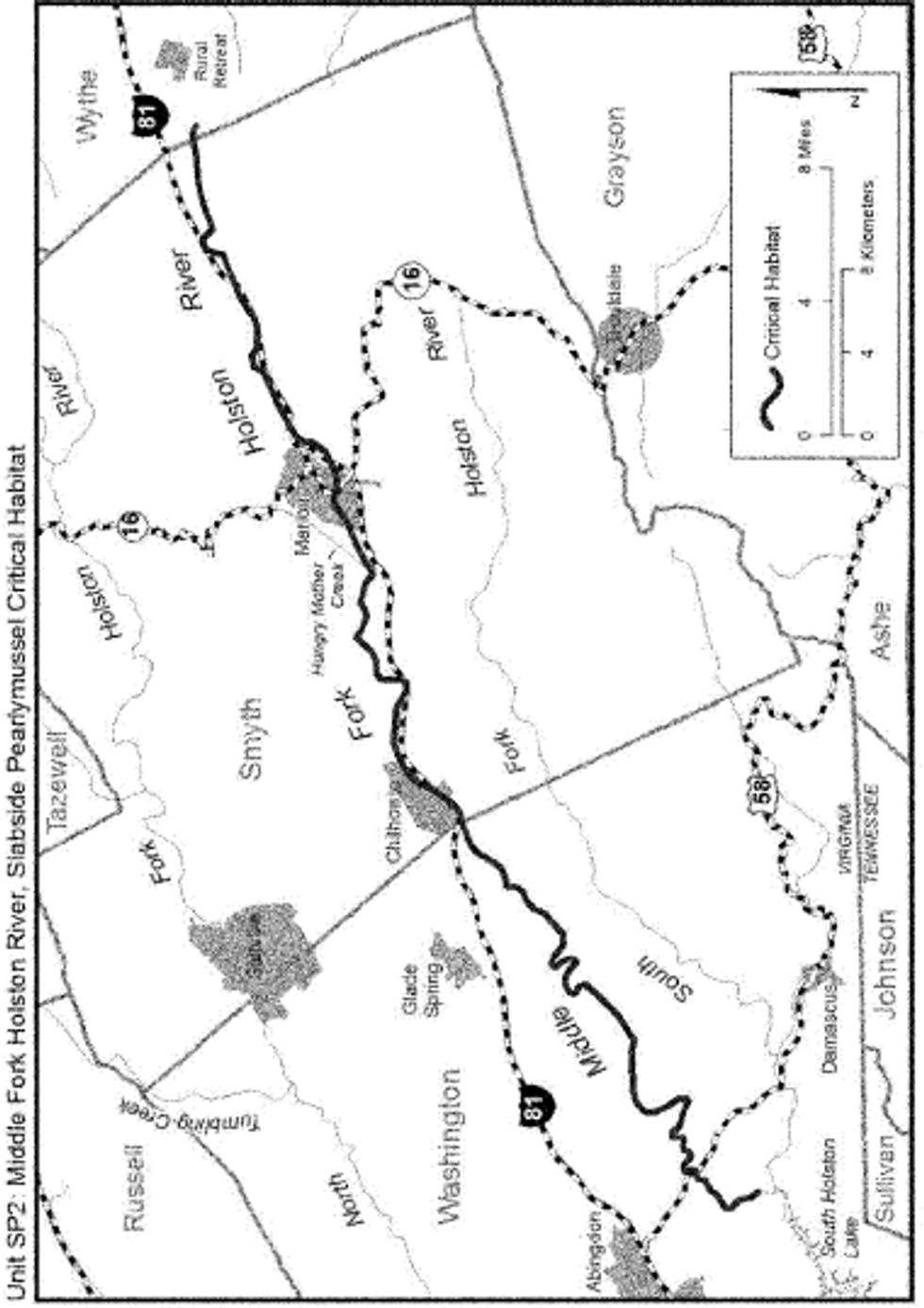
(8) Unit SP3: Big Moccasin Creek, Scott and Russell Counties, Virginia.
(i) The unit includes approximately 33 rkm (21 rmi) of Big Moccasin Creek from the Highway 71 Bridge crossing (−82.48361, 36.69109) in Scott County, VA, upstream to the Route 612 Bridge crossing (−82.32348, 36.73740) near Collinwood in Russell County, VA.
(ii) Map of Unit SP3 follows:
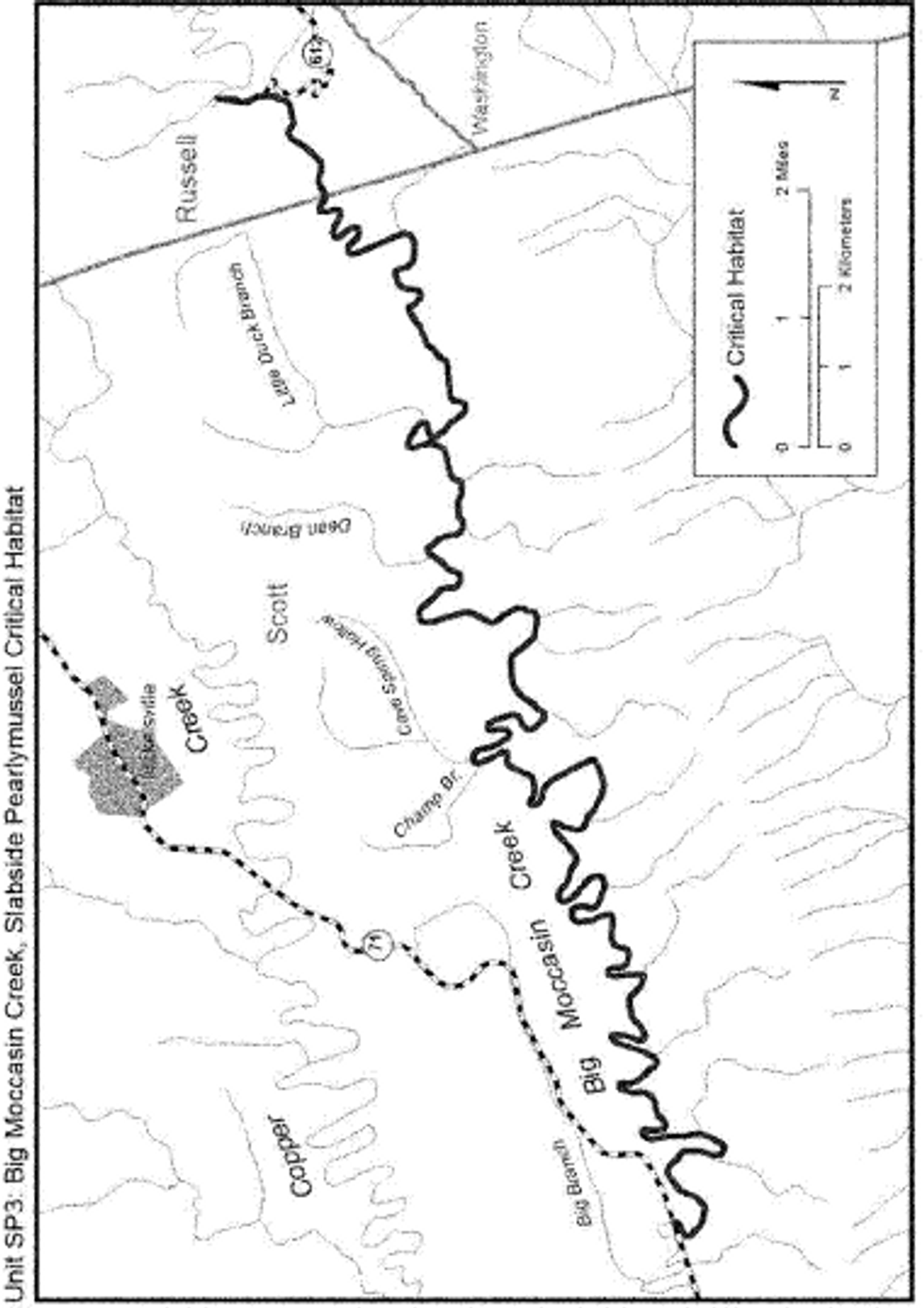
(9) Unit SP4: Clinch River, Hancock County, Tennessee, and Scott, Russell, and Tazewell Counties, Virginia.
(i) The unit includes approximately 263 rkm (163 rmi) of the Clinch River from rkm 255 (rmi 159) immediately below Grissom Island (−83.40106, 36.43081) in Hancock County, TN, upstream to its confluence with Indian Creek near Cedar Bluff (−81.74999, 37.07995), Tazewell County, VA.
(ii) Map of Unit SP4 follows:

(10) Unit SP5: Powell River, Claiborne and Hancock Counties, Tennessee, and Lee County, Virginia.
(i) The unit includes approximately 153 rkm (95 rmi) of the Powell River from the U.S. 25E Bridge (−83.63102, 36.54143) in Claiborne County, TN, upstream to rkm 256 (rmi 159) (−82.98111, 36.75730, upstream of Rock Island in the vicinity of Pughs) in Lee County, VA.
(ii) Map of Unit SP5 follows:
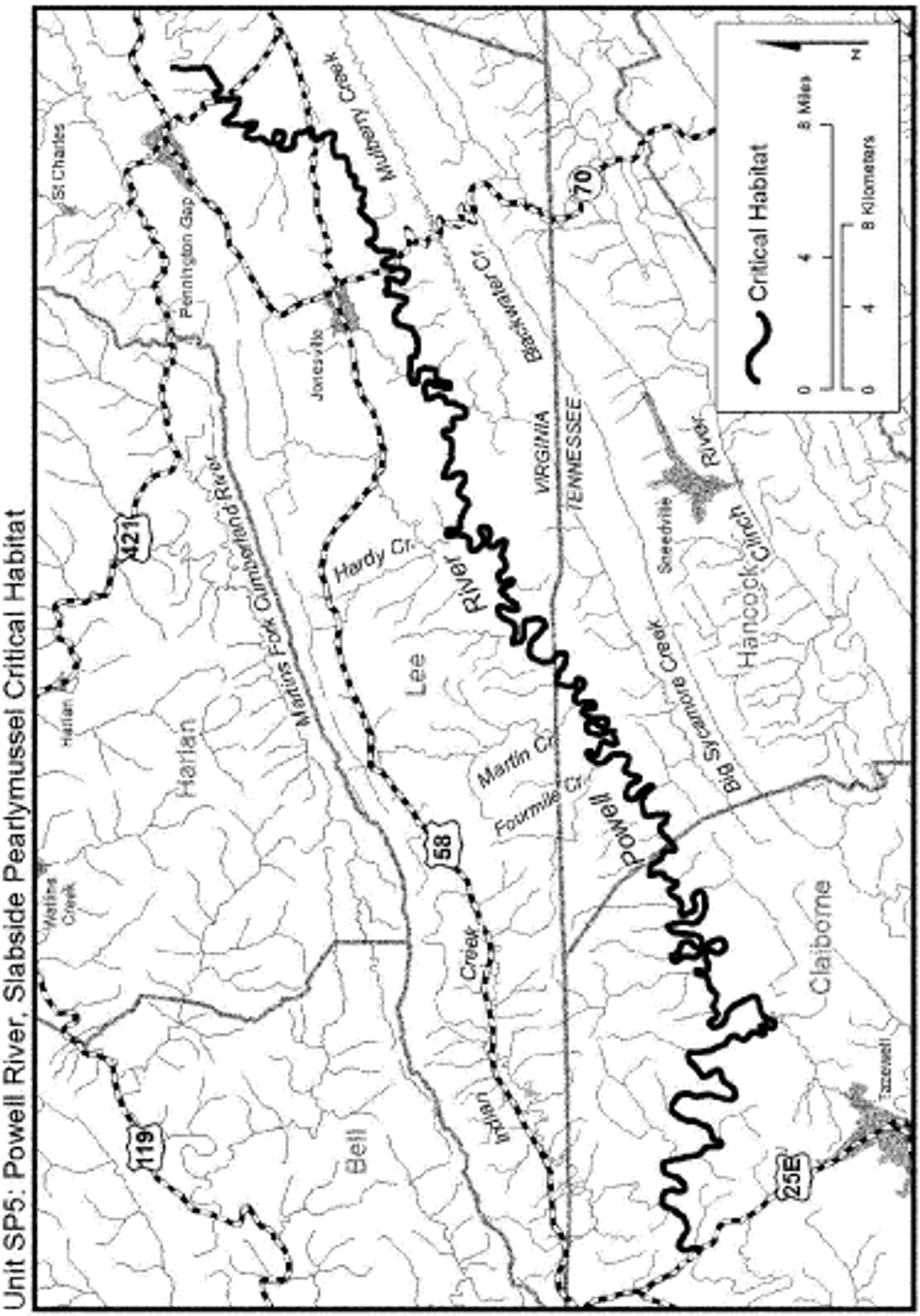
(11) Unit SP6: Nolichucky River, Cocke, Hamblen, and Greene Counties, Tennessee.
(i) The unit includes approximately 52 rkm (32 rmi) of the Nolichucky River from rkm 14 (rmi 9), approximately 0.6 rkm (0.4 rmi) upstream of Enka Dam (−83.19630, 36.12970), where it divides Hamblen and Cocke Counties, TN, upstream to its confluence with Pigeon Creek, just upstream of the Highway 321 Bridge crossing (−82.92926, 36.07545), in Greene County, TN.
(ii) Map of Unit SP6 follows:
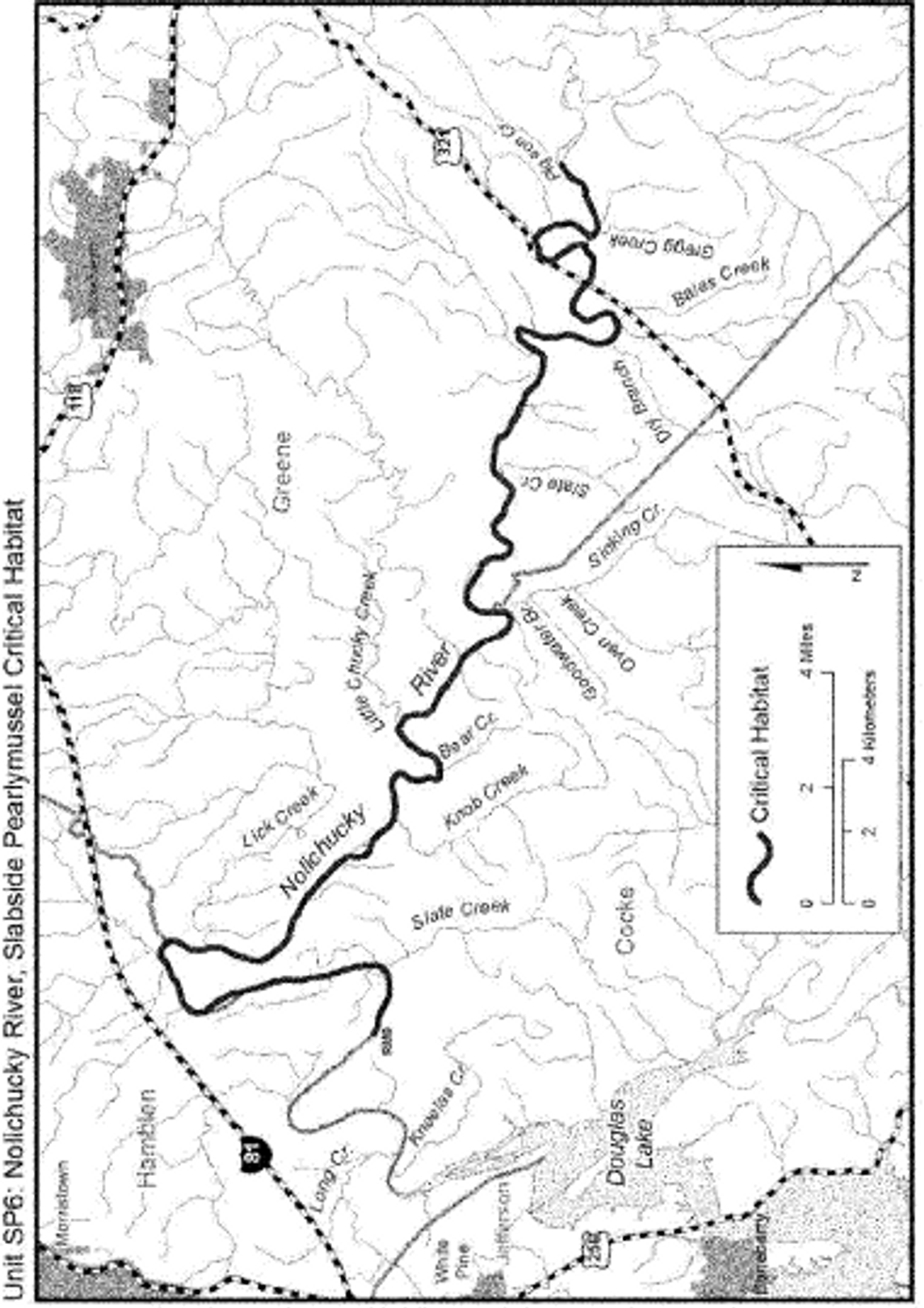
(12) Unit SP7: Hiwassee River, Polk County, Tennessee.
(i) The unit includes approximately 24 rkm (15 rmi) of the Hiwassee River from the Highway 315 Bridge crossing (−84.50234, 35.18875) upstream to the Highway 68 Bridge crossing (−84.31728, 35.16811) in Polk County, TN.
(ii) Map of Unit SP7 follows:
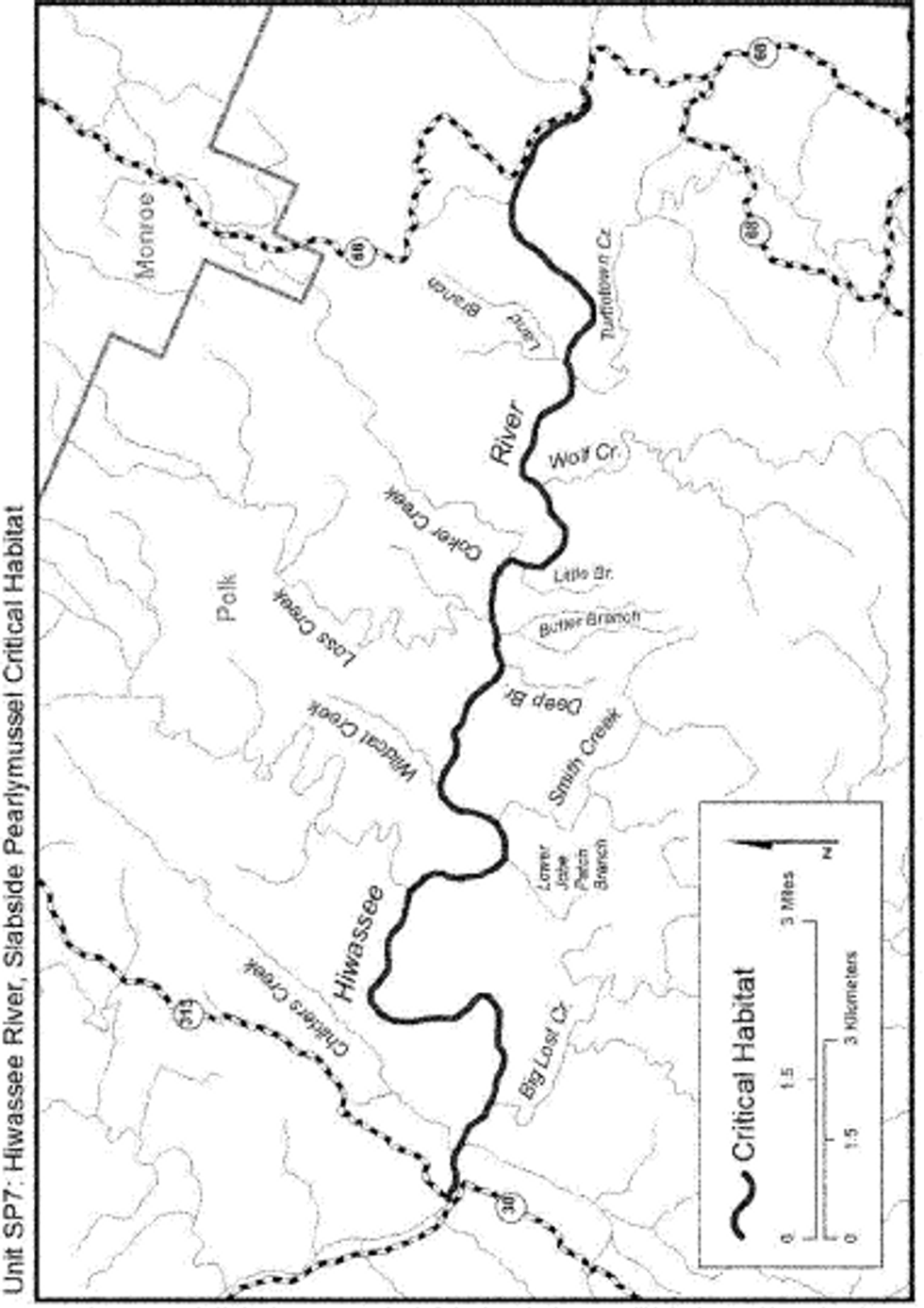
(13) Unit SP8: Sequatchie River, Marion, Sequatchie, and Bledsoe Counties, Tennessee.
(i) The unit includes approximately 151 rkm (94 rmi) of the Sequatchie River from the Highway 41, 64, 72, 2 Bridge crossing (−85.60583, 35.06576) in Marion County, TN, upstream to the Ninemile Cross Road Bridge crossing (−85.08304, 35.69162) in Bledsoe County, TN.
(ii) Map of Unit SP8 follows:
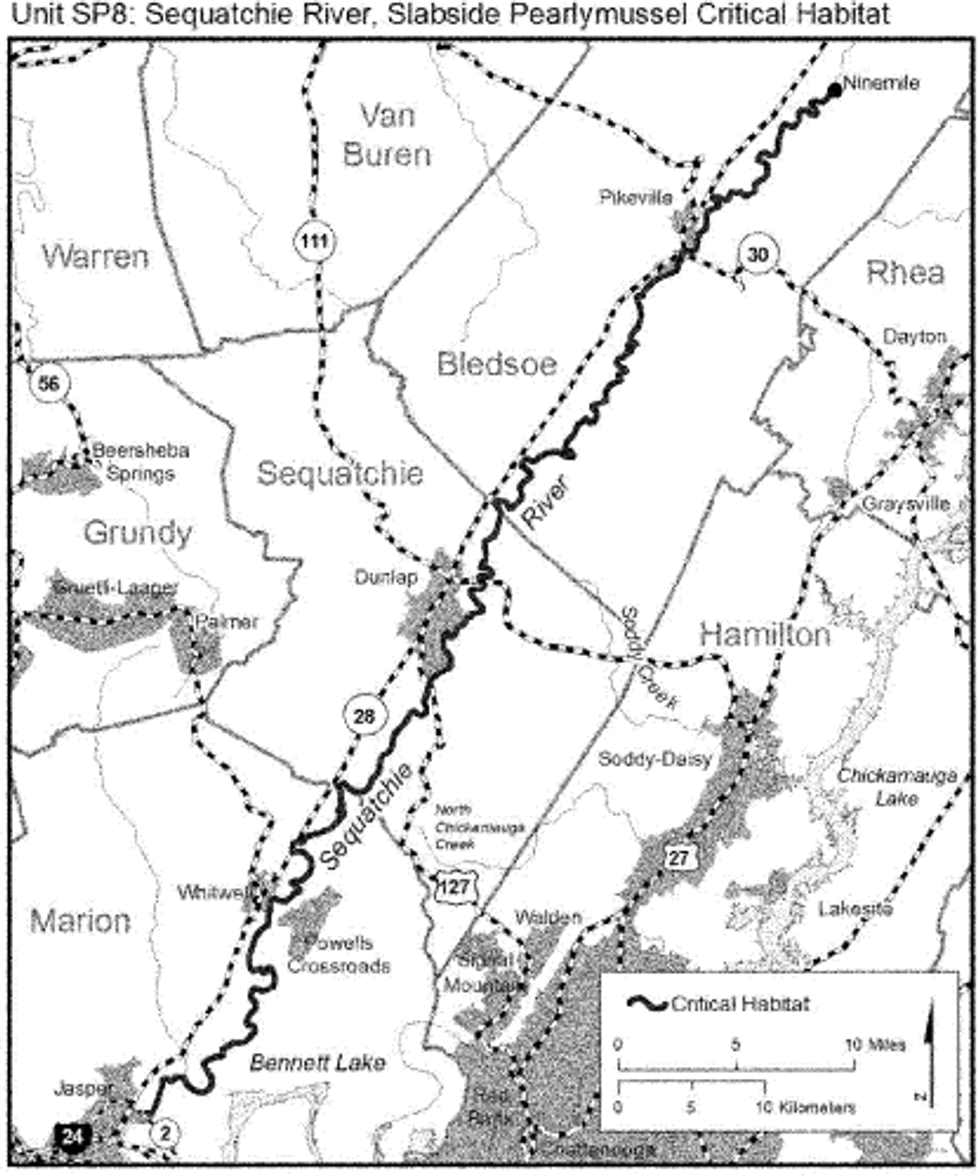
(14) Unit SP9: Paint Rock River, Madison, Marshall, and Jackson Counties, Alabama.
(i) The unit includes approximately 86 rkm (53 rmi) of the Paint Rock River from the Highway 431 Bridge crossing (−86.39109, 34.49926) along the Madison and Marshall County line, AL, upstream to the confluence of Estill Fork and Hurricane Creek in Jackson County, AL (−86.17048, 34.89813). The unit includes approximately 11 rkm (7 rmi) of Larkin Fork from its confluence with the Paint Rock River (−86.20833, 34.86218) upstream to its confluence with Bear Creek (−86.22512, 34.94205) in Jackson County, AL; approximately 13 rkm (8 rmi) of Estill Fork from its confluence with the Paint Rock River (−86.17048, 34.89813) upstream to its confluence with Bull Run (−86.15283, 34.99118) in Jackson County, AL; and approximately 16 rkm (10 rmi) of Hurricane Creek from its confluence with the Paint Rock River (−86.17048, 34.89813) upstream to its confluence with Turkey Creek (−86.09441, 34.98370) in Jackson County, AL.
(ii) Map of Unit SP9 follows:
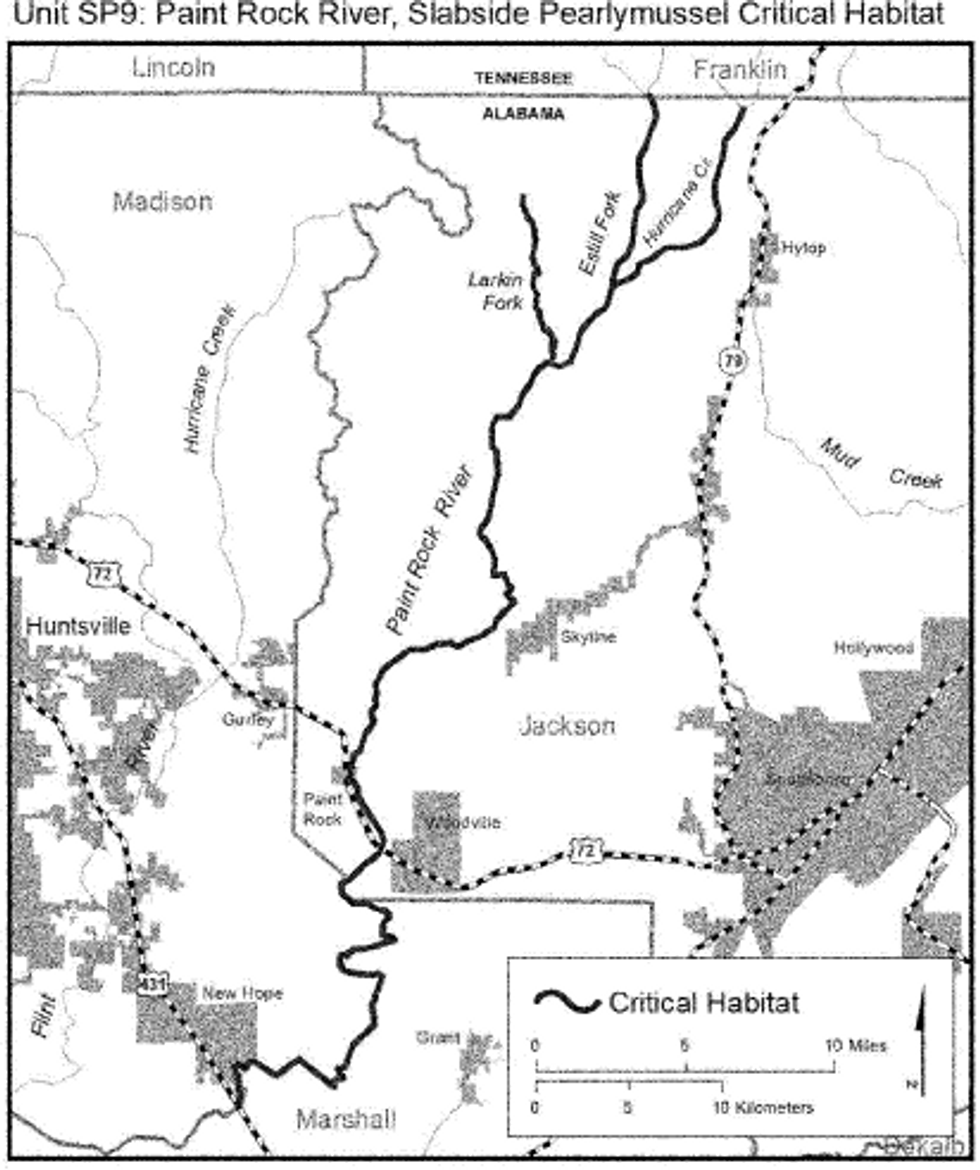
(15) Unit SP10: Elk River, Limestone County, Alabama, and Giles, Lincoln, Franklin, and Moore Counties, Tennessee.
(i) The unit includes approximately 164 rkm (102 rmi) of the Elk River from its inundation at Wheeler Lake (−87.06503, 34.89788) in Limestone County, AL, upstream to its confluence with Farris Creek (−86.31996, 35.16288) at the dividing line between Franklin and Moore Counties, TN.
(ii) Map of Unit SP10 follows:
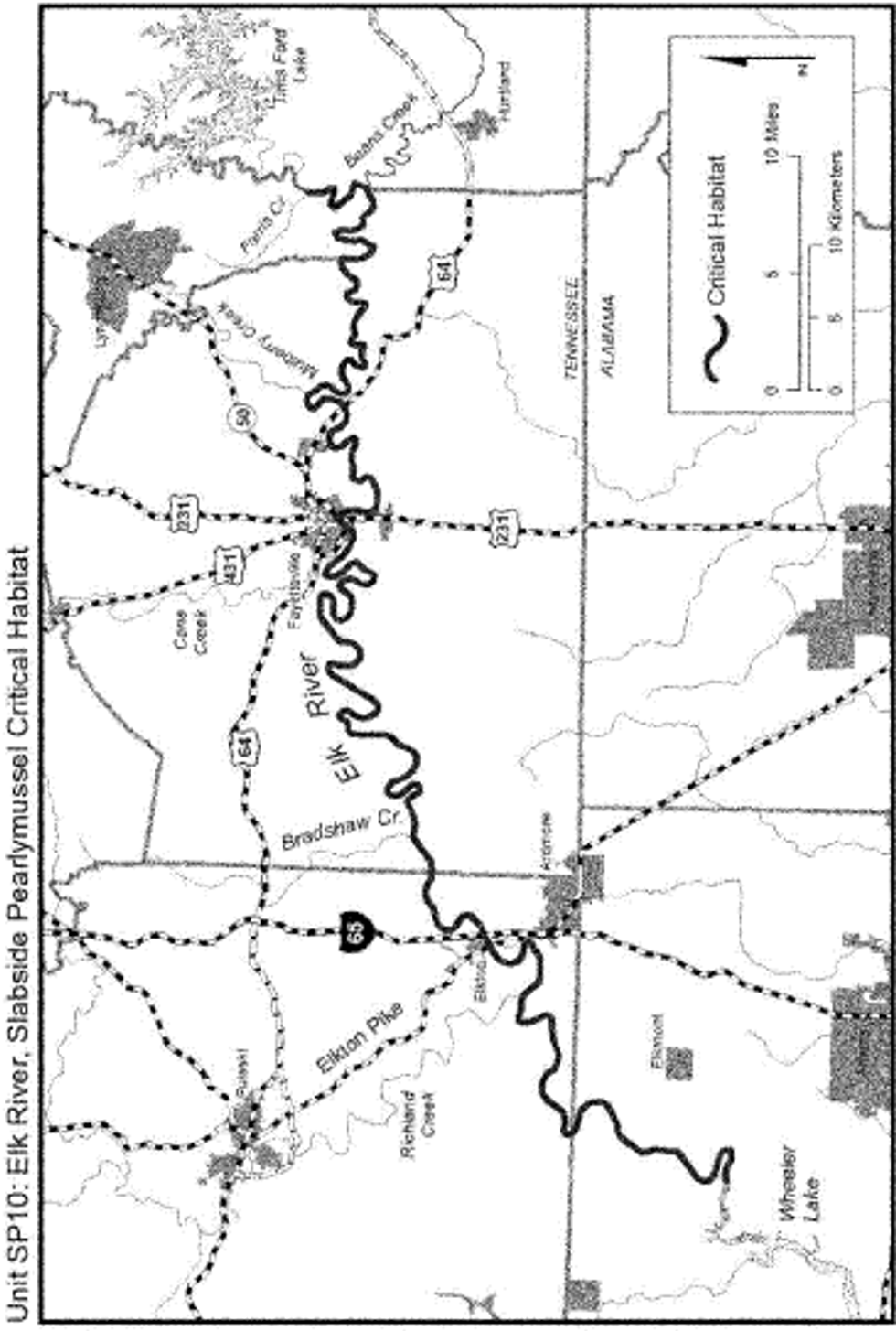
(16) Unit SP11: Bear Creek, Colbert County, Alabama, and Tishomingo County, Mississippi.
(i) The unit includes approximately 42 rkm (26 rmi) of Bear Creek from its inundation at Pickwick Lake at rkm 37 (rmi 23) (−88.08373, 34.68909) in Colbert County, AL, upstream through Tishomingo County, MS, and ending at the Mississippi-Alabama State line (−88.15388, 34. 49139).
(ii) Map of Unit SP11 follows:
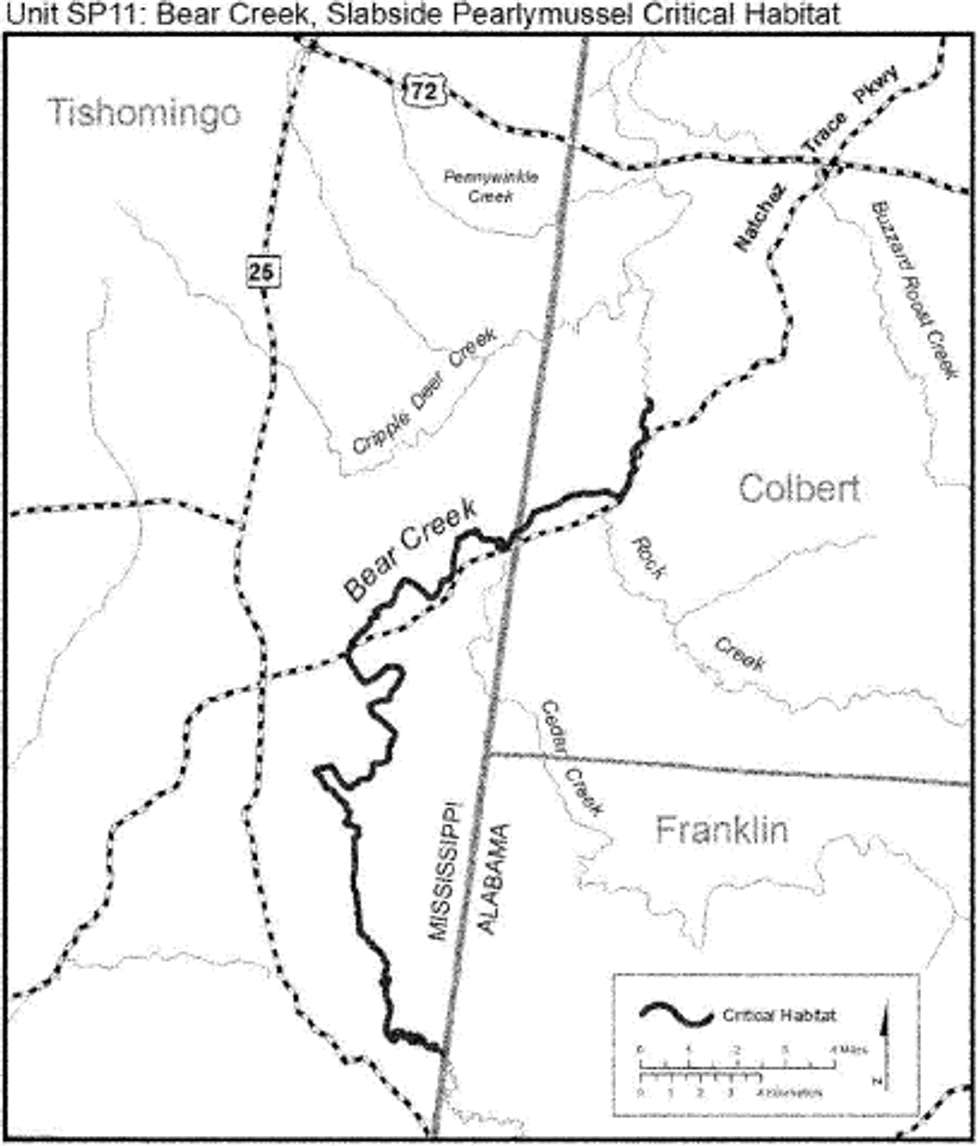
(17) Unit SP12: Duck River, Humphreys, Perry, Hickman, Maury, Marshall, and Bedford Counties, Tennessee.
(i) The unit includes approximately 348 rkm (216 rmi) of the Duck River from its inundation at Kentucky Lake (−87.88011, 36.00244) in Humphreys County, TN, upstream to its confluence with Flat Creek (−86.48778, 35.47209) near Shelbyville in Bedford County, TN.
(ii) Map of Unit SP12 follows:

(18) Unit SP13: Buffalo River, Humphreys and Perry Counties, Tennessee.
(i) The unit includes 50 rkm (31 rmi) of the Buffalo River from its confluence with the Duck River (−87.84261, 35.99477) in Humphreys County, TN, upstream to its confluence with Cane Creek (−87.78718, 35.72298) in Perry County, TN.
(ii) Map of Unit SP13 follows:
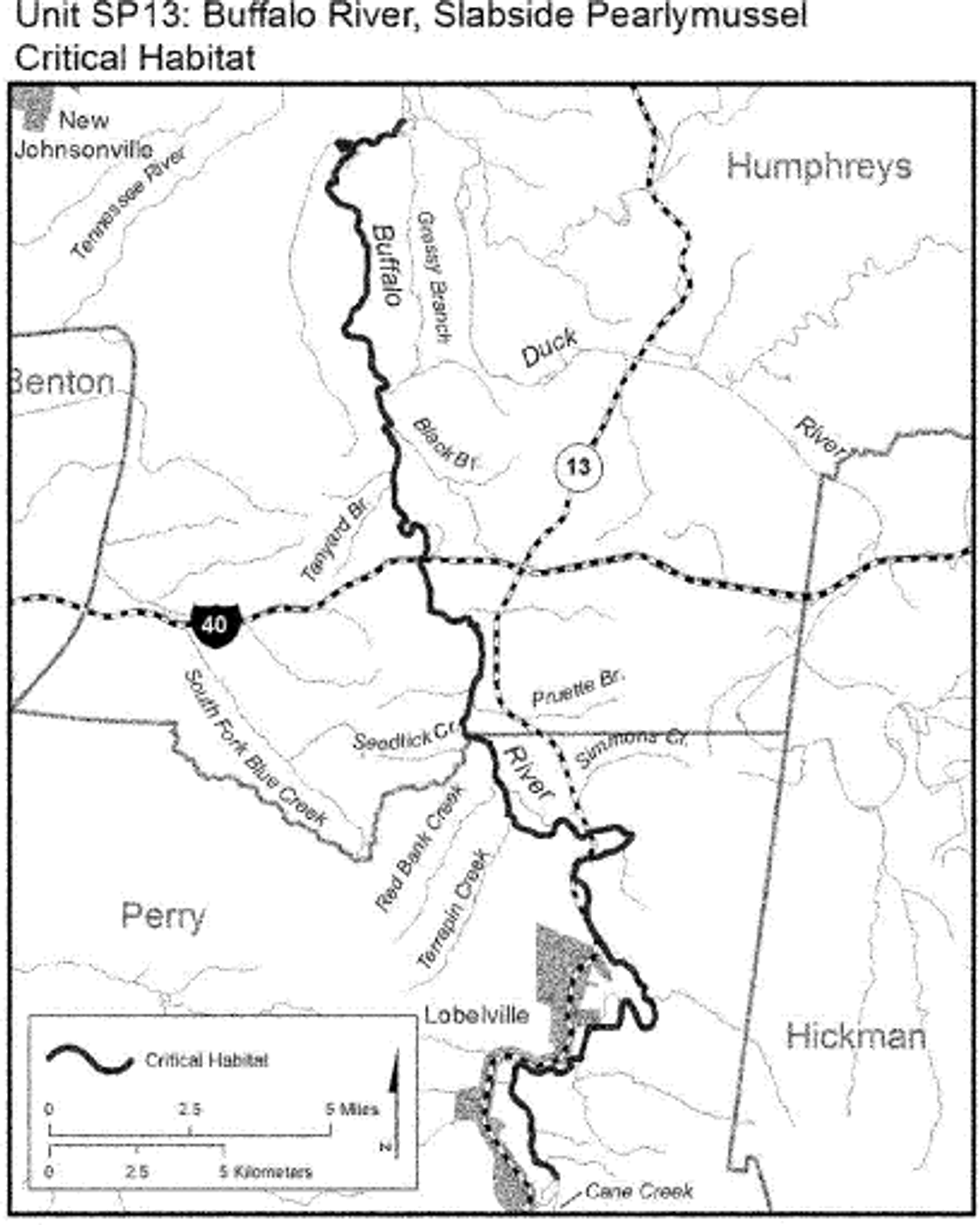
Neosho Mucket (Lampsilis rafinesqueana)
(1) Critical habitat units are depicted for the Neosho mucket on the maps below in the following Counties:
(i) Benton and Washington Counties, Arkansas;
(ii) Allen, Cherokee, Coffey, Elk, Greenwood, Labette, Montgomery, Neosho, Wilson, and Woodson Counties, Kansas;
(iii) Jasper, Lawrence, McDonald, and Newton Counties, Missouri; and
(iv) Adair, Cherokee, and Delaware Counties, Oklahoma.
(2) Within these areas, the primary constituent elements of the physical or biological features essential to the conservation of the Neosho mucket consist of five components:
(i) Geomorphically stable river channels and banks (channels that maintain lateral dimensions, longitudinal profiles, and sinuosity patterns over time without an aggrading or degrading bed elevation) with habitats that support a diversity of freshwater mussel and native fish (such as stable riffles, sometimes with runs, and mid-channel island habitats that provide flow refuges consisting of gravel and sand substrates with low to moderate amounts of fine sediment and attached filamentous algae).
(ii) A hydrologic flow regime (the severity, frequency, duration, and seasonality of discharge over time) necessary to maintain benthic habitats where the species are found and to maintain connectivity of rivers with the floodplain, allowing the exchange of nutrients and sediment for maintenance of the mussel's and fish host's habitat, food availability, spawning habitat for native fishes, and the ability for newly transformed juveniles to settle and become established in their habitats.
(iii) Water and sediment quality (including, but not limited to, conductivity, hardness, turbidity, temperature, pH, ammonia, heavy metals, and chemical constituents) necessary to sustain natural physiological processes for normal behavior, growth, and viability of all life stages.
(iv) The occurrence of natural fish assemblages, reflected by fish species richness, relative abundance, and community composition, for each inhabited river or creek that will serve as an indication of appropriate presence and abundance of fish hosts necessary for recruitment of the Neosho mucket. Suitable fish hosts for Neosho mucket glochidia include smallmouth bass (Micropterus dolomieu), largemouth bass (Micropterus salmoides), and spotted bass (Micropterus punctulatus).
(v) Competitive or predaceous invasive (nonnative) species in quantities low enough to have minimal effect on survival of freshwater mussels.
(3) Critical habitat does not include manmade structures (such as dams, piers and docks, bridges, or other similar structures) within the legal boundaries on June 1, 2015.
(4) Critical habitat map units. Data layers defining map units were developed using ESRI ArcGIS mapping software along with various spatial data layers. Critical habitat unit upstream and downstream limits were delineated at the nearest road crossing or stream confluence of each occupied reach. Data layers defining map units were created with U.S. Geological Survey National Hydrography Dataset (NHD) Medium Flowline data. ArcGIS was also used to calculate river kilometers (rkm) and river miles (rmi) from the NHD dataset, and it was used to determine longitude and latitude coordinates in decimal degrees. The projection used in mapping and calculating distances and locations within the units was North American Albers Equal Area Conic, NAD 83. The maps in this entry, as modified by any accompanying regulatory text, establish the boundaries of the critical habitat designation. The coordinates, plot points, or both on which each map is based are available to the public at the Service's Internet site (http://www.fws.gov/arkansas-es/te_listing.html), the Federal eRulemaking Portal (http://www.regulations.gov at Docket No. FWS-R4-ES-2013-0007), and at the field office responsible for this designation. You may obtain field office location information by contacting one of the Service regional offices, the addresses of which are listed at 50 CFR 2.2.
(5) Note: Index map of all critical habitat units for the Neosho mucket follows:
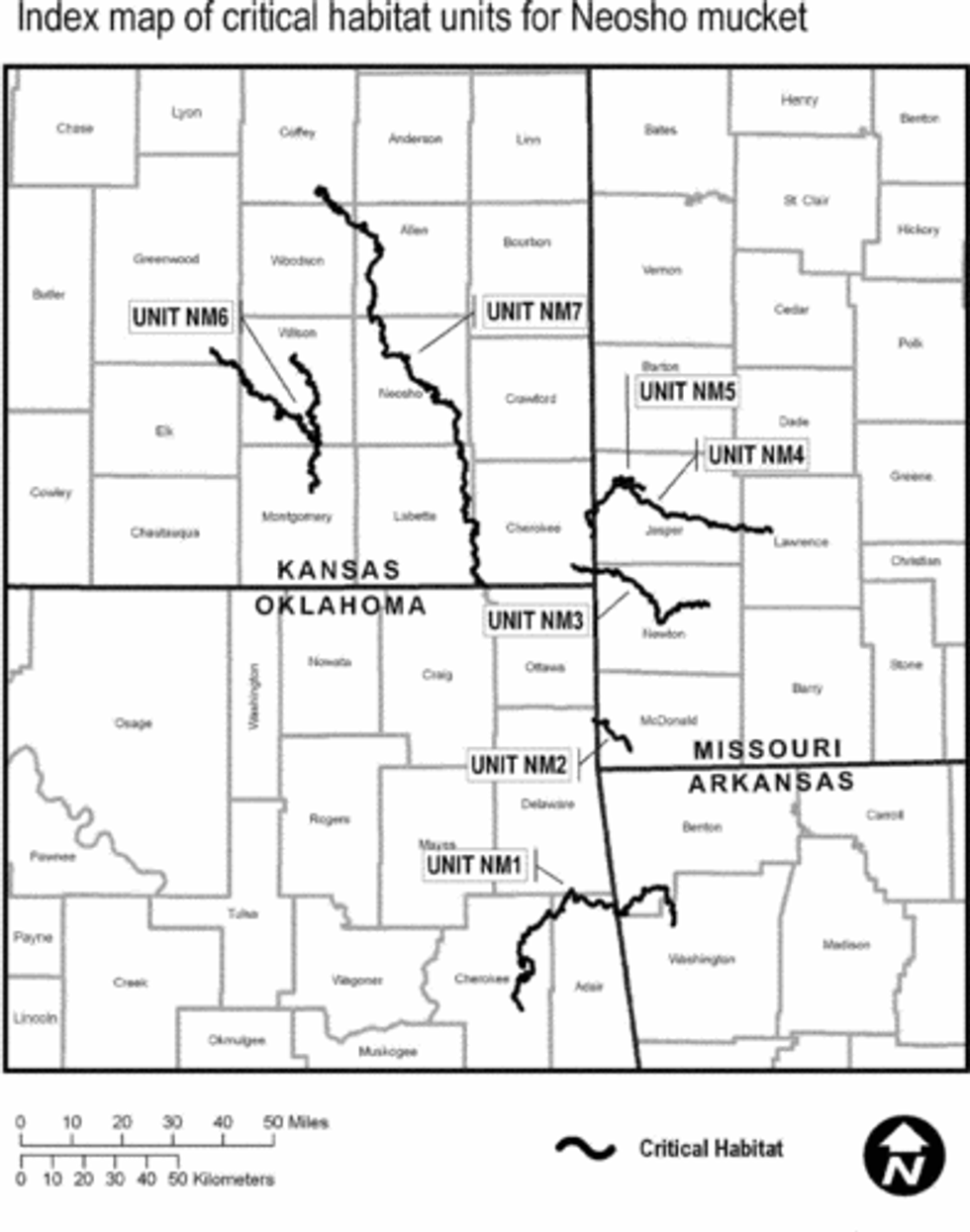
(6) Unit NM1: Illinois River - Benton and Washington Counties, Arkansas; and Adair, Cherokee, and Delaware Counties, Oklahoma.
(i) General Description: Unit NM1 includes 146.1 rkm (90.8 rmi) of the Illinois River from the Muddy Fork Illinois River confluence south of Savoy, Washington County, Arkansas, downstream to the Baron Creek confluence southeast of Tahlequah, Cherokee County, Oklahoma.
(ii) Map of Unit NM1 follows:
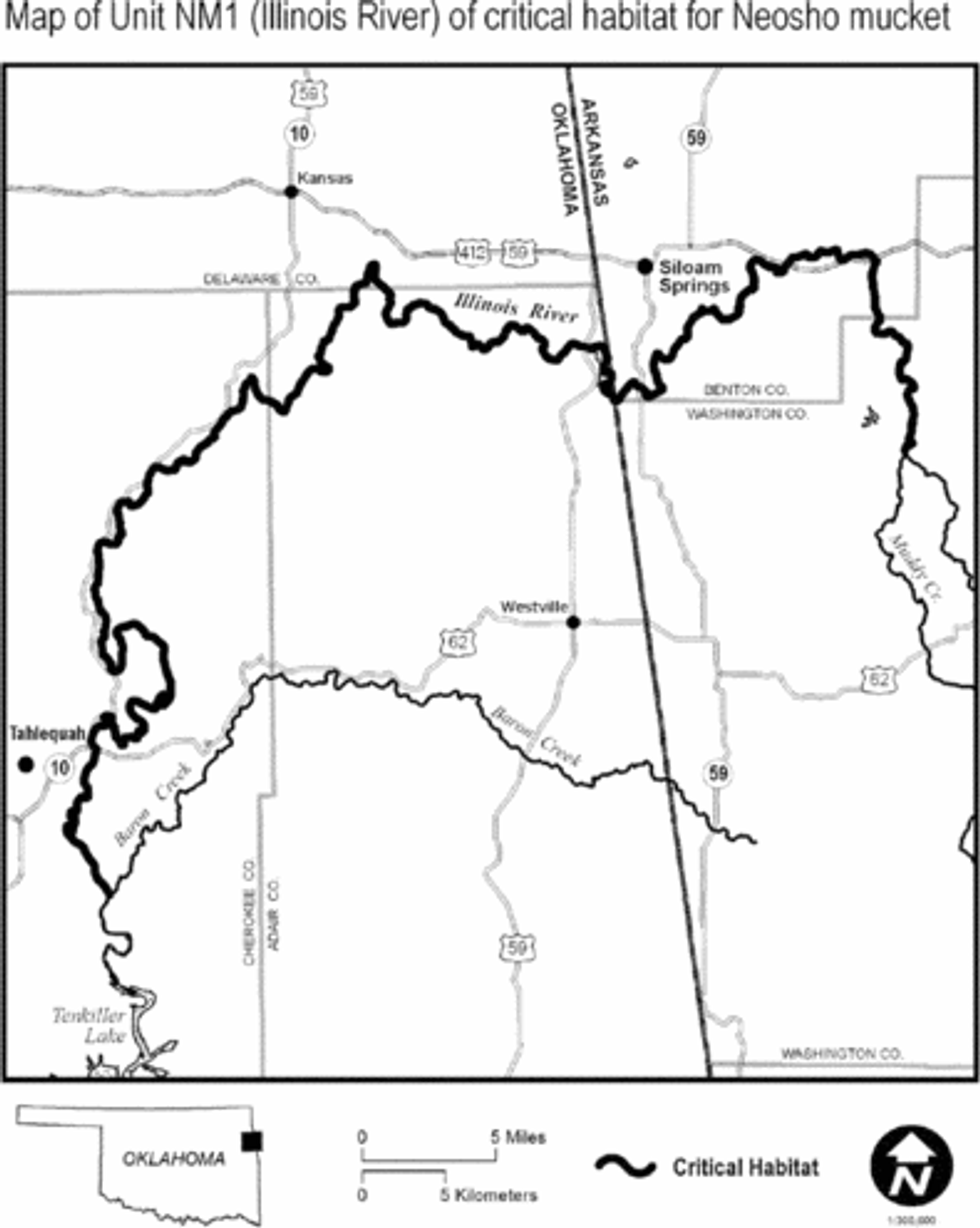
(7) Unit NM2: Elk River - McDonald County, Missouri; and Delaware County, Oklahoma.
(i) General Description: Unit NM2 includes 20.3 rkm (12.6 rmi) of the Elk River from Missouri Highway 59 at Noel, McDonald County, Missouri, to the confluence of Buffalo Creek immediately downstream of the Oklahoma and Missouri State line, Delaware County, Oklahoma.
(ii) Map of Unit NM2 follows:
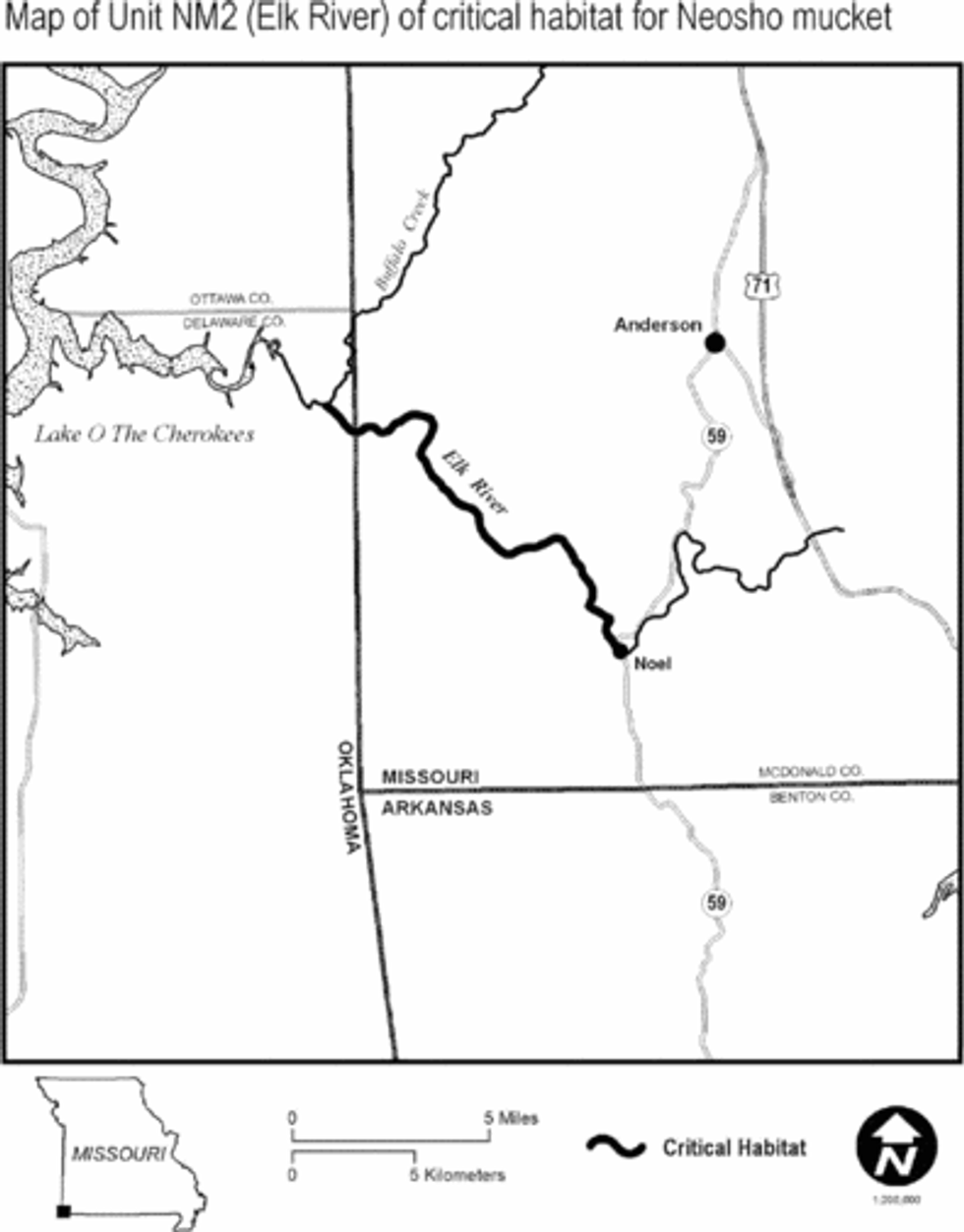
(8) Unit NM3: Shoal Creek - Cherokee County, Kansas; and Newton County, Missouri.
(i) General Description: Unit NM3 includes 75.8 rkm (47.1 rmi) of Shoal Creek from Missouri Highway W near Ritchey, Newton County, Missouri, to Empire Lake where inundation begins in Cherokee County, Kansas.
(ii) Map of Unit NM3 follows:
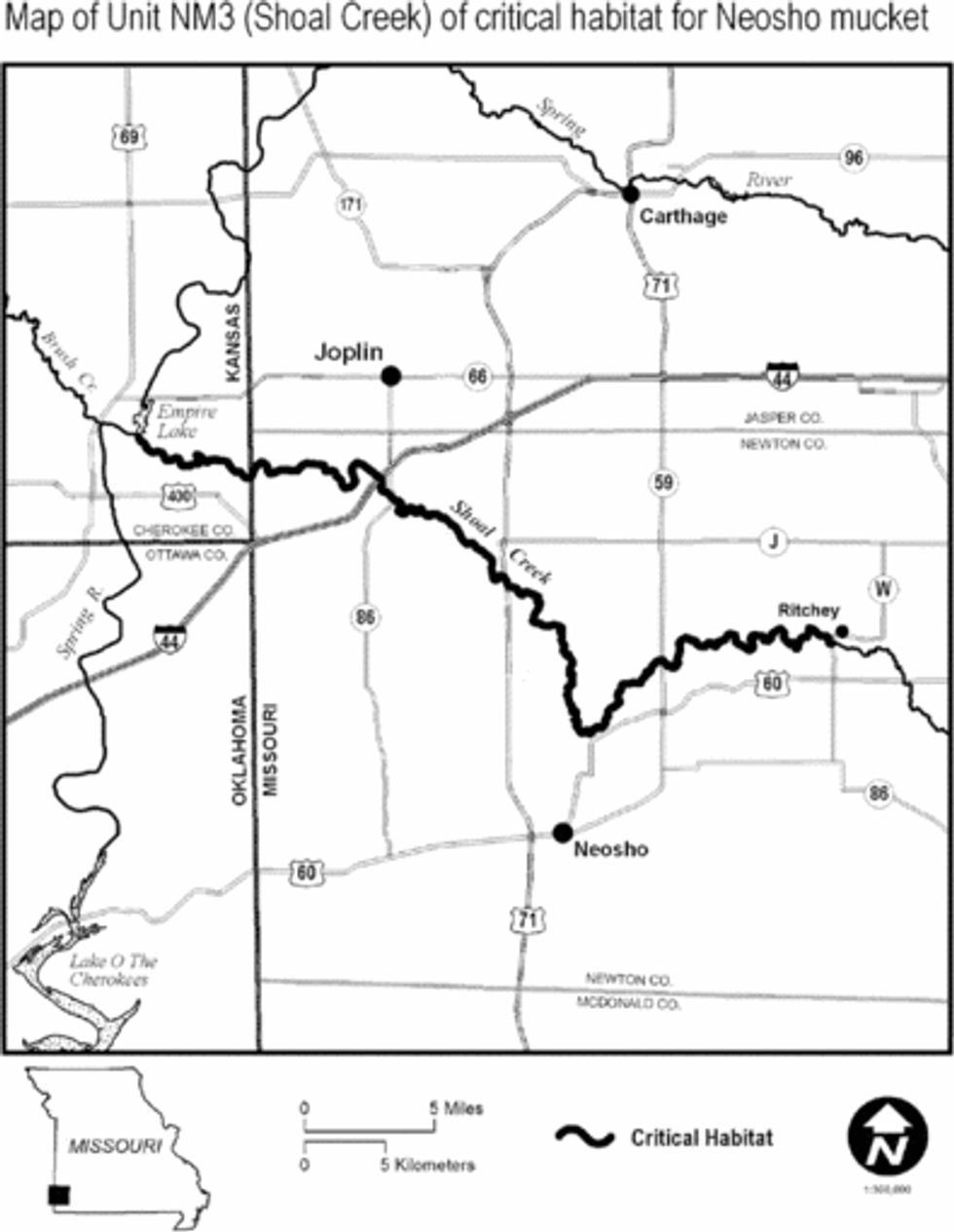
(9) Unit NM4: Spring River - Jasper and Lawrence Counties, Missouri; and Cherokee County, Kansas.
(i) General Description: Unit NM4 includes 102.3 rkm (63.6 rmi) of the Spring River from Missouri Highway 97 north of Stotts City, Lawrence County, Missouri, downstream to the confluence of Turkey Creek north of Empire, Cherokee County, Kansas.
(ii) Map of Unit NM4 follows:
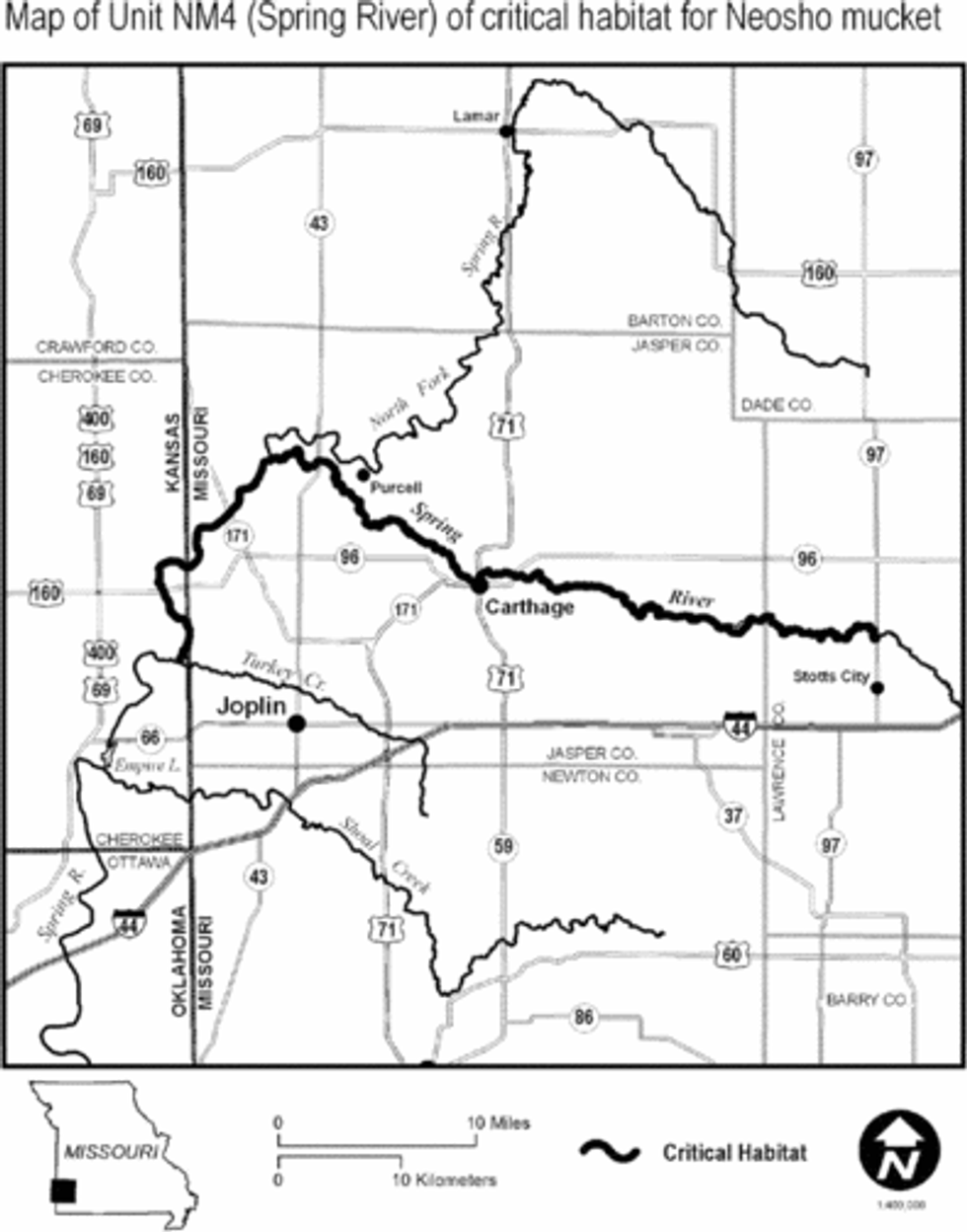
(10) Unit NM5: North Fork Spring River - Jasper County, Missouri.
(i) General Description: Unit NM5 includes 16.4 rkm (10.2 rmi) of the North Fork Spring River from the confluence of Buck Branch southwest of Jasper, Missouri, downstream to its confluence with the Spring River near Purcell, Jasper County, Missouri.
(ii) Map of Unit NM5 follows:
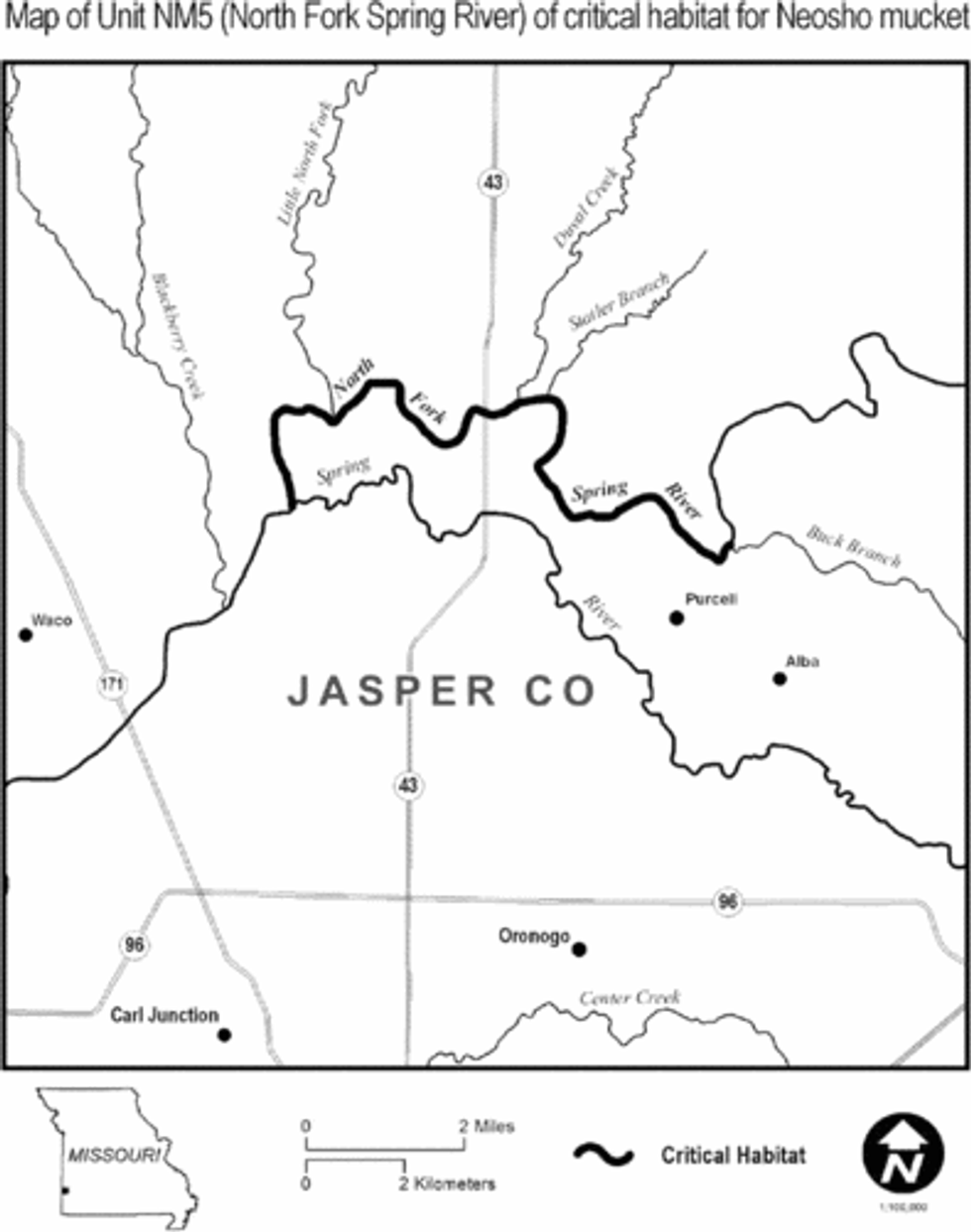
(11) Unit NM6: Fall River - Elk, Greenwood, and Wilson Counties, Kansas; Verdigris River - Montgomery and Wilson Counties, Kansas.
(i) General Description: Unit NM6 includes a total of 171.1 rkm (106.3 rmi) including 90.4 rkm (56.2 rmi) of the Fall River from Fall River Lake dam northwest of Fall River, Greenwood County, Kansas, downstream to its confluence with the Verdigris River near Neodesha, Wilson County, Kansas. Unit NM6 also includes 80.6 rkm (50.1 rmi) of the Verdigris River from Kansas Highway 39 near Benedict, Wilson County, Kansas, downstream to the Elk River confluence near Independence, Montgomery County, Kansas.
(ii) Map of Unit NM6 follows:
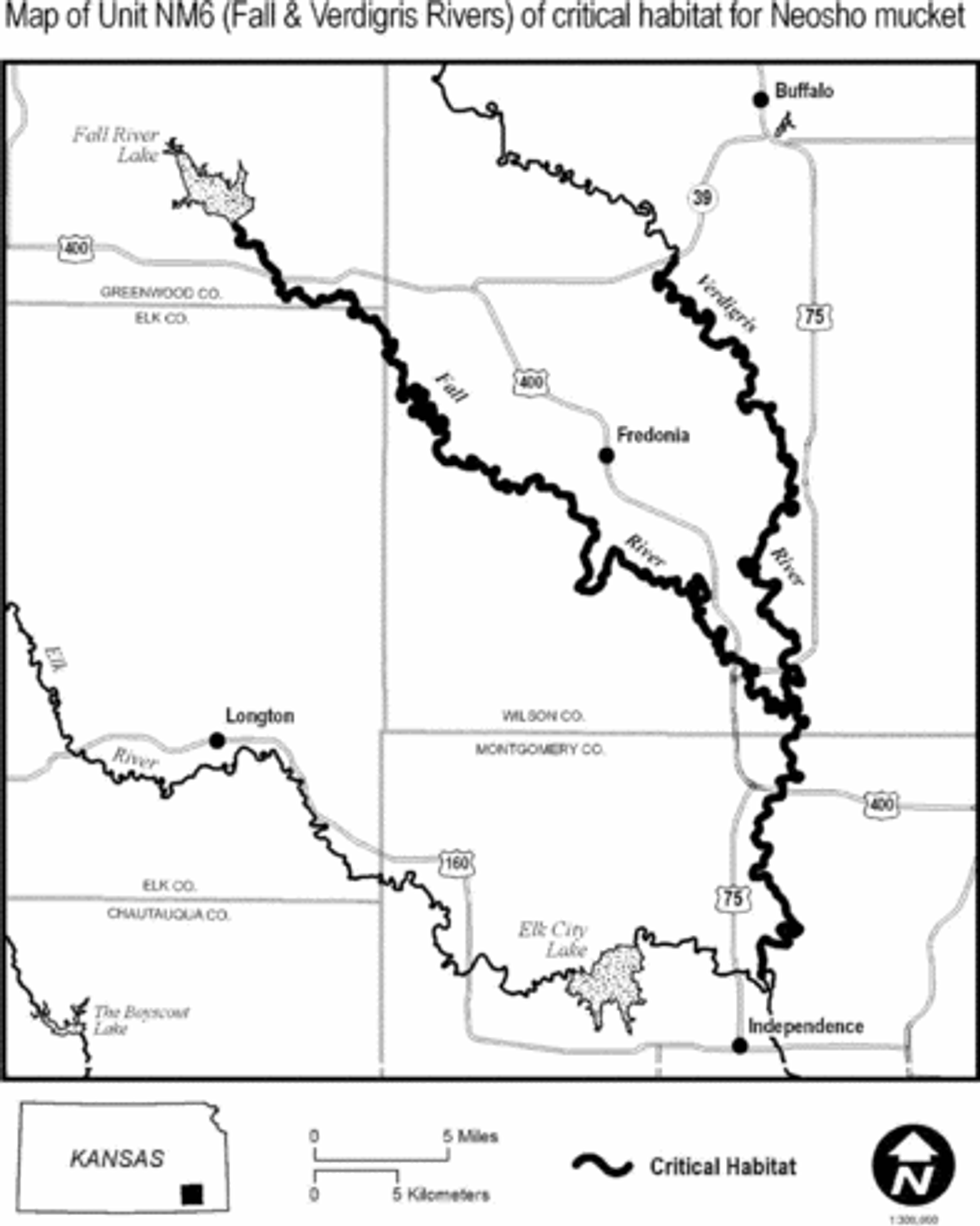
(12) Unit NM7: Neosho River - Allen, Cherokee, Coffey, Labette, Neosho, and Woodson Counties, Kansas.
(i) General Description: Unit NM7 includes 244.5 rkm (151.9 rmi) of the Neosho River from Kansas Highway 58 west of LeRoy, Coffey County, Kansas, downstream to the Kansas and Oklahoma State line, Cherokee County, Kansas.
(ii) Map of Unit NM7 follows:
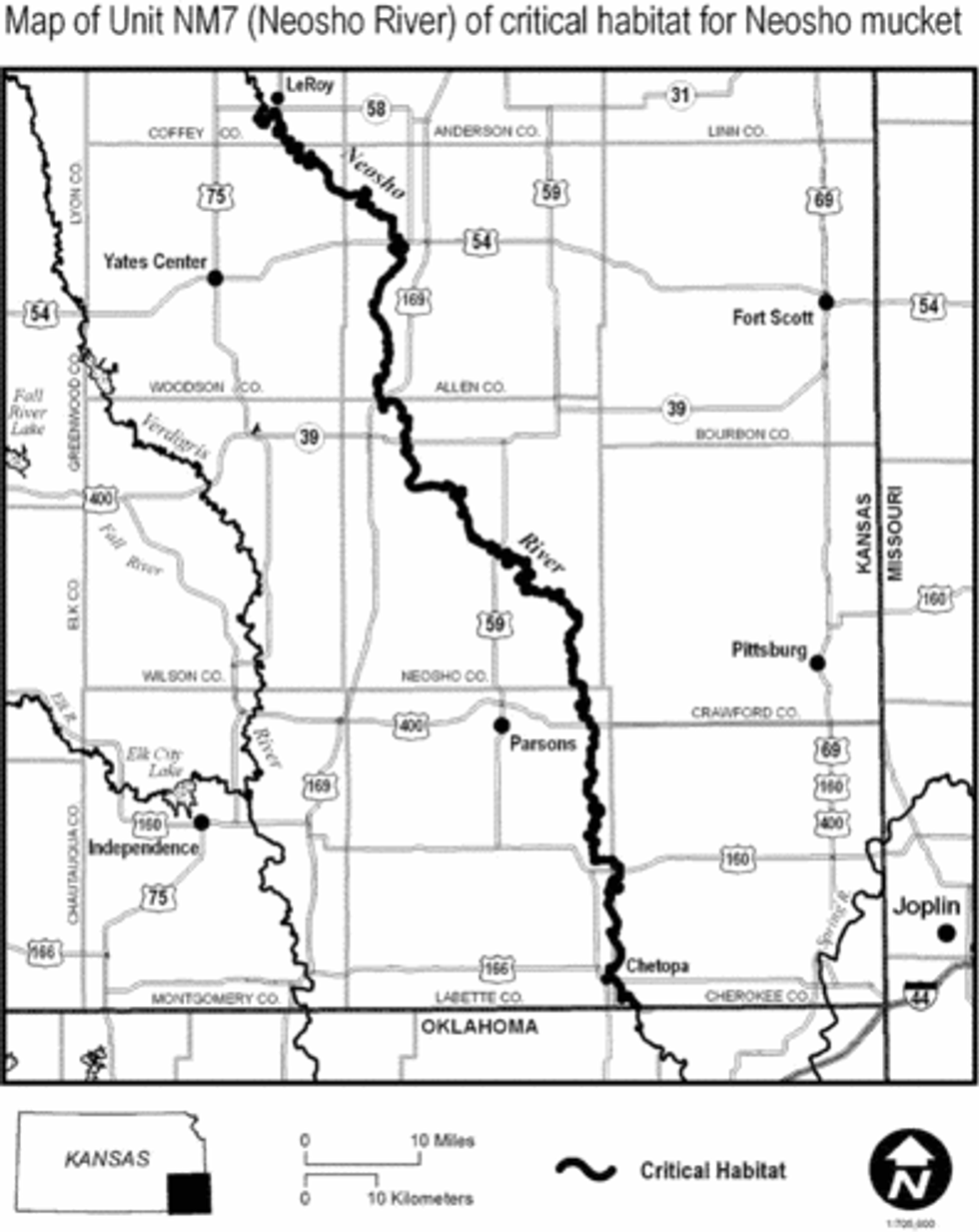
Rabbitsfoot (Quadrula cylindrica cylindrica)
(1) Critical habitat units are depicted for rabbitsfoot on the maps below in the following Counties:
(i) Colbert, Jackson, Madison, and Marshall Counties, Alabama;
(ii) Arkansas, Ashley, Bradley, Clark, Cleburne, Cleveland, Drew, Hot Spring, Independence, Izard, Jackson, Lawrence, Little River, Marion, Monroe, Newton, Ouachita, Randolph, Searcy, Sevier, Sharp, Van Buren, White, and Woodruff Counties, Arkansas;
(iii) Massac, Pulaski, and Vermilion Counties, Illinois;
(iv) Carroll, Pulaski, Tippecanoe, and White Counties, Indiana;
(v) Allen and Cherokee Counties, Kansas;
(vi) Ballard, Edmonson, Green, Hart, Livingston, Logan, Marshall, McCracken, and Taylor Counties, Kentucky;
(vii) Hinds, Sunflower, Tishomingo, and Warren Counties, Mississippi;
(viii) Jasper, Madison, and Wayne Counties, Missouri;
(ix) Coshocton, Madison, Union, and Williams Counties, Ohio;
(x) McCurtain and Rogers Counties, Oklahoma;
(xi) Crawford, Erie, Mercer, and Venango Counties, Pennsylvania; and
(xii) Hardin, Hickman, Humphreys, Marshall, Maury, Montgomery, Perry, and Robertson Counties, Tennessee.
(2) Within these areas, the primary constituent elements of the physical or biological features essential to the conservation of the rabbitsfoot consist of five components:
(i) Geomorphically stable river channels and banks (channels that maintain lateral dimensions, longitudinal profiles, and sinuosity patterns over time without an aggrading or degrading bed elevation) with habitats that support a diversity of freshwater mussel and native fish (such as stable riffles, sometimes with runs, and mid-channel island habitats that provide flow refuges consisting of gravel and sand substrates with low to moderate amounts of fine sediment and attached filamentous algae).
(ii) A hydrologic flow regime (the severity, frequency, duration, and seasonality of discharge over time) necessary to maintain benthic habitats where the species are found and to maintain connectivity of rivers with the floodplain, allowing the exchange of nutrients and sediment for maintenance of the mussel's and fish host's habitat, food availability, spawning habitat for native fishes, and the ability for newly transformed juveniles to settle and become established in their habitats.
(iii) Water and sediment quality (including, but not limited to, conductivity, hardness, turbidity, temperature, pH, ammonia, heavy metals, and chemical constituents) necessary to sustain natural physiological processes for normal behavior, growth, and viability of all life stages.
(iv) The occurrence of natural fish assemblages, reflected by fish species richness, relative abundance, and community composition, for each inhabited river or creek that will serve as an indication of appropriate presence and abundance of fish hosts necessary for recruitment of the rabbitsfoot. Suitable fish hosts for rabbitsfoot may include, but are not limited to, blacktail shiner (Cyprinella venusta) from the Black and Little River and cardinal shiner (Luxilus cardinalis), red shiner (C. lutrensis), spotfin shiner (C. spiloptera), bluntface shiner (C. camura), rainbow darter (Etheostoma caeruleum), rosyface shiner (Notropis rubellus), striped shiner (L. chrysocephalus), and emerald shiner (N. atherinoides).
(v) Competitive or predaceous invasive (nonnative) species in quantities low enough to have minimal effect on survival of freshwater mussels.
(3) Critical habitat does not include manmade structures (such as dams, piers and docks, bridges, or other similar structures) within the legal boundaries on June 1, 2015.
(4) Critical habitat map units. Data layers defining map units were developed using ESRI ArcGIS mapping software along with various spatial data layers. Critical habitat unit upstream and downstream limits were delineated at the nearest road crossing or stream confluence of each occupied reach. Data layers defining map units were created with U.S. Geological Survey National Hydrography Dataset (NHD) Medium Flowline data. ArcGIS was also used to calculate river kilometers (rkm) and river miles (rmi) from the NHD dataset, and it was used to determine longitude and latitude coordinates in decimal degrees. The projection used in mapping and calculating distances and locations within the units was North American Albers Equal Area Conic, NAD 83. The maps in this entry, as modified by any accompanying regulatory text, establish the boundaries of the critical habitat designation. The coordinates, plot points, or both on which each map is based are available to the public at the Service's Internet site (http://www.fws.gov/arkansas-es/te_listing.html), the Federal eRulemaking Portal (http://www.regulations.gov at Docket No. FWS-R4-ES-2013-0007), and at the field office responsible for this designation. You may obtain field office location information by contacting one of the Service regional offices, the addresses of which are listed at 50 CFR 2.2.
(5) Note: Index map of all critical habitat units for the rabbitsfoot follows:
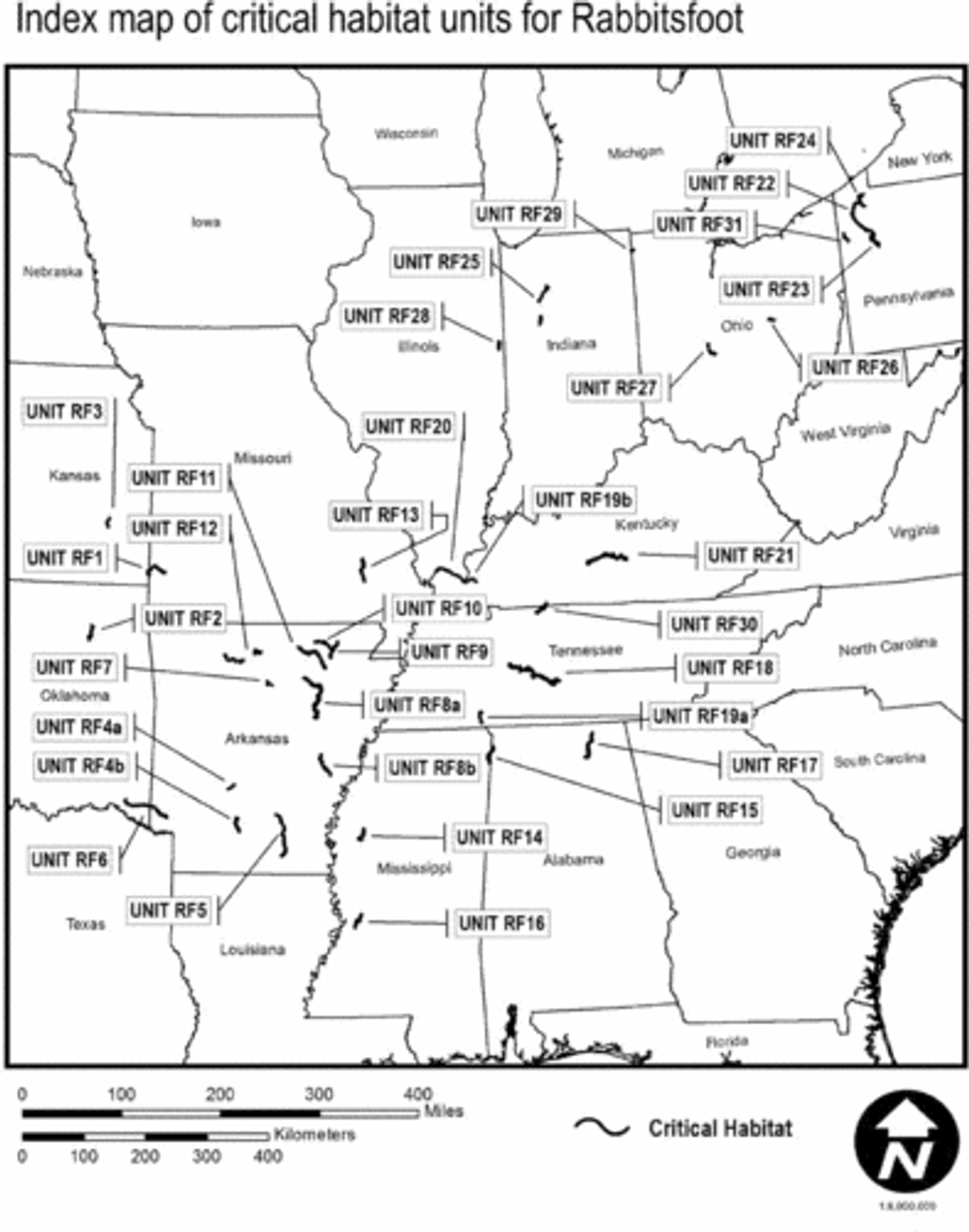
(6) Unit RF1: Spring River - Jasper County, Missouri; and Cherokee County, Kansas.
(i) General Description: Unit RF1 includes 56.5 rkm (35.1 rmi) of the Spring River from Missouri Highway 96 at Carthage, Jasper County, Missouri, downstream to the confluence of Turkey Creek north of Empire, Cherokee County, Kansas.
(ii) Map of Unit RF1 follows:
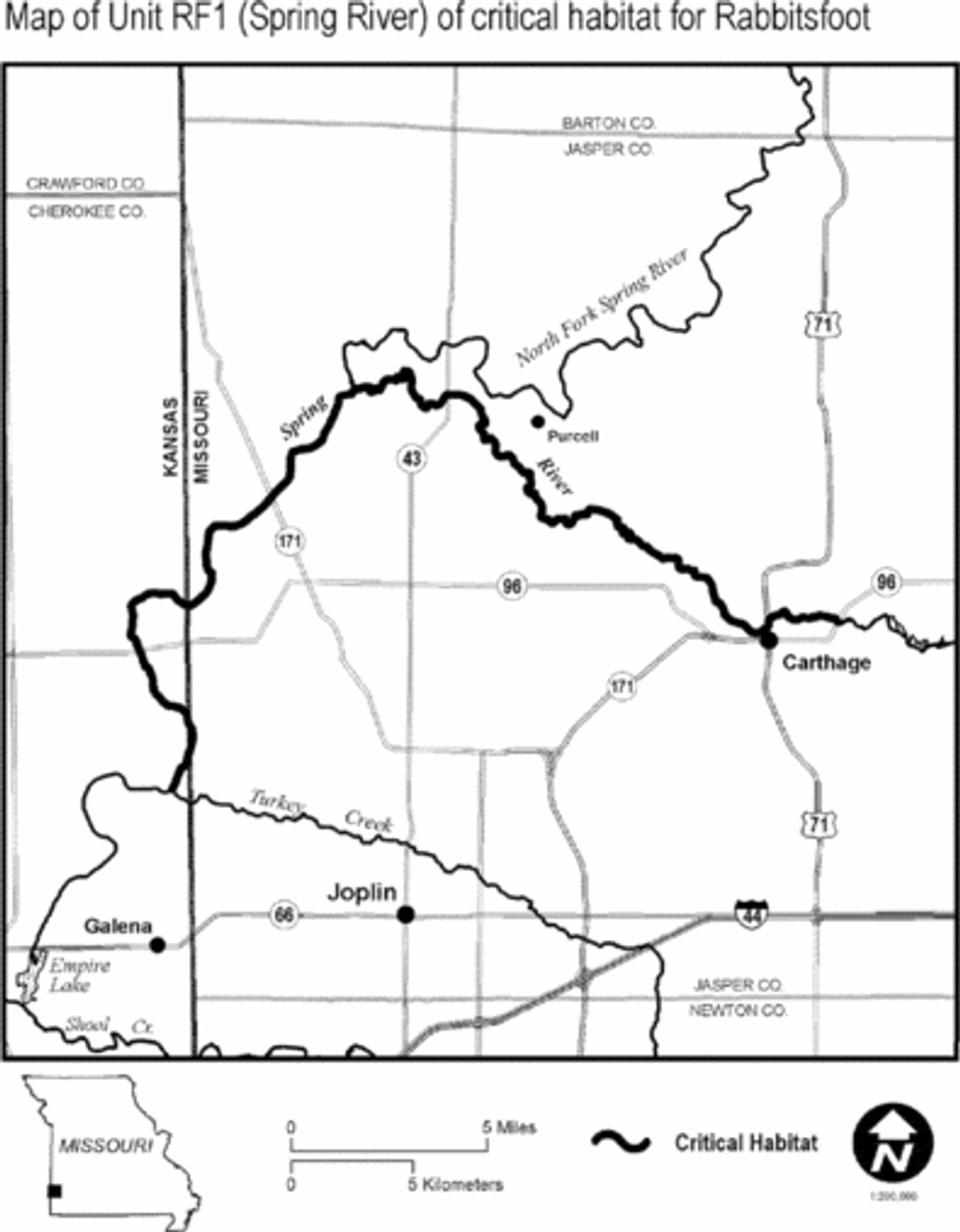
(7) Unit RF2: Verdigris River - Rogers County, Oklahoma.
(i) General Description: Unit RF2 includes 38.0 rkm (23.6 rmi) of the Verdigris River from Oologah Lake dam north of Claremore, Oklahoma, downstream to Oklahoma Highway 266 northwest of Catoosa, Rogers County, Oklahoma.
(ii) Map of Unit RF2 follows:
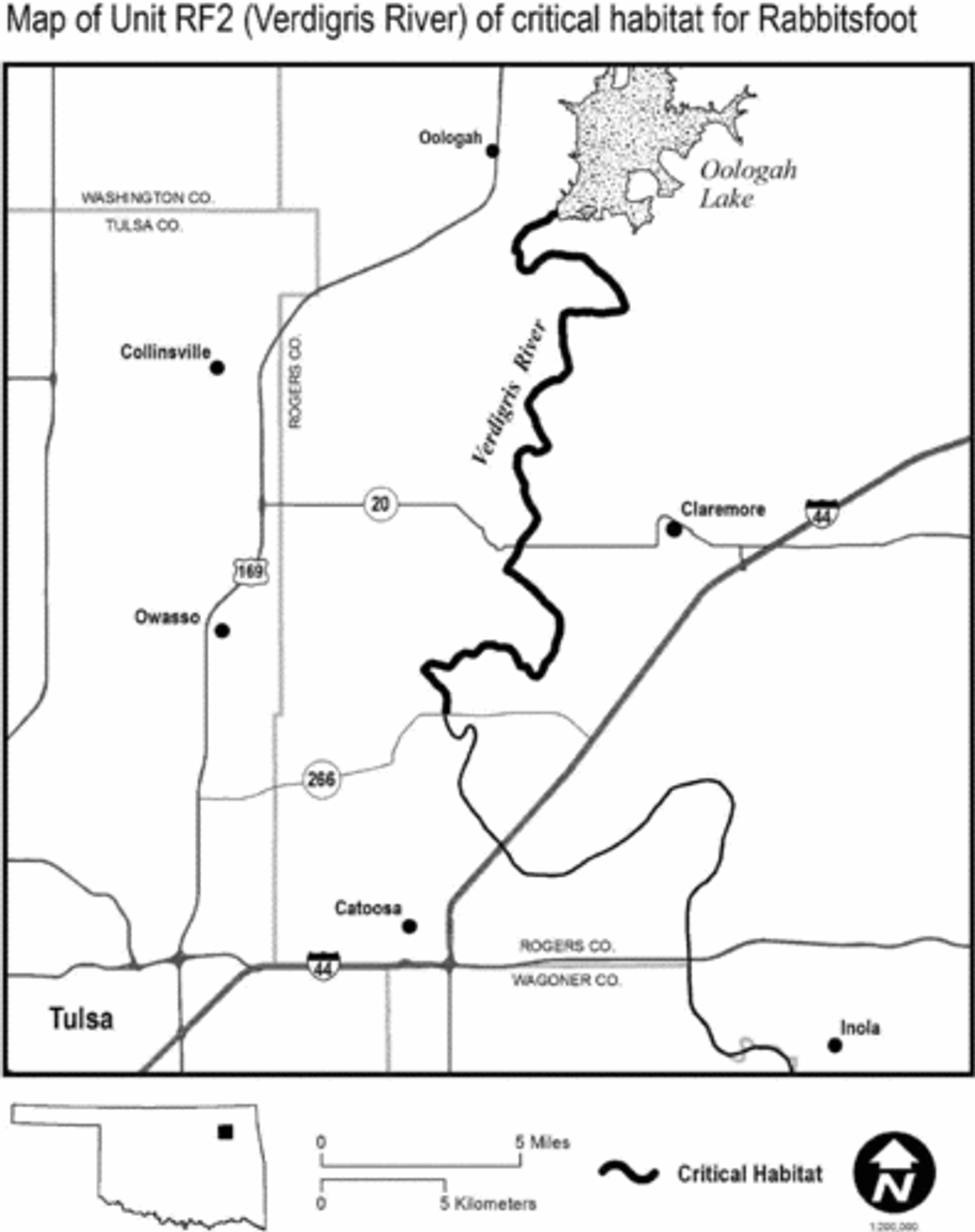
(8) Unit RF3: Neosho River - Allen County, Kansas.
(i) General Description: Unit RF3 includes 26.6 rkm (16.5 rmi) of the Neosho River from the Deer Creek confluence northwest of Iola, Kansas, downstream to the confluence of Owl Creek southwest of Humboldt, Allen County, Kansas.
(ii) Map of Unit RF3 follows:
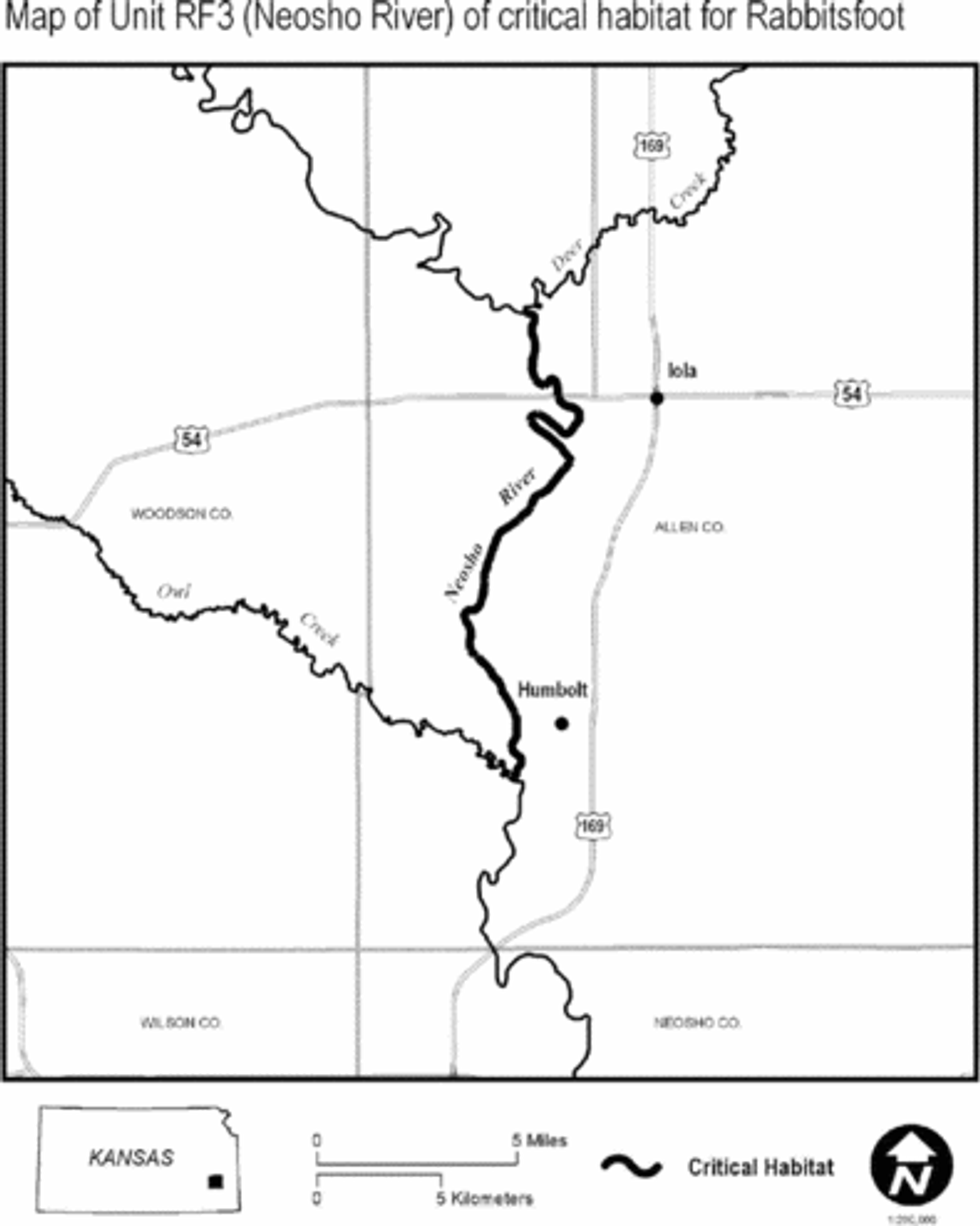
(9) Unit RF4a: Ouachita River - Clark and Hot Spring Counties, Arkansas.
(i) General Description: Unit RF4a includes 22.7 rkm (14.1 rmi) of the Ouachita River from the Tenmile Creek confluence north of Donaldson downstream to the Caddo River confluence near Caddo Valley, Hot Spring and Clark Counties, Arkansas.
(ii) Map of Unit RF4a follows:
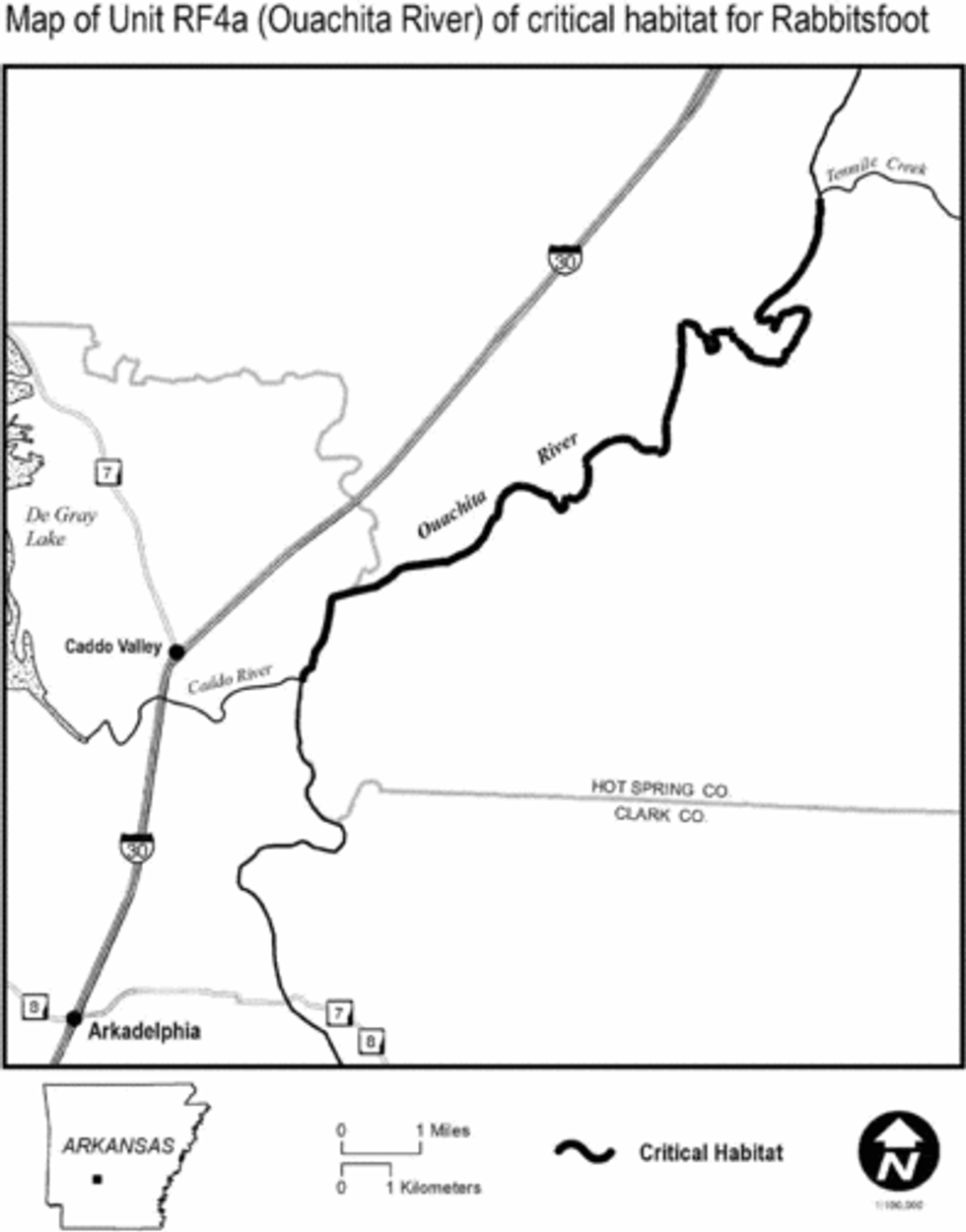
(10) Unit RF4b: Ouachita River - Ouachita County, Arkansas.
(i) General Description: Unit RF4b includes 43.0 rkm (26.7 rmi) of the Ouachita River from the Little Missouri River confluence downstream to U.S. Highway 79 at Camden, Ouachita County, Arkansas.
(ii) Map of Unit RF4b follows:
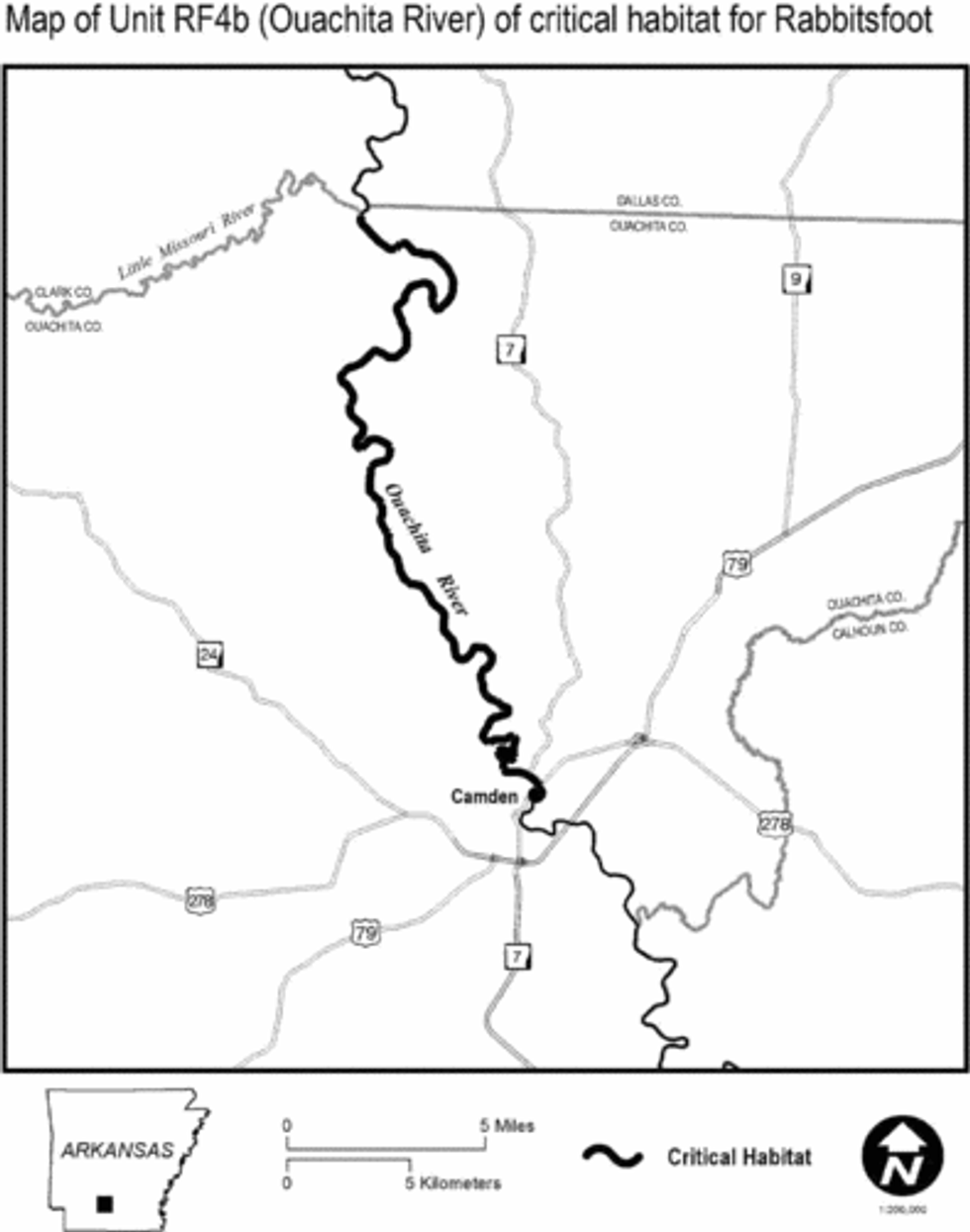
(11) Unit RF5: Saline River - Ashley, Bradley, Cleveland, and Drew Counties, Arkansas.
(i) General Description: Unit RF5 includes 119.4 rkm (74.2 rmi) of the Saline River from the Frazier Creek confluence near Mount Elba, Cleveland County, Arkansas, to the Mill Creek confluence near Stillions, Ashley and Bradley Counties, Arkansas.
(ii) Map of Unit RF5 follows:
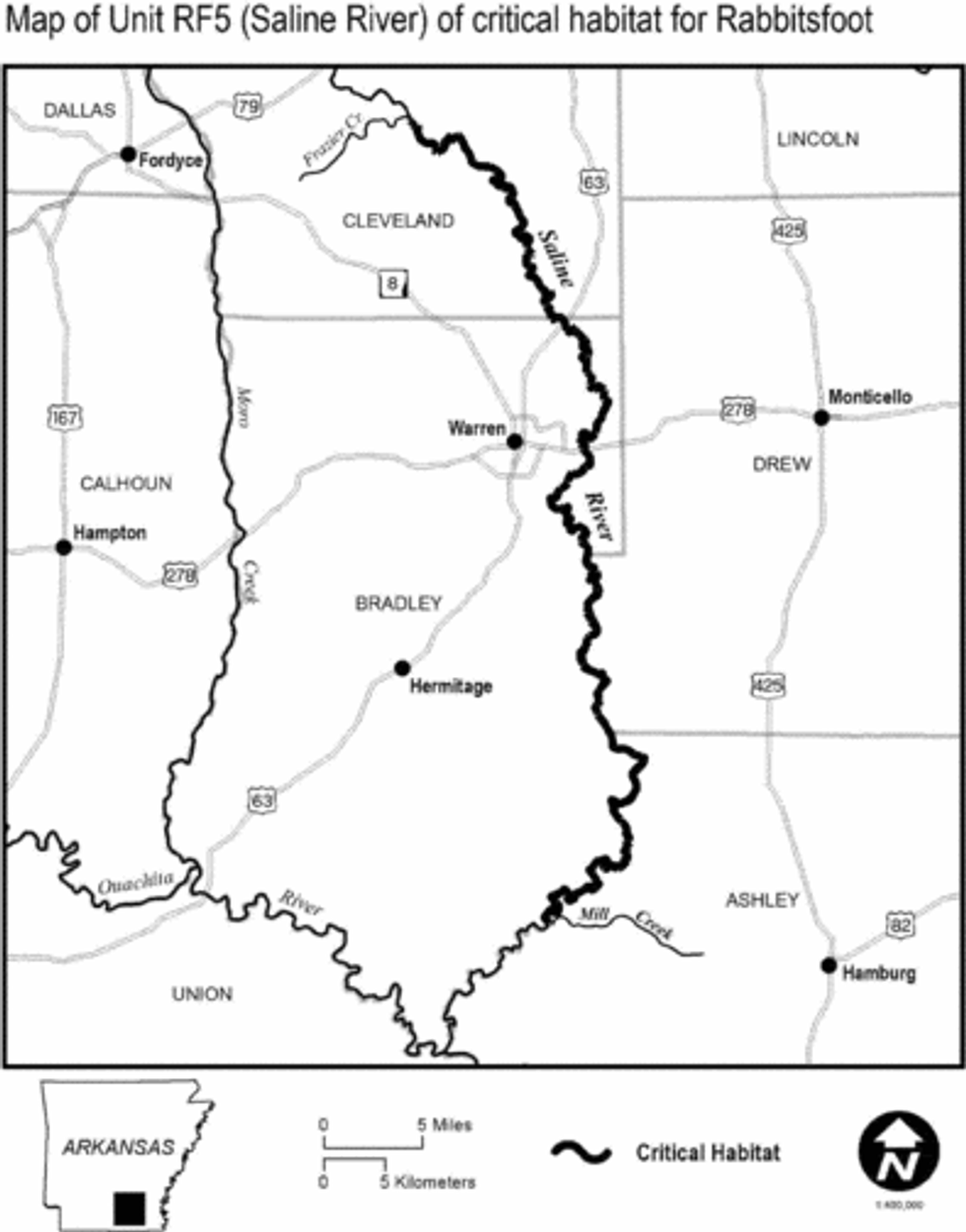
(12) Unit RF6: Little River - McCurtain County, Oklahoma; and Little River and Sevier Counties, Arkansas.
(i) General Description: Unit RF6 includes 139.7 rkm (86.8 rmi) of the Little River from the Glover River confluence northwest of Idabel, McCurtain County, Oklahoma, downstream to U.S. Highway 71 north of Wilton, Little River and Sevier Counties, Arkansas.
(ii) Map of Unit RF6 follows:
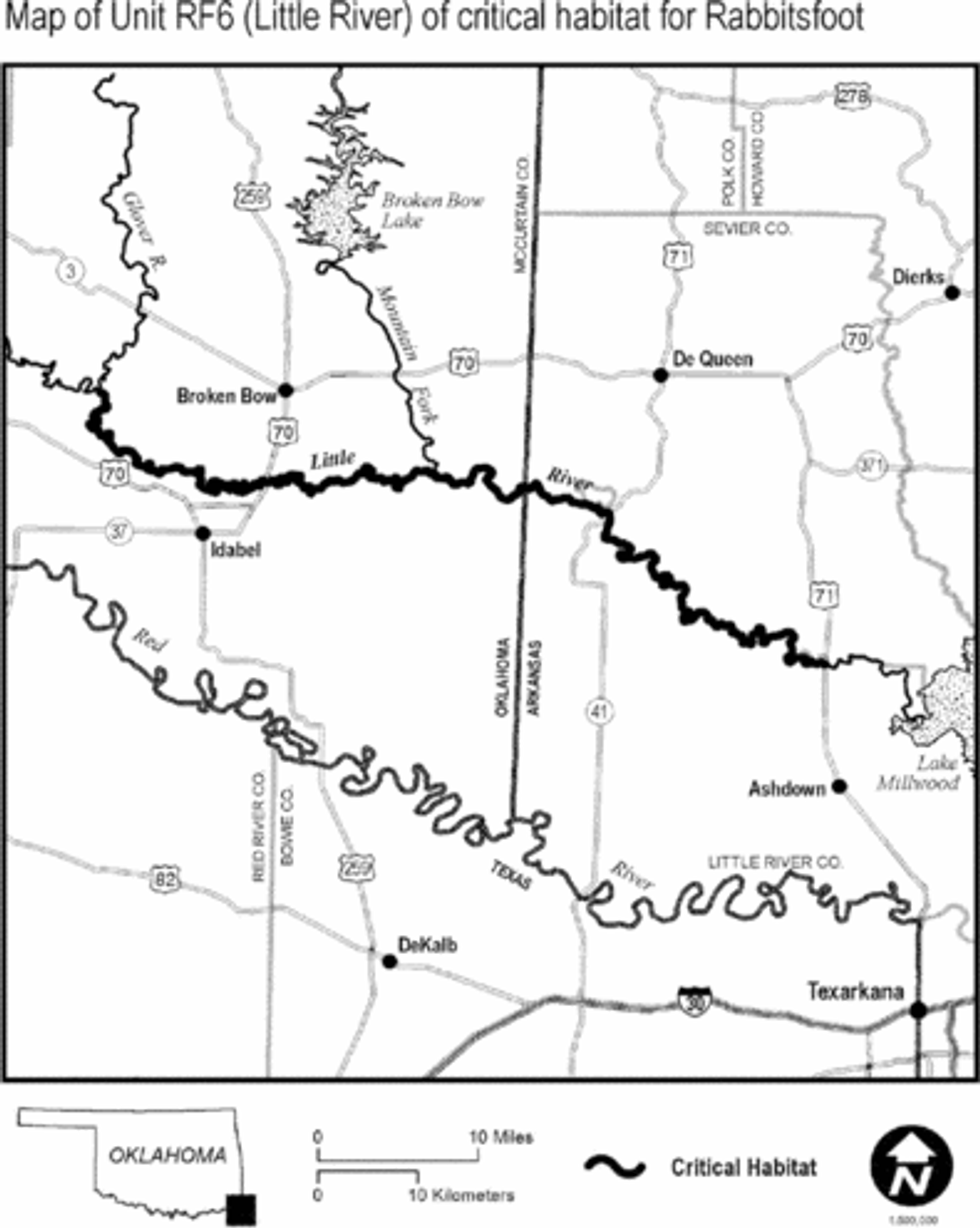
(13) Unit RF7: Middle Fork Little Red River - Cleburne and Van Buren Counties, Arkansas.
(i) General Description: Unit RF7 includes 24.8 rkm (15.4 rmi) of the Middle Fork Little Red River from the confluence of Little Tick Creek north of Shirley, Arkansas, downstream to Greers Ferry Reservoir (where inundation begins), Van Buren County, Arkansas.
(ii) Map of Unit RF7 follows:
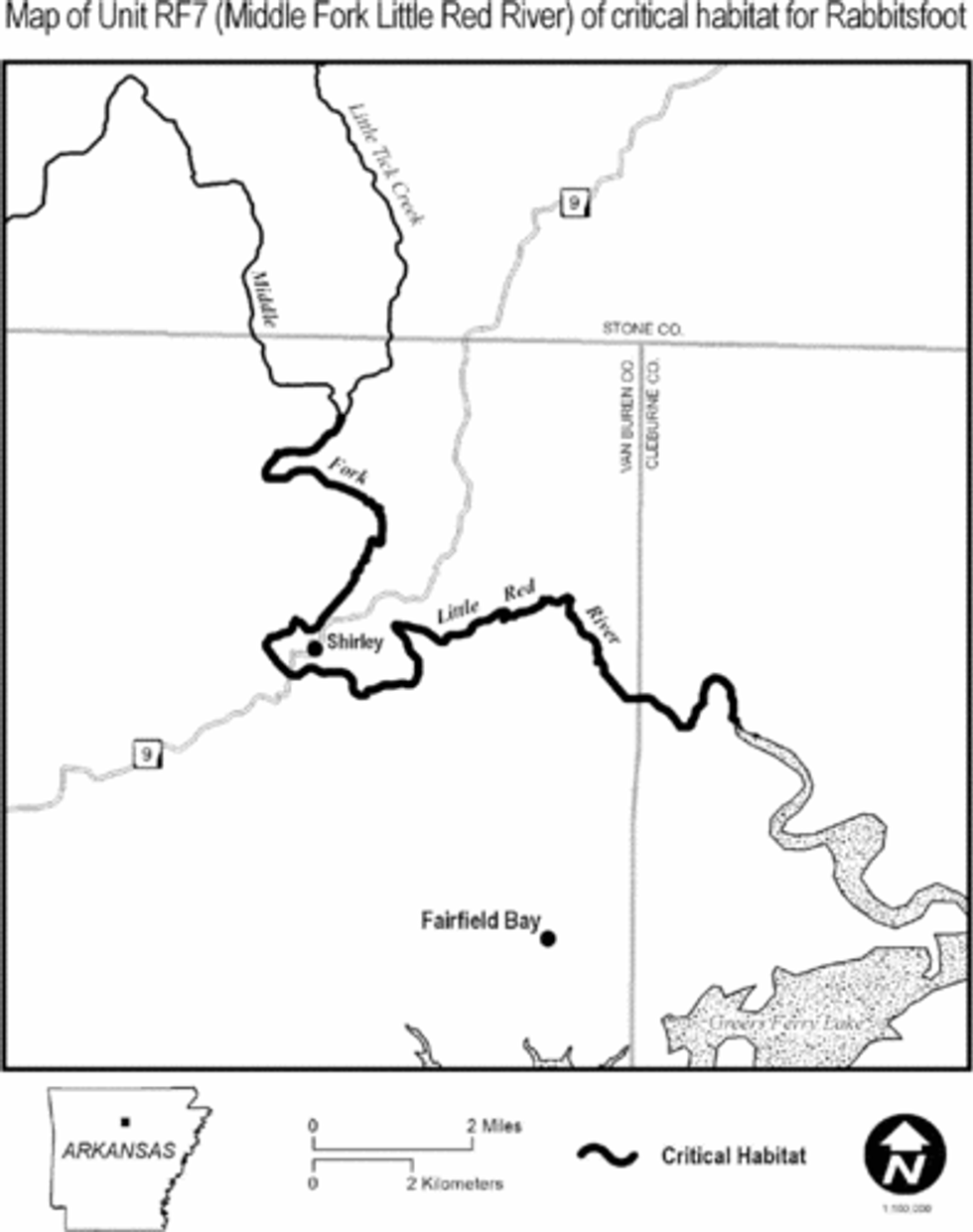
(14) Unit RF8a: White River - Independence, Jackson, White, and Woodruff Counties, Arkansas.
(i) General Description: Unit RF8a includes 188.3 rkm (117.0 rmi) of the White River from the Batesville Dam at Batesville, Independence County, Arkansas, downstream to the Little Red River confluence north of Georgetown, White, and Woodruff Counties, Arkansas.
(ii) Map of Unit RF8a follows:
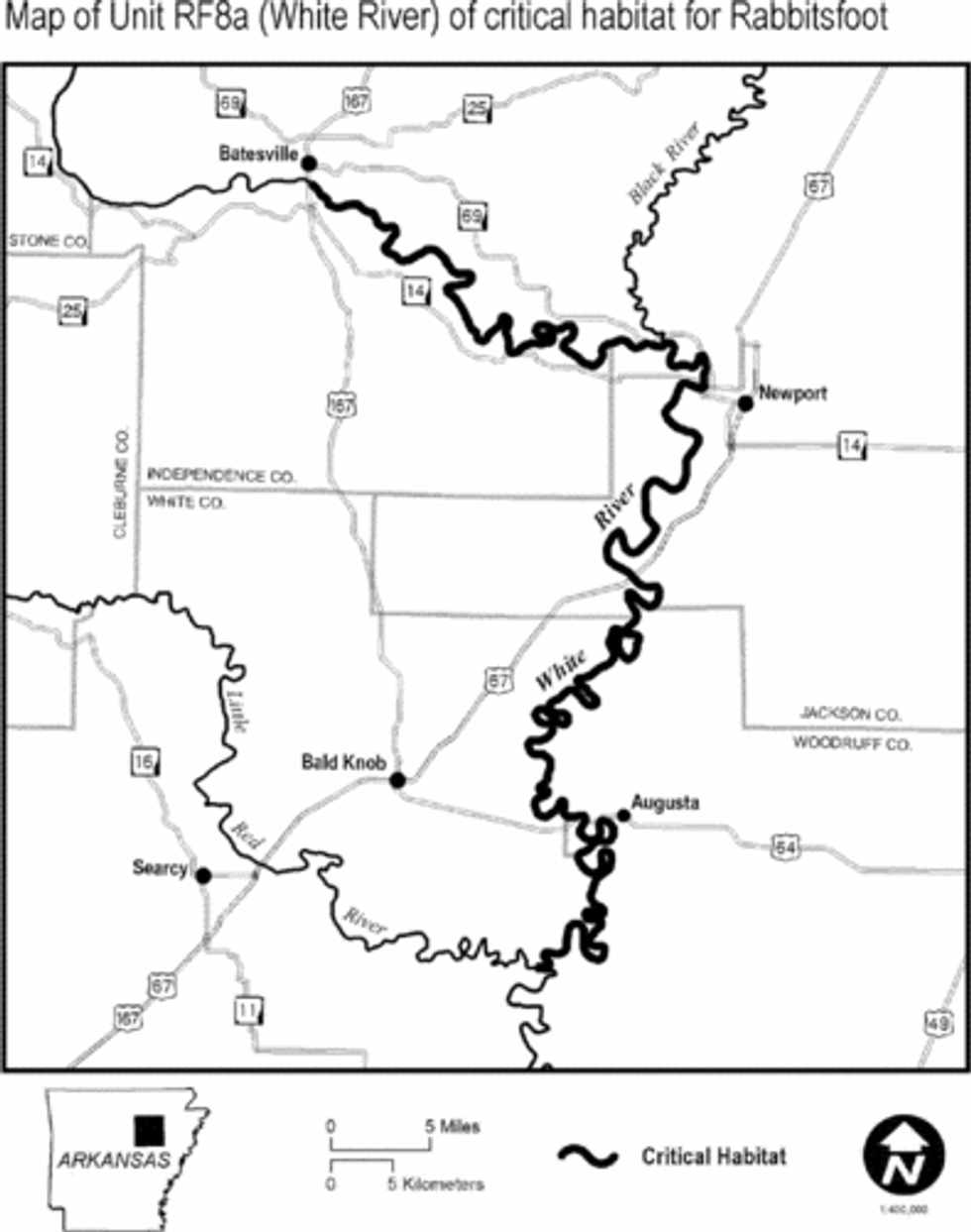
(15) Unit RF8b: White River - Arkansas and Monroe Counties, Arkansas.
(i) General Description: Unit RF8b includes 68.9 rkm (42.8 rmi) of the White River from U.S. Highway 79 at Clarendon, Monroe County, Arkansas, downstream to Arkansas Highway 1 near St. Charles, Arkansas County, Arkansas.
(ii) Map of Unit RF8b follows:
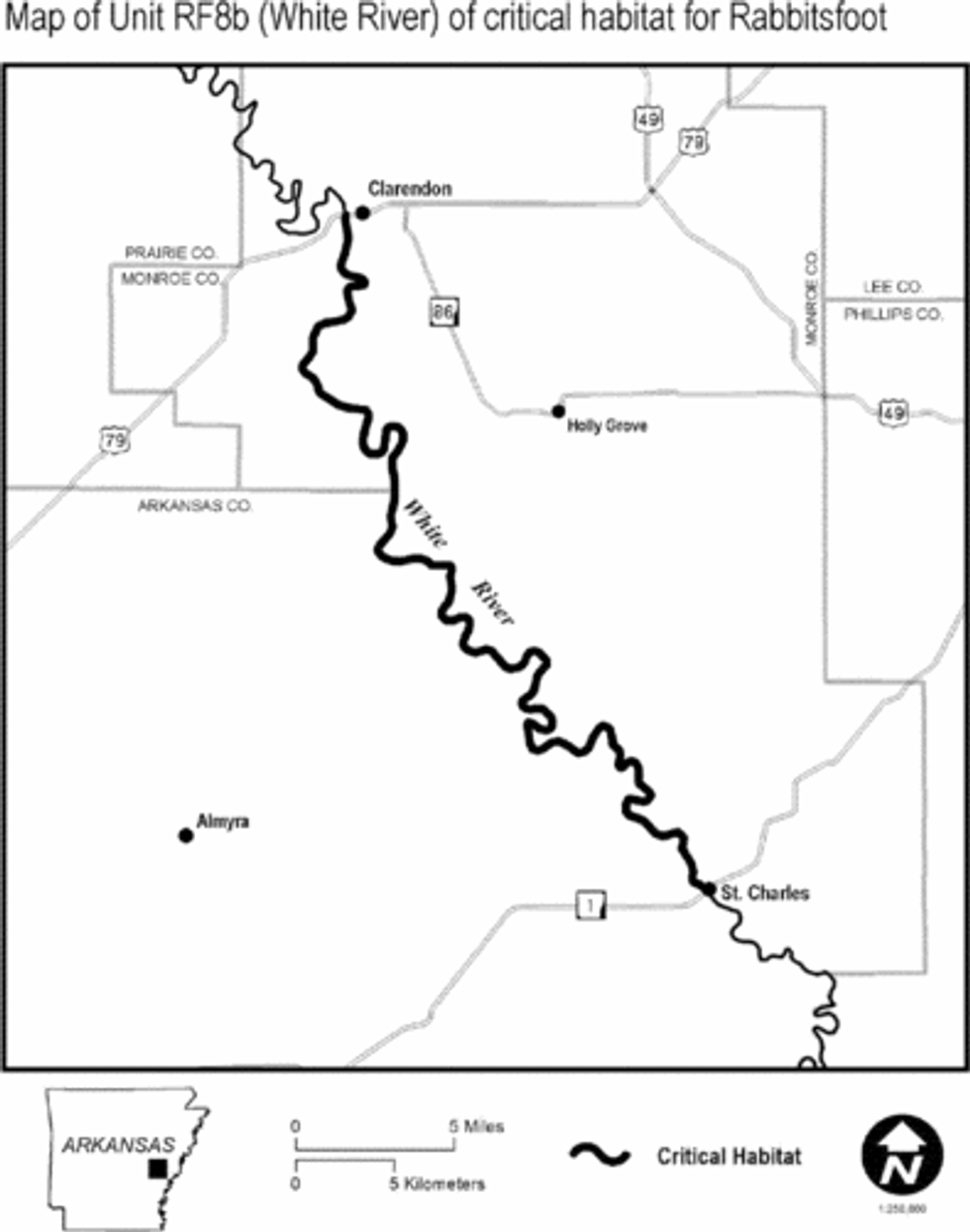
(16) Unit RF9: Black River - Lawrence and Randolph Counties, Arkansas.
(i) General Description: Unit RF9 includes 51.2 rkm (31.8 rmi) of the Black River from U.S. Highway 67 at Pocahontas, Randolph County, Arkansas, downstream to the Flat Creek confluence southeast of Powhatan, Lawrence County, Arkansas.
(ii) Map of Unit RF9 follows:
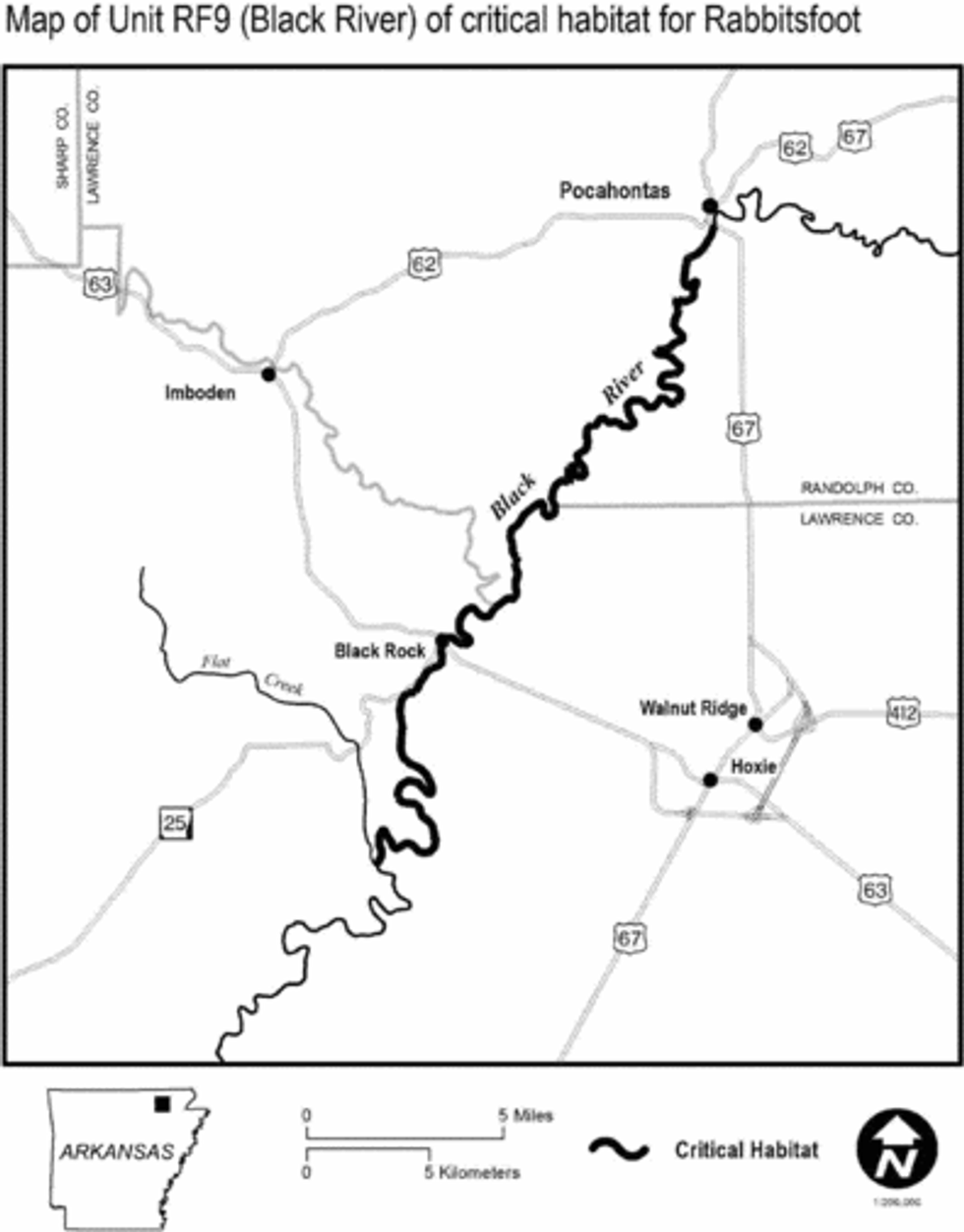
(17) Unit RF10: Spring River - Lawrence, Randolph, and Sharp Counties, Arkansas.
(i) General Description: Unit RF10 includes 51.5 rkm (32.0 rmi) of the Spring River from the Ott Creek confluence southwest of Hardy in Sharp County, Arkansas, downstream to its confluence with the Black River east of Black Rock, Lawrence and Randolph Counties, Arkansas.
(ii) Map of Unit RF10 follows:
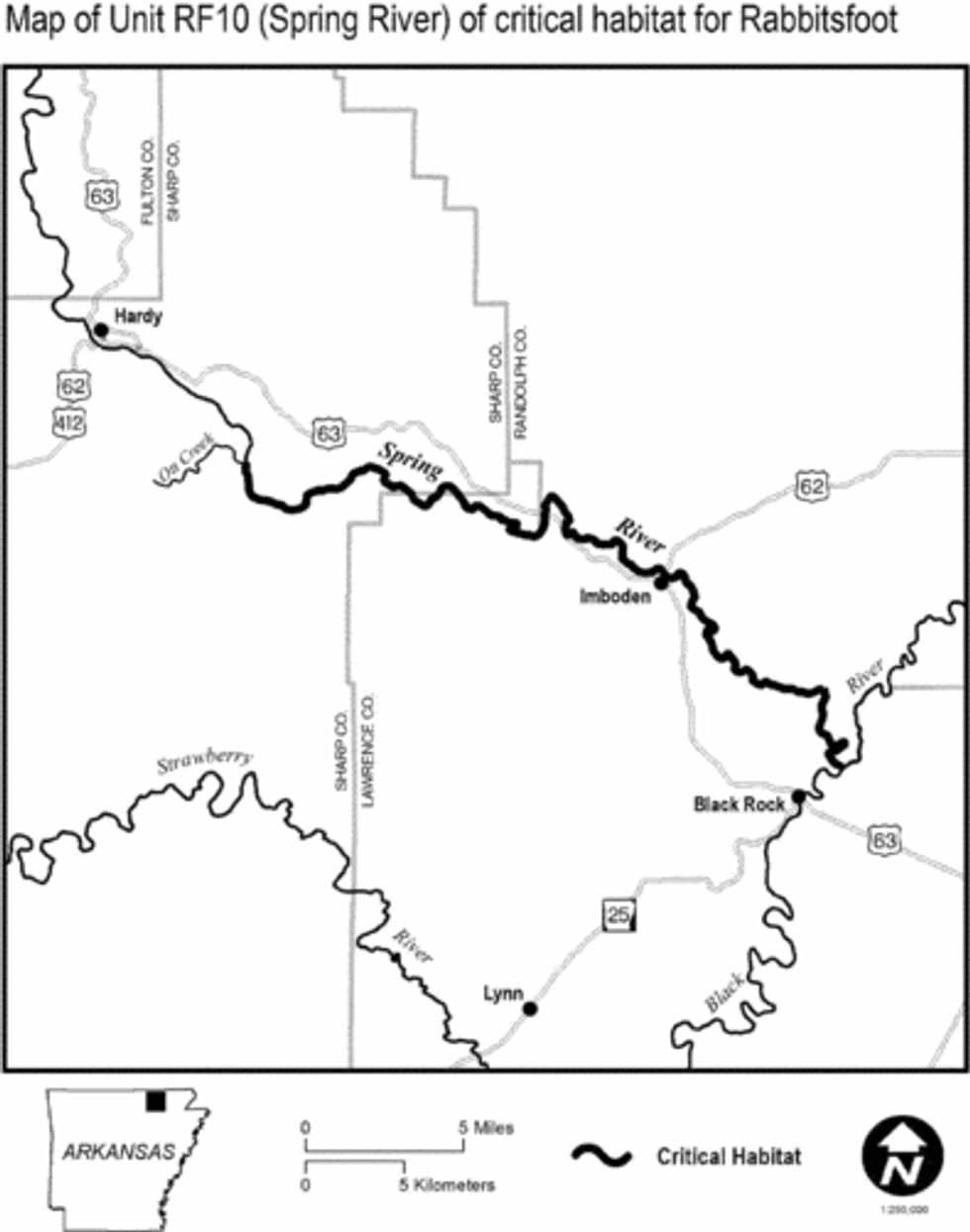
(18) Unit RF11: Strawberry River - Independence, Izard, Lawrence, and Sharp Counties, Arkansas.
(i) General Description: Unit RF11 includes 123.8 rkm (76.9 rmi) of the Strawberry River from Arkansas Highway 56 south of Horseshoe Bend, Izard County, Arkansas, downstream to its confluence with the Black River southeast of Strawberry, Lawrence County, Arkansas.
(ii) Map of Unit RF11 follows:
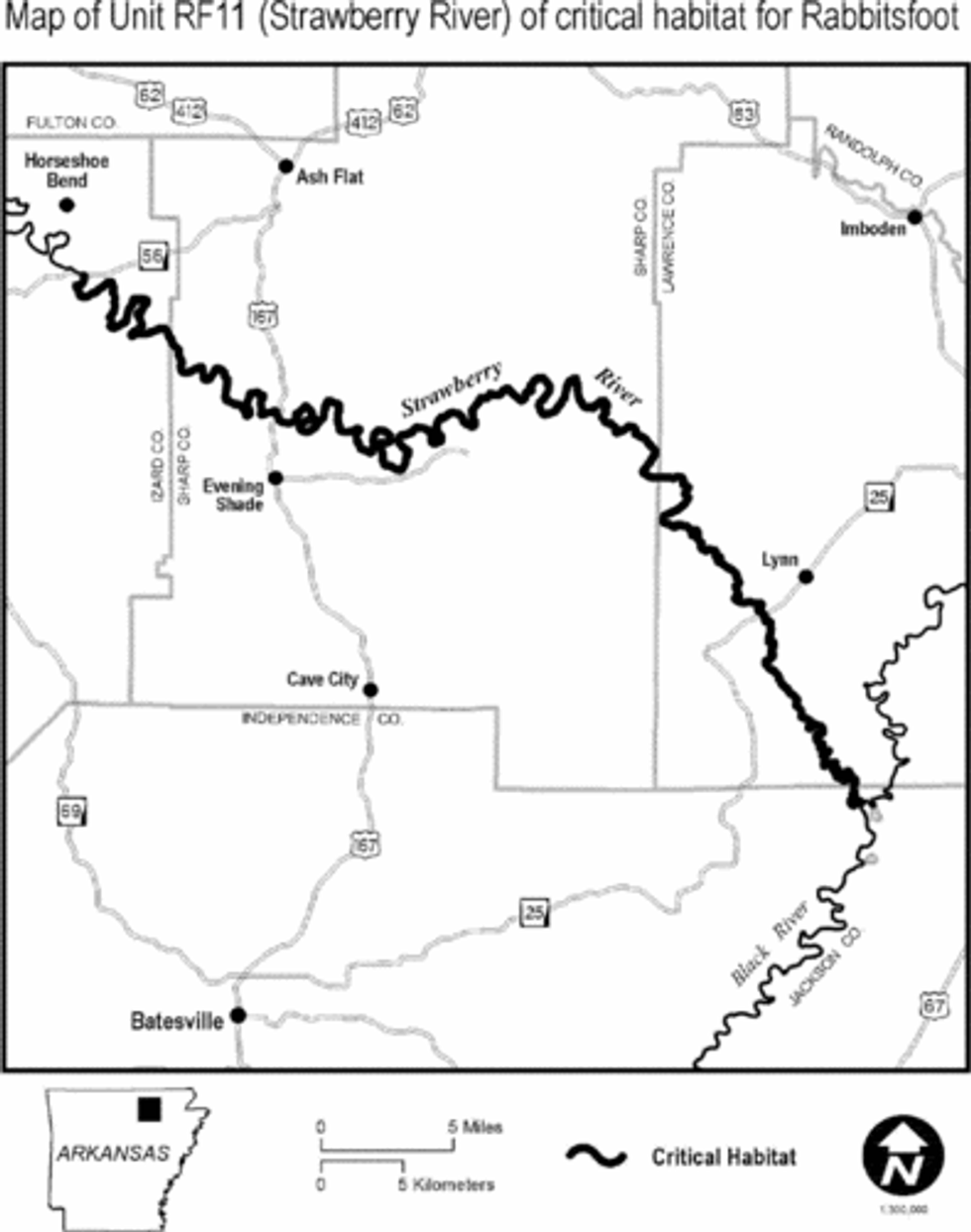
(19) Unit RF12: Buffalo River - Marion, Newton, and Searcy Counties, Arkansas.
(i) General Description: Unit RF12 includes 113.6 rkm (70.6 rmi) of the Buffalo River from the Cove Creek confluence southeast of Erbie, Newton County, Arkansas, downstream to U.S. Highway 65 west of Gilbert, Searcy County, Arkansas, and Arkansas Highway 14 southeast of Mull, Arkansas, downstream to the Leatherwood Creek confluence in the Lower Buffalo Wilderness Area, Arkansas.
(ii) Map of Unit RF12 follows:
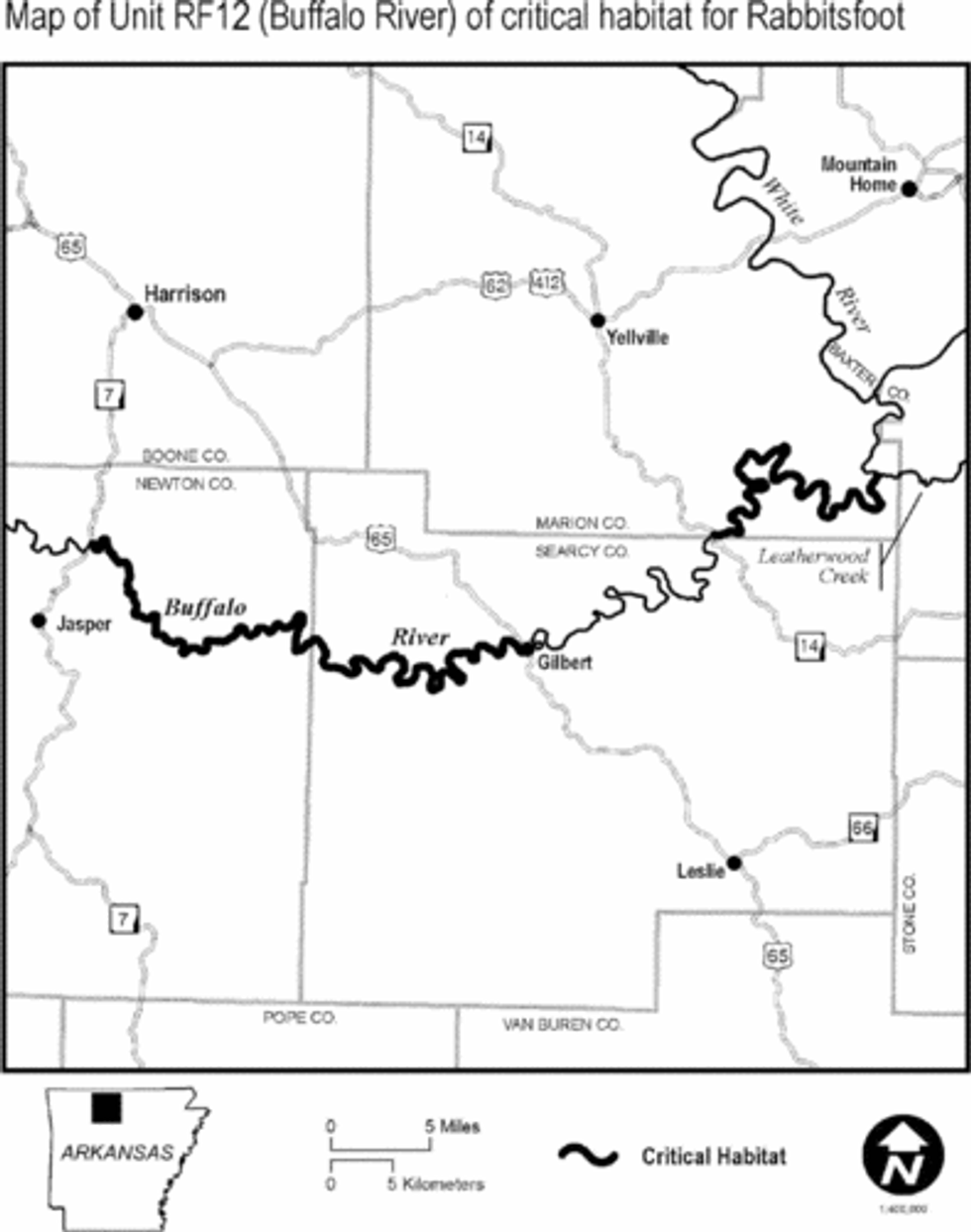
(20) Unit RF13: St. Francis River - Madison and Wayne Counties, Missouri.
(i) General Description: Unit RF13 includes 64.3 rkm (40.0 rmi) of the St. Francis River from the Twelvemile Creek confluence west of Saco, Madison County, Missouri, downstream to Lake Wappepello (where inundation begins), Wayne County, Missouri.
(ii) Map of Unit RF13 follows:
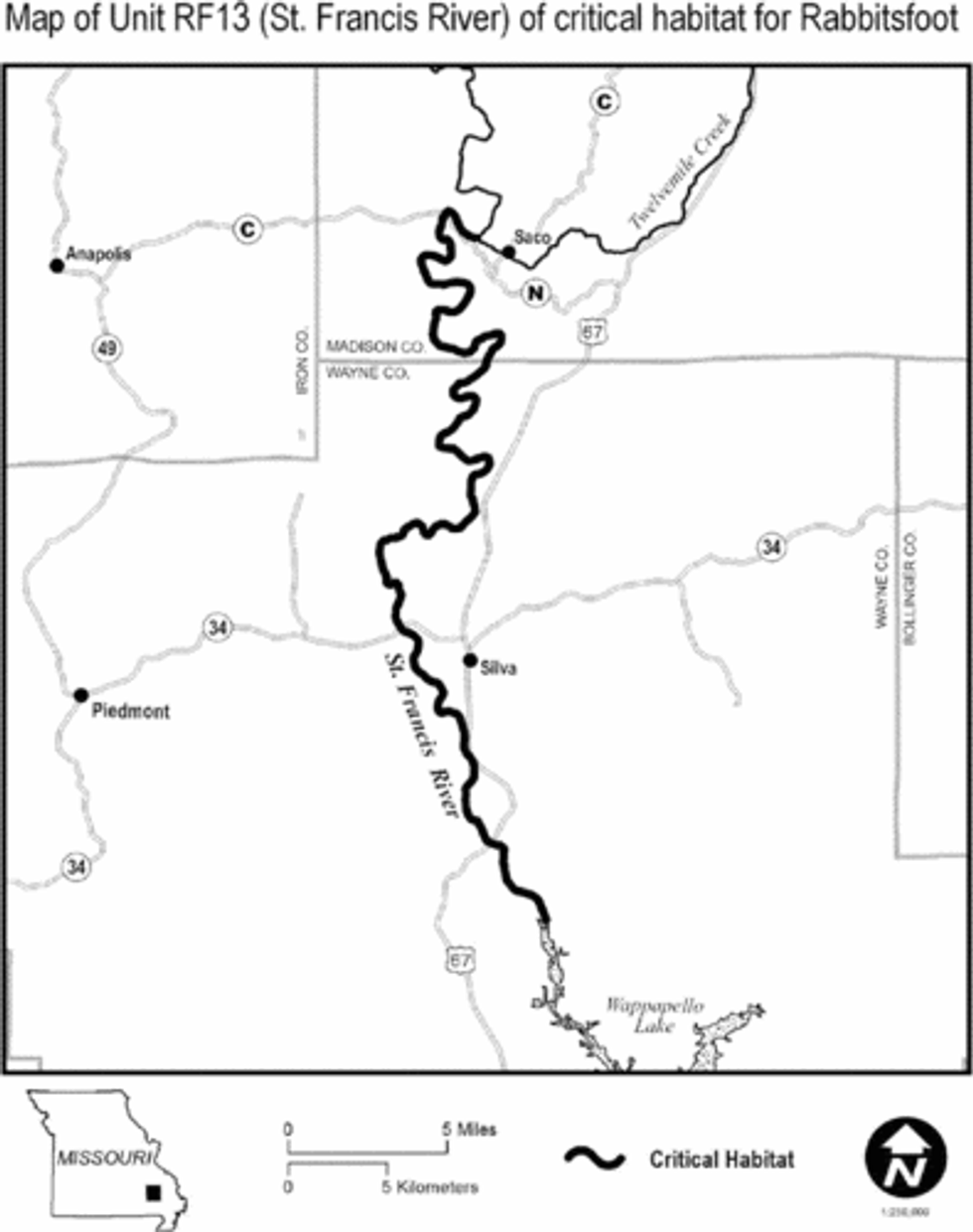
(21) Unit RF14: Big Sunflower River - Sunflower County, Mississippi.
(i) General Description: Unit RF14 includes 51.5 rkm (32.0 rmi) of the Big Sunflower River from Mississippi Highway 442 west of Doddsville, Mississippi, downstream to the Quiver River confluence east of Indianola, Sunflower County, Mississippi.
(ii) Map of Unit RF14 follows:
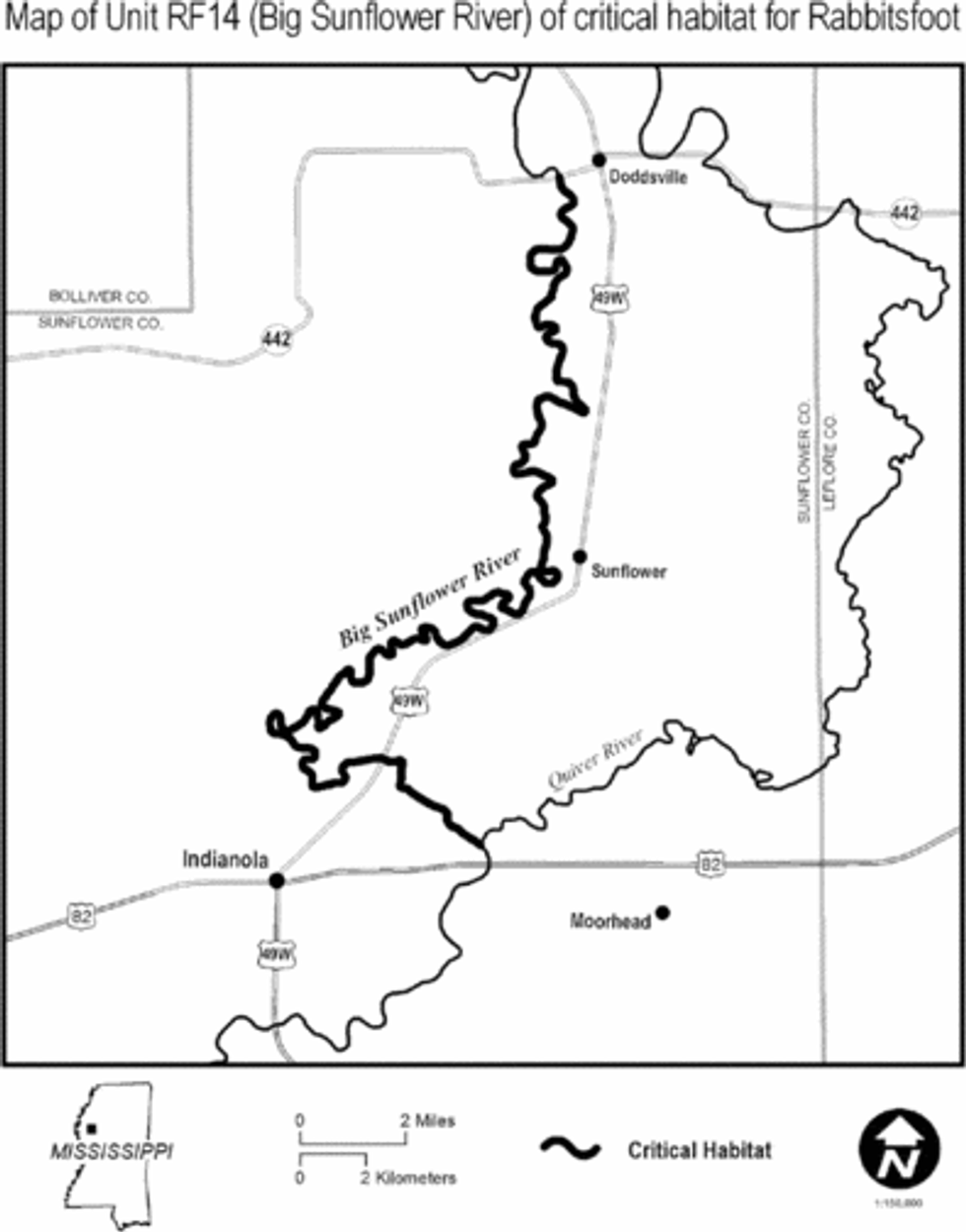
(22) Unit RF15: Bear Creek - Tishomingo County, Mississippi; and Colbert County, Alabama.
(i) General Description: Unit RF15 includes 49.7 rkm (30.9 rmi) of Bear Creek from the Alabama and Mississippi State line east of Golden, Tishomingo County, Mississippi, downstream to Alabama County Road 4 southwest of Sutton Hill, Colbert County, Alabama (just upstream of Pickwick Lake).
(ii) Map of Unit RF15 follows:
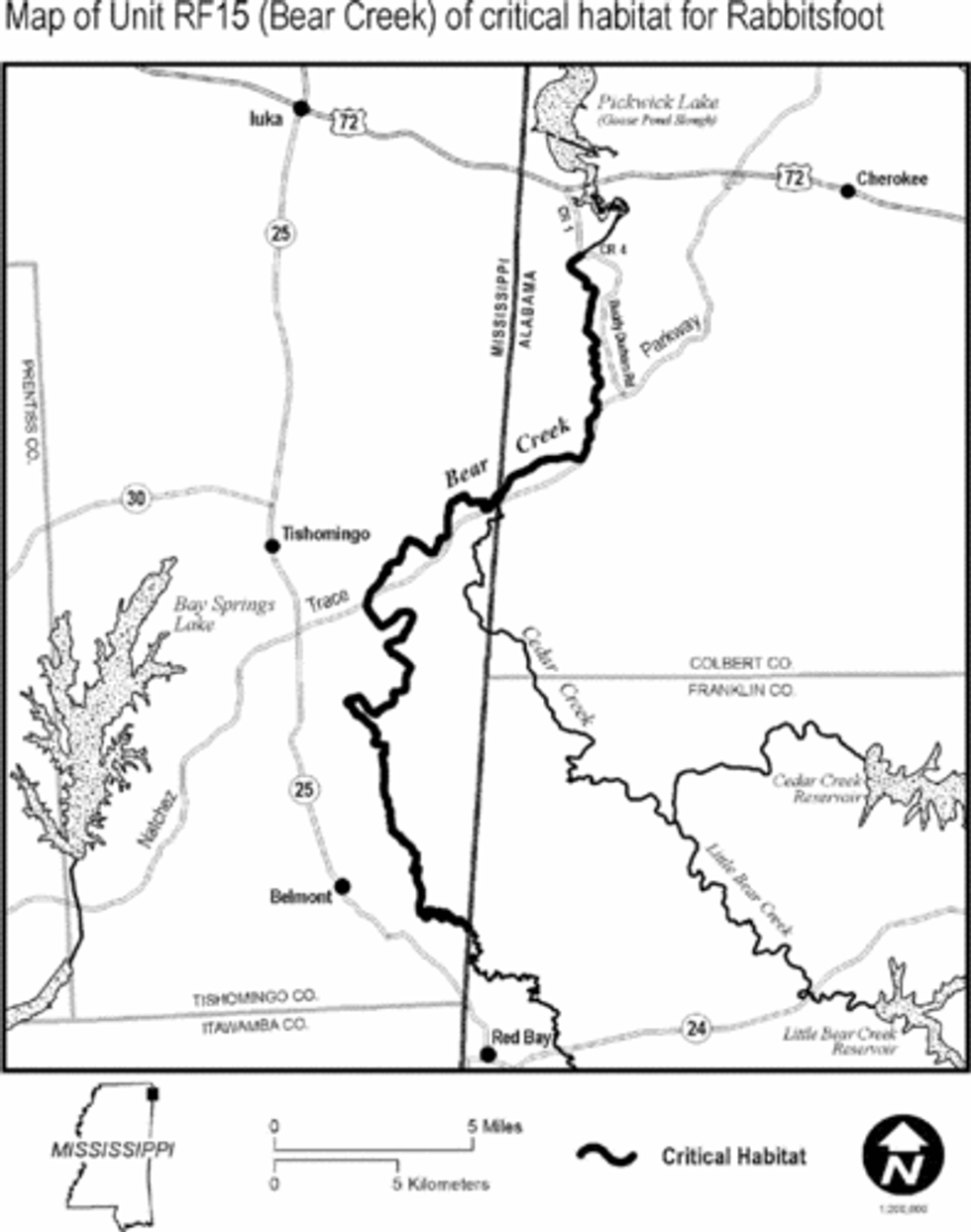
(23) Unit RF16: Big Black River - Hinds and Warren Counties, Mississippi.
(i) General Description: Unit RF16 includes 43.3 rkm (26.9 rmi) of the Big Black River from Porter Creek confluence west of Lynchburg, Hinds County, Mississippi, downstream to Mississippi Highway 27 west of Newman, Warren County, Mississippi.
(ii) Map of Unit RF16 follows:
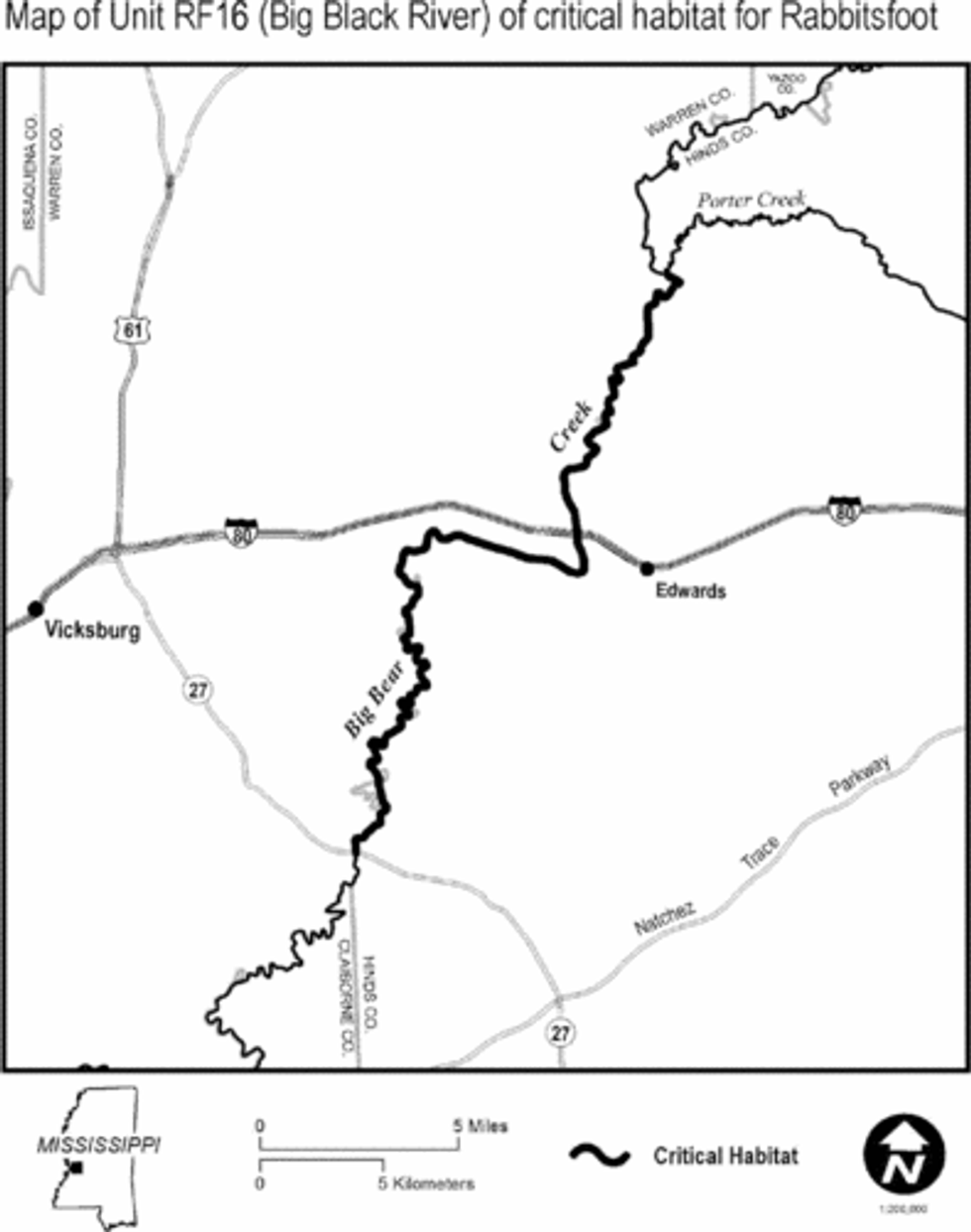
(24) Unit RF17: Paint Rock River - Jackson, Madison, and Marshall Counties, Alabama.
(i) General Description: Unit RF17 includes 81.0 rkm (50.3 rmi) of the Paint Rock River from the convergence of Estill Fork and Hurricane Creek north of Skyline, Jackson County, Alabama, downstream to U.S. Highway 431 south of New Hope, Madison and Marshall Counties, Alabama.
(ii) Map of Unit RF17 follows:
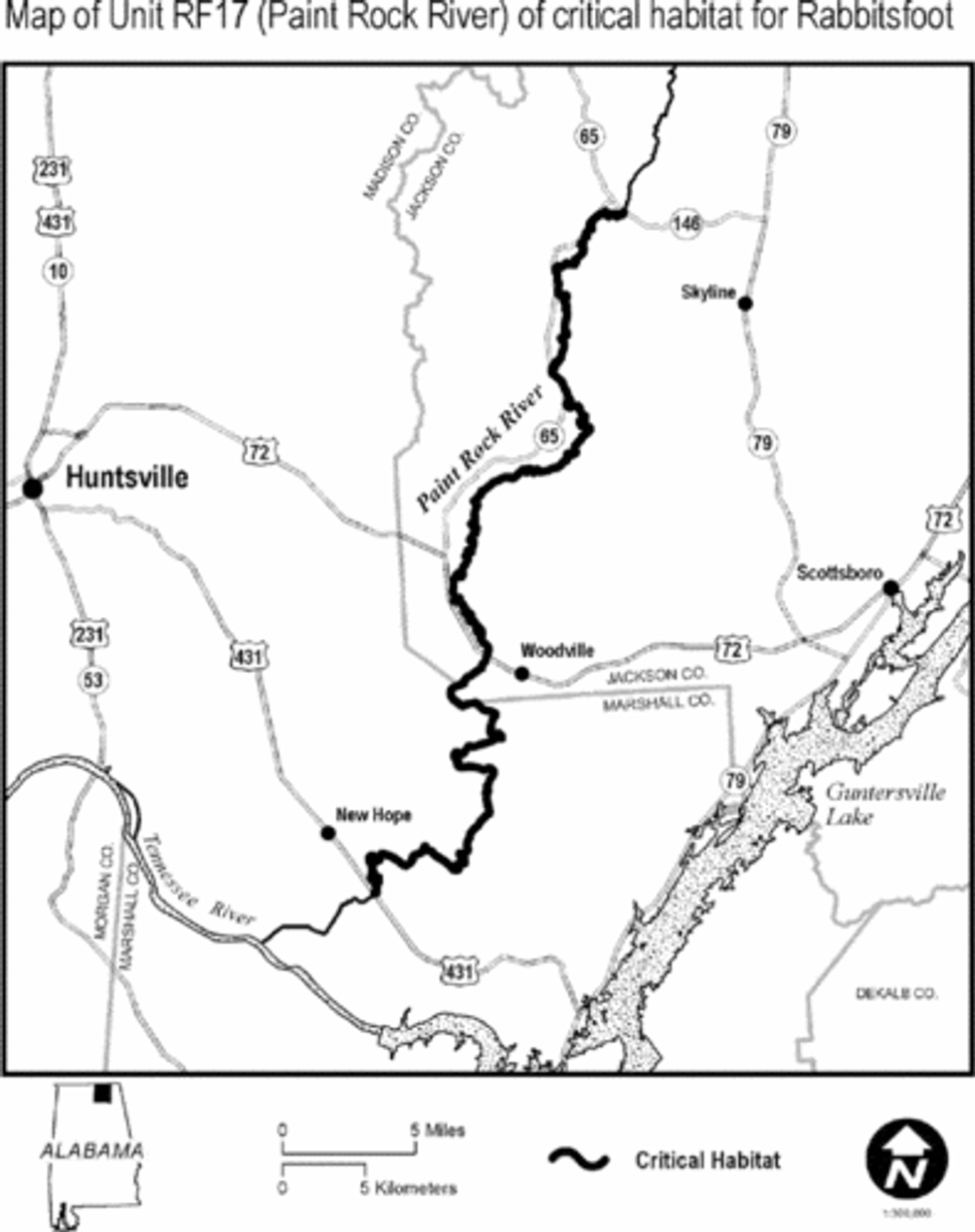
(25) Unit RF18: Duck River - Hickman, Humphreys, Marshall, Maury, and Perry Counties, Tennessee.
(i) General Description: Unit RF18 includes 235.3 rkm (146.2 rmi) of the Duck River from Lillard Mill (rkm 288.1; rmi 179) west of Tennessee Highway 272, Marshall County, Tennessee, downstream to Interstate 40 near Bucksnort, Hickman County, Tennessee.
(ii) Map of Unit RF18 follows:
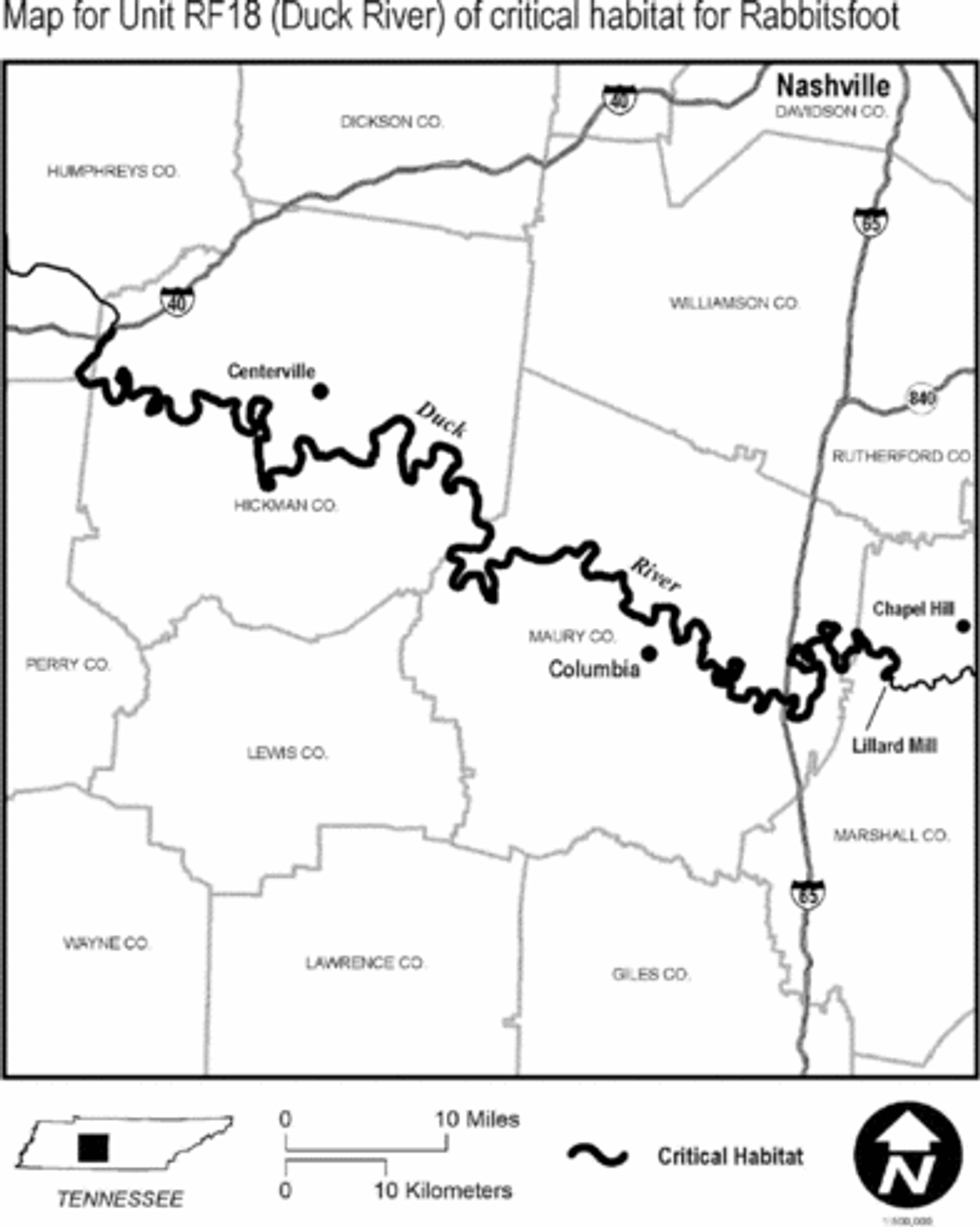
(26) Unit RF19a: Tennessee River - Hardin County, Tennessee.
(i) General Description: Unit RF19a includes 26.7 rkm (16.6 rmi) of the Tennessee River from Pickwick Lake Dam downstream to U.S. Highway 64 near Adamsville, Hardin County, Tennessee.
(ii) Map of Unit RF19a follows:
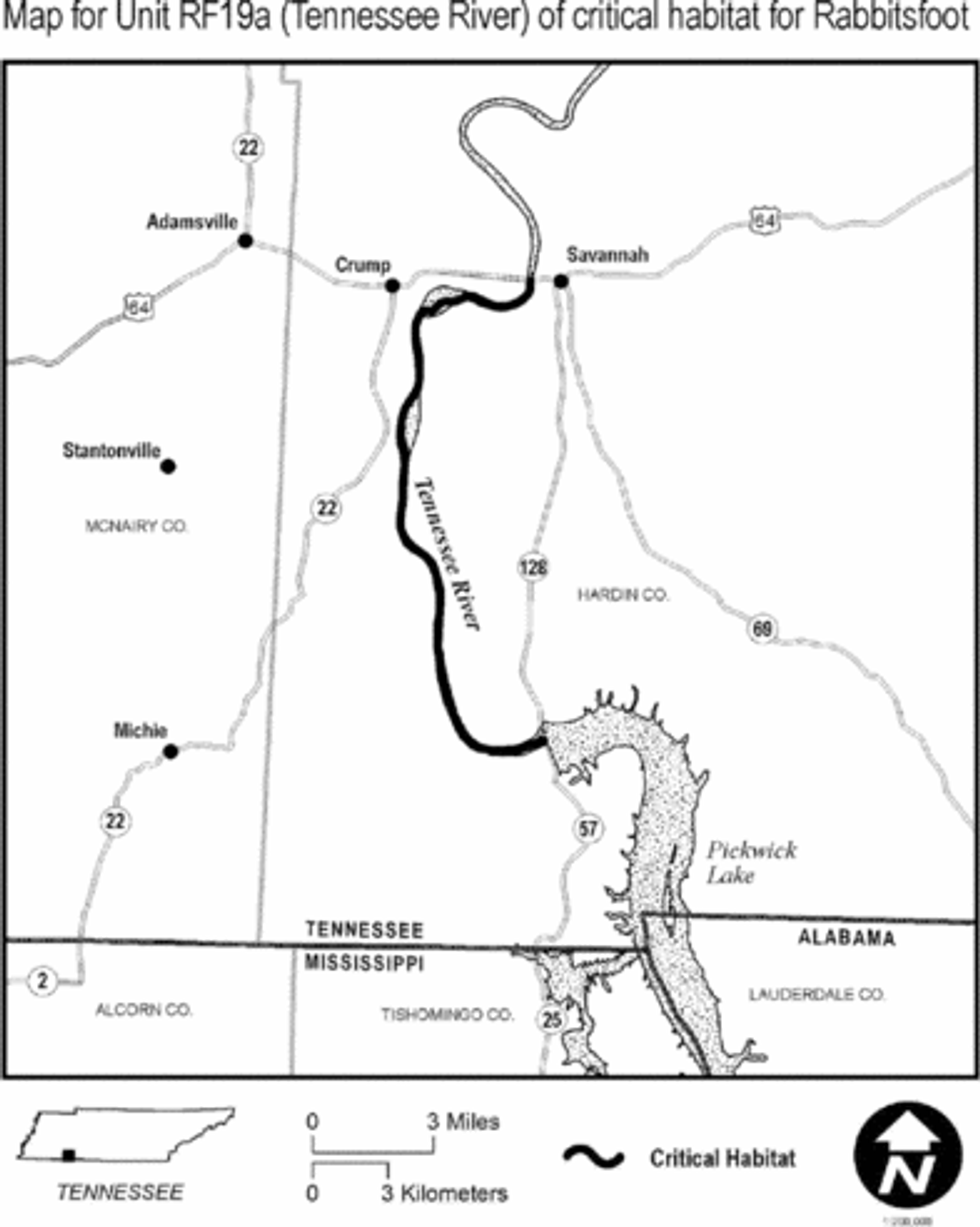
(27) Unit RF19b: Tennessee River - Livingston, Marshall, and McCracken Counties, Kentucky.
(i) General Description: Unit RF19b includes 35.6 rkm (22.1 rmi) of the Tennessee River from Kentucky Lake Dam, downstream to its confluence with the Ohio River, McCracken and Livingston Counties, Kentucky.
(ii) Map of Unit RF19b follows:
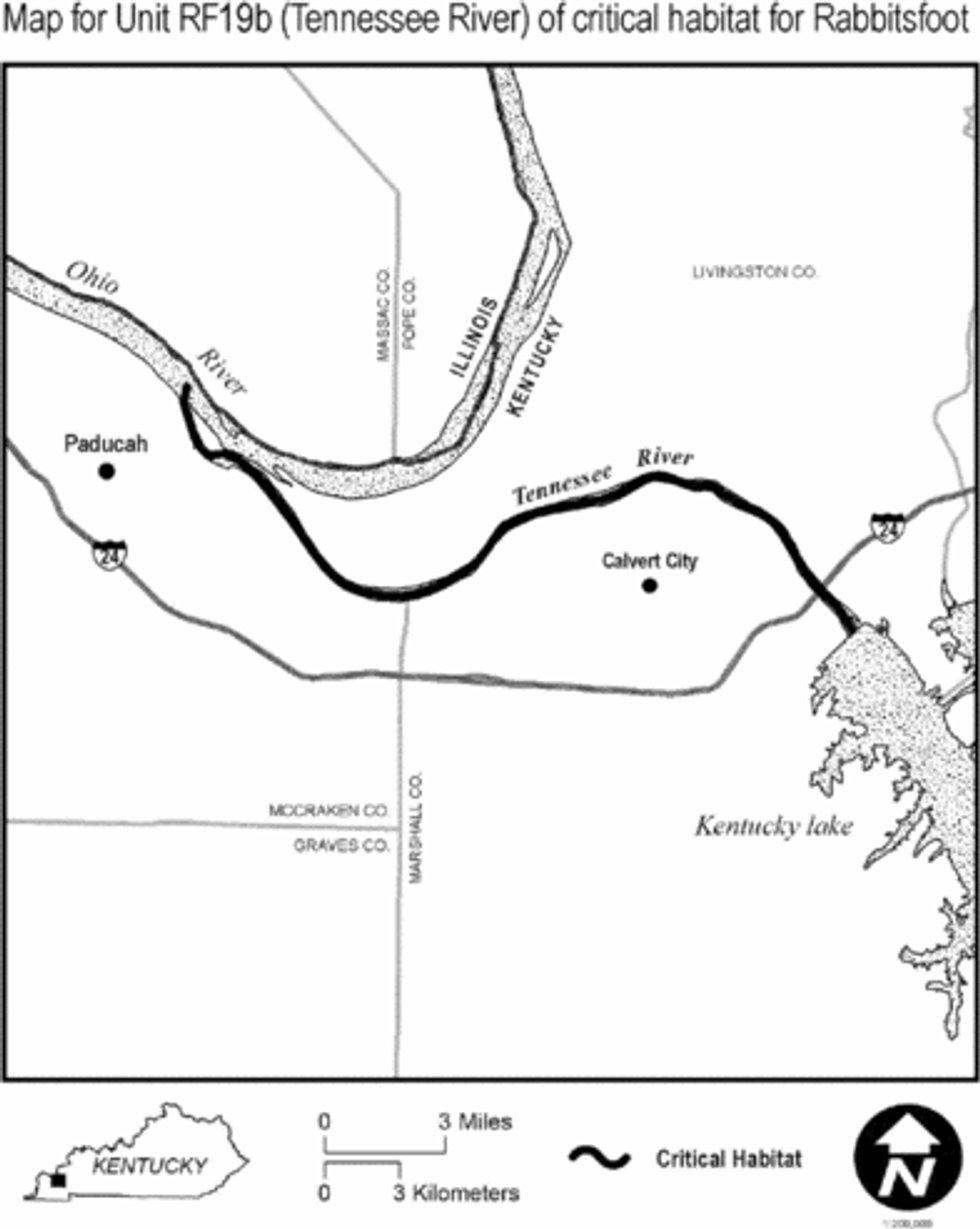
(28) Unit RF20: Ohio River - Ballard, and McCracken Counties, Kentucky; Massac and Pulaski Counties, Illinois.
(i) General Description: Unit RF20 includes 45.9 rkm (28.5 rmi) of the Ohio River from the Tennessee River confluence at the downstream extent of Owens Island downstream to Lock and Dam 53 near Olmstead, Illinois.
(ii) Map of Unit RF20 follows:
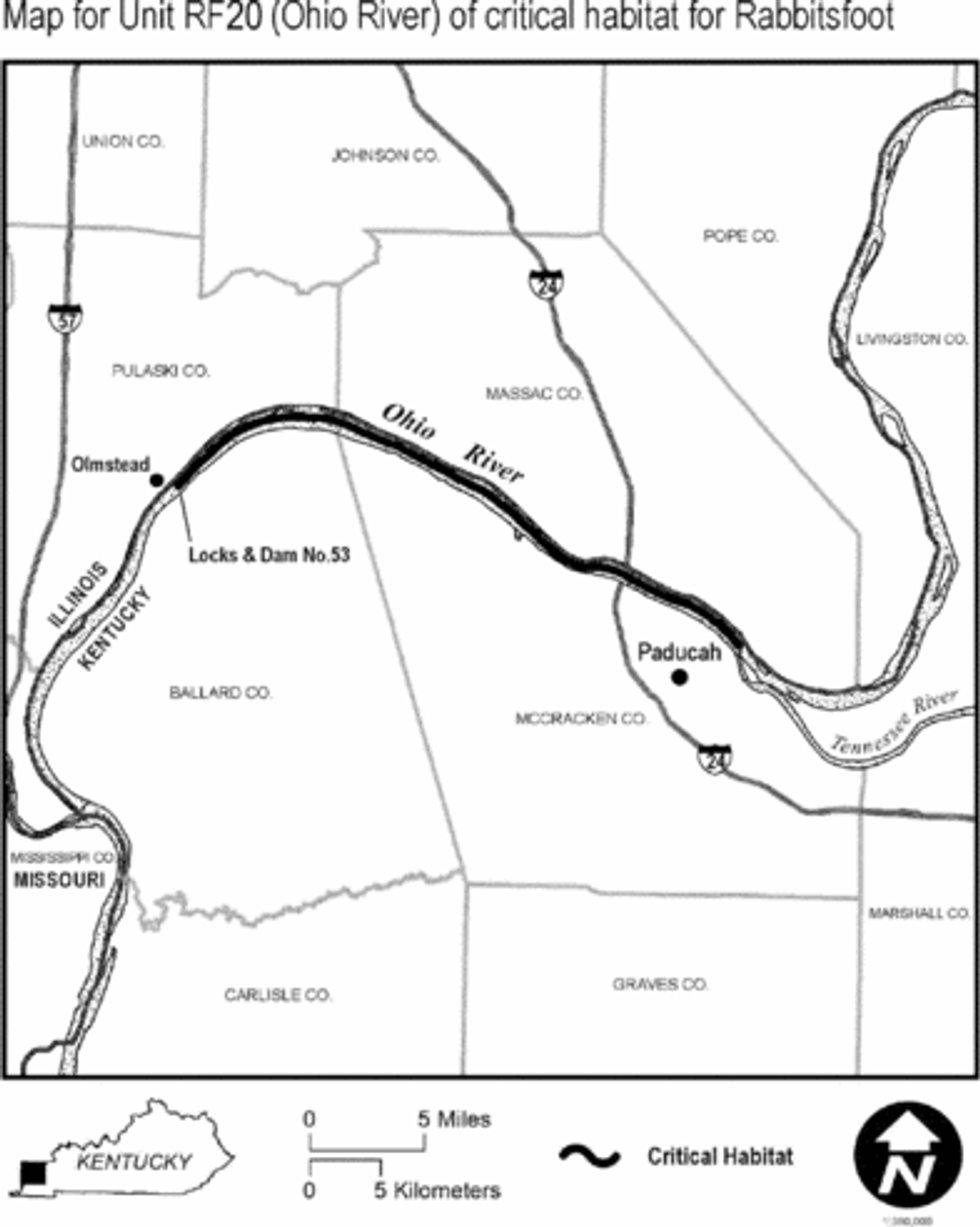
(29) Unit RF21: Green River - Edmonson, Green, Hart, and Taylor Counties, Kentucky.
(i) General Description: Unit RF21 includes 175.6 rkm (109.1 rmi) of the Green River from Green River Lake Dam south of Campbellsville, Taylor County, Kentucky, downstream to Mammoth Cave National Park North Entrance Road in Mammoth Cave National Park, Kentucky.
(ii) Map of Unit RF21 follows:
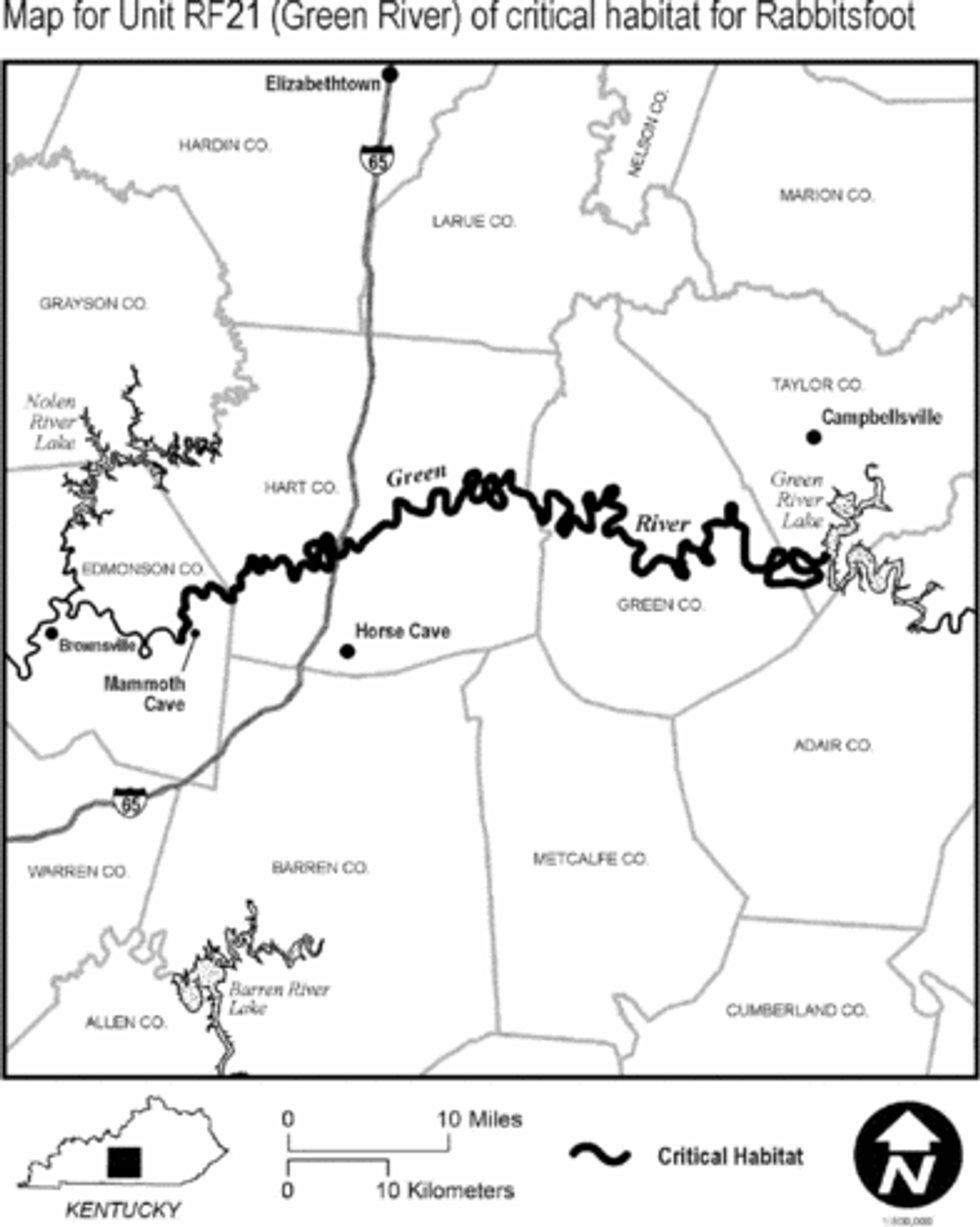
(30) Unit RF22: French Creek - Crawford, Erie, Mercer, and Venango Counties, Pennsylvania.
(i) General Description: Unit RF22 includes 120.4 rkm (74.8 rmi) of French Creek from Union City Reservoir Dam northeast of Union City, Erie County, Pennsylvania, downstream to its confluence with the Allegheny River near Franklin, Venango County, Pennsylvania.
(ii) Map of Unit RF22 follows:
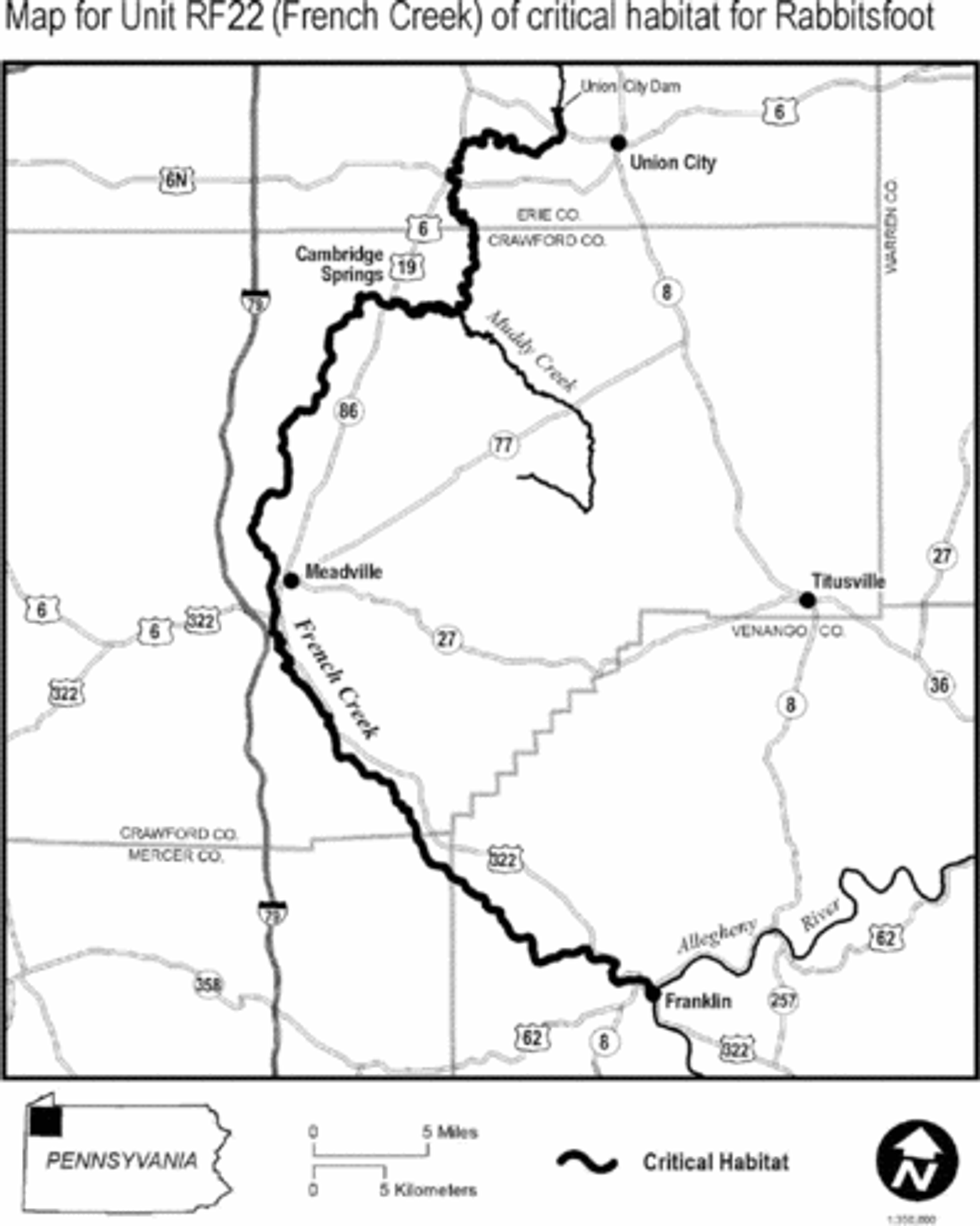
(31) Unit RF23: Allegheny River - Venango County, Pennsylvania.
(i) General Description: Unit RF23 includes 57.3 rkm (35.6 rmi) of the Allegheny River from the French Creek confluence near Franklin, Venango County, Pennsylvania, downstream to Interstate 80 near Emlenton, Venango County, Pennsylvania.
(ii) Map of Unit RF23 follows:
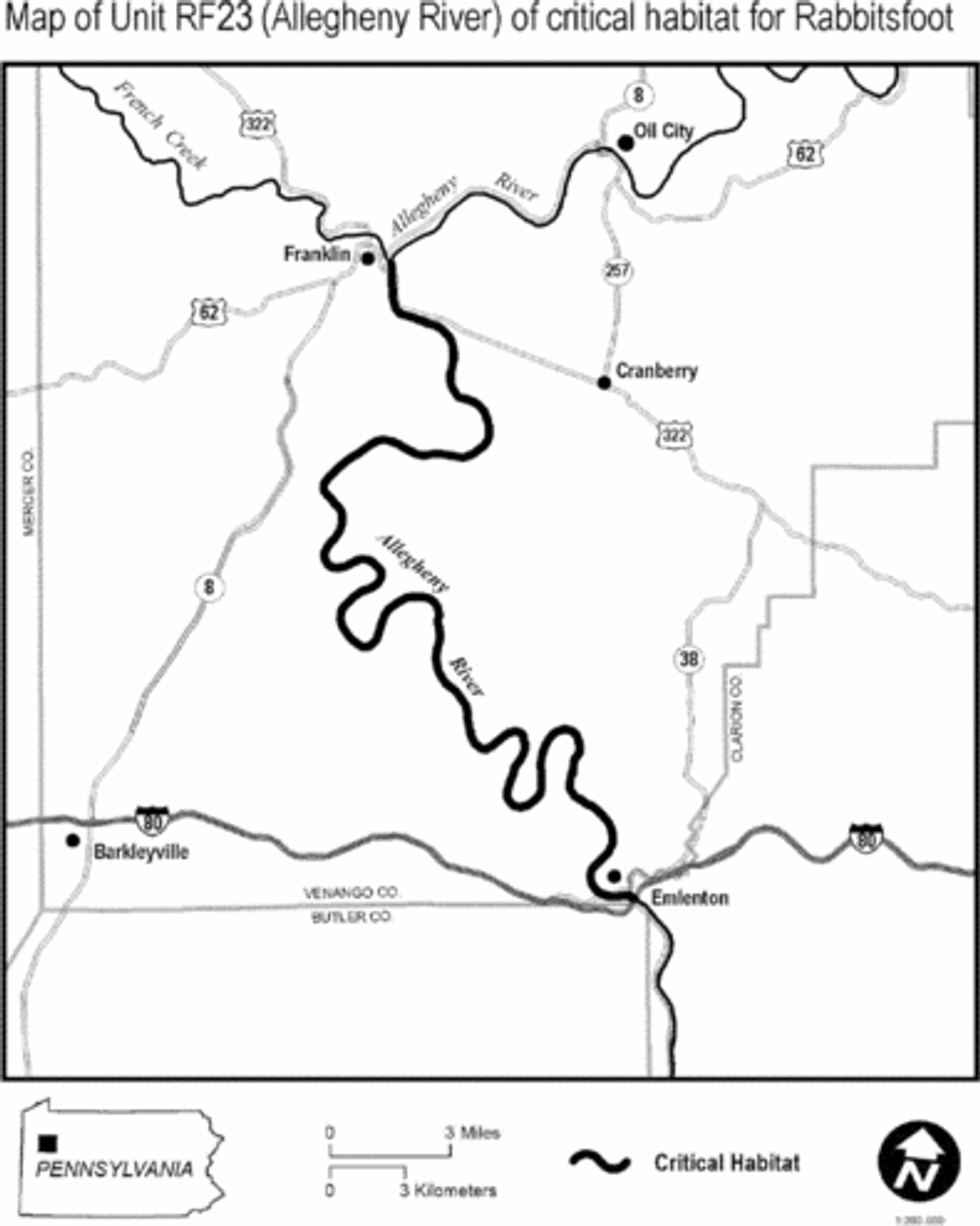
(32) Unit RF24: Muddy Creek - Crawford County, Pennsylvania.
(i) General Description: Unit RF24 includes 20.1 rkm (12.5 rmi) of Muddy Creek from Pennsylvania Highway 77 near Little Cooley, Crawford County, Pennsylvania, downstream to its confluence with French Creek east of Cambridge Springs, Crawford County, Pennsylvania.
(ii) Map of Unit RF24 follows:
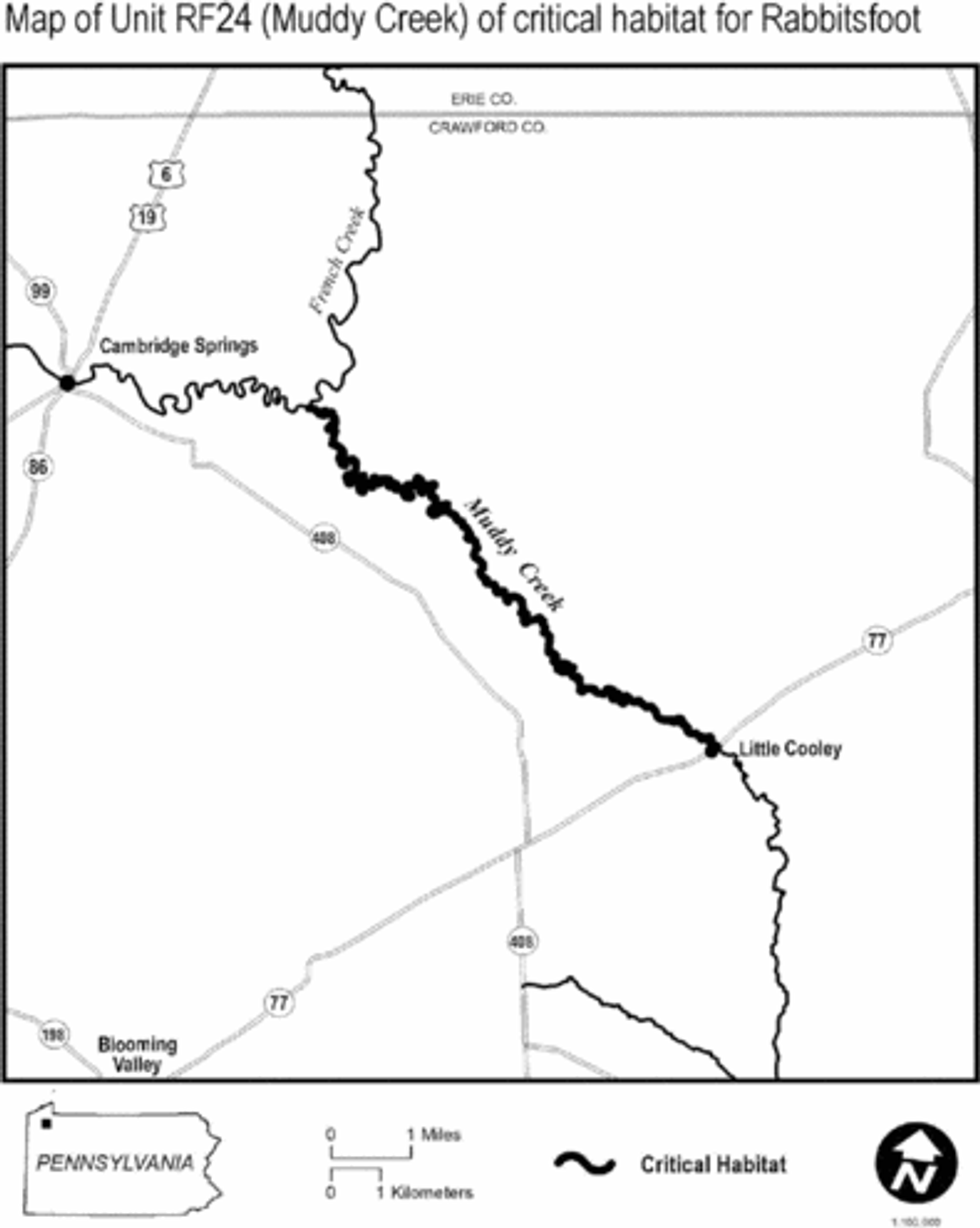
(33) Unit RF25: Tippecanoe River - Carroll, Pulaski, Tippecanoe, and White Counties, Indiana.
(i) General Description: Unit RF25 includes 75.6 rkm (47.0 rmi) of the Tippecanoe River from Indiana Highway 14 near Winamac, Pulaski County, Indiana, downstream to its confluence with the Wabash River northeast of Battle Ground, Tippecanoe County, Indiana, excluding Lakes Shafer and Freeman and the stream reach between the two lakes.
(ii) Map of Unit RF25 follows:
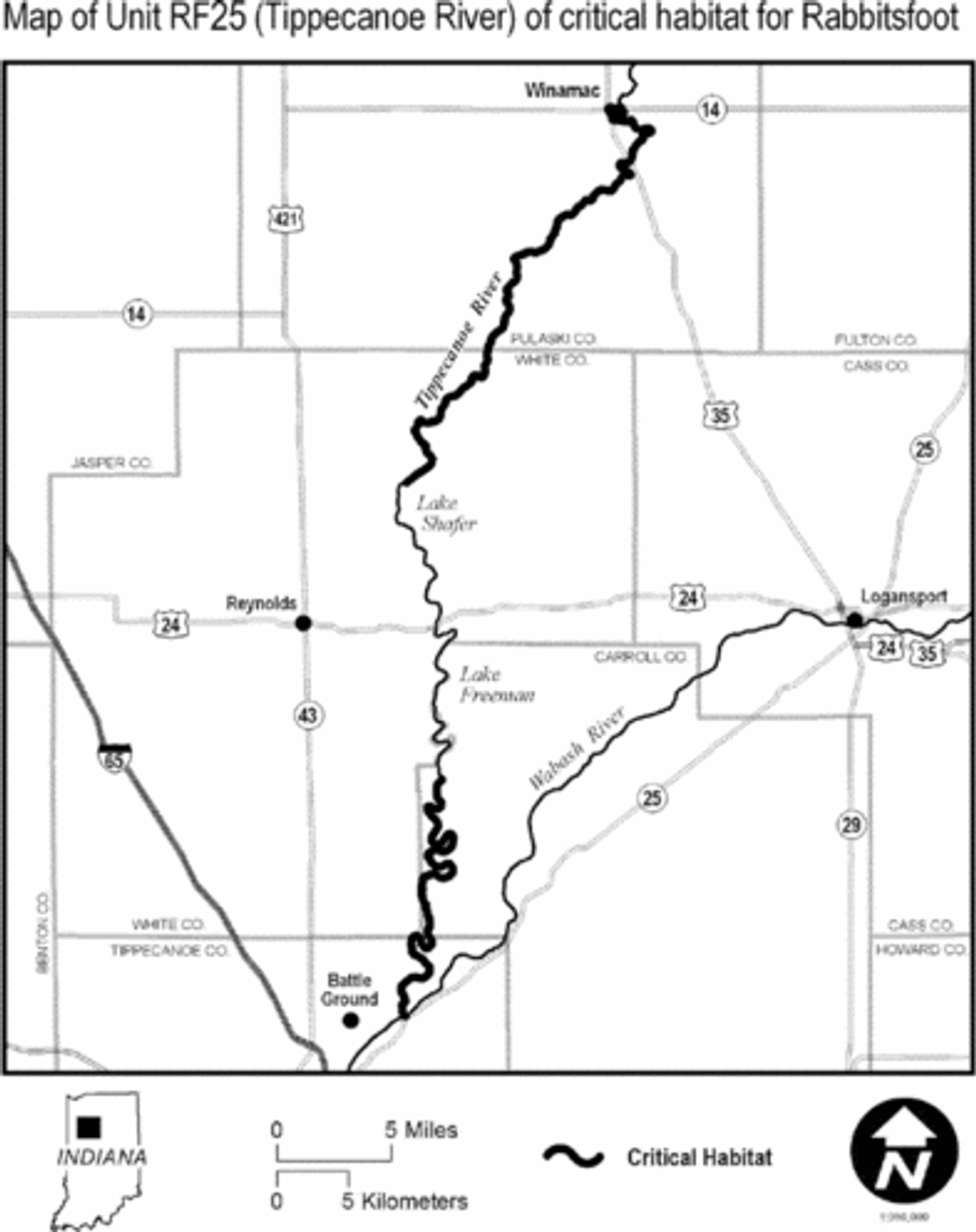
(34) Unit RF26: Walhonding River - Coshocton County, Ohio.
(i) General Description: Unit RF26 includes 17.5 rkm (10.9 rmi) of the Walhonding River from the convergence of the Kokosing and Mohican Rivers downstream to Ohio Highway 60 near Warsaw, Coshocton County, Ohio.
(ii) Map of Unit RF26 follows:
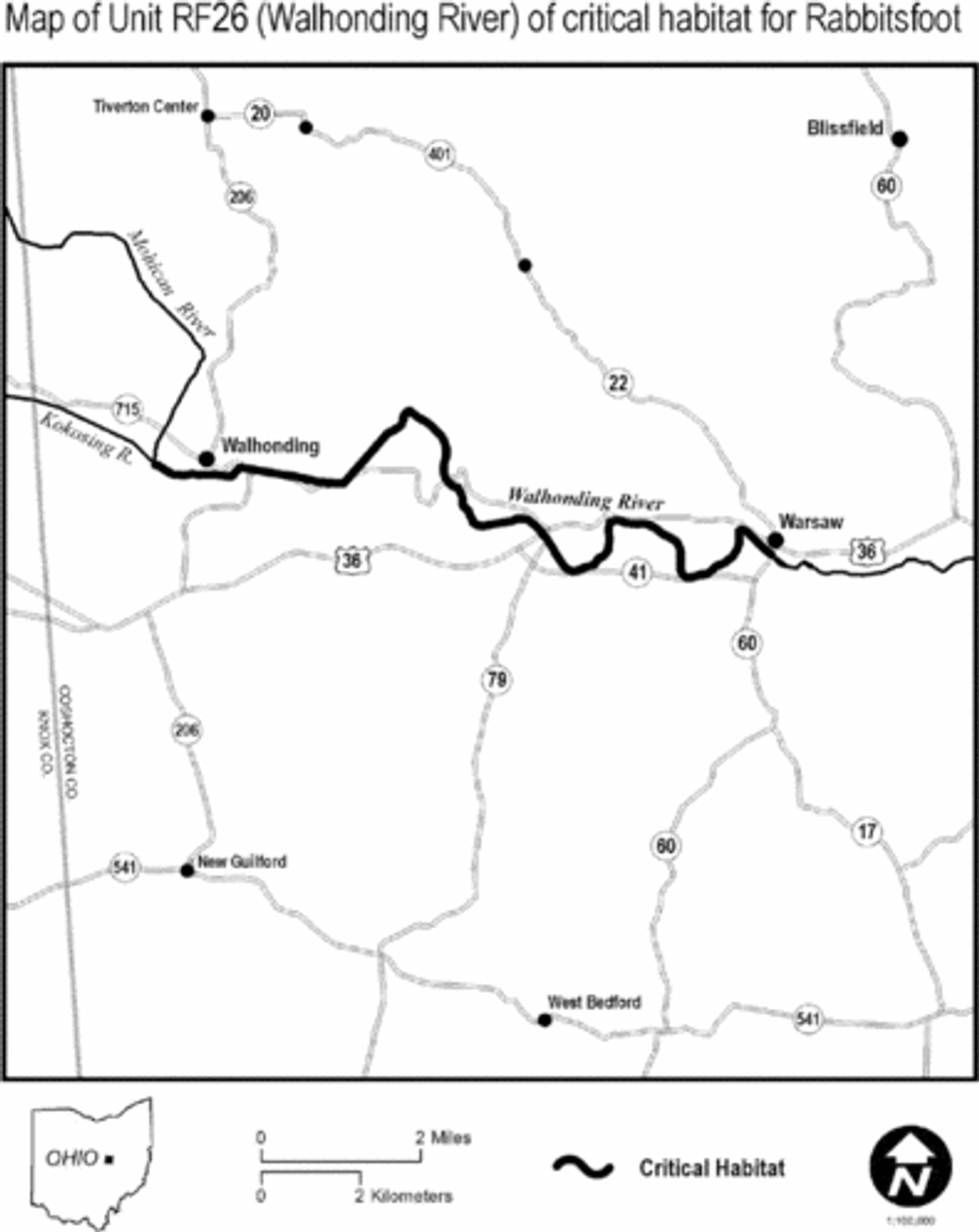
(35) Unit RF27: Little Darby Creek - Madison and Union Counties, Ohio.
(i) General Description: Unit RF27 includes 33.3 rkm (20.7 rmi) of Little Darby Creek from Ohio Highway 161 near Chuckery, Union County, Ohio, downstream to U.S. Highway 40 near West Jefferson, Madison County, Ohio.
(ii) Map of Unit RF27 follows:
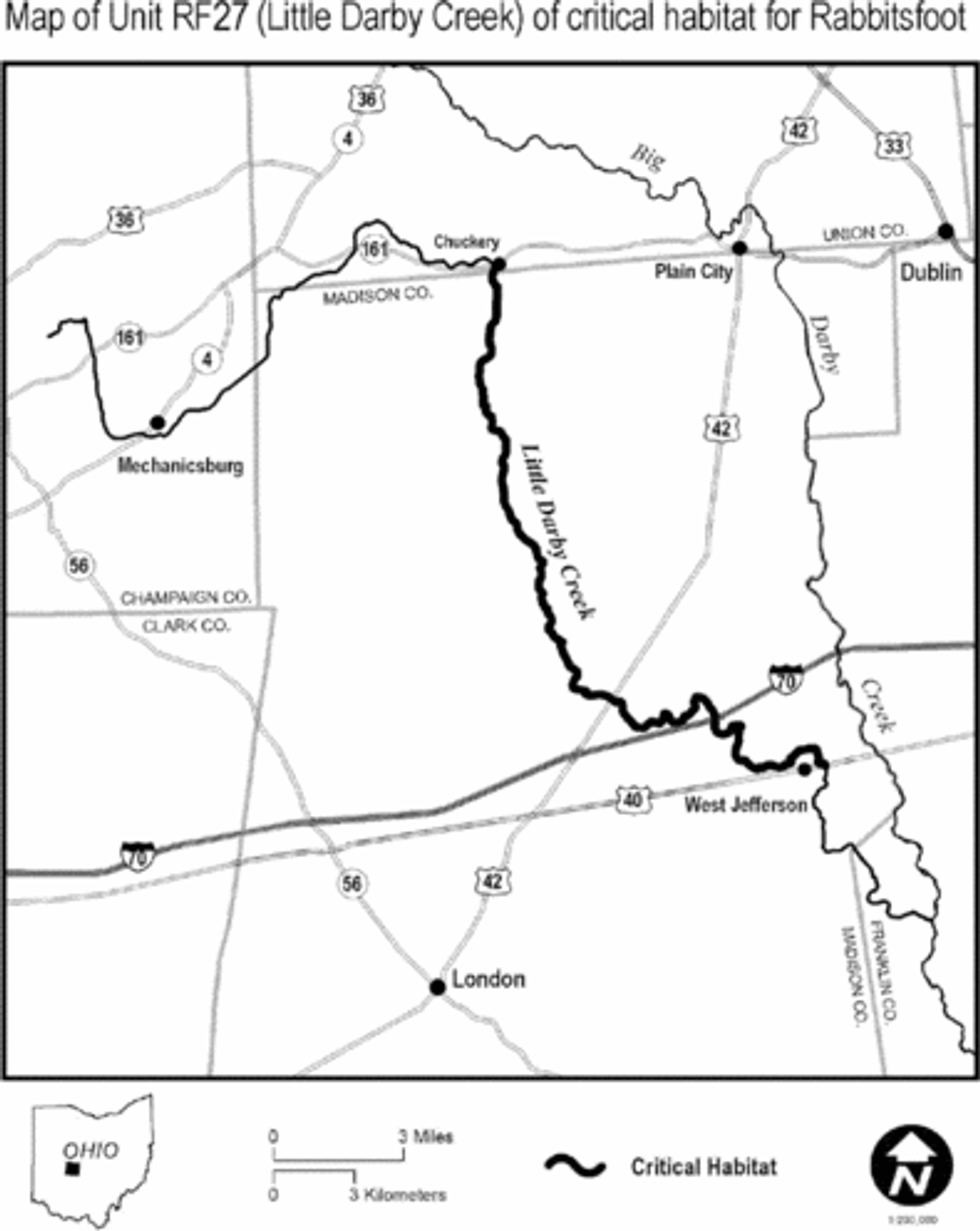
(36) Unit RF28: North Fork Vermilion River and Middle Branch North Fork Vermilion River, respectively - Vermilion County, Illinois.
(i) General Description: Unit RF28 includes a total of 28.5 rkm (17.7 rmi). Unit RF28 includes 21.2 rkm (13.2 rmi) of the North Fork Vermilion River from the confluence of Middle Branch North Fork Vermilion River downstream to Illinois Highway 1 and U.S. Highway 136 upstream of Lake Vermilion, Vermilion County, Illinois. Unit RF28 also includes 7.2 rkm (4.5 rmi) of the Middle Branch North Fork Vermilion River from the Jordan Creek confluence northwest of Alvin, Illinois, downstream to its confluence with North Fork Vermilion River west of Alvin, Vermilion County, Illinois.
(ii) Map of Unit RF28 follows:
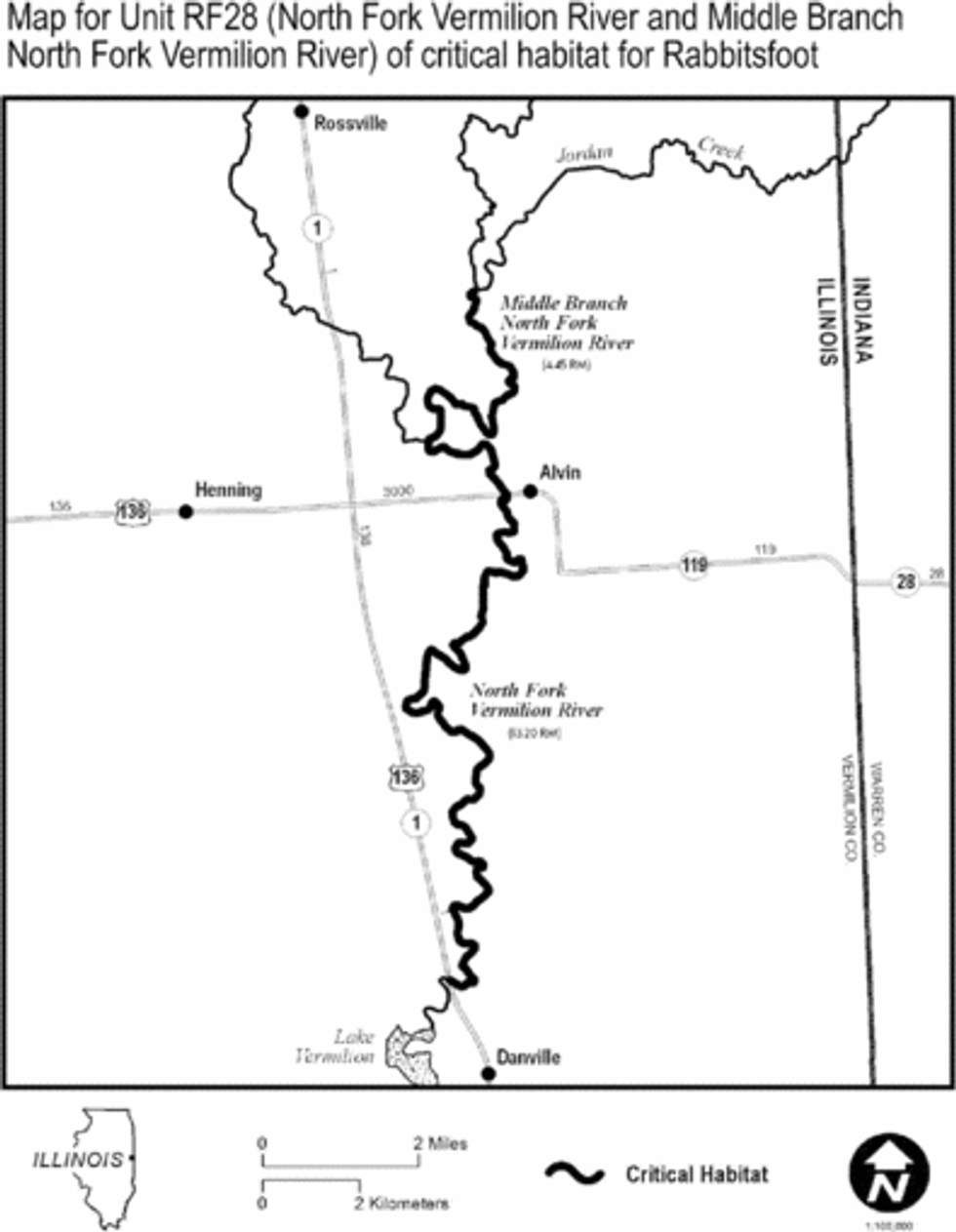
(37) Unit RF29: Fish Creek - Williams County, Ohio.
(i) General Description: Unit RF29 includes 7.7 rkm (4.8 rmi) of Fish Creek from Indiana and Ohio State line northwest of Edgerton, Ohio, downstream to its confluence with the St. Joseph's River north of Edgerton, Williams County, Ohio.
(ii) Map of Unit RF29 follows:
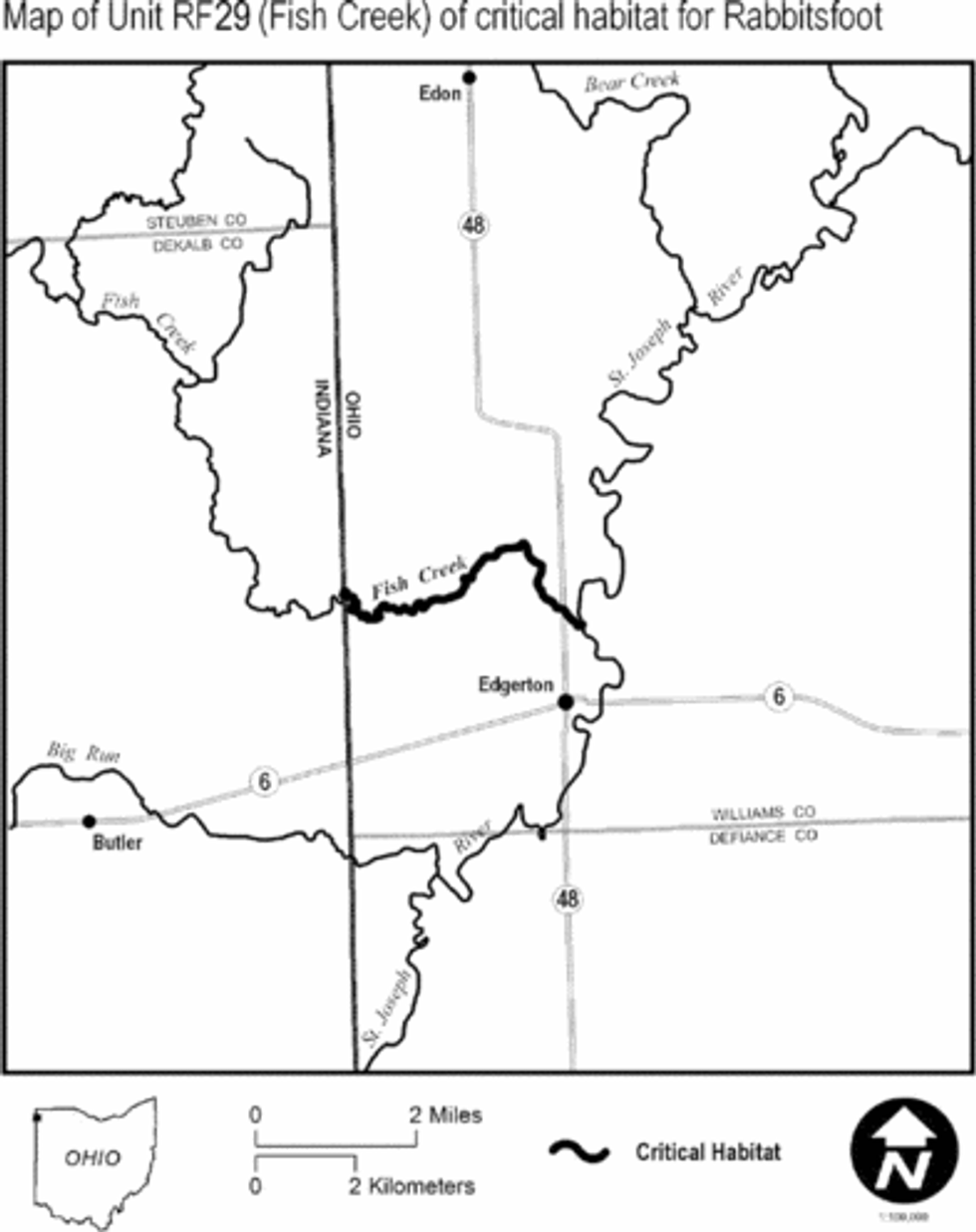
(38) Unit RF30: Red River - Logan County, Kentucky; and Montgomery and Robertson Counties, Tennessee.
(i) General Description: Unit RF30 includes 50.2 rkm (31.2 rmi) of the Red River from the South Fork Red River confluence west of Adairville, Kentucky, downstream to the Sulphur Fork confluence southwest of Adams, Tennessee.
(ii) Map of Unit RF30 follows:
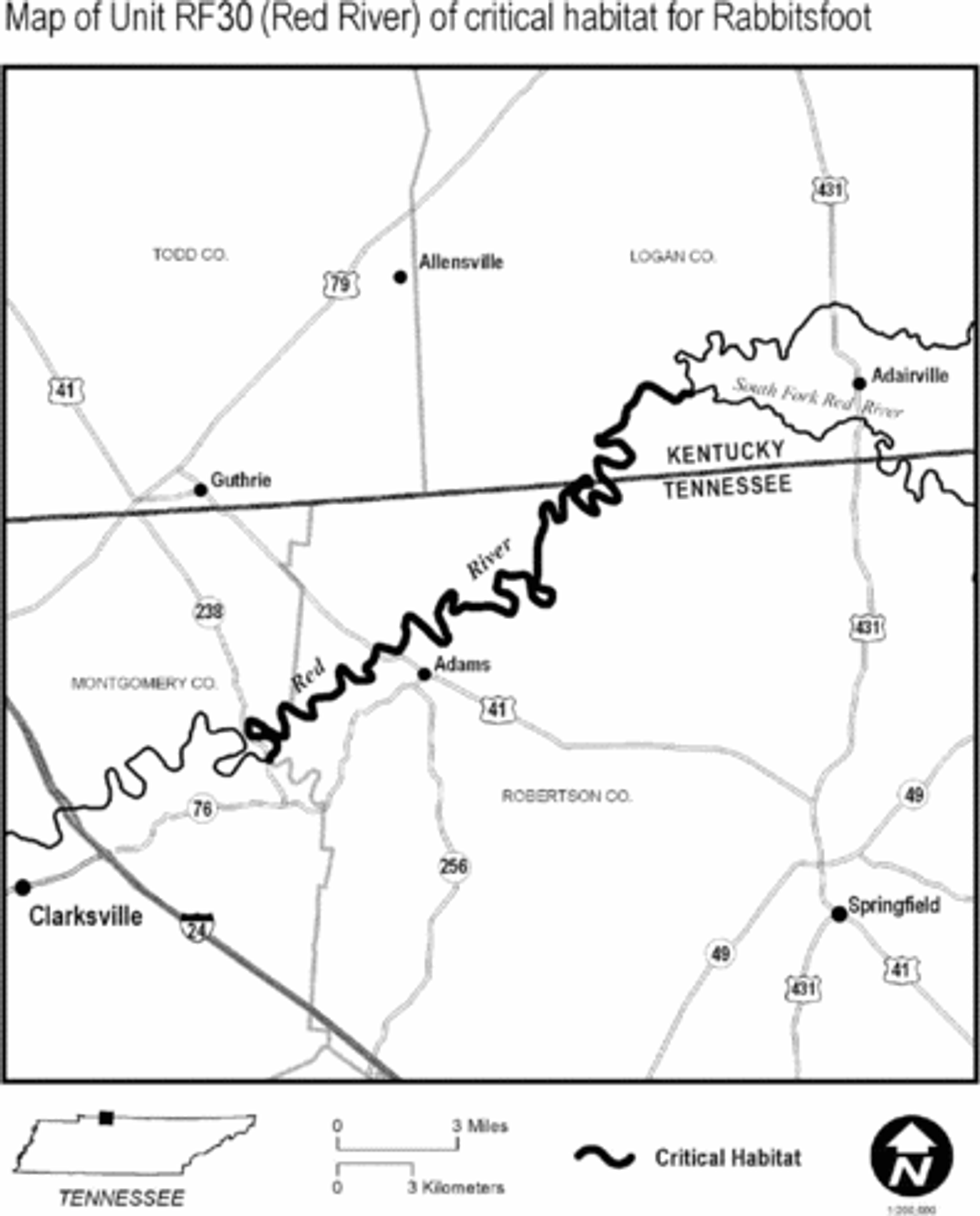
(39) Unit RF31: Shenango River - Mercer County, Pennsylvania.
(i) General Description: Unit RF31 includes 24.8 rkm (15.4 rmi) of the Shenango River from Porter Road near Greenville, Pennsylvania, downstream to the point of inundation by Shenango River Lake near Big Bend, Mercer County, Pennsylvania.
(ii) Map of Unit RF31 follows:
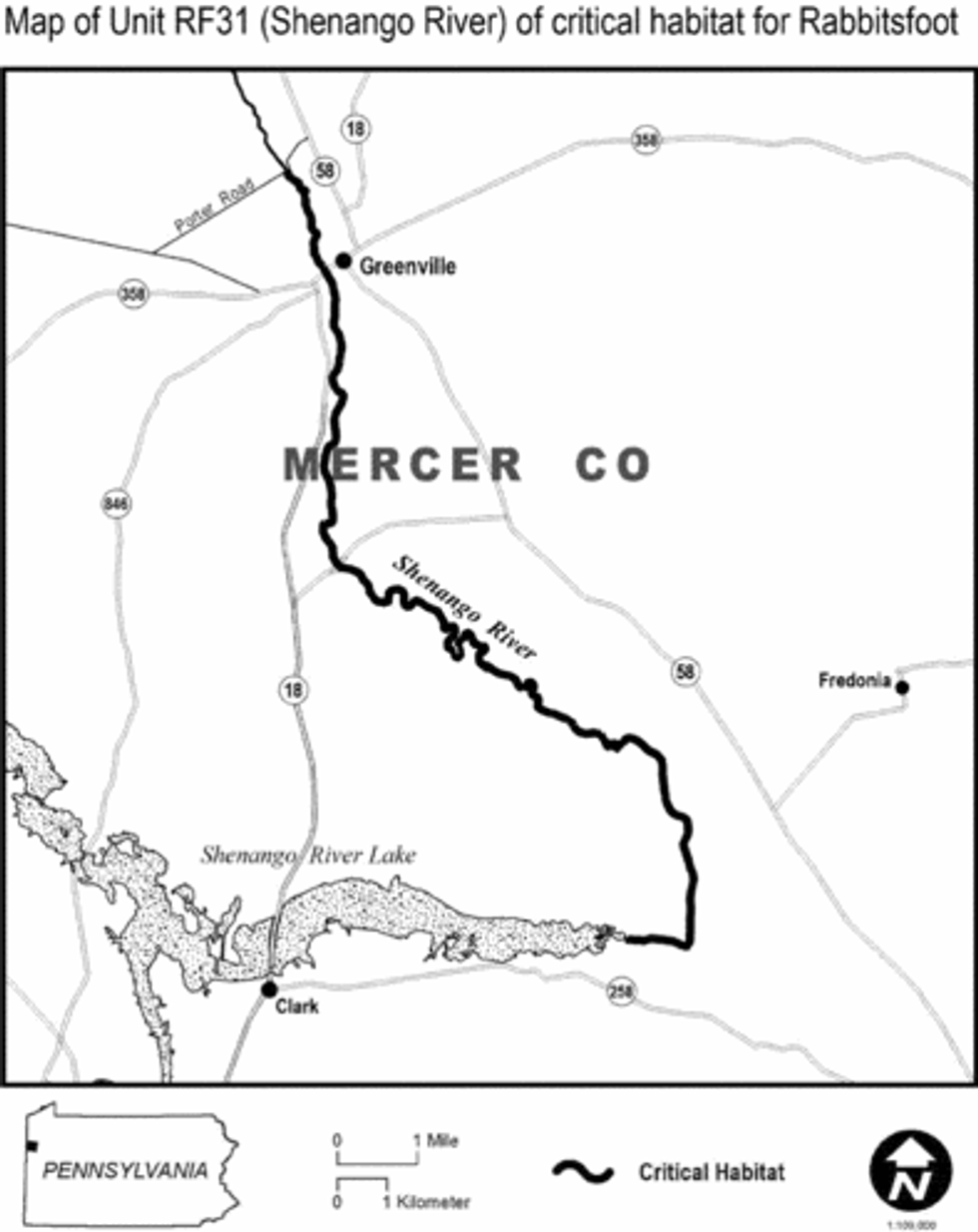
Atlantic Pigtoe (Fusconaia masoni)
(1) Critical habitat units are depicted for Bath, Botetourt, Brunswick, Craig, Dinwiddie, Greensville, Halifax, Lunenburg, Mecklenburg, Nottoway, Pittsylvania, and Sussex Counties in Virginia, and Durham, Edgecombe, Franklin, Granville, Halifax, Johnston, Montgomery, Nash, Orange, Person, Pitt, Randolph, Rockingham, Vance, Wake, Warren, and Wilson Counties in North Carolina, on the maps in this entry.
(2) Within these areas, the physical or biological features essential to the conservation of Atlantic pigtoe consist of the following components:
(i) Suitable substrates and connected instream habitats, characterized by geomorphically stable stream channels and banks (i.e., channels that maintain lateral dimensions, longitudinal profiles, and sinuosity patterns over time without an aggrading or degrading bed elevation) with habitats that support a diversity of freshwater mussel and native fish (such as stable riffle-run-pool habitats that provide flow refuges consisting of silt-free gravel and coarse sand substrates).
(ii) Adequate flows, or a hydrologic flow regime (which includes the severity, frequency, duration, and seasonality of discharge over time), necessary to maintain benthic habitats where the species is found and to maintain connectivity of streams with the floodplain, allowing the exchange of nutrients and sediment for maintenance of the mussel's and fish hosts' habitat, food availability, spawning habitat for native fishes, and the ability for newly transformed juveniles to settle and become established in their habitats.
(iii) Water and sediment quality (including, but not limited to, conductivity, hardness, turbidity, temperature, pH, ammonia, heavy metals, and chemical constituents) necessary to sustain natural physiological processes for normal behavior, growth, and viability of all life stages.
(iv) The presence and abundance of fish hosts necessary for recruitment of the Atlantic pigtoe.
(3) Critical habitat does not include manmade structures (such as buildings, aqueducts, runways, roads, and other paved areas) and the land on which they are located existing within the legal boundaries on December 16, 2021.
(4) Data layers defining map units were created by overlaying Natural Heritage Element Occurrence data and U.S. Geological Survey (USGS) hydrologic data for stream reaches. The hydrologic data used in the critical habitat maps were extracted from the USGS 1:1M scale nationwide hydrologic layer (https://nationalmap.gov/small_scale/mld/1nethyd.html) with a projection of EPSG:4269-North American Datum of 1983 (NAD83) Geographic. The North Carolina and Virginia Natural Heritage program species presence data and the Virginia Department of Wildlife Resources species data were used to select specific stream segments for inclusion in the critical habitat layer. The maps in this entry, as modified by any accompanying regulatory text, establish the boundaries of the critical habitat designation. The coordinates or plot points on which each map is based are available to the public at http://www.regulations.gov under Docket No. FWS-R4-ES-2018-0046 and at the field office responsible for this designation. You may obtain field office location information by contacting one of the Service regional offices, the addresses of which are listed at 50 CFR 2.2.
(5) Note: Index map follows:
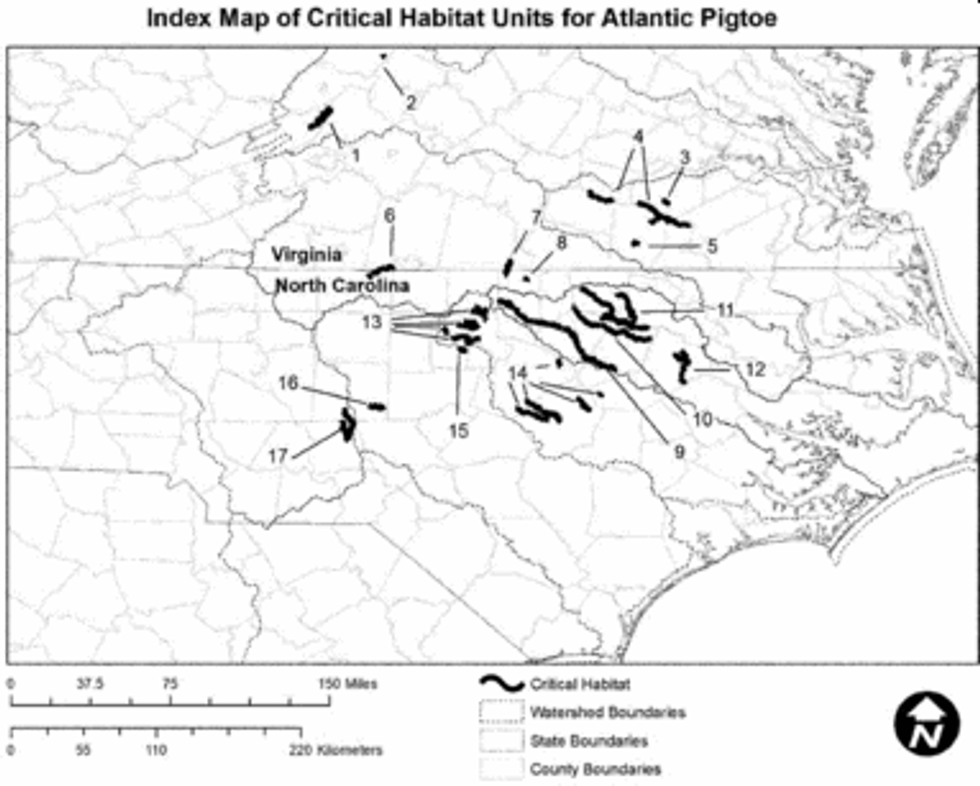
(6) Unit 1: JR1—Craig Creek, Craig and Botetourt Counties, Virginia.
(i) This unit consists of 29 river miles (46.7 river kilometers (km)) of Craig Creek near VA Route 616 northeast of New Castle downstream to just below VA Route 817 crossing.
(ii) Map of Unit 1 (Craig Creek) follows:
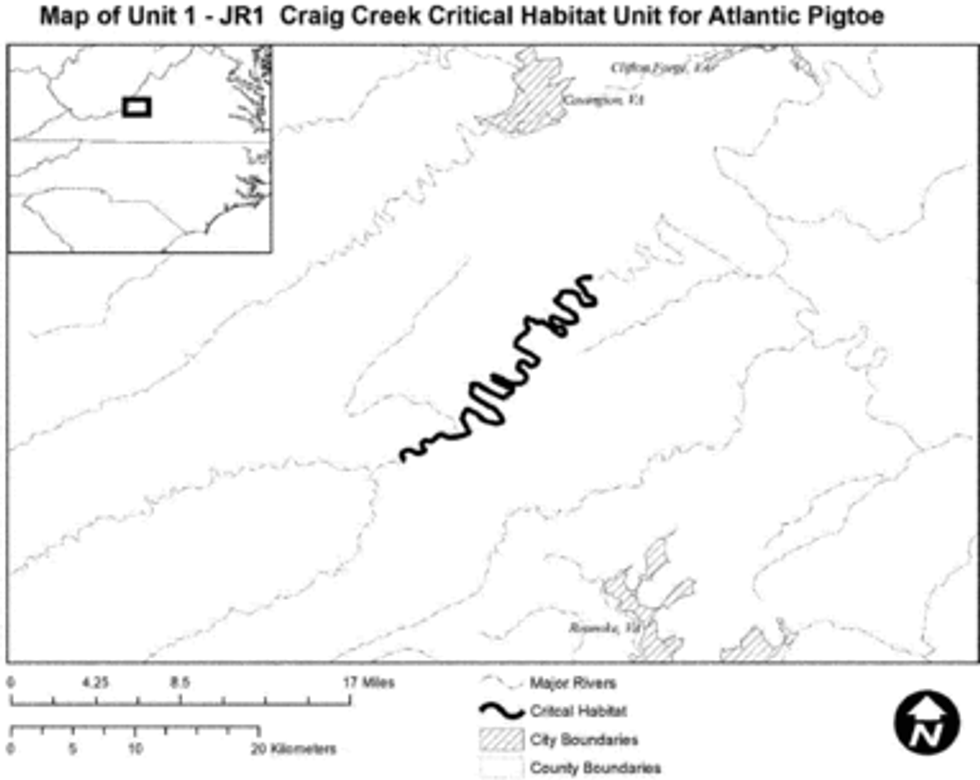
(7) Unit 2: JR2—Mill Creek, Bath County, Virginia.
(i) This unit consists of a 1-mile (1.6-km) segment of Mill Creek at the VA39 (Mountain Valley Road) crossing.
(ii) Map of Unit 2 (Mill Creek) follows:
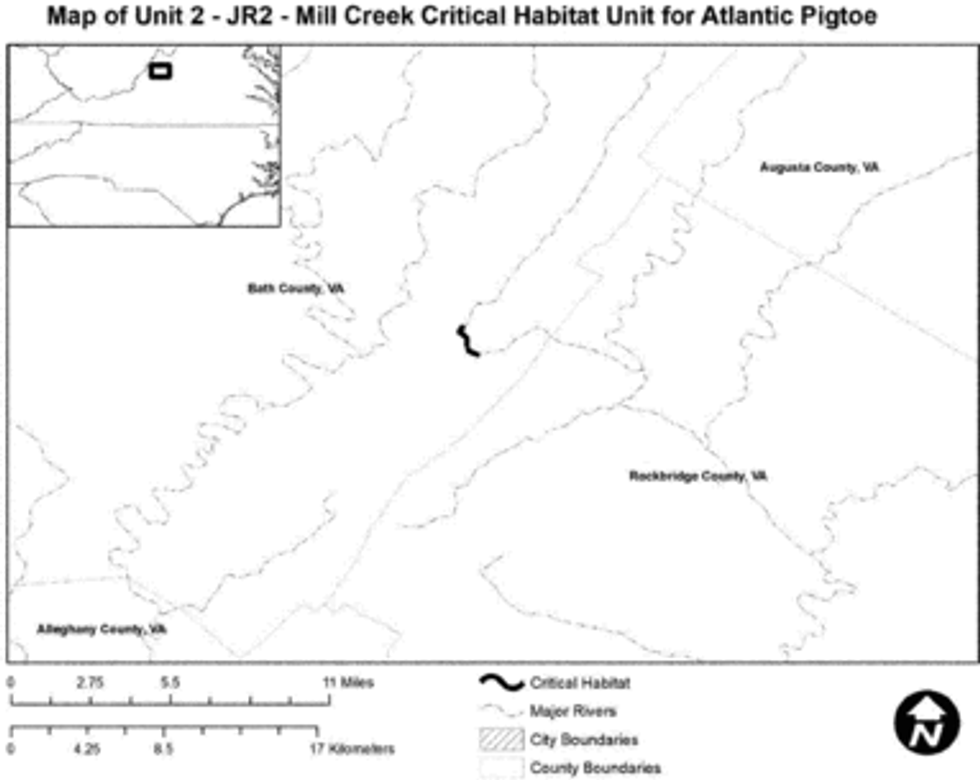
(8) Unit 3: CR1—Sappony Creek, Dinwiddie County, Virginia.
(i) This unit consists of 4 river miles (6.6 river km) of Sappony Creek beginning just upstream of the Seaboard Railroad crossing and ending just downstream of the Shippings Road (SR709) crossing.
(ii) Map of Unit 3 (Sappony Creek) follows:
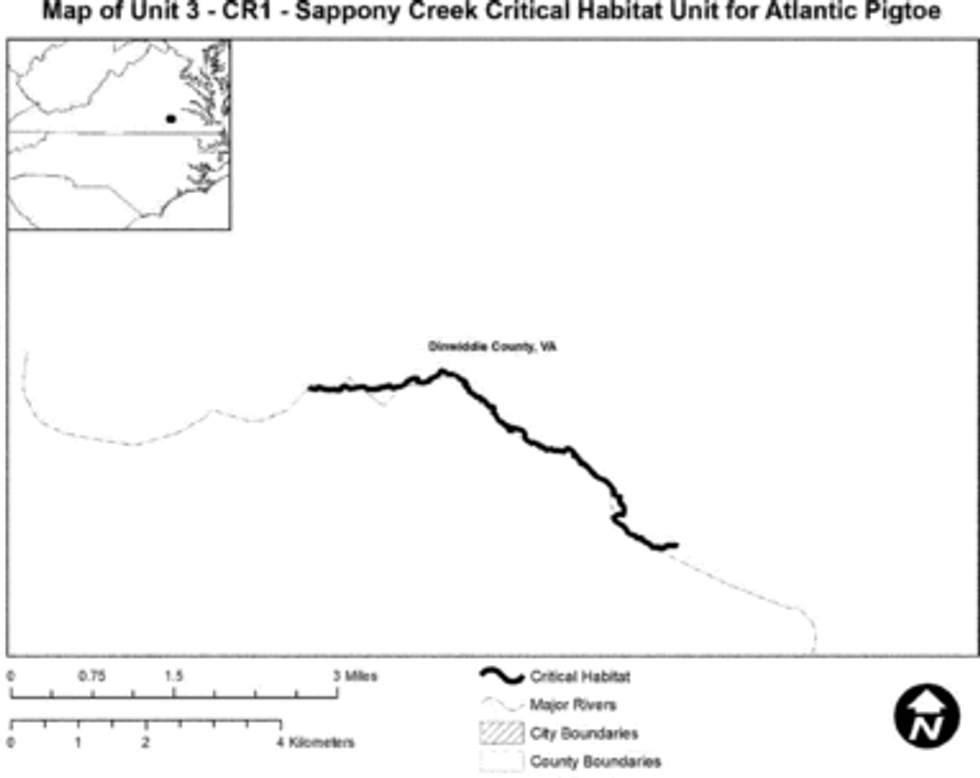
(9) Unit 4: CR2—Nottoway River Subbasin, Nottoway, Lunenburg, Brunswick, Dinwiddie, Greensville, and Sussex Counties, Virginia.
(i) This unit consists of 64 river miles (103 river km) of the Nottoway River, and a portion of Sturgeon Creek, beginning downstream of the Nottoway River's confluence with Dickerson Creek and ending just downstream of Little Mill Road, and includes Sturgeon Creek upstream of Old Stage Road. Land bordering the river is primarily privately owned, although some of the land along the river is part of the Fort Pickett National Guard Installation.
(ii) Map of Unit 4 (Nottoway River Subbasin) follows:
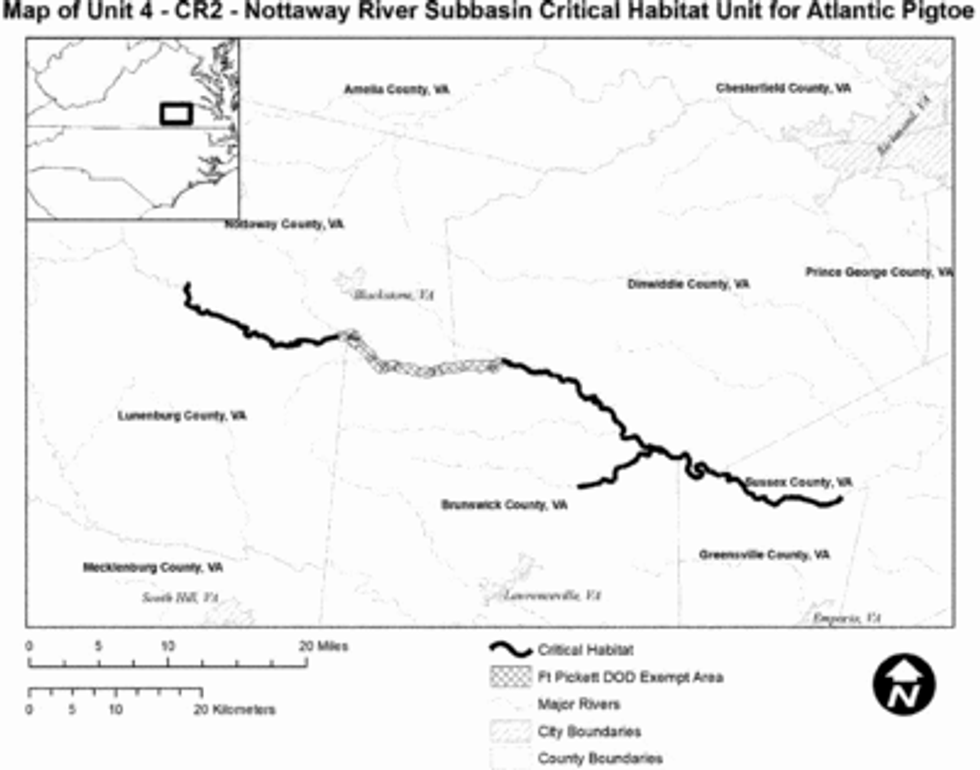
(10) Unit 5: CR3—Meherrin River, Brunswick County, Virginia.
(i) This unit consists of 5 river miles (8 river km) of the Meherrin River from approximately 1.5 miles below the confluence with Saddletree Creek under VA Highway 46 (Christana Highway) to VA715 (Iron Bridge Road).
(ii) Map of Unit 5 (Meherrin River) follows:
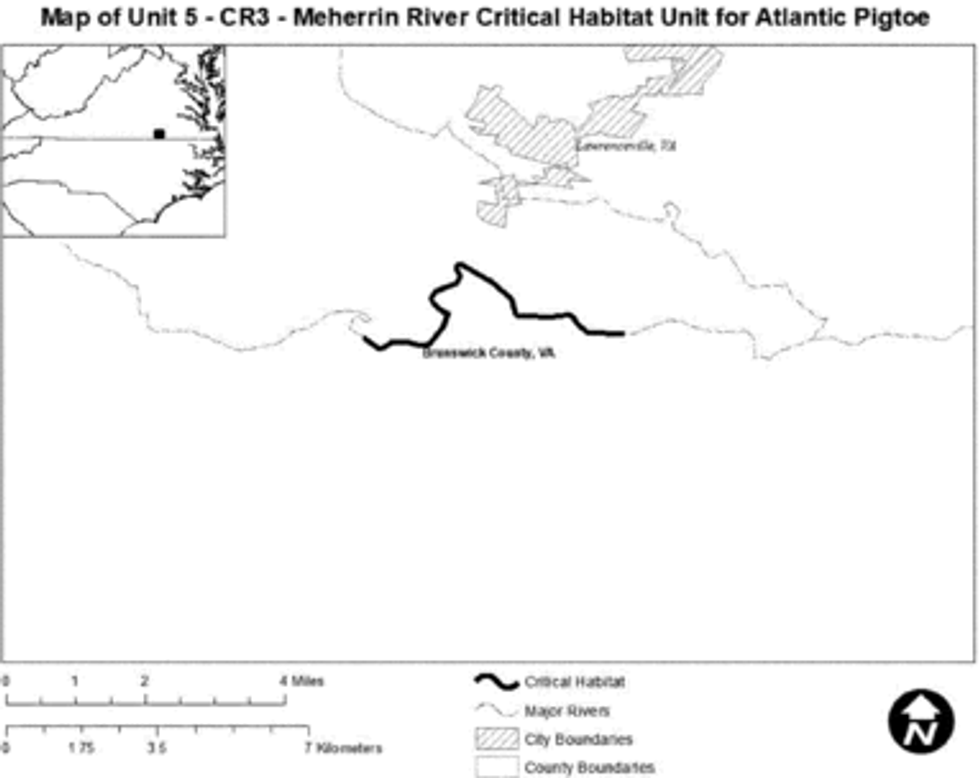
(11) Unit 6: RR1—Dan River, Pittsylvania County, Virginia, and Rockingham County, North Carolina.
(i) This unit consists of 14 river miles (22.5 river km) of the Dan River along the border of Virginia and North Carolina from just upstream of NC Highway 700 near Eden, North Carolina, into Pittsylvania County, Virginia, and downstream to the confluence with Williamson Creek in Rockingham County, North Carolina.
(ii) Map of Unit 6 (Dan River) follows:

(12) Unit 7: RR2—Aarons Creek, Granville County, North Carolina, and Mecklenburg and Halifax Counties, Virginia.
(i) This unit consists of 12 river miles (19.3 river km) of Aarons Creek, from NC96 in Granville County, North Carolina, downstream across the North Carolina-Virginia border to just upstream of VA602 (White House Road) along the Mecklenburg County-Halifax County line in Virginia.
(ii) Map of Unit 7 (Aarons Creek) follows:
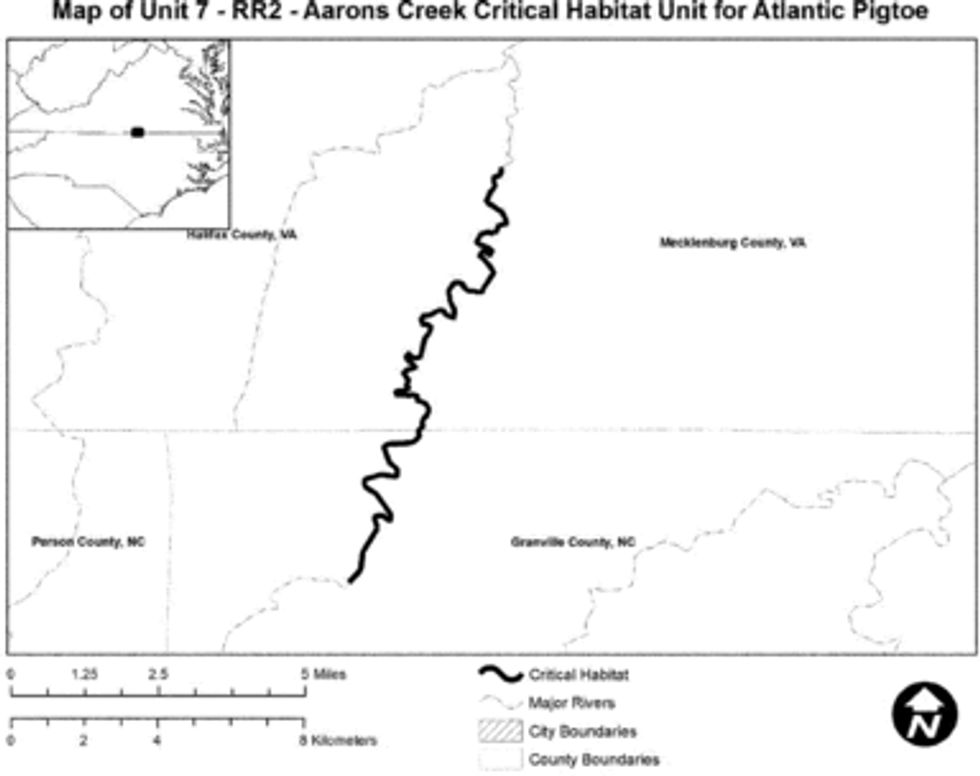
(13) Unit 8: RR3—Little Grassy Creek, Granville County, North Carolina.
(i) This unit consists of 3 river miles (4.8 river km) of Little Grassy Creek in Granville County, North Carolina, beginning at the Crawford Currin Road crossing and ending at the confluence with Grassy Creek.
(ii) Map of Unit 8 (Little Grassy Creek) follows:
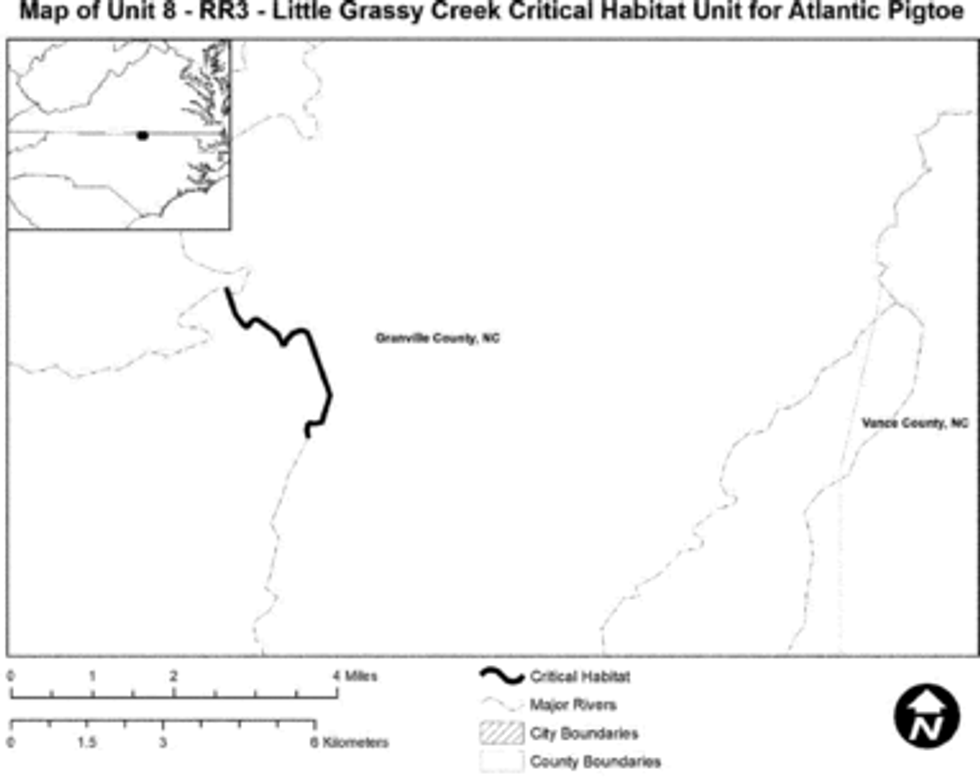
(14) Unit 9: TR1—Upper/Middle Tar River Subbasin, Granville, Vance, Franklin, and Nash Counties, North Carolina.
(i) This unit consists of 91 river miles (146.5 river km) of the mainstem of the upper and middle Tar River as well as several tributaries (Bear Swamp Creek, Fox Creek, Crooked Creek, Cub Creek, and Shelton Creek), all in North Carolina. The portion of Cub Creek starts near Hobgood Road and continues to the confluence with the Tar River; the Tar River portion starts just upstream of the NC158 bridge and goes downstream to the NC581 crossing; the Shelton Creek portion starts upstream of NC158 and goes downstream to the confluence with the Tar River; the Bear Swamp Creek portion begins upstream of Dyking Road and goes downstream to the confluence with the Tar River (and includes an unnamed tributary upstream of Beasley Road); the Fox Creek portion begins downstream of NC561 and goes to the confluence with the Tar River; and the Crooked Creek portion begins upstream of NC98 crossing and goes downstream to confluence with Tar River.
(ii) Map of Unit 9 (Upper/Middle Tar River Subbasin) follows:
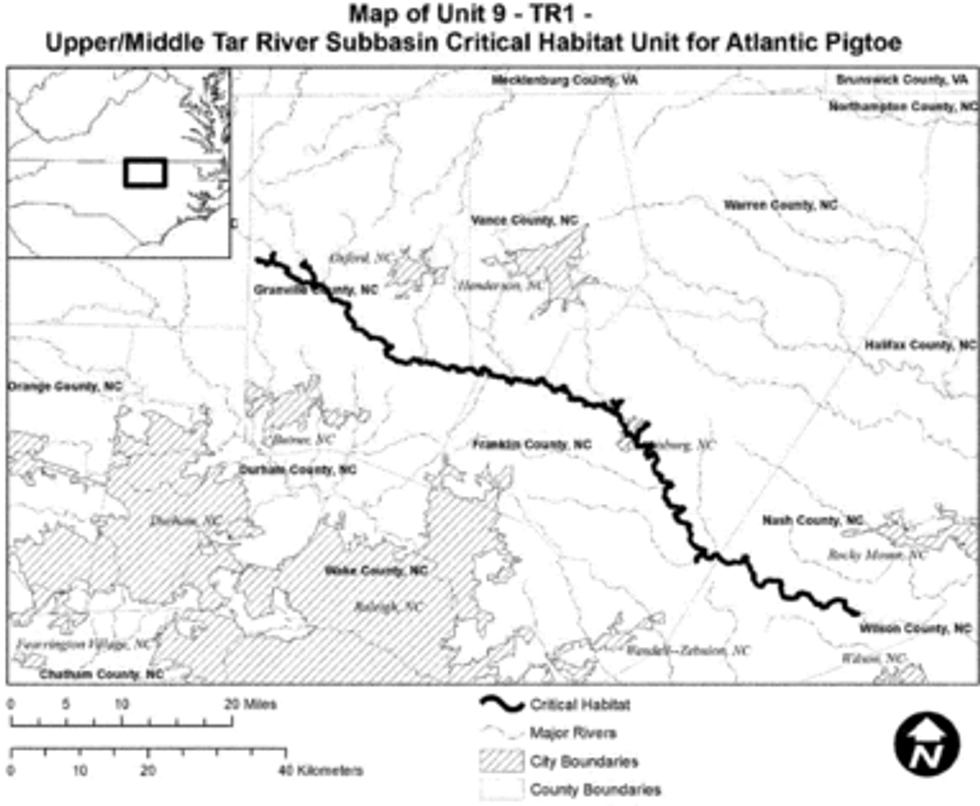
(15) Unit 10: TR2—Sandy/Swift Creek, Warren, Franklin, and Nash Counties, North Carolina.
(i) This unit consists of a 50-mile (80.5-km) segment of Sandy/Swift Creek beginning at Southerland Mill Road and continuing downstream to NC301.
(ii) Map of Unit 10 (Sandy/Swift Creek) follows:
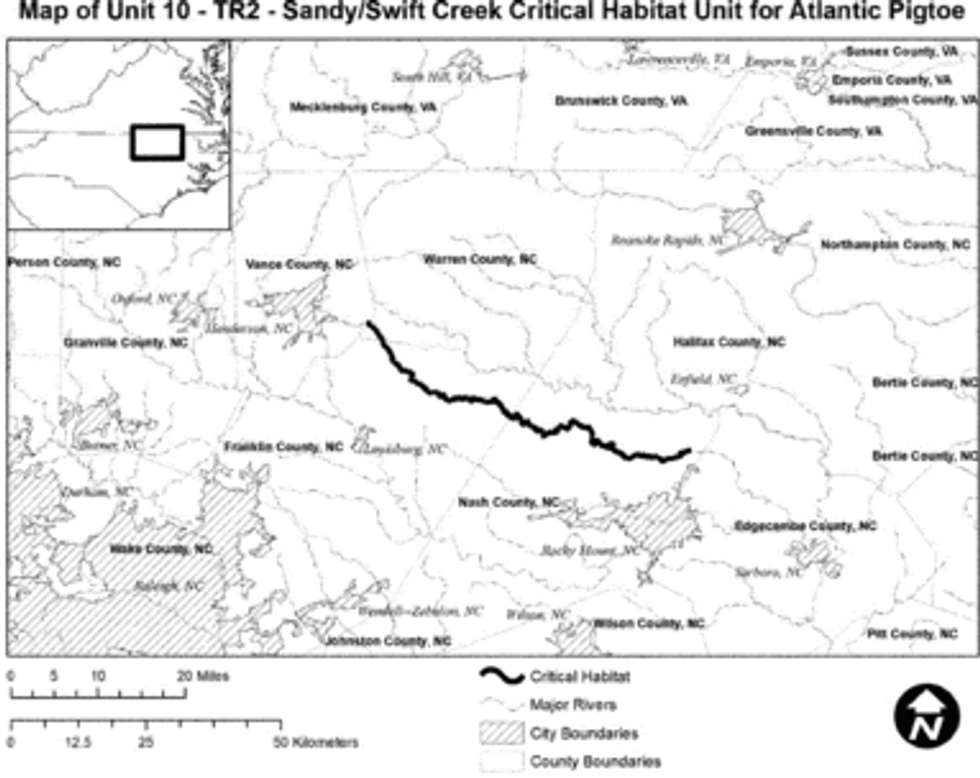
(16) Unit 11: TR3—Fishing Creek Subbasin, Warren, Halifax, Franklin, and Nash Counties, North Carolina.
(i) This unit consists of 85 river miles (136.8 river km) in Fishing Creek, Little Fishing Creek, Shocco Creek, and Maple Branch. The Shocco Creek portion begins downstream of the NC58 bridge and continues to the confluence with Fishing Creek; the entirety of Maple Branch is included, down to the confluence with Fishing Creek; Fishing Creek begins at Axtell Ridgeway Road (SR1112) and goes downstream to I-95; and Little Fishing Creek begins upstream of Briston Brown Road (SR1532) and goes downstream to the confluence with Fishing Creek.
(ii) Map of Unit 11 (Fishing Creek Subbasin) follows:
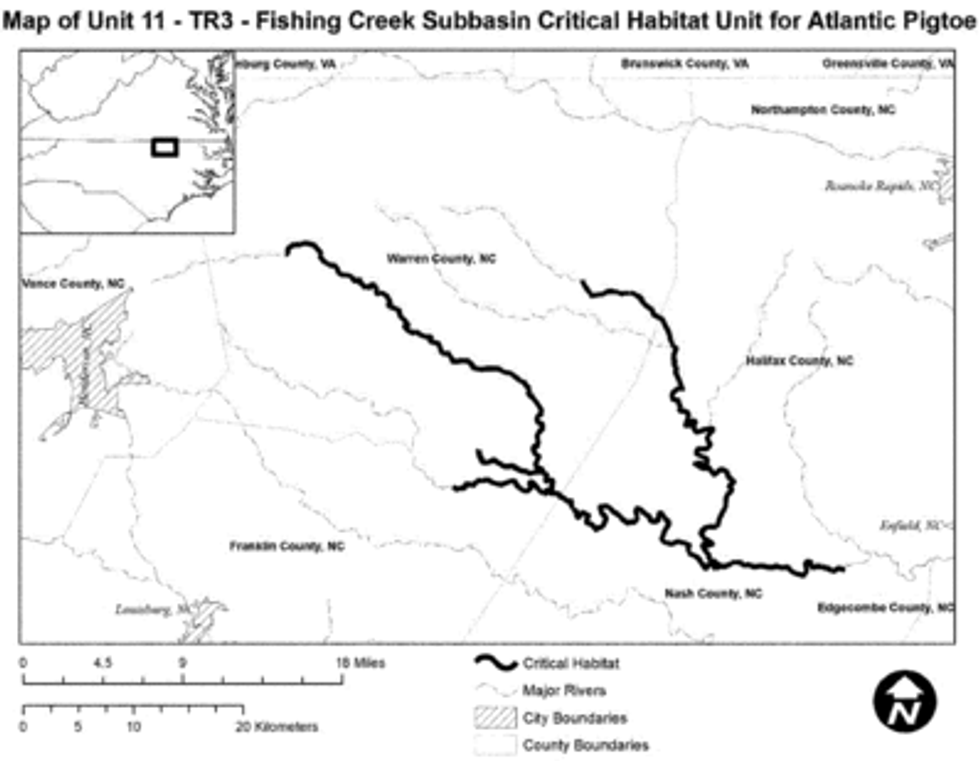
(17) Unit 12: TR4—Lower Tar River, Edgecombe and Pitt Counties, North Carolina.
(i) This unit consists of 30 river miles (48.3 river km) of the Lower Tar River, lower Swift Creek, and Fishing Creek in Edgecombe County, North Carolina, from NC97 near Leggett, North Carolina, to the Edgecombe County-Pitt County line near NC33.
(ii) Map of Unit 12 (Lower Tar River) follows:
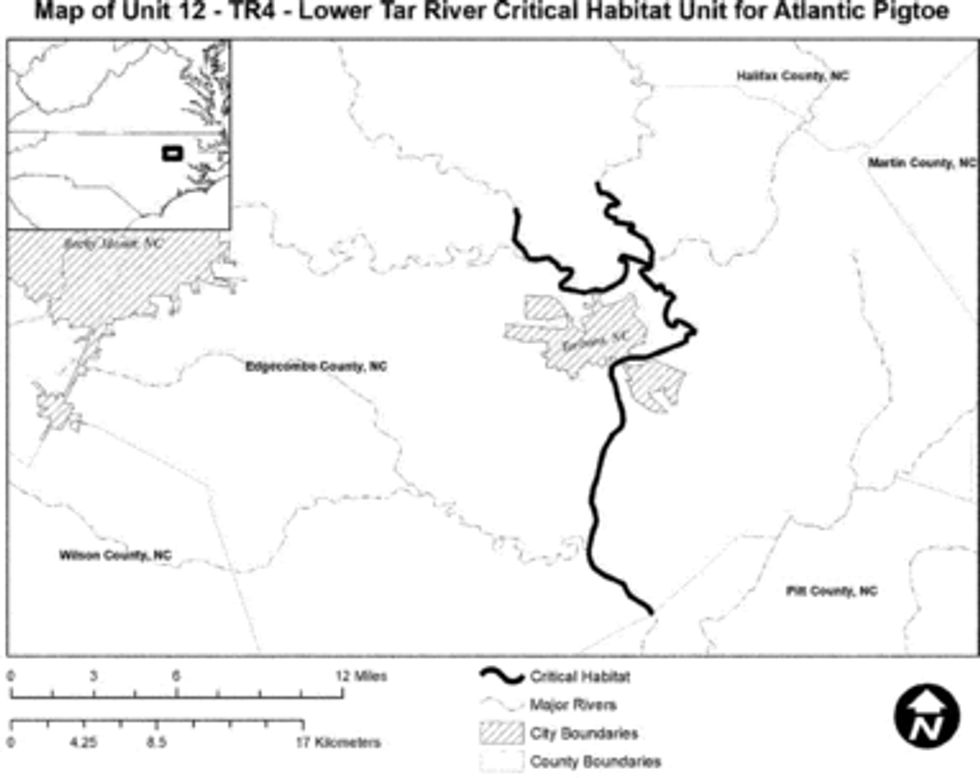
(18) Unit 13: NR1—Upper Neuse River Subbasin, Person, Durham, and Orange Counties, North Carolina.
(i) This unit consists of 60 river miles (95 river km) in four reaches including Flat River, Little River, Eno River, and the Upper Eno River. The Flat River reach consists of 19 river miles (30.6 river km) in the Flat River Subbasin in Person and Durham Counties, North Carolina, including the South Flat River downstream of Dick Coleman Road, the North Flat River near Parsonage Road, and Deep Creek near Helena-Moriah Road downstream where each river converges into the Flat River downstream of State Forest Road. The Little River Subbasin includes 18 river miles (29 river km) of the North Fork and South Fork Little Rivers in Orange and Durham Counties, North Carolina. The Upper Eno River reach consists of 4 river miles (6.4 river km) in Orange County, North Carolina, including the West Fork Eno River upstream of Cedar Grove Road to the confluence with McGowan Creek. The Eno River reach consists of 18 river miles (29 river km) in Orange and Durham Counties, North Carolina, from below Eno Mountain Road to NC15-501.
(ii) Map of Unit 13 (Upper Neuse River Subbasin) follows:
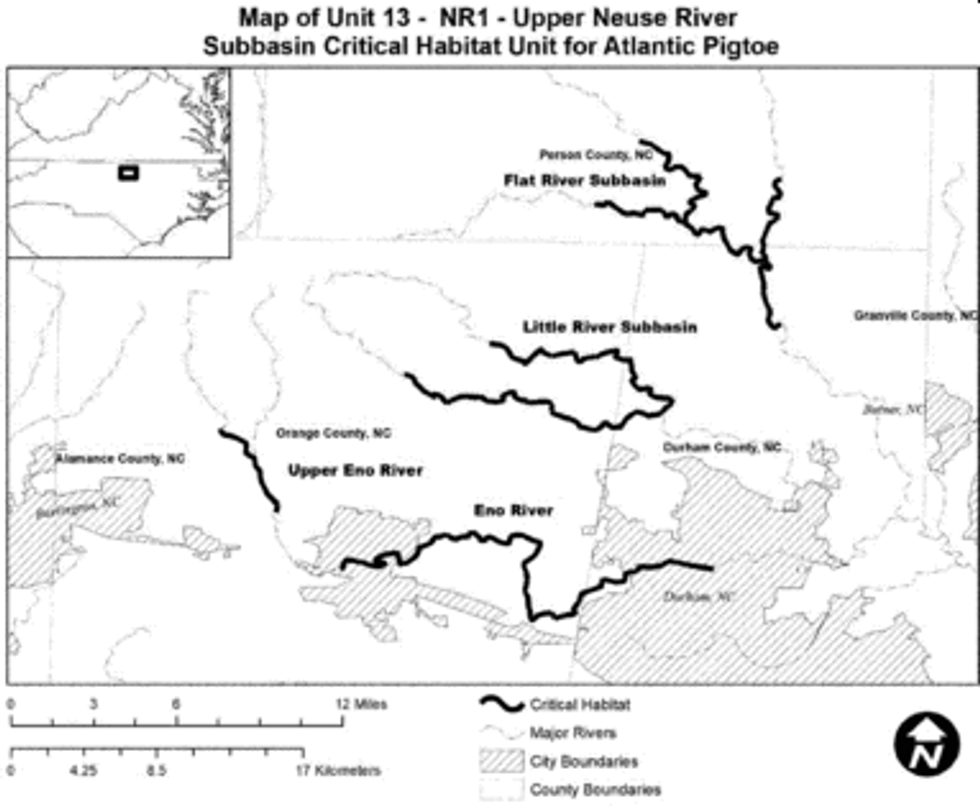
(19) Unit 14: NR2—Middle Neuse River Subbasin, Wake, Johnston, and Wilson Counties, North Carolina.
(i) This unit consists of 61 river miles (98.2 river km) in five reaches including Swift Creek, Middle Creek, Upper Little River, Middle Little River, and Contentnea Creek, all in North Carolina. The Middle Creek reach is 19 river miles (30.6 river km) below Old Stage Road downstream to below Crantock Road, and the Swift Creek reach is 25 river miles (40.2 river km) from Lake Benson downstream to its confluence with the Neuse, both in Wake and Johnston Counties. The Upper Little River reach includes 4 river miles (6.4 river km) of the Upper Little River from the confluence with Perry Creek to Fowler Road in Wake County, North Carolina. The Middle Little River reach includes 11 river miles (17.7 river km) from Atkinsons Mill downstream to NC301 in Johnston County, North Carolina. The Contentnea Creek reach consists of 2 river miles (3.2 river km) below Buckhorn Reservoir to just below Sadie Road near NC581 in Wilson County, North Carolina.
(ii) Map of Unit 14 (Middle Neuse River Subbasin) follows:
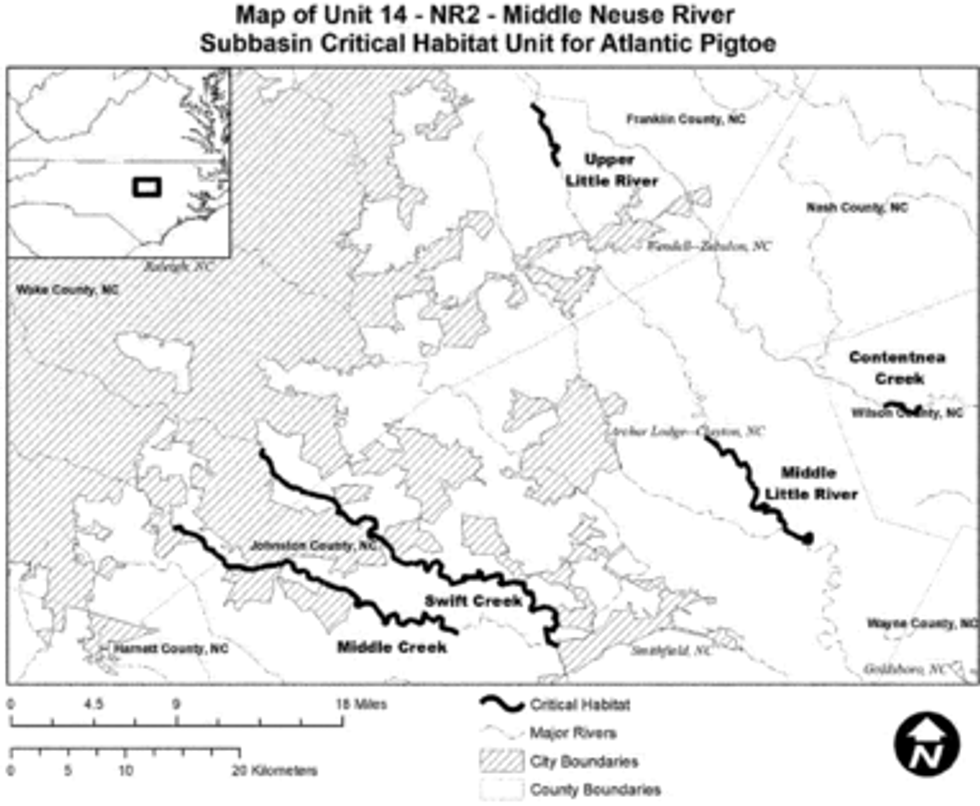
(20) Unit 15: CF1—New Hope Creek, Orange County, North Carolina.
(i) This unit consists of 4 river miles (6.4 river km) of habitat in the New Hope Creek from NC86 to Mimosa Road.
(ii) Map of Unit 15 (New Hope Creek) follows:
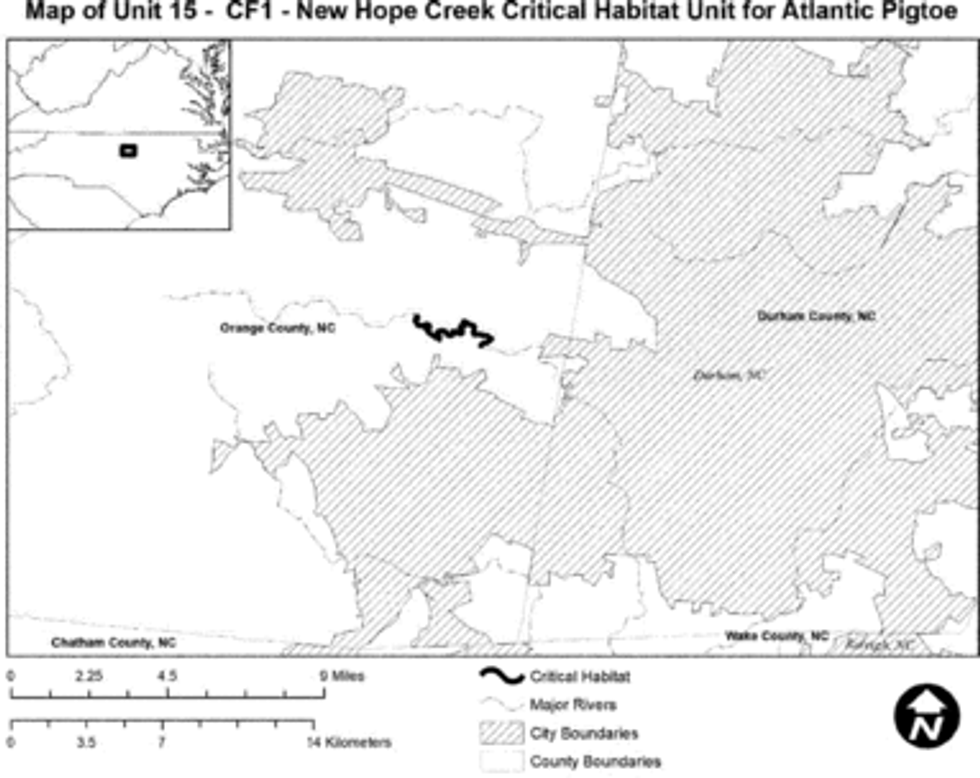
(21) Unit 16: CF2—Deep River Subbasin, Randolph County, North Carolina.
(i) The Deep River Subbasin unit consists of 10 river miles (16.1 river km), including the mainstem between Richland and Brush Creeks as well as Richland Creek from Little Beane Store Road to the confluence with the Deep River and Brush Creek from Brush Creek Road to the confluence with the Deep River.
(ii) Map of Unit 16 (Deep River Subbasin) follows:
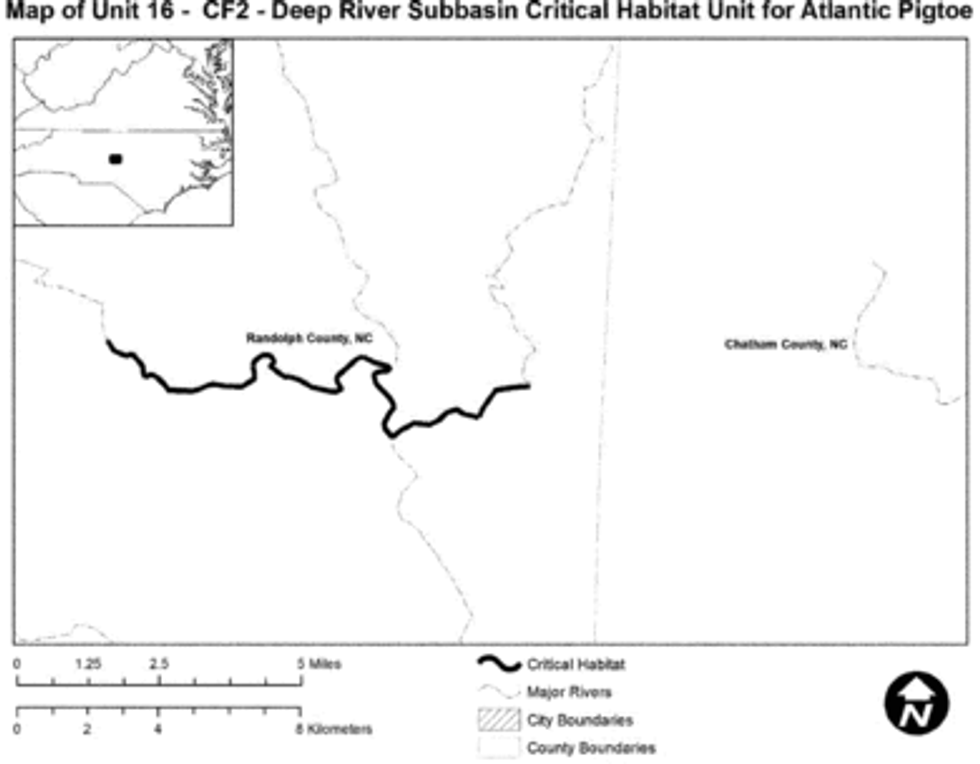
(22) Unit 17: YR1—Little River, Randolph and Montgomery Counties, North Carolina.
(i) This unit consists of 40 river miles (64.4 river km) of Little River from SR1114 downstream to Okeewemee Star Road, including the West Fork Little River from NC134 to the confluence with the Little River.
(ii) Map of Unit 17 (Little River) follows:

Yellow Lance (Elliptio lanceolata)
(1) Critical habitat units are depicted for Franklin, Granville, Halifax, Johnston, Nash, Vance, Wake, and Warren Counties, North Carolina; Brunswick, Craig, Culpeper, Dinwiddie, Fauquier, Louisa, Lunenburg, Madison, Nottoway, Orange, and Rappahannock Counties, Virginia; and Howard and Montgomery Counties, Maryland, on the maps in this entry.
(2) Within these areas, the physical or biological features essential to yellow lance conservation consist of the following components:
(i) Suitable substrates and connected instream habitats, characterized by geomorphically stable stream channels and banks (i.e., channels that maintain lateral dimensions, longitudinal profiles, and sinuosity patterns over time without an aggrading or degrading bed elevation) with habitats that support a diversity of freshwater mussel and native fish (such as stable riffle-run-pool habitats that provide flow refuges consisting of silt-free gravel and coarse sand substrates).
(ii) Adequate flows, or a hydrologic flow regime (which includes the severity, frequency, duration, and seasonality of discharge over time), necessary to maintain benthic habitats where the species is found and to maintain connectivity of streams with the floodplain, allowing the exchange of nutrients and sediment for maintenance of the mussel's and fish host's habitat, food availability, spawning habitat for native fishes, and the ability for newly transformed juveniles to settle and become established in their habitats.
(iii) Water and sediment quality (including, but not limited to, conductivity, hardness, turbidity, temperature, pH, ammonia, heavy metals, and chemical constituents) necessary to sustain natural physiological processes for normal behavior, growth, and viability of all life stages.
(iv) The presence and abundance of fish hosts necessary for yellow lance recruitment.
(3) Critical habitat does not include manmade structures (such as buildings, aqueducts, runways, roads, and other paved areas) and the land on which they are located existing within the legal boundaries on May 10, 2021.
(4) Critical habitat map units. Data layers defining map units were created by overlaying Natural Heritage Element Occurrence data and U.S. Geological Survey (USGS) hydrologic data for stream reaches. The hydrologic data used in the critical habitat maps were extracted from the USGS 1:1M scale nationwide hydrologic layer (https://nationalmap.gov/small_scale/mld/1nethyd.html) with a projection of EPSG:4269-NAD83 Geographic. The North Carolina, Virginia, and Maryland Natural Heritage program species presence data were used to select specific stream segments for inclusion in the critical habitat layer. The maps in this entry, as modified by any accompanying regulatory text, establish the boundaries of the critical habitat designation. The coordinates or plot points or both on which each map is based are available to the public at http://www.regulations.gov under Docket No. FWS-R4-ES-2018-0094 and at the Raleigh Ecological Services Field Office. You may obtain field office location information by contacting one of the Service regional offices, the addresses of which are listed at 50 CFR 2.2.
(5) Note: Index map follows:
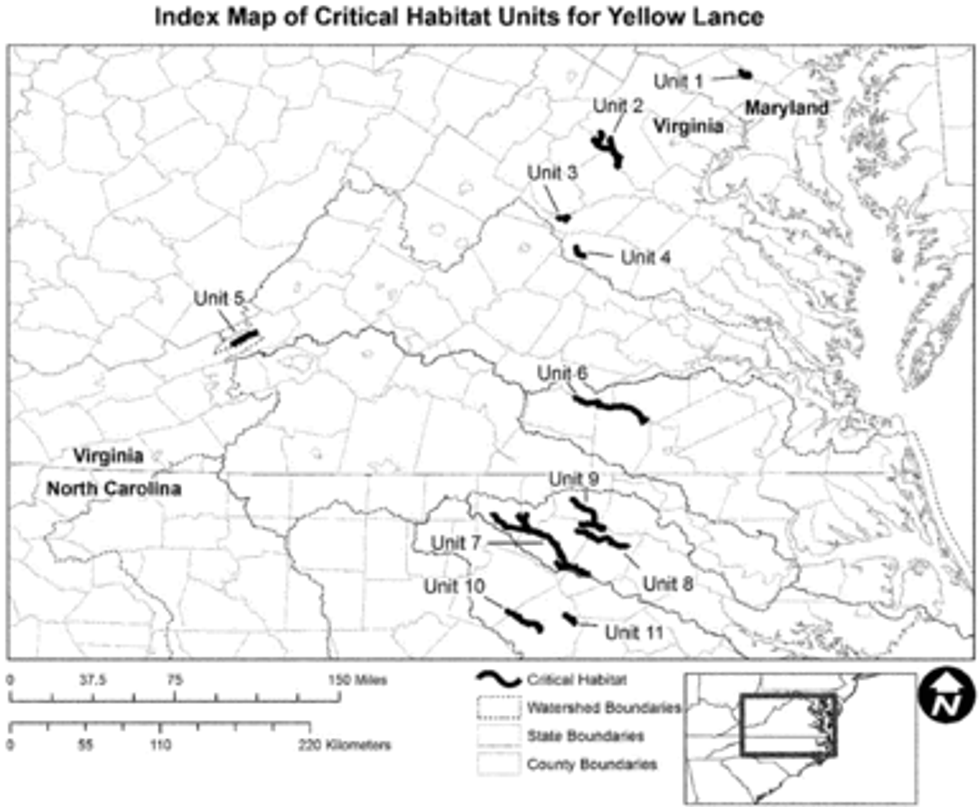
(6) Unit 1: PR1 - Patuxent River, Montgomery and Howard Counties, Maryland.
(i) This unit consists of approximately 10 river miles (16.1 kilometers (km)) of occupied habitat, including 3 miles (4.8 km) of the Patuxent River and 7 miles (11.3 km) of the Hawlings River. Unit 1 includes stream habitat up to bank full height.
(ii) Map of Unit 1 follows:
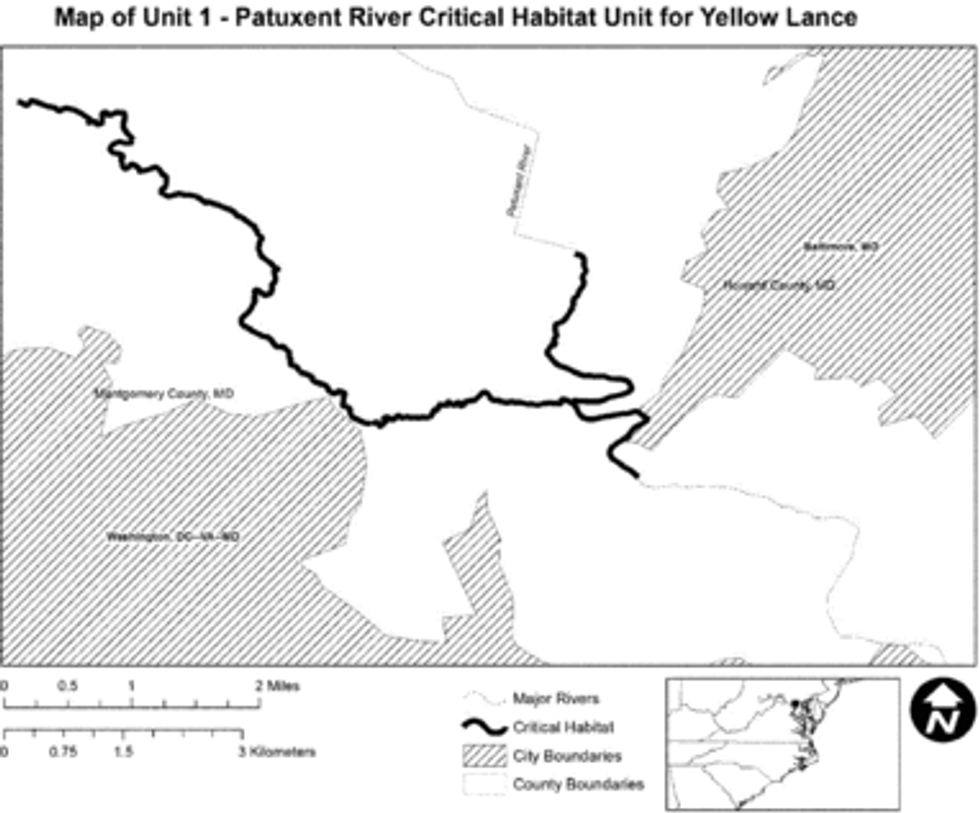
(7) Unit 2: RR1 - Rappahannock Subbasin, Rappahannock, Fauquier, and Culpeper Counties, Virginia.
(i) This unit consists of approximately 44 river miles (70.8 km) of occupied habitat in the Rappahannock Subbasin, including 1.7 miles (2.7 km) in Hungry Run, 7.9 miles (12.7 km) in Thumb Run, 5.9 miles (9.5 km) in South Run/Carter Run, 2.7 miles (4.3 km) in Great Run, and 25.8 miles (41.6 km) in Rappahannock River. Unit 2 includes stream habitat up to bank full height.
(ii) Map of Unit 2 follows:
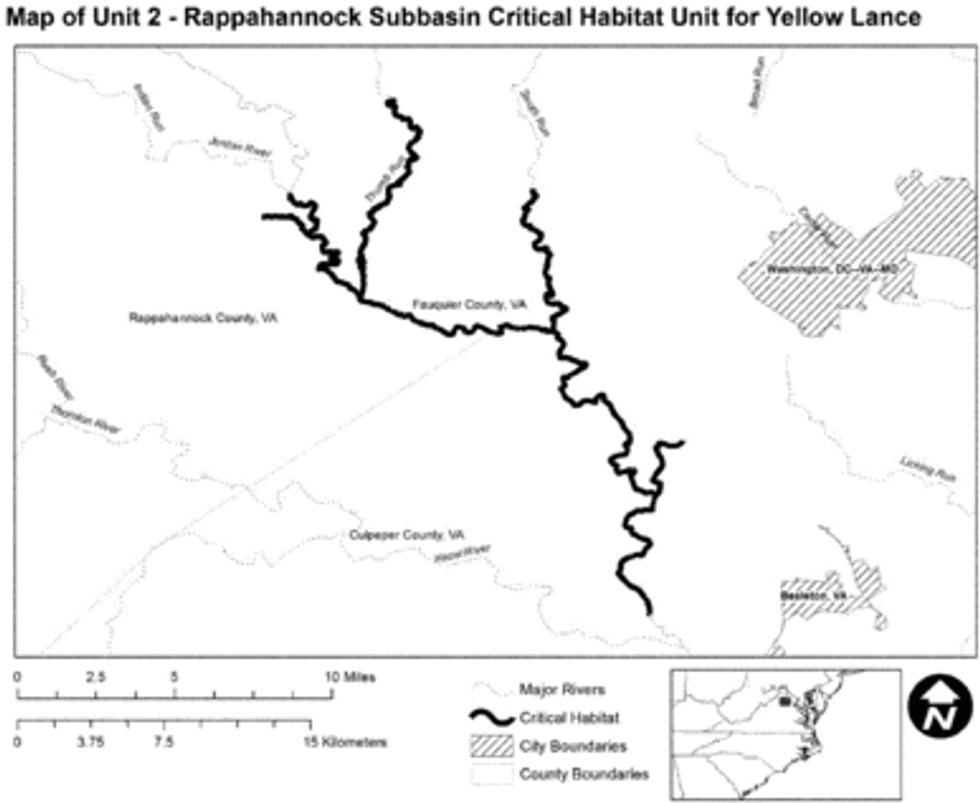
(8) Unit 3: RR2 - Rapidan Subbasin, Madison and Orange Counties, Virginia.
(i) This unit consists of 9 river miles (14.5 km) of occupied habitat in the Rapidan Subbasin, including 1.2 miles (1.9 km) in Marsh Run, 3.1 miles (5.0 km) in Blue Run, and 4.7 miles (7.6 km) in the Rapidan River. Unit 3 includes stream habitat up to bank full height.
(ii) Map of Unit 3 follows:
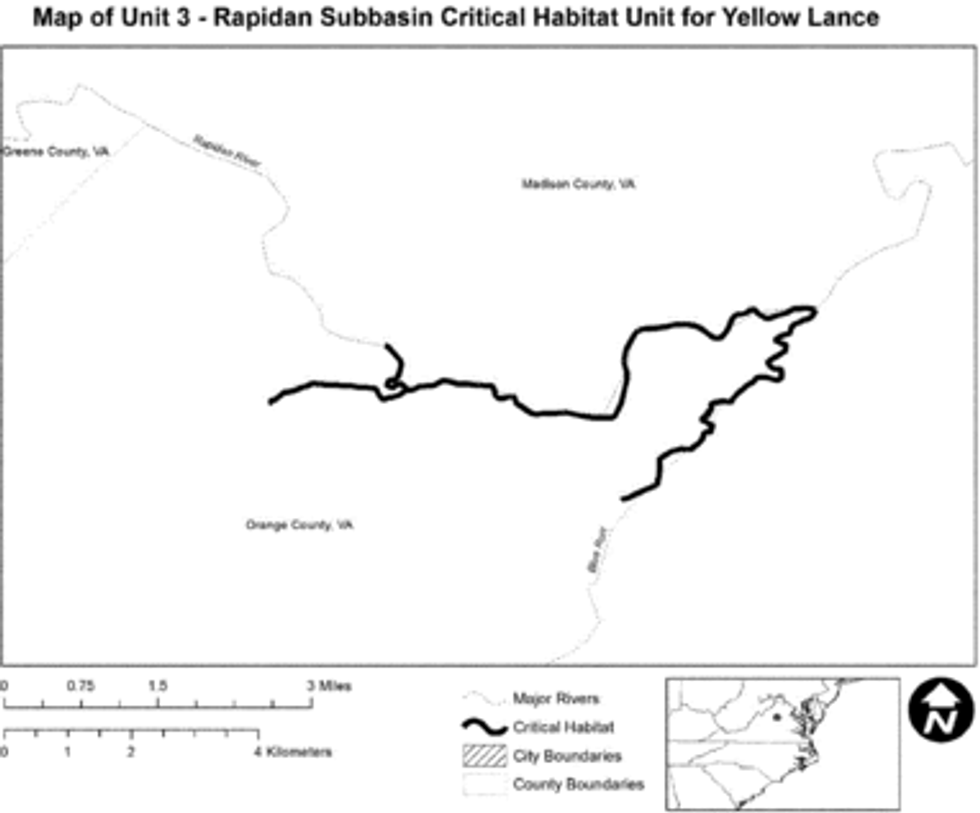
(9) Unit 4: YR1 - South Anna River, Louisa County, Virginia.
(i) This unit consists of approximately 8 river miles (12.9 km) of occupied habitat in the South Anna River. Unit 4 includes stream habitat up to bank full height.
(ii) Map of Unit 4 follows:
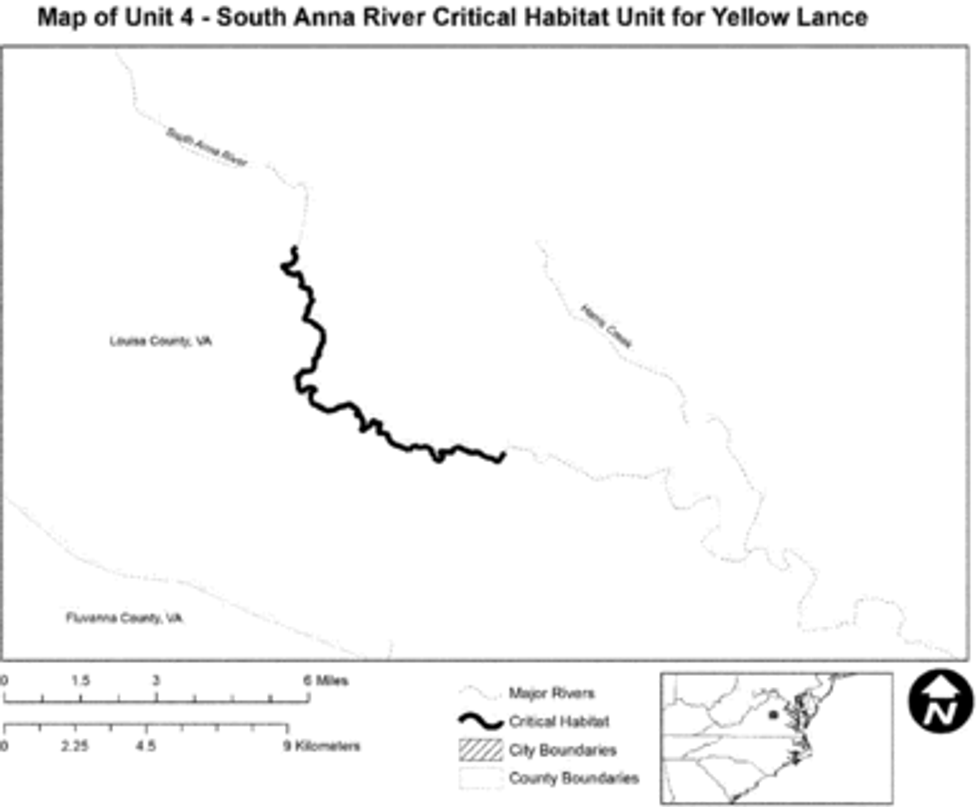
(10) Unit 5: JR1 - Johns Creek, Craig County, Virginia.
(i) This unit consists of approximately 14 river miles (22.5 km) of occupied habitat in the Johns Creek. Unit 5 includes stream habitat up to bank full height.
(ii) Map of Unit 5 follows:
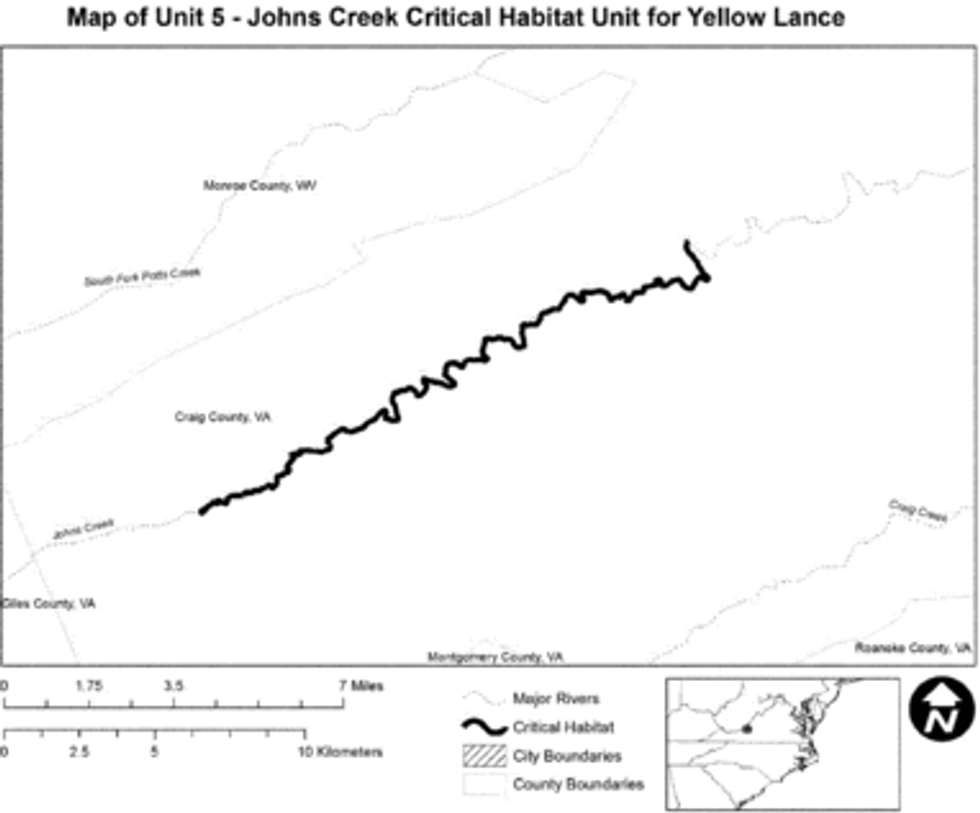
(11) Unit 6: CR1 - Nottoway Subbasin, Nottoway, Lunenburg, Brunswick, and Dinwiddie Counties, Virginia.
(i) This unit consists of approximately 41 river miles (66 km) of occupied habitat in the Nottoway Subbasin, including 1.4 miles (2.3 km) in Crooked Creek, 3.3 miles (5.3 km) in Sturgeon Creek, and 36.3 miles (58.4 km) in the Nottoway River. Unit 6 includes stream habitat up to bank full height.
(ii) Map of Unit 6 follows:
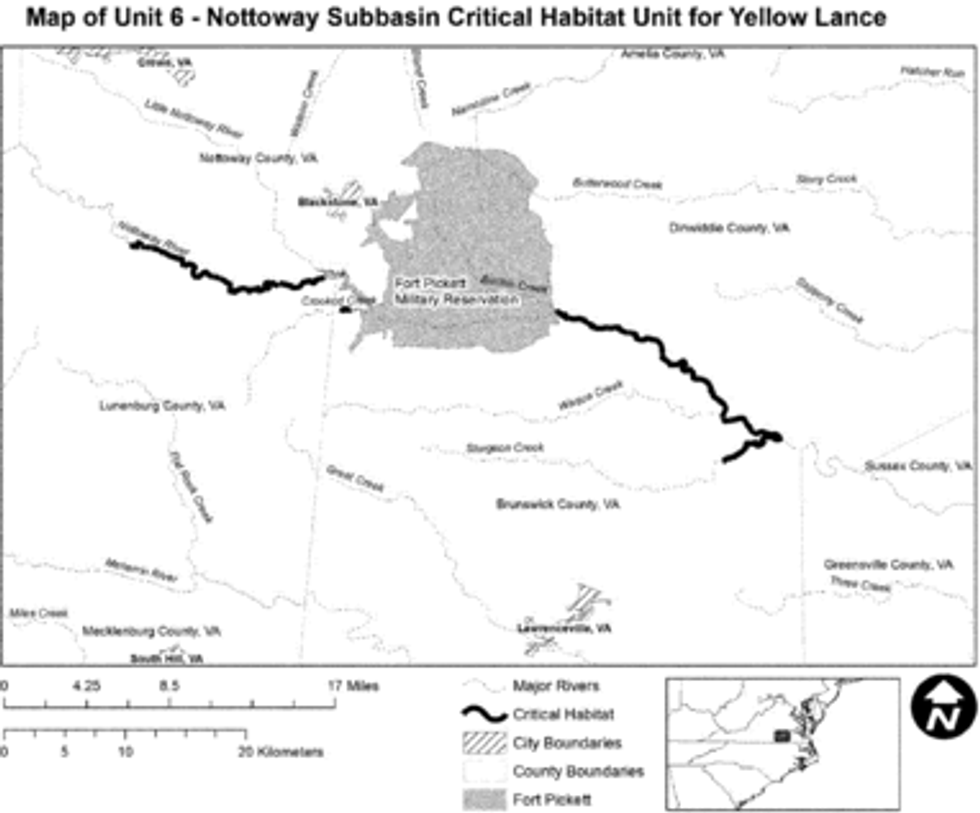
(12) Unit 7: TR1 - Tar River, Granville, Vance, Franklin, and Nash Counties, North Carolina.
(i) This unit consists of approximately 91 river miles (146.5 km) of occupied habitat in the Tar River, including 4.4 miles (7.1 km) in Ruin Creek, 11.9 miles (19.2 km) in Tabbs Creek, 6.8 miles (10.9 km) in Crooked Creek, and 67.9 miles (109.3 km) in the Tar River. Unit 7 includes stream habitat up to bank full height.
(ii) Map of Unit 7 follows:
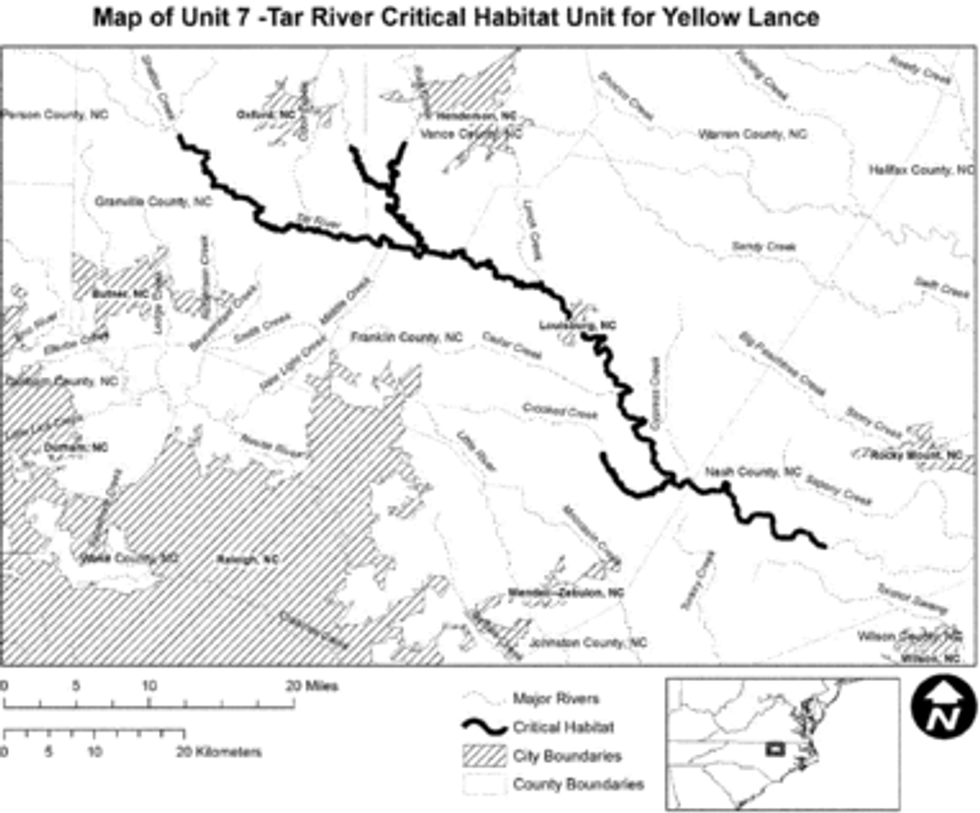
(13) Unit 8: TR2 - Sandy/Swift Creek, Vance, Warren, Halifax, Franklin, and Nash Counties, North Carolina.
(i) This unit consists of 31 river miles (50 km) of occupied habitat in the Sandy and Swift Creeks. Unit 8 includes stream habitat up to bank full height.
(ii) Map of Unit 8 follows:
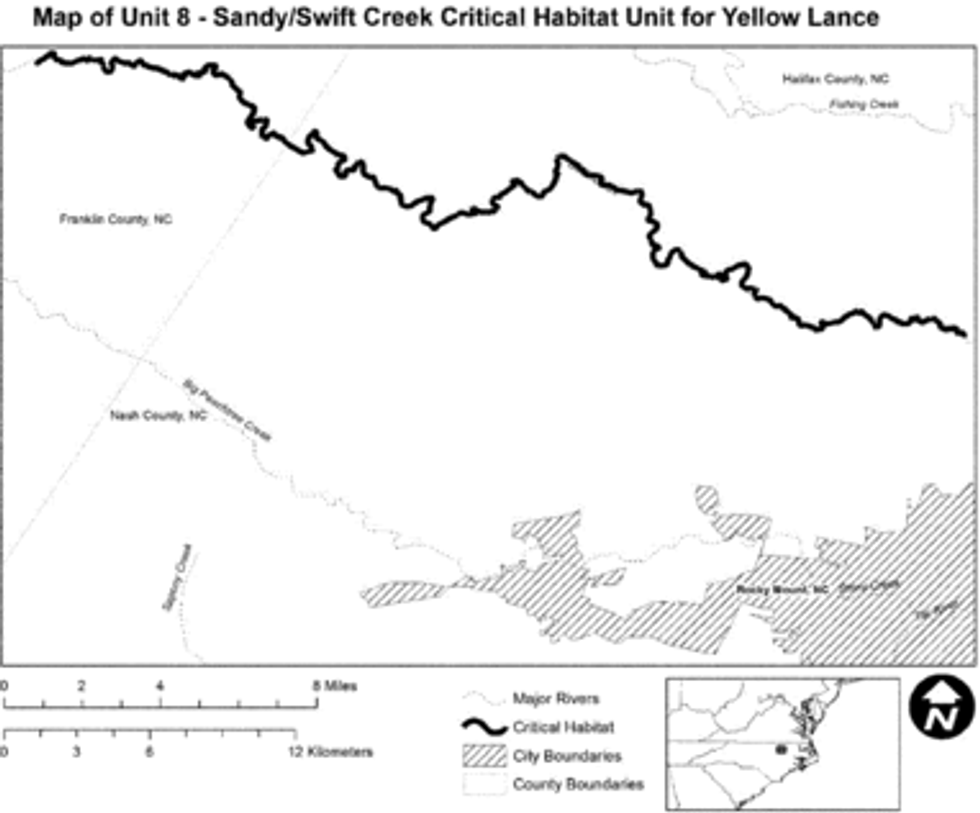
(14) Unit 9: TR3 - Fishing Creek Subbasin, Vance, Warren, Halifax, Franklin, and Nash Counties, North Carolina.
(i) This unit consists of approximately 37 river miles (59.5 km) of occupied habitat in the Fishing Creek Subbasin, including 1.6 miles (2.6 km) in Richneck Creek, 8.0 miles (12.9 km) in Shocco Creek, and 27.4 miles (44 km) in Fishing Creek. Unit 9 includes stream habitat up to bank full height.
(ii) Map of Unit 9 follows:
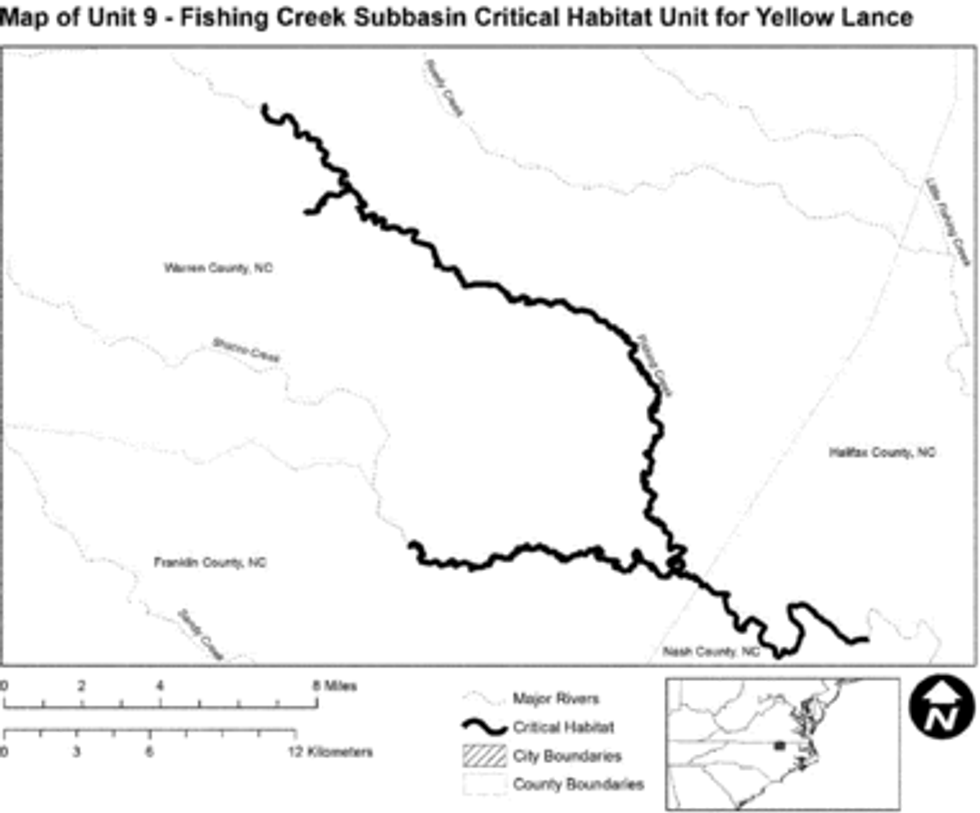
(15) Unit 10: NR1 - Swift Creek, Wake and Johnston Counties, North Carolina.
(i) This unit consists of approximately 24 river miles (38.6 km) of occupied habitat in the Swift Creek. Unit 10 includes stream habitat up to bank full height.
(ii) Map of Unit 10 follows:

(16) Unit 11: NR2 - Little River, Johnston County, North Carolina.
(i) This unit consists of approximately 10 river miles (16.1 km) of occupied habitat in the Little River. Unit 11 includes stream habitat up to bank full height.
(ii) Map of Unit 11 follows:
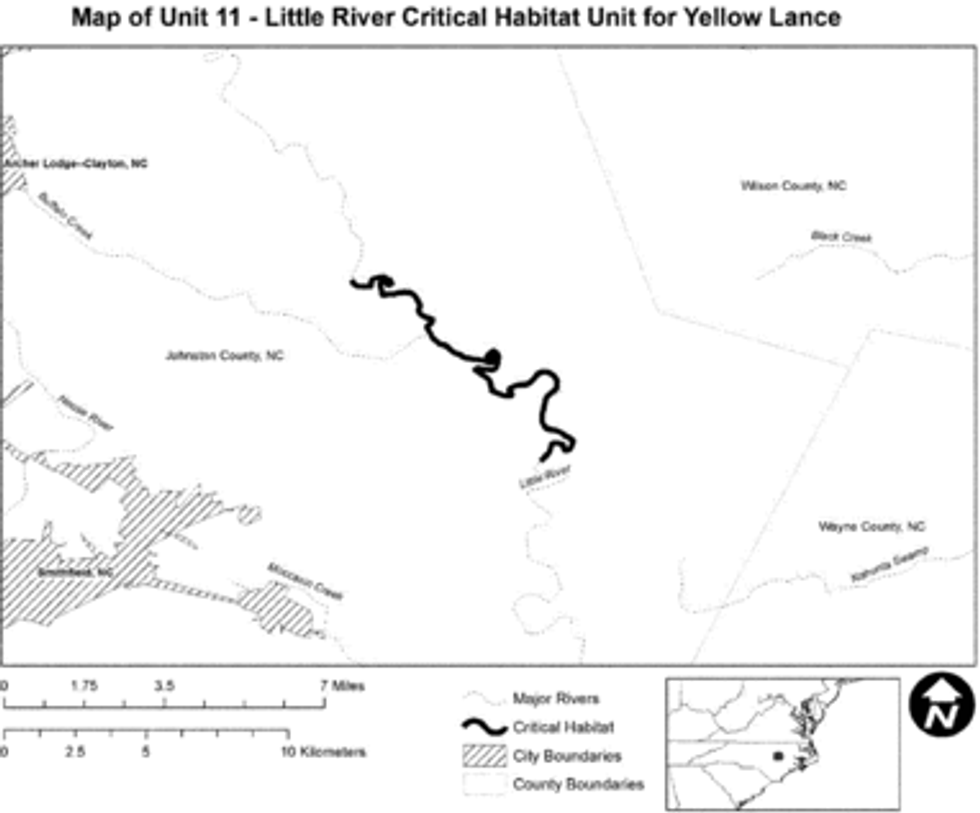
Tumbling Creek Cavesnail (Antrobia culveri)
(1) The critical habitat unit is depicted for Taney County, Missouri, on the map at paragraph (f)(5)(ii) of this section. The maps provided are for informational purposes only.
(2) Within this area, the primary constituent elements of the physical and biological features essential to the conservation of the Tumbling Creek cavesnail consist of five components:
(i) Geomorphically stable stream bottoms and banks (stable horizontal dimension and vertical profile) in order to:
(A) Maintain bottom features (riffles, runs, and pools) and transition zones between bottom features;
(B) Continue appropriate habitat to maintain essential riffles, runs, and pools; and
(C) Promote connectivity between Tumbling Creek and its tributaries and associated springs to maintain gene flow throughout the population.
(ii) Instream flow regime with an average daily discharge between 0.07 and 150 cubic feet per second (cfs), inclusive of both surface runoff and groundwater sources (springs and seepages).
(iii) Water quality with temperature 55-62°F (12.78-16.67°C), dissolved oxygen 4.5 milligrams or greater per liter, and turbidity of an average monthly reading of no more than 200 Nephelometric Turbidity Units (NTU; units used to measure sediment discharge) for a duration not to exceed 4 hours.
(iv) Bottom substrates consisting of fine gravel with coarse gravel or cobble, or bedrock with sand and gravel, with low amounts of fine sand and sediments within the interstitial spaces of the substrates.
(v) Energy input from guano that originates mainly from gray bats (Myotis grisescens) that roost in the cave; guano is essential in the development of biofilm (the organic coating and bacterial layer that covers rocks in the cave stream) that cavesnails use for food.
(3) Critical habitat does not include manmade structures (such as buildings, aqueducts, runways, roads, and other paved areas) and the land on which they are located existing within the legal boundaries on the effective date of this rule.
(4) Critical habitat map unit. Data layers defining the map unit were created using 7.5′ topographic quadrangle maps and ArcGIS (version 9.3.1) mapping software.
(5) Tumbling Creek Cavesnail Critical Habitat Unit.
(i) U.S. Geological Survey 7.5′ Topographic Protem Quad. Land bounded by the following UTM Zone 15N, North American Datum of 1983 (NAD83) coordinates (W, N): from the emergence of Tumbling Creek within Tumbling Creek Cave at Lat. 36°33′37.41″ N, Long. 92°48′27.23″ W to its confluence with Bear Cave Hollow and Owens Spring upstream of Big Creek at at Lat. 36°33′15.2″ N, Long. 92°47′51.74″ W.
(ii) Note: Map of Tumbling Creek Cavesnail Critical Habitat Unit follows:
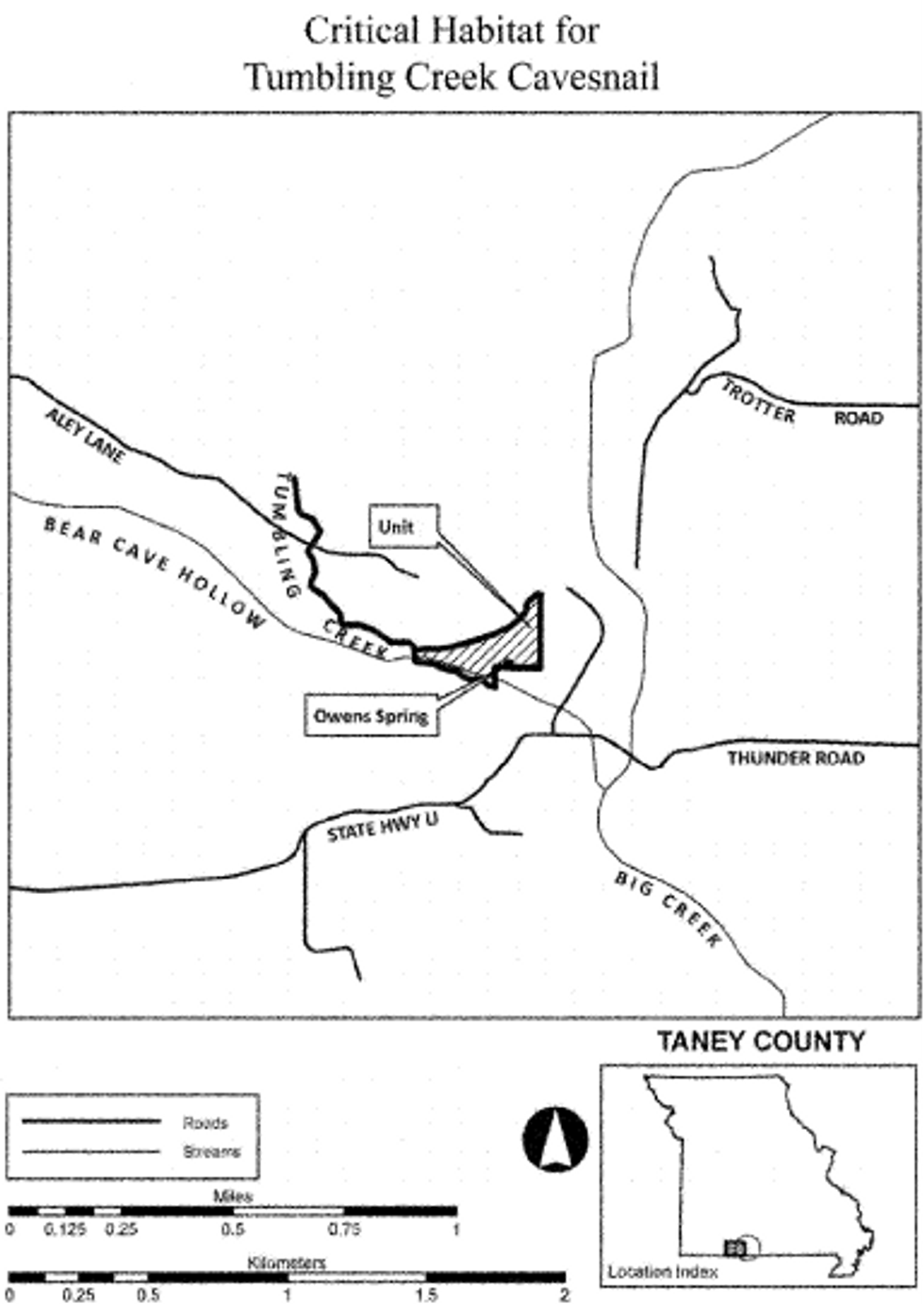
Rough Hornsnail (Pleurocera foremani)
(1) Critical habitat units are depicted for Elmore and Shelby Counties, Alabama, on the maps below.
(2) The primary constituent elements (PCEs) of critical habitat for the rough hornsnail are the habitat components that provide:
(i) Geomorphically stable stream and river channels and banks (channels that maintain lateral dimensions, longitudinal profiles, and sinuosity patterns over time without an aggrading or degrading bed elevation).
(ii) A hydrologic flow regime (the magnitude, frequency, duration, and seasonality of discharge over time) necessary to maintain benthic habitats where the species is found. Unless other information becomes available, existing conditions at locations where the species occurs will be considered as minimal flow requirements for survival.
(iii) Water quality (including temperature, pH, hardness, turbidity, oxygen content, and chemical constituents) that meets or exceeds the current aquatic life criteria established under the Clean Water Act (33 U.S.C. 1251-1387).
(iv) Sand, gravel, cobble, boulder, bedrock, or mud substrates with low to moderate amounts of fine sediment and attached filamentous algae.
(3) Critical habitat does not include manmade structures existing on the effective date of this rule and not containing one or more of the primary constituent elements, such as buildings, bridges, aqueducts, airports, and roads, and the land on which such structures are located.
(4) Critical habitat unit maps. Maps were developed from USGS 7.5′ quadrangles. Critical habitat unit upstream and downstream limits were then identified by longitude and latitude using decimal degrees and converted to Universal Transverse Mercator (UTM) zone 16, coordinates.
(5) Note: Index map of critical habitat units for the rough hornsnail follows:
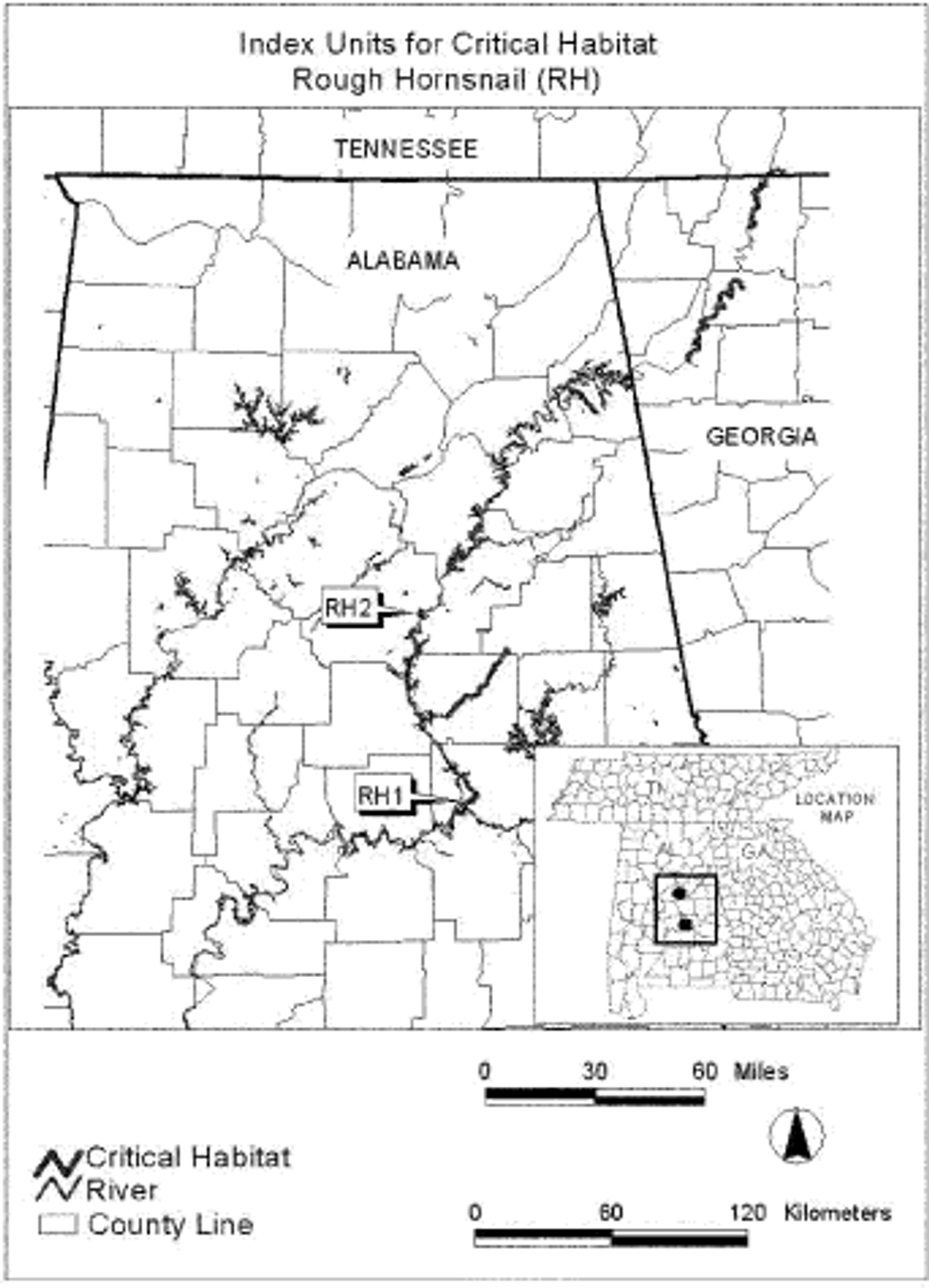
(6) Unit 1 for rough hornsnail (RH 1): Lower Coosa River, Elmore County, Alabama.
(i) Unit RH 1 includes the Coosa River channel from Jordan Dam (569930.28E, 3609212.67N), downstream to the confluence of the Tallapoosa River (568995.14E, 3597805.93N), Elmore County, Alabama.
(ii) Map of Unit 1 (RH 1) for rough hornsnail (Coosa River) follows:
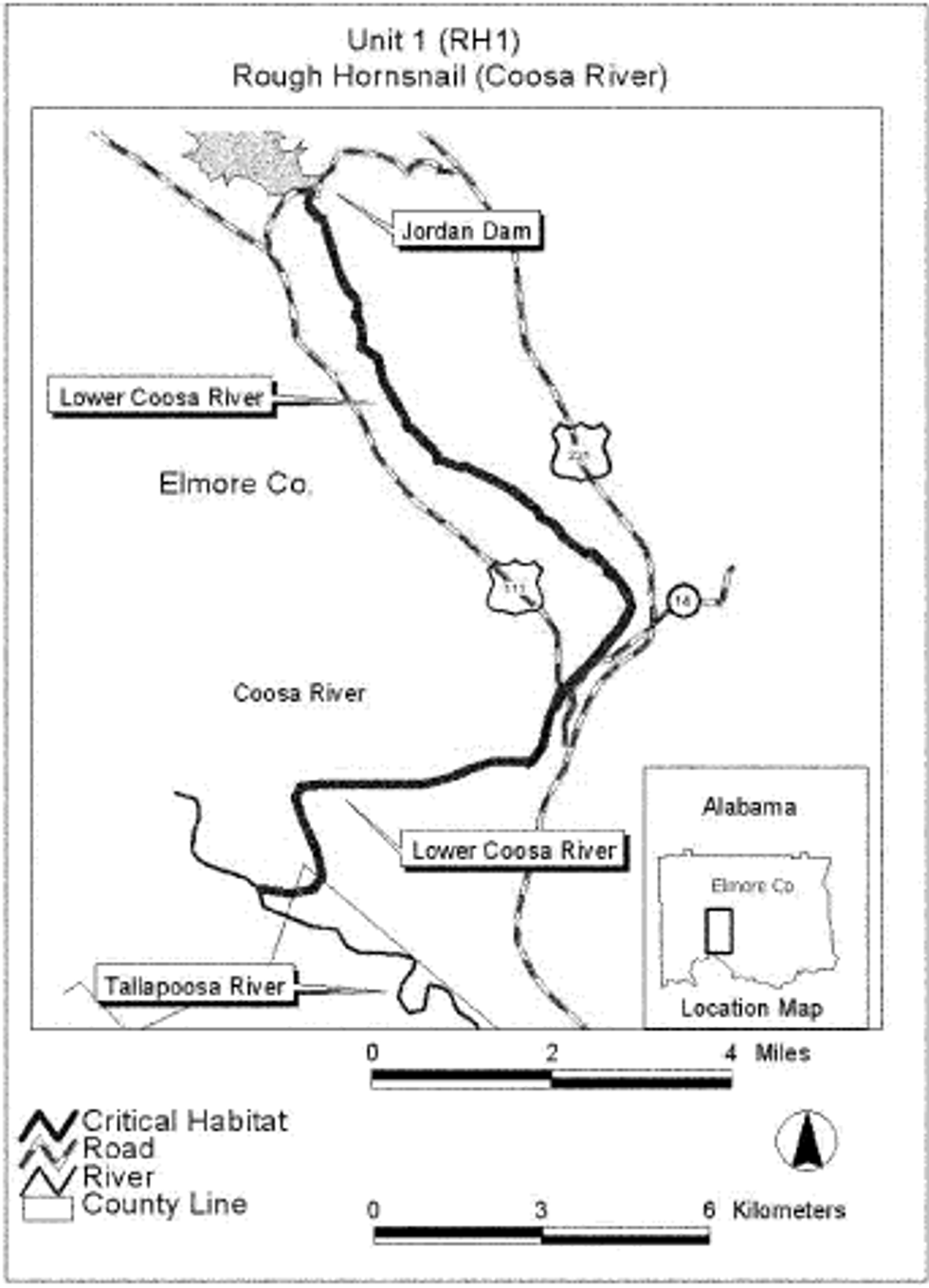
(7) Unit 2 for rough hornsnail (RH 2): Yellowleaf Creek, Shelby County, Alabama.
(i) Unit RH 2 includes the channel of Yellowleaf Creek from the confluence of Morgan Creek (550285.41E, 3682865.13N), downstream to 1.6 km (1 mi) below Alabama Highway 25 (552296.38E, 3679287.87N), Shelby County, Alabama.
(ii) Map of Unit 2 (RH 2) for rough hornsnail (Yellowleaf Creek) follows:
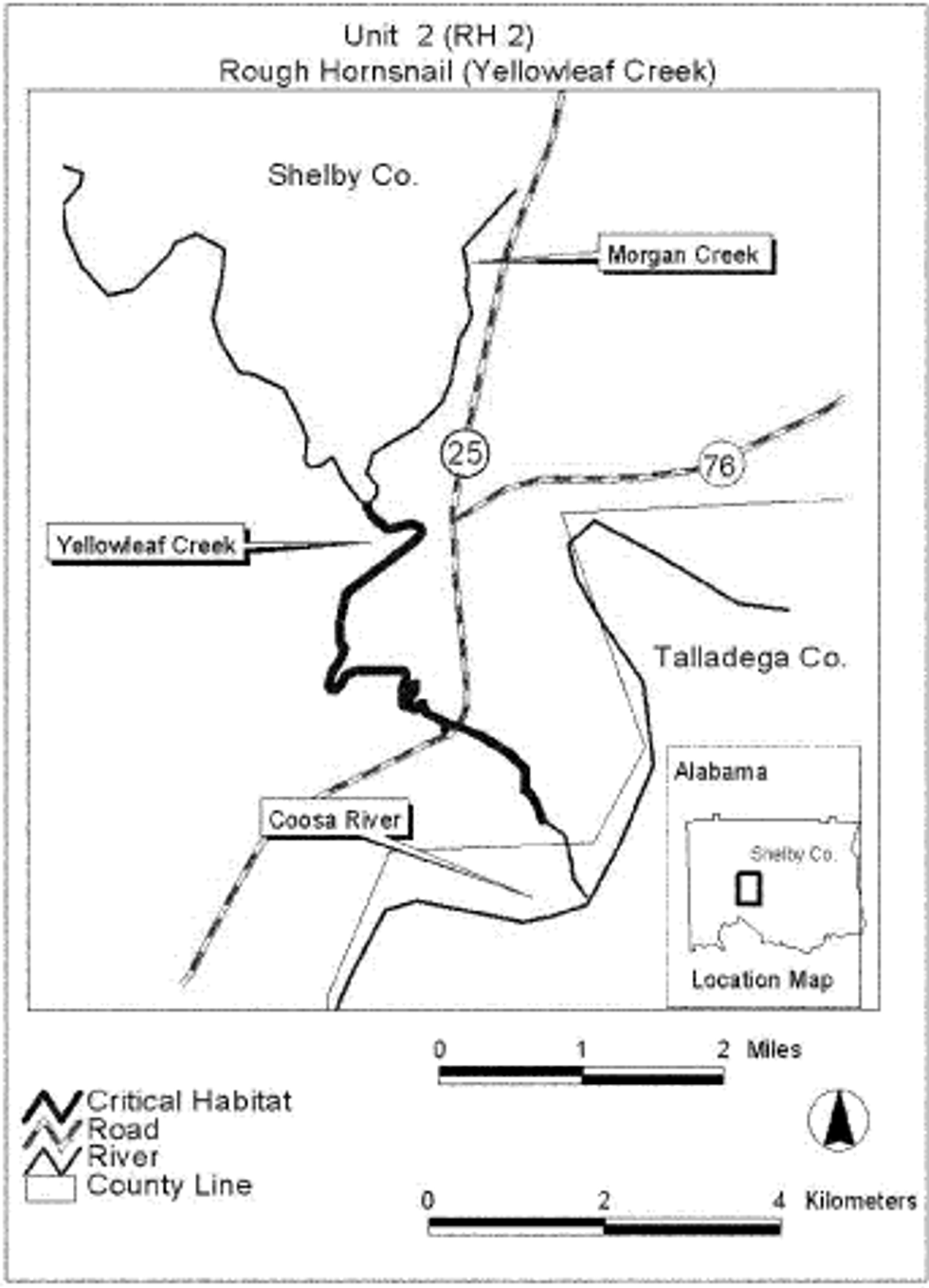
Morro Shoulderband Snail (Helminthoglypta walkeriana)
1. Critical habitat units are depicted for San Luis Obispo County, California, on the map below. The map provided is for informational purposes only.
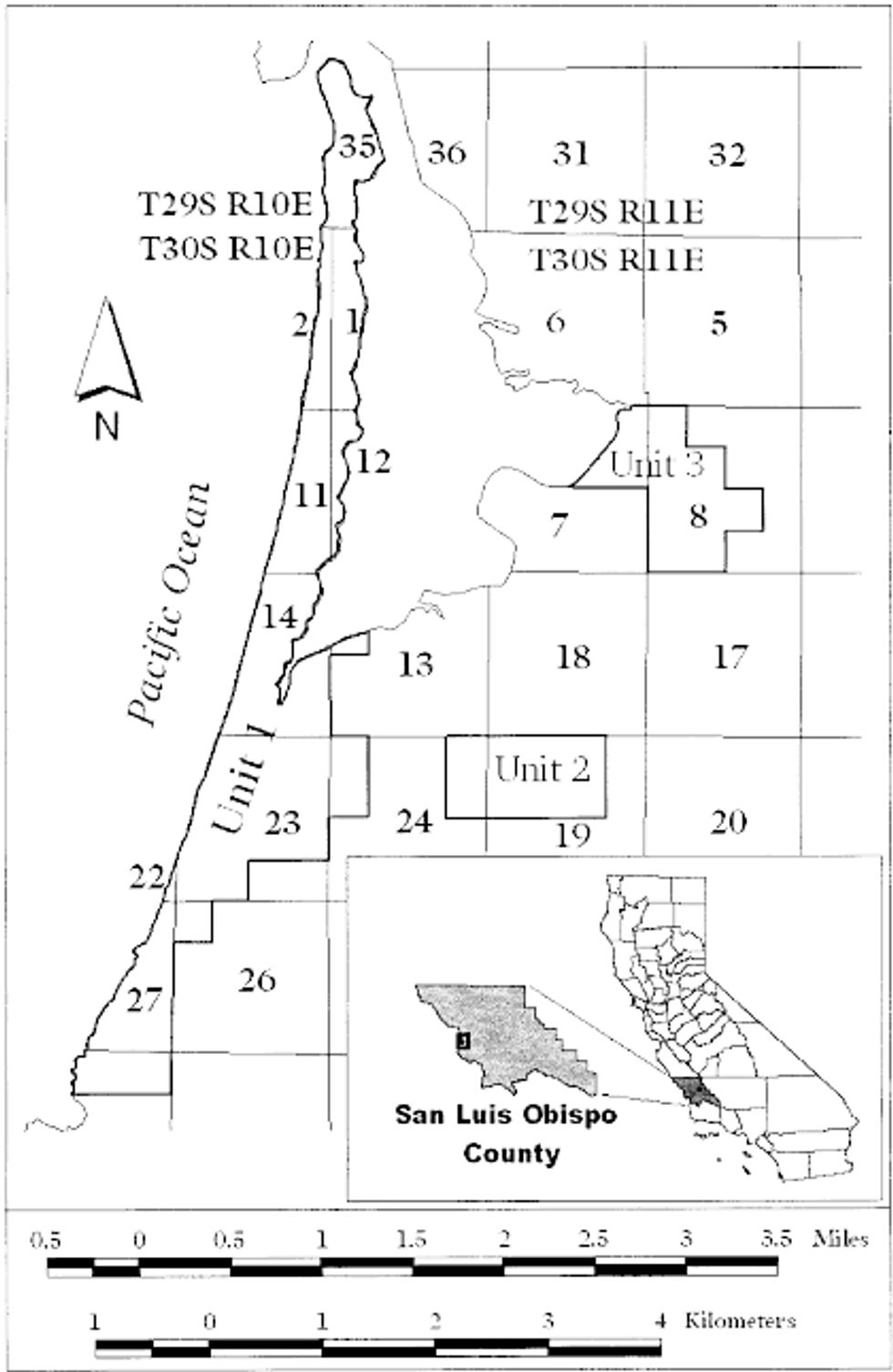
Map Units 1 to 3: All located in San Luis Obispo County, California. Coastline boundaries are based upon the U.S. Geological Survey Morro Bay South 7.5 minute topographic quadrangle. Other boundaries are based upon the Public Land Survey System. Within the historical boundaries of the Canada De Los Osos Y Pecho Y Islay Mexican Land Grant, boundaries are based upon section lines that are extensions to the Public Land Survey System developed by the California Department of Forestry and obtained by us from the State of California's Stephen P. Teale Data Center. Township and Range numbering is derived from the Mount Diablo Base and Meridian.
Map Unit 1: T. 29 S., R. 10 E., all of section 35 above mean sea level (MSL); T. 30 S., R. 10 E. All portions of sections 1, 2, 11, 12, 14, 22, and 27 above MSL, SW 1/4NW 1/4 section 13 above MSL, W 1/2NW 1/4 section 24, all of section 23 above MSL except S 1/2SE 1/4, NW 1/4NW 1/4 section 26, N 1/2N 1/2 section 34.
Map Unit 2: T. 30 S., R. 10 E., E 1/2NE 1/4 section 24; T. 30 S., R, 11 E., E 3/4N 1/2 section 19.
Map Unit 3: T. 30 S., R. 11 E., All of NE 1/4 section 7 above MSL; in section 8, NW 1/4NW 1/4, S 1/2NW 1/4, SW 1/4, and NW 1/4SE 1/4.
2. Within these areas, the primary constituent elements include, but are not limited to, those habitat components that are essential for the primary biological needs of foraging, sheltering, reproduction, and dispersal. The primary constituent elements for the Morro shoulderband snail are the following: sand or sandy soils; a slope not greater than 10 percent; and the presence of, or the capacity to develop, coastal dune scrub vegetation.
3. Critical habitat does not include existing developed sites consisting of buildings, roads, aqueducts, railroads, airports, paved areas, and similar features and structures.
Magnificent Ramshorn (Planorbella magnifica)
(1) Critical habitat units are depicted for Brunswick County, North Carolina, on the map in this entry.
(2) Critical habitat does not include humanmade structures (such as buildings, aqueducts, runways, roads, and other paved areas) and the land on which they are located existing within the legal boundaries on September 18, 2023.
(3) Data layers defining map units were created in a Geographic Information System (GIS), and critical habitat units were mapped using the U.S. Geological Survey's National Hydrography Dataset. The map in this entry, as modified by any accompanying regulatory text, establishes the boundaries of the critical habitat designation. The coordinates or plot points or both on which the map is based are available to the public at https://www.regulations.gov at Docket No. FWS–R4–ES–2022–0070, and at the field office responsible for this designation. You may obtain field office location information by contacting one of the Service regional offices, the addresses of which are listed at 50 CFR 2.2.
(4) Unit 1: Orton Pond; Brunswick County, North Carolina.
(i) Unit 1 consists of 688 acres (ac) (278 hectares (ha)) in an impounded section of Orton Creek in Brunswick County, North Carolina, approximately 1/2 mile upstream from the confluence with the Cape Fear River and east of the town of Boiling Spring Lakes. Unit 1 is composed of lands in private ownership.
(ii) Map of Units 1 and 2 follows:
Figure 1 for Magnificent Ramshorn (Planorbella magnifica) paragraph (4)(ii)
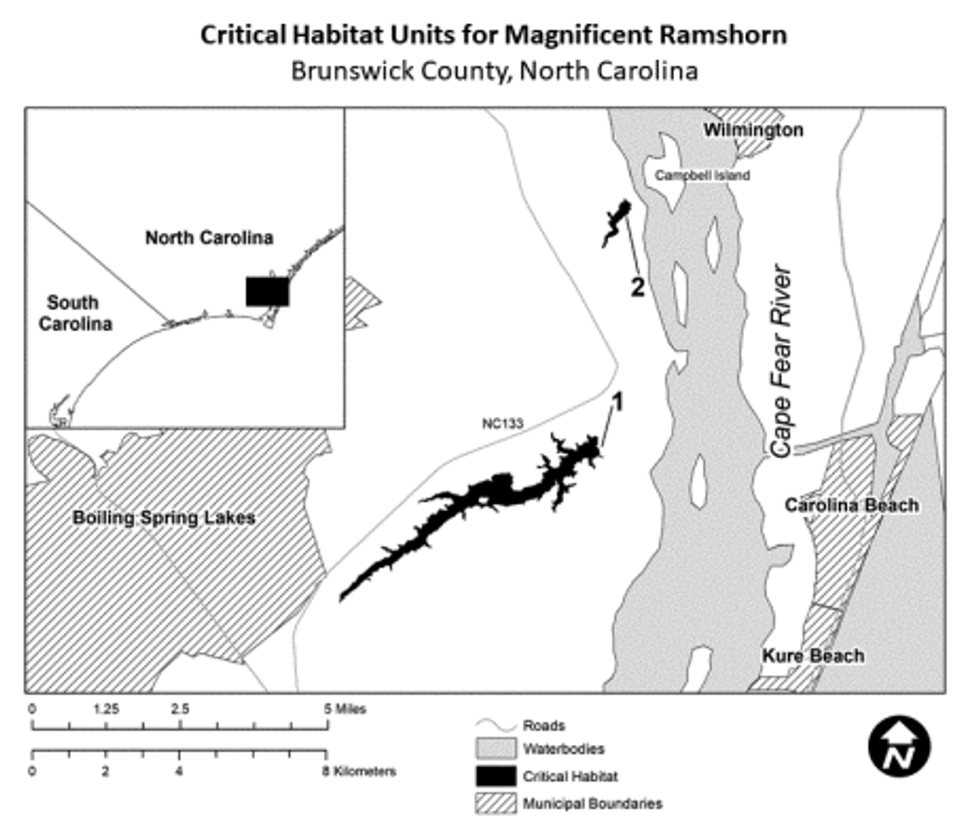
(5) Unit 2: Big Pond (Pleasant Oaks Pond); Brunswick County, North Carolina.
(i) Unit 2 consists of 51 ac (21 ha) in an impounded section of Sand Hill Creek in Brunswick County, North Carolina, near the confluence with the Cape Fear River across from Campbell Island. Unit 2 is composed of lands in private ownership.
(ii) Map of Unit 2 is provided at paragraph (4)(ii) of this entry.
Newcomb's Snail (Erinna newcombi)
(1) Critical Habitat Units are depicted for the County of Kauai, Hawaii, on the maps below. The maps provided are for informational purposes only.
(2) Within these areas, the primary constituent elements required by the Newcomb's snail are those habitat components that are essential for the biological needs of foraging, sheltering, reproduction, and dispersal. The primary constituent elements are: cool, clean, moderate-to fast-flowing water in streams, springs, and seeps; their adjacent riparian areas and hydrogeologic features that capture and direct water flow to these spring and stream systems; a perennial flow of water throughout even the most severe drought conditions; and stream channel morphology that provides protection from channel scour by having overhanging waterfalls, protected tributaries, or similar refugia.
(3) Existing human-made features and structures within the boundaries of the mapped units, such as dams, ditches, tunnels, flumes, and other human-made features that do not contain the primary constituent elements, are not included as critical habitat.
(4) Critical Habitat Unit I - Na Pali Coast Streams - (i) Unit I(a): Kalalau Stream (149 ha; 368 ac). The Kalalau Stream Newcomb's snail critical habitat location consists of all flowing surface waters within 63 boundary points with the following coordinates in UTM Zone 4 with the units in meters using North American Datum of 1983 (NAD83): 435010, 2450871; 434991, 2450828; 435008, 2450782; 435112, 2450715; 435107, 2450681; 435044, 2450591; 435058, 2450537; 435120, 2450441; 435078, 2450308; 435048, 2450279; 435017, 2450341; 434968, 2450375; 434678, 2450406; 434682, 2450441; 434678, 2450551; 434618, 2450603; 434578, 2450602; 434518, 2450564; 434418, 2450540; 434444, 2450711; 434428, 2450733; 434388, 2450657; 434338, 2450612; 434278, 2450596; 434228, 2450621; 434188, 2450596; 434166, 2450621; 434159, 2450691; 434148, 2450691; 434058, 2450599; 433995, 2450571; 433968, 2450540; 433878, 2450559; 433825, 2450544; 433767, 2450451; 433738, 2450478; 433700, 2450581; 433670, 2450611; 433670, 2450671; 433633, 2450738; 433715, 2450996; 433732, 2451168; 433740, 2451380; 433642, 2451551; 433633, 2451598; 433688, 2451664; 433842, 2451694; 434206, 2451592; 434680, 2451547; 435053, 2451609; 435129, 2451611; 435147, 2451590; 435114, 2451460; 435048, 2451400; 434973, 2451360; 435041, 2451320; 435043, 2451250; 435134, 2451170; 435126, 2451120; 435089, 2451069; 435075, 2451013; 435018, 2450933; 435010, 2450871;
(ii) Unit I(b): Hanakoa Stream (63 ha; 156 ac). The Hanakoa Stream Newcomb's snail critical habitat location consists of all flowing surface waters within 24 boundary points with the following coordinates in UTM Zone 4 with the units in meters using North American Datum of 1983 (NAD83): 435729, 2453628; 435717, 2453789; 436111, 2454127; 436637, 2454087; 436700, 2454008; 436719, 2453907; 436658, 2453889; 436654, 2453857; 436735, 2453697; 436744, 2453577; 436558, 2453527; 436518, 2453555; 436478, 2453559; 436250, 2453496; 436152, 2453358; 436123, 2453263; 436068, 2453238; 435998, 2453171; 435918, 2453168; 435869, 2453229; 435799, 2453248; 435780, 2453320; 435770, 2453490; 435729, 2453628.
(iii) Unit I(c): Hanakapiai Stream (35 ha; 86 ac). The Hanakapiai Stream Newcomb's snail critical habitat location consists of all flowing surface waters within 25 boundary points with the following coordinates in UTM Zone 4 with the units in meters using North American Datum of 1983 (NAD83): 438438, 2453772; 438785, 2453827; 438899, 2453794; 438961, 2453796; 439113, 2453829; 439216, 2453871; 439257, 2453846; 439234, 2453666; 439263, 2453606; 439310, 2453377; 439299, 2453306; 439258, 2453253; 439158, 2453265; 439098, 2453290; 438949, 2453407; 438769, 2453508; 438692, 2453457; 438674, 2453387; 438618, 2453307; 438591, 2453347; 438578, 2453417; 438525, 2453507; 438443, 2453622; 438429, 2453677; 438438, 2453772.
(iv) Map 1 - Unit I - Na Pali Coast Streams follows:

(5) Critical Habitat Unit II - Central Rivers - (i) Unit II(a): Lumahai River (492 ha; 1,216 ac). The Lumahai River Newcomb's snail critical habitat location consists of all flowing surface waters within 89 boundary points with the following coordinates in UTM Zone 4 with the units in meters using North American Datum of 1983 (NAD83): 447598, 2445954; 447344, 2446136; 447298, 2446352; 447248, 2446290; 447178, 2446384; 447088, 2446327; 446972, 2446364; 446950, 2446572; 446787, 2446678; 446648, 2446627; 446648, 2446739; 446445, 2446836; 446409, 2447000; 446278, 2447034; 446208, 2447169; 446097, 2447178; 446141, 2447349; 446024, 2447449; 446014, 2447649; 445808, 2447618; 445809, 2447680; 445839, 2447840; 445616, 2447859; 445773, 2448009; 445589, 2448069; 445728, 2448189; 445531, 2448299; 445685, 2448359; 445605, 2448469; 445728, 2448478; 445854, 2448578; 445858, 2448680; 445728, 2448778; 445759, 2448939; 445618, 2448896; 445548, 2448954; 445318, 2448932; 445338, 2449080; 445164, 2449034; 445171, 2449211; 444998, 2449168; 444932, 2449348; 445008, 2449493; 445936, 2450417; 446309, 2450498; 446262, 2450317; 446309, 2450238; 446476, 2450245; 446385, 2450007; 446688, 2450060; 446714, 2449913; 446811, 2449890; 446799, 2449758; 446998, 2449747; 447028, 2449643; 447101, 2449690; 447098, 2449525; 447228, 2449509; 447343, 2449387; 447229, 2449247; 447298, 2449117; 447128, 2449116; 446901, 2448918; 447174, 2448778; 447144, 2448668; 447066, 2448628; 447190, 2448478; 446898, 2448400; 446778, 2448451; 446649, 2448198; 446831, 2448108; 446782, 2447899; 447064, 2447862; 446986, 2447707; 447038, 2447583; 447225, 2447529; 447162, 2447395; 446973, 2447289; 447008, 2446969; 447288, 2446719; 447234, 2446659; 447268, 2446571; 447448, 2446499; 447548, 2446559; 447484, 2446393; 447518, 2446304; 447739, 2446259; 447507, 2446131; 447598, 2445954;
(ii) Unit II(b): Hanalei River (876 ha; 2,165 ac). The Hanalei River Newcomb's snail critical habitat location consists of all flowing surface waters within 91 boundary points with the following coordinates in UTM Zone 4 with the units in meters using North American Datum of 1983 (NAD83): 450038, 2447210; 451786, 2447529; 453099, 2446469; 453648, 2446167; 453691, 2445925; 453614, 2445904; 453508, 2446074; 453044, 2445908; 452961, 2445785; 452974, 2445578; 453125, 2445605; 453267, 2445468; 453258, 2445377; 453550, 2445238; 453508, 2445111; 453318, 2445096; 453238, 2444991; 453098, 2445064; 453010, 2444769; 452768, 2444606; 452680, 2444349; 452760, 2444169; 452581, 2444039; 452723, 2443844; 452429, 2443810; 452486, 2443680; 452419, 2443309; 452280, 2443240; 452198, 2443073; 452088, 2443185; 451948, 2442960; 451678, 2442885; 451549, 2442979; 451471, 2442787; 450955, 2442448; 451082, 2442651; 450916, 2442988; 450337, 2443081; 450718, 2443188; 450968, 2443197; 451068, 2443077; 451255, 2443133; 451414, 2443330; 451612, 2443370; 451552, 2443666; 451549, 2444330; 451107, 2443911; 450988, 2444210; 450894, 2443874; 450638, 2443920; 450431, 2443773; 450492, 2444026; 450614, 2444100; 450468, 2444134; 450592, 2444250; 450389, 2444360; 450621, 2444363; 450698, 2444275; 450967, 2444669; 450939, 2444770; 450803, 2444769; 450978, 2444899; 450611, 2445032; 450698, 2445101; 450573, 2445219; 450969, 2445168; 450768, 2445479; 451068, 2445422; 451226, 2445489; 451158, 2445584; 451251, 2445606; 451216, 2445692; 451335, 2445819; 451188, 2445824; 451124, 2445925; 450928, 2445983; 450904, 2446088; 451017, 2446148; 450940, 2446208; 451031, 2446325; 451208, 2446428; 450928, 2446552; 450788, 2446490; 450688, 2446603; 450538, 2446560; 450668, 2446774; 450418, 2446700; 450199, 2446739; 450133, 2446913; 449784, 2447034; 450038, 2447210.
(iii) Map 2 - Unit II - Central Rivers - follows:

(6) Critical Habitat Unit III - Eastside Mountain Streams - (i) Unit III(a): Waipahee Stream (66 ha; 163 ac). The Waipahee Stream Newcomb's snail critical habitat location consists of all flowing surface waters within 78 boundary points with the following coordinates in UTM Zone 4 with the units in meters using North American Datum of 1983 (NAD83): 458921, 2447414; 458943, 2447424; 458998, 2447420; 459102, 2447444; 459044, 2447534; 459104, 2447563; 459108, 2447613; 459085, 2447643; 459100, 2447671; 459118, 2447693; 459108, 2447714; 459078, 2447703; 459048, 2447661; 459028, 2447663; 459017, 2447694; 459045, 2447696; 459054, 2447727; 459118, 2447770; 459164, 2447749; 459191, 2447646; 459231, 2447596; 459309, 2447603; 459321, 2447623; 459306, 2447685; 459351, 2447663; 459398, 2447531; 459478, 2447584; 459518, 2447553; 459568, 2447656; 459586, 2447613; 459648, 2447556; 459738, 2447649; 459918, 2447569; 459998, 2447569; 460018, 2447584; 460048, 2447572; 460055, 2447576; 460261, 2447303; 460229, 2447182; 460178, 2446882; 460172, 2446875; 460058, 2446836; 459978, 2446834; 459906, 2446782; 459887, 2446803; 459902, 2446878; 459848, 2446946; 459818, 2446933; 459778, 2446940; 459694, 2446904; 459702, 2447004; 459648, 2447020; 459638, 2447098; 459608, 2447104; 459508, 2447031; 459502, 2447068; 459448, 2447061; 459500, 2447134; 459467, 2447203; 459445, 2447214; 459408, 2447183; 459388, 2447194; 459318, 2447163; 459268, 2447169; 459248, 2447139; 459218, 2447136; 459182, 2447074; 459148, 2447057; 459078, 2447076; 459083, 2447094; 459148, 2447124; 459185, 2447224; 459166, 2447274; 459178, 2447334; 459118, 2447345; 458948, 2447313; 459001, 2447384; 458928, 2447407.
(ii) Unit III(b): Makaleha Stream (95 ha; 235 ac). The Makaleha Stream Newcomb's snail critical habitat location consists of all flowing surface waters within 68 boundary points with the following coordinates in UTM Zone 4 with the units in meters using North American Datum of 1983 (NAD83): 459368, 2444730; 459372, 2444732; 459414, 2444830; 459438, 2444851; 459498, 2444854; 459528, 2444873; 459588, 2444828; 459601, 2444832; 459689, 2444388; 459662, 2444260; 459604, 2444112; 459455, 2444044; 459279, 2444030; 459064, 2444037; 459008, 2444069; 459002, 2444101; 458968, 2444099; 458944, 2444123; 458878, 2444096; 458808, 2444142; 458803, 2444197; 458748, 2444245; 458658, 2444279; 458633, 2444322; 458576, 2444325; 458582, 2444377; 458552, 2444407; 458568, 2444467; 458478, 2444527; 458474, 2444587; 458537, 2444607; 458492, 2444667; 458608, 2444684; 458633, 2444746; 458545, 2444763; 458495, 2444803; 458485, 2444833; 458418, 2444844; 458347, 2444897; 458418, 2444925; 458411, 2444963; 458504, 2444960; 458503, 2444991; 458458, 2445046; 458458, 2445076; 458528, 2445084; 458582, 2445036; 458678, 2444990; 458718, 2445049; 458798, 2444992; 458818, 2444992; 458868, 2445050; 458908, 2445056; 458933, 2445106; 458927, 2445176; 458854, 2445276; 458808, 2445463; 458960, 2445258; 459033, 2445116; 459033, 2445066; 458978, 2444969; 458983, 2444831; 459038, 2444842; 459088, 2444900; 459158, 2444877; 459218, 2444913; 459331, 2444816; 459368, 2444730.
(iii) Unit III(c): North Fork Wailua River (36 ha; 90 ac). The North Fork Wailua River Newcomb's snail critical habitat location consists of all flowing surface waters within 23 boundary points with the following coordinates in UTM Zone 4 with the units in meters using North American Datum of 1983 (NAD83): 450656, 2440137; 450861, 2440154; 450920, 2440206; 450968, 2440196; 451045, 2440217; 451079, 2440286; 451145, 2440241; 451197, 2440262; 451211, 2440324; 451291, 2440314; 451291, 2440244; 451426, 2440217; 451589, 2440237; 451616, 2440286; 451811, 2440230; 451801, 2440139; 451748, 2440049; 451717, 2439976; 451701, 2439841; 451455, 2439688; 451343, 2439745; 450968, 2440043; 450840, 2440040.
(iv) Map 3 - Unit III - Eastside Mountain Streams follows:

Pecos Assiminea (Assiminea Pecos)
(1) Critical habitat units are depicted for Chaves County, New Mexico, and Pecos and Reeves Counties, Texas, on the maps below.
(2) The primary constituent element of critical habitat for the Pecos assiminea is moist or saturated soil at stream or spring run margins:
(i) That consists of wet mud or occurs beneath mats of vegetation;
(ii) That is within 1 inch (2 to 3 centimeters) of flowing water;
(iii) That has native wetland plant species, such as salt grass or sedges, that provide leaf litter, shade, cover, and appropriate microhabitat;
(iv) That contains wetland vegetation adjacent to spring complexes that supports the algae, detritus, and bacteria needed for foraging; and
(v) That has adjacent spring complexes with:
(A) Permanent, flowing, fresh to moderately saline water with no or no more than low levels of pollutants; and
(B) Stable water levels with natural diurnal and seasonal variations.
(3) Critical habitat does not include manmade structures (such as buildings, aqueducts, runways, roads, and other paved areas) and the land on which they are located existing within the legal boundaries on the effective date of this rule.
(4) Critical habitat map units. Data layers defining map units were created on a base of USGS 1:24,000 maps, and critical habitat units were then mapped using Universal Transverse Mercator (UTM) coordinates.
(5) Unit 1: Sago/Bitter Creek Complex, Chaves County, New Mexico.
(i) [Reserved]
(ii) Map of Pecos Assiminea Critical Habitat Units 1 and 2b follows:
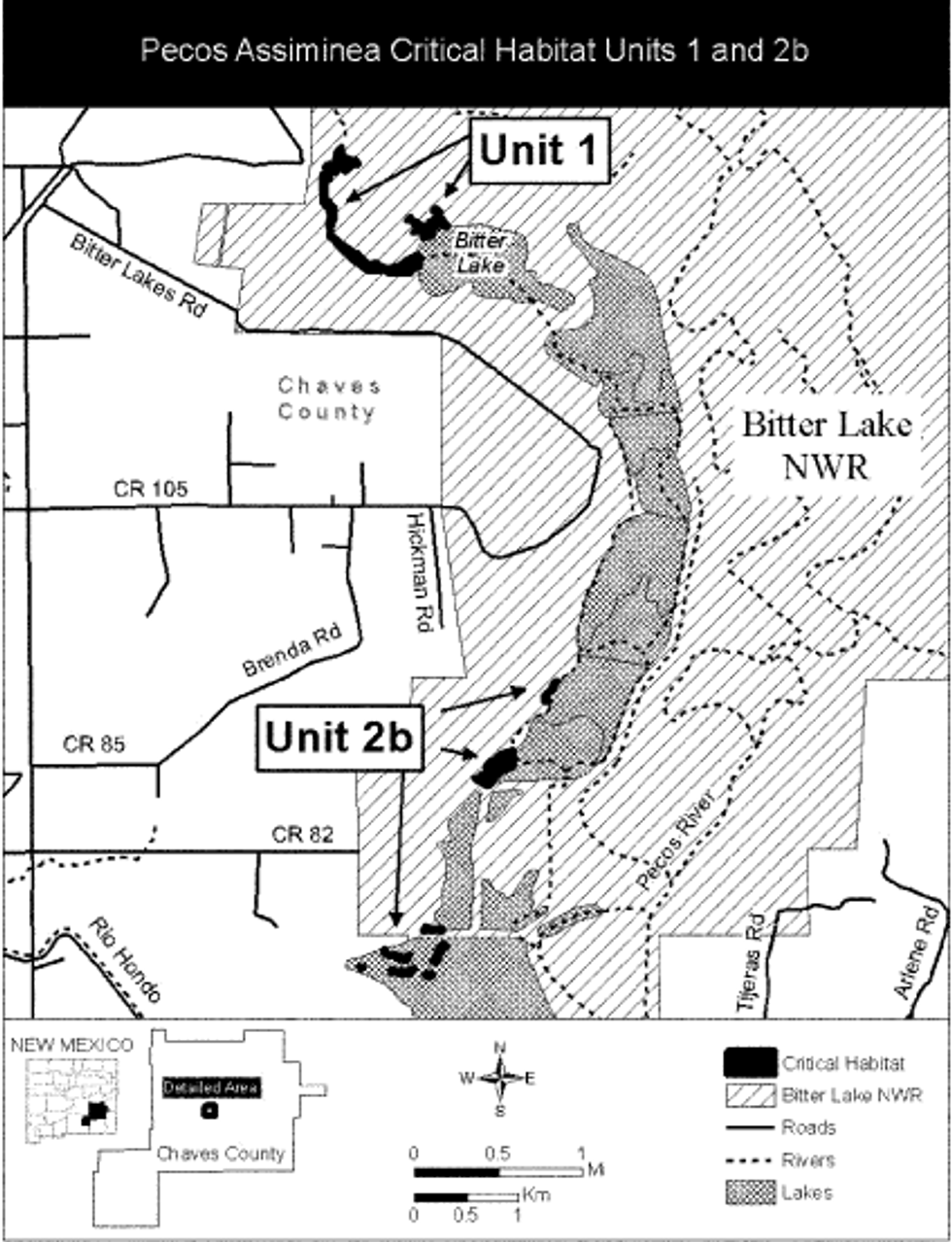
(6) Unit 2b: Assiminea Impoundment Complex, Chaves County, New Mexico.
(i) [Reserved]
(ii) Map of Unit 2b for Pecos assiminea is provided at paragraph (5)(ii) of this entry.
(7) Unit 4: Diamond Y Springs Complex, Pecos County, Texas.
(i) [Reserved]
(ii) Map of Pecos Assiminea Critical Habitat Units 4 and 5 follows:
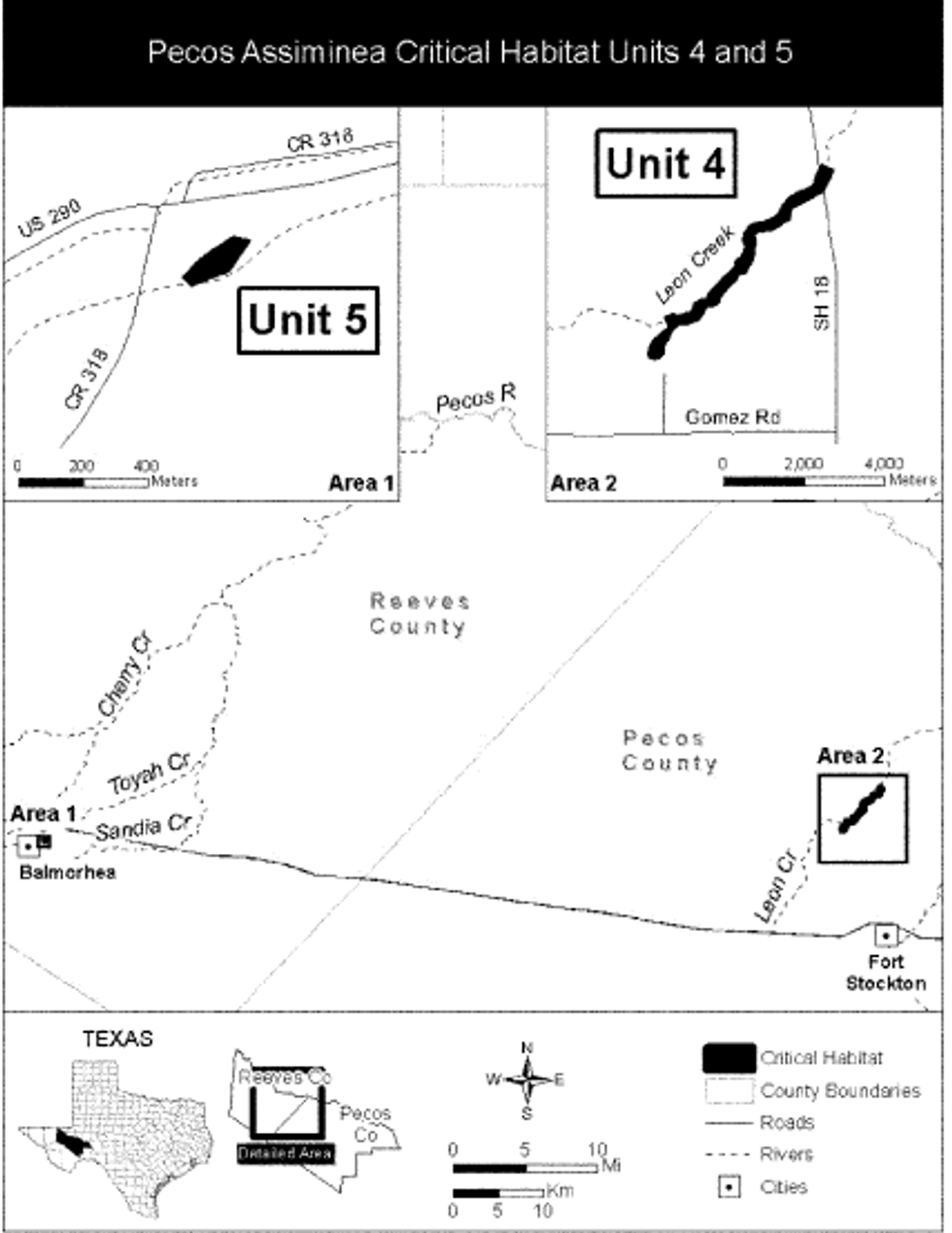
(8) Unit 5: East Sandia Spring, Reeves County, Texas.
(i) [Reserved]
(ii) Map of Unit 5 for Pecos assiminea is provided at paragraph (7)(ii) of this entry.
Interrupted Rocksnail (Leptoxis foremani)
(1) Critical habitat units are depicted for Cherokee and Elmore Counties, Alabama, and Gordon and Floyd Counties, Georgia, on the maps below.
(2) The primary constituent elements (PCEs) of critical habitat for the interrupted rocksnail are the habitat components that provide:
(i) Geomorphically stable stream and river channels and banks (channels that maintain lateral dimensions, longitudinal profiles, and sinuosity patterns over time without an aggrading or degrading bed elevation).
(ii) A hydrologic flow regime (the magnitude, frequency, duration, and seasonality of discharge over time) necessary to maintain benthic habitats where the species is found. Unless other information becomes available, existing conditions at locations where the species occurs will be considered as minimal flow requirements for survival.
(iii) Water quality (including temperature, pH, hardness, turbidity, oxygen content, and chemical constituents) that meets or exceeds the current aquatic life criteria established under the Clean Water Act (33 U.S.C. 1251-1387).
(iv) Sand, gravel, cobble, boulder, or bedrock substrates with low to moderate amounts of fine sediment and attached filamentous algae.
(3) Critical habitat does not include manmade structures existing on the effective date of this rule and not containing one or more of the PCEs, such as buildings, bridges, aqueducts, airports, and roads, and the land on which such structures are located.
(4) Critical habitat unit maps. Maps were developed from USGS 7.5′ quadrangles. Critical habitat unit upstream and downstream limits were then identified by longitude and latitude using decimal degrees and converted to Universal Transverse Mercator (UTM) zone 16, coordinates.
(5) Note: Index map of critical habitat units for the interrupted rocksnail follows:
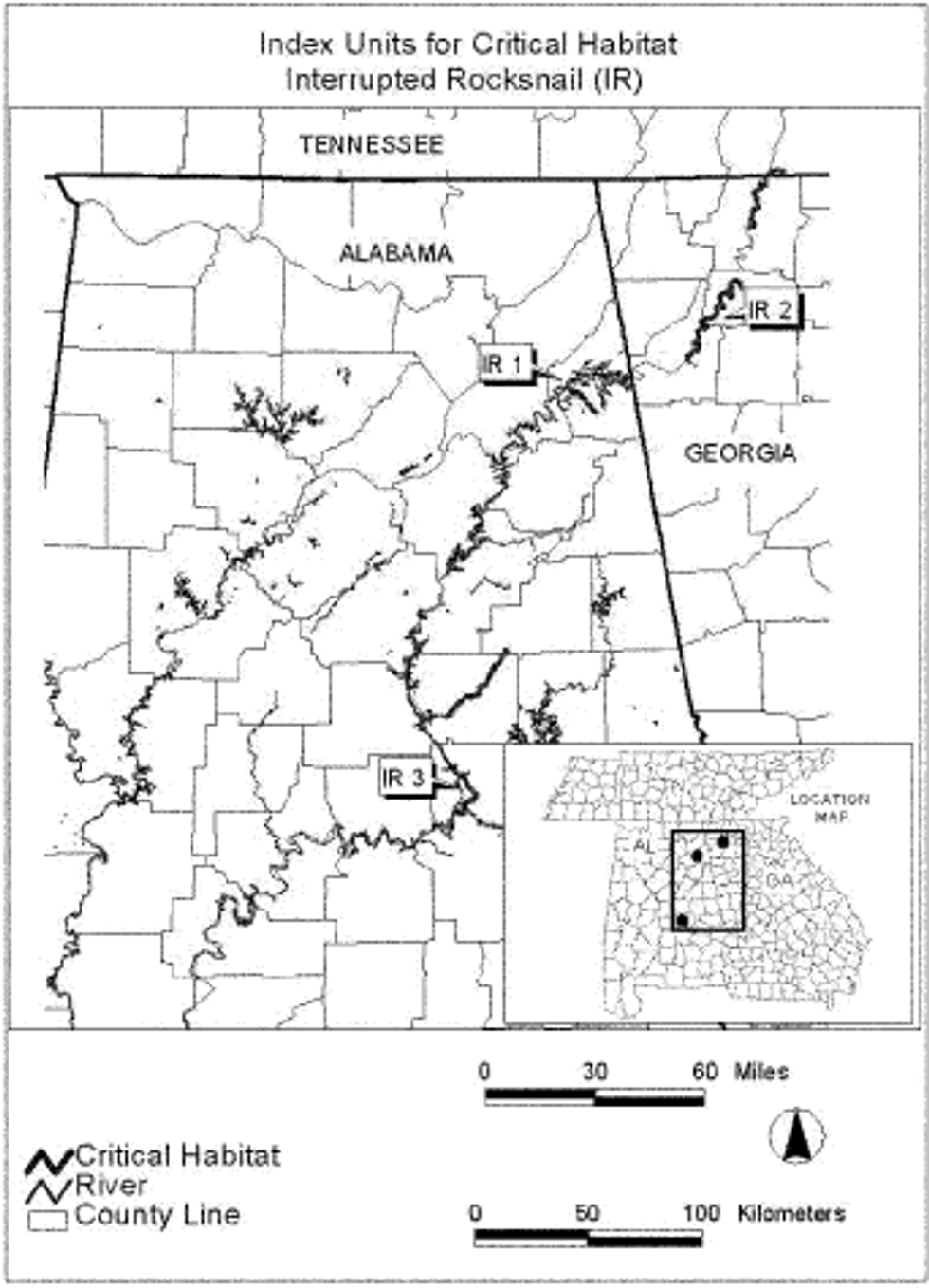
(6) Unit 1 for interrupted rocksnail (IR 1): Coosa River, Cherokee County, Alabama.
(i) Unit IR 1 includes the Coosa River channel from Weiss Dam (614866.53E, 3781969.15N), downstream to a point 1.6 km (1 mi) below the confluence of Terrapin Creek (619751.694E, 3776654.79N), Cherokee County, Alabama.
(ii) Map of Unit 1 (IR 1) for interrupted rocksnail (Coosa River) follows:

(7) Unit 2 for interrupted rocksnail (IR 2): Oostanaula River, Gordon and Floyd Counties, Georgia.
(i) Unit IR 2 includes the primary channel of the Oostanaula River from the confluence of the Conasauga and Coosawattee Rivers (692275.90E, 3824562.96N), Gordon County, downstream to Georgia Highway 1 Loop (668358.62E, 3792574.63N), Floyd County, Georgia.
(ii) Map of Unit 2 (IR 2) for interrupted rocksnail (Oostanaula River) follows:
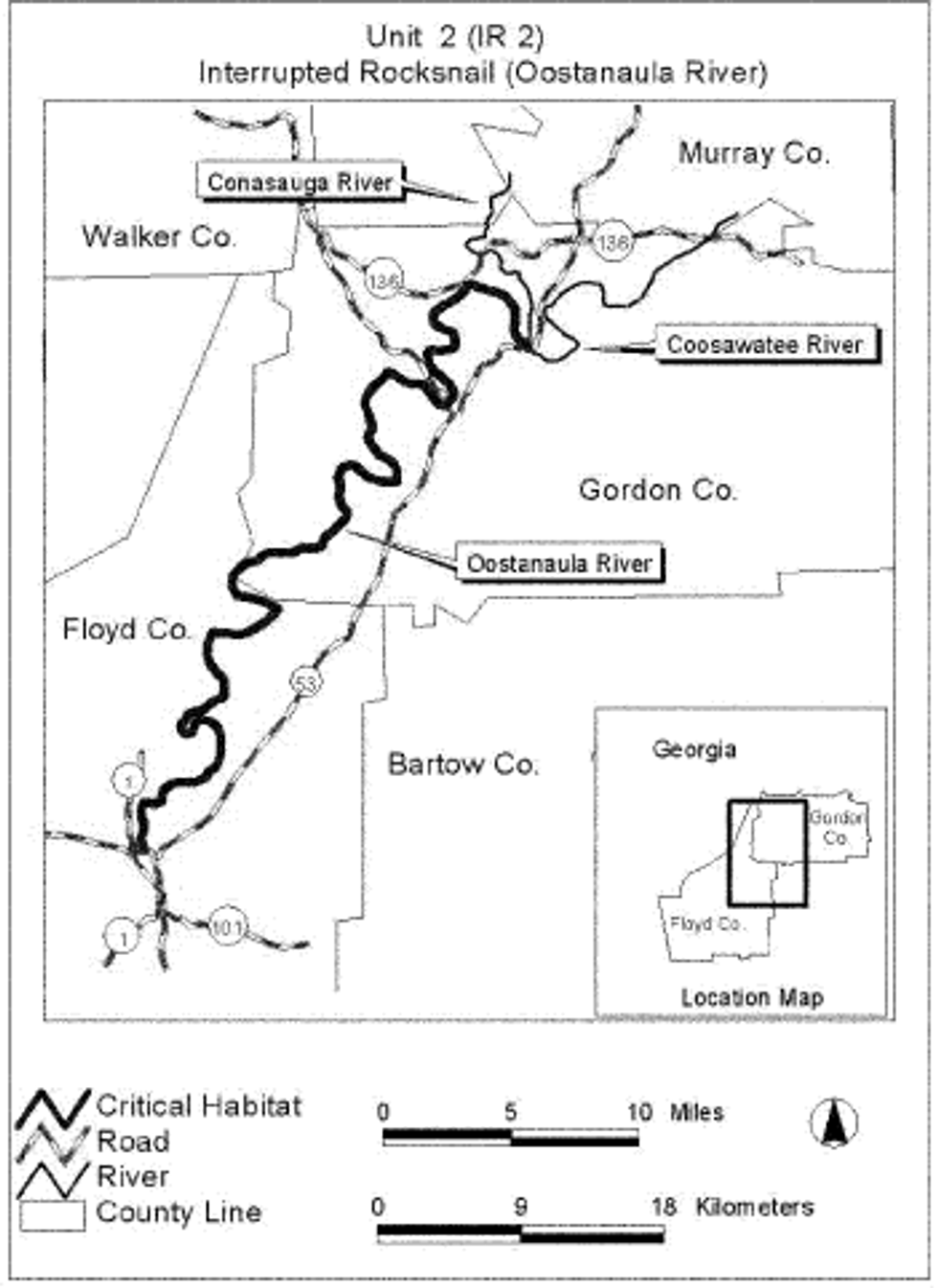
(8) Unit 3 for interrupted rocksnail (IR 3): Lower Coosa River, Elmore County, Alabama.
(i) Unit IR 3 includes the Coosa River channel from Jordan Dam (569930.28E, 3609212.67N), downstream to Alabama Highway 111 Bridge (574324.83E, 3600042.81N), Elmore County, Alabama.
(ii) Map of Unit 3 (IR 3) for interrupted rocksnail (Lower Coosa River) follows:
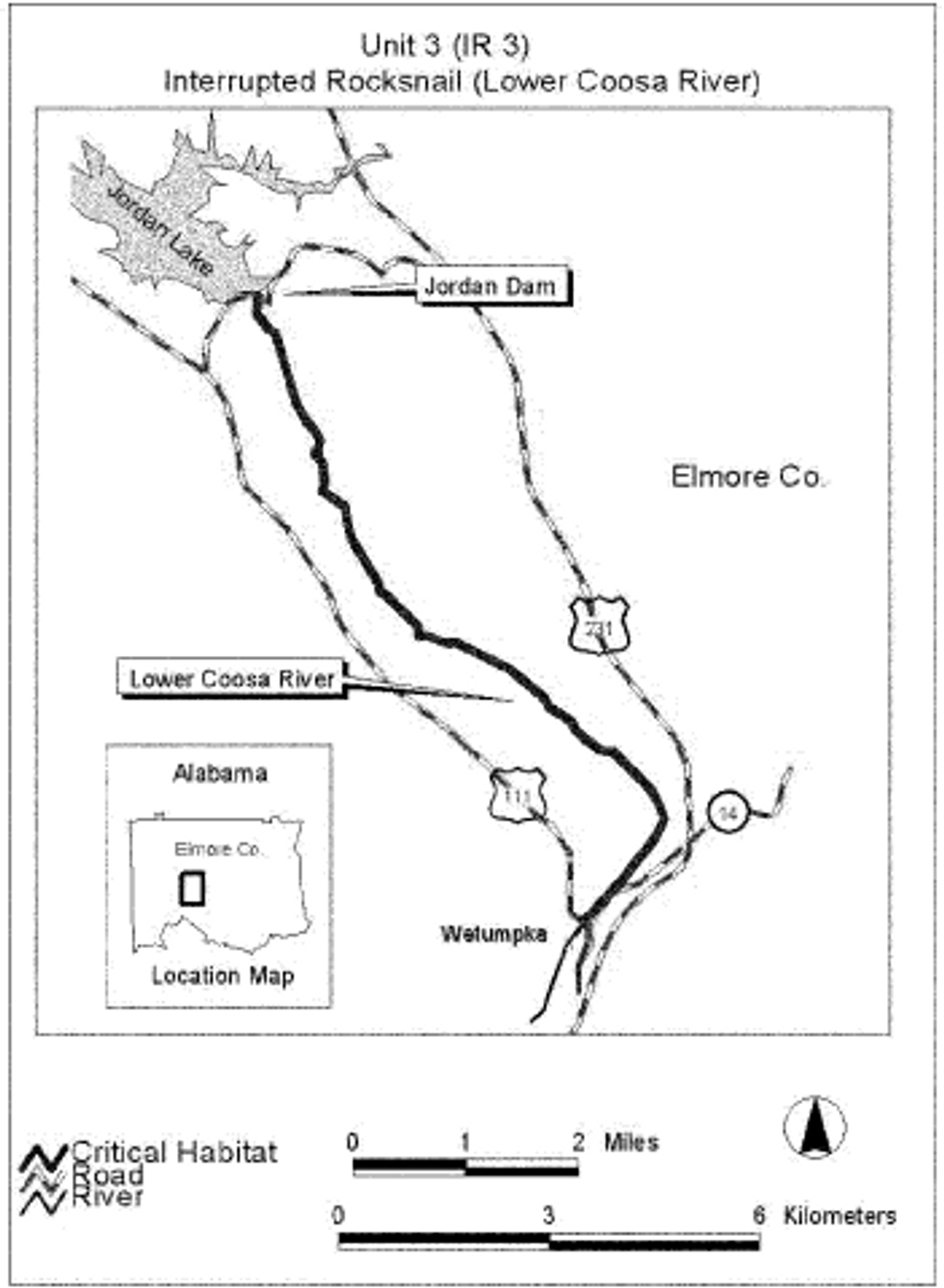
Chupadera Springsnail (Pyrgulopsis chupaderae)
(1) Critical habitat units are depicted for Socorro County, New Mexico, on the map below.
(2) Within these areas, the primary constituent elements of the physical and biological features essential to the conservation of the Chupadera springsnail consist of springheads, springbrooks, seeps, ponds, and seasonally wetted meadows containing:
(i) Unpolluted spring water (free from contamination) emerging from the ground and flowing on the surface;
(ii) Periphyton (an assemblage of algae, bacteria, and microbes) and decaying organic material for food;
(iii) Substrates that include cobble, gravel, pebble, sand, silt, and aquatic vegetation, for egg laying, maturing, feeding, and escape from predators; and
(iv) Nonnative species either absent or present at low population levels.
(3) Critical habitat does not include manmade structures (such as buildings, roads, and other paved areas, and the land on which they are located) existing on the effective date of this rule.
(4) Critical habitat map units were plotted on 2007 USGS Digital Ortho Quarter UTM coordinates in ArcMap (Environmental Systems Research Institute, Inc.), a computer GIS program
(5) Unit 1: Willow Spring, Socorro County, New Mexico.
(i) The critical habitat area includes the springhead, springbrook, small seeps and ponds, seasonally wetted meadow, and all of the associated spring features. This area is approximately 0.5 ha (1.4 ac) around the following coordinates: Easting 316889, northing 3743013 (Universal Transverse Mercator Zone 13 using North American Datum of 1983).
(ii) Map of Units 1 and 2 follows:
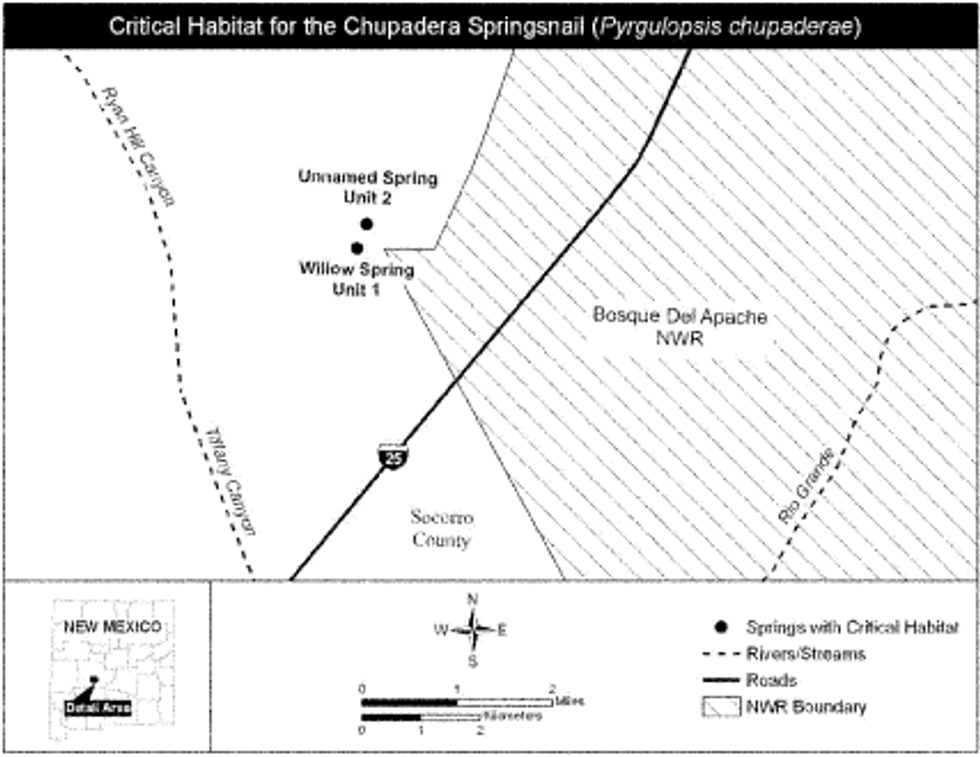
(6) Unit 2: Unnamed Spring, Socorro County, New Mexico.
(i) The critical habitat area includes the springhead, springbrook, small seeps and ponds, seasonally wetted meadow, and all of the associated spring features. This area is approximately 0.2 ha (0.5 ac) around the following coordinates: Easting 317048, northing 3743418 (Universal Transverse Mercator Zone 13 using North American Datum of 1983).
(ii) Map of Unit 2 is provided at paragraph (5)(ii) of this entry.
Koster's Springsnail (Juturnia Kosteri) and Roswell Springsnail (Pyrgulopsis Roswellensis)
(1) Critical habitat units are depicted for Chaves County, New Mexico, on the map below.
(2) The primary constituent element of critical habitat for the Koster's springsnail and Roswell springsnail is springs and spring-fed wetland systems that:
(i) Have permanent, flowing water with no or no more than low levels of pollutants;
(ii) Have slow to moderate water velocities;
(iii) Have substrates ranging from deep organic silts to limestone cobble and gypsum;
(iv) Have stable water levels with natural diurnal (daily) and seasonal variations;
(v) Consist of fresh to moderately saline water;
(vi) Vary in temperature between 50-68°F (10-20°C) with natural seasonal and diurnal variations slightly above and below that range; and
(vii) Provide abundant food, consisting of:
(A) Algae, bacteria, and decaying organic material; and
(B) Submergent vegetation that contributes the necessary nutrients, detritus, and bacteria on which these species forage.
(3) Critical habitat does not include manmade structures (such as buildings, aqueducts, runways, roads, and other paved areas) and the land on which they are located existing within the legal boundaries on the effective date of this rule.
(4) Critical habitat map units. Data layers defining map units were created on a base of USGS 1:24,000 maps, and critical habitat units were then mapped using Universal Transverse Mercator (UTM) coordinates.
(5) Unit 1: Sago/Bitter Creek Complex, Chaves County, New Mexico.
(i) [Reserved]
(ii) Map of Koster's Springsnail and Roswell Springsnail Critical Habitat Units 1 and 2a follows:
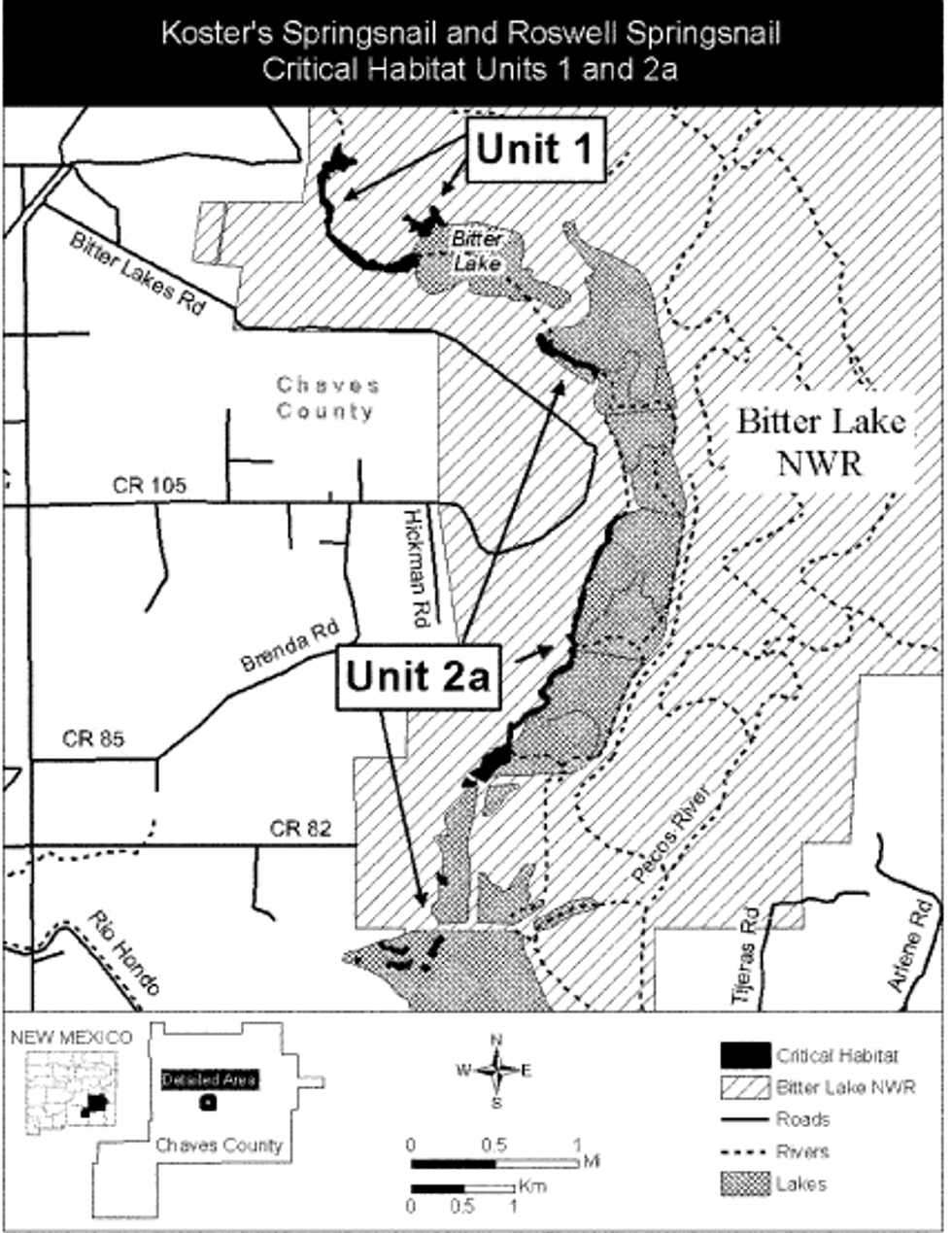
(6) Unit 2a: Springsnail/Amphipod Impoundment Complex, Chaves County, New Mexico.
(i) [Reserved]
(ii) Map of Unit 2a for Koster's springsnail and Roswell springsnail is provided at paragraph (5)(ii) of this entry.
San Bernardino Springsnail (Pyrgulopsis bernardina)
(1) Critical habitat units are depicted for Cochise County, Arizona, on the map in paragraph (5) of this entry.
(2) Within these areas, the primary constituent elements of the physical or biological features essential to the conservation of the San Bernardino springsnail consist of four components:
(i) Adequately clean spring water (free from contamination) emerging from the ground and flowing on the surface;
(ii) Periphyton (attached algae), bacteria, and decaying organic material for food;
(iii) Substrates that include cobble, gravel, pebble, sand, silt, and aquatic vegetation, for egg laying, maturing, feeding, and escape from predators; and
(iv) Either an absence of nonnative predators (crayfish) and competitors (snails) or their presence at low population levels.
(3) Critical habitat does not include manmade structures other than the road culvert and concrete spring-boxes, which are included to protect the water flowing within them.
(4) Critical habitat map units. Data layers defining map units were plotted on 2007 USGS Digital Ortho Quarter Quad maps using Universal Transverse Mercator (UTM) coordinates in ArcMap. Because of the small size of the springs, spring runs and ditches, for mapping purposes we created a circle that encompasses them.
(5) Map of critical habitat units for the San Bernardino springsnail follows:
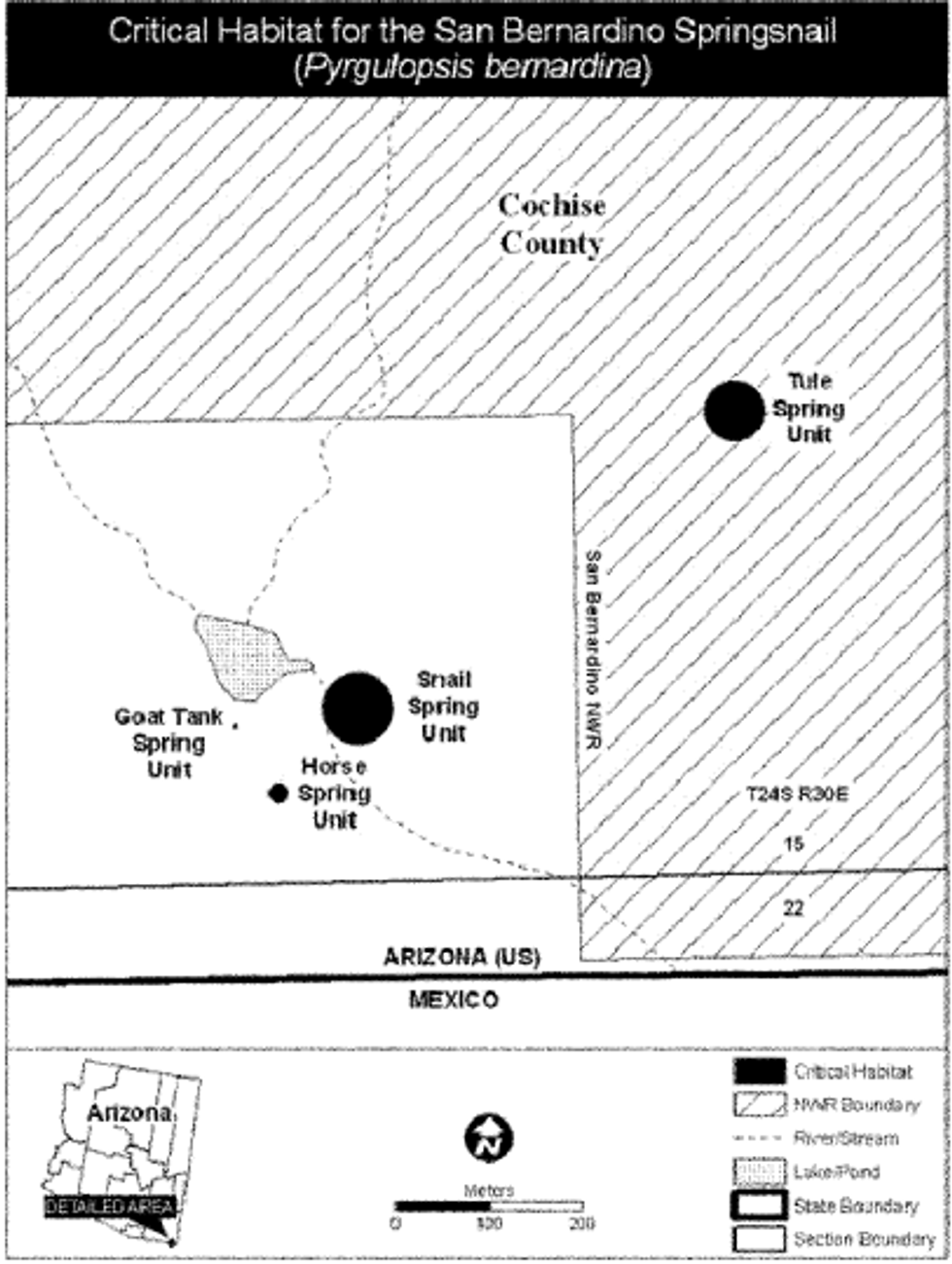
(6) Snail Spring Unit contains approximately 0.457 ha (1.129 ac) in Cochise County, Arizona. This critical habitat unit is a spring approximately 5 m (16 ft) in diameter and has a spring run that goes south from the spring approximately 23.5 m (77 ft) to a manmade ditch, which runs 10.2 m (33.5 ft) to a dirt road. It passes under the road in a 3.5 m (11.5 ft) culvert, then flows approximately 17 m (56 ft) below the road. The culvert beneath the road is included in critical habitat, but not the road itself. We include a 1-m (3.3-ft) upland area on each side of the spring, spring run, and ditch. The critical habitat unit is the spring, spring run, ditch, and buffer within the 76-m (249-ft) diameter circle centered on UTM coordinate 663858, 3468182 in Zone 12 with the units in meters using North American Datum of 1983 (NAD 83).
(7) Goat Tank Spring Unit contains approximately 0.002 ha (0.005 ac) in Cochise County, Arizona. The unit is a spring contained entirely within a square concrete box approximately 0.61 by 0.91 m (2 by 3 ft) and spring seepage emanating from the base of a cottonwood tree about 2 m (7 ft) from the spring-box. This unit includes a 1-m (3.3-ft) upland area on each side of the spring box and spring. The critical habitat is the spring-box, spring seepage, and buffer within the 5-m (16.4-ft) diameter circle centered on UTM coordinate 663725, 3468162 in Zone 12 with the units in meters using North American Datum of 1983 (NAD 83).
(8) Horse Spring Unit contains approximately 0.032 ha (0.078 ac) in Cochise County, Arizona. The unit is a spring and springrun approximately 0.5 m (1.6 ft) wide and 15.5 m (50.9 ft) in length. We include a 1-m (3.3-ft) upland area on each side of the springhead and spring-run. The designated critical habitat unit is the spring-box, spring seepage, and buffer within the 20-m (66-ft) diameter circle centered on UTM coordinate 663772, 3468091 in Zone 12 with the units in meters using North American Datum of 1983 (NAD 83).
(9) Tule Spring Unit contains approximately 0.324 ha (0.801 ac) in Cochise County, Arizona. The unit is a spring, which forms a pond approximately 23 m (75 ft) north-south and 13 m (43 ft) east-west, and it has a spring run that is approximately 22 m (71 ft) in length. The spring run emerges from the southeastern side of the spring pond, runs northeast for approximately 12.5 m (41 ft) to a manmade ditch, which runs southeast 9.2 m (30 ft). This unit includes a 1-m (3.3-ft) upland area on each side of the spring, spring run, and ditch. The designated critical habitat unit is the spring, spring-run, ditch, and buffer within the 64-m (210-ft) diameter circle centered on UTM coordinate 664259, 3468499 in Zone 12 with the units in meters using North American Datum of 1983 (NAD 83).
Three Forks Springsnail (Pyrgulopsis trivialis)
(1) Critical habitat units are depicted for Apache County, Arizona, on the map at paragraph (5) of this entry.
(2) Within these areas, the primary constituent elements of the physical or biological features essential to the conservation of the Three Forks springsnail consist of four components:
(i) Adequately clean spring water (free from contamination) emerging from the ground and flowing on the surface;
(ii) Periphyton (attached algae), bacteria, and decaying organic material for food;
(iii) Substrates that include cobble, gravel, pebble, sand, silt, and aquatic vegetation, for egglaying, maturing, feeding, and escape from predators; and
(iv) Either an absence of nonnative predators (crayfish) and competitors (snails) or their presence at low population levels.
(3) Critical habitat does not include manmade structures other than concrete spring-boxes, which are included to protect the flowing water within them.
(4) Critical habitat map units were plotted on 2007 USGS Digital Ortho Quarter Quad maps using Universal Transverse Mercator (UTM) coordinates in ArcMap.
(5) Map of critical habitat units for the Three Forks springsnail follows:
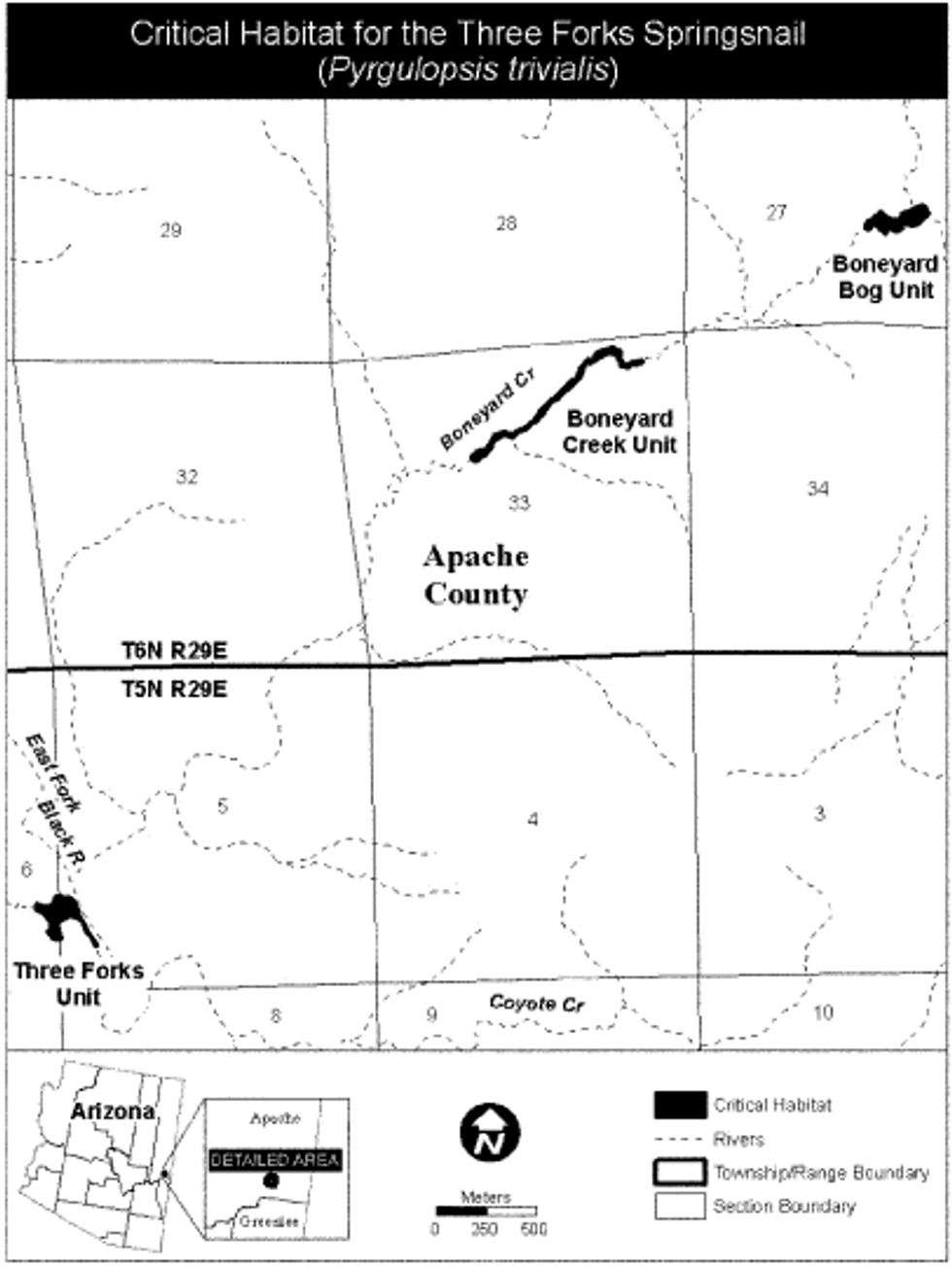
Phantom springsnail (Pyrgulopsis texana) and Phantom tryonia (Tryonia cheatumi)
(1) Critical habitat units are depicted for Jeff Davis County and Reeves County, Texas, on the maps below.
(2) Within these areas, the primary constituent elements of the physical or biological features essential to the conservation of Phantom springsnail and Phantom tryonia are springs and spring-fed aquatic systems that contain:
(i) Permanent, flowing, unpolluted water (free from contamination) emerging from the ground and flowing on the surface;
(ii) Water temperatures that vary between 11 and 27°C (52 to 81°F) with natural seasonal and diurnal variations slightly above and below that range;
(iii) Substrates that include cobble, gravel, pebble, sand, silt, and aquatic vegetation, for breeding, egg laying, maturing, feeding, and escape from predators;
(iv) Abundant food, consisting of algae, bacteria, decaying organic material, and submergent vegetation that contributes the necessary nutrients, detritus, and bacteria on which these species forage; and
(v) Either an absence of nonnative predators and competitors or nonnative predators and competitors at low population levels.
(3) Critical habitat does not include manmade structures (such as buildings, aqueducts, well pads, roads, and other paved areas) and the land on which they are located existing within the legal boundaries on August 8, 2013.
(4) Critical habitat map units. Data layers defining map units were created on 2010 aerial photography from U.S. Department of Agriculture, National Agriculture Imagery Program base maps using ArcMap (Environmental Systems Research Institute, Inc.), a computer geographic information system (GIS) program. The maps in this entry, as modified by any accompanying regulatory text, establish the boundaries of the critical habitat designation. The coordinates or plot points or both on which each map is based are available on the internet at http://www.regulations.gov at Docket No. FWS-R2-ES-2013-0004 and at the field office responsible for this designation. You may obtain field office location information by contacting one of the Service regional offices, the addresses of which are listed at 50 CFR 2.2.
(5) San Solomon Spring Unit, Reeves County, Texas. Map of San Solomon Spring Unit follows:
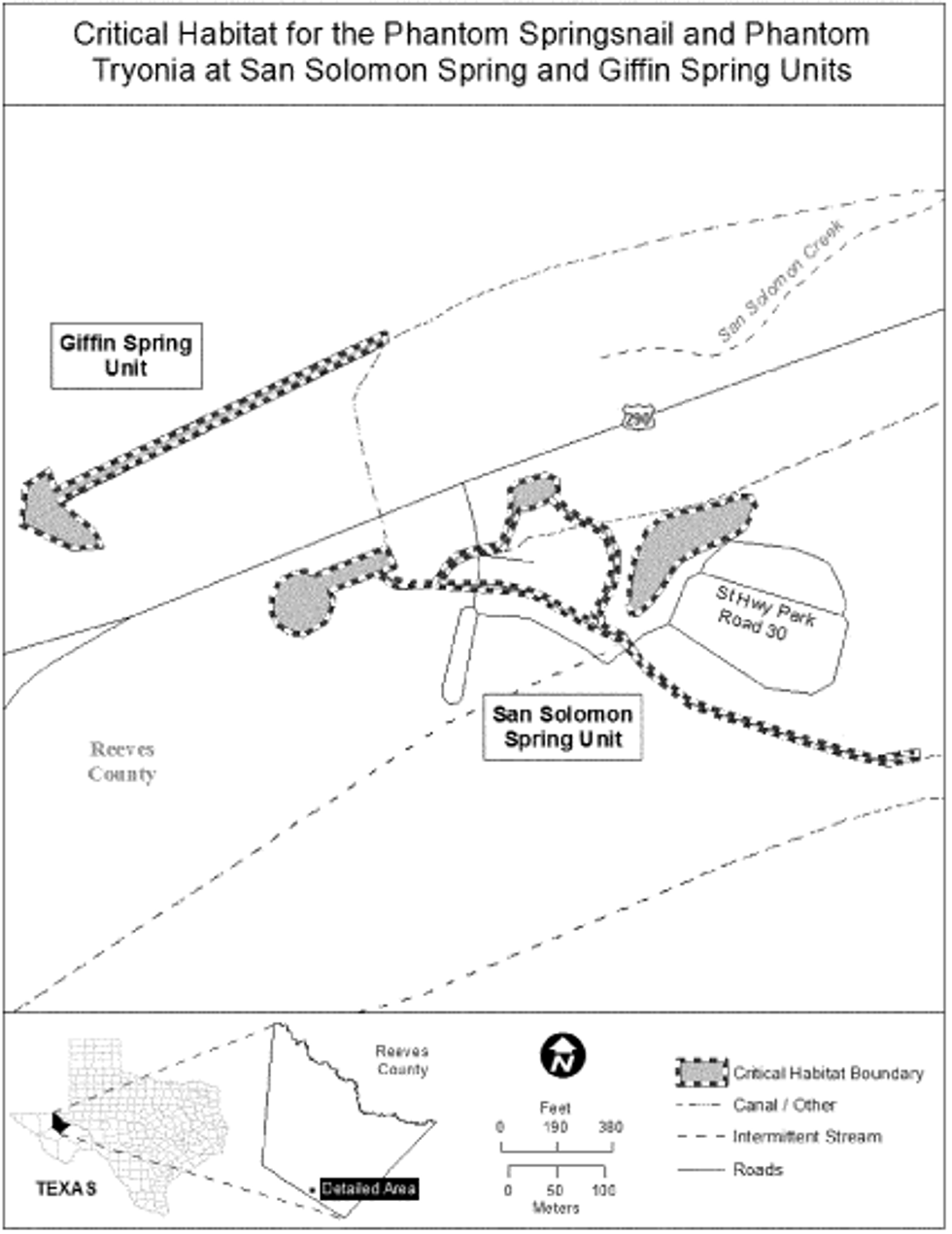
(6) Giffin Spring Unit, Reeves County, Texas. Map of Giffin Spring Unit is provided at paragraph (5) of this entry.
(7) East Sandia Spring Unit, Reeves County, Texas. Map of East Sandia Spring Unit follows:
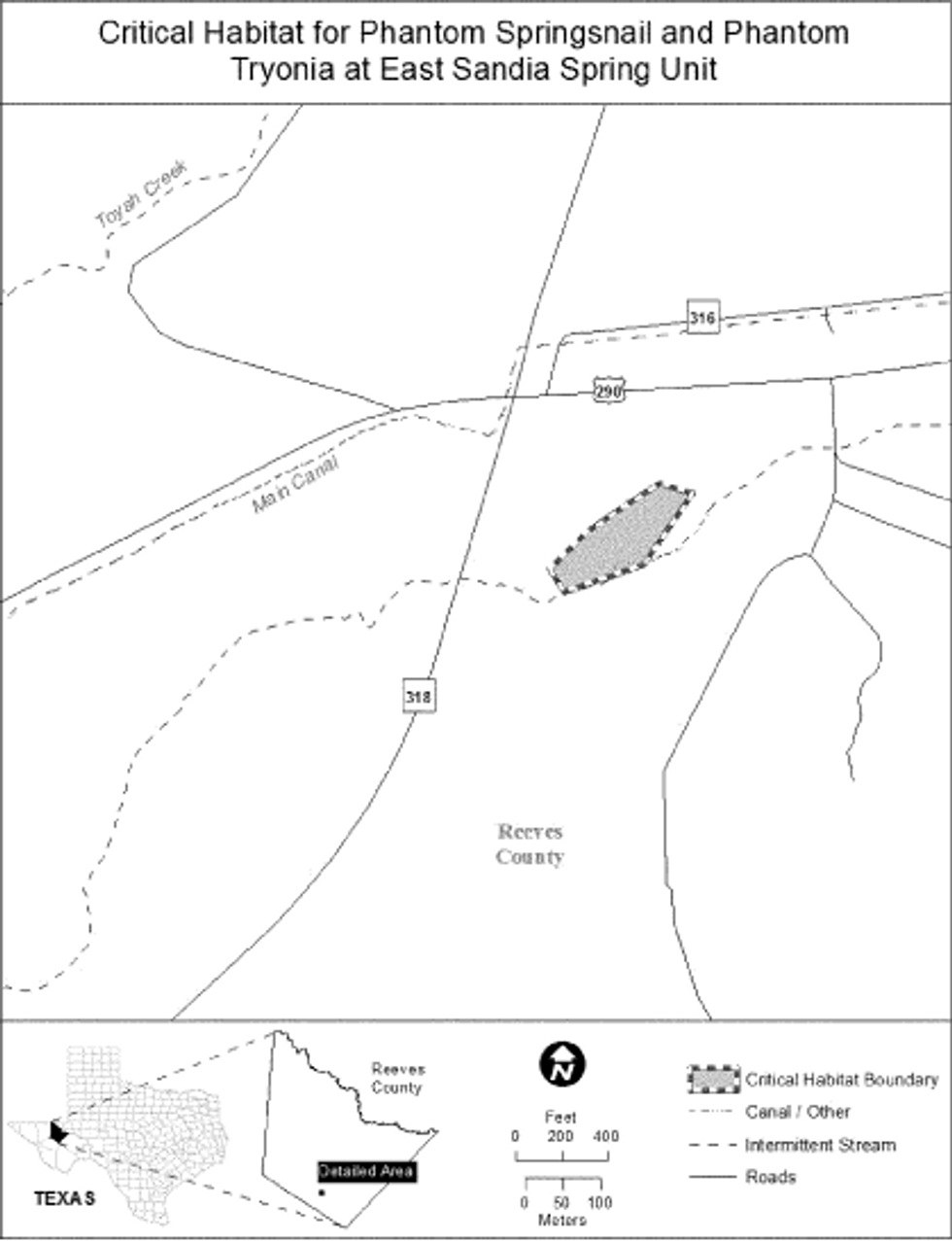
(8) Phantom Lake Spring Unit, Jeff Davis County, Texas. Map of Phantom Lake Spring Unit follows:
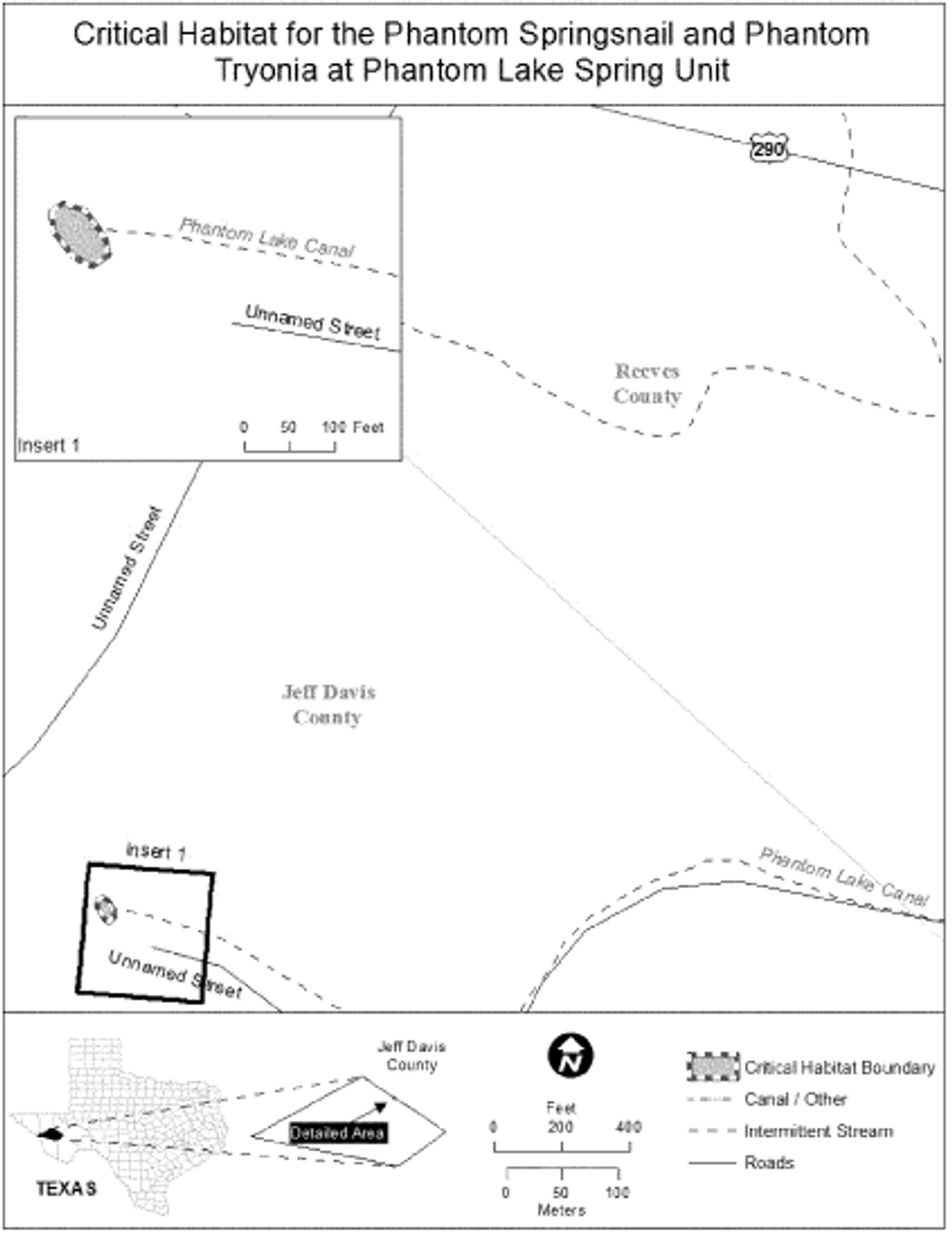
Diamond tryonia (Pseudotryonia adamantina) and Gonzales tryonia (Tryonia circumstriata)
(1) A critical habitat unit is depicted for Pecos County, Texas, on the map below.
(2) Within this area, the primary constituent elements of the physical or biological features essential to the conservation of Diamond tryonia and Gonzales tryonia are springs and spring-fed aquatic systems that contain:
(i) Permanent, flowing, unpolluted water (free from contamination) emerging from the ground and flowing on the surface;
(ii) Water temperatures that vary between 11 and 27°C (52 to 81°F) with natural seasonal and diurnal variations slightly above and below that range;
(iii) Substrates that include cobble, gravel, pebble, sand, silt, and aquatic vegetation, for breeding, egg laying, maturing, feeding, and escape from predators;
(iv) Abundant food, consisting of algae, bacteria, decaying organic material, and submergent vegetation that contributes the necessary nutrients, detritus, and bacteria on which these species forage; and
(v) Either an absence of nonnative predators and competitors or nonnative predators and competitors at low population levels.
(3) Critical habitat does not include manmade structures (such as buildings, roads, oil and gas well pads, and other paved areas) and the land on which they are located existing within the legal boundaries on August 8, 2013.
(4) Critical habitat map unit. Data layers defining the map unit were created on 2010 aerial photography from U.S. Department of Agriculture, National Agriculture Imagery Program base maps using ArcMap (Environmental Systems Research Institute, Inc.), a computer geographic information system (GIS) program. The maps in this entry, as modified by any accompanying regulatory text, establish the boundaries of the critical habitat designation. The coordinates or plot points or both on which each map is based are available to the public on the internet at http://www.regulations.gov at Docket No. FWS-R2-ES-2013-0004 and at the field office responsible for this designation. You may obtain field office location information by contacting one of the Service regional offices, the addresses of which are listed at 50 CFR 2.2.
(5) Diamond Y Spring Unit, Pecos County, Texas. Map of Diamond Y Spring Unit follows:
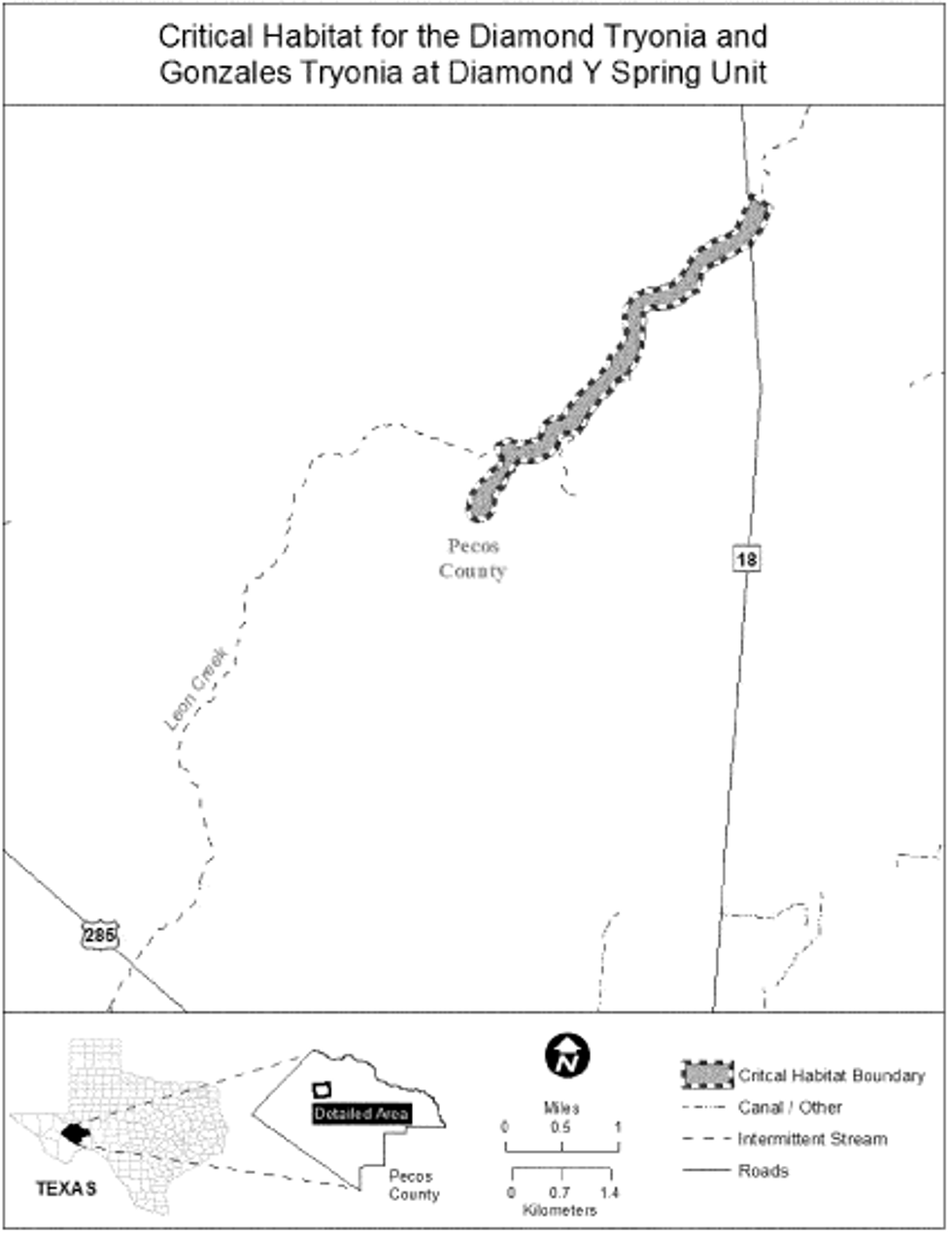
Newcomb's tree snail (Newcombia cumingi)
(1) The critical habitat unit is depicted for Maui County, Hawaii, on the map below.
(2) Primary constituent elements. In unit 1, the primary constituent elements of critical habitat for the Newcomb's tree snail are:
(i) Elevation: Less than 3,300 ft (1,000 m).
(ii) Annual precipitation: Greater than 75 in (190 cm).
(iii) Substrate: Clays; ashbeds; deep, well-drained soils; lowland bogs.
(iv) Canopy: Antidesma, Metrosideros, Myrsine, Pisonia, Psychotria.
(v) Subcanopy: Cibotium, Claoxylon, Kadua, Melicope.
(vi) Understory: Alyxia, Cyrtandra, Dicranopteris, Diplazium, Machaerina, Microlepia.
(3) Existing manmade features and structures, such as buildings, roads, railroads, airports, runways, other paved areas, lawns, and other urban landscaped areas, do not contain one or more of the physical or biological features. Federal actions limited to those areas, therefore, would not trigger a consultation under section 7 of the Act unless they may affect the species or physical or biological features in adjacent critical habitat.
(4) Critical habitat map. Map was created in GIS, with coordinates in UTM Zone 4, units in meters using North American datum of 1983 (NAD 83).
(5) Newcombia cumingi - Unit 1 - Lowland Wet-Maui, Maui County, Hawaii (65 ac, 26 ha). This unit is critical habitat for the Newcomb's tree snail, Newcombia cumingi. Map of Newcombia cumingi - Unit 1 - Lowland Wet-Maui follows:
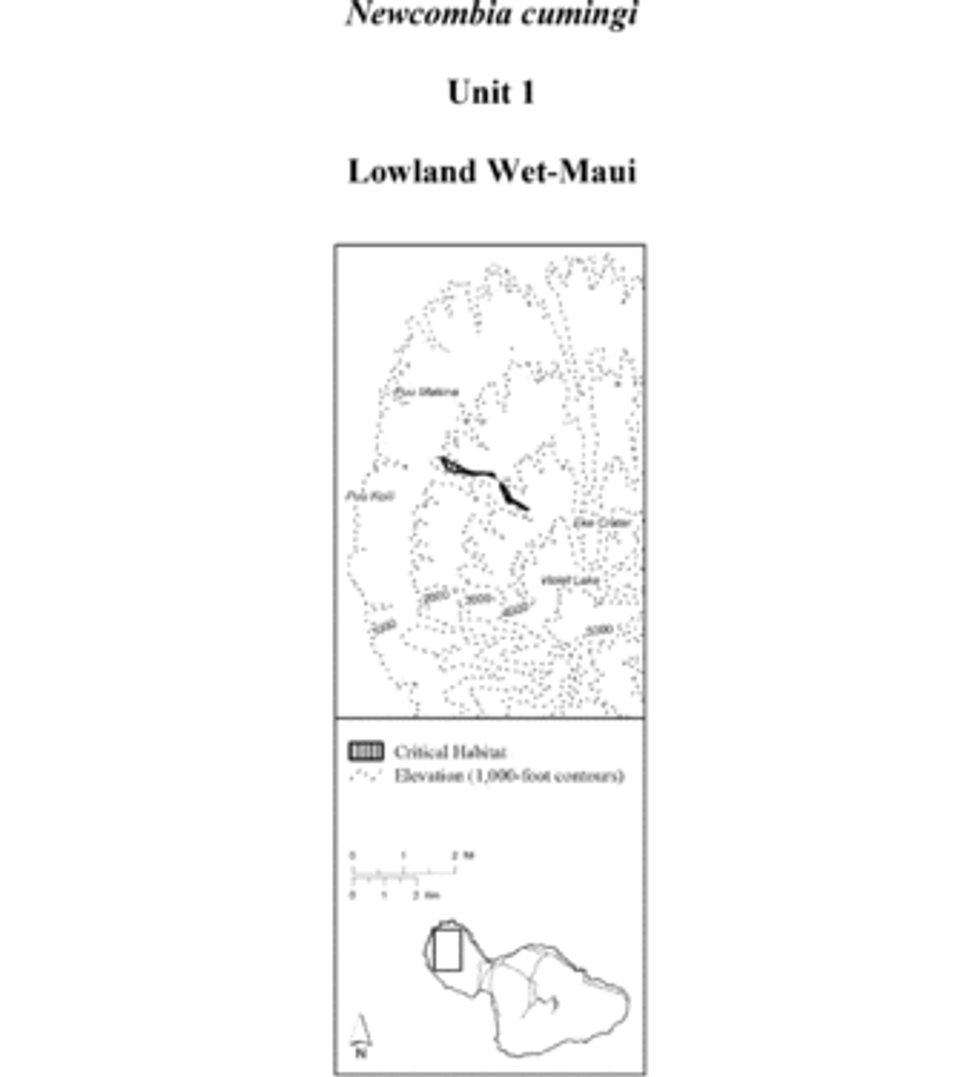
(g) Arachnids.
Cokendolpher Cave Harvestman (Texella cokendolpheri)
(1) Critical habitat for the Cokendolpher Cave harvestman in Bexar County, Texas, occurs in Unit 20 as described in this entry and depicted on Map 1 (index map) and Map 2 in this entry.
(2) The primary constituent elements of critical habitat for the Cokendolpher Cave harvestman are:
(i) Karst-forming rock containing subterranean spaces (caves and connected mesocaverns) with stable temperatures, high humidities (near saturation), and suitable substrates (for example, spaces between and underneath rocks for foraging and sheltering) that are free of contaminants; and
(ii) Surface and subsurface sources (such as plants and their roots, fruits, and leaves, and animal (e.g., cave cricket) eggs, feces, and carcasses) that provide nutrient input into the karst ecosystem.
(3) Developed lands that do not contain the subsurface primary constituent elements (see paragraph (2)(i) of this entry) and that existed on the effective date of this rule are not considered to be critical habitat.
(4) Data layers defining this map unit were created using a geographic information system (GIS), which included cave locations, karst zone maps, roads, property boundaries, 2010 aerial photography, and USGS 7.5′ quadrangles. Points were placed on the GIS.
(5) Index map of Bexar County invertebrates critical habitat units, Bexar County, Texas, follows:
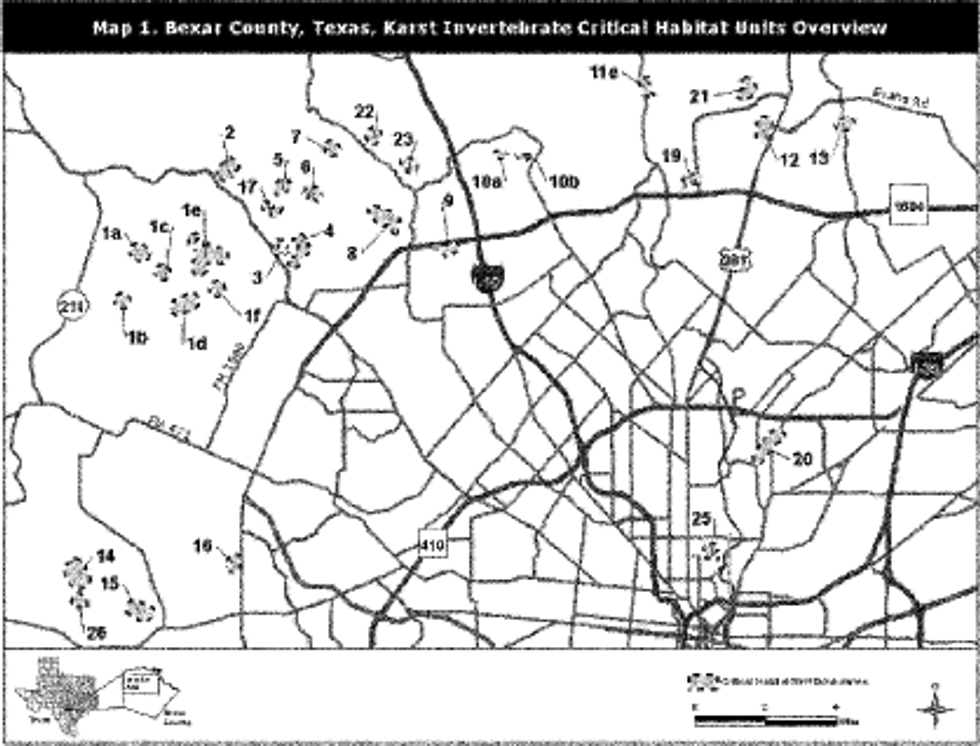
(6) Unit 20: Bexar County, Texas.
(i) [Reserved]
(ii) Map 2 of Unit 20 follows:
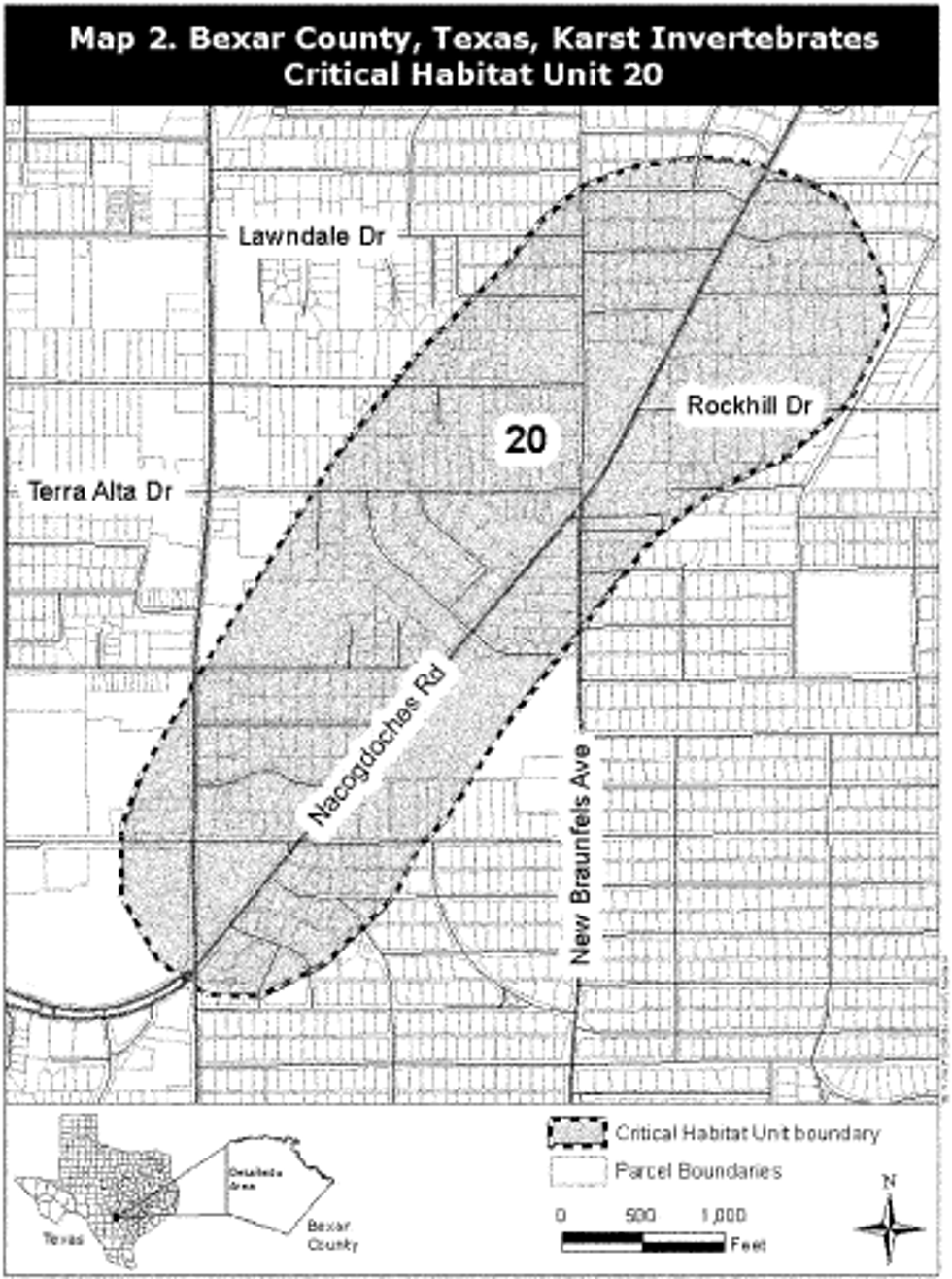
Government Canyon Bat Cave Meshweaver (Cicurina vespera)
(1) Critical habitat for the Government Canyon Bat Cave meshweaver in Bexar County, Texas, occurs in Unit 1b, as described in this entry and depicted on Map 2 in this entry. Unit 1b is also depicted on Map 1 (index map) provided at paragraph (5) of the entry for the Cokendolpher Cave harvestman in this paragraph (g).
(2) The primary constituent elements of, and the statements regarding developed lands in, critical habitat for the Government Canyon Bat Cave meshweaver are identical to those set forth at paragraphs (2) and (3) of the entry for the Cokendolpher Cave harvestman in this paragraph (g).
(3) Data layers defining this map unit were created using a geographic information system (GIS), which included cave locations, karst zone maps, roads, property boundaries, 2010 aerial photography, and USGS 7.5′ quadrangles. Points were placed on the GIS.
(4) Unit 1b: Bexar County, Texas.
(i) [Reserved]
(ii) Map 2 of Units 1a, 1b, 1c, 1d, 1e, and 1f follows:
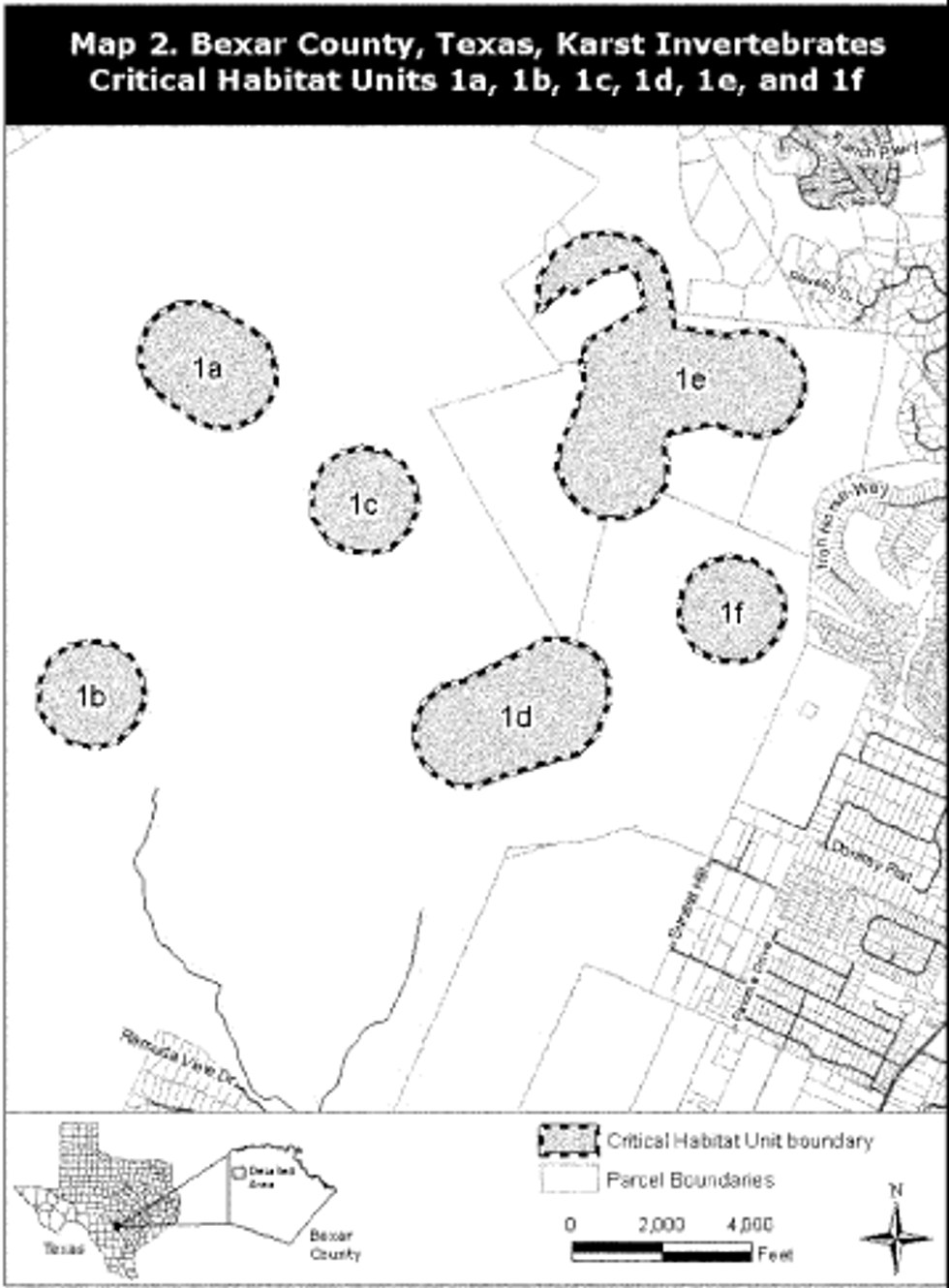
Madla Cave Meshweaver (Cicurina madla)
(1) Critical habitat for the Madla Cave meshweaver in Bexar County, Texas, occurs in Units 1a, 1c, 1d, 1e, 2, 3, 5, 6, 8, 9, 17, and 22, as described in this entry and depicted on Maps 3, 4, 5, 6, 7, and 8 in this entry. Units 1a, 1c, 1d, and 1e are depicted on Map 2, which is provided at paragraph (4)(ii) of the entry for the Government Canyon Bat Cave meshweaver in this paragraph (g). Units 1a, 1c, 1d, 1e, 2, 3, 5, 6, 8, 9, 17, and 22 are also depicted on Map 1 (index map) provided at paragraph (5) of the entry for the Cokendolpher Cave harvestman in this paragraph (g).
(2) Eight caves and their associated karst management areas established under the La Cantera Habitat Conservation Plan section 10(a)(1)(B) permit are adjacent to or within the boundaries of Units 1e, 3, 6, 8, and 17, but are not designated as critical habitat. These caves are Canyon Ranch Pit, Fat Man's Nightmare Cave, Scenic Overlook Cave and the surrounding approximately 75 ac (30 ha) adjacent to Unit 1e; Helotes Blowhole and Helotes Hilltop Caves and the surrounding approximately 25 ac (10 ha) adjacent to Unit 3; John Wagner Cave No. 3 and the surrounding approximately 4 ac (1.6 ha) adjacent to Unit 6; Hills and Dales Pit and the surrounding approximately 70 ac (28 ha) adjacent to Unit 8; and Madla's Cave and the surrounding approximately 5 ac (2 ha) within Unit 17.
(3) The primary constituent elements of, and the statements regarding developed lands in, critical habitat for the Madla Cave meshweaver are identical to those set forth at paragraphs (2) and (3) of the entry for the Cokendolpher Cave harvestman in this paragraph (g).
(4) Data layers defining this map unit were created using a geographic information system (GIS), which included cave locations, karst zone maps, roads, property boundaries, 2010 aerial photography, and USGS 7.5′ quadrangles. Points were placed on the GIS.
(5) Unit 1a: Bexar County, Texas.
(i) [Reserved]
(ii) Unit 1a is depicted on Map 2, provided at paragraph (4)(ii) of the entry for the Government Canyon Bat Cave meshweaver in this paragraph (g).
(6) Unit 1c: Bexar County, Texas.
(i) [Reserved]
(ii) Unit 1c is depicted on Map 2, provided at paragraph (4)(ii) of the entry for the Government Canyon Bat Cave meshweaver in this paragraph (g).
(7) Unit 1d: Bexar County, Texas.
(i) [Reserved]
(ii) Unit 1d is depicted on Map 2, provided at paragraph (4)(ii) of the entry for the Government Canyon Bat Cave meshweaver in this paragraph (g).
(8) Unit 1e: Bexar County, Texas.
(i) [Reserved]
(ii) Unit 1e is depicted on Map 2, provided at paragraph (4)(ii) of the entry for the Government Canyon Bat Cave meshweaver in this paragraph (g).
(9) Unit 2: Bexar County, Texas.
(i) [Reserved]
(ii) Map 3 of Unit 2 follows:
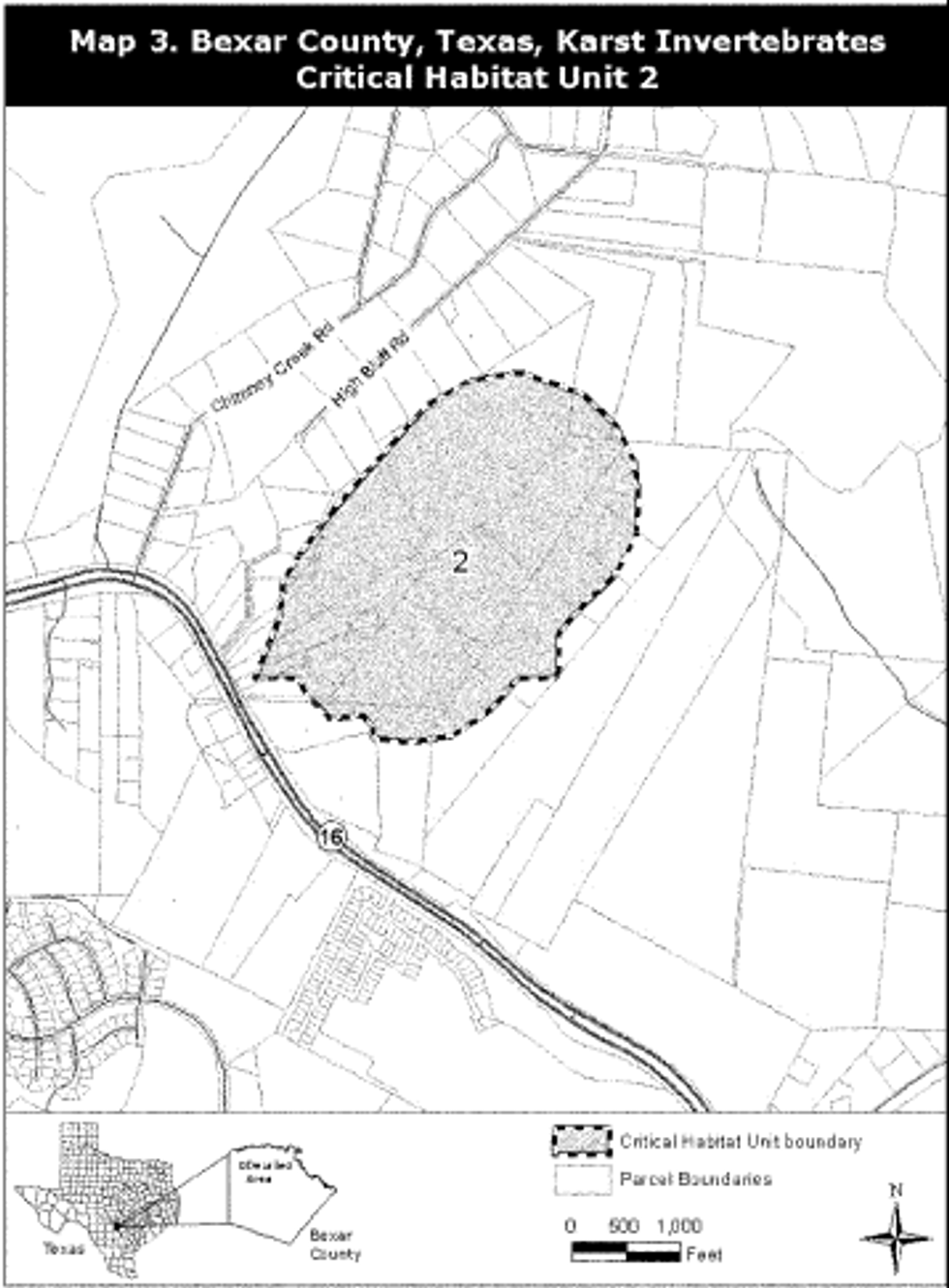
(10) Unit 3: Bexar County, Texas.
(i) [Reserved]
(ii) Map 4 of Units 3 and 4 follows:
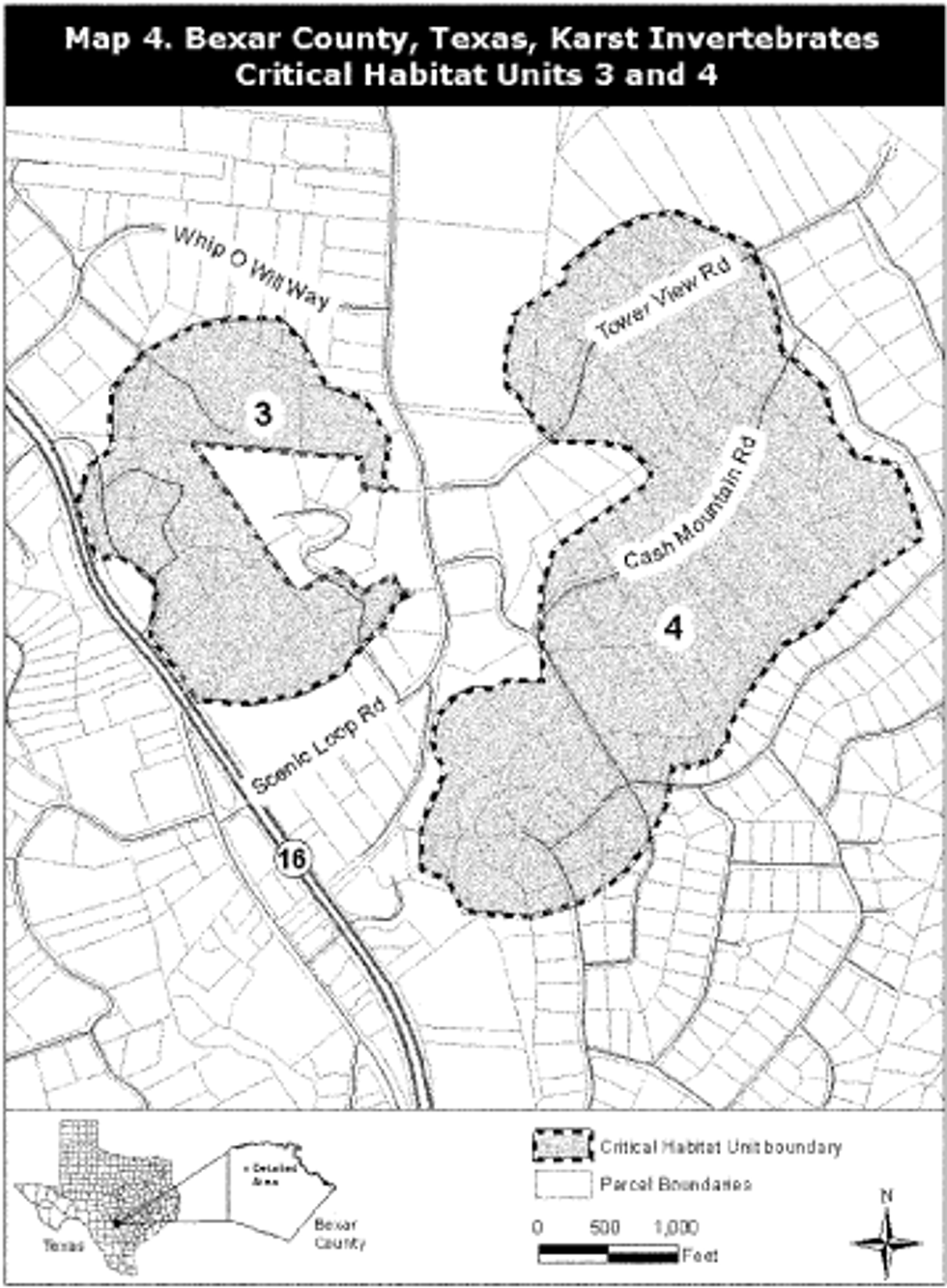
(11) Unit 5: Bexar County, Texas.
(i) [Reserved]
(ii) Map 5 of Units 5, 6, and 17 follows:
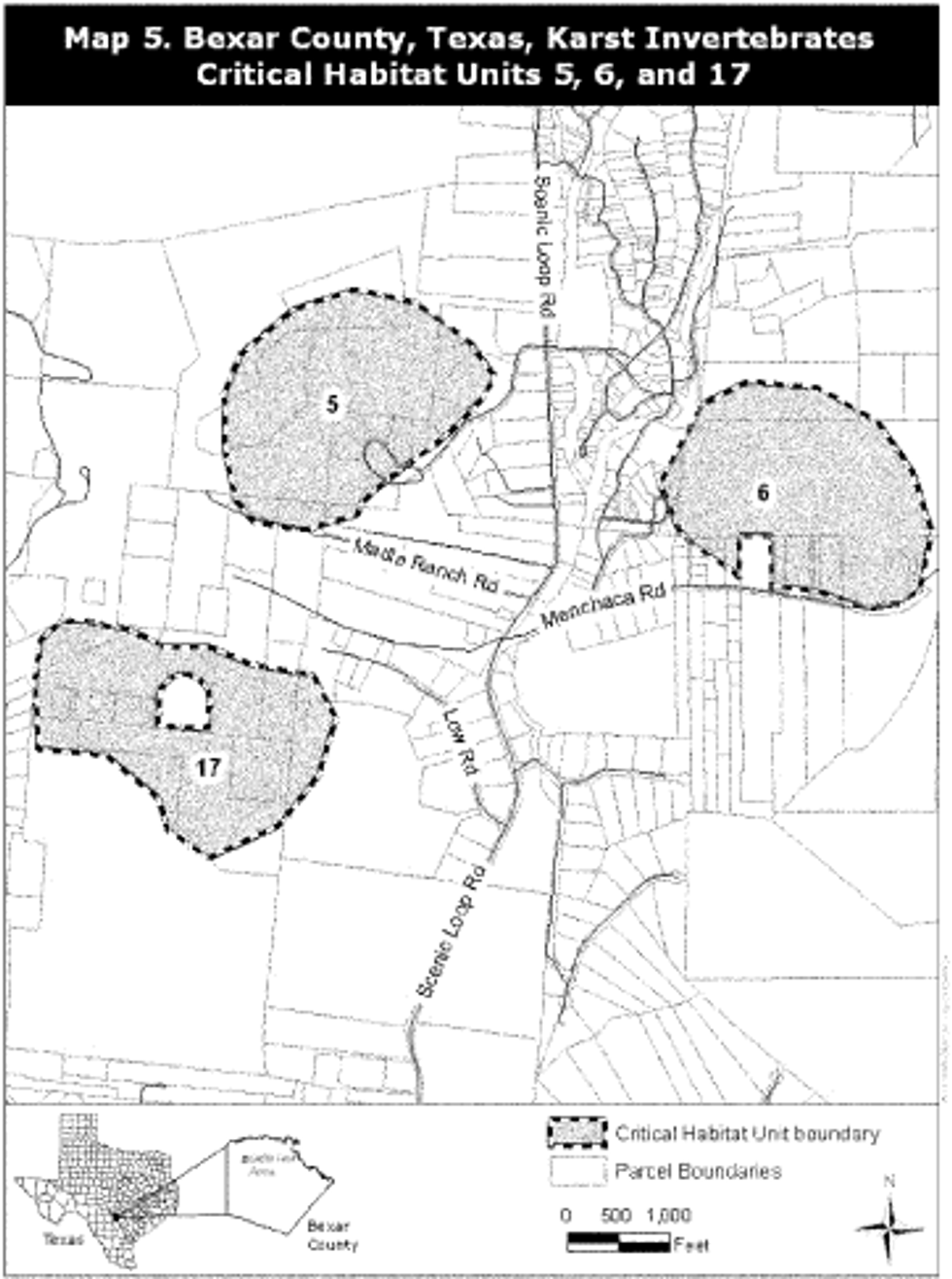
(12) Unit 6: Bexar County, Texas.
(i) [Reserved]
(ii) Unit 6 is depicted on Map 5, provided at paragraph (10)(ii) of this entry.
(13) Unit 8: Bexar County, Texas.
(i) [Reserved]
(ii) Map 6 of Unit 8 follows:
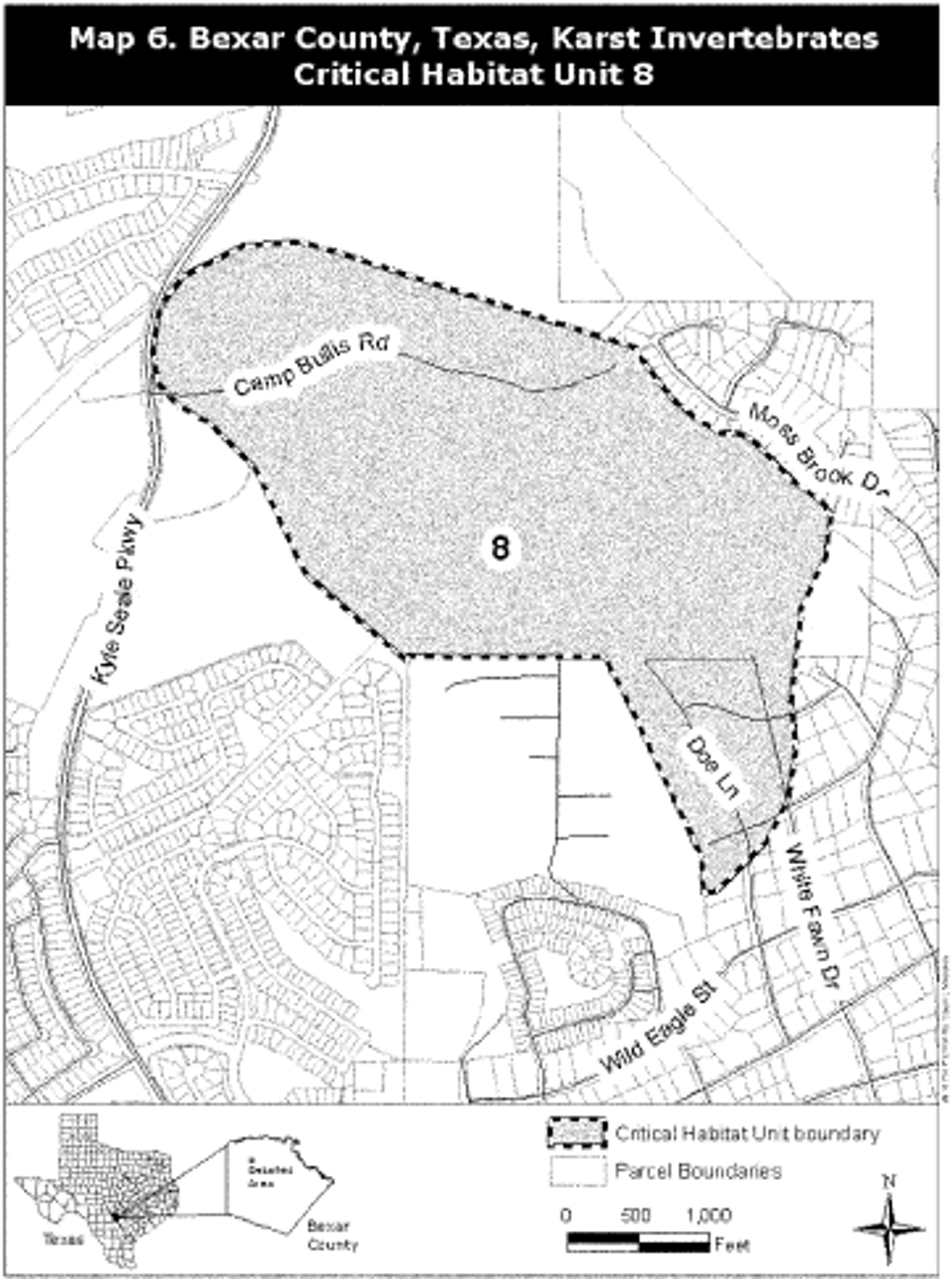
(14) Unit 9: Bexar County, Texas.
(i) [Reserved]
(ii) Map 7 of Unit 9 follows:
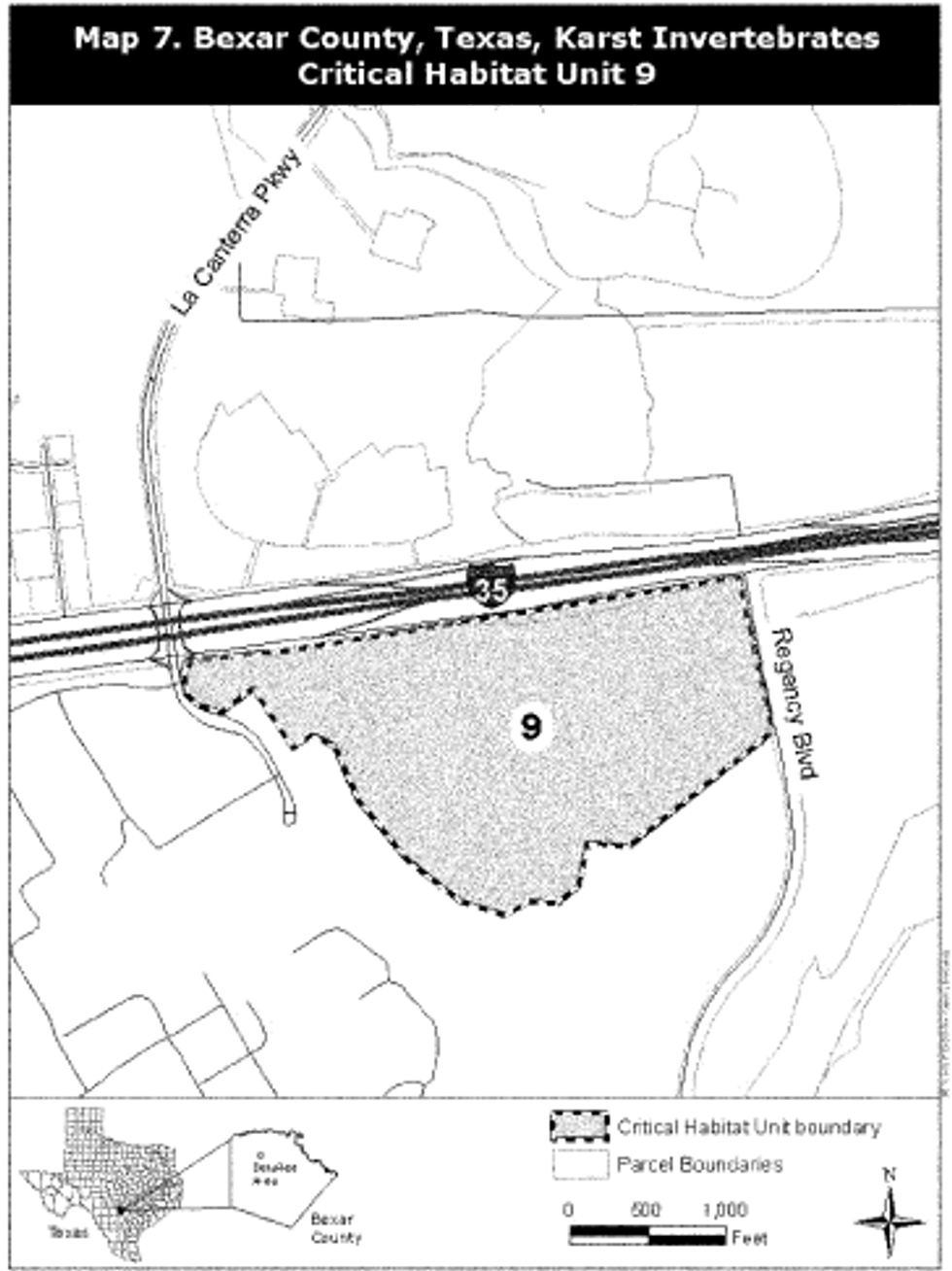
(15) Unit 17: Bexar County, Texas.
(i) [Reserved]
(ii) Unit 17 is depicted on Map 5, provided at paragraph (11)(ii) of this entry.
(16) Unit 22: Bexar County, Texas.
(i) [Reserved]
(ii) Map 8 of Unit 22 follows:
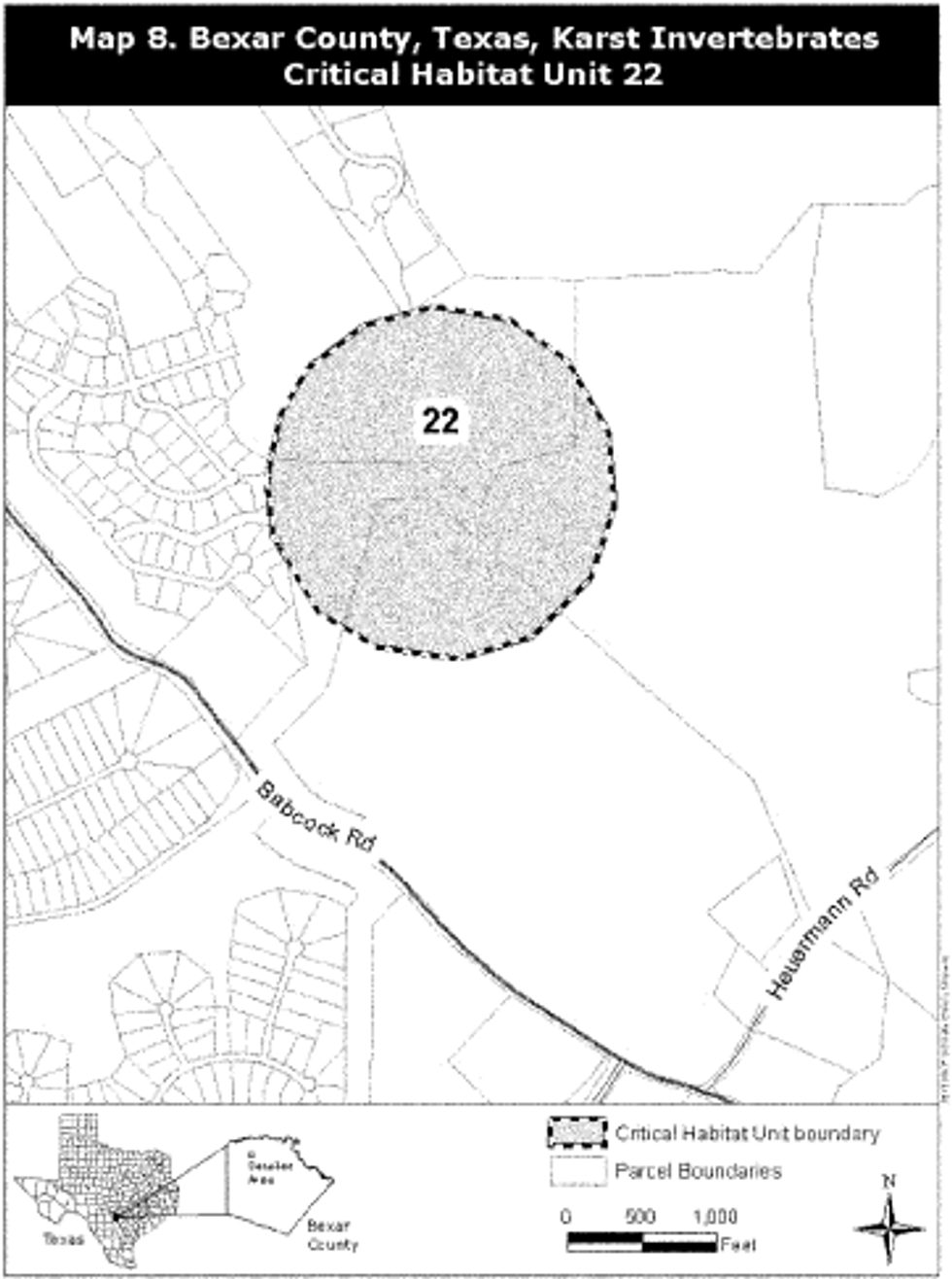
Robber Baron Cave Meshweaver (Cicurina baronia)
(1) Critical habitat for the Robber Baron Cave meshweaver in Bexar County, Texas, occurs in Units 20 and 25. Unit 20 is described as set forth, and depicted on Map 2 provided at paragraph (6)(ii) of the entry for the Cokendolpher Cave harvestman in this paragraph (g). Unit 25 is described in this entry and depicted on Map 3 in this entry. Units 20 and 25 are also depicted on Map 1 (index map) provided in paragraph (5) of the entry for the Cokendolpher Cave harvestman in this paragraph (g).
(2) The primary constituent elements of, and the statements regarding developed lands in, critical habitat for the Robber Baron Cave meshweaver are identical to those set forth in paragraphs (2) and (3) of the entry for the Cokendolpher Cave harvestman in this paragraph (g).
(3) Data layers defining this map unit were created using a geographic information system (GIS), which included cave locations, karst zone maps, roads, property boundaries, 2010 aerial photography, and USGS 7.5′ quadrangles. Points were placed on the GIS.
(4) Unit 20: Bexar County, Texas.
(i) [Reserved]
(ii) Map 2 of Unit 20 is provided at paragraph (6)(ii) of the entry for the Cokendolpher Cave harvestman in this paragraph (g).
(5) Unit 25: Bexar County, Texas.
(i) [Reserved]
(ii) Map 3 of Unit 25 follows:
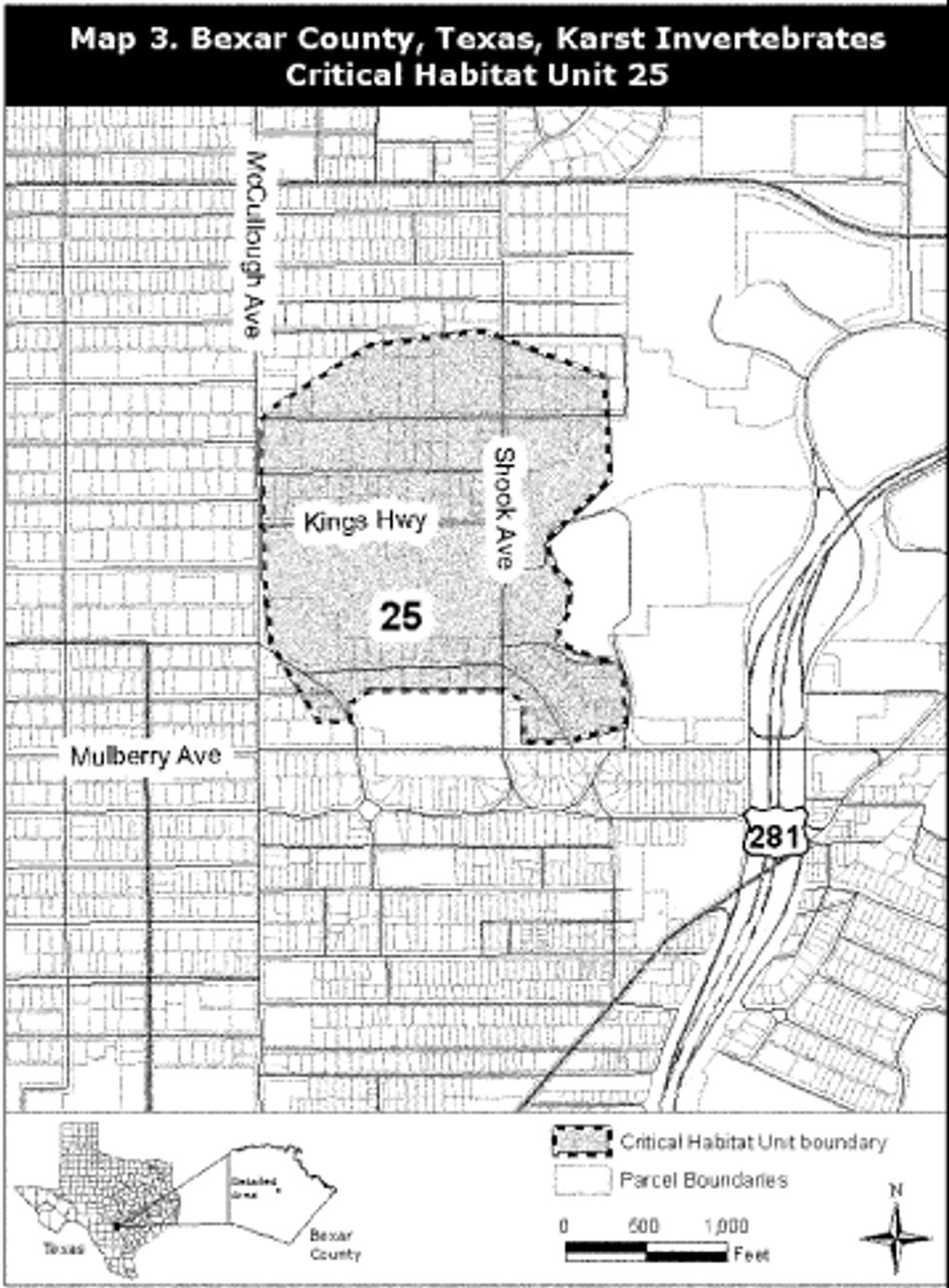
Government Canyon Bat Cave Spider (Tayshaneta microps)
(1) Critical habitat for the Government Canyon Bat Cave spider in Bexar County, Texas, occurs in Unit 1b, as described at paragraph (4)(i) of the entry for the Government Canyon Bat Cave meshweaver in this paragraph (g). Unit 1b is also depicted on Map 1 (index map) provided at paragraph (5) of the entry for the Cokendolpher Cave harvestman in this paragraph (g), and on Map 2 (Unit 1b) provided at paragraph (4)(ii) of the entry for the Government Canyon Bat Cave meshweaver in this paragraph (g).
(2) The primary constituent elements of, and statements regarding developed lands in, critical habitat for the Government Canyon Bat Cave spider are identical to those set forth at paragraphs (2) and (3) of the entry for the Cokendolpher Cave harvestman in this paragraph (g).
(3) Data layers defining this map unit were created using a geographic information system (GIS), which included cave locations, karst zone maps, roads, property boundaries, 2010 aerial photography, and USGS 7.5′ quadrangles. Points were placed on the GIS.
(4) Unit 1b: Bexar County, Texas.
(i) [Reserved]
(ii) Map 2 of Unit 1b is provided at paragraph (4)(ii) in the entry for the Government Canyon Cave meshweaver in this paragraph (g).
Kauai Cave Wolf Spider (Adelocosa anops).
(1) Critical habitat units are depicted for the island of Kauai, Hawaii, on the maps below. The maps provided are for informational purposes only.
(2) The primary constituent elements for the Kauai cave wolf spider are:
(i) The presence of subterranean spaces from 5 mm to 25 cm (0.2 in to 10 in) at their narrowest point (collectively termed “mesocaverns”) and/or cave passages greater than 25 cm (>10 in);
(ii) Dark and/or stagnant air zones that maintain relative humidity at saturation levels (≥100 percent); and
(iii) The presence in these types of mesocaverns or caves of roots from living, nontoxic plants such as, but not limited to, ohia (Metrosideros polymorpha), maiapilo (Capparis sandwichiana), and aalii (Dodonea viscosa).
(3) All critical habitat areas contain one or more of the primary constituent elements for the Kauai cave wolf spider.
(4)(i) Existing human-constructed features and structures within the boundaries of mapped units that involved trenching, filling, or excavation resulting in below-surface modification or alteration would not contain either of the primary constituent elements and are excluded from critical habitat designation. Such features and structures include but are not limited to: Homes and buildings for which the underlying bedrock has been altered for their construction or through incorporation of or connection to buried structural foundations, septic tanks, city sewage and drainage systems, or water or underground electrical supply corridors; paved roads; and areas previously or currently used as a quarry.
(ii) Areas that have been modified on the surface but without trenching, filling, or excavation resulting in below-surface modification or alteration are included in the critical habitat designation, even if they are adjacent to areas that have undergone below-surface modification.
(5) Critical habitat units are described below. Coordinates in UTM Zone 4 with units in meters using North American Datum of 1983 (NAD83). The following map shows the general locations of the 14 critical habitat units designated on the island of Kauai.
(i) Note: Map 1 - Index map follows:
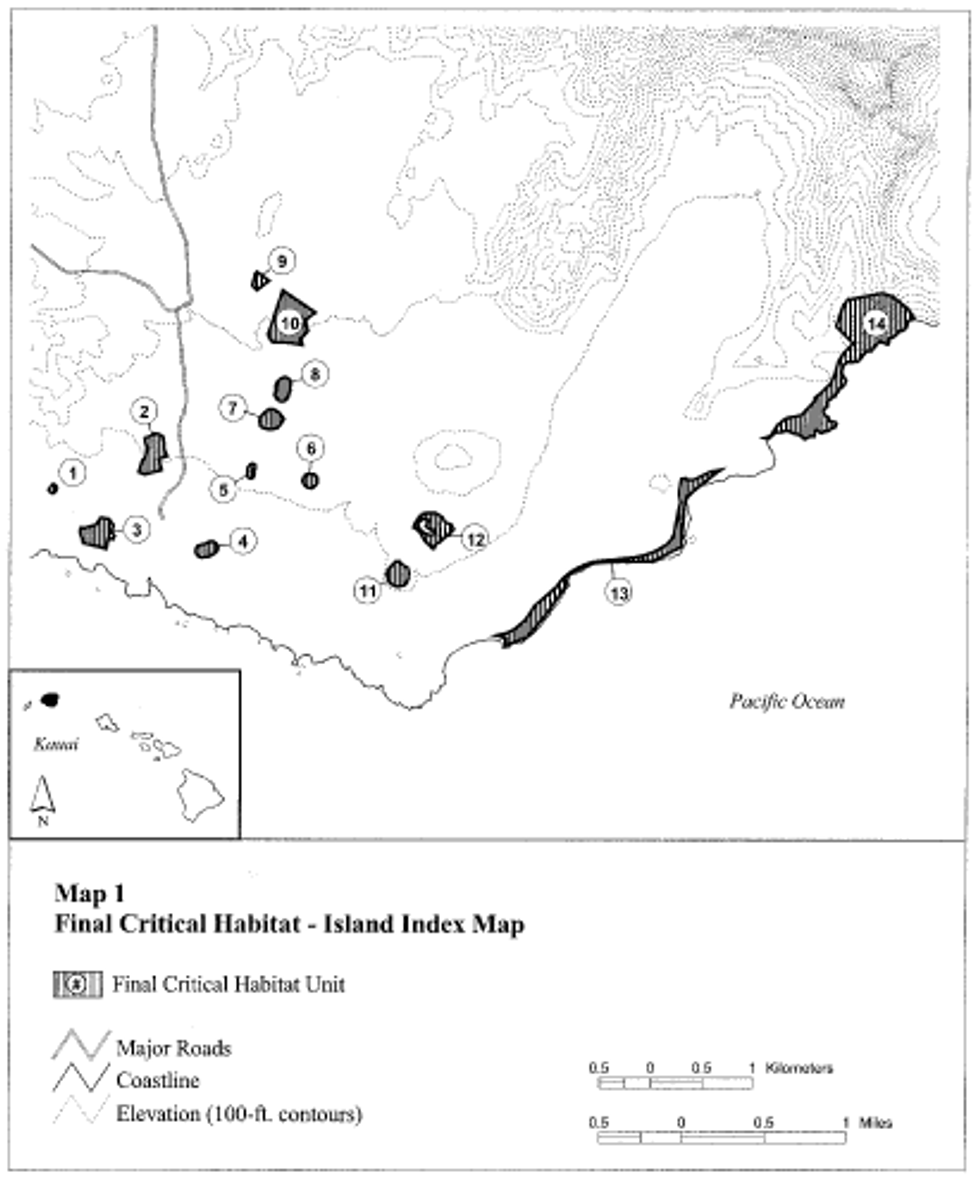
(6) Unit 1 - (<1 ha (1 ac)):
(i) Unit 1 consists of the following 10 boundary points with the following coordinates in UTM Zone 4, with the units in meters, using North American Datum of 1983 (NAD83): Start at 450554, 2420457; 450546, 2420468; 450576, 2420510; 450586, 2420518; 450607, 2420516; 450624, 2420502; 450625, 2420480; 450618, 2420452; 450600, 2420437; 450574, 2420434; return to starting point.
(ii) Note: Unit 1 is depicted on Map 2 - Units 1, 2, 3, and 4 - below.
(7) Unit 2 - (7 ha (16 ac)):
(i) Unit 2 consists of the following 16 boundary points with the following coordinates in UTM Zone 4, with the units in meters, using North American Datum of 1983 (NAD83): Start at 451483, 2420974; 451539, 2420991; 451583, 2421015; 451622, 2421014; 451667, 2420984; 451677, 2420926; 451680, 2420869; 451705, 2420799; 451622, 2420769; 451650, 2420664; 451488, 2420620; 451468, 2420624; 451433, 2420642; 451470, 2420758; 451501, 2420801; 451510, 2420870; return to starting point.
(ii) Note: Unit 2 is depicted on Map 2 - Units 1, 2, 3, and 4 - below.
(8) Unit 3 - (6 ha (16 ac)):
(i) Unit 3 consists of the following 14 boundary points with the following coordinates in UTM Zone 4, with the units in meters using North American Datum of 1983 (NAD83): Start at 450881, 2419947; 450879, 2419981; 450855, 2420053; 450859, 2420089; 450903, 2420089; 451012, 2420125; 451058, 2420191; 451138, 2420180; 451184, 2420119; 451159, 2420048; 451194, 2420014; 451183, 2419982; 451136, 2419987; 451114, 2419892; return to starting point.
(ii) Note: Unit 3 is depicted on Map 2 - Units 1, 2, 3, and 4 - below.
(9) Unit 4 - (2 ha (6 ac)):
(i) Unit 4 consists of the following 33 boundary points with the following coordinates in UTM Zone 4, with the units in meters using North American Datum of 1983 (NAD83): Start at 452087, 2419809; 452063, 2419804; 452053, 2419805; 452040, 2419807; 452027, 2419811; 452007, 2419824; 451994, 2419844; 451989, 2419867; 451994, 2419890; 452007, 2419910; 452027, 2419923; 452045, 2419927; 452053, 2419932; 452076, 2419936; 452082, 2419936; 452084, 2419936; 452090, 2419939; 452095, 2419942; 452096, 2419943; 452118, 2419954; 452145, 2419960; 452168, 2419955; 452188, 2419942; 452201, 2419922; 452206, 2419899; 452201, 2419876; 452188, 2419856; 452172, 2419844; 452153, 2419835; 452132, 2419822; 452123, 2419817; 452099, 2419812; 452093, 2419812; return to starting point.
(ii) Note: Unit 4 is depicted on Map 2 - Units 1, 2, 3, and 4 - which follows:
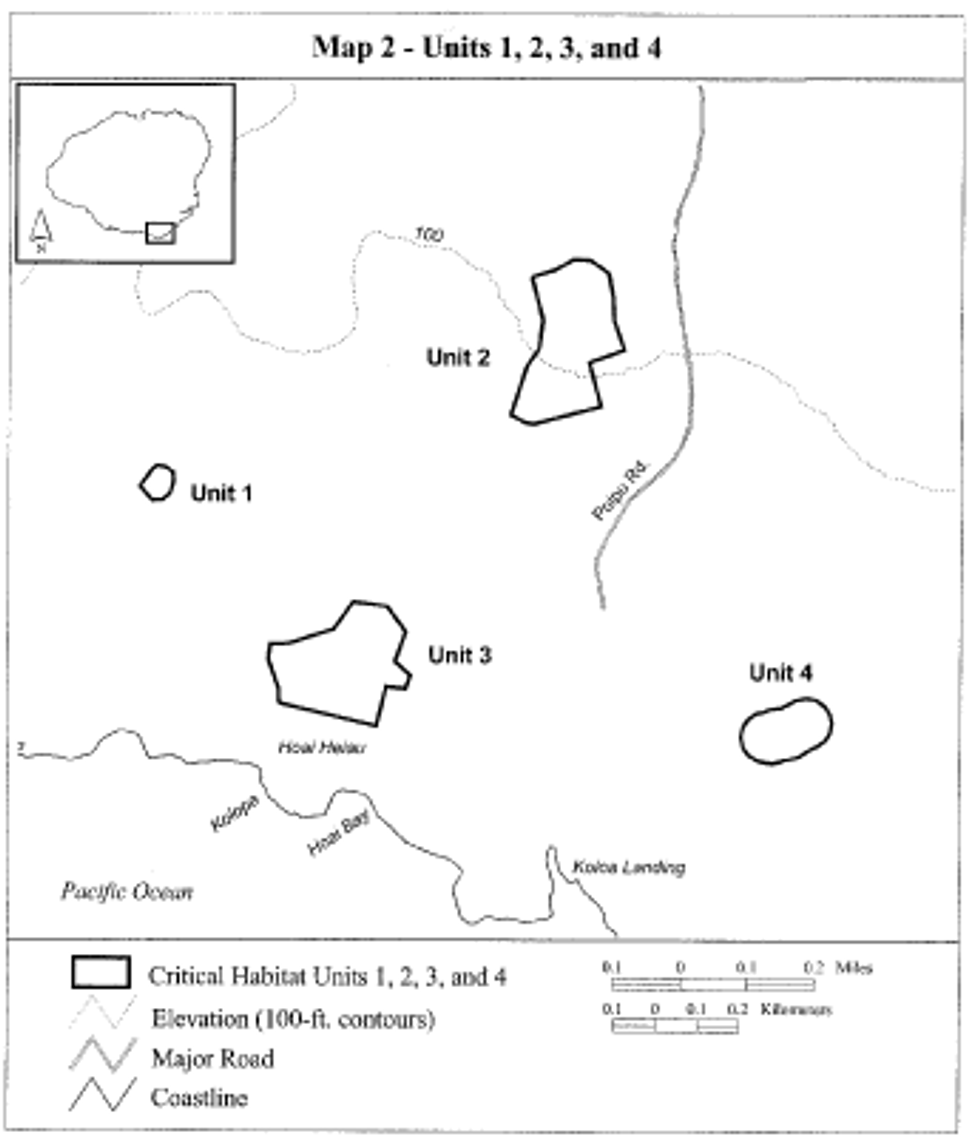
(10) Unit 5 - (1 ha (2 ac)):
(i) Unit 5 consists of the following 35 boundary points with the following coordinates in UTM Zone 4, with the units in meters using North American Datum of 1983 (NAD83): Start at 452493, 2420608; 452493, 2420613; 452493, 2420616; 452496, 2420639; 452492, 2420652; 452491, 2420660; 452492, 2420669; 452497, 2420683; 452498, 2420686; 452502, 2420694; 452516, 2420711; 452518, 2420713; 452528, 2420720; 452540, 2420722; 452552, 2420720; 452561, 2420713; 452568, 2420704; 452570, 2420692; 452568, 2420680; 452564, 2420673; 452553, 2420660; 452556, 2420649; 452557, 2420641; 452557, 2420637; 452554, 2420613; 452555, 2420611; 452555, 2420607; 452553, 2420595; 452546, 2420585; 452536, 2420579; 452525, 2420576; 452513, 2420579; 452503, 2420585; 452496, 2420595; 452494, 2420602; return to starting point.
(ii) Unit 5 is depicted on Map 3 - Units 5, 6, 7, and 8 - below.
(11) Unit 6 - (2 ha (4 ac)):
(i) Unit 6 consists of the following 21 boundary points with the following coordinates in UTM Zone 4, with the units in meters using North American Datum of 1983 (NAD83): Start at 453052, 2420607; 453065, 2420616; 453078, 2420622; 453101, 2420626; 453126, 2420621; 453139, 2420616; 453154, 2420606; 453164, 2420591; 453167, 2420579; 453169, 2420551; 453165, 2420533; 453156, 2420517; 453141, 2420500; 453127, 2420490; 453109, 2420486; 453078, 2420490; 453053, 2420505; 453042, 2420522; 453034, 2420543; 453032, 2420559; 453036, 2420585; return to starting point.
(ii) Unit 6 is depicted on Map 3 - Units 5, 6, 7, and 8 - below.
(12) Unit 7 - (3 ha (9 ac)):
(i) Unit 7 consists of the following 7 boundary points with the following coordinates in UTM Zone 4, with the units in meters using North American Datum of 1983 (NAD83): Start at 452623, 2421100; 452812, 2421077; 452831, 2421041; 452816, 2421016; 452786, 2420896; 452590, 2420946; 452608, 2421015; return to starting point.
(ii) Unit 7 is depicted on Map 3 - Units 5, 6, 7, and 8 - below.
(13) Unit 8 - (2 ha (7 ac)):
(i) Unit 8 consists of the following 33 boundary points with the following coordinates in UTM Zone 4, with the units in meters using North American Datum of 1983 (NAD83): Start at 452763, 2421383; 452759, 2421402; 452760, 2421421; 452767, 2421462; 452766, 2421477; 452768, 2421497; 452771, 2421510; 452780, 2421523; 452812, 2421556; 452824, 2421564; 452831, 2421567; 452848, 2421571; 452857, 2421571; 452875, 2421567; 452890, 2421557; 452899, 2421542; 452904, 2421531; 452907, 2421514; 452908, 2421497; 452904, 2421480; 452899, 2421471; 452902, 2421454; 452900, 2421439; 452894, 2421422; 452891, 2421412; 452891, 2421402; 452888, 2421385; 452880, 2421368; 452871, 2421355; 452844, 2421338; 452822, 2421335; 452799, 2421339; 452778, 2421357; return to starting point.
(ii) Unit 8 is depicted on Map 3 - Units 5, 6, 7, and 8 - which follows:
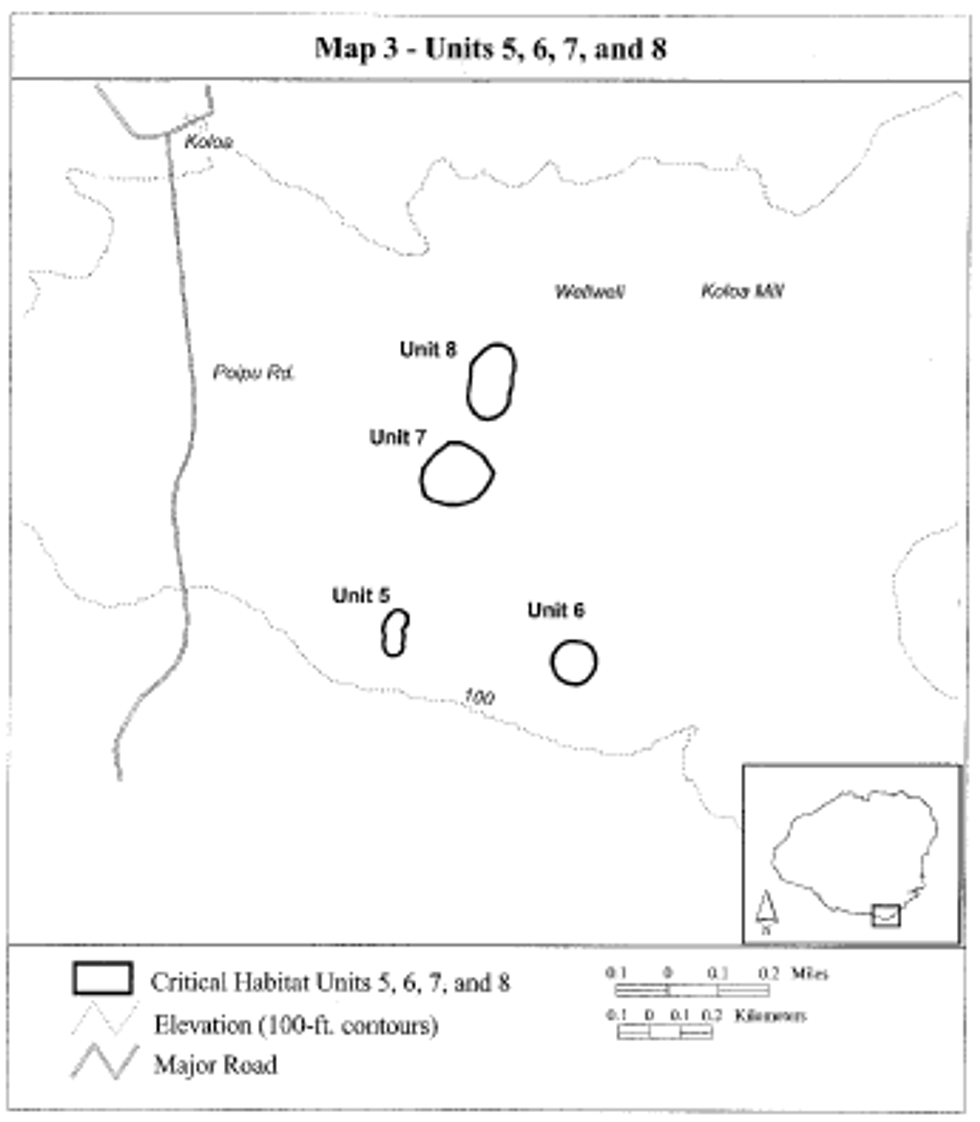
(14) Unit 9 - (1 ha (4 ac)):
(i) Unit 9 consists of the following 5 boundary points with the following coordinates in UTM Zone 4, with the units in meters using North American Datum of 1983 (NAD83): Start at 452568, 2422604; 452577, 2422610; 452696, 2422521; 452580, 2422429; 452537, 2422471; return to starting point.
(ii) Note: Unit 9 is depicted on Map 4 - Units 9 and 10 - below.
(15) Unit 10 - (14 ha (35 ac)):
(i) Unit 10 consists of the following 14 boundary points with the following coordinates in UTM Zone 4, with the units in meters using North American Datum of 1983 (NAD83): Start at 452688, 2421988; 452834, 2422427; 453145, 2422210; 453061, 2422147; 453053, 2422133; 453053, 2422102; 453061, 2422078; 453074, 2422029; 453002, 2421944; 453015, 2421922; 453022, 2421892; 452896, 2421910; 452733, 2421917; 452705, 2421959; return to starting point.
(ii) Note: Unit 10 is depicted on Map 4 - Units 9 and 10 - which follows:
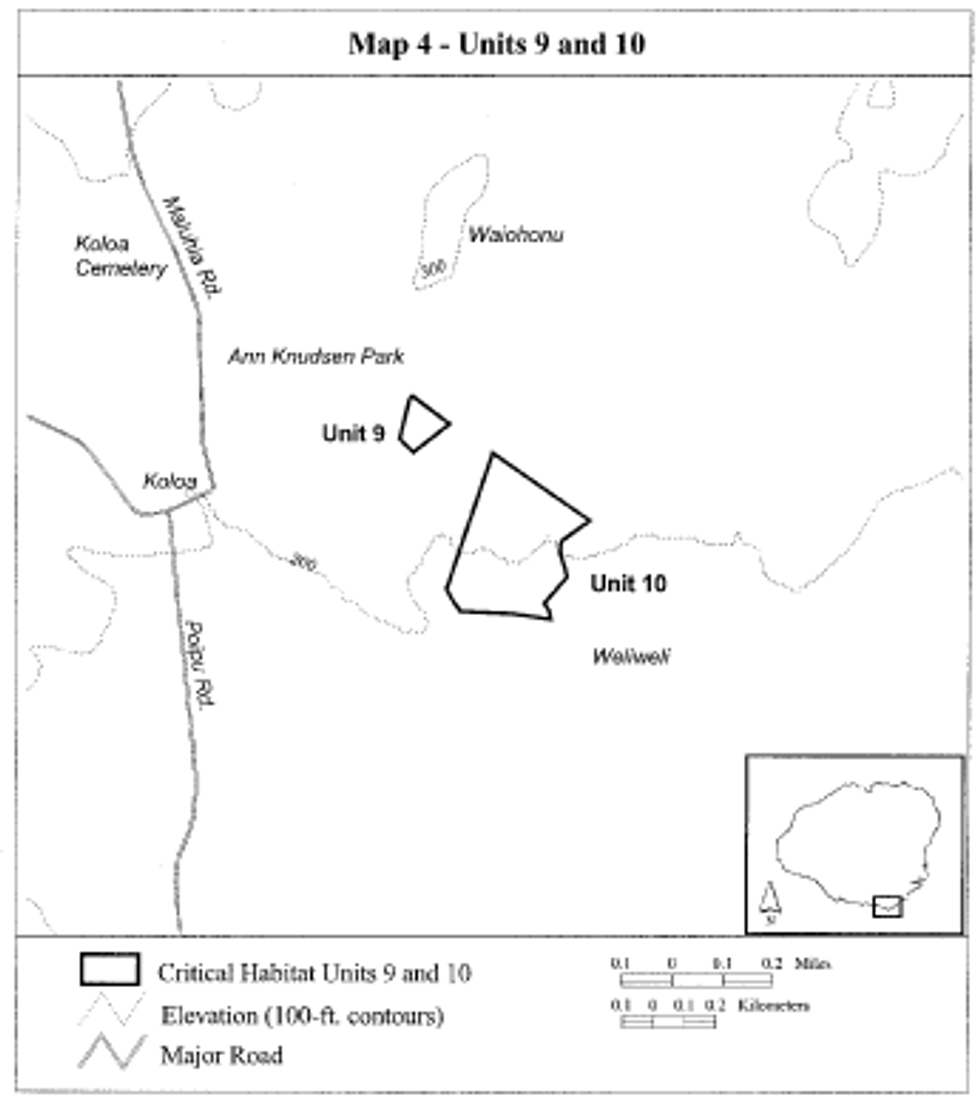
(16) Unit 11 - (4 ha (10 ac)):
(i) Unit 11 consists of the following 17 boundary points with the following coordinates in UTM Zone 4, with the units in meters using North American Datum of 1983 (NAD83): Start at 453958, 2419773; 453976, 2419766; 453999, 2419741; 454054, 2419702; 454068, 2419667; 454060, 2419596; 454042, 2419553; 454005, 2419528; 453962, 2419521; 453894, 2419545; 453872, 2419573; 453862, 2419600; 453852, 2419642; 453862, 2419676; 453887, 2419718; 453912, 2419742; 453936, 2419768; return to starting point.
(ii) Note: Unit 11 is depicted on Map 5 - Units 11 and 12 - below.
(17) Unit 12 (6 ha (16 ac)):
(i) Unit 12 consists of the following 21 boundary points with the following coordinates in UTM Zone 4, with the units in meters using North American Datum of 1983 (NAD83): Start at 454185, 2420229; 454242, 2420243; 454326, 2420241; 454387, 2420207; 454420, 2420147; 454475, 2420133; 454502, 2420080; 454474, 2420055; 454366, 2419954; 454341, 2419944; 454321, 2419921; 454311, 2419895; 454286, 2419903; 454264, 2419927; 454229, 2419962; 454208, 2419993; 454186, 2420038; 454169, 2420058; 454145, 2420086; 454112, 2420103; 454120, 2420133; return to starting point.
(ii) Note: Unit 12 is depicted on Map 5 - Units 11 and 12 - which follows:
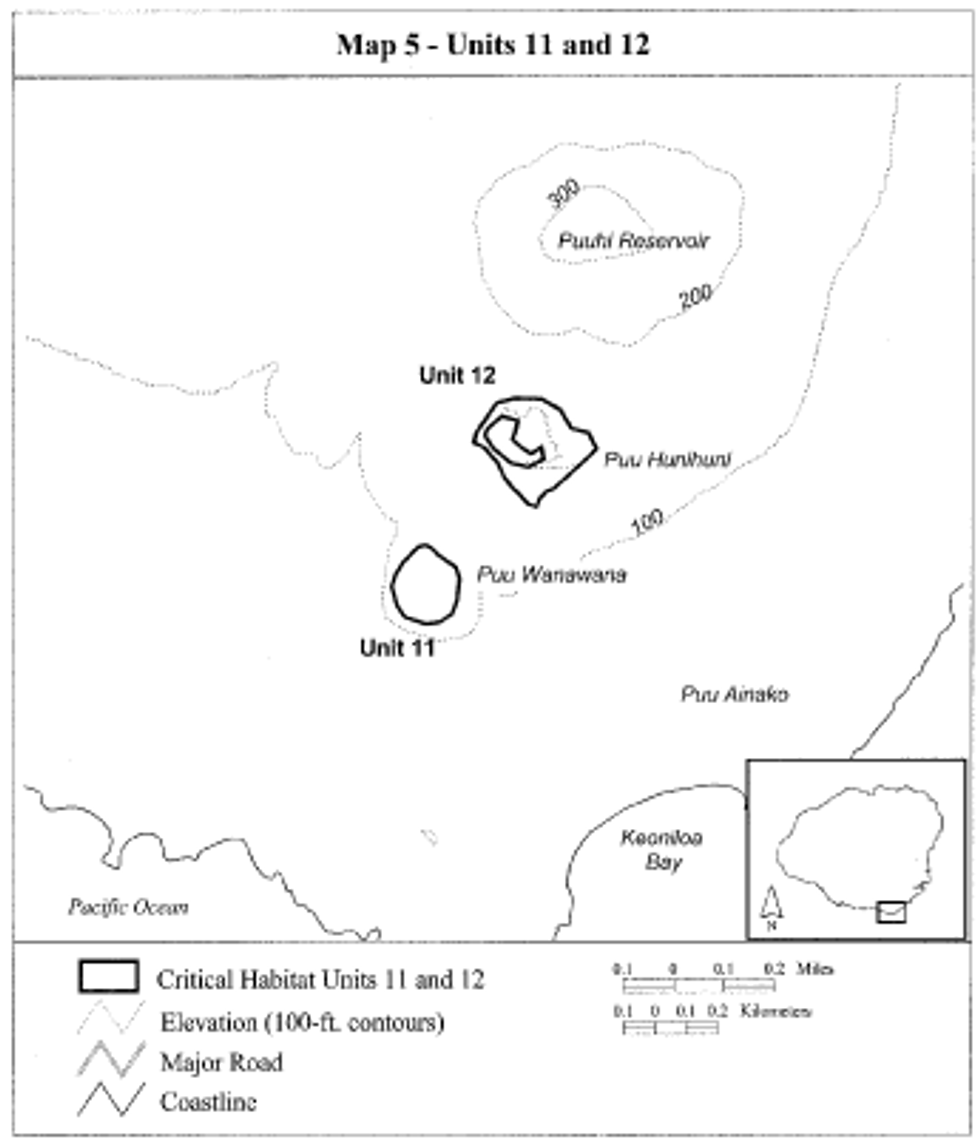
(18) Unit 13 - (21 ha (52 ac)):
(i) Unit 13 consists of the following 43 boundary points with the following coordinates in UTM Zone 4, with the units in meters using North American Datum of 1983 (NAD83): Start at 457108, 2420666; 457027, 2420606; 456763, 2420391; 456727, 2419912; 456456, 2419772; 455868, 2419764; 455633, 2419645; 455601, 2419531; 455389, 2419219; 455225, 2419029; 455014, 2418947; 455014, 2419015; 454926, 2419043; 455027, 2419064; 455102, 2419103; 455202, 2419192; 455255, 2419258; 455300, 2419334; 455508, 2419515; 455586, 2419614; 455664, 2419674; 455767, 2419730; 455859, 2419764; 455969, 2419780; 456212, 2419805; 456272, 2419811; 456376, 2419831; 456451, 2419859; 456531, 2419900; 456583, 2419935; 456627, 2419981; 456656, 2420036; 456682, 2420173; 456709, 2420316; 456718, 2420343; 456704, 2420433; 456723, 2420583; 456747, 2420580; 456771, 2420584; 456786, 2420569; 456848, 2420572; 456979, 2420634; 457022, 2420649; return to starting point.
(ii) Note: Unit 13 is depicted on Map 6 - Unit 13 - which follows:

(19) Unit 14 - (39 ha (96 ac)):
(i) Unit 14 consists of the following 47 boundary points with the following coordinates in UTM Zone 4, with the units in meters using North American Datum of 1983 (NAD83): Coastline. 457575, 2420977; 457548, 2420981; 457598, 2421002; 457624, 2421039; 457624, 2421039; 457624, 2421039; 457664, 2421105; 457715, 2421146; 457755, 2421170; 457901, 2421204; 458025, 2421342; 458025, 2421367; 458078, 2421412; 458078, 2421413; 458078, 2421413; 458184, 2421510; 458226, 2421607; 458226, 2421607; 458226, 2421607; 458259, 2421727; 458308, 2421809; 458371, 2421876; 458405, 2421905; 458237, 2422080; 458301, 2422271; 458346, 2422339; 458686, 2422403; 458785, 2422371; 458932, 2422252; 458997, 2422153; Coastline. 458706, 2421920; 458670, 2421988; 458662, 2422059; 458688, 2422116; 458778, 2422112; 458809, 2422160; 458719, 2422266; 458630, 2422266; 458556, 2422191; 458563, 2422061; 458479, 2421989; 458500, 2421803.
(ii) Note: Unit 14 is depicted on Map 7 - Unit 14 - which follows:
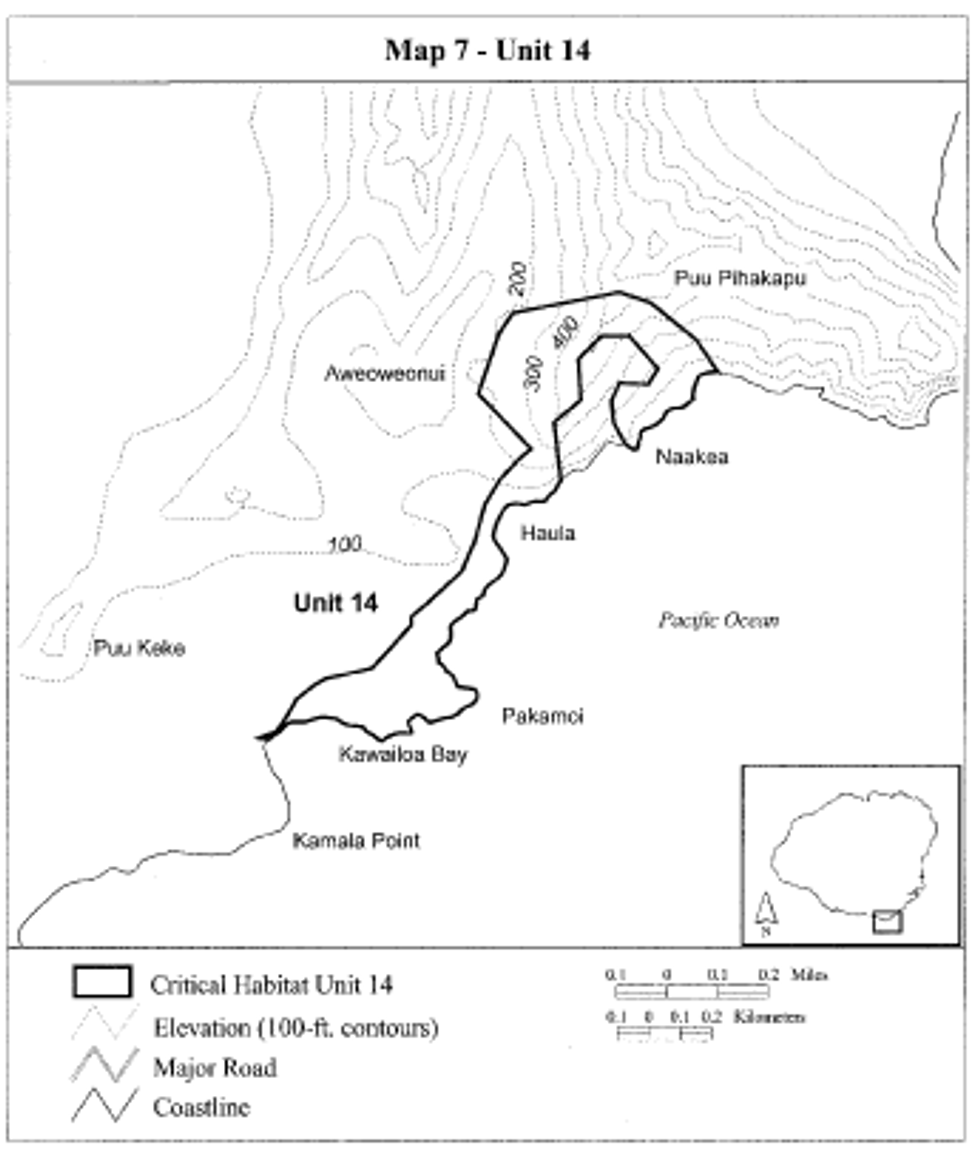
Spruce-Fir Moss Spider (Microhexura montivaga)
1. Critical habitat units and their ownership are described below and depicted in the following maps. The maps provided are for informational purposes only.
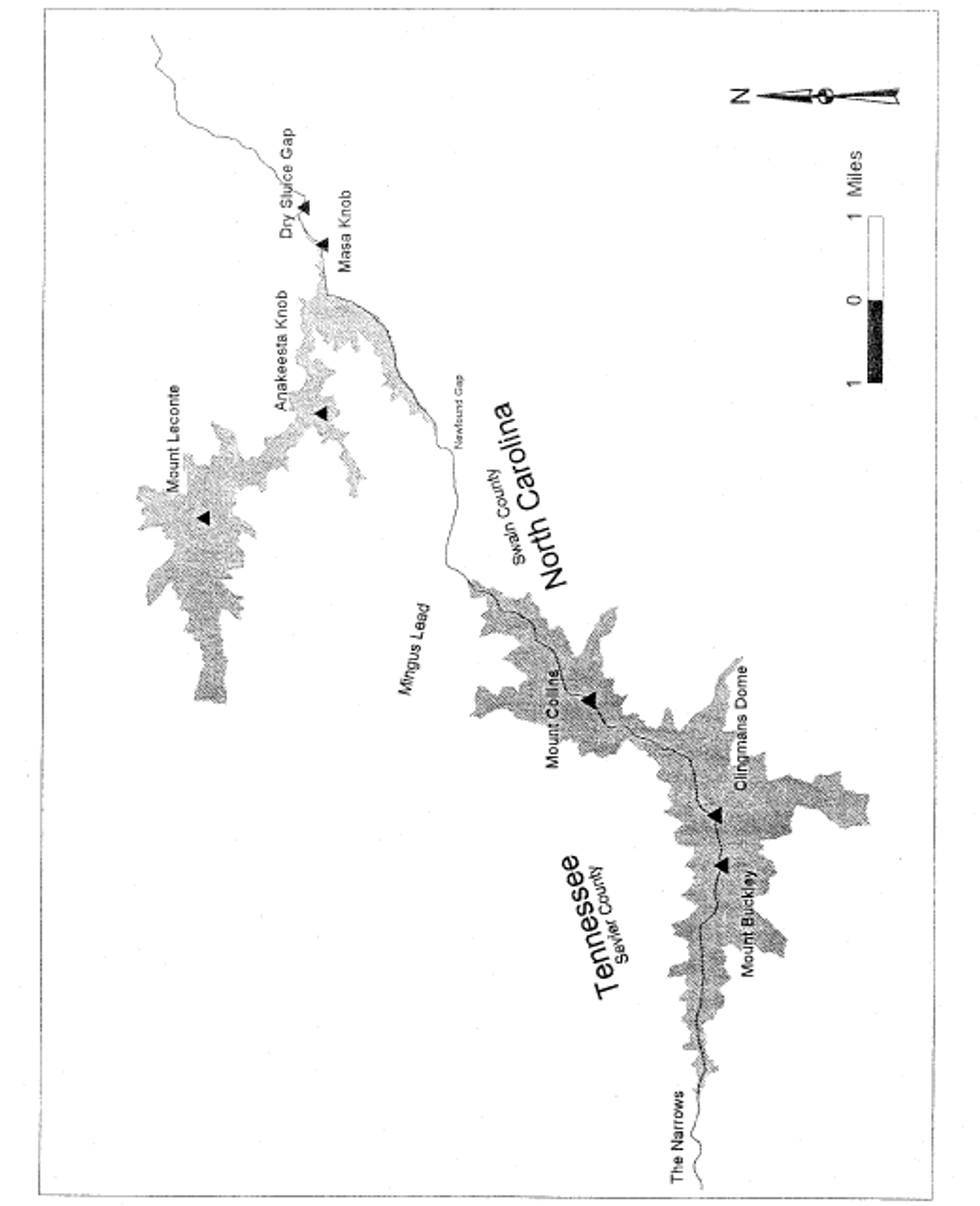
Unit 1: Swain County, North Carolina, and Sevier County, Tennessee - all portions of the GSMNP bounded to the north and to the south of the North Carolina/Tennessee State line (State line) by the 1,646-m (5,400-ft) contour, from the intersection of the 1,646-m (5,400-ft) contour with the State line, south of Mingus Lead, Tennessee, southwest and then west to the intersection of the 1,646-m (5,400-ft) contour with the State line, east of The Narrows and west of Jenkins Knob, North Carolina, and Tennessee.
Unit 2: Sevier County, Tennessee - all portions of the GSMNP at and above the 1,646-m (5,400-ft) contour, bounded on the southwest side by the North Carolina/Tennessee State line from the intersection of the State line with the 1,646-m (5,400-ft) contour near Dry Sluice Gap, southeast to the intersection of the State line with the 1,646-m (5,400-ft) contour at the head of Minnie Ball Branch, North Carolina, northwest of Newfound Gap, North Carolina, and Tennessee.
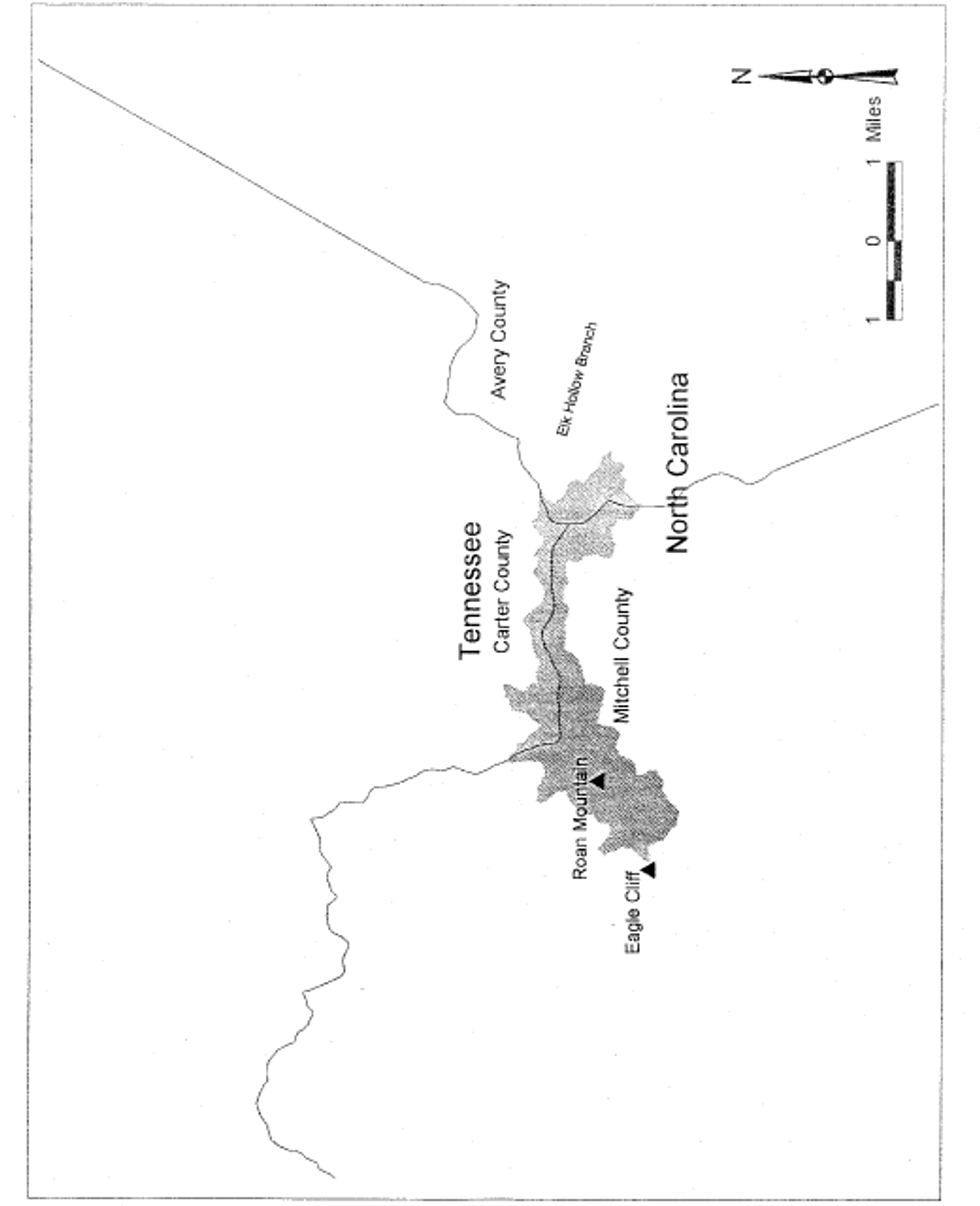
Unit 3: Avery and Mitchell Counties, North Carolina, and Carter County, Tennessee - all portions of the Pisgah National Forest in North Carolina and the Cherokee National Forest in Tennessee, bounded to the north and to the south of the North Carolina/Tennessee State line by the 1,646-m (5,400-ft) contour, from the intersection of the 1,646-m (5,400-ft) contour with the State line north of Elk Hollow Branch, Avery County, North Carolina, and southwest of Yellow Mountain, Carter County, Tennessee, west to the 1,646-m (5,400-ft) contour at Eagle Cliff, Mitchell County, North Carolina.
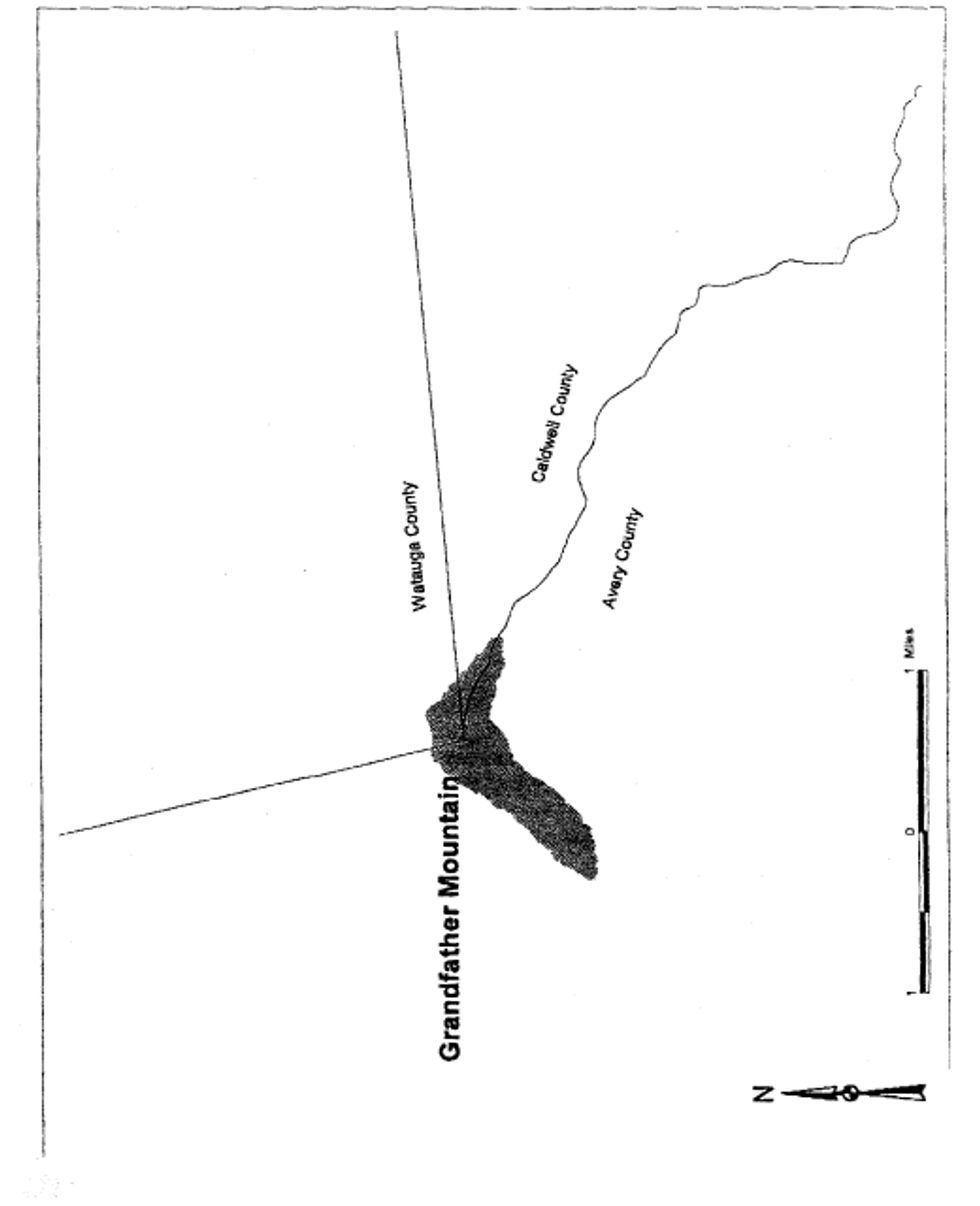
Unit 4: Avery, Caldwell, and Watauga Counties, North Carolina - all areas of Grandfather Mountain at and above the 1,646-m (5,400-ft) contour.
2. Within these areas, the primary constituent elements include:
(i) Fraser fir or fir-dominated spruce-fir forests at and above 1,646 m (5,400 ft) in elevation; and
(ii) Moderately thick and humid, but not wet, moss (species in the genus Dicranodontium, and possibly Polytrichum) and/or liverwort mats on rock surfaces that are adequately sheltered from the sun and rain (by overhang and aspect) and include a thin layer of humid soil and/or humus between the moss and rock surface.
3. Existing human structures and other features not containing all of the primary constituent elements are not considered critical habitat.
(h) Crustaceans.
Diminutive amphipod (Gammarus hyalleloides)
(1) Critical habitat units are depicted for Jeff Davis County and Reeves County, Texas, on the maps below.
(2) Within these areas, the primary constituent elements of the physical or biological features essential to the conservation of diminutive amphipod are springs and spring-fed aquatic systems that contain:
(i) Permanent, flowing, unpolluted water (free from contamination) emerging from the ground and flowing on the surface;
(ii) Water temperatures that vary between 11 and 27°C (52 to 81°F) with natural seasonal and diurnal variations slightly above and below that range;
(iii) Substrates that include cobble, gravel, pebble, sand, silt, and aquatic vegetation, for breeding, maturing, feeding, and escape from predators;
(iv) Abundant food, consisting of algae, bacteria, decaying organic material, and submergent vegetation that contributes the necessary nutrients, detritus, and bacteria on which these species forage; and
(v) Either an absence of nonnative predators and competitors or nonnative predators and competitors at low population levels.
(3) Critical habitat does not include manmade structures (such as buildings, aqueducts, well pads, roads, and other paved areas) and the land on which they are located existing within the legal boundaries on August 8, 2013.
(4) Critical habitat map units. Data layers defining map units were created on 2010 aerial photography from U.S. Department of Agriculture, National Agriculture Imagery Program base maps using ArcMap (Environmental Systems Research Institute, Inc.), a computer geographic information system (GIS) program. The maps in this entry, as modified by any accompanying regulatory text, establish the boundaries of the critical habitat designation. The coordinates or plot points or both on which each map is based are available to the on the internet at http://www.regulations.gov at Docket No. FWS-R2-ES-2013-0004 and at the field office responsible for this designation. You may obtain field office location information by contacting one of the Service regional offices, the addresses of which are listed at 50 CFR 2.2.
(5) San Solomon Spring Unit, Reeves County, Texas. Map of San Solomon Spring Unit follows:
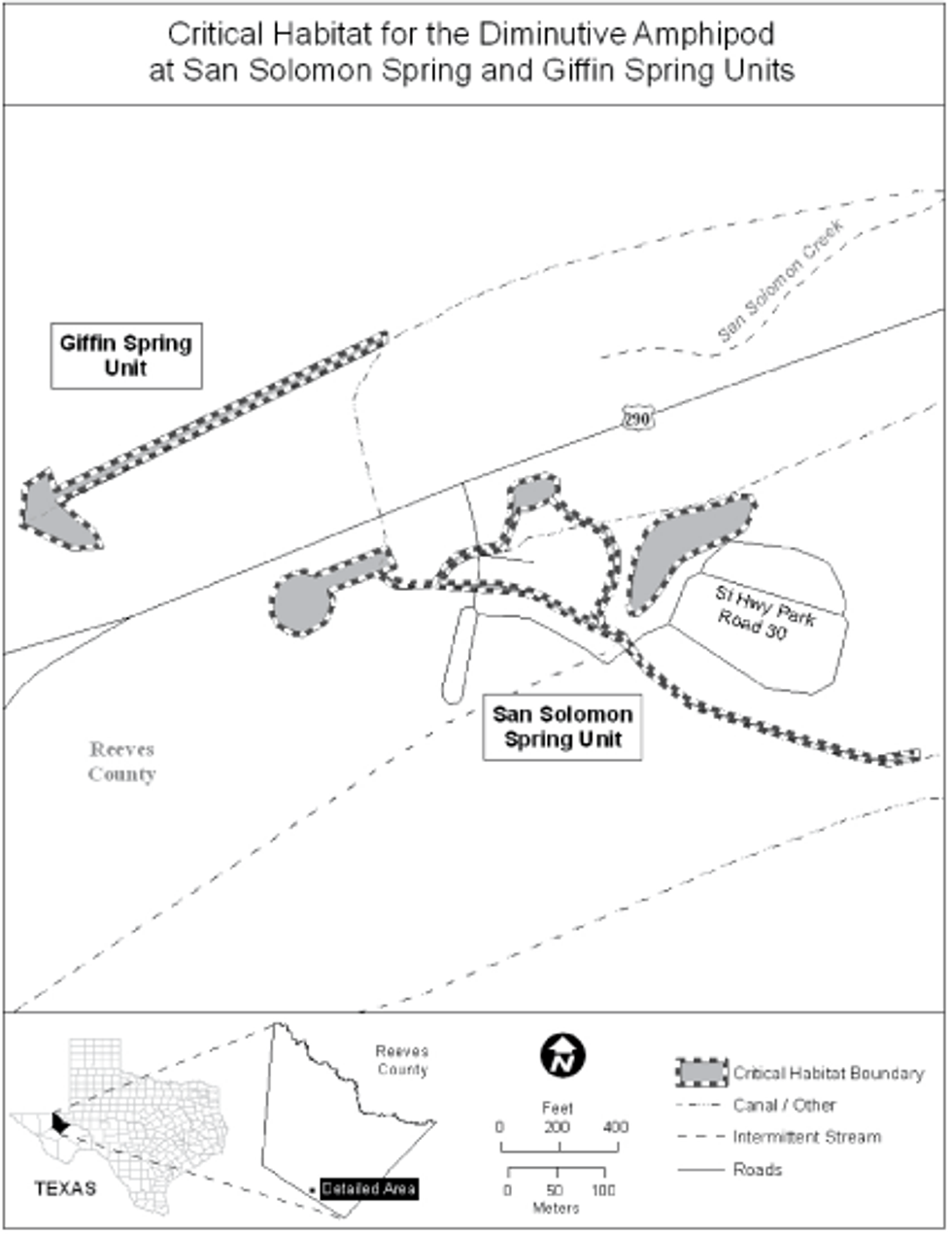
(6) Giffin Spring Unit, Reeves County, Texas. Map of Giffin Spring Unit is provided at paragraph (5) of this entry.
(7) East Sandia Spring Unit, Reeves County, Texas. Map of East Sandia Spring Unit follows:
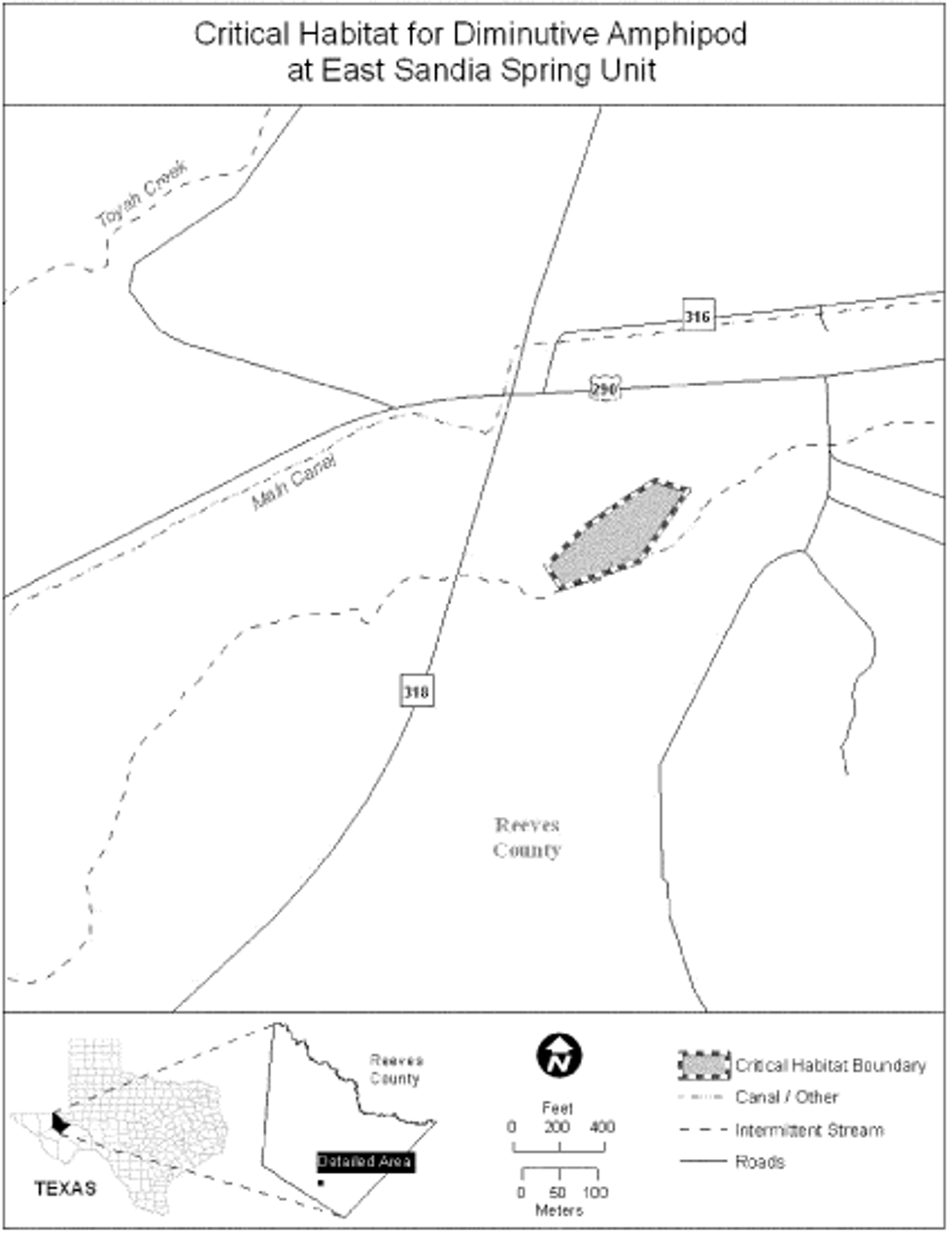
(8) Phantom Lake Spring Unit, Jeff Davis County, Texas. Map of Phantom Lake Spring Unit follows:
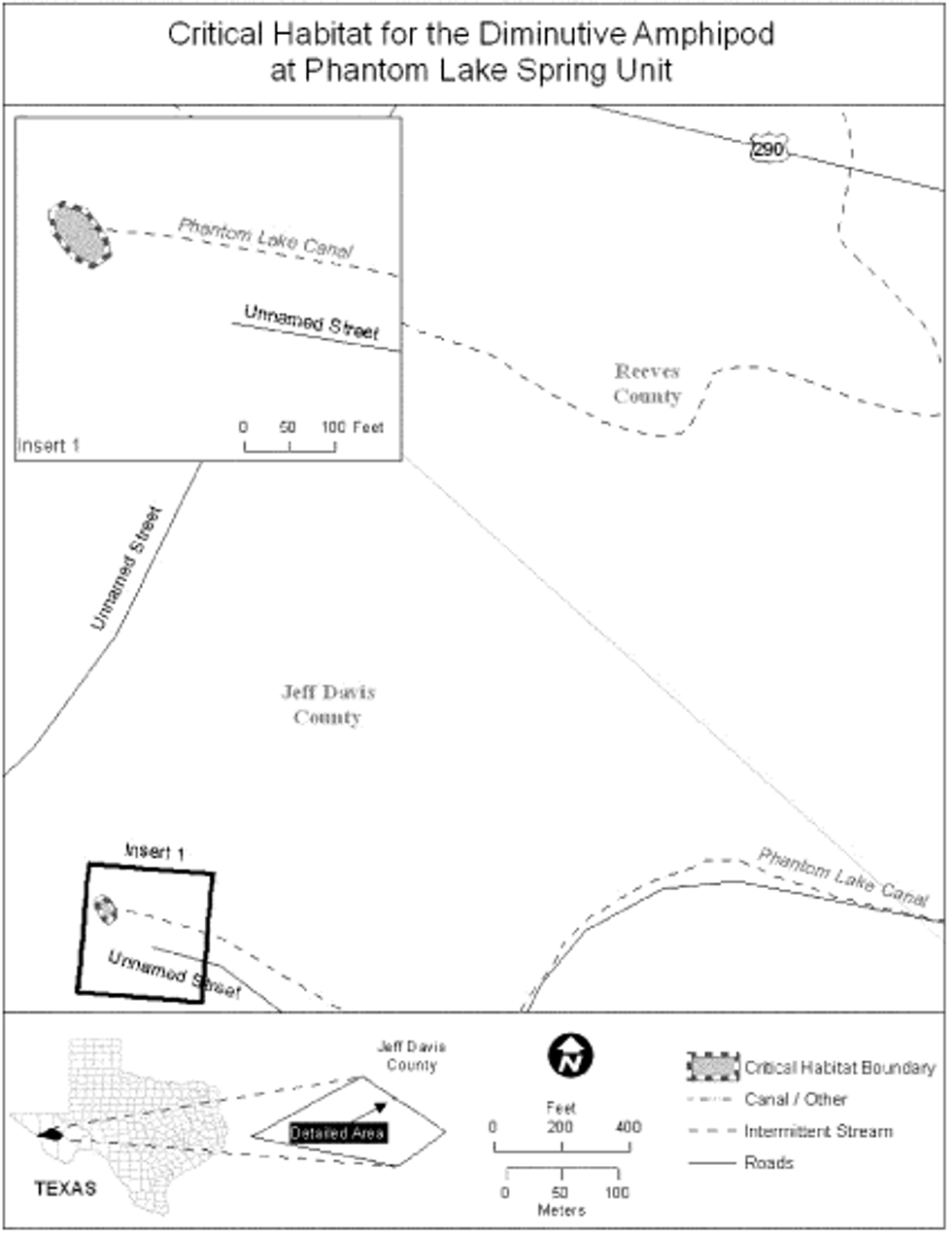
Kauai Cave Amphipod (Spelaeorchestia koloana)
(1) Critical habitat units are depicted for the island of Kauai, Hawaii, on the maps below. The maps provided are for informational purposes only.
(2) The primary constituent elements for the Kauai cave amphipod are:
(i) The presence of subterranean spaces from 5 mm to 25 cm (0.2 in to 10 in) at their narrowest point (collectively termed “mesocaverns”) and/or cave passages greater than 25 cm (>10 in);
(ii) Dark and/or stagnant air zones that maintain relative humidity at saturation levels (≥100 percent); and
(iii) The presence in these types of mesocaverns or caves of roots from living, nontoxic plants such as, but not limited to, ohia (Metrosideros polymorpha), maiapilo (Capparis sandwichiana), and aalii (Dodonea viscosa).
(3) All critical habitat areas contain one or more of the primary constituent elements for the Kauai cave amphipod.
(4)(i) Existing human-constructed features and structures within the boundaries of mapped units that involved trenching, filling, or excavation resulting in below-surface modification or alteration would not contain either of the primary constituent elements and are excluded from critical habitat designation. Such features and structures include but are not limited to: Homes and buildings for which the underlying bedrock has been altered for their construction or through incorporation of or connection to buried structural foundations, septic tanks, city sewage and drainage systems, or water or underground electrical supply corridors; paved roads; and areas previously or currently used as a quarry.
(ii) Areas that have been modified on the surface but without trenching, filling, or excavation resulting in below-surface modification or alteration are included in the critical habitat designation, even if they are adjacent to areas that have undergone below-surface modification.
(5) Critical habitat units are described below. Coordinates in UTM Zone 4 with units in meters using North American Datum of 1983 (NAD83). The following map shows the general locations of the 14 critical habitat units designated on the island of Kauai.
(i) Note: Map 1 - Index map follows:
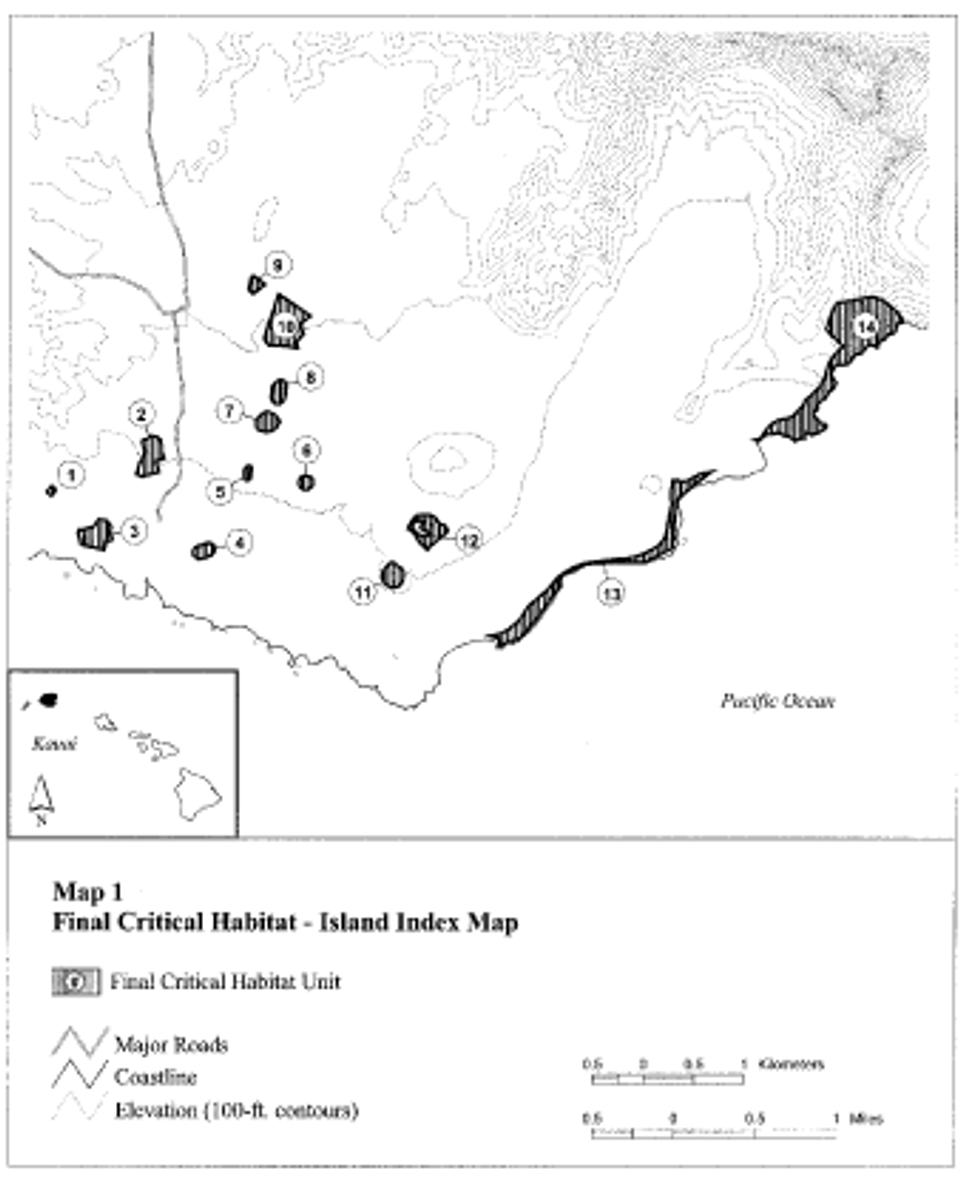
(6) Unit 1 - (<1 ha (1 ac)):
(i) Unit 1 consists of the following 10 boundary points with the following coordinates in UTM Zone 4, with the units in meters, using North American Datum of 1983 (NAD83): Start at 450554, 2420457; 450546, 2420468; 450576, 2420510; 450586, 2420518; 450607, 2420516; 450624, 2420502; 450625, 2420480; 450618, 2420452; 450600, 2420437; 450574, 2420434; return to starting point.
(ii) Note: Unit 1 is depicted on Map 2 - Units 1, 2, 3, and 4 - below.
(7) Unit 2 - (7 ha (16 ac)):
(i) Unit 2 consists of the following 16 boundary points with the following coordinates in UTM Zone 4, with the units in meters, using North American Datum of 1983 (NAD83): Start at 451483, 2420974; 451539, 2420991; 451583, 2421015; 451622, 2421014; 451667, 2420984; 451677, 2420926; 451680, 2420869; 451705, 2420799; 451622, 2420769; 451650, 2420664; 451488, 2420620; 451468, 2420624; 451433, 2420642; 451470, 2420758; 451501, 2420801; 451510, 2420870; return to starting point.
(ii) Note: Unit 2 is depicted on Map 2 - Units 1, 2, 3, and 4 - below.
(8) Unit 3 - (6 ha (16 ac)):
(i) Unit 3 consists of the following 14 boundary points with the following coordinates in UTM Zone 4, with the units in meters using North American Datum of 1983 (NAD83): Start at 450881, 2419947; 450879, 2419981; 450855, 2420053; 450859, 2420089; 450903, 2420089; 451012, 2420125; 451058, 2420191; 451138, 2420180; 451184, 2420119; 451159, 2420048; 451194, 2420014; 451183, 2419982; 451136, 2419987; 451114, 2419892; return to starting point.
(ii) Note: Unit 3 is depicted on Map 2 - Units 1, 2, 3, and 4 - below.
(9) Unit 4 - (2 ha (6 ac)):
(i) Unit 4 consists of the following 33 boundary points with the following coordinates in UTM Zone 4, with the units in meters using North American Datum of 1983 (NAD83): Start at 452087, 2419809; 452063, 2419804; 452053, 2419805; 452040, 2419807; 452027, 2419811; 452007, 2419824; 451994, 2419844; 451989, 2419867; 451994, 2419890; 452007, 2419910; 452027, 2419923; 452045, 2419927; 452053, 2419932; 452076, 2419936; 452082, 2419936; 452084, 2419936; 452090, 2419939; 452095, 2419942; 452096, 2419943; 452118, 2419954; 452145, 2419960; 452168, 2419955; 452188, 2419942; 452201, 2419922; 452206, 2419899; 452201, 2419876; 452188, 2419856; 452172, 2419844; 452153, 2419835; 452132, 2419822; 452123, 2419817; 452099, 2419812; 452093, 2419812; return to starting point.
(ii) Note: Unit 4 is depicted on Map 2 - Units 1, 2, 3, and 4 - which follows:
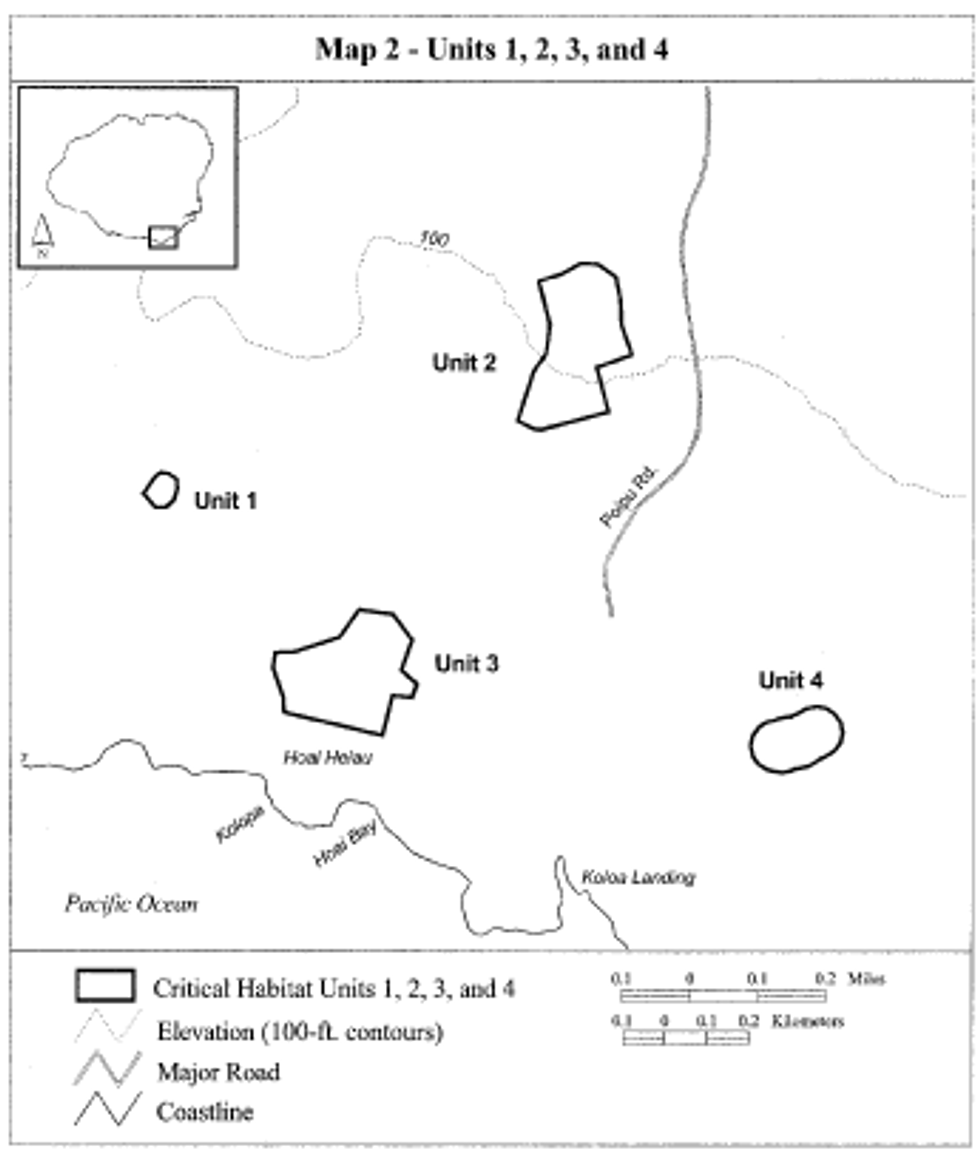
(10) Unit 5 - (1 ha (2 ac)):
(i) Unit 5 consists of the following 35 boundary points with the following coordinates in UTM Zone 4, with the units in meters using North American Datum of 1983 (NAD83): Start at 452493, 2420608; 452493, 2420613; 452493, 2420616; 452496, 2420639; 452492, 2420652; 452491, 2420660; 452492, 2420669; 452497, 2420683; 452498, 2420686; 452502, 2420694; 452516, 2420711; 452518, 2420713; 452528, 2420720; 452540, 2420722; 452552, 2420720; 452561, 2420713; 452568, 2420704; 452570, 2420692; 452568, 2420680; 452564, 2420673; 452553, 2420660; 452556, 2420649; 452557, 2420641; 452557, 2420637; 452554, 2420613; 452555, 2420611; 452555, 2420607; 452553, 2420595; 452546, 2420585; 452536, 2420579; 452525, 2420576; 452513, 2420579; 452503, 2420585; 452496, 2420595; 452494, 2420602; return to starting point.
(ii) Unit 5 is depicted on Map 3 - Units 5, 6, 7, and 8 - below.
(11) Unit 6 - (2 ha (4 ac)):
(i) Unit 6 consists of the following 21 boundary points with the following coordinates in UTM Zone 4, with the units in meters using North American Datum of 1983 (NAD83): Start at 453052, 2420607; 453065, 2420616; 453078, 2420622; 453101, 2420626; 453126, 2420621; 453139, 2420616; 453154, 2420606; 453164, 2420591; 453167, 2420579; 453169, 2420551; 453165, 2420533; 453156, 2420517; 453141, 2420500; 453127, 2420490; 453109, 2420486; 453078, 2420490; 453053, 2420505; 453042, 2420522; 453034, 2420543; 453032, 2420559; 453036, 2420585; return to starting point.
(ii) Unit 6 is depicted on Map 3 - Units 5, 6, 7, and 8 - below.
(12) Unit 7 - (3 ha (9 ac)):
(i) Unit 7 consists of the following 7 boundary points with the following coordinates in UTM Zone 4, with the units in meters using North American Datum of 1983 (NAD83): Start at 452623, 2421100; 452812, 2421077; 452831, 2421041; 452816, 2421016; 452786, 2420896; 452590, 2420946; 452608, 2421015; return to starting point.
(ii) Unit 7 is depicted on Map 3 - Units 5, 6, 7, and 8 - below.
(13) Unit 8 - (2 ha (7 ac)):
(i) Unit 8 consists of the following 33 boundary points with the following coordinates in UTM Zone 4, with the units in meters using North American Datum of 1983 (NAD83): Start at 452763, 2421383; 452759, 2421402; 452760, 2421421; 452767, 2421462; 452766, 2421477; 452768, 2421497; 452771, 2421510; 452780, 2421523; 452812, 2421556; 452824, 2421564; 452831, 2421567; 452848, 2421571; 452857, 2421571; 452875, 2421567; 452890, 2421557; 452899, 2421542; 452904, 2421531; 452907, 2421514; 452908, 2421497; 452904, 2421480; 452899, 2421471; 452902, 2421454; 452900, 2421439; 452894, 2421422; 452891, 2421412; 452891, 2421402; 452888, 2421385; 452880, 2421368; 452871, 2421355; 452844, 2421338; 452822, 2421335; 452799, 2421339; 452778, 2421357; return to starting point.
(ii) Unit 8 is depicted on Map 3 - Units 5, 6, 7, and 8 - which follows:
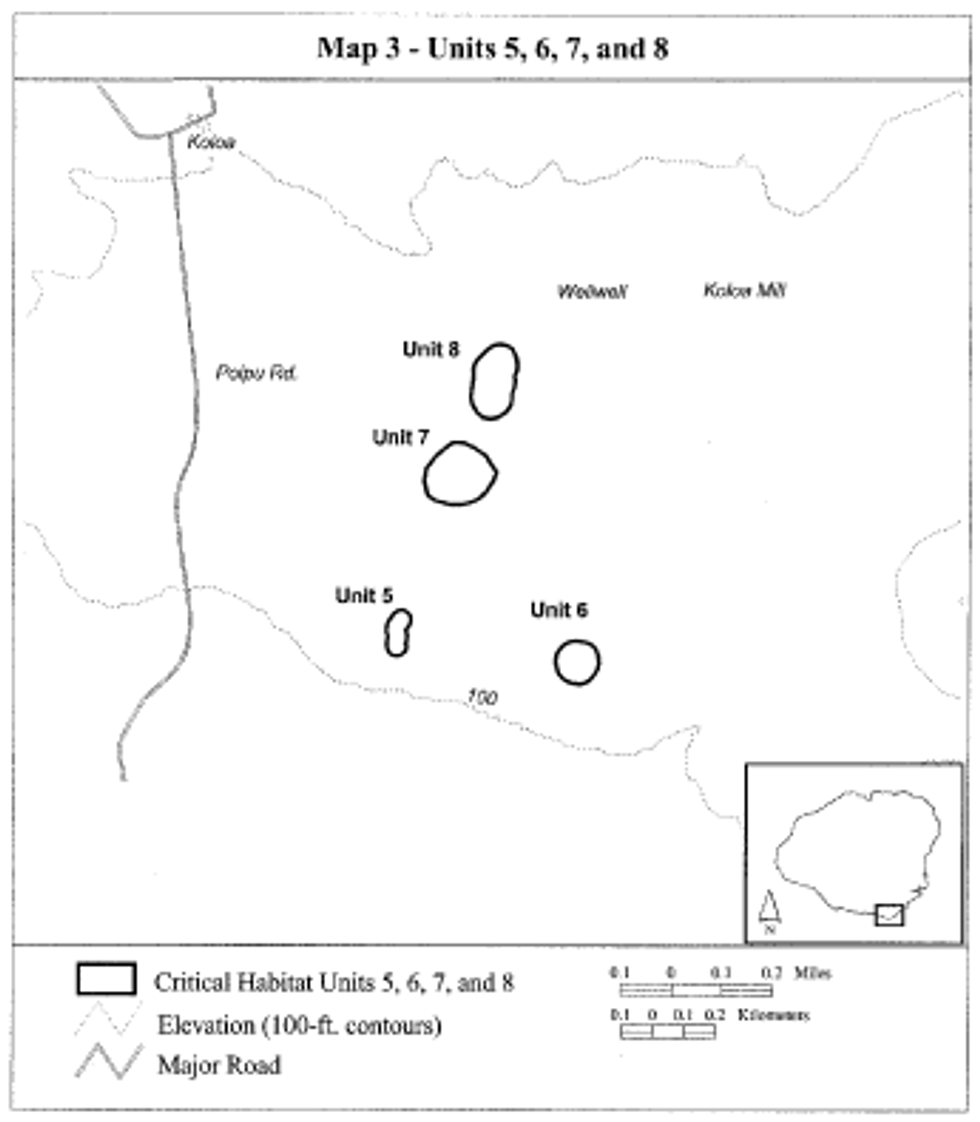
(14) Unit 9 - (1 ha (4 ac)):
(i) Unit 9 consists of the following 5 boundary points with the following coordinates in UTM Zone 4, with the units in meters using North American Datum of 1983 (NAD83): Start at 452568, 2422604; 452577, 2422610; 452696, 2422521; 452580, 2422429; 452537, 2422471; return to starting point.
(ii) Note: Unit 9 is depicted on Map 4 - Units 9 and 10 - below.
(15) Unit 10 - (14 ha (35 ac)):
(i) Unit 10 consists of the following 14 boundary points with the following coordinates in UTM Zone 4, with the units in meters using North American Datum of 1983 (NAD83): Start at 452688, 2421988; 452834, 2422427; 453145, 2422210; 453061, 2422147; 453053, 2422133; 453053, 2422102; 453061, 2422078; 453074, 2422029; 453002, 2421944; 453015, 2421922; 453022, 2421892; 452896, 2421910; 452733, 2421917; 452705, 2421959; return to starting point.
(ii) Note: Unit 10 is depicted on Map 4 - Units 9 and 10 - which follows:
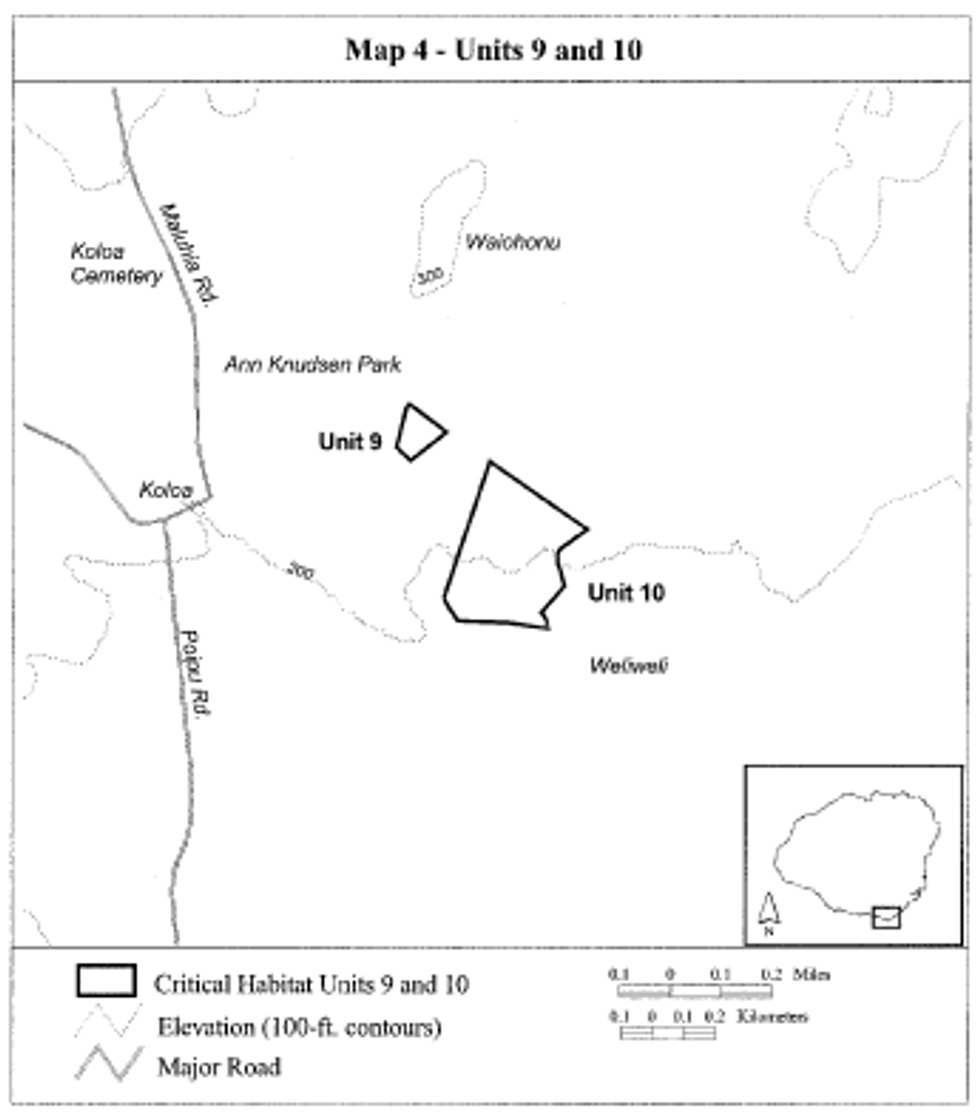
(16) Unit 11 - (4 ha (10 ac)):
(i) Unit 11 consists of the following 17 boundary points with the following coordinates in UTM Zone 4, with the units in meters using North American Datum of 1983 (NAD83): Start at 453958, 2419773; 453976, 2419766; 453999, 2419741; 454054, 2419702; 454068, 2419667; 454060, 2419596; 454042, 2419553; 454005, 2419528; 453962, 2419521; 453894, 2419545; 453872, 2419573; 453862, 2419600; 453852, 2419642; 453862, 2419676; 453887, 2419718; 453912, 2419742; 453936, 2419768; return to starting point.
(ii) Note: Unit 11 is depicted on Map 5 - Units 11 and 12 - below.
(17) Unit 12 (6 ha (16 ac)):
(i) Unit 12 consists of the following 21 boundary points with the following coordinates in UTM Zone 4, with the units in meters using North American Datum of 1983 (NAD83): Start at 454185, 2420229; 454242, 2420243; 454326, 2420241; 454387, 2420207; 454420, 2420147; 454475, 2420133; 454502, 2420080; 454474, 2420055; 454366, 2419954; 454341, 2419944; 454321, 2419921; 454311, 2419895; 454286, 2419903; 454264, 2419927; 454229, 2419962; 454208, 2419993; 454186, 2420038; 454169, 2420058; 454145, 2420086; 454112, 2420103; 454120, 2420133; return to starting point.
(ii) Note: Unit 12 is depicted on Map 5 - Units 11 and 12 - which follows:
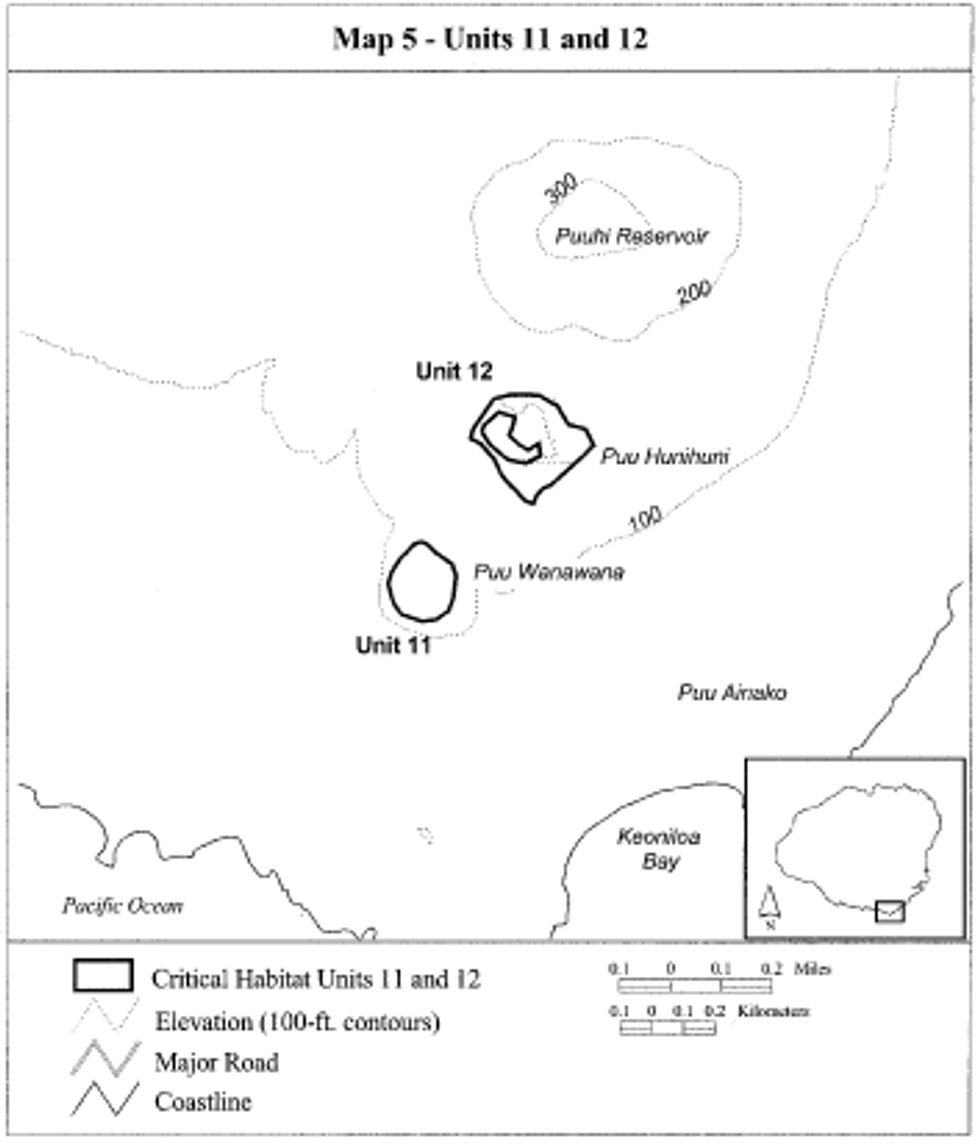
(18) Unit 13 - (21 ha (52 ac)):
(i) Unit 13 consists of the following 43 boundary points with the following coordinates in UTM Zone 4, with the units in meters using North American Datum of 1983 (NAD83): Start at 457108, 2420666; 457027, 2420606; 456763, 2420391; 456727, 2419912; 456456, 2419772; 455868, 2419764; 455633, 2419645; 455601, 2419531; 455389, 2419219; 455225, 2419029; 455014, 2418947; 455014, 2419015; 454926, 2419043; 455027, 2419064; 455102, 2419103; 455202, 2419192; 455255, 2419258; 455300, 2419334; 455508, 2419515; 455586, 2419614; 455664, 2419674; 455767, 2419730; 455859, 2419764; 455969, 2419780; 456212, 2419805; 456272, 2419811; 456376, 2419831; 456451, 2419859; 456531, 2419900; 456583, 2419935; 456627, 2419981; 456656, 2420036; 456682, 2420173; 456709, 2420316; 456718, 2420343; 456704, 2420433; 456723, 2420583; 456747, 2420580; 456771, 2420584; 456786, 2420569; 456848, 2420572; 456979, 2420634; 457022, 2420649; return to starting point.
(ii) Note: Unit 13 is depicted on Map 6 - Unit 13 - which follows:
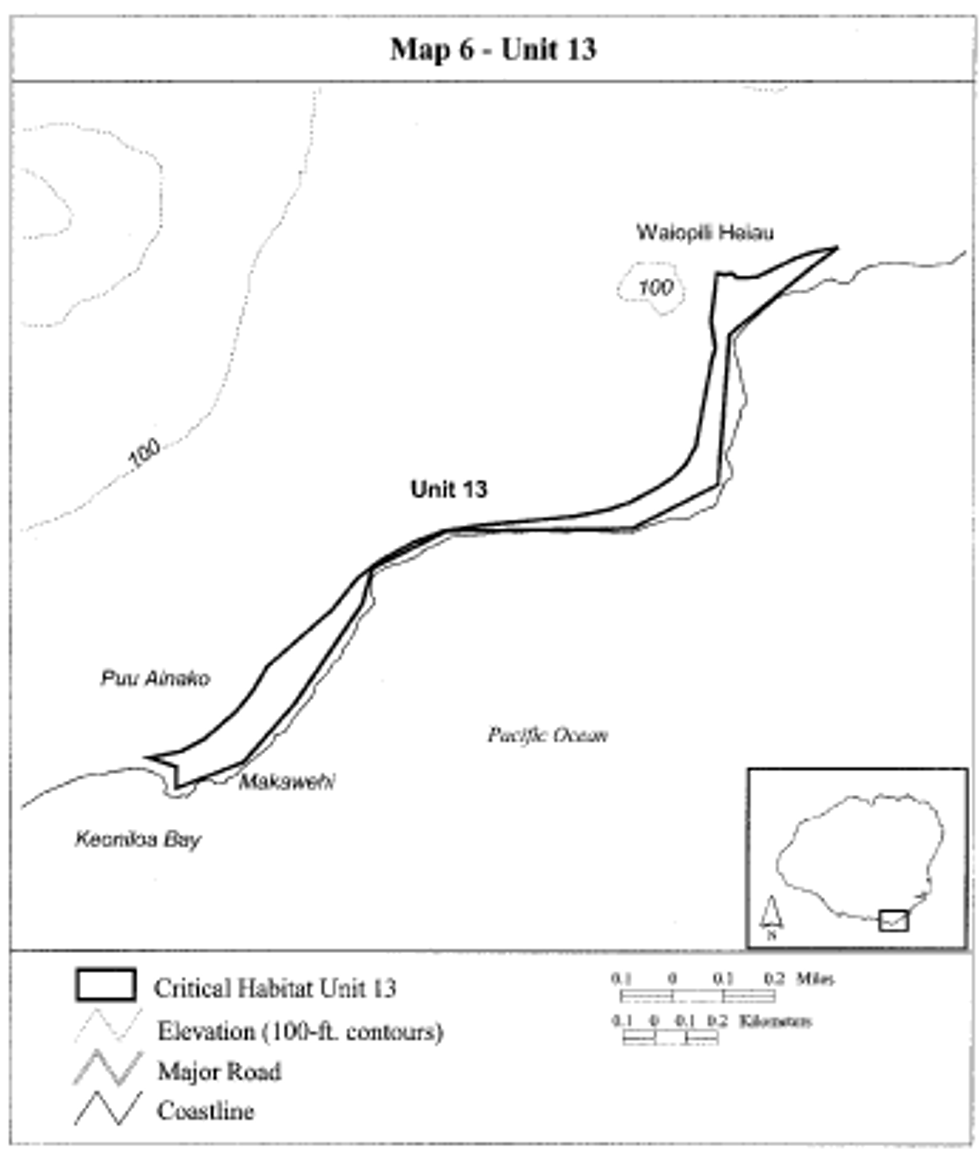
(19) Unit 14 - (39 ha (96 ac)):
(i) Unit 14 consists of the following 47 boundary points with the following coordinates in UTM Zone 4, with the units in meters using North American Datum of 1983 (NAD83): Coastline. 457575, 2420977; 457548, 2420981; 457598, 2421002; 457624, 2421039; 457624, 2421039; 457624, 2421039; 457664, 2421105; 457715, 2421146; 457755, 2421170; 457901, 2421204; 458025, 2421342; 458025, 2421367; 458078, 2421412; 458078, 2421413; 458078, 2421413; 458184, 2421510; 458226, 2421607; 458226, 2421607; 458226, 2421607; 458259, 2421727; 458308, 2421809; 458371, 2421876; 458405, 2421905; 458237, 2422080; 458301, 2422271; 458346, 2422339; 458686, 2422403; 458785, 2422371; 458932, 2422252; 458997, 2422153; Coastline. 458706, 2421920; 458670, 2421988; 458662, 2422059; 458688, 2422116; 458778, 2422112; 458809, 2422160; 458719, 2422266; 458630, 2422266; 458556, 2422191; 458563, 2422061; 458479, 2421989; 458500, 2421803.
(ii) Note: Unit 14 is depicted on Map 7 - Unit 14 - which follows:
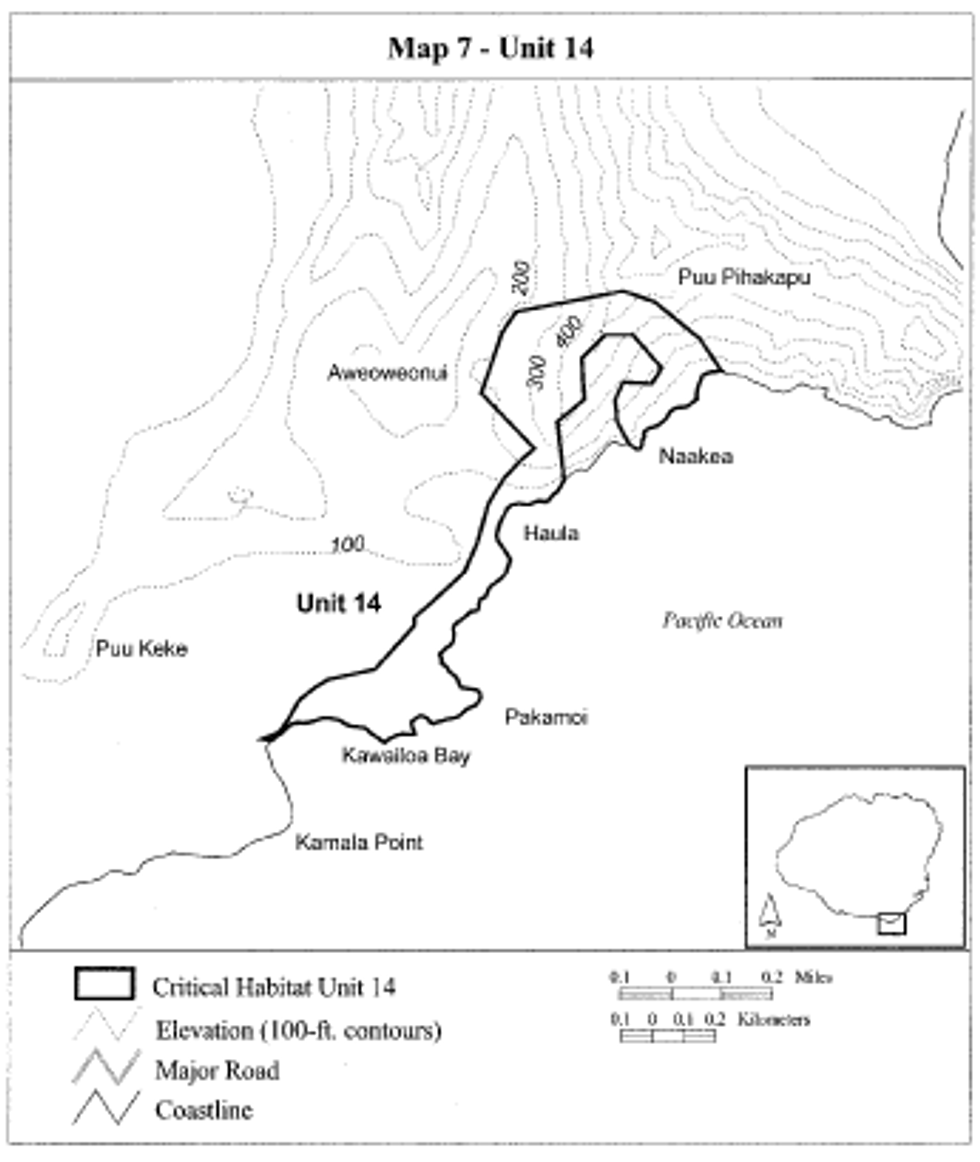
Noel's amphipod (Gammarus desperatus)
(1) Critical habitat units are depicted for Chaves County, New Mexico, on the maps below.
(2) The primary constituent element of critical habitat for Noel's amphipod is springs and spring-fed wetland systems that:
(i) Have permanent, flowing water with no or no more than low levels of pollutants;
(ii) Have slow to moderate water velocities;
(iii) Have substrates including limestone cobble and aquatic vegetation;
(iv) Have stable water levels with natural diurnal (daily) and seasonal variations;
(v) Consist of fresh to moderately saline water;
(vi) Have minimal sedimentation;
(vii) Vary in temperature between 50-68°F (10-20°C) with natural seasonal and diurnal variations slightly above and below that range; and
(viii) Provide abundant food, consisting of:
(A) Submergent vegetation and decaying organic matter;
(B) A surface film of algae, diatoms, bacteria, and fungi; and
(C) Microbial foods, such as algae and bacteria, associated with aquatic plants, algae, bacteria, and decaying organic material.
(3) Critical habitat does not include manmade structures (such as buildings, aqueducts, runways, roads, and other paved areas) and the land on which they are located existing within the legal boundaries on the effective date of this rule.
(4) Critical habitat map units. Data layers defining map units were created on a base of USGS 1:24,000 maps, and critical habitat units were then mapped using Universal Transverse Mercator (UTM) coordinates.
(5) Unit 1: Sago/Bitter Creek Complex, Chaves County, New Mexico.
(i) [Reserved]
(ii) Map of Noel's Amphipod Critical Habitat Units 1 and 2a follows:
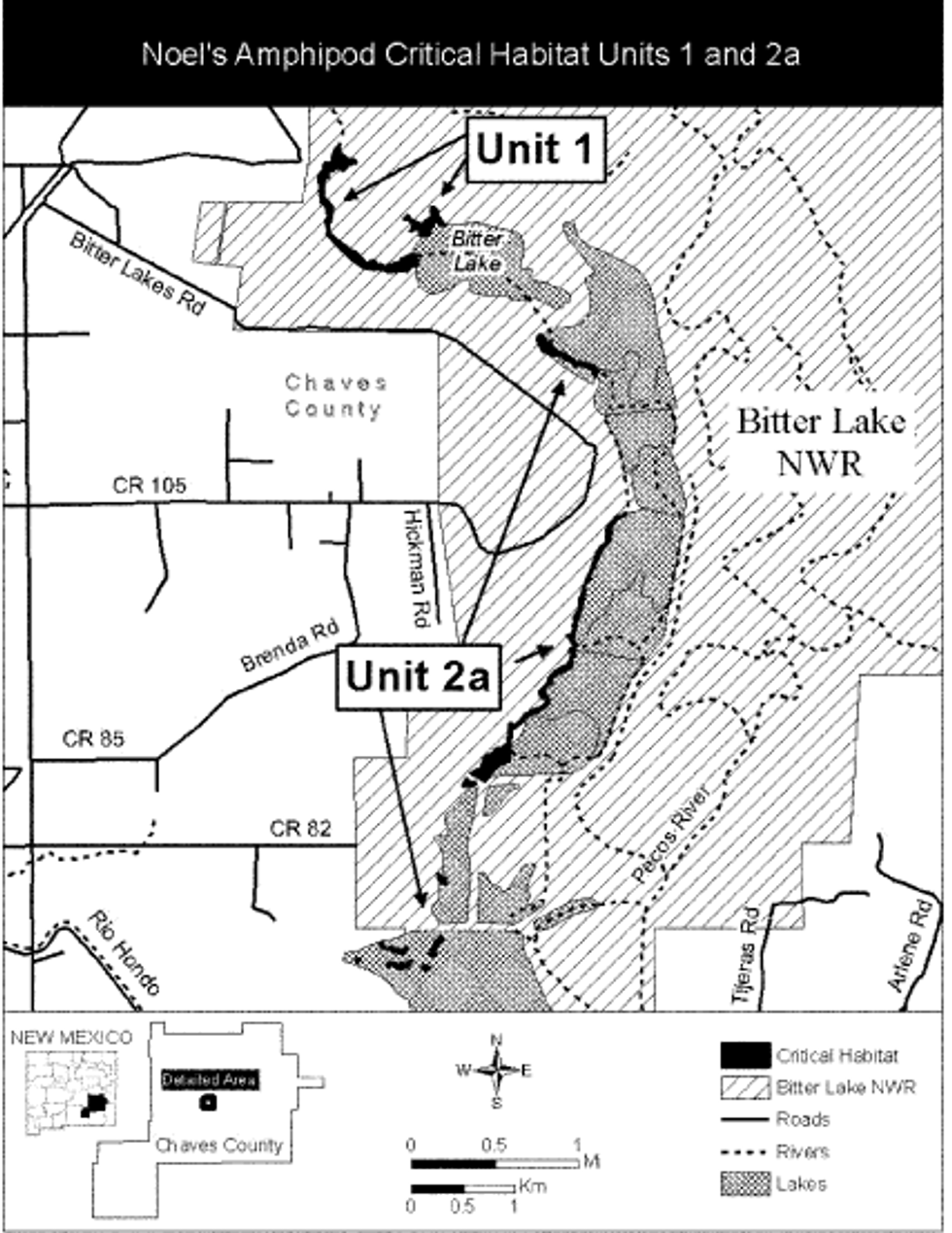
(6) Unit 2a: Springsnail/Amphipod Impoundment Complex, Chaves County, New Mexico.
(i) [Reserved]
(ii) Map of Unit 2a for Noel's amphipod is provided at paragraph (5)(ii) of this entry.
(7) Unit 3: Rio Hondo, Chaves County, New Mexico.
(i) [Reserved]
(ii) Map of Noel's Amphipod Critical Habitat Unit 3 follows:
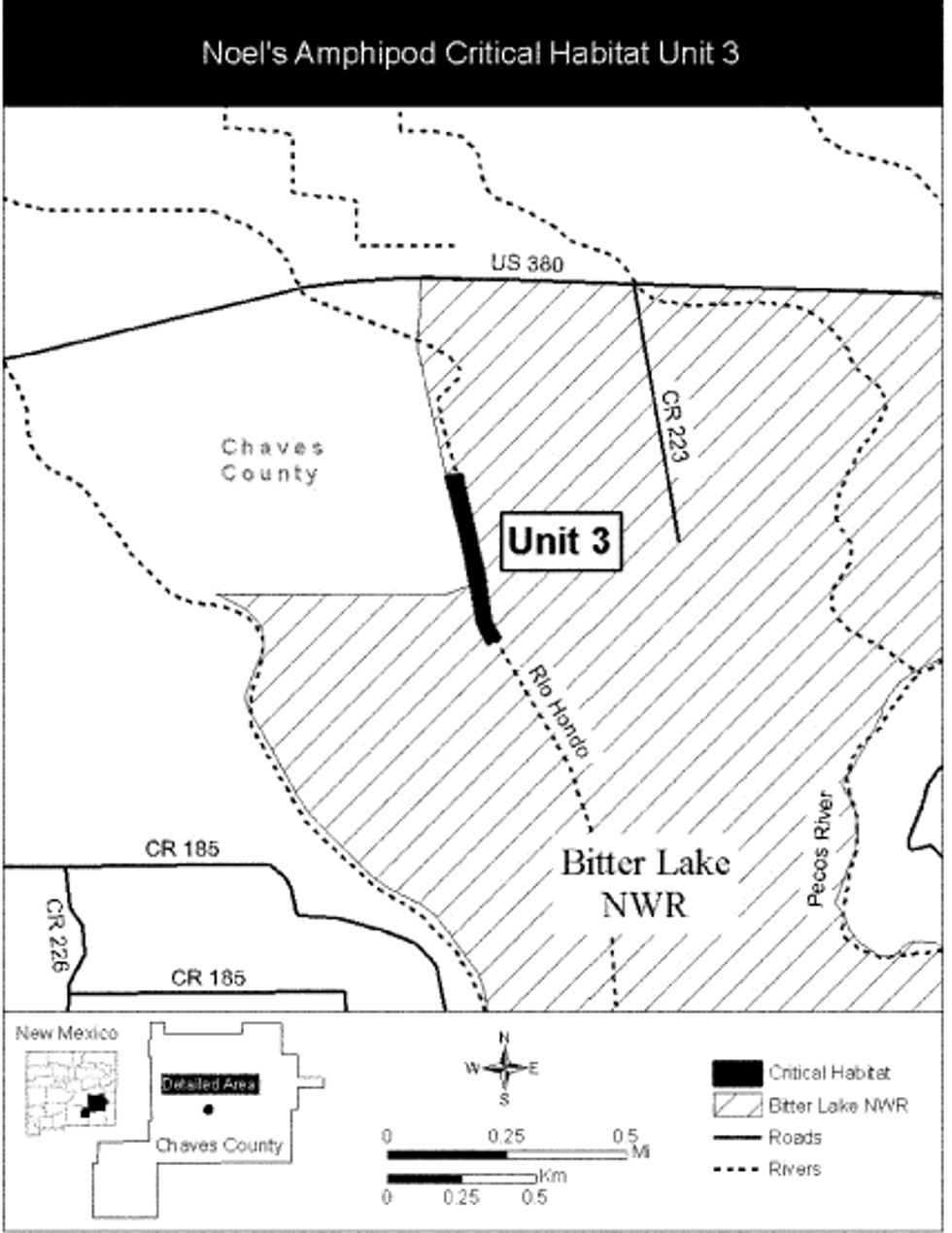
Peck's Cave Amphipod (Stygobromus pecki)
(1) Critical habitat units are depicted for this species in Comal County, Texas, on the maps below.
(2) Within these areas, the primary constituent elements of the physical or biological features essential to the conservation of Peck's cave amphipod consist of these components:
(i) Springs, associated streams, and underground spaces immediately inside of or adjacent to springs, seeps, and upwellings that include:
(A) High-quality water with no or minimal pollutant levels of soaps, detergents, heavy metals, pesticides, fertilizer nutrients, petroleum hydrocarbons, and semivolatile compounds such as industrial cleaning agents; and
(B) Hydrologic regimes similar to the historical pattern of the specific sites, with continuous surface flow from the spring sites and in the subterranean aquifer;
(ii) Spring system water temperatures that range from approximately 68 to 75°F (20 to 24°C); and
(iii) Food supply that includes, but is not limited to, detritus (decomposed materials), leaf litter, living plant material, algae, fungi, bacteria, other microorganisms, and decaying roots.
(3) Critical habitat does not include manmade structures (such as buildings, aqueducts, runways, roads, and other paved areas) and the land on which they are located existing on the surface within the legal boundaries on November 22, 2013.
(4) Critical habitat map units. Data layers defining map units were created using geographic information systems (GIS), which included species locations, roads, property boundaries, 2011 aerial photography, and USGS 7.5′ quadrangles. Points were placed in the GIS. The maps in this entry, as modified by any accompanying regulatory text, establish the boundaries of the critical habitat designation. The coordinates or plot points or both on which each map is based are available to the public at the Service's Internet site at http://www.fws.gov/southwest/es/austintexas/, at http://www.regulations.gov at Docket No. FWS-R2-ES-2012-0082, and at the field office responsible for this critical habitat designation. You may obtain field office location information by contacting one of the Service regional offices, the addresses of which are listed at 50 CFR 2.2.
(5) The index map of the critical habitat units for the Peck's cave amphipod follows:
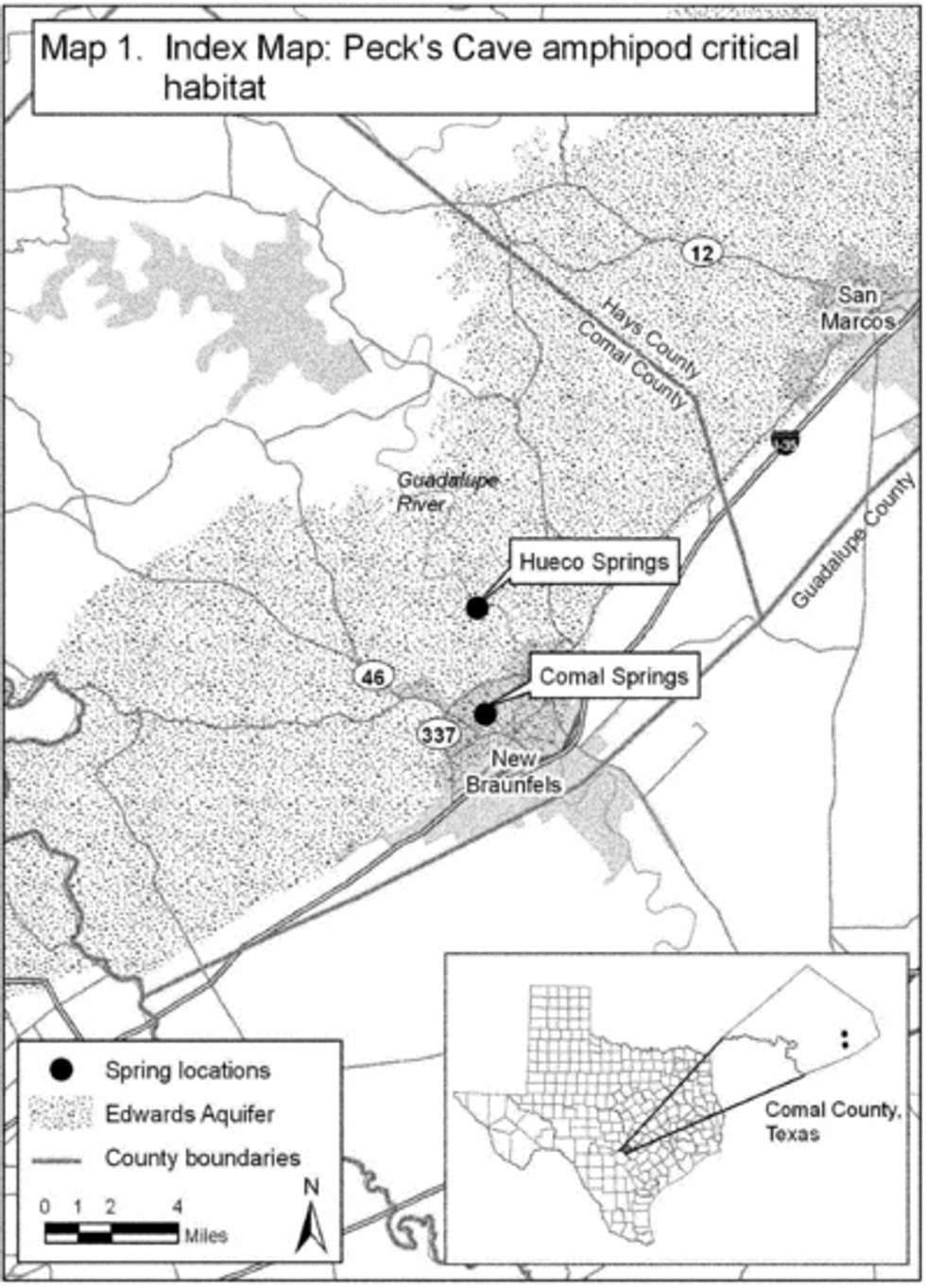
(6) Unit 1: Comal Springs Unit, Comal County, Texas. Map of the Comal Springs Unit follows:
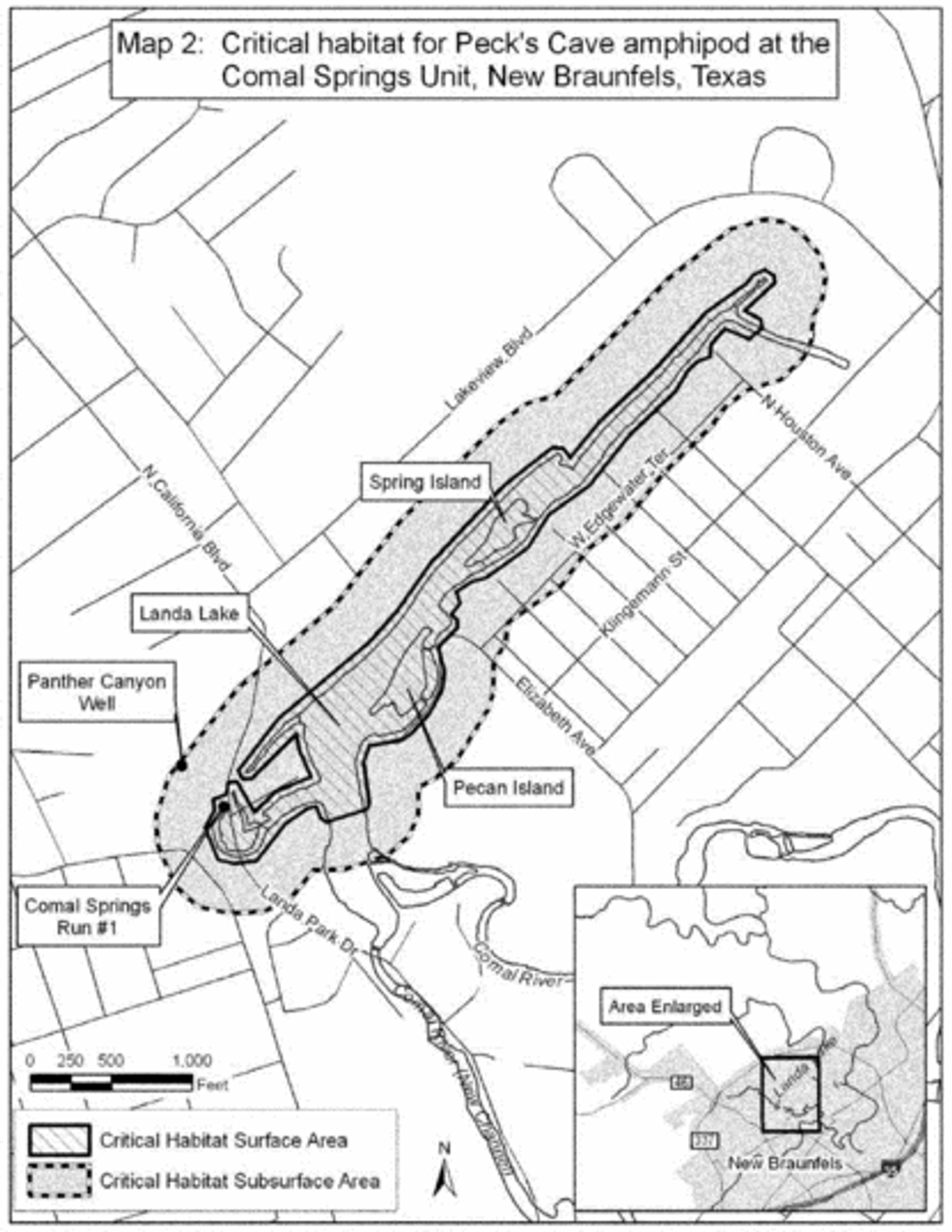
(7) Unit 2: Hueco Springs Unit, Comal County, Texas. Map of the Hueco Springs Unit follows:
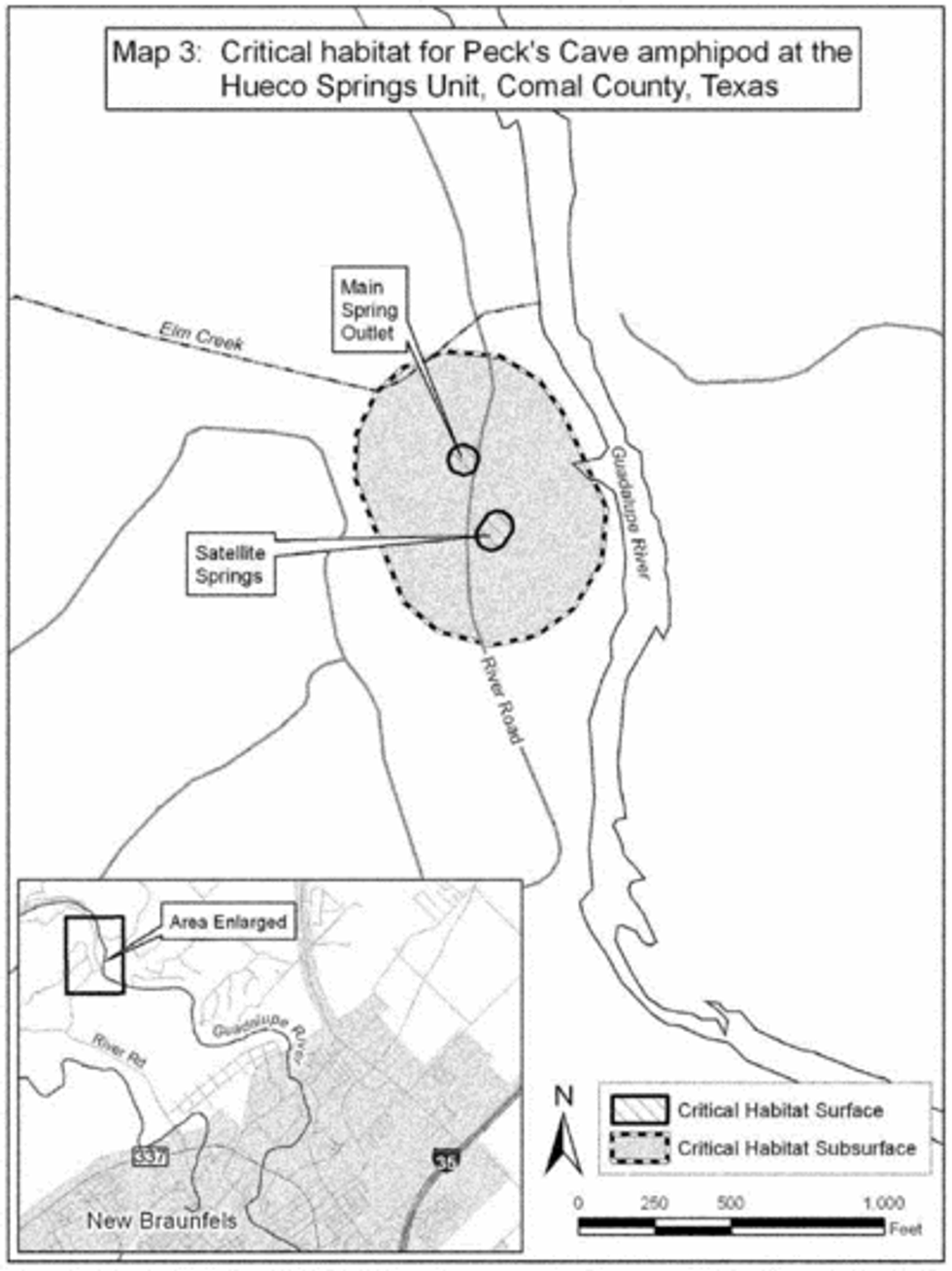
Pecos amphipod (Gammarus pecos)
(1) The critical habitat unit is depicted for Pecos County, Texas, on the map below.
(2) Within this area, the primary constituent elements of the physical or biological features essential to the conservation of Pecos amphipod are springs and spring-fed aquatic systems that contain:
(i) Permanent, flowing, unpolluted water (free from contamination) emerging from the ground and flowing on the surface;
(ii) Water temperatures that vary between 11 and 27°C (52 to 81°F) with natural seasonal and diurnal variations slightly above and below that range;
(iii) Substrates that include cobble, gravel, pebble, sand, silt, and aquatic vegetation, for breeding, maturing, feeding, and escape from predators;
(iv) Abundant food, consisting of algae, bacteria, decaying organic material, and submergent vegetation that contributes the necessary nutrients, detritus, and bacteria on which these species forage; and
(v) Either an absence of nonnative predators and competitors or nonnative predators and competitors at low population levels.
(3) Critical habitat does not include manmade structures (such as buildings, aqueducts, oil and gas well pads, roads, and other paved areas) and the land on which they are located existing within the legal boundaries on the effective date of this rule.
(4) Critical habitat map units. Data layers defining map units were created on 2010 aerial photography from U.S. Department of Agriculture, National Agriculture Imagery Program base maps using ArcMap (Environmental Systems Research Institute, Inc.), a computer geographic information system (GIS) program. The maps in this entry, as modified by any accompanying regulatory text, establish the boundaries of the critical habitat designation. The coordinates or plot points or both on which each map is based are available to the public on the internet at http://www.regulations.gov at Docket No. FWS-R2-ES-2013-0004 and at the field office responsible for this designation. You may obtain field office location information by contacting one of the Service regional offices, the addresses of which are listed at 50 CFR 2.2.
(5) Diamond Y Spring Unit, Pecos County, Texas. Map of Diamond Y Spring Unit follows:
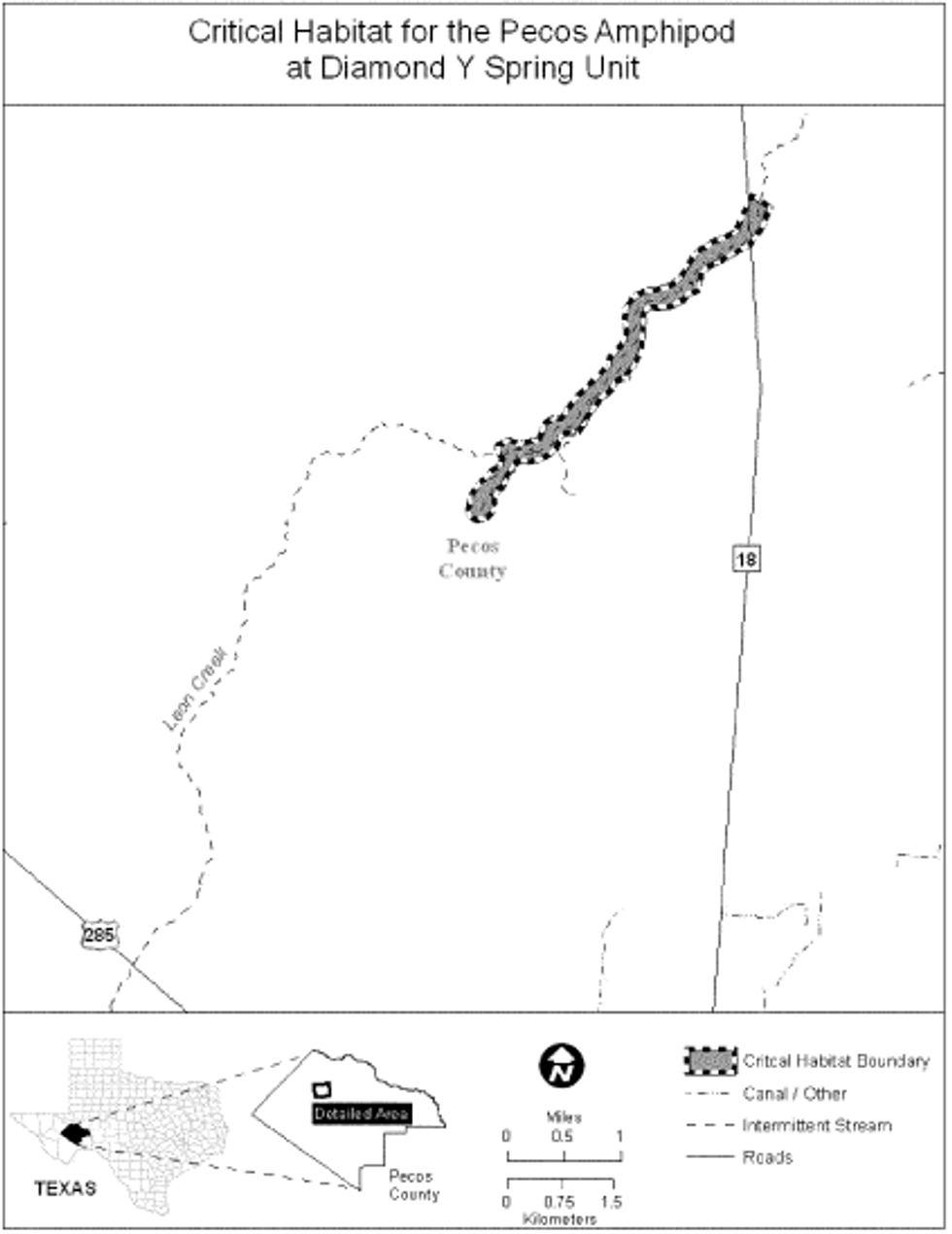
Big Creek Crayfish (Faxonius peruncus)
(1) The critical habitat unit is depicted for Iron, Madison, St. Francois, Washington, and Wayne Counties in Missouri, on the map in this entry.
(2) Within the critical habitat unit, the physical or biological features essential to the conservation of the Big Creek crayfish consist of the following components:
(i) Stream flow velocity generally between 0 and 1.1 feet per second (ft/s) (0 and 0.35 meters per second (m/s)).
(ii) Stream depths generally between 0.2 and 1.6 feet (0.06 and 0.49 meters).
(iii) Water temperatures between 34 and 84°F (1.1 and 28.9°C).
(iv) Adequately low stream embeddedness so that spaces under rocks and cavities in gravel remain available to the Big Creek crayfish.
(v) An available forage and prey base consisting of invertebrates, periphyton, and plant detritus.
(vi) Connectivity among occupied stream reaches of the Big Creek crayfish (both within and among occupied subwatersheds).
(vii) Adequately low ratios or densities of nonnative species that allow for maintaining populations of the Big Creek crayfish.
(3) Critical habitat does not include manmade structures (such as buildings, aqueducts, runways, roads, and other paved areas) and the land on which they are located existing within the legal boundaries on May 30, 2023.
(4) The National Hydrography Dataset Plus (NHD Plus) was the geospatial data used to delineate critical habitat. NHD Plus is a national geospatial surface water framework that integrates the National Hydrography Dataset with the National Elevation Dataset and the Watershed Boundary Dataset. NHD Plus uses medium resolution (1:100,000-scale) data with a geographic projection and NAD83 datum. Critical habitat was delineated by including all streams within subwatersheds (at the 12-digit hydrologic unit level) occupied by the Big Creek crayfish. Occupied watersheds were defined using data from the Missouri Department of Conservation; the entire St. Francis River upstream of 37.091254N, 90.447212W is also considered occupied as a migratory route. The map in this entry, as modified by any accompanying regulatory text, establishes the boundaries of the critical habitat designation. The coordinates or plot points or both on which the map is based are available to the public at https://www.regulations.gov under Docket No. FWS–R3–ES–2019–0020 and at the Missouri Ecological Services Field Office. You may obtain field office location information by contacting one of the Service regional offices, the addresses of which are listed at 50 CFR 2.2.
(5) Big Creek Crayfish Unit—Iron, Madison, St. Francois, Washington, and Wayne Counties, Missouri.
(i) The unit consists of all of the streams (approximately 1,069 river miles (1,720 kilometers)) upstream of Wappapello Dam in the following subwatersheds (numbers in parentheses represent the 12-digit hydrologic codes): Big Lake Creek-St. Francis River (080202020503), Blankshire Branch-St. Francis River (080202020204), Captain Creek-St. Francis River (080202020405), Cedar Bottom Creek-St. Francis River (080202020402), Clark Creek (080202020407), Cedar Bottom Creek (080202020501), Crane Pond Creek (080202020303), Headwaters St. Francis River (080202020201), Headwaters Twelvemile Creek (080202020403), Leatherwood Creek-St. Francis River (080202020406), Lower Big Creek (080202020304), Middle Big Creek (080202020302), Saline Creek-Little St. Francis River (080202020102), Turkey Creek-St. Francis River (080202020210), Twelvemile Creek (080202020404), and Upper Big Creek (080202020301). The unit also consists of the entire St. Francis River upstream of 37.091254N, 90.447212W. The unit does not include any areas of adjacent land. This unit includes stream habitat up to bank full height.
(ii) Map of Big Creek Crayfish Unit of Big Creek crayfish critical habitat follows:
Figure 1 for Big Creek Crayfish (Faxonius peruncus) paragraph (5)(ii)
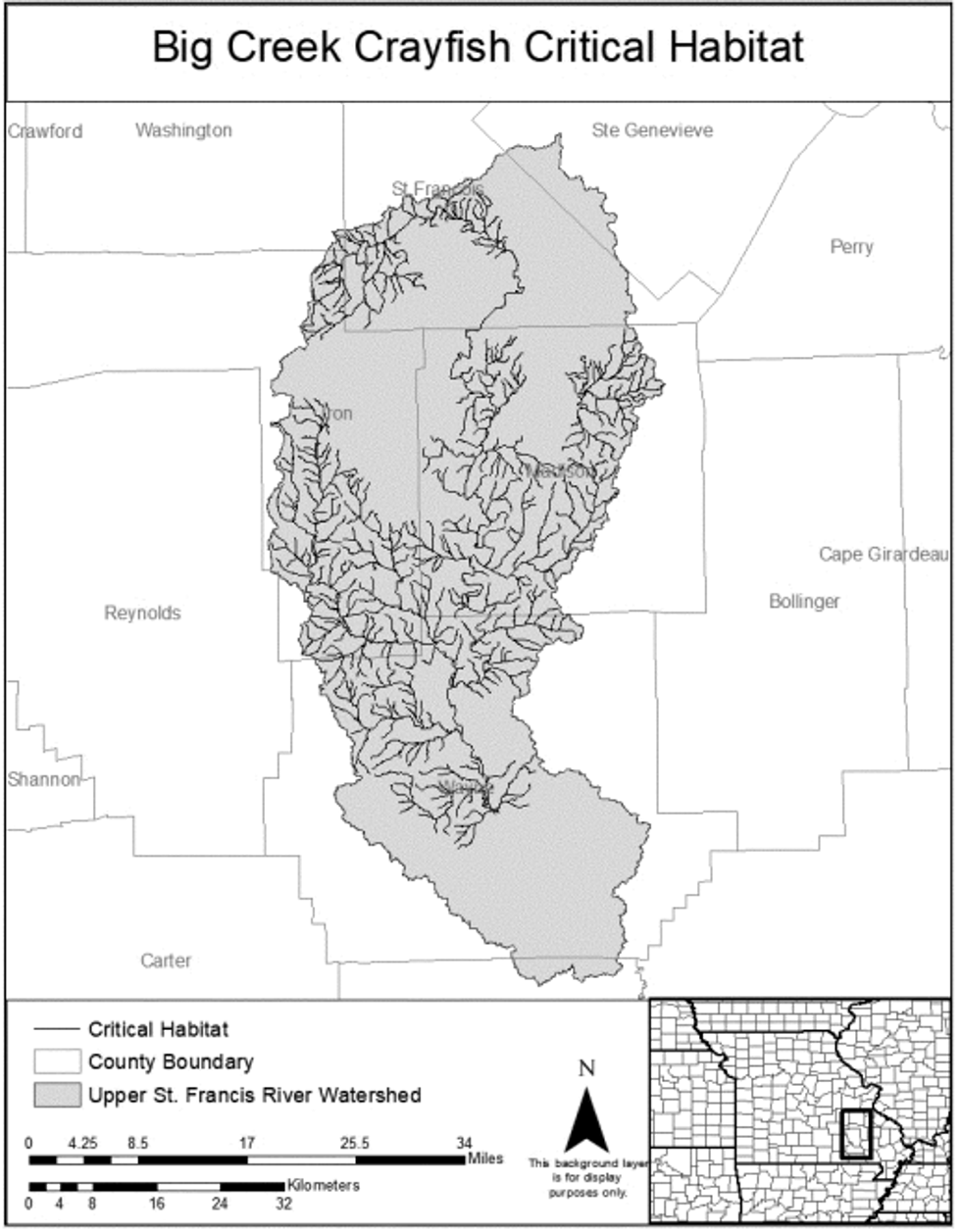
Big Sandy Crayfish (Cambarus callainus)
(1) Critical habitat units are depicted for Martin, Pike, Johnson, and Floyd Counties, Kentucky; Buchanan, Dickenson, and Wise Counties, Virginia; and McDowell, Mingo, and Wayne Counties, West Virginia, on the maps in this entry.
(2) Within these areas, the physical or biological features essential to the conservation of the Big Sandy crayfish consist of the following components:
(i) Fast-flowing stream reaches with unembedded slab boulders, cobbles, or isolated boulder clusters within an unobstructed stream continuum (i.e., riffle, run, pool complexes) of permanent, moderate- to large-sized (generally third order and larger) streams and rivers (up to the ordinary high water mark as defined at 33 CFR 329.11).
(ii) Streams and rivers with natural variations in flow and seasonal flooding sufficient to effectively transport sediment and prevent substrate embeddedness.
(iii) Water quality characterized by seasonally moderated temperatures and physical and chemical parameters (e.g., pH, conductivity, dissolved oxygen) sufficient for the normal behavior, growth, reproduction, and viability of all life stages of the species.
(iv) An adequate food base, indicated by a healthy aquatic community structure including native benthic macroinvertebrates and fishes, and plant matter (e.g., leaf litter, algae, detritus).
(v) Aquatic habitats protected from riparian and instream activities that degrade the physical and biological features described in paragraphs (2)(i) through (iv) of this entry or cause physical (e.g., crushing) injury or death to individual Big Sandy crayfish.
(vi) An interconnected network of streams and rivers that have the physical and biological features described in paragraphs (2)(i) through (iv) of this entry and that allow for the movement of individual crayfish in response to environmental, physiological, or behavioral drivers. The scale of the interconnected stream network should be sufficient to allow for gene flow within and among watersheds.
(3) Critical habitat does not include manmade structures (such as buildings, aqueducts, runways, roads, and other paved areas) and the land on which they are located existing within the legal boundaries on April 14, 2022.
(4) Data layers defining map units were created on a base of U.S. Geological Survey digital ortho-photo quarter-quadrangles, and critical habitat units were then mapped using Universal Transverse Mercator (UTM) Zone 15N coordinates. ESRI's ArcGIS 10.0 software was used to determine latitude and longitude coordinates using decimal degrees. The USA Topo ESRI online basemap service was referenced to identify features (like roads and streams) used to delineate the upstream and downstream extents of critical habitat units. The maps in this entry, as modified by any accompanying regulatory text, establish the boundaries of the critical habitat designation. The coordinates or plot points or both on which each map is based are available to the public at the Service's internet site at https://www.fws.gov/westvirginiafieldoffice/, at https://www.regulations.gov at Docket No. FWS-R5-ES-2019-0098, and at the field office responsible for this designation. You may obtain field office location information by contacting one of the Service regional offices, the addresses of which are listed at 50 CFR 2.2.
(5) Index map of critical habitat Units 1 and 2 for the Big Sandy crayfish follows:
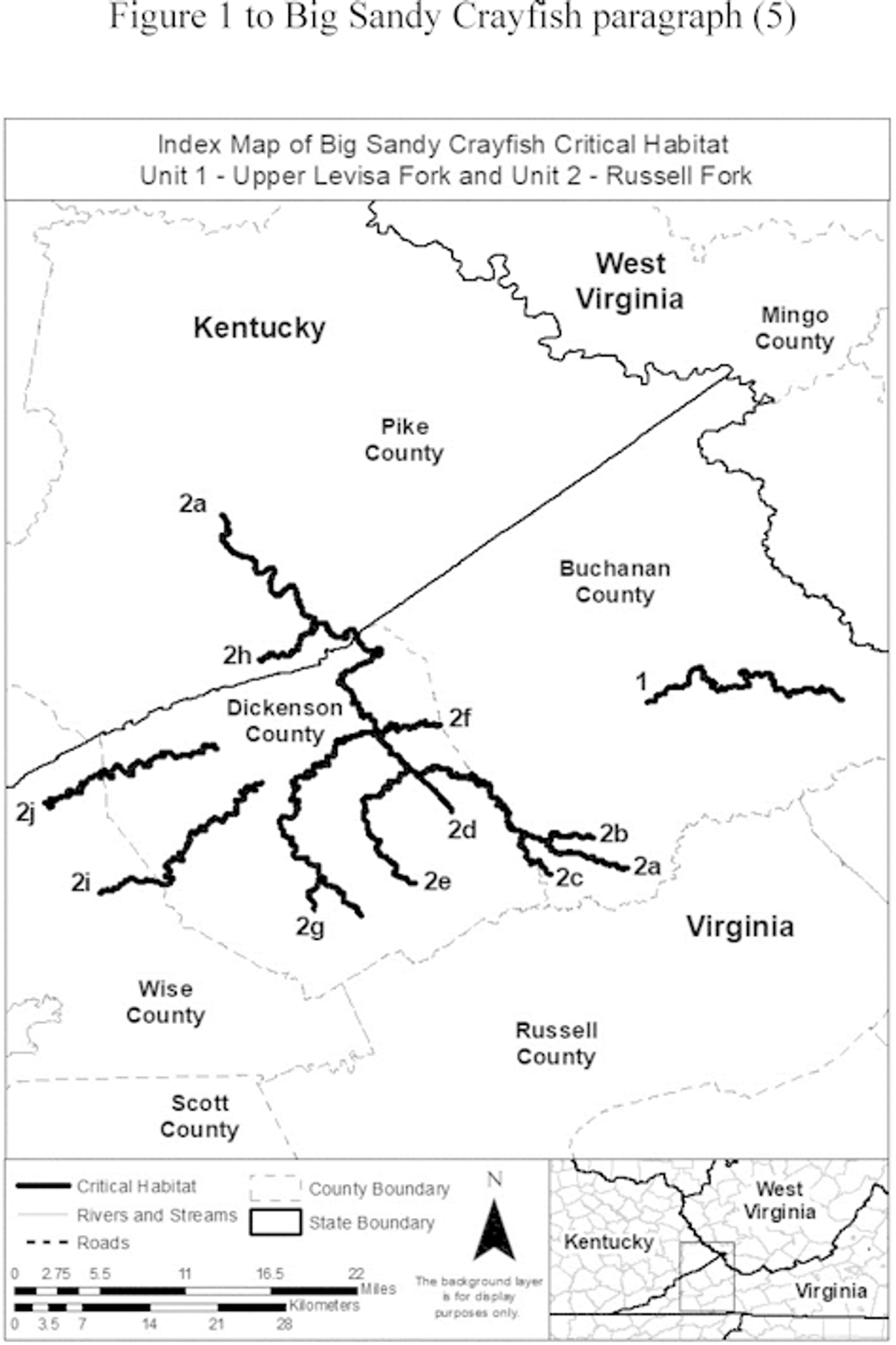
(6) Unit 1: Upper Levisa Fork—Dismal Creek, Buchanan County, Virginia.
(i) Unit 1 includes approximately 29.2 stream kilometers (skm) (18.1 smi) of Dismal Creek from its confluence with Laurel Fork downstream to its confluence with Levisa Fork in Buchanan County, Virginia.
(ii) Map of Unit 1 follows:
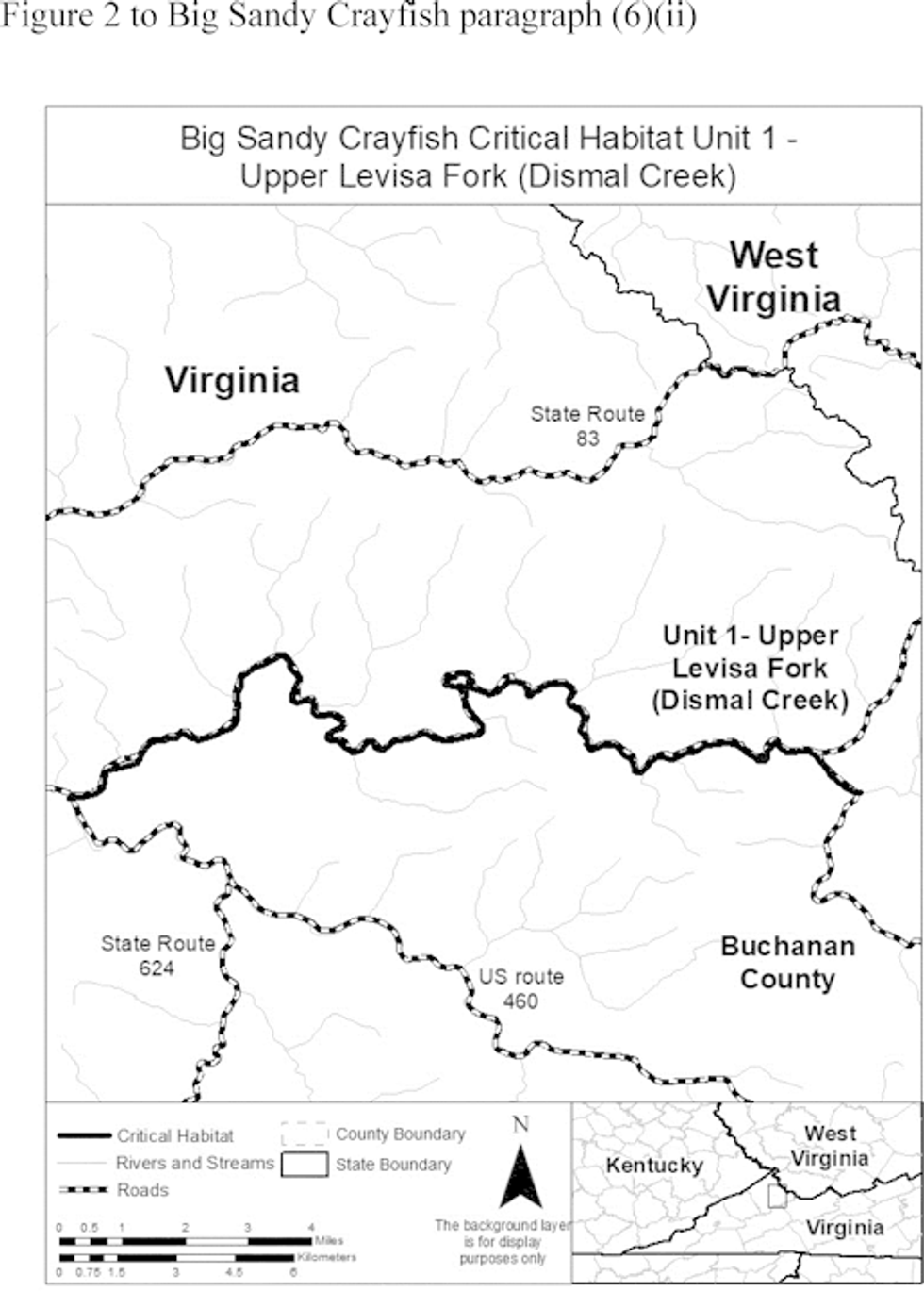
(7) Unit 2: Russell Fork—Buchanan, Dickenson, and Wise Counties, Virginia, and Pike County, Kentucky.
(i) Subunit 2a: Russell Fork, Buchanan and Dickenson Counties, Virginia, and Pike County, Kentucky.
(A) Subunit 2a consists of approximately 83.8 skm (52.1 smi) of Russell Fork from its confluence with Ball Creek at Council, Virginia, downstream to its confluence with Levisa Fork at Levisa Junction, Kentucky.
(B) Map of Subunit 2a follows:
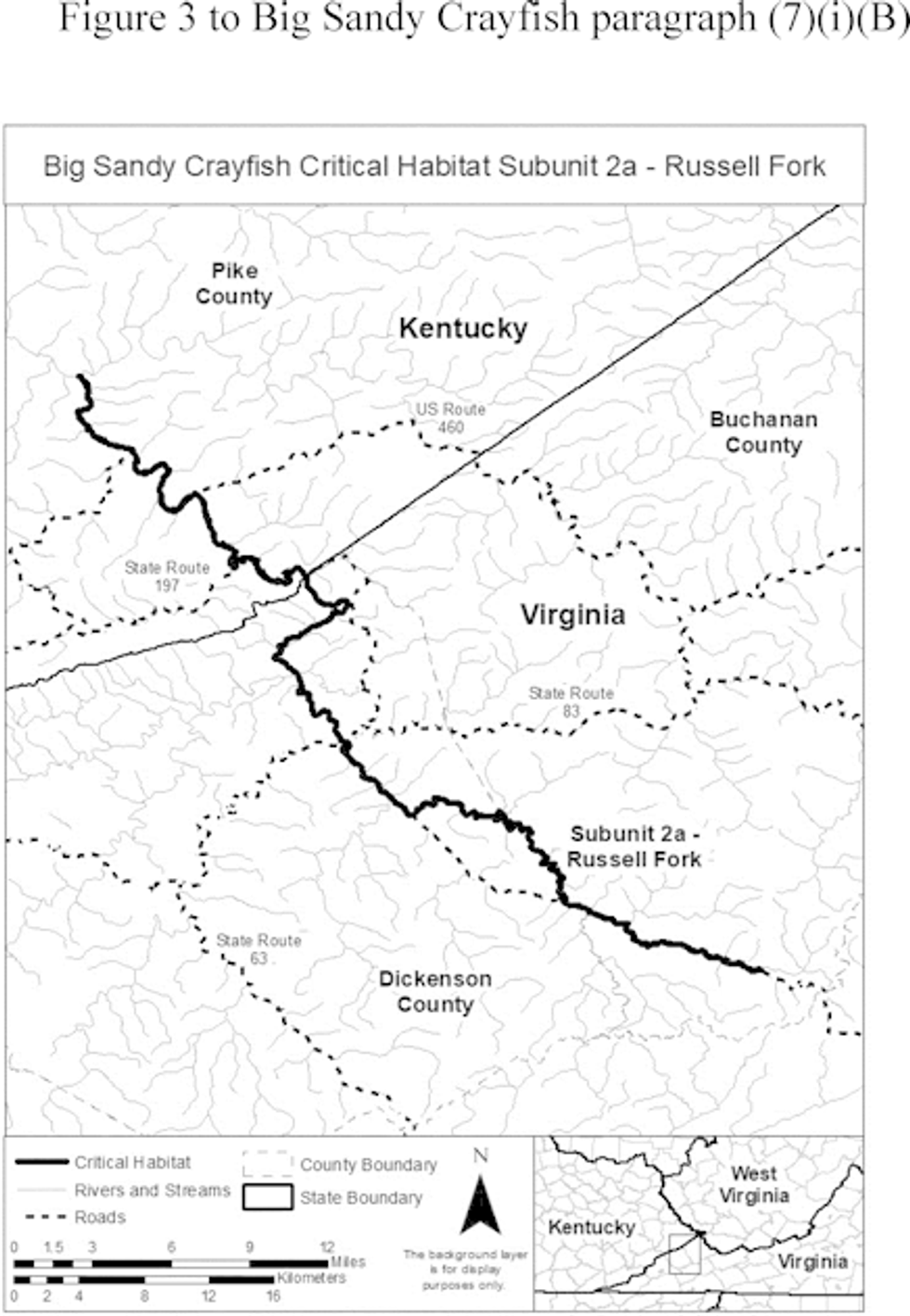
(ii) Subunit 2b: Hurricane Creek, Buchanan County, Virginia.
(A) Subunit 2b consists of approximately 5.9 skm (3.7 smi) of Hurricane Creek from its confluence with Gilbert Fork downstream to its confluence with Russell Fork at Davenport, Virginia.
(B) Map of Subunit 2b follows:
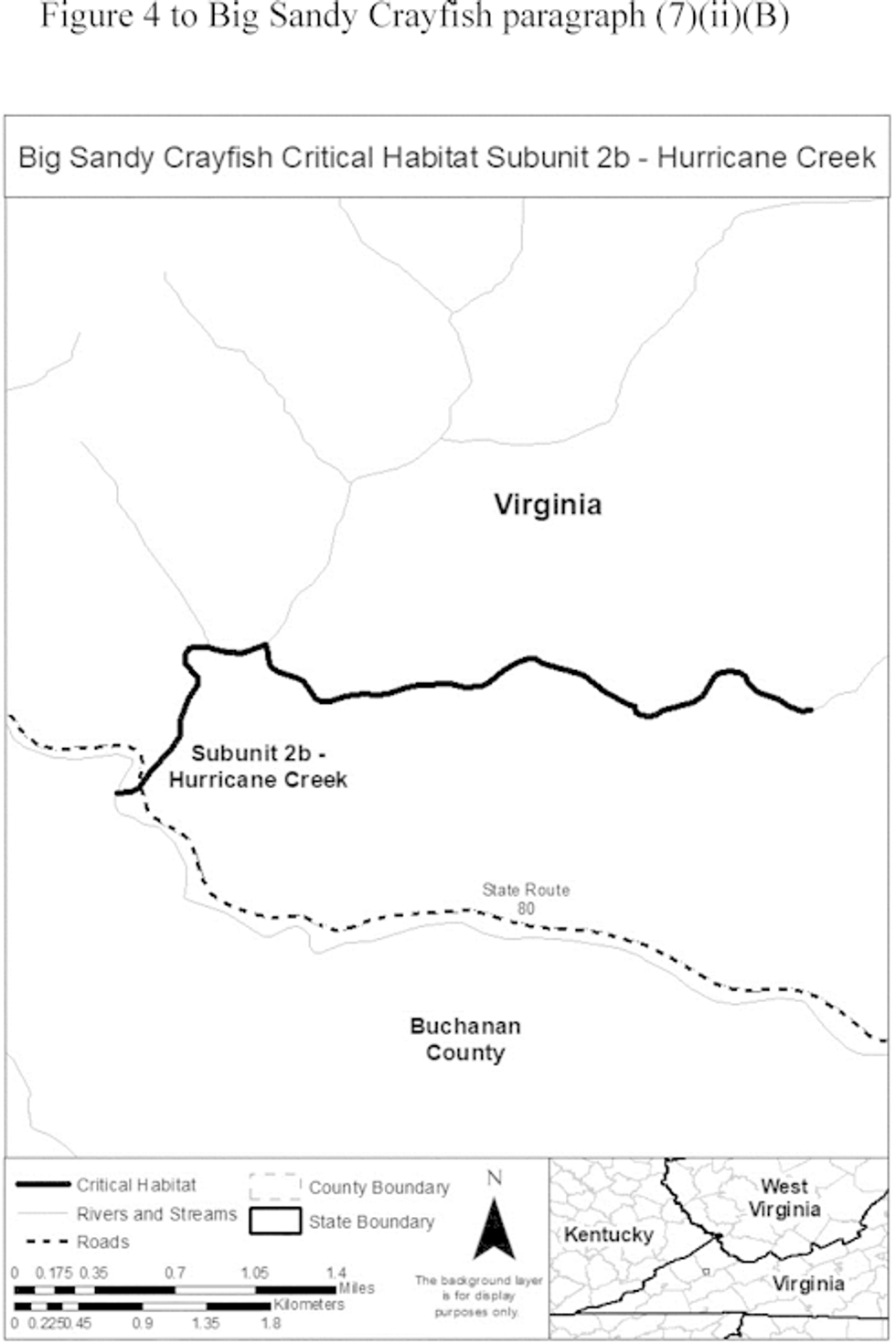
(iii) Subunit 2c: Indian Creek, Buchanan and Dickenson Counties, Virginia.
(A) Subunit 2c consists of approximately 7.4 skm (4.6 smi) of Indian Creek from its confluence with Three Forks in Buchanan County, Virginia, downstream to its confluence with Russell Fork in Buchanan and Dickenson Counties, Virginia.
(B) Map of Subunit 2c follows:
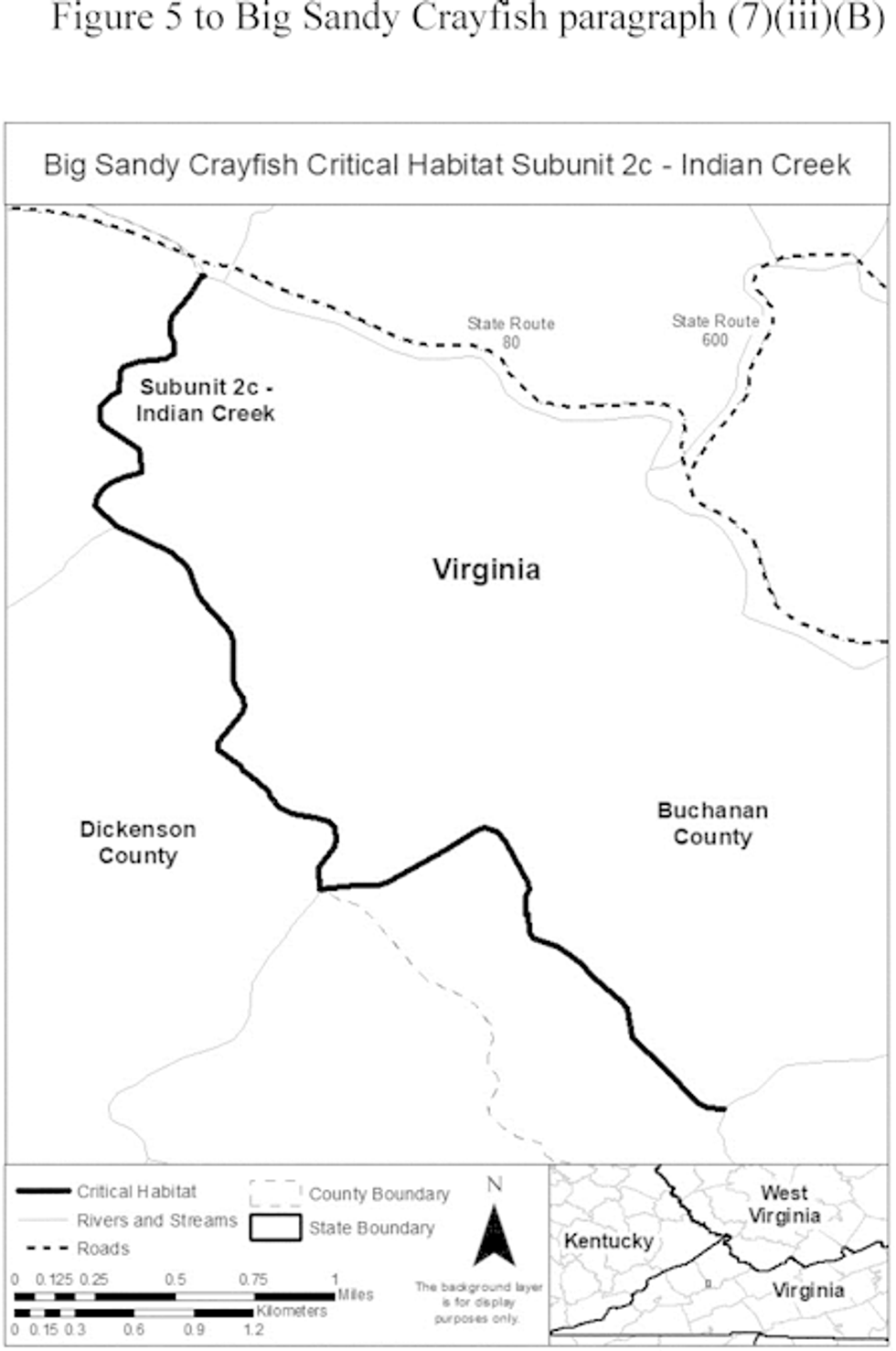
(iv) Subunit 2d: Fryingpan Creek, Dickenson County, Virginia.
(A) Subunit 2d consists of approximately 4.6 skm (2.9 smi) of Fryingpan Creek from its confluence with Priest Fork downstream to its confluence with Russell Fork.
(B) Map of Subunit 2d follows:
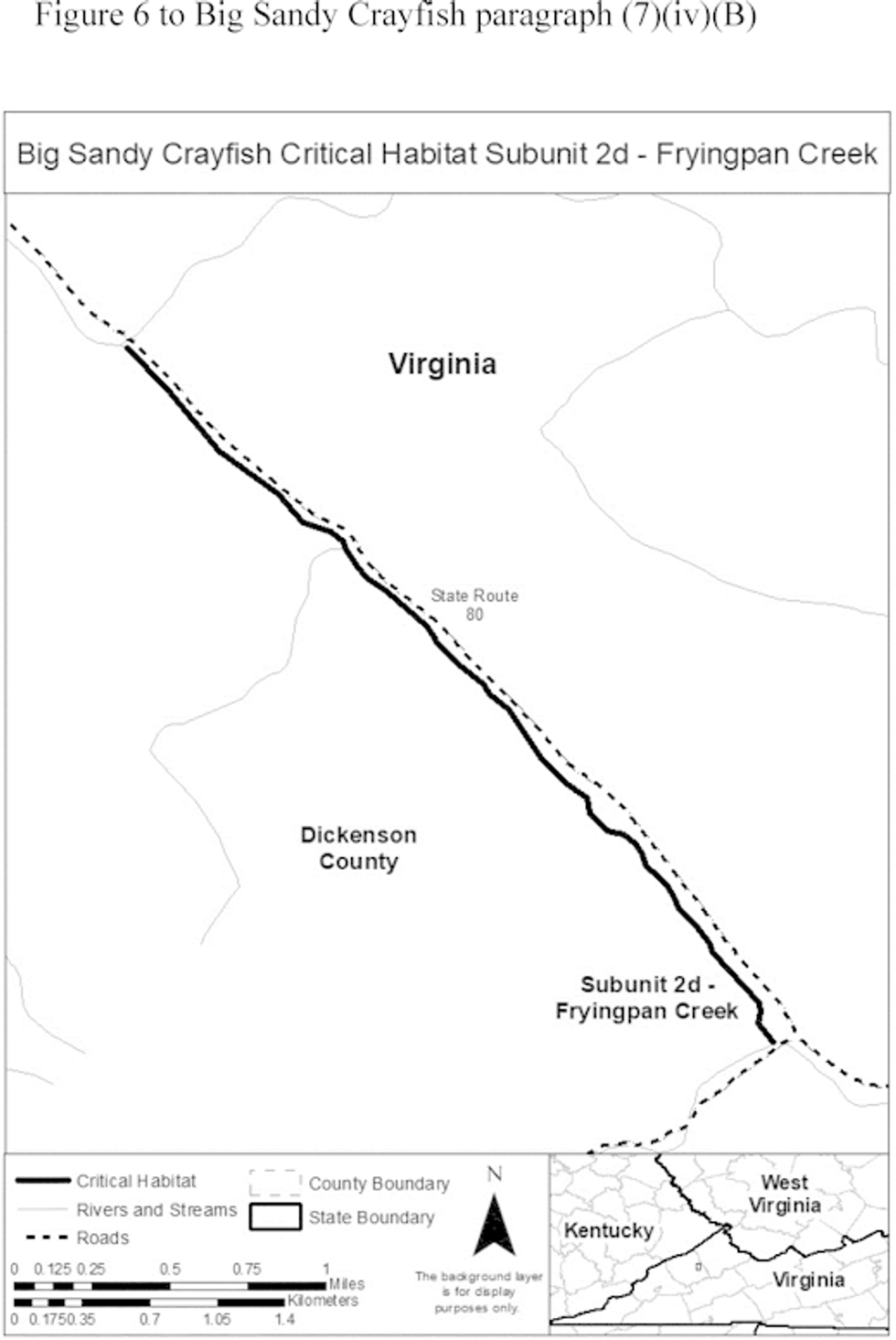
(v) Subunit 2e: Lick Creek, Dickenson County, Virginia.
(A) Subunit 2e consists of approximately 16.2 skm (10.1 smi) of Lick Creek from its confluence with Cabin Fork near Aily, Virginia, downstream to its confluence with Russell Fork at Birchfield, Virginia.
(B) Map of Subunit 2e follows:
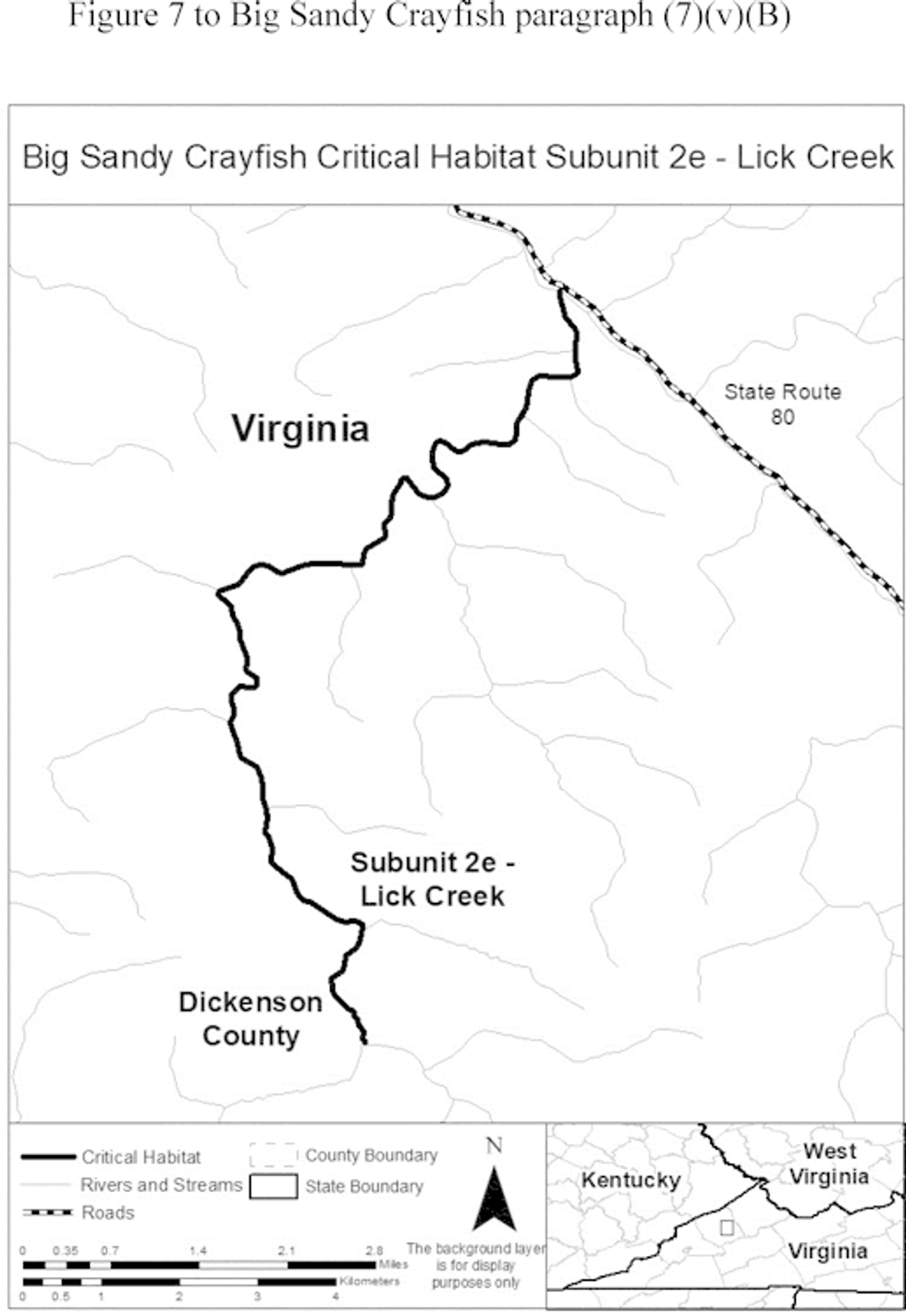
(vi) Subunit 2f: Russell Prater Creek, Dickenson County, Virginia.
(A) Subunit 2f consists of approximately 8.4 skm (5.2 smi) of Russell Prater Creek from its confluence with Greenbrier Creek downstream to its confluence with Russell Fork at Haysi, Virginia.
(B) Map of Subunit 2f follows:
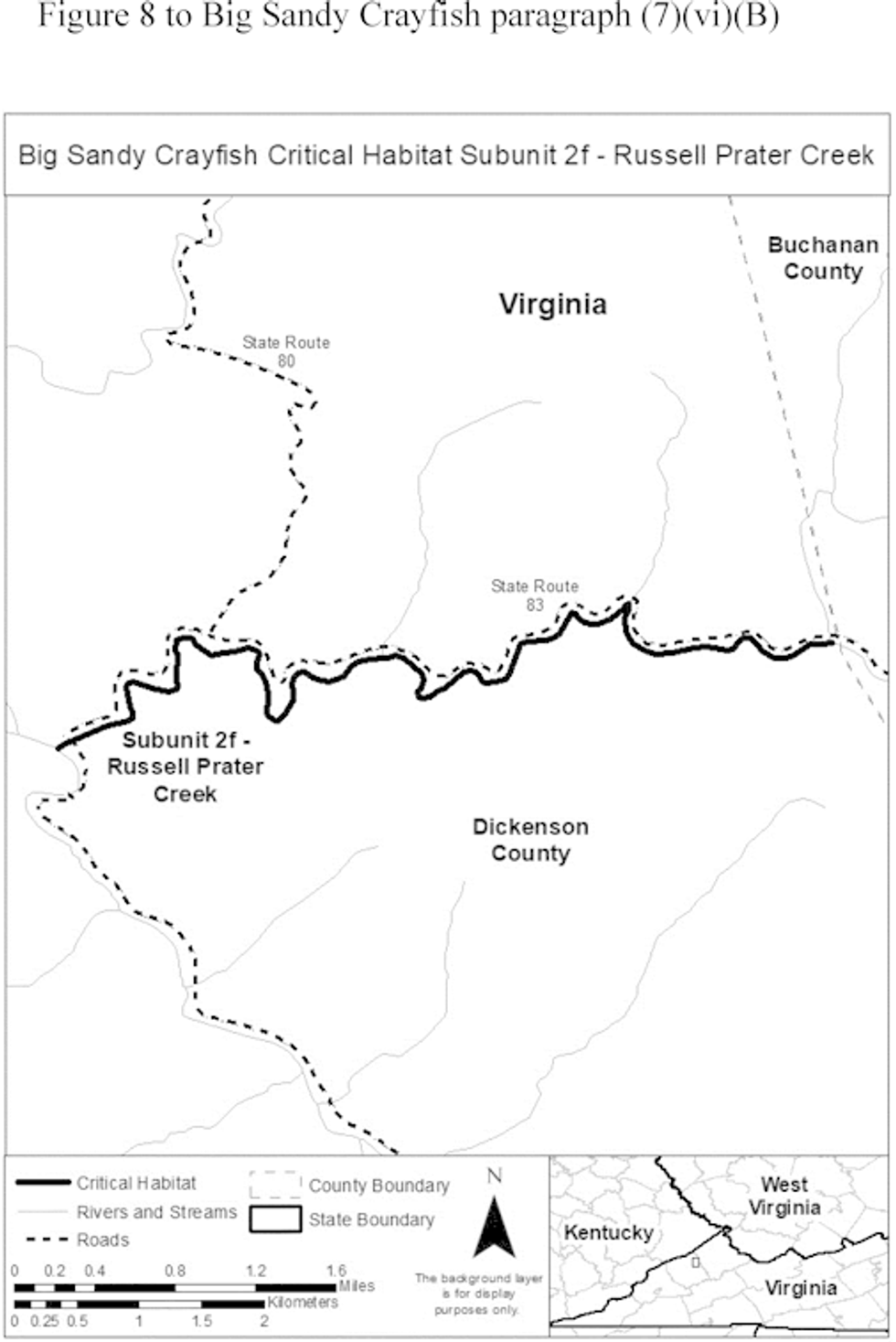
(vii) Subunit 2g: McClure River, Open Fork and McClure Creek, Dickenson County, Virginia.
(A) Subunit 2g consists of approximately 35.6 skm (22.1 smi) of the McClure River and McClure Creek from the confluence of McClure Creek and Honey Branch downstream to the confluence of McClure River and Russell Fork; and approximately 4.9 km (3.0 mi) of Open Fork from the confluence of Middle Fork Open Fork and Coon Branch downstream to the confluence of Open Fork and McClure Creek at Nora, Virginia.
(B) Map of Subunit 2g follows:
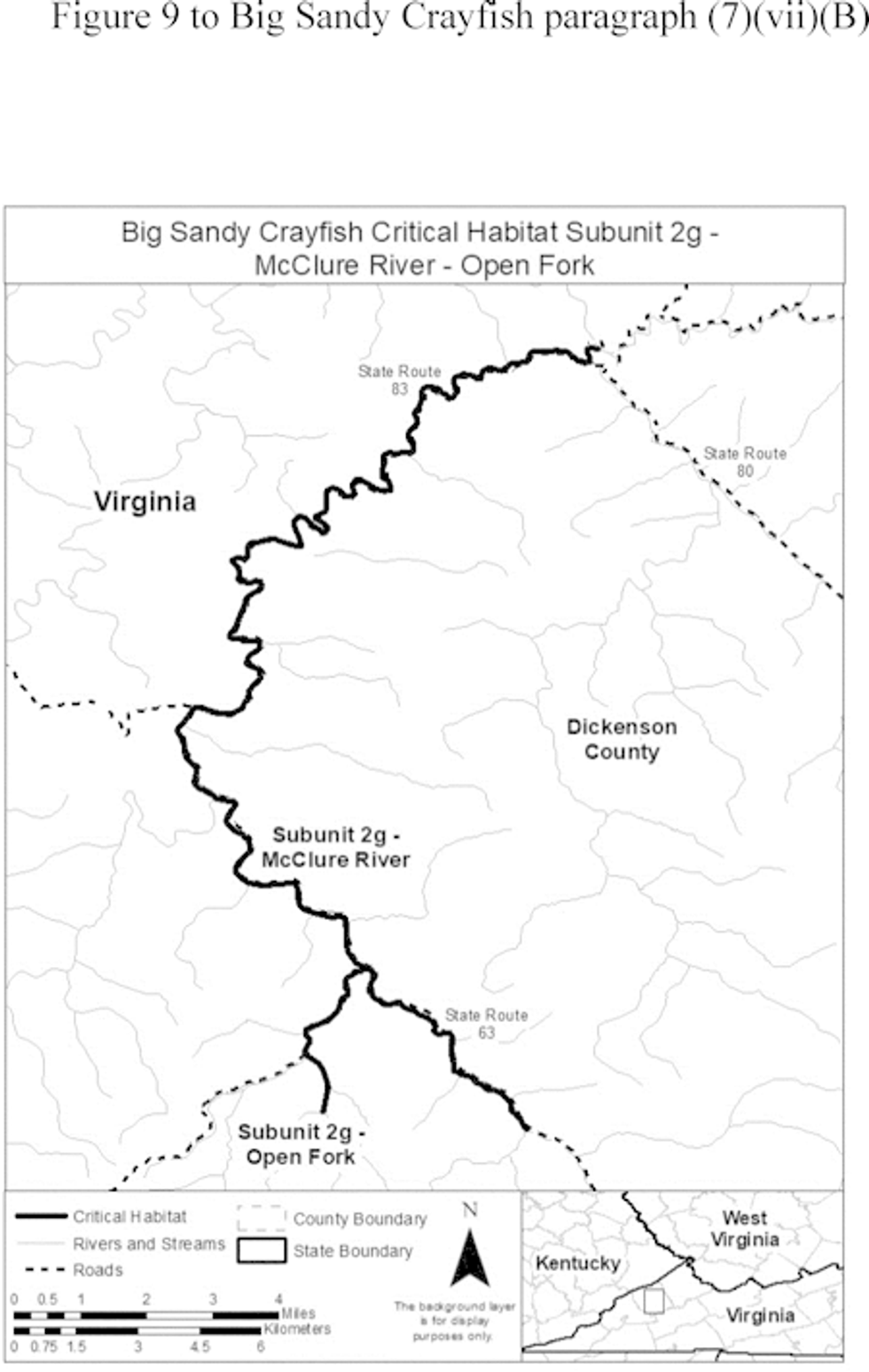
(viii) Subunit 2h: Elkhorn Creek, Pike County, Kentucky.
(A) Subunit 2h consists of approximately 8.5 skm (5.3 smi) of Elkhorn Creek from its confluence with Mountain Branch downstream to its confluence with Russell Fork at Elkhorn City, Kentucky.
(B) Map of Subunit 2h follows:
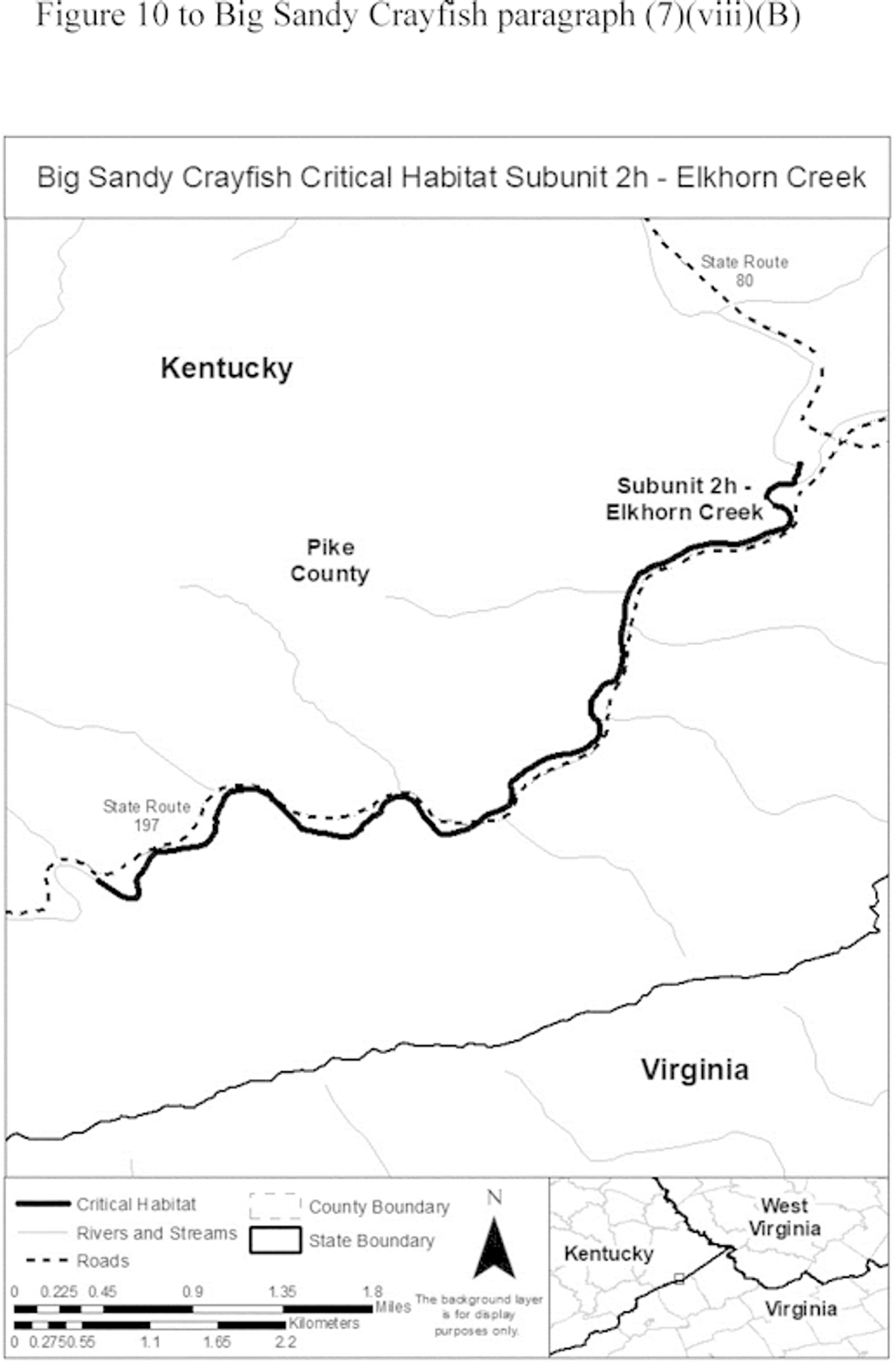
(ix) Subunit 2i: Cranes Nest River and Birchfield Creek, Dickenson and Wise Counties, Virginia.
(A) Subunit 2i consists of approximately 24.6 skm (19.0 smi) of the Cranes Nest River from its confluence with Birchfield Creek downstream to its confluence with Lick Branch and approximately 6.9 skm (4.3 smi) of Birchfield Creek from its confluence with Dotson Creek downstream to its confluence with Cranes Nest River.
(B) Map of Subunit 2i follows:
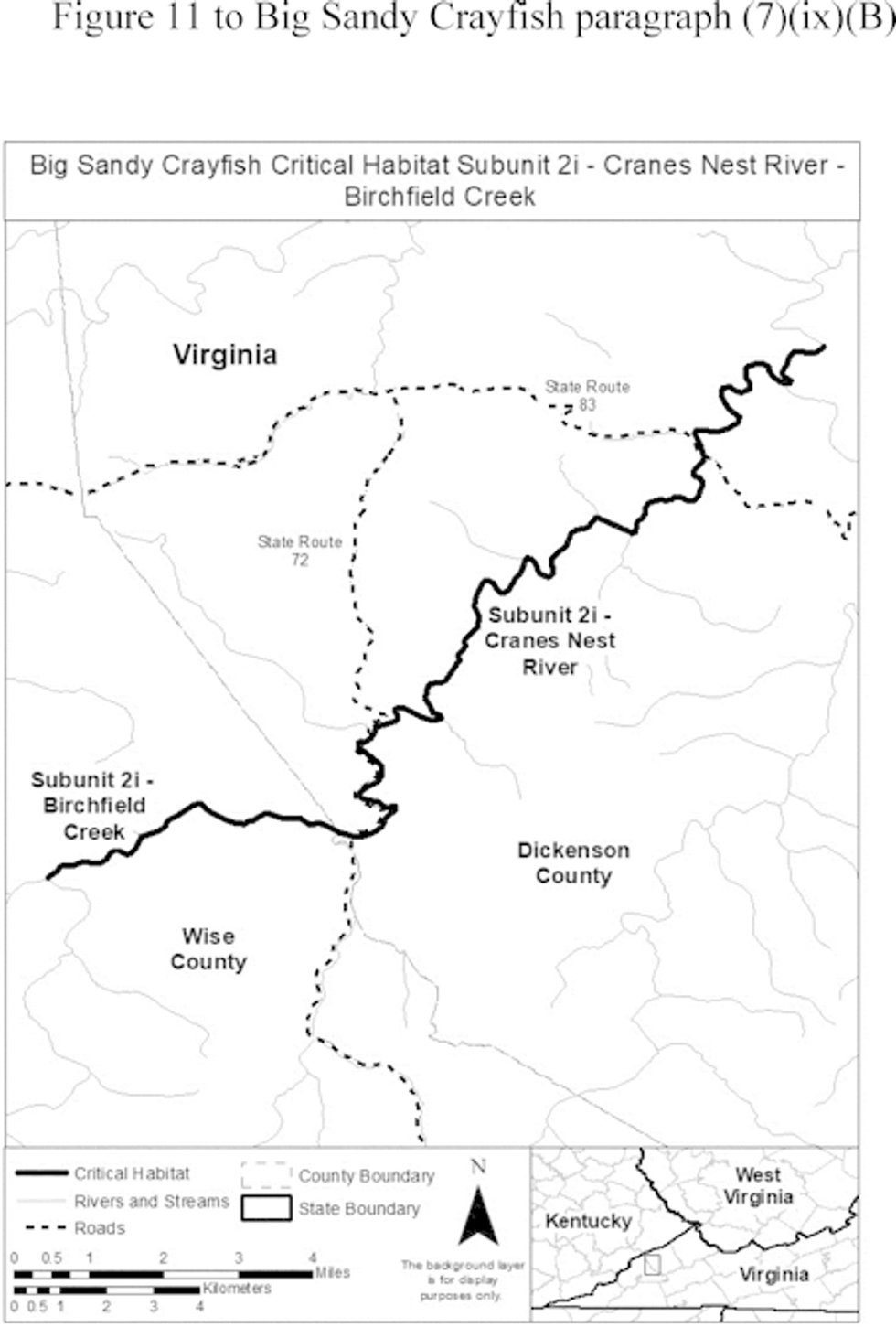
(x) Subunit 2j: Pound River, Dickenson and Wise Counties, Virginia.
(A) Subunit 2j consists of approximately 28.5 skm (17.7 smi) of the Pound River from its confluence with Bad Creek downstream to the confluence of the Pound River and Jerry Branch.
(B) Map of Subunit 2j follows:
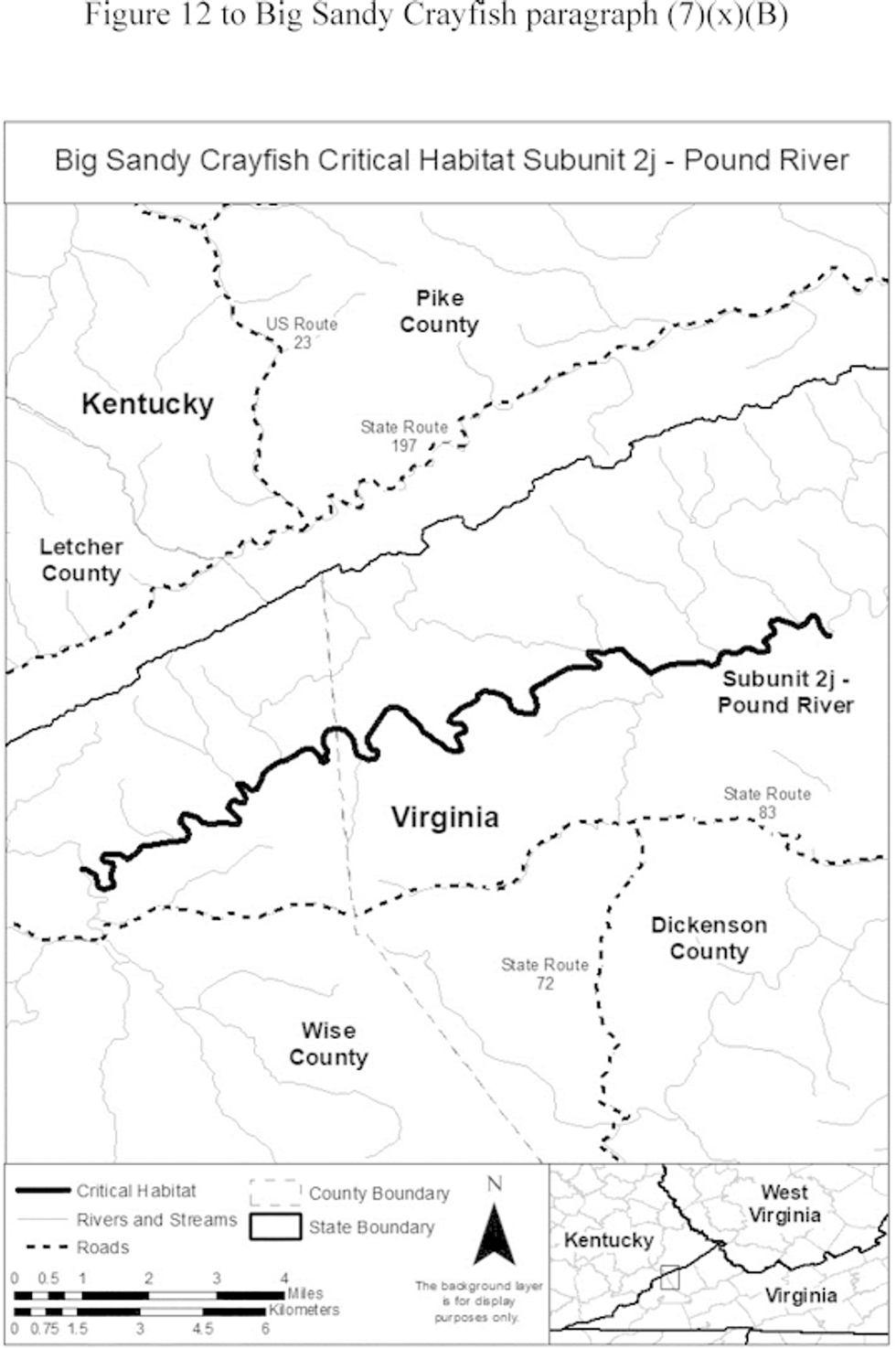
(8) Index map of critical habitat Unit 3 for the Big Sandy crayfish follows:
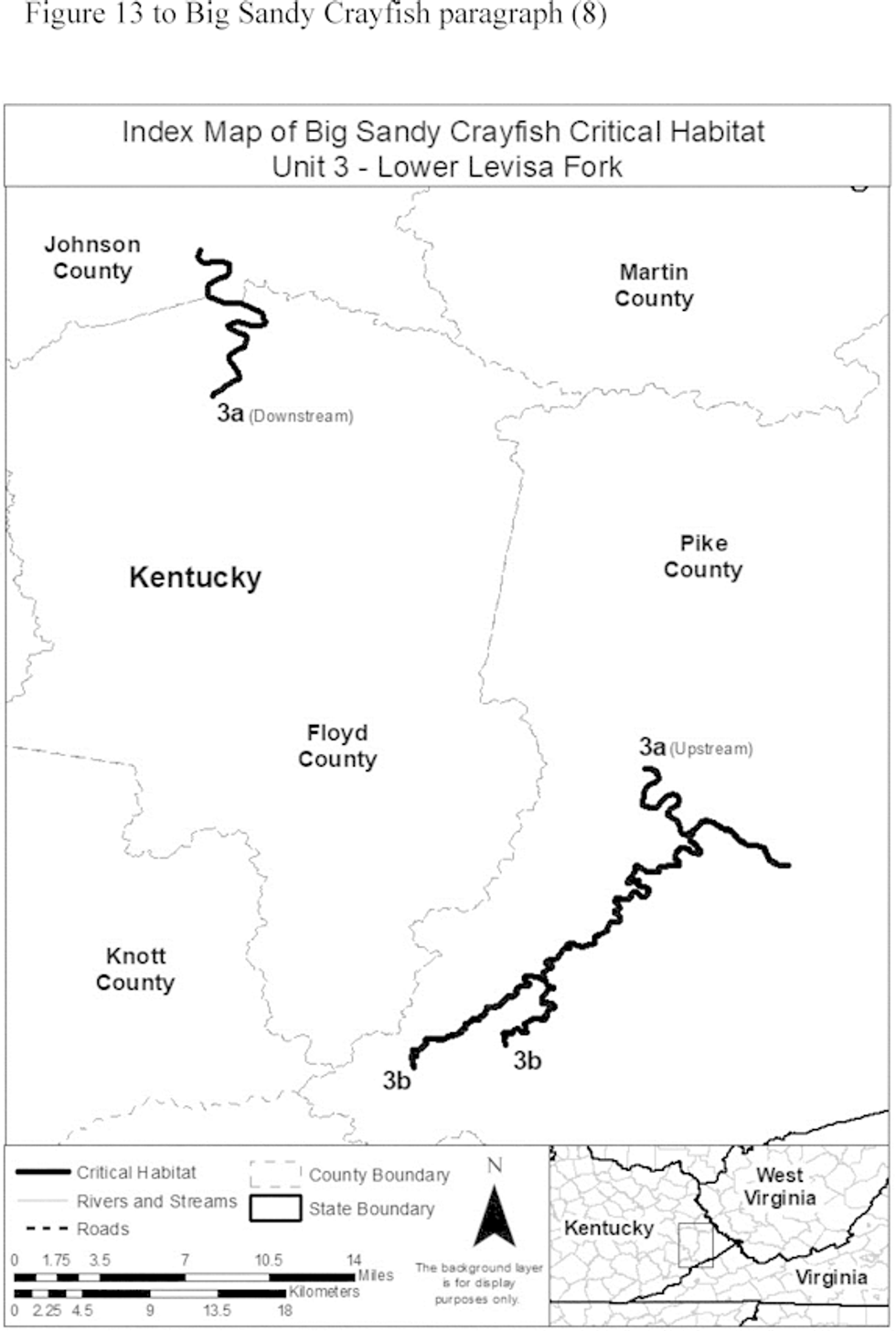
(9) Unit 3: Lower Levisa Fork—Floyd, Johnson, and Pike Counties, Kentucky.
(i) Subunit 3a: Levisa Fork, Floyd, Johnson, and Pike Counties, Kentucky.
(A) Subunit 3a consists of approximately 15.9 km (9.9 mi) of Levisa Fork from its confluence with Russell Fork at Levisa Junction, Kentucky, downstream to its confluence with Island Creek at Pikeville, Kentucky; and 17.5 skm (10.9 smi) of Levisa Fork from its confluence with Abbott Creek downstream to its confluence with Miller Creek at Auxier, Kentucky.
(B) Map of Subunit 3a follows:
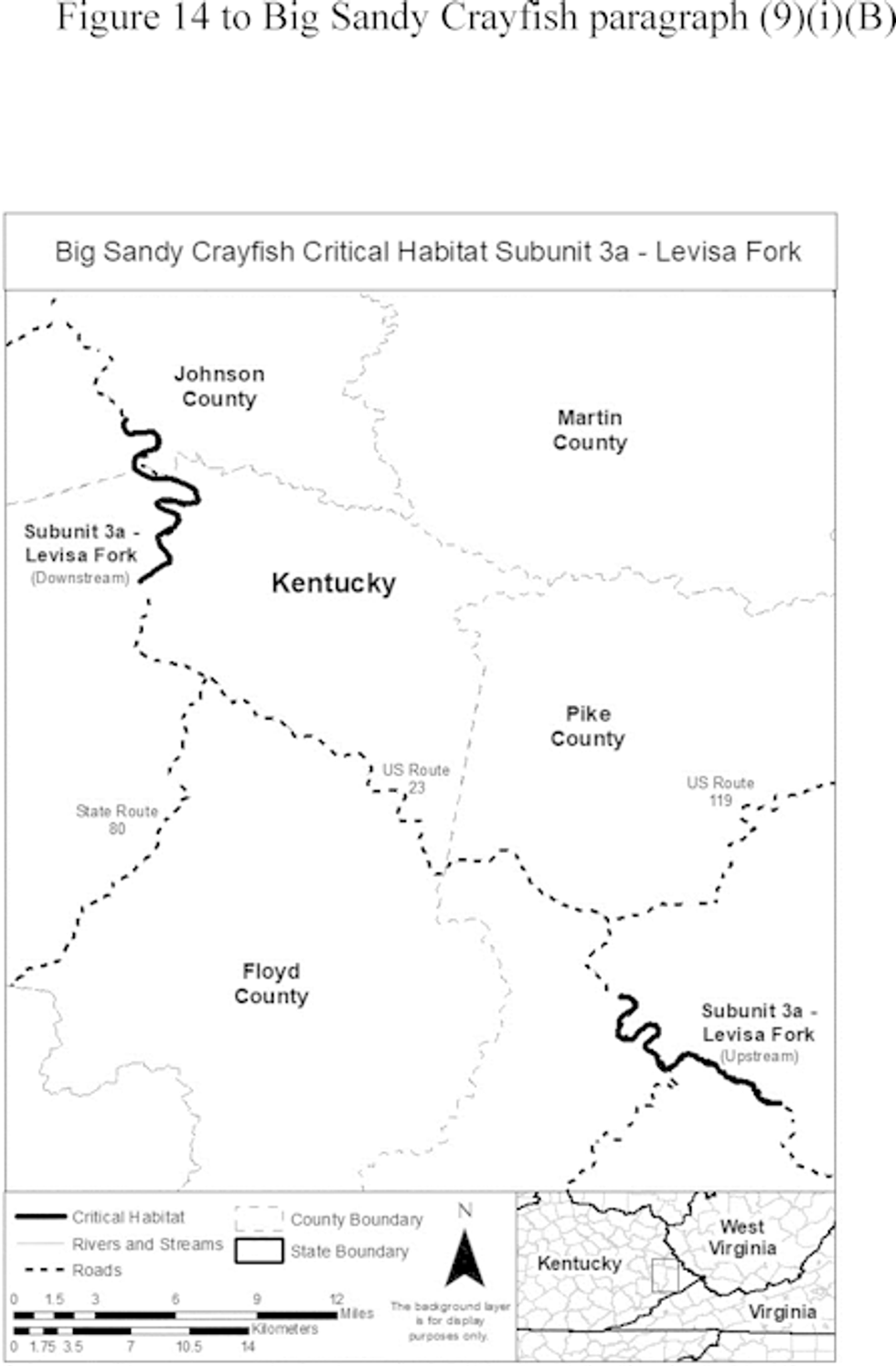
(ii) Subunit 3b: Shelby Creek and Long Fork, Pike County, Kentucky.
(A) Subunit 3b consists of approximately 32.2 skm (20.0 smi) of Shelby Creek from its confluence with Burk Branch downstream to its confluence with Levisa Fork at Shelbiana, Kentucky; and approximately 12.9 skm (8.0 smi) of Long Fork from the confluence of Right Fork Long Fork and Left Fork Long Fork downstream to the confluence of Long Fork and Shelby Creek at Virgie, Kentucky.
(B) Map of Subunit 3b follows:
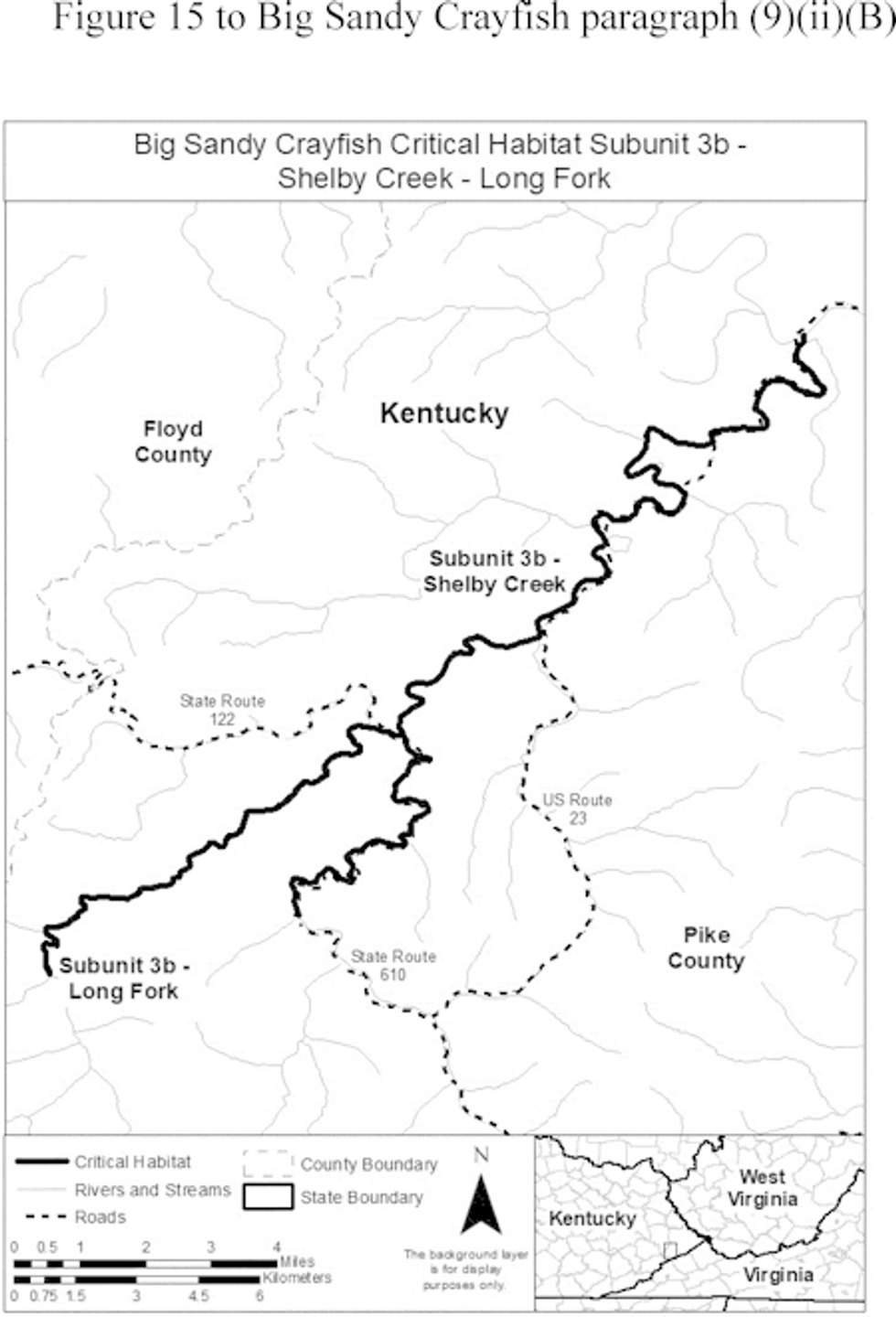
(10) Index map of critical habitat Unit 4 for the Big Sandy crayfish follows:
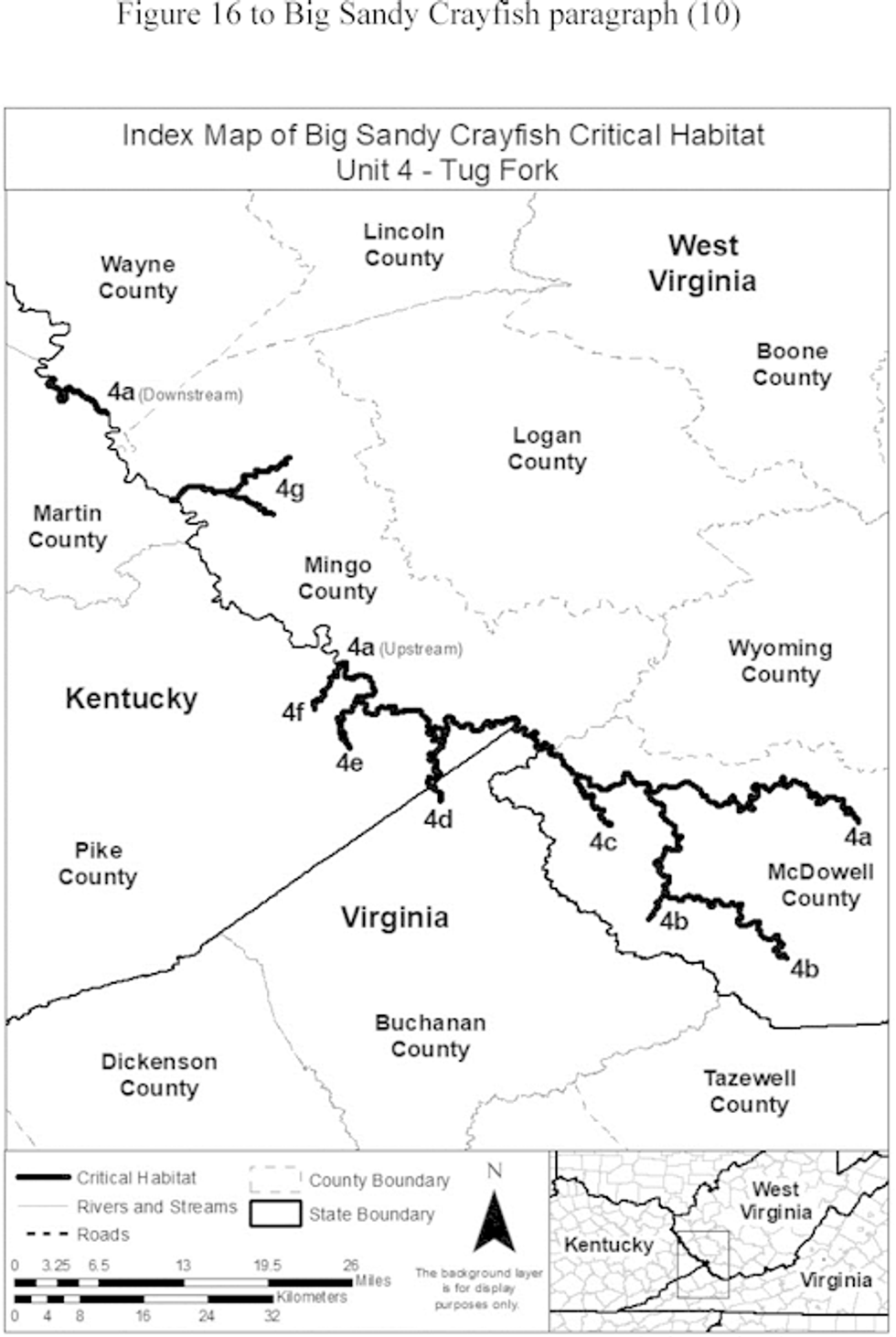
(11) Unit 4: Tug Fork—McDowell, Mingo, and Wayne Counties, West Virginia; Buchanan County, Virginia; and Pike and Martin Counties, Kentucky.
(i) Subunit 4a: Tug Fork, McDowell, Mingo, and Wayne Counties, West Virginia; Buchanan County, Virginia; and Pike and Martin Counties, Kentucky.
(A) Subunit 4a consists of approximately 106.1 skm (65.9 smi) of the Tug Fork from its confluence with Elkhorn Creek at Welch, West Virginia, downstream to its confluence with Blackberry Creek in Pike County, Kentucky; and 11.7 skm (7.3 smi) of the Tug Fork from its confluence with Little Elk Creek downstream to its confluence with Bull Creek at Crum, West Virginia.
(B) Map of Subunit 4a follows:
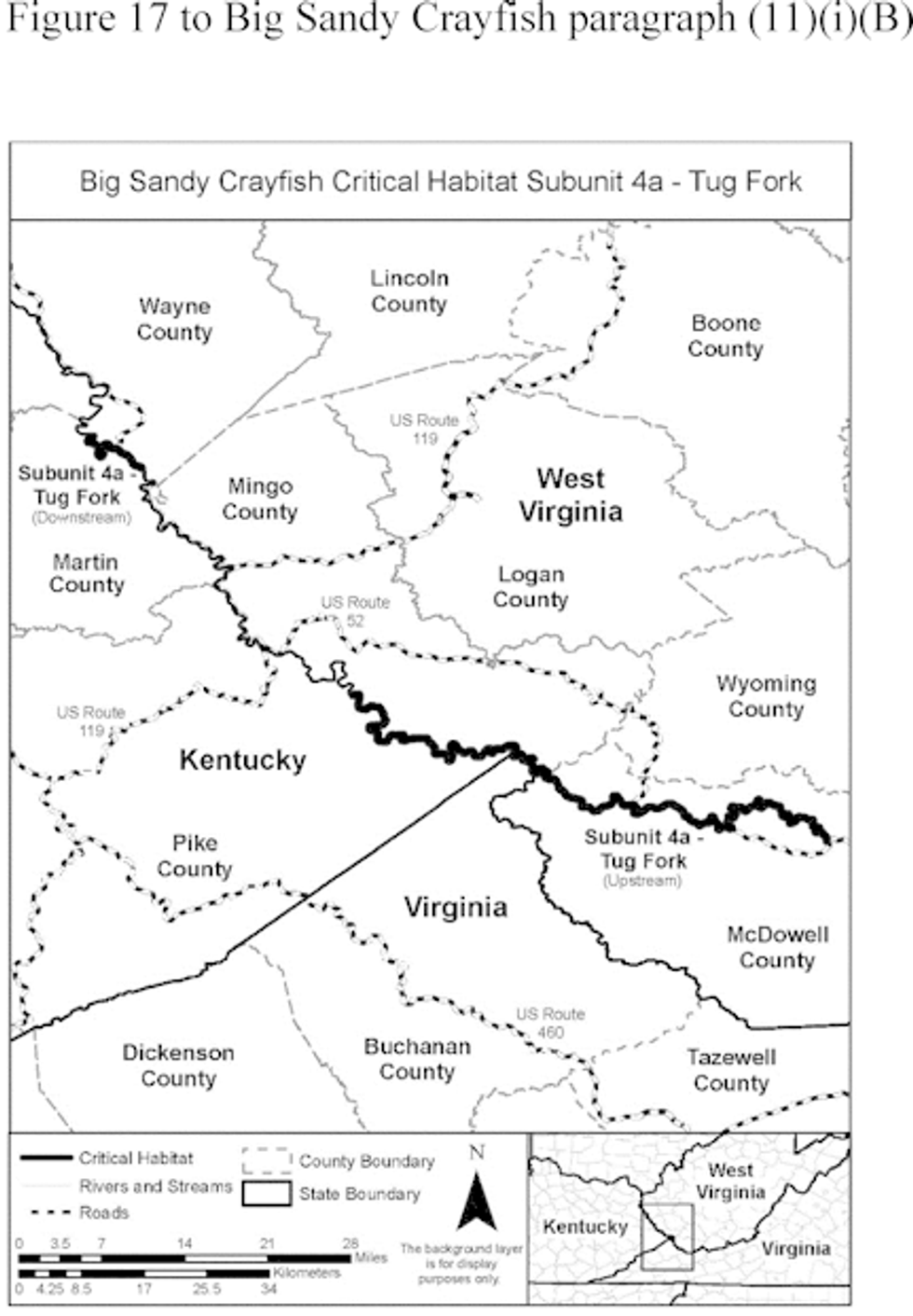
(ii) Subunit 4b: Dry Fork and Bradshaw Creek, McDowell County, West Virginia.
(A) Subunit 4b consists of approximately 45.2 skm (28.1 smi) of Dry Fork from its confluence with Jacobs Fork downstream to its confluence with Tug Fork at Iaeger, West Virginia; and approximately 4.6 skm (2.9 smi) of Bradshaw Creek from its confluence with Hite Fork at Jolo, West Virginia, downstream to its confluence with Dry Fork at Bradshaw, West Virginia.
(B) Map of Subunit 4b follows:
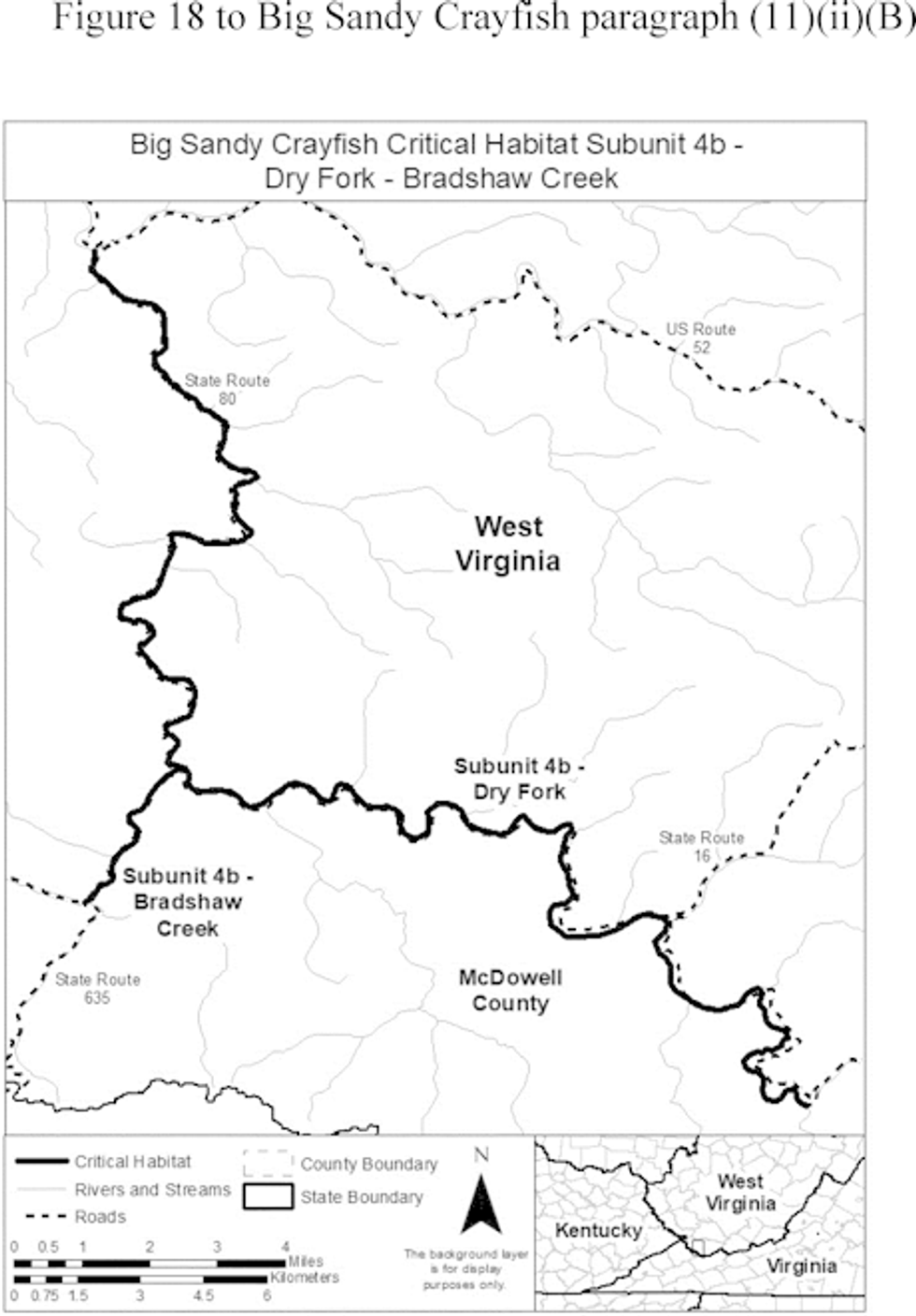
(iii) Subunit 4c: Panther Creek, McDowell County, West Virginia.
(A) Subunit 4c consists of approximately 10.7 skm (6.6 smi) of Panther Creek from its confluence with George Branch downstream to its confluence with Tug Fork at Panther, West Virginia.
(B) Map of Subunit 4c follows:
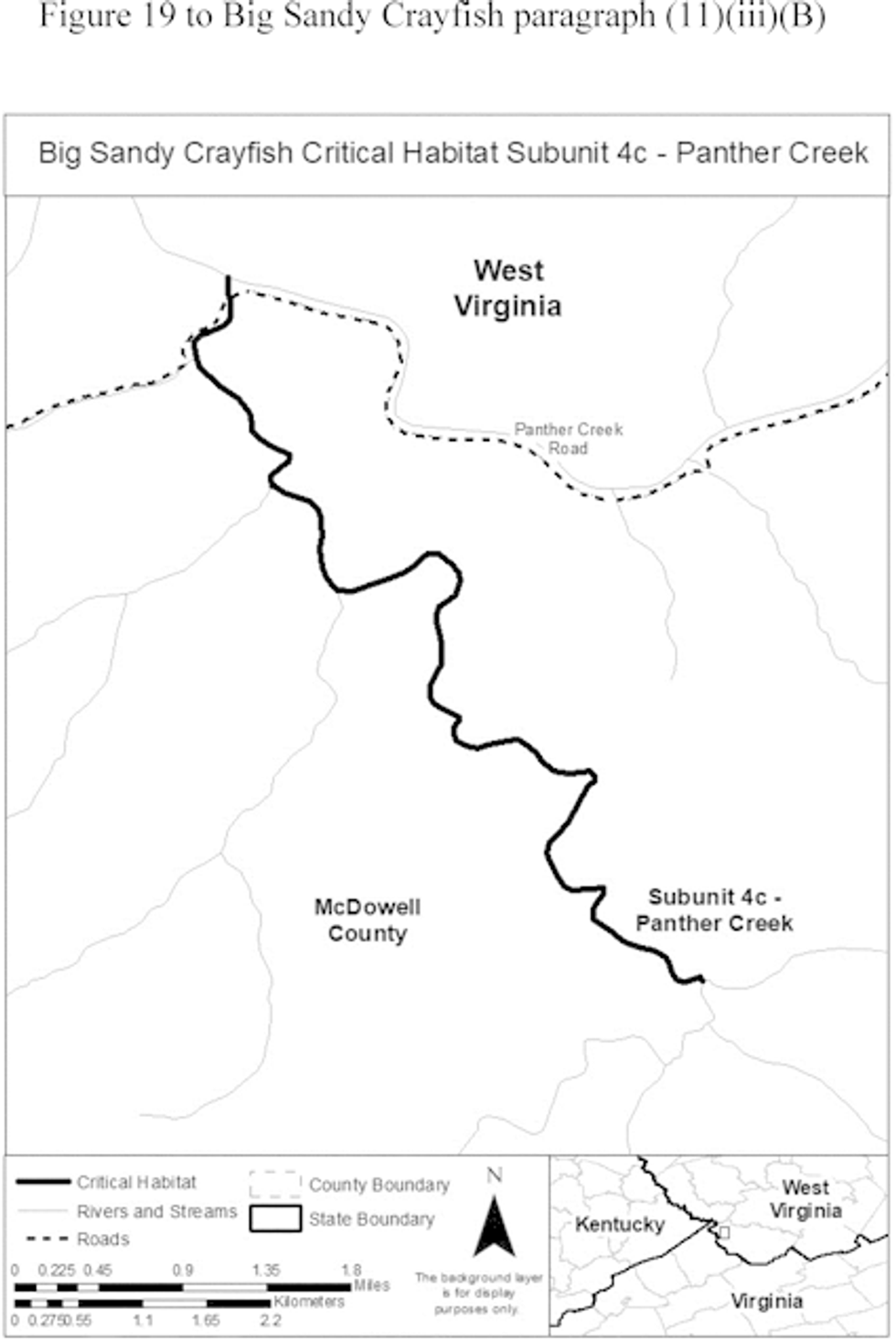
(iv) Subunit 4d: Knox Creek, Buchanan County, Virginia, and Pike County, Kentucky.
(A) Subunit 4d consists of approximately 16.6 skm (10.3 smi) of Knox Creek from its confluence with Cedar Branch downstream to its confluence with Tug Fork in Pike County, Kentucky.
(B) Map of Subunit 4d follows:
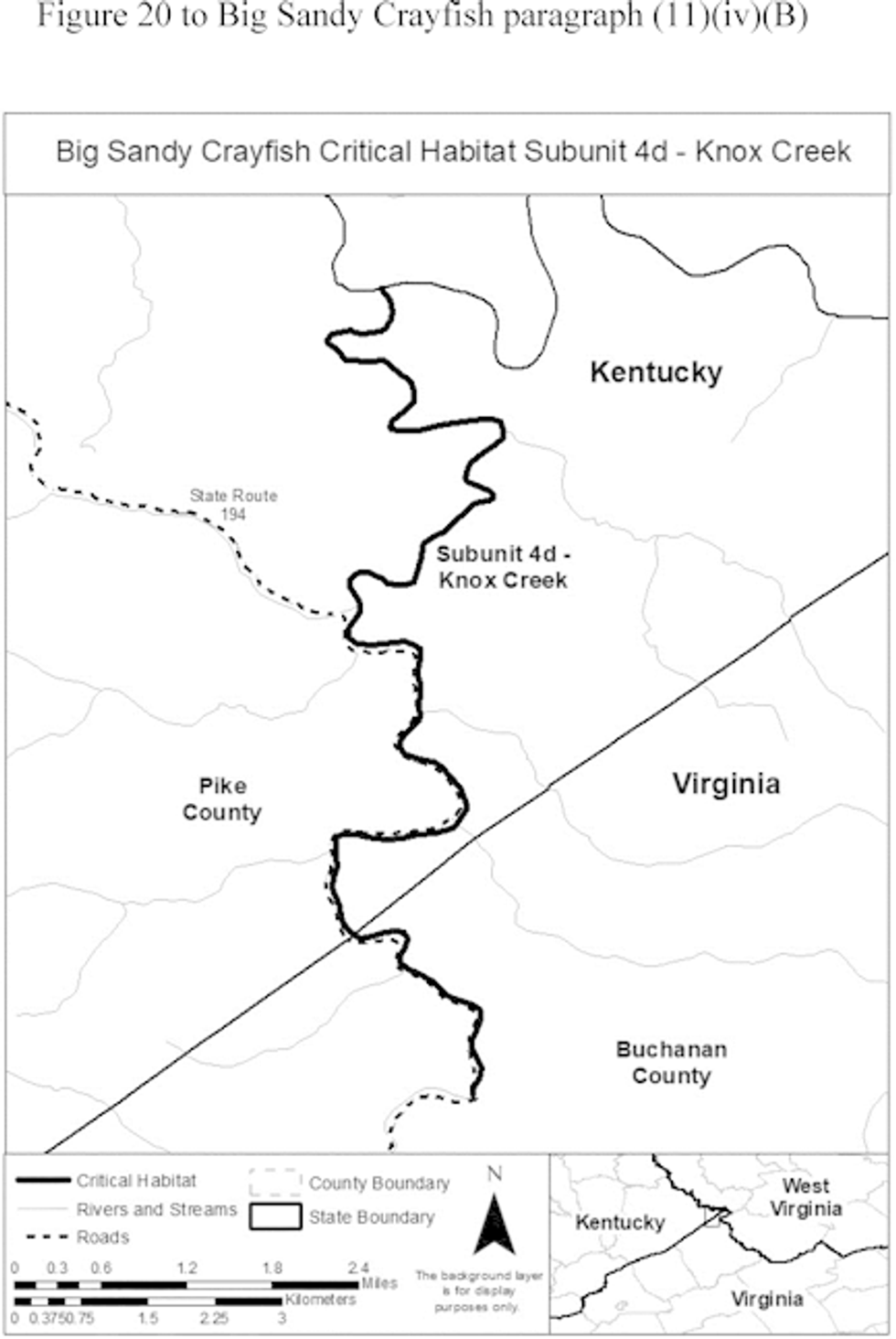
(v) Subunit 4e: Peter Creek, Pike County, Kentucky.
(A) Subunit 4e consists of approximately 10.1 skm (6.3 smi) of Peter Creek from the confluence of Left Fork Peter Creek and Right Fork Peter Creek at Phelps, Kentucky, downstream to the confluence of Peter Creek and Tug Fork at Freeburn, Kentucky.
(B) Map of Subunit 4e follows:
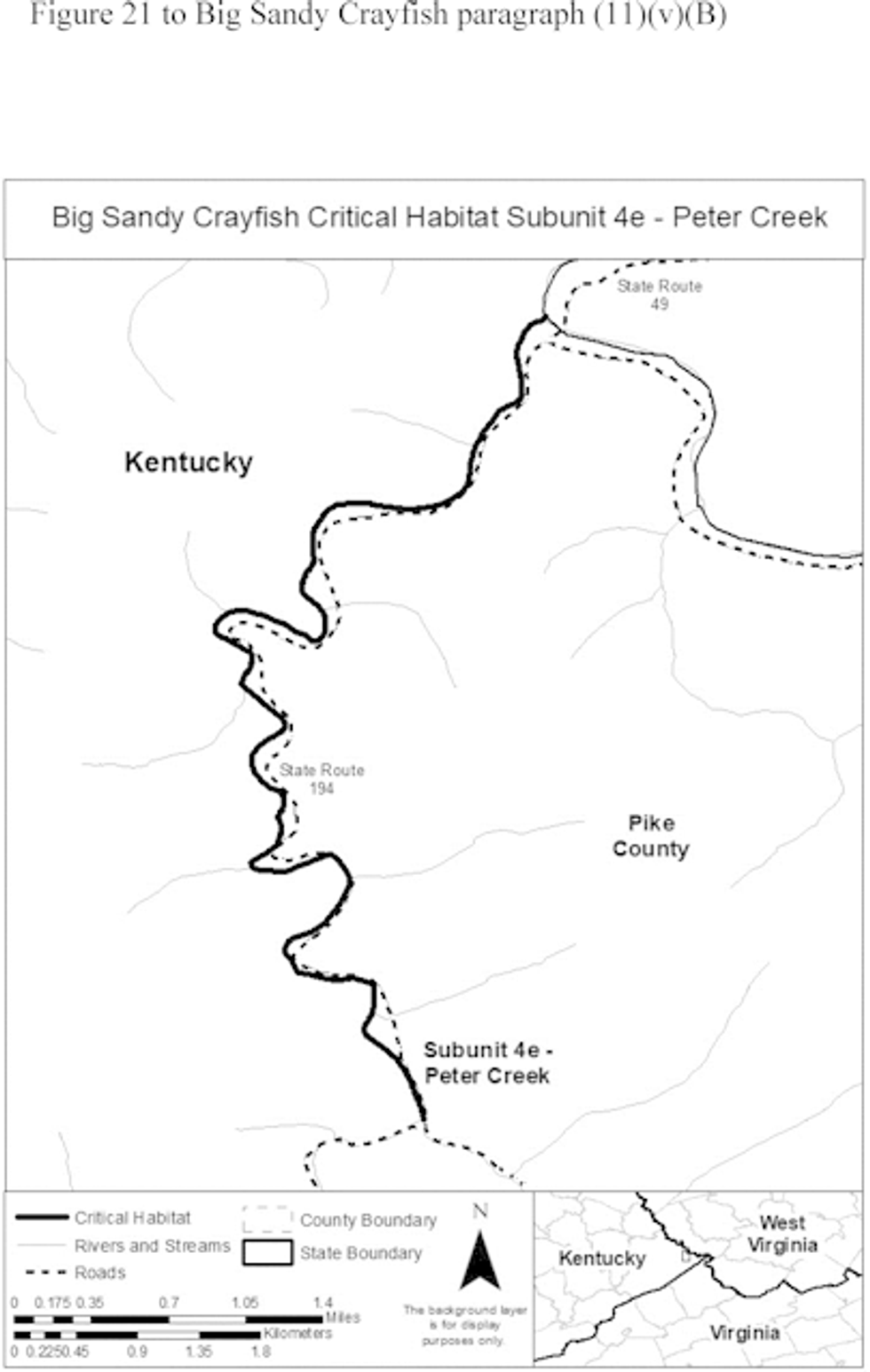
(vi) Subunit 4f: Blackberry Creek, Pike County, Kentucky.
(A) Subunit 4f consists of approximately 9.1 skm (5.7 smi) of Blackberry Creek its confluence with Bluespring Branch downstream to the confluence of Blackberry Creek and Tug Fork.
(B) Map of Subunit 4f follows:
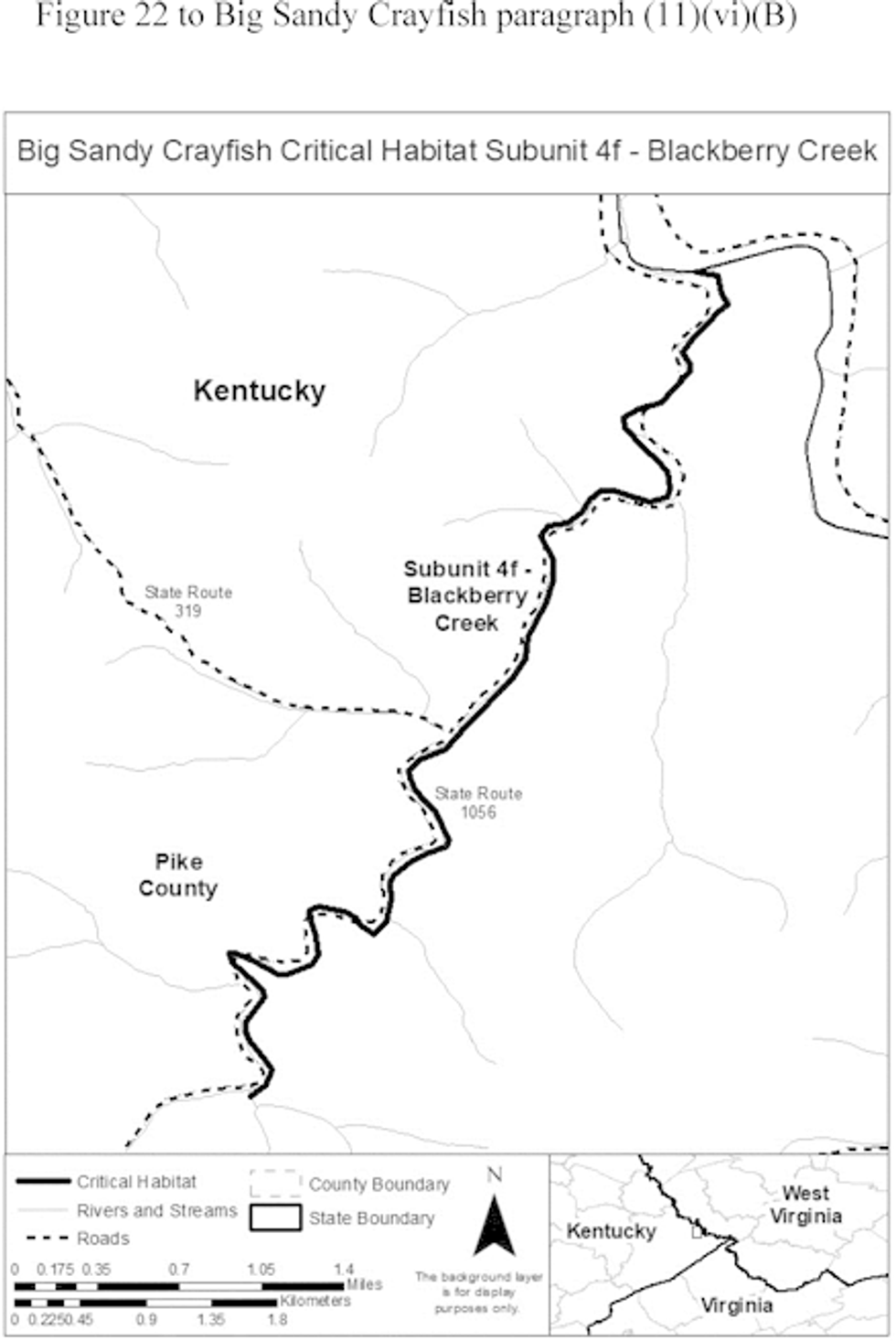
(vii) Subunit 4g: Pigeon Creek and Laurel Fork, Mingo County, West Virginia.
(A) Subunit 4g consists of approximately 14.0 skm (8.7 smi) of Pigeon Creek from its confluence with Trace Fork downstream to its confluence with Tug Fork; and approximately 11.1 skm (6.9 smi) of Laurel Fork from its confluence with Lick Branch downstream to its confluence with Pigeon Creek at Lenore, West Virginia.
(B) Map of Subunit 4g follows:
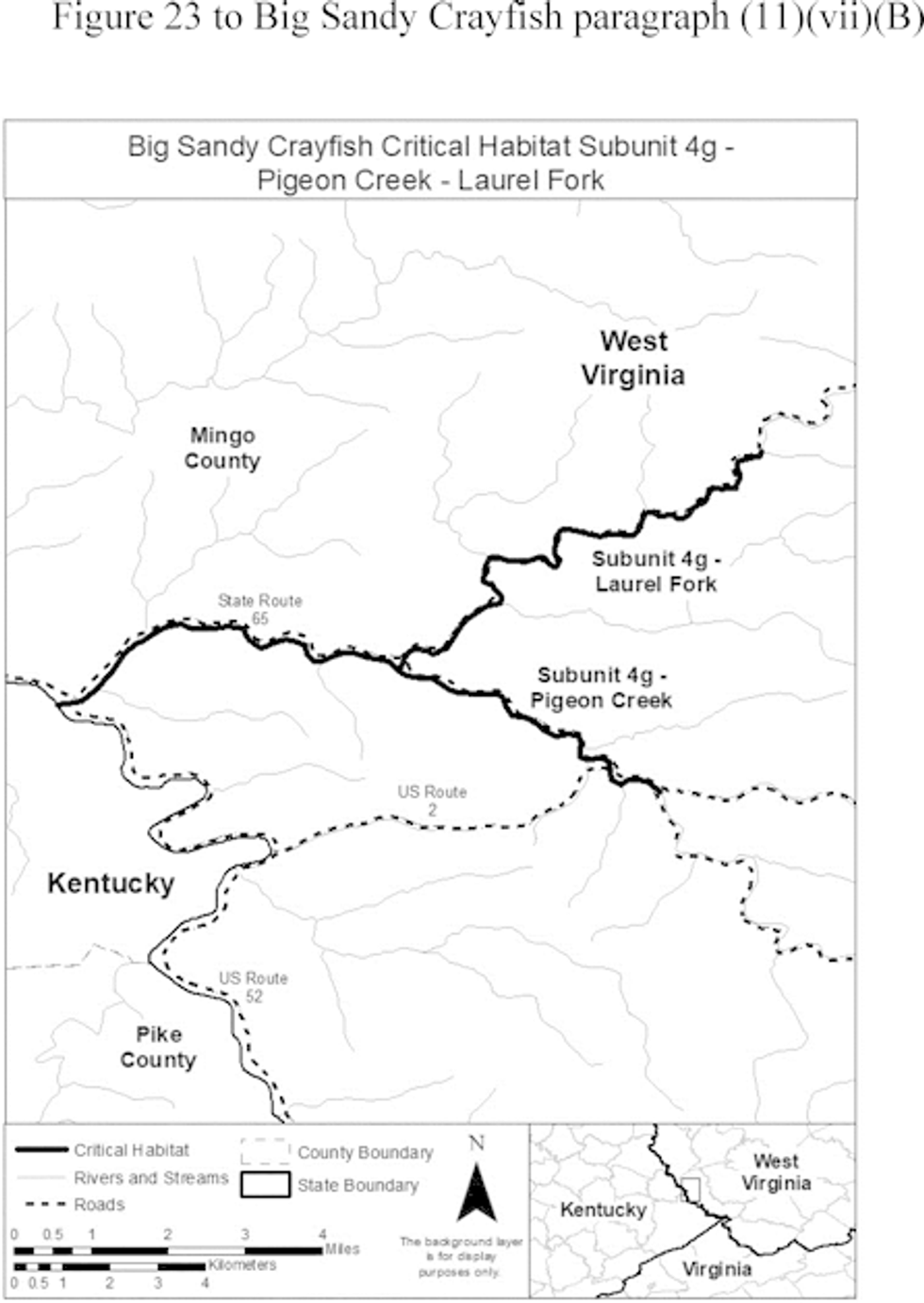
Guyandotte River Crayfish (Cambarus veteranus)
(1) Critical habitat units are depicted for Logan and Wyoming Counties, West Virginia, on the maps in this entry.
(2) Within these areas, the physical or biological features essential to the conservation of the Guyandotte River crayfish consist of the following components:
(i) Fast-flowing stream reaches with unembedded slab boulders, cobbles, or isolated boulder clusters within an unobstructed stream continuum (i.e.. riffle, run, pool complexes) of permanent, moderate- to large-sized (generally third order and larger) streams and rivers (up to the ordinary high water mark as defined at 33 CFR 329.11).
(ii) Streams and rivers with natural variations in flow and seasonal flooding sufficient to effectively transport sediment and prevent substrate embeddedness.
(iii) Water quality characterized by seasonally moderated temperatures and physical and chemical parameters (e.g., pH, conductivity, dissolved oxygen) sufficient for the normal behavior, growth, reproduction, and viability of all life stages of the species.
(iv) An adequate food base, indicated by a healthy aquatic community structure including native benthic macroinvertebrates, fishes, and plant matter (e.g., leaf litter, algae, detritus).
(v) Aquatic habitats protected from riparian and instream activities that degrade the physical and biological features described in paragraphs (2)(i) through (iv) of this entry or cause physical (e.g., crushing) injury or death to individual Guyandotte River crayfish.
(vi) An interconnected network of streams and rivers that have the physical and biological features described in paragraphs (2)(i) through (iv) of this entry and that allow for the movement of individual crayfish in response to environmental, physiological, or behavioral drivers. The scale of the interconnected stream network should be sufficient to allow for gene flow within and among watersheds.
(3) Critical habitat does not include manmade structures (such as buildings, aqueducts, runways, roads, and other paved areas) and the land on which they are located existing within the legal boundaries on April 14, 2022.
(4) Data layers defining map units were created on a base of U.S. Geological Survey digital ortho-photo quarter-quadrangles, and critical habitat units were then mapped using Universal Transverse Mercator (UTM) Zone 15N coordinates. ESRI's ArcGIS 10.0 software was used to determine latitude and longitude coordinates using decimal degrees. The USA Topo ESRI online basemap service was referenced to identify features (like roads and streams) used to delineate the upstream and downstream extents of critical habitat units. The maps in this entry, as modified by any accompanying regulatory text, establish the boundaries of the critical habitat designation. The coordinates or plot points or both on which each map is based are available to the public at the Service's internet site at https://www.fws.gov/westvirginiafieldoffice/ , at https://www.regulations.gov at Docket No. FWS-R5-ES-2019-0098, and at the North Atlantic-Appalachian Regional Office. You may obtain field office location information by contacting one of the Service regional offices, the addresses of which are listed at 50 CFR 2.2.
(5) Index map of critical habitat for the Guyandotte River crayfish follows:
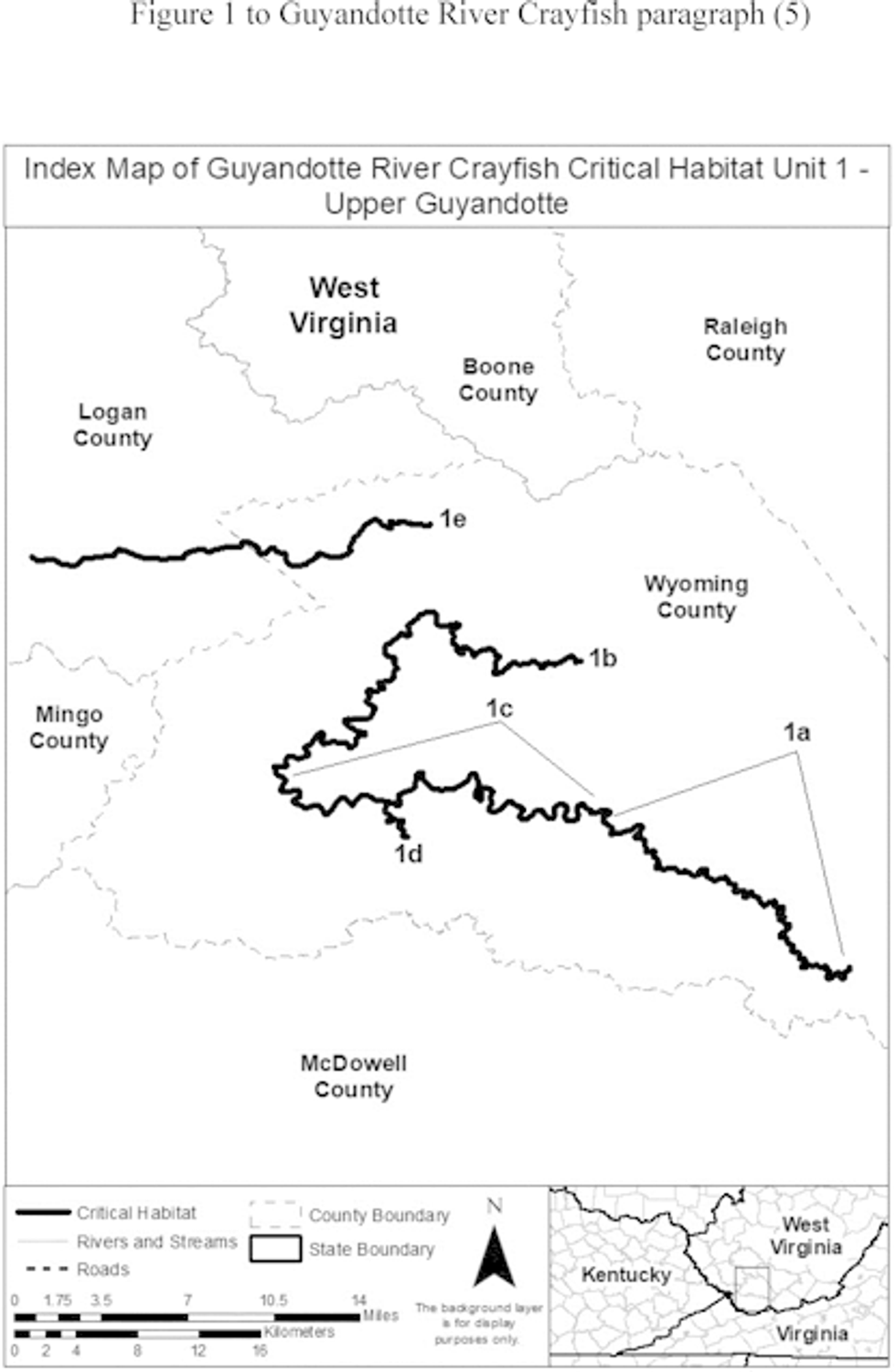
(6) Unit 1: Upper Guyandotte—Logan and Wyoming Counties, West Virginia.
(i) Subunit 1a: Pinnacle Creek, Wyoming County, West Virginia.
(A) Subunit 1a consists of approximately 28.6 skm (17.8 smi) of Pinnacle Creek from its confluence with Beartown Fork downstream to its confluence with the Guyandotte River at Pineville, West Virginia.
(B) Map of Subunit 1a follows:

(ii) Subunit 1b: Clear Fork and Laurel Fork, Wyoming County, West Virginia.
(A) Subunit 1b consists of approximately 38.0 skm (23.6 smi) of Clear Fork and its primary tributary Laurel Fork from the confluence of Laurel Creek and Acord Branch downstream to the confluence of Clear Fork and the Guyandotte River.
(B) Map of Subunit 1b follows:
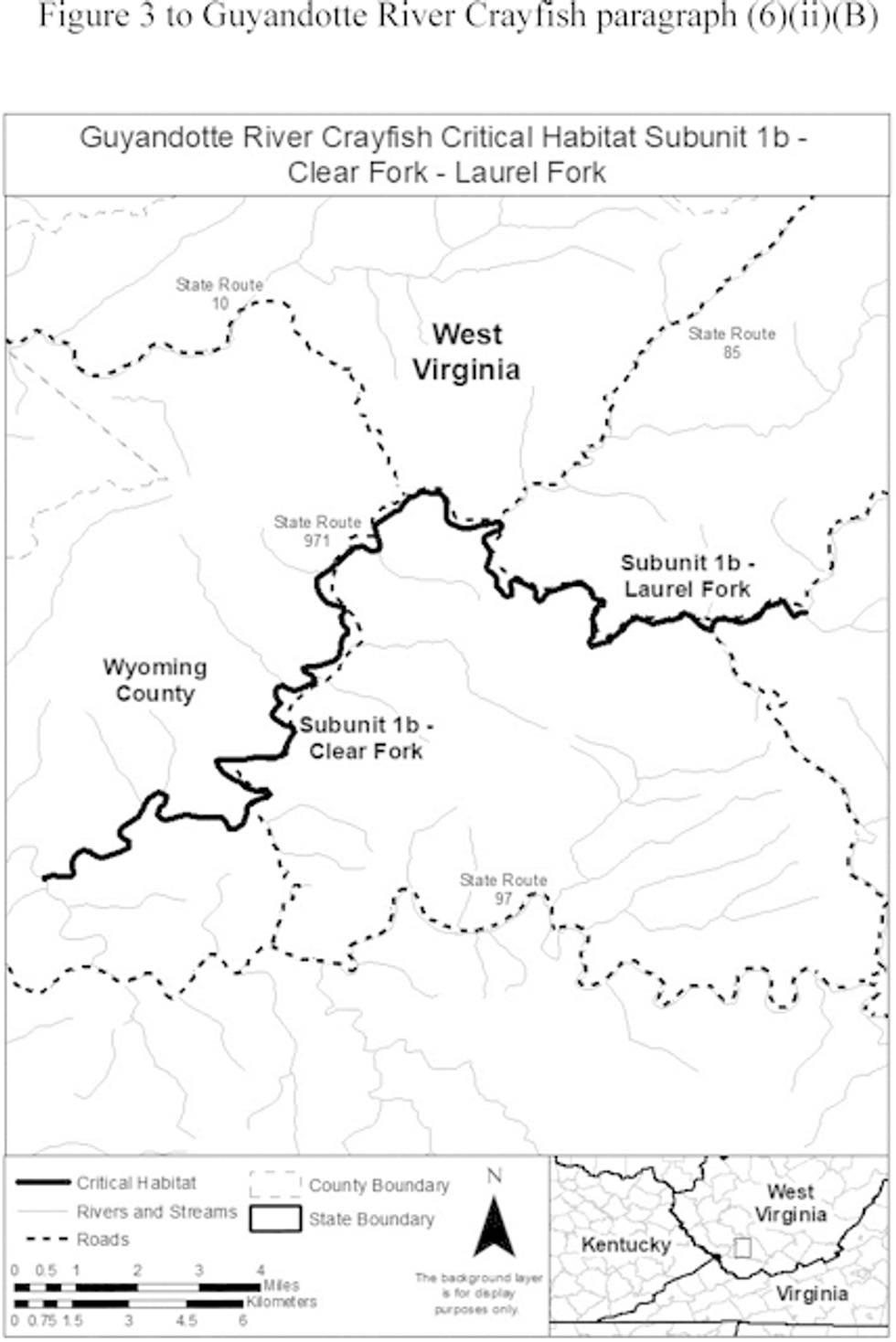
(iii) Subunit 1c: Guyandotte River, Wyoming County, West Virginia.
(A) Subunit 1c consists of approximately 35.8 skm (22.2 smi) of the Guyandotte River from its confluence with Pinnacle Creek at Pineville, West Virginia, downstream to its confluence with Clear Fork.
(B) Map of Subunit 1c follows:
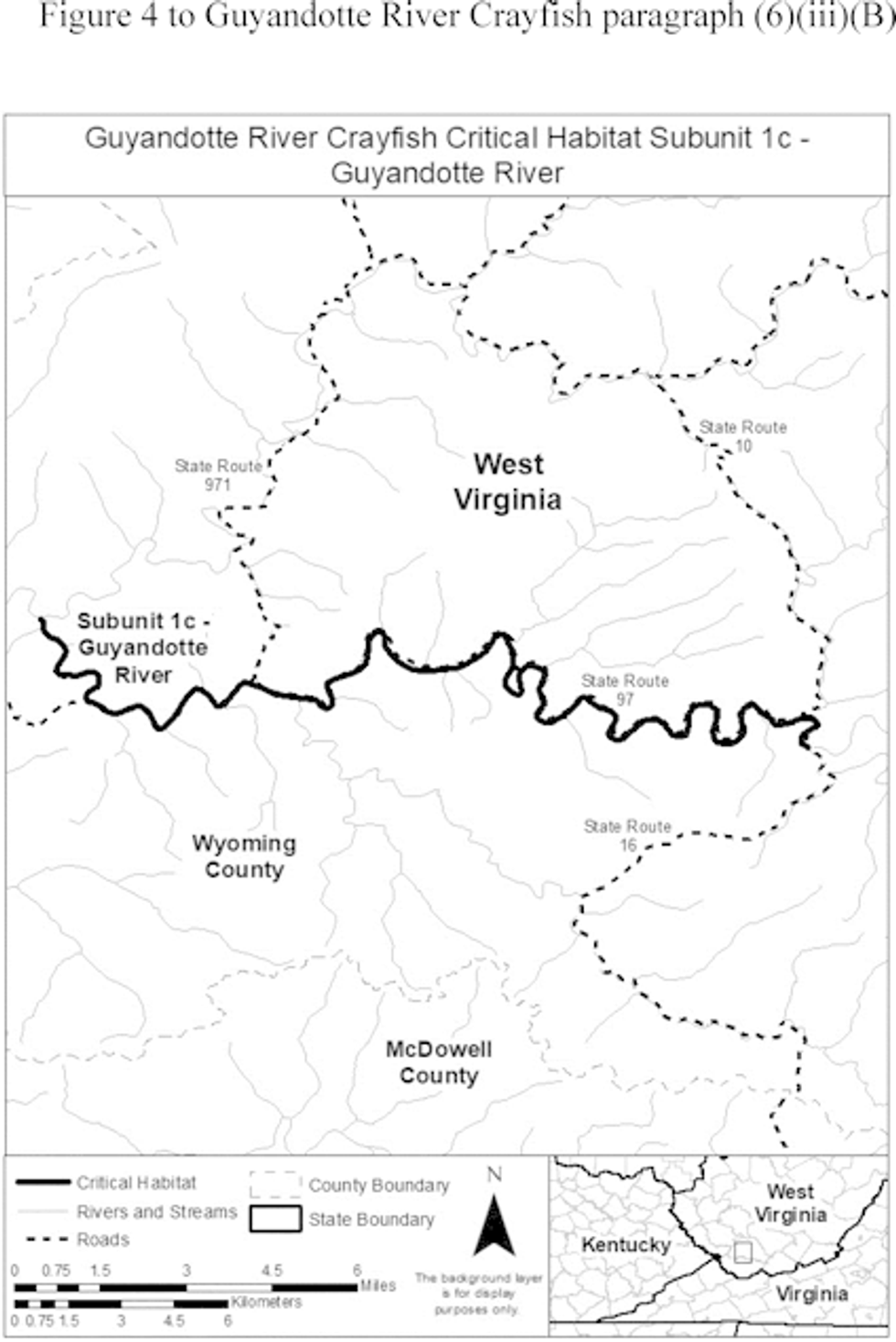
(iv) Subunit 1d: Indian Creek, Wyoming County, West Virginia.
(A) Subunit 1d consists of approximately 4.2 skm (2.6 smi) of Indian Creek from the confluence of Indian Creek and Brier Creek at Fanrock, West Virginia, to the confluence of Indian Creek and the Guyandotte River.
(B) Map of Subunit 1d follows:
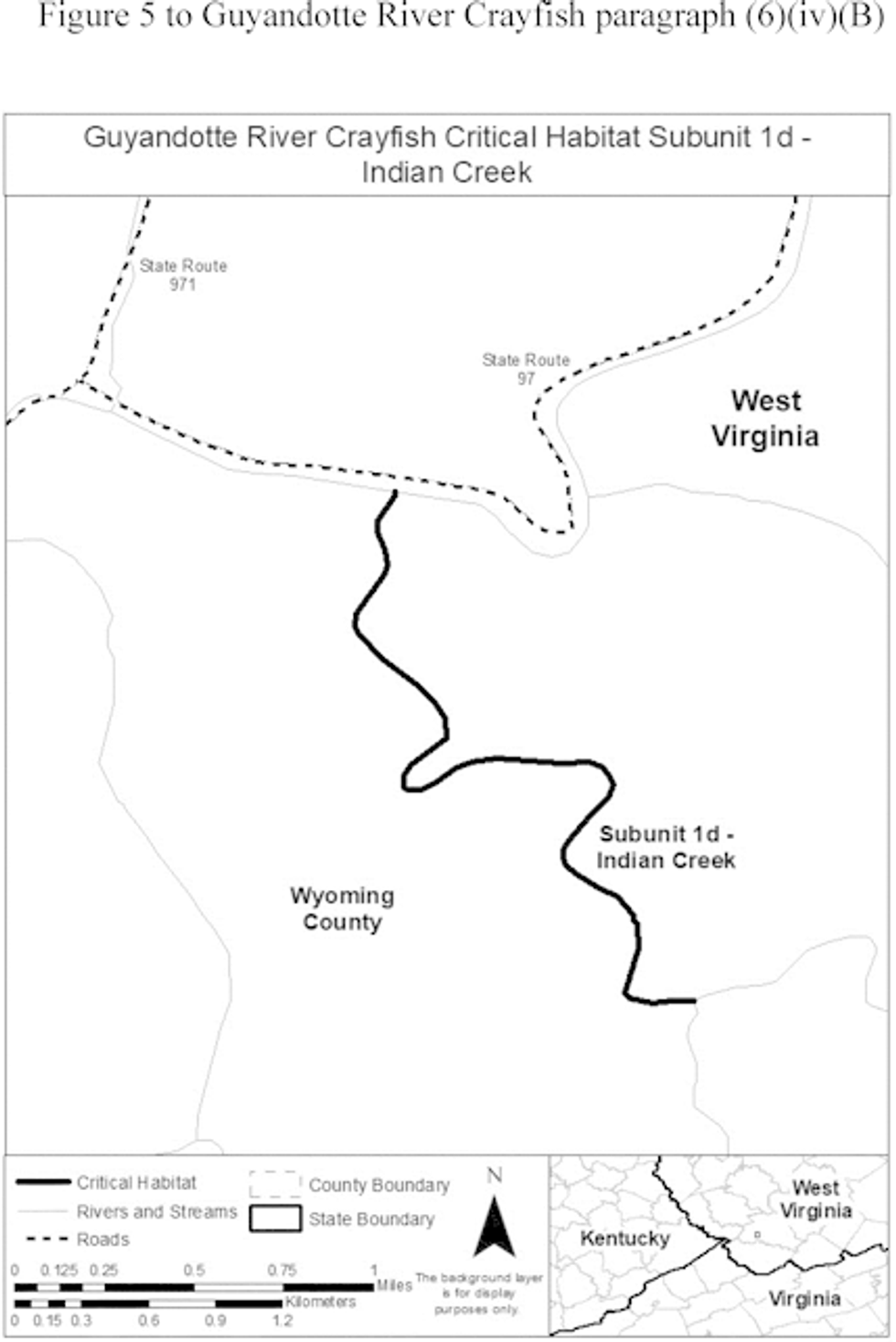
(v) Subunit 1e: Huff Creek, Wyoming and Logan Counties, West Virginia.
(A) Subunit 1e consists of approximately 28.0 skm (17.4 smi) of Huff Creek from its confluence with Straight Fork downstream to its confluence with the Guyandotte River at Huff, West Virginia.
(B) Map of Subunit 1e follows:
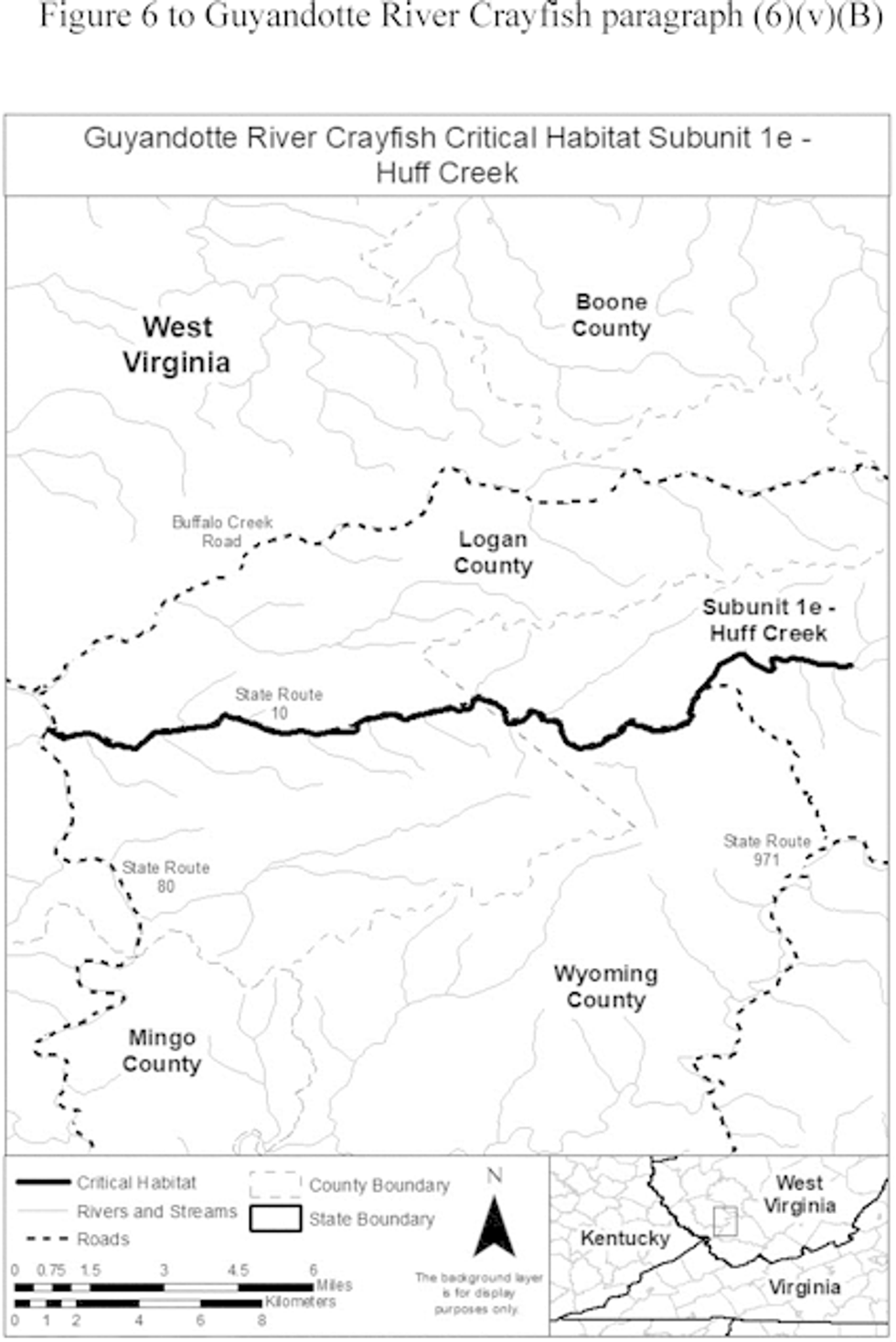
Panama City Crayfish (Procambarus econfinae)
(1) Critical habitat units are depicted for Bay County, Florida, on the maps in this entry.
(2) Within these areas, the physical or biological features essential to the conservation of Panama City crayfish consist of the following components:
(i) Undeveloped lands, including cropland, utilities rights-of-way, timberlands, and grazing lands, that support open wet pine flatwoods and wet prairie habitats that contain the following:
(A) Appropriate herbaceous ground cover vegetation;
(B) Permanent or temporary pools of shallow (usually less than 1 foot) freshwater locations; and
(C) Gently sloped ground-level swales with a 3:1 or shallower slope ratio along ecotonal or transitional areas.
(ii) Soil types within undeveloped lands that provide sediment structure needed for burrow construction and that support mostly native herbaceous vegetation needed for additional food and shelter, and where the ground water is always within 3 feet of the ground surface and surface waters occur on occasion. These soil types include:
(A) Core soils for Panama City crayfish, including Pamlico-Dorovan Complex, Rutlege Sand, Plummer Sand, Pelham Sand, Pantego Sandy Loam, and Rutledge-Pamlico Complex;
(B) Secondary soils within 50 feet (15 meters) of core soils: Albany Sand, Leefield Sand, Leon Fine Sand, Osier Fine Sand, and Alapaha Loamy Sand; and
(C) Soils that currently, or can eventually, support native herbaceous vegetation such as, but not limited to, wiregrass (Aristida beyrichiana), redroot (Lachnanthes caroliniana), beakrushes (Rhynchospora spp.), pitcher plants (Sarracenia spp.), sundews (Drosera spp.), butterworts (Pinguicula spp.), and lilies (Hymenocallis spp.).
(iii) Undeveloped lands that contain surface and groundwater of sufficient quality to support all life stages of the Panama City crayfish and the herbaceous vegetation on which they rely, specifically surface waters with:
(A) Oxygen levels that range between 2 and 9 milligrams per liter;
(B) pH levels between 4.1 and 9.2; and
(C) Temperatures between 42 and 94 degrees Fahrenheit (°F) (5 and 34.4 degrees Celsius (°C)), although optimum temperatures are thought to be in the range of 68 to 79 °F (20 to 26 °C).
(3) Critical habitat does not include manmade structures (such as buildings, aqueducts, runways, roads, and other paved areas) and the land on which they are located existing within the legal boundaries on February 4, 2022.
(4) Data layers defining map units were created based on known occurrences and habitat requirements. Critical habitat units were mapped in ArcMap (ESRI, Inc.) using the U.S. Department of Agriculture, Natural Resources Conservation Service, Soil Survey Geographic Database dataset. The maps in this entry, as modified by any accompanying regulatory text, establish the boundaries of the critical habitat designation. The coordinates or plot points or both on which each map is based are available to the public at https://www.regulations.gov at Docket No. FWS-R4-ES-2020-0137 and at the field office responsible for this designation. You may obtain field office location information by contacting one of the Service regional offices, the addresses of which are listed at 50 CFR 2.2.
(5) Note: Index map follows:
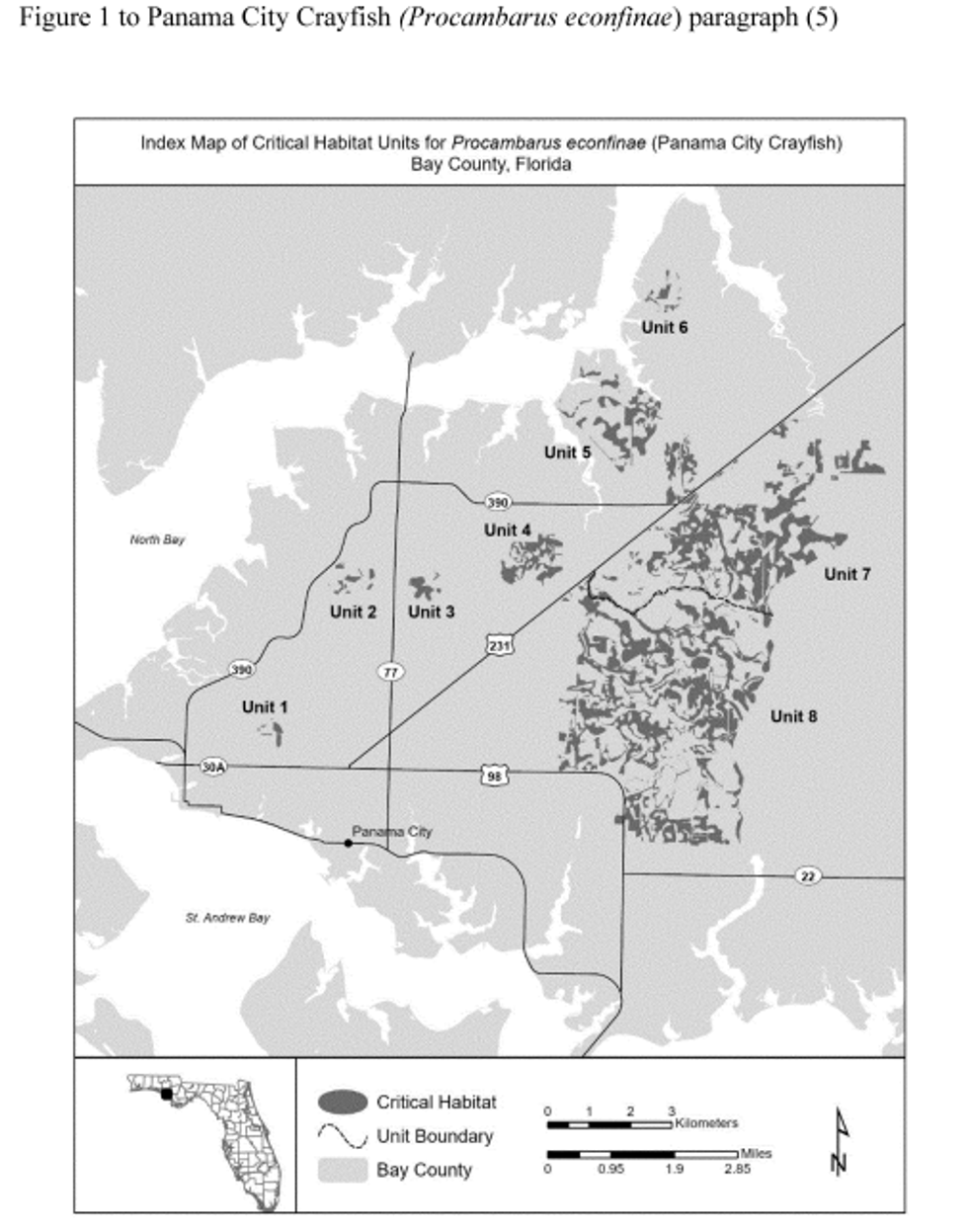
(6) Unit 1: 19th Street, Bay County, Florida.
(i) Unit 1 consists of 23.2 acres (9.4 ha) and is composed of lands in State, county, or city ownership (3.7 ac (1.5 ha)), and private ownership (19.5 ac (7.9 ha)).
(ii) Map of Units 1, 2, 3, and 4 follows:
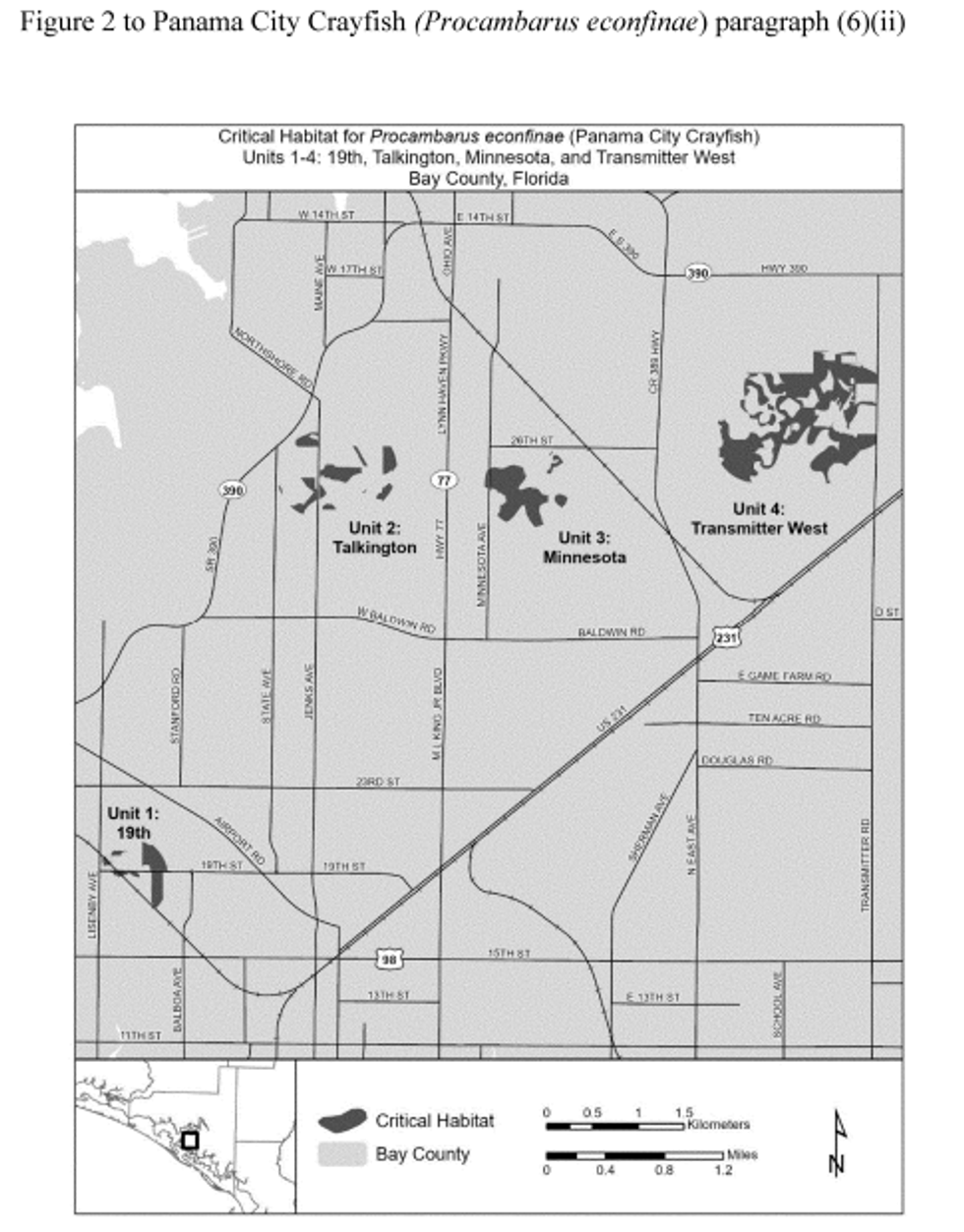
(7) Unit 2: Talkington, Bay County, Florida.
(i) Unit 2 consists of 37.2 acres (15.1 ha) and is composed of lands in State, county, or city ownership (4.09 ac (1.7 ha)), and private ownership (33.08 ac (13.4 ha)).
(ii) Map of Unit 2 is provided at paragraph (6)(ii) of this entry.
(8) Unit 3: Minnesota, Bay County, Florida.
(i) Unit 3 consists of 49.0 acres (19.8 ha) and is composed of lands in State, county, or city ownership (30.0 ac (12.1 ha)), and private ownership (19.1 ac (7.7 ha)).
(ii) Map of Unit 3 is provided at paragraph (6)(ii) of this entry.
(9) Unit 4: Transmitter West, Bay County, Florida.
(i) Unit 4 consists of 181.8 acres (73.6 ha) and is composed of lands in State, county, or city ownership (2.2 ac (0.9 ha)), and private ownership (179.6 ac (72.7 ha)).
(ii) Map of Unit 4 is provided at paragraph (6)(ii) of this entry.
(10) Unit 5: Deer Point, Bay County, Florida.
(i) Unit 5 consists of 278.8 ac (112.8 ha) and is composed of lands in State, county, or city ownership (4.5 ac (1.8 ha)), and private ownership (274.3 ac (111.0 ha)).
(ii) Map of Units 5 and 6 follows:
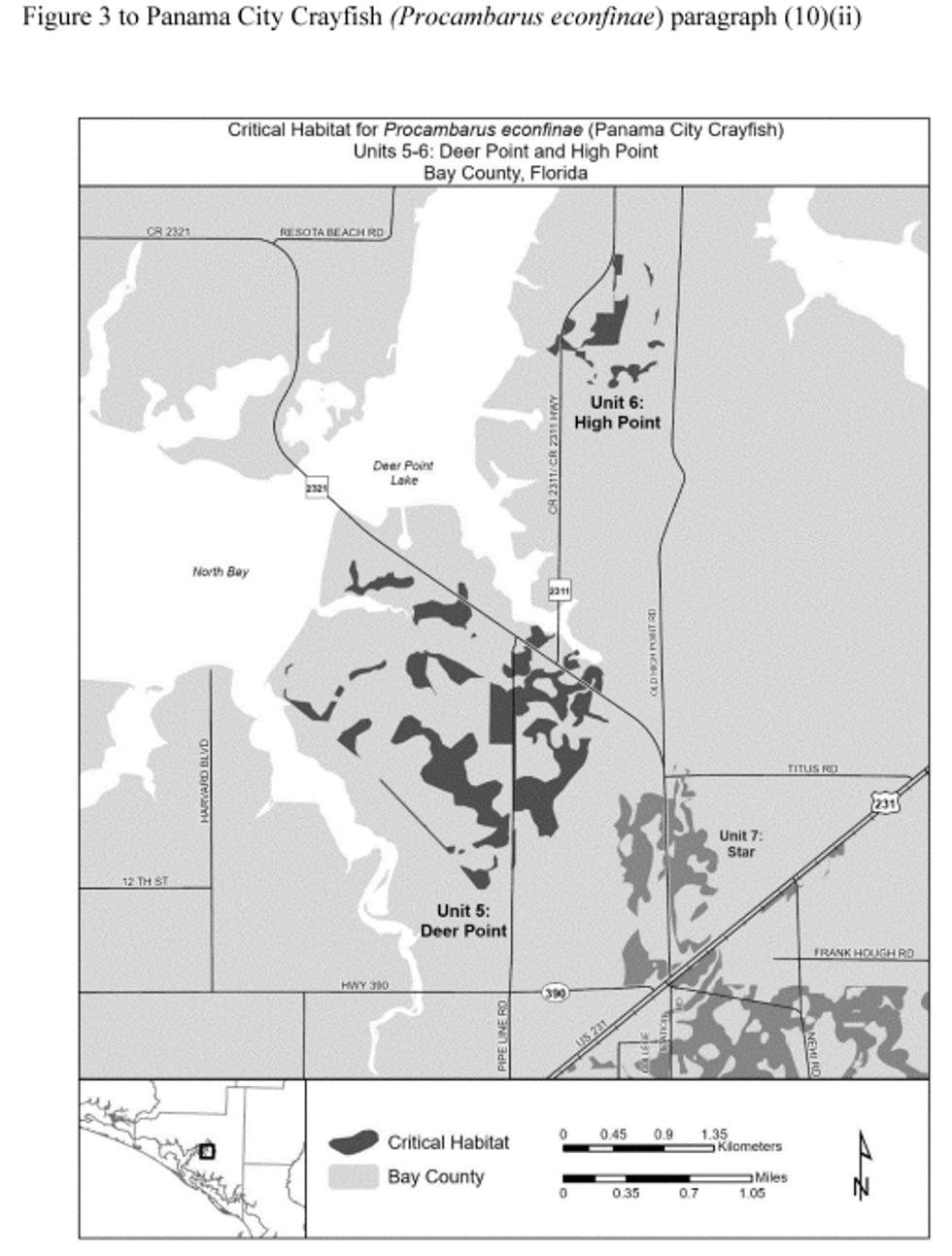
(11) Unit 6: High Point, Bay County, Florida.
(i) Unit 6 consists of 36.8 ac (14.9 ha) and is composed of lands in State, county, or city ownership (0.5 ac (0.2 ha)), and private ownership (36.3 ac (14.7 ha)).
(ii) Map of Unit 6 is provided at paragraph (10)(ii) of this entry.
(12) Unit 7: Star, Bay County, Florida.
(i) Unit 7 consists of 1,424.3 ac (576.4 ha) and is composed of lands in State, county, or city ownership (6.5 ac (2.6 ha)), and private ownership (1,417.8 ac (573.8 ha)).
(ii) Map of Units 7 and 8 follows:
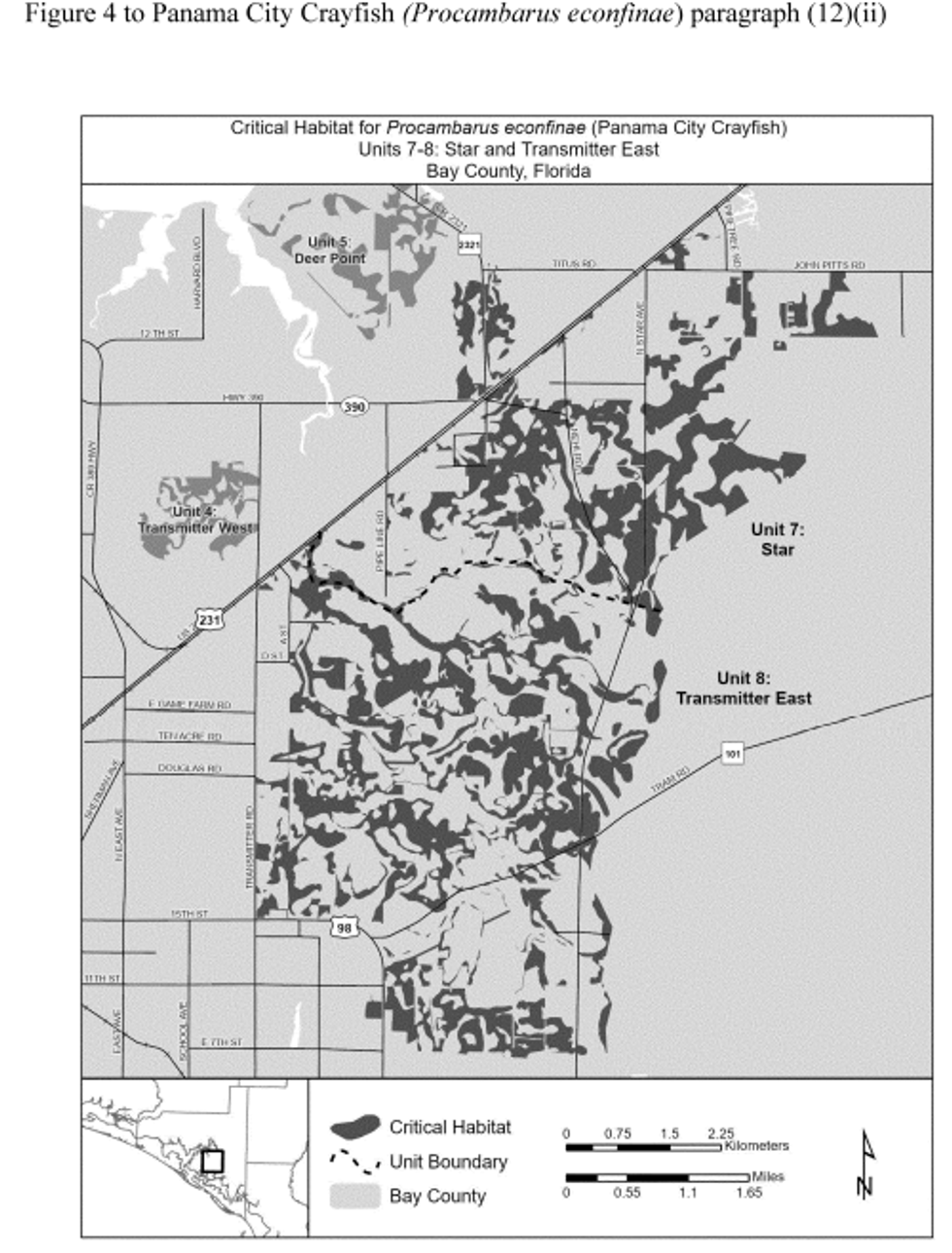
(13) Unit 8: Transmitter East, Bay County, Florida.
(i) Unit 8 consists of 2,107.4 ac (852.8 ha) and is composed of lands in State, county, or city ownership (49.9 ac (20.2 ha)), and private ownership (2,057.5 ac (832.6 ha)).
(ii) Map of Unit 8 is provided at paragraph (12)(ii) of this entry.
Slenderclaw Crayfish (Cambarus cracens)
(1) Critical habitat units are depicted for DeKalb and Marshall Counties, Alabama, on the maps in this entry.
(2) Within these areas, the physical or biological features essential to the conservation of the slenderclaw crayfish consist of the following components:
(i) Geomorphically stable, small to medium, flowing streams:
(A) That are typically 19.8 feet (ft) (6 meters (m)) wide or smaller;
(B) With attributes ranging from:
(1) Streams with predominantly large boulders and fractured bedrock, with widths from 16.4 to 19.7 ft (5 to 6 m), low to no turbidity, and depths up to 2.3 ft (0.7 m); to
(2) Streams dominated by small substrate types with a mix of cobble, gravel, and sand, with widths of approximately 9.8 feet (3 m), low to no turbidity, and depths up to 0.5 feet (0.15 m);
(C) With substrate consisting of boulder and cobble containing abundant interstitial spaces for sheltering and breeding; and
(D) With intact riparian cover to maintain stream morphology and to reduce erosion and sediment inputs.
(ii) Seasonal water flows, or a hydrologic flow regime (which includes the severity, frequency, duration, and seasonality of discharge over time), necessary to maintain benthic habitats where the species is found and to maintain connectivity of streams with the floodplain, allowing the exchange of nutrients and sediment for maintenance of the crayfish's habitat and food availability.
(iii) Appropriate water and sediment quality (including, but not limited to, conductivity; hardness; turbidity; temperature; pH; and minimal levels of ammonia, heavy metals, pesticides, animal waste products, and nitrogen, phosphorus, and potassium fertilizers) necessary to sustain natural physiological processes for normal behavior, growth, and viability of all life stages.
(iv) Prey base of aquatic macroinvertebrates and detritus. Prey items may include, but are not limited to, insect larvae, snails and their eggs, fish and their eggs, and plant and animal detritus.
(3) Critical habitat does not include manmade structures (such as buildings, aqueducts, runways, roads, and other paved areas) and the land on which they are located existing within the legal boundaries on October 8, 2021.
(4) Data layers defining map units were created using Universal Transverse Mercator (UTM) Zone 16N coordinates and species' occurrence data. The hydrologic data used in the maps were extracted from U.S. Geological Survey National Hydrography Dataset High Resolution (1:24,000 scale) using Geographic Coordinate System North American 1983 coordinates. The maps in this entry, as modified by any accompanying regulatory text, establish the boundaries of the critical habitat designation. The coordinates or plot points or both on which each map is based are available to the public at http://www.regulations.gov under Docket No. FWS-R4-ES-2018-0069 and at the field office responsible for this designation. You may obtain field office location information by contacting one of the Service regional offices, the addresses of which are listed at 50 CFR 2.2.
(5) Note: Index map follows:
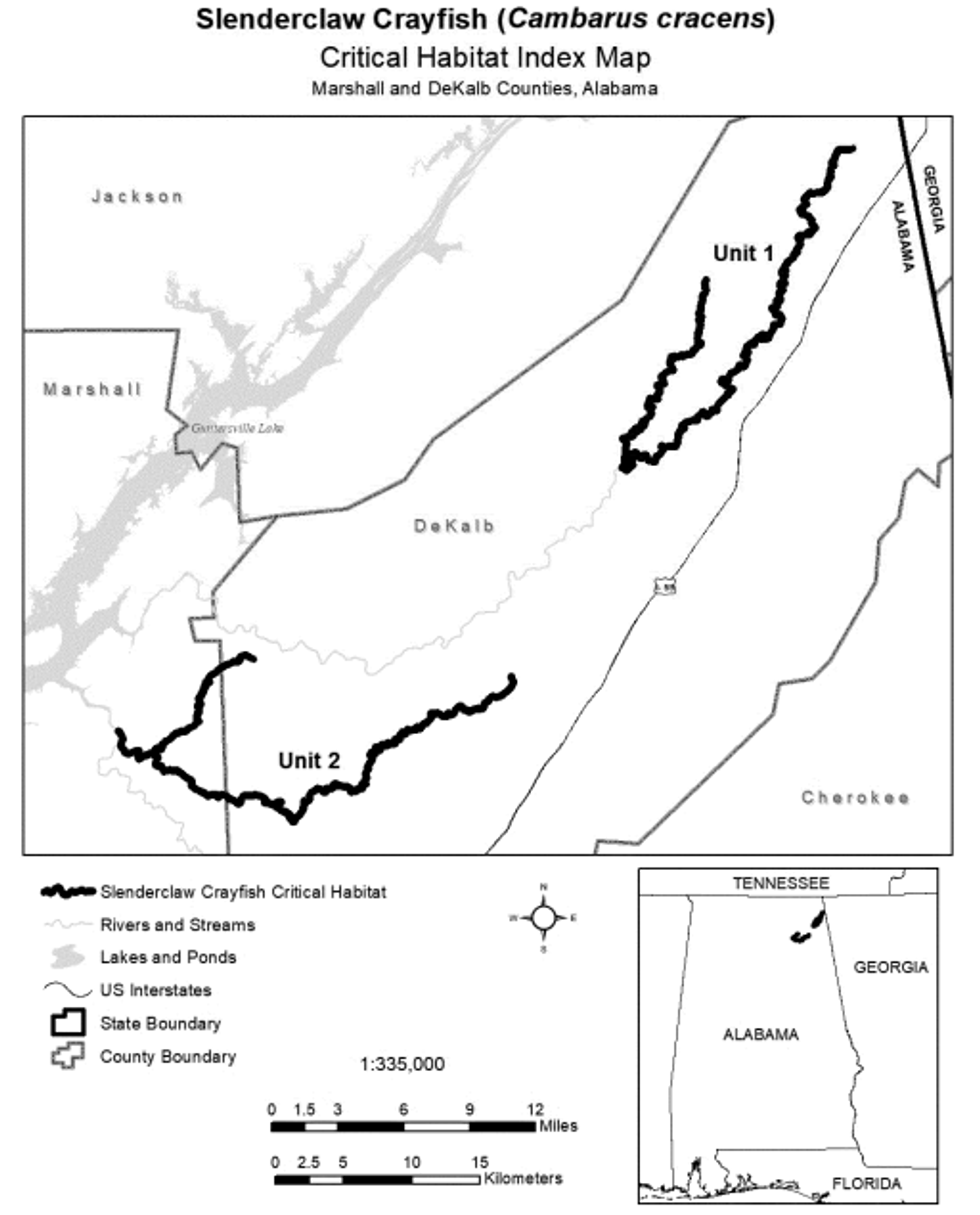
(6) Unit 1: Town Creek, DeKalb County, Alabama.
(i) This unit consists of 41.8 river miles (67.2 river kilometers) of occupied habitat in Bengis and Town Creeks. Unit 1 includes stream habitat up to bank full height consisting of the headwaters of Bengis Creek to its confluence with Town Creek and upstream to the headwaters of Town Creek.
(ii) Map of Unit 1 follows:
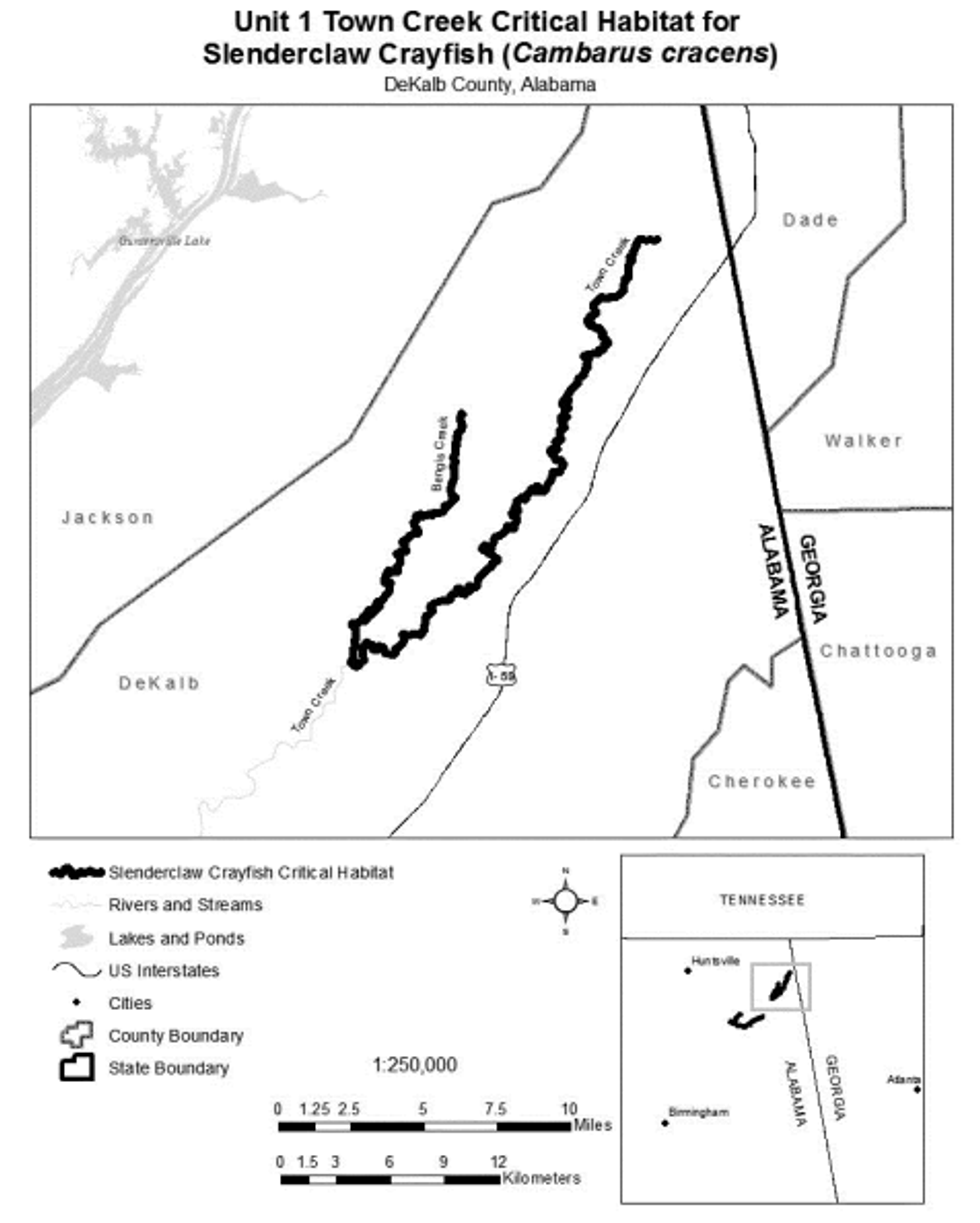
(7) Unit 2: Short Creek, DeKalb and Marshall Counties, Alabama.
(i) Subunit 2a: Shoal Creek and Short Creek, DeKalb and Marshall Counties, Alabama.
(A) This subunit consists of 10.3 river miles (16.6 river kilometers) of occupied habitat in Scarham, Shoal, Short, and Whippoorwill Creeks. Subunit 2a includes stream habitat up to bank full height consisting of the headwaters of Shoal Creek to its confluence with Whippoorwill Creek, Whippoorwill Creek to its confluence with Scarham Creek, Scarham Creek to its confluence with Short Creek, and Short Creek to its downstream extent to the Guntersville Lake Tennessee Valley Authority project boundary.
(B) Map of Subunit 2a follows:
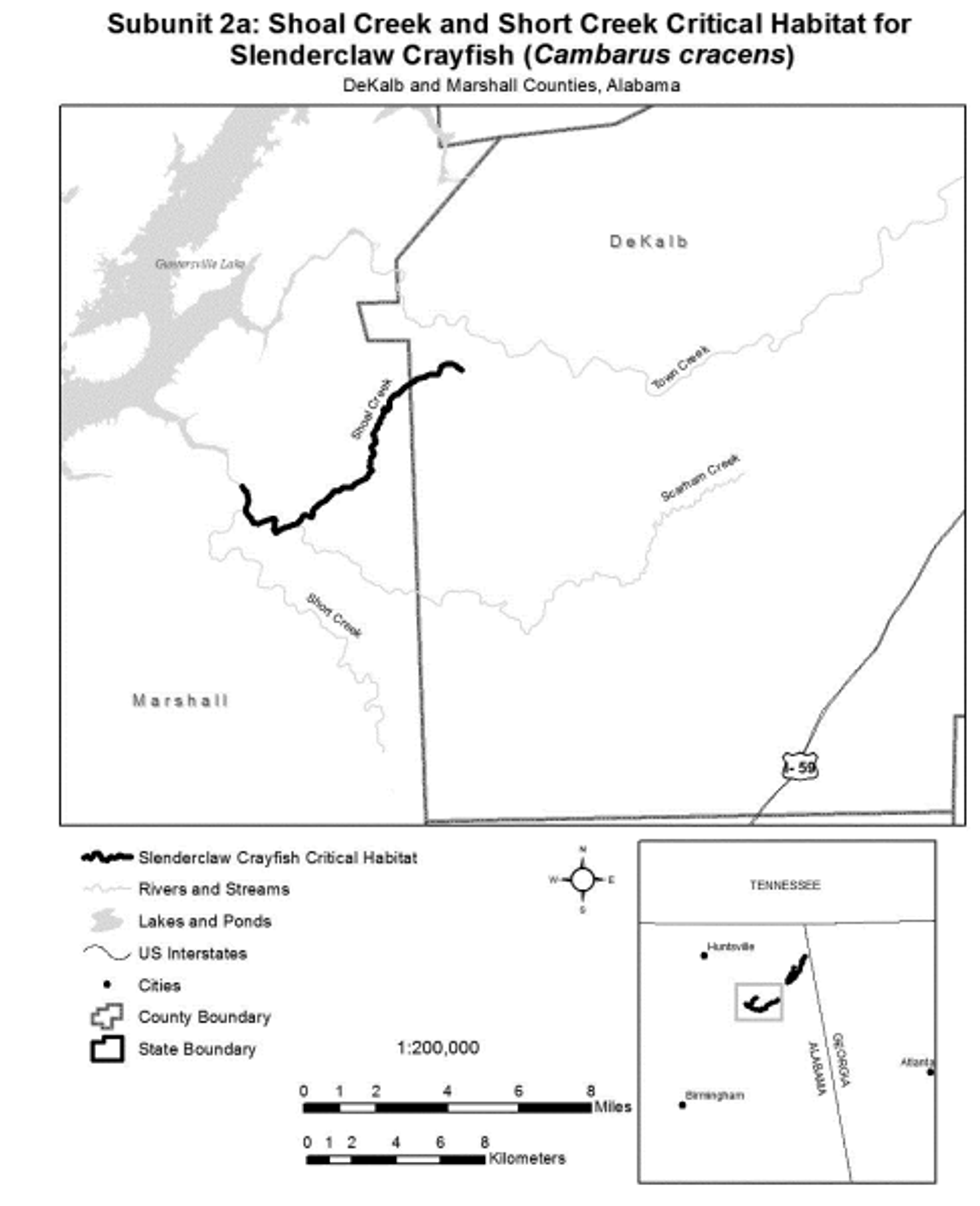
(ii) Subunit 2b: Scarham-Laurel Creek, DeKalb and Marshall Counties, Alabama.
(A) This subunit consists of 25.9 river miles (41.7 river kilometers) of unoccupied habitat in Scarham-Laurel Creek. Subunit 2b includes stream habitat up to bank full height consisting of the headwaters of Scarham-Laurel Creek to its confluence with Whippoorwill Creek. This subunit is a small to medium, flowing stream with substrate consisting of boulder and cobble containing interstitial spaces for sheltering and breeding and connected to the occupied subunit 2a.
(B) Map of Subunit 2b follows:
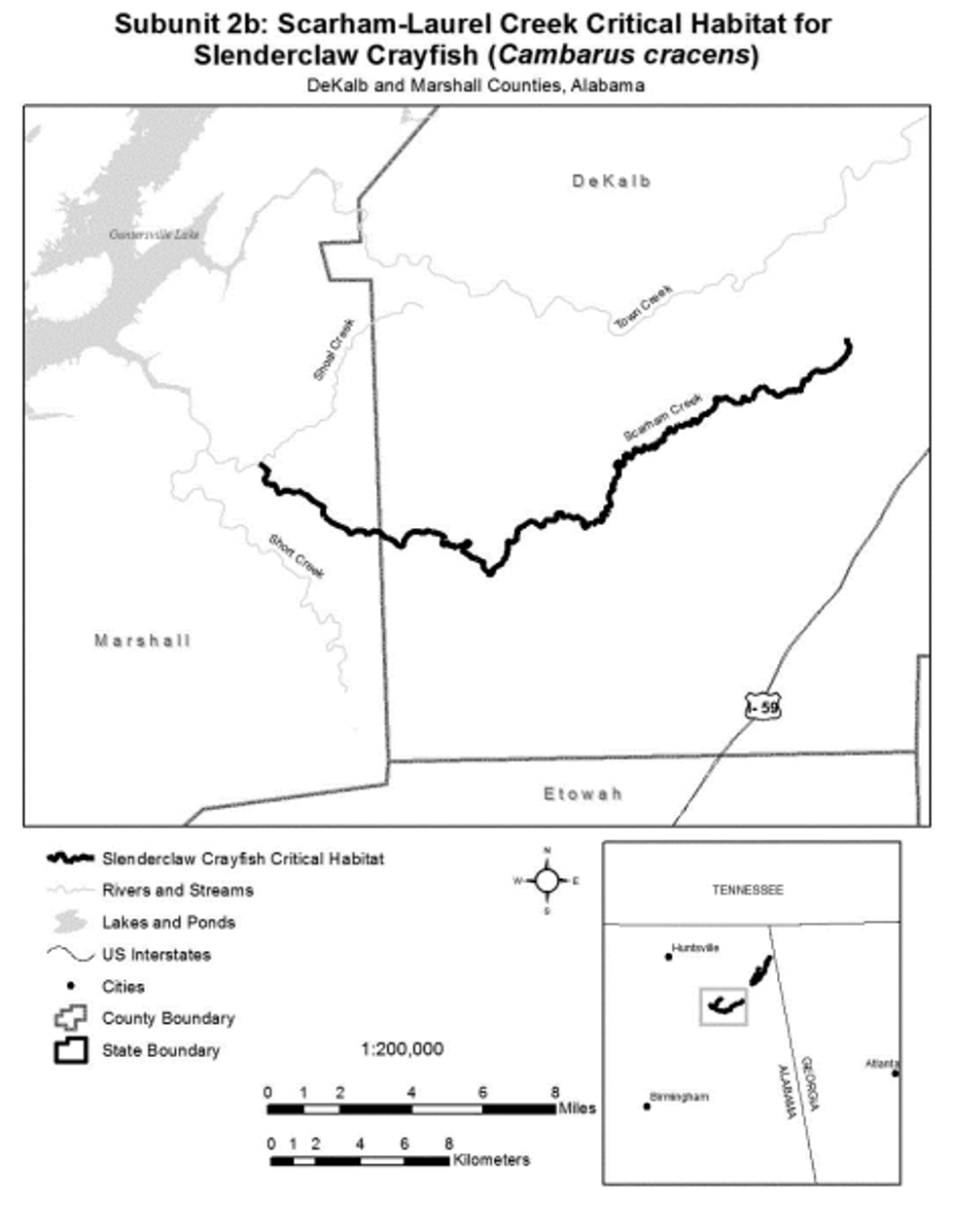
St. Francis River Crayfish (Faxonius quadruncus)
(1) The critical habitat unit is depicted for Iron, Madison, St. Francois, Washington, and Wayne Counties in Missouri, on the map in this entry.
(2) Within the critical habitat unit, the physical or biological features essential to the conservation of the St. Francis River crayfish consist of the following components:
(i) Stream flow velocity generally between 0 and 1.1 feet per second (ft/s) (0 and 0.35 meters per second (m/s)).
(ii) Stream depths generally between 0.2 and 1.7 feet (0.06 and 0.52 meters).
(iii) Water temperatures between 34 and 84°F (1.1 and 28.9°C).
(iv) Adequately low stream embeddedness so that spaces under rocks and cavities in gravel remain available to the St. Francis River crayfish.
(v) An available forage and prey base consisting of invertebrates, periphyton, and plant detritus.
(vi) Connectivity among occupied stream reaches of the St. Francis River crayfish (both within and among occupied subwatersheds).
(vii) Adequately low ratios or densities of nonnative species that allow for maintaining populations of the St. Francis River crayfish.
(3) Critical habitat does not include manmade structures (such as buildings, aqueducts, runways, roads, and other paved areas) and the land on which they are located existing within the legal boundaries on May 30, 2023.
(4) The National Hydrography Dataset Plus (NHD Plus) was the geospatial data used to delineate critical habitat. NHD Plus is a national geospatial surface water framework that integrates the National Hydrography Dataset with the National Elevation Dataset and the Watershed Boundary Dataset. NHD Plus uses medium resolution (1:100,000-scale) data with a geographic projection and NAD83 Datum. Critical habitat was delineated by including all streams within subwatersheds (at the 12-digit hydrologic unit level) occupied by the St. Francis River crayfish. Occupied watersheds were defined using data from the Missouri Department of Conservation; the entire St. Francis River upstream of 36.982104N, 90.335400W is also considered occupied as a migratory route. The map in this entry, as modified by any accompanying regulatory text, establishes the boundaries of the critical habitat designation. The coordinates or plot points or both on which the map is based are available to the public at https://www.regulations.gov under Docket No. FWS–R3–ES–2019–0020 and at the Missouri Ecological Services Field Office. You may obtain field office location information by contacting one of the Service regional offices, the addresses of which are listed at 50 CFR 2.2.
(5) St. Francis River Crayfish Unit—Iron, Madison, St. Francois, Washington, and Wayne Counties, Missouri.
(i) The unit consists of all of the streams (approximately 1,043 river miles (1,679 kilometers)) upstream of Wappapello Dam in the following subwatersheds (numbers in parentheses represent the 12-digit hydrologic codes): Blankshire Branch-St. Francis River (80202020204), Captain Creek-St. Francis River (80202020405), Cedar Bottom Creek-St. Francis River (80202020402), Headwaters St. Francis River (80202020201), Headwaters Stouts Creek (80202020207), Hubble Creek-St. Francis River (80202020502), Leatherwood Creek-St. Francis River (80202020406), Little St. Francis River (80202020103), Lost Creek (80202020507), Marble Creek (80202020401), Musco Creek-Little St. Francis River (80202020101), O'Bannon Creek-St. Francis River (80202020206), Saline Creek-Little St. Francis River (80202020102), Stouts Creek (80202020208), Turkey Creek-St. Francis River (80202020210), and Wachita Creek-St. Francis River (80202020209). The unit also consists of the entire St. Francis River upstream of 36.982104N, 90.335400W. The unit does not include any areas of adjacent land. The Upper St. Francis River Watershed Unit includes stream habitat up to bank full height.
(ii) Map of St. Francis River Crayfish Unit of St. Francis River crayfish critical habitat follows:
Figure 1 for St. Francis River Crayfish (Faxonius quadruncus) paragraph (5)(ii)
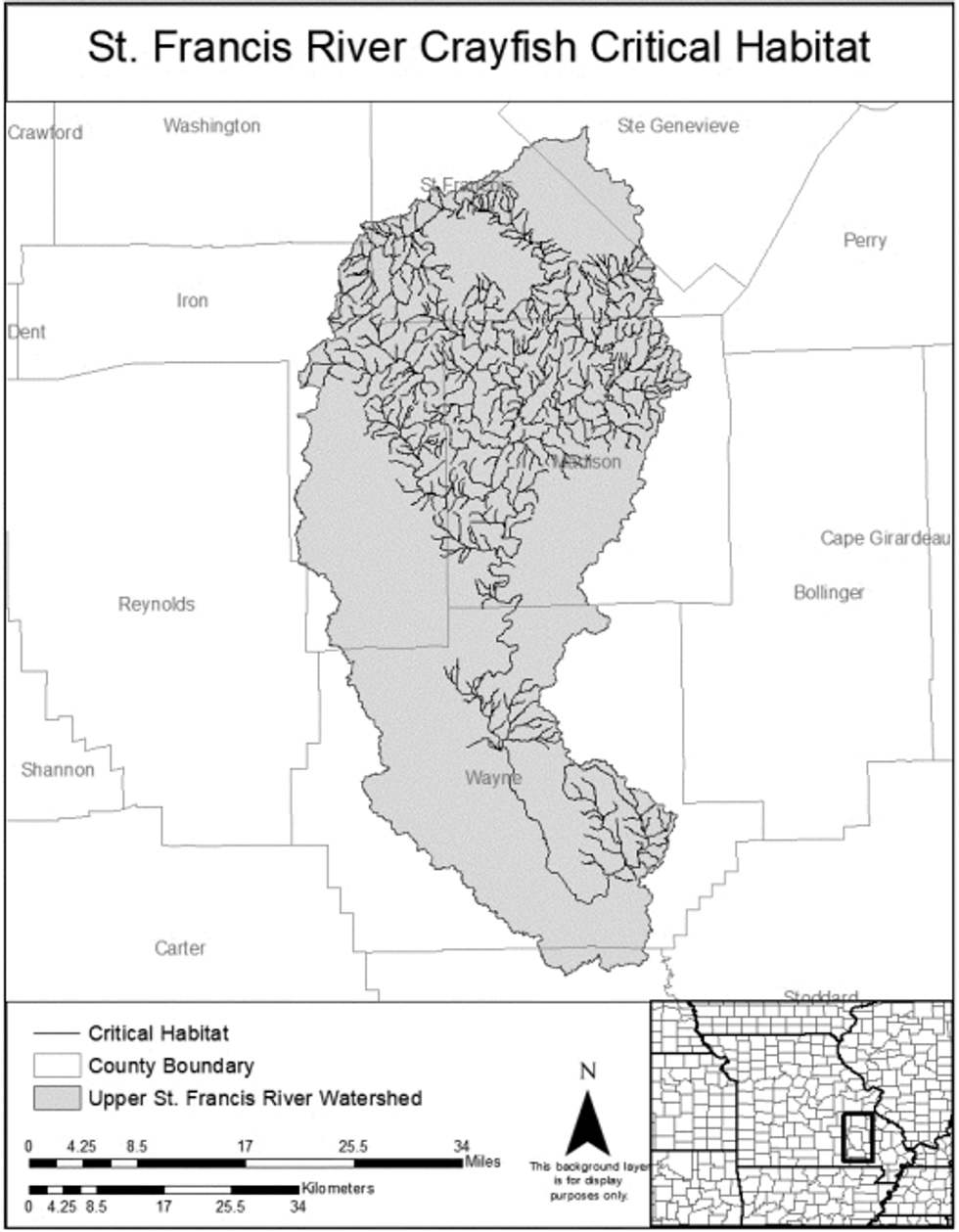
Conservancy Fairy Shrimp (Branchinecta conservatio).
(1) Critical habitat units are depicted for Butte, Colusa, Mariposa, Merced, Solano, Stanislaus, Tehama, and Ventura Counties, California, on the maps below.
(2) The primary constituent elements of critical habitat for Conservancy fairy shrimp (Branchinecta conservatio) are the habitat components that provide:
(i) Topographic features characterized by mounds and swales and depressions within a matrix of surrounding uplands that result in complexes of continuously, or intermittently, flowing surface water in the swales connecting the pools described below in paragraph (2)(ii), providing for dispersal and promoting hydroperiods of adequate length in the pools;
(ii) Depressional features including isolated vernal pools with underlying restrictive soil layers that become inundated during winter rains and that continuously hold water for a minimum of 19 days, in all but the driest years; thereby providing adequate water for incubation, maturation, and reproduction. As these features are inundated on a seasonal basis, they do not promote the development of obligate wetland vegetation habitats typical of permanently flooded emergent wetlands;
(iii) Sources of food, expected to be detritus occurring in the pools, contributed by overland flow from the pools' watershed, or the results of biological processes within the pools themselves, such as single-celled bacteria, algae, and dead organic matter, to provide for feeding; and
(iv) Structure within the pools described above in paragraph (2)(ii), consisting of organic and inorganic materials, such as living and dead plants from plant species adapted to seasonally inundated environments, rocks, and other inorganic debris that may be washed, blown, or otherwise transported into the pools, that provide shelter.
(3) Existing manmade features and structures, such as buildings, roads, railroads, airports, runways, other paved areas, lawns, and other urban landscaped areas do not contain one or more of the primary constituent elements. Federal actions limited to those areas, therefore, would not trigger a consultation under section 7 of the Act unless they may affect the species and/or primary constituent elements in adjacent critical habitat.
(4) Unit 1 Tehama County, California.
(i) [Reserved]
(ii) Unit 1 (Map 1) follows:
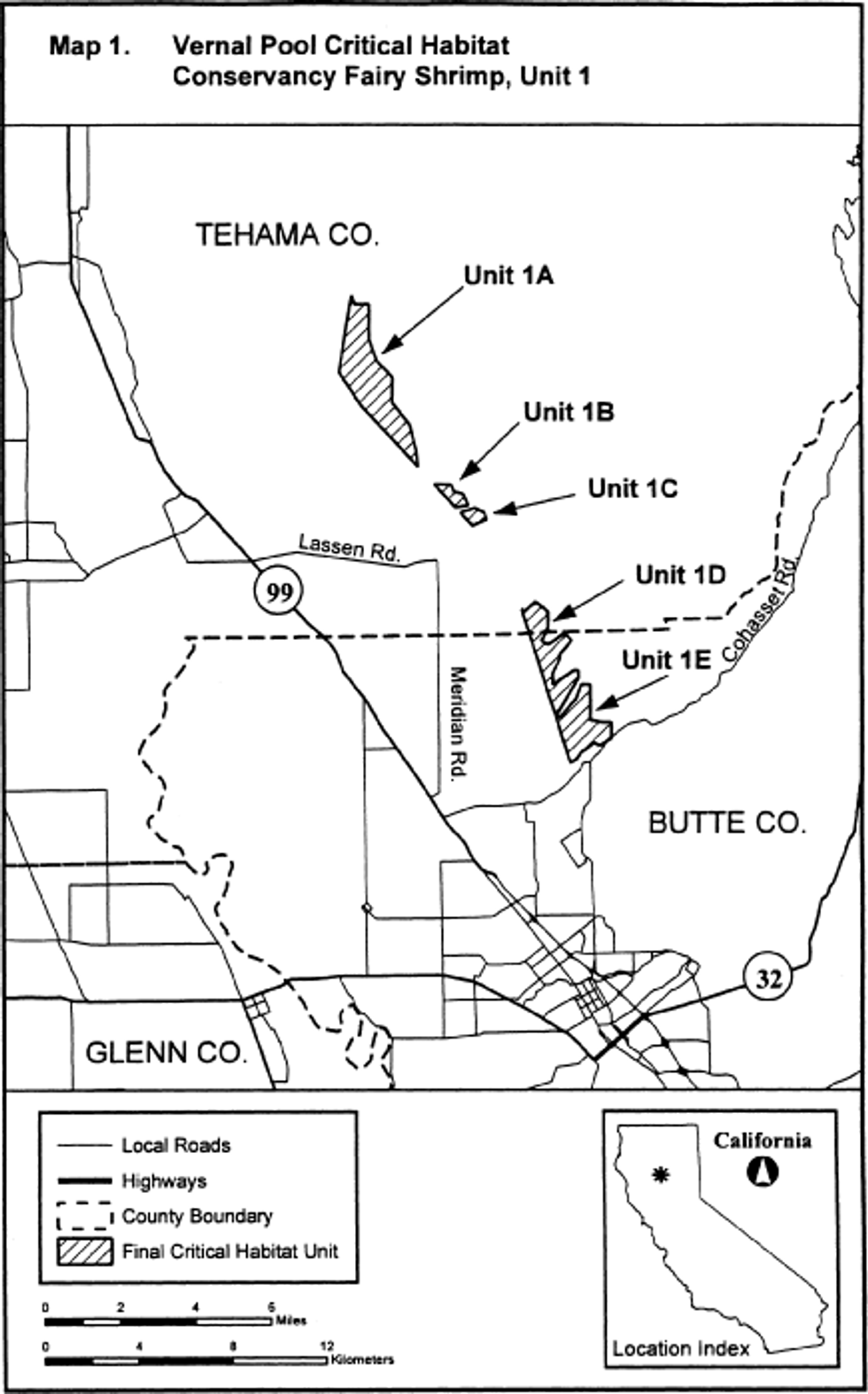
(5) Unit 3: Solano County, California. From USGS 1:24,000 topographic quadrangles Elmira, and Denverton.
(6) Unit 3 (Map 2) follows:
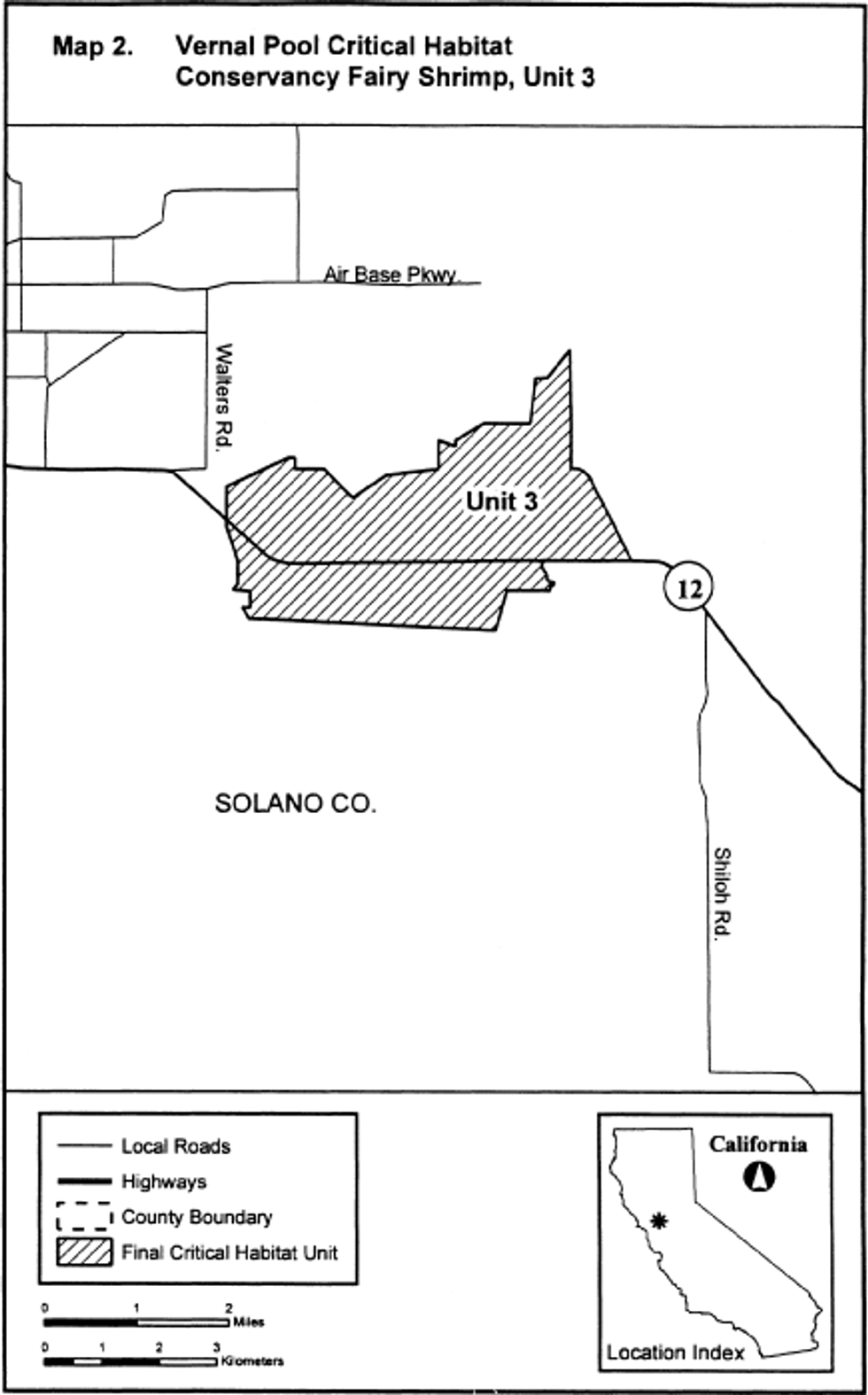
(7) Unit 5: Stanislaus County, California. From USGS 1:24,000 topographic quadrangle Ripon.
(8) Unit 5 (Map 3) follows:
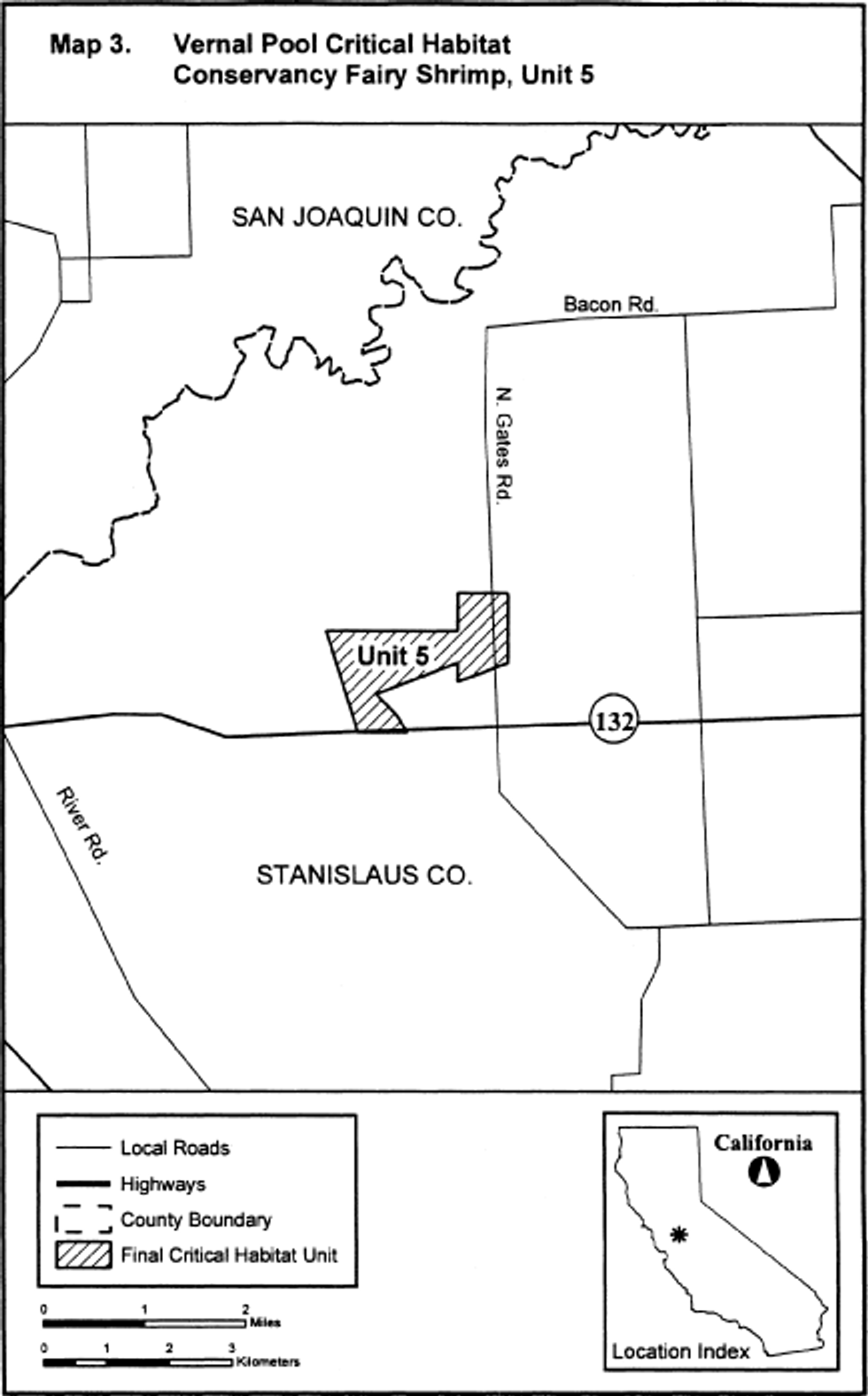
(9) Unit 6: Merced County, and Mariposa County, California.
(10) Unit 6 (Map 4) follows:
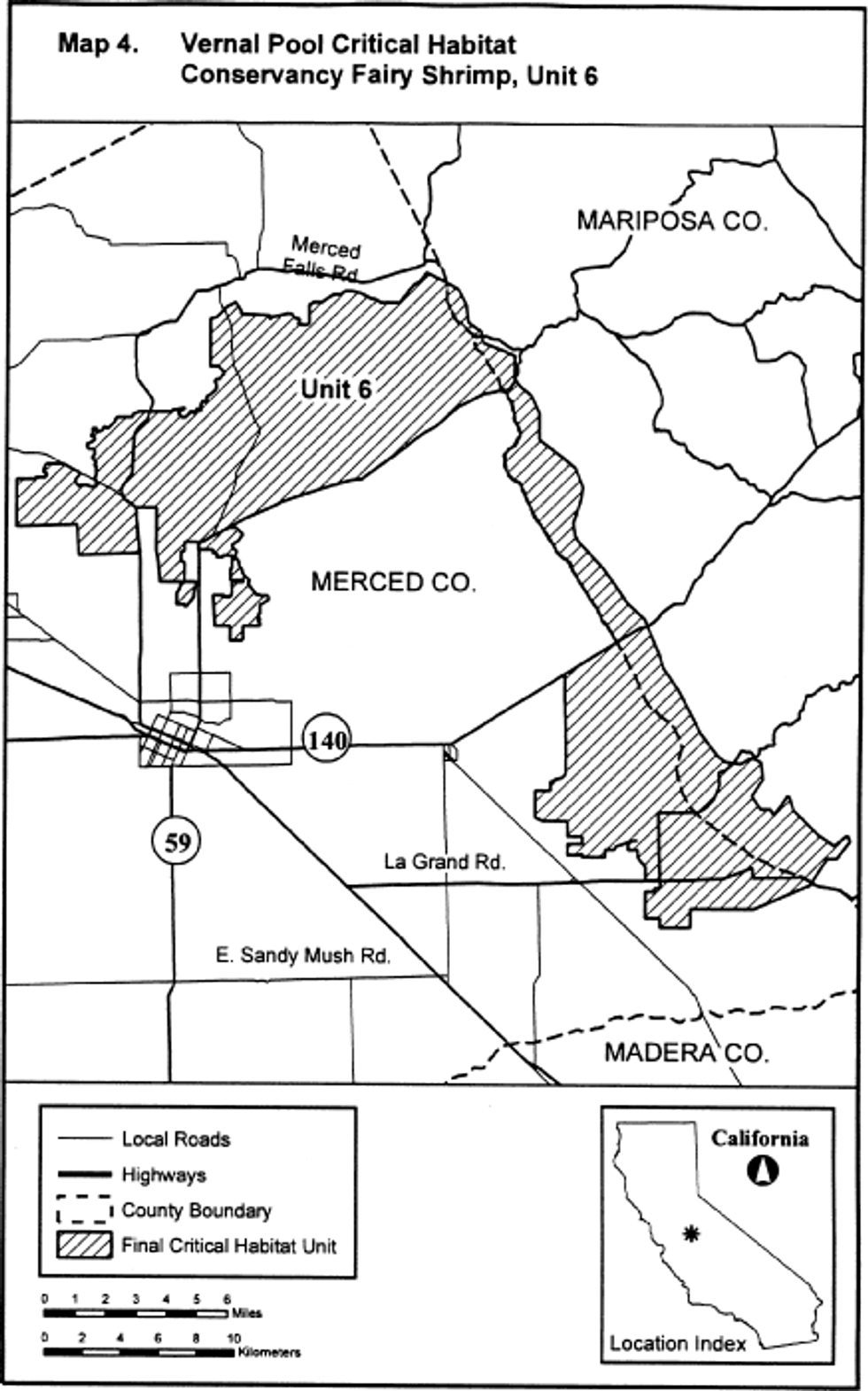
(11) Unit 7: Merced County, California.
(i) [Reserved]
(ii) Unit 7 (Map 5) follows:
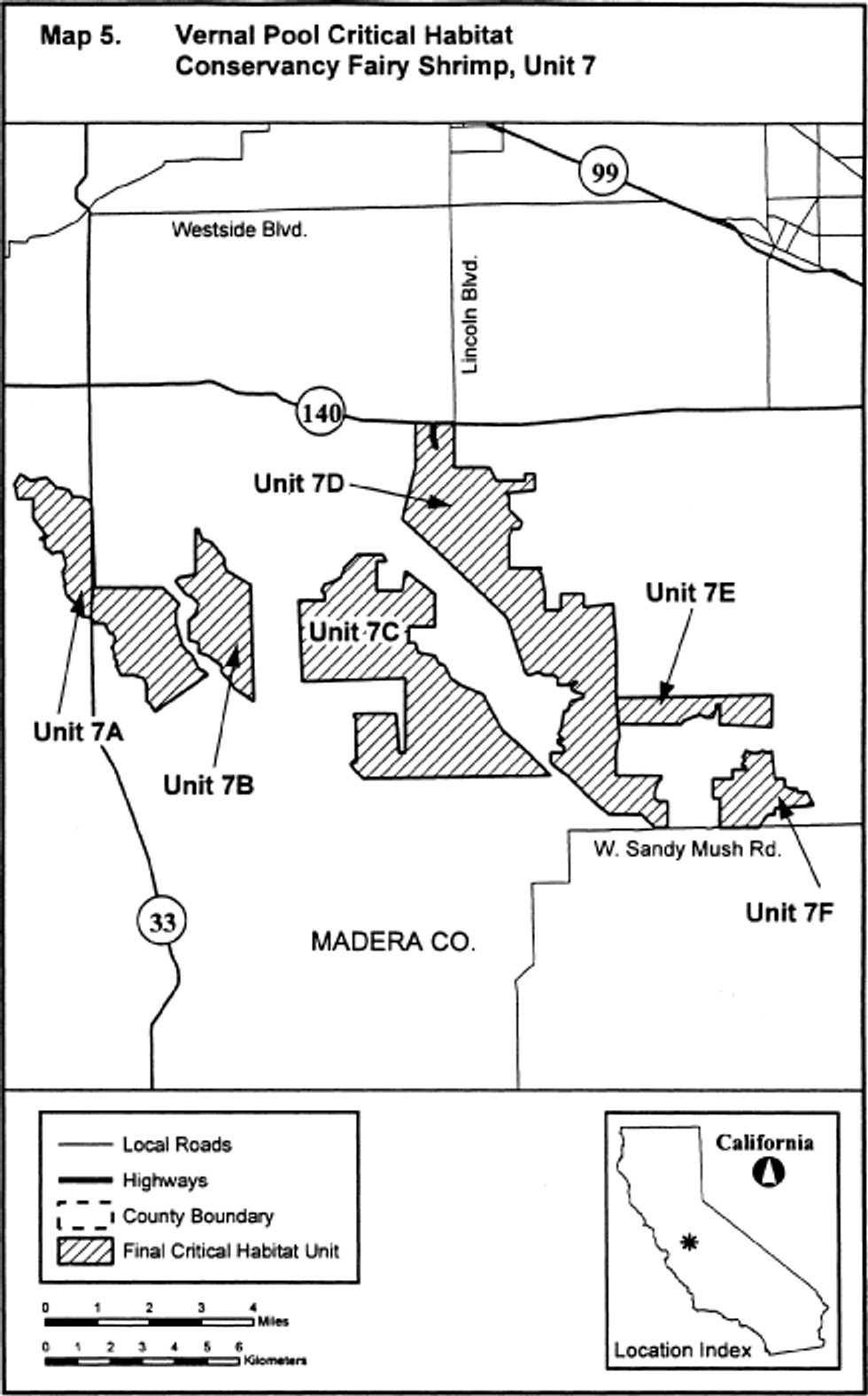
(12) Unit 8: Ventura County, California.
(13) Unit 8 (Map 6) follows:
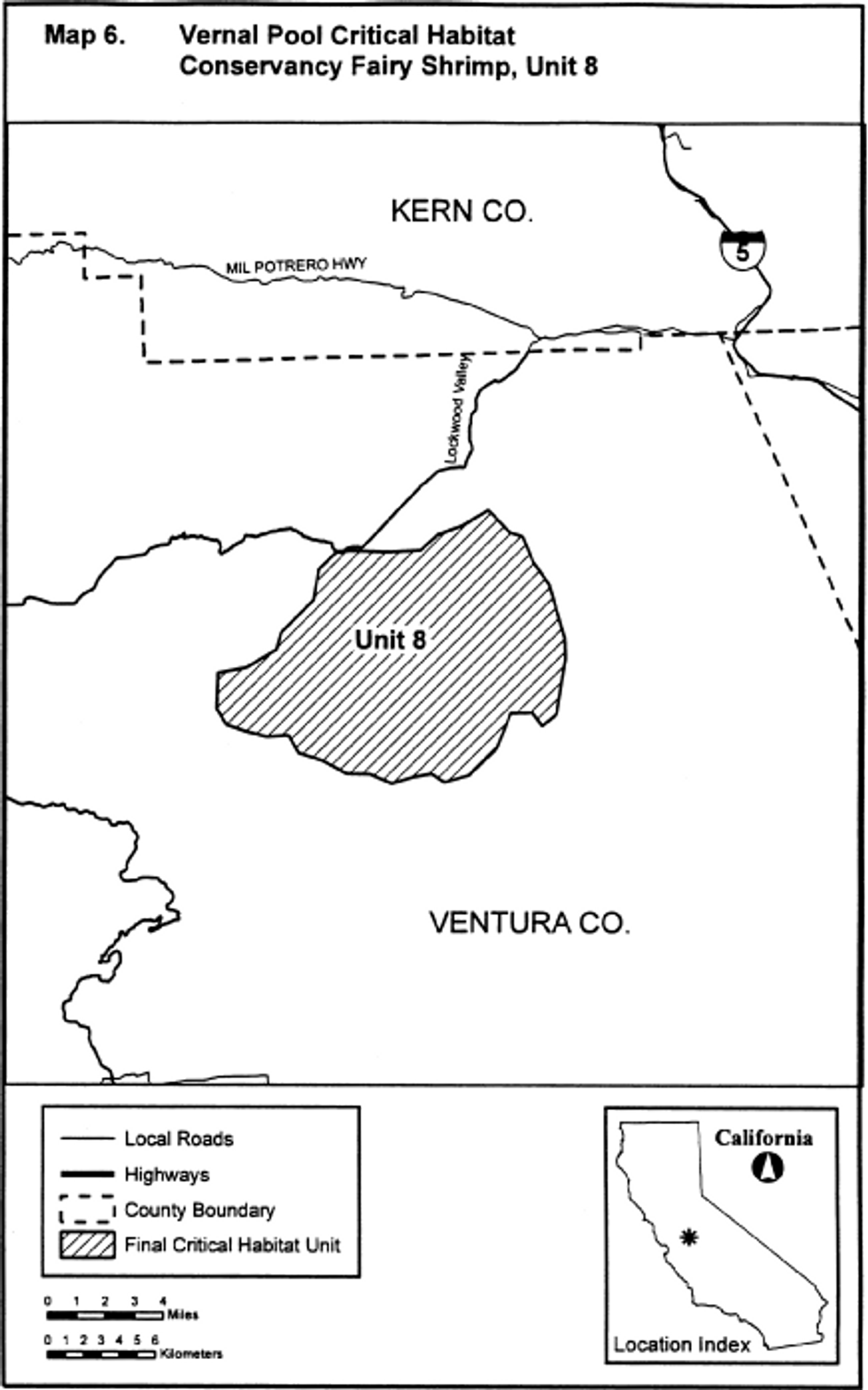
Longhorn Fairy Shrimp (Branchinecta longiantenna)
(1) Critical habitat units are depicted for Alameda, Contra Costa, Merced, and San Luis Obispo Counties, California, on the map below.
(2) The primary constituent elements of critical habitat for longhorn fairy shrimp (Branchinecta longiantenna) are the habitat components that provide:
(i) Topographic features characterized by mounds and swales and depressions within a matrix of surrounding uplands that result in complexes of continuously, or intermittently, flowing surface water in the swales connecting the pools described below in paragraph (2)(ii), providing for dispersal and promoting hydroperiods of adequate length in the pools;
(ii) Depressional features including isolated vernal pools with underlying restrictive soil layers that become inundated during winter rains and that continuously hold water for a minimum of 23 days, in all but the driest years; thereby providing adequate water for incubation, maturation, and reproduction. As these features are inundated on a seasonal basis, they do not promote the development of obligate wetland vegetation habitats typical of permanently flooded emergent wetlands;
(iii) Sources of food, expected to be detritus occurring in the pools, contributed by overland flow from the pools' watershed, or the results of biological processes within the pools themselves, such as single-celled bacteria, algae, and dead organic matter, to provide for feeding; and
(iv) Structure within the pools described above in paragraph (2)(ii), consisting of organic and inorganic materials, such as living and dead plants from plant species adapted to seasonally inundated environments, rocks, and other inorganic debris that may be washed, blown, or otherwise transported into the pools, that provide shelter.
(3) Existing manmade features and structures, such as buildings, roads, railroads, airports, runways, other paved areas, lawns, and other urban landscaped areas do not contain one or more of the primary constituent elements. Federal actions limited to those areas, therefore, would not trigger a consultation under section 7 of the Act unless they may affect the species and/or primary constituent elements in adjacent critical habitat.
(4) Unit 1: Contra Costa County.
(i) [Reserved]
(ii) Unit 1 (Map 1) follows:
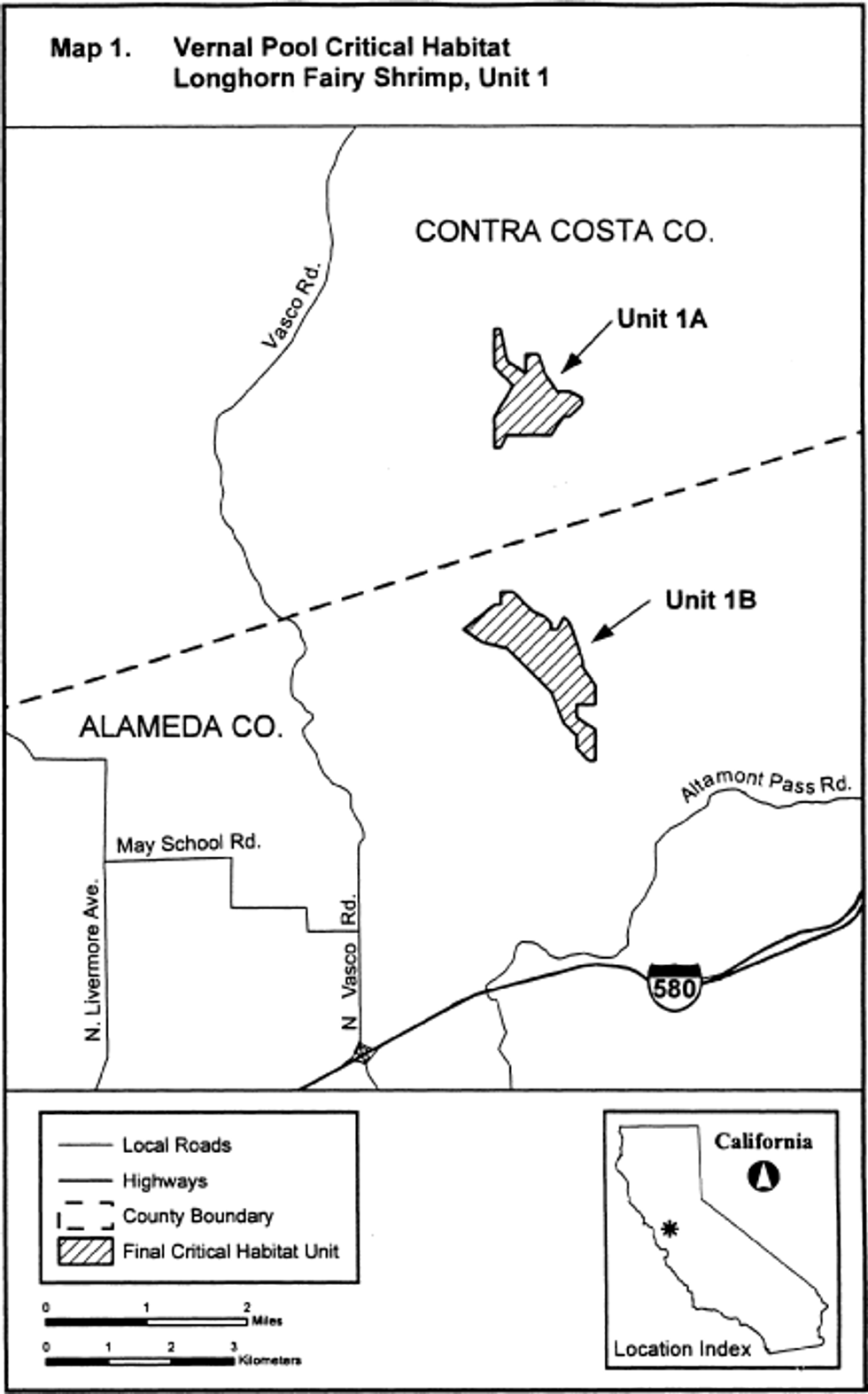
(5) Unit 2: Merced County.
(6) Unit 2 (Map 2) follows:
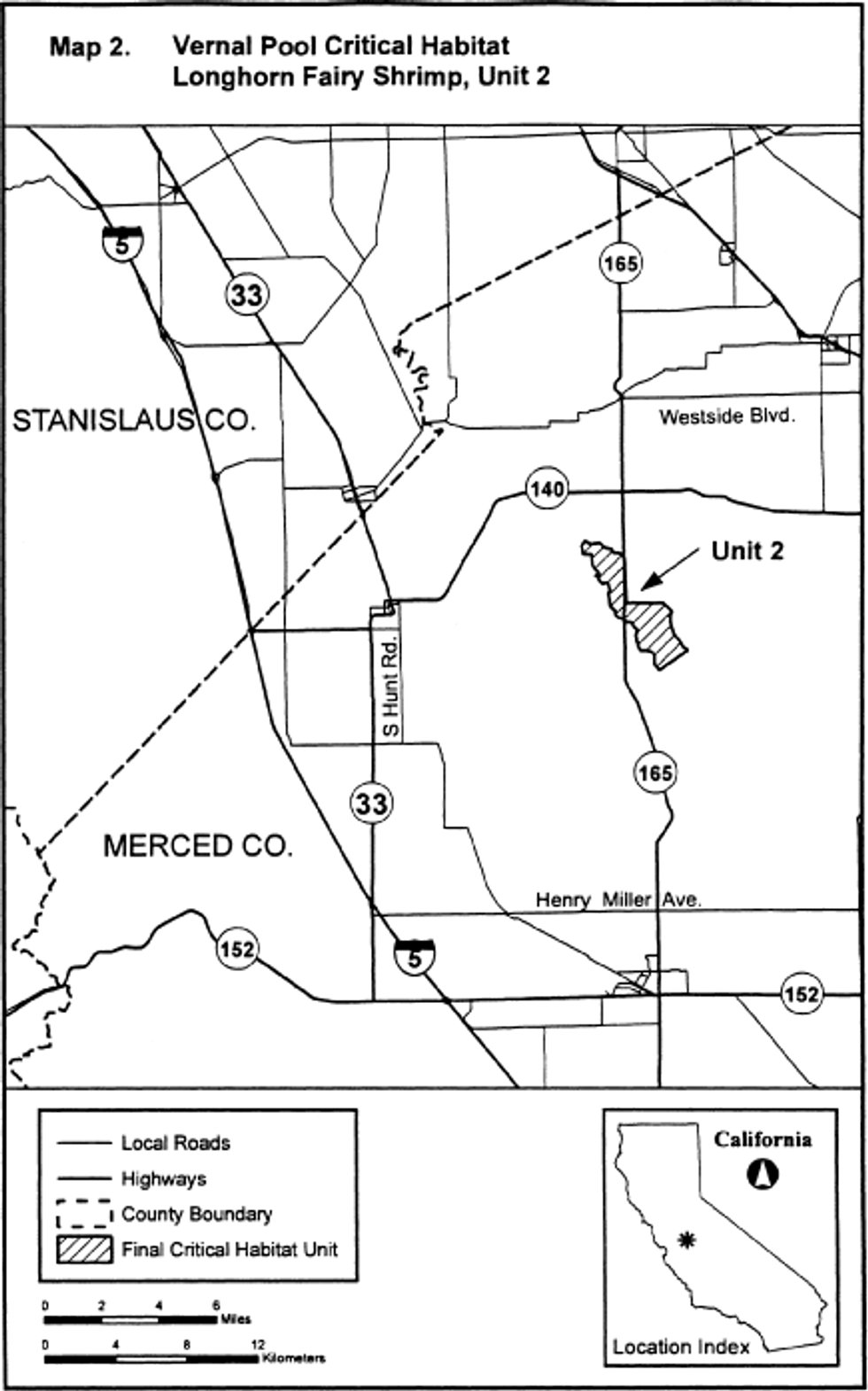
(7) Unit 3: San Luis Obispo County.
(8) Unit 3 (Map 3) follows:
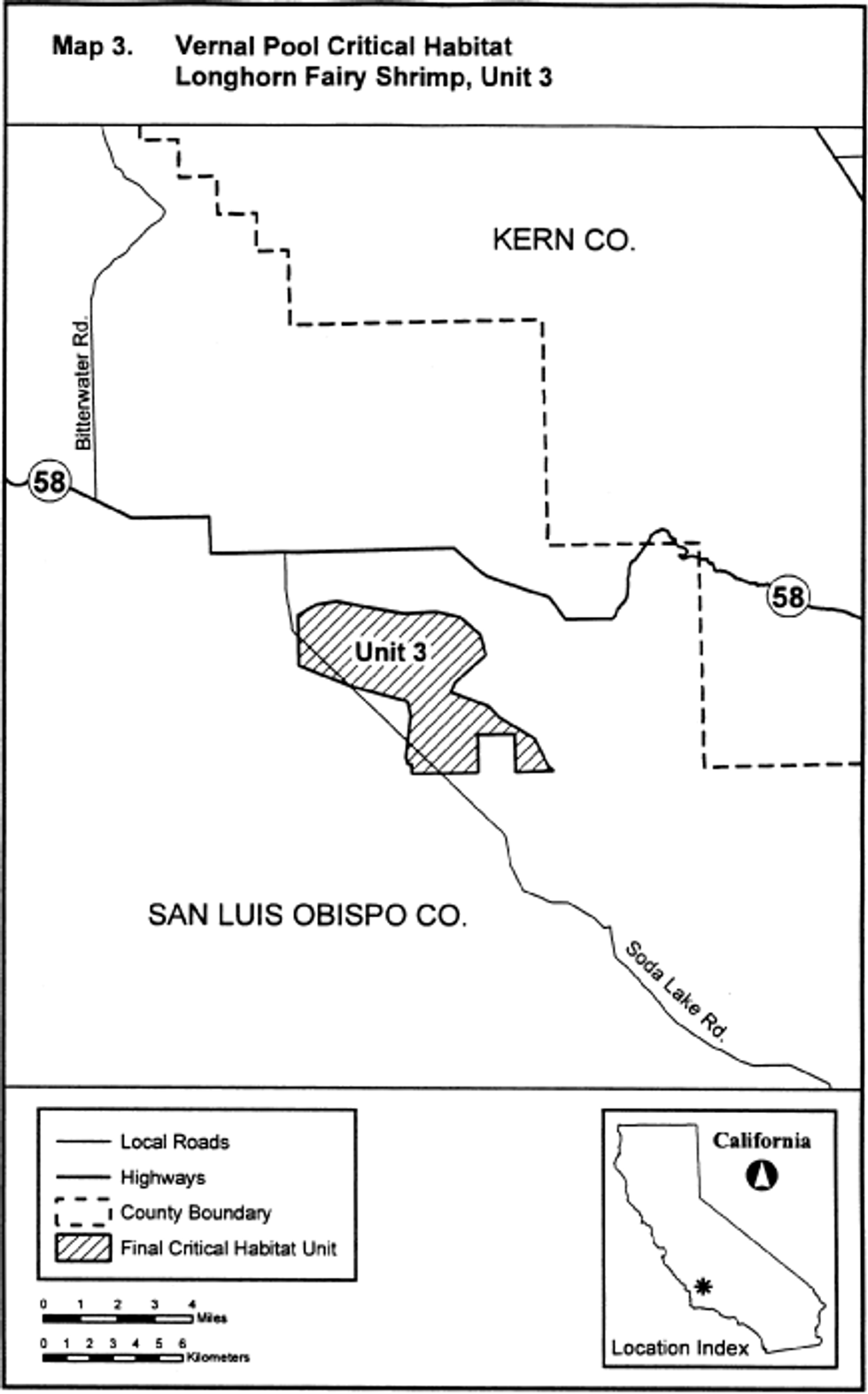
Riverside Fairy Shrimp (Streptocephalus woottoni)
(1) Unit descriptions are depicted for Ventura, Orange, and San Diego Counties, California, on the maps below.
(2) Within these areas, the primary constituent elements of the physical or biological features essential to the conservation of the Riverside fairy shrimp consist of three components:
(i) Ephemeral wetland habitat consisting of vernal pools and ephemeral habitat that have wet and dry periods appropriate for the incubation, maturation, and reproduction of the Riverside fairy shrimp in all but the driest of years, such that the pools:
(A) Are inundated (pond) approximately 2 to 8 months during winter and spring, typically filled by rain, surface, and subsurface flow;
(B) Generally dry down in the late spring to summer months;
(C) May not pond every year; and
(D) Provide the suitable water chemistry characteristics to support the Riverside fairy shrimp. These characteristics include physiochemical factors such as alkalinity, pH, temperature, dissolved solutes, dissolved oxygen, which can vary depending on the amount of recent precipitation, evaporation, or oxygen saturation; time of day; season; and type and depth of soil and subsurface layers. Vernal pool habitat typically exhibits a range of conditions but remains within the physiological tolerance of the species. The general ranges of conditions include, but are not limited to:
(1) Dilute, freshwater pools with low levels of total dissolved solids (low ion levels (sodium ion concentrations generally below 70 millimoles per liter));
(2) Low alkalinity levels (lower than 80 to 1,000 milligrams per liter (mg/l)); and
(3) A range of pH levels from slightly acidic to neutral (typically in range of 6.4-7.1).
(ii) Intermixed wetland and upland habitats that function as the local watershed, including topographic features characterized by mounds, swales, and low-lying depressions within a matrix of upland habitat that result in intermittently flowing surface and subsurface water in swales, drainages, and pools described in paragraph (h)(2)(i) of this entry. Associated watersheds provide water to fill the vernal or ephemeral pools in the winter and spring months. Associated watersheds vary in size and therefore cannot be generalized, and they are affected by factors including surface and underground hydrology, the topography of the area surrounding the pool or pools, the vegetative coverage, and the soil substrates in the area. The size of associated watersheds likely varies from a few acres to greater than 100 ac (40 ha).
(iii) Soils that support ponding during winter and spring which are found in areas characterized in paragraphs (h)(2)(i) and (h)(2)(ii), respectively, of this entry, that have a clay component or other property that creates an impermeable surface or subsurface layer. Soil series with a clay component or an impermeable surface or subsurface layer typically slow percolation, increase water run-off (at least initially), and contribute to the filling and persistence of ponding of ephemeral wetland habitat where the Riverside fairy shrimp occurs. Soils and soil series known to support vernal pool habitat include, but are not limited to:
(A) The Azule, Calleguas, Cropley, and Linne soils series in Ventura County;
(B) The Alo, Balcom, Bosanko, Calleguas, Cieneba, and Myford soils series in Orange County;
(C) The Cajalco, Claypit, Murrieta, Porterville, Ramona, Traver, and Willows soils series in Riverside County; and
(D) The Diablo, Huerhuero, Linne, Placentia, Olivenhain, Redding, Salinas, and Stockpen soils series in San Diego County.
(3) Critical habitat does not include manmade structures (such as buildings, aqueducts, runways, roads, and other paved areas) and the land on which they are located existing within the legal boundaries on January 3, 2013.
(4) Critical habitat map units. Data layers defining map units were created using a base of U.S. Geological Survey 7.5′ quadrangle maps. Unit descriptions were then mapped using Universal Transverse Mercator (UTM) zone 11, North American Datum (NAD) 1983 coordinates. The maps in this entry, as modified by any accompanying regulatory text, establish the boundaries of the critical habitat designation. The coordinates or plot points or both on which each map is based are available to the public on http://regulations.gov at Docket No. FWS-R8-ES-2011-0013, on our Internet site (http://www.fws.gov/carlsbad/), and at the Carlsbad Fish and Wildlife Office, 6010 Hidden Valley Road, Suite 101, Carlsbad, CA 92011.
(5) Note: Index map follows:
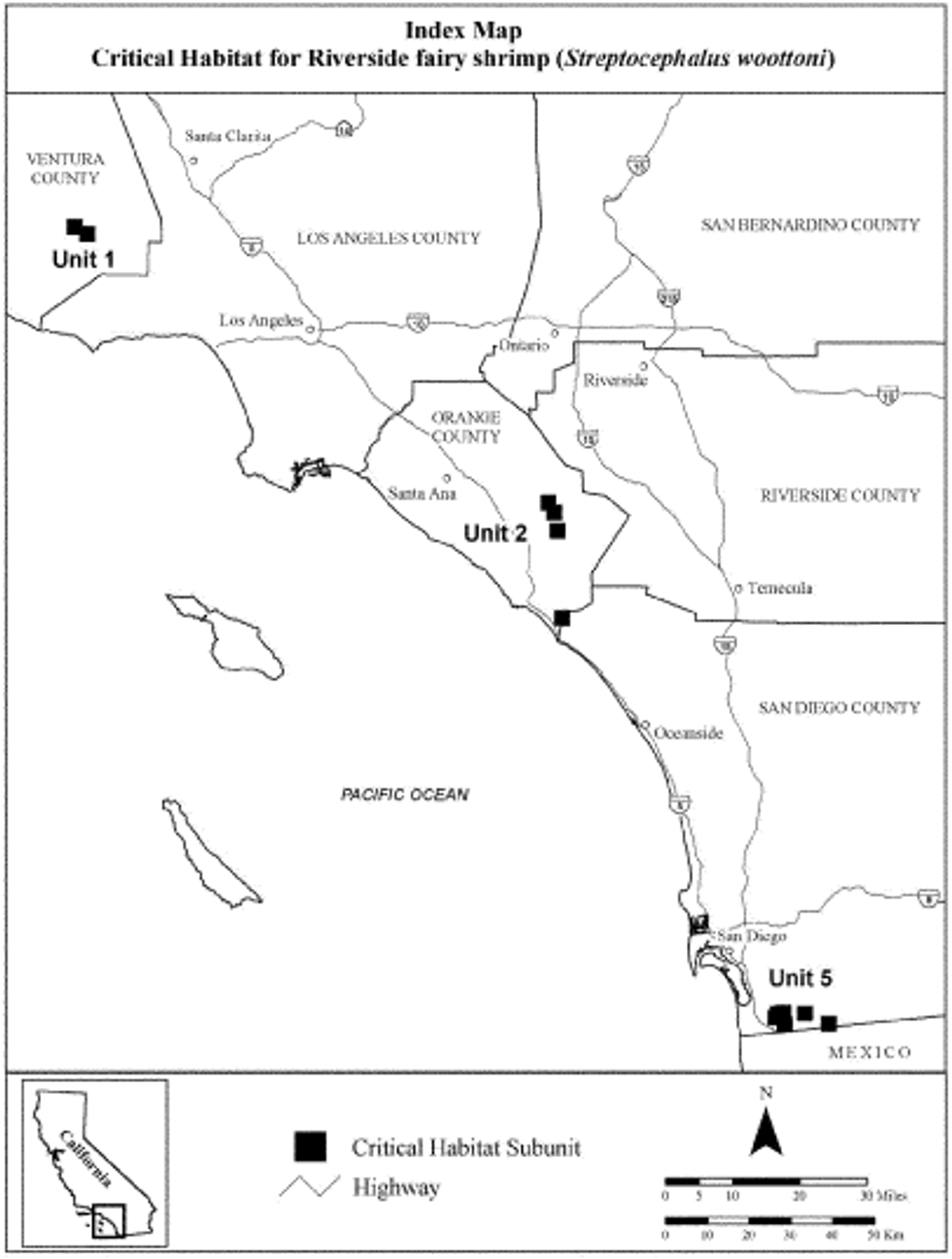
(6) Unit 1: Ventura County, California. Map of Subunit 1a, Tierra Rejada Preserve, and Subunit 1b, South of Tierra Rejada Valley, follows:
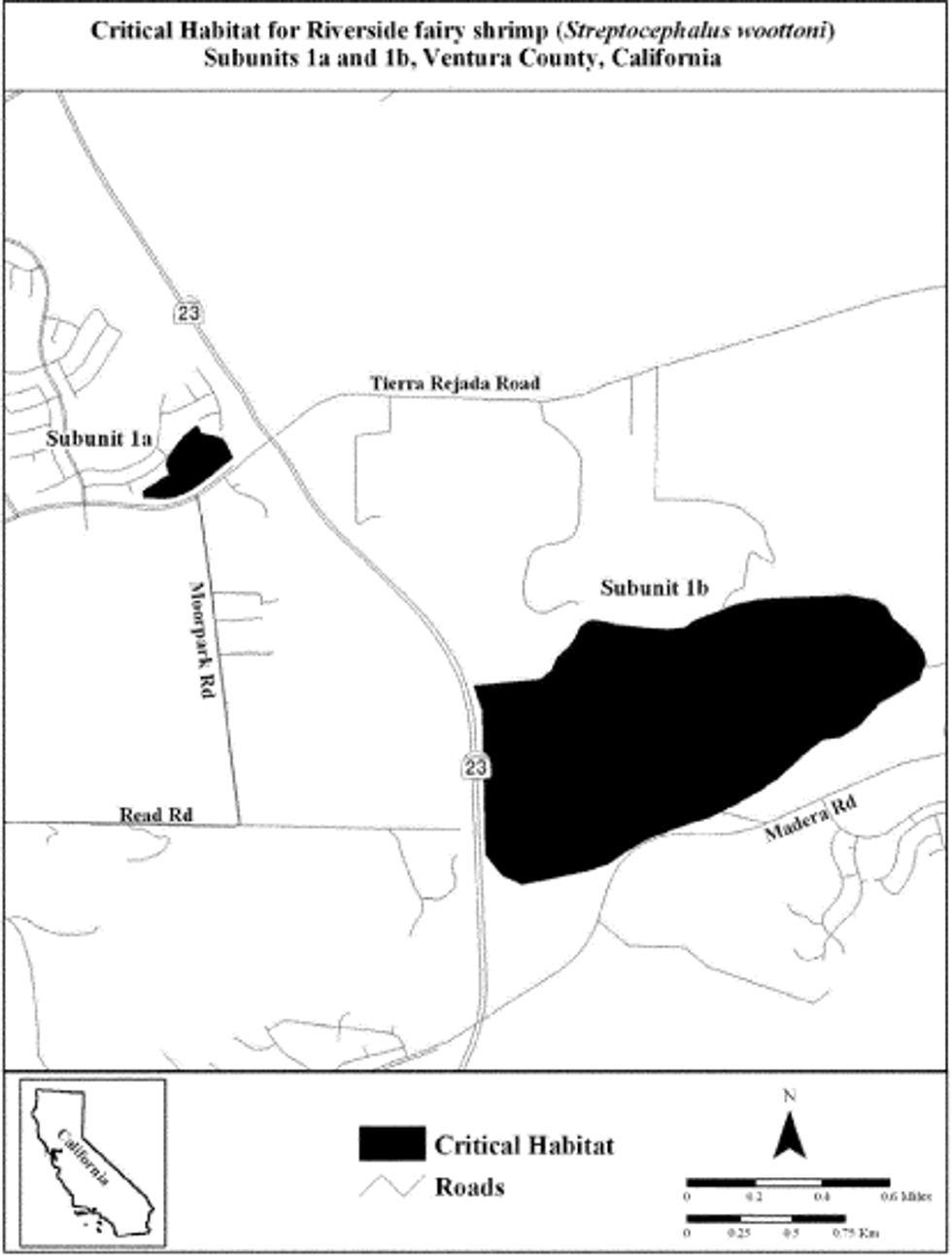
(7) Unit 2: Los Angeles Basin-Orange County Foothills, Orange County, California.
(i) Map of Subunit 2dA, Saddleback Meadows, and Subunit 2dB, O'Neill Regional Park (near Trabuco Canyon), follows:
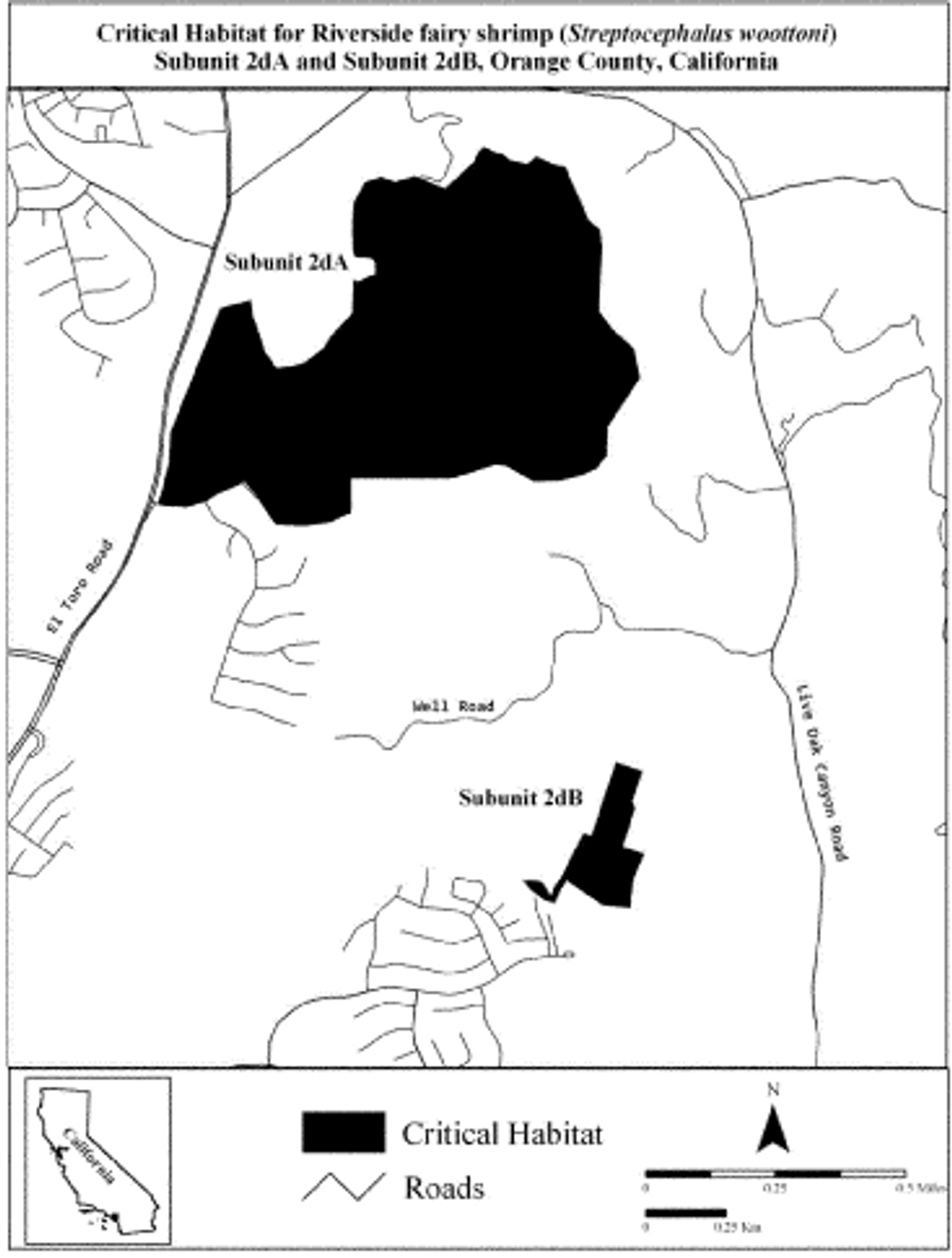
(ii) Map of Subunit 2e, O'Neill Regional Park (near Cañada Gobernadora), follows:
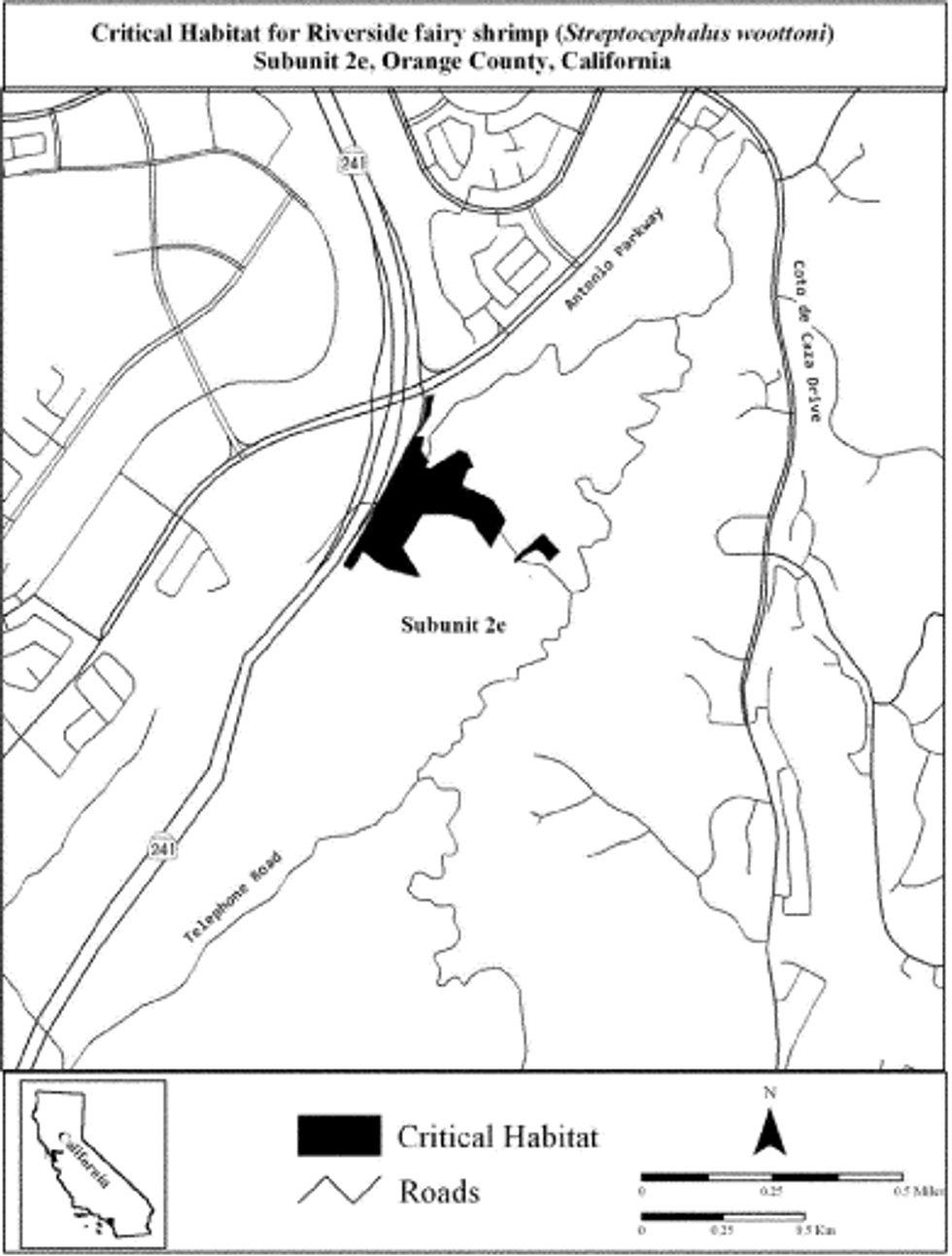
(iii) Map of Subunit 2h, San Onofre State Beach, State Park-leased land (near Christianitos Creek foothills) (near Camp Pendleton), follows:
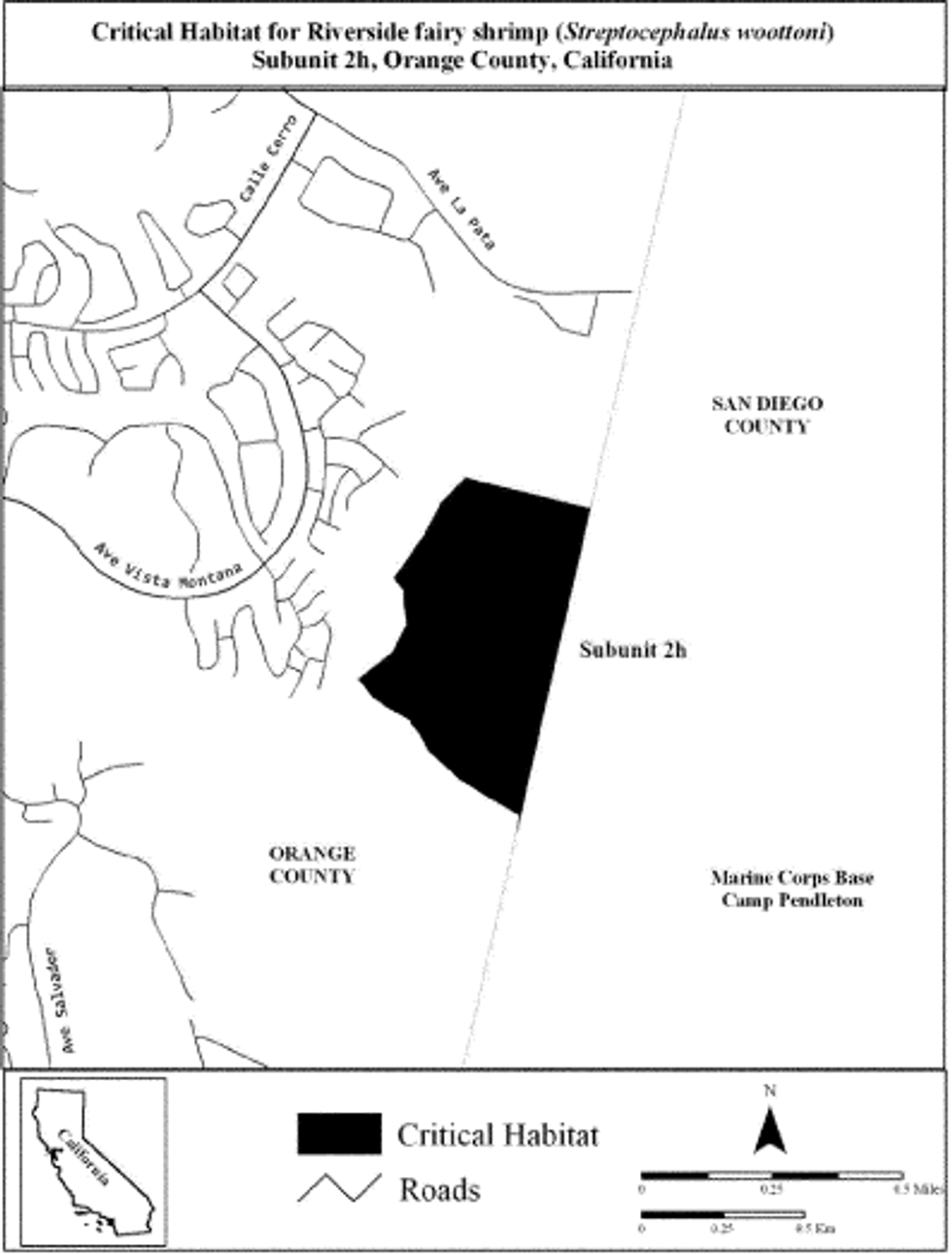
(8) Unit 5: San Diego Southern Coastal Mesas, San Diego County, California.
(i) Map of Subunit 5a, Sweetwater (J33); Subunit 5e, J2 N, J4, J5 (Robinhood Ridge); Subunit 5f, J2 W and J2 S (Hidden Trails, Cal Terraces, Otay Mesa Road); Subunit 5g, J14; and Subunit 5h, J11 E and J11 W, J12, J16-18 (Goat Mesa), follows:
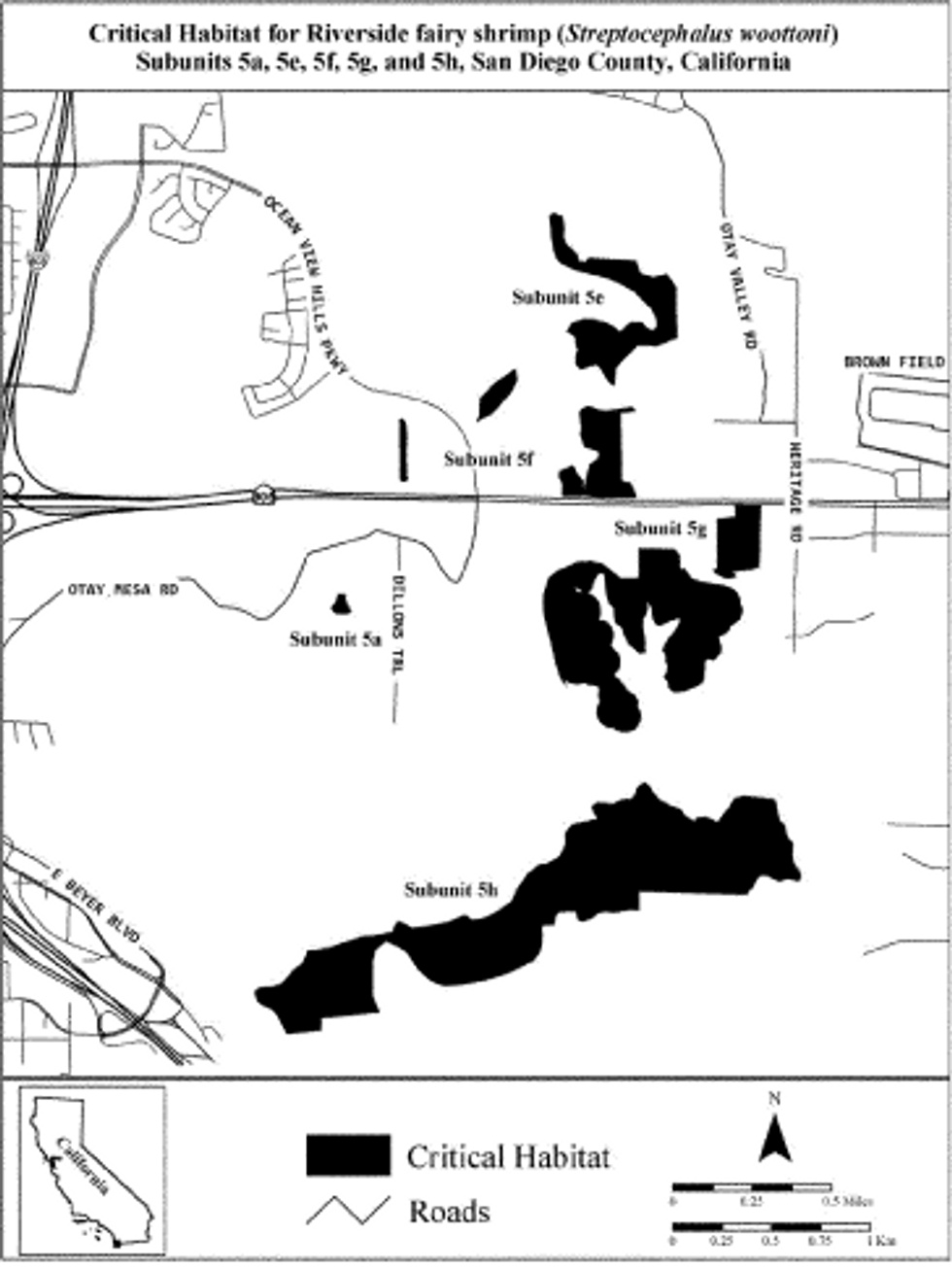
(ii) Map of Subunit 5c, East Otay Mesa, follows:
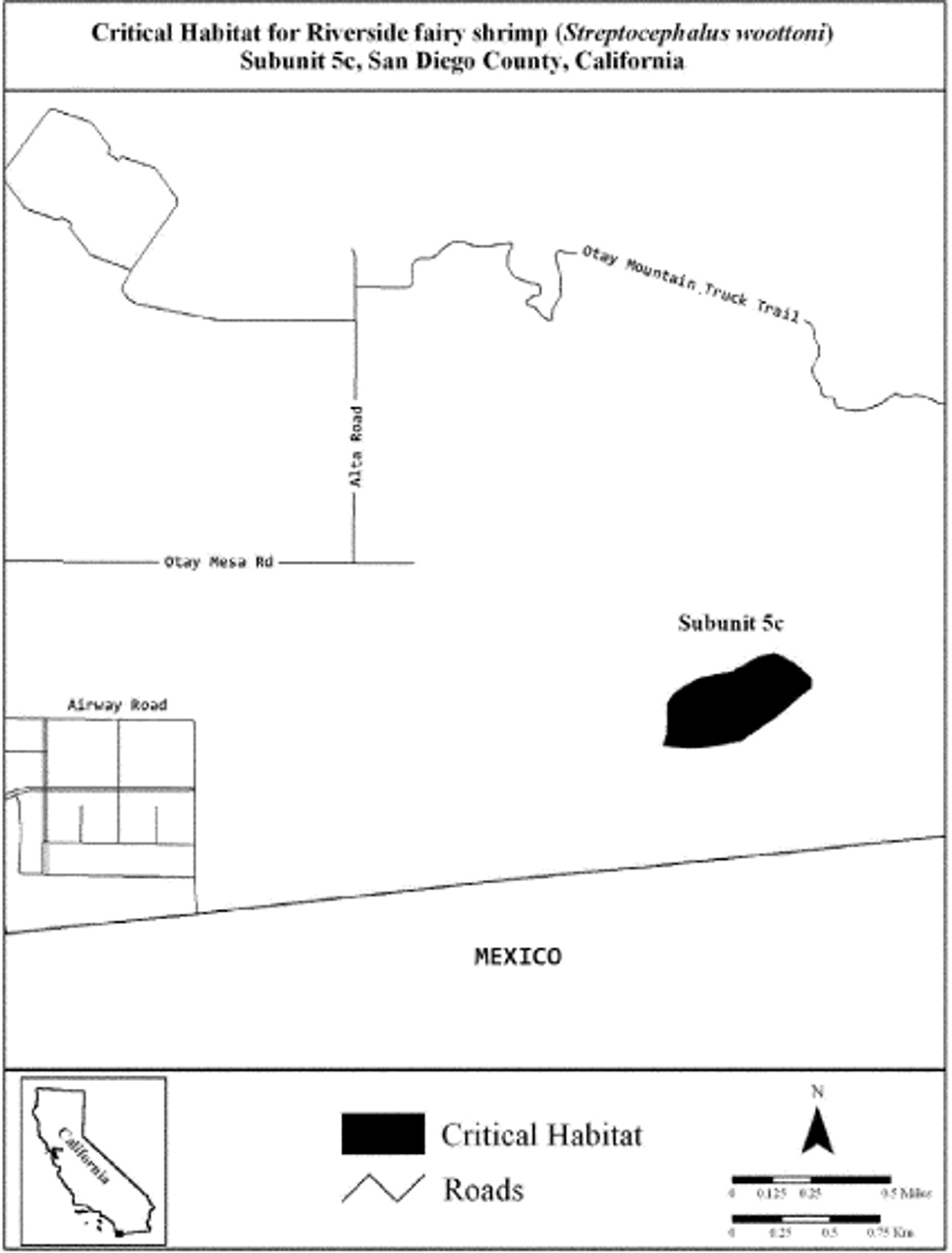
(iii) Map of Subunit 5d, J29-31, follows:
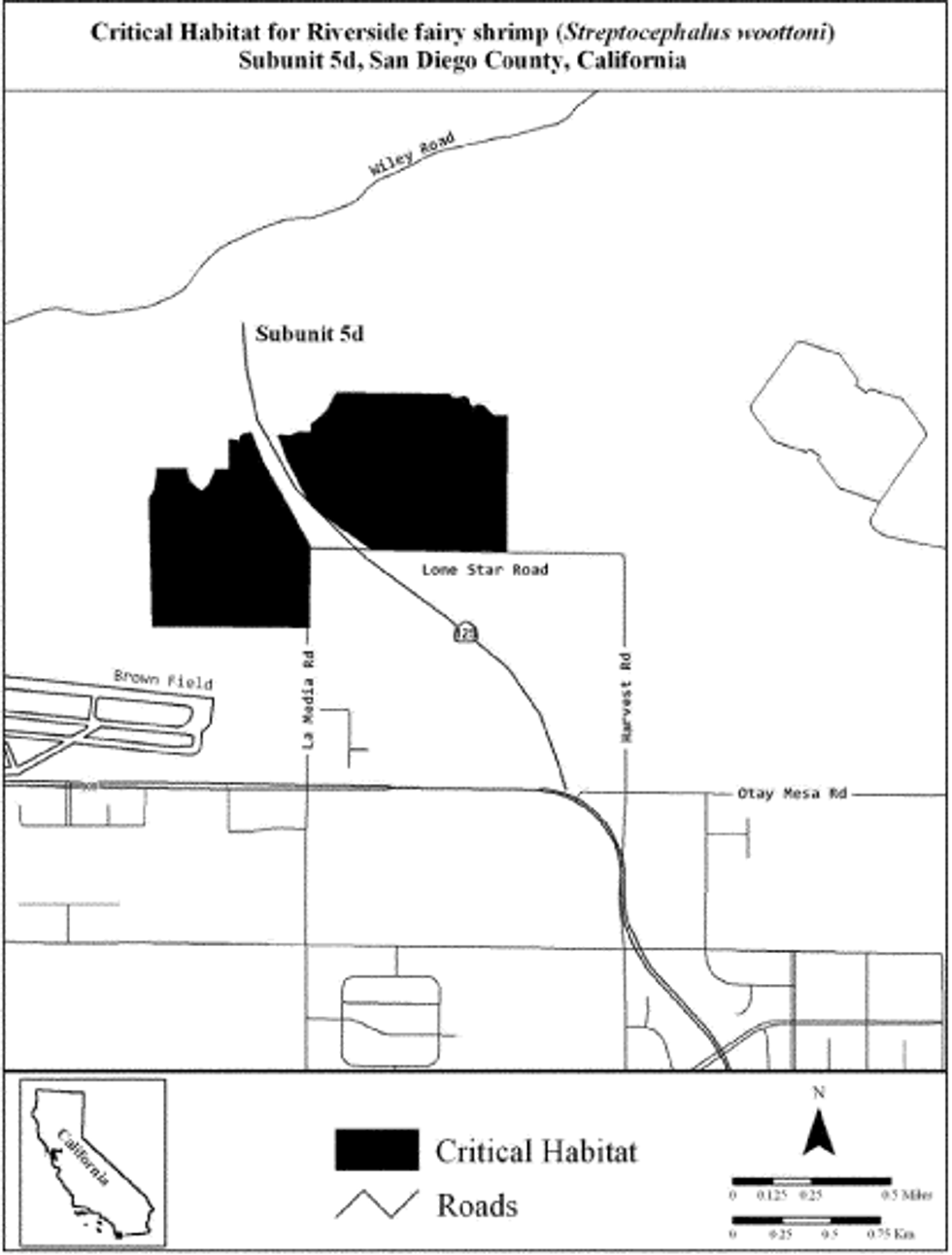
San Diego Fairy Shrimp (Branchinecta sandiegonensis)
(1) Critical habitat units are depicted for Orange and San Diego counties, California, on the maps below.
(2) The primary constituent elements of critical habitat for the San Diego fairy shrimp are:
(i) Vernal pools with shallow to moderate depths (2 in (5 cm) to 12 in (30 cm)) that hold water for sufficient lengths of time (7 to 60 days) necessary for incubation, maturation, and reproduction of the San Diego fairy shrimp, in all but the driest years;
(ii) Topographic features characterized by mounds and swales and depressions within a matrix of surrounding uplands that result in complexes of continuously, or intermittently, flowing surface water in the swales connecting the pools described in paragraph (2)(i) of this entry, providing for dispersal and promoting hydroperiods of adequate length in the pools (i.e., the vernal pool watershed); and
(iii) Flat to gently sloping topography, and any soil type with a clay component and/or an impermeable surface or subsurface layer known to support vernal pool habitat (including Carlsbad, Chesterton, Diablo, Huerhuero, Linne, Olivenhain, Placentia, Redding, and Stockpen soils).
(3) Critical habitat does not include manmade structures (such as buildings, aqueducts, runways, roads, and other paved areas) and the land on which they are located existing within the legal boundaries on the effective date of this rule.
(4) Critical habitat map units. Data layers defining map units were created using a base of U.S. Geological Survey 7.5′ quadrangle maps, and the critical habitat units were then mapped using UTM coordinates.
(5) Note: Index map (Map 1) follows:
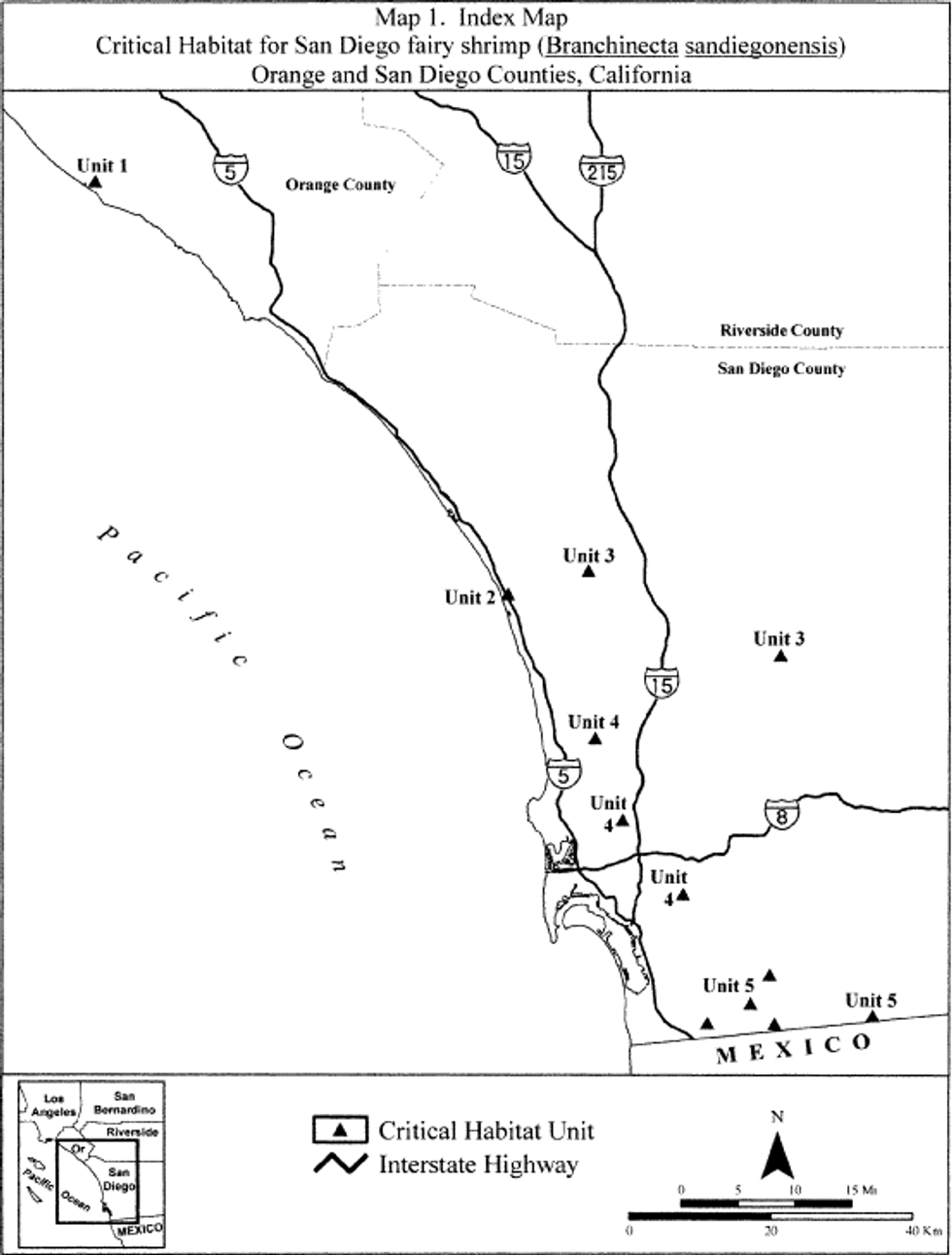
(6) Unit 1: Orange County, California. From USGS 1:24, 000 quadrangle map Newport Beach.
(i) [Reserved]
(ii) Map of Unit 1, Subunit 1C (Map 2) follows:
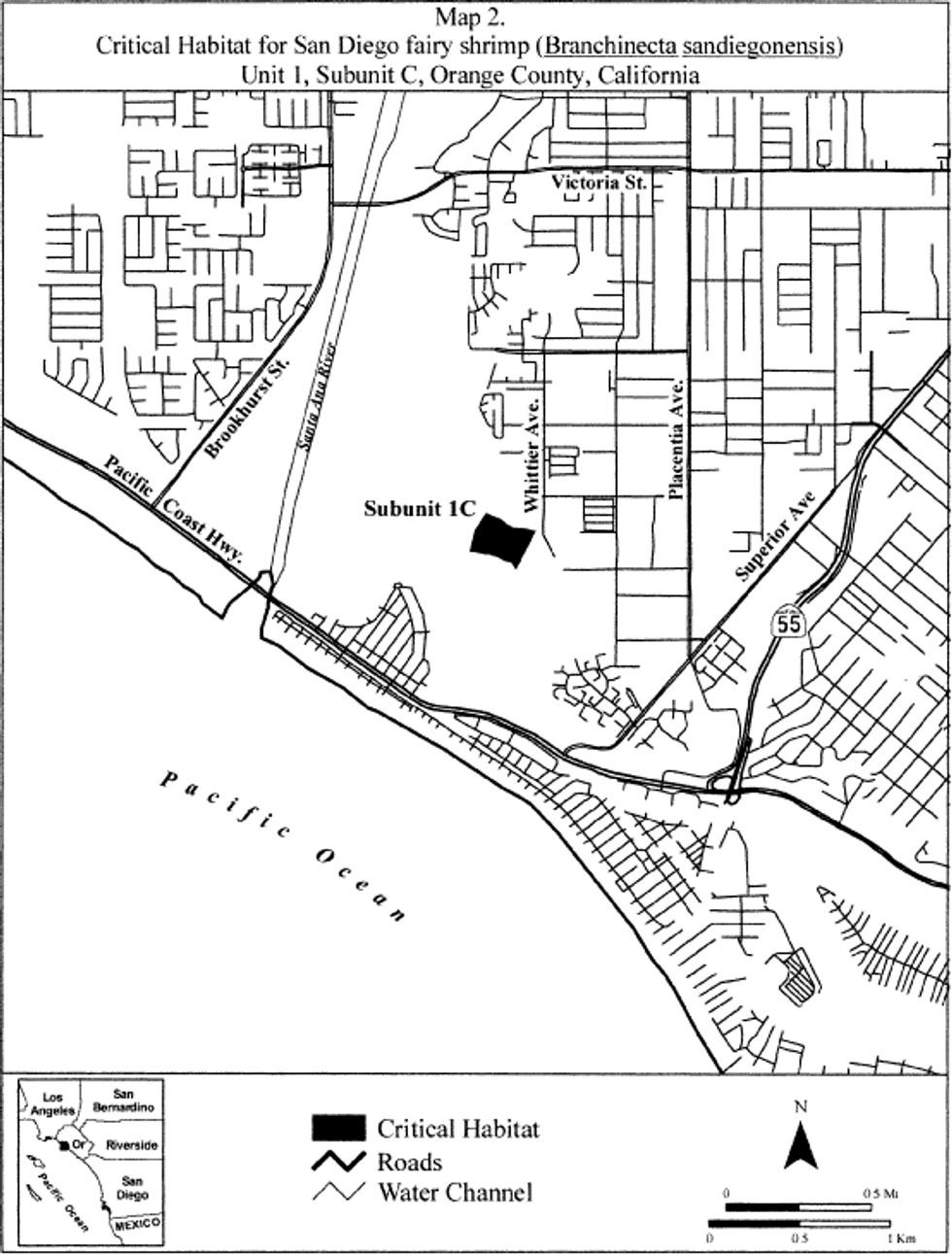
(7) Unit 2: San Diego County, California. From USGS 1:24, 000 quadrangle map Encinitas.
(i) [Reserved]
(ii) Map of Unit 2, Subunit 2G (Map 3) follows:
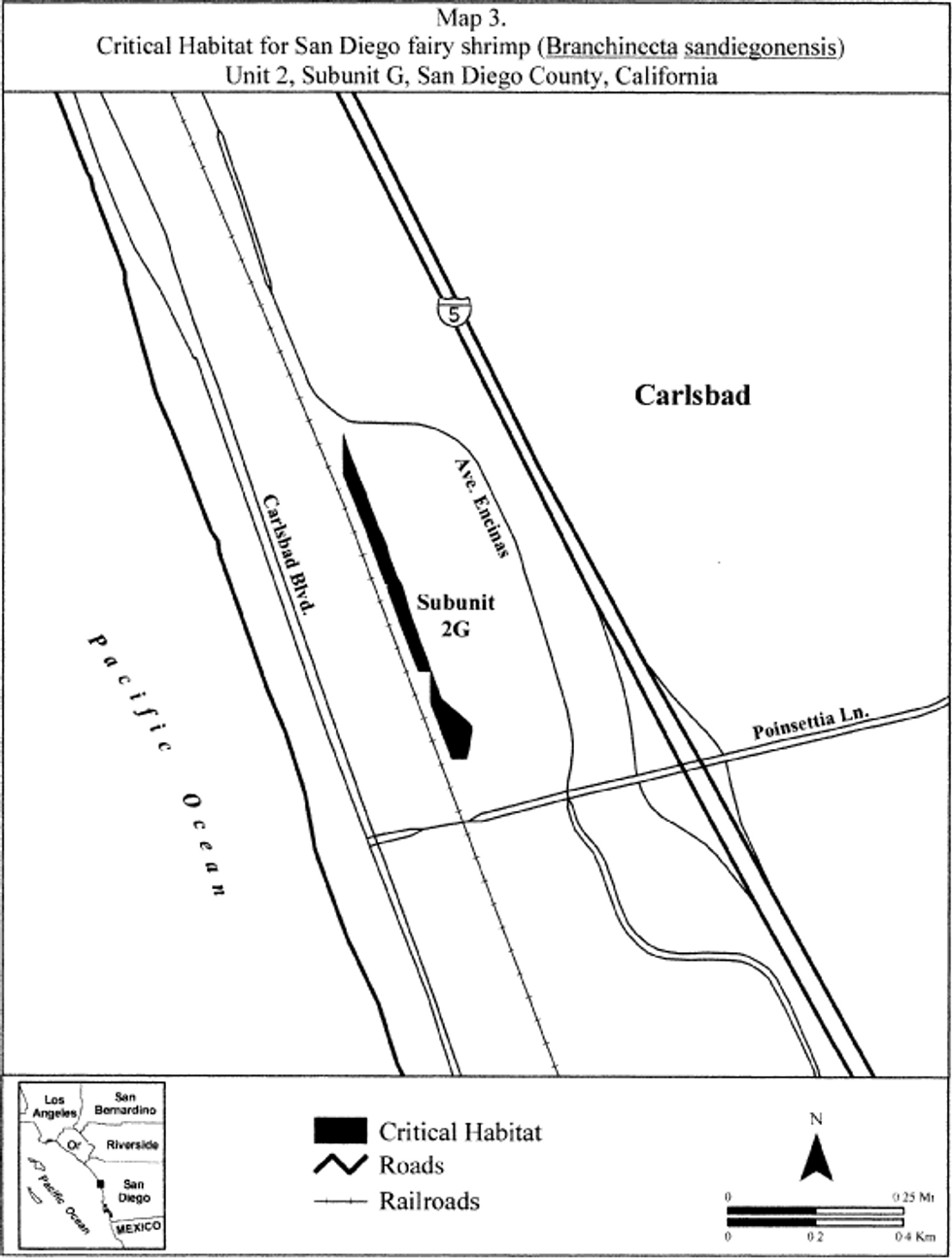
(8) Unit 3: San Diego County, California.
(i) Map of Unit 3, Subunits 3A, 3C, and 3D (Map 4) follows:
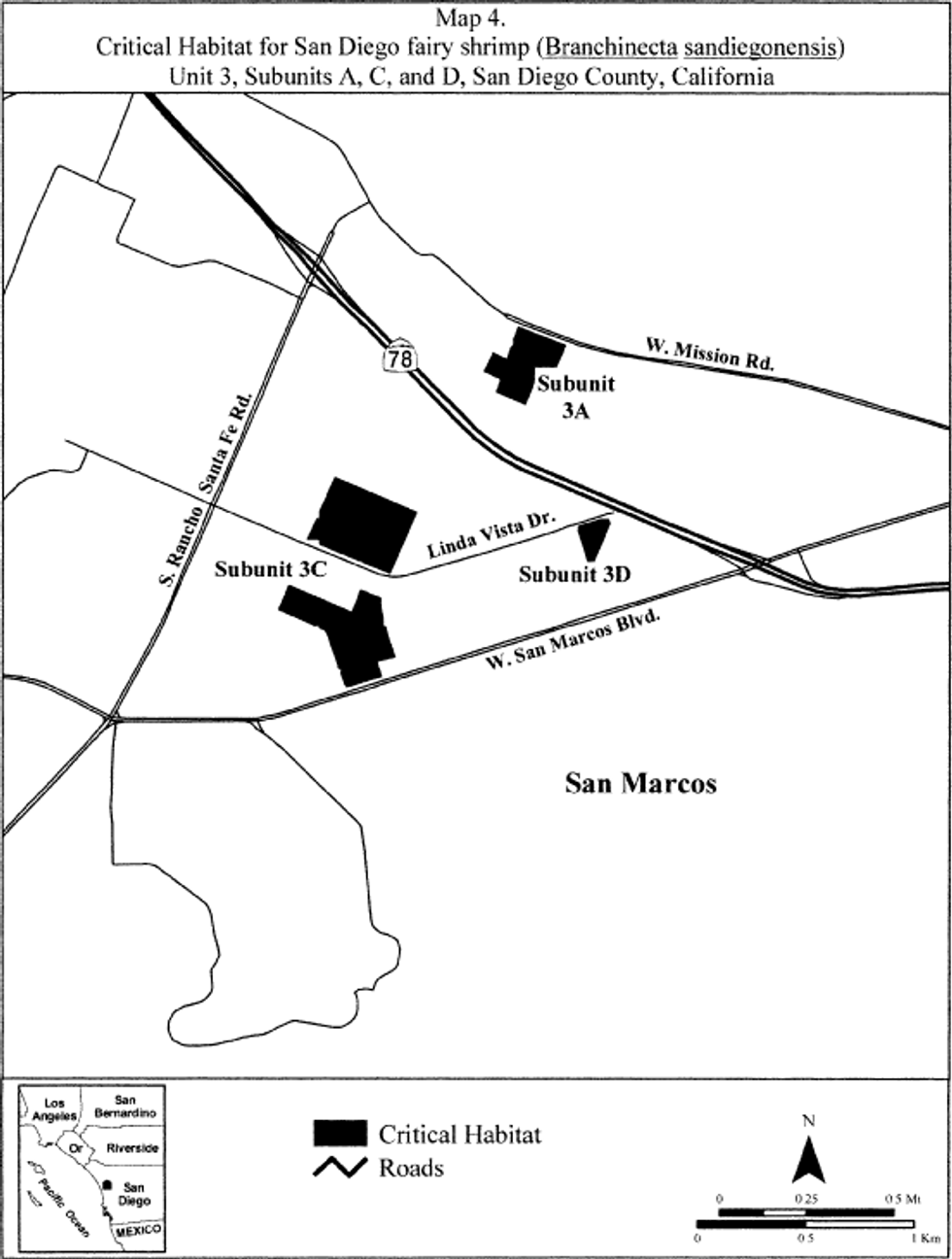
(ii) Map of Unit 3, Subunits 3E.1, 3E.2, 3E.3, and 3E.4 (Map 5) follows:
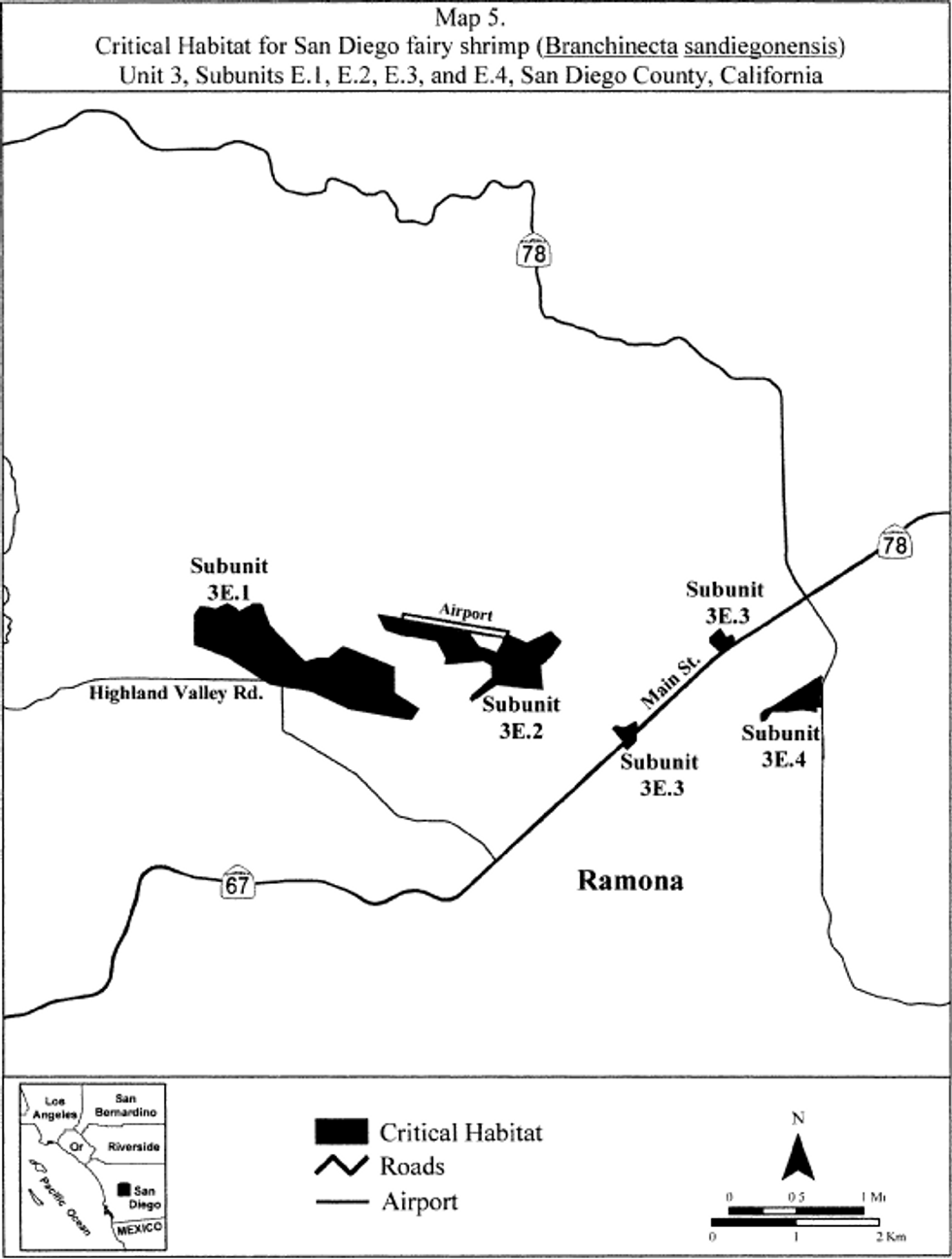
(9) Unit 4: San Diego County, California.
(i) Map of Unit 4, Subunits 4A/B, 4G, 4H, 4I, and 4J (Map 6) follows:
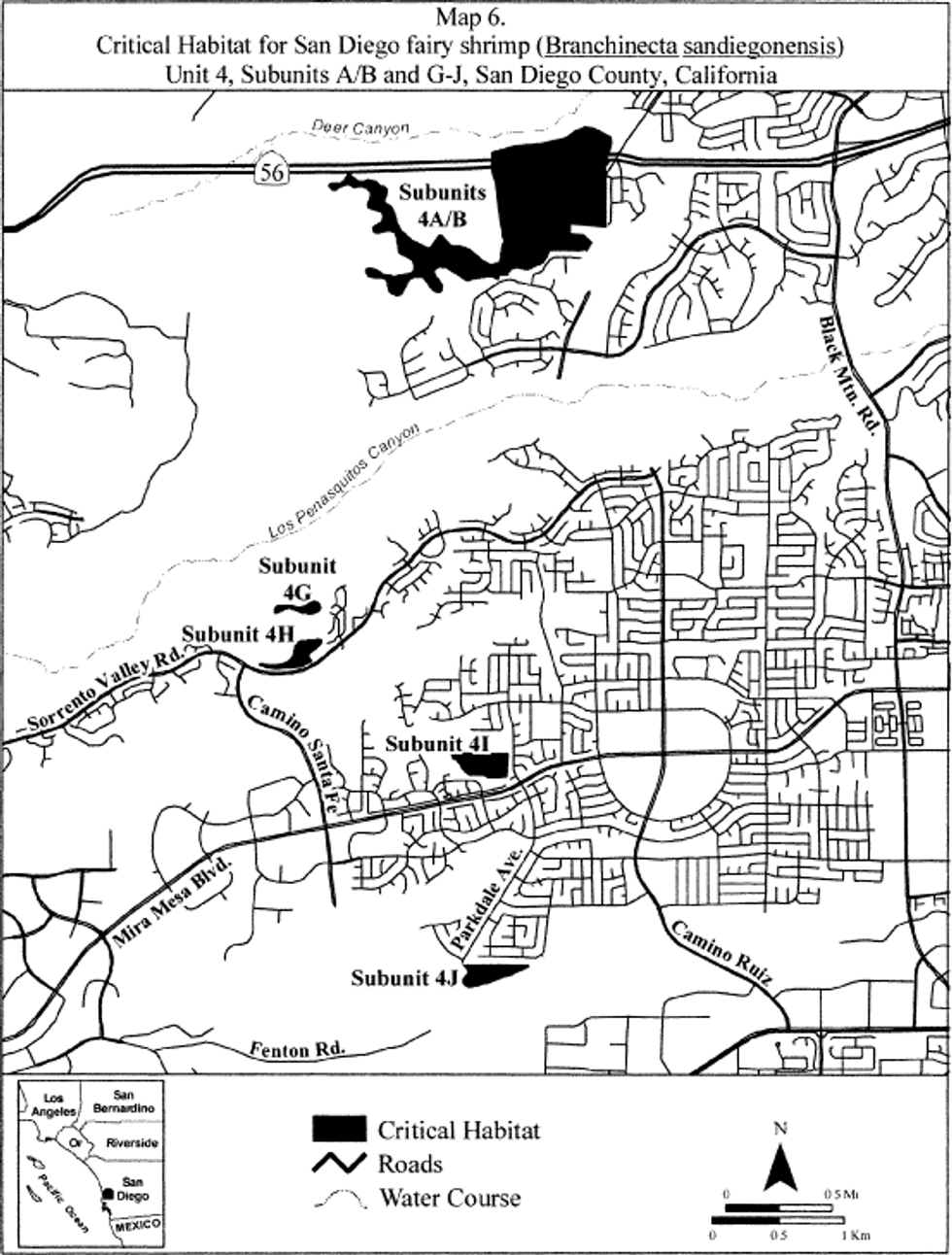
(ii) Map of Unit 4, Subunits 4C, 4K, 4L and 4M (Map 7) follows:
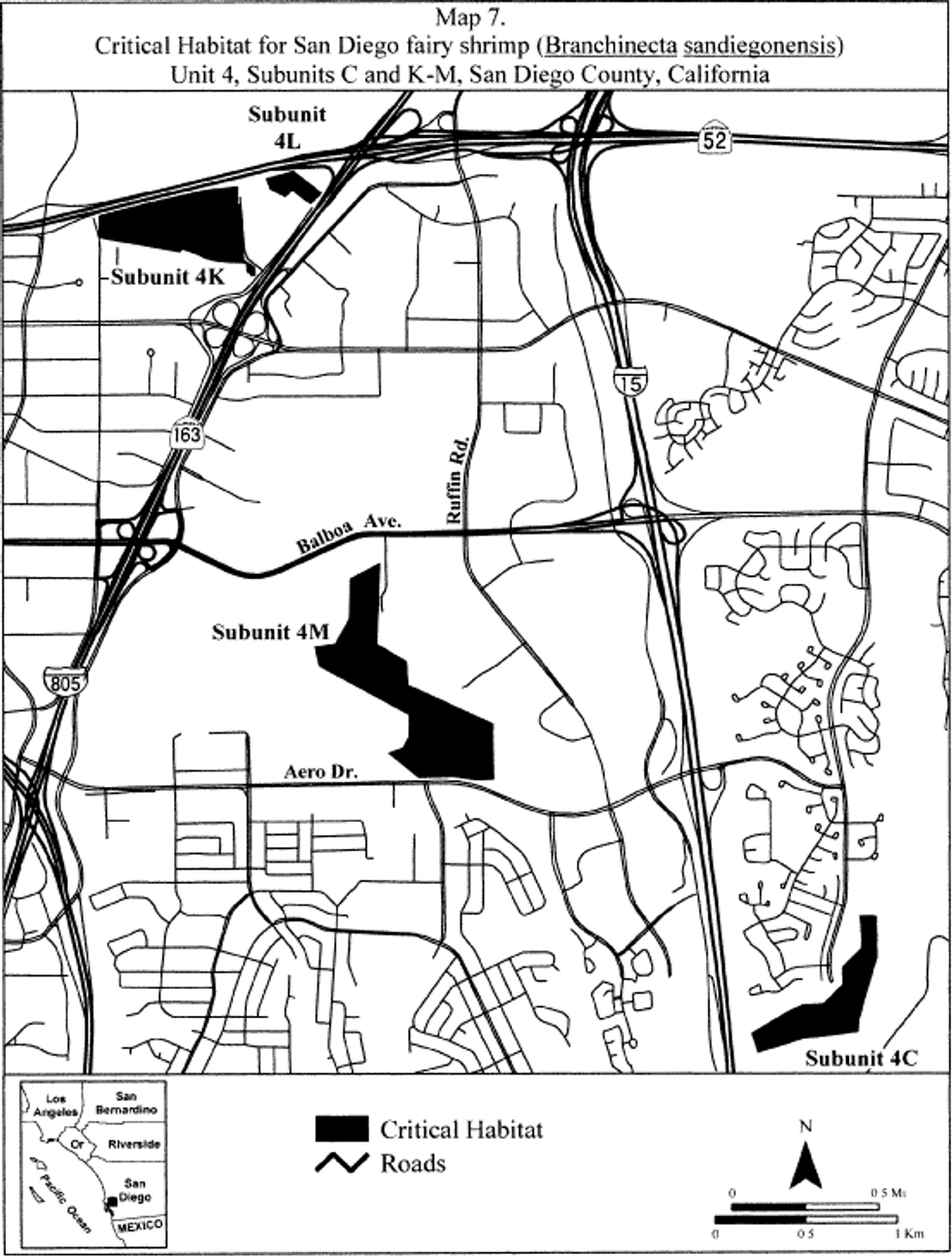
(iii) Map of Unit 4, Subunit 4D (Map 8) follows:
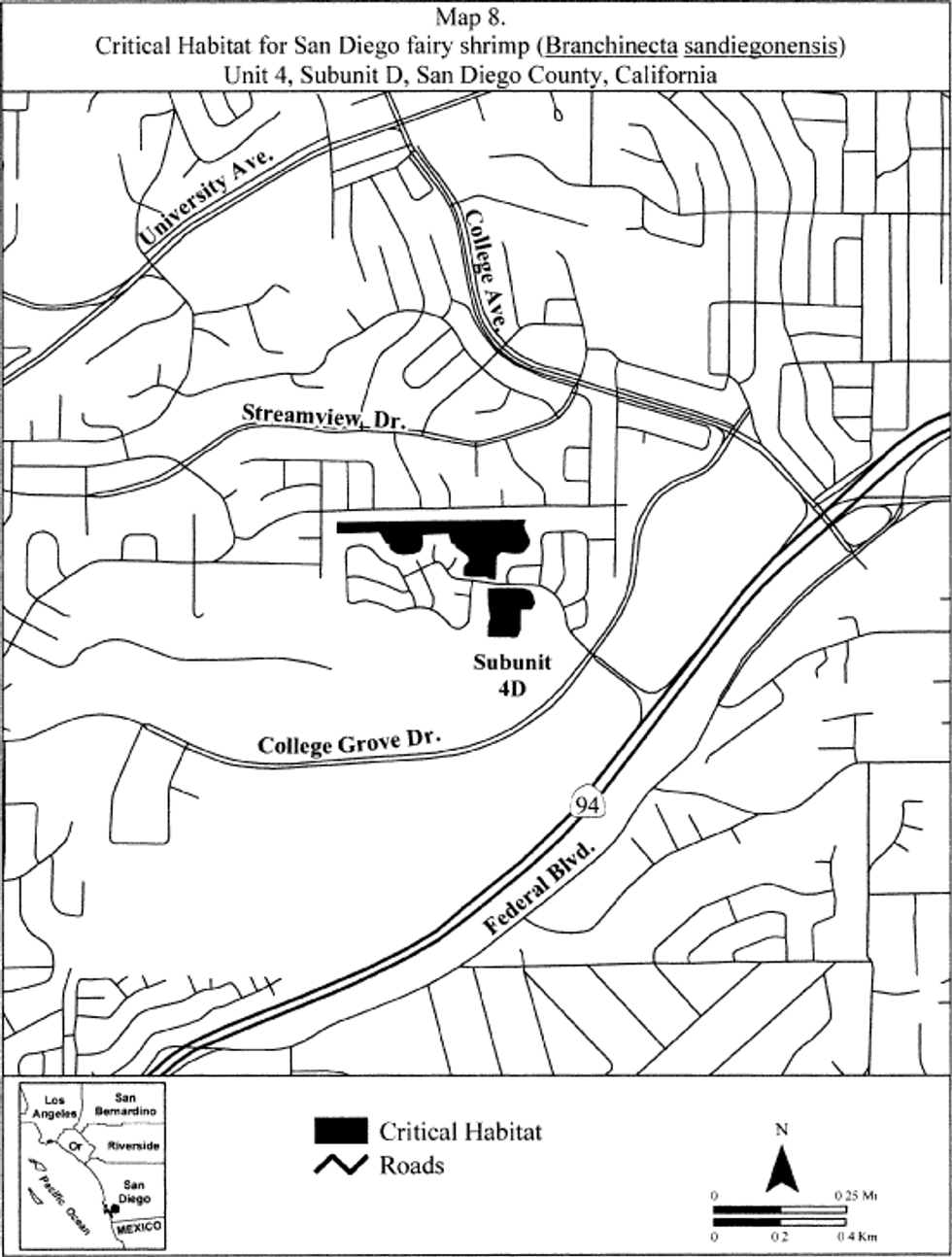
(iv) Map of Unit 4, Subunits 4E and 4F (Map 9) follows:
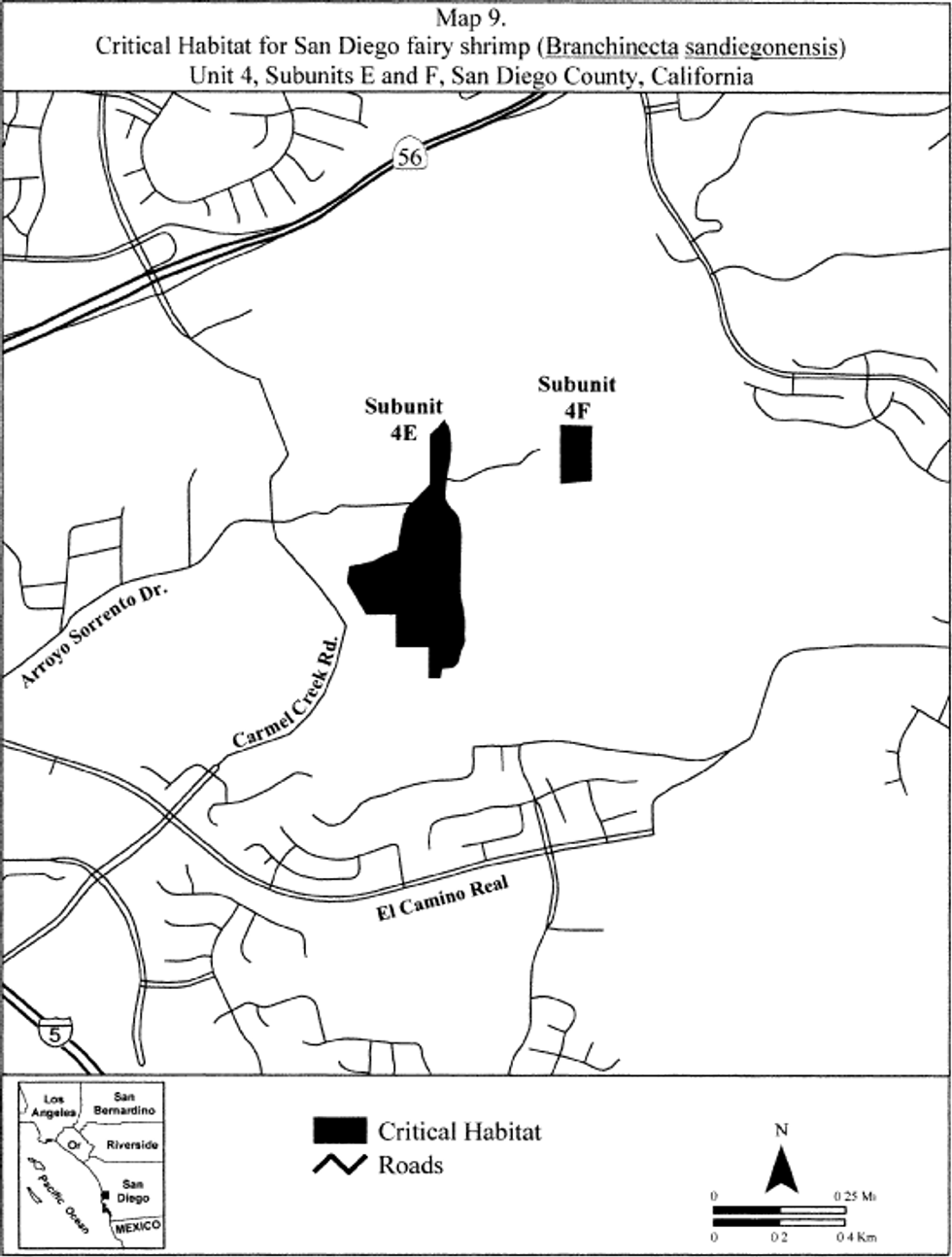
(10) Unit 5: San Diego County, California.
(i) Map of Unit 5, Subunits 5A, 5B, 5C, 5D, and 5H (Map 10) follows:
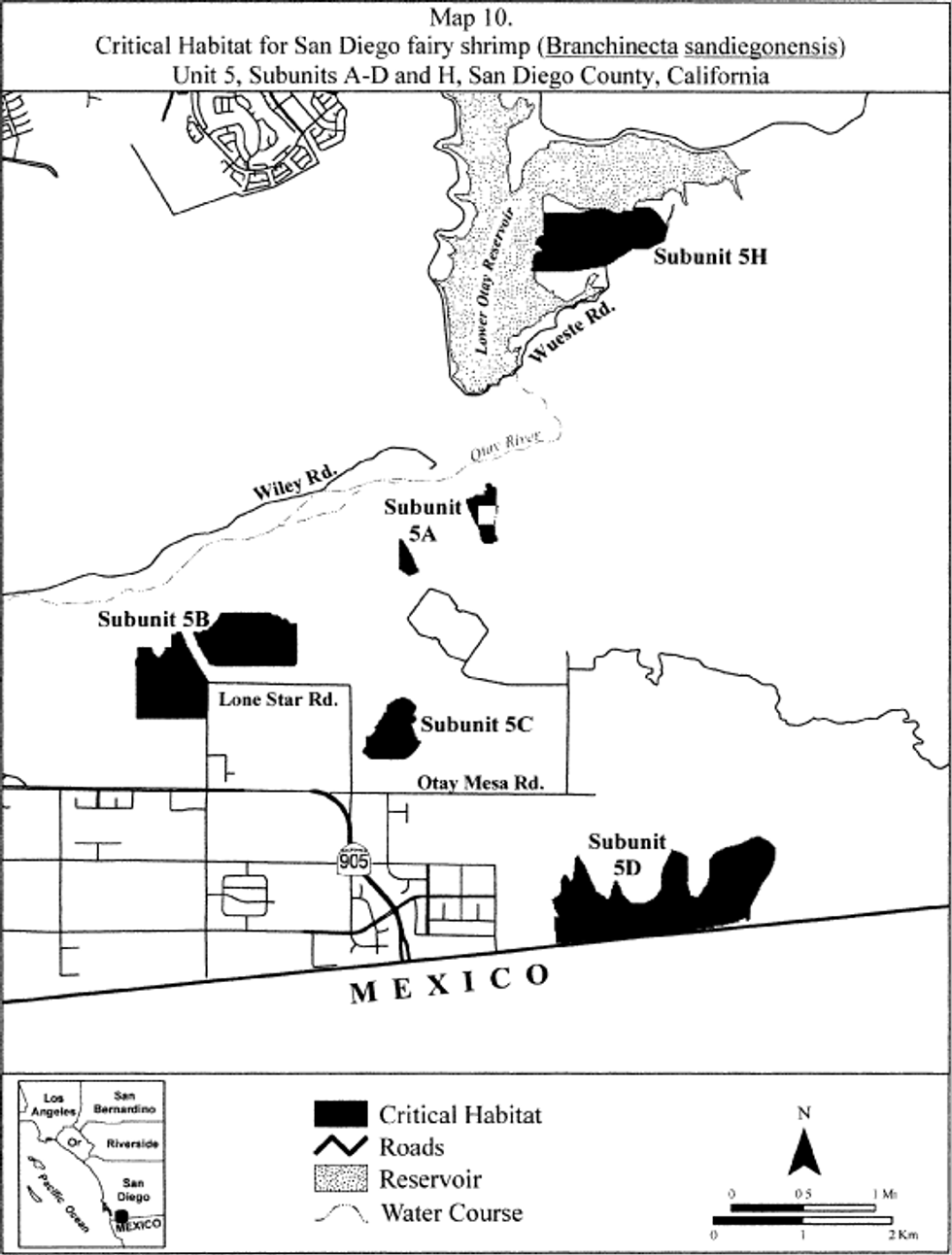
(ii) Map of Unit 5, Subunits 5F and 5G (Map 11) follows:
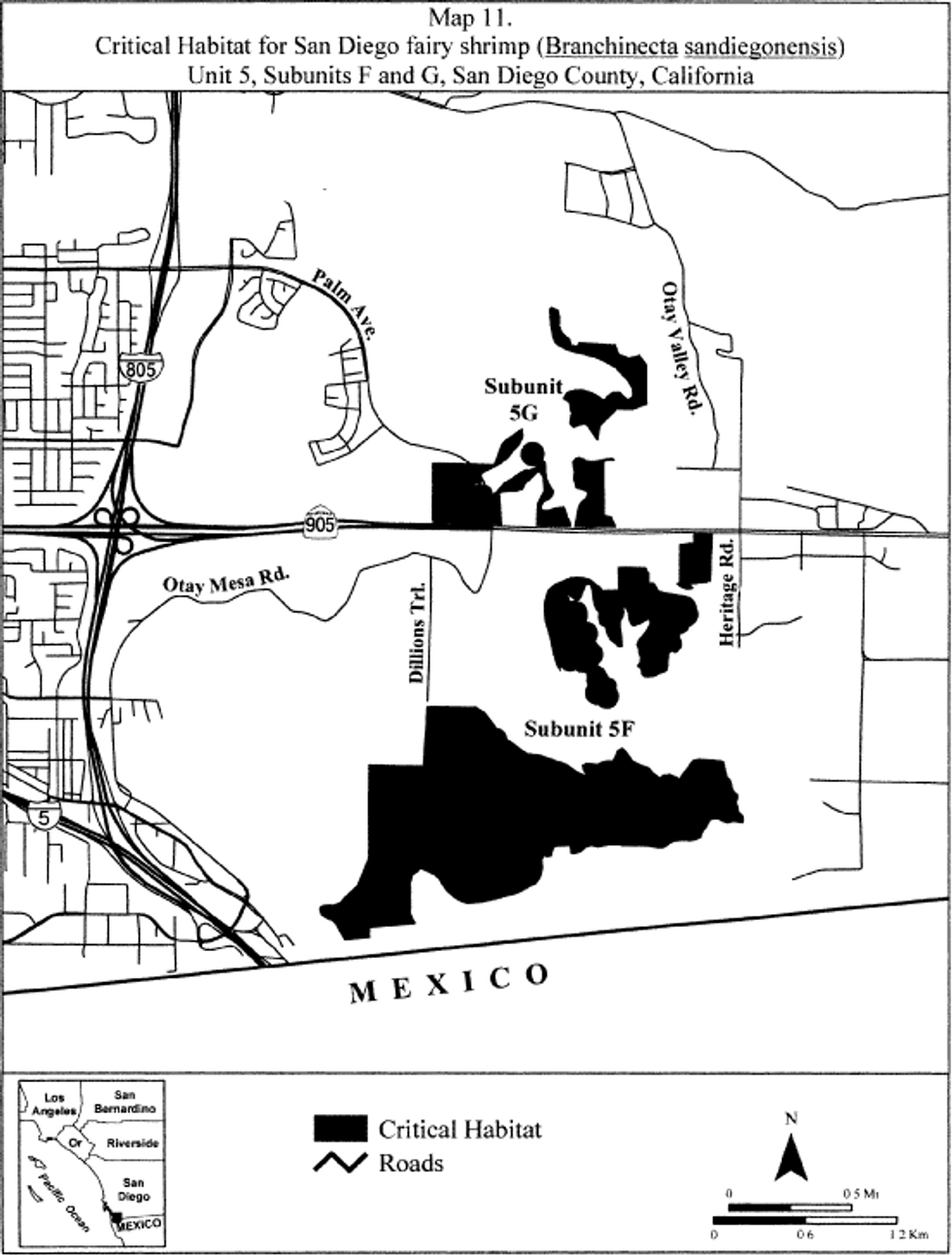
(iii) Map of Unit 5, Subunit 5I (Map 12) follows:
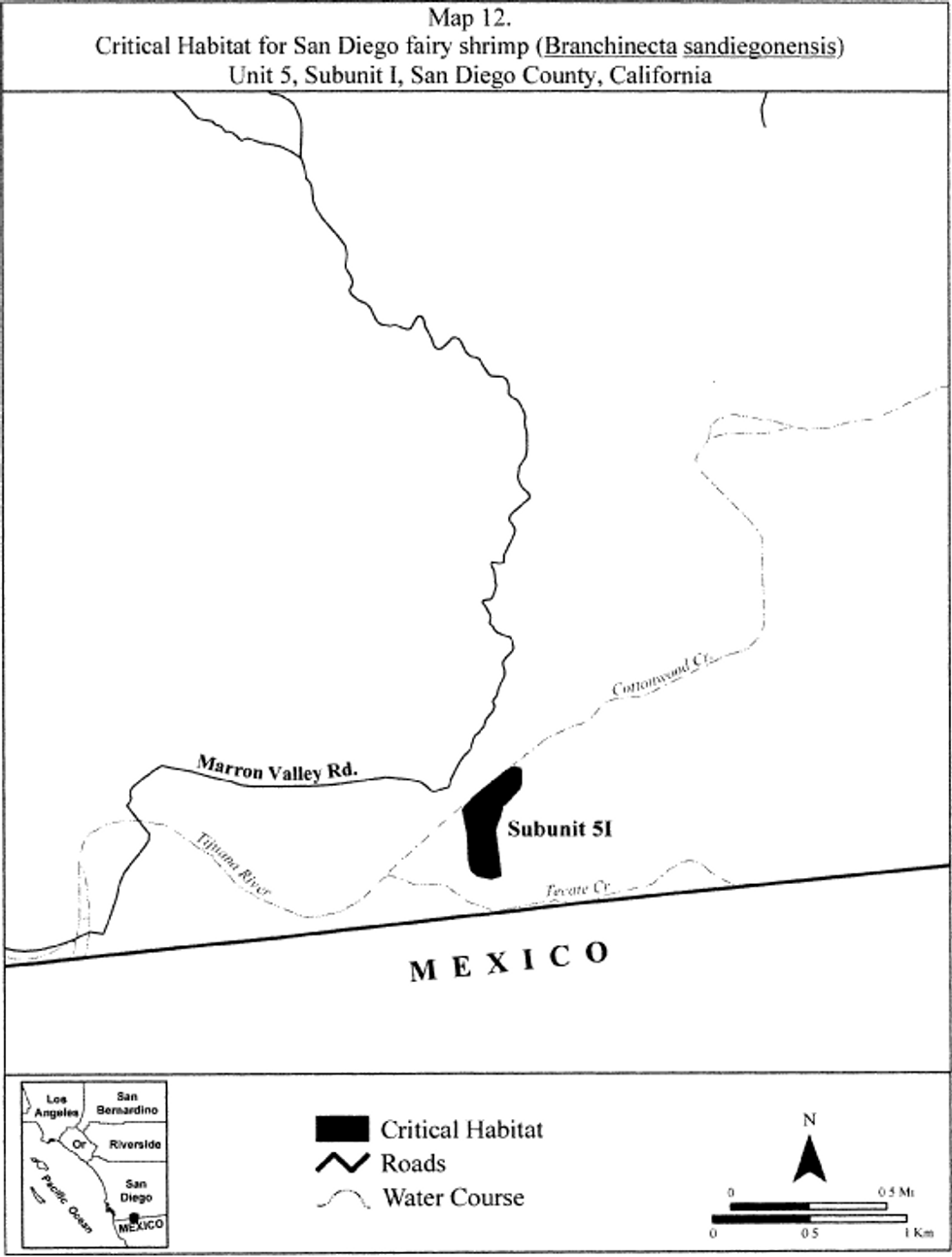
Vernal Pool Fairy Shrimp (Branchinecta lynchi)
(1) Critical habitat units are depicted for Jackson County, Oregon, and Alameda, Amador, Butte, Contra Costa, Fresno, Kings, Madera, Mariposa, Merced, Monterey, Napa, Placer, Sacramento, San Benito, San Joaquin, San Luis Obispo, Santa Barbara, Shasta, Solano, Stanislaus, Tehama, Tulare, Ventura, and Yuba Counties, California on the map below:
(2) The primary constituent elements of critical habitat for vernal pool fairy shrimp (Branchinecta lynchi) are the habitat components that provide:
(i) Topographic features characterized by mounds and swales and depressions within a matrix of surrounding uplands that result in complexes of continuously, or intermittently, flowing surface water in the swales connecting the pools described below in paragraph (2)(ii), providing for dispersal and promoting hydroperiods of adequate length in the pools;
(ii) Depressional features including isolated vernal pools with underlying restrictive soil layers that become inundated during winter rains and that continuously hold water for a minimum of 18 days, in all but the driest years; thereby providing adequate water for incubation, maturation, and reproduction. As these features are inundated on a seasonal basis, they do not promote the development of obligate wetland vegetation habitats typical of permanently flooded emergent wetlands;
(iii) Sources of food, expected to be detritus occurring in the pools, contributed by overland flow from the pools' watershed, or the results of biological processes within the pools themselves, such as single-celled bacteria, algae, and dead organic matter, to provide for feeding; and
(iv) Structure within the pools described above in paragraph (3)(ii), consisting of organic and inorganic materials, such as living and dead plants from plant species adapted to seasonally inundated environments, rocks, and other inorganic debris that may be washed, blown, or otherwise transported into the pools, that provide shelter.
(3) Existing manmade features and structures, such as buildings, roads, railroads, airports, runways, other paved areas, lawns, and other urban landscaped areas do not contain one or more of the primary constituent elements. Federal actions limited to those areas, therefore, would not trigger a consultation under section 7 of the Act unless they may affect the species and/or primary constituent elements in adjacent critical habitat.
(4) Unit 1: Jackson County, Oregon. Map of Unit 1 is provided at paragraph (7)(ii) of this entry.
(5) Unit 2: Jackson County, Oregon. Map of Unit 2 is provided at paragraph (7)(ii) of this entry.
(6) Unit 3: Jackson County, Oregon. Map of Unit 3 is provided at paragraph (7)(ii) of this entry.
(7) Unit 4: Jackson County, Oregon
(i) [Reserved]
(ii) Units 1-4 (Map 1) follow:
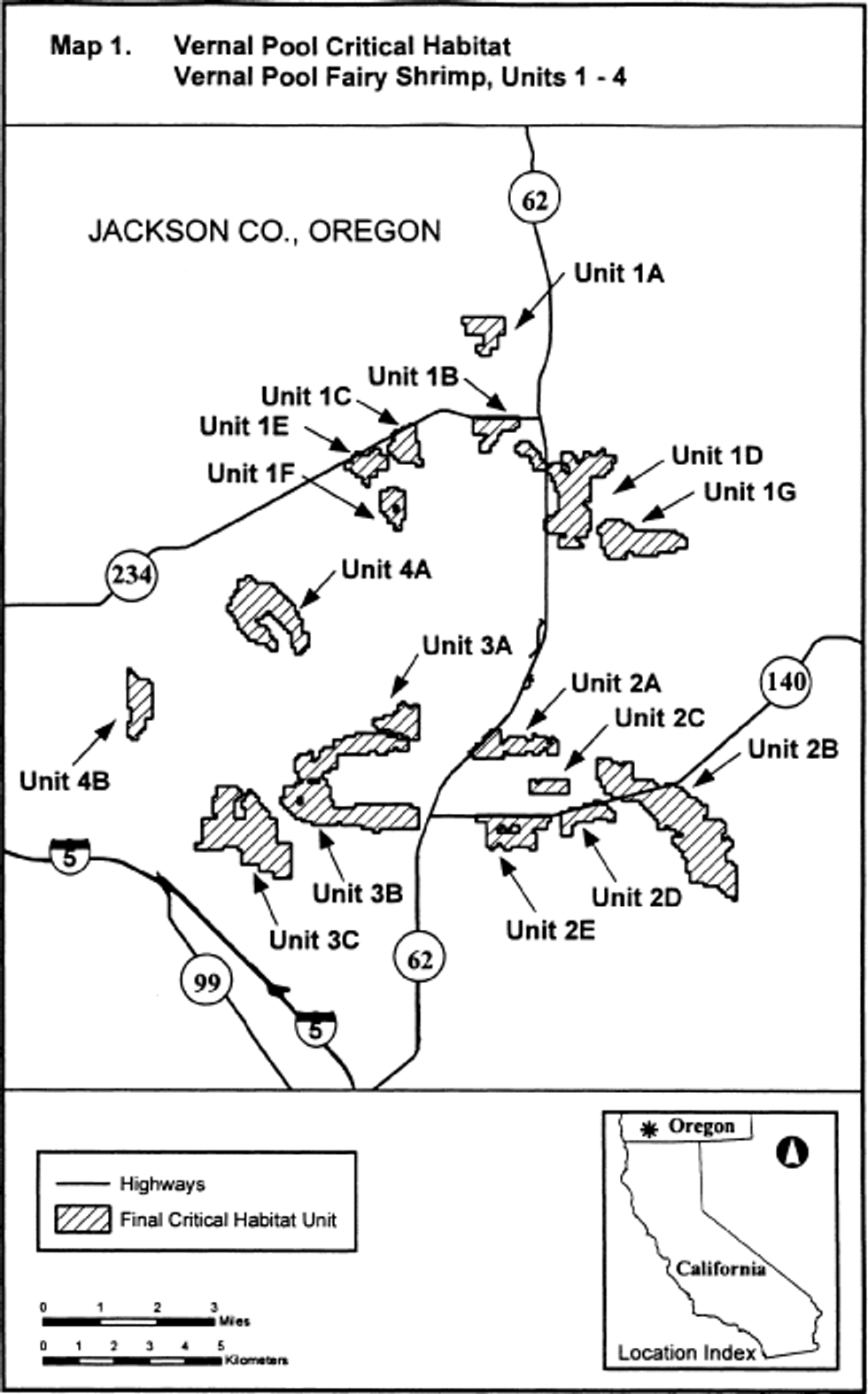
(8) Unit 5: Shasta County, California. Map of Unit 5 is provided at paragraph (13) of this entry.
(9) Unit 6: Tehama County, California. Map of Unit 6 is provided at paragraph (13) of this entry.
(10) Unit 7: Tehama County, California. Map of Unit 7 is provided at paragraph (13) of this entry.
(11) Unit 8: Tehama and Glenn Counties, California. Map of Unit 8 is provided at paragraph (13) of this entry.
(12) Unit 9: Butte County, California. Map of Unit 9 is provided at paragraph (13) of this entry.
(13) Units 5-9 (Map 2) follow:
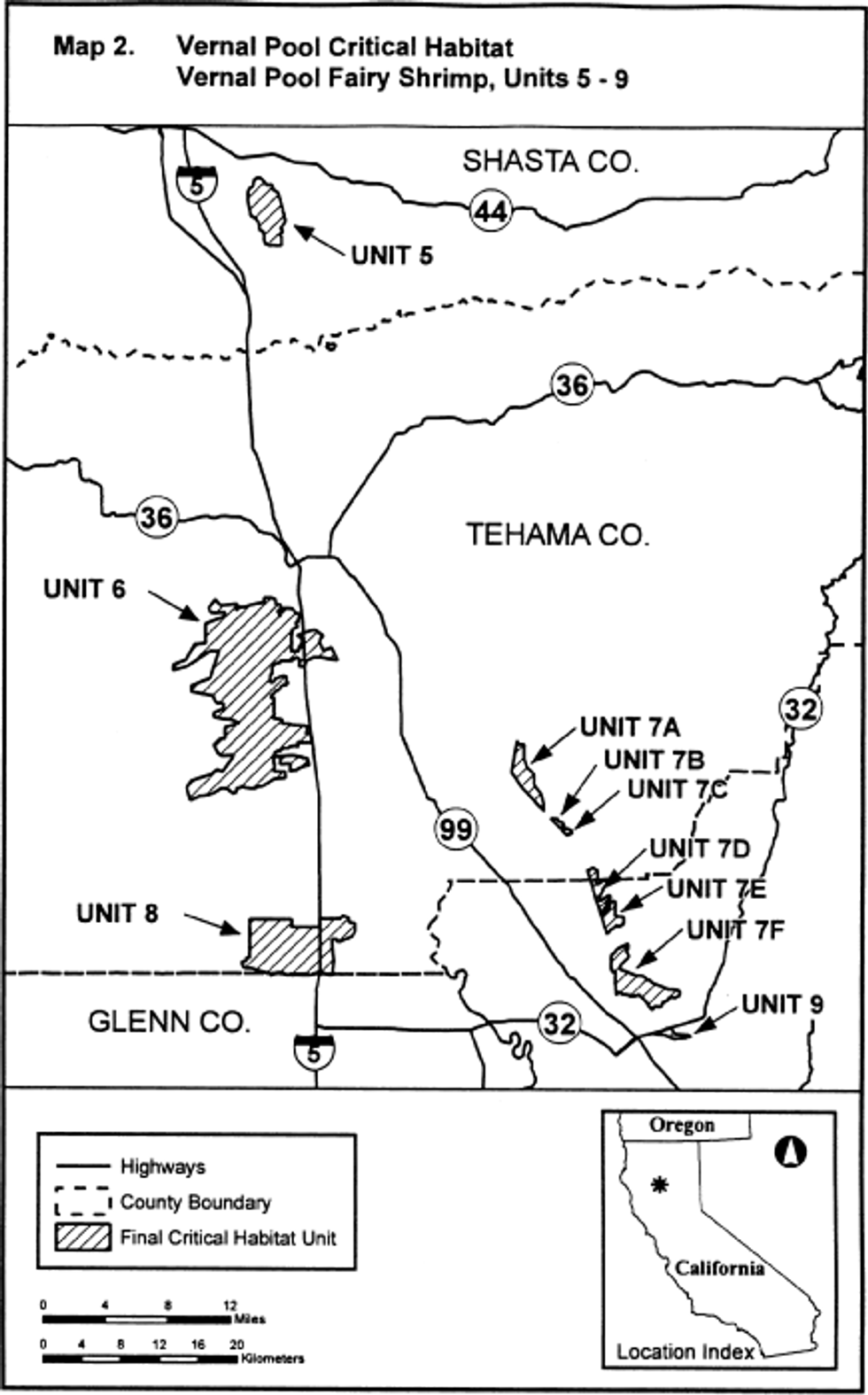
(14) Unit 10: Glenn and Colusa Counties, California. This unit was excluded from the designation pursuant to Section 4(b)(2) of the Act.
(15) Unit 11: Yuba County, California. Map of Unit 11 is provided at paragraph (16)(ii) of this entry.
(16) Unit 12: Placer County, California.
(i) [Reserved]
(ii) Units 11-12 (Map 3) follow:
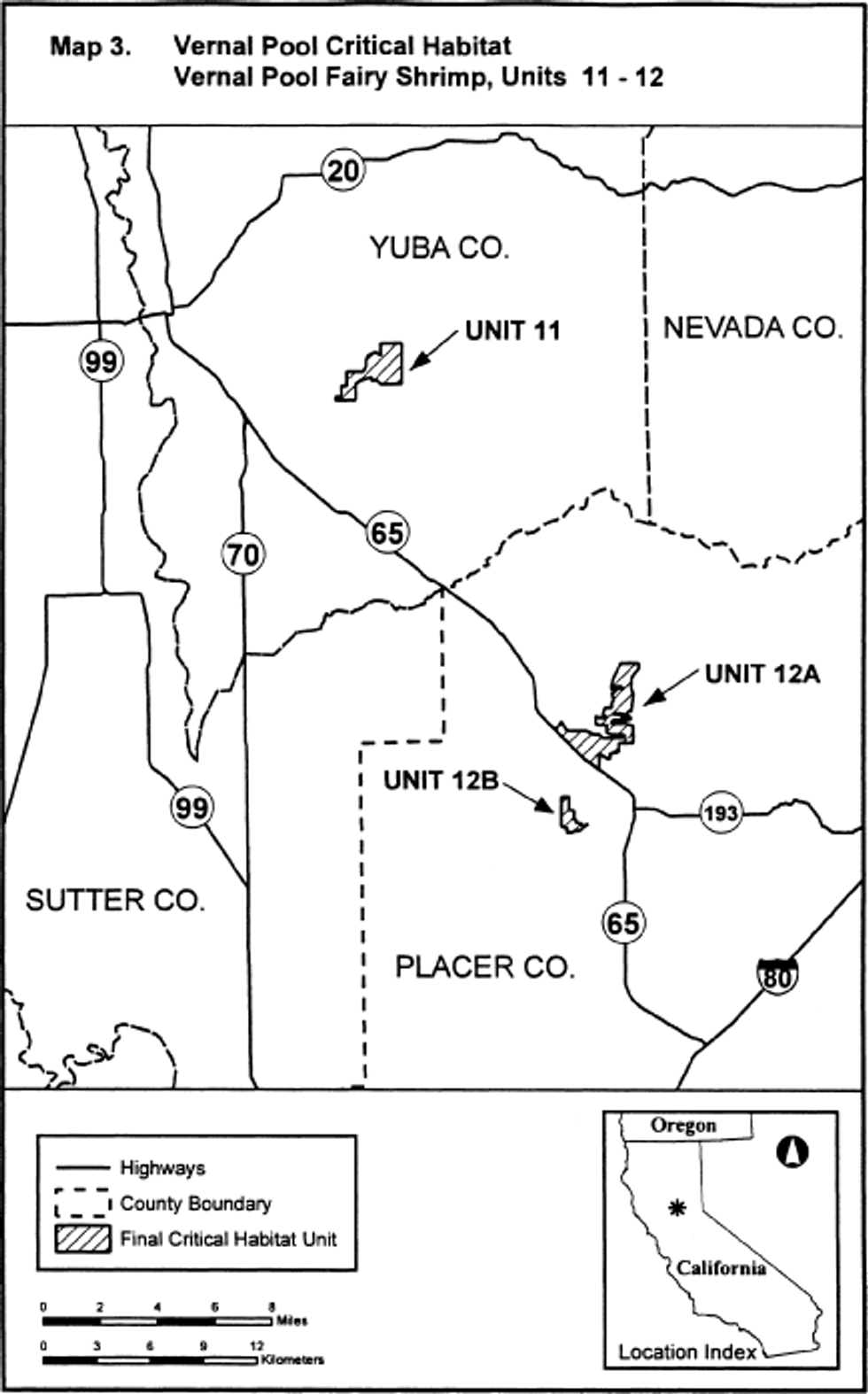
(17) Unit 13: Sacramento County, California. Map of Unit 13 is provided at paragraph (18)(ii) of this entry.
(18) Unit 14: Sacramento and Amador County, California.
(i) [Reserved]
(ii) Units 13-14 (Map 4) follow:
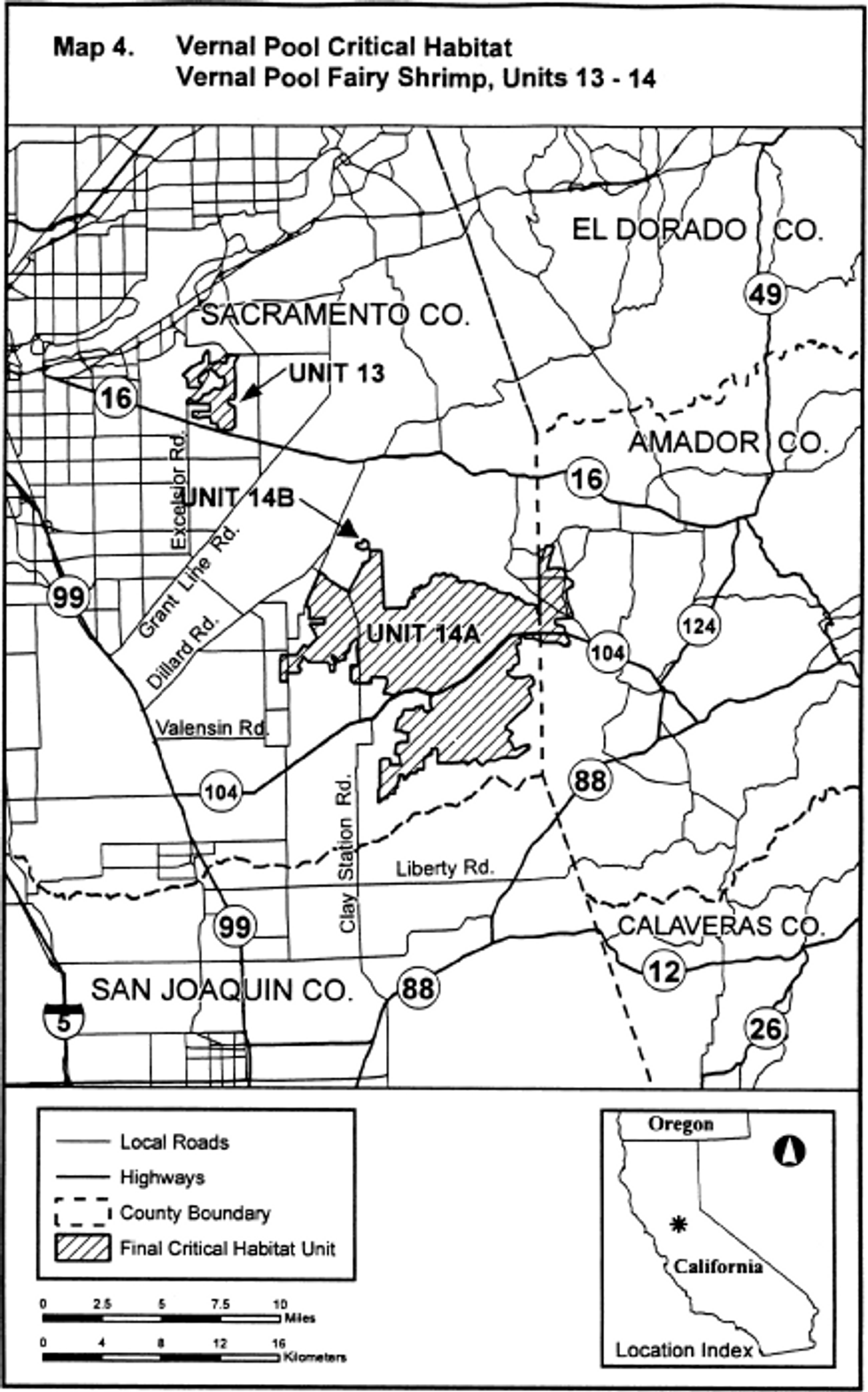
(19) Unit 16: Solano County, California. Map of Unit 16 is provided at paragraph (21) of this entry.
(20) Unit 17: Napa County, California. Map of Unit 17 is provided at paragraph (21) of this entry.
(21) Units 16-17 (Map 5) follow:
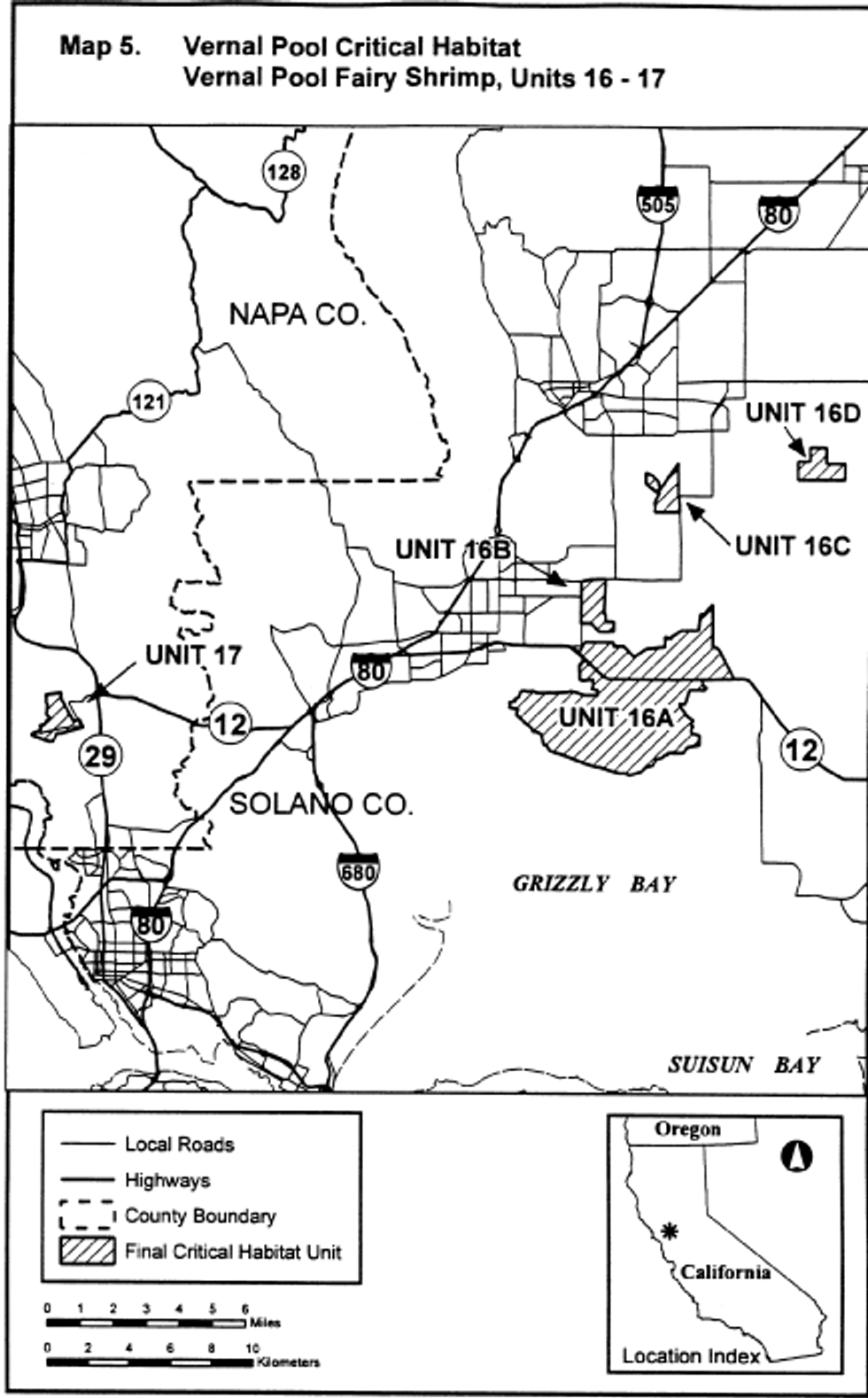
(22) Unit 18: San Joaquin County, California. Map of Unit 18 is provided at paragraph (25) of this entry.
(23) Unit 19: Contra Costa County, California. Map of Unit 19 is provided at paragraph (25) of this entry.
(24) Unit 20: Stanislaus County, California. Map of Unit 20 is provided at paragraph (25) of this entry.
(25) Maps of Units 18, 19, and 20 (Maps 6 and 7) follow:
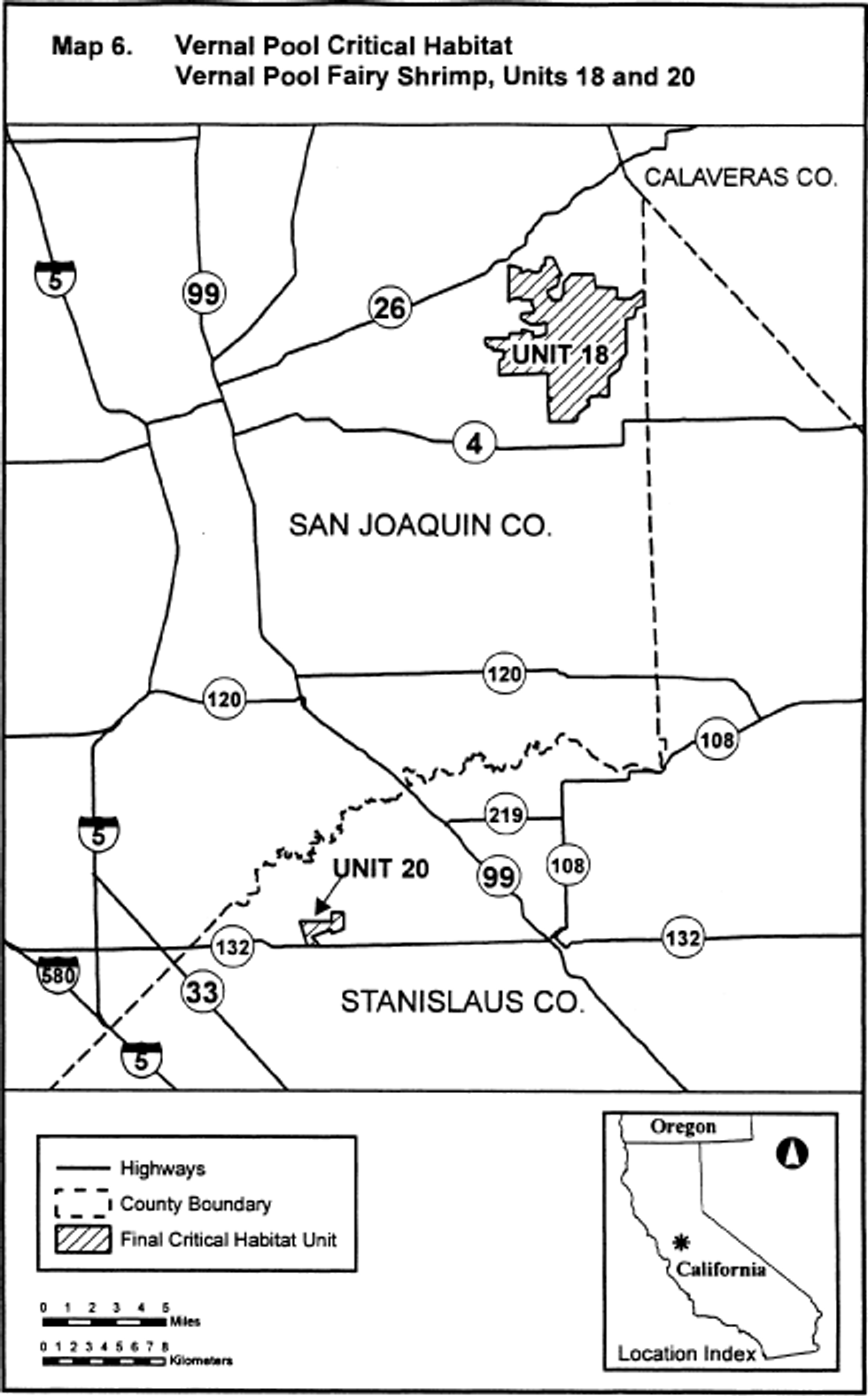
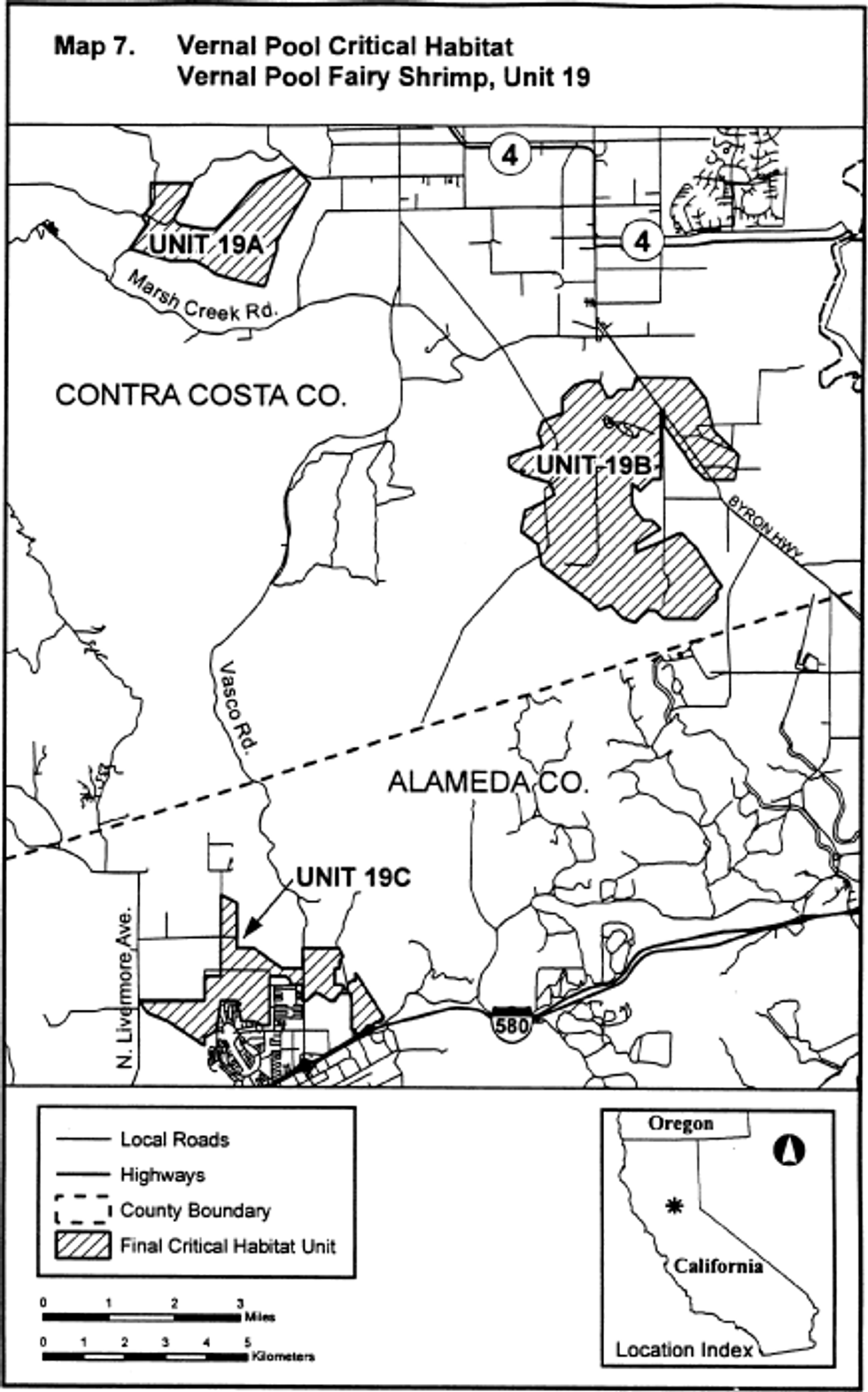
(26) Unit 21: Stanislaus County, California. Map of Unit 21 is provided at paragraph (28) of this entry.
(27) Unit 22: Merced County, California. Map of Unit 22 is provided at paragraph (28) of this entry.
(28) Units 21-22 (Map 8) follow:
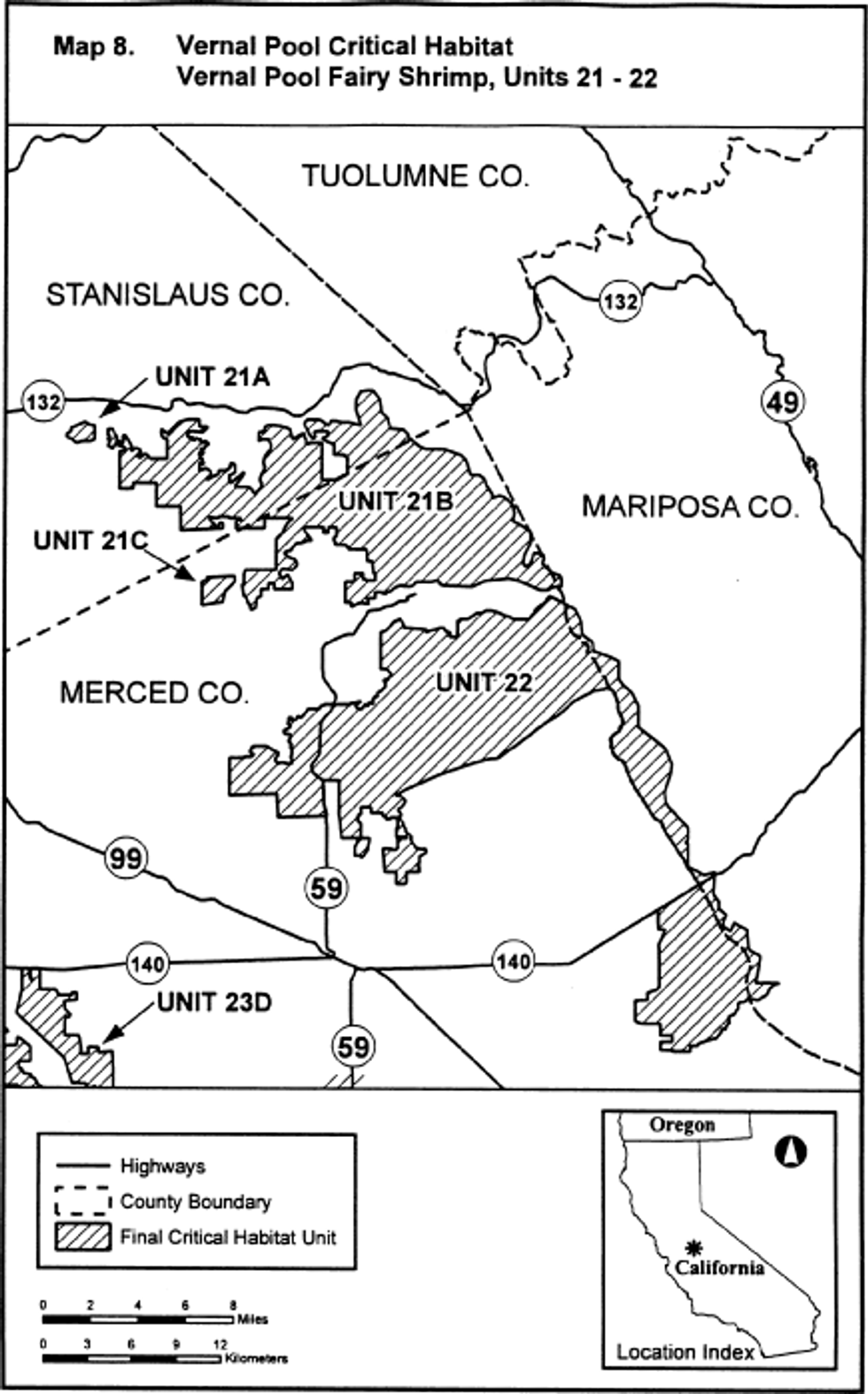
(29) Unit 23: Merced County, California
(i) [Reserved]
(ii) Unit 23 (Map 9) follows:
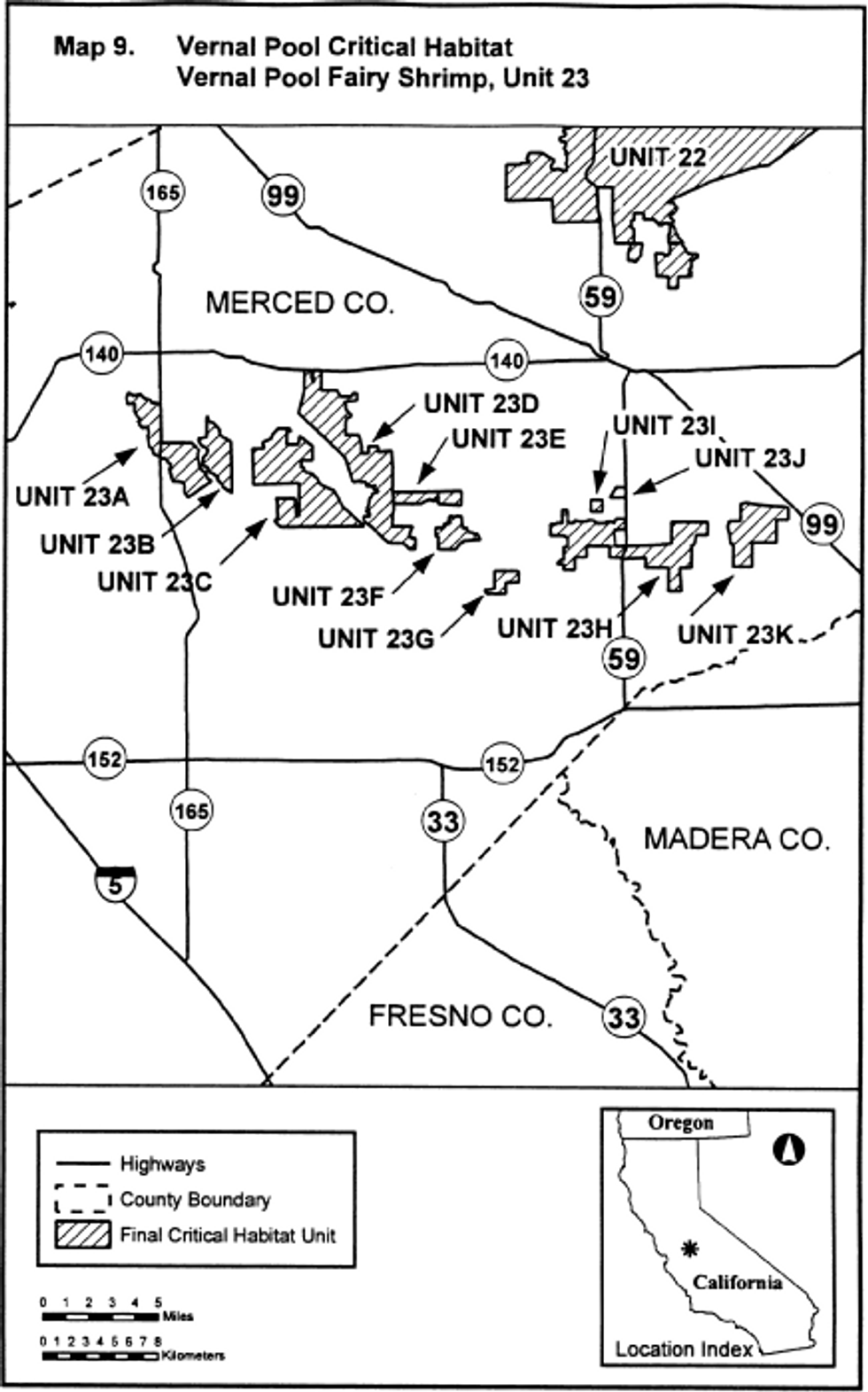
(30) Unit 24: Madera County, California. Map of Unit 24 is provided at paragraph (32) of this entry.
(31) Unit 25: Madera County, California. Map of Unit 25 is provided at paragraph (32) of this entry.
(32) Units 24-25 (Map 10) follow:

(33) Unit 26: Tulare and Kings Counties, California.
(i) [Reserved]
(ii) Unit 26 (Map 11) follows:
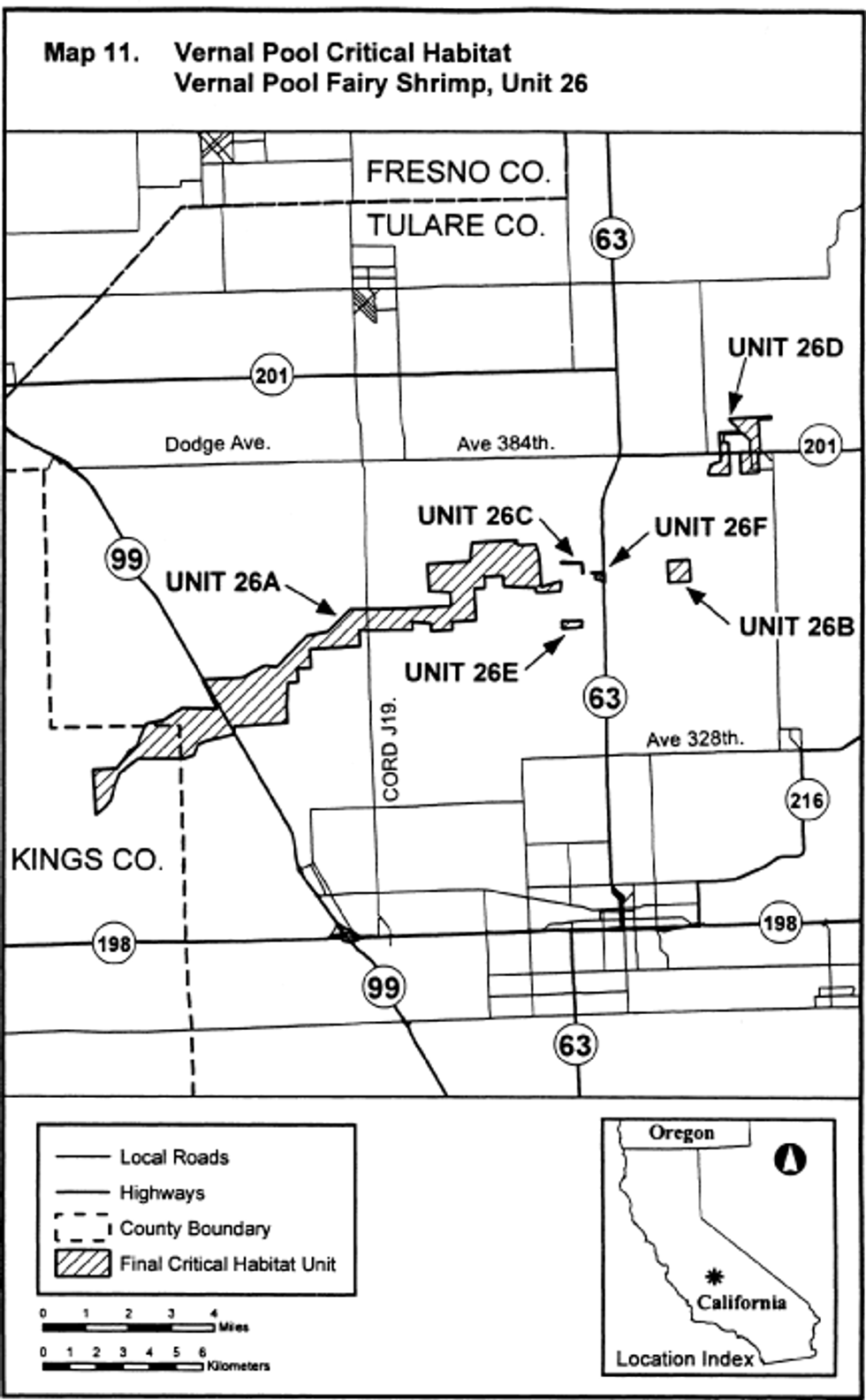
(34) Unit 27: Tulare County, California.
(i) [Reserved]
(ii) Unit 27 (Map 12) follows:
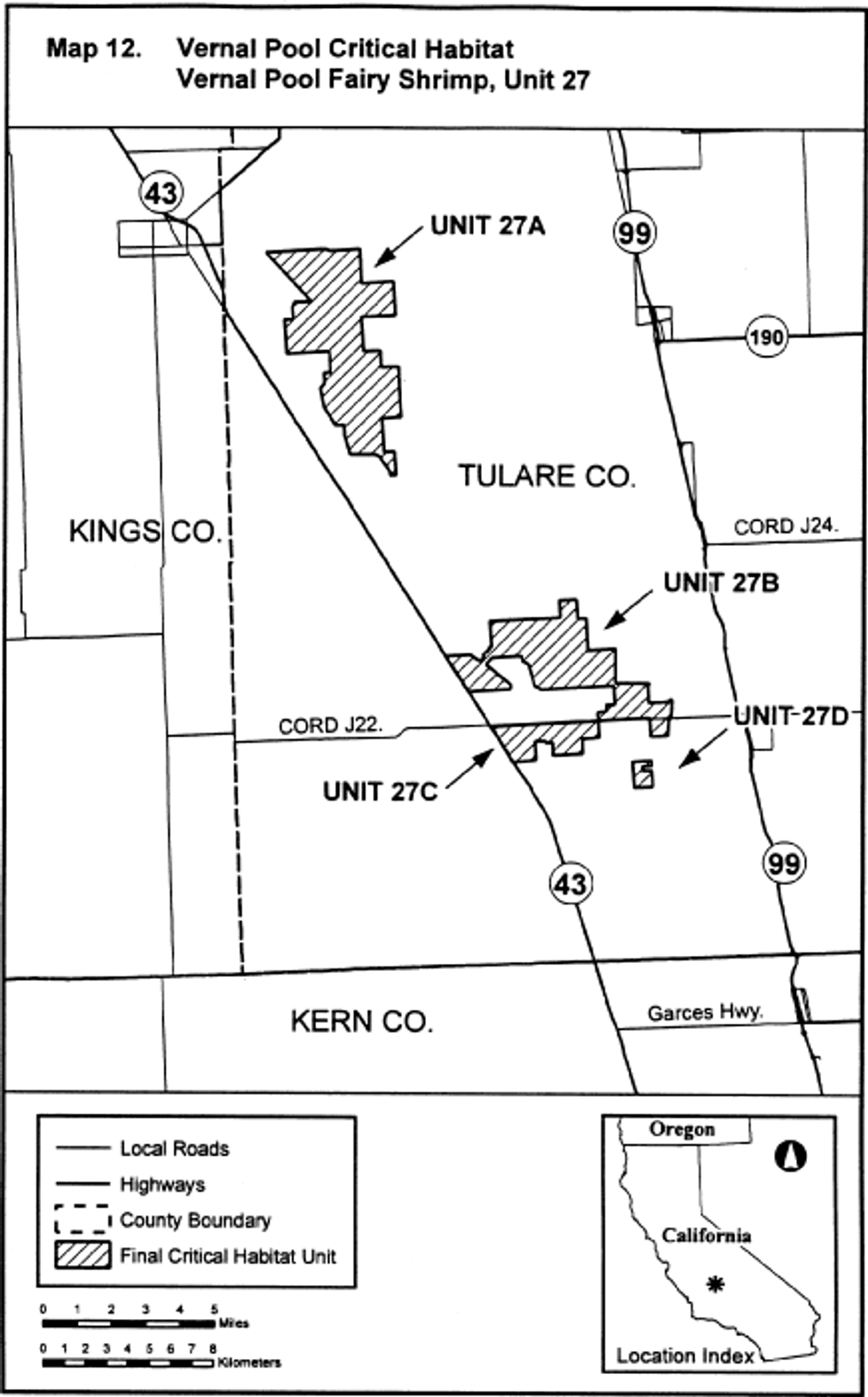
(35) Unit 28: San Benito and Monterey Counties, California. Map of Unit 28 is provided at paragraph (36) of this entry.
(36) Unit 28 (Map 13) follows:
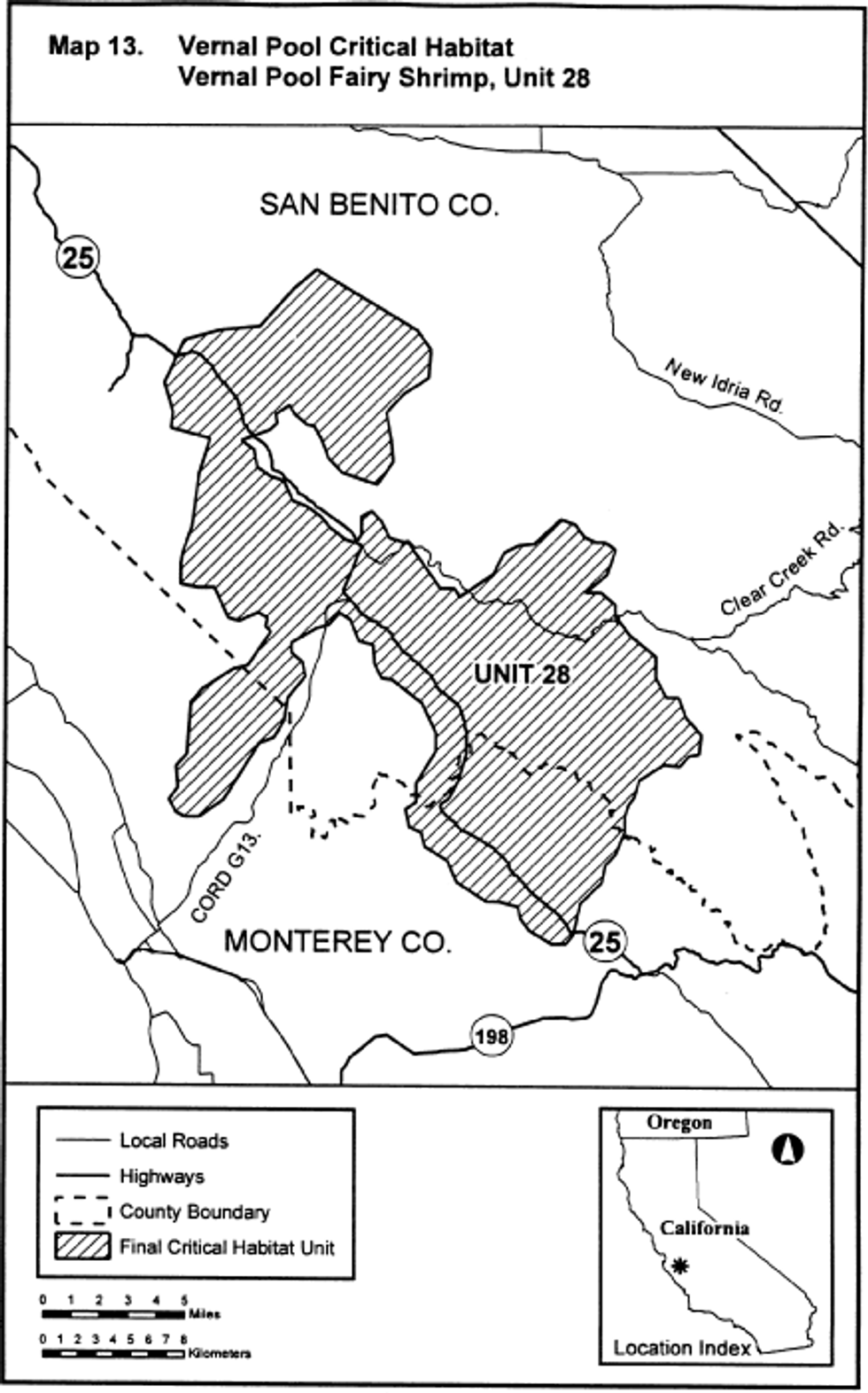
(37) Unit 29: Monterey County, California.
(i) [Reserved]
(ii) Unit 29 (Map 14) follows:
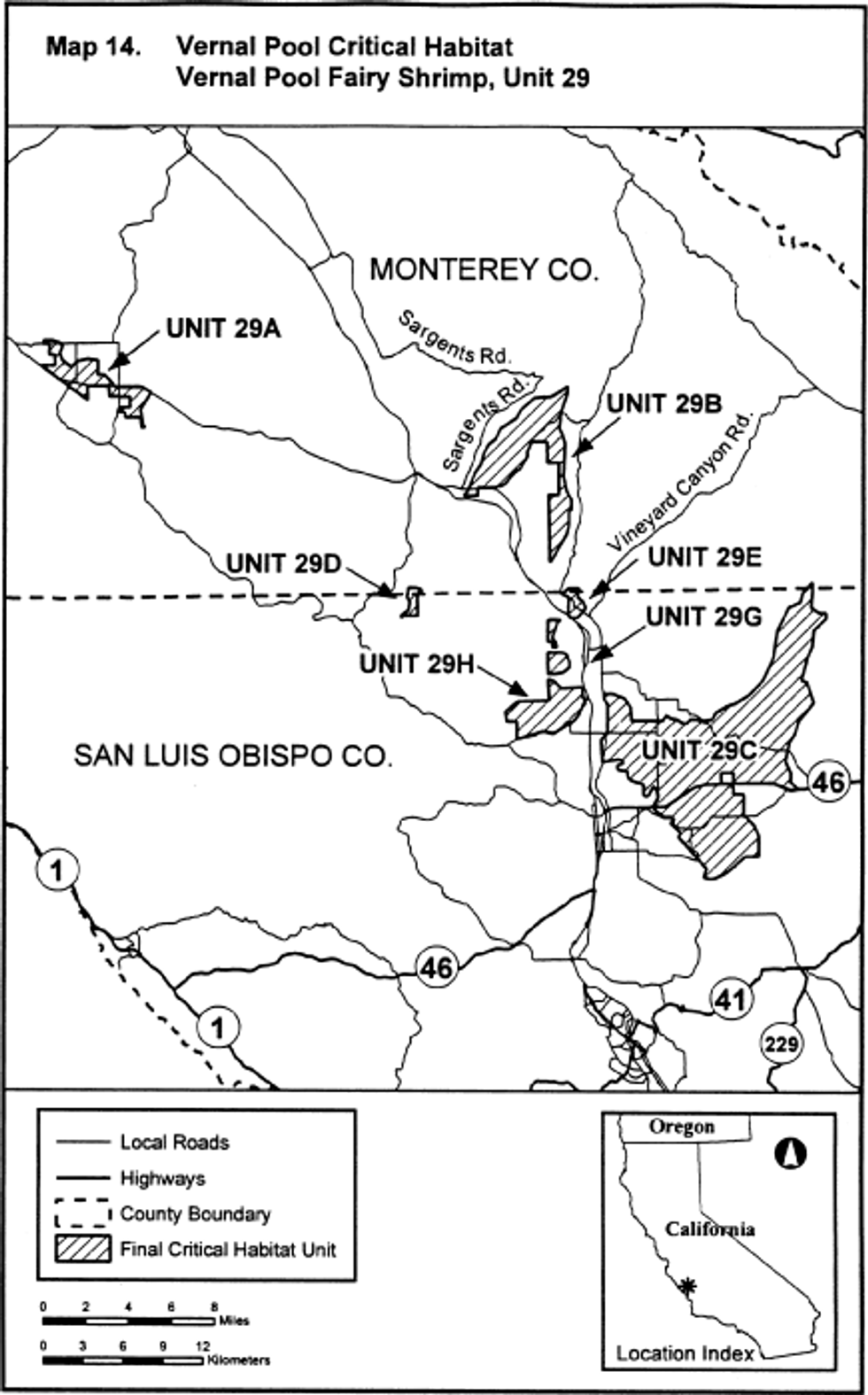
(38) Unit 30: San Luis Obispo County, California. Map of Unit 30 is provided at paragraph (39) of this entry.
(39) Unit 30 (Map 15) follows:
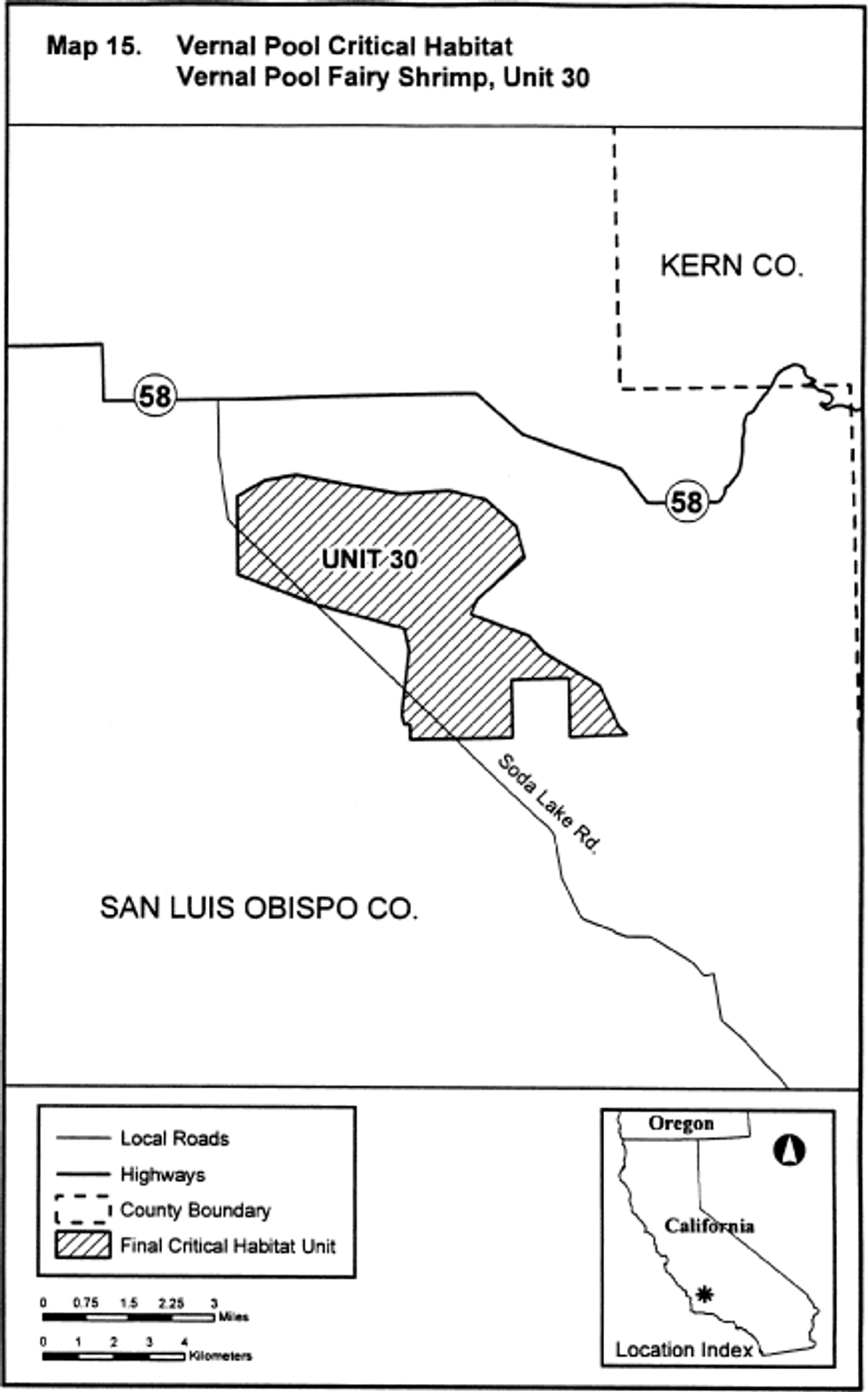
(40) Unit 31: Santa Barbara County, California. Map of Unit 31 is provided at paragraph (41) of this entry.
(41) Unit 31 (Map 16) follows:
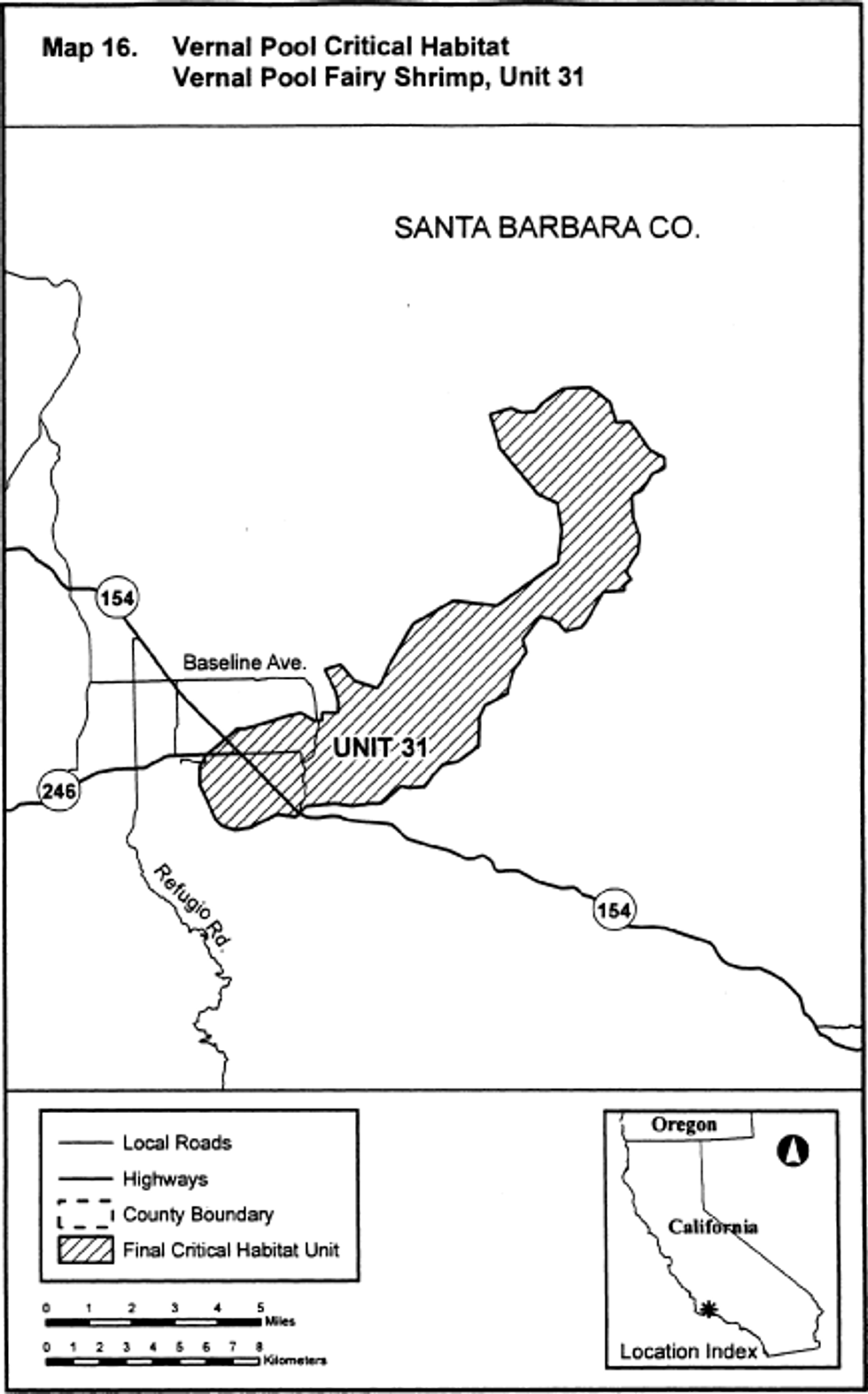
(42) Unit 32: Ventura County, California. Map of Unit 32 is provided at paragraph (43) of this entry.
(43) Unit 32 (Map 17) follows:
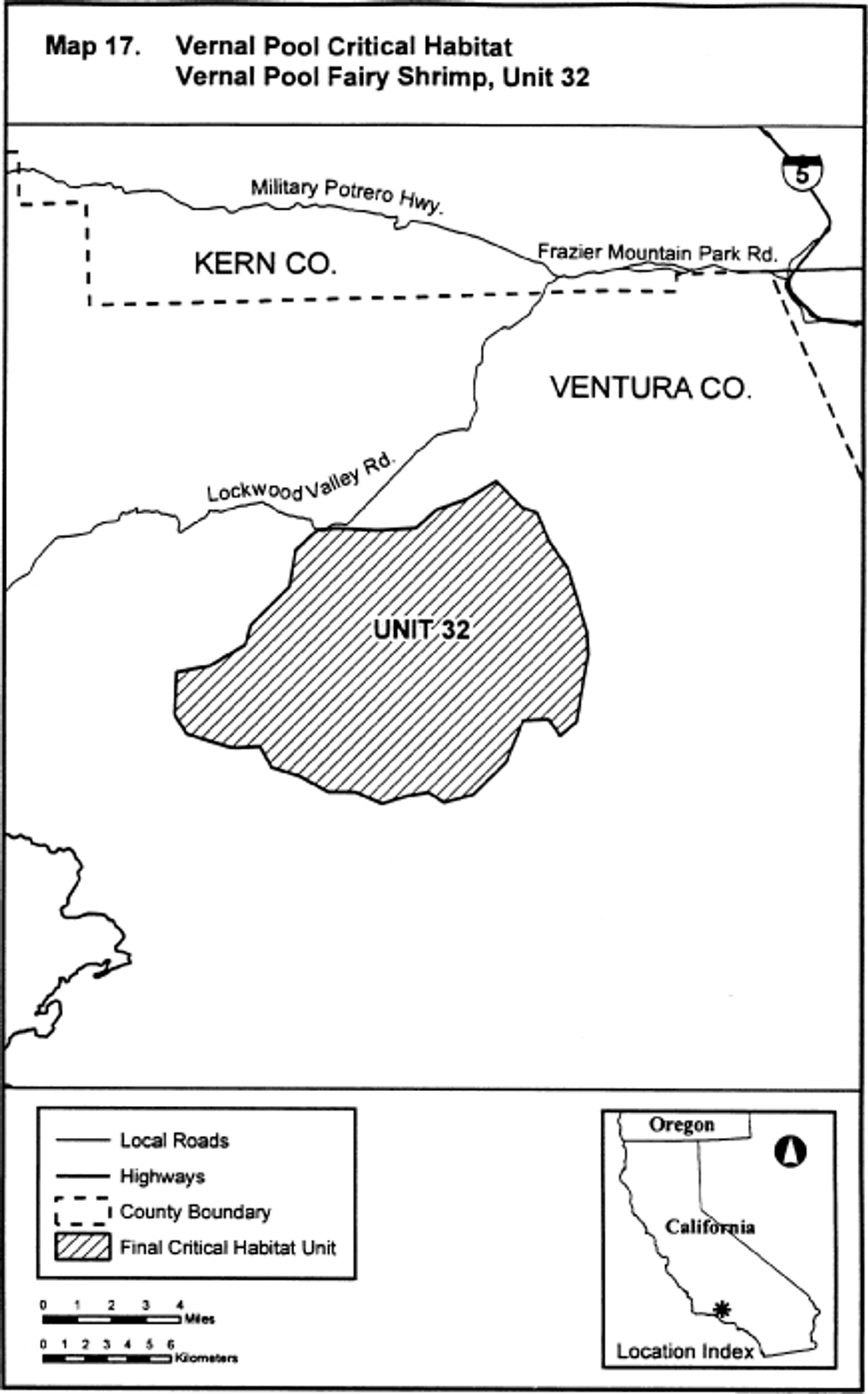
Kentucky Cave Shrimp (Palaemonias ganteri)
Kentucky, Edmonson County: The Roaring River passage of the Flint-Mammoth Cave System in Mammoth Cave National Park.
Note:
The map provided is for informational purposes only. Map follows:
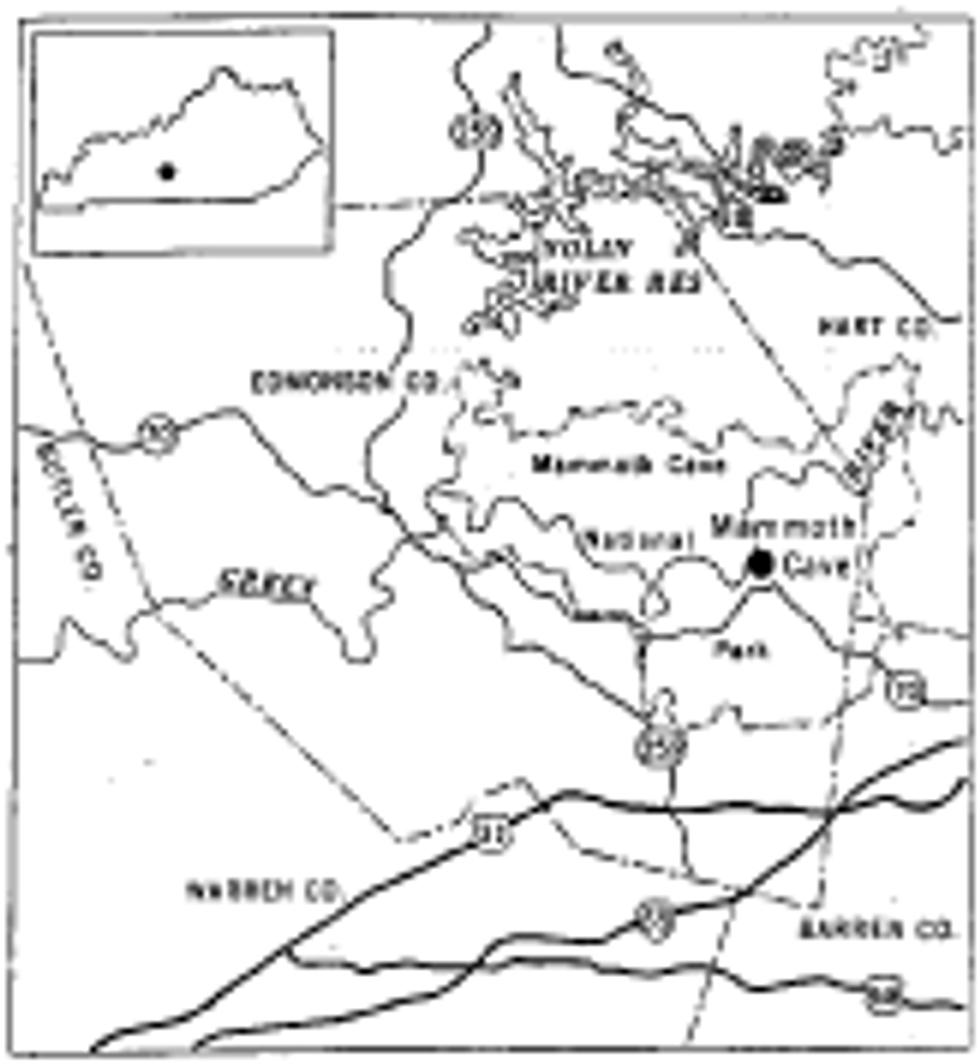
Known constituent elements include a stream in a base level cave passage with abundant organic material and sediments consisting of coarse silt and very coarse to very fine sand.
Vernal Pool Tadpole Shrimp (Lepidurus packardi)
(1) Critical habitat units are depicted for Alameda, Amador, Butte, Colusa, Fresno, Kings, Madera, Mariposa, Merced, Sacramento, Shasta, Solano, Stanislaus, Tehama, Tulare, Yolo, and Yuba counties, California, on the map below.
(2) The primary constituent elements of critical habitat for vernal pool tadpole shrimp (Lepidurus packardi) are the habitat components that provide:
(i) Topographic features characterized by mounds and swales and depressions within a matrix of surrounding uplands that result in complexes of continuously, or intermittently, flowing surface water in the swales connecting the pools described below in paragraph (2)(ii), providing for dispersal and promoting hydroperiods of adequate length in the pools;
(ii) Depressional features including isolated vernal pools with underlying restrictive soil layers that become inundated during winter rains and that continuously hold water for a minimum of 41 days, in all but the driest years; thereby providing adequate water for incubation, maturation, and reproduction. As these features are inundated on a seasonal basis, they do not promote the development of obligate wetland vegetation habitats typical of permanently flooded emergent wetlands;
(iii) Sources of food, expected to be detritus occurring in the pools, contributed by overland flow from the pools' watershed, or the results of biological processes within the pools themselves, such as single-celled bacteria, algae, and dead organic matter, to provide for feeding; and
(iv) Structure within the pools described above in paragraph (2)(ii), consisting of organic and inorganic materials, such as living and dead plants from plant species adapted to seasonally inundated environments, rocks, and other inorganic debris that may be washed, blown, or otherwise transported into the pools, that provide shelter.
(3) Existing manmade features and structures, such as buildings, roads, railroads, airports, runways, other paved areas, lawns, and other urban landscaped areas do not contain one or more of the primary constituent elements. Federal actions limited to those areas, therefore, would not trigger a consultation under section 7 of the Act unless they may affect the species and/or primary constituent elements in adjacent critical habitat.
(4) Unit 1: Shasta County, California. Map of Unit 1 is provided at paragraph (5)(ii) of this entry.
(5) Unit 2: Shasta County, California.
(i) [Reserved]
(ii) Units 1 and 2 (Map 1) follow:
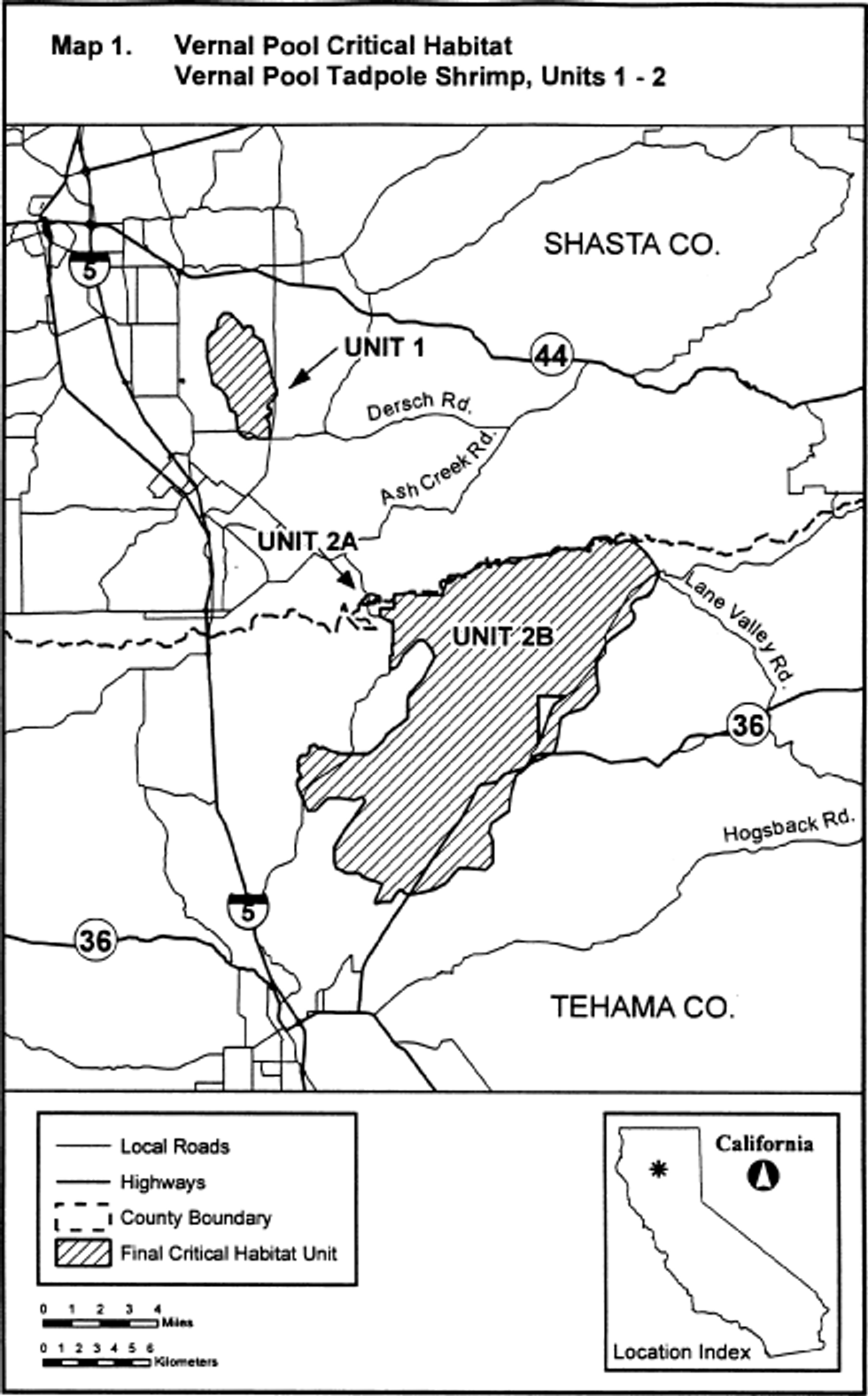
(6) Unit 3: Tehama County, California.
(i) [Reserved]
(ii) Unit 3 (Map 2) follows:
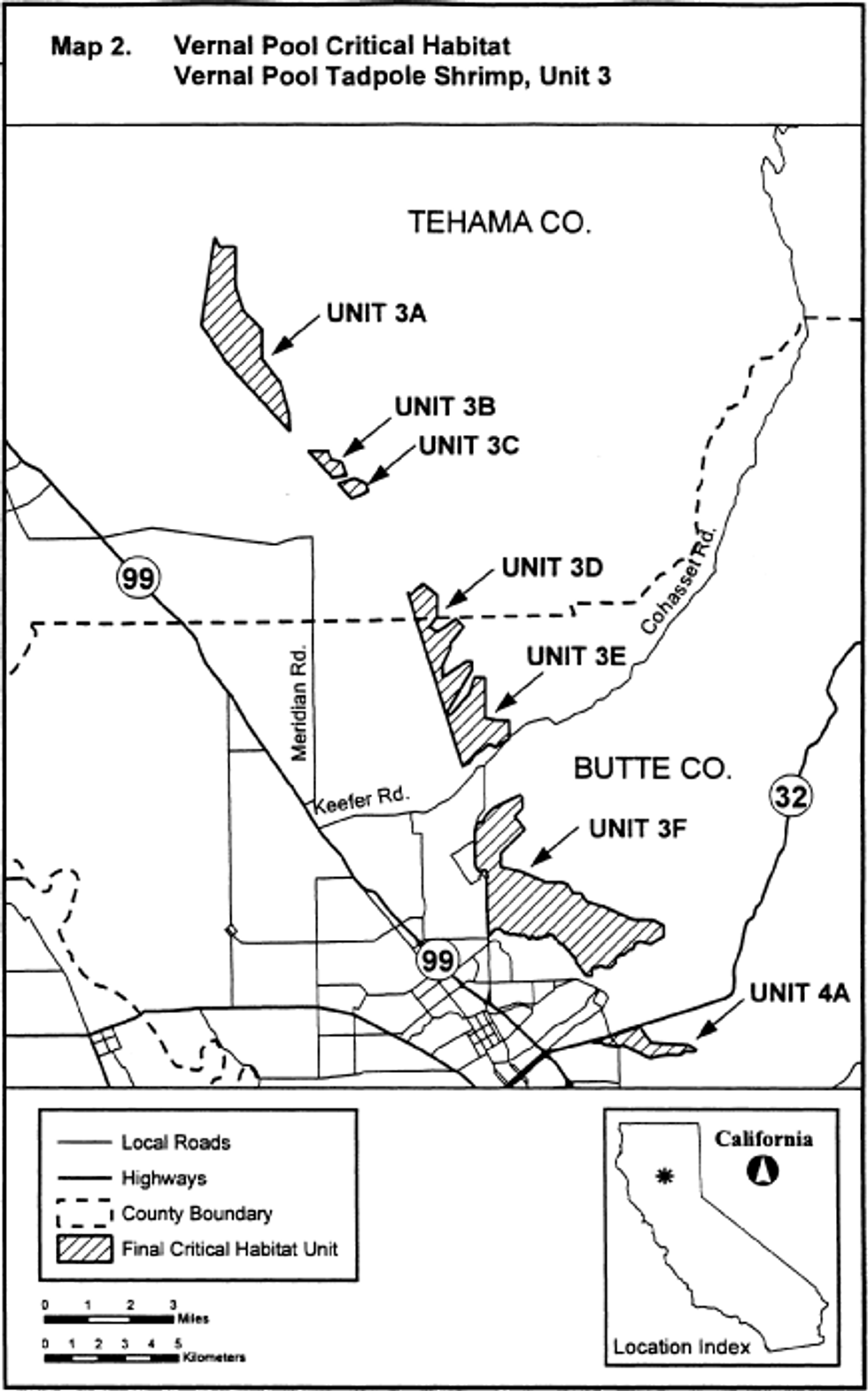
(7) Unit 4: Butte County, California.
(i) [Reserved]
(ii) Unit 4 (Map 3) follows:
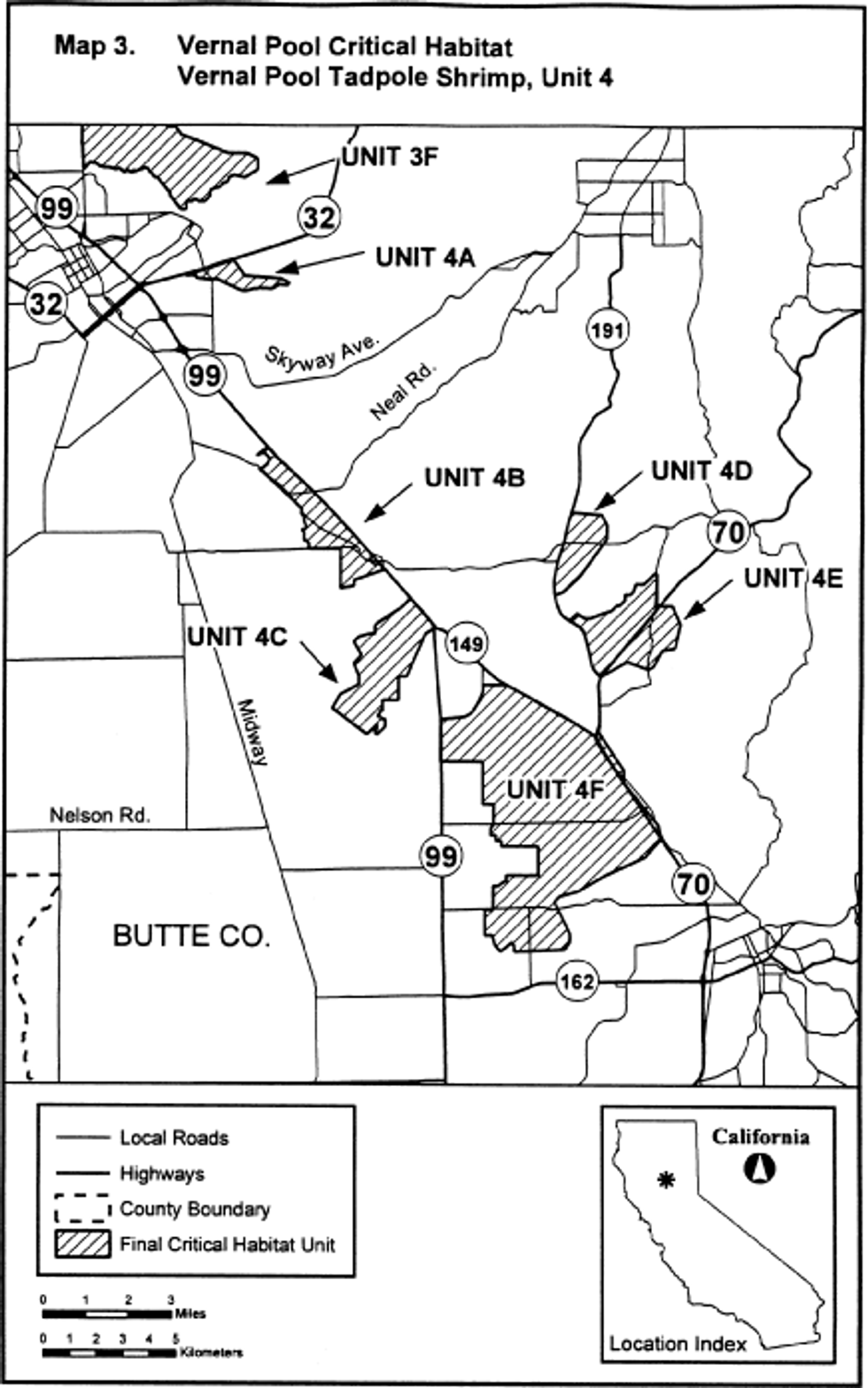
(8) Unit 6: Colusa County, California. Map of Unit 6 is provided at paragraph (10) of this entry.
(9) Unit 7: Yuba County, California. Map of Unit 7 is provided at paragraph (10) of this entry.
(10) Units 6 and 7 (Map 4) follow:
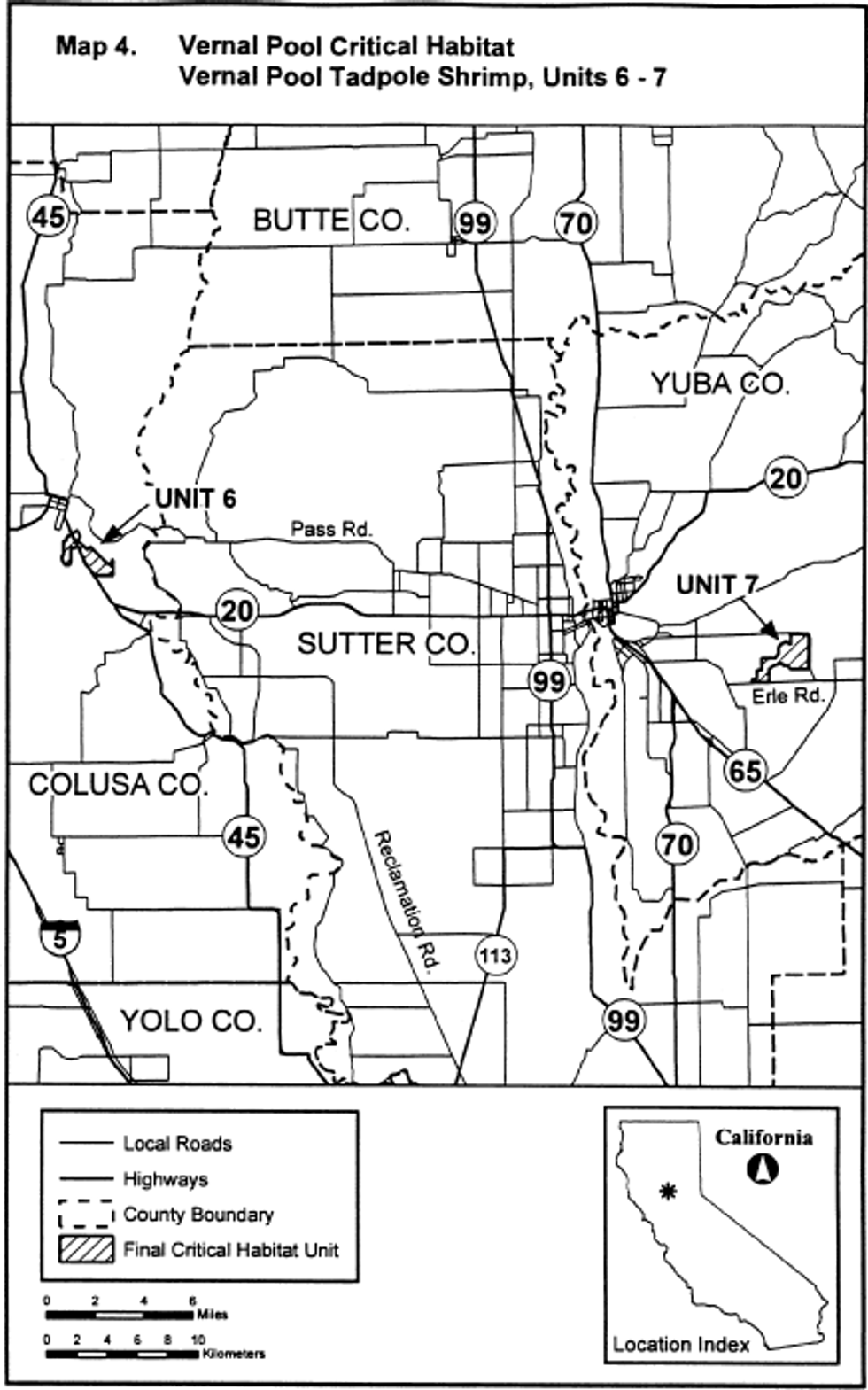
(11) Unit 8: Sacramento County, California. Map of Unit 8 is provided at paragraph (12)(ii) of this entry.
(12) Unit 9: Sacramento County, California.
(i) [Reserved]
(ii) Units 8 and 9 (Map 5) follow:
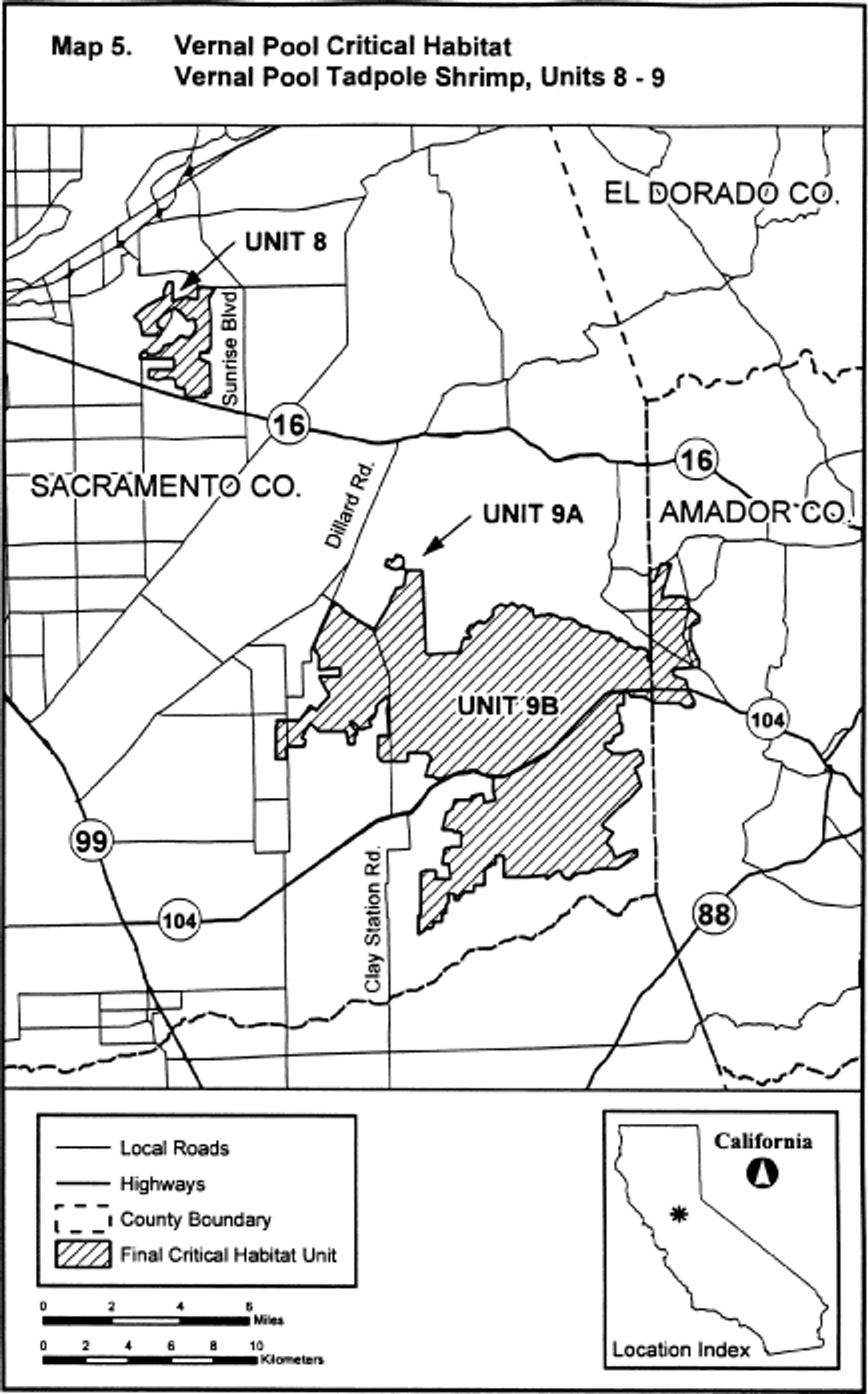
(13) Unit 10: Yolo County, California. Map of Unit 10 is provided at paragraph (14)(ii) of this entry.
(14) Unit 11: Solano County, California
(i) [Reserved]
(ii) Units 10 and 11 (Map 6) follow:
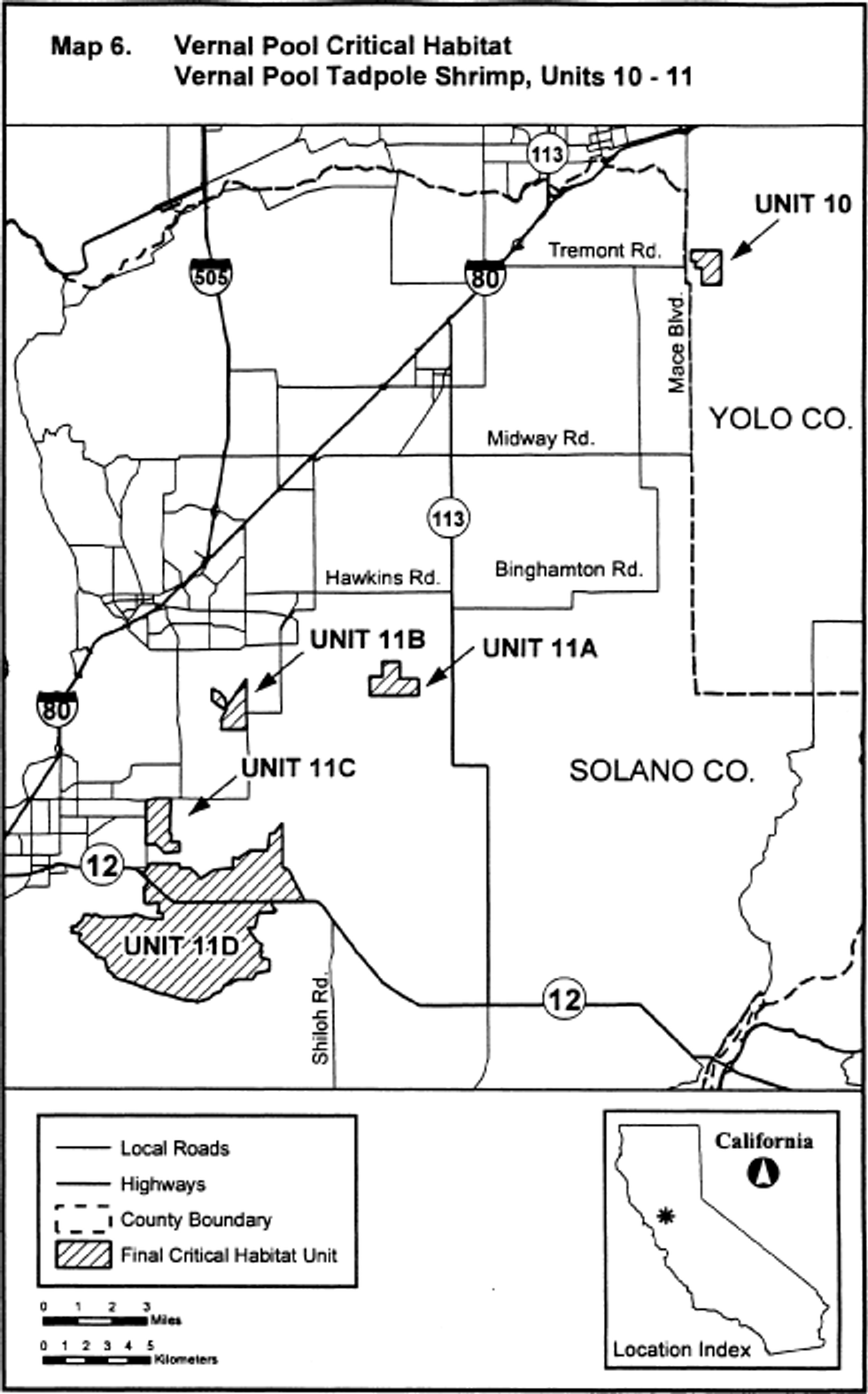
(15) Unit 13: Stanislaus County, California.
(i) [Reserved]
(ii) Unit 13 (Map 7) follows:
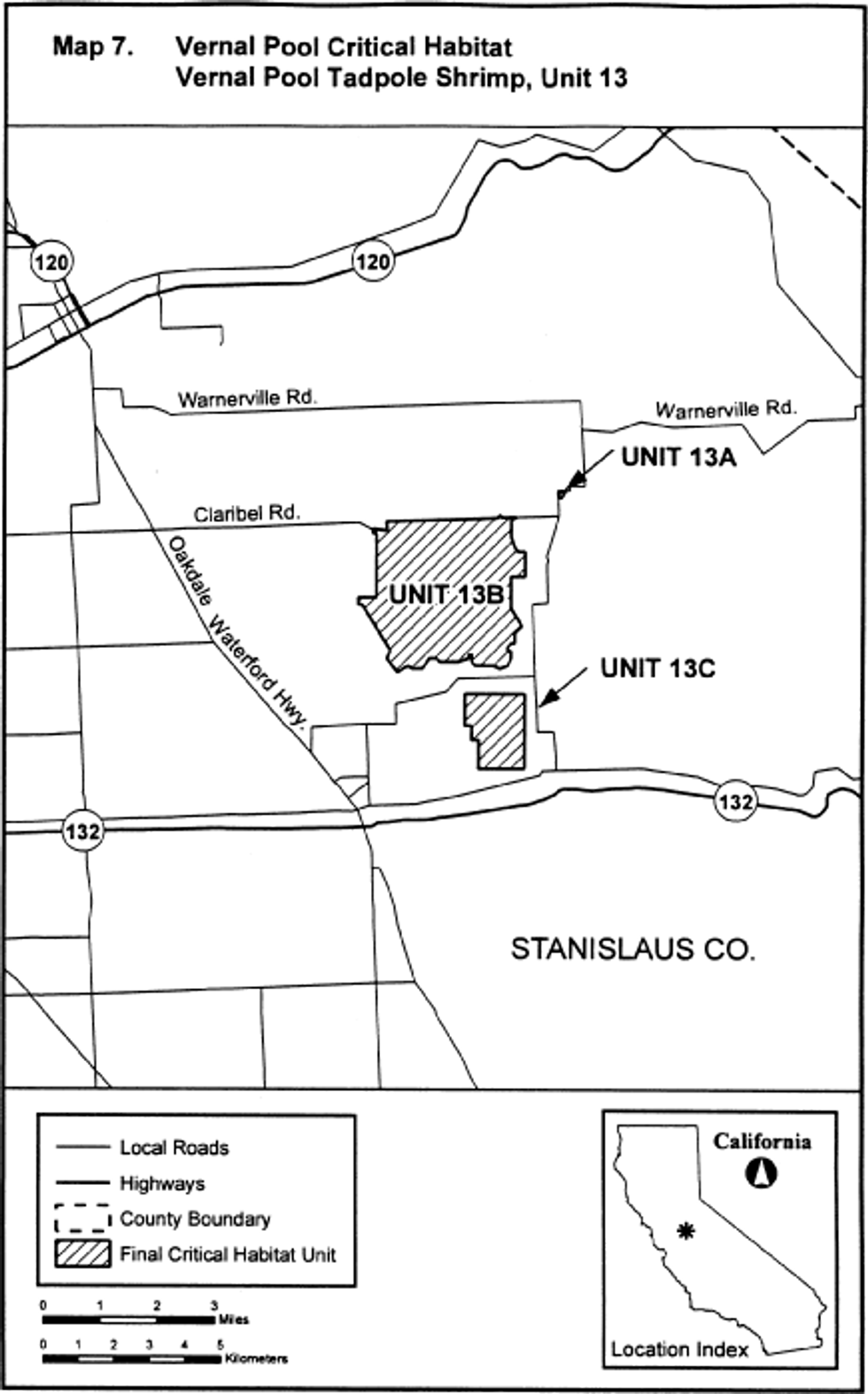
(16) Unit 14: Alameda County, California.
(i) [Reserved]
(ii) Unit 14 (Map 8) follows:
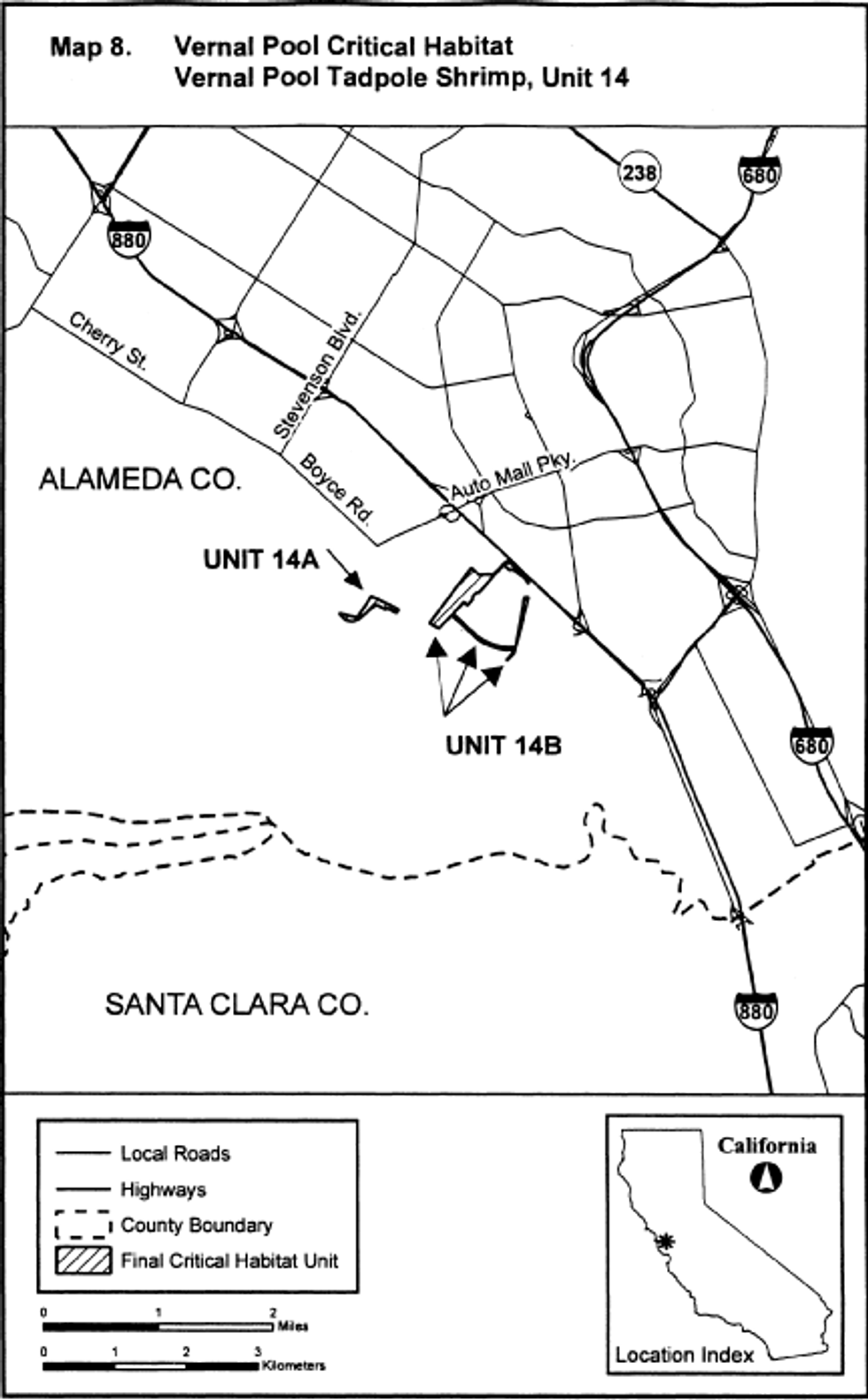
(17) Unit 15: Merced, Madera, and Mariposa Counties, California. Unit 15 excludes land bounded by the following UTM Zone 10, NAD 83 coordinates (E,N): 757175, 4117475; 757117, 4117435; 757138, 4117438; 757146, 4117439; 757245, 4117516; 757255, 4117530; returning to 757175, 4117475. Map of Unit 15 is provided at paragraph (18) of this entry.
(18) Unit 15 (Map 9) follows:
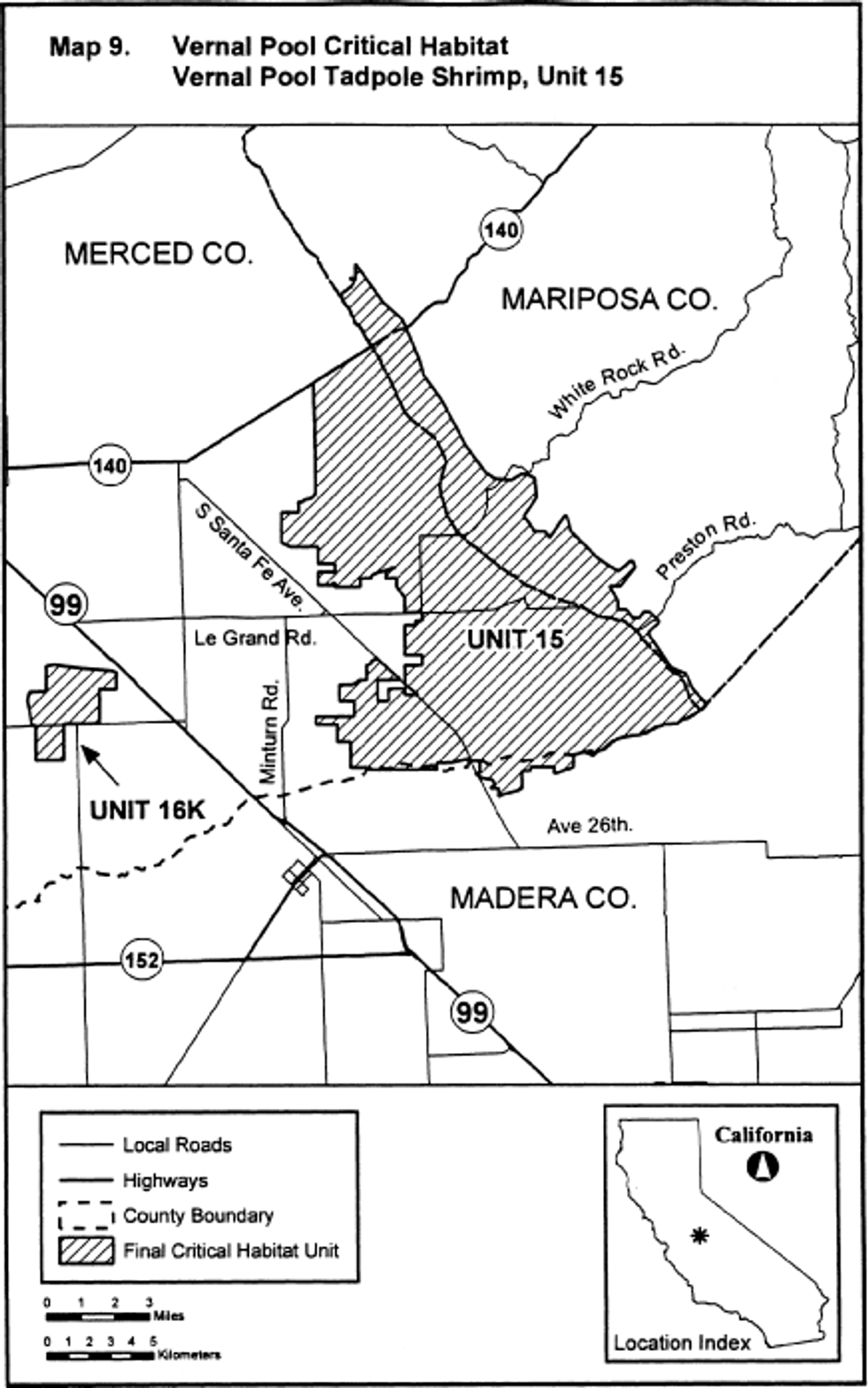
(19) Unit 16: Merced County, California.
(i) [Reserved]
(ii) Unit 16 (Map 10) follows:
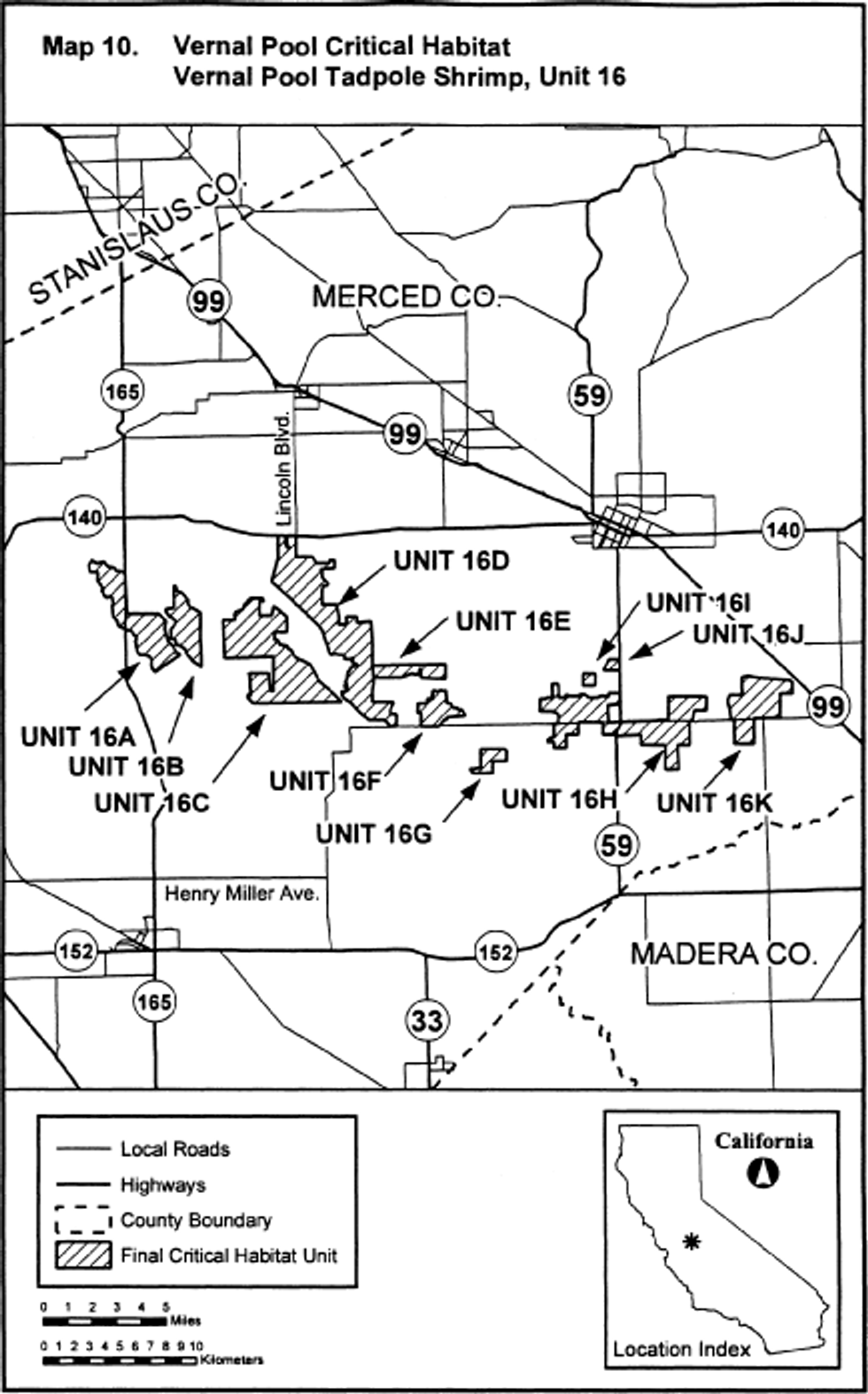
(20) Unit 17: Fresno County, California. Map of Unit 17 is provided at paragraph (21) of this entry.
(21) Unit 17 (Map 11) follows:
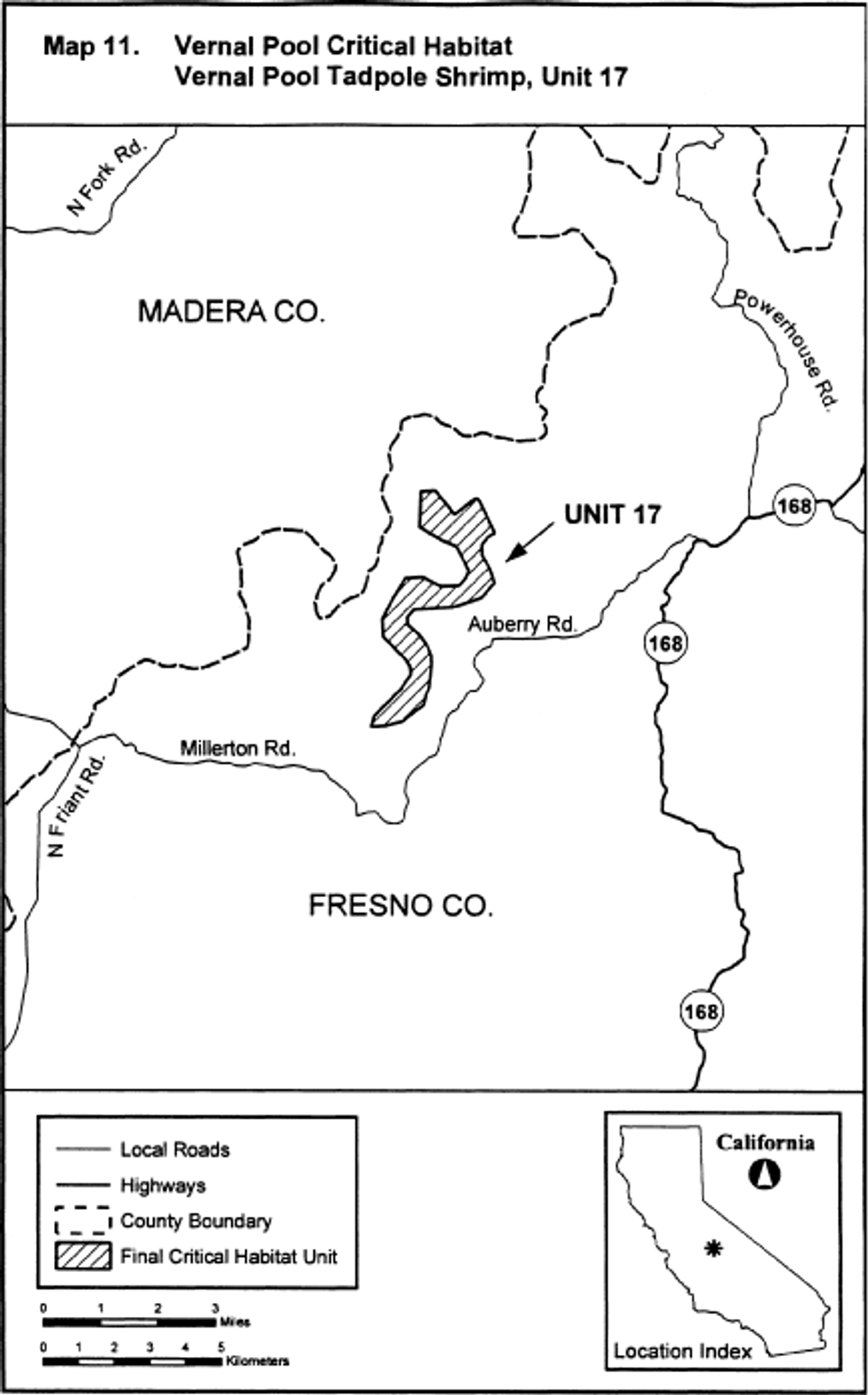
(22) Unit 18: Tulare and Kings Counties, California.
(i) [Reserved]
(ii) Unit 18 (Map 12) follows:
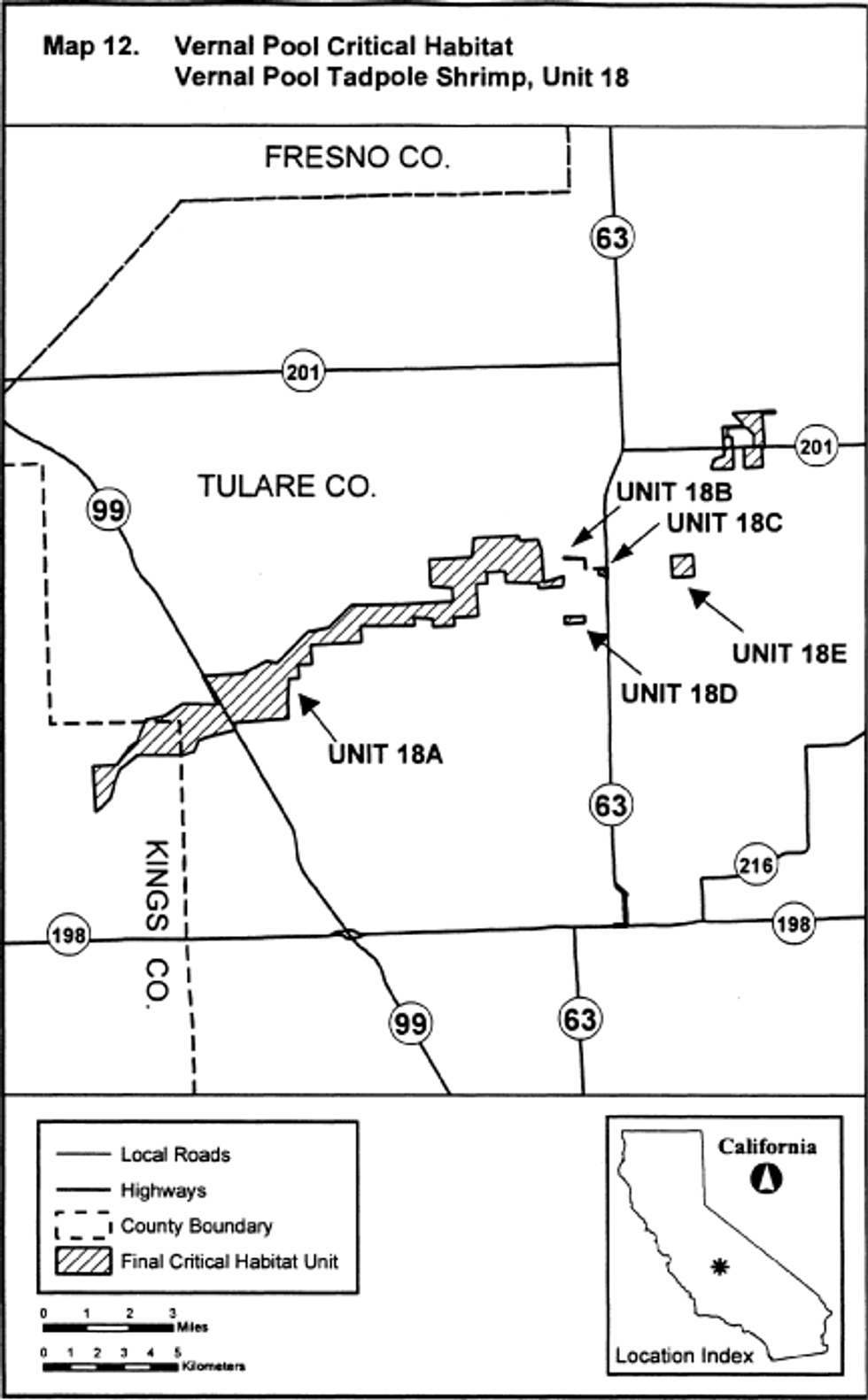
(i) Insects.
Casey's June Beetle (Dinacoma caseyi)
(1) The critical habitat unit is depicted for Riverside County in California on the map below.
(2) Within this area, the primary constituent elements of critical habitat for Casey's June beetle are the habitat components that provide:
(i) Soils of the Carsitas (CdC) gravelly sand and Riverwash (RA) series, or inclusions of Carsitas cobbly sand (ChC) series soils, or inclusions of Myoma fine sands (MaB) or Coachella fine sands (CpA) within CdC soils, at or below 620 ft (189 m) in elevation, associated with washes and alluvial fans deposited on 0 to 9 percent slopes to provide space for population growth and reproduction, moisture, and food sources; and
(ii) Predominantly native desert vegetation, to provide shelter from traffic-related mortality and food for the species.
(3) Critical habitat does not include lands covered by manmade structures, such as buildings, aqueducts, airports, and roads, existing on the effective date of this rule and not containing one or more of the primary constituent elements.
(4) Critical habitat map unit. Data layers defining the map unit were created on a base of USGS 7.5′ quadrangles, and the critical habitat unit was then mapped using Universal Transverse Mercator (UTM) coordinates zone 11, North American Datum (NAD) 1983 coordinates.
(5) Map of critical habitat for Casey's June beetle follows:
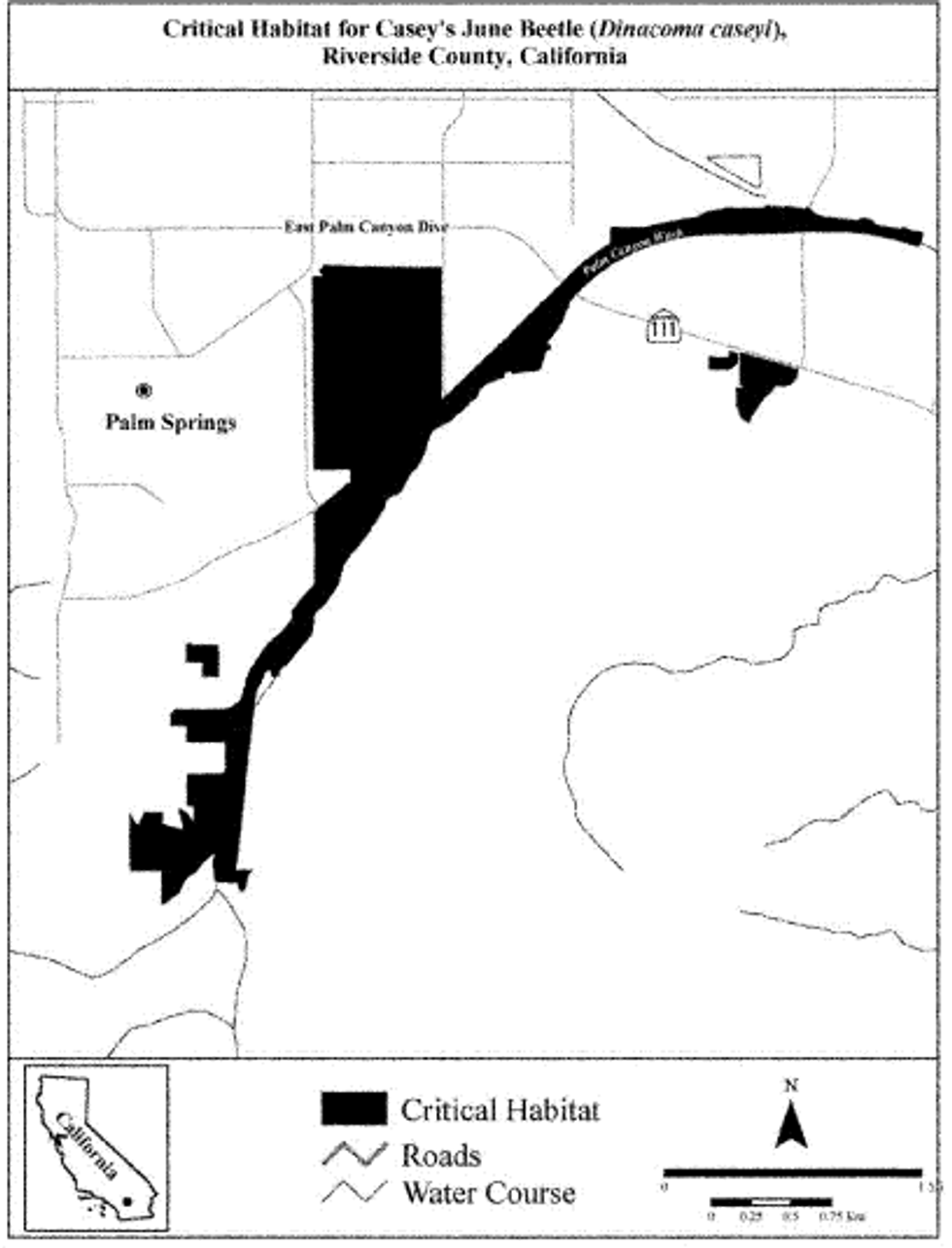
Comal Springs dryopid beetle (Stygoparnus comalensis)
(1) Critical habitat units are depicted for this species in Comal and Hays Counties, Texas, on the maps below.
(2) Within these areas, the primary constituent elements of the physical or biological features essential to the Comal Springs dryopid beetle consist of these components:
(i) Springs, associated streams, and underground spaces immediately inside of or adjacent to springs, seeps, and upwellings that include:
(A) High-quality water with no or minimal pollutant levels of soaps, detergents, heavy metals, pesticides, fertilizer nutrients, petroleum hydrocarbons, and semivolatile compounds such as industrial cleaning agents; and
(B) Hydrologic regimes similar to the historical pattern of the specific sites, with continuous surface flow from the spring sites and in the subterranean aquifer;
(ii) Spring system water temperatures that range from approximately 68 to 75°F (20 to 24°C); and
(iii) Food supply that includes, but is not limited to, detritus (decomposed materials), leaf litter, living plant material, algae, fungi, bacteria, other microorganisms, and decaying roots.
(3) Critical habitat does not include manmade structures (such as buildings, aqueducts, runways, roads, and other paved areas) and the land on which they are located existing on the surface within the legal boundaries on November 22, 2013.
(4) Critical habitat map units. Data layers defining map units were created using geographic information systems (GIS), which included species locations, roads, property boundaries, 2011 aerial photography, and USGS 7.5′ quadrangles. Points were placed in the GIS. The maps in this entry, as modified by any accompanying regulatory text, establish the boundaries of the critical habitat designation. The coordinates or plot points or both on which each map is based are available to the public at the Service's Internet site at http://www.fws.gov/southwest/es/austintexas/, at http://www.regulations.gov at Docket No. FWS-R2-ES-2012-0082, and at the field office responsible for this critical habitat designation. You may obtain field office location information by contacting one of the Service regional offices, the addresses of which are listed at 50 CFR 2.2.
(5) The index map of the critical habitat units for the Comal Springs dryopid beetle follows:
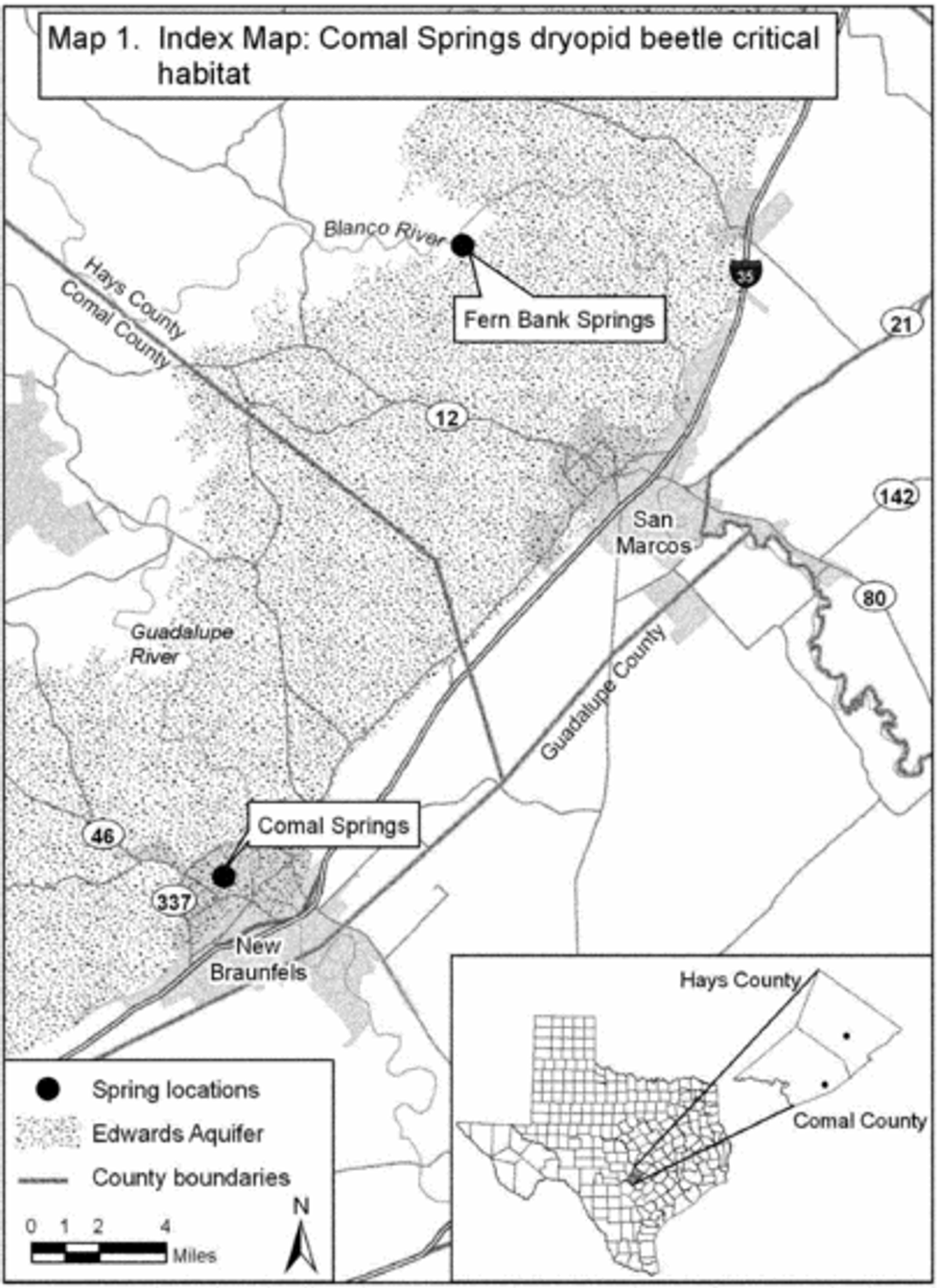
(6) Unit 1: Comal Springs Unit, Comal County, Texas. Map of the Comal Springs Unit follows:
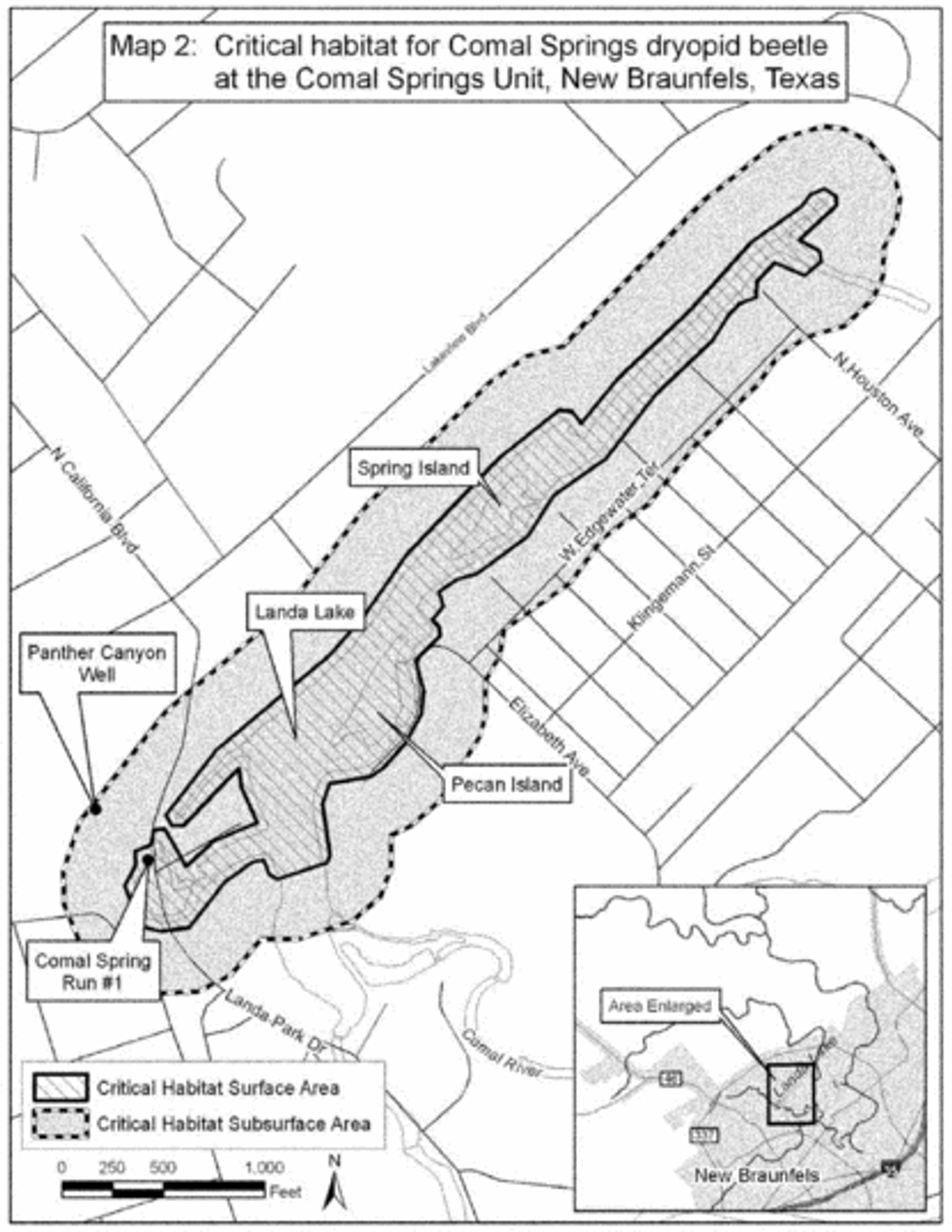
(7) Unit 2: Fern Bank Springs Unit, Hays County, Texas. Map of the Fern Bank Springs Unit follows:
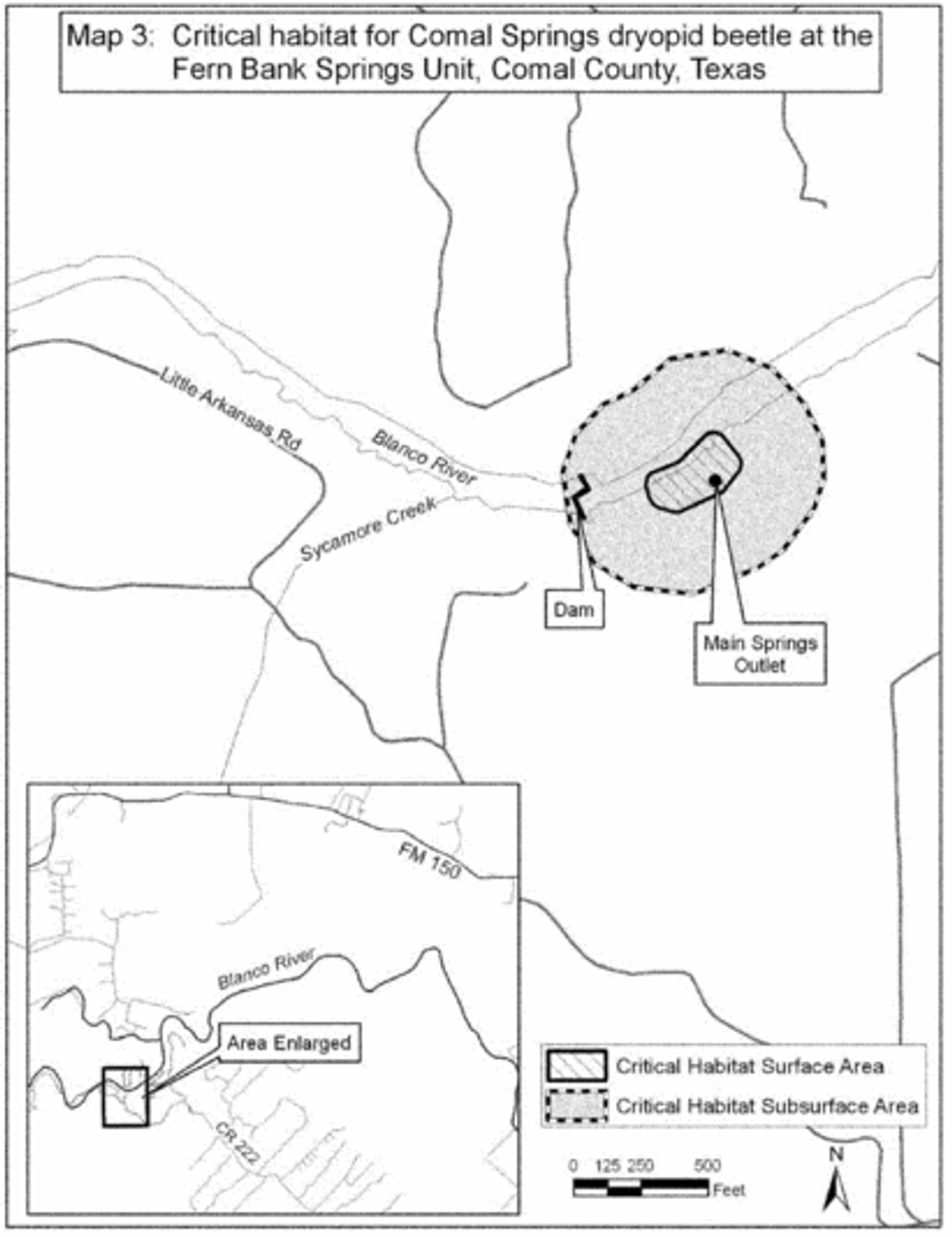
Comal Springs riffle beetle (Heterelmis comalensis)
(1) Critical habitat units are depicted for this species in Comal and Hays Counties, Texas, on the maps below.
(2) Within these areas, the primary constituent elements of the physical or biological features essential to the Comal Springs riffle beetle consist of these components:
(i) Springs, associated streams, and underground spaces immediately inside of or adjacent to springs, seeps, and upwellings that include:
(A) High-quality water with no or minimal pollutant levels of soaps, detergents, heavy metals, pesticides, fertilizer nutrients, petroleum hydrocarbons, and semivolatile compounds such as industrial cleaning agents; and
(B) Hydrologic regimes similar to the historical pattern of the specific sites, with continuous surface flow from the spring sites and in the subterranean aquifer;
(ii) Spring system water temperatures that range from approximately 68 to 75°F (20 to 24°C); and
(iii) Food supply that includes, but is not limited to, detritus (decomposed materials), leaf litter, living plant material, algae, fungi, bacteria, other microorganisms, and decaying roots.
(3) Critical habitat does not include manmade structures (such as buildings, aqueducts, runways, roads, and other paved areas) and the land on which they are located existing on the surface within the legal boundaries on November 22, 2013.
(4) Critical habitat map units. Data layers defining map units were created using geographic information systems (GIS), which included species locations, roads, property boundaries, 2011 aerial photography, and USGS 7.5′ quadrangles. Points were placed on the GIS. The maps in this entry, as modified by any accompanying regulatory text, establish the boundaries of the critical habitat designation. The coordinates or plot points or both on which each map is based are available to the public at the Service's Internet site at http://www.fws.gov/southwest/es/austintexas/, at http://www.regulations.gov at Docket No. FWS-R2-ES-2012-0082, and at the field office responsible for this critical habitat designation. You may obtain field office location information by contacting one of the Service regional offices, the addresses of which are listed at 50 CFR 2.2.
(5) The index map of critical habitat units for the Comal Springs riffle beetle follows:
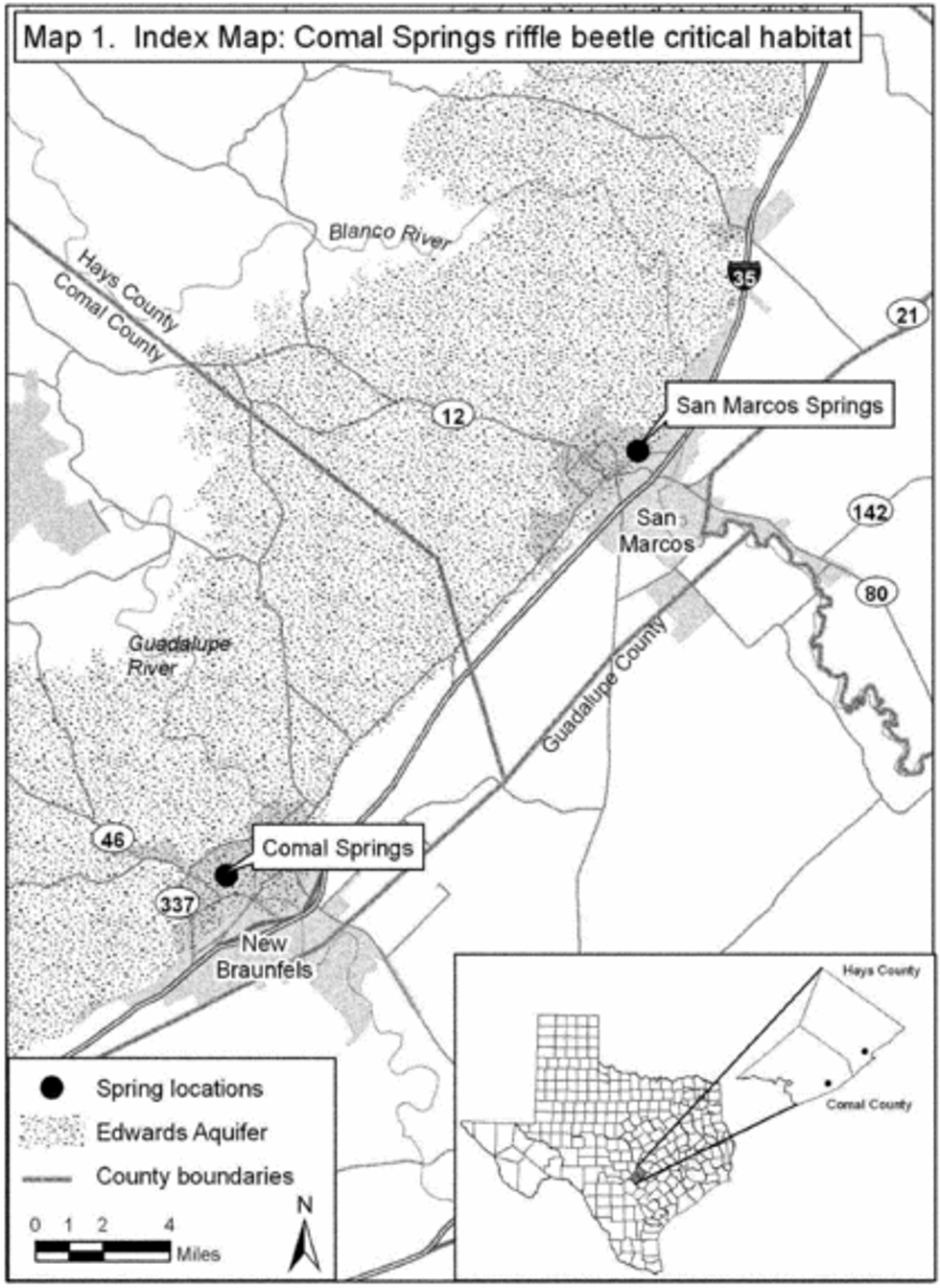
(6) Unit 1: Comal Springs Unit, Comal County, Texas. Map of the Comal Springs Unit follows:
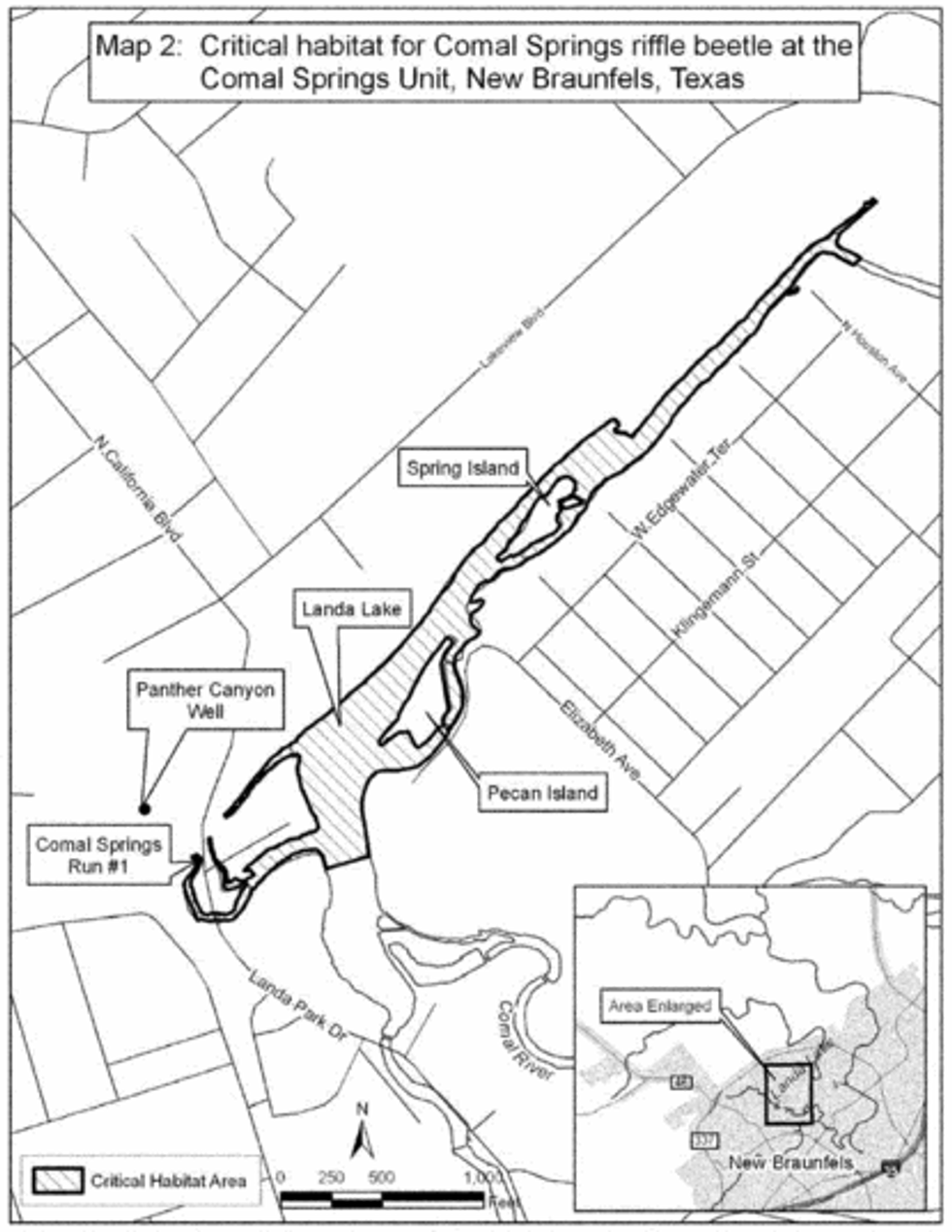
(7) Unit 2: San Marcos Springs Unit, Hays County, Texas. Map of the San Marcos Springs Unit follows:
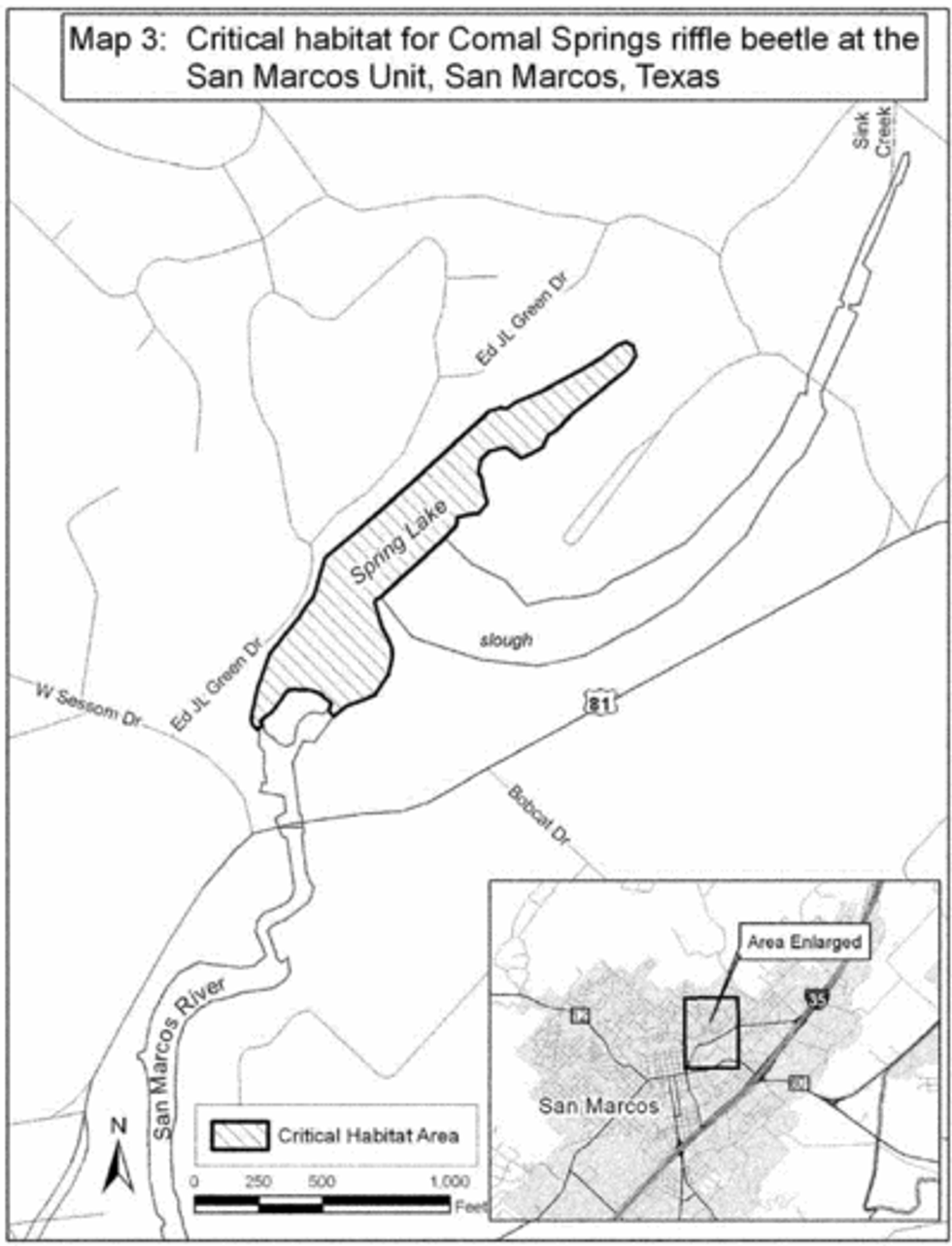
Delta Green Ground Beetle (Elaphrus viridis)
California. Solano County. T.5N. R.1E. West 1/2 Sec. 12, southwest 1/4 Sec. 13, southeast 1/4 Sec. 14, northeast 1/4 Sec. 23, northwest 1/4 Sec. 24.
Note:
The map provided is for informational purposes only. Map follows:
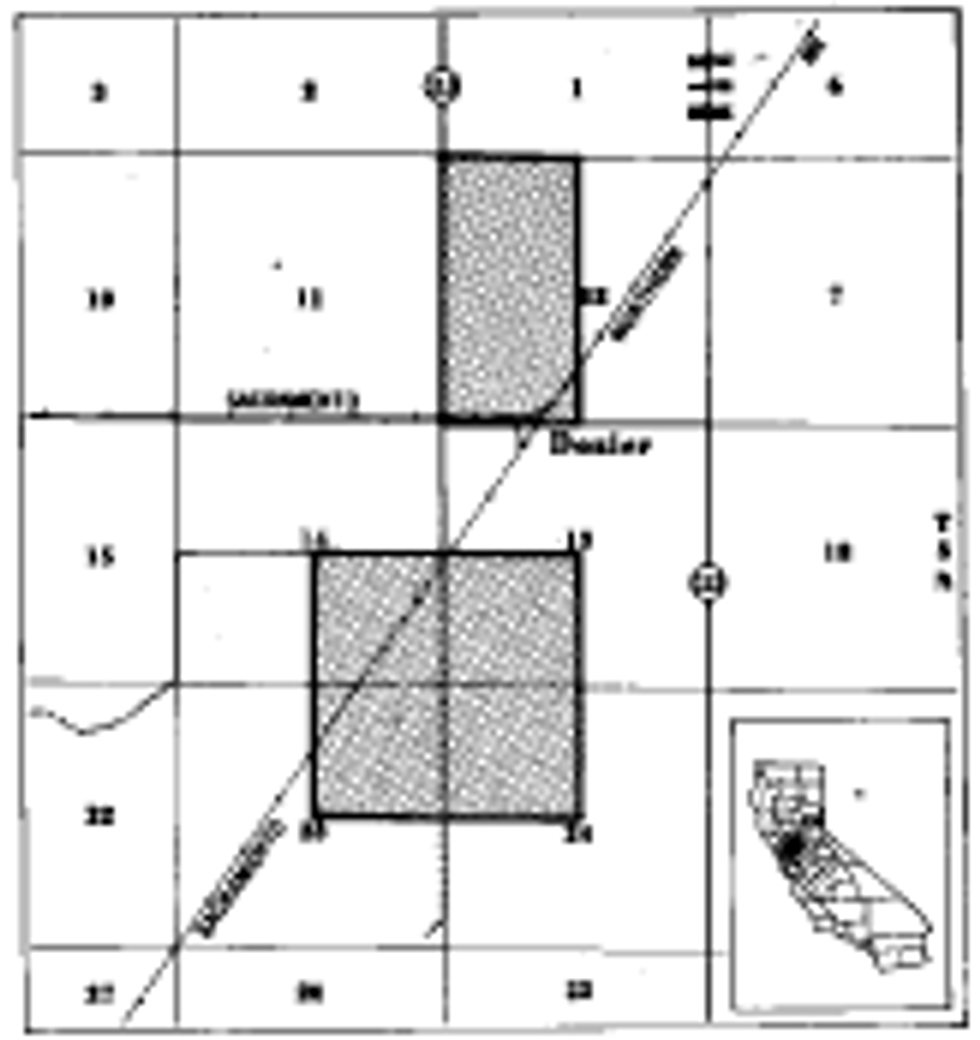
Helotes Mold Beetle (Batrisodes venyivi)
(1) Critical habitat for the Helotes mold beetle in Bexar County, Texas, occurs in Units 1e, 3, and 5 as described in this entry and depicted on Maps 1 (index map), 2, 4, and 5 of this entry.
(2) The primary constituent elements of critical habitat for Batrisodes venyivi are:
(i) Karst-forming rock containing subterranean spaces (caves and connected mesocaverns) with stable temperatures, high humidities (near saturation), and suitable substrates (for example, spaces between and underneath rocks for foraging and sheltering) that are free of contaminants; and
(ii) Surface and subsurface sources (such as plants and their roots, fruits, and leaves, and animal (e.g., cave cricket) eggs, feces, and carcasses) that provide nutrient input into the karst ecosystem.
(3) Developed lands that do not contain the subsurface primary constituent elements (see paragraph (2)(i) of this entry) and that existed on the effective date of this rule are not considered to be critical habitat.
(4) Data layers defining this map unit were created using a geographic information system (GIS), which included cave locations, karst zone maps, roads, property boundaries, 2010 aerial photography, and USGS 7.5′ quadrangles. Points were placed on the GIS.
(5) Index map of Bexar County invertebrates critical habitat units, Bexar County, Texas, follows:
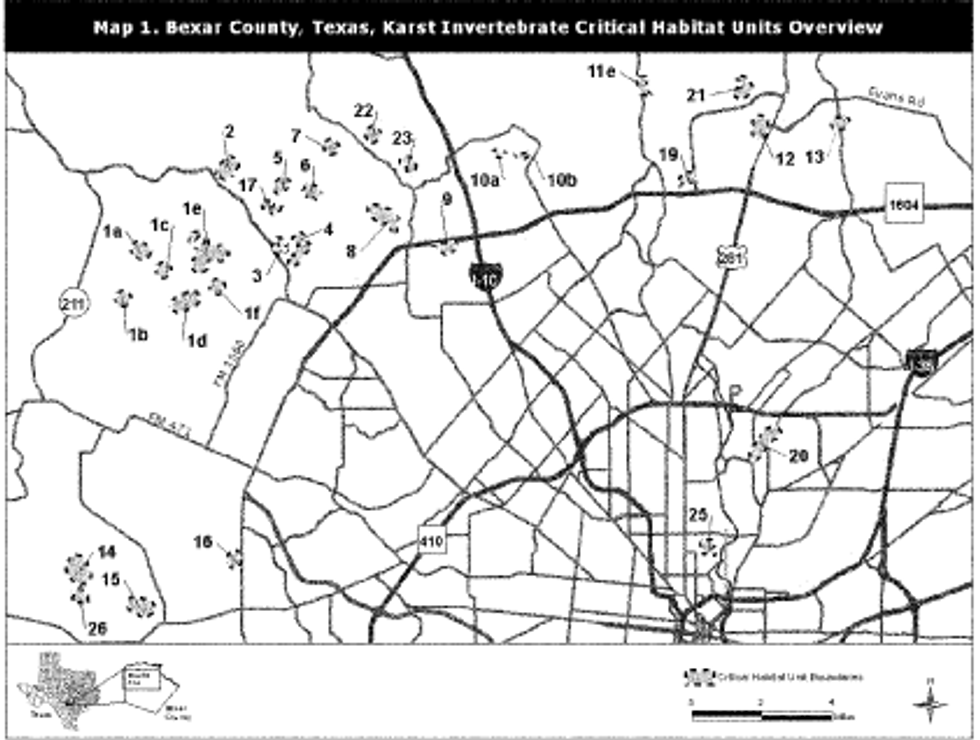
(6) Unit 1e: Bexar County, Texas.
(i) [Reserved]
(ii) Map 2 of Units 1a, 1b, 1c, 1d, 1e, and 1f follows:
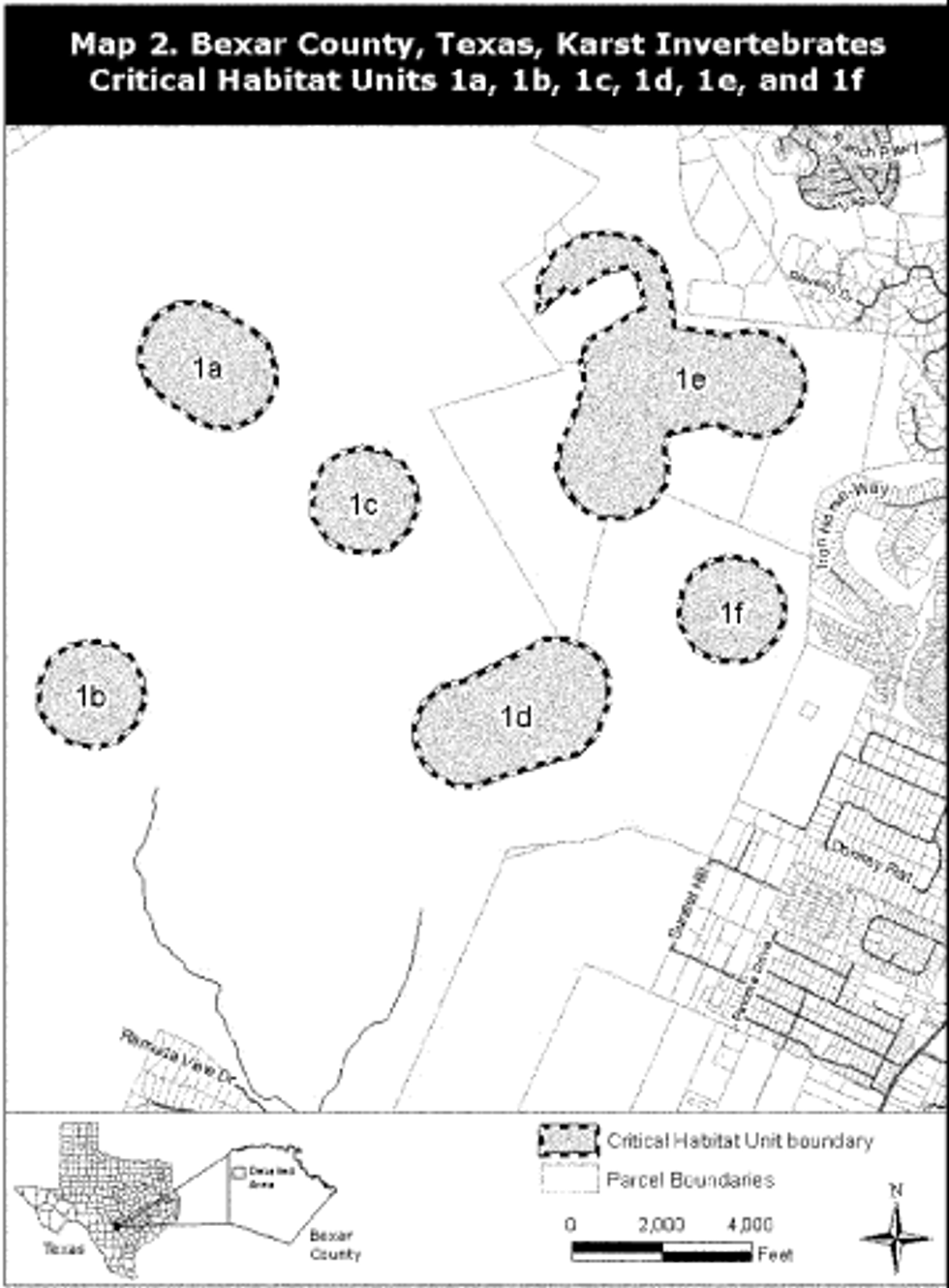
(7) Unit 3: Bexar County, Texas.
(i)[Reserved]
(ii) Map 4 of Units 3 and 4 follows:
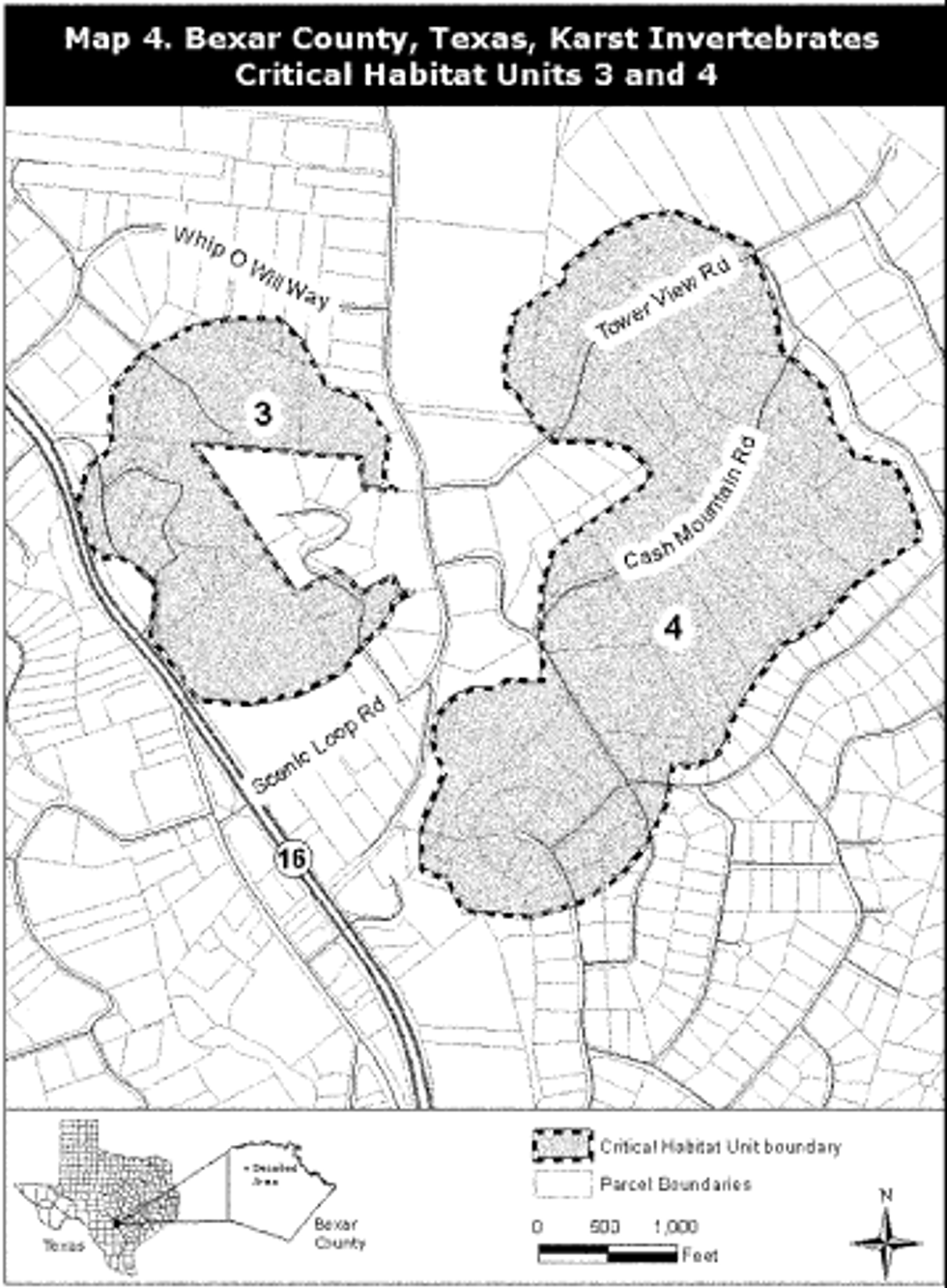
(8) Unit 5: Bexar County, Texas.
(i) [Reserved]
(ii) Map 5 of Units 5, 6, and 17 follows:
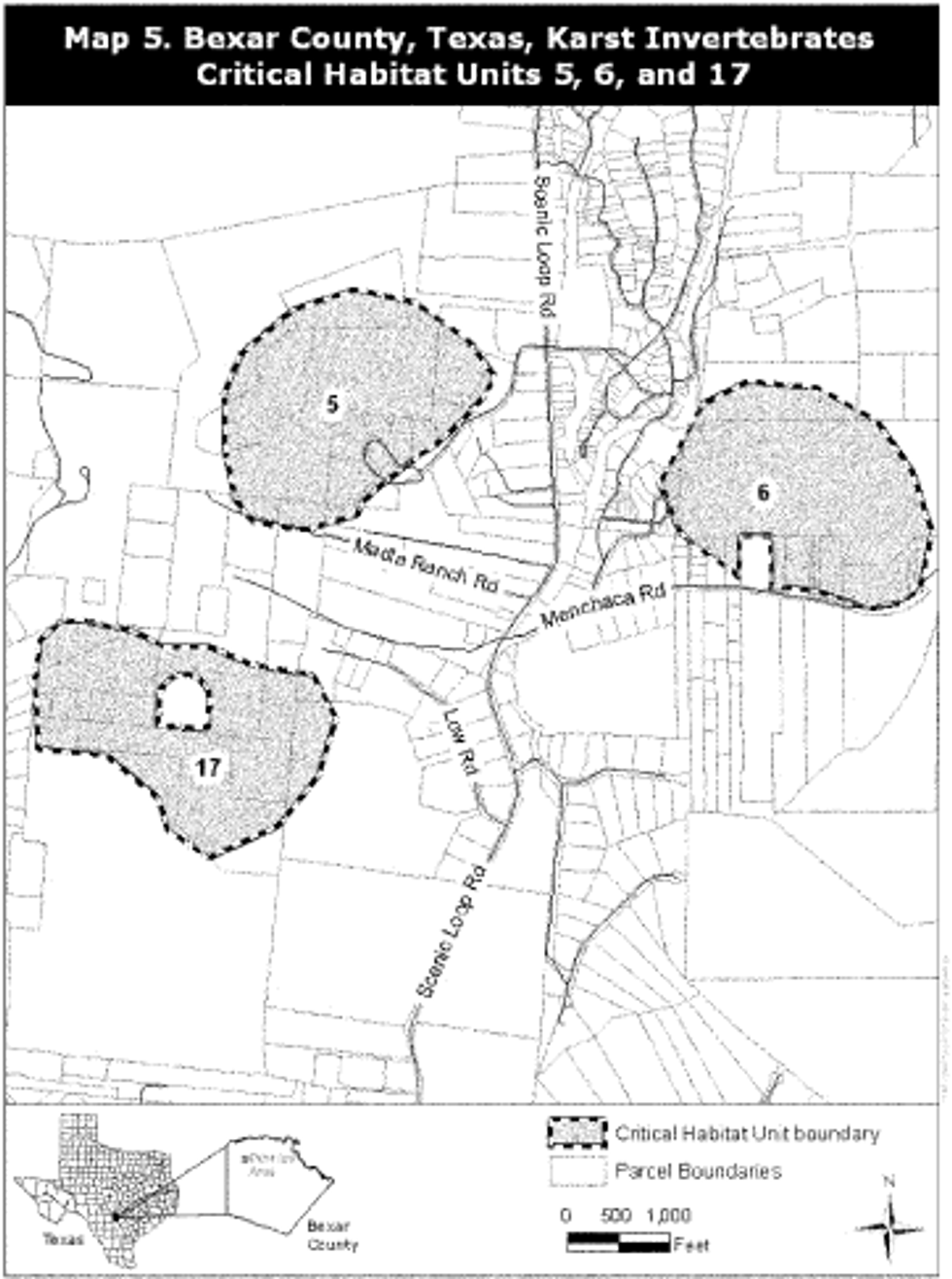
Miami tiger beetle (Cicindelidia floridana)
(1) Critical habitat units are depicted for Miami-Dade County, Florida, on the maps in this entry.
(2) Within these areas, the physical or biological features essential to the conservation of the Miami tiger beetle consist of the following components:
(i) South Florida pine rockland habitat of at least 2.5 acres (1 hectare) in size that is maintained by natural or prescribed fire or other disturbance regimes; and
(ii) Open sandy areas within or directly adjacent to the south Florida pine rockland habitat described in paragraph (2)(i) of this entry. These areas have little to no vegetation to allow for normal behavior and growth, such as thermoregulation, foraging, egg-laying, and larval development, and to facilitate habitat connectivity.
(3) Critical habitat does not include manmade structures (such as buildings, aqueducts, runways, roads, other paved areas, and managed lawns) and the land on which they are located existing within the legal boundaries on June 22, 2023.
(4) Data layers defining map units were created using Esri ArcGIS mapping software. The projection used was Albers Conical Equal Area (Florida Geographic Data Library), North American Datum of 1983 (NAD 83) High Accuracy Reference Network (HARN). The maps in this entry, as modified by any accompanying regulatory text, establish the boundaries of the critical habitat designation. The coordinates or plot points or both on which each map is based are available to the public at https://www.regulations.gov at Docket No. FWS–R4–ES–2021–0053, at https://www.fws.gov/office/florida-ecological-services/library, and at the field office responsible for this designation. You may obtain field office location information by contacting one of the Service regional offices, the addresses of which are listed at 50 CFR 2.2.
(5) Index map follows:
Figure 1 to Miami Tiger Beetle (Cicindelidia floridana) paragraph (5)
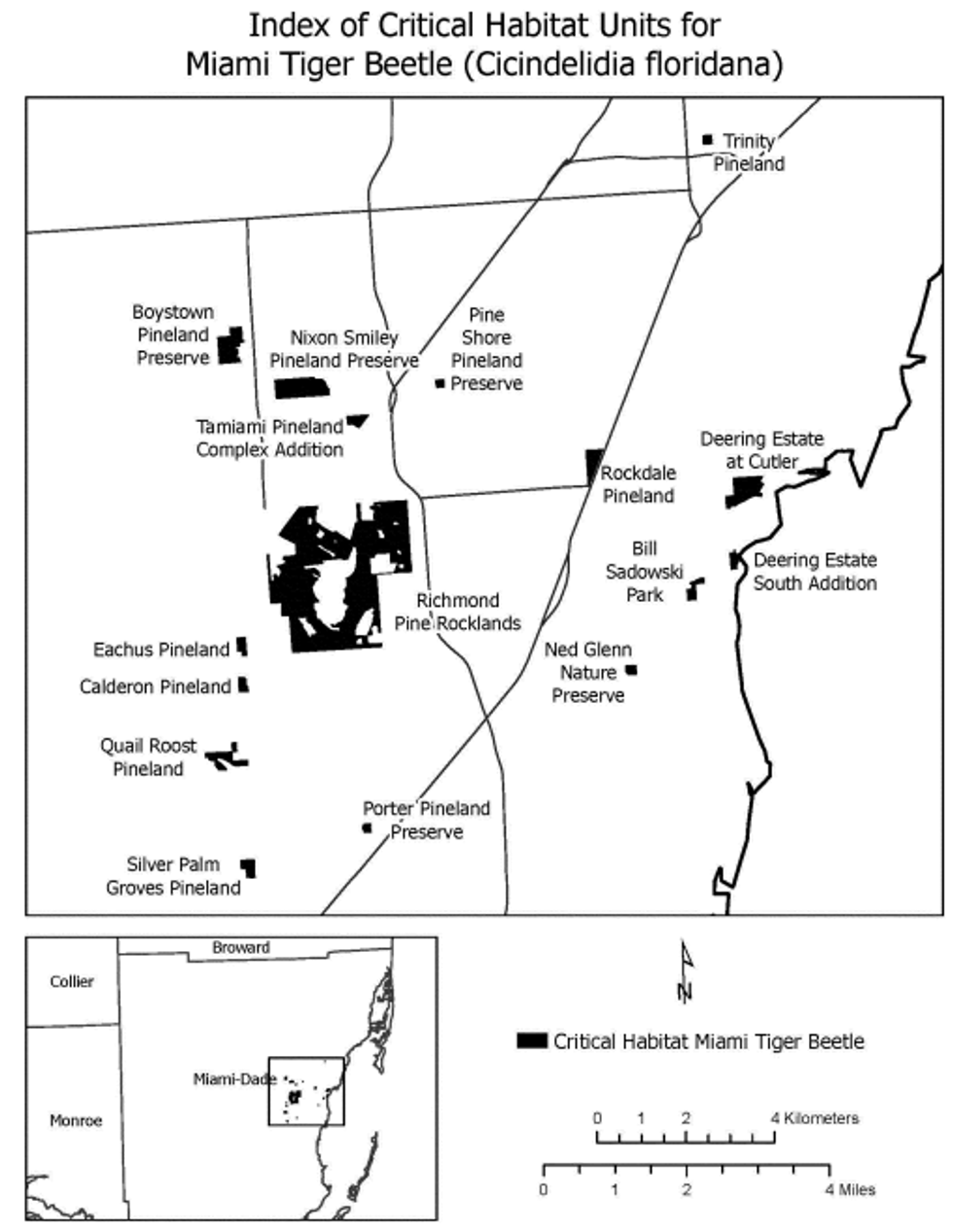
(6) Unit 1: Trinity Pineland, Miami-Dade County, Florida.
(i) Unit 1 consists of approximately 10 acres (ac) (4 hectares (ha)). The unit is located between SW 72nd Street to the north, SW 80th Street to the south, South Dixie Highway to the east, and Palmetto Expressway to the west.
(ii) Map of Unit 1 follows:
Figure 2 to Miami Tiger Beetle (Cicindelidia floridana) paragraph (6)(ii)
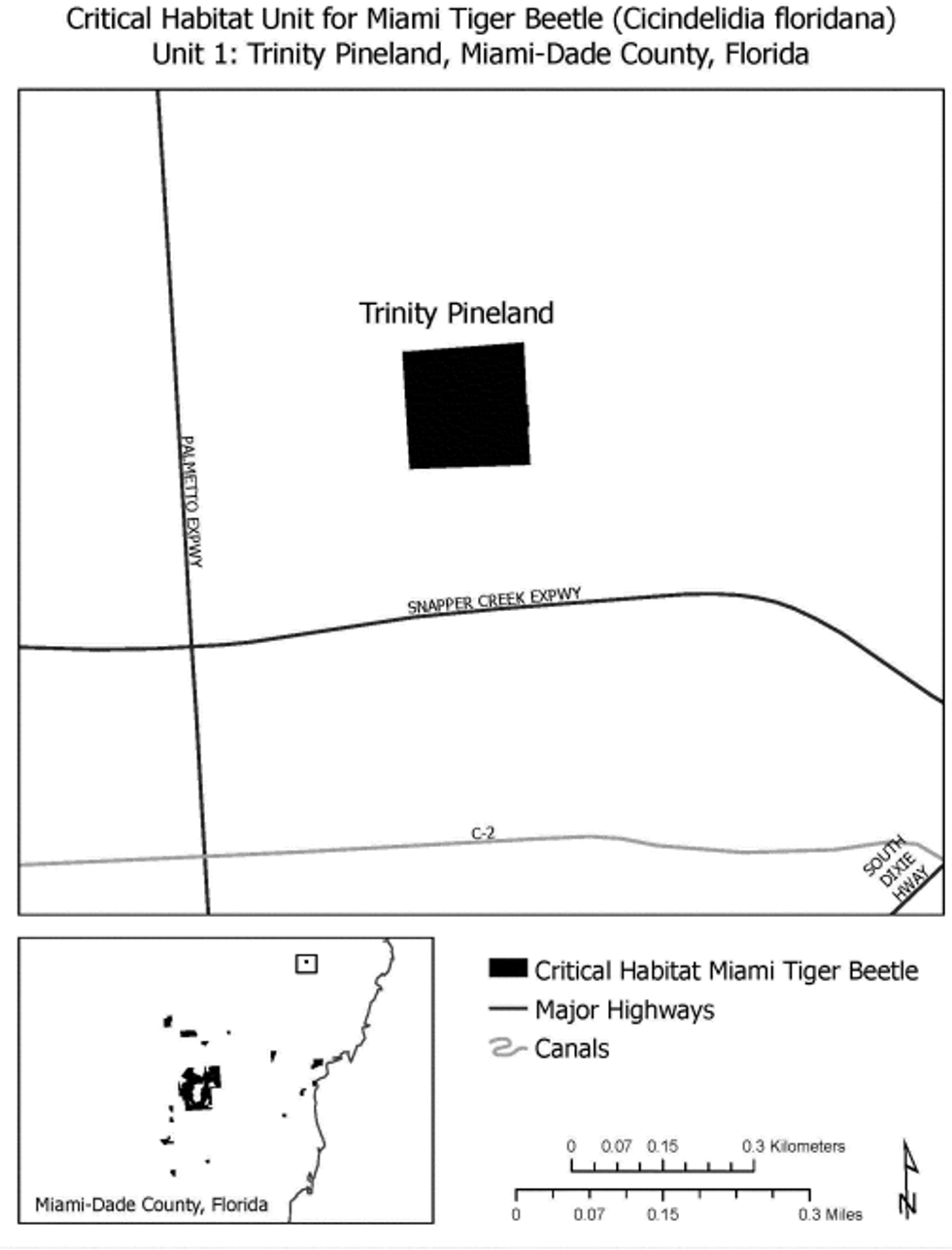
(7) Unit 2: Rockdale Pineland, Miami-Dade County, Florida.
(i) Unit 2 consists of approximately 39 ac (16 ha). The unit is located directly west of South Dixie Highway, between SW 144th Street to the north and SW 152nd Street to the south.
(ii) Map of Unit 2 follows:
Figure 3 to Miami Tiger Beetle (Cicindelidia floridana) paragraph (7)(ii)
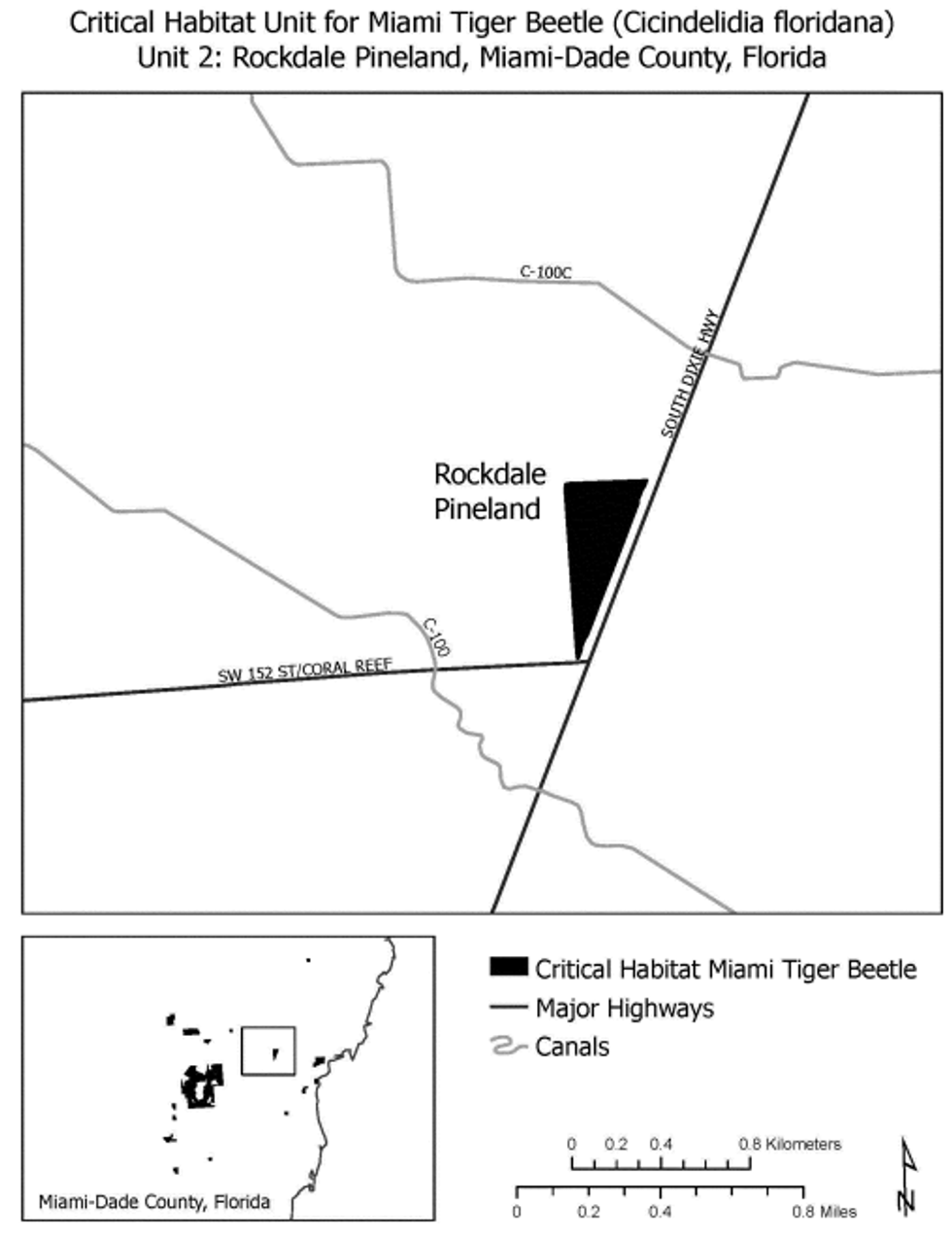
(8) Unit 3: Deering Estate South Addition, Miami-Dade County, Florida.
(i) Unit 3 consists of approximately 16 ac (6 ha). This unit is located just east of Old Cutler Road and south of 168th Street.
(ii) Map of Unit 3 follows:
Figure 4 to Miami Tiger Beetle (Cicindelidia floridana) paragraph (8)(ii)
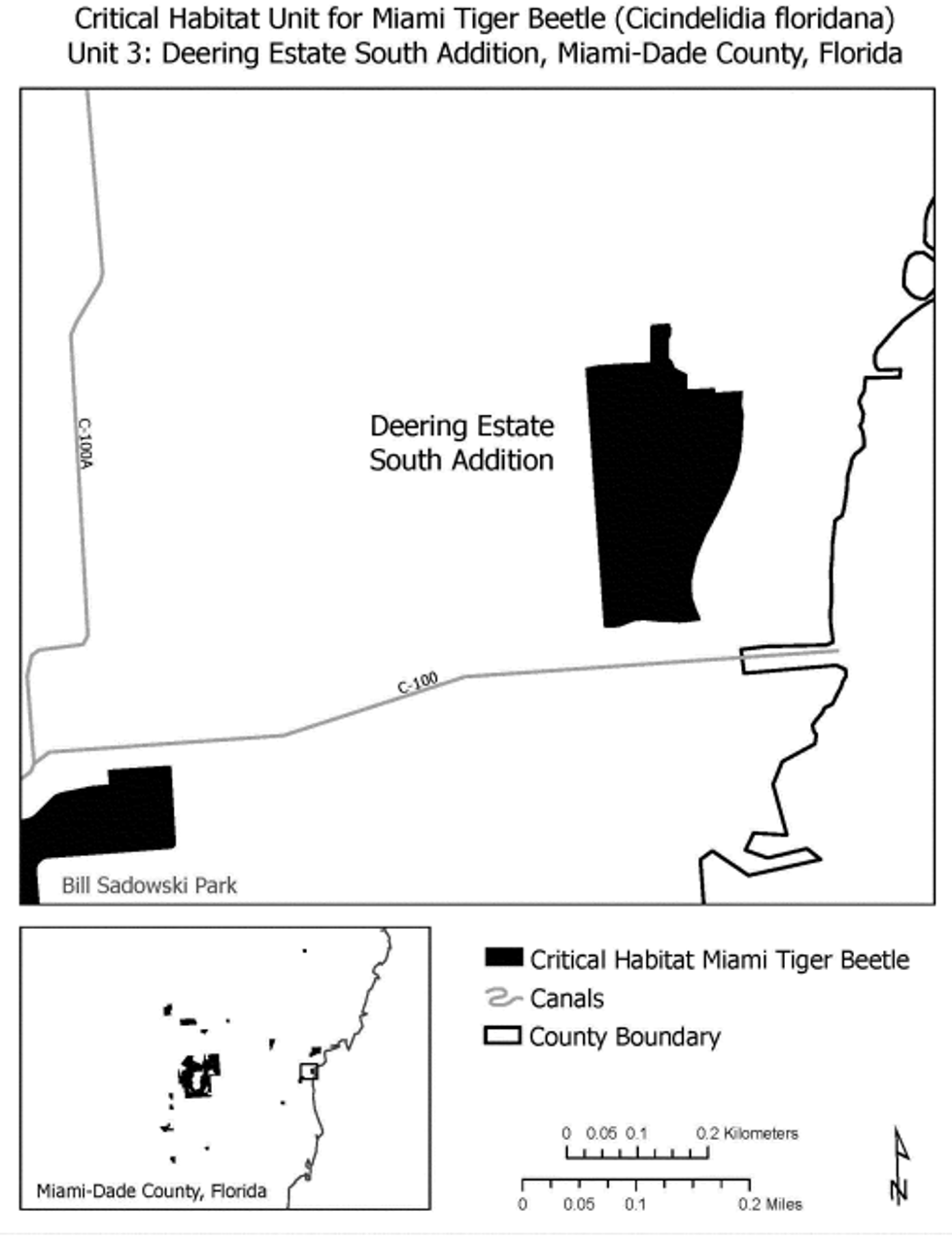
(9) Unit 4: Ned Glenn Nature Preserve, Miami-Dade County, Florida.
(i) Unit 4 consists of approximately 11 ac (5 ha). The unit is located directly west of SW 87th Avenue, between 184th Street to the north, Old Cutler Road to the south, and Franjo Road to the west.
(ii) Map of Unit 4 follows:
Figure 5 to Miami Tiger Beetle (Cicindelidia floridana) paragraph (9)(ii)
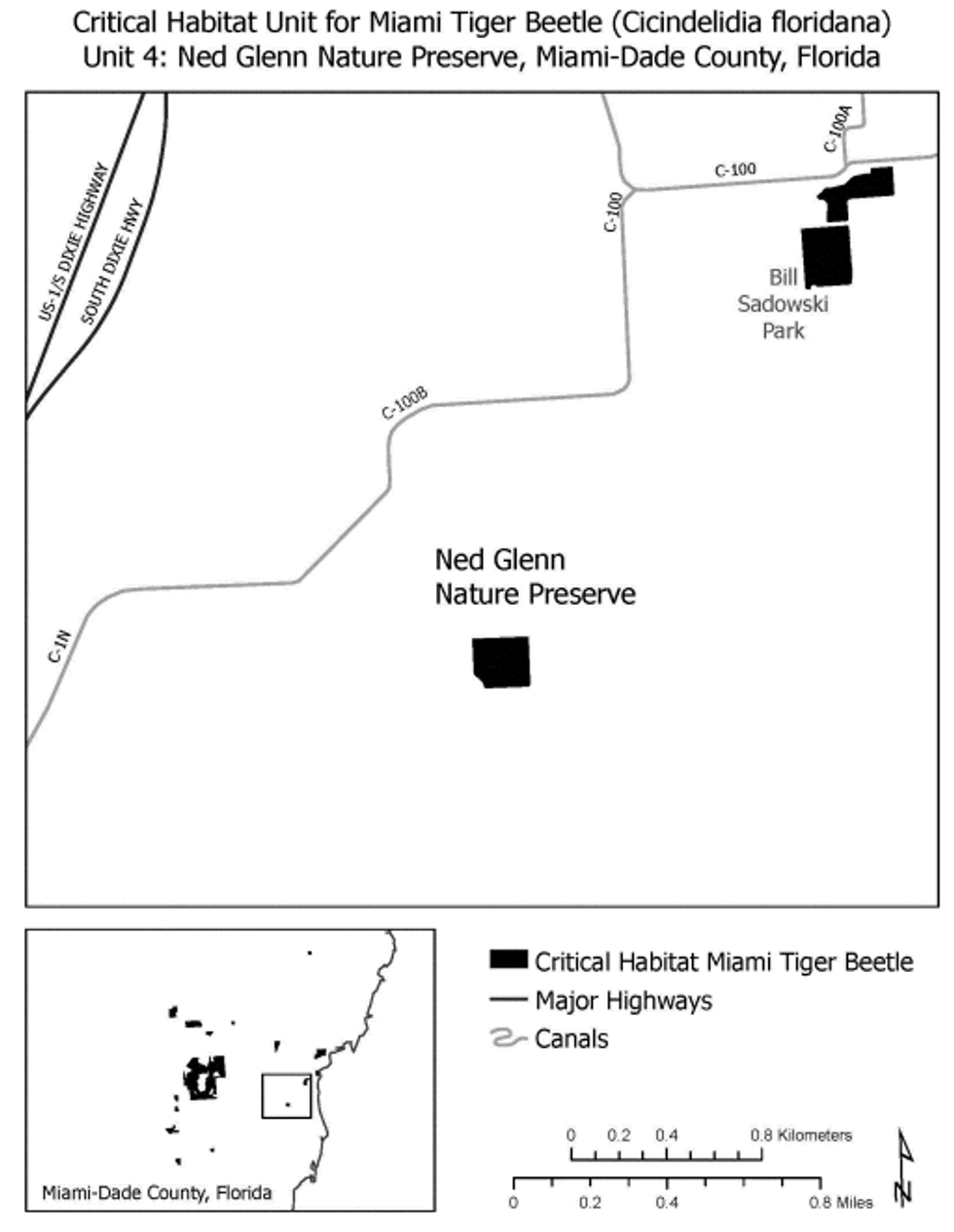
(10) Unit 5: Deering Estate at Cutler, Miami-Dade County, Florida.
(i) Unit 5 consists of approximately 89 ac (36 ha). The unit is located southeast of SW 152nd Street and Old Cutler Road.
(ii) Map of Unit 5 follows:
Figure 6 to Miami Tiger Beetle (Cicindelidia floridana) paragraph (10)(ii)
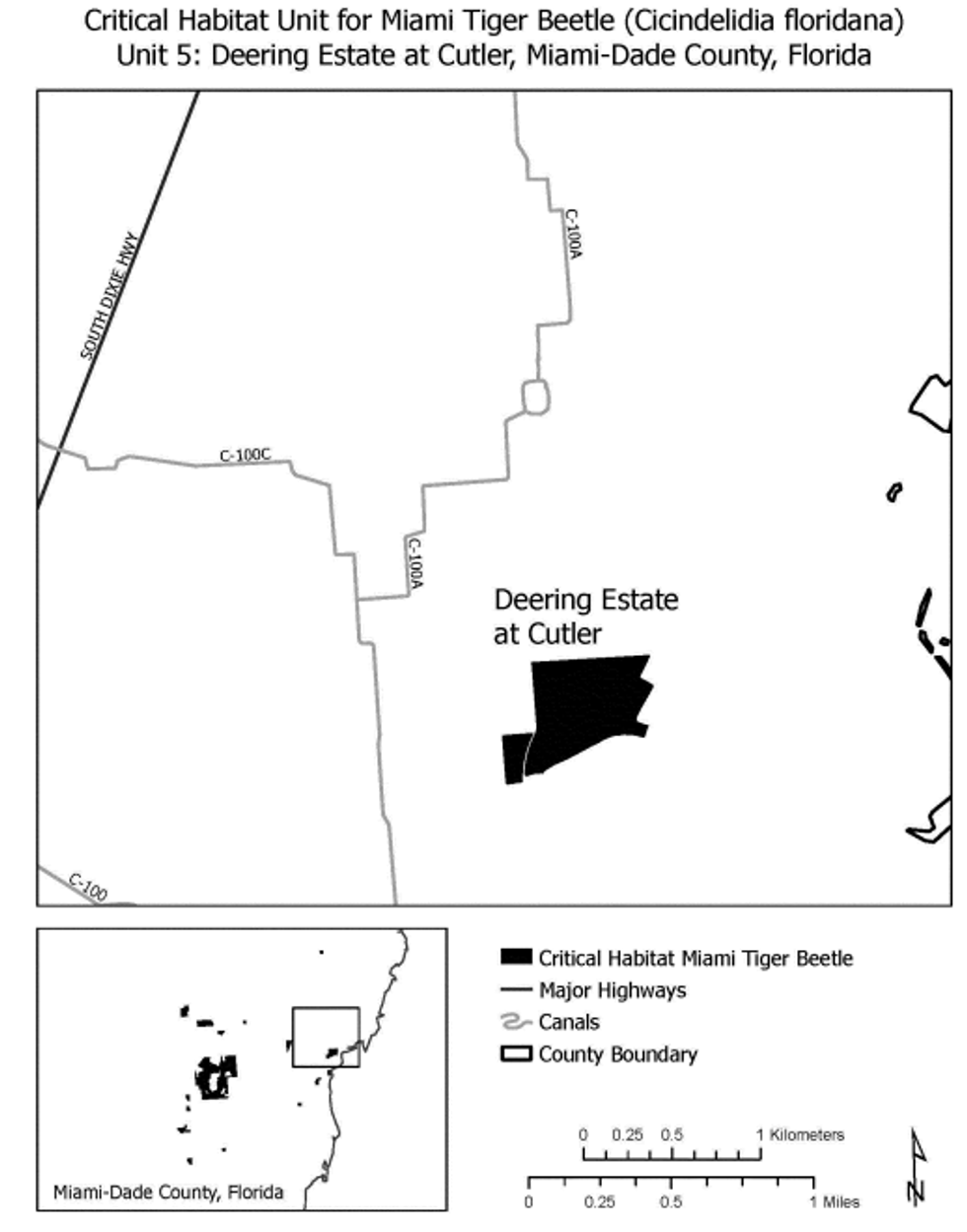
(11) Unit 6: Silver Palm Groves Pineland, Miami-Dade County, Florida.
(i) Unit 6 consists of approximately 25 ac (10 ha). This unit is located just north of SW 232nd Street, between SW 216th Street to the north, South Dixie Highway to the east, and SW 147th Avenue to the west.
(ii) Map of Unit 6 follows:
Figure 7 to Miami Tiger Beetle (Cicindelidia floridana) paragraph (11)(ii)
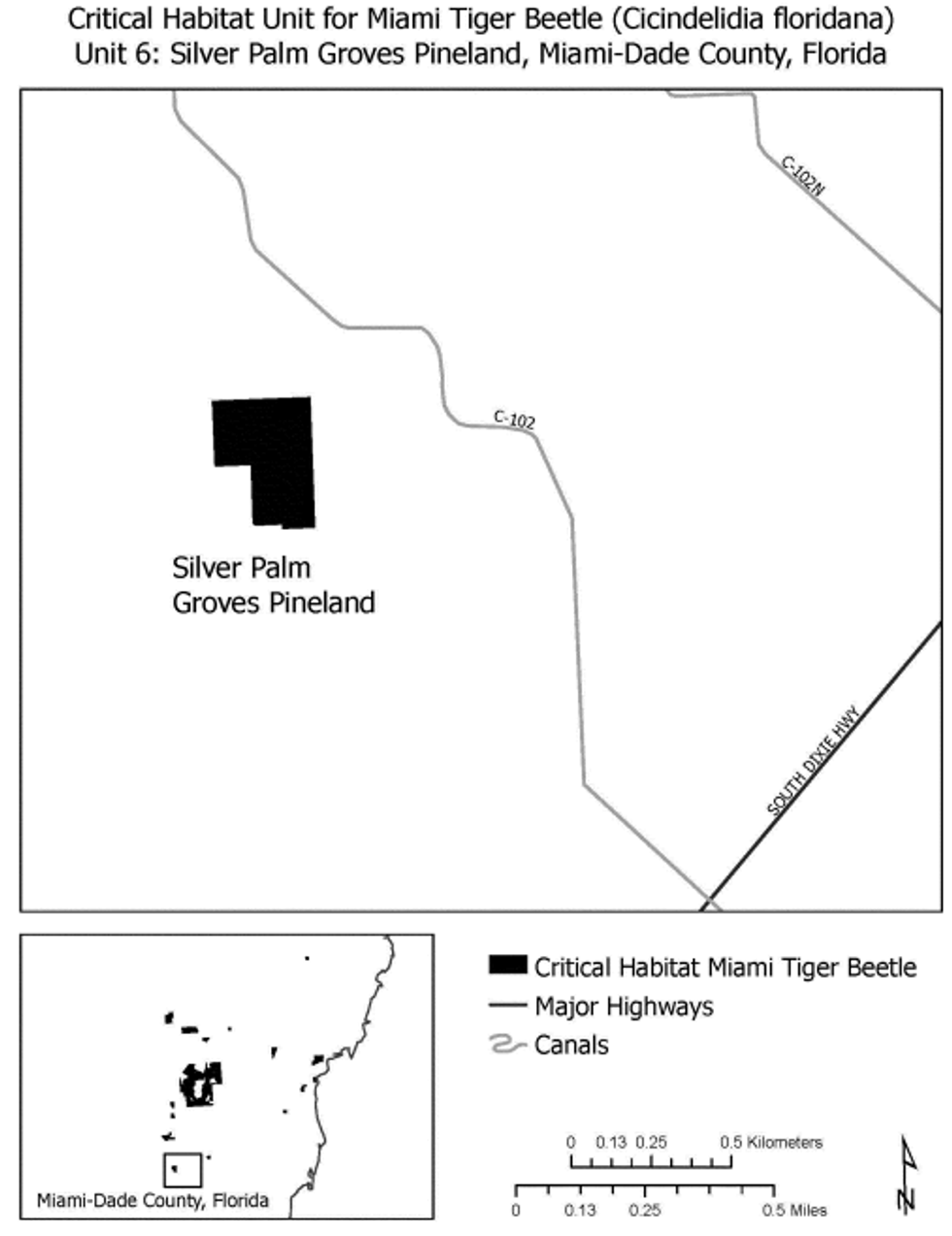
(12) Unit 7: Quail Roost Pineland, Miami-Dade County, Florida.
(i) Unit 7 consists of approximately 48 ac (19 ha). This unit is located between SW 200th Street to the north, SW 127th Avenue to the east, SW 216th Street to the south, and SW 147th Avenue to the west.
(ii) Map of Unit 7 follows:
Figure 8 to Miami Tiger Beetle (Cicindelidia floridana) paragraph (12)(ii)
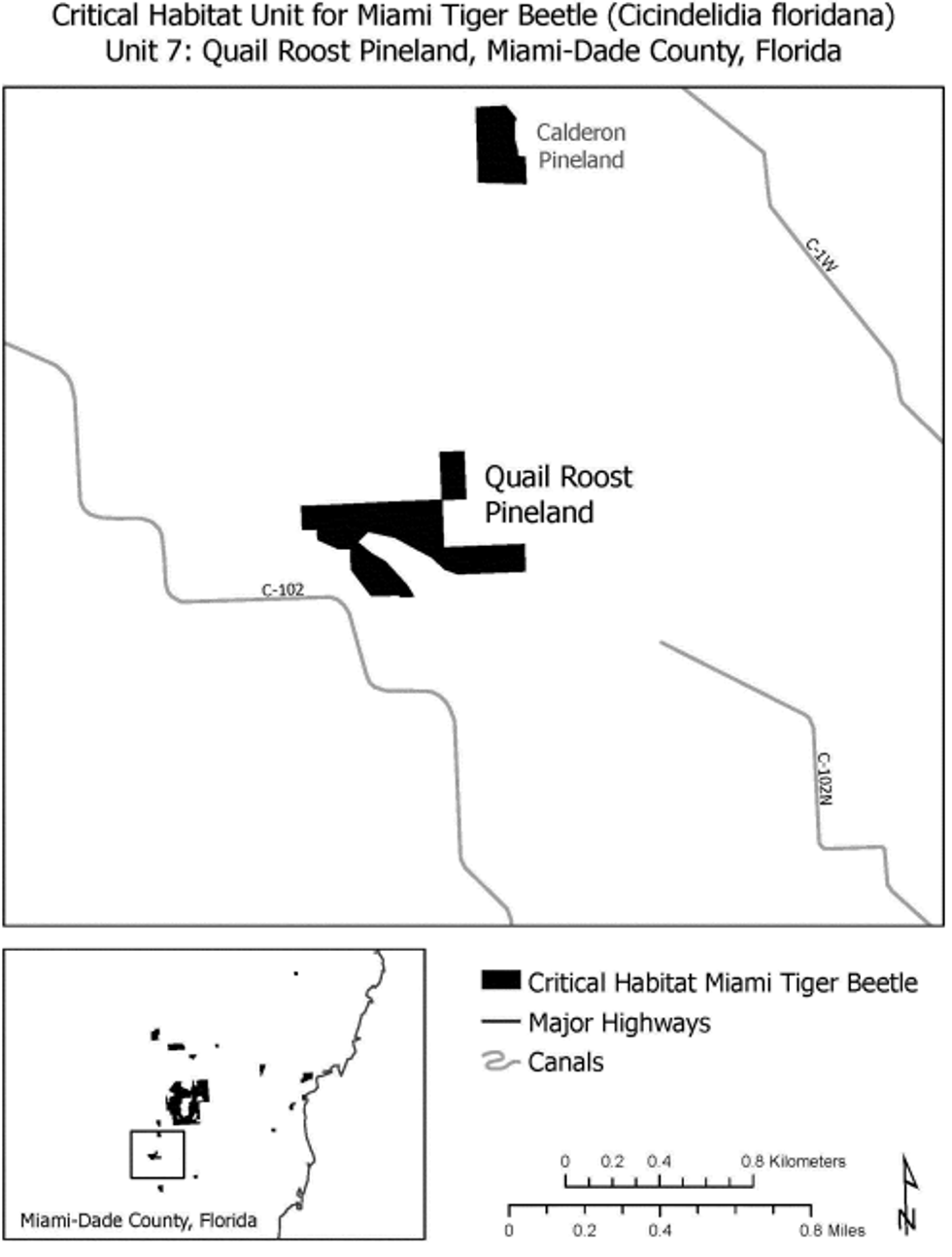
(13) Unit 8: Eachus Pineland, Miami-Dade County, Florida.
(i) Unit 8 consists of approximately 17 ac (7 ha). This unit is located between SW 180th Street to the north, SW 137th Avenue to the east, SW 184th Street to the south, and SW 142nd Avenue to the east.
(ii) Map of Unit 8 follows:
Figure 9 to Miami Tiger Beetle (Cicindelidia floridana) paragraph (13)(ii)
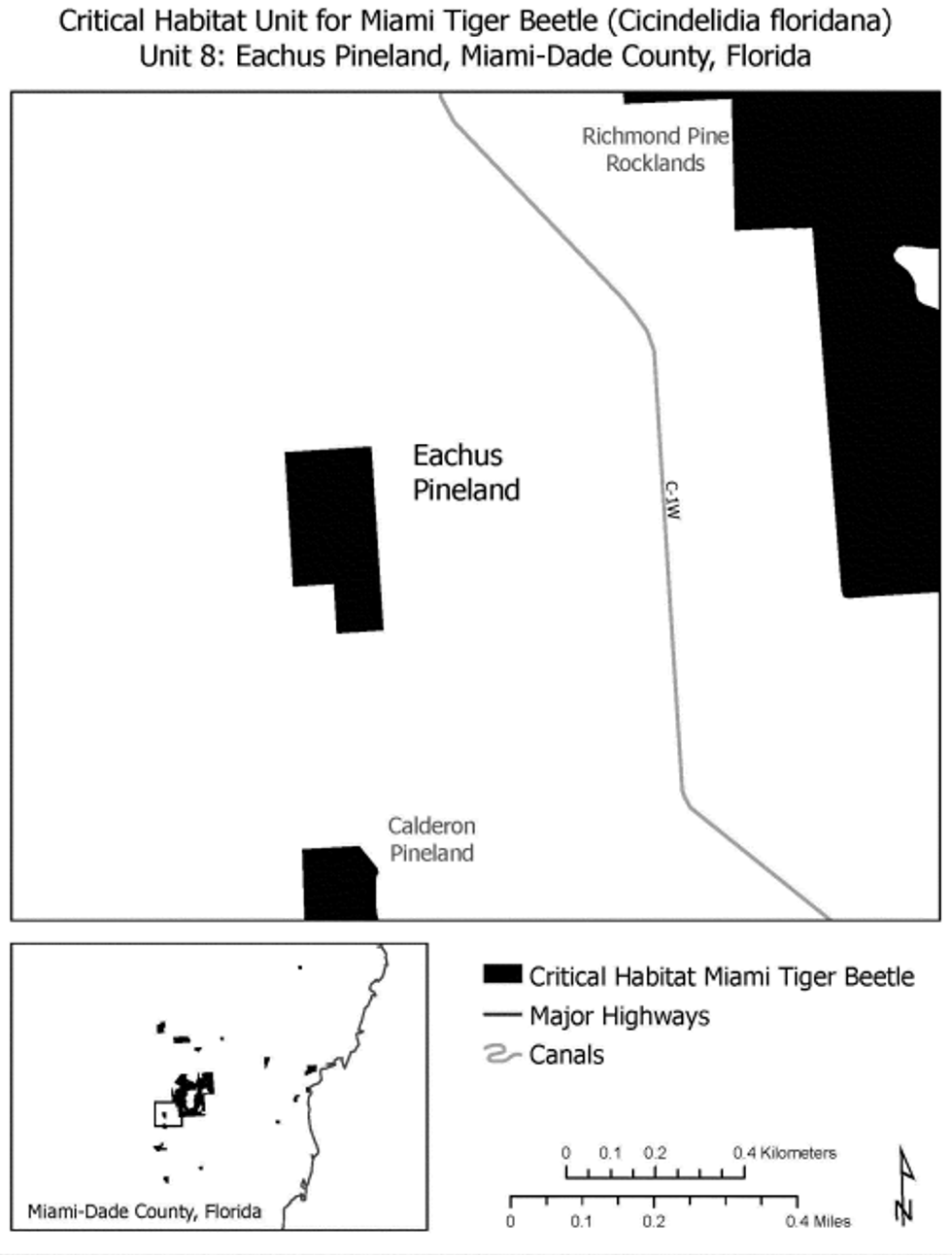
(14) Unit 9: Bill Sadowski Park, Miami-Dade County, Florida.
(i) Unit 9 consists of approximately 20 ac (8 ha). This unit is located south of 168th Street, west of Old Cutler Road, north of SW 184th Street, and east of SW 87th Avenue.
(ii) Map of Unit 9 follows:
Figure 10 to Miami Tiger Beetle (Cicindelidia floridana) paragraph (14)(ii)
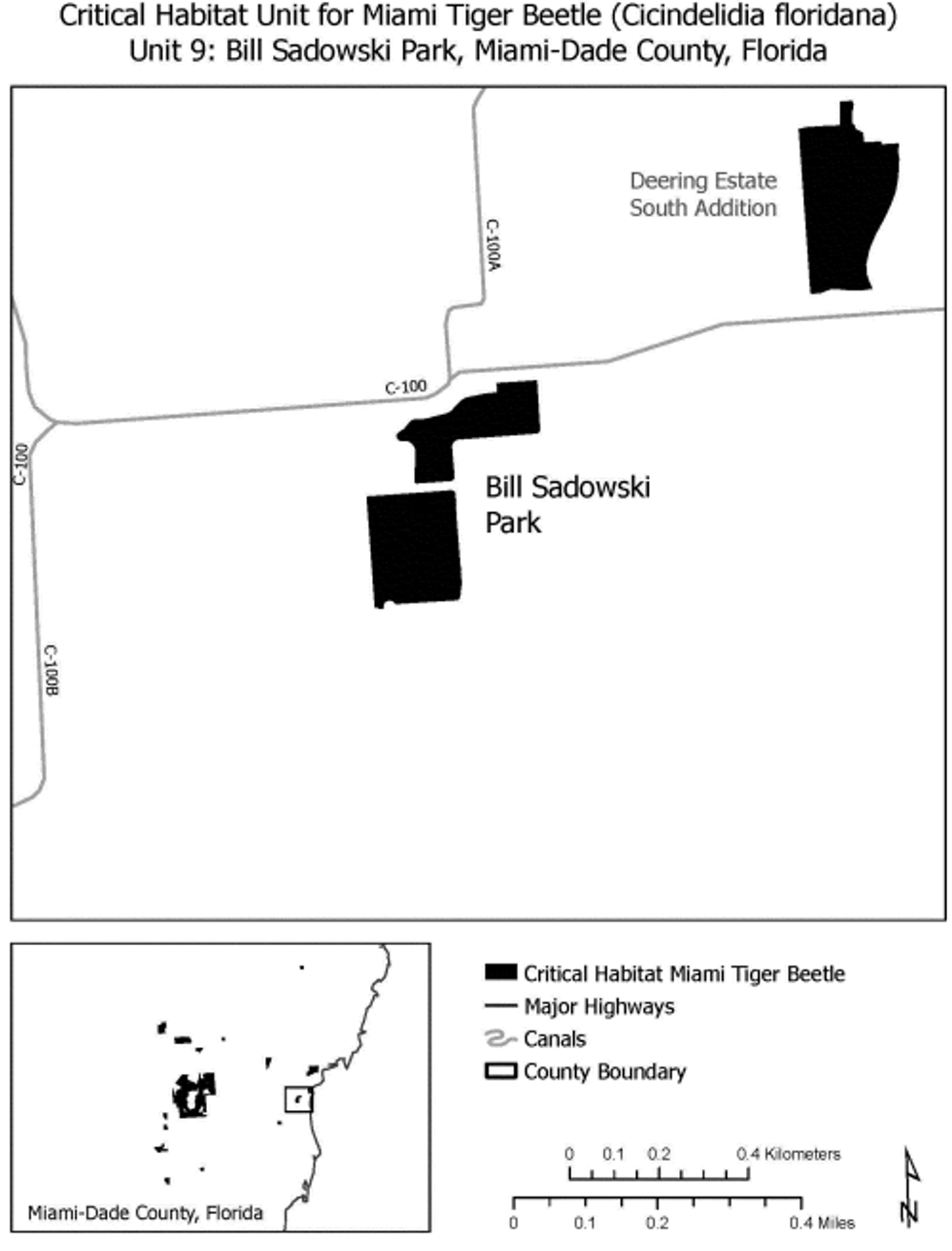
(15) Unit 10: Tamiami Pineland Complex Addition, Miami-Dade County, Florida.
(i) Unit 10 consists of approximately 21 ac (8 ha). This unit is located south of 128th Street, west of Florida's Turnpike, north of SW 136th Street, and east of SW 127th Avenue.
(ii) Map of Unit 10 follows:
Figure 11 to Miami Tiger Beetle (Cicindelidia floridana) paragraph (15)(ii)
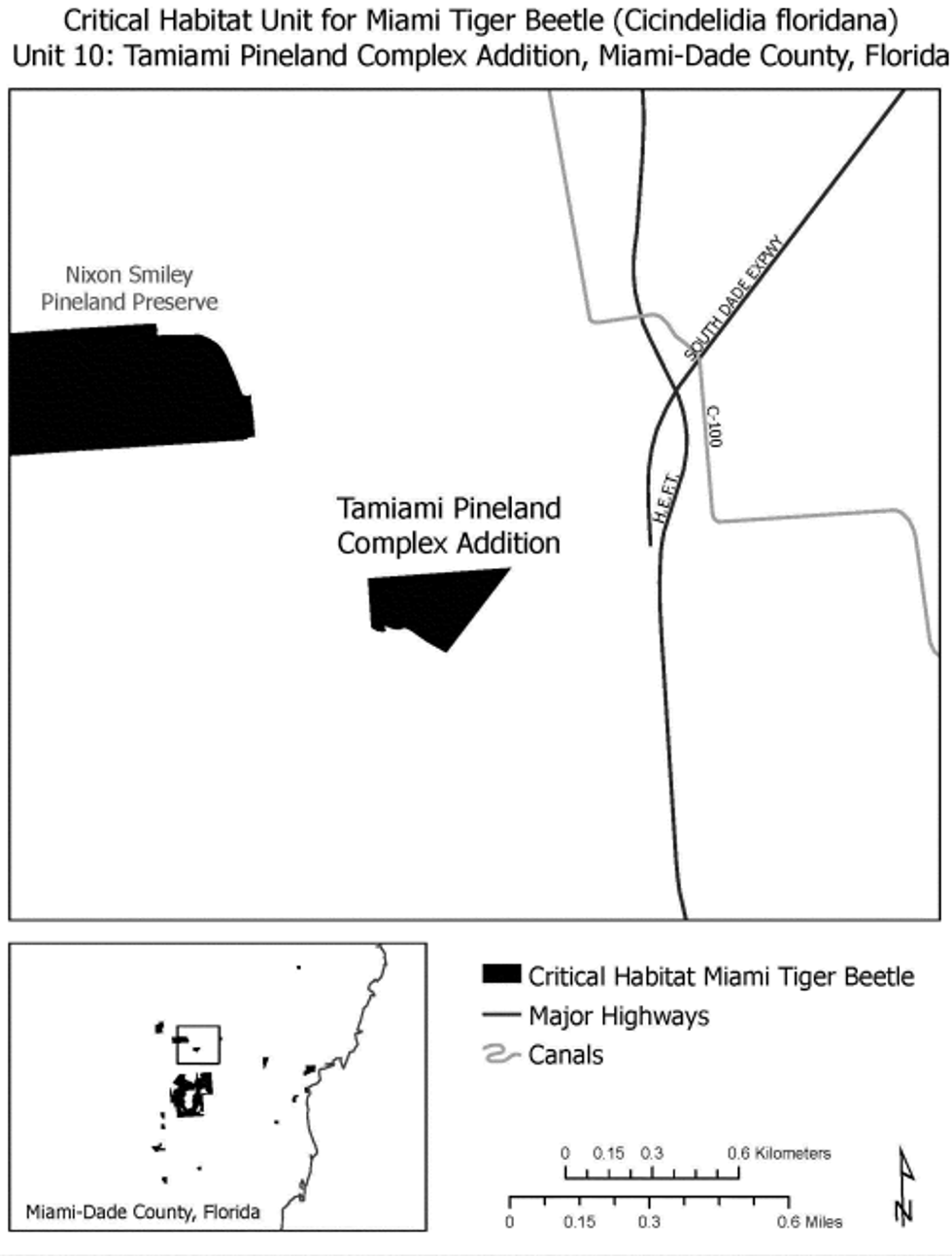
(16) Unit 11: Pine Shore Pineland Preserve, Miami-Dade County, Florida.
(i) Unit 11 consists of approximately 8 ac (3 ha). This unit is located southwest of the Don Shula Expressway, west of SW 107th Avenue, and north of SW 128th Street.
(ii) Map of Unit 11 follows:
Figure 12 to Miami Tiger Beetle (Cicindelidia floridana) paragraph (16)(ii)
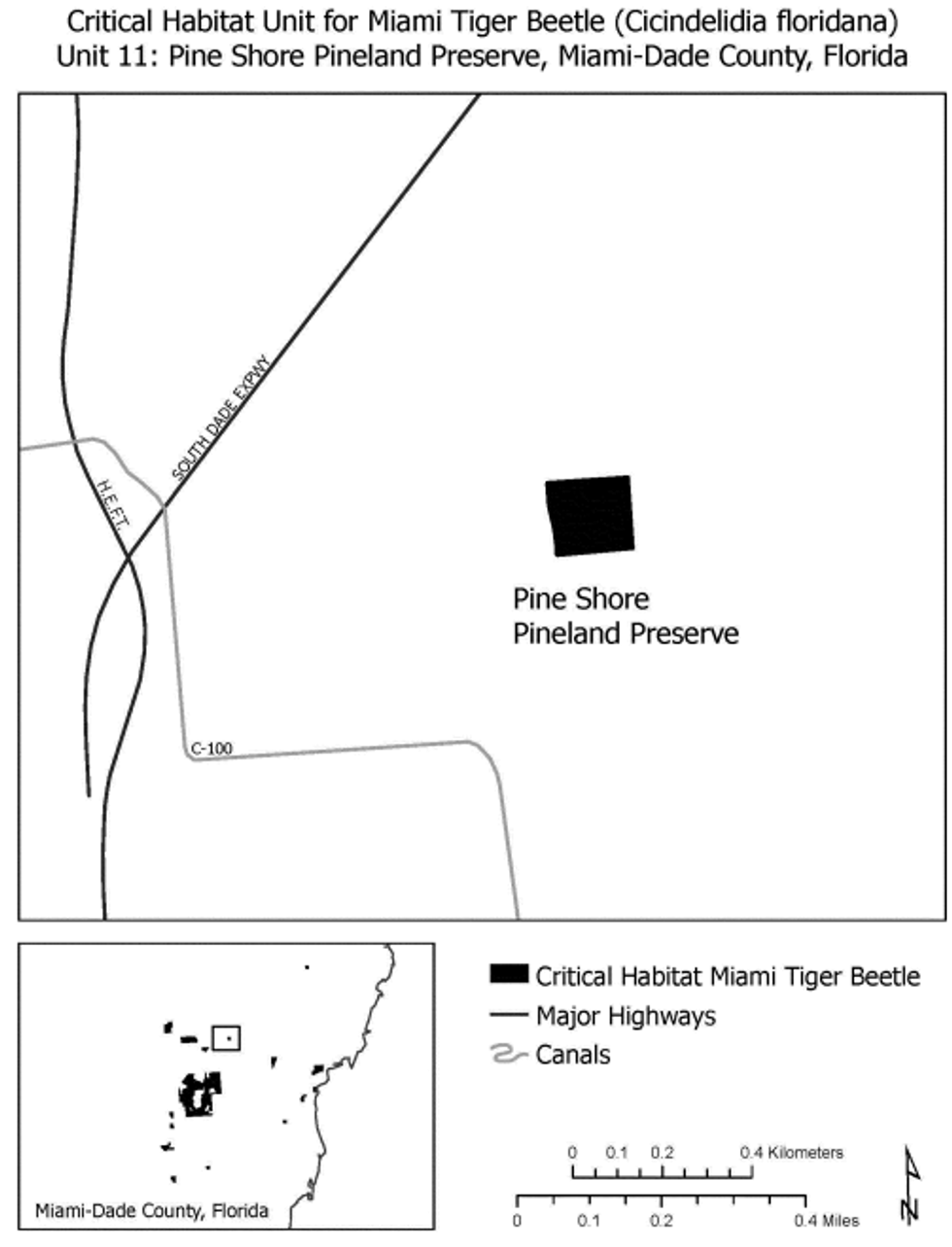
(17) Unit 12: Nixon Smiley Pineland Preserve, Miami-Dade County, Florida.
(i) Unit 12 consists of approximately 117 ac (47 ha). This unit is located between SW 120th Street to the north, SW 127th Avenue to the east, SW 128th Street to the south, and SW 137th Avenue to the west.
(ii) Map of Unit 12 follows:
Figure 13 to Miami Tiger Beetle (Cicindelidia floridana) paragraph (17)(ii)
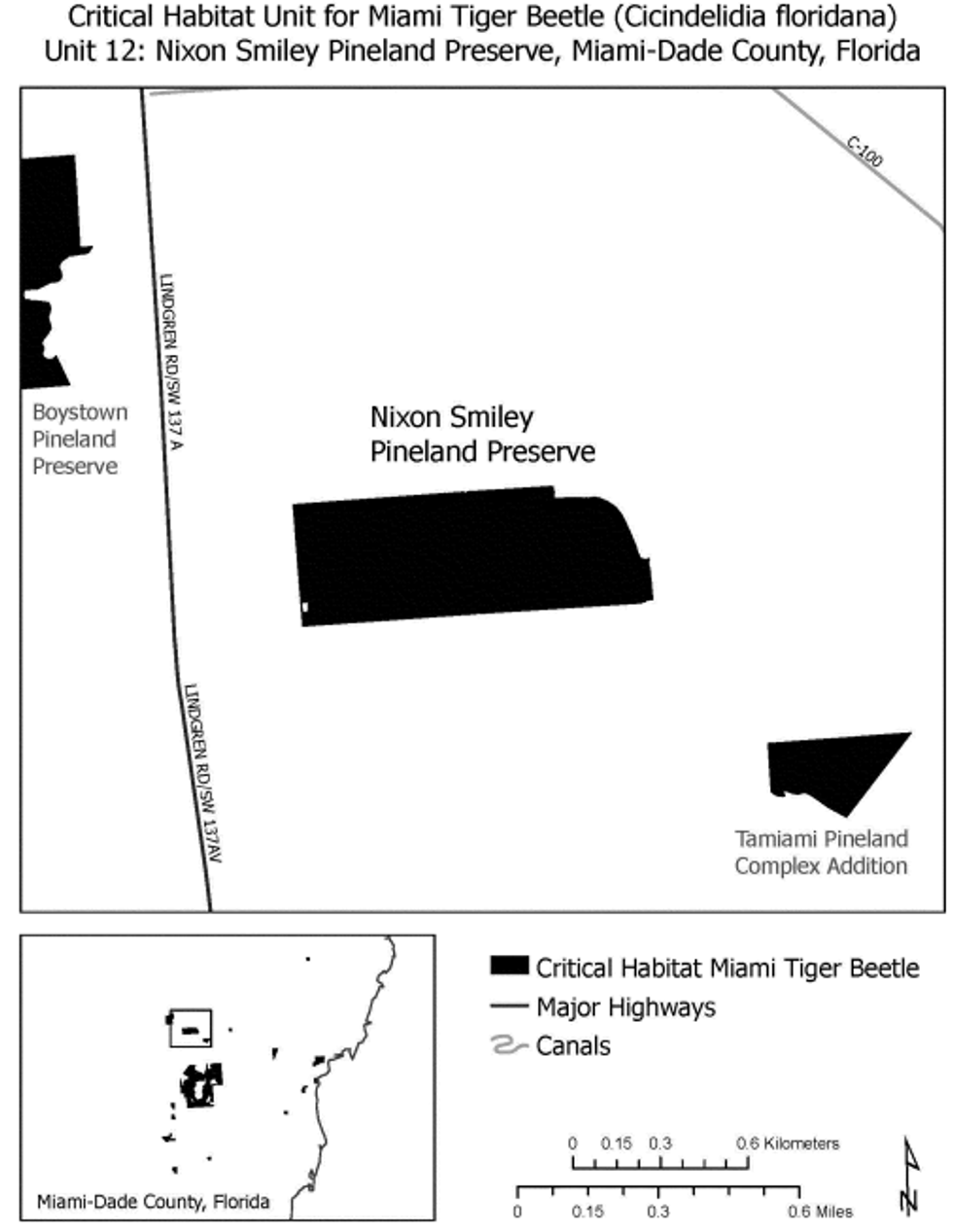
(18) Unit 13: Boystown Pineland Preserve, Miami-Dade County, Florida.
(i) Unit 13 consists of approximately 81 ac (33 ha). This unit is between SW 104th Street to the north, SW 137th Avenue to the east, SW 12th Street to the south, and SW 147th Avenue to the west.
(ii) Map of Unit 13 follows:
Figure 14 to Miami Tiger Beetle (Cicindelidia floridana) paragraph (18)(ii)
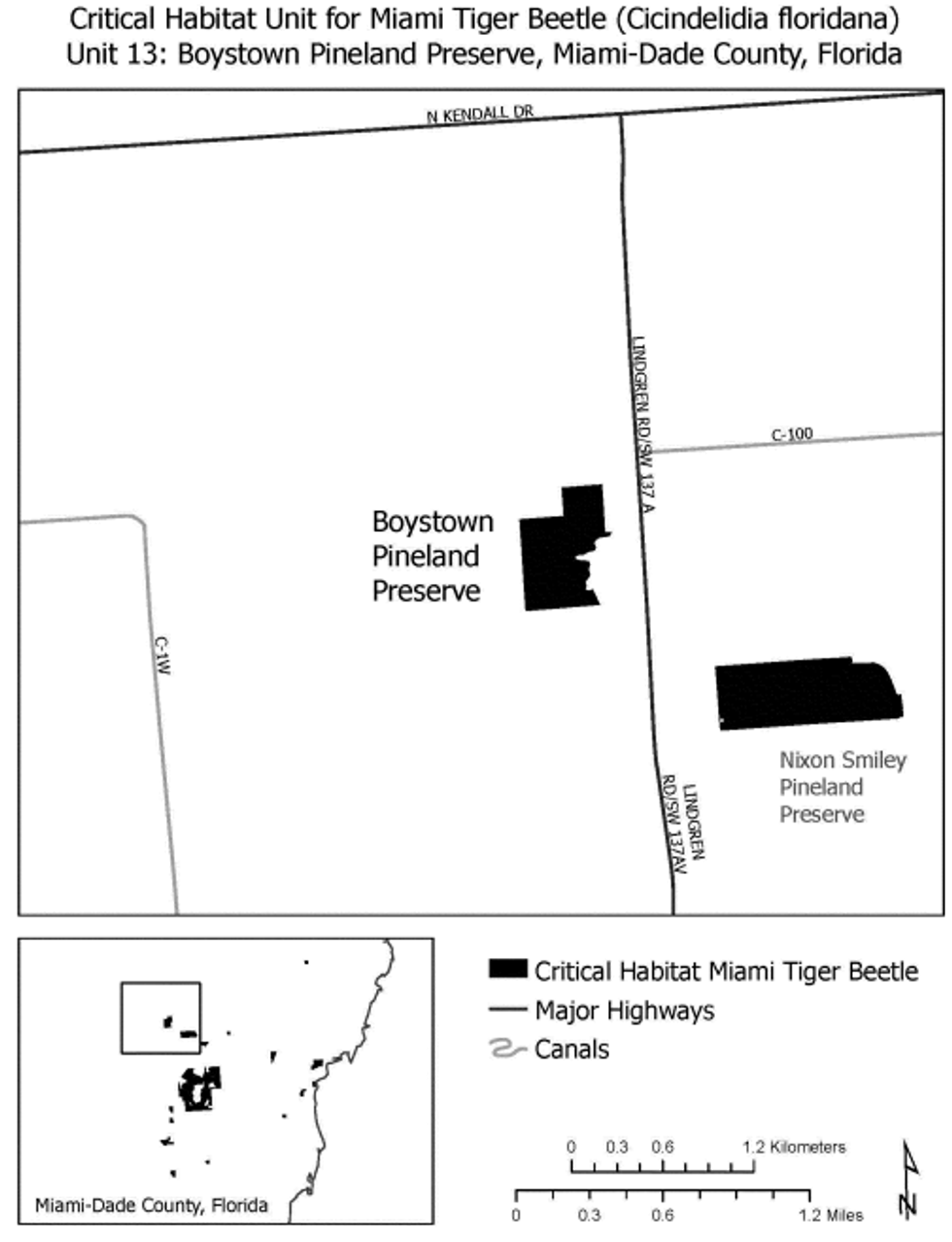
(19) Unit 14: Richmond Pine Rocklands, Miami-Dade County, Florida.
(i) Unit 14 consists of approximately 1,347 ac (545 ha). This unit is located between SW 152nd Street to the north, SW 117th Avenue to the east, SW 185th Street to the south, and SW 137th Avenue to the west.
(ii) Map of Unit 14 follows:
Figure 15 to Miami Tiger Beetle (Cicindelidia floridana) paragraph (19)(ii)
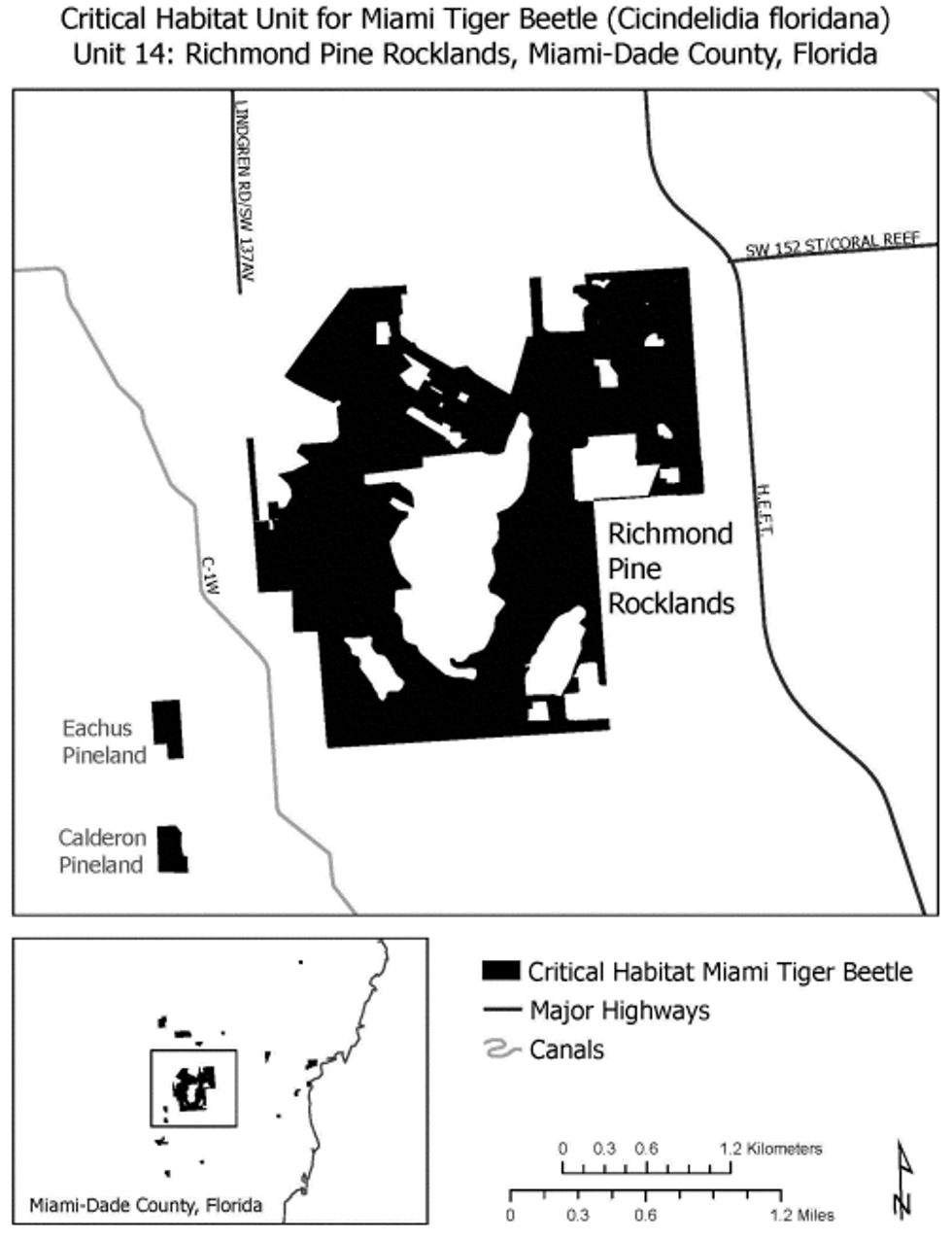
(20) Unit 15: Calderon Pineland, Miami-Dade County, Florida.
(i) Unit 15 consists of approximately 14 ac (6 ha). This unit is located between SW 184th Street to the south, SW 137th Avenue to the east, SW 200th Street to the south, and SW 147th Avenue to the west.
(ii) Map of Unit 15 follows:
Figure 16 to Miami Tiger Beetle (Cicindelidia floridana) paragraph (20)(ii)
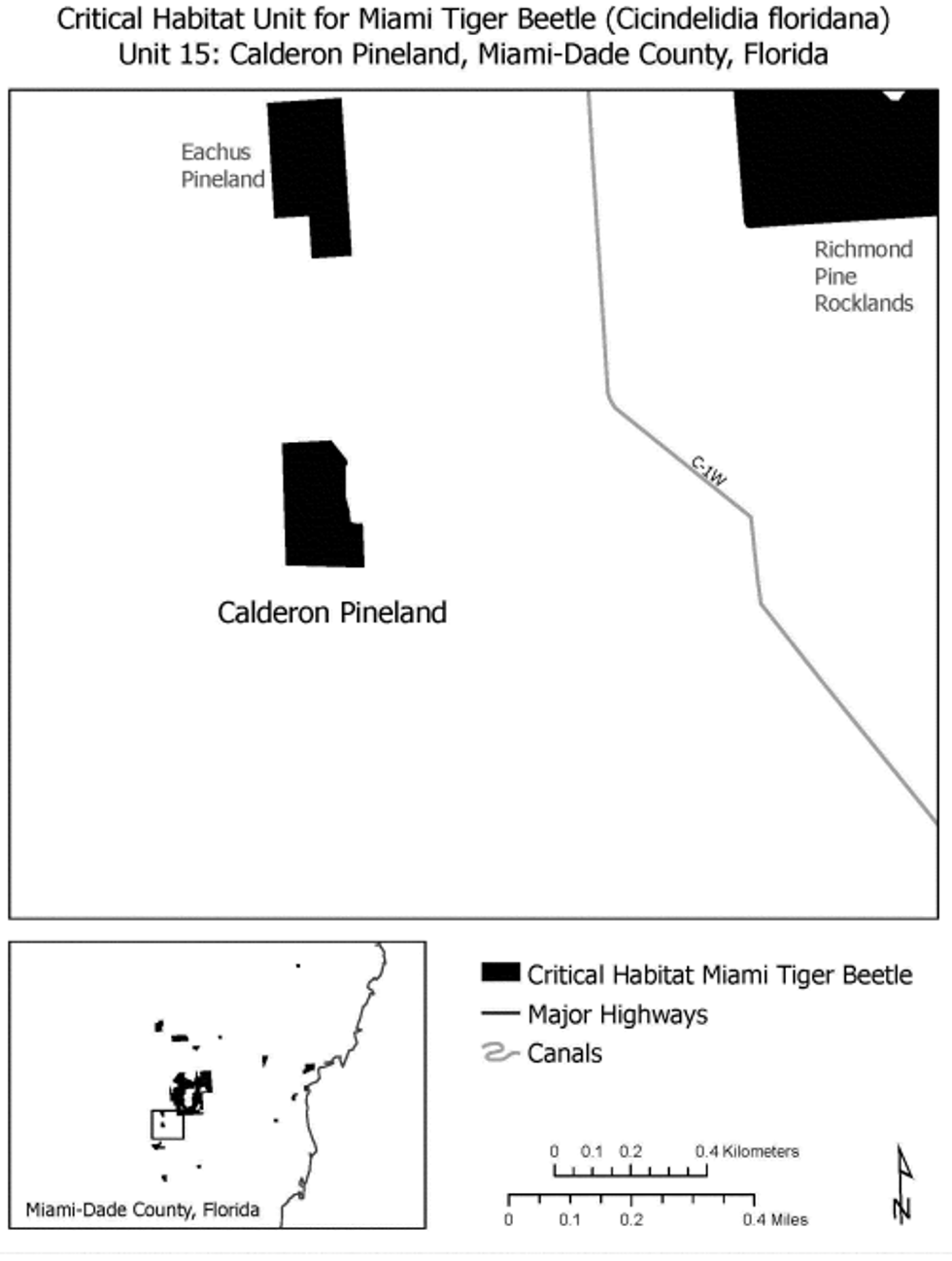
(21) Unit 16: Porter Pineland Preserve, Miami-Dade County, Florida.
(i) Unit 16 consists of approximately 7 ac (3 ha). This unit is located to the south of SW 216th Street, to the west of South Dixie Highway, to the north of SW 232nd Street, and to the east of SW 147th Avenue.
(ii) Map of Unit 16 follows:
Figure 17 to Miami Tiger Beetle (Cicindelidia floridana) paragraph (21)(ii)
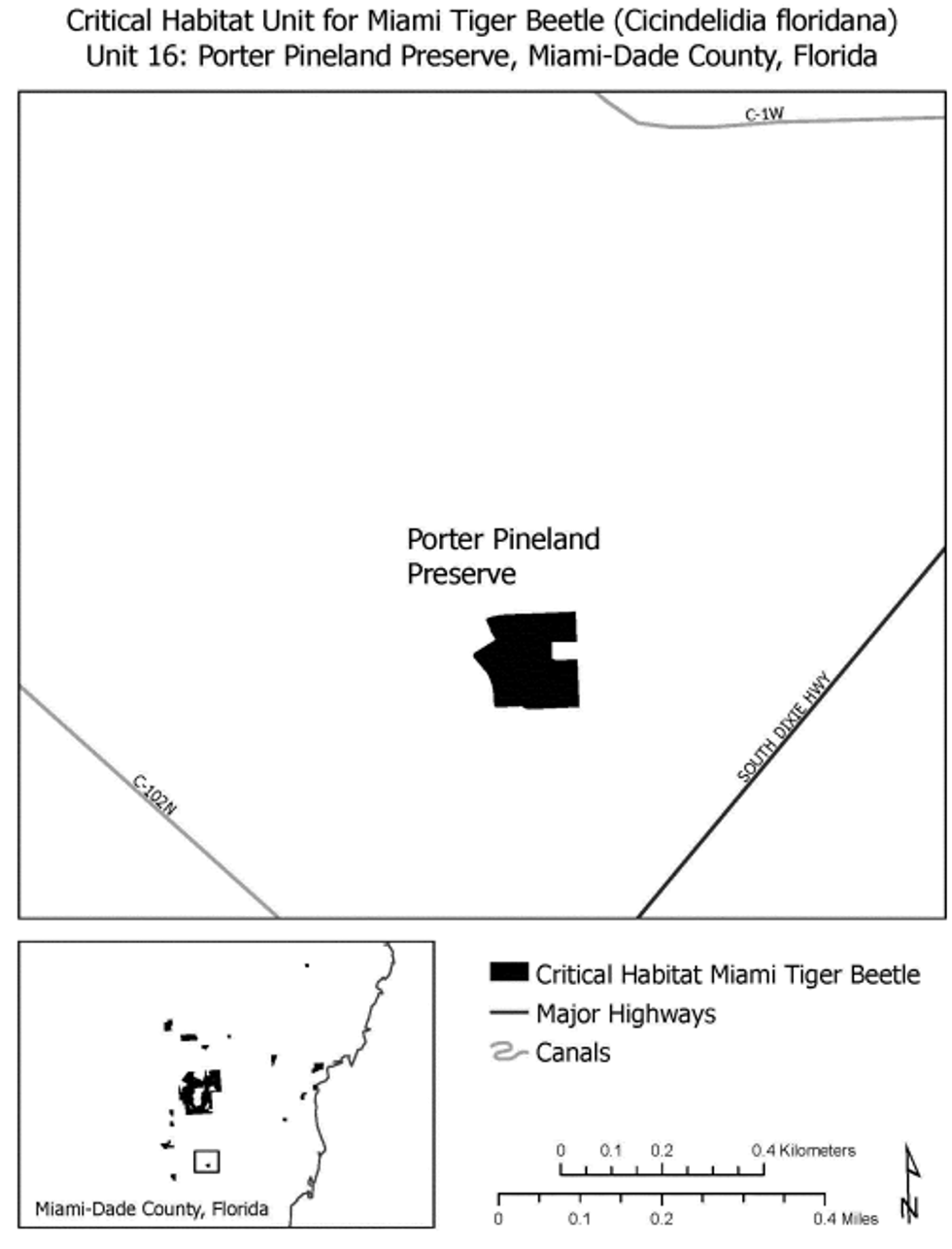
Beetle (No Common Name) (Rhadine exilis)
(1) Critical habitat for the beetle (Rhadine exilis) in Bexar County, Texas, occurs in Units 1b, 1d, 1e, 2, 3, 4, 5, 6, 7, 8, 9, 11e, 12, 13, and 21, and is depicted on Maps 3, 6, 7, 8, 10, 11, 12, and 18 in this entry, and on Maps 2, 4, and 5, provided at paragraphs (6), (7), and (8) of the entry for the Helotes mold beetle in this paragraph (i). The units are also depicted on Map 1 (index map) provided in paragraph (5) of the entry for the Helotes mold beetle in this paragraph (i).
(2) Eight caves and their associated karst management areas established under the La Cantera Habitat Conservation Plan section 10(a)(1)(B) permit are adjacent to or within the boundaries of Units 1e, 3, 6, 8, and 17, but are not designated as critical habitat. These caves are Canyon Ranch Pit, Fat Man's Nightmare Cave, Scenic Overlook Cave and the surrounding approximately 75 ac (30 ha) adjacent to Unit 1e; Helotes Blowhole and Helotes Hilltop Caves and the surrounding approximately 25 ac (10 ha) adjacent to Unit 3; John Wagner Cave No. 3 and the surrounding approximately 4 ac (1.6 ha) adjacent to Unit 6; Hills and Dales Pit and the surrounding approximately 70 ac (28 ha) adjacent to Unit 8; and Madla's Cave and the surrounding approximately 5 ac (2 ha) within Unit 17.
(3) The primary constituent elements of, and the statements regarding developed lands in, critical habitat for Rhadine exilis are identical to those set forth at paragraphs (2) and (3) of the entry for the Helotes mold beetle in this paragraph (i).
(4) Data layers defining map units were created using a geographic information system (GIS), which included cave locations, karst zone maps, roads, property boundaries, 2010 aerial photography, and USGS 7.5′ quadrangles. Points were placed on the GIS.
(5) Unit 1b: Bexar County, Texas.
(i) [Reserved]
(ii) Map 2 of Unit 1b is provided at paragraph (6)(ii) of the entry for the Helotes mold beetle in this paragraph (i).
(6) Unit 1d: Bexar County, Texas.
(i) [Reserved]
(ii) Map 2 of Unit 1d is provided at paragraph (6)(ii) of the entry for the Helotes mold beetle in this paragraph (i).
(7) Unit 1e: Bexar County, Texas.
(i) [Reserved]
(ii) Map 2 of Unit 1e is provided at paragraph (6)(ii) of the entry for the Helotes mold beetle in this paragraph (i).
(8) Unit 2: Bexar County, Texas.
(i) [Reserved]
(ii) Map 3 of Unit 2 follows:
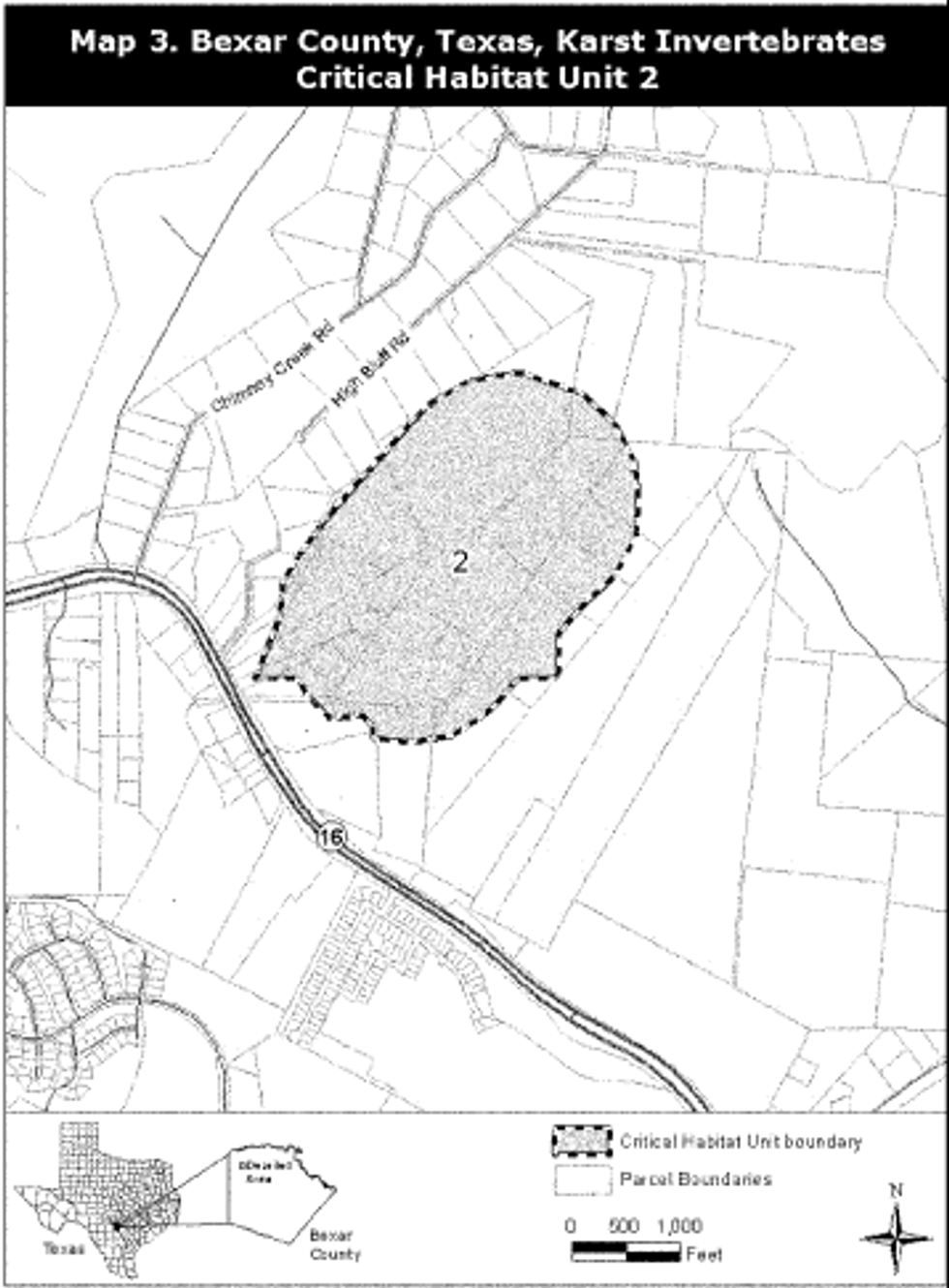
(9) Unit 3: Bexar County, Texas.
(i) [Reserved]
(ii) Units 3 and 4 are depicted on Map 4, which is provided at paragraph (7)(ii) of the entry for the Helotes mold beetle in this paragraph (i).
(10) Unit 4: Bexar County, Texas.
(i) [Reserved]
(ii) Units 3 and 4 are depicted on Map 4, which is provided at paragraph (7)(ii) of the entry for the Helotes mold beetle in this paragraph (i).
(11) Unit 5: Bexar County, Texas.
(i) [Reserved]
(ii) Units 5, 6, and 17 are depicted on Map 5, which is provided at paragraph (8)(ii) of the entry for the Helotes mold beetle in this paragraph (i).
(12) Unit 6: Bexar County, Texas.
(i) [Reserved]
(ii) Units 5 and 6 are depicted on Map 5, which is provided at paragraph (8)(ii) of the entry for the Helotes mold beetle in this paragraph (i).
(13) Unit 7: Bexar County, Texas.
(i) [Reserved]
(ii) Map 6 of Unit 7 follows:
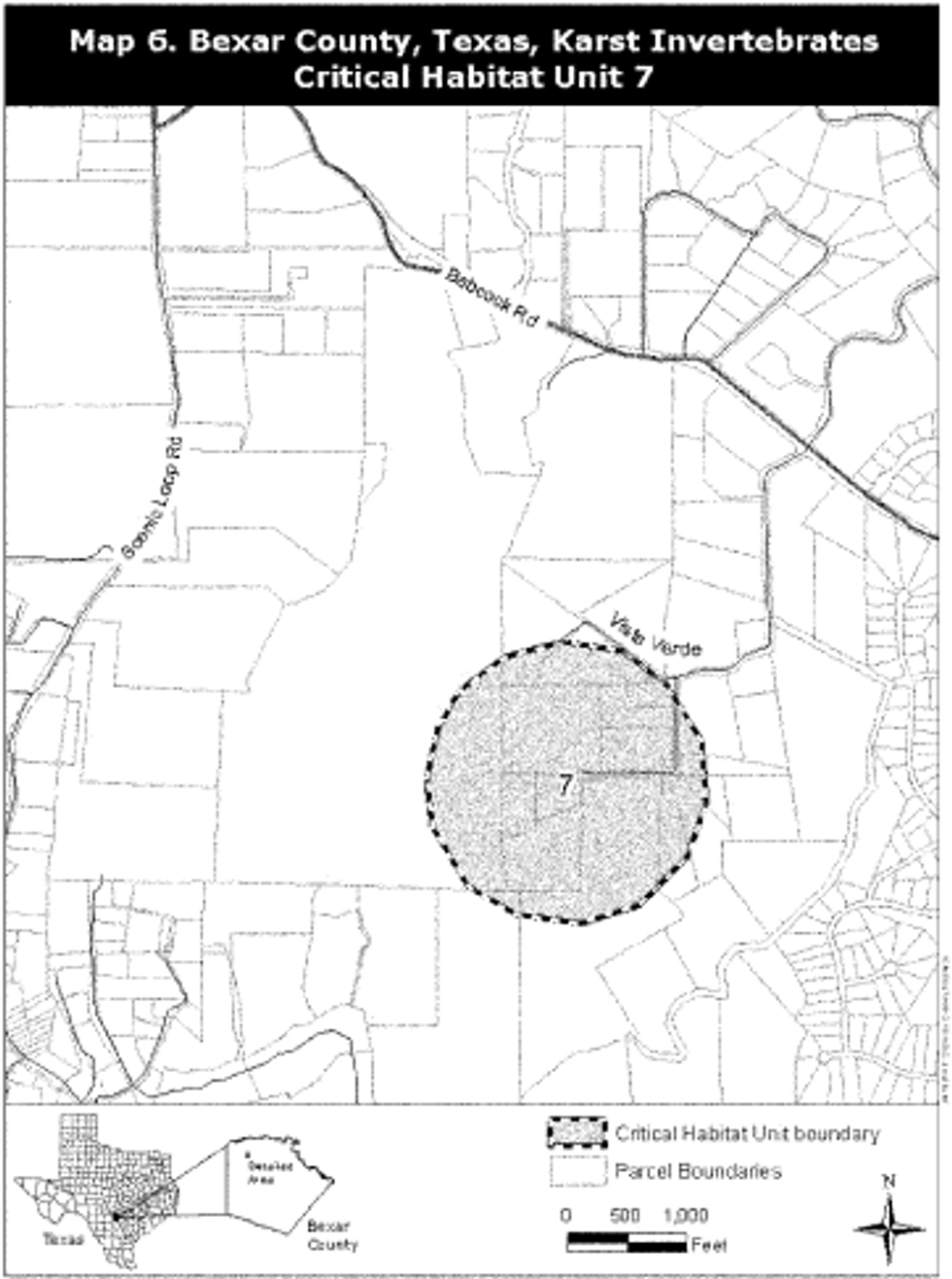
(14) Unit 8: Bexar County, Texas.
(i) [Reserved]
(ii) Map 7 of Unit 8 follows:
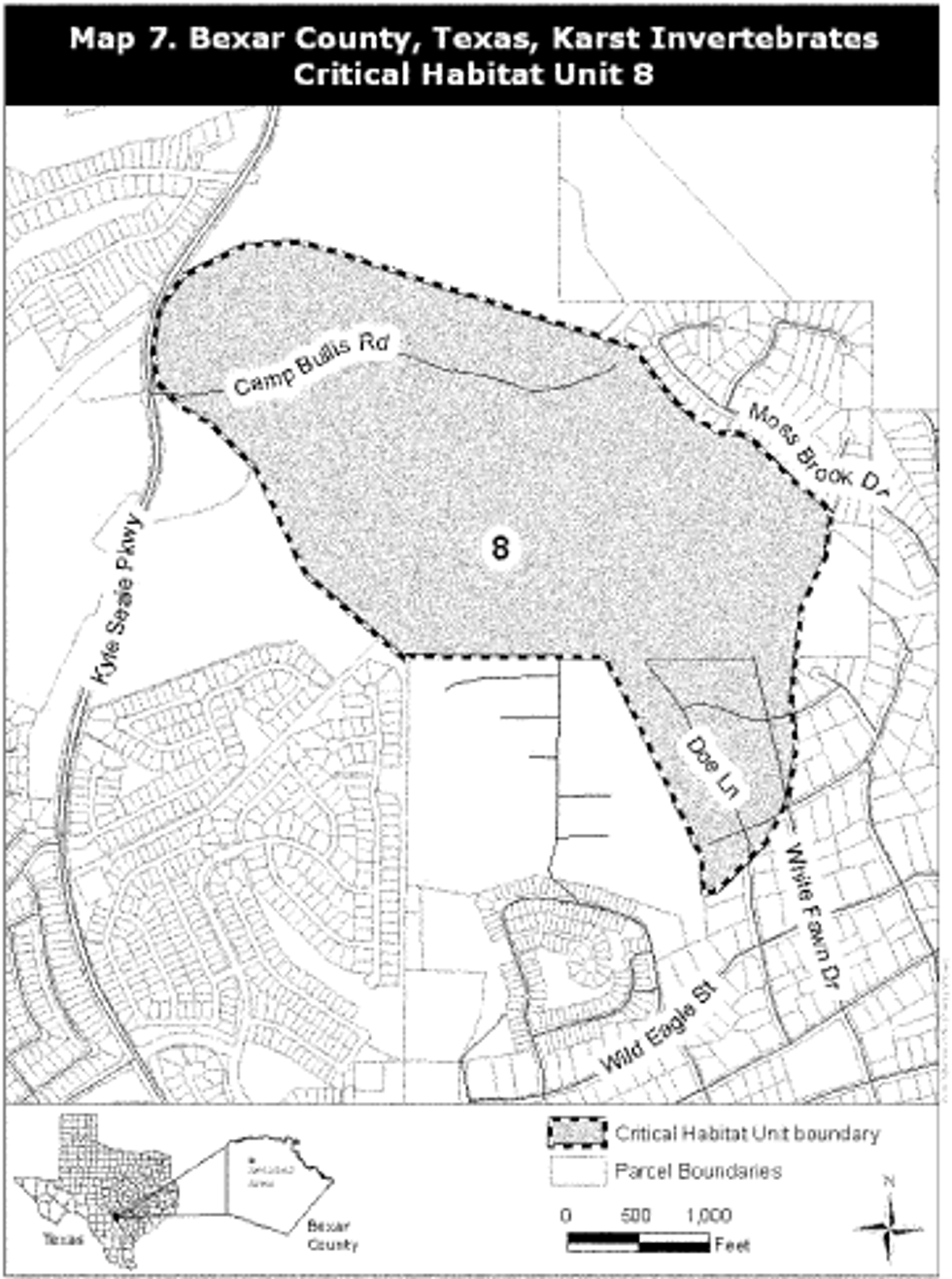
(15) Unit 9: Bexar County, Texas.
(i) [Reserved]
(ii) Map 8 of Unit 9 follows:
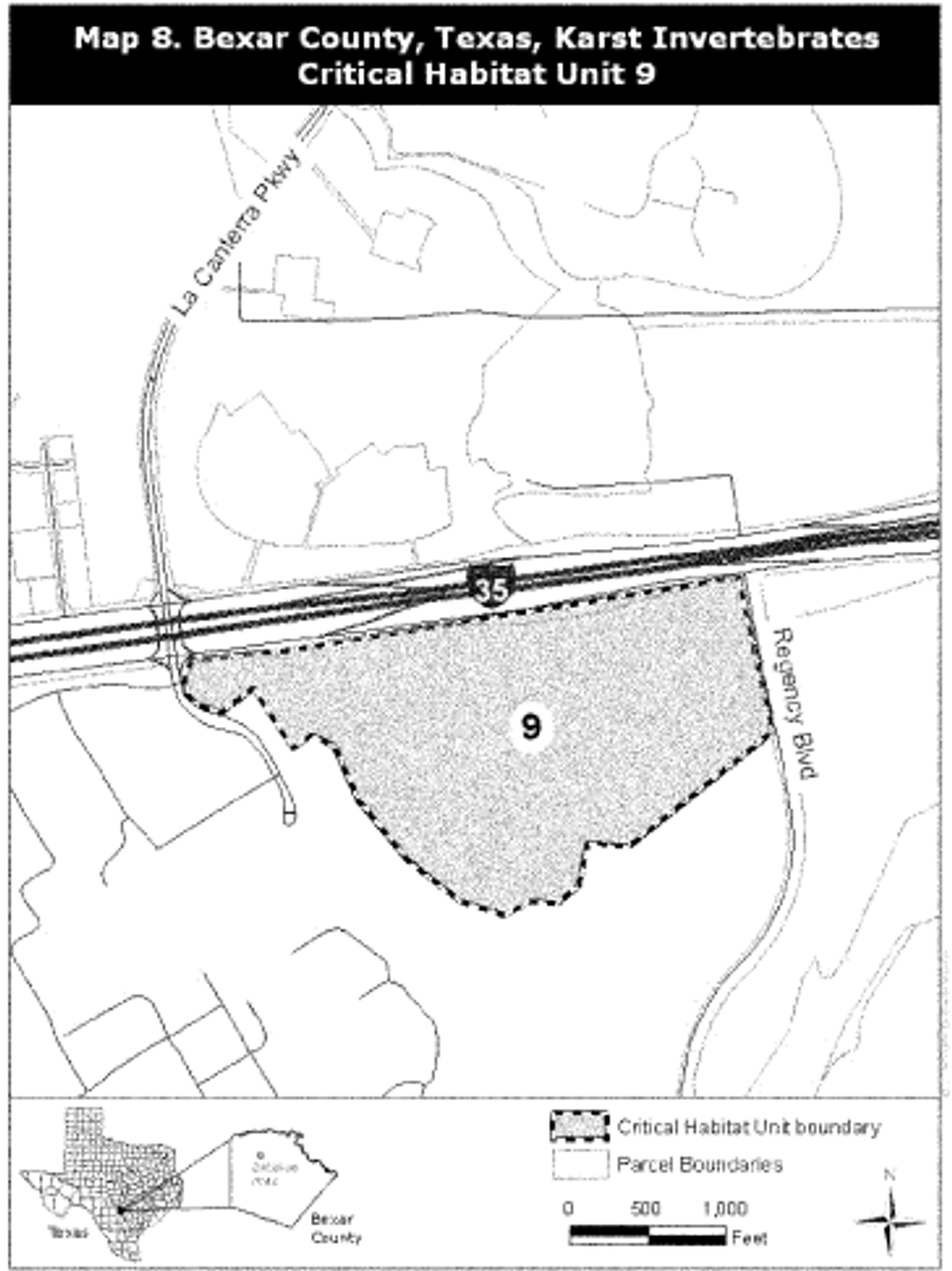
(16) Unit 11e: Bexar County, Texas.
(i) [Reserved]
(ii) Map 10 of Unit 11e follows:
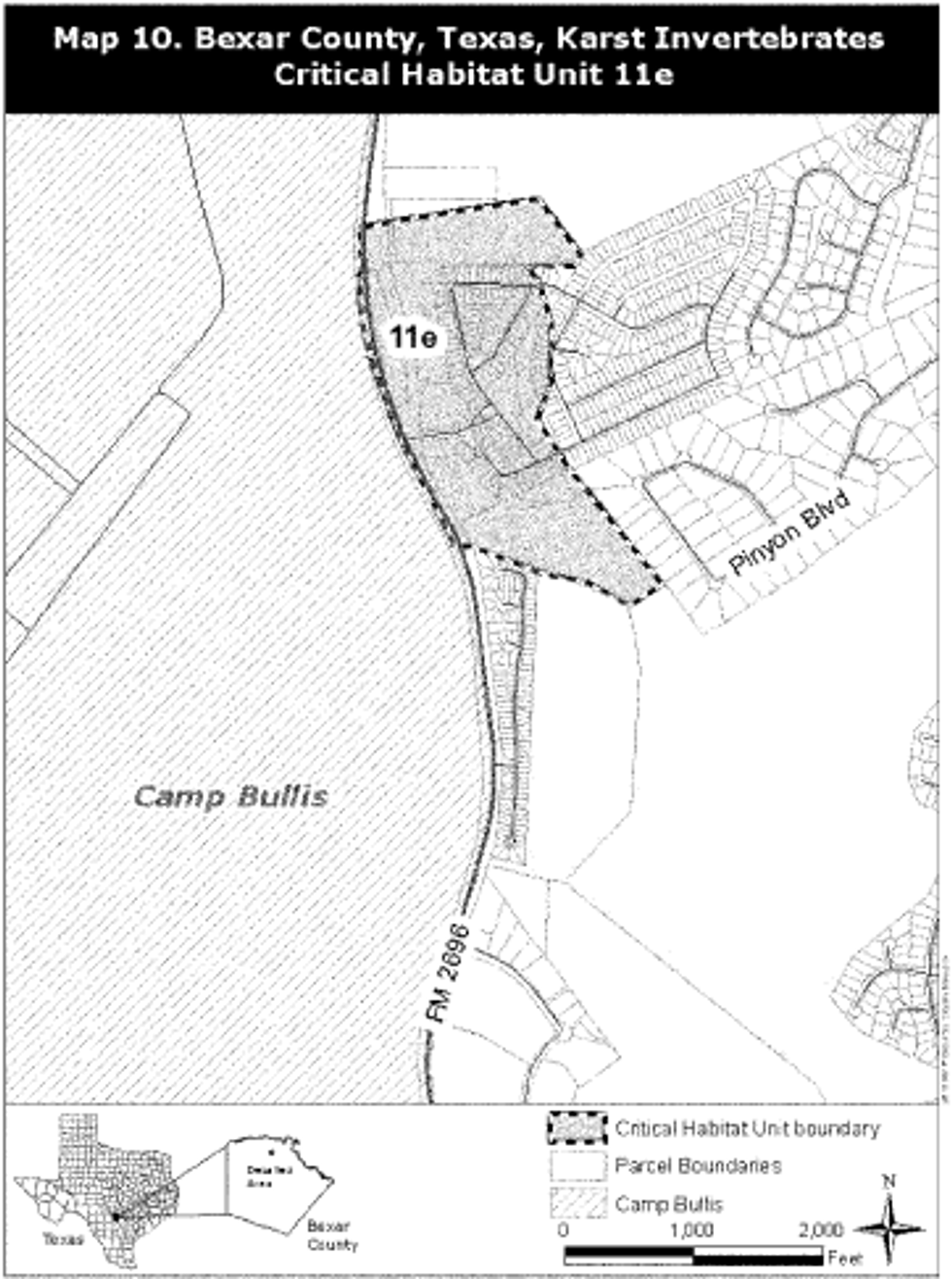
(17) Unit 12: Bexar County, Texas.
(i) [Reserved]
(ii) Map 11 of Unit 12 follows:
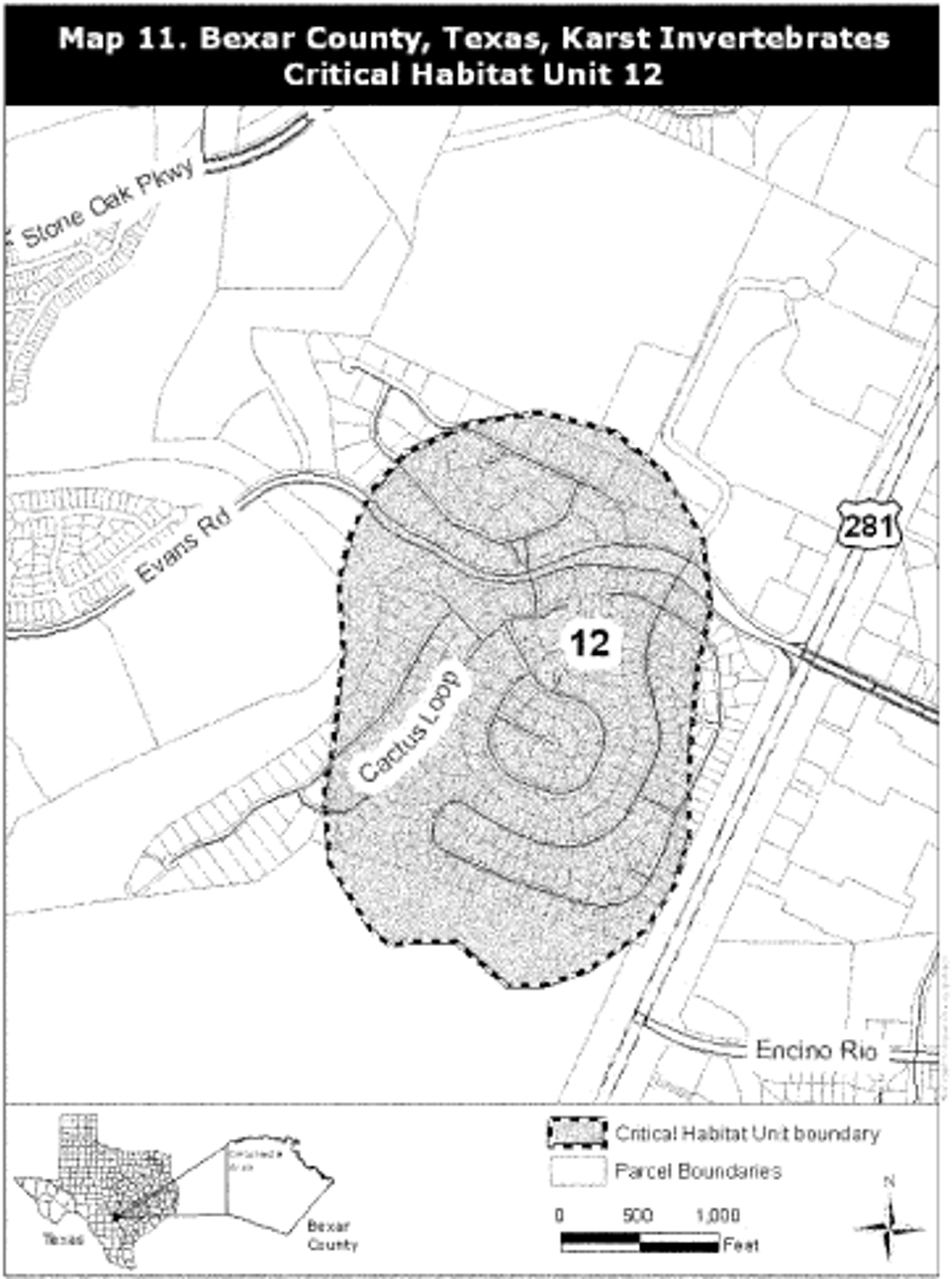
(18) Unit 13: Bexar County, Texas.
(i) [Reserved]
(ii) Map 12 of Unit 13 follows:
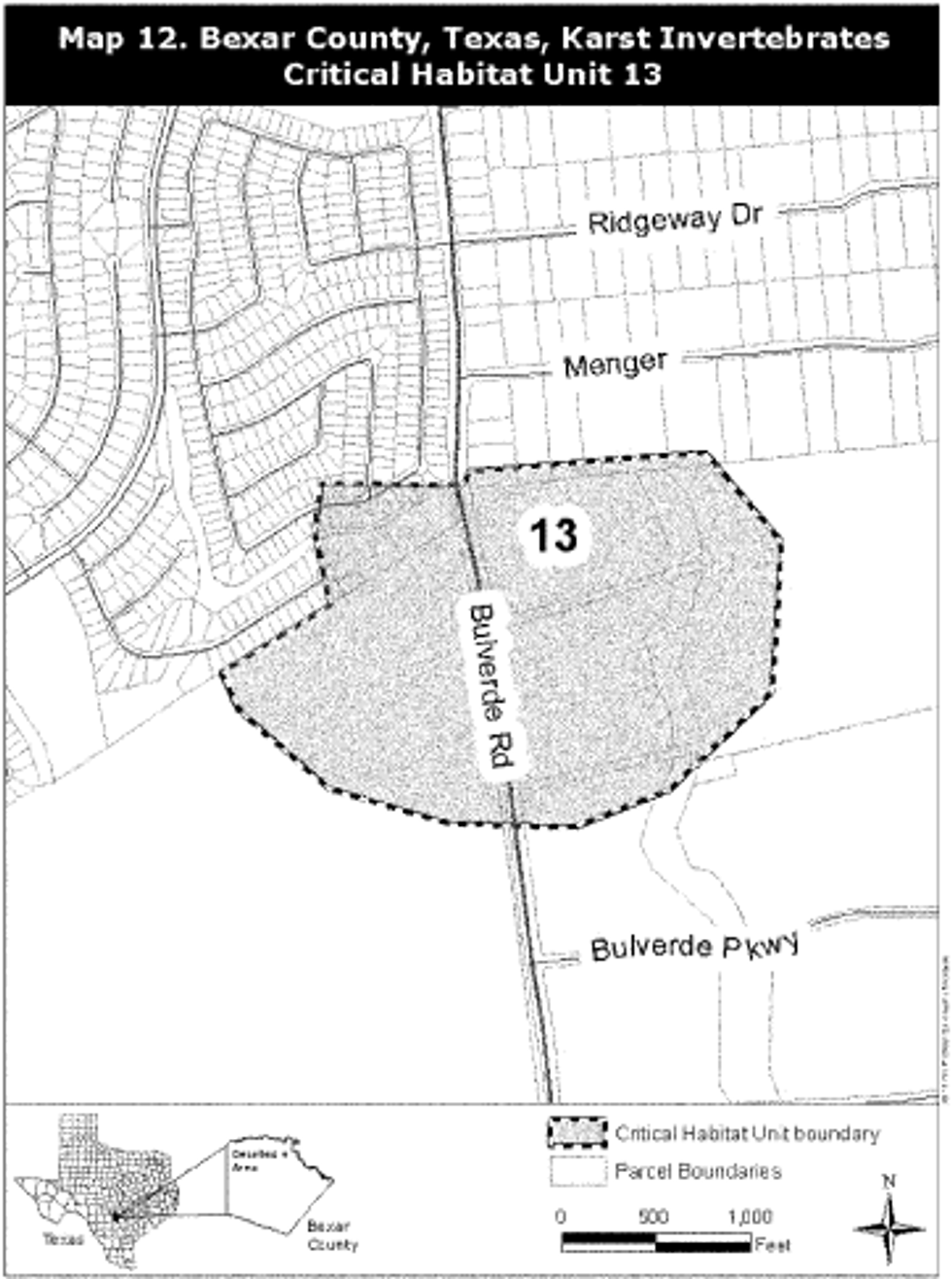
(19) Unit 21: Bexar County, Texas.
(i) [Reserved]
(ii) Map 18 of Unit 21 follows:
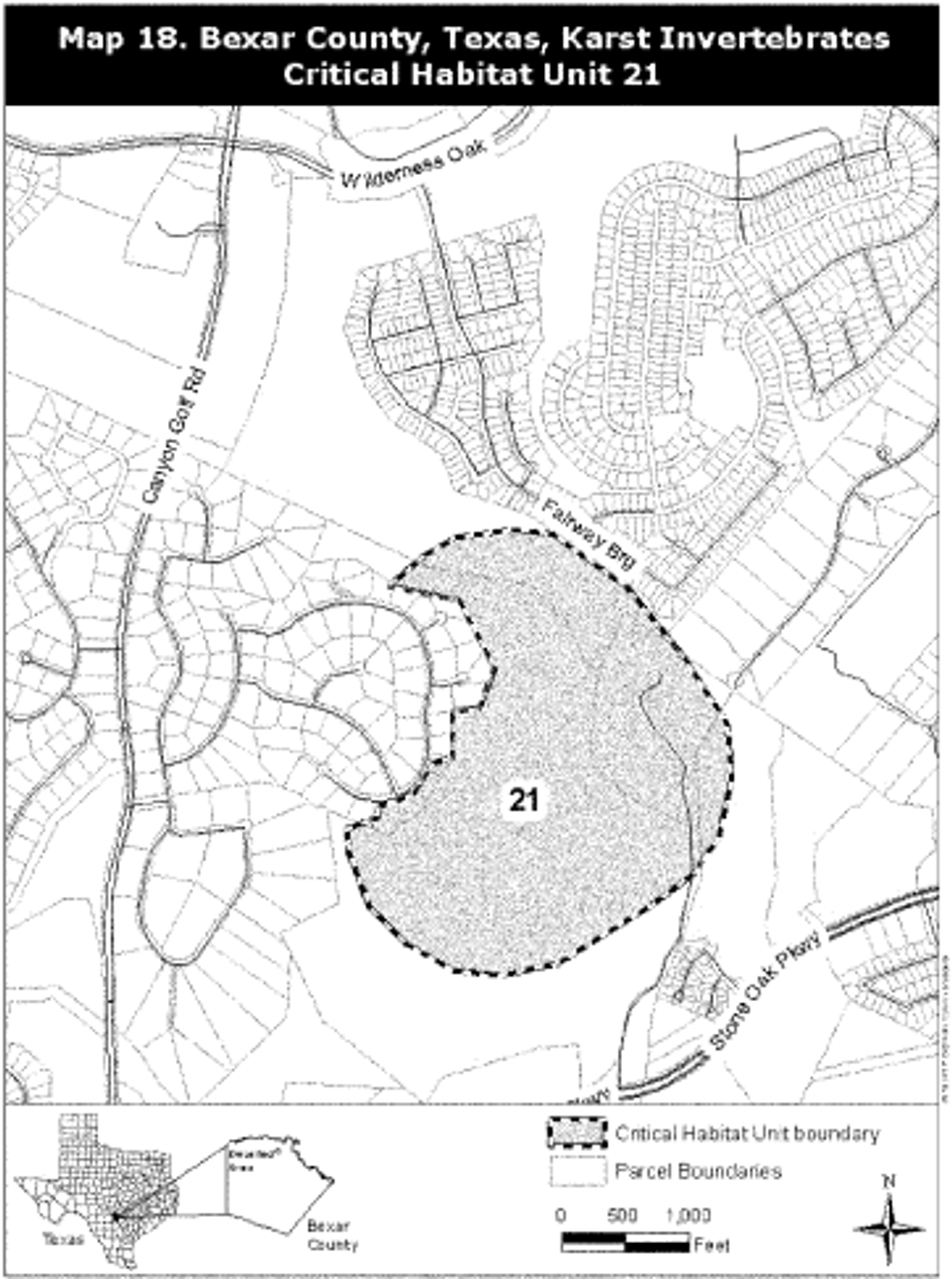
Beetle (No Common Name) (Rhadine infernalis)
(1) Critical habitat for the beetle (Rhadine infernalis) in Bexar County, Texas, occurs in Units 1a, 1b, 1d, 1e, 1f, 2, 3, 4, 5, 6, 8, 10a, 10b, 14, 15, 16, 17, 19, 23, and 26. These units are depicted on Maps 9, 13, 14, 15, 16, 20, and 22 in this entry; on Maps 2, 4, and 5 provided at paragraphs (6)(ii), (7)(ii), and (8)(ii) of the entry for the Helotes mold beetle in this paragraph (i); and on Maps 3 and 7 provided at paragraphs (8)(ii) and (14)(ii) of the entry for the beetle (Rhadine exilis) in this paragraph (i). The units are also depicted on Map 1 (index map) provided in paragraph (5) of the entry for the Helotes mold beetle in this paragraph (i).
(2) Eight caves and their associated karst management areas established under the La Cantera Habitat Conservation Plan section 10(a)(1)(B) permit are adjacent to or within the boundaries of Units 1e, 3, 6, 8, and 17, but are not designated as critical habitat. These caves are Canyon Ranch Pit, Fat Man's Nightmare Cave, Scenic Overlook Cave and the surrounding approximately 75 ac (30 ha) adjacent to Unit 1e; Helotes Blowhole and Helotes Hilltop Caves and the surrounding approximately 25 ac (10 ha) adjacent to Unit 3; John Wagner Cave No. 3 and the surrounding approximately 4 ac (1.6 ha) adjacent to Unit 6; Hills and Dales Pit and the surrounding approximately 70 ac (28 ha) adjacent to Unit 8; and Madla's Cave and the surrounding approximately 5 ac (2 ha) within Unit 17.
(3) The primary constituent elements of, and the statements regarding developed lands in, critical habitat for the Rhadine exilis are identical to those set forth at paragraphs (2) and (3) of the entry for the Helotes mold beetle in this paragraph (i).
(4) Data layers defining map units were created using a geographic information system (GIS), which included cave locations, karst zone maps, roads, property boundaries, 2010 aerial photography, and USGS 7.5' quadrangles. Points were placed on the GIS.
(5) Unit 1a: Bexar County, Texas.
(i) [Reserved]
(ii) Map 2 of Unit 1a is provided at paragraph (6)(ii) of the entry for the Helotes mold beetle in this paragraph (i).
(6) Unit 1b: Bexar County, Texas.
(i) [Reserved]
(ii) Map 2 of Unit 1b is provided at paragraph (6)(ii) of the entry for the Helotes mold beetle in this paragraph (i).
(7) Unit 1d: Bexar County, Texas.
(i) [Reserved]
(ii) Map 2 of Unit 1d is provided at paragraph (6)(ii) of the entry for the Helotes mold beetle in this paragraph (i).
(8) Unit 1e: Bexar County, Texas.
(i) [Reserved]
(ii) Map 2 of Unit 1e is provided at paragraph (6)(ii) of the entry for the Helotes mold beetle in this paragraph (i).
(9) Unit 1f: Bexar County, Texas.
(i) [Reserved]
(ii) Map 2 of Unit 1f is provided at paragraph (6)(ii) of the entry for the Helotes mold beetle in this paragraph (i).
(10) Unit 2: Bexar County, Texas.
(i) [Reserved]
(ii) Map 3 of Unit 2 is provided at paragraph (8)(ii) of the entry for the beetle (Rhadine exilis) in this paragraph (i).
(11) Unit 3: Bexar County, Texas.
(i) [Reserved]
(ii) Map 4 of Unit 3 is provided at paragraph (7)(ii) of the entry for the Helotes mold beetle in this paragraph (i).
(12) Unit 4: Bexar County, Texas
(i) [Reserved]
(ii) Map 4 of Unit 4 is provided at paragraph (7)(ii) of the entry for the Helotes mold beetle in this paragraph (i).
(13) Unit 5: Bexar County, Texas.
(i) [Reserved]
(ii) Map 5 of Unit 5 is provided at paragraph (8)(ii) of the entry for the Helotes mold beetle in this paragraph (i).
(14) Unit 6: Bexar County, Texas.
(i) [Reserved]
(ii) Map 5 of Unit 6 is provided at paragraph (8)(ii) of the entry for the Helotes mold beetle in this paragraph (i).
(15) Unit 8: Bexar County, Texas.
(i) [Reserved]
(ii) Map 7 of Unit 8 is provided at paragraph (14)(ii) of the entry for the beetle (Rhadine exilis) in this paragraph (i).
(16) Unit 10a: Bexar County, Texas.
(i) [Reserved]
(ii) Map 9 of Units 10a and 10b follows:
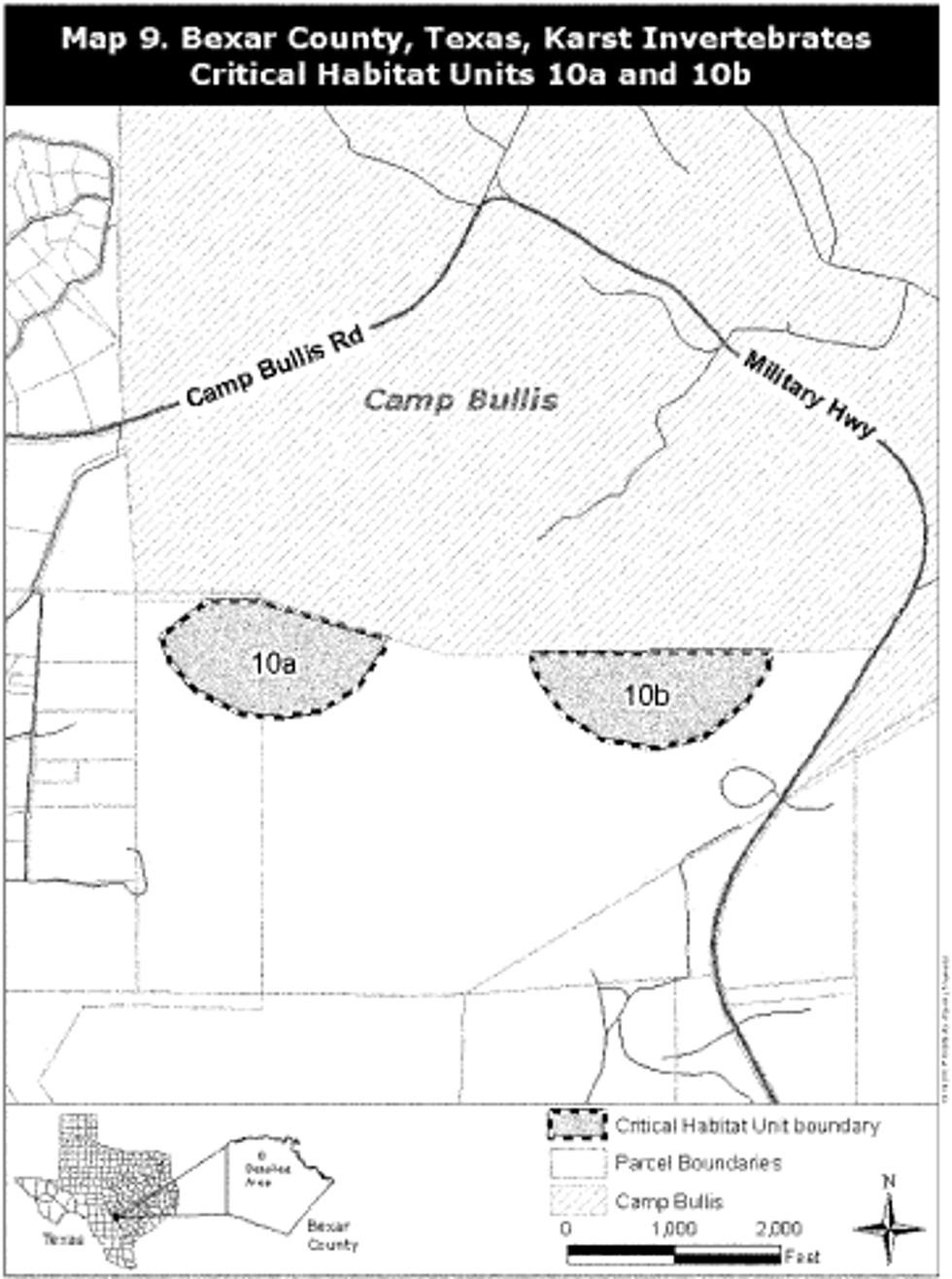
(17) Unit 10b: Bexar County, Texas.
(i) [Reserved]
(ii) Map 9 of Unit 10b is provided at paragraph (16)(ii) of this entry.
(18) Unit 14: Bexar County, Texas.
(i) [Reserved]
(ii) Map 13 of Unit 14 follows:
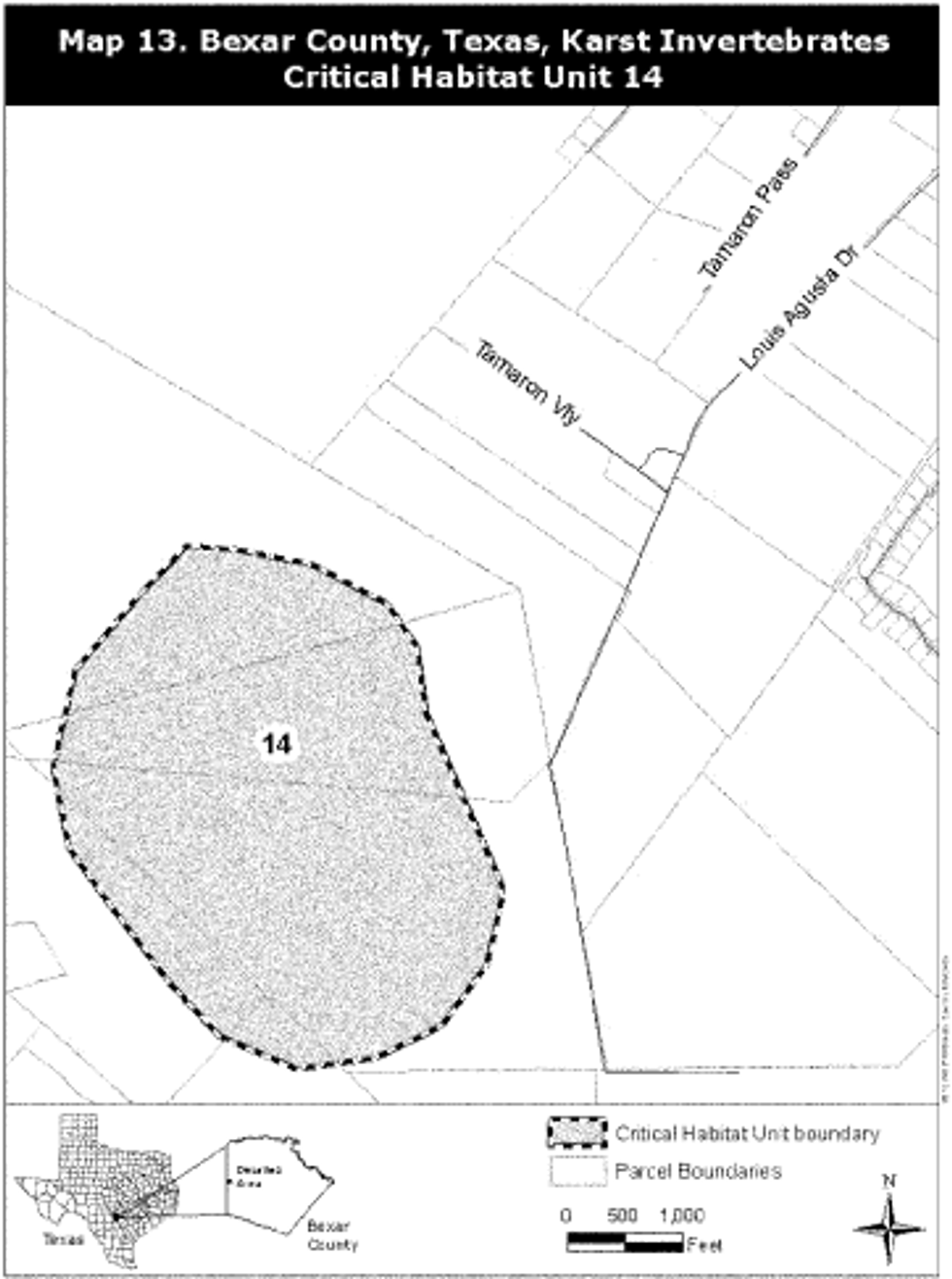
(19) Unit 15: Bexar County, Texas.
(i) [Reserved]
(ii) Map 14 of Unit 15 follows:
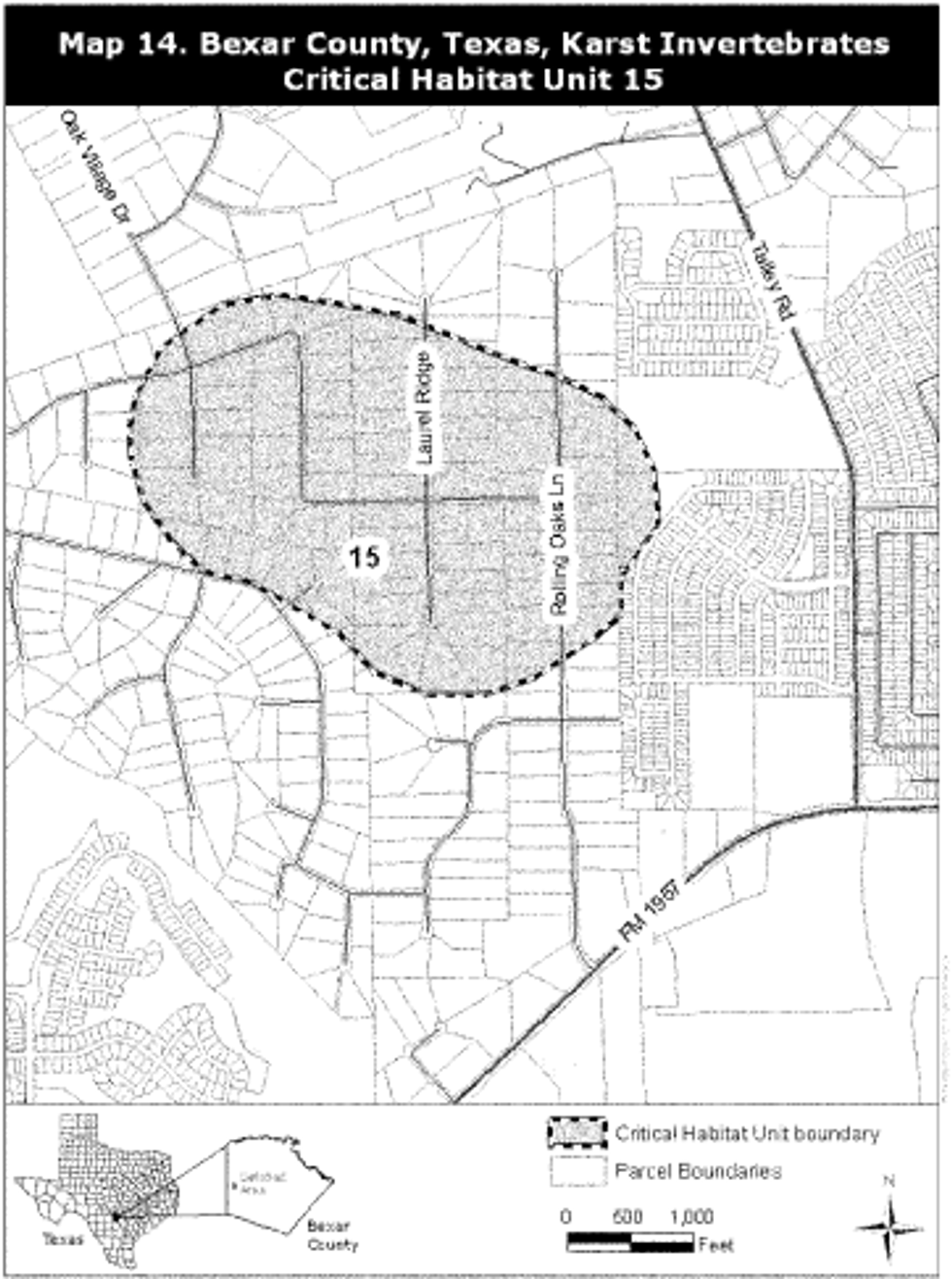
(20) Unit 16: Bexar County, Texas.
(i) [Reserved]
(ii) Map 15 of Unit 16 follows:
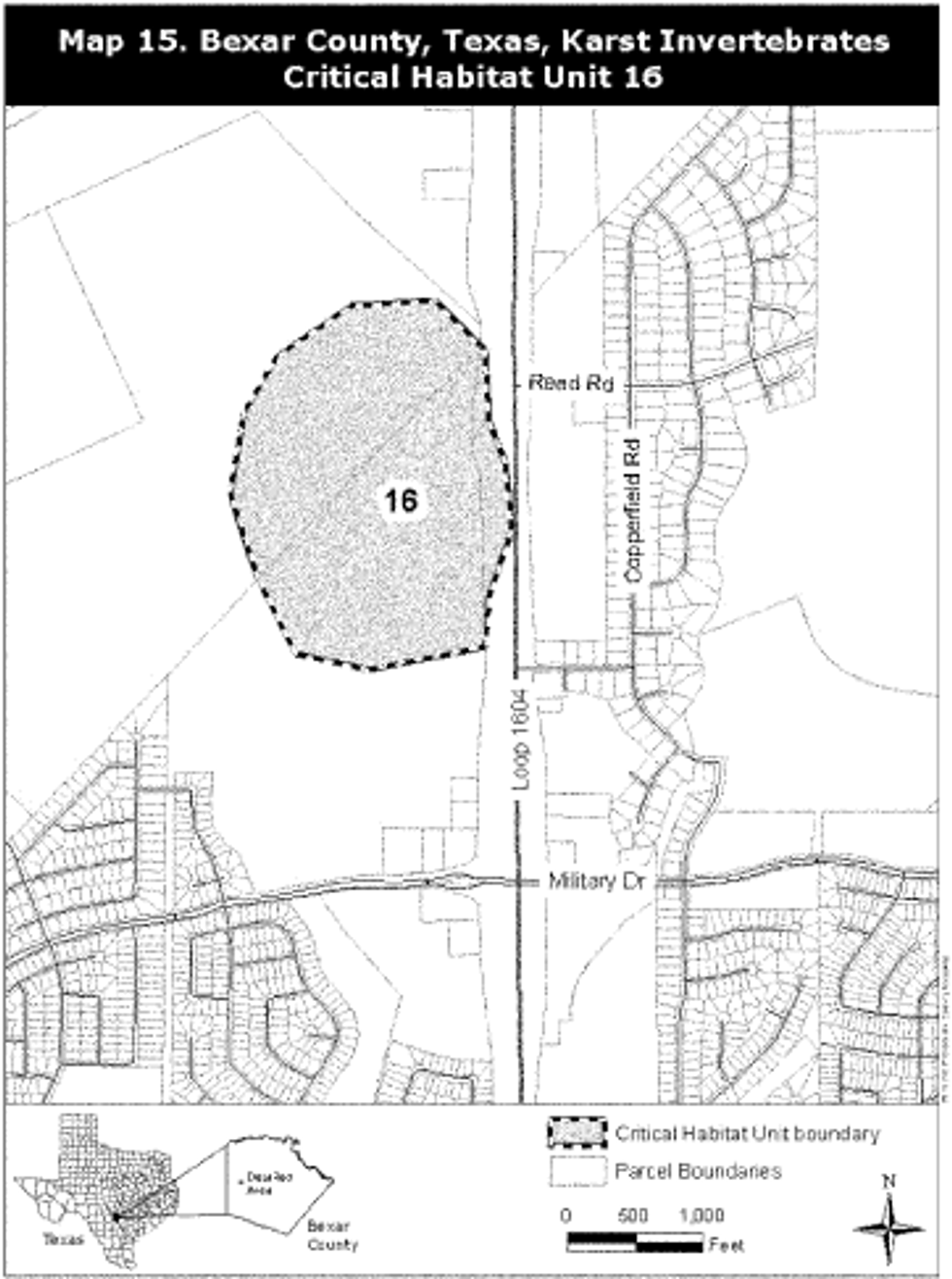
(21) Unit 17: Bexar County, Texas.
(i) [Reserved]
(ii) Map 5 of Unit 17 is provided at paragraph (8)(ii) of the entry for the Helotes mold beetle in this paragraph (i).
(22) Unit 19: Bexar County, Texas.
(i) [Reserved]
(ii) Map 16 of Unit 19 follows:
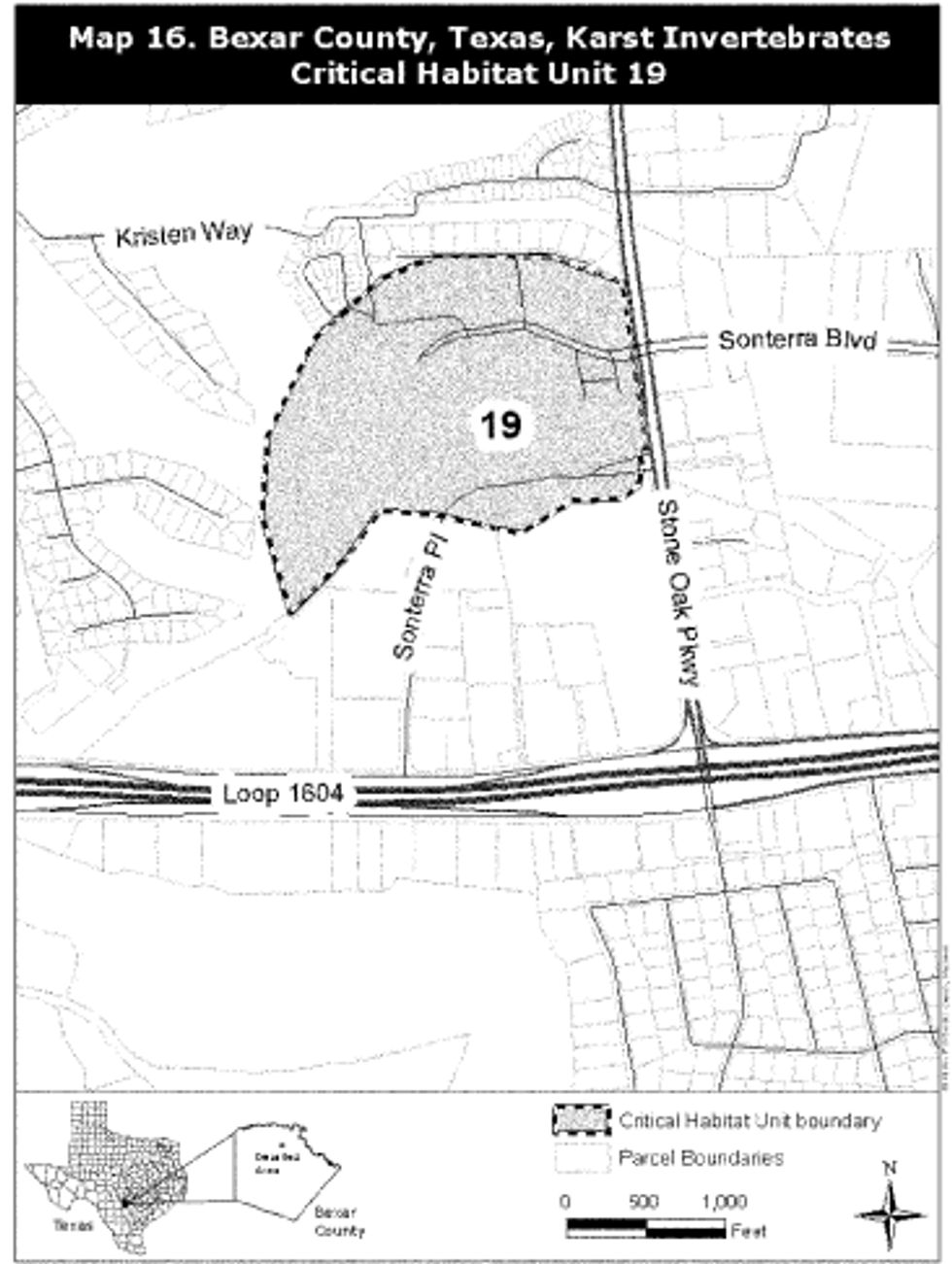
(23) Unit 23: Bexar County, Texas.
(i) [Reserved]
(ii) Map 20 of Unit 23 follows:
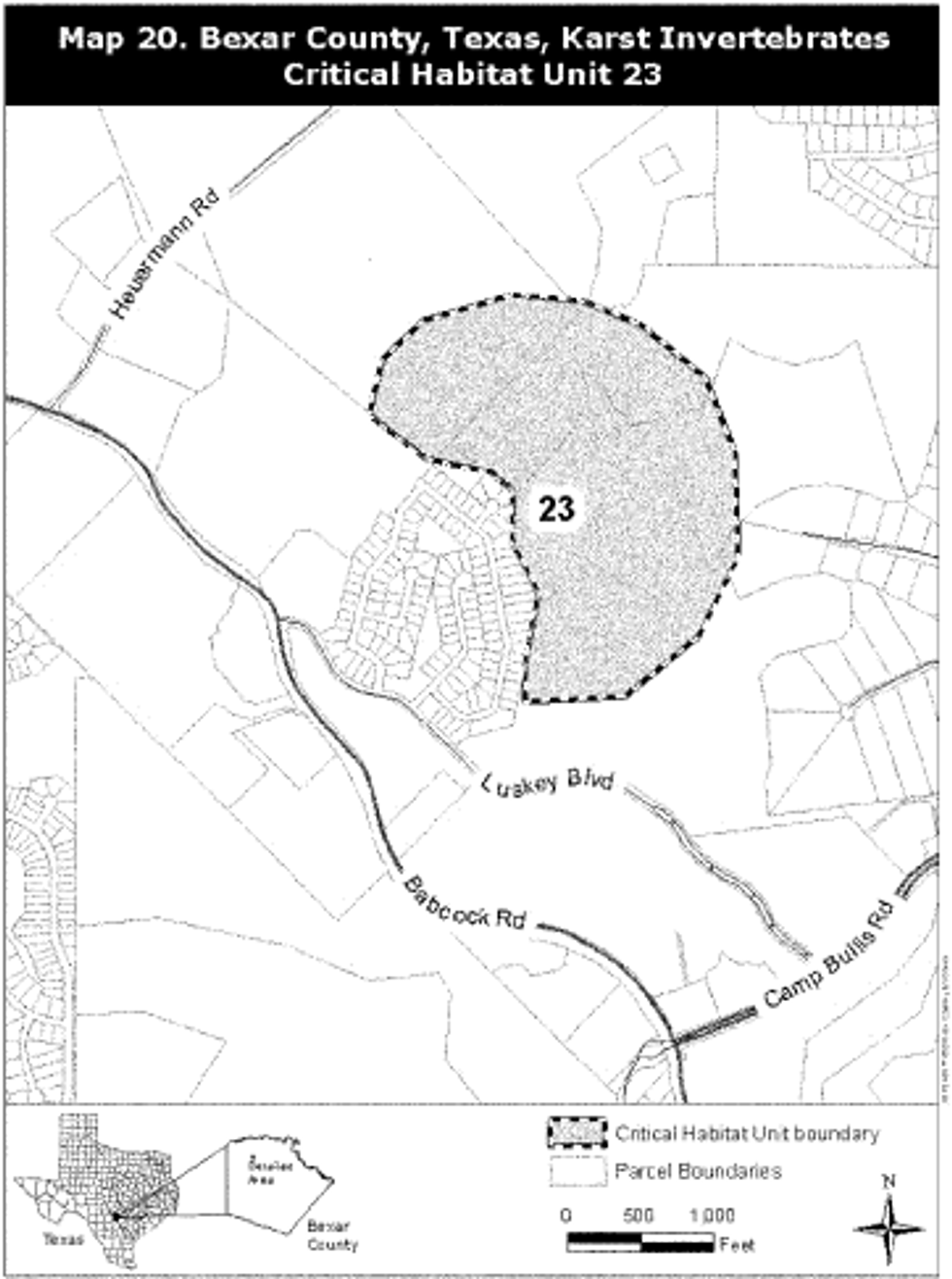
(24) Unit 26: Bexar County, Texas.
(i) [Reserved]
(ii) Map 21 of Unit 26 follows:
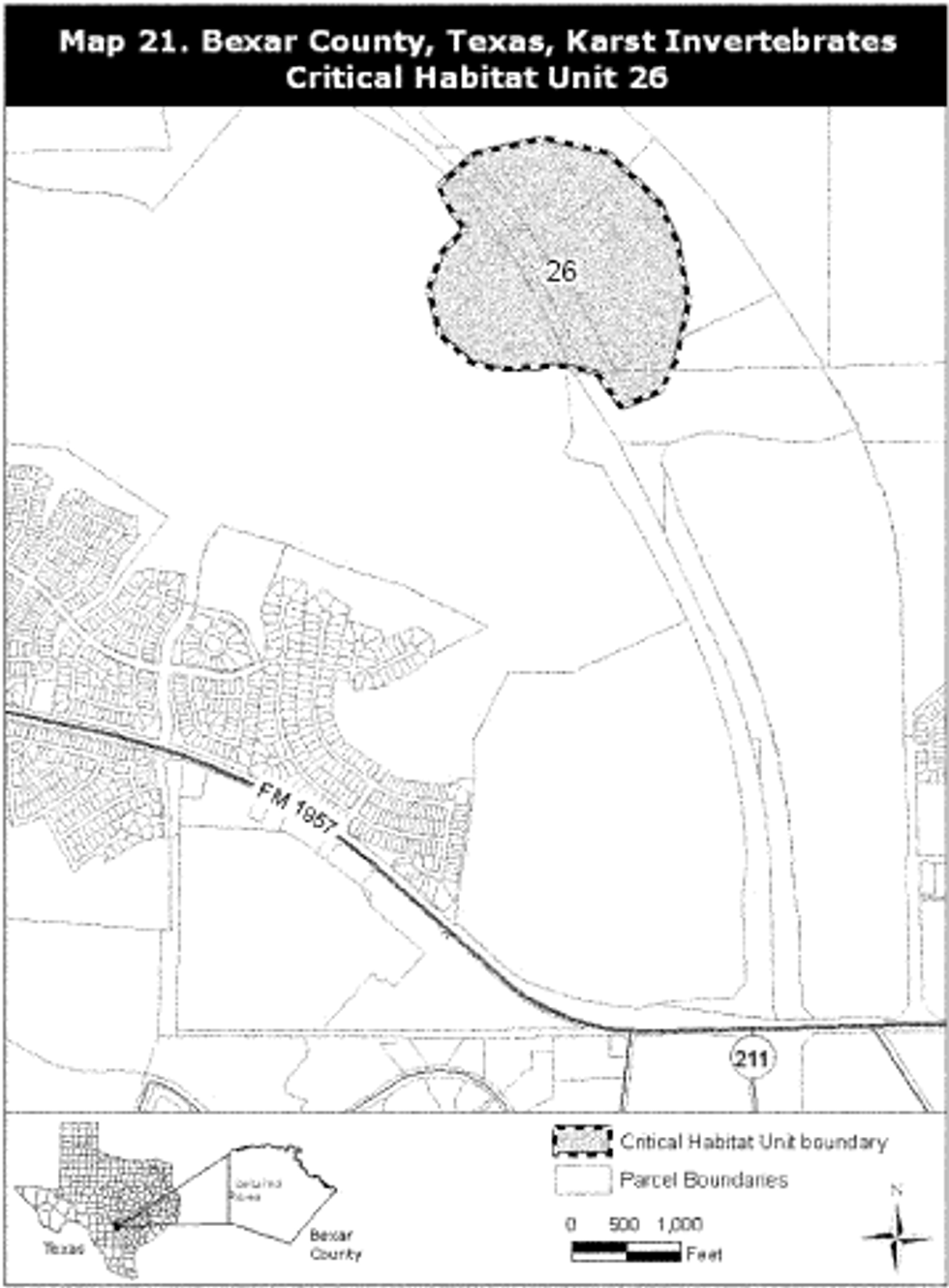
Salt Creek Tiger Beetle (Cicindela nevadica lincolniana)
(1) Critical habitat units are depicted for Lancaster and Saunders Counties, Nebraska, on the map below.
(2) Within these areas, the primary constituent elements of the physical or biological features essential to the conservation of the Salt Creek tiger beetle consist of saline barrens and seeps found within saline wetland habitat in Little Salt, Rock, Oak and Haines Branch Creeks. For our evaluation, we determined that two habitat types within suitable wetlands are required by the Salt Creek tiger beetle:
(i) Exposed mudflats associated with saline wetlands or the exposed banks and islands of streams and seeps that contain adequate soil moisture and soil salinity are essential core habitats. These habitats support egg-laying and foraging requirements. The “Salmo” soil series is the only soil type that currently supports occupied habitat; however, “Saltillo” is the other soil series that has adequate soil moisture and salinity and can also provide suitable habitat.
(ii) Vegetated wetlands adjacent to core habitats that provide shade for subspecies thermoregulation, support a source of prey for adults and larval forms of Salt Creek tiger beetles, and protect core habitats.
(3) Critical habitat does not include manmade structures (such as buildings, aqueducts, runways, roads, and other paved areas) and the land on which they are located existing within the legal boundaries on June 5, 2014.
(4) Critical habitat map units. Data layers defining map units were created using National Wetlands Inventory polygons, habitat categorization classes, and an image object analysis. The maps in this entry, as modified by any accompanying regulatory text, establish the boundaries of the critical habitat designation. The coordinates or plot points or both on which each map is based are available to the public at the Service's Internet site at http://www.fws.gov/mountain-prairie/species/invertebrates/saltcreektiger/, at http://www.regulations.gov at Docket No. FWS-R6-ES-2013-0068, and at the field office responsible for this designation. You may obtain field office location information by contacting one of the Service regional offices, the addresses of which are listed at 50 CFR 2.2.
(5) Map showing critical habitat units for the Salt Creek tiger beetle follows:
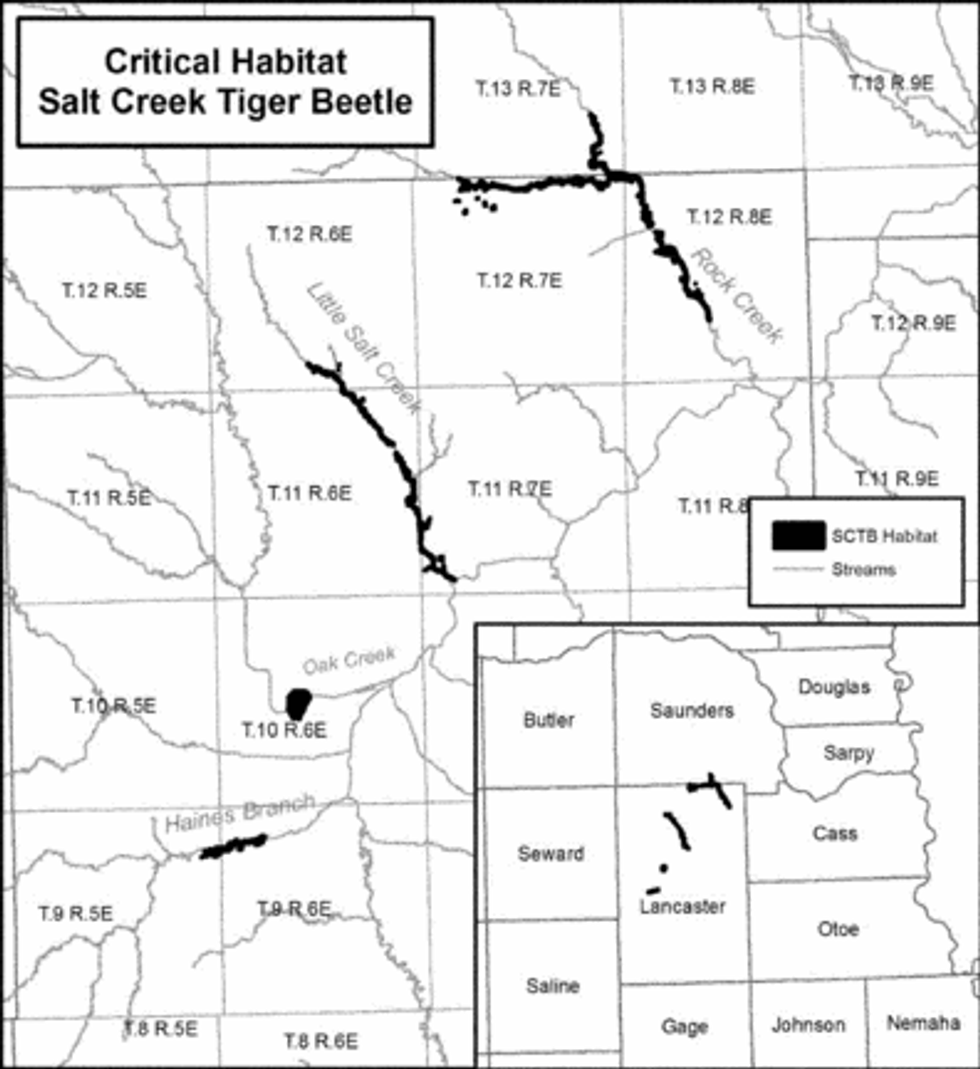
Valley Elderberry Longhorn Beetle (Desmocerus californicus dimorphus) California. Sacramento County.
(1) Sacramento Zone. An area in the city of Sacramento enclosed on the north by the Route 160 Freeway, on the west and southwest by the Western Pacific railroad tracks, and on the east by Commerce Circle and its extension southward to the railroad tracks.
Note:
The map provided is for informational purposes only. Map follows:
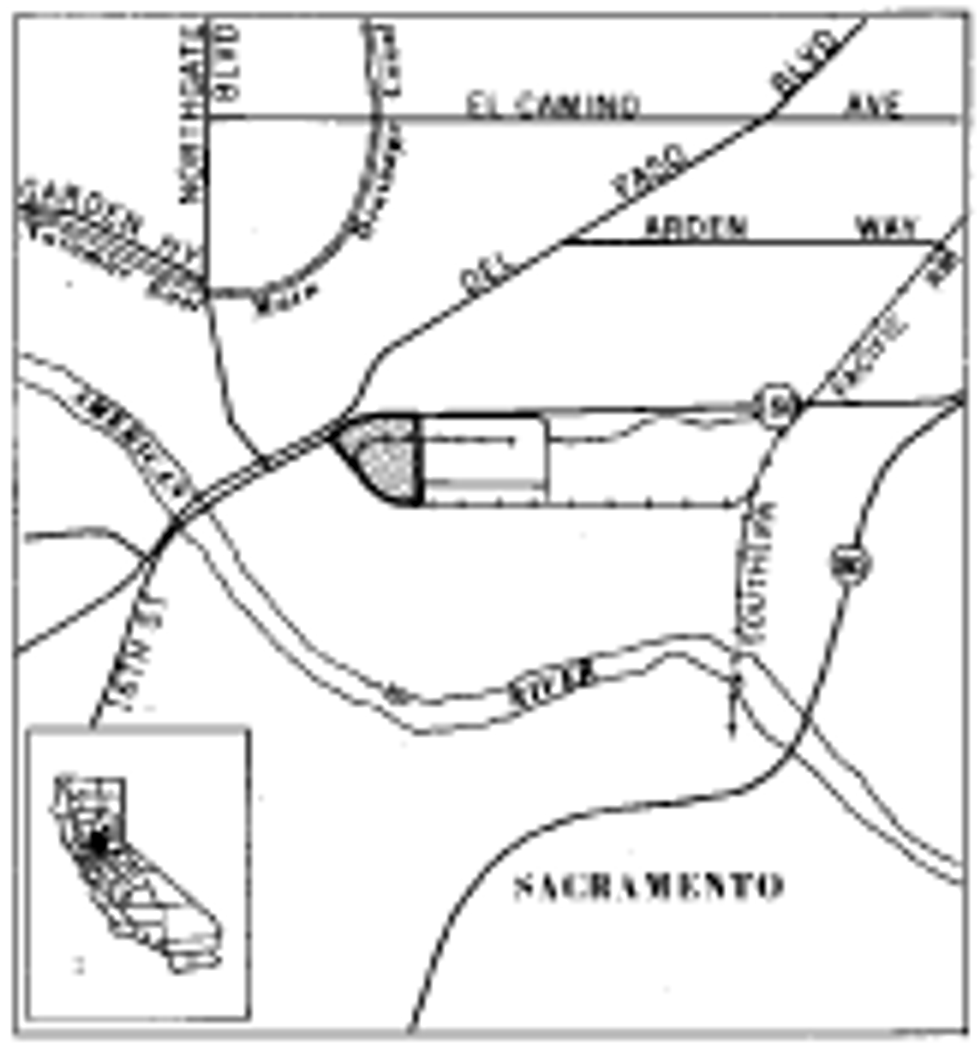
(2) American River Parkway Zone. An area of the American River Parkway on the south bank of the American River, bounded on the north by latitude 30°37′30″ N, on the west and southwest by Elmanto Drive from its junction with Ambassador Drive to its extension to latitute 38°37′30″ N, and on the south and east by Ambassador Drive and its extension north to latitude 38°37′30″ N. Goethe Park, and that portion of the American River Parkway northeast of Goethe Park, west of the Jedediah Smith Memorial Bicycle Trail, and north to a line extended eastward from Palm Drive.
Note:
The map provided is for informational purposes only. Map follows:
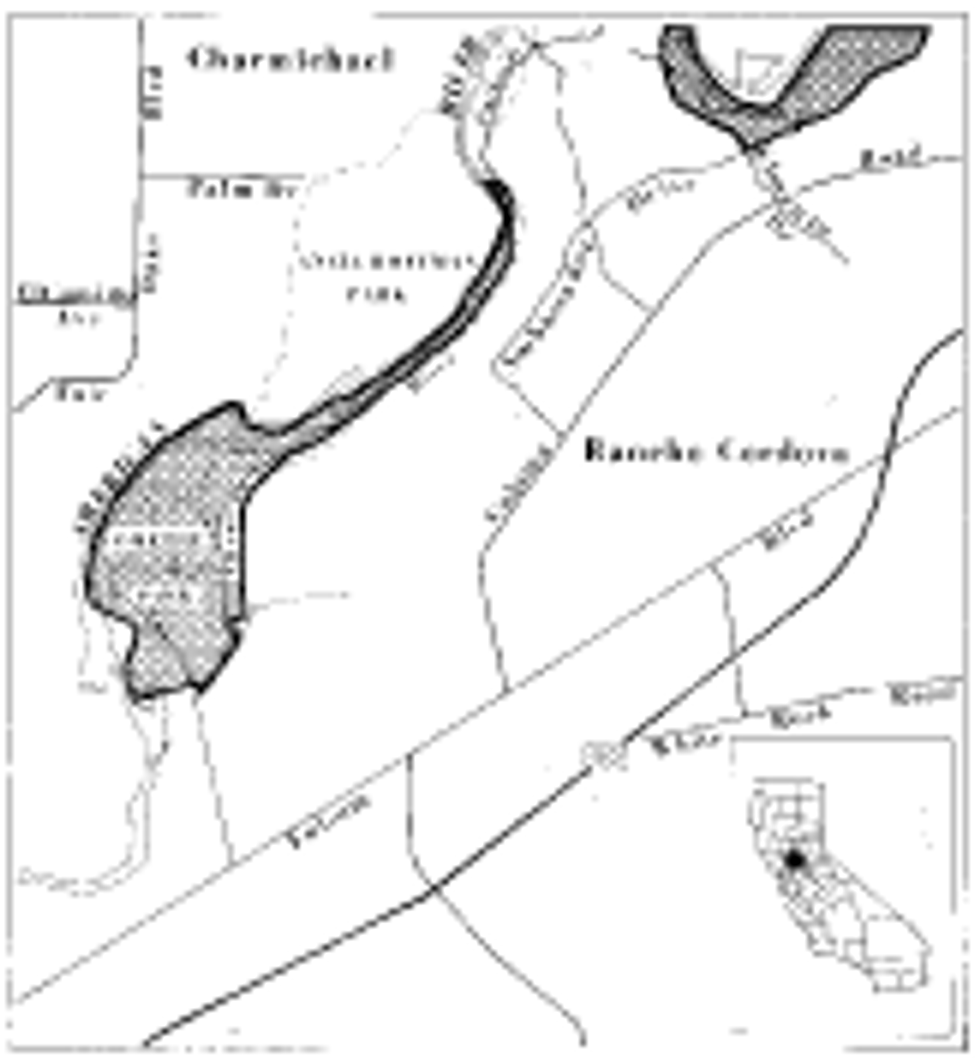
Bartram's Scrub-Hairstreak Butterfly (Strymon Acis Bartrami)
(1) Critical habitat units are depicted for Miami-Dade and Monroe Counties, Florida, on the maps below.
(2) Within these areas, the primary constituent elements of the physical or biological features essential to the conservation of the Bartram's scrub-hairstreak butterfly are:
(i) Areas of pine rockland habitat, and in some locations, associated rockland hammocks and hydric pine flatwoods.
(A) Pine rockland habitat contains:
(1) Open canopy, semi-open subcanopy, and understory.
(2) Substrate of oolitic limestone rock.
(3) A plant community of predominately native vegetation.
(B) Rockland hammock habitat associated with the pine rocklands contains:
(1) Canopy gaps and edges with an open semi-open canopy, subcanopy, and understory.
(2) Substrate with a thin layer of highly organic soil covering limestone or organic matter that accumulates on top of the underlying limestone rock.
(3) A plant community of predominately native vegetation.
(C) Hydric pine flatwood habitat associated with the pine rocklands contains:
(1) Open canopy with a sparse or absent subcanopy, and dense understory.
(2) Substrate with a thin layer of poorly drained sands and organic materials that accumulates on top of the underlying limestone or calcareous rock.
(3) A plant community of predominately native vegetation.
(ii) Competitive nonnative plant species in quantities low enough to have minimal effect on survival of Bartram's scrub-hairstreak butterfly.
(iii) The presence of the butterfly's hostplant, pineland croton, in sufficient abundance for larval recruitment, development, and food resources, and for adult butterfly nectar source and reproduction;
(iv) A dynamic natural disturbance regime or one that artificially duplicates natural ecological processes (e.g. fire, hurricanes or other weather events, at appropriate intervals) that maintains the pine rockland habitat and associated rockland hammock and hydric pine flatwood plant communities.
(v) Pine rockland habitat and associated rockland hammock and hydric pine flatwood plant communities that allow for connectivity and are sufficient in size to sustain viable populations of Bartram's scrub hairstreak butterfly.
(vi) Pine rockland habitat and associated rockland hammock and hydric pine flatwood plant communities with levels of pesticide low enough to have minimal effect on the survival of the butterfly or its ability to occupy the habitat.
(3) Critical habitat does not include manmade structures (such as buildings, aqueducts, runways, roads, and other paved areas) and the land on which they are located existing within the legal boundaries on September 11, 2014.
(4) Critical habitat map units. Data layers defining map units were created using ESRI ArcGIS mapping software along with various spatial data layers. ArcGIS was also used to calculate the size of habitat areas. The projection used in mapping and calculating distances and locations within the units was North American Albers Equal Area Conic, NAD 83. The maps in this entry, as modified by any accompanying regulatory text, establish the boundaries of the critical habitat designation. The coordinates, plot points, or both on which each map is based are available to the public at the Service's Internet site (http://www.fws.gov/verobeach/), the Federal eRulemaking Portal (http://www.regulations.gov at Docket No. FWS-R4-ES-2013-0031), and at the field office responsible for this designation. You may obtain field office location information by contacting one of the Service regional offices, the addresses of which are listed at 50 CFR 2.2.
(5) Index map of all critical habitat units for the Bartram's scrub-hairstreak butterfly follows:
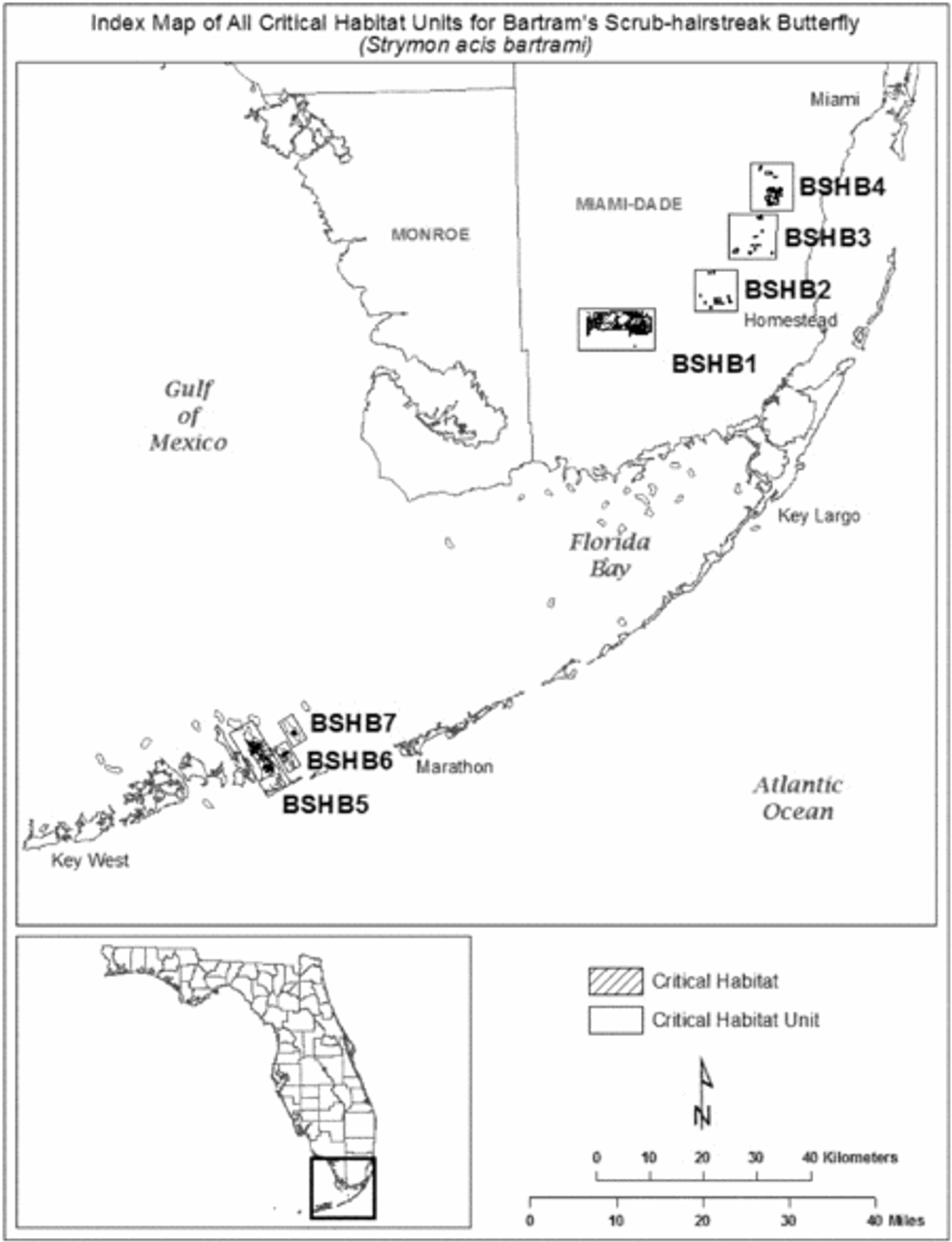
(6) Unit BSHB1: Everglades National Park, Miami-Dade County, Florida.
(i) General description: Unit BSHB1 consists of 3,235 ha (7,994 ac) in Miami-Dade County and is composed entirely of lands in Federal ownership, 100 percent of which are located within the Long Pine Key region of Everglades National Park.
(ii) Map of Unit BSHB1 follows:
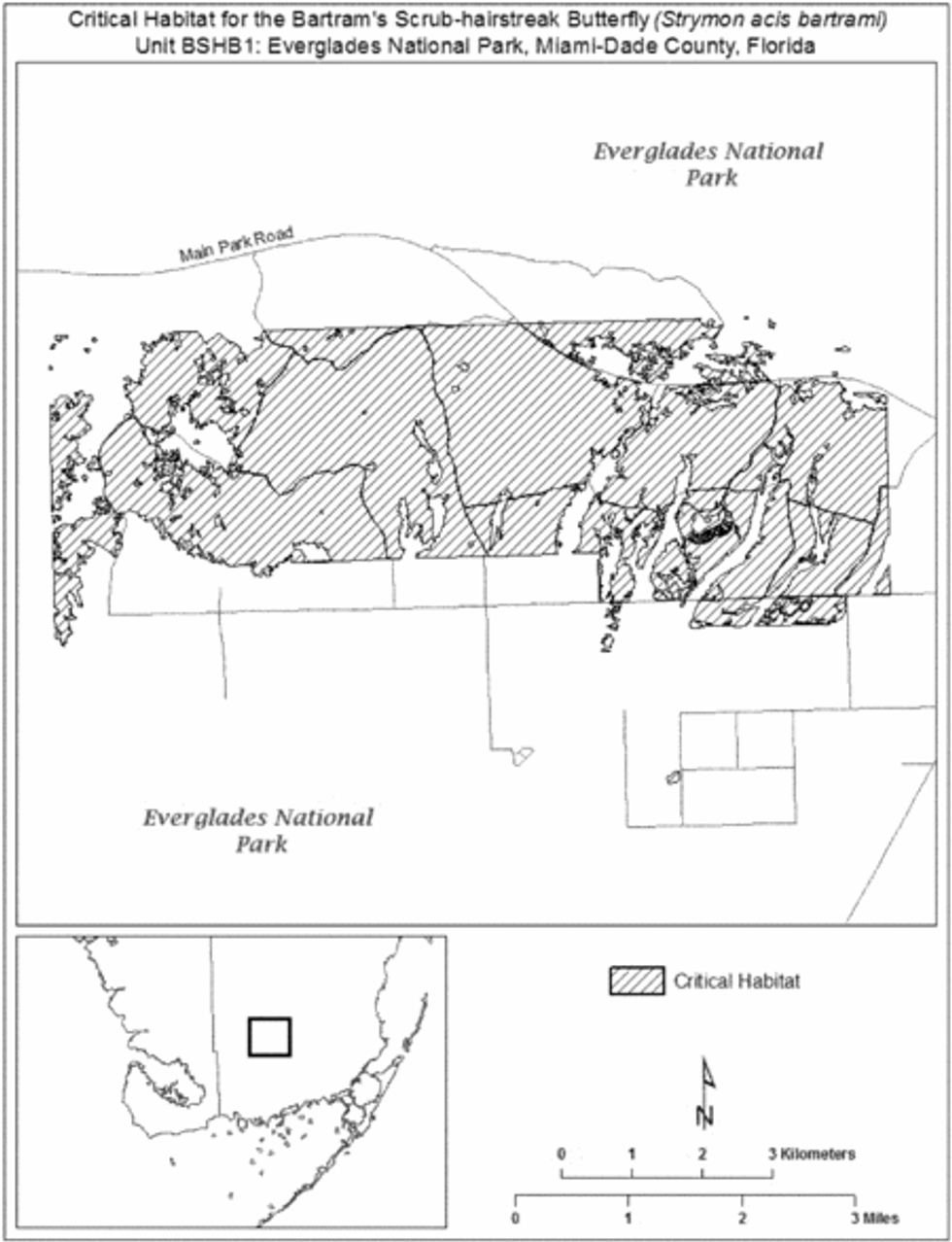
(7) Unit BSHB2: Navy Wells Pineland Preserve, Miami-Dade County, Florida.
(i) General description: Unit BSHB2 consists of 203 ha (502 ac) in Miami-Dade County and is composed of lands in State (62 ha (153 ac)), and private or other ownership (141 ha (349 ac)), including the County and State-owned Navy Wells Pineland Preserve.
(ii) Map of Unit BSHB2 follows:
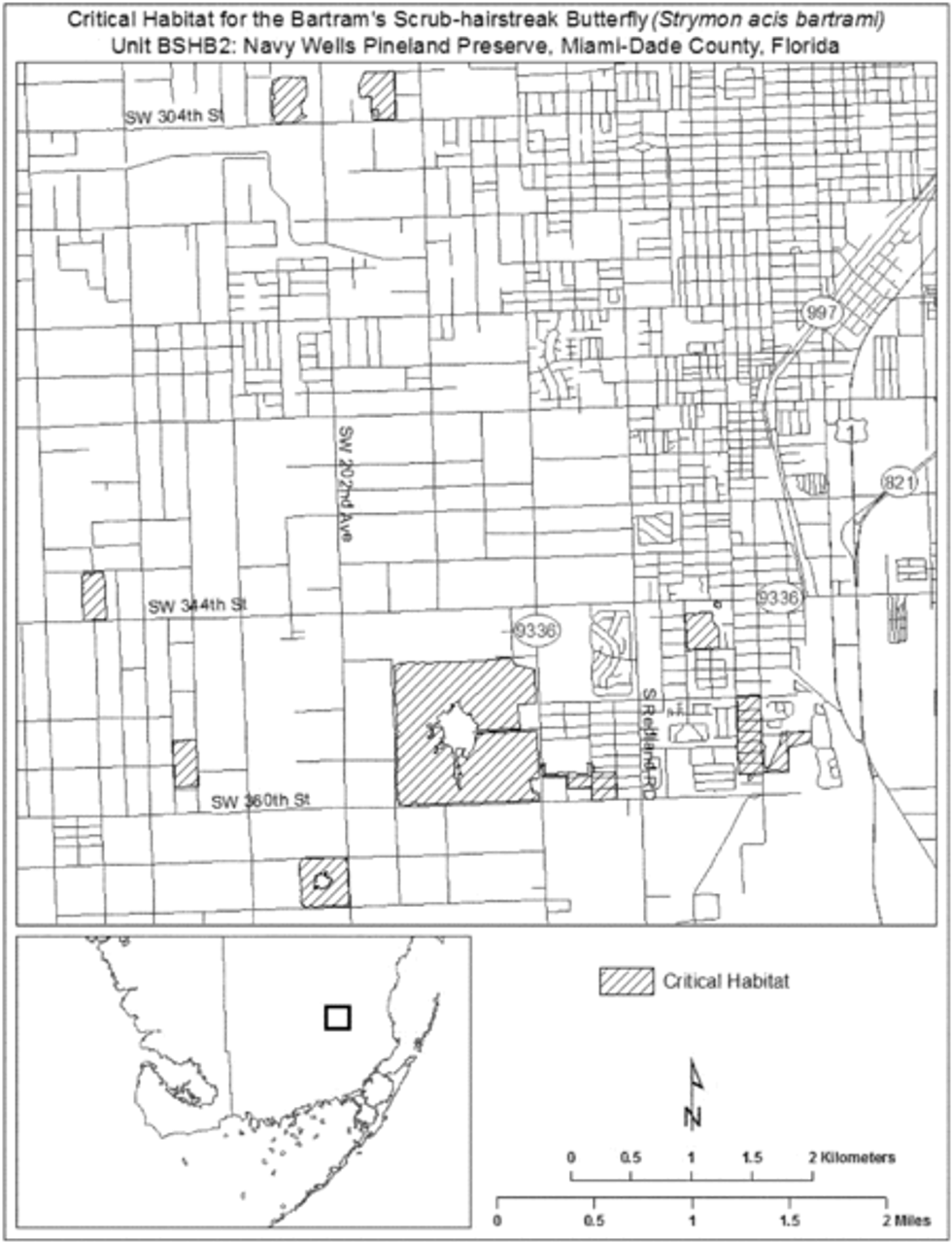
(8) Unit BSHB3: Camp Owaissa Bauer, Miami-Dade County, Florida.
(i) General description: Unit BSHB3 consists of 146 ha (359 ac) in Miami-Dade County and is comprised of lands in State (29 ha (71 ac)) and private or other ownership (117 ha (288 ac)), including 40 ha (99 ac) of Miami-Dade County-owned Camp Owaissa Bauer.
(ii) Map of Unit BSHB3 follows:
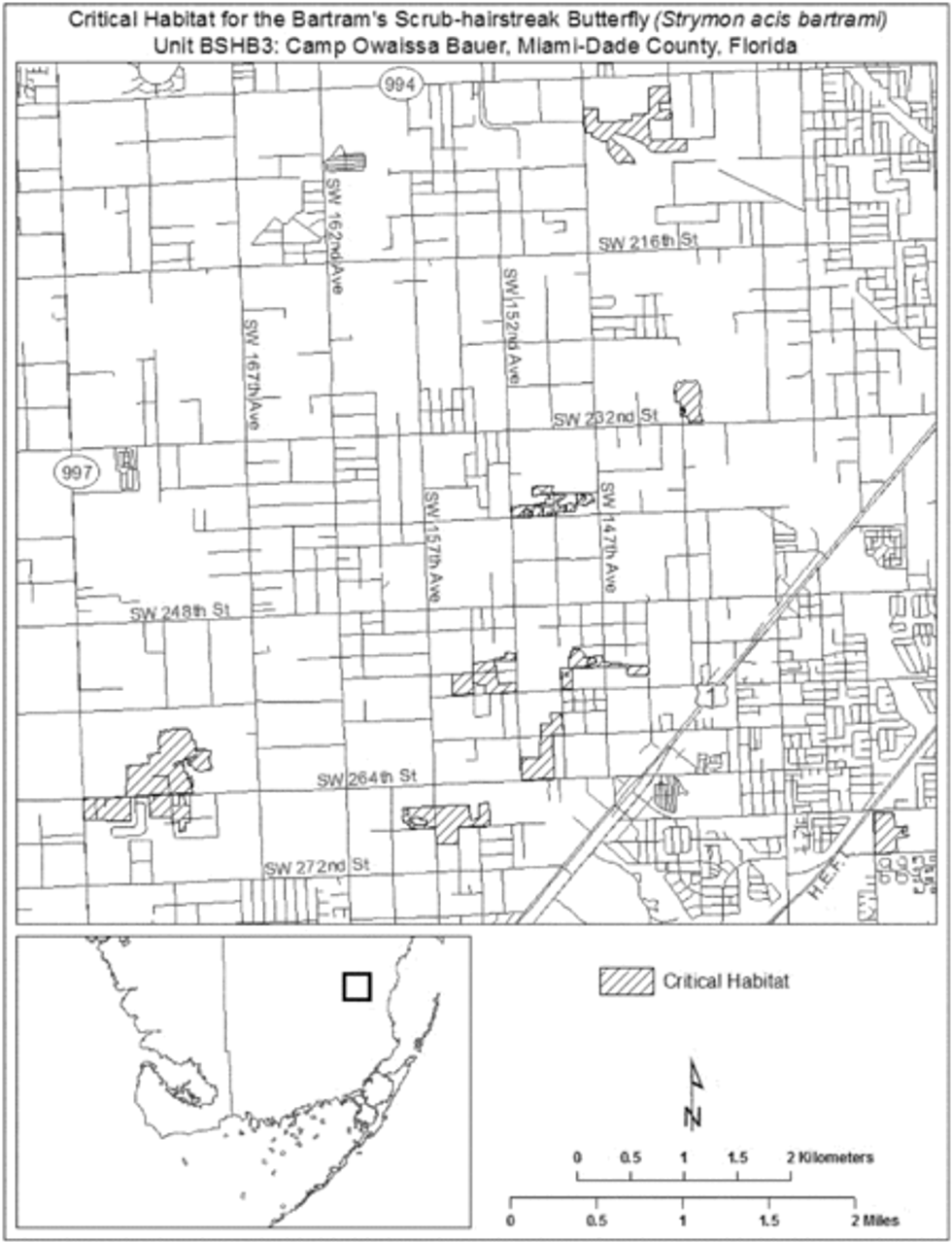
(9) Unit BSHB4: Richmond Pine Rocklands, Miami-Dade County, Florida.
(i) General description: Unit BSHB4 consists of 438 ha (1,082 ac) in Miami-Dade County and is composed of lands in Federal (U. S. Coast Guard, U.S. Army Corps of Engineers, Federal Bureau of Prisons, and National Oceanic and Atmospheric Administration (50 ha (122 ac)), State (32 ha (79 ac)) and private or other (356 ha (881 ac)) ownership.
(ii) Index map of Unit BSHB4 follows:
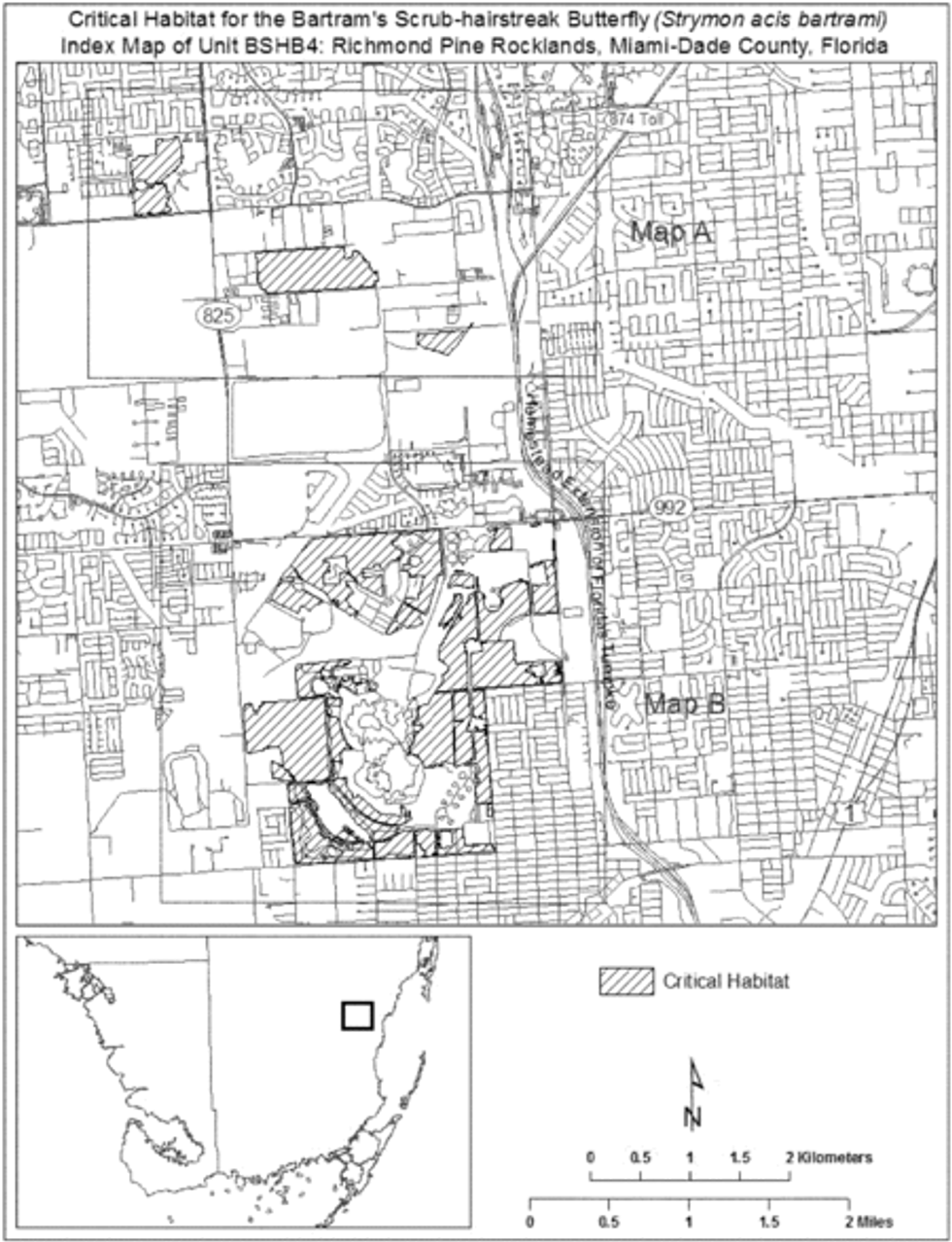
(A) Map A of Unit BSHB4 follows:
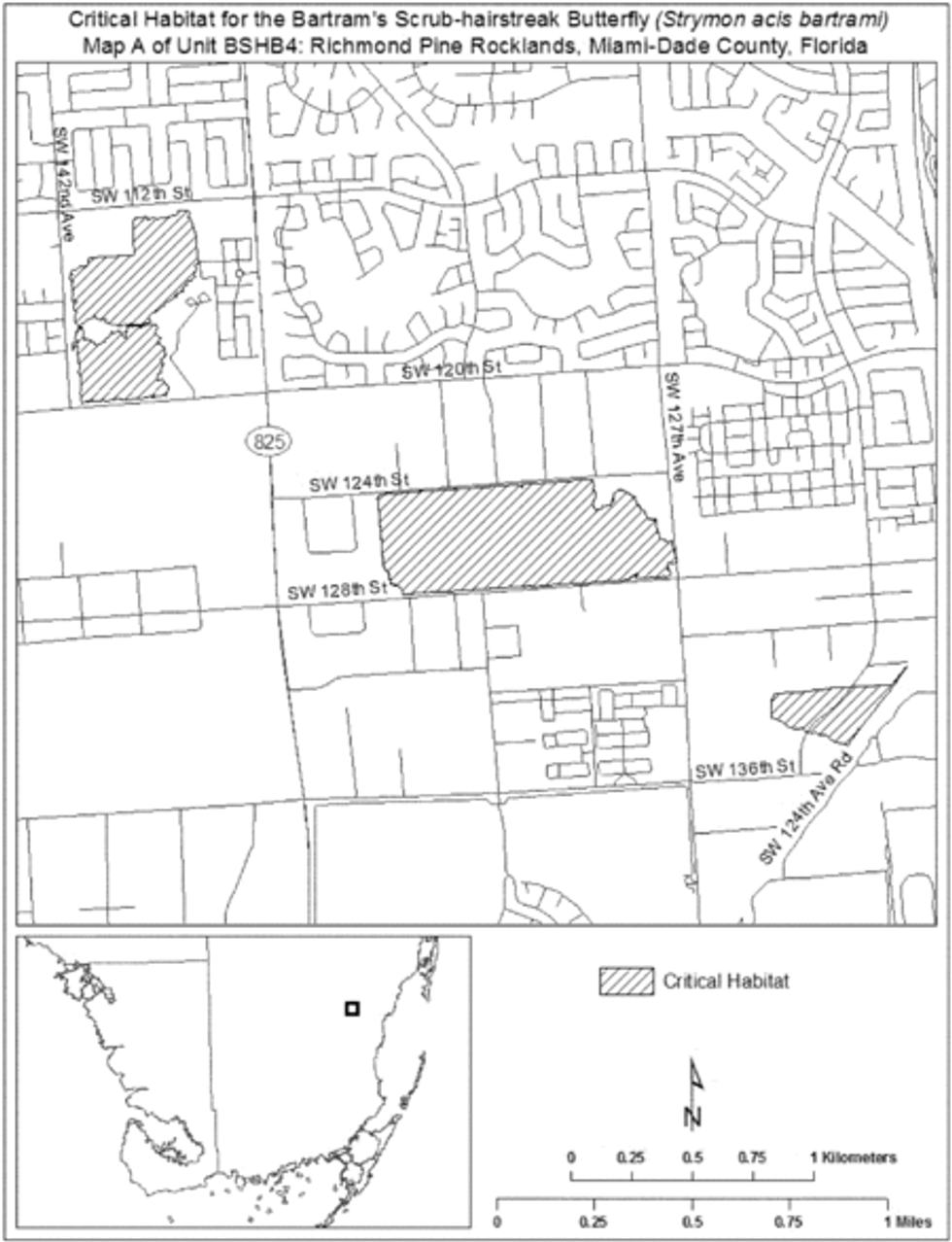
(B) Map B of Unit BSHB4 follows:
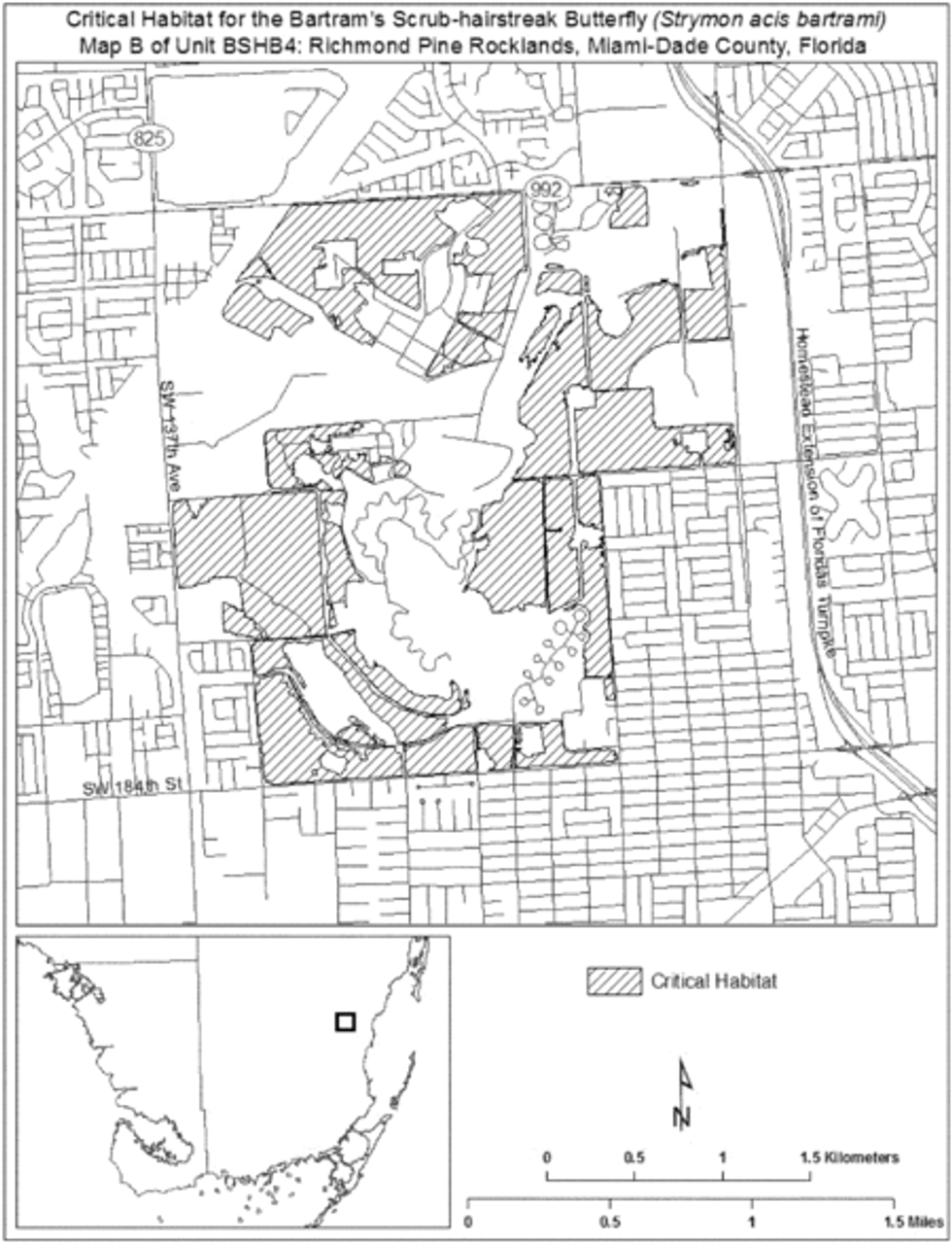
(10) Unit BSHB5: Big Pine Key, Monroe County, Florida.
(i) General description: Unit BSHB5 consists of 559 ha (1,382 ac) in Monroe County and is composed of lands in National Key Deer Refuge (NKDR) (365 ha (901 ac)), State ownership (90 ha (223 ac)), and private or other ownership (104 ha (258 ac)). State lands are interspersed within NKDR lands and managed as part of the Refuge.
(ii) Index map of Unit BSHB5 follows:
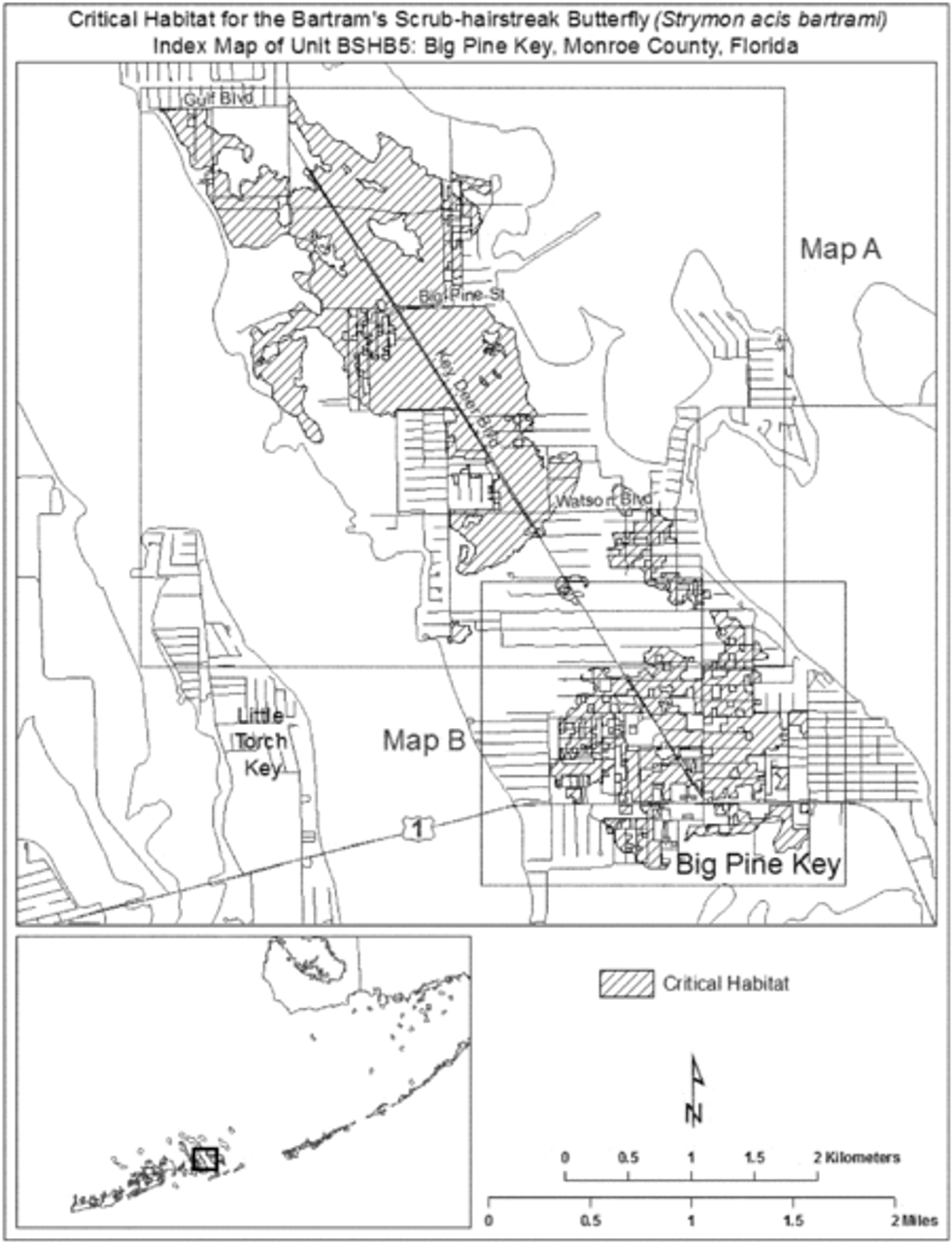
(A) Map A of Unit BSHB5 follows:
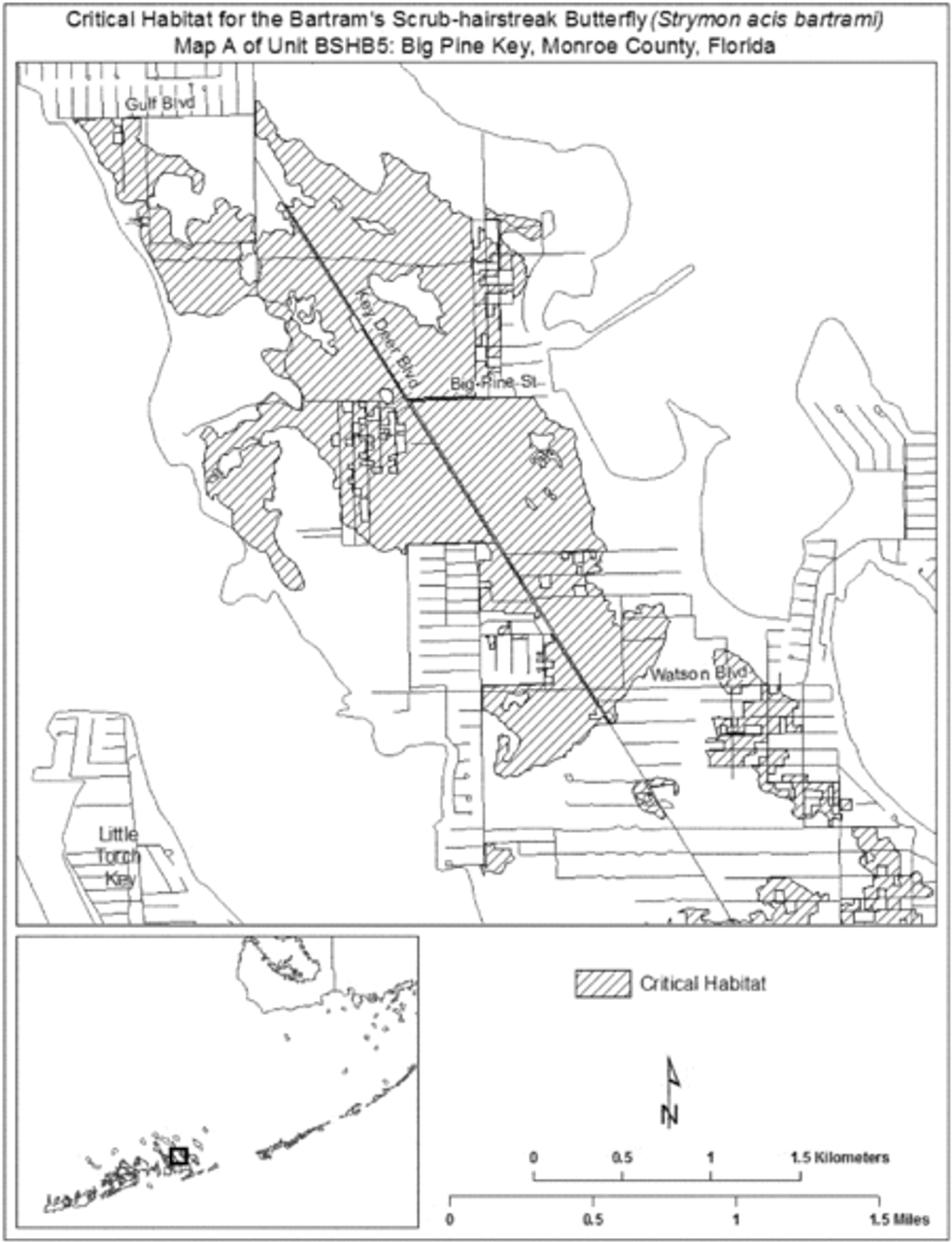
(B) Map B of Unit BSHB5 follows:
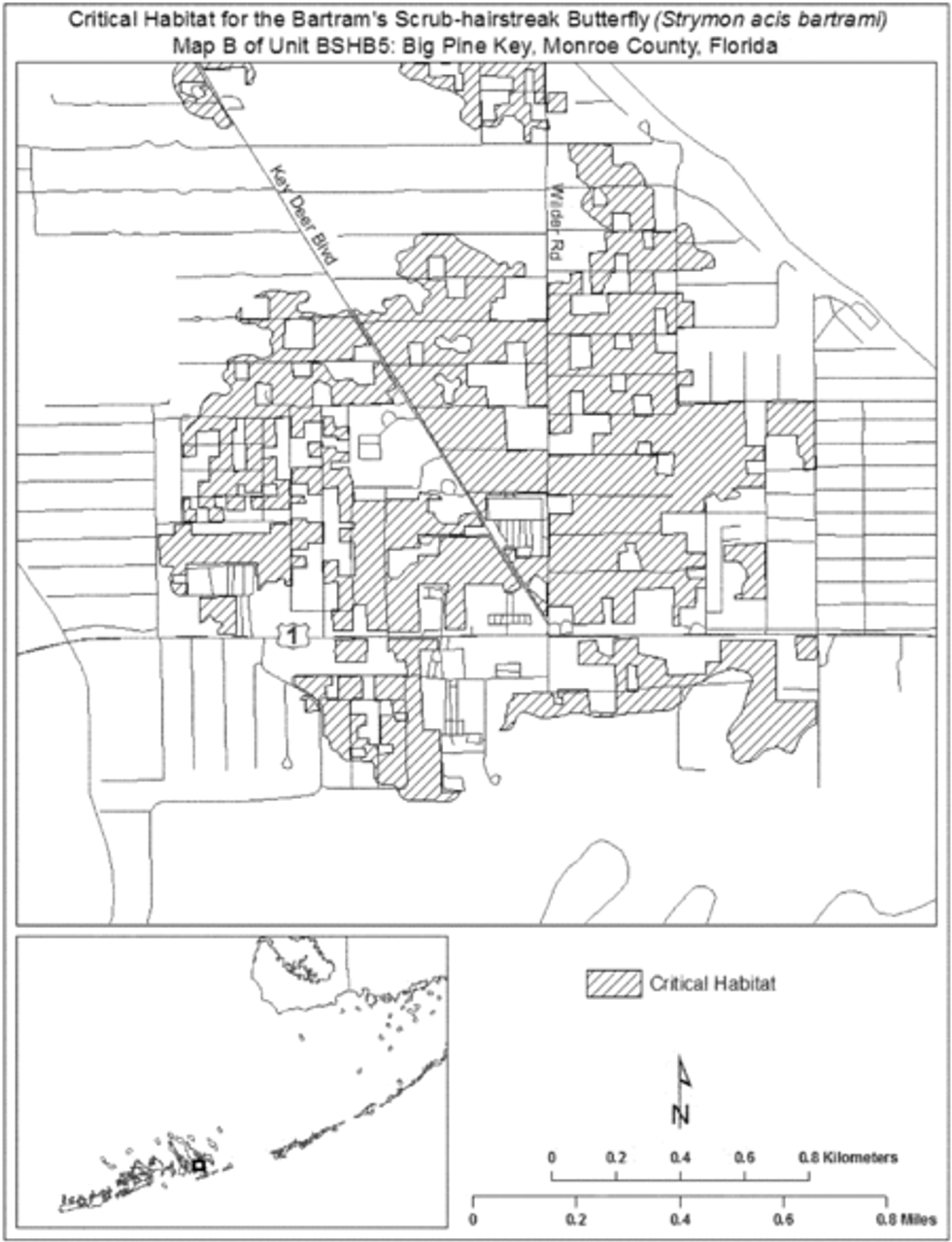
(11) Unit BSHB6: No Name Key, Monroe County, Florida.
(i) General description: Unit BSHB6 consists of 50 ha (123 ac) in Monroe County and is composed of lands in National Key Deer Refuge (NKDR) (30 ha (75 ac)), State ownership (9 ha (22 ac)), and private or other ownership (11 ha (26 ac)). State lands are interspersed within NKDR lands and managed as part of the Refuge.
(ii) Map of Unit BSHB6 follows:
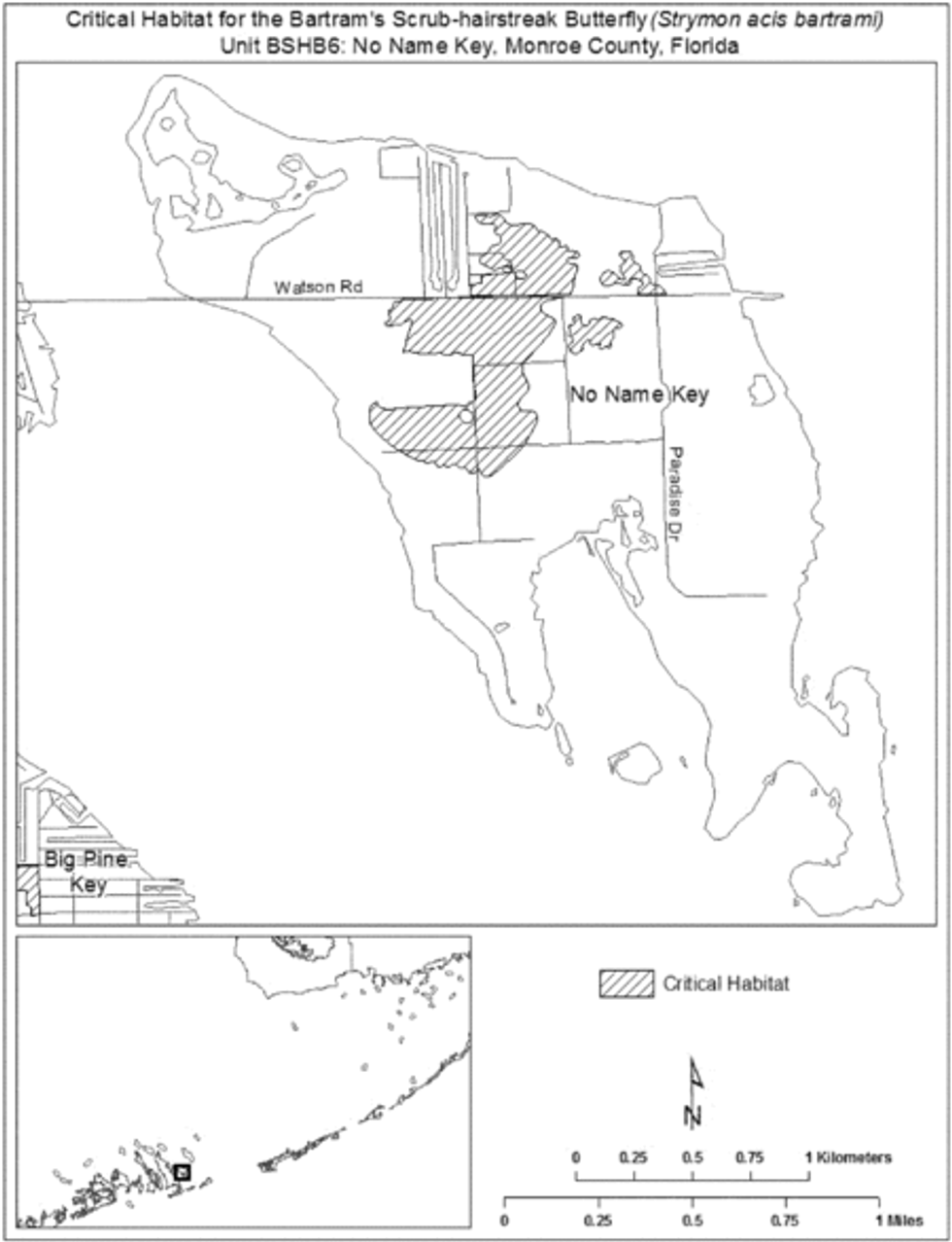
(12) Unit BSHB 7: Little Pine Key, Monroe County, Florida.
(i) General description: Unit BSHB7 consists of 39 ha (97 ac) in Monroe County. This unit is composed entirely of lands in Federal ownership, 100 percent of which are located within National Key Deer Refuge.
(ii) Map of Unit BSHB7 follows:
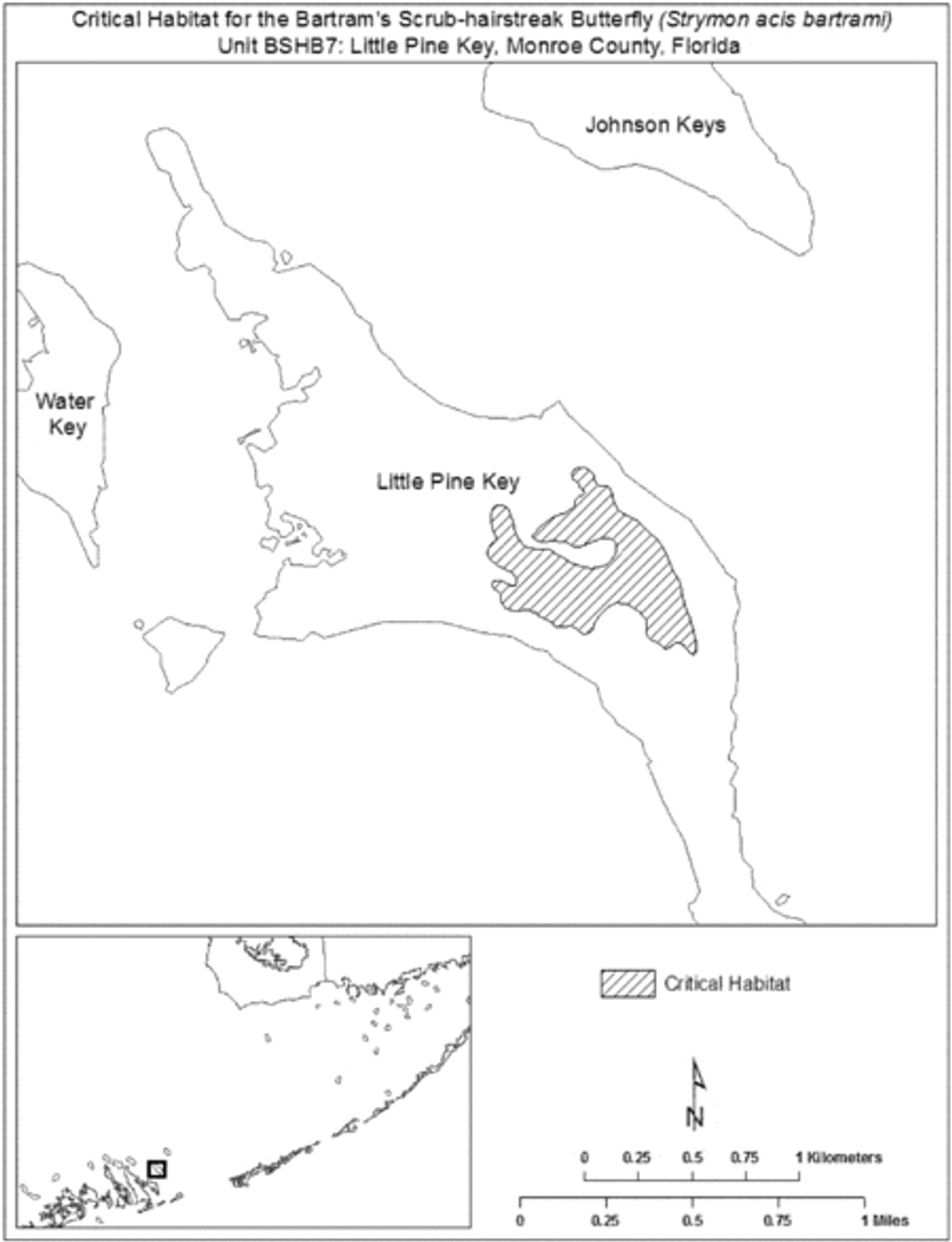
Bay Checkerspot Butterfly (Euphydryas editha bayensis)
(1) Critical habitat units are depicted for San Mateo and Santa Clara Counties, California, on the maps below.
(2) The primary constituent elements of critical habitat for the Bay checkerspot butterfly are the habitat components that provide:
(i) The presence of annual or perennial grasslands with little to no overstory that provide north-south and east-west slopes with a tilt of more than 7 degrees for larval host plant survival during periods of atypical weather (for example, drought). Common grassland species include wild oats (Avena fatua), soft chess (Bromus hordeaceus), California oatgrass (Danthonia californica), purple needlegrass (Nassella pulchra), and Idaho fescue (Festuca idahoensis); less abundant in these grasslands are annual and perennial forbs such as filaree (Erodium botrys), true clovers (Trifolium sp.), dwarf plantain (Plantago erecta), and turkey mullein (Croton setigerus). These species, with the exception of dwarf plantain, are not required by the Bay checkerspot butterfly, but merely are provided here as an example of species commonly found in California grasslands.
(ii) The presence of the primary larval host plant, dwarf plantain (Plantago erecta), and at least one of the secondary host plants, purple owl's-clover (Castilleja densiflora) or exserted paintbrush (Castilleja exserta), are required for reproduction, feeding, and larval development.
(iii) The presence of adult nectar sources for feeding. Common nectar sources include desertparsley (Lomatium spp.), California goldfields (Lasthenia californica), tidy-tips (Layia platyglossa), sea muilla (Muilla maritima), scytheleaf onion (Allium falcifolium), false babystars (Linanthus androsaceus), and intermediate fiddleneck (Amsinckia intermedia).
(iv) Soils derived from serpentinite ultramafic rock (Montara, Climara, Henneke, Hentine, and Obispo soil series) or similar soils (Inks, Candlestick, Los Gatos, Fagan, and Barnabe soil series) that provide areas with fewer aggressive, nonnative plant species for larval host plant and adult nectar plant survival and reproduction.
(v) The presence of stable holes and cracks in the soil, and surface rock outcrops that provide shelter for the larval stage of the Bay checkerspot butterfly during summer diapause.
(3) Critical habitat does not include manmade structures (such as buildings, aqueducts, runways, roads, and other paved areas) and the land on which they are located existing on the effective date of this rule and not containing one or more of the primary constituent elements.
(4) Critical habitat map units. Data layers defining map units were created on a base of USGS 7.5′ quadrangles using USDA National Agricultural Imagery Program (NAIP) county-wide MrSID compressed mosaics of 1 meter resolution and natural color aerial photography from summer 2005. Critical habitat units were then mapped using Universal Transverse Mercator (UTM) zone 10, North American Datum (NAD) 1983 coordinates.
(5) Note: Index map for Bay checkerspot butterfly critical habitat units follows:
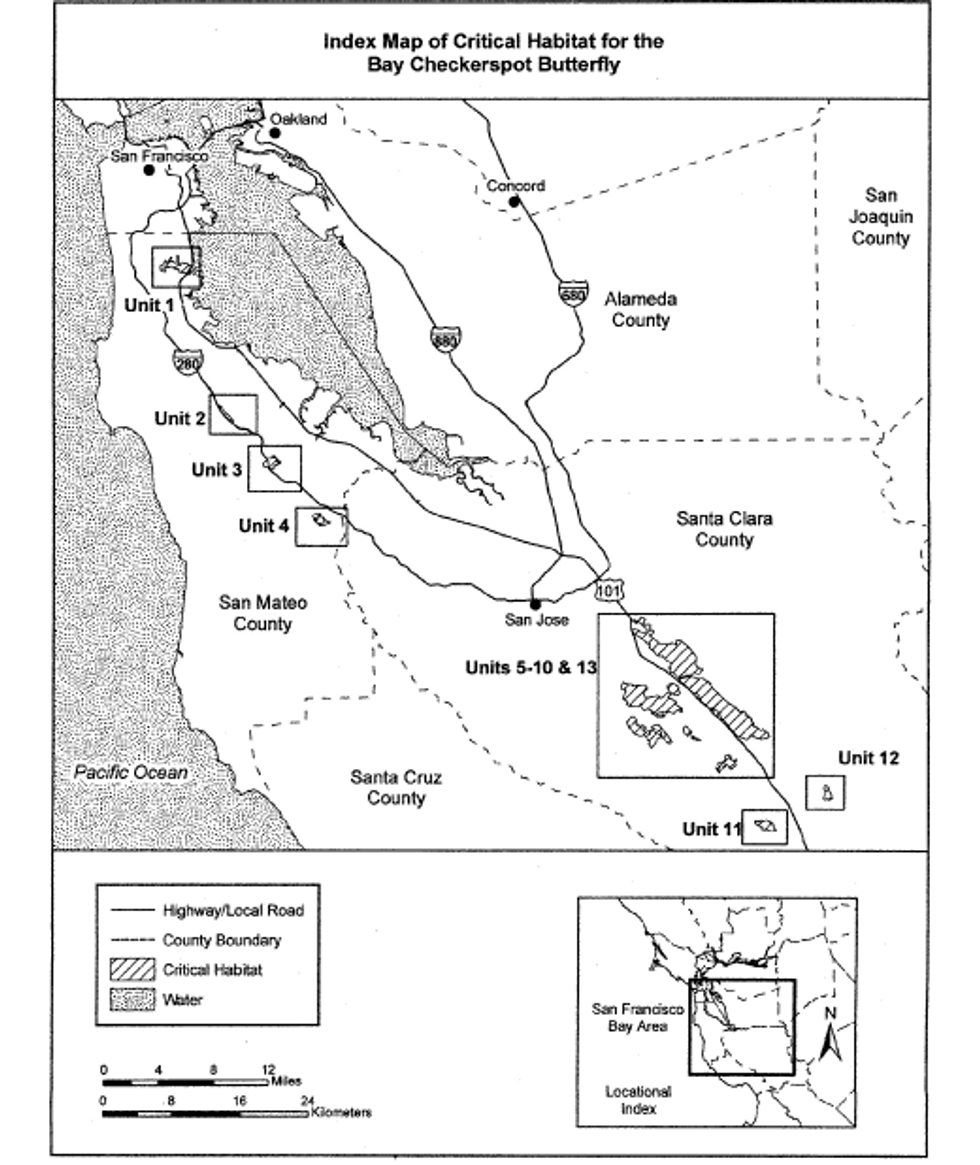
(6) Unit 1: San Bruno Mountain, San Mateo County, California. From USGS 1:24,000 scale quadrangle San Francisco South.
(i) [Reserved]
(ii) Map of Unit 1 for Bay checkerspot butterfly follows:
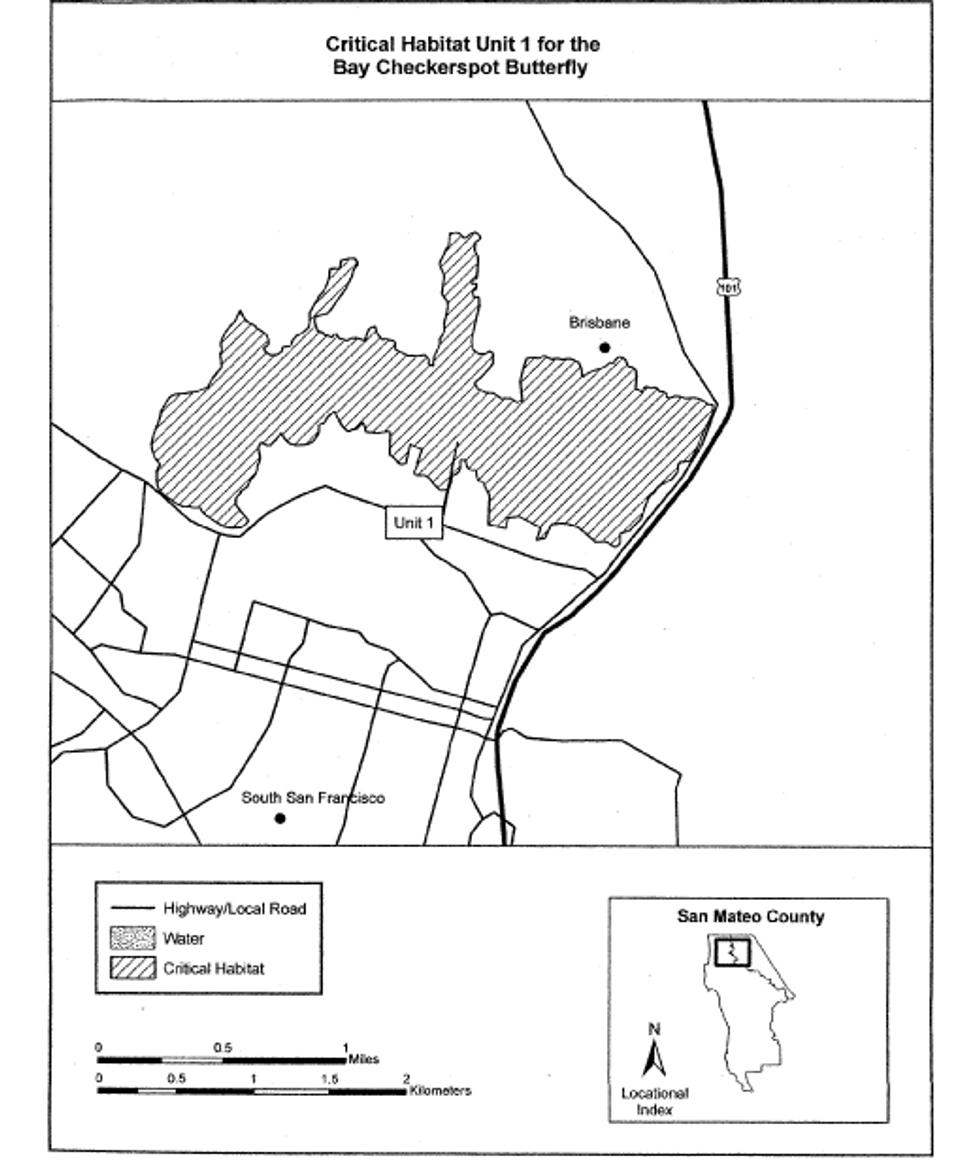
(7) Unit 2: Pulgas Ridge, San Mateo County, California. From USGS 1:24,000 scale quadrangle San Mateo.
(i) [Reserved]
(ii) Map of Unit 2 for Bay checkerspot butterfly follows:
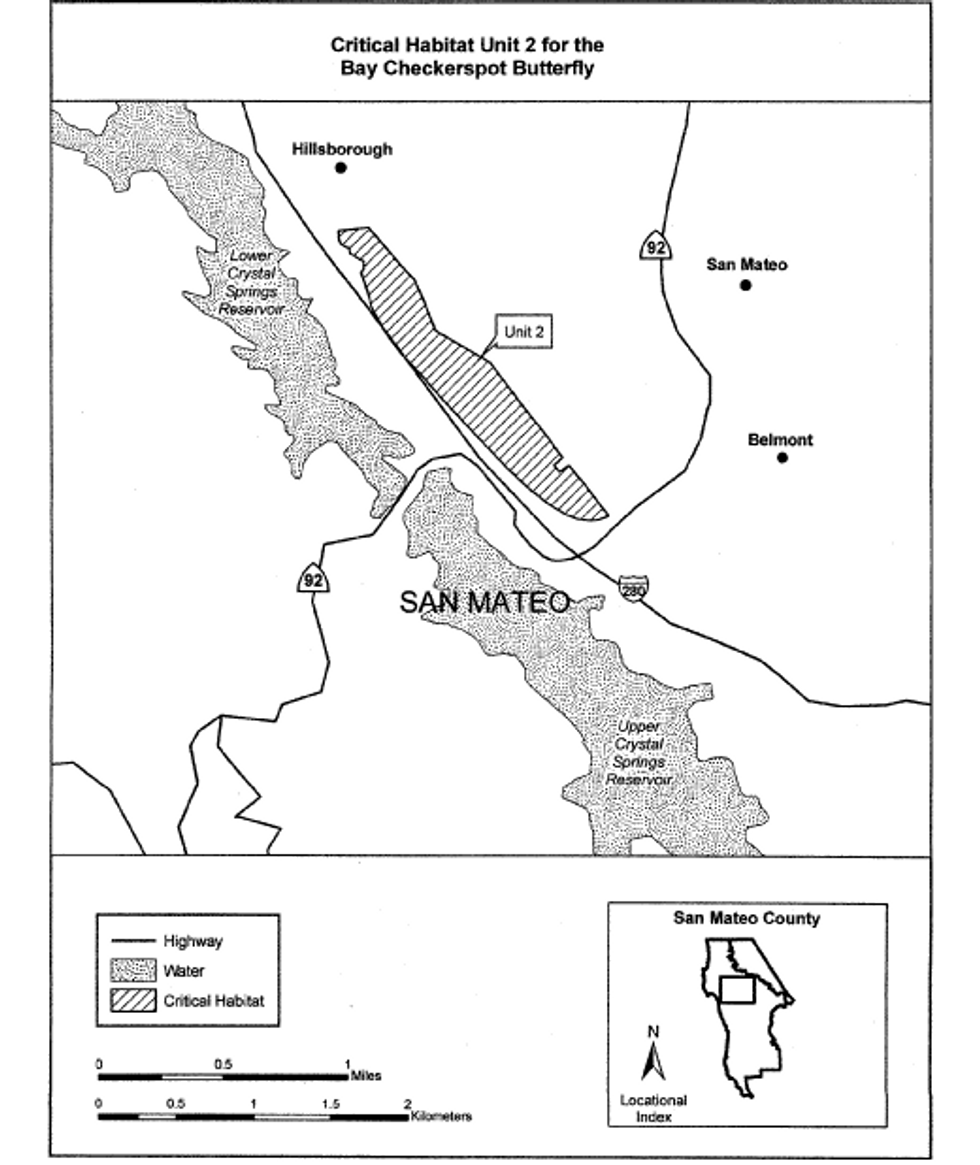
(8) Unit 3: Edgewood Park, San Mateo County, California. From USGS 1:24,000 scale quadrangle Woodside.
(i) [Reserved]
(ii) Map of Unit 3 for Bay checkerspot butterfly follows:
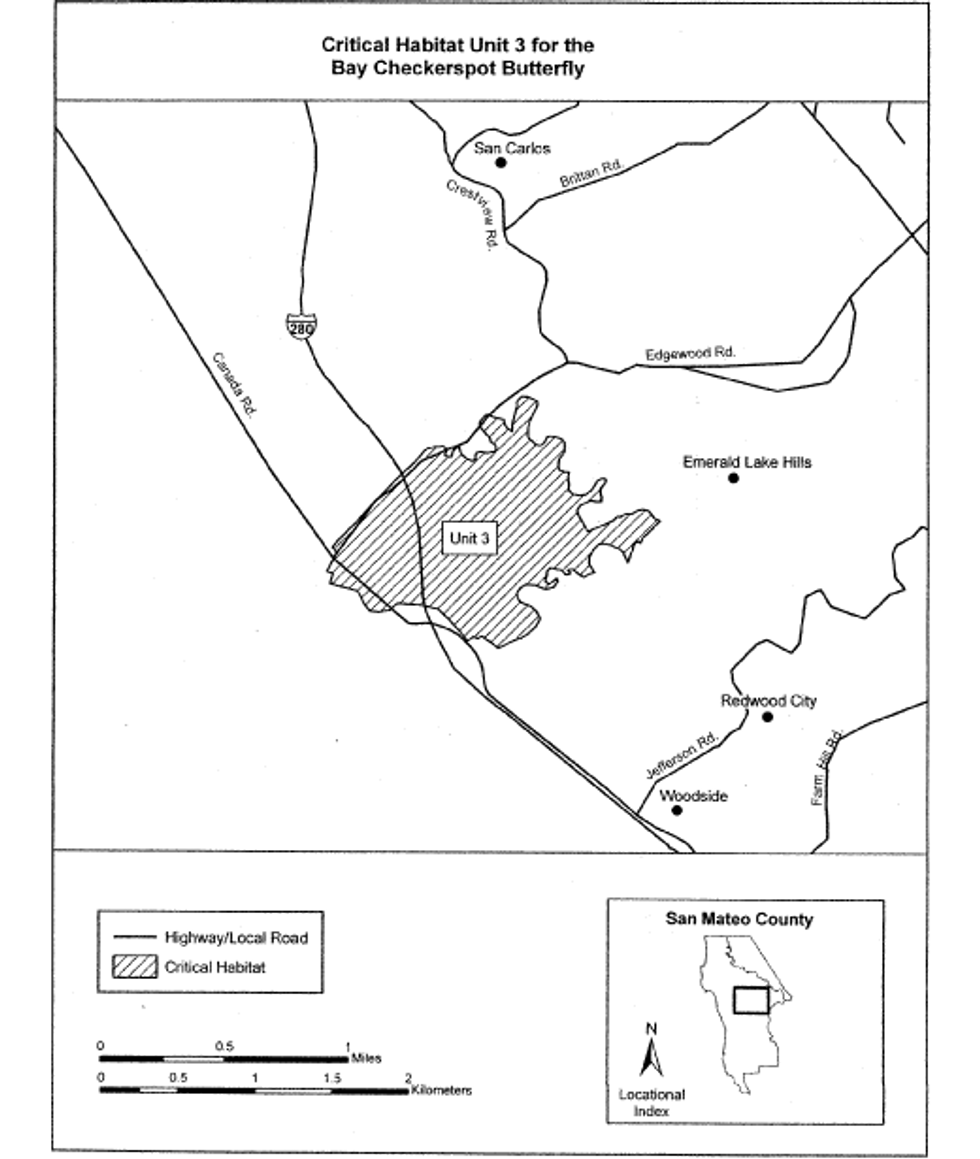
(9) Unit 4: Jasper Ridge, San Mateo County, California. From USGS 1:24,000 scale quadrangle Palo Alto.
(i) [Reserved]
(ii) Map of Unit 4 for Bay checkerspot butterfly follows:
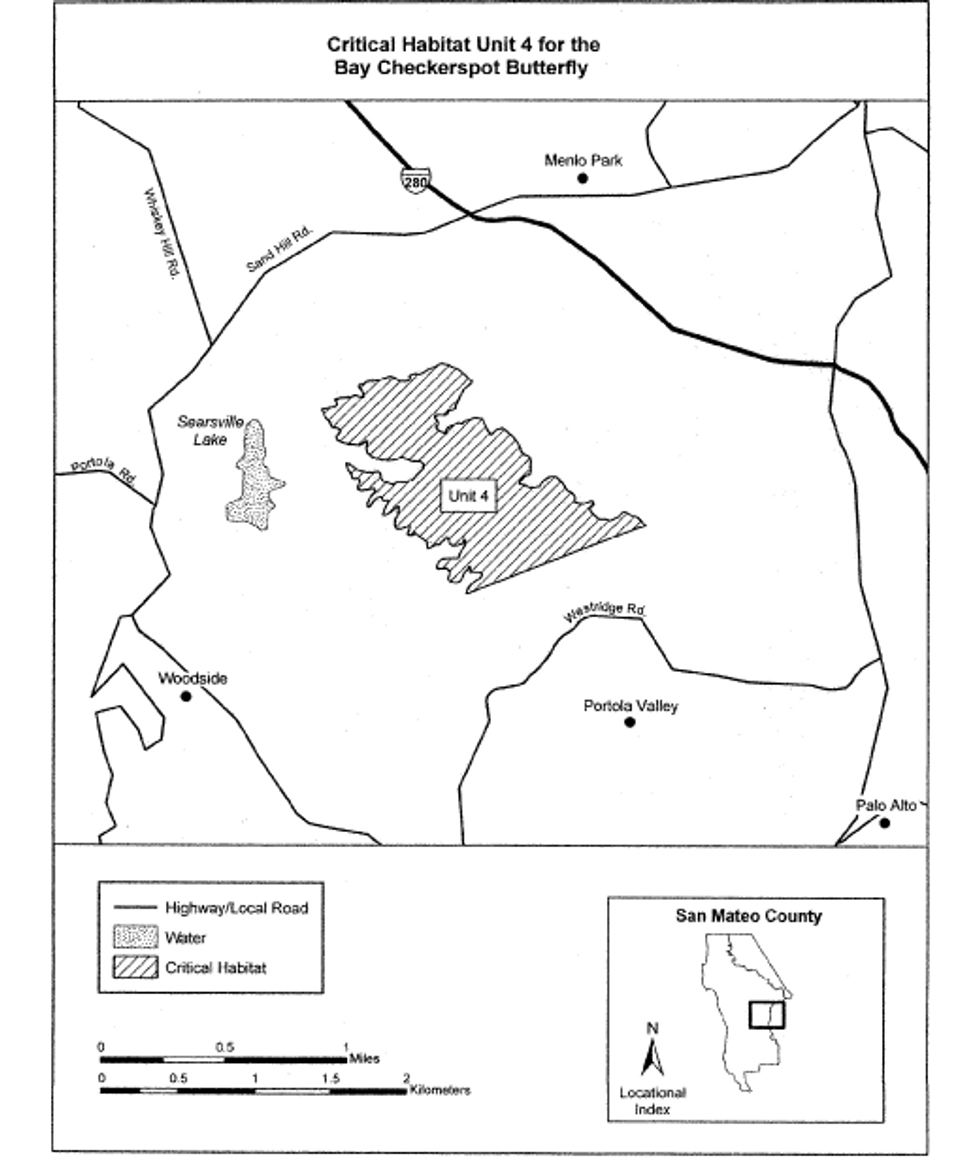
(10) Unit 5: Metcalf, Santa Clara County, California. From USGS 1:24,000 scale quadrangles San Jose East, Lick Observatory, Santa Teresa Hills, and Morgan Hill.
(i) [Reserved]
(ii) Unit 5 for Bay checkerspot butterfly is depicted on the map in paragraph (10)(ii) of this entry.
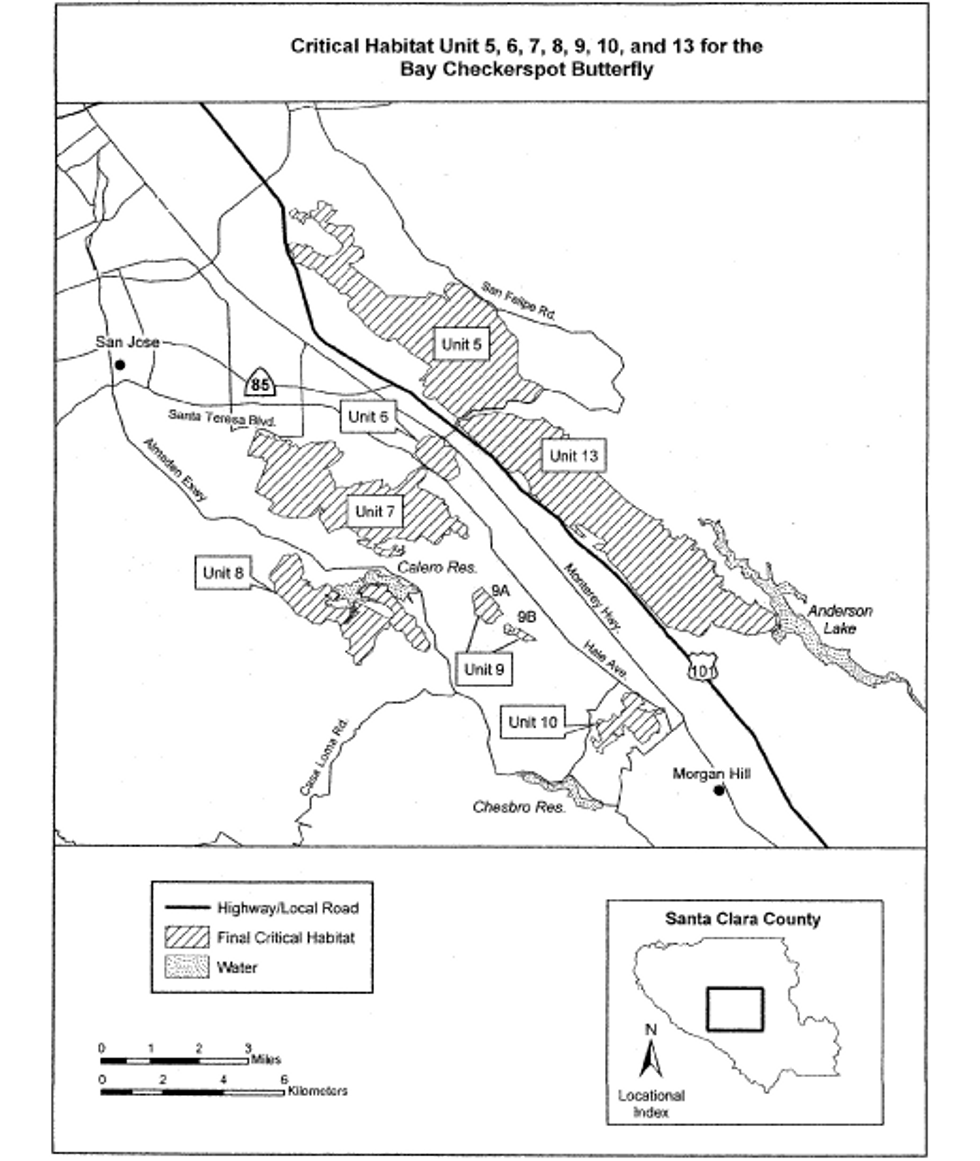
(11) Unit 6: Tulare Hill, Santa Clara County, California. From USGS 1:24,000 scale quadrangles San Jose East, Lick Observatory, Santa Teresa Hills, and Morgan Hill.
(i) [Reserved]
(ii) Unit 6 for Bay checkerspot butterfly is depicted on the map in paragraph (10)(ii) of this entry.
(12) Unit 7: Santa Teresa Hills, Santa Clara County, California. From USGS 1:24,000 scale quadrangles San Jose East, Lick Observatory, Santa Teresa Hills, and Morgan Hill.
(i) [Reserved]
(ii) Unit 7 for Bay checkerspot butterfly is depicted on the map in paragraph (10)(ii) of this entry.
(13) Unit 8: Calero Reservoir, Santa Clara County, California. From USGS 1:24,000 scale quadrangles San Jose East, Lick Observatory, Santa Teresa Hills, and Morgan Hill.
(i) [Reserved]
(ii) Unit 8 for Bay checkerspot butterfly is depicted on the map in paragraph (10)(ii) of this entry.
(14) Unit 9: Kalana Hills, Santa Clara County, California. From USGS 1:24,000 scale quadrangles San Jose East, Lick Observatory, Santa Teresa Hills, and Morgan Hill.
(i) [Reserved]
(ii) Unit 9 for Bay checkerspot butterfly is depicted on the map in paragraph (10)(ii) of this entry.
(15) Unit 10: Hale, Santa Clara County, California. From USGS 1:24,000 scale quadrangles San Jose East, Lick Observatory, Santa Teresa Hills, and Morgan Hill.
(i) [Reserved]
(ii) Unit 10 for Bay checkerspot butterfly is depicted on the map in paragraph (10)(ii) of this entry.
(16) Unit 11: Bear Ranch, Santa Clara County, California. From USGS 1:24,000 scale quadrangle Gilroy.
(i) [Reserved]
(ii) Map of Unit 11 for Bay checkerspot butterfly follows:
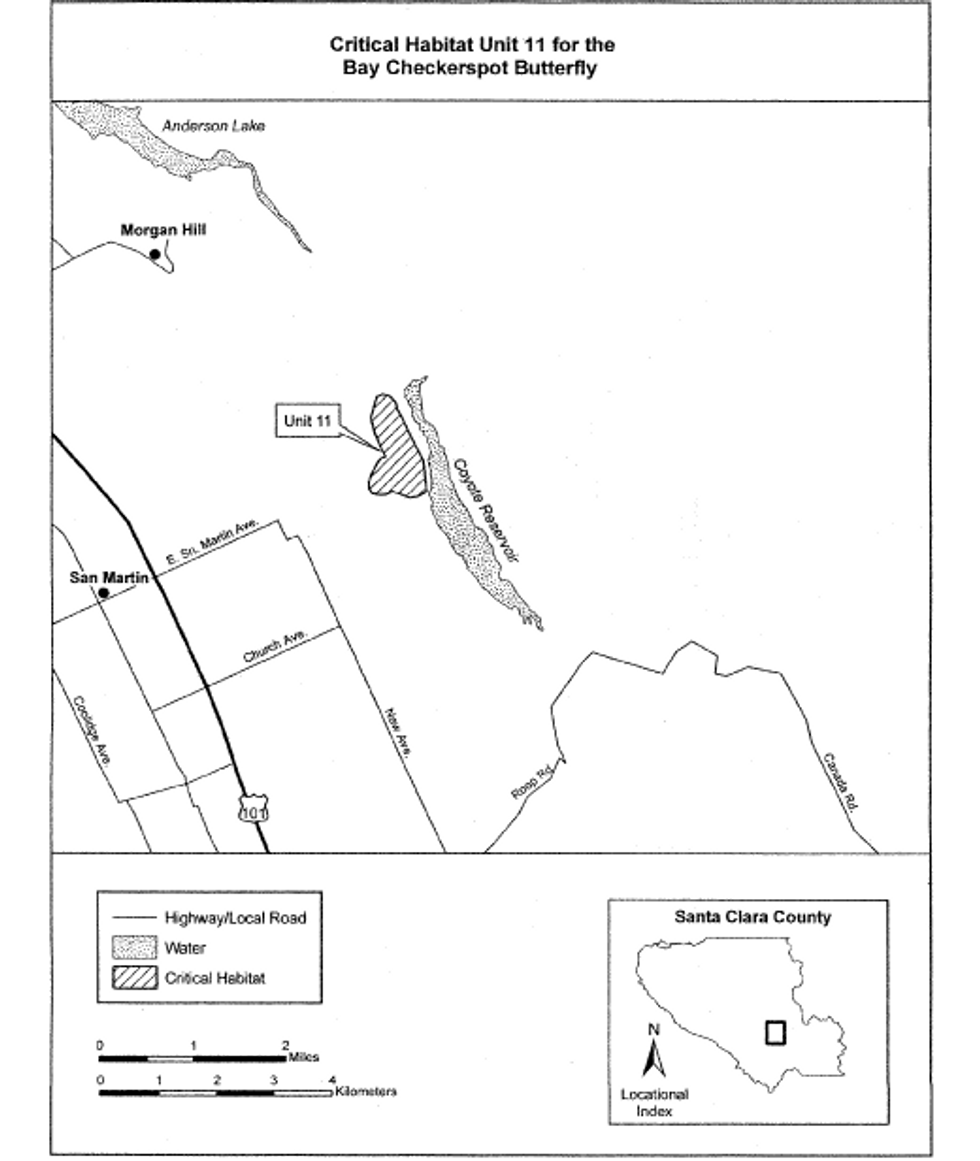
(17) Unit 12: San Martin, Santa Clara County, California. From USGS 1:24,000 scale quadrangles Mt. Madonna and Gilroy.
(i) [Reserved]
(ii) Map of Unit 12 for Bay checkerspot butterfly follows:
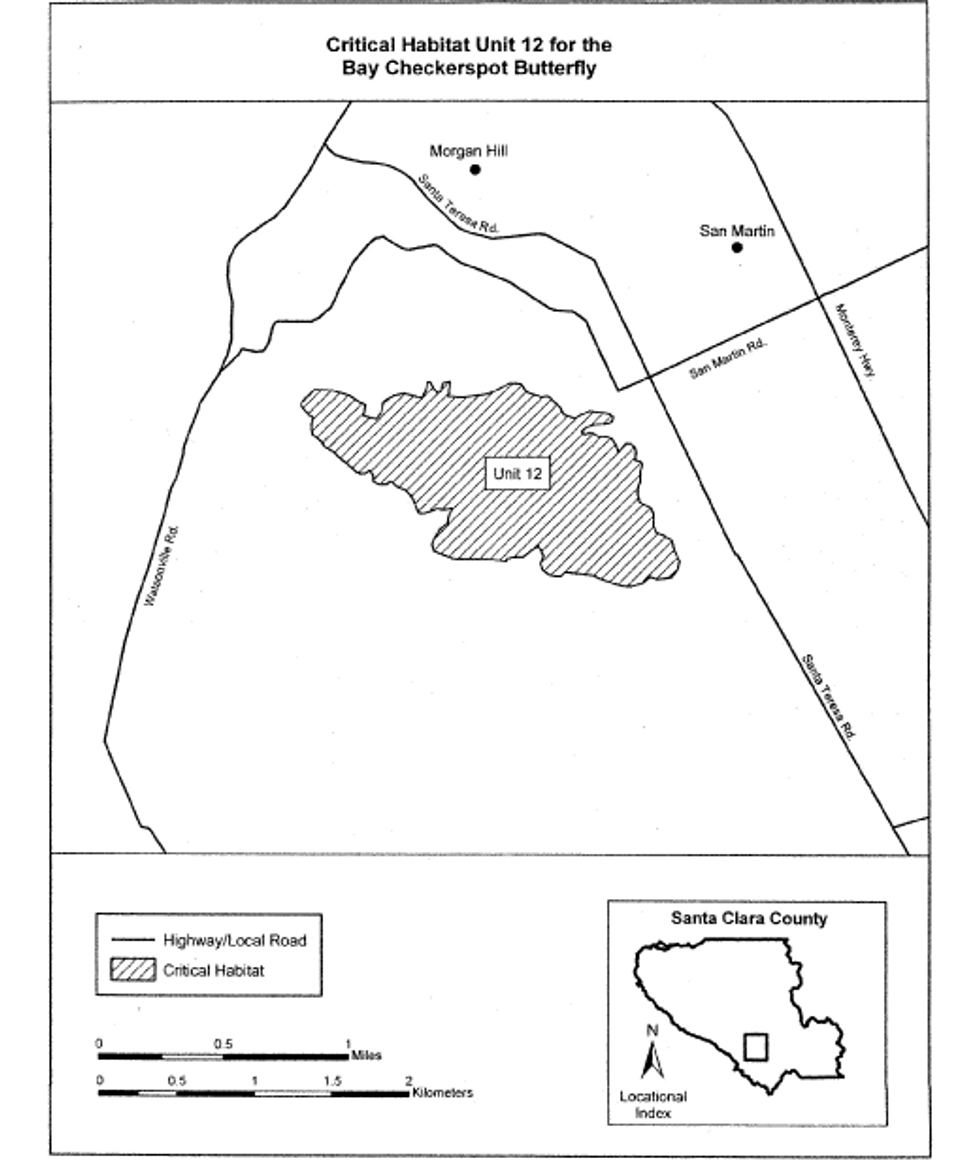
(18) Unit 13: Kirby, Santa Clara County, California. From USGS 1:24,000 scale quadrangles San Jose East, Lick Observatory, Santa Teresa Hills, and Morgan Hill.
(i) [Reserved]
(ii) Unit 13 for Bay checkerspot butterfly is depicted on the map in paragraph (10)(ii) of this entry.
Fender's Blue butterfly (Icaricia icarioides fenderi)
(1) Critical habitat units are depicted for Benton, Lane, Polk, and Yamhill Counties, Oregon, on the maps below.
(2) The primary constituent elements of critical habitat for Fender's blue butterfly are the habitat components that provide:
(i) Early seral upland prairie, wet prairie, or oak savanna habitat with a mosaic of low-growing grasses and forbs, an absence of dense canopy vegetation, and undisturbed subsoils;
(ii) Larval host-plants Lupinus sulphureus ssp. kincaidii, L. arbustus, or L. albicaulis;
(iii) Adult nectar sources, such as: Allium acuminatum (tapertip onion), Allium amplectens (narrowleaf onion), Calochortus tolmiei (Tolmie's mariposa lilly), Camassia quamash (small camas), Cryptantha intermedia (clearwater cryptantha), Eriophyllum lanatum (wooly sunflower), Geranium oreganum (Oregon geranium), Iris tenax (toughleaf iris), Linum angustifolium (pale flax), Linum perenne (blue flax), Sidalcea campestris (Meadow checkermallow), Sidalcea virgata (rose checker-mallow), Vicia cracca (bird vetch), V. sativa (common vetch), and V. hirsute (tiny vetch);
(iv) Stepping-stone habitat consisting of undeveloped open areas with the physical characteristics appropriate for supporting the short-stature prairie oak savanna plant community (well-drained soils), within ∼1.2 miles (∼2 km) of natal lupine patches.
(3) Critical habitat does not include man-made structures (such as buildings, aqueducts, airports, roads, and other paved areas, and the land on which such structures are located) existing on the effective date of this rule and not containing one or more of the primary constituent elements.
(4) Critical Habitat Map Units. Data layers defining map units were created using USGS 24,000 scale Digital Ortho Quads captured in 2000. Critical habitat units were then mapped using Universal Transverse Mercator (UTM) zone 10, North American Datum (NAD) 1983 coordinates.
(5) Note: Map 1 (Index map for Fender's blue butterfly) follows:
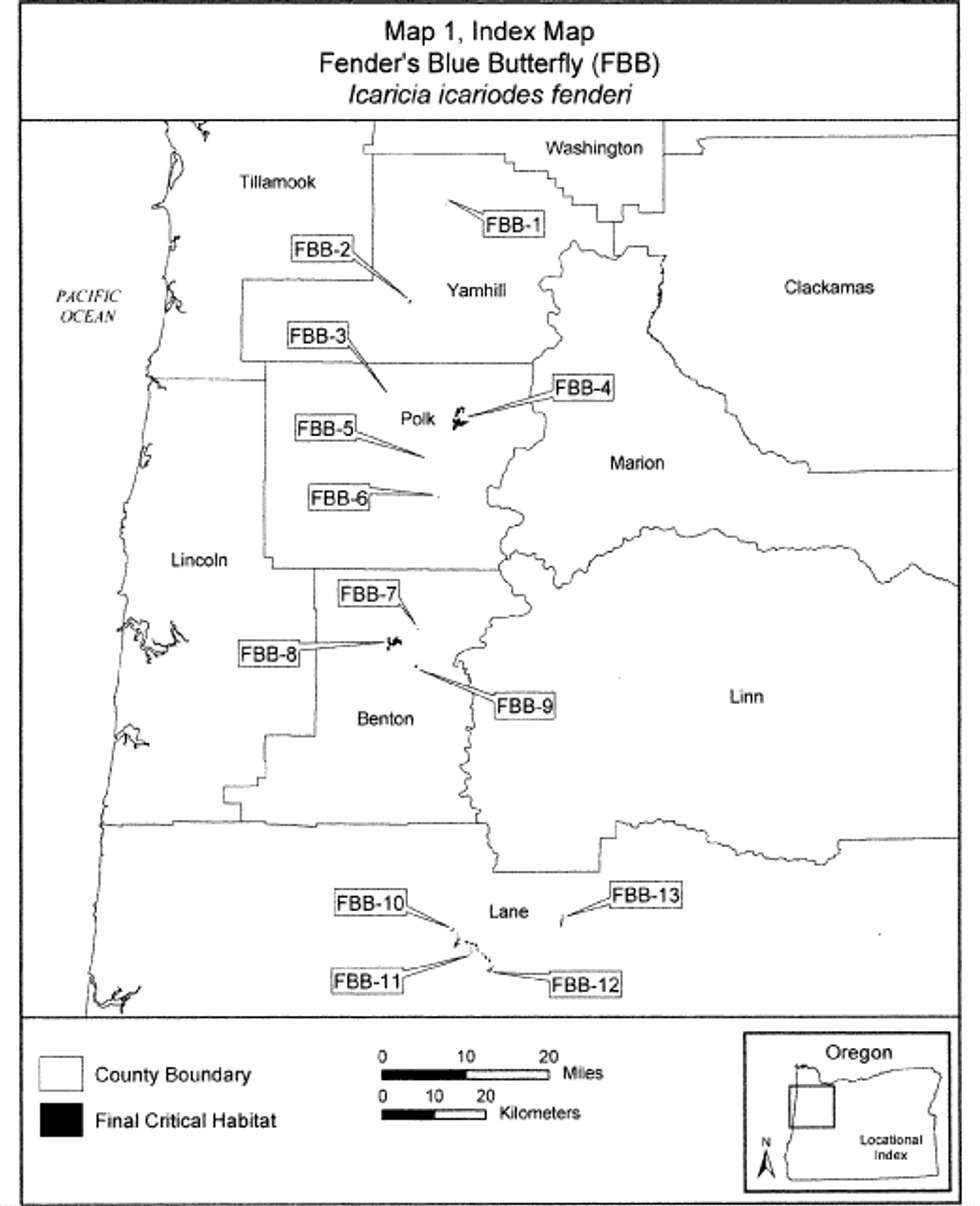
(6) Unit 1 for Fender's blue butterfly (FBB-1), Yamhill County, Oregon.
(i) [Reserved]
(ii) Map 2 (Unit 1 for Fender's blue butterfly (FBB-1)) follows:
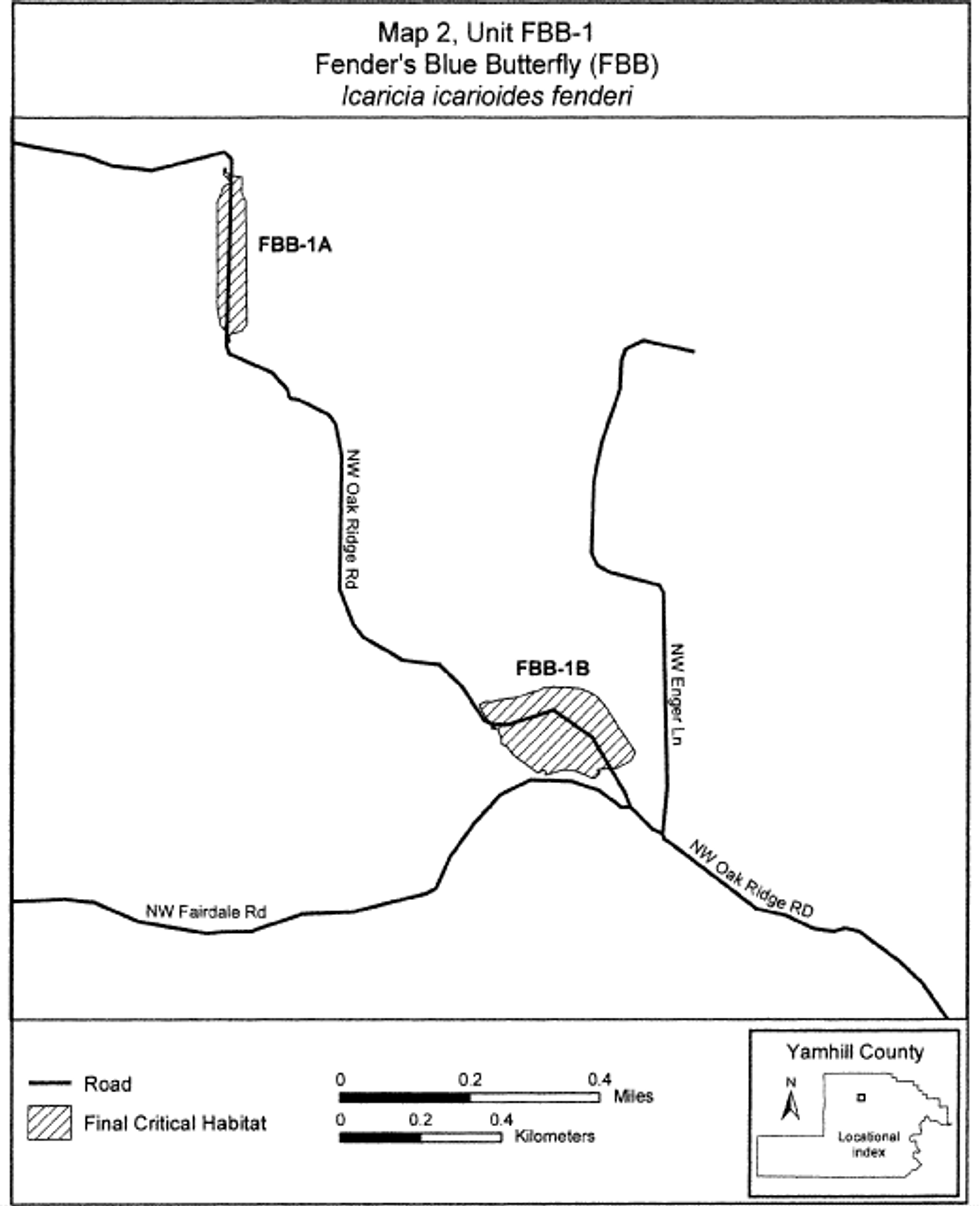
(7) Unit 2 for Fender's blue butterfly (FBB-2), Yamhill County, Oregon.
(i) [Reserved]
(ii) Map 3 (Unit 2 for Fender's blue butterfly (FBB-2)) follows:
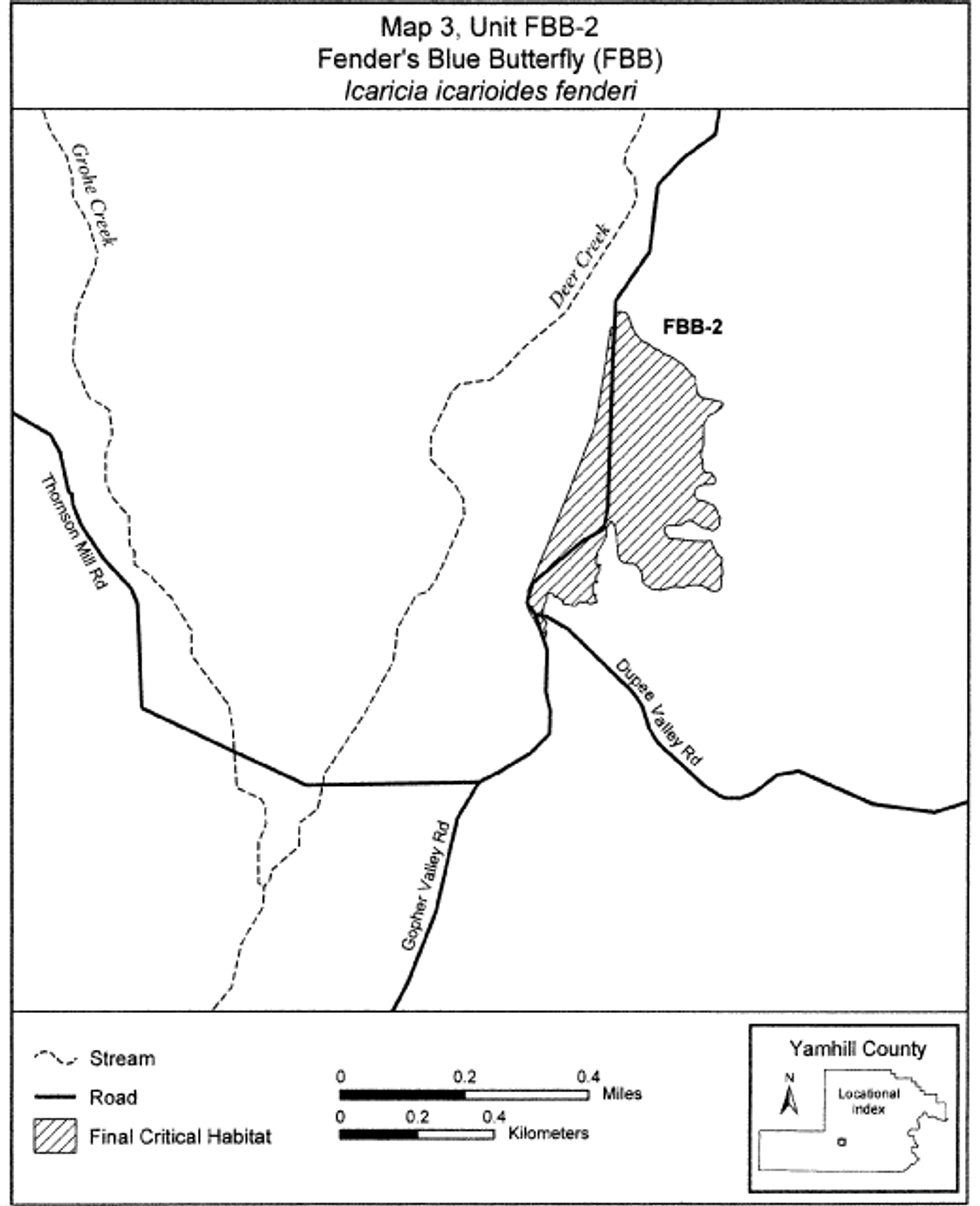
(8) Unit 3 for Fender's blue butterfly (FBB-3), Polk County, Oregon.
(i) [Reserved]
(ii) Map 4 (Unit 3 for Fender's blue butterfly (FBB-3)) follows:
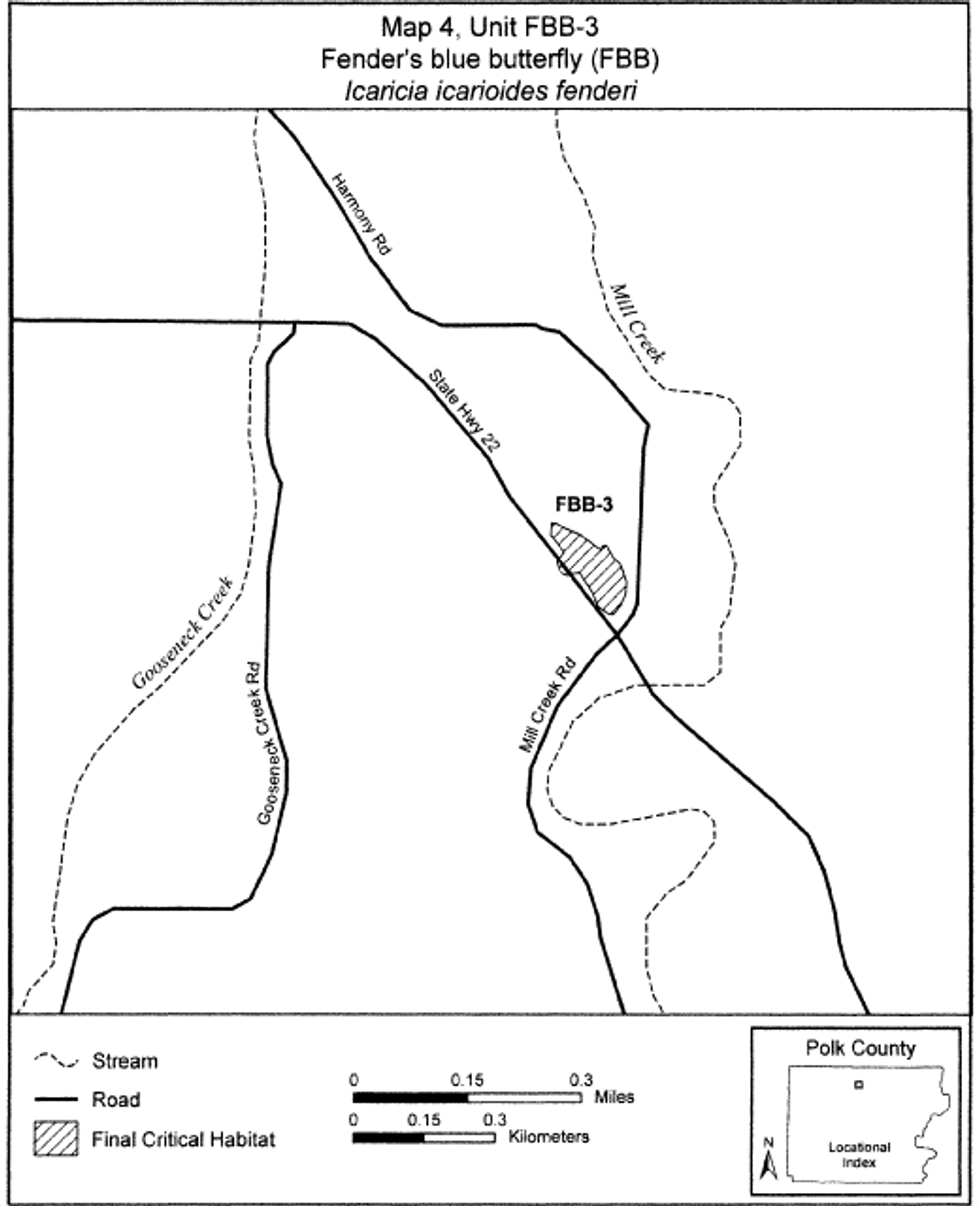
(9) Unit 4 for Fender's blue butterfly (FBB-4), Polk County, Oregon.
(i) [Reserved]
(ii) Map 5 (Unit 4 for Fender's blue butterfly (FBB-4)) follows:
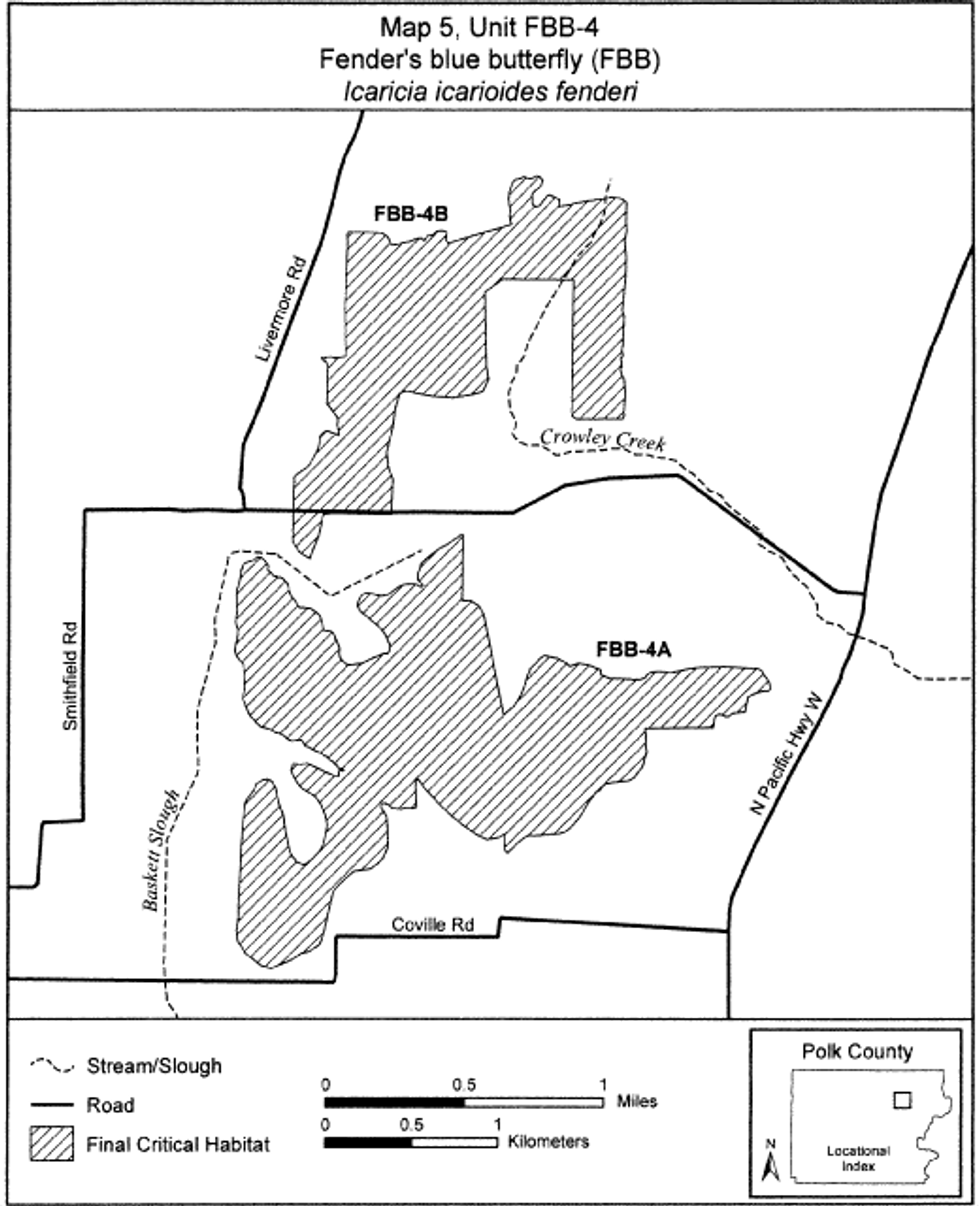
(10) Unit 5 for Fender's blue butterfly (FBB-5), Polk County, Oregon.
(i) [Reserved]
(ii) Map 6 (Unit 5 for Fender's blue butterfly (FBB-5)) follows:
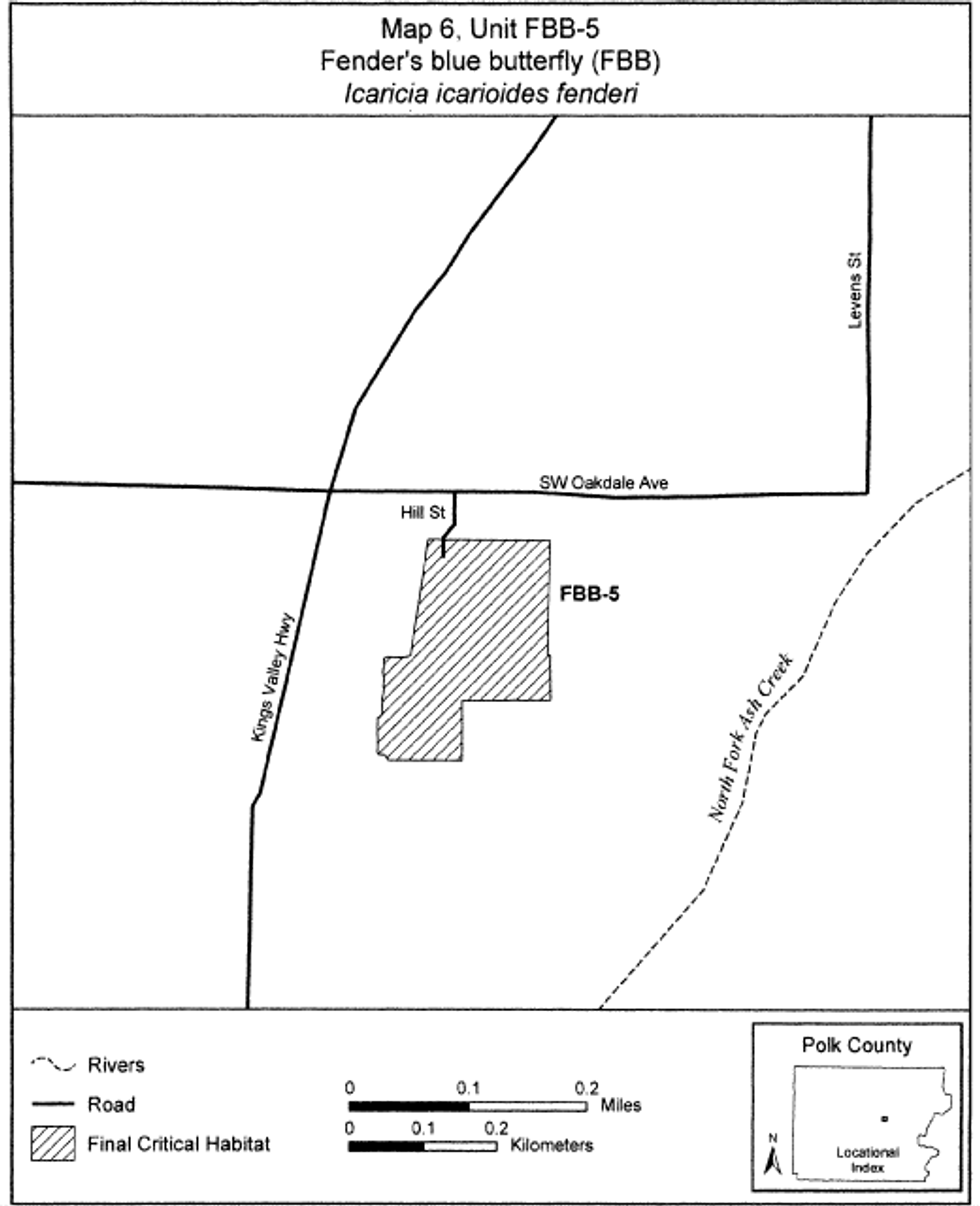
(11) Unit 6 for Fender's blue butterfly (FBB-6), Polk County, Oregon.
(i) [Reserved]
(ii) Map 7 (Unit 6 for Fender's blue butterfly (FBB-6)) follows:
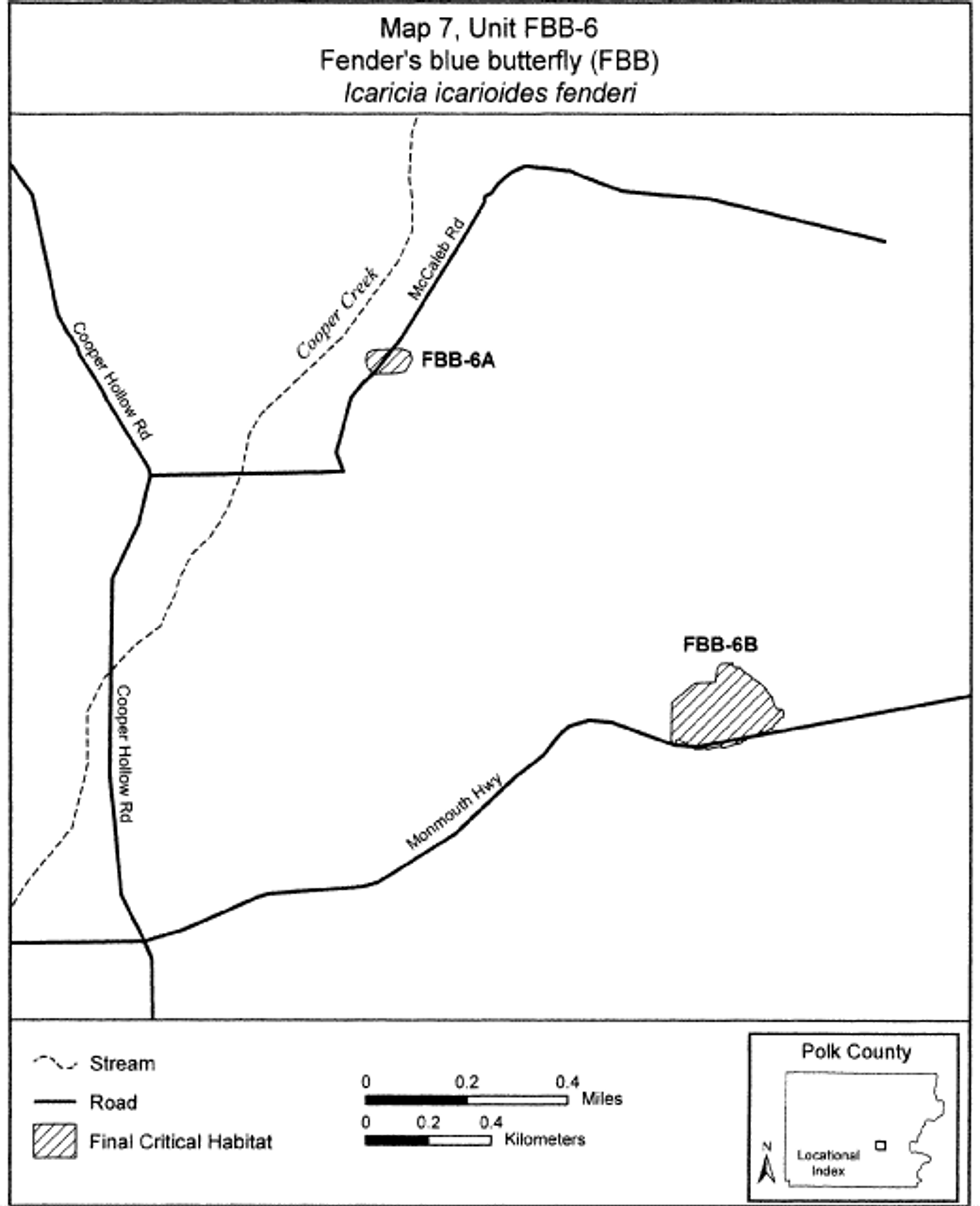
(12) Units 7, 8, and 9 for Fender's blue butterfly (FBB-7, FBB-8, and FBB-9), Benton County, Oregon.
(i) [Reserved]
(ii) Map 8 (Units 7, 8, and 9 for Fender's blue butterfly (FBB-7, FBB-8, and FBB-9)) follows:
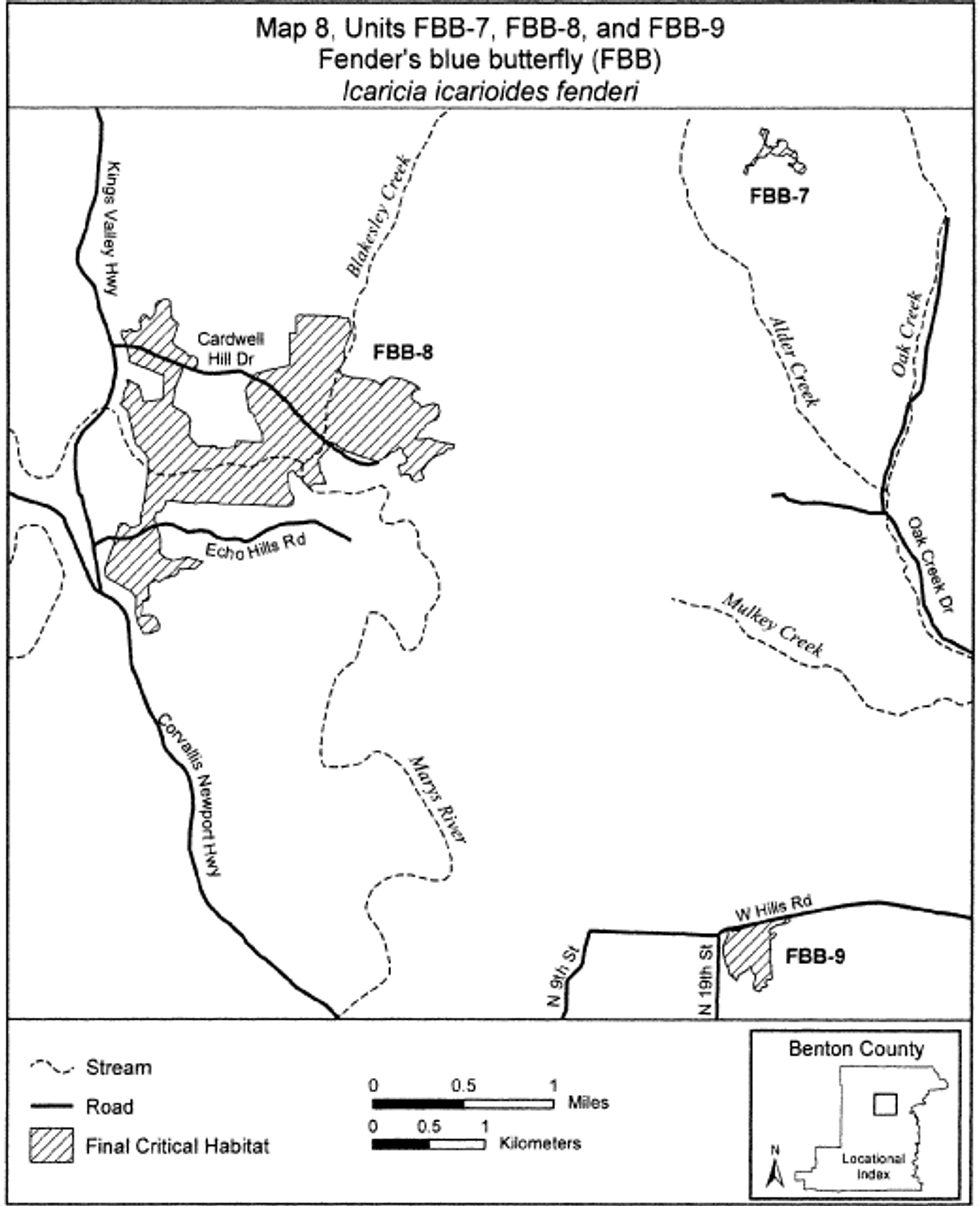
(13) Units 10, 11, and 12 for Fender's blue butterfly (FBB-10, FBB-11, and FBB-12) in Lane County, Oregon.
(i) [Reserved]
(ii) Map 9 (Units 10, 11, and 12 for Fender's blue butterfly (FBB-10, FBB-11, and FBB-12)) follows:
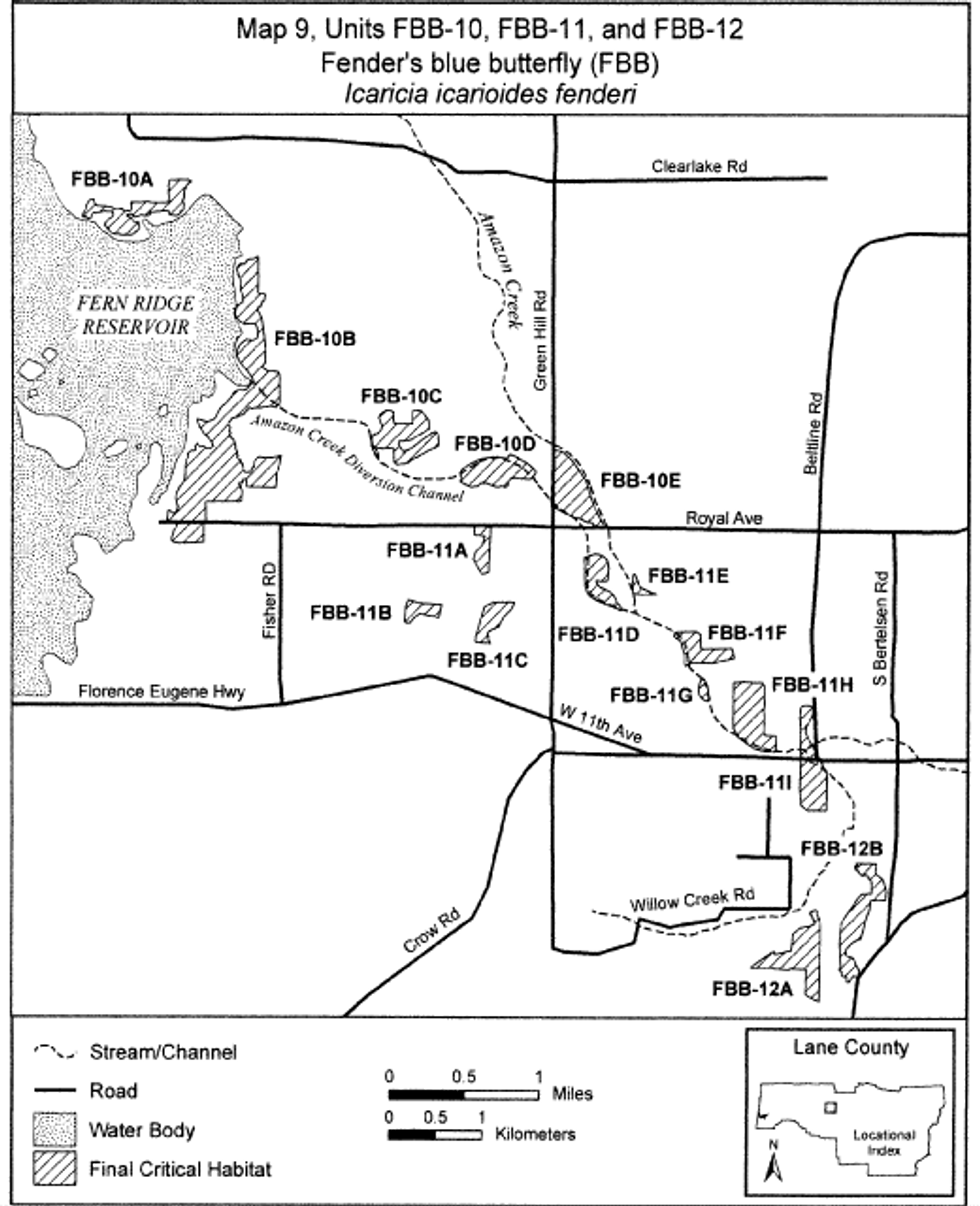
(14) Unit 13 for Fender's blue butterfly, Lane County, Oregon.
(i) [Reserved]
(ii) Map 10 (Unit 13 for Fender's blue butterfly (FBB-13)) follows:
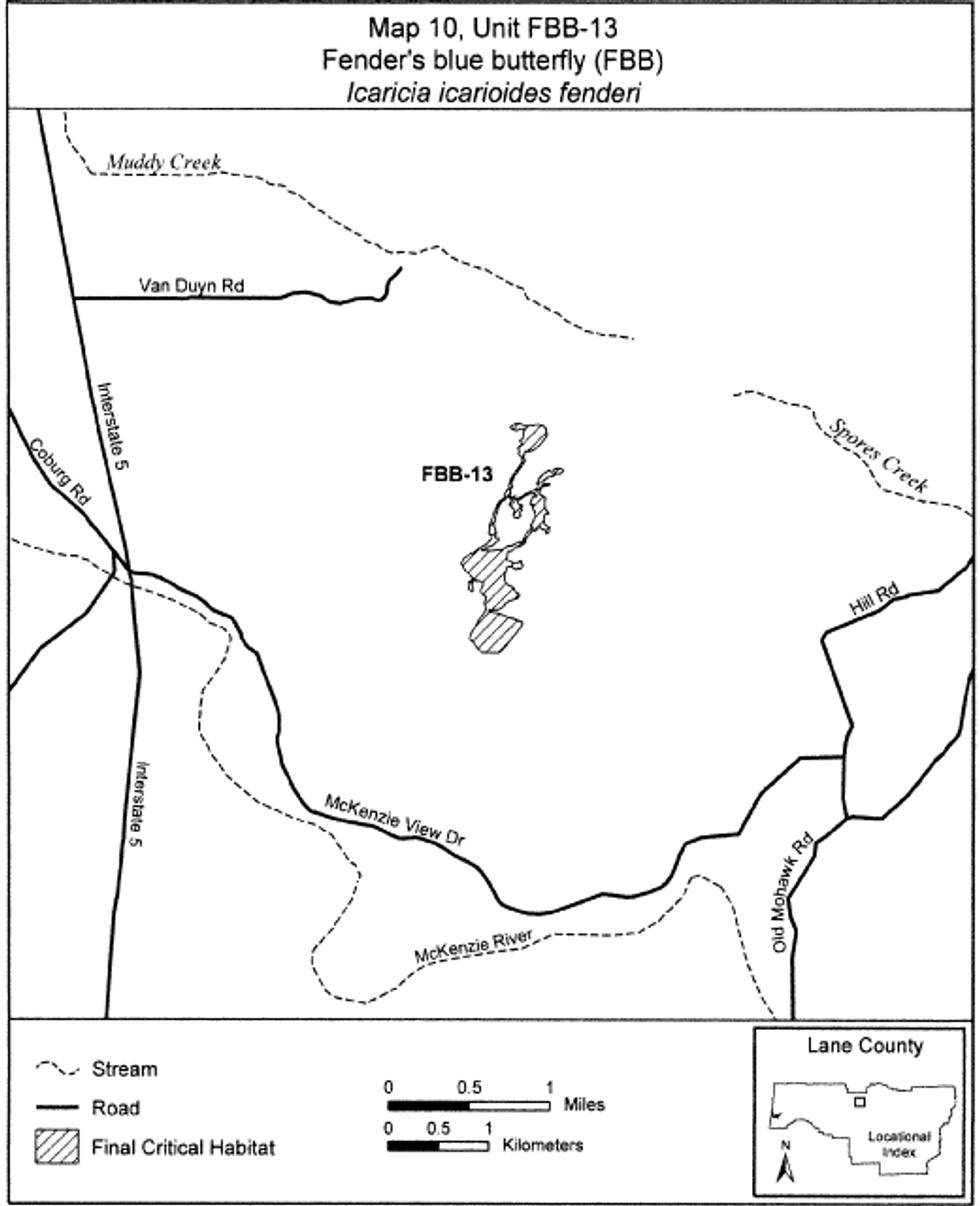
Florida Leafwing Butterfly (Anaea troglodyta floridalis)
(1) Critical habitat units are depicted for Miami-Dade and Monroe Counties, Florida, on the maps below.
(2) Within these areas, the primary constituent elements of the physical or biological features essential to the conservation of the Florida leafwing butterfly consist of six components:
(i) Areas of pine rockland habitat, and in some locations, associated rockland hammocks and hydric pine flatwoods.
(A) Pine rockland habitat contains:
(1) Open canopy, semi-open subcanopy, and understory.
(2) Substrate of oolitic limestone rock.
(3) A plant community of predominately native vegetation.
(B) Rockland hammock habitat associated with pine rocklands contains:
(1) Canopy gaps and edges with an open to semi-open canopy, subcanopy, and understory.
(2) Substrate with a thin layer of highly organic soil covering limestone or organic matter that accumulates on top of the underlying limestone rock.
(3) A plant community of predominately native vegetation.
(C) Hydric pine flatwood habitat associated with pine rocklands contains:
(1) Open canopy with a sparse or absent subcanopy, and dense understory.
(2) Substrate with a thin layer of poorly drained sands and organic materials that accumulates on top of the underlying limestone or calcareous rock.
(3) A plant community of predominately native vegetation.
(ii) Competitive nonnative plant species in quantities low enough to have minimal effect on survival of the Florida leafwing butterfly.
(iii) The presence of the butterfly's hostplant, pineland croton, in sufficient abundance for larval recruitment, development, and food resources, and for adult butterfly roosting habitat and reproduction.
(iv) A dynamic natural disturbance regime or one that artificially duplicates natural ecological processes (e.g., fire, hurricanes or other weather events, at appropriate intervals) that maintains the pine rockland habitat and associated rockland hammock and hydric pine flatwood plant communities.
(v) Pine rockland habitat and associated rockland hammock and hydric pine flatwood plant communities sufficient in size to sustain viable Florida leafwing populations.
(vi) Pine rockland habitat and associated rockland hammock and hydric pine flatwood plant communities with levels of pesticide low enough to have minimal effect on the survival of the butterfly or its ability to occupy the habitat.
(3) Critical habitat does not include manmade structures (such as buildings, aqueducts, runways, roads, and other paved areas) and the land on which they are located existing within the legal boundaries on September 11, 2014.
(4) Critical habitat map units. Data layers defining map units were created using ESRI ArcGIS mapping software along with various spatial data layers. ArcGIS was also used to calculate the size of habitat areas. The projection used in mapping and calculating distances and locations within the units was North American Albers Equal Area Conic, NAD 83. The maps in this entry, as modified by any accompanying regulatory text, establish the boundaries of the critical habitat designation. The coordinates, plot points, or both on which each map is based are available to the public at the Service's Internet site (http://www.fws.gov/verobeach), the Federal eRulemaking Portal (http://www.regulations.gov at Docket No. FWS-R4-ES-2013-0031), and at the field office responsible for this designation. You may obtain field office location information by contacting one of the Service regional offices, the addresses of which are listed at 50 CFR 2.2.
(5) Index map of all critical habitat units for the Florida leafwing butterfly follows:
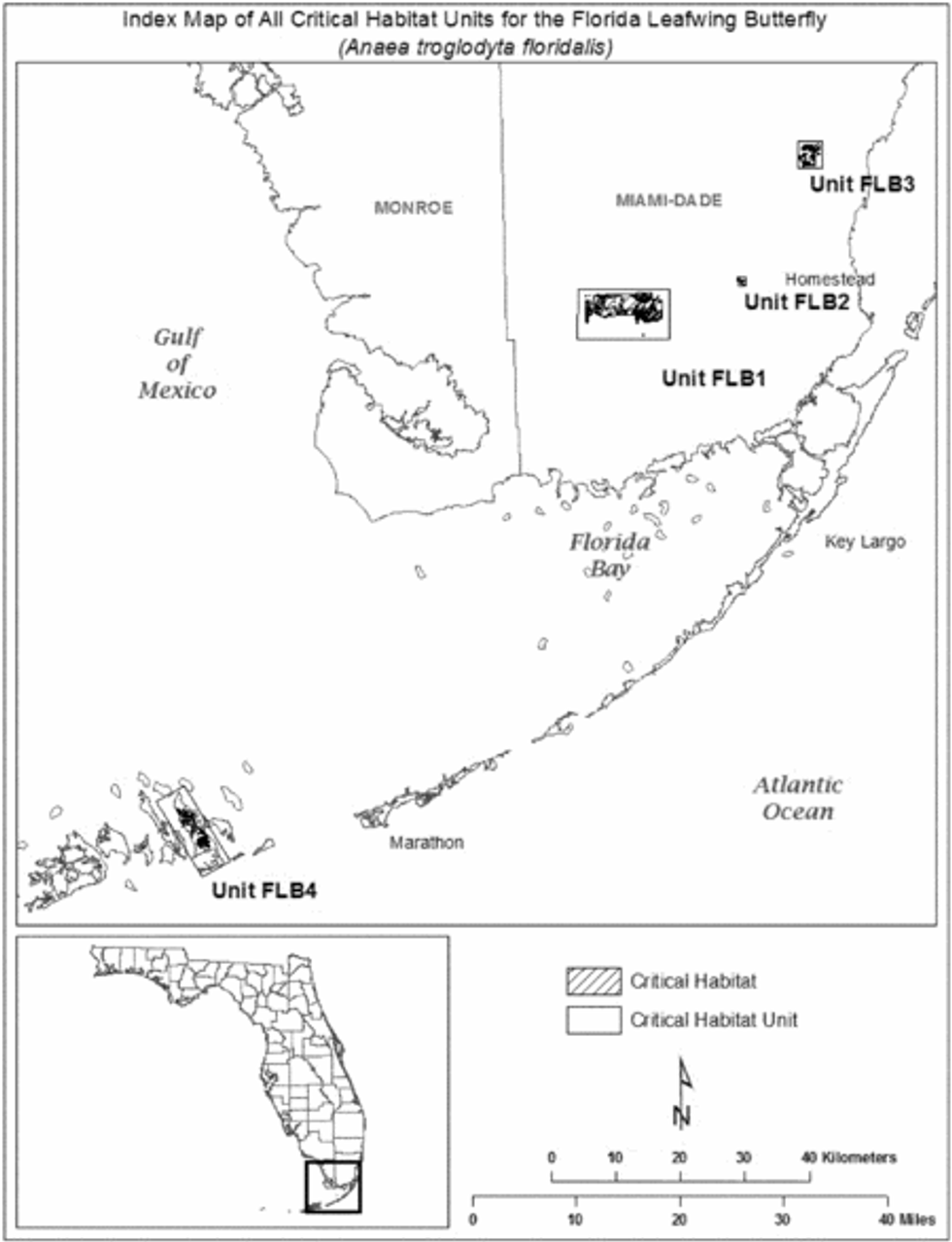
(6) Unit FLB1: Everglades National Park, Miami-Dade County, Florida.
(i) General description: Unit FLB1 consists of 3,235 ha (7,994 ac) composed entirely of lands in Federal ownership, 100 percent of which are located within the Long Pine Key region of Everglades National Park.
(ii) Map of Unit FLB1 follows:
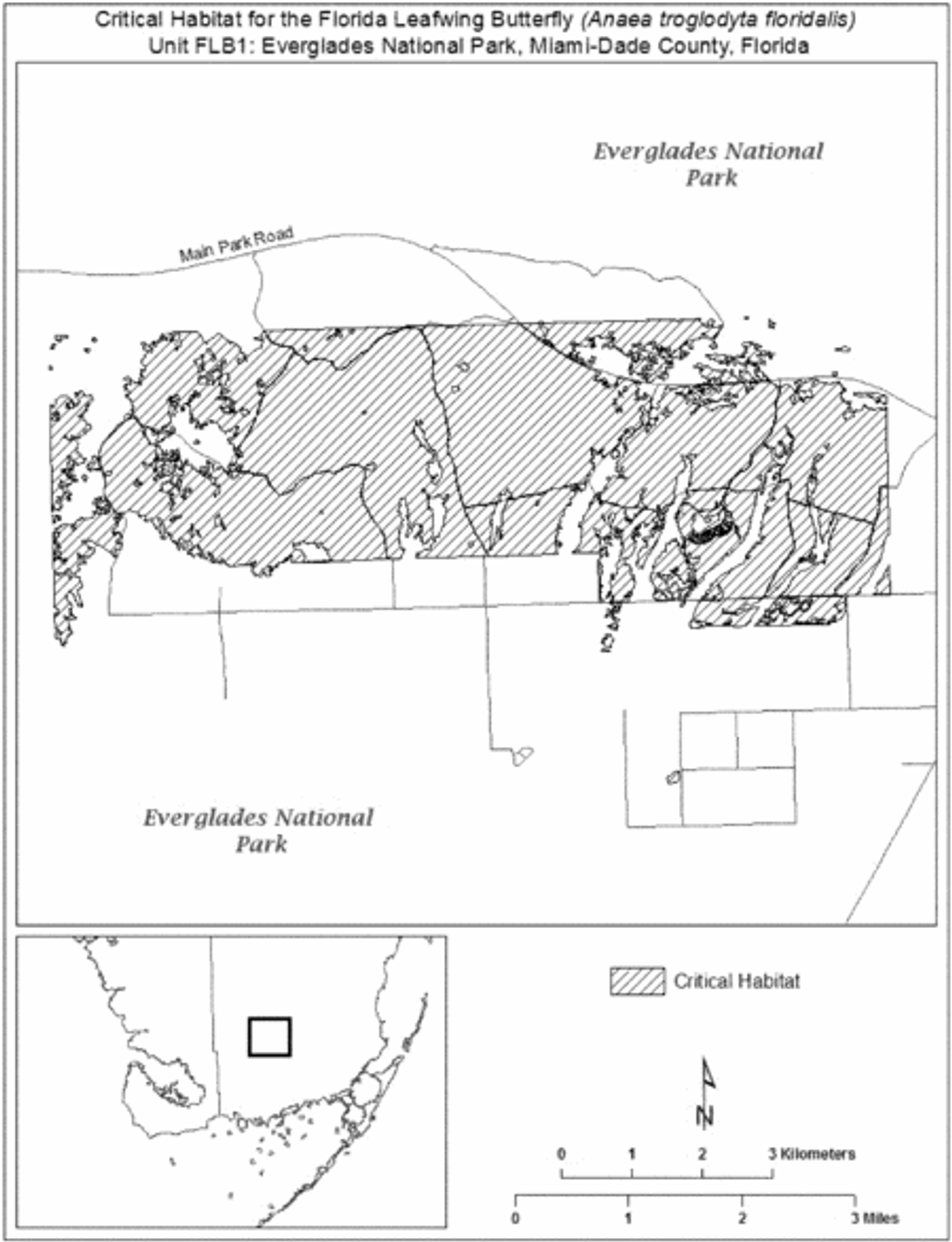
(7) Unit FLB2: Navy Wells Pineland Preserve, Miami-Dade County, Florida.
(i) General description: Unit FLB2 consists of 120 ha (296 ac) in Miami-Dade County and is composed of lands in State (35 ha (85 ac)), and private or other ownership (85 ha (211 ac)).
(ii) Map of Unit FLB2 follows:
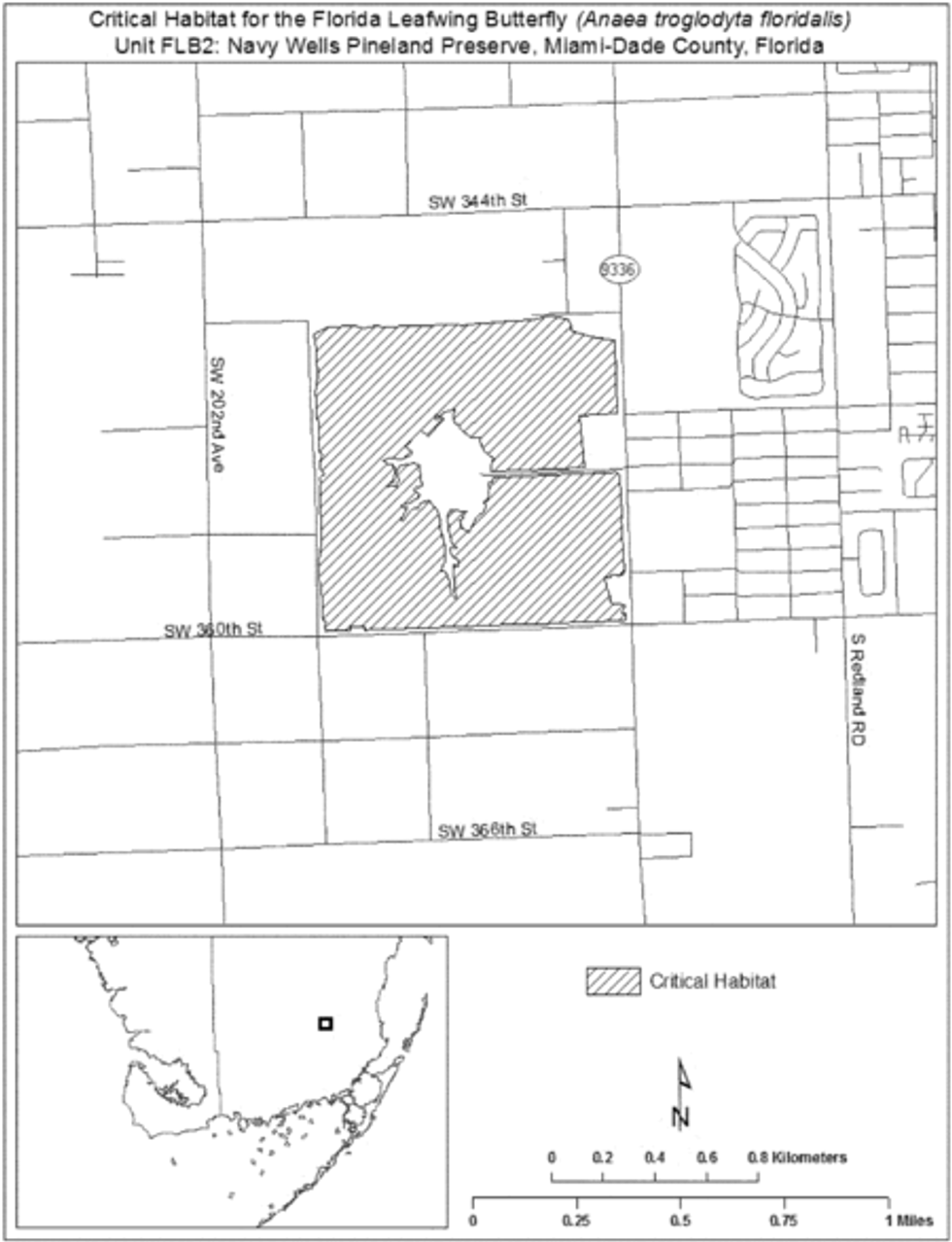
(8) Unit FLB3: Richmond Pine Rocklands, Miami-Dade County, Florida.
(i) General description: Unit FLB3 consists of 359 ha (889 ac) in Miami-Dade County composed of lands in Federal (U.S. Coast Guard, U.S. Army Corps of Engineers, Federal Bureau of Prisons, and National Oceanic and Atmospheric Administration) (50 ha (122 ac)) and private or other (309 ha (767 ac)) ownership.
(ii) Map of Unit FLB3 follows:
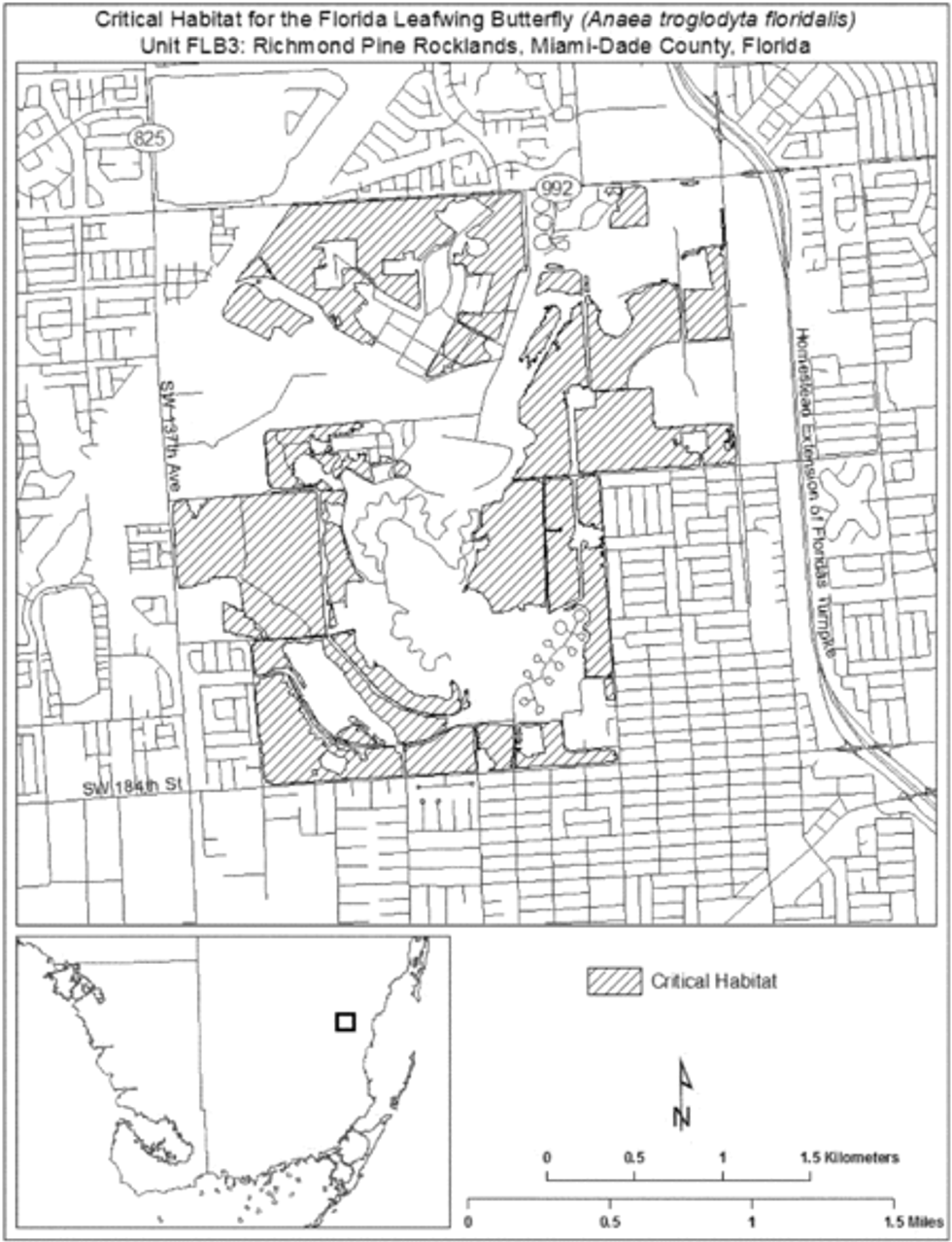
(9) Unit FLB4: Big Pine Key, Monroe County, Florida.
(i) General description: Unit FLB4 consists of 559 ha (1,382 ac) in Monroe County composed of National Key Deer Refuge (NKDR) (365 ha (901 ac)), State lands (90 ha (223 ac)), and property in private or other ownership (104 ha (258 ac)). State lands are interspersed within NKDR lands and managed as part of the Refuge.
(ii) Index map of Unit FLB4 follows:
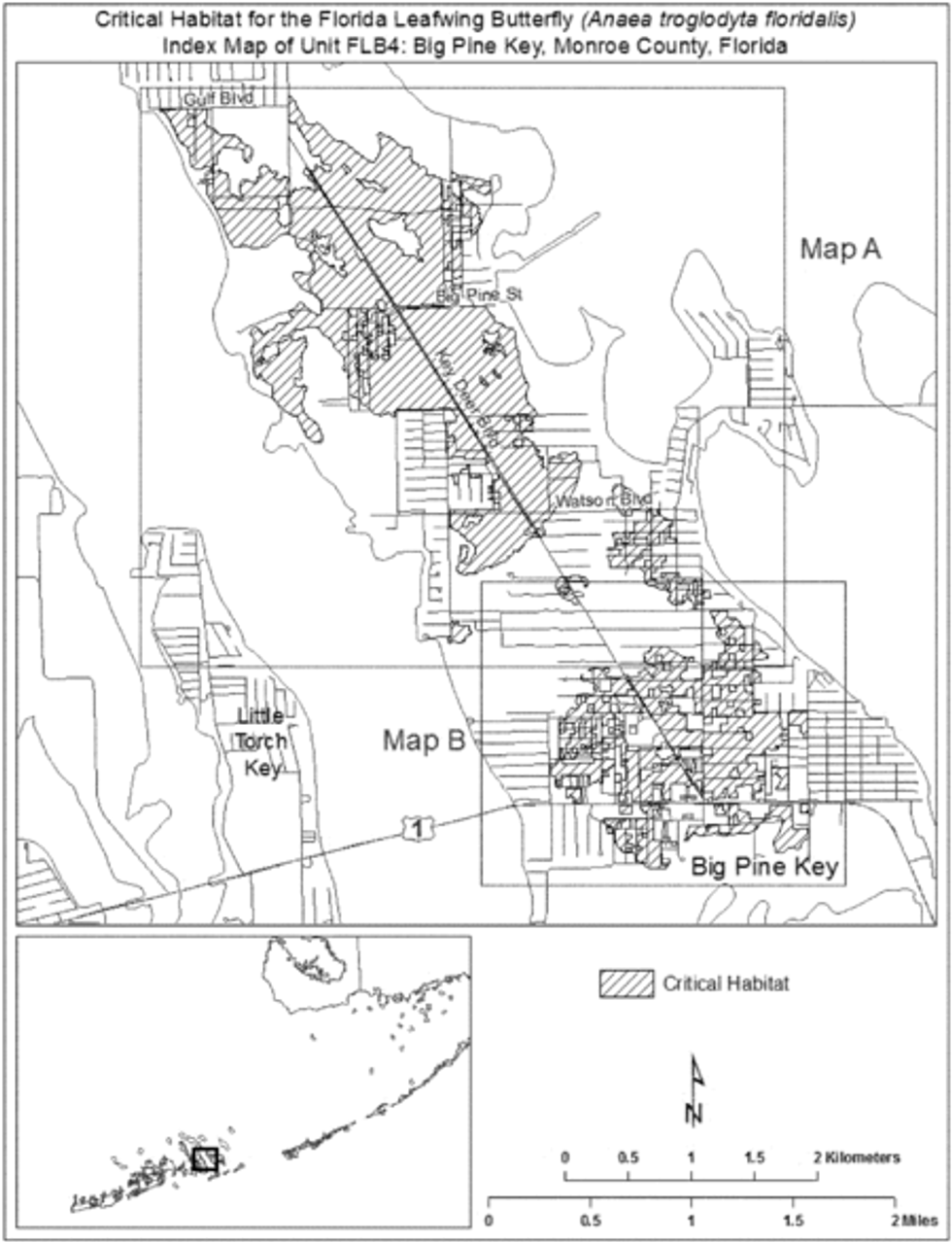
(A) Map A of Unit FLB4 follows:
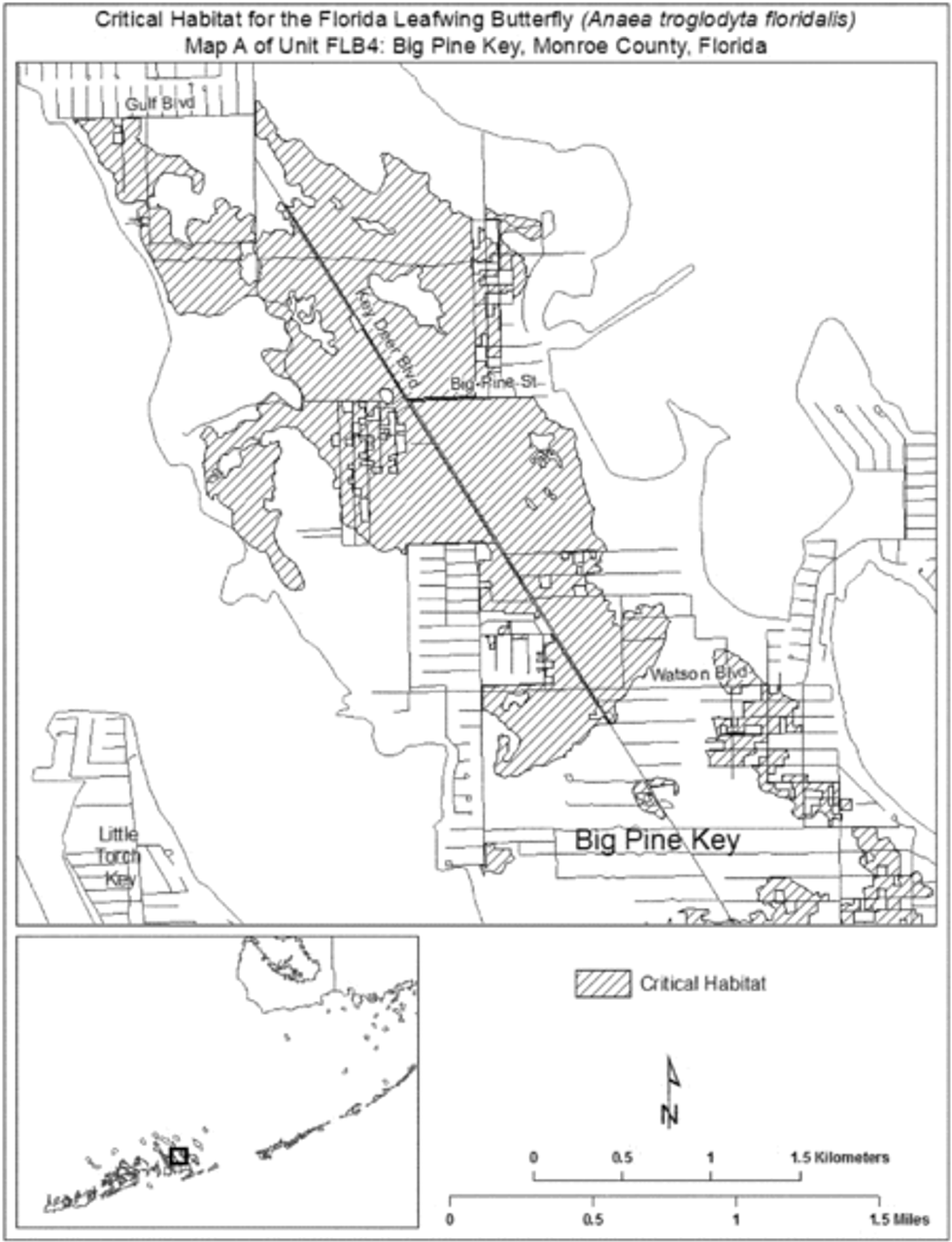
(B) Map B of Unit FLB4 follows:
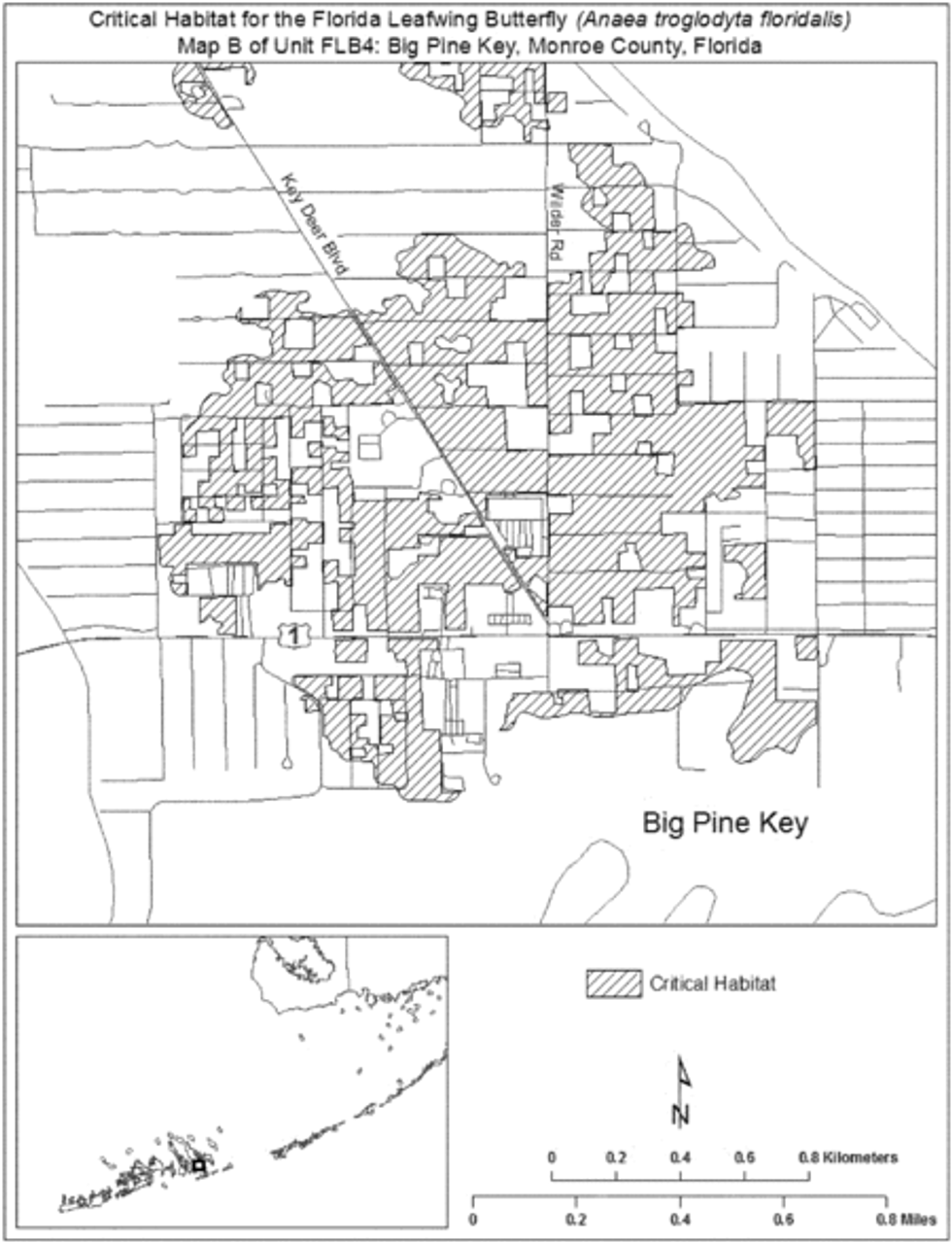
Hermes Copper Butterfly (Lycaena hermes)
(1) Critical habitat units are depicted for San Diego County, California, on the maps in this entry.
(2) Within these areas, the physical or biological features essential to the conservation of Hermes copper butterfly consist of the following components when found between 30 m and 1,341 m above sea level, and located in habitat providing an appropriate quality, quantity, and spatial and temporal arrangement of these habitat characteristics in the context of the life-history needs, condition, and status of the species:
(i) Spiny redberry host plants (Rhamnus crocea).
(ii) Nectar sources for adult butterflies.
(3) Critical habitat does not include manmade structures (such as buildings, aqueducts, runways, roads, and other paved areas) and the land on which they are located existing within the legal boundaries on January 20, 2022.
(4) Critical habitat was mapped using GIS analysis tools and refined using 2016 NAIP imagery and/or the World Imagery layer from ArcGIS Online. The maps in this entry, as modified by any accompanying regulatory text, establish the boundaries of the critical habitat designation. The coordinates or plot points or both on which each map is based are available to the public at https://www.regulations.gov at Docket No. FWS-R8-ES-2017-0053, on our internet site https://www.fws.gov/carlsbad/gis/cfwogis.html, and at the field office responsible for this designation. You may obtain field office location information by contacting one of the Service regional offices, the addresses of which are listed at 50 CFR 2.2.
(5) Note: Index map follows:
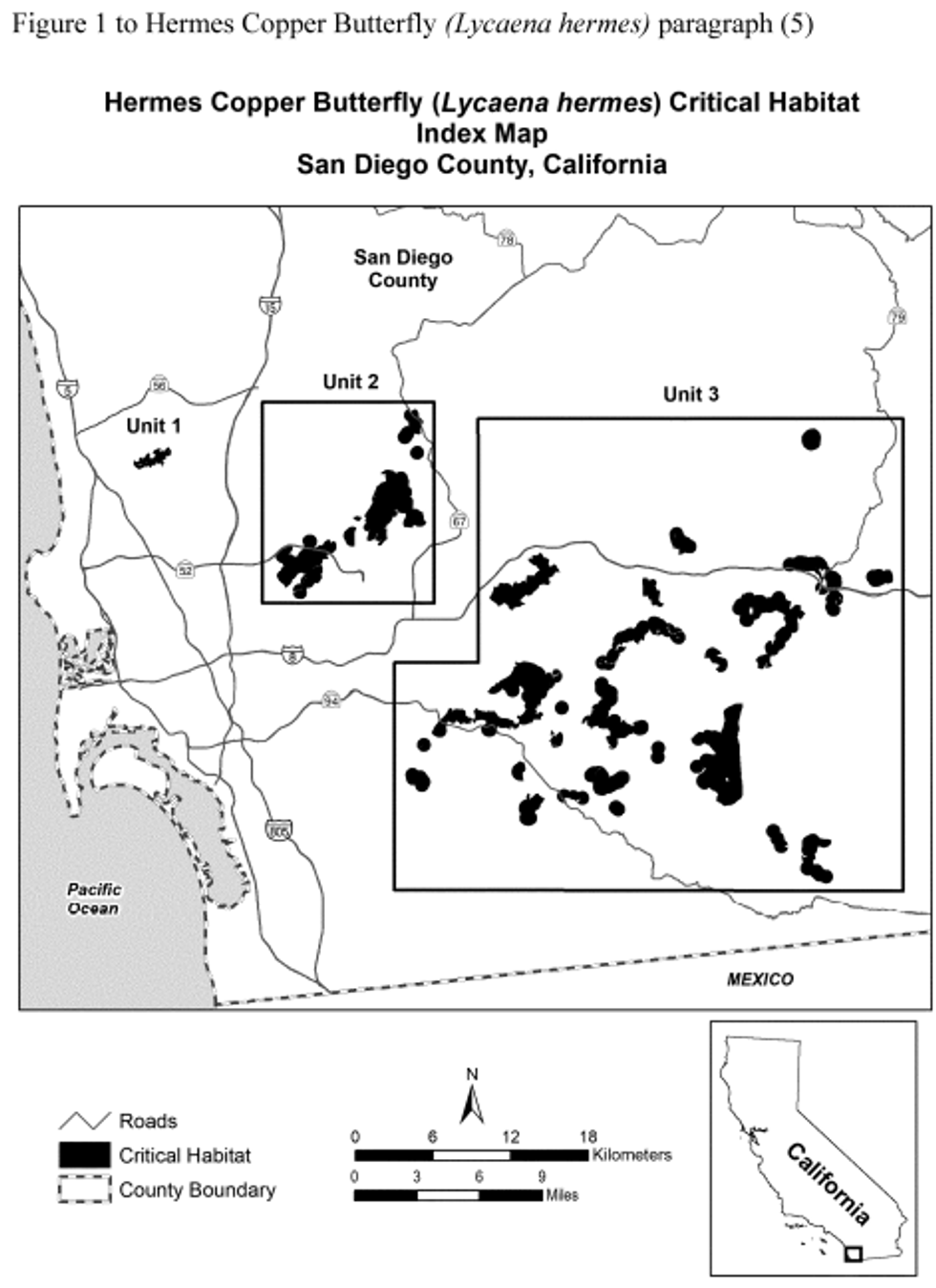
(6) Unit 1: Lopez Canyon, San Diego County, California.
(i) Unit 1 consists of 166 hectares (ha) (410 acres (ac)) in San Diego County and is composed of lands jointly owned and managed by the City and County of San Diego (88 ha (218 ac)) and private or other ownership (77 ha (191 ac)).
(ii) Map of Unit 1, Lopez Canyon, follows:
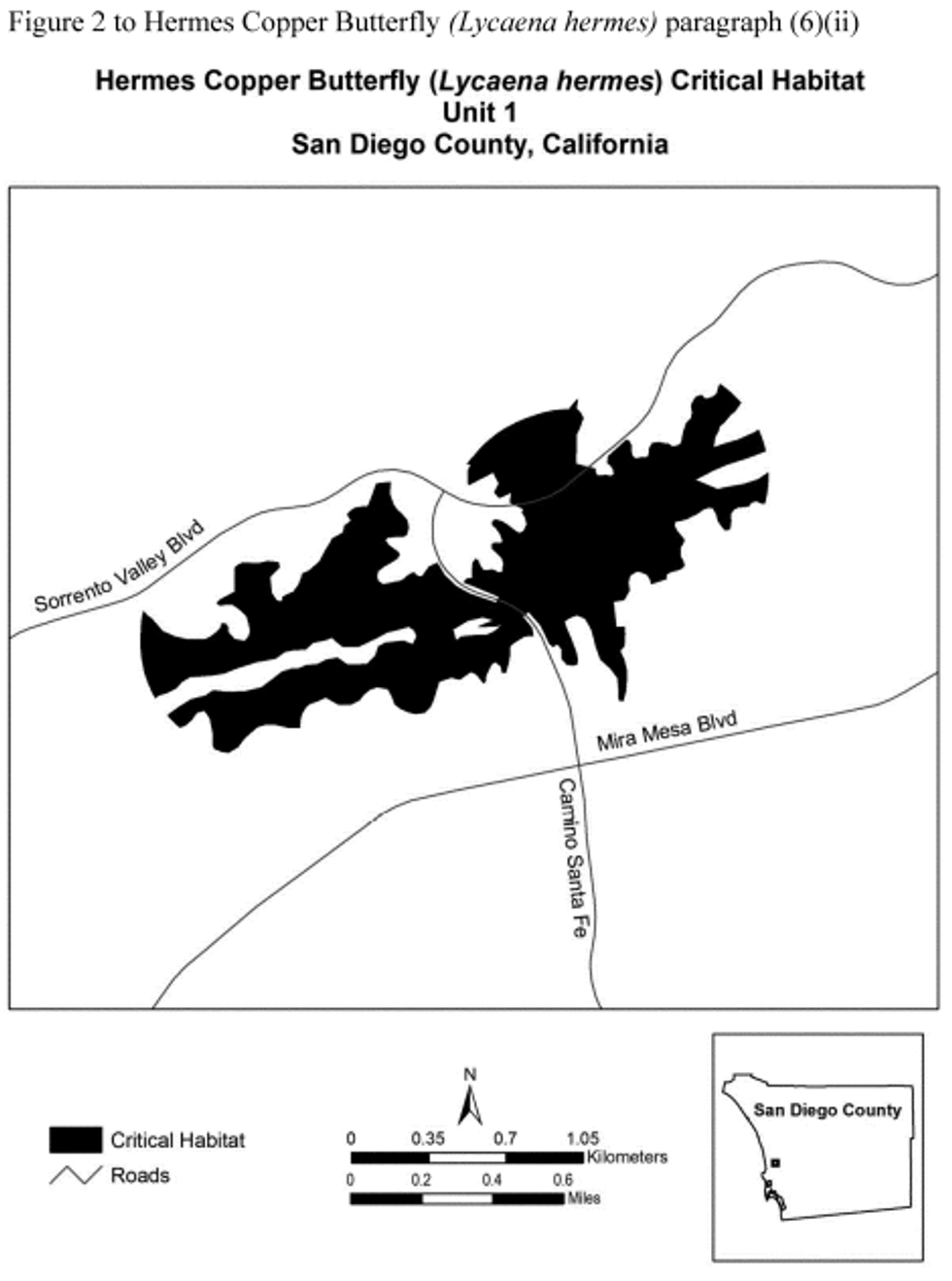
(7) Unit 2: Miramar/Santee, San Diego County, California.
(i) Unit 2 consists of 2,870 ha (7,092 ac) in San Diego County and is composed of lands owned and managed by the State of California (111 ha (275 ac)), local jurisdictions (primarily the County of San Diego; 1,113 ha (2,750 ac)), and private or other ownership (1,646 ha (4,068 ac)).
(ii) Map of Unit 2, Miramar/Santee, follows:
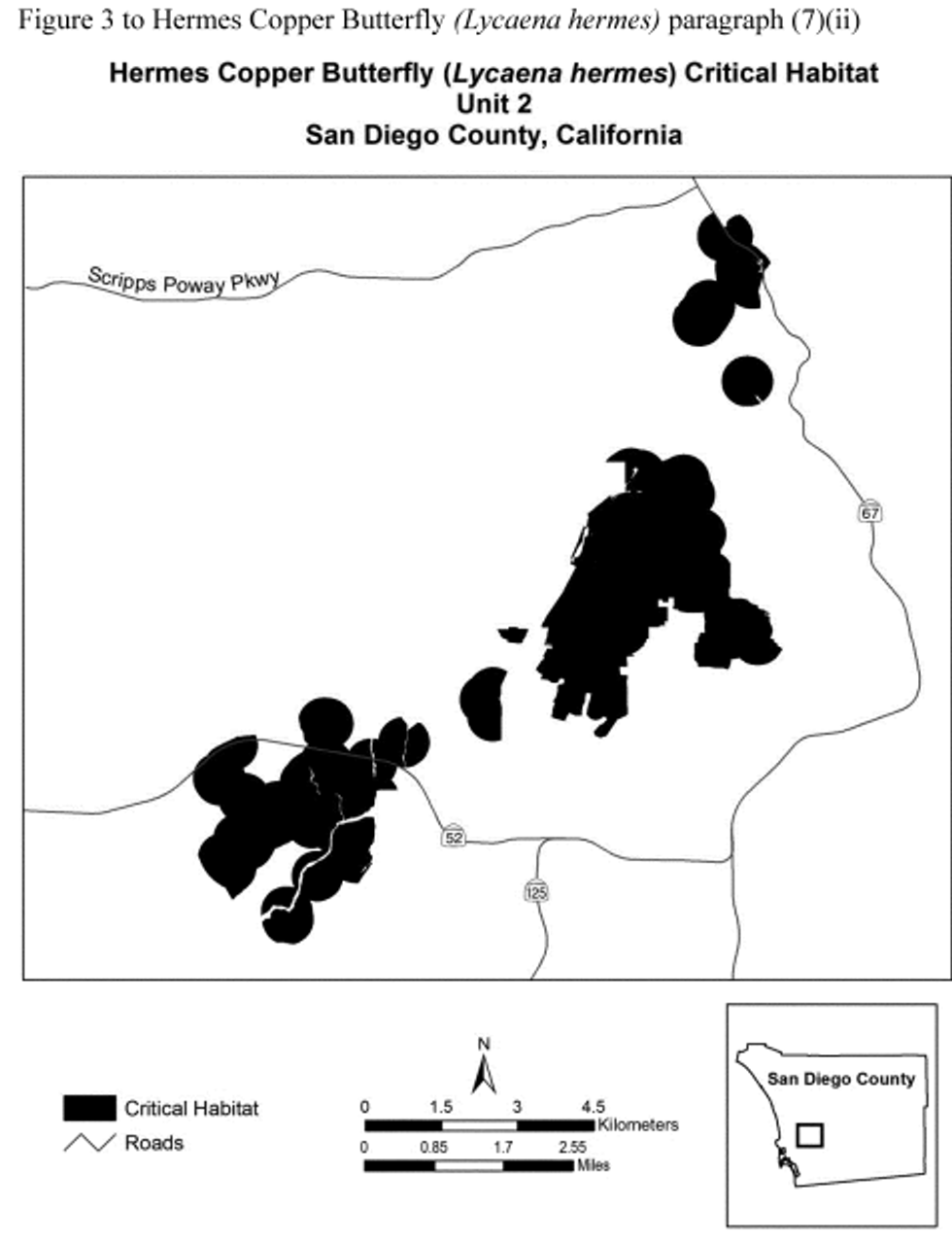
(8) Unit 3: Southeast San Diego, San Diego County, California.
(i) Unit 3 consists of 11,213 ha (27,709 ac) in San Diego County and is composed of lands owned by the Federal Government (4,213 ha (10,411 ac)), the State of California (2,000 ha (4,940 ac)), local jurisdictions (primarily the City and County of San Diego; 1,162 ha (2,871 ac)), and private or other ownership (3,765 ha (9,303 ac)).
(ii) Map of Unit 3, Southeast San Diego, follows:
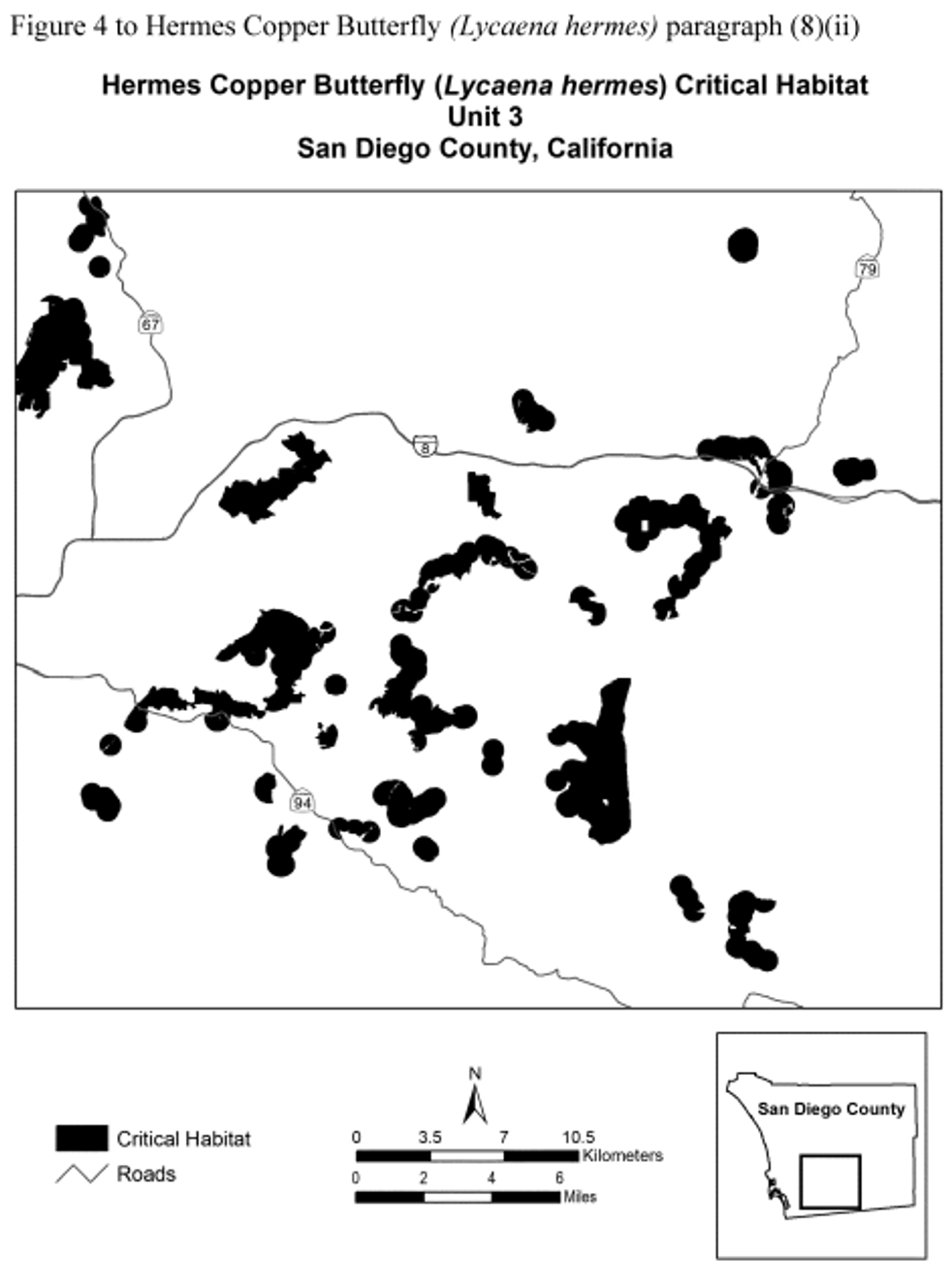
Island Marble Butterfly (Euchloe ausonides insulanus)
(1) The critical habitat unit is depicted for San Juan County, Washington, on the map below.
(2) Within the critical habitat area on San Juan Island, Washington, the physical or biological features essential to the conservation of the island marble butterfly consist of the following components:
(i) Open, primarily treeless areas with short-statured forb- and grass-dominated vegetation that include diverse topographic features such as ridgelines, hills, and bluffs for patrolling, dispersal corridors between habitat patches, and some south-facing terrain. Areas must be large enough to allow for the development of patchy-population dynamics, allowing for multiple small populations to establish within the area.
(ii) Low- to medium-density larval host plants, with both flower buds and blooms on them between the months of May through July, for egg-laying and larval development. Larval host plants may be any of the following: Brassica rapa, Sisymbrium altissimum, or Lepidium virginicum.
(iii) Adult nectar resources in flower and short-statured, white-flowering plants in bloom used for mate-finding, which may include, but are not limited to, Abronia latifolia (yellow sand verbena), Achillea millefolium (yarrow), Amsinckia menziesii (small-flowered fiddleneck), Cakile edentula (American sea rocket), Cerastium arvense (field chickweed), Erodium cicutarium (common stork's bill), Geranium molle (dovefoot geranium), Hypochaeris radicata (hairy cat's ear), Lomatium utriculatum (common lomatium), Lupinus littoralis (seashore lupine), Myosotis discolor (common forget-me-not), Ranunculus californicus (California buttercup), Rubus ursinus (trailing blackberry), Taraxacum officinale (dandelion), Toxicoscordion venenosum (death camas, formerly known as Zigadenus venenosus), and Triteleia grandiflora (Howell's brodiaea, formerly Brodiaea howellii).
(iv) Areas of undisturbed vegetation surrounding larval host plants sufficient to provide secure sites for diapause and pupation. The vegetation surrounding larval host plants must be left standing for a sufficient period of time for the island marble butterfly to complete its life cycle.
(3) Critical habitat includes road shoulders and road margins, but does not include other manmade structures (such as buildings, aqueducts, runways, paved portions of roads, and other paved areas) and the land on which they are located existing within the legal boundaries on June 4, 2020.
(4) Critical habitat map unit. Data layers defining the map were created using 2015 National Agriculture Imagery Program (NAIP) digital imagery in ArcGIS, version 10.4 (Environmental Systems Research Institute, Inc.), a computer geographic information system program. The map in this entry, as modified by any accompanying regulatory text, establishes the boundaries of the critical habitat designation. The coordinates or plot points or both on which the map is based are available to the public at the Service's internet site at https://www.fws.gov/wafwo/, at http://www.regulations.gov at Docket No. FWS-R1-ES-2016-0145, and at the field office responsible for this designation. You may obtain field office location information by contacting one of the Service regional offices, the addresses of which are listed at 50 CFR 2.2.
(5) Island marble butterfly critical habitat, San Juan County, Washington.
(i) Island marble butterfly critical habitat consists of 812 acres (ac) (329 hectares (ha)) on San Juan Island in San Juan County, Washington, and is composed of lands in Federal (742 ac (301 ha)), State (37 ac (15 ha)), State/County joint (1 ac (0.4 ha)), County (30 ac (12 ha)), and private (2 ac (0.8 ha)) ownership. The critical habitat designated on private parcels along Eagle Cove only includes the area of steep coastal bluff between the marine shoreline and the upland edge at the top of the bluff; it does not include areas landward of the top of the bluff, which are typically mowed and maintained as yard.
(ii) Map of island marble butterfly critical habitat follows:
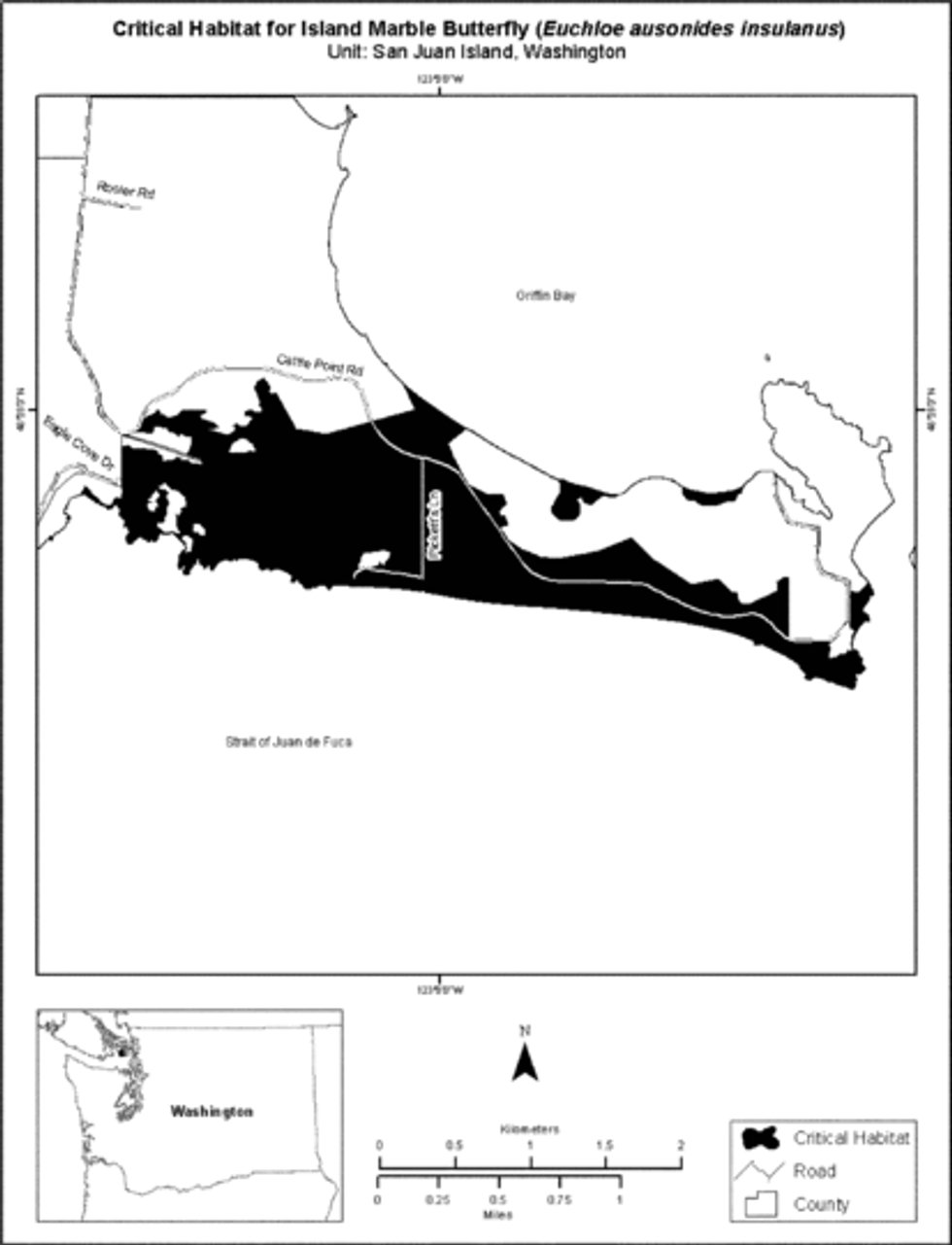
Mount Charleston Blue Butterfly (Icaricia (Plebejus) shasta charlestonensis)
(1) Critical habitat units are depicted for Clark County, Nevada, on the map below.
(2) Within these areas, the primary constituent elements of the physical or biological features essential to the conservation of the Mount Charleston blue butterfly consist of three components:
(i) Areas of dynamic habitat between 2,500 meters (m) (8,200 feet (ft)) and 3,500 m (11,500 ft) elevation with openings or where disturbance provides openings in the canopy that have no more than 50 percent tree cover (allowing sunlight to reach the ground); widely spaced, low (less than 15 centimeters (cm) (0.5 ft) in height) forbs and grasses; and exposed soil and rock substrates. When taller grass and forb plants greater than or equal to 15 cm (0.5 ft) in height are present, the density is less than five per square meter (m 2) (50 per square foot (ft 2)).
(ii) The presence of one or more species of host plants required by larvae of the Mount Charleston blue butterfly for feeding and growth. Known larval host plants are Astragalus calycosus var. calycosus, Oxytropis oreophila var. oreophila, and Astragalus platytropis. Densities of host plants must be greater than two per m 2 (0.2 per ft 2).
(iii) The presence of one or more species of nectar plants required by adult Mount Charleston blue butterflies for reproduction, feeding, and growth. Common nectar plants include Erigeron clokeyi, Hymenoxys lemmonii, Hymenoxys cooperi, and Eriogonum umbellatum var. versicolor. Densities of nectar plants must occur at more than two per m 2 (0.2 per ft 2) for smaller plants, such as E. clokeyi, and more than 0.1 per m 2 (0.01 per ft 2) for larger and taller plants, such as Hymenoxys sp. and E. umbellatum. Nectar plants typically occur within 10 m (33 ft) of larval host plants and, in combination, provide nectar during the adult flight period between mid-July and early August. Additional nectar sources that could be present in combination with the common nectar plants include Antennaria rosea, Cryptantha sp., Ericameria nauseosa ssp., Erigeron flagellaris, Guitierrezia sarothrae, Monardella odoratissima, Petradoria pumila var. pumila, and Potentilla concinna var. concinna.
(3) Critical habitat does not include manmade structures (such as buildings, aqueducts, runways, roads, and other paved areas) and the land on which they are located existing within the legal boundaries on July 30, 2015.
(4) Critical habitat map units. Data layers defining map units were created on a base of Bureau of Land Management Public Land Survey System quarter-quarter sections. Critical habitat units were then mapped using Universal Transverse Mercator (UTM) Zone 11 North, North American Datum (NAD) 1983 coordinates. The map in this entry, as modified by any accompanying regulatory text, establishes the boundaries of the critical habitat designation. The coordinates or plot points or both on which the map is based are available to the public at the Service's Internet site at http://www.fws.gov/nevada/nv_species/mcb_butterfly.html, at http://www.regulations.gov at Docket No. FWS-R8-ES-2013-0105, and at the field office responsible for this designation. You may obtain field office location information by contacting one of the Service regional offices, the addresses of which are listed at 50 CFR 2.2.
(5) Map of critical habitat units for the Mount Charleston blue butterfly follows:
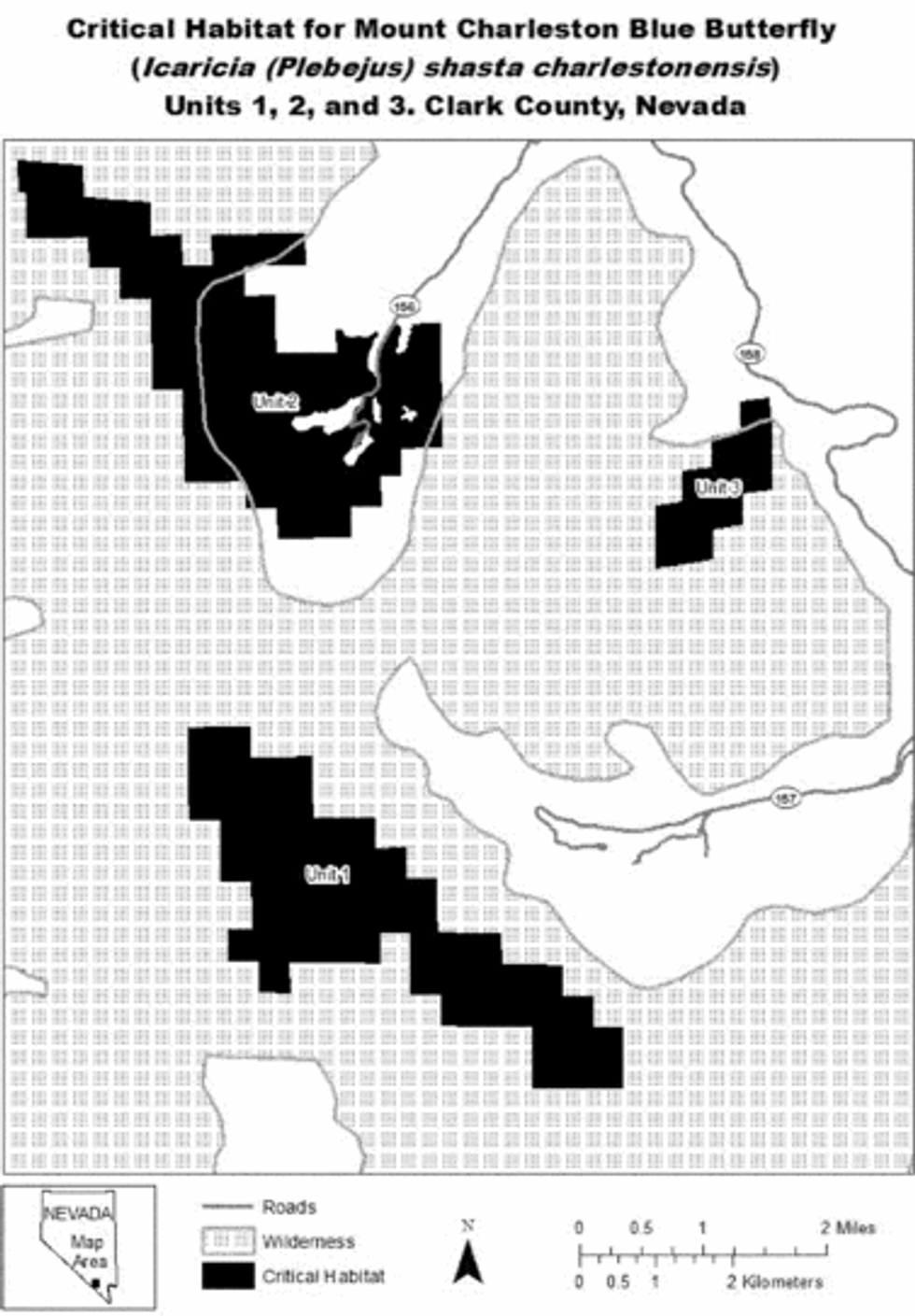
Oregon Silverspot Butterfly (Speyeria zerene hippolyta)
Oregon. Lane County T. 16 S., R. 12 W. Those portions of section 15 and of the south half of section 10 which are west of a line parallel to, and 1500 feet west of, the eastern section boundaries of sections 10 and 15.
Note:
The map provided is for informational purposes only. Map follows:
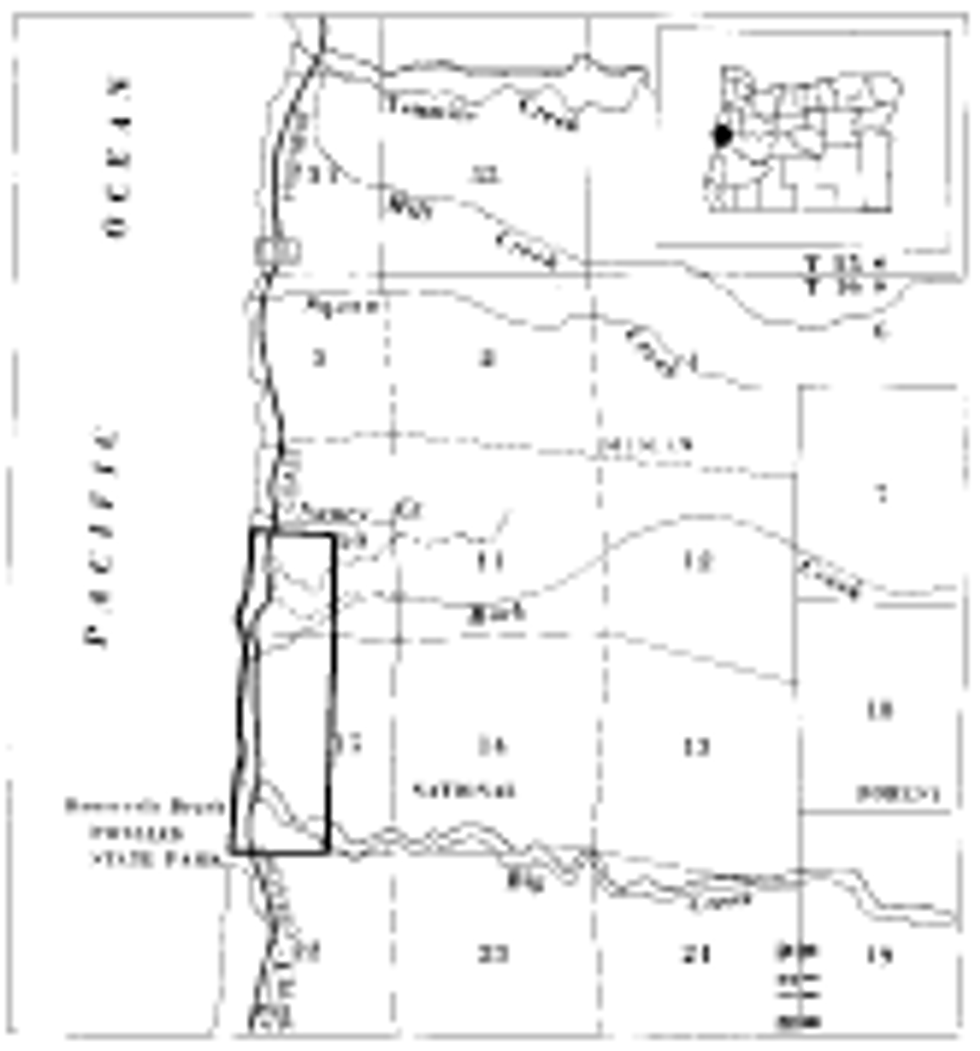
Constituent biological elements essential to the continued existence of the Oregon silverspot butterfly within the Critical Habitat include the larval foodplant (Viola adunca), grasses and forbs in which the larvae find shelter, the composite plants from which the adults obtain nectar, and the spruce woods in which the adults find shelter.
Palos Verdes Blue Butterfly (Glaucopsyche lygdamus palosverdesensis)
California. Los Angeles County. The maps provided are for informational purposes only.
1. Agua Amarga Canyon Zone. Palos Verdes Estates. A square area of land 0.4 × 0.4 kilometers located at the southeast corner of the southernmost corporate boundary of Palos Verdes Estates.
2. Frank Hesse Park Zone. Rancho Palos Verdes. An area enclosed by Hawthorne Boulevard, Locklenna Lane, and Verde Drive.
Note:
Map follows:
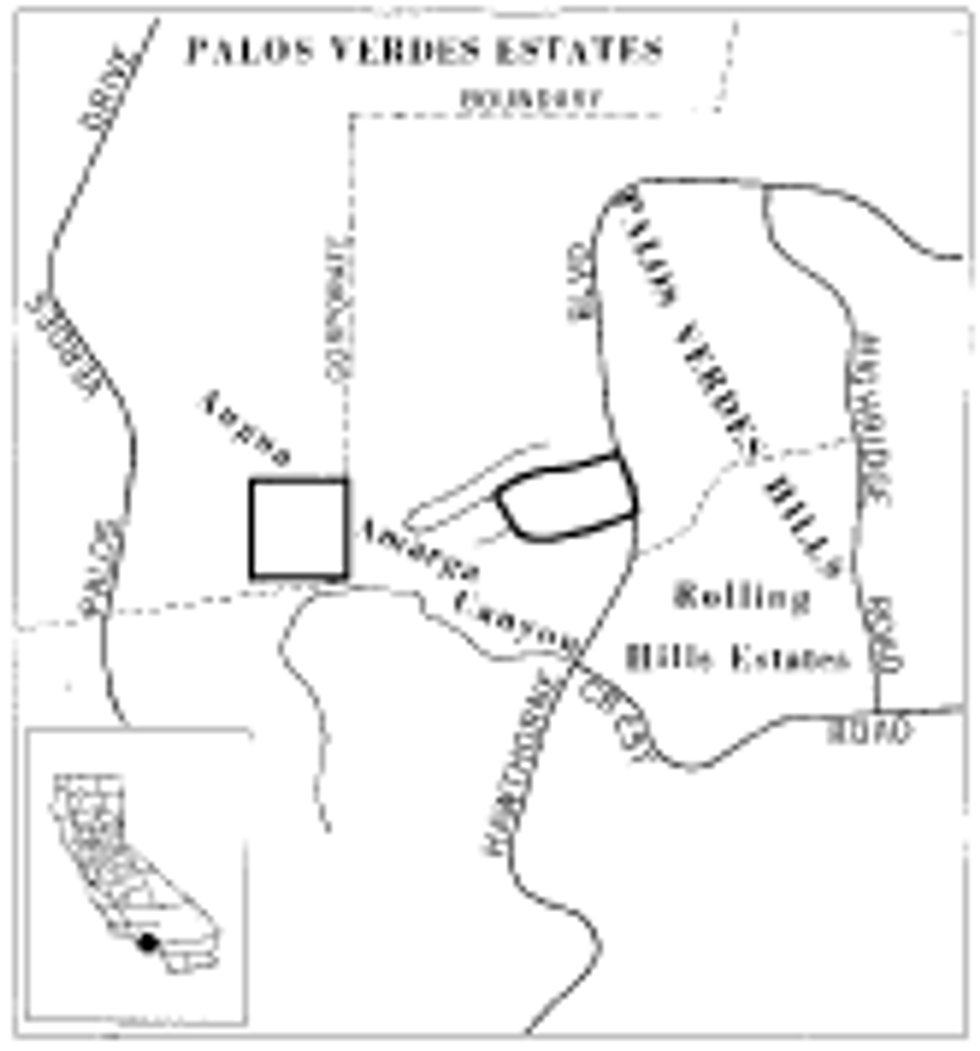
3. Palos Verdes Drive Zone. Rancho Palos Verdes. The Switchback area of Palos Verdes Drive East, bounded by a line connecting the two eastern curves, a line parallel to and 0.3 kilometers southwest of this line, and the upper and lower portions of Palos Verdes Drive East.
Note:
Map follows:
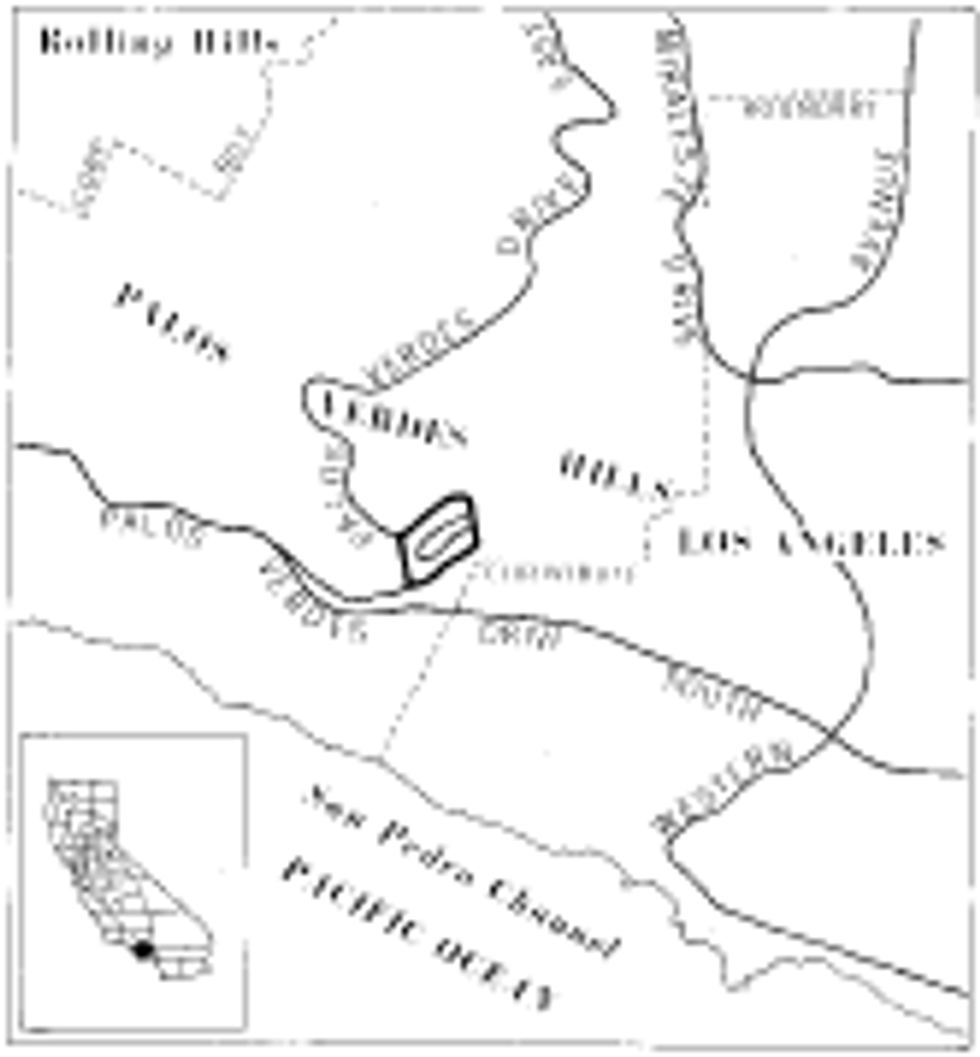
Within these Critical Habitat areas, the known biological constituent elements essential to the conservation of this species are colonies of the larval foodplant, Astragalus trichopodus leucopsis.
Puerto Rican Harlequin Butterfly (Atlantea tulita)
(1) Critical habitat units are depicted for Isabela, Quebradillas, Camuy, Arecibo, Florida, Ciales, Utuado, Maricao, Yauco, Sabana Grande, and San Germán municipalities, Puerto Rico, on the maps in this entry.
(2) Within these areas, the physical or biological features essential to the conservation of the Puerto Rican harlequin butterfly consist of the following components:
(i) Forest habitat types in the Northern Karst region in Puerto Rico: Mature secondary moist limestone evergreen and semi-deciduous forest, or young secondary moist limestone evergreen and semi-deciduous forest, or both forest types, in subtropical moist forest or subtropical wet forest life zones.
(ii) Forest habitat types in the West-central Volcanic-serpentine region in Puerto Rico: Mature secondary dry and moist serpentine semi-deciduous forest, or young secondary dry and moist serpentine semi-deciduous forest, or both forest types, in subtropical moist forest or subtropical wet forest life zones.
(iii) Components of forest habitat types: The forest habitat types described in paragraphs (2)(i) and (ii) of this entry contain:
(A) Forest area greater than 1 acre that is within 1 kilometer of a water source (stream, pond, puddle, etc.) and other forested area;
(B) Canopy cover between 50 to 85 percent and average canopy height ranging from 4 to 8 meters (13.1 to 26.2 feet); and
(C) Prickly bush (Oplonia spinosa) covering more than 30 percent of the understory.
(3) Critical habitat does not include manmade structures (such as buildings, aqueducts, runways, roads, and other paved areas) and the land on which they are located existing within the legal boundaries on January 3, 2023.
(4) Data layers defining map units were created by delineating habitats that contain at least one or more of the physical or biological features defined in paragraph (2) of this entry. We used the digital landcover layer created by the Puerto Rico GAP Analysis Project over a U.S. Department of Agriculture 2007 digital orthophoto mosaic. The resulting critical habitat unit was then mapped using State Plane North American Datum 83 coordinates. The maps in this entry, as modified by any accompanying regulatory text, establish the boundaries of the critical habitat designation. The coordinates or plot points or both on which each map is based are available to the public at the Service's internet site at https://www.fws.gov/office/caribbean-ecological-services at https://www.regulations.gov at Docket No. FWS-R4-ES-2020-0083, and at the field office responsible for this designation. You may obtain field office location information by contacting one of the Service regional offices, the addresses of which are listed at 50 CFR 2.2.
(5) Note: Index map follows:
Figure 1 to Puerto Rican Harlequin Butterfly (Atlantea tulita) paragraph (5)
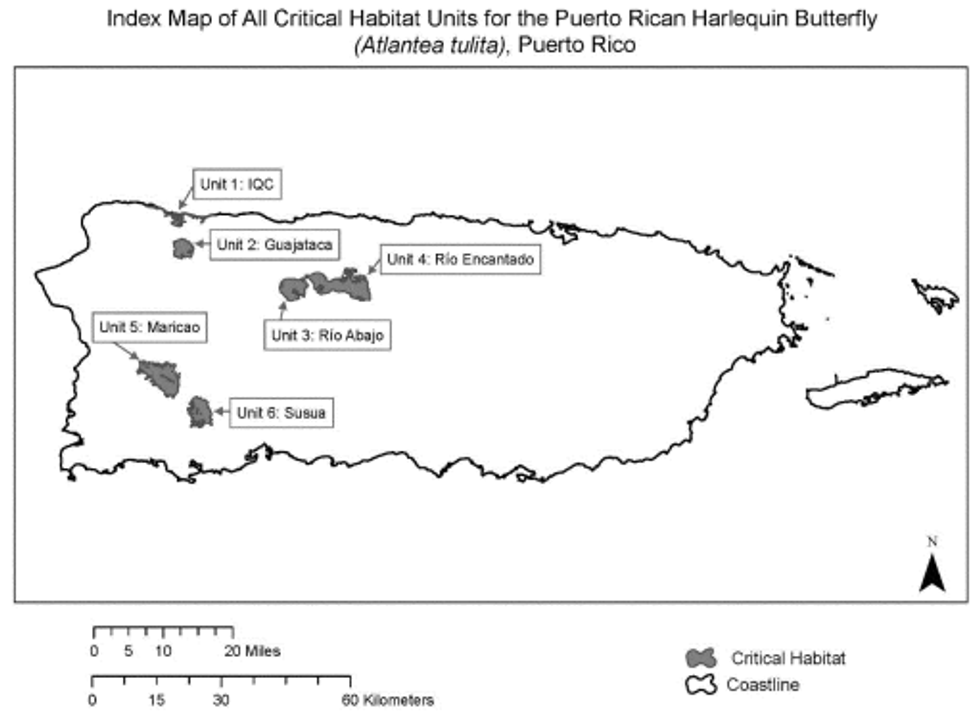
(6) Unit 1: IQC; Isabela, Quebradillas, and Camuy Municipalities, Puerto Rico.
(i) Unit 1 consists of 1,675.7 acres (678.1 hectares) located along the northern coastal cliff among the municipalities of Isabela, Quebradillas, and Camuy (IQC), 23 kilometers (15 miles) west of Arecibo. The critical habitat is bounded on the east by the community La Yeguada and Membrillo in Camuy, on the west by the community Villa Pesquera and Pueblo in Isabela, on the north by the Atlantic Ocean, and on the south by urban developments, State road PR-2, the Royal Isabela Golf Course, and some deforested areas utilized for agricultural practices such as cattle grazing. All but 5 acres (2 hectares) of Unit 1 are in private ownership.
(ii) Map of Units 1 and 2 follows:
Figure 2 to Puerto Rican Harlequin Butterfly (Atlantea tulita) paragraph (6)(ii)

(7) Unit 2: Guajataca; Isabela and Quebradillas Municipalities, Puerto Rico.
(i) Unit 2 consists of 3,839 acres (1,553.6 hectares) south of PR 2, between the municipalities Isabela and Quebradillas, 25 kilometers (15.6 miles) southwest of Arecibo. The critical habitat is bounded on the east by the San Antonio ward in Quebradillas, on the west by PR 446 at Galateo Ward in Isabela, on the north by Llanadas Ward in Isabela and Cacao Ward in Quebradillas, and on the south by Montañas de Guarionex, between Planas Ward in Isabela and Charcas Ward in Quebradillas. In Unit 2, 583.5 acres (236.1 hectares) are public land, the Guajataca Commonwealth Forest, managed by the Puerto Rico Department of Natural and Environmental Resources for conservation. Private land in Unit 2 is 3,255.5 acres (1,317.5 hectares) that is a mosaic of agricultural land, roads, rural developments, and forest.
(ii) Map of Unit 2 is set forth at paragraph (6)(ii) of this entry.
(8) Unit 3: Río Abajo; Arecibo and Utuado Municipalities, Puerto Rico.
(i) Unit 3 consists of 5,939.2 acres (2,403.6 hectares) located 14.5 kilometers (9 miles) south of Arecibo. The critical habitat is bound on the east by the Río Grande de Arecibo, on the west by Santa Rosa Ward in Utuado, on the north by Hato Viejo Ward in Arecibo, and on the south by Caguana and Sabana Grande Wards in Utuado. The Río Abajo Commonwealth Forest, managed for conservation by the Puerto Rico Department of Natural and Environmental Resources, occupies 77 percent (4,544.4 acres (1,839.1 hectares)) of the unit. The other 23 percent (1,394.8 acres (564.5 hectares)) is privately owned and is a mosaic of highways, roads, agriculture, and rural development.
(ii) Map of Units 3 and 4 follows:
Figure 3 to Puerto Rican Harlequin Butterfly (Atlantea tulita) paragraph (8)(ii)
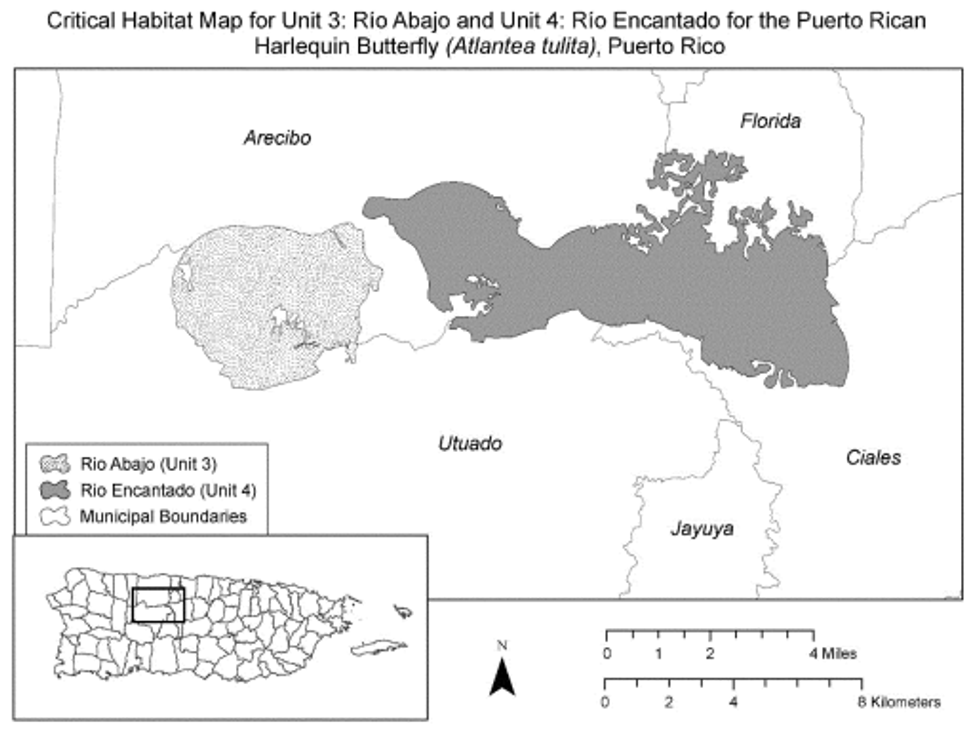
(9) Unit 4: Río Encantado; Arecibo, Florida, Ciales, and Utuado Municipalities, Puerto Rico.
(i) Unit 4 consists of 12,775.6 acres (5,170.1 hectares) located among the municipalities of Arecibo, Florida, Ciales, and Utuado, 17 kilometers (10.5 miles) southeast of Arecibo. The critical habitat is bound on the east by Hato Viejo Ward in Ciales, on the west by the Río Grande de Arecibo, on the north by Arrozales Ward in Arecibo and Pueblo Ward in Florida, and on the south by PR 146 along Limón Ward in Utuado and Frontón Ward in Ciales. Thirteen percent of the critical habitat (204.8 acres (82.9 hectares)) is managed by Para La Naturaleza or by the Puerto Rico Department of Natural and Environmental Resources for conservation. The other 87 percent (12,570.8 acres (5,087.2 hectares)) consists of private lands, some of which are agricultural fields, roads, and rural developments, but a majority of which is mature native forest.
(ii) Map of Unit 4 is set forth at paragraph (8)(ii) of this entry.
(10) Unit 5: Maricao; Maricao, Sabana Grande, and San Germán Municipalities, Puerto Rico.
(i) Unit 5 consists of 10,854.6 acres (4,392.7 hectares) on the west end of the Cordillerra Central, among the municipalities of Maricao, San Germán, and Sabana Grande, 16.1 kilometers (10 miles) southeast of Mayagüez. The critical habitat is bound on the east by Tabonuco Ward in Sabana Grande, on the west by Rosario Ward in San Germán, on the north by Pueblo Ward in Maricao, and on the south by Guamá and Santana Wards in San Germán. The Maricao Commonwealth Forest, managed for conservation by the Puerto Rico Department of Natural and Environmental Resources, occupies 72 percent (7,883.1 acres (3,190.2 hectares)) of the unit. The other 28 percent (2,971.5 acres (1,202.5 hectares)) is private land consisting of a mosaic of agriculture, rural developments, and forest.
(ii) Map of Units 5 and 6 follows:
Figure 4 to Puerto Rican Harlequin Butterfly (Atlantea tulita) paragraph (10)(ii)
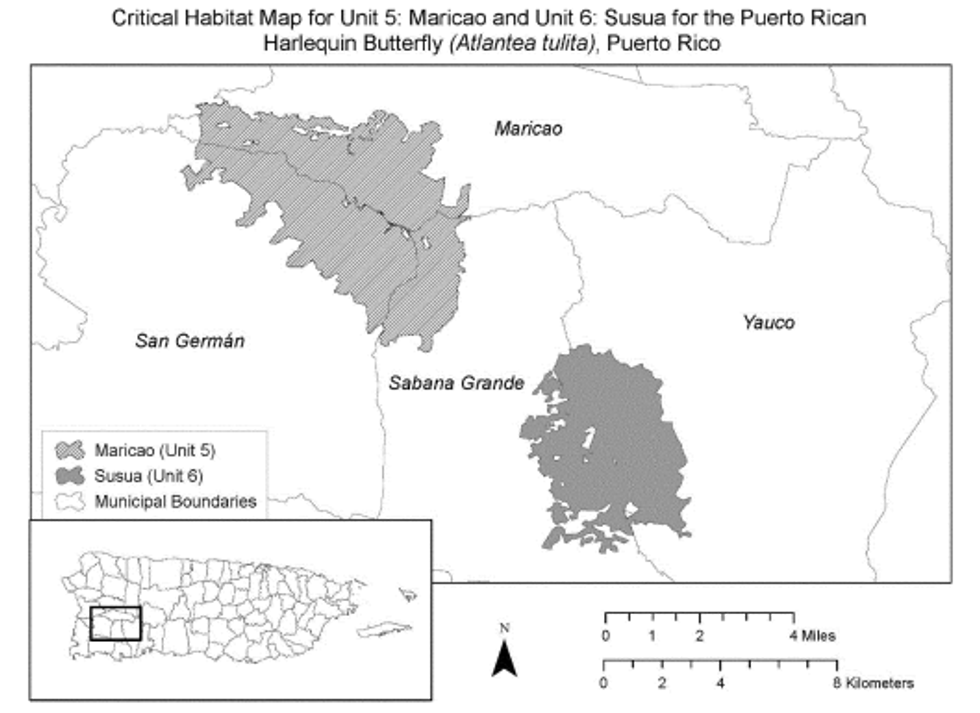
(11) Unit 6: Susúa; Sabana Grande and Yauco Municipalities, Puerto Rico.
(i) Unit 6 consists of 6,181.9 acres (2,501.8 hectares) between the municipalities of Sabana Grande and Yauco, 33.6 kilometers (21 miles) northwest of Ponce. The critical habitat is bound on the east by the PR 371 in Almacigo Alto and Collores Wards in Yauco, on the west by Pueblo Ward in Sabana Grande, on the north by Frailes Ward in Yauco, and on the south by PR 368 in Susúa Ward in Sabana Grande. The Susúa Commonwealth Forest, managed by the Puerto Rico Department of Natural and Environmental Resources for conservation, occupies 51 percent (3,171.5 acres (1,283.5 hectares)) of the critical habitat in this unit. The other 49 percent (3,010.4 acres (1,218.3 hectares)) is on private lands that are a mosaic of agriculture, rural developments, and forest.
(ii) Map of Unit 6 is set forth at paragraph (10)(ii) of this entry.
Quino Checkerspot Butterfly (Euphydryas editha quino)
(1) Critical habitat units are depicted for Riverside and San Diego Counties, California, on the maps below.
(2) The primary constituent elements of critical habitat for the Quino checkerspot butterfly are:
(i) Open areas within scrublands at least 21.5 square feet (ft2) (2 square meters (m)) in size that:
(A) Contain no woody canopy cover; and
(B) Contain one or more of the host plants Plantago erecta, Plantago patagonica, Antirrhinum coulterianum, or Collinsia concolor used for Quino checkerspot butterfly growth, reproduction, and feeding; or
(C) Contain one or more of the host plants Cordylanthus rigidus or Castilleja exserta that are within 328 ft (100 m) of the host plants listed in paragraph (2)(i)(B) above; or
(D) Contain flowering plants with a corolla tube less than or equal to 0.43 in (11 mm) used for Quino checkerspot butterfly feeding;
(ii) Open scrubland areas and vegetation within 656 ft (200 m) of the open canopy areas (described in paragraph (2)(i) of this entry) used for movement and basking; and
(iii) Hilltops or ridges within scrublands, containing an open, woody-canopy area at least 21.5 ft 2 (2 m 2) in size used for Quino checkerspot butterfly mating (hilltopping behavior) and are contiguous with (but not otherwise included in) open areas and natural vegetation described in paragraphs (2)(i) and (ii) above.
(3) Critical habitat does not include manmade structures (such as buildings, aqueducts, airports, roads, and other paved areas) and the land on which they are located existing within the legal boundaries on the effective date of this rule.
(4) Critical habitat map units. Data layers defining map units were created on a base of USGS 1:24,000 maps, and critical habitat units were then mapped using Universal Transverse Mercator (UTM) coordinates.
(5) Index map of critical habitat units for the Quino checkerspot butterfly follows:
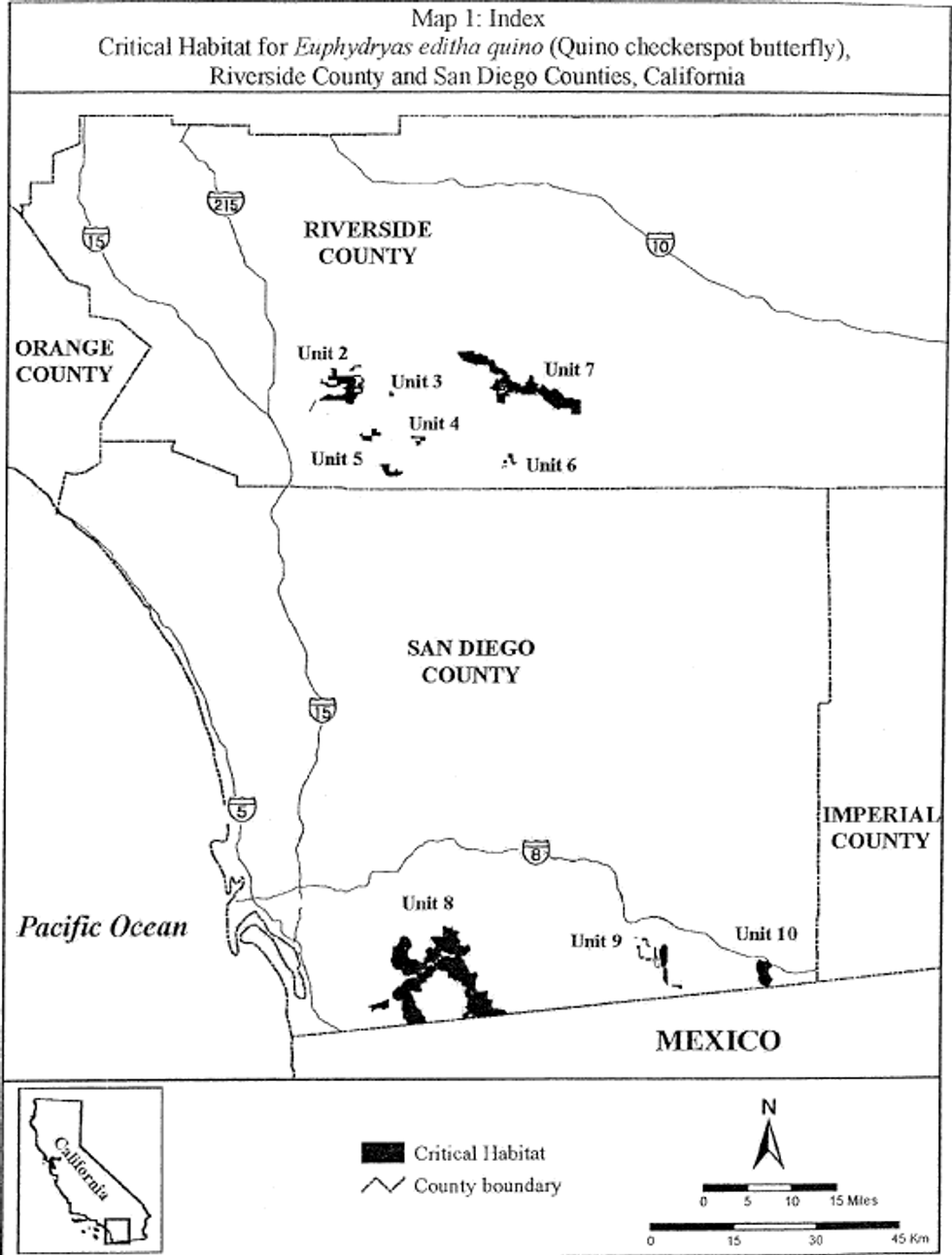
(6) Unit 2: Skinner/Johnson, Riverside County, California.
(i) From USGS 1:24,000 quadrangles Murrieta, Bachelor Mountain, Winchester, Sage, and Hemet. Unit 2 excludes land bounded by the following Universal Transverse Mercator (UTM) North American Datum of 1983 (NAD83) coordinates (E, N): 499546, 3716748; 499545, 3716748; 499545, 3716748; 499545, 3716748; 499545, 3716748; 499545, 3716748; 499545, 3716748; 499545, 3716748; 499544, 3716748; 499544, 3716748; 499544, 3716748; 499544, 3716748; 499544, 3716748; 499544, 3716748; 499543, 3716748; 499543, 3716748; 499543, 3716748; 499543, 3716748; 499543, 3716748; 499543, 3716748; 499543, 3716748; 499542, 3716748; 499542, 3716748; 499542, 3716748; 499542, 3716748; 499542, 3716748; 499542, 3716748; 499542, 3716748; 499541, 3716748; 499541, 3716748; 499541, 3716748; 499541, 3716748; 499541, 3716748; 499541, 3716748; 499540, 3716748; 499540, 3716748; 499540, 3716748; 499540, 3716748; 499540, 3716748; 499540, 3716748; 499540, 3716748; 499539, 3716748; 499539, 3716748; 499539, 3716748; 499539, 3716749; 499539, 3716749; 499539, 3716749; 499538, 3716749; 499538, 3716749; 499538, 3716749; 499538, 3716749; 499538, 3716749; 499538, 3716749; 499538, 3716749; 499537, 3716749; 499537, 3716749; 499537, 3716749; 499537, 3716749; 499537, 3716749; 499537, 3716749; 499537, 3716749; 499536, 3716749; 499536, 3716749; 499536, 3716749; 499536, 3716749; 499536, 3716749; 499536, 3716749; 499535, 3716749; 499535, 3716749; 499535, 3716749; 499535, 3716749; 499535, 3716749; 499535, 3716749; 499535, 3716749; 499534, 3716749; 499534, 3716749; 499534, 3716750; 499534, 3716750; 499534, 3716750; 499534, 3716750; 499534, 3716750; 499533, 3716750; 499533, 3716750; 499533, 3716750; 499533, 3716750; 499533, 3716750; 499533, 3716750; 499533, 3716750; 499532, 3716750; 499532, 3716750; 499532, 3716750; 499532, 3716750; 499532, 3716750; 499532, 3716750; 499532, 3716750; 499531, 3716750; 499531, 3716750; 499531, 3716750; 499531, 3716750; 499531, 3716751; 499531, 3716751; 499531, 3716751; 499530, 3716751; 499530, 3716751; 499530, 3716751; 499530, 3716751; 499530, 3716751; 499530, 3716751; 499530, 3716751; 499529, 3716751; 499529, 3716751; 499529, 3716751; 499529, 3716751; 499529, 3716751; 499529, 3716751; 499529, 3716751; 499528, 3716751; 499528, 3716751; 499528, 3716752; 499528, 3716752; 499528, 3716752; 499528, 3716752; 499528, 3716752; 499527, 3716752; 499527, 3716752; 499527, 3716752; 499527, 3716752; 499527, 3716752; 499527, 3716752; 499527, 3716752; 499526, 3716752; 499526, 3716752; 499526, 3716752; 499526, 3716752; 499526, 3716753; 499526, 3716753; 499526, 3716753; 499525, 3716753; 499525, 3716753; 499525, 3716753; 499525, 3716753; 499525, 3716753; 499525, 3716753; 499525, 3716753; 499525, 3716753; 499524, 3716753; 499524, 3716753; 499524, 3716753; 499524, 3716754; 499524, 3716754; 499524, 3716754; 499524, 3716754; 499523, 3716754; 499523, 3716754; 499523, 3716754; 499523, 3716754; 499523, 3716754; 499523, 3716754; 499523, 3716754; 499523, 3716754; 499522, 3716754; 499522, 3716755; 499522, 3716755; 499522, 3716755; 499522, 3716755; 499522, 3716755; 499522, 3716755; 499521, 3716755; 499521, 3716755; 499521, 3716755; 499521, 3716755; 499521, 3716755; 499521, 3716755; 499521, 3716755; 499521, 3716756; 499520, 3716756; 499520, 3716756; 499520, 3716756; 499520, 3716756; 499520, 3716756; 499520, 3716756; 499520, 3716756; 499520, 3716756; 499519, 3716756; 499519, 3716756; 499519, 3716757; 499519, 3716757; 499519, 3716757; 499519, 3716757; 499519, 3716757; 499519, 3716757; 499518, 3716757; 499518, 3716757; 499518, 3716757; 499518, 3716757; 499518, 3716757; 499518, 3716758; 499518, 3716758; 499518, 3716758; 499518, 3716758; 499517, 3716758; 499517, 3716758; 499517, 3716758; 499517, 3716758; 499517, 3716758; 499517, 3716758; 499517, 3716758; 499517, 3716759; 499516, 3716759; 499516, 3716759; 499516, 3716759; 499516, 3716759; 499516, 3716759; 499516, 3716759; 499516, 3716759; 499516, 3716759; 499516, 3716759; 499515, 3716760; 499515, 3716760; 499515, 3716760; 499515, 3716760; 499515, 3716760; 499515, 3716760; 499515, 3716760; 499515, 3716760; 499514, 3716760; 499514, 3716760; 499514, 3716761; 499514, 3716761; 499514, 3716761; 499514, 3716761; 499514, 3716761; 499514, 3716761; 499514, 3716761; 499514, 3716761; 499513, 3716761; 499513, 3716762; 499513, 3716762; 499513, 3716762; 499513, 3716762; 499513, 3716762; 499513, 3716762; 499513, 3716762; 499513, 3716762; 499512, 3716762; 499512, 3716763; 499512, 3716763; 499512, 3716763; 499512, 3716763; 499512, 3716763; 499512, 3716763; 499512, 3716763; 499512, 3716763; 499512, 3716763; 499511, 3716764; 499511, 3716764; 499511, 3716764; 499511, 3716764; 499511, 3716764; 499511, 3716764; 499511, 3716764; 499511, 3716764; 499511, 3716764; 499511, 3716765; 499511, 3716765; 499510, 3716765; 499508, 3716768; 499493, 3716786; 499493, 3716786; 499492, 3716787; 499492, 3716787; 499492, 3716787; 499492, 3716787; 499492, 3716787; 499492, 3716787; 499492, 3716787; 499492, 3716787; 499492, 3716788; 499492, 3716788; 499491, 3716788; 499491, 3716788; 499491, 3716788; 499491, 3716788; 499491, 3716788; 499491, 3716788; 499491, 3716788; 499491, 3716789; 499491, 3716789; 499491, 3716789; 499491, 3716789; 499490, 3716789; 499490, 3716789; 499490, 3716789; 499490, 3716789; 499490, 3716790; 499490, 3716790; 499490, 3716790; 499490, 3716790; 499490, 3716790; 499490, 3716790; 499490, 3716790; 499489, 3716790; 499489, 3716791; 499489, 3716791; 499489, 3716791; 499489, 3716791; 499489, 3716791; 499489, 3716791; 499489, 3716791; 499489, 3716791; 499489, 3716792; 499489, 3716792; 499489, 3716792; 499489, 3716792; 499488, 3716792; 499488, 3716792; 499488, 3716792; 499488, 3716792; 499488, 3716792; 499488, 3716792; 499488, 3716793; 499488, 3716793; 499488, 3716793; 499488, 3716793; 499488, 3716793; 499488, 3716793; 499487, 3716793; 499487, 3716793; 499487, 3716794; 499487, 3716794; 499487, 3716794; 499487, 3716794; 499487, 3716794; 499487, 3716794; 499487, 3716794; 499487, 3716794; 499487, 3716795; 499487, 3716795; 499486, 3716795; 499486, 3716795; 499486, 3716795; 499486, 3716795; 499486, 3716795; 499486, 3716795; 499486, 3716796; 499486, 3716796; 499486, 3716796; 499486, 3716796; 499486, 3716796; 499486, 3716796; 499486, 3716796; 499485, 3716797; 499485, 3716797; 499485, 3716797; 499485, 3716797; 499485, 3716797; 499485, 3716797; 499485, 3716797; 499485, 3716797; 499485, 3716798; 499485, 3716798; 499485, 3716798; 499485, 3716798; 499485, 3716798; 499484, 3716798; 499484, 3716798; 499484, 3716799; 499484, 3716799; 499484, 3716799; 499484, 3716799; 499484, 3716799; 499484, 3716799; 499484, 3716799; 499484, 3716799; 499484, 3716800; 499484, 3716800; 499484, 3716800; 499484, 3716800; 499483, 3716800; 499483, 3716800; 499483, 3716800; 499483, 3716801; 499483, 3716801; 499483, 3716801; 499483, 3716801; 499483, 3716801; 499483, 3716801; 499483, 3716801; 499483, 3716801; 499483, 3716802; 499483, 3716802; 499483, 3716802; 499482, 3716802; 499482, 3716802; 499482, 3716802; 499482, 3716802; 499482, 3716803; 499482, 3716803; 499477, 3716812; 499477, 3716813; 499453, 3716862; 499453, 3716862; 499453, 3716862; 499444, 3716871; 499353, 3716944; 499347, 3716948; 499248, 3717028; 499067, 3716918; 498635, 3716657; 498635, 3716657; 498634, 3716602; 498629, 3716418; 498795, 3716421; 499116, 3716425; 499299, 3716427; 499334, 3716428; 499415, 3716429; 499415, 3716429; 499806, 3716412; 499810, 3716412; 499814, 3716412; 499816, 3716856; 499816, 3716856; 499809, 3716855; 499684, 3716831; 499675, 3716825; 499659, 3716812; 499602, 3716769; 499564, 3716752; 499564, 3716752; 499564, 3716752; 499564, 3716752; 499564, 3716752; 499564, 3716752; 499564, 3716752; 499563, 3716752; 499563, 3716751; 499563, 3716751; 499563, 3716751; 499563, 3716751; 499563, 3716751; 499563, 3716751; 499562, 3716751; 499562, 3716751; 499562, 3716751; 499562, 3716751; 499562, 3716751; 499562, 3716751; 499562, 3716751; 499561, 3716751; 499561, 3716751; 499561, 3716751; 499561, 3716751; 499561, 3716751; 499561, 3716751; 499561, 3716750; 499560, 3716750; 499560, 3716750; 499560, 3716750; 499560, 3716750; 499560, 3716750; 499560, 3716750; 499560, 3716750; 499559, 3716750; 499559, 3716750; 499559, 3716750; 499559, 3716750; 499559, 3716750; 499559, 3716750; 499559, 3716750; 499558, 3716750; 499558, 3716750; 499558, 3716750; 499558, 3716750; 499558, 3716750; 499558, 3716750; 499558, 3716750; 499557, 3716749; 499557, 3716749; 499557, 3716749; 499557, 3716749; 499557, 3716749; 499557, 3716749; 499556, 3716749; 499556, 3716749; 499556, 3716749; 499556, 3716749; 499556, 3716749; 499556, 3716749; 499556, 3716749; 499555, 3716749; 499555, 3716749; 499555, 3716749; 499555, 3716749; 499555, 3716749; 499555, 3716749; 499555, 3716749; 499554, 3716749; 499554, 3716749; 499554, 3716749; 499554, 3716749; 499554, 3716749; 499554, 3716749; 499554, 3716749; 499553, 3716749; 499553, 3716749; 499553, 3716749; 499553, 3716749; 499553, 3716749; 499553, 3716749; 499552, 3716748; 499552, 3716748; 499552, 3716748; 499552, 3716748; 499552, 3716748; 499552, 3716748; 499552, 3716748; 499551, 3716748; 499551, 3716748; 499551, 3716748; 499551, 3716748; 499551, 3716748; 499551, 3716748; 499550, 3716748; 499550, 3716748; 499550, 3716748; 499550, 3716748; 499550, 3716748; 499550, 3716748; 499550, 3716748; 499549, 3716748; 499549, 3716748; 499549, 3716748; 499549, 3716748; 499549, 3716748; 499549, 3716748; 499549, 3716748; 499548, 3716748; 499548, 3716748; 499548, 3716748; 499548, 3716748; 499548, 3716748; 499548, 3716748; 499547, 3716748; 499547, 3716748; 499547, 3716748; 499547, 3716748; 499547, 3716748; 499547, 3716748; 499547, 3716748.
(ii) Map of Unit 2, Skinner/Johnson follows:
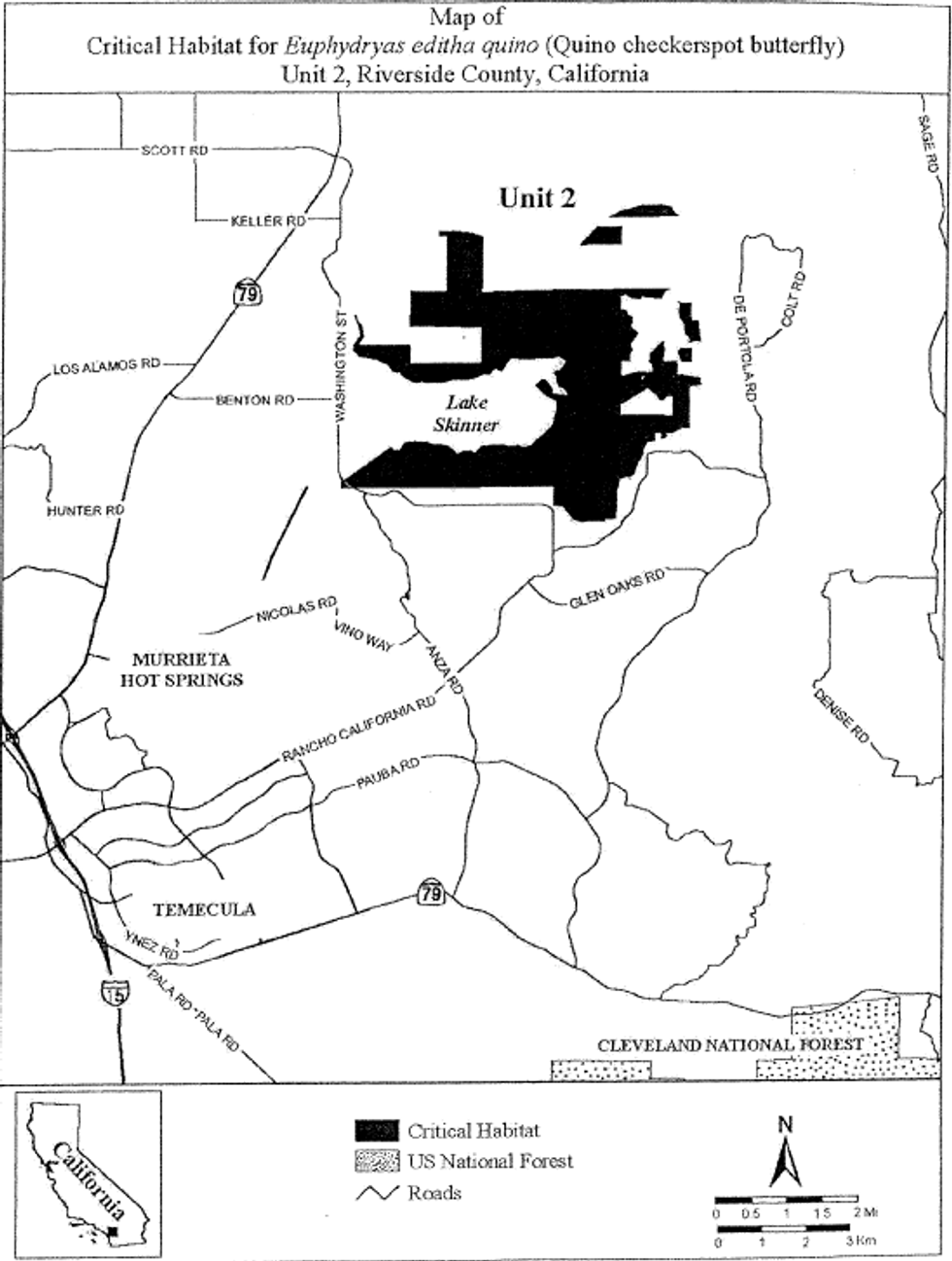
(7) Unit 3: Sage Unit, Riverside County, California.
(i) [Reserved]
(ii) Map of Unit 3 (Sage Unit), Unit 4 (Wilson Valley Unit), and Unit 5 (Vail Lake/Oak Mountain Unit) follows:
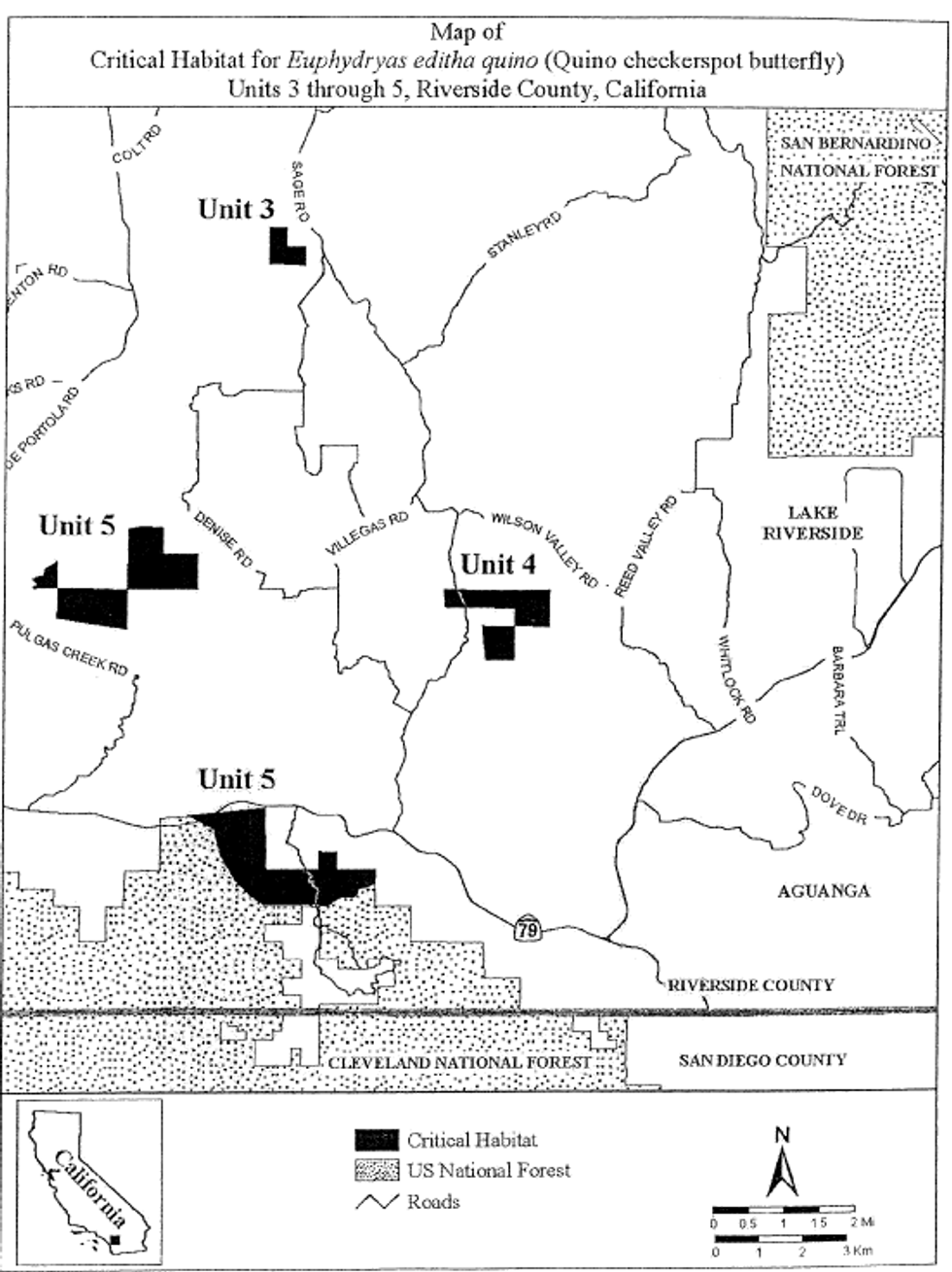
(8) Unit 4: Wilson Valley Unit, Riverside County, California.
(i) [Reserved]
(ii) Unit 4 (Wilson Valley) for the Quino checkerspot butterfly is depicted on the map in paragraph (7)(ii) of this entry.
(9) Unit 5: Vail Lake/Oak Mountain Unit, Riverside County, California.
(i) [Reserved]
(ii) Unit 5 (Vail Lake/Oak Mountain) for the Quino checkerspot butterfly is depicted on the map in paragraph (7)(ii) of this entry.
(10) Unit 6: Tule Peak Unit, Riverside County, California.
(i) [Reserved]
(ii) Map of Unit 6 (Tule Peak) and Unit 7 (Bautista) follows:
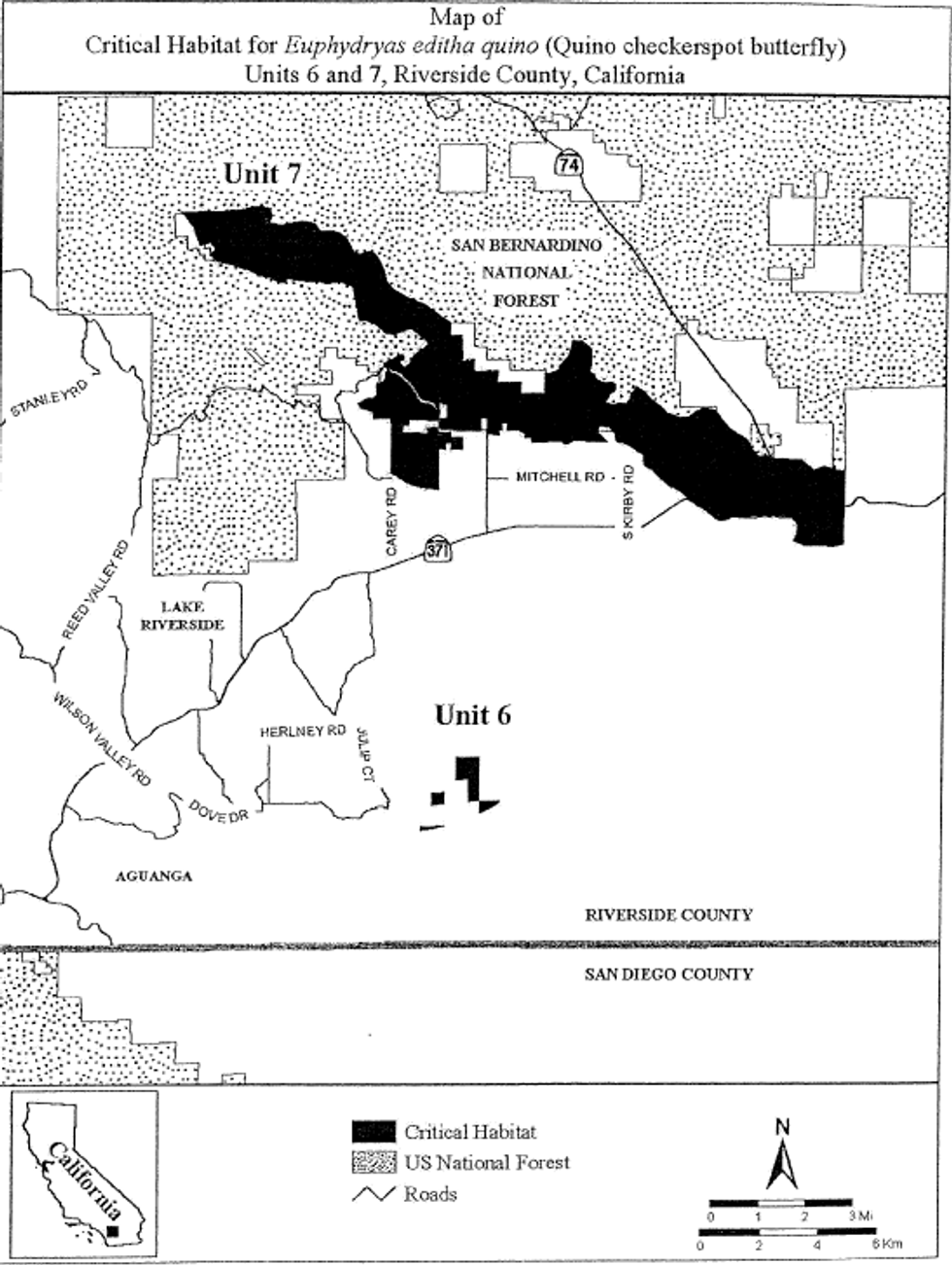
(11) Unit 7: Bautista Unit, Riverside County, California.
(i) From USGS 1:24,000 quadrangles Anza, Butterfly Peak, Blackburn Canyon, and Idyllwild. Unit 7 excludes land bounded by the following Universal Transverse Mercator (UTM) North American Datum of 1983 (NAD83) coordinates (E, N):
(A) 525336, 3717346; 525538, 3717338; 525526, 3717651; 525245, 3717656; 525259, 3717478; 525275, 3717451; and
(B) 525483, 3717132; 525482, 3717132; 525478, 3717134; 525478, 3717134; 525473, 3717137; 525473, 3717137; 525468, 3717139; 525468, 3717139; 525463, 3717142; 525463, 3717142; 525459, 3717145; 525458, 3717145; 525454, 3717148; 525454, 3717148; 525449, 3717151; 525449, 3717151; 525445, 3717154; 525445, 3717154; 525440, 3717157; 525440, 3717157; 525436, 3717160; 525436, 3717160; 525431, 3717164; 525431, 3717164; 525427, 3717167; 525427, 3717167; 525423, 3717170; 525423, 3717171; 525419, 3717174; 525418, 3717174; 525414, 3717178; 525414, 3717178; 525410, 3717181; 525410, 3717181; 525406, 3717185; 525406, 3717185; 525402, 3717189; 525402, 3717189; 525398, 3717193; 525398, 3717193; 525395, 3717197; 525394, 3717197; 525391, 3717201; 525391, 3717201; 525387, 3717205; 525387, 3717205; 525384, 3717209; 525383, 3717209; 525380, 3717213; 525380, 3717213; 525377, 3717217; 525376, 3717218; 525373, 3717222; 525373, 3717222; 525370, 3717226; 525370, 3717226; 525367, 3717231; 525366, 3717231; 525363, 3717235; 525363, 3717235; 525360, 3717240; 525360, 3717240; 525357, 3717244; 525357, 3717244; 525354, 3717249; 525354, 3717249; 525351, 3717254; 525255, 3717419; 525269, 3717240; 525299, 3716874; 525328, 3716873; 525366, 3716908; 525367, 3716909; 525367, 3716909; 525368, 3716910; 525368, 3716910; 525369, 3716911; 525369, 3716911; 525370, 3716911; 525370, 3716912; 525371, 3716912; 525371, 3716913; 525372, 3716913; 525372, 3716914; 525372, 3716914; 525373, 3716914; 525373, 3716915; 525374, 3716915; 525374, 3716916; 525375, 3716916; 525375, 3716917; 525376, 3716917; 525376, 3716917; 525377, 3716918; 525377, 3716918; 525378, 3716919; 525378, 3716919; 525379, 3716919; 525379, 3716920; 525380, 3716920; 525380, 3716921; 525381, 3716921; 525381, 3716921; 525382, 3716922; 525382, 3716922; 525383, 3716923; 525383, 3716923; 525384, 3716923; 525384, 3716924; 525385, 3716924; 525385, 3716925; 525386, 3716925; 525386, 3716925; 525387, 3716926; 525387, 3716926; 525388, 3716927; 525388, 3716927; 525389, 3716927; 525389, 3716928; 525390, 3716928; 525390, 3716929; 525391, 3716929; 525392, 3716929; 525392, 3716930; 525393, 3716930; 525393, 3716930; 525394, 3716931; 525394, 3716931; 525395, 3716932; 525395, 3716932; 525396, 3716932; 525396, 3716933; 525397, 3716933; 525397, 3716933; 525398, 3716934; 525398, 3716934; 525399, 3716935; 525399, 3716935; 525400, 3716935; 525400, 3716936; 525401, 3716936; 525402, 3716936; 525402, 3716937; 525403, 3716937; 525403, 3716937; 525404, 3716938; 525404, 3716938; 525405, 3716938; 525405, 3716939; 525406, 3716939; 525406, 3716939; 525407, 3716940; 525408, 3716940; 525408, 3716940; 525409, 3716941; 525409, 3716941; 525410, 3716941; 525410, 3716942; 525411, 3716942; 525411, 3716942; 525412, 3716943; 525412, 3716943; 525413, 3716943; 525414, 3716944; 525414, 3716944; 525415, 3716944; 525415, 3716945; 525416, 3716945; 525416, 3716945; 525417, 3716946; 525418, 3716946; 525418, 3716946; 525419, 3716947; 525419, 3716947; 525420, 3716947; 525420, 3716948; 525421, 3716948; 525421, 3716948; 525422, 3716948; 525423, 3716949; 525423, 3716949; 525424, 3716949; 525424, 3716950; 525425, 3716950; 525425, 3716950; 525426, 3716950; 525427, 3716951; 525427, 3716951; 525428, 3716951; 525428, 3716952; 525429, 3716952; 525430, 3716952; 525430, 3716952; 525431, 3716953; 525431, 3716953; 525432, 3716953; 525432, 3716954; 525433, 3716954; 525434, 3716954; 525434, 3716954; 525435, 3716955; 525435, 3716955; 525436, 3716955; 525436, 3716955; 525437, 3716956; 525438, 3716956; 525438, 3716956; 525439, 3716957; 525439, 3716957; 525440, 3716957; 525441, 3716957; 525441, 3716958; 525442, 3716958; 525442, 3716958; 525443, 3716958; 525444, 3716959; 525444, 3716959; 525445, 3716959; 525445, 3716959; 525446, 3716960; 525447, 3716960; 525447, 3716960; 525448, 3716960; 525448, 3716960; 525449, 3716961; 525449, 3716961; 525450, 3716961; 525450, 3716961; 525451, 3716961; 525451, 3716962; 525452, 3716962; 525452, 3716962; 525453, 3716962; 525453, 3716962; 525454, 3716963; 525455, 3716963; 525455, 3716963; 525456, 3716963; 525456, 3716963; 525457, 3716964; 525457, 3716964; 525458, 3716964; 525458, 3716964; 525459, 3716965; 525459, 3716965; 525460, 3716965; 525460, 3716965; 525461, 3716965; 525461, 3716966; 525462, 3716966; 525462, 3716966; 525463, 3716966; 525463, 3716967; 525464, 3716967; 525464, 3716967; 525465, 3716967; 525466, 3716968; 525466, 3716968; 525467, 3716968; 525467, 3716968; 525468, 3716969; 525468, 3716969; 525469, 3716969; 525469, 3716969; 525470, 3716970; 525470, 3716970; 525471, 3716970; 525471, 3716970; 525472, 3716971; 525472, 3716971; 525473, 3716971; 525473, 3716971; 525474, 3716972; 525474, 3716972; 525475, 3716972; 525475, 3716972; 525476, 3716973; 525476, 3716973; 525477, 3716973; 525477, 3716974; 525478, 3716974; 525478, 3716974; 525479, 3716974; 525479, 3716975; 525480, 3716975; 525480, 3716975; 525481, 3716976; 525481, 3716976; 525482, 3716976; 525482, 3716976; 525483, 3716977; 525483, 3716977; 525484, 3716977; 525484, 3716978; 525485, 3716978; 525485, 3716978; 525486, 3716979; 525486, 3716979; 525487, 3716979; 525487, 3716979; 525487, 3716980; 525488, 3716980; 525488, 3716980; 525489, 3716981; 525489, 3716981; 525490, 3716981; 525490, 3716982; 525491, 3716982; 525491, 3716982; 525492, 3716983; 525492, 3716983; 525493, 3716983; 525493, 3716984; 525494, 3716984; 525494, 3716984; 525495, 3716984; 525495, 3716985; 525496, 3716985; 525496, 3716985; 525496, 3716986; 525497, 3716986; 525497, 3716986; 525498, 3716987; 525498, 3716987; 525499, 3716987; 525499, 3716988; 525500, 3716988; 525500, 3716989; 525501, 3716989; 525501, 3716989; 525502, 3716990; 525502, 3716990; 525502, 3716990; 525503, 3716991; 525503, 3716991; 525504, 3716991; 525504, 3716992; 525505, 3716992; 525505, 3716992; 525506, 3716993; 525506, 3716993; 525506, 3716993; 525507, 3716994; 525507, 3716994; 525508, 3716995; 525508, 3716995; 525509, 3716995; 525509, 3716996; 525510, 3716996; 525510, 3716996; 525510, 3716997; 525511, 3716997; 525511, 3716997; 525512, 3716998; 525512, 3716998; 525513, 3716999; 525513, 3716999; 525513, 3716999; 525514, 3717000; 525514, 3717000; 525515, 3717001; 525515, 3717001; 525516, 3717001; 525516, 3717002; 525516, 3717002; 525517, 3717002; 525517, 3717003; 525518, 3717003; 525518, 3717004; 525518, 3717004; 525519, 3717004; 525519, 3717005; 525520, 3717005; 525520, 3717006; 525520, 3717006; 525521, 3717006; 525521, 3717007; 525522, 3717007; 525522, 3717008; 525522, 3717008; 525523, 3717008; 525523, 3717009; 525524, 3717009; 525524, 3717010; 525524, 3717010; 525525, 3717011; 525525, 3717011; 525526, 3717011; 525526, 3717012; 525526, 3717012; 525527, 3717013; 525527, 3717013; 525528, 3717013; 525528, 3717014; 525528, 3717014; 525529, 3717015; 525529, 3717015; 525530, 3717016; 525530, 3717016; 525530, 3717016; 525531, 3717017; 525531, 3717017; 525531, 3717018; 525532, 3717018; 525532, 3717019; 525533, 3717019; 525533, 3717019; 525533, 3717020; 525534, 3717020; 525534, 3717021; 525534, 3717021; 525535, 3717022; 525535, 3717022; 525535, 3717023; 525536, 3717023; 525536, 3717023; 525536, 3717024; 525537, 3717024; 525537, 3717025; 525538, 3717025; 525538, 3717026; 525538, 3717026; 525539, 3717027; 525539, 3717027; 525539, 3717027; 525540, 3717028; 525540, 3717028; 525540, 3717029; 525541, 3717029; 525541, 3717030; 525541, 3717030; 525542, 3717031; 525542, 3717031; 525542, 3717032; 525543, 3717032; 525543, 3717033; 525543, 3717033; 525544, 3717033; 525544, 3717034; 525544, 3717034; 525545, 3717035; 525545, 3717035; 525545, 3717036; 525546, 3717036; 525546, 3717037; 525546, 3717037; 525547, 3717038; 525547, 3717038; 525547, 3717039; 525548, 3717039; 525548, 3717040; 525548, 3717040; 525548, 3717041; 525549, 3717041; 525549, 3717042; 525549, 3717042; 525550, 3717043; 525550, 3717043; 525550, 3717043; 525551, 3717044; 525551, 3717044; 525551, 3717045; 525551, 3717045; 525552, 3717046; 525552, 3717046; 525552, 3717047; 525553, 3717047; 525553, 3717048; 525553, 3717048; 525553, 3717049; 525554, 3717049; 525554, 3717050; 525554, 3717050; 525555, 3717051; 525555, 3717051; 525555, 3717052; 525555, 3717052; 525556, 3717053; 525556, 3717053; 525556, 3717054; 525557, 3717054; 525557, 3717055; 525557, 3717055; 525557, 3717056; 525558, 3717056; 525558, 3717057; 525558, 3717057; 525558, 3717058; 525559, 3717058; 525559, 3717059; 525559, 3717059; 525559, 3717060; 525560, 3717060; 525560, 3717061; 525560, 3717061; 525560, 3717062; 525561, 3717063; 525561, 3717063; 525561, 3717064; 525561, 3717064; 525562, 3717065; 525562, 3717065; 525562, 3717066; 525562, 3717066; 525563, 3717067; 525563, 3717067; 525563, 3717068; 525563, 3717068; 525564, 3717069; 525564, 3717069; 525564, 3717070; 525564, 3717070; 525564, 3717071; 525565, 3717071; 525565, 3717072; 525565, 3717072; 525565, 3717073; 525565, 3717074; 525566, 3717074; 525566, 3717075; 525566, 3717075; 525566, 3717076; 525567, 3717076; 525567, 3717077; 525567, 3717077; 525567, 3717078; 525567, 3717078; 525568, 3717079; 525568, 3717079; 525568, 3717080; 525568, 3717080; 525568, 3717081; 525569, 3717082; 525569, 3717082; 525570, 3717091; 525560, 3717105; 525560, 3717105; 525555, 3717106; 525555, 3717106; 525550, 3717107; 525550, 3717107; 525544, 3717109; 525544, 3717109; 525539, 3717110; 525539, 3717110; 525534, 3717111; 525534, 3717111; 525529, 3717113; 525528, 3717113; 525523, 3717115; 525523, 3717115; 525518, 3717117; 525518, 3717117; 525513, 3717118; 525513, 3717118; 525508, 3717120; 525508, 3717120; 525503, 3717122; 525503, 3717123; 525498, 3717125; 525497, 3717125; 525493, 3717127; 525492, 3717127; 525488, 3717129; 525487, 3717129; and
(C) 525380, 3716871; 525388, 3716870; 525389, 3716878; 525375, 3716878; 525372, 3716871; and
(D) 525434, 3716924; 525433, 3716924; 525433, 3716924; 525432, 3716923; 525432, 3716923; 525431, 3716923; 525431, 3716923; 525430, 3716922; 525430, 3716922; 525429, 3716922; 525429, 3716921; 525428, 3716921; 525428, 3716921; 525427, 3716921; 525427, 3716920; 525426, 3716920; 525426, 3716920; 525425, 3716919; 525425, 3716919; 525424, 3716919; 525424, 3716918; 525423, 3716918; 525423, 3716918; 525422, 3716918; 525422, 3716917; 525421, 3716917; 525421, 3716917; 525420, 3716916; 525420, 3716916; 525419, 3716916; 525419, 3716915; 525418, 3716915; 525418, 3716915; 525417, 3716915; 525417, 3716914; 525416, 3716914; 525416, 3716914; 525415, 3716913; 525415, 3716913; 525414, 3716913; 525414, 3716912; 525413, 3716912; 525413, 3716912; 525412, 3716911; 525412, 3716911; 525412, 3716911; 525411, 3716910; 525411, 3716910; 525410, 3716910; 525410, 3716909; 525409, 3716909; 525409, 3716909; 525408, 3716908; 525408, 3716908; 525407, 3716908; 525407, 3716907; 525406, 3716907; 525406, 3716907; 525405, 3716906; 525405, 3716906; 525405, 3716906; 525404, 3716905; 525404, 3716905; 525403, 3716905; 525403, 3716904; 525402, 3716904; 525402, 3716904; 525402, 3716885; 525419, 3716876; 525435, 3716876; 525471, 3716881; 525472, 3716881; 525473, 3716881; 525473, 3716881; 525474, 3716881; 525474, 3716881; 525475, 3716881; 525476, 3716880; 525476, 3716880; 525477, 3716880; 525477, 3716880; 525478, 3716879; 525478, 3716879; 525479, 3716879; 525479, 3716879; 525480, 3716878; 525480, 3716878; 525481, 3716877; 525481, 3716877; 525482, 3716877; 525482, 3716876; 525483, 3716876; 525483, 3716875; 525483, 3716875; 525484, 3716874; 525484, 3716874; 525485, 3716873; 525485, 3716873; 525485, 3716872; 525486, 3716872; 525486, 3716871; 525486, 3716871; 525486, 3716870; 525487, 3716870; 525487, 3716869; 525487, 3716868; 525487, 3716868; 525487, 3716867; 525487, 3716867; 525715, 3716858; 526066, 3716845; 526065, 3716845; 526061, 3716847; 526061, 3716847; 526057, 3716849; 526057, 3716849; 526052, 3716850; 526052, 3716850; 526048, 3716852; 526048, 3716852; 526044, 3716854; 526044, 3716854; 526039, 3716856; 526039, 3716856; 526035, 3716858; 526035, 3716858; 526031, 3716860; 526031, 3716860; 526027, 3716862; 526027, 3716863; 526023, 3716865; 526022, 3716865; 526019, 3716867; 526018, 3716867; 526014, 3716869; 526014, 3716870; 526010, 3716872; 526010, 3716872; 526007, 3716875; 526006, 3716875; 526003, 3716877; 526002, 3716877; 525999, 3716880; 525999, 3716880; 525995, 3716883; 525995, 3716883; 525991, 3716885; 525991, 3716886; 525987, 3716888; 525987, 3716888; 525984, 3716891; 525984, 3716891; 525980, 3716894; 525980, 3716894; 525977, 3716897; 525976, 3716897; 525973, 3716901; 525973, 3716901; 525970, 3716904; 525969, 3716904; 525966, 3716907; 525966, 3716907; 525963, 3716910; 525963, 3716910; 525960, 3716914; 525959, 3716914; 525956, 3716917; 525956, 3716917; 525953, 3716921; 525953, 3716921; 525950, 3716924; 525950, 3716924; 525947, 3716928; 525947, 3716928; 525944, 3716931; 525944, 3716932; 525941, 3716935; 525941, 3716935; 525938, 3716939; 525938, 3716939; 525935, 3716943; 525935, 3716943; 525933, 3716947; 525933, 3716947; 525930, 3716951; 525930, 3716951; 525927, 3716954; 525927, 3716955; 525925, 3716958; 525925, 3716959; 525923, 3716962; 525922, 3716963; 525920, 3716967; 525920, 3716967; 525918, 3716971; 525918, 3716971; 525916, 3716975; 525916, 3716975; 525914, 3716978; 525912, 3716981; 525909, 3716985; 525906, 3716989; 525902, 3716992; 525899, 3716996; 525896, 3716999; 525892, 3717003; 525889, 3717006; 525886, 3717010; 525882, 3717013; 525878, 3717016; 525875, 3717019; 525871, 3717023; 525867, 3717026; 525863, 3717029; 525860, 3717031; 525856, 3717034; 525852, 3717037; 525848, 3717040; 525844, 3717042; 525840, 3717045; 525835, 3717047; 525831, 3717050; 525827, 3717052; 525823, 3717055; 525818, 3717057; 525814, 3717059; 525810, 3717061; 525805, 3717063; 525801, 3717065; 525796, 3717067; 525792, 3717068; 525787, 3717070; 525783, 3717072; 525778, 3717073; 525773, 3717074; 525769, 3717076; 525764, 3717077; 525759, 3717078; 525755, 3717079; 525750, 3717080; 525745, 3717081; 525740, 3717082; 525736, 3717083; 525731, 3717083; 525724, 3717084; 525612, 3717098; 525596, 3717085; 525595, 3717076; 525595, 3717075; 525594, 3717074; 525594, 3717073; 525594, 3717073; 525594, 3717072; 525593, 3717071; 525593, 3717071; 525593, 3717070; 525593, 3717069; 525592, 3717069; 525592, 3717068; 525592, 3717068; 525592, 3717067; 525592, 3717066; 525591, 3717066; 525591, 3717065; 525591, 3717065; 525591, 3717064; 525590, 3717063; 525590, 3717063; 525590, 3717062; 525590, 3717062; 525589, 3717061; 525589, 3717060; 525589, 3717060; 525589, 3717059; 525588, 3717059; 525588, 3717058; 525588, 3717057; 525588, 3717057; 525587, 3717056; 525587, 3717056; 525587, 3717055; 525587, 3717055; 525586, 3717054; 525586, 3717053; 525586, 3717053; 525585, 3717052; 525585, 3717052; 525585, 3717051; 525585, 3717050; 525584, 3717050; 525584, 3717049; 525584, 3717049; 525583, 3717048; 525583, 3717047; 525583, 3717047; 525583, 3717046; 525582, 3717046; 525582, 3717045; 525582, 3717045; 525581, 3717044; 525581, 3717043; 525581, 3717043; 525581, 3717042; 525580, 3717042; 525580, 3717041; 525580, 3717041; 525579, 3717040; 525579, 3717039; 525579, 3717039; 525578, 3717038; 525578, 3717038; 525578, 3717037; 525577, 3717037; 525577, 3717036; 525577, 3717036; 525576, 3717035; 525576, 3717034; 525576, 3717034; 525575, 3717033; 525575, 3717033; 525575, 3717032; 525574, 3717032; 525574, 3717031; 525574, 3717031; 525573, 3717030; 525573, 3717029; 525573, 3717029; 525572, 3717028; 525572, 3717028; 525572, 3717027; 525571, 3717027; 525571, 3717026; 525571, 3717026; 525570, 3717025; 525570, 3717024; 525570, 3717024; 525569, 3717023; 525569, 3717023; 525569, 3717022; 525568, 3717022; 525568, 3717021; 525567, 3717021; 525567, 3717020; 525567, 3717020; 525566, 3717019; 525566, 3717019; 525566, 3717018; 525565, 3717018; 525565, 3717017; 525564, 3717016; 525564, 3717016; 525564, 3717015; 525563, 3717015; 525563, 3717014; 525563, 3717014; 525562, 3717013; 525562, 3717013; 525561, 3717012; 525561, 3717012; 525561, 3717011; 525560, 3717011; 525560, 3717010; 525559, 3717010; 525559, 3717009; 525559, 3717009; 525558, 3717008; 525558, 3717008; 525557, 3717007; 525557, 3717007; 525557, 3717006; 525556, 3717006; 525556, 3717005; 525555, 3717005; 525555, 3717004; 525555, 3717004; 525554, 3717003; 525554, 3717003; 525553, 3717002; 525553, 3717002; 525553, 3717001; 525552, 3717001; 525552, 3717000; 525551, 3717000; 525551, 3716999; 525550, 3716999; 525550, 3716998; 525550, 3716998; 525549, 3716997; 525549, 3716997; 525548, 3716996; 525548, 3716996; 525547, 3716995; 525547, 3716995; 525547, 3716994; 525546, 3716994; 525546, 3716993; 525545, 3716993; 525545, 3716992; 525544, 3716992; 525544, 3716992; 525543, 3716991; 525543, 3716991; 525542, 3716990; 525542, 3716990; 525542, 3716989; 525541, 3716989; 525541, 3716988; 525540, 3716988; 525540, 3716987; 525539, 3716987; 525539, 3716986; 525538, 3716986; 525538, 3716986; 525537, 3716985; 525537, 3716985; 525537, 3716984; 525536, 3716984; 525536, 3716983; 525535, 3716983; 525535, 3716982; 525534, 3716982; 525534, 3716982; 525533, 3716981; 525533, 3716981; 525532, 3716980; 525532, 3716980; 525531, 3716979; 525531, 3716979; 525530, 3716979; 525530, 3716978; 525529, 3716978; 525529, 3716977; 525528, 3716977; 525528, 3716976; 525527, 3716976; 525527, 3716976; 525526, 3716975; 525526, 3716975; 525525, 3716974; 525525, 3716974; 525524, 3716974; 525524, 3716973; 525523, 3716973; 525523, 3716972; 525522, 3716972; 525522, 3716971; 525521, 3716971; 525521, 3716971; 525520, 3716970; 525520, 3716970; 525519, 3716969; 525519, 3716969; 525518, 3716969; 525518, 3716968; 525517, 3716968; 525517, 3716967; 525516, 3716967; 525516, 3716967; 525515, 3716966; 525515, 3716966; 525514, 3716966; 525514, 3716965; 525513, 3716965; 525513, 3716964; 525512, 3716964; 525512, 3716964; 525511, 3716963; 525510, 3716963; 525510, 3716963; 525509, 3716962; 525509, 3716962; 525508, 3716961; 525508, 3716961; 525507, 3716961; 525507, 3716960; 525506, 3716960; 525506, 3716960; 525505, 3716959; 525505, 3716959; 525504, 3716959; 525504, 3716958; 525503, 3716958; 525502, 3716957; 525502, 3716957; 525501, 3716957; 525501, 3716956; 525500, 3716956; 525500, 3716956; 525499, 3716955; 525499, 3716955; 525498, 3716955; 525498, 3716954; 525497, 3716954; 525496, 3716954; 525496, 3716953; 525495, 3716953; 525495, 3716953; 525494, 3716952; 525494, 3716952; 525493, 3716952; 525492, 3716951; 525492, 3716951; 525491, 3716951; 525491, 3716950; 525490, 3716950; 525490, 3716950; 525489, 3716950; 525489, 3716949; 525488, 3716949; 525487, 3716949; 525487, 3716948; 525486, 3716948; 525486, 3716948; 525485, 3716947; 525485, 3716947; 525484, 3716947; 525483, 3716946; 525483, 3716946; 525482, 3716946; 525482, 3716946; 525481, 3716945; 525480, 3716945; 525480, 3716945; 525479, 3716944; 525479, 3716944; 525478, 3716944; 525478, 3716944; 525477, 3716943; 525476, 3716943; 525476, 3716943; 525475, 3716943; 525475, 3716942; 525474, 3716942; 525473, 3716942; 525473, 3716941; 525472, 3716941; 525472, 3716941; 525471, 3716941; 525471, 3716940; 525470, 3716940; 525469, 3716940; 525469, 3716940; 525468, 3716939; 525468, 3716939; 525467, 3716939; 525466, 3716939; 525466, 3716938; 525465, 3716938; 525465, 3716938; 525464, 3716938; 525463, 3716937; 525463, 3716937; 525462, 3716937; 525462, 3716937; 525461, 3716936; 525460, 3716936; 525460, 3716936; 525459, 3716936; 525458, 3716936; 525458, 3716935; 525457, 3716935; 525457, 3716935; 525456, 3716935; 525456, 3716935; 525455, 3716934; 525455, 3716934; 525454, 3716934; 525454, 3716934; 525453, 3716934; 525453, 3716933; 525452, 3716933; 525452, 3716933; 525451, 3716933; 525451, 3716932; 525450, 3716932; 525450, 3716932; 525449, 3716932; 525449, 3716931; 525448, 3716931; 525448, 3716931; 525447, 3716931; 525446, 3716931; 525446, 3716930; 525445, 3716930; 525445, 3716930; 525444, 3716930; 525444, 3716929; 525443, 3716929; 525443, 3716929; 525442, 3716929; 525442, 3716928; 525441, 3716928; 525441, 3716928; 525440, 3716928; 525440, 3716927; 525439, 3716927; 525439, 3716927; 525438, 3716927; 525438, 3716926; 525437, 3716926; 525437, 3716926; 525436, 3716926; 525436, 3716925; 525435, 3716925; 525435, 3716925; and
(E) 526091, 3716237; 526123, 3716234; 526132, 3716233; 526136, 3716233; 526136, 3716292; 526136, 3716423; 526136, 3716548; 526166, 3716550; 526362, 3716559; 526366, 3716559; 526374, 3716741; 526380, 3716866; 526386, 3716992; 526278, 3716986; 526183, 3717080; 526131, 3717037; 526131, 3717037; 526125, 3717031; 526122, 3716959; 526119, 3716866; 526118, 3716843; 526104, 3716453; 525716, 3716463; 525596, 3716466; 525300, 3716473; 525291, 3716474; 525289, 3716474; 525223, 3716474; 525115, 3716474; 525115, 3716382; 525115, 3716378; 525076, 3716378; 525084, 3716279; 524986, 3716282; 524885, 3716286; 524875, 3716286; 524875, 3716101; 524875, 3716084; 524875, 3716082; 525714, 3716048; 525704, 3716201; 525927, 3716254; and
(F) 525777, 3717434; 526121, 3717419; 526120, 3717641; 525770, 3717647.
(ii) Unit 7 (Bautista) for the Quino checkerspot butterfly is depicted on the map in paragraph (10)(ii) of this entry.
(12) Unit 8: Otay Unit, San Diego County, California.
(i) [Reserved]
(ii) Map of Unit 8 (Otay) follows:
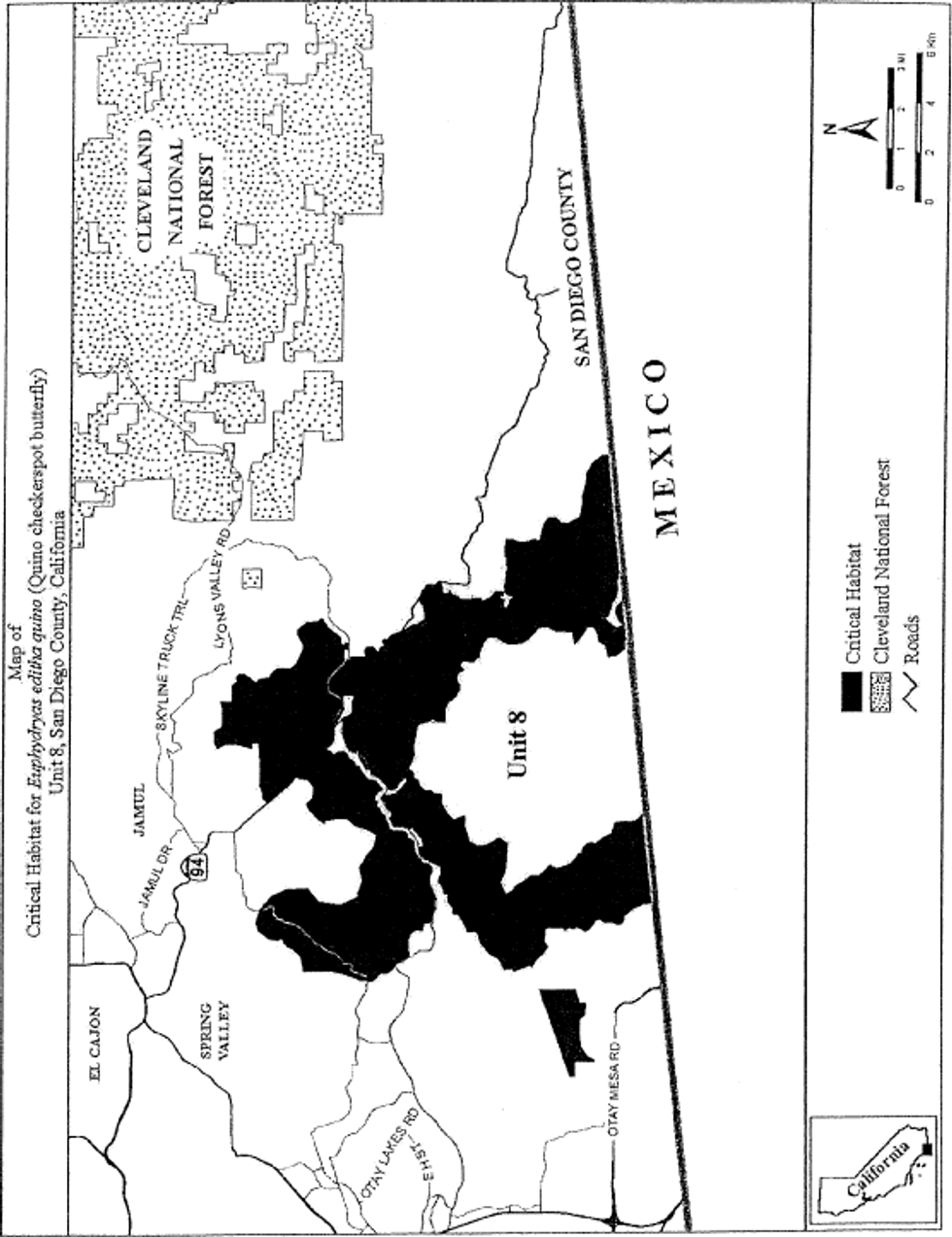
(13) Unit 9: La Posta/Campo Unit, San Diego County, California.
(i) [Reserved]
(ii) Map of Unit 9 (La Posta/Campo) follows:
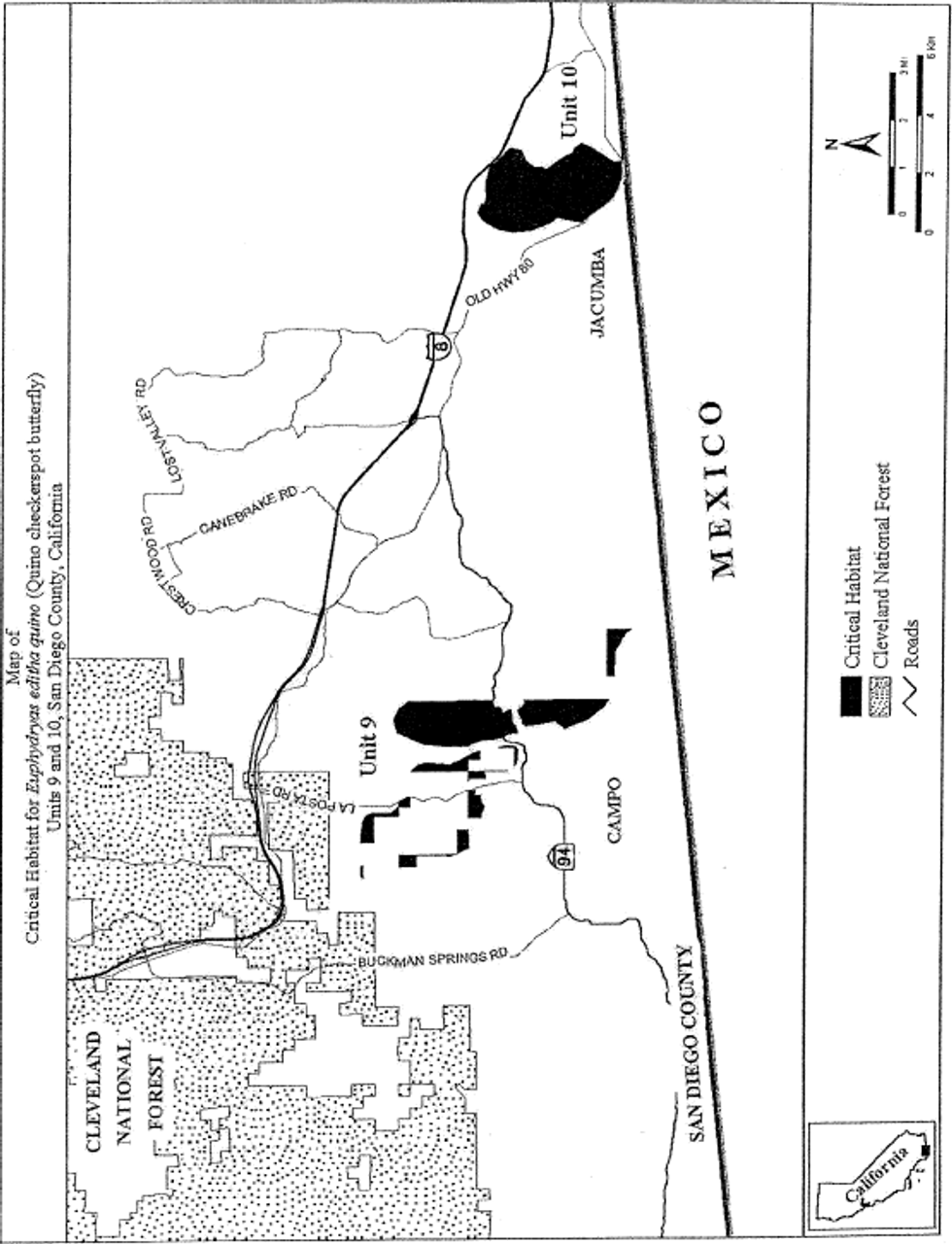
(14) Unit 10: Jacumba Unit, San Diego County, California.
(i) [Reserved]
(ii) Unit 10 (Jacumba) for the Quino checkerspot butterfly is depicted on the map in paragraph (13)(ii) of this entry.
Taylor's Checkerspot Butterfly (Euphydryas editha taylori)
(1) Critical habitat units are depicted for Island, Clallam, and Thurston Counties in Washington, and in Benton County in Oregon, on the maps below.
(2) Within these areas, the primary constituent elements of the physical or biological features essential to the conservation of the Taylor's checkerspot butterfly consist of four components:
(i) Patches of early seral, short-statured, perennial bunchgrass plant communities composed of native grass and forb species in a diverse topographic landscape ranging in size from less than 1 ac up to 100 ac (0.4 to 40 ha) with little or no overstory forest vegetation that have areas of bare soil for basking that contain:
(A) In Washington and Oregon, common bunchgrass species found on northwest grasslands include Festuca roemeri (Roemer's fescue), Danthonia californica (California oat grass), Koeleria cristata (prairie Junegrass), Elymus glaucus (blue wild rye), Agrostis scabra (rough bentgrass), and on cooler, high-elevation sites typical of coastal bluffs and balds, Festuca rubra (red fescue).
(B) On moist grasslands found near the coast and in the Willamette Valley, there may be Bromus sitchensis (Sitka brome) and Deschampsia cespitosa (tufted hairgrass) in the mix of prairie grasses. Less abundant forbs found on the grasslands include, but are not limited to, Trifolium spp. (true clovers), narrow-leaved plantain (Plantago lanceolata), harsh paintbrush (Castilleja hispida), Puget balsamroot (Balsamorhiza deltoidea), woolly sunshine (Eriophyllum lanatum), nine-leaved desert parsley (Lomatium triternatum), fine-leaved desert parsley (Lomatium utriculatum), common camas (Camassia quamash), showy fleabane (Erigeron speciosus), Canada thistle (Cirsium arvense), common yarrow (Achillea millefolium), prairie lupine (Lupinus lepidus), and sickle-keeled lupine (Lupinus albicaulis).
(ii) Primary larval host plants (narrow-leaved plantain and harsh paintbrush) and at least one of the secondary annual larval host plants (blue-eyed Mary (Collinsia parviflora), sea blush (Plectritis congesta), or dwarf owl-clover (Triphysaria pusilla) or one of several species of speedwell (marsh speedwell (Veronica scutella), American speedwell (V. beccabunga var. americana), or thymeleaf speedwell (V. serpyllifolia).
(iii) Adult nectar sources for feeding that include several species found as part of the native (and one nonnative) species mix on northwest grasslands, including: narrow-leaved plantain; harsh paintbrush; Puget balsam root; woolly sunshine; nine-leaved desert parsley; fine-leaved desert parsley or spring gold; common camas; showy fleabane; Canada thistle; common yarrow; prairie lupine; sickle-keeled lupine; and wild strawberry (Fragaria virginiana).
(iv) Aquatic features such as wetlands, springs, seeps, streams, ponds, lakes, and puddles that provide moisture during periods of drought, particularly late in the spring and early summer. These features can be permanent, seasonal, or ephemeral.
(3) Critical habitat does not include manmade structures (such as buildings, aqueducts, runways, roads, railroad tracks, and other paved areas) and the land on which they are located existing within the legal boundaries on November 4, 2013.
(4) Critical habitat map units. Data layers defining the map unit were created on 2010 aerial photography from U.S. Department of Agriculture, National Agriculture Imagery Program base maps using ArcMap (Environmental Systems Research Institute, Inc.), a computer geographic information system (GIS) program. The maps in this entry, as modified by any accompanying regulatory text, establish the boundaries of the critical habitat designation. The coordinates or plot points or both on which each map is based are available to the public at the Service's Internet site (http://www.fws.gov/wafwo/), at http://www.regulations.gov at Docket No. FWS-R1-ES-2013-0009), and by appointment at the Service's Washington Fish and Wildlife Office. You may obtain field office location information by contacting one of the Service regional offices, the addresses of which are listed at 50 CFR 2.2.
(5) Index map of critical habitat units for the Taylor's checkerspot butterfly follows:
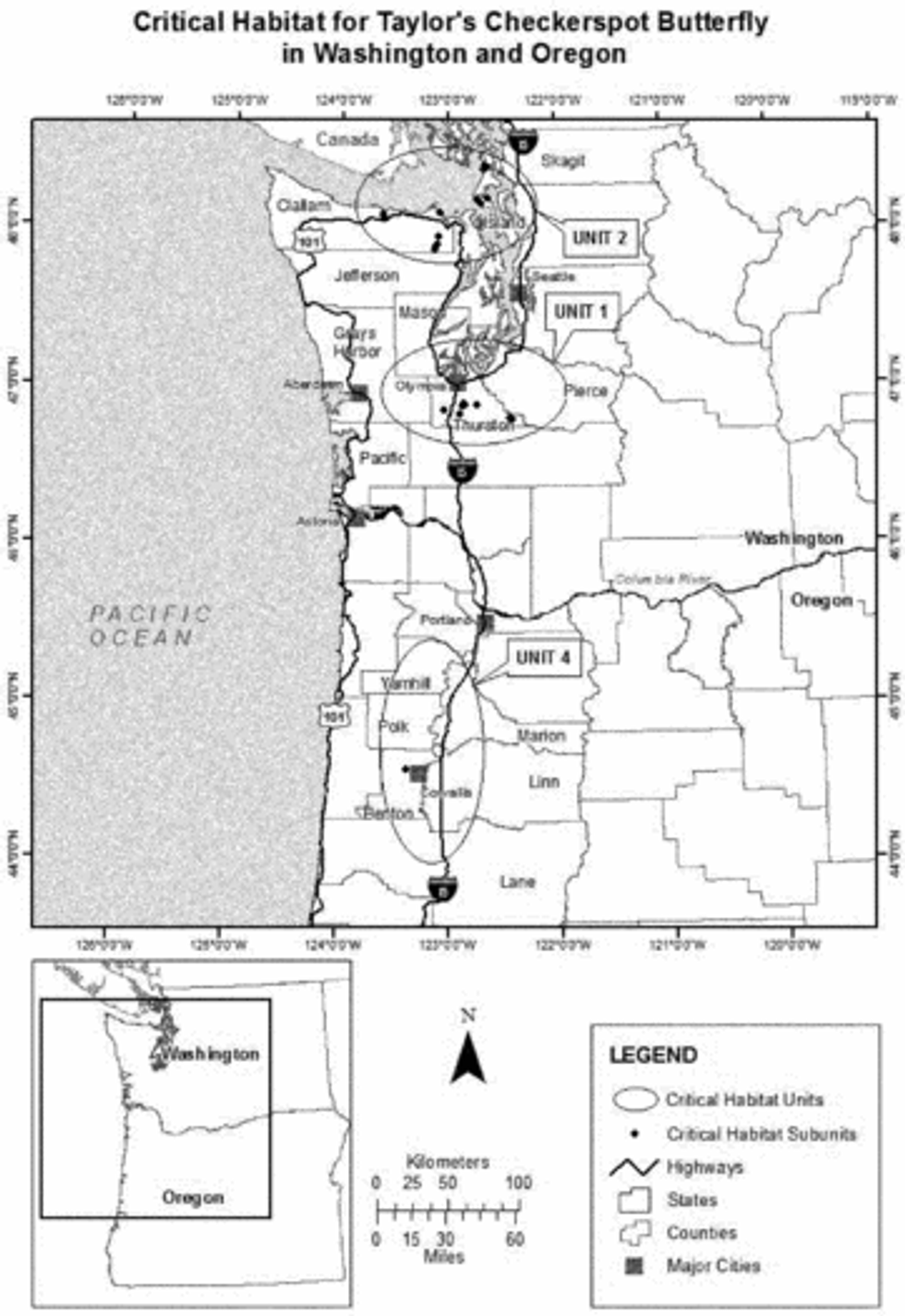
(6) Unit 1: South Sound, Washington.
(i) Subunit 1-A: Rocky Prairie, Washington. Map of Subunit 1-A follows:
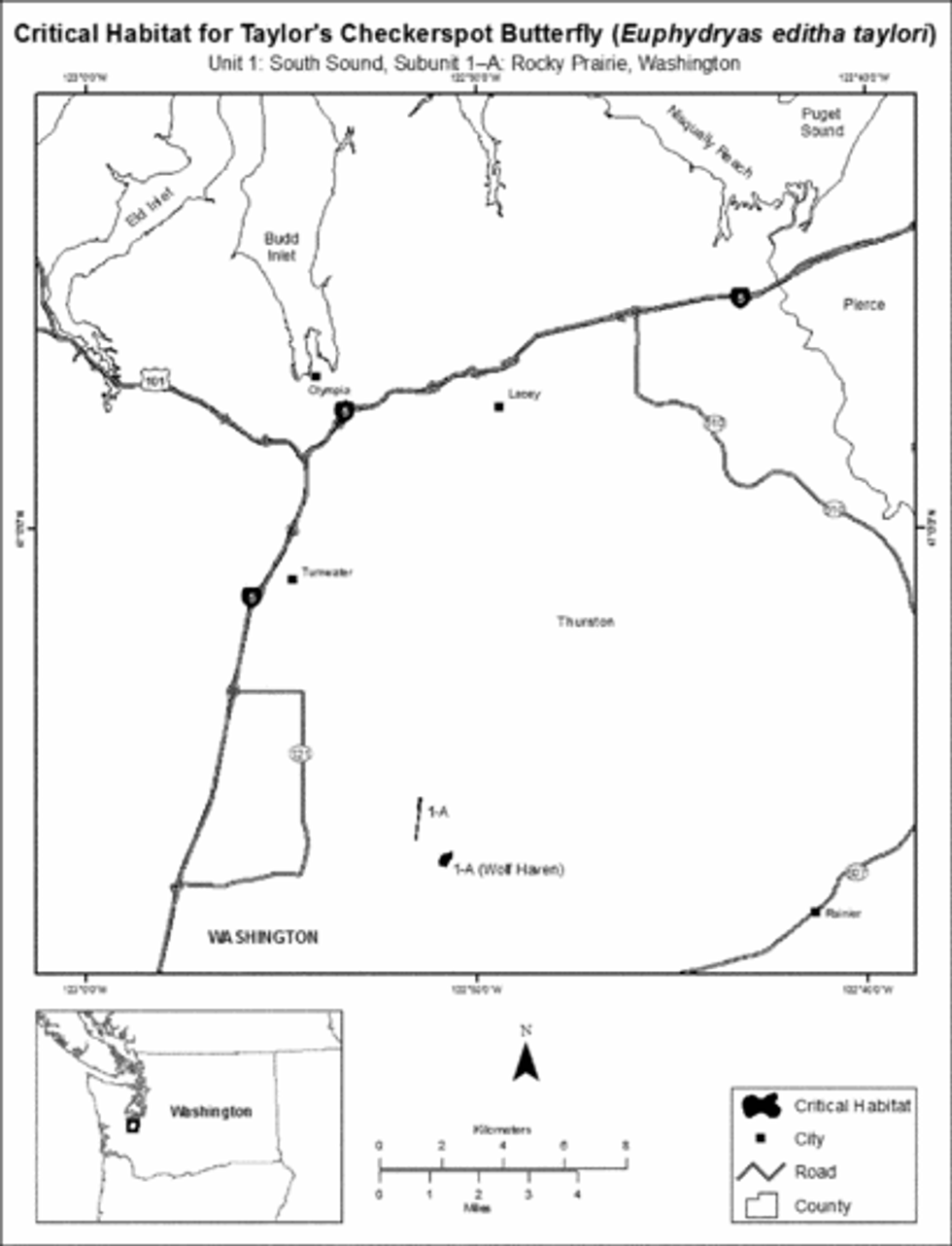
(ii) Subunit 1-B: Tenalquot Prairie, Washington. Map of Subunit 1-B follows:

(iii) Subunit 1-C: Glacial Heritage, Washington. Map of Subunit 1-C follows:
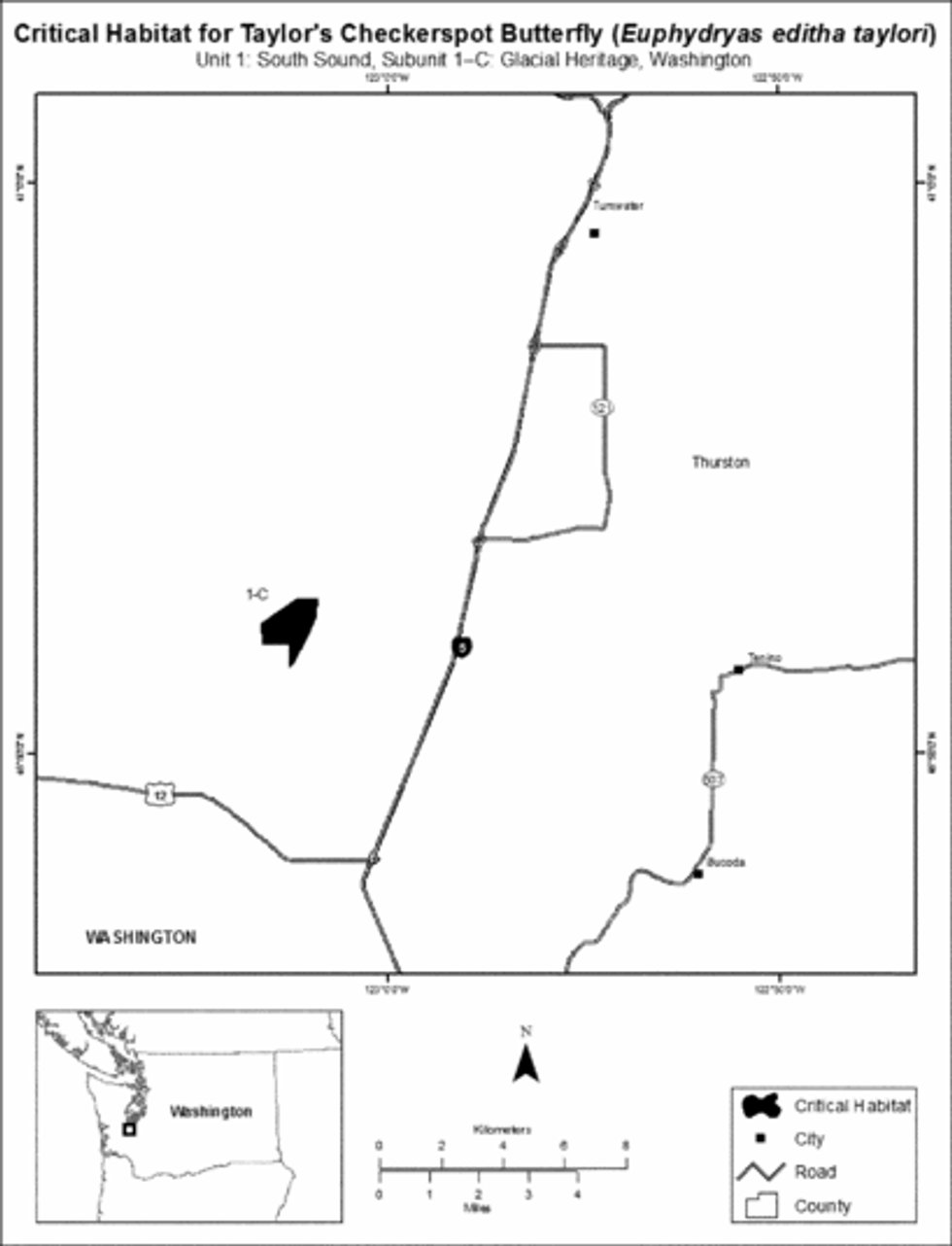
(iv) Subunit 1-D: Rock Prairie, Washington. Map of Subunit 1-D follows:
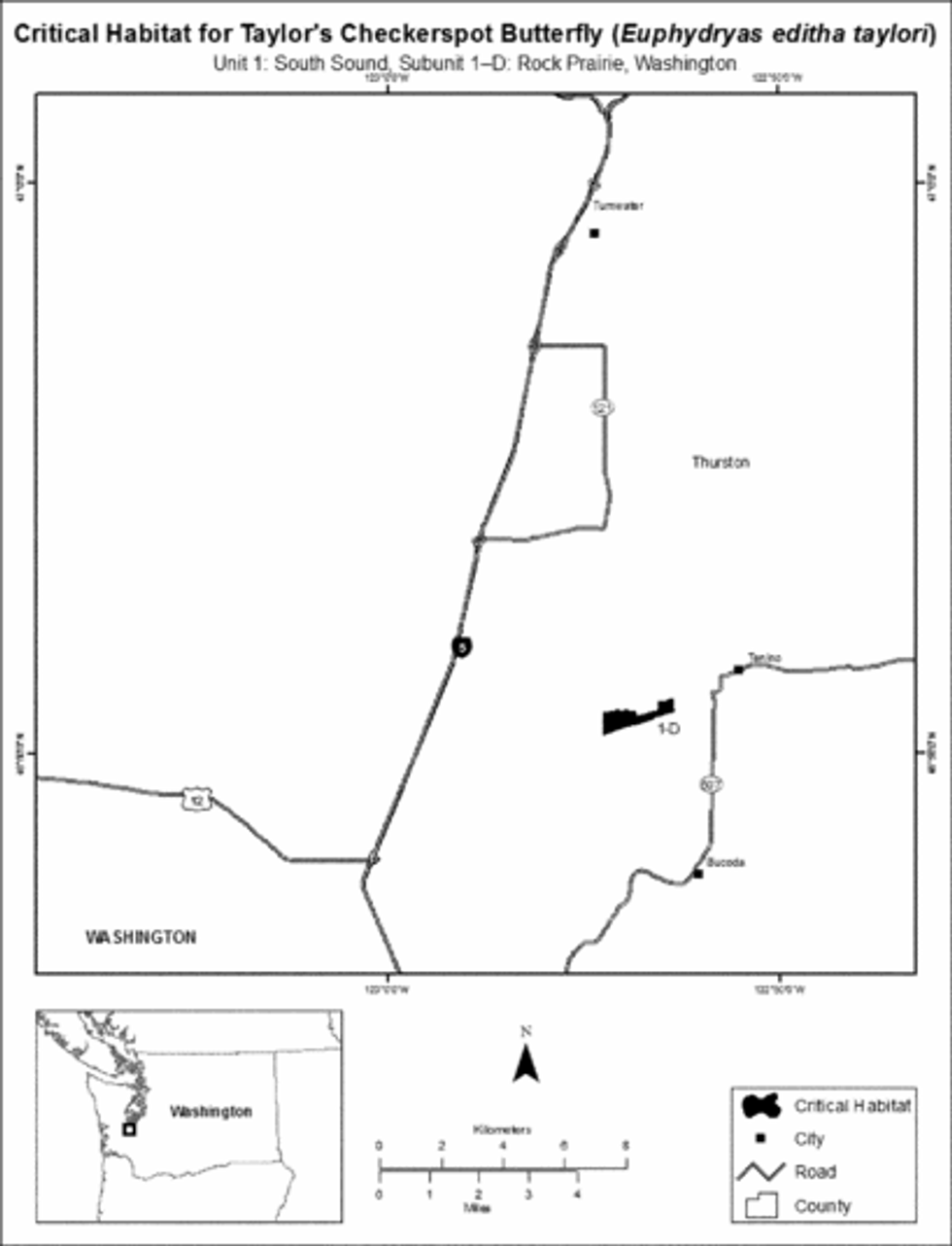
(v) Subunit 1-E: Bald Hill, Washington. Map of Subunit 1-E follows:
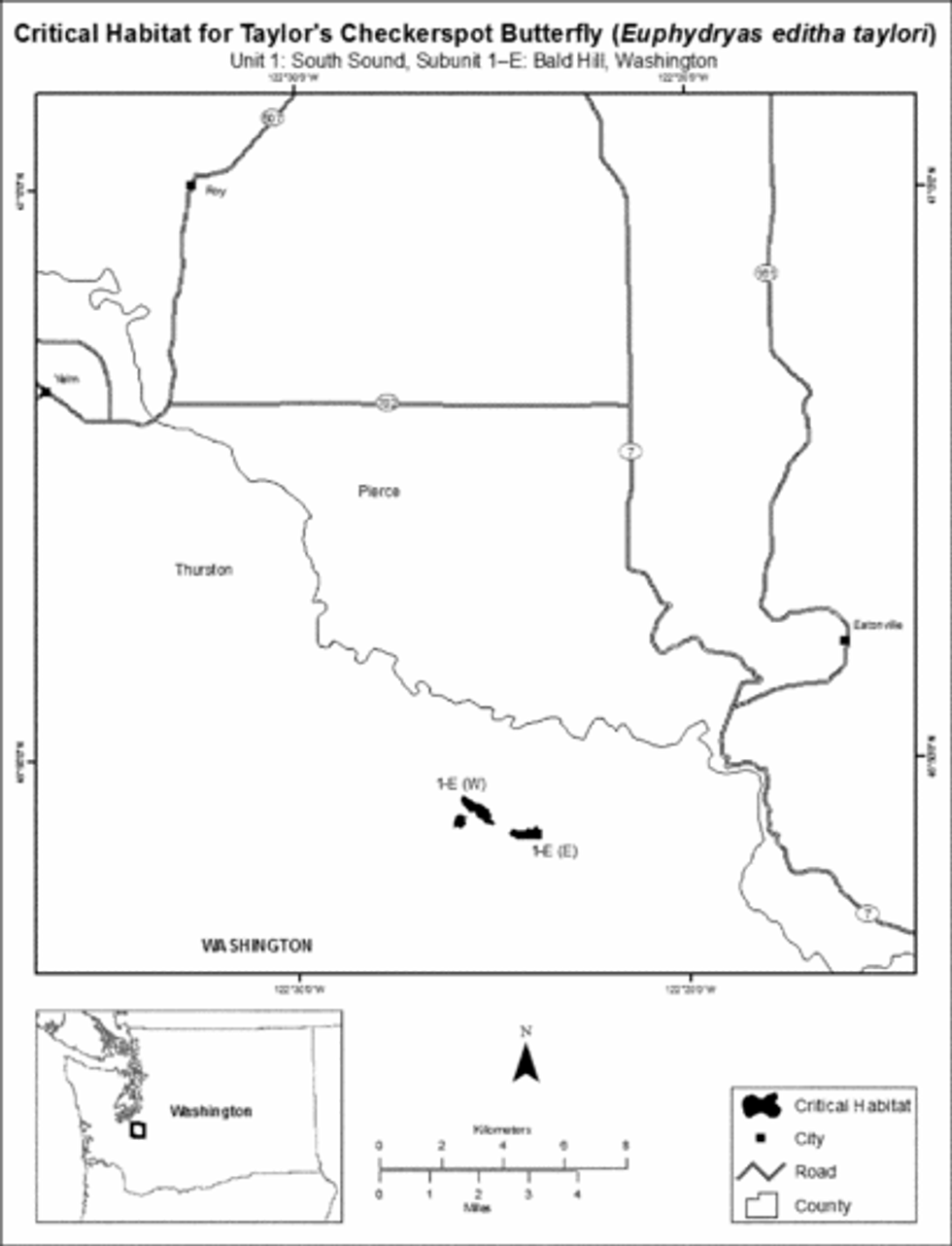
(7) Unit 2: Strait of Juan de Fuca, Washington.
(i) Subunit 2-A: Deception Pass, Washington. Map of Subunit 2-A follows:
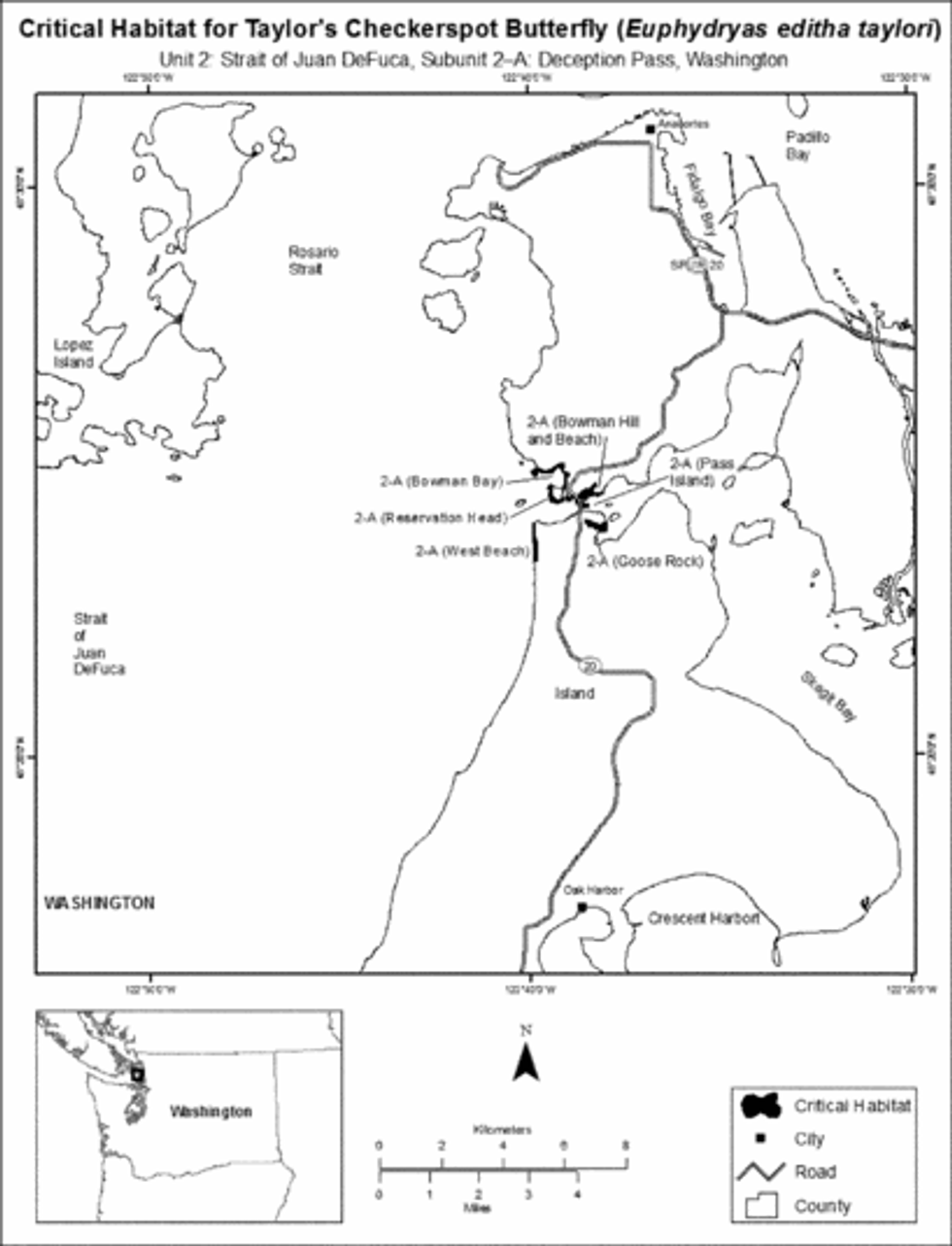
(ii) Subunit 2-B: Central Whidbey, Washington. Map of Subunit 2-B follows:
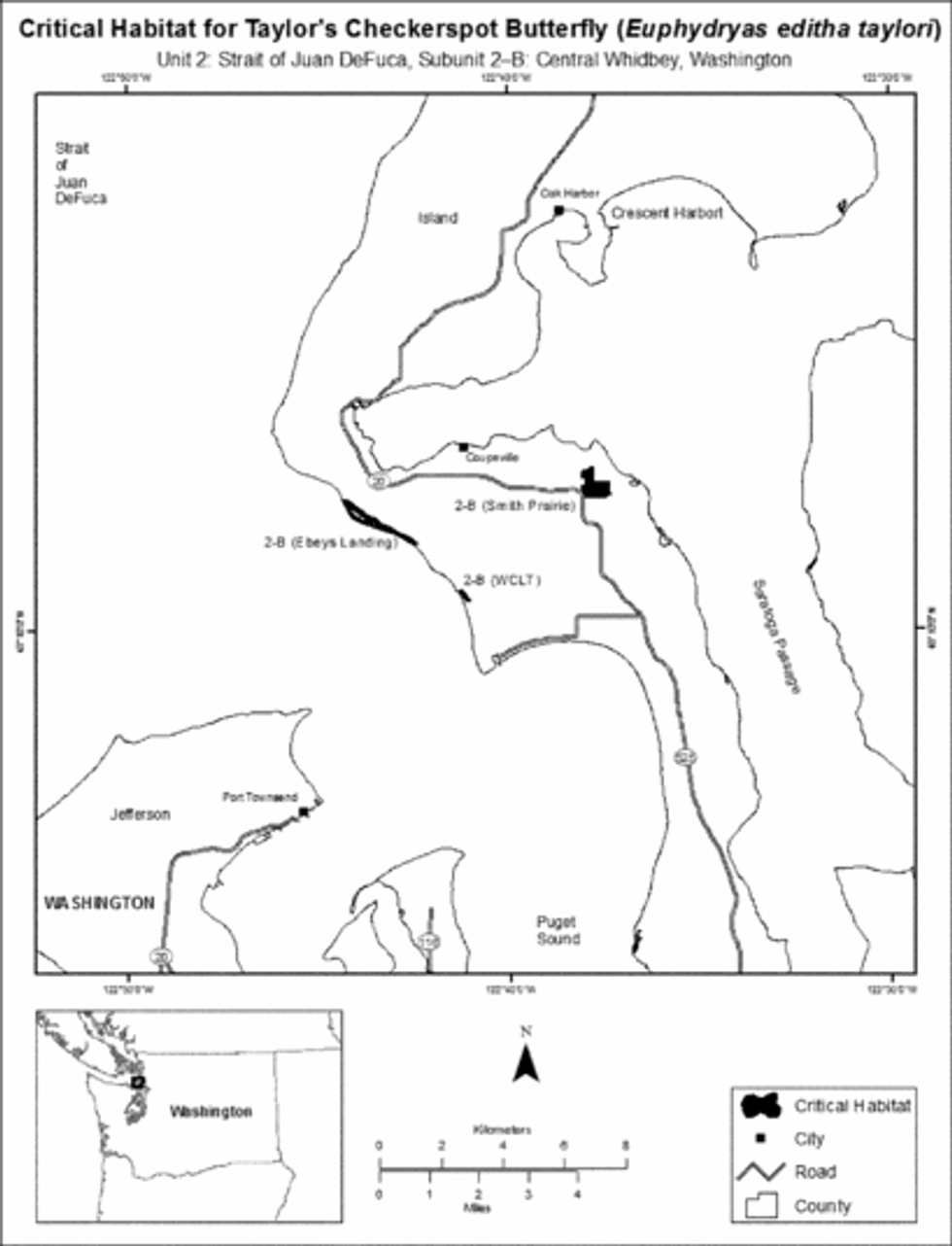
(iii) Subunit 2-C: Elwha, Washington. Map of Subunit 2-C follows:
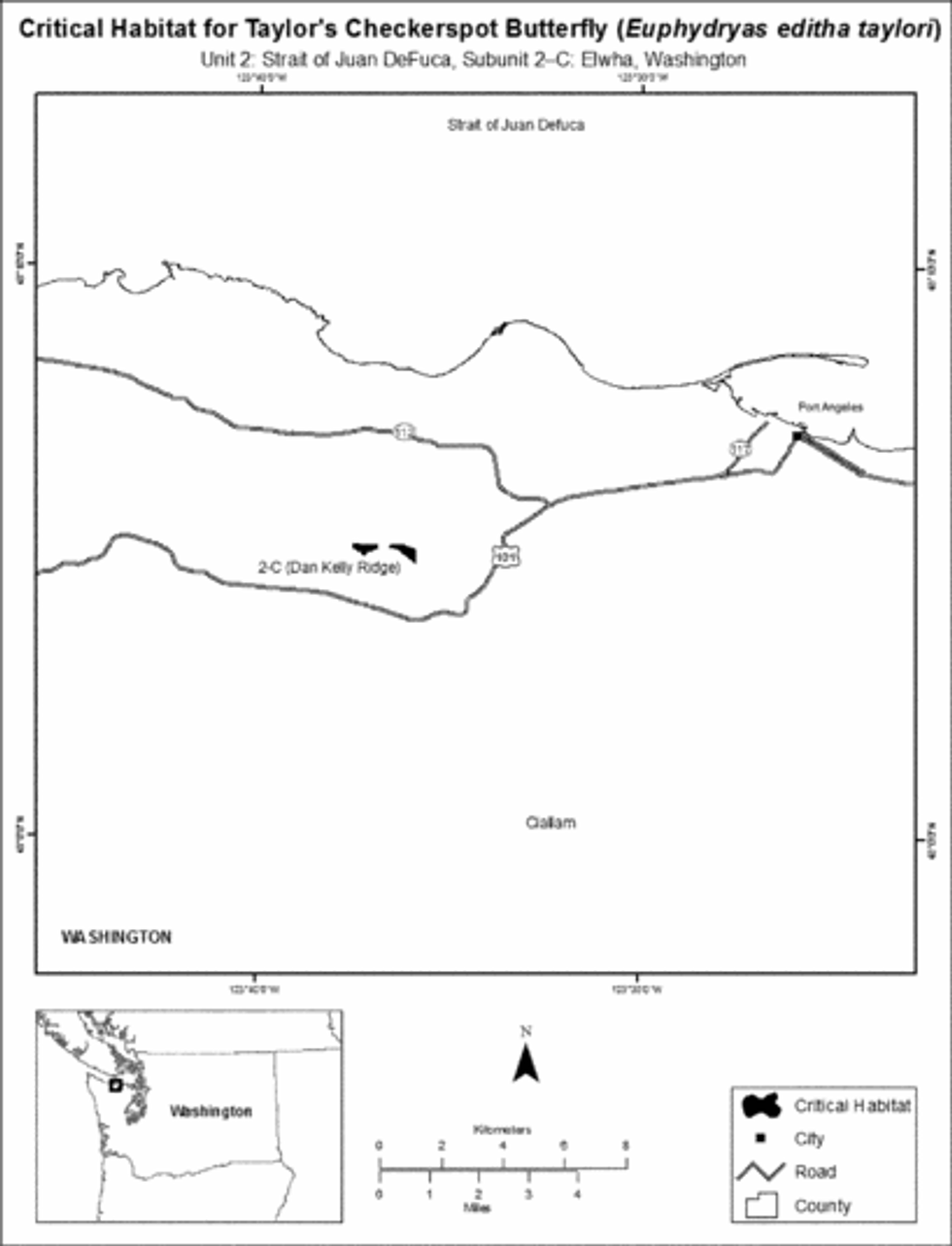
(iv) Subunit 2-D: Sequim, Washington. Map of Subunit 2-D follows:

(v) Subunit 2-E: Dungeness, Washington. Map of Subunit 2-E follows:
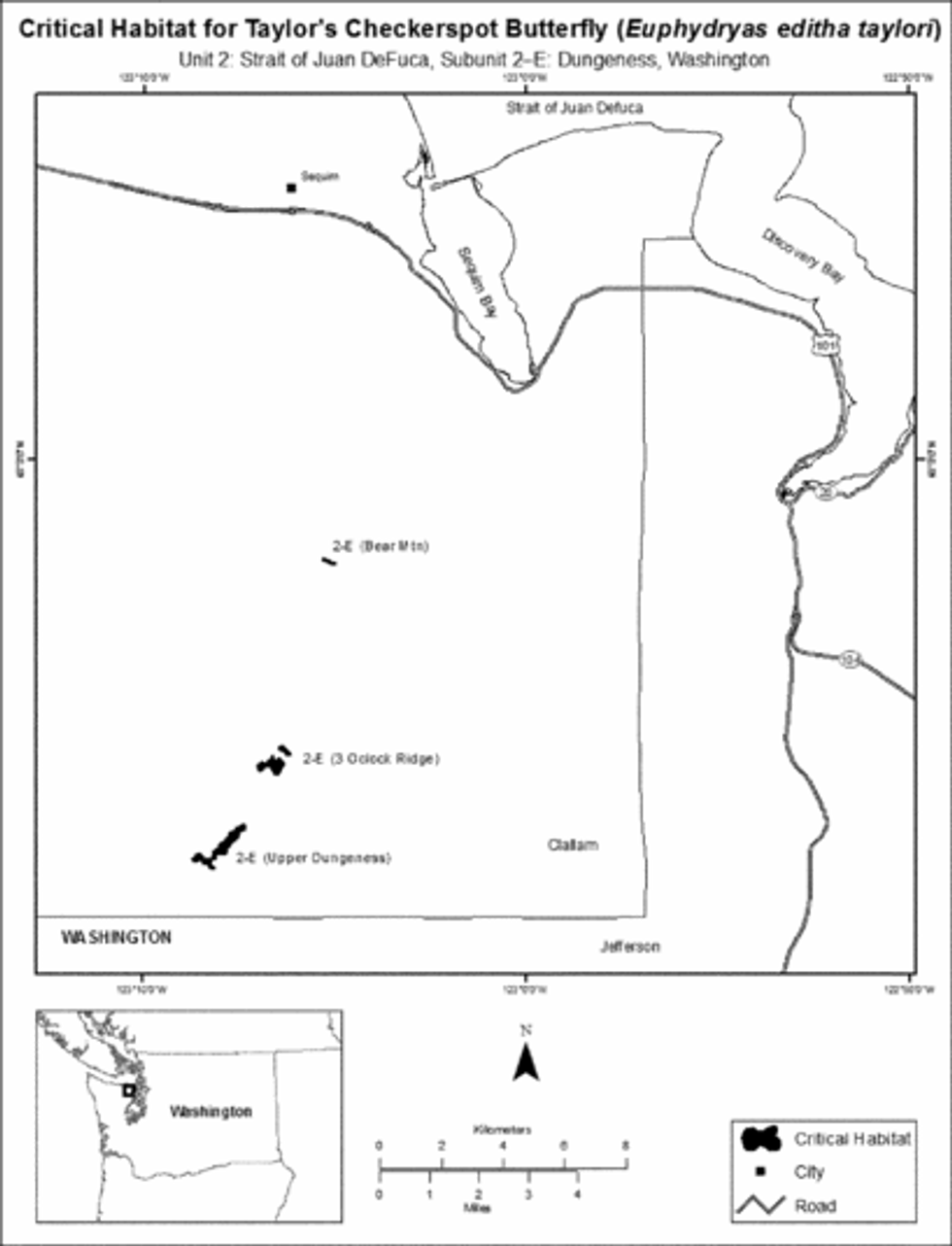
(8) Unit 4: Willamette Valley, Oregon.
(i) Subunit 4-D: Fitton Green-Cardwell Hill, Oregon.
(ii) Map of Subunit 4-D follows:
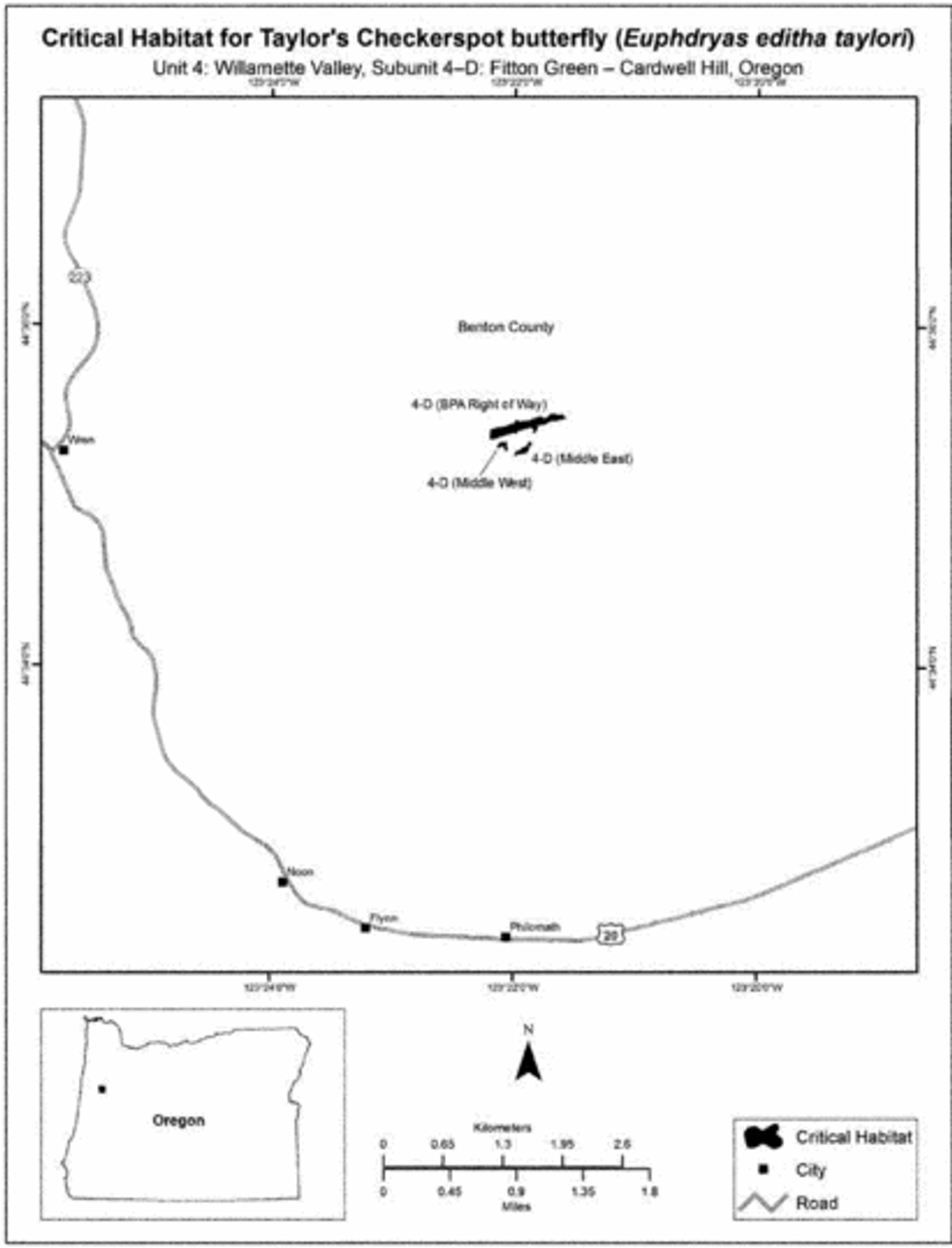
Blackline Hawaiian Damselfly (Megalagrion nigrohamatum nigrolineatum)
(1) Critical habitat units are depicted for Honolulu County, Hawaii, on the maps below.
(2) Primary constituent elements. The primary constituent elements of critical habitat for the blackline Hawaiian damselfly (Megalagrion nigrohamatum nigrolineatum) are:
(i) Elevation: Less than 3,300 ft (1,000 m).
(ii) Annual precipitation: Greater than 75 in (190 cm).
(iii) Substrate: Clays; ashbeds; deep, well-drained soils; lowland bogs.
(iv) Canopy: Antidesma, Metrosideros, Myrsine, Pisonia, Psychotria.
(v) Subcanopy: Cibotium, Claoxylon, Kadua, Melicope.
(vi) Understory: Alyxia, Cyrtandra, Dicranopteris, Diplazium, Machaerina, Microlepia.
(vii) Perennial streams.
(viii) Slow reaches of streams.
(ix) Pools.
(3) Existing manmade features and structures, such as buildings, roads, railroads, airports, runways, other paved areas, lawns, and other urban landscaped areas, existing trails, campgrounds and their immediate surrounding landscaped area, scenic lookouts, remote helicopter landing sites, and existing fences are not included in the critical habitat designation. Federal actions limited to those areas, therefore, would not trigger a consultation under section 7 of the Act unless they may affect the species or adjacent critical habitat.
(4) Critical habitat maps. Maps were created in GIS, with coordinates in UTM Zone 4, units in meters using North American datum of 1983 (NAD 83). The maps in this entry, as modified by any accompanying regulatory text, establish the boundaries of the critical habitat designation. The coordinates or plot points or both on which each map is based are available to the public at the Service's internet site, http://www.fws.gov/pacificislands; at http://www.regulations.gov at Docket No. FWS-R1-ES-2010-0043: and at the field office responsible for the designation. You may obtain field office location information by contacting one of the Service regional offices, the addresses of which are listed at 50 CFR 2.2.
(5) Index map of critical habitat units for the blackline Hawaiian damselfly (Megalagrion nigrohamatum nigrolineatum) follows:

(6) Megalagrion nigrohamatum nigrolineatum - Unit 1 - Lowland Wet, Honolulu County, Hawaii (790 ac; 320 ha); Megalagrion nigrohamatum nigrolineatum - Unit 2 - Lowland Wet, Honolulu County, Hawaii (1,787 ac; 723 ha); and Megalagrion nigrohamatum nigrolineatum - Unit 3 - Lowland Wet, Honolulu County, Hawaii (3,041 ac; 1,231 ha). These units are critical habitat for the blackline Hawaiian damselfly, Megalagrion nigrohamatum nigrolineatum. Map of Megalagrion nigrohamatum nigrolineatum - Unit 1 - Lowland Wet, Megalagrion nigrohamatum nigrolineatum - Unit 2 - Lowland Wet, and Megalagrion nigrohamatum nigrolineatum - Unit 3 - Lowland Wet follows:
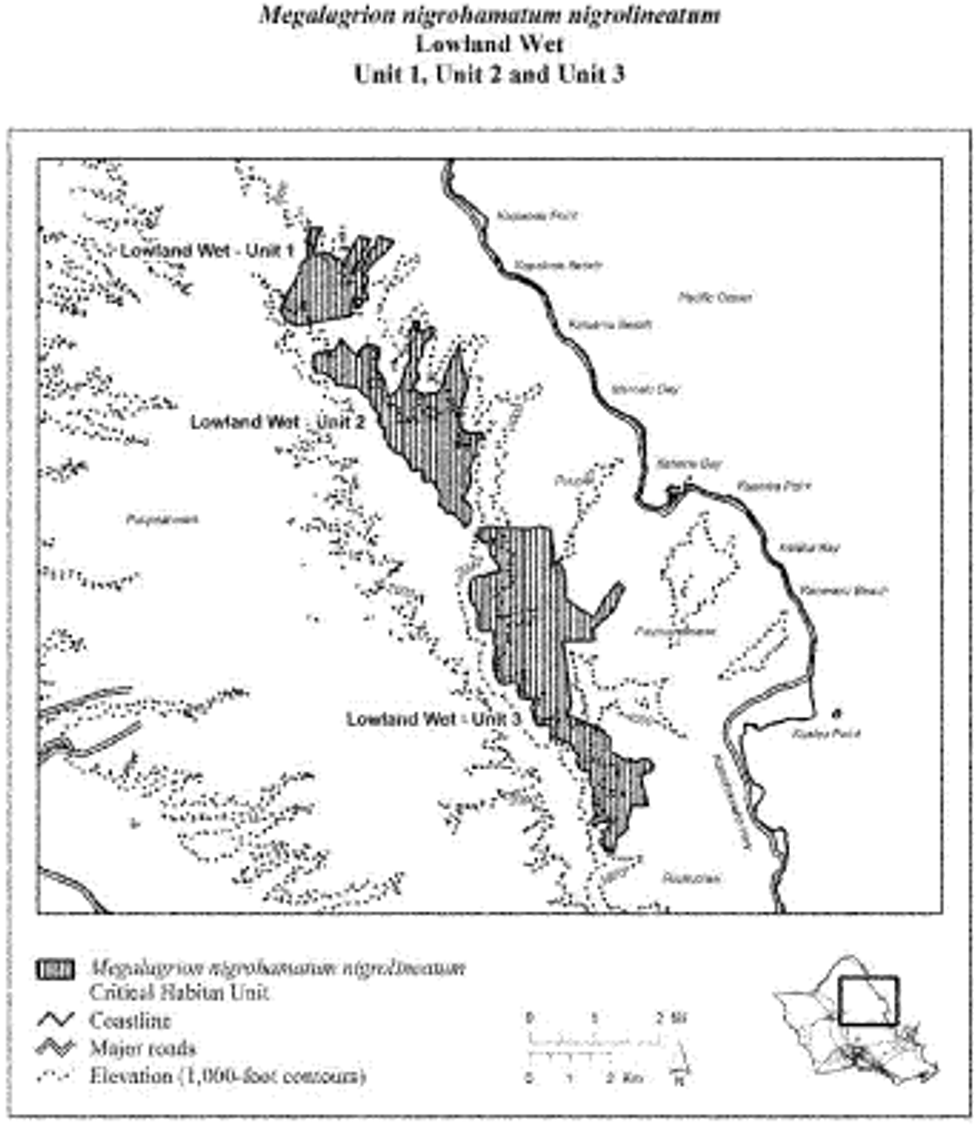
(7) Megalagrion nigrohamatum nigrolineatum - Unit 4 - Lowland Wet, Honolulu County, Hawaii (15,728 ac; 6,365 ha). This unit is critical habitat for the blackline Hawaiian damselfly, Megalagrion nigrohamatum nigrolineatum. Map of Megalagrion nigrohamatum nigrolineatum - Unit 4 - Lowland Wet follows:
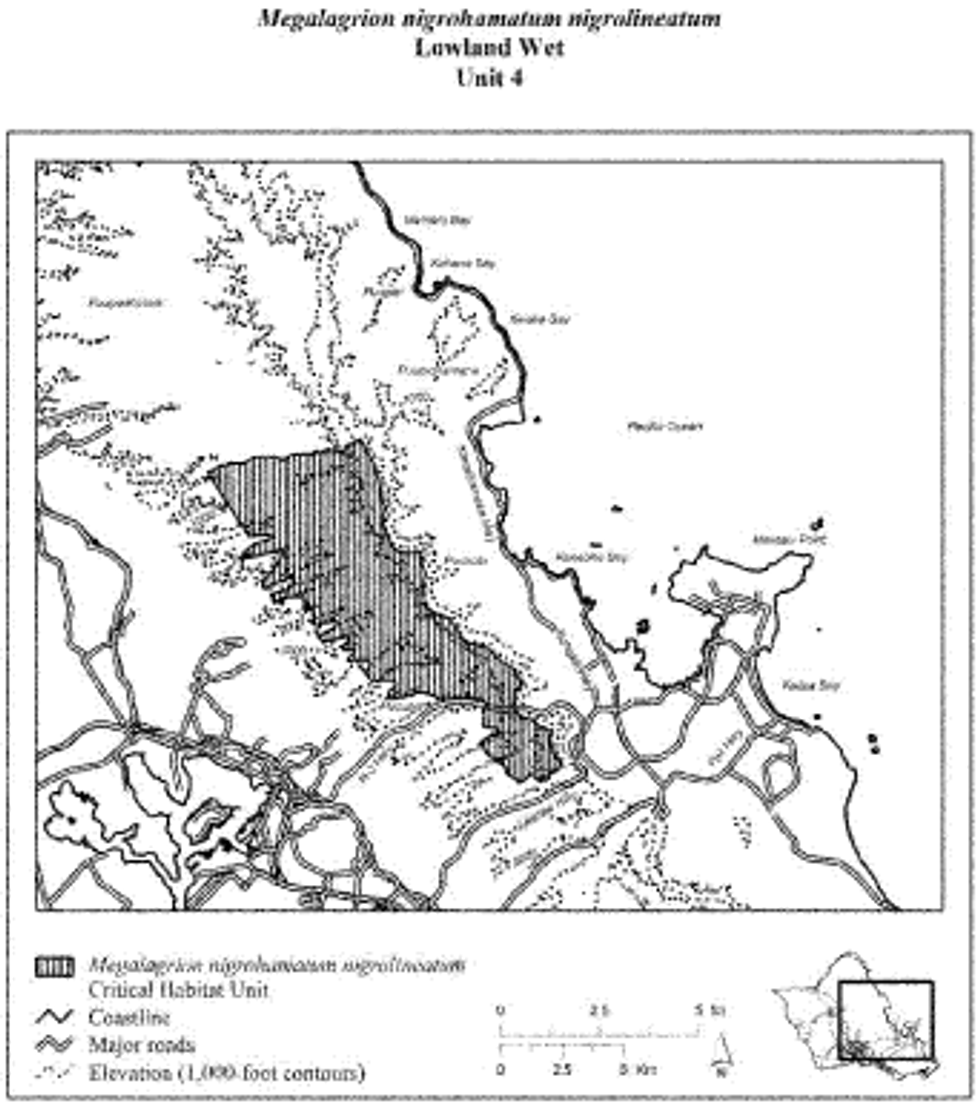
(8) Megalagrion nigrohamatum nigrolineatum - Unit 5 - Lowland Wet, Honolulu County, Hawaii (124 ac; 50 ha); Megalagrion nigrohamatum nigrolineatum - Unit 6 - Lowland Wet, Honolulu County, Hawaii (123 ac; 50 ha); and Megalagrion nigrohamatum nigrolineatum - Unit 7 - Lowland Wet, Honolulu County, Hawaii (53 ac; 21 ha). These units are critical habitat for the blackline Hawaiian damselfly, Megalagrion nigrohamatum nigrolineatum. Map of Megalagrion nigrohamatum nigrolineatum - Unit 5 - Lowland Wet, Megalagrion nigrohamatum nigrolineatum - Unit 6 - Lowland Wet, and Megalagrion nigrohamatum nigrolineatum - Unit 7 - Lowland Wet follows:
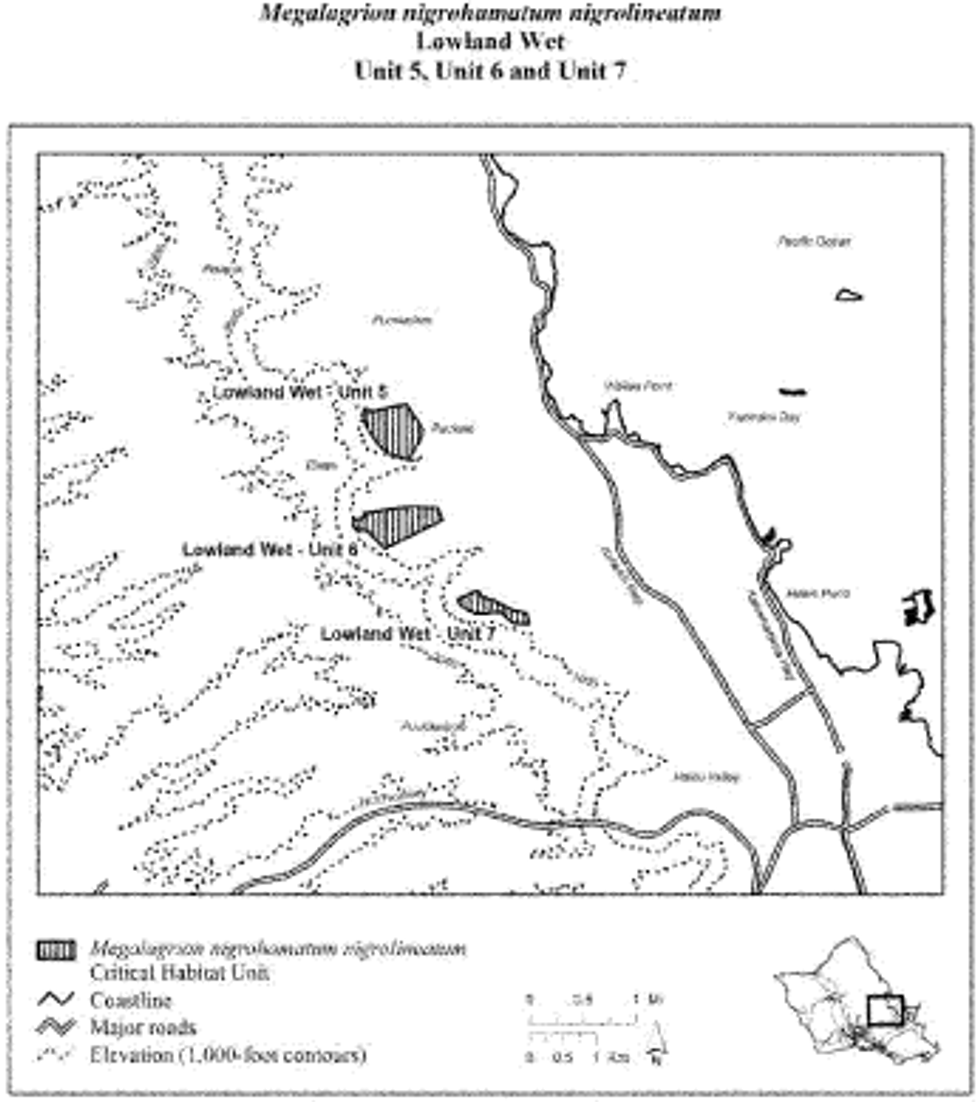
(9) Megalagrion nigrohamatum nigrolineatum - Unit 8 - Lowland Wet, Honolulu County, Hawaii (75 ac; 30 ha); Megalagrion nigrohamatum nigrolineatum - Unit 9 - Lowland Wet, Honolulu County, Hawaii (478 ac; 193 ha); Megalagrion nigrohamatum nigrolineatum - Unit 10 - Lowland Wet, Honolulu County, Hawaii (407 ac; 165 ha); and Megalagrion nigrohamatum nigrolineatum - Unit 11 - Lowland Wet, Honolulu County, Hawaii (2,507 ac; 1,014 ha). These units are critical habitat for the blackline Hawaiian damselfly, Megalagrion nigrohamatum nigrolineatum. Map of Megalagrion nigrohamatum nigrolineatum - Unit 8 - Lowland Wet, Megalagrion nigrohamatum nigrolineatum - Unit 9 - Lowland Wet, Megalagrion nigrohamatum nigrolineatum - Unit 10 - Lowland Wet, and Megalagrion nigrohamatum nigrolineatum - Unit 11 - Lowland Wet follows:
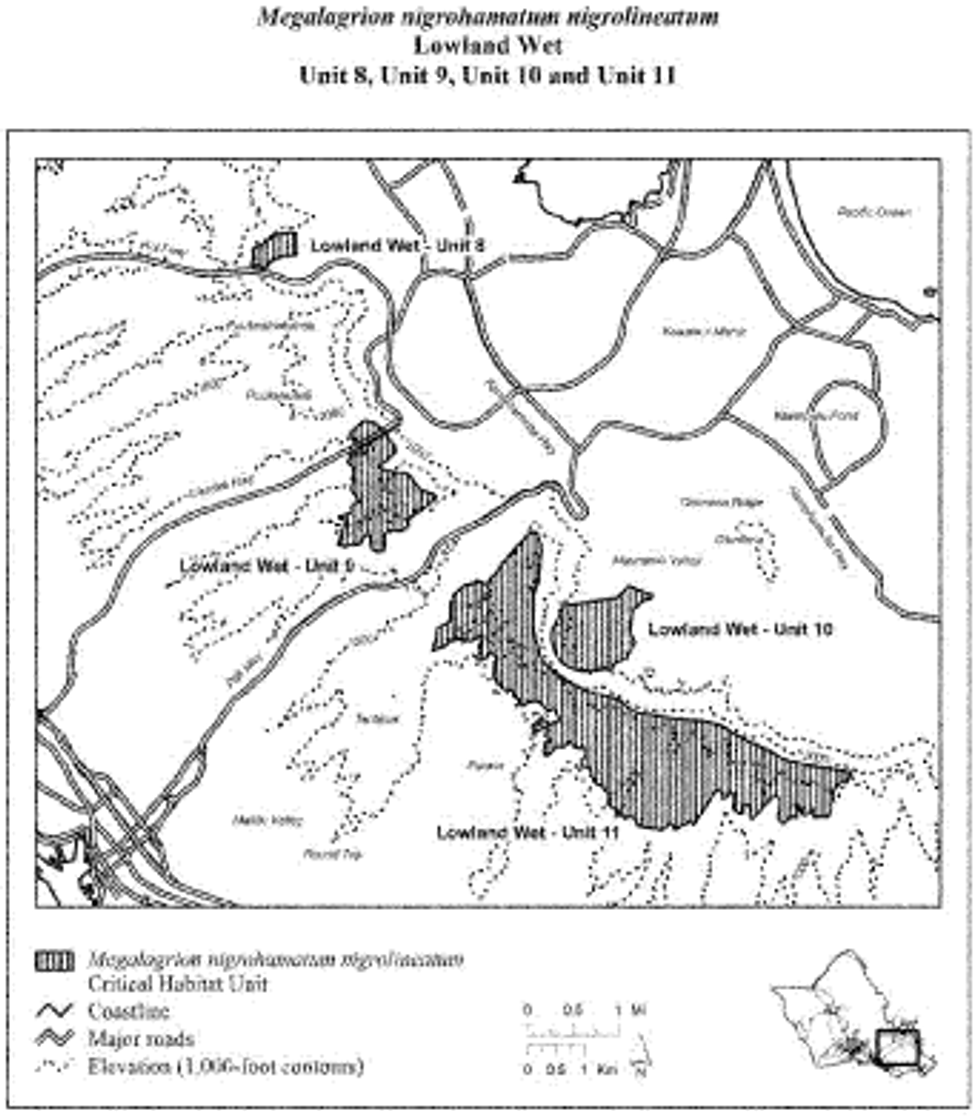
Crimson Hawaiian Damselfly (Megalagrion leptodemas)
(1) Critical habitat units are depicted for Honolulu County, Hawaii, on the maps below.
(2) Primary constituent elements.
(i) In units 1, 2, 3, 4, 5, 6, 7, 8, 9, 10, and 11, the primary constituent elements of critical habitat for the crimson Hawaiian damselfly are:
(A) Elevation: Less than 3,300 ft (1,000 m).
(B) Annual precipitation: Greater than 75 in (190 cm).
(C) Substrate: Clays; ashbeds; deep, well-drained soils; lowland bogs.
(D) Canopy: Antidesma, Metrosideros, Myrsine, Pisonia, Psychotria.
(E) Subcanopy: Cibotium, Claoxylon, Kadua, Melicope.
(F) Understory: Alyxia, Cyrtandra, Dicranopteris, Diplazium, Machaerina, Microlepia.
(G) Perennial streams.
(H) Slow reaches of streams or ponds.
(ii) In units 12, 13, and 14, the primary constituent elements of critical habitat for the crimson Hawaiian damselfly are:
(A) Elevation: Unrestricted.
(B) Annual precipitation: Greater than 75 in (190 cm).
(C) Substrate: Greater than 65 degree slope, shallow soils, weathered lava.
(D) Canopy: None.
(E) Subcanopy: Broussaisia, Cheirodendron, Leptecophylla, Metrosideros.
(F) Understory: Ferns, Bryophytes, Coprosma, Dubautia, Kadua, Peperomia.
(G) Perennial streams.
(H) Slow reaches of streams or ponds.
(3) Existing manmade features and structures, such as buildings, roads, railroads, airports, runways, other paved areas, lawns, and other urban landscaped areas, existing trails, campgrounds and their immediate surrounding landscaped area, scenic lookouts, remote helicopter landing sites, and existing fences are not included in the critical habitat designation. Federal actions limited to those areas, therefore, would not trigger a consultation under section 7 of the Act unless they may affect the species or physical or biological features in adjacent critical habitat.
(4) Critical habitat maps. Maps were created in GIS, with coordinates in UTM Zone 4, units in meters using North American datum of 1983 (NAD 83). The maps in this entry, as modified by any accompanying regulatory text, establish the boundaries of the critical habitat designation. The coordinates or plot points or both on which each map is based are available to the public at the Service's internet site, http://www.fws.gov/pacificislands; at http://www.regulations.gov at Docket No. FWS-R1-ES-2010-0043; and at the field office responsible for the designation. You may obtain field office location information by contacting one of the Service regional offices, the addresses of which are listed at 50 CFR 2.2.
(5) Index map of critical habitat units for the crimson Hawaiian damselfly (Megalagrion leptodemas) follows:

(6) Megalagrion leptodemas - Unit 1 - Lowland Wet, Honolulu County, Hawaii (790 ac; 320 ha); Megalagrion leptodemas - Unit 2 - Lowland Wet, Honolulu County, Hawaii (1,787ac; 723 ha); and Megalagrion leptodemas - Unit 3 - Lowland Wet, Honolulu County, Hawaii (3,041 ac; 1,231 ha). These units are critical habitat for the crimson Hawaiian damselfly, Megalagrion leptodemas. Map of Megalagrion leptodemas - Unit 1 - Lowland Wet, Megalagrion leptodemas - Unit 2 - Lowland Wet, and Megalagrion leptodemas - Unit 3 - Lowland Wet follows:
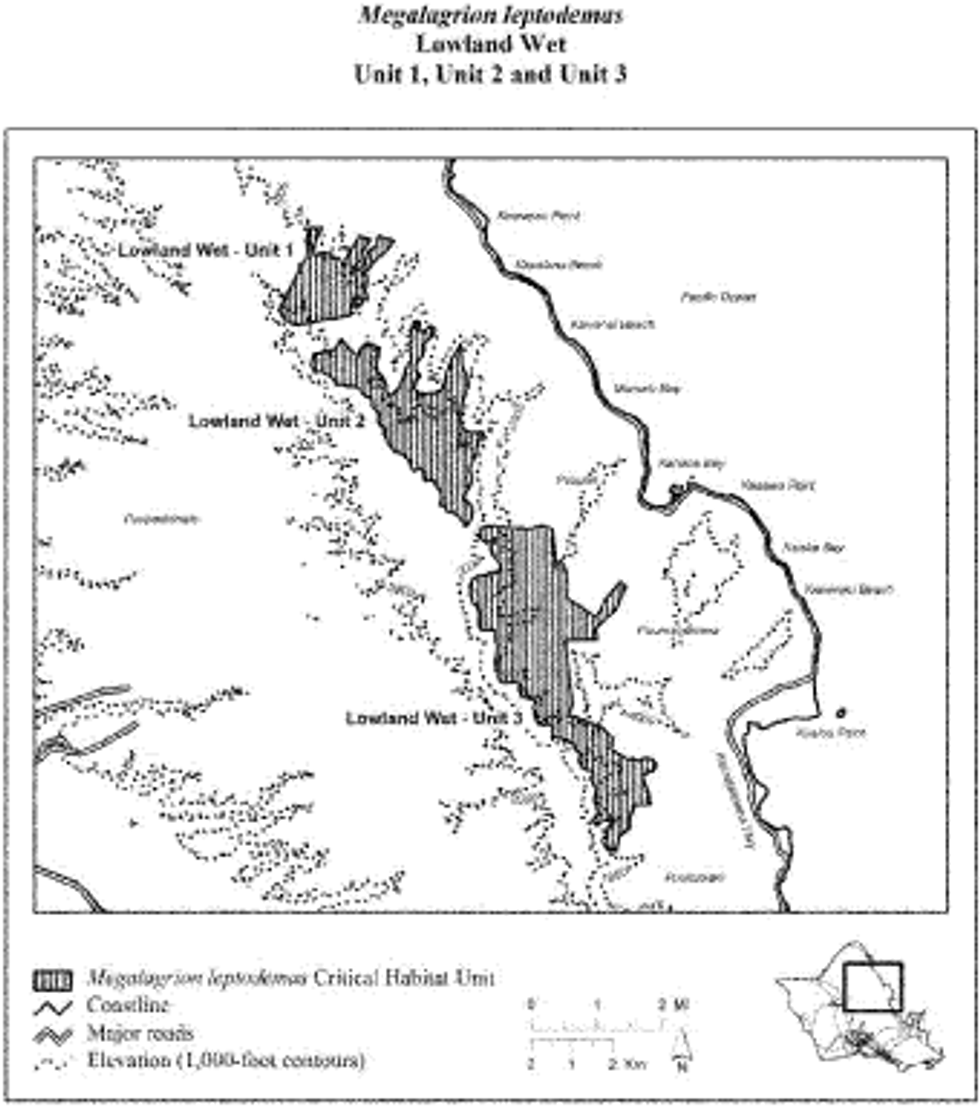
(7) Megalagrion leptodemas - Unit 4 - Lowland Wet, Honolulu County, Hawaii (15,728 ac; 6,365 ha). This unit is critical habitat for the crimson Hawaiian damselfly, Megalagrion leptodemas. Map of Megalagrion leptodemas - Unit 4 - Lowland Wet follows:
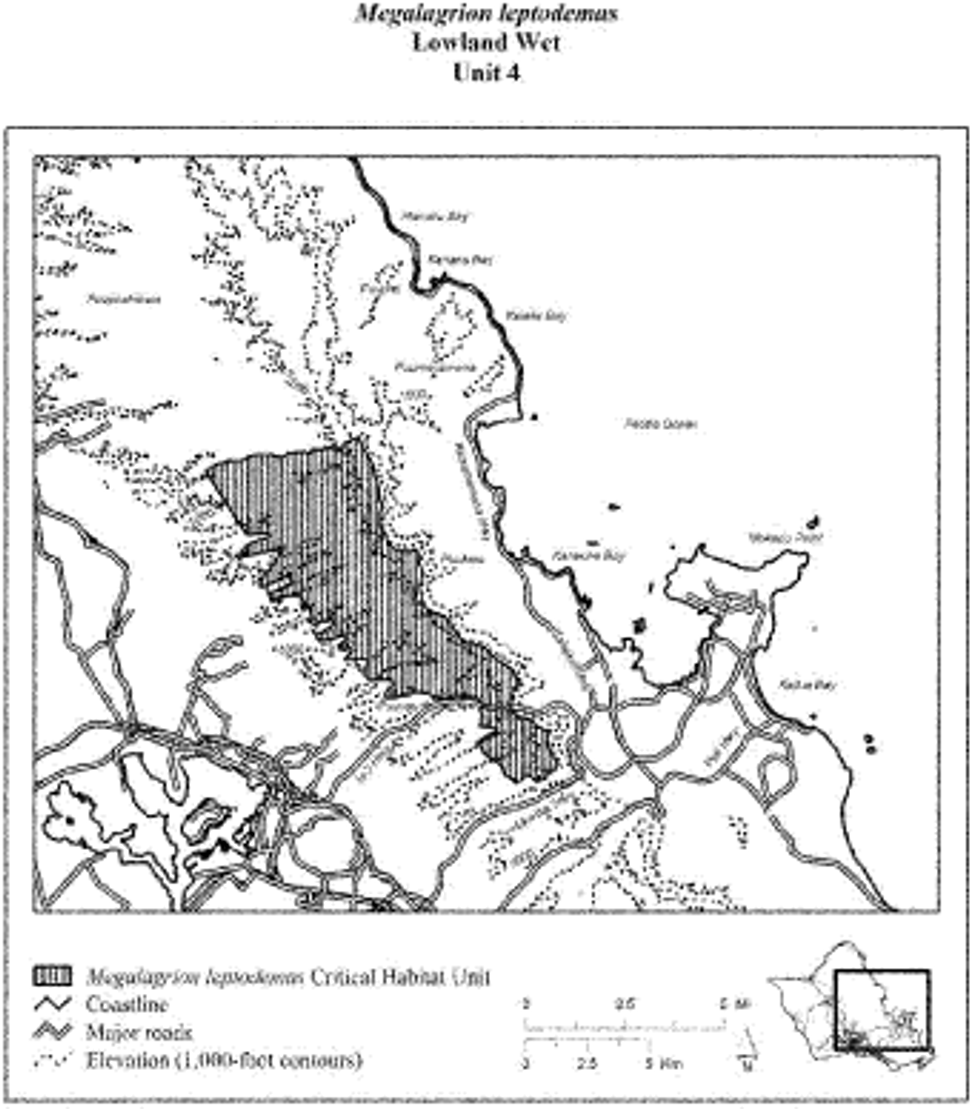
(8) Megalagrion leptodemas - Unit 5 - Lowland Wet, Honolulu County, Hawaii (124 ac; 50 ha); Megalagrion leptodemas - Unit 6 - Lowland Wet, Honolulu County, Hawaii (123 ac; 50 ha); and Megalagrion leptodemas - Unit 7 - Lowland Wet, Honolulu County, Hawaii (53 ac; 21 ha). These units are critical habitat for the crimson Hawaiian damselfly, Megalagrion leptodemas. Map of Megalagrion leptodemas - Unit 5 - Lowland Wet, Megalagrion leptodemas - Unit 6 - Lowland Wet, and Megalagrion leptodemas - Unit 7 - Lowland Wet follows:

(9) Megalagrion leptodemas - Unit 8 - Lowland Wet, Honolulu County, Hawaii (75 ac; 30 ha); Megalagrion leptodemas - Unit 9 - Lowland Wet, Honolulu County, Hawaii (478 ac; 193 ha); Megalagrion leptodemas - Unit 10 - Lowland Wet, Honolulu County, Hawaii (407 ac; 165 ha); and Megalagrion leptodemas - Unit 11 - Lowland Wet, Honolulu County, Hawaii (2,507 ac; 1,014 ha). These units are critical habitat for the crimson Hawaiian damselfly, Megalagrion leptodemas. Map of Megalagrion leptodemas - Unit 8 - Lowland Wet, Megalagrion leptodemas - Unit 9 - Lowland Wet, Megalagrion leptodemas - Unit 10 - Lowland Wet, and Megalagrion leptodemas - Unit 11 - Lowland Wet follows:
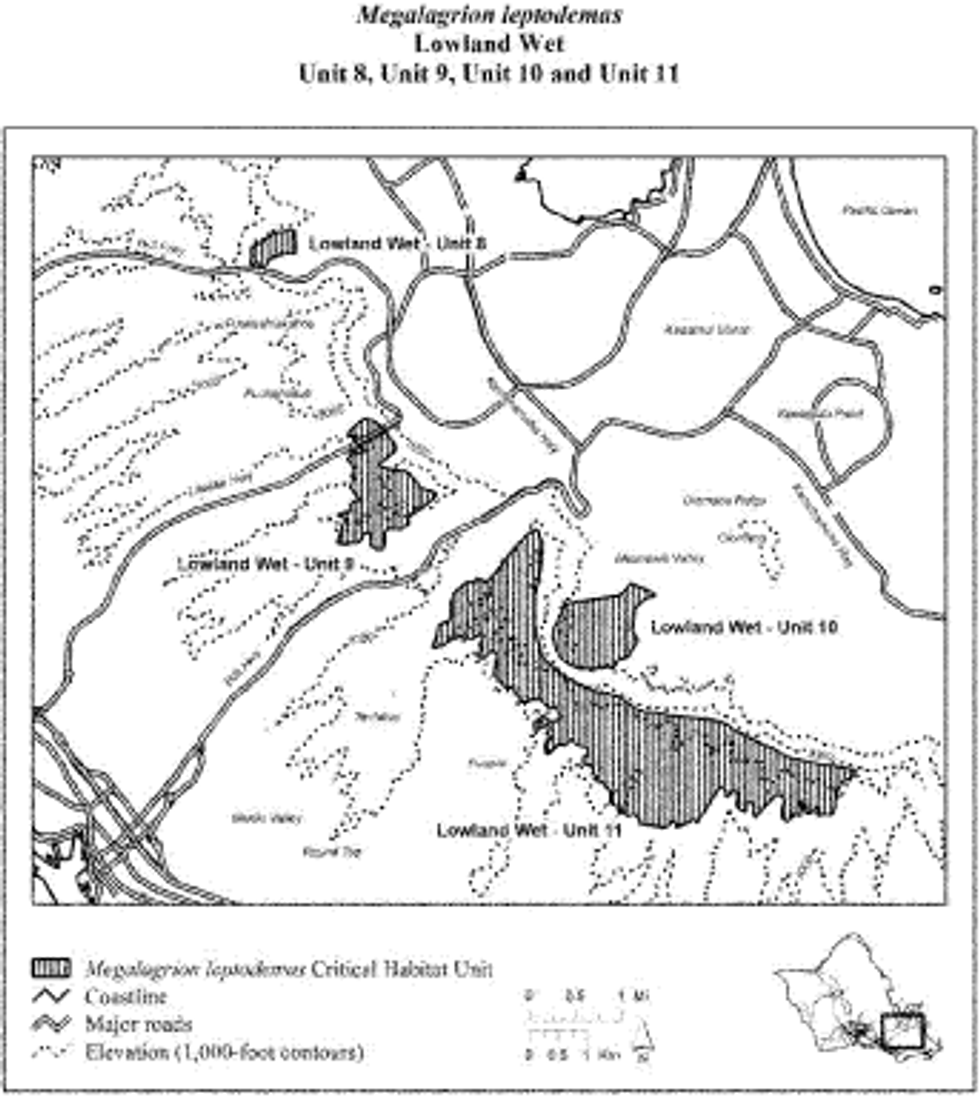
(10) Megalagrion leptodemas - Unit 12 - Wet Cliff, Honolulu County, Hawaii (151 ac; 61 ha) and Megalagrion leptodemas - Unit 13 - Wet Cliff, Honolulu County, Hawaii (144 ac; 58 ha). These units are critical habitat for the crimson Hawaiian damselfly, Megalagrion leptodemas. Map of Megalagrion leptodemas - Unit 12 - Wet Cliff and Megalagrion - Unit 13 - Wet Cliff follows:
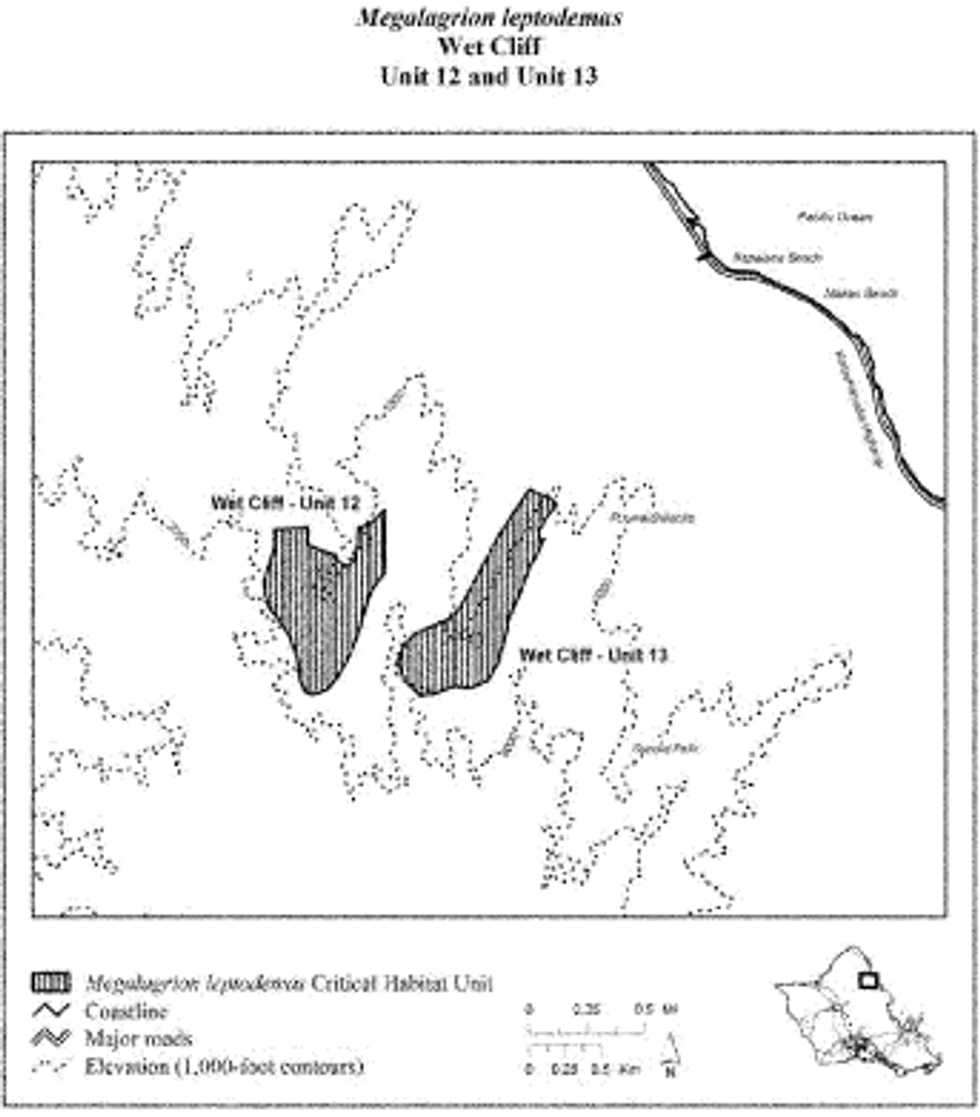
(11) Megalagrion leptodemas - Unit 14 - Wet Cliff, Honolulu County, Hawaii (4,649 ac; 1,881 ha). This unit is critical habitat for the crimson Hawaiian damselfly, Megalagrion leptodemas. Map of Megalagrion leptodemas - Unit 14 - Wet Cliff follows:
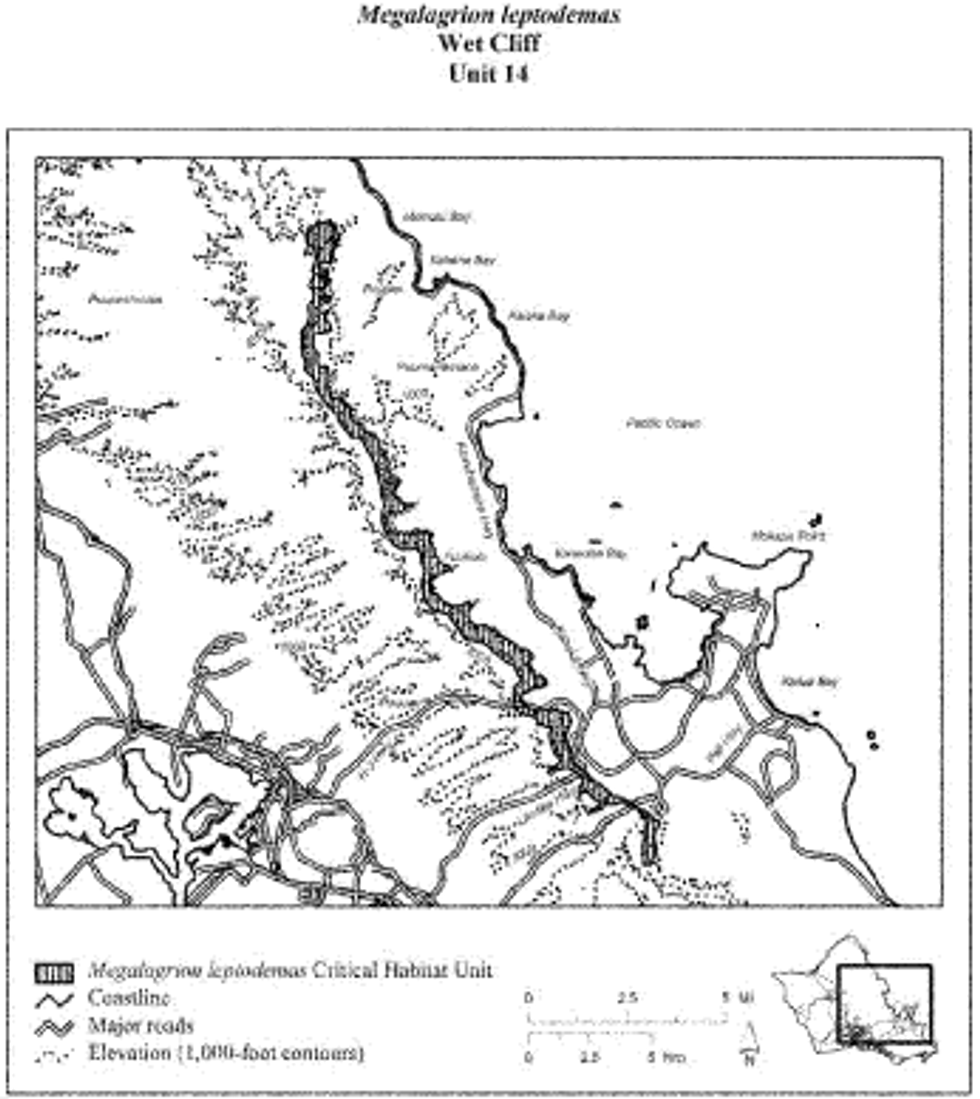
Oceanic Hawaiian Damselfly (Megalagrion oceanicum)
(1) Critical habitat units are depicted for Honolulu County, Hawaii, on the maps below.
(2) Primary constituent elements.
(i) In unit 1, the primary constituent elements of critical habitat for the oceanic Hawaiian damselfly (Megalagrion oceanicum) are:
(A) Elevation: Less than 3,300 ft (1,000 m).
(B) Annual precipitation: 50 to 75 in (130 to 190 cm).
(C) Substrate: Shallow soils, little to no herbaceous layer.
(D) Canopy: Acacia, Diospyros, Metrosideros, Myrsine, Pouteria, Santalum.
(E) Subcanopy: Dodonaea, Freycinetia, Leptecophylla, Melanthera, Osteomeles, Pleomele, Psydrax.
(F) Understory: Carex, Dicranopteris, Diplazium, Elaphoglossum, Peperomia.
(G) Perennial streams.
(H) Swift-flowing sections and riffles of streams.
(ii) In units 2, 3, 4, 5, 6, 7, 8, 9, 10, 11, and 12, the primary constituent elements of critical habitat for the oceanic Hawaiian damselfly (Megalagrion oceanicum) are:
(A) Elevation: Less than 3,300 ft (1,000 m).
(B) Annual precipitation: Greater than 75 in (190 cm).
(C) Substrate: Clays; ashbeds; deep, well-drained soils; lowland bogs.
(D) Canopy: Antidesma, Metrosideros, Myrsine, Pisonia, Psychotria.
(E) Subcanopy: Cibotium, Claoxylon, Kadua, Melicope.
(F) Understory: Alyxia, Cyrtandra, Dicranopteris, Diplazium, Machaerina, Microlepia.
(G) Perennial streams.
(H) Swift-flowing sections and riffles of streams.
(iii) In units 13, 14, and 15, the primary constituent elements of critical habitat for the oceanic Hawaiian damselfly (Megalagrion oceanicum) are:
(A) Elevation: Unrestricted.
(B) Annual precipitation: Greater than 75 in (190 cm).
(C) Substrate: Greater than 65 degree slope, shallow soils, weathered lava.
(D) Canopy: None.
(E) Subcanopy: Broussaisia, Cheirodendron, Leptecophylla, Metrosideros.
(F) Understory: Ferns, Bryophytes, Coprosma, Dubautia, Kadua, Peperomia.
(G) Perennial streams.
(H) Swift-flowing sections and riffles of streams.
(3) Existing manmade features and structures, such as buildings, roads, railroads, airports, runways, other paved areas, lawns, and other urban landscaped areas, existing trails, campgrounds and their immediate surrounding landscaped area, scenic lookouts, remote helicopter landing sites, and existing fences are not included in the critical habitat designation. Federal actions limited to those areas, therefore, would not trigger a consultation under section 7 of the Act unless they may affect the species or physical and biological features in adjacent critical habitat.
(4) Critical habitat maps. Maps were created in GIS, with coordinates in UTM Zone 4, units in meters using North American datum of 1983 (NAD 83). The maps in this entry, as modified by any accompanying regulatory text, establish the boundaries of the critical habitat designation. The coordinates or plot points or both on which each map is based are available to the public at the Service's internet site, http://www.fws.gov/pacificislands; at http://www.regulations.gov at Docket No. FWS-R1-ES-2010-0043; and at the field office responsible for the designation. You may obtain field office location information by contacting one of the Service regional offices, the addresses of which are listed at 50 CFR 2.2.
(5) Index map of critical habitat units for the oceanic Hawaiian damselfly (Megalagrion oceanicum) follows:
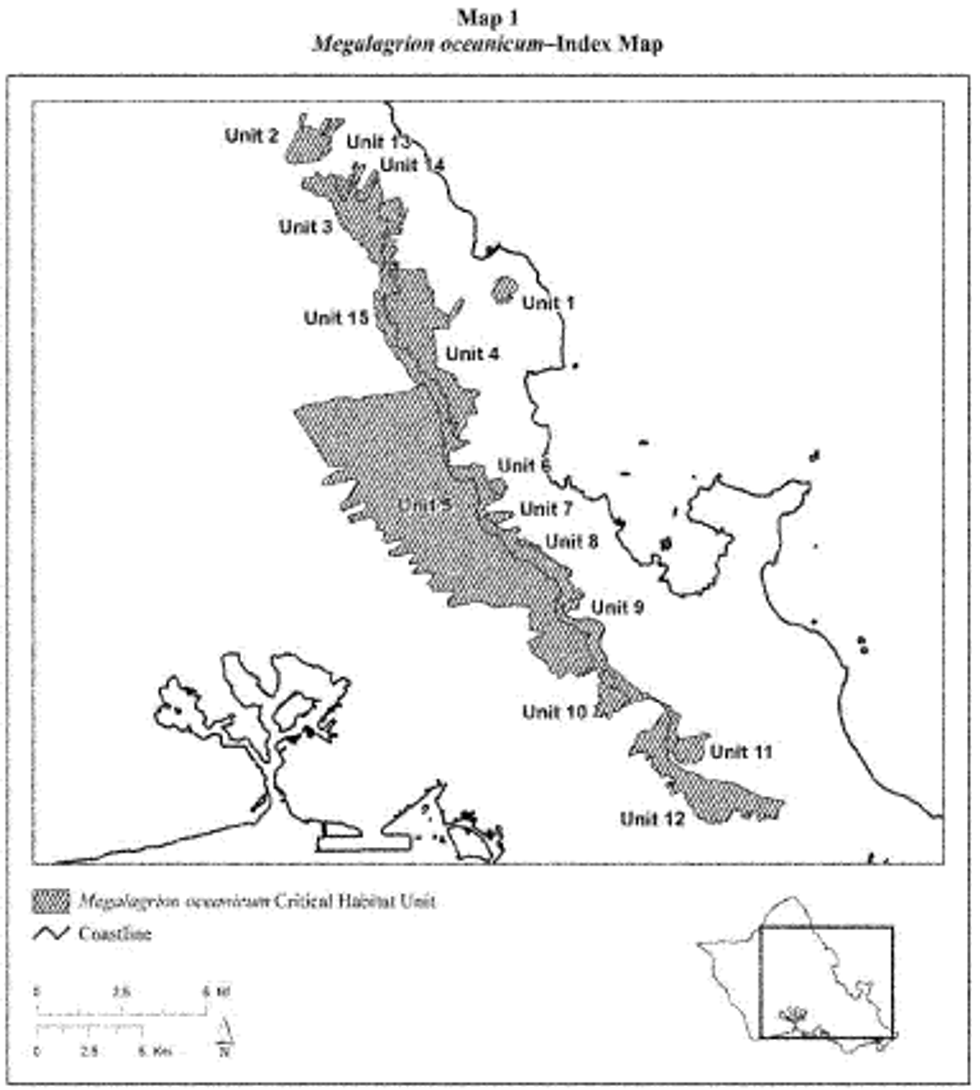
(6) Megalagrion oceanicum - Unit 1 - Lowland Mesic, Honolulu County, Hawaii (247 ac; 100 ha). This unit is critical habitat for the oceanic Hawaiian damselfly, Megalagrion oceanicum. Map of Megalagrion oceanicum - Unit 1 - Lowland Mesic (Map 2) follows:
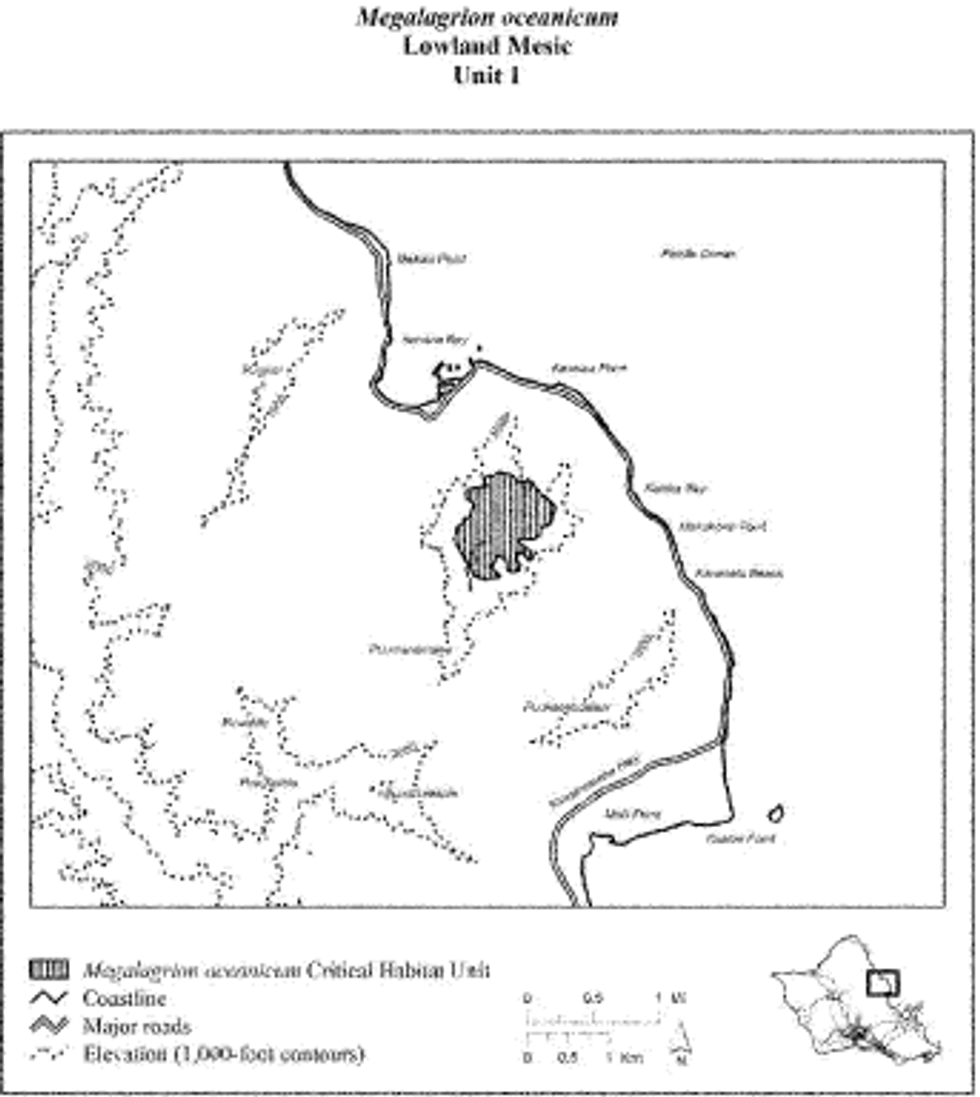
(7) Megalagrion oceanicum - Unit 2 - Lowland Wet, Honolulu County, Hawaii (790 ac; 320 ha); Megalagrion oceanicum - Unit 3 - Lowland Wet, Honolulu County, Hawaii (1,787 ac; 723 ha); and Megalagrion oceanicum - Unit 4 - Lowland Wet, Honolulu County, Hawaii (3,041 ac; 1,231 ha). These units are critical habitat for the oceanic Hawaiian damselfly, Megalagrion oceanicum. Map of Megalagrion oceanicum - Unit 2 - Lowland Wet, Megalagrion oceanicum - Unit 3 - Lowland Wet, and Megalagrion oceanicum - Unit 4 - Lowland Wet follows:

(8) Megalagrion oceanicum - Unit 5 - Lowland Wet, Honolulu County, Hawaii (15,728 ac; 6,365 ha). This unit is critical habitat for the oceanic Hawaiian damselfly, Megalagrion oceanicum. Map of Megalagrion oceanicum - Unit 5 - Lowland Wet follows:
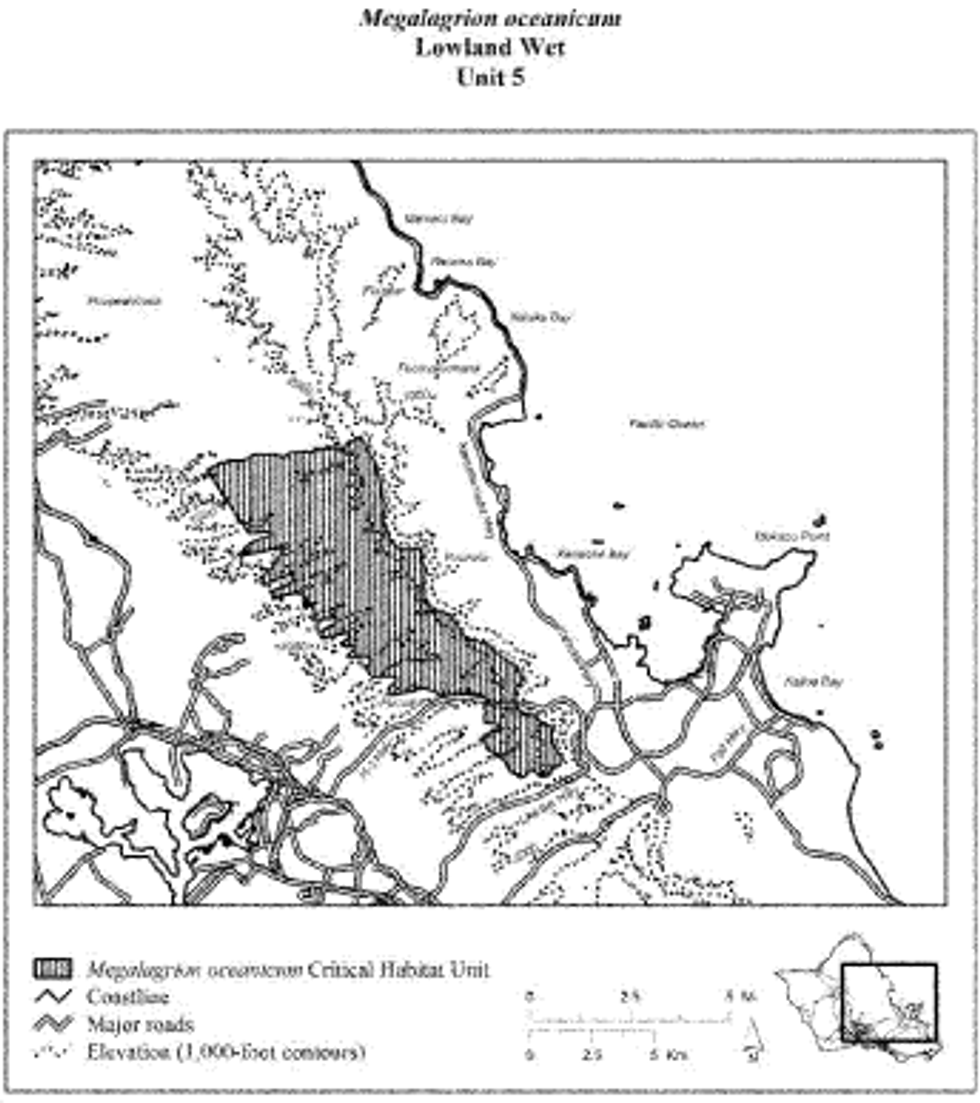
(9) Megalagrion oceanicum - Unit 6 - Lowland Wet, Honolulu County, Hawaii (124 ac; 50 ha); Megalagrion oceanicum - Unit 7 - Lowland Wet, Honolulu County, Hawaii (123 ac; 50 ha); and Megalagrion oceanicum - Unit 8 - Lowland Wet, Honolulu County, Hawaii (53 ac; 21 ha). These units are critical habitat for the oceanic Hawaiian damselfly, Megalagrion oceanicum. Map of Megalagrion oceanicum - Unit 6 - Lowland Wet, Megalagrion oceanicum - Unit 7 - Lowland Wet, and Megalagrion oceanicum - Unit 8 - Lowland Wet follows:
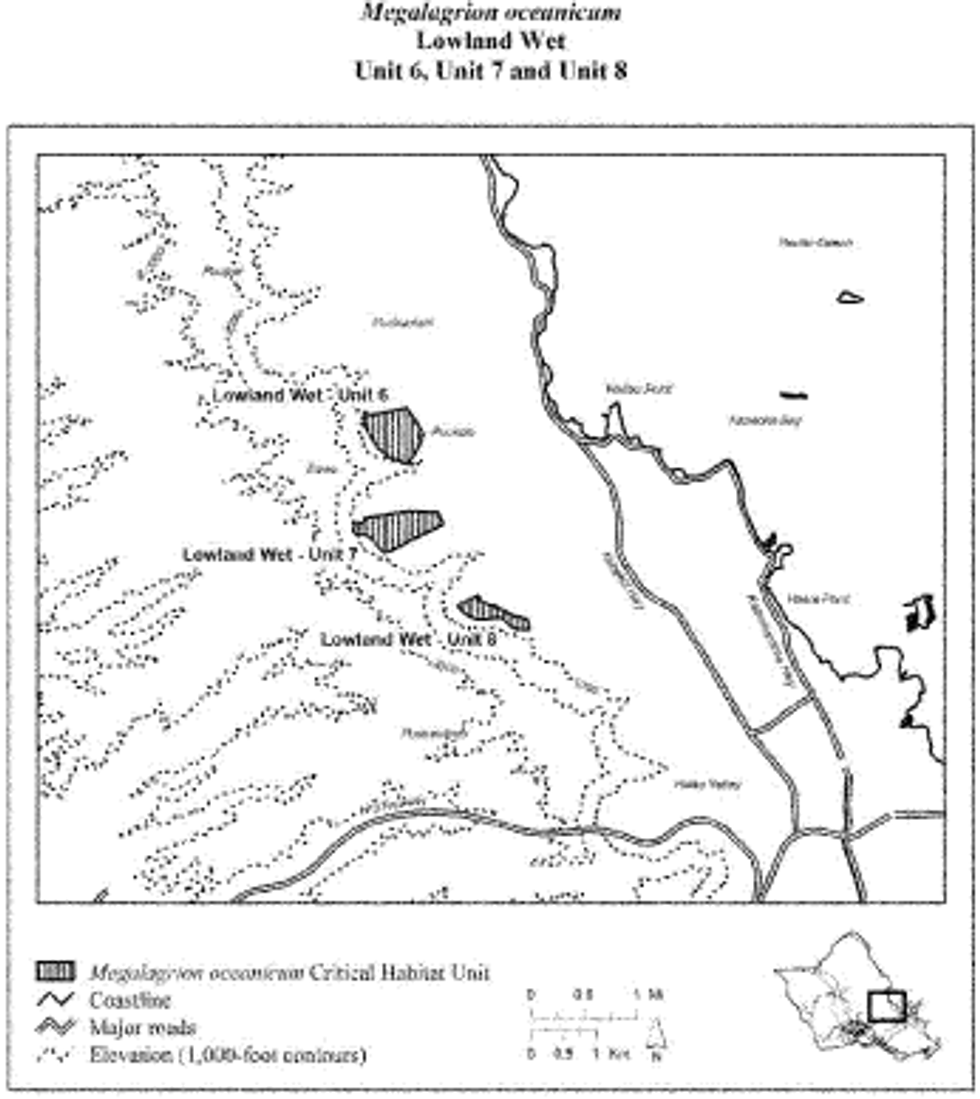
(10) Megalagrion oceanicum - Unit 9 - Lowland Wet, Honolulu County, Hawaii (75 ac; 30 ha); Megalagrion oceanicum - Unit 10 - Lowland Wet, Honolulu County, Hawaii (478 ac; 193 ha); Megalagrion oceanicum - Unit 11 - Lowland Wet, Honolulu County, Hawaii (407 ac; 165 ha); and Megalagrion oceanicum - Unit 12 - Lowland Wet, Honolulu County, Hawaii (2,507 ac; 1,014 ha). These units are critical habitat for the oceanic Hawaiian damselfly, Megalagrion oceanicum. Map of Megalagrion oceanicum - Unit 9 - Lowland Wet, Megalagrion oceanicum - Unit 10 - Lowland Wet, Megalagrion oceanicum - Unit 11 - Lowland Wet, and Megalagrion oceanicum - Unit 12 - Lowland Wet follows:
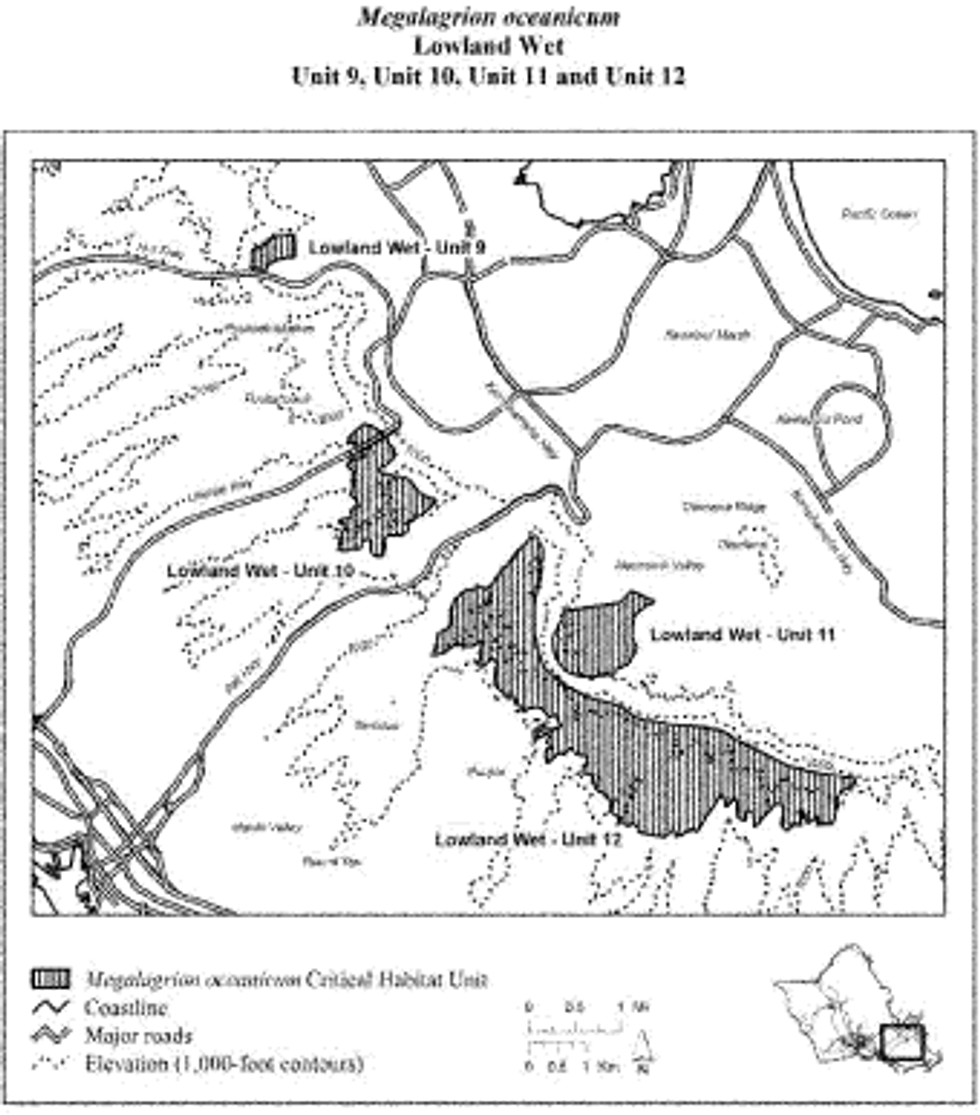
(11) Megalagrion oceanicum - Unit 13 - Wet Cliff, Honolulu County, Hawaii (151 ac; 61 ha) and Megalagrion oceanicum - Unit 14 - Wet Cliff, Honolulu County, Hawaii (144 ac; 58 ha). These units are critical habitat for the oceanic Hawaiian damselfly, Megalagrion oceanicum. Map of Megalagrion oceanicum - Unit 13 - Wet Cliff and Megalagrion oceanicum - Unit 14 - Wet Cliff follows:
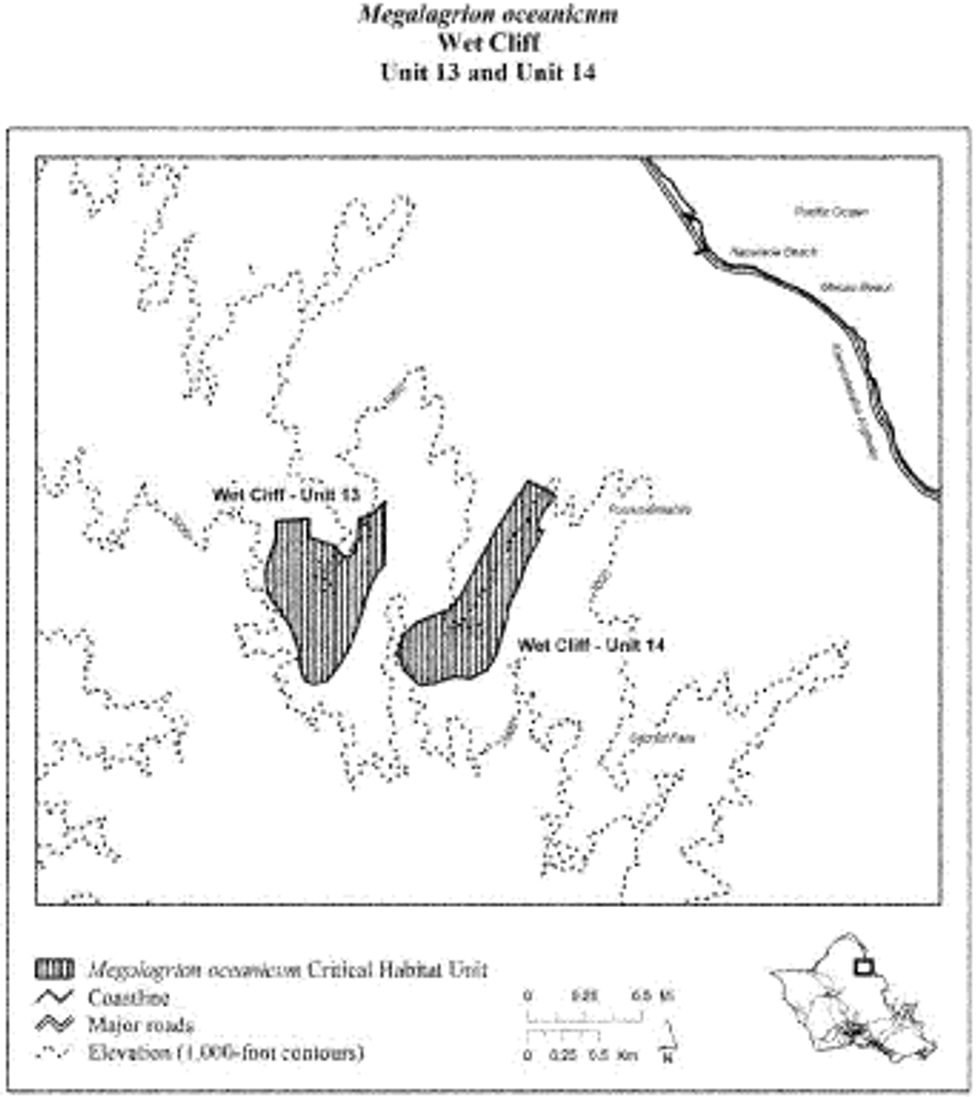
(12) Megalagrion oceanicum - Unit 15 - Wet Cliff, Honolulu County, Hawaii (4,649 ac; 1,881 ha). This unit is critical habitat for the oceanic Hawaiian damselfly, Megalagrion oceanicum. Map of Megalagrion oceanicum - Unit 15 - Wet Cliff follows:
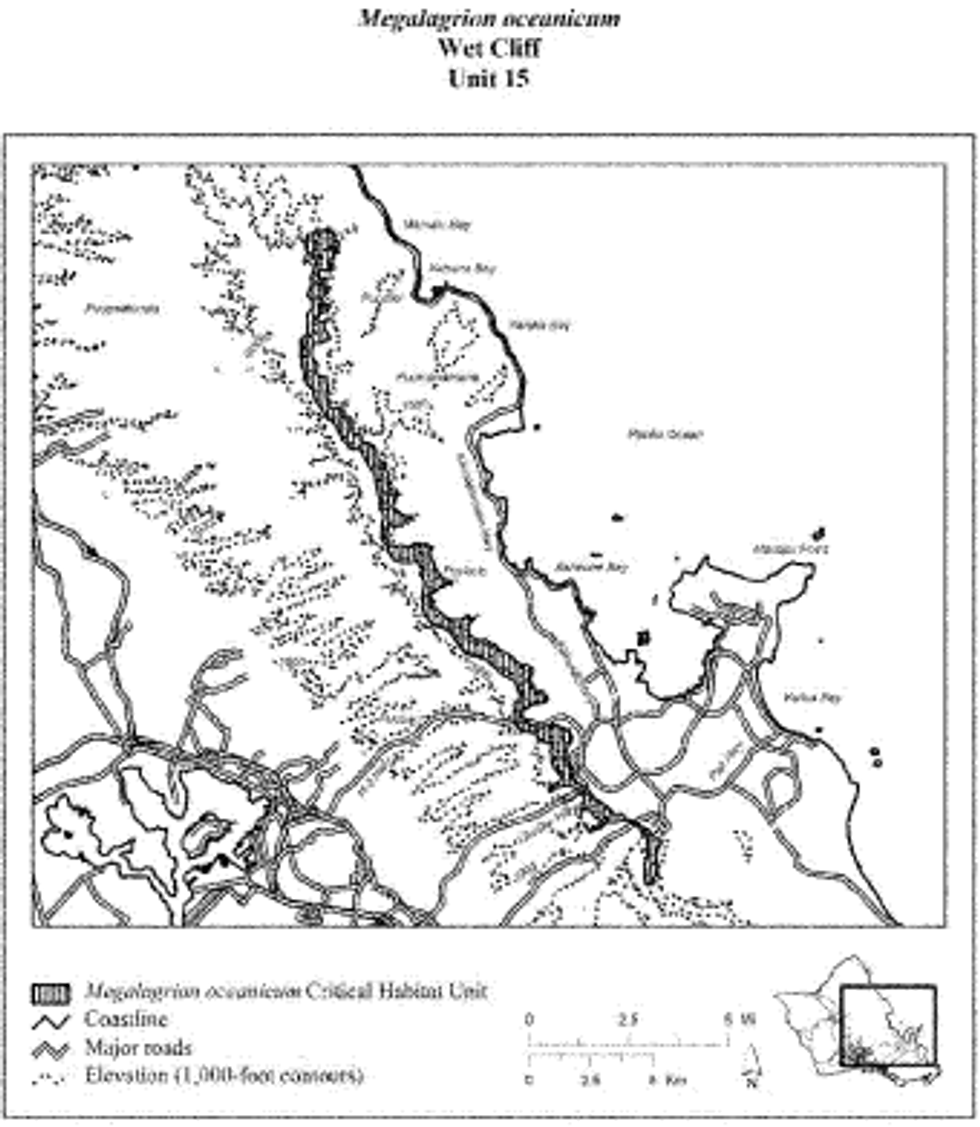
Hine's Emerald Dragonfly (Somatochlora hineana)
(1) Critical habitat units are depicted for Cook, DuPage, and Will Counties in Illinois; Alpena, Mackinac, and Presque Isle Counties in Michigan; Crawford, Dent, Iron, Phelps, Reynolds, Ripley, Washington, and Wayne Counties in Missouri; and Door and Ozaukee Counties in Wisconsin, on the maps below. The maps provided are for informational purposes only.
(2) The primary constituent elements of critical habitat for the Hine's emerald dragonfly are:
(i) For egg deposition and larval growth and development:
(A) Organic soils (histosols, or with organic surface horizon) overlying calcareous substrate (predominantly dolomite and limestone bedrock);
(B) Calcareous water from intermittent seeps and springs and associated shallow, small, slow-flowing streamlet channels, rivulets, and/or sheet flow within fens;
(C) Emergent herbaceous and woody vegetation for emergence facilitation and refugia;
(D) Occupied burrows maintained by crayfish for refugia; and
(E) Prey base of aquatic macroinvertebrates, including mayflies, aquatic isopods, caddisflies, midge larvae, and aquatic worms.
(ii) For adult foraging, reproduction, dispersal, and refugia necessary for roosting, for resting, for adult females to escape from male harassment, and for predator avoidance (especially during the vulnerable teneral stage):
(A) Natural plant communities near the breeding/larval habitat which may include fen, marsh, sedge meadow, dolomite prairie, and the fringe (up to 328 ft (100 m)) of bordering shrubby and forested areas with open corridors for movement and dispersal; and
(B) Prey base of small, flying insect species (e.g., dipterans).
(3) Critical habitat does not include human-made structures existing on the effective date of this rule and not containing one or more of the primary constituent elements, such as buildings, lawns, old fields, hay meadows, fallow crop fields, manicured lawns, pastures, piers and docks, aqueducts, airports, and roads, and the land on which such structures are located. We define “old field” here as cleared areas that were formerly forested and may have been used as crop or pasture land that currently support a mixture of native and nonnative herbs and low shrubs. “Fallow field” is defined as a formerly plowed field that has been left unseeded for a season or more and is presently uncultivated. In addition, critical habitat does not include open-water areas (i.e., areas beyond the zone of emergent vegetation) of lakes and ponds.
(4) Critical habitat map units. Data layers defining map units were created on a base of USGS 7.5' quadrangles, and critical habitat units were then mapped using Geographical Information Systems, Universal Transverse Mercator (UTM) coordinates. Critical habitat units are described using the public land survey system (township (T), range (R) and section (Sec.)).
(5) Note: Index map of critical habitat units (Index map) follows:
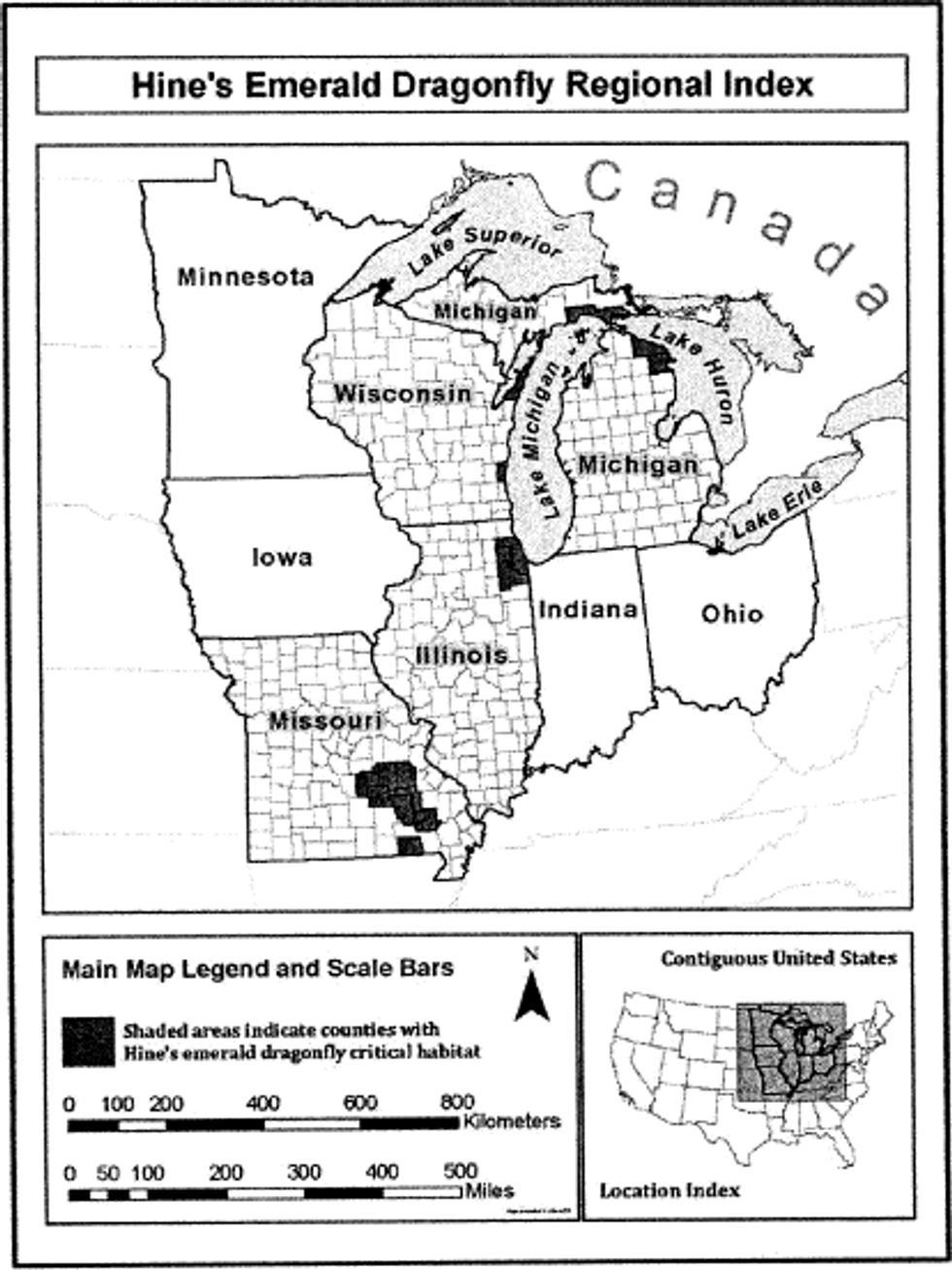
(6) Illinois Units 1 through 7, Cook, DuPage, and Will Counties, Illinois.
(i) Illinois Unit 1: Will County. Located in T36N, R10E, Sec. 22, Sec. 27, SE1/4 NE1/4 Sec. 28, NE1/4 SE1/4 Sec. 28, NW1/4 NW1/4 Sec. 34 of the Joliet 7.5' USGS topographic quadrangle. Land south of Illinois State Route 7, east of Illinois State Route 53, and west of the Des Plaines River.
(ii) Illinois Unit 2: Will County. Located in T36N, R10E, Sec. 3, NW1/4 E1/2 Sec. 10, E1/2 Sec. 15 of the Romeoville and Joliet 7.5' USGS topographic quadrangles. Land east of Illinois State Route 53, and west of the Des Plaines River.
(iii) Illinois Unit 3: Will County. Located in T37N, R10E, SW1/4 Sec. 26, NW1/4 SE1/4 Sec. 26, E1/2 Sec. 34, W1/2 NW 1/4 Sec. 35 of the Romeoville 7.5' USGS topographic quadrangle. Land west and north of the Des Plaines River and north of East Romeoville Road.
(iv) Illinois Unit 4: Will and Cook Counties. Located in T37N, R10E, S1/2 NE1/4 Sec. 24, W1/2 SW1/4 Sec. 24, SE1/4 Sec. 24 and T37N, R11E, SW1/4 SW1/4 Sec. 17, Sec. 19, NW1/4 Sec. 20 of the Romeoville 7.5' USGS topographic quadrangle. Land to the south of Bluff Road, west of Lemont Road, and north of the Des Plaines River.
(v) Illinois Unit 5: DuPage County. Located in T37N, R11E, NW1/4 Sec. 15, NW1/4 SW1/4 Sec. 15, S1/2 NE1/4 Sec. 16, SW1/4 Sec. 16, N1/2 SE1/4 Sec. 16, SE1/4 Sec. 17 of the Sag Bridge 7.5' USGS topographic quadrangle. Land to the north of the Des Plaines River.
(vi) Illinois Unit 6: Cook County. Located in T37N, R12E, S1/2 Sec. 16, S1/2 NE1/4 Sec. 17, N1/2 SE1/4 Sec. 17, N1/2 Sec. 21 of the Sag Bridge and Palos Park 7.5' USGS topographic quadrangles. Land to the north of the Calumet Sag Channel, south of 107th Street, and east of U.S. Route 45.
(vii) Illinois Unit 7: Will County. Located in T36N, R10E, W1/2 Sec. 1, Sec. 2, N1/2 Sec. 11 of the Romeoville and Joliet 7.5' USGS topographic quadrangles. Land east of the Illinois and Michigan Canal.
(viii) Note: Map of Illinois Units 1 through 7 (Illinois Map 1) follows:
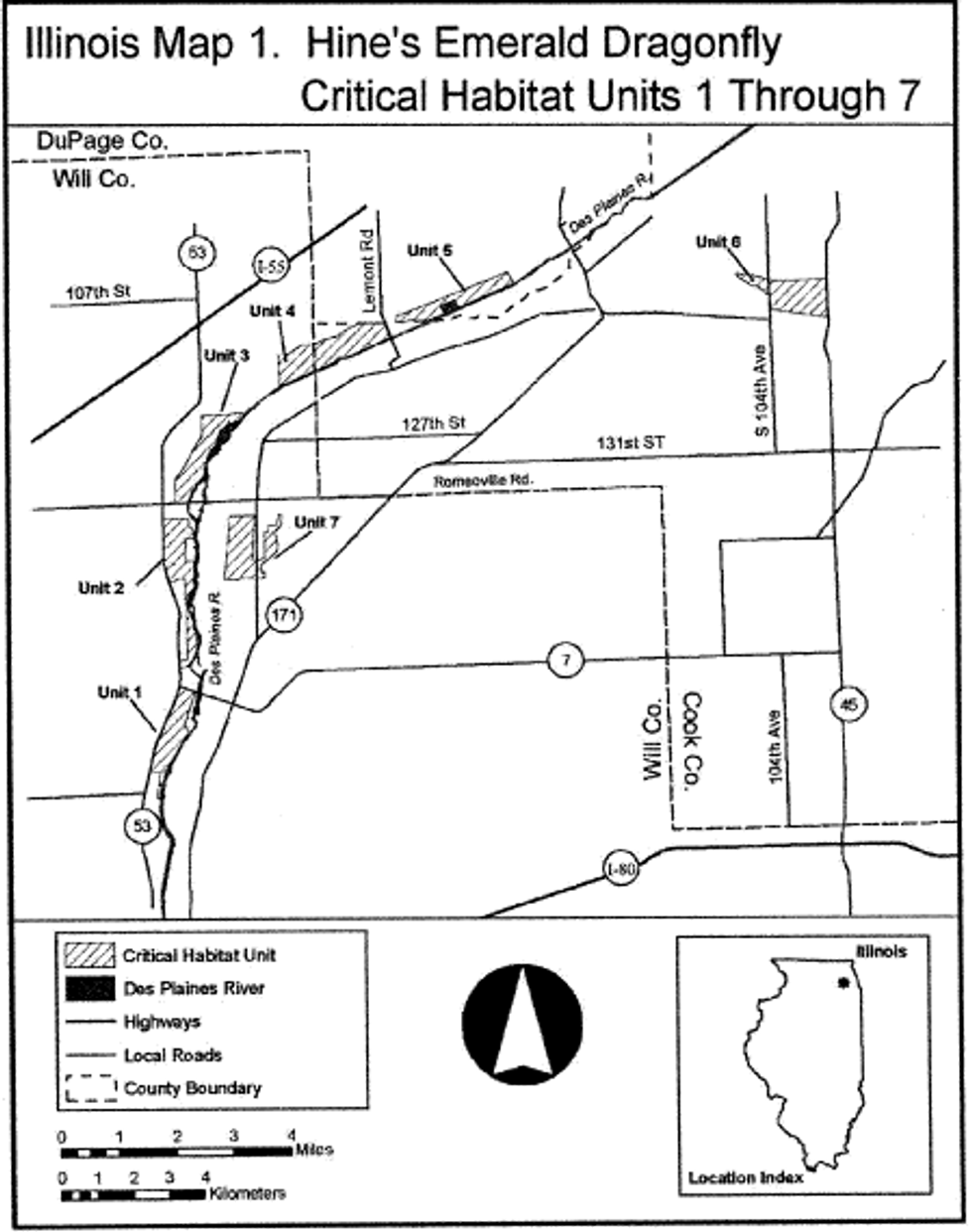
(7) Michigan Units 1 and 2, Mackinac County, Michigan.
(i) Michigan Unit 1: Mackinac County. The unit is located approximately 2 miles north of the village of St. Ignace. The unit contains all of T41N, R4W, Secs. 3, 6, 8, 9, 10, 11, 14, 15, 16, 23; portions of T41N, R4W, Secs. 4, 7, 17, 18, 22, 24, 25, 26, 27; and T41N, R5W, Secs. 1 and 12 of the Moran and Evergreen Shores 7.5' USGS topographic quadrangles. The unit is west of I-75, east of Brevort Lake, and north of Castle Rock Road.
(ii) Michigan Unit 2: Mackinac County. The unit is located approximately 2 miles north of the village of St. Ignace. The unit contains all of T41N, R3W, Sec. 6; portions of T41N, R4W, Secs. 1, 12, 13, 24; portions of T41N, R3W, Secs. 4, 5, 7; and portions of T42N, R3W, Sec. 31 of the Evergreen Shores 7.5' USGS topographic quadrangle. The unit is west of Lake Huron and east of I-75.
(iii) Note: Map of Michigan Units 1 and 2 (Michigan Map 1) follows:
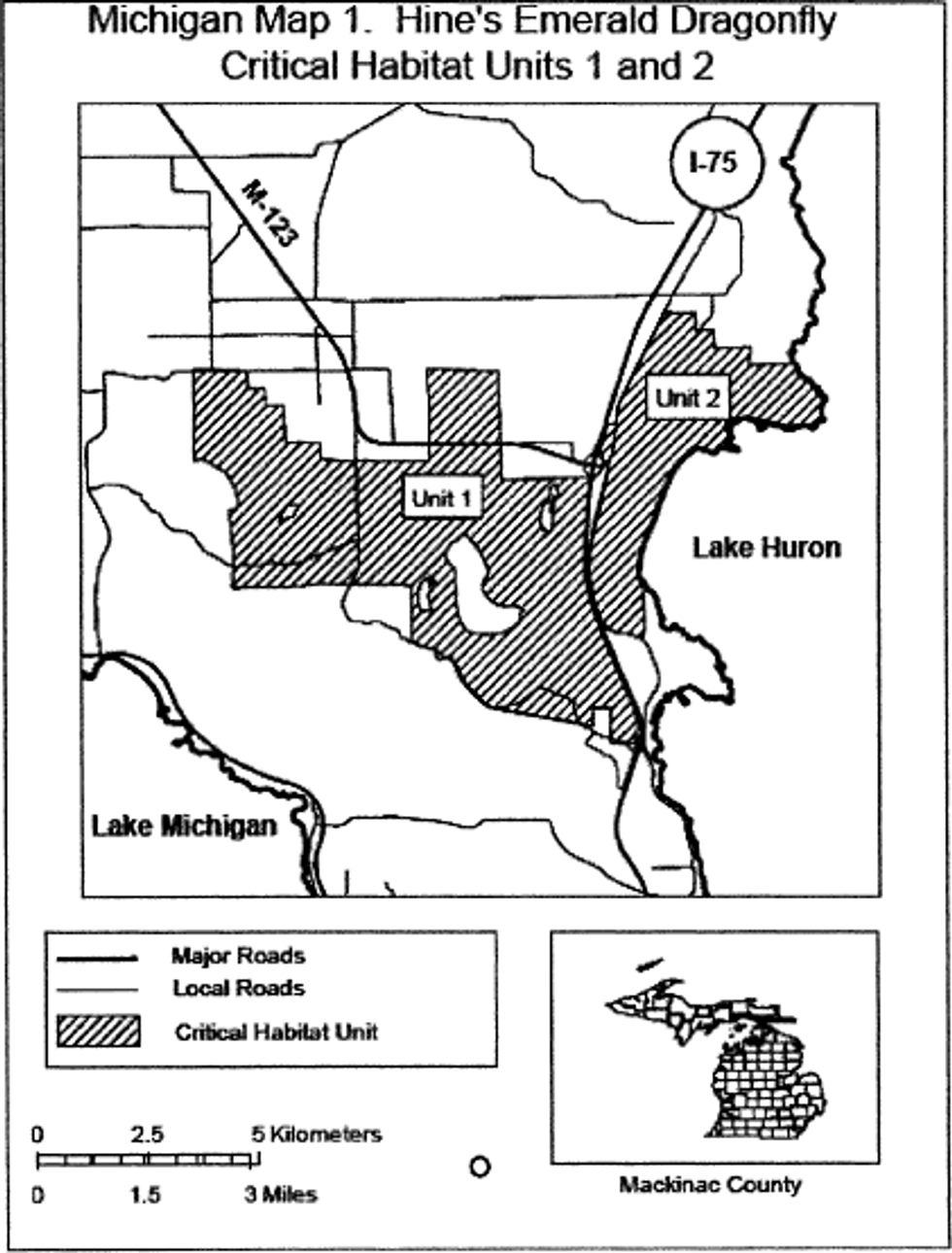
(8) Michigan Unit 3, Mackinac County, Michigan.
(i) Michigan Unit 3: Mackinac County. Located on the east end of Bois Blanc Island. Bois Blanc Island has not adopted an addressing system using the public land survey system. The unit is located in Government Lots 25 and 26 of the Cheboygan and McRae Bay 7.5' USGS topographic quadrangles. The unit extends from approximately Walker's Point south to Rosie Point on the west side of Bob-Lo Drive. It extends from the road approximately 328 ft (100 m) to the west.
(ii) Note: Map of Michigan Unit 3 (Michigan Map 2) follows:
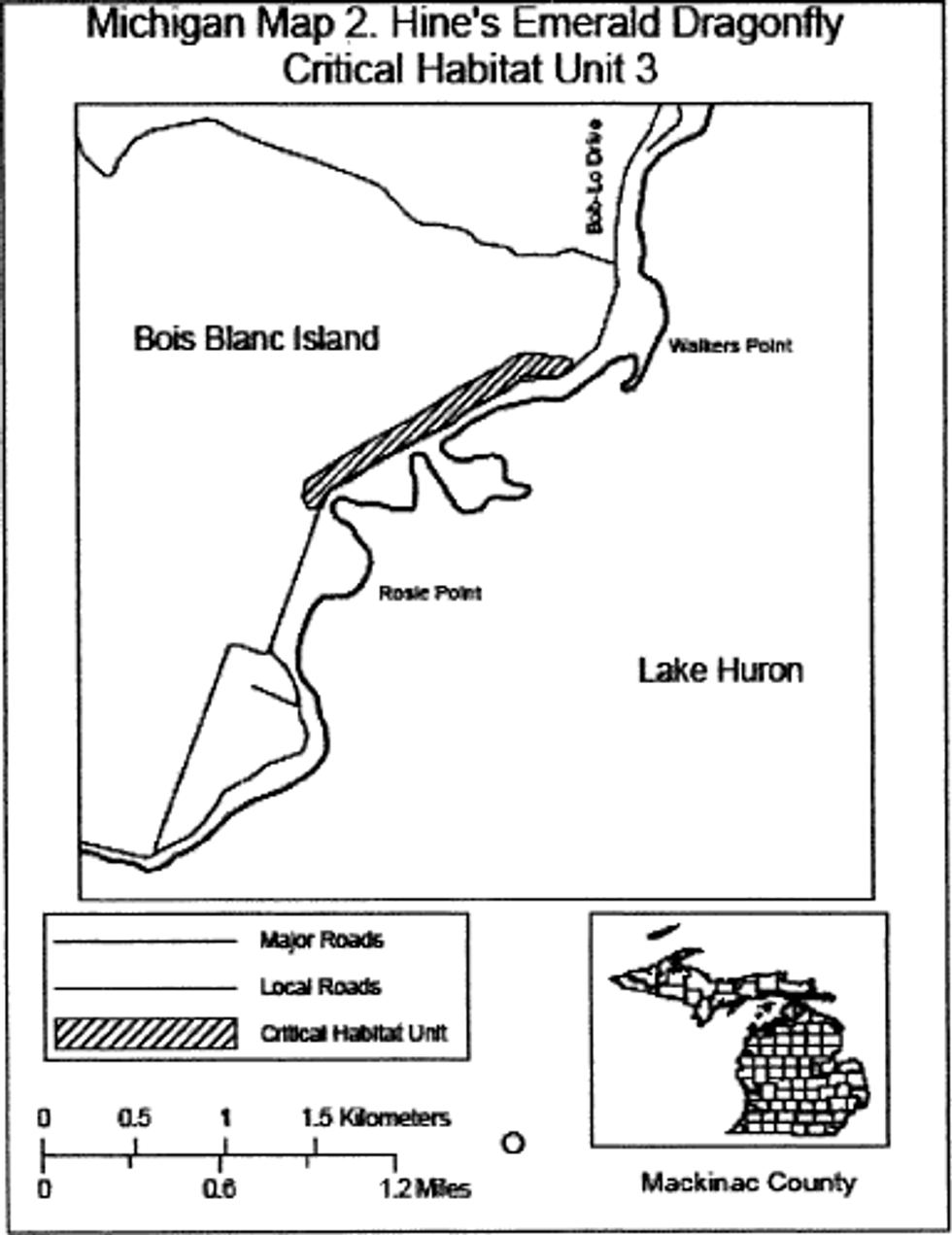
(9) Michigan Unit 4, Presque Isle County, Michigan.
(i) Michigan Unit 4: Presque Isle County. Located approximately 12 miles southeast of the village of Rogers City. The unit contains all of T34N, R7E, SW1/4 SW1/4 Sec. 14, SW1/4 NW1/4 Sec. 15, NE1/4 SW1/4 Sec. 15, NW1/4 SE1/4 Sec. 15, NW1/4 SW1/4 Sec. 15, SE1/4 SE1/4 Sec. 15, NW1/4 NE1/4 Sec. 16, NE1/4 NW1/4 Sec. 16, SE1/4 NE1/4 Sec. 16, and NW1/4 NW1/4 Sec. 23. It also contains portions of T34N, R7E, all 1/4 sections in Secs. 15, all 1/4 sections in Sec. 16, SE1/4 and SW1/4 Sec. 9, SW1/4 Sec. 10, SW1/4 Sec. 14, NE1/4 Sec. 22, NW1/4 and NE1/4 Sec. 23 of the Thompson's Harbor 7.5' USGS topographic quadrangle. The northern boundary of the unit is Lake Huron and the southern boundary is north of M-23.
(ii) Note: Map of Michigan Unit 4 (Michigan Map 3) follows:
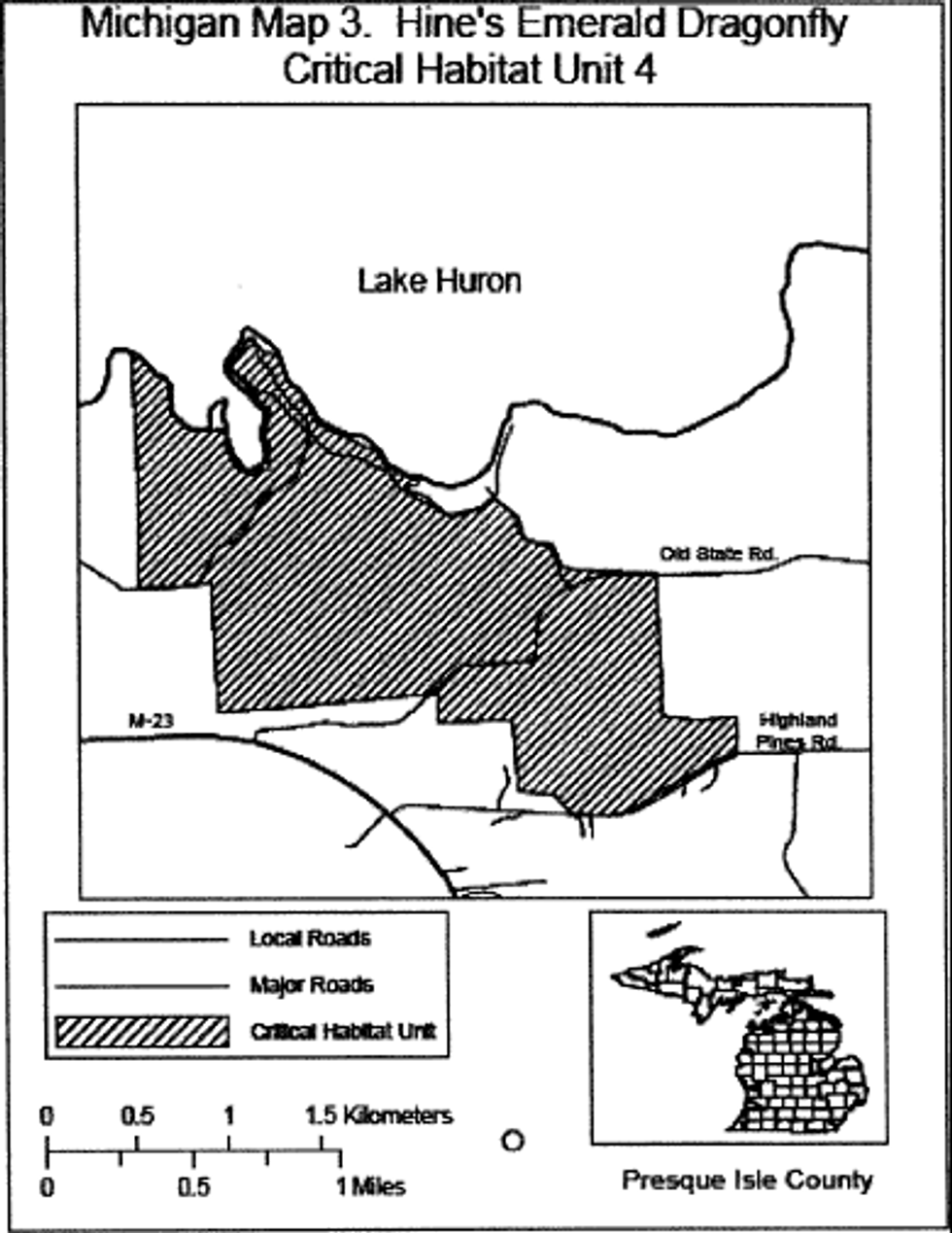
(10) Michigan Unit 5, Alpena County, Michigan.
(i) Michigan Unit 5: Alpena County. Located approximately 9 miles northeast of the village of Alpena. The unit contains all of T31N, R9E, SE1/4 SW1/4 Sec 9. It also contains portions of T31N, R9E, NW1/4 SW1/4 Sec. 9, NE1/4 SW1/4 Sec. 9, SW1/4 SW1/4 Sec. 9, SW1/4 SE1/4 Sec 9; and portions of T31N, R9E, NE1/4 NW1/4 Sec. 16, NW1/4 NE1/4 Sec. 16, NW1/4 NW1/4 Sec. 16 of the 7.5' USGS topographic quadrangle North Point 7.5′ USGS topographic quadrangle. North Point Road is east of the area.
(ii) Note: Map of Michigan Unit 5 (Michigan Map 4) follows:
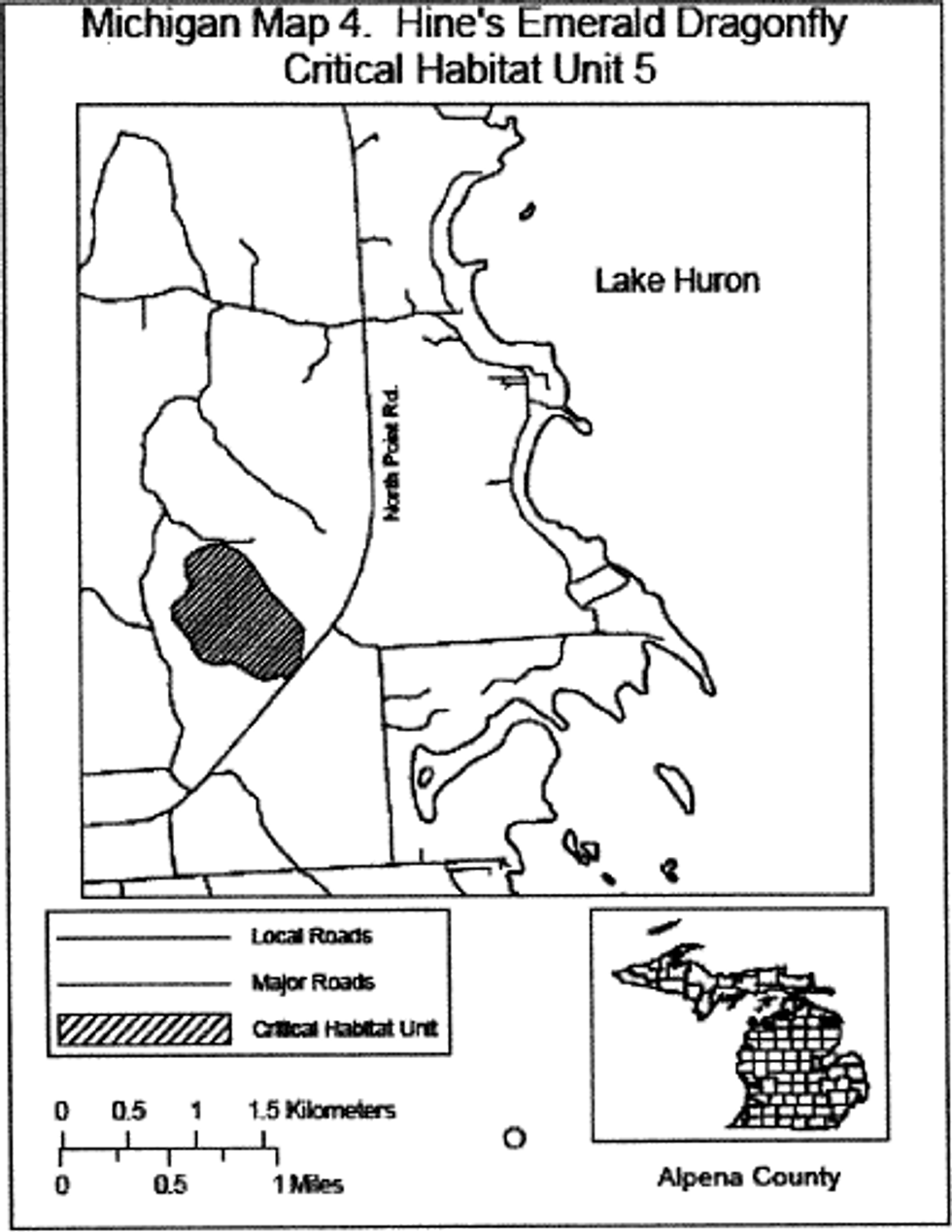
(11) Michigan Unit 6, Alpena County, Michigan.
(i) Michigan Unit 6: Alpena County. Located approximately 5 miles east of the village of Alpena. The unit contains all of T31N, R9E, SW1/4 SE1/4 Sec. 27. It also contains portions of T31N, R9E, NW1/4 SE1/4 Sec. 27, NE1/4 SW1/4 Sec. 27, SE1/4 SW1/4 Sec. 27, SE1/4 SE1/4 Sec. 27; portions of T31N, R9E, NE1/4 NW1/4 Sec. 34, NW1/4 NE1/4 Sec. 34, NE1/4 NE1/4 Sec. 34; and portions of T31N, R9E, NW1/4 NW1/4 Sec. 35, NE1/4 NW1/4, NW1/4 NE1/4 Sec. 35 of the North Point 7.5' USGS topographic quadrangle. Lake Huron is the east boundary of the unit.
(ii) Note: Map of Michigan Unit 6 (Michigan Map 5) follows:
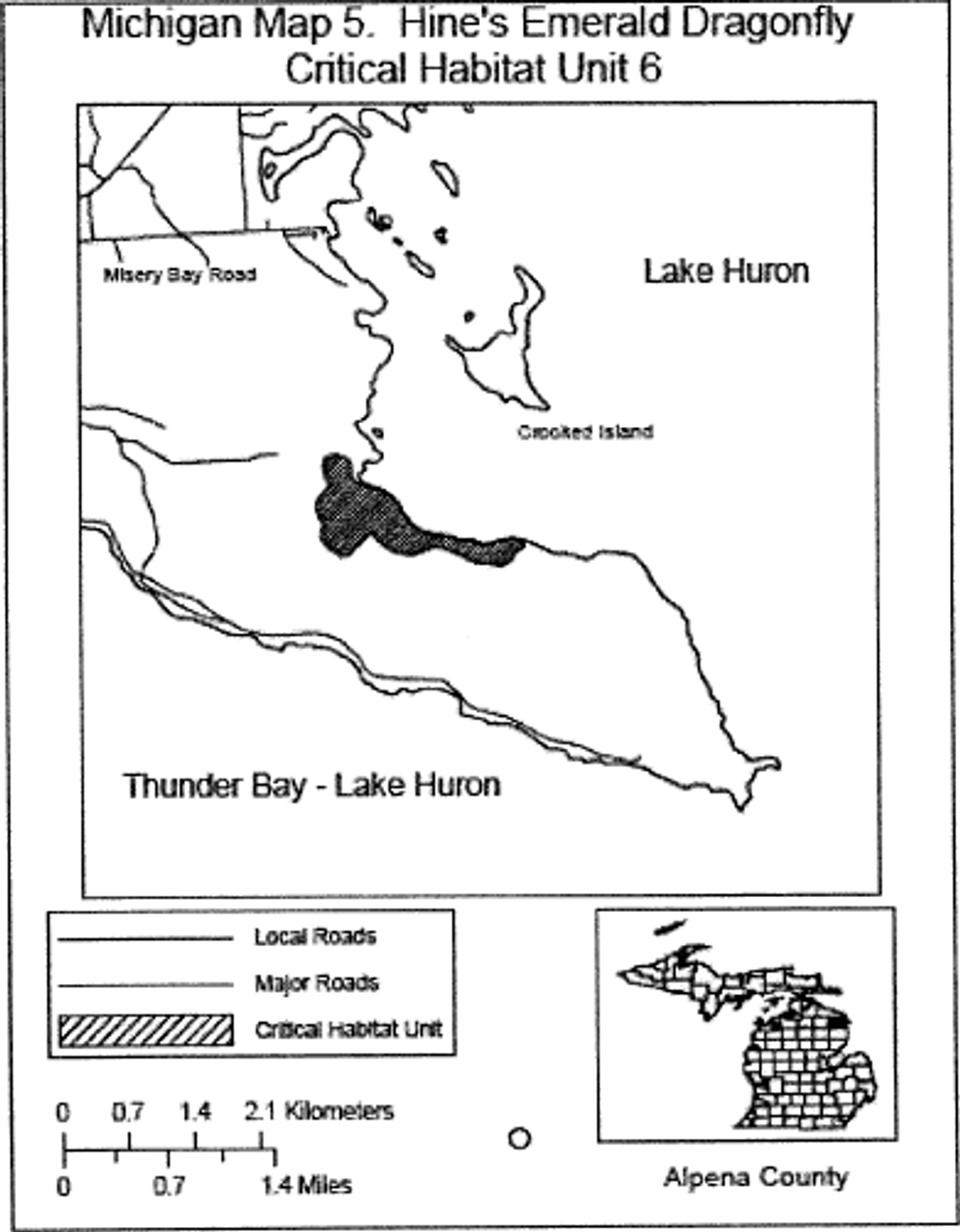
(12) Missouri Unit 1, Crawford County, Missouri.
(i) Missouri Unit 1: Crawford County. Located in T35N, R3W, Secs. 22 and 23 of the Viburnum West 7.5' USGS topographic quadrangle. Missouri Unit 1 is associated with James Creek and is located approximately 1.5 miles west of Billard, Missouri.
(ii) Note: Map of Missouri Unit 1 (Missouri Map 1) follows:
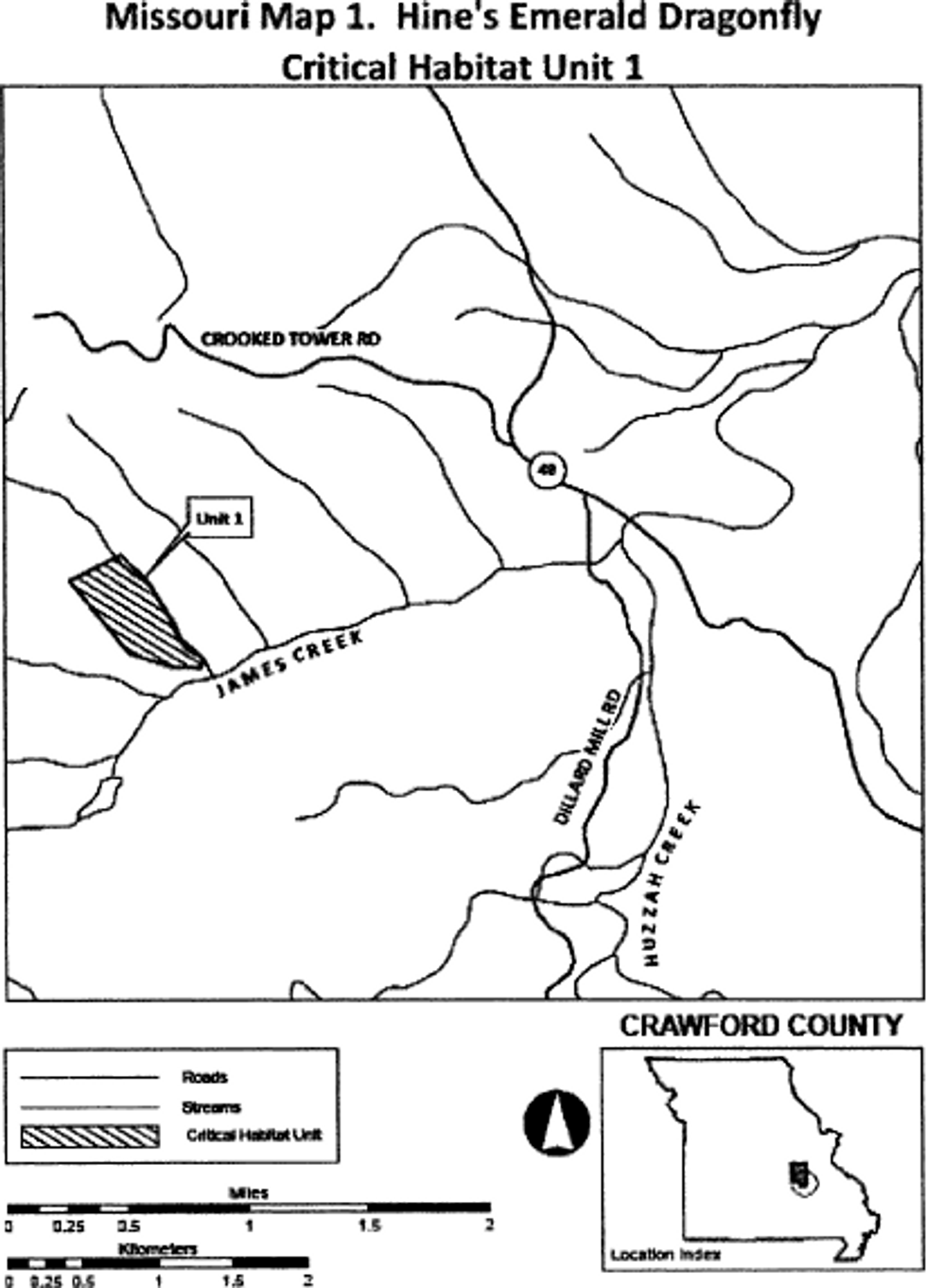
(13) Missouri Units 2a and 4, Dent County, Missouri.
(i) Missouri Unit 2a: Dent County. Located in T34N, R3W, Secs. 3 and 4 of the Howes Mill Spring 7.5' USGS topographic quadrangle. Missouri Unit 2a is associated with an unnamed tributary to West Fork Huzzah Creek and is located approximately 2.5 air miles north of the village of Howes Mill, Missouri adjacent to county road 438.
(ii) Missouri Unit 4: Dent County. Located in T34N, R4W, Secs. 15 and 22 of the Howes Mill Spring 7.5' USGS topographic quadrangle. Missouri Unit 4 is associated with a tributary of Hutchins Creek in Fortune Hollow and is located approximately 1 mile east of the juncture of Highway 72 and Route MM.
(iii) Note: Map of Missouri Units 2a and 4 (Missouri Map 2) follows:
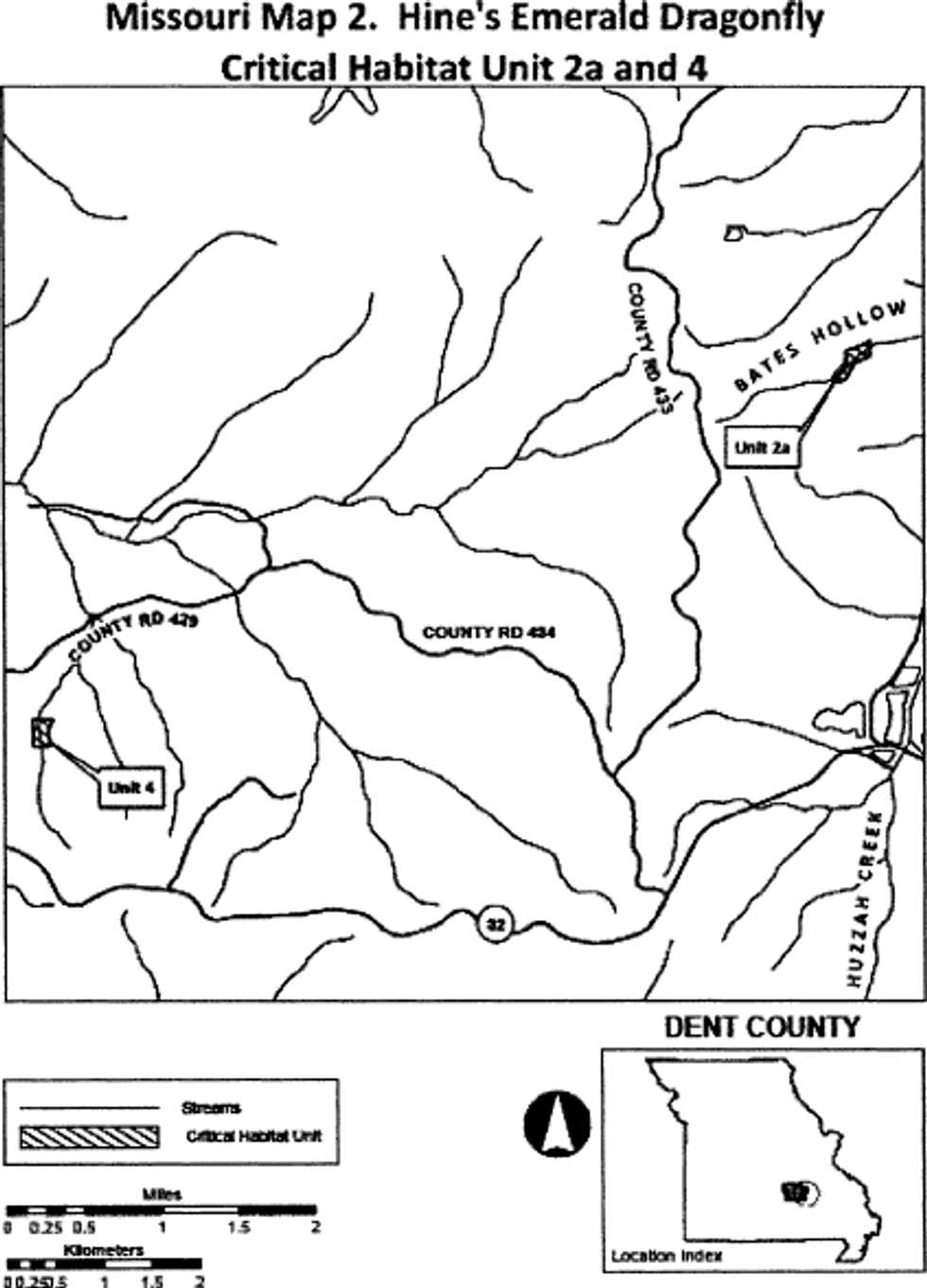
(14) Missouri Unit 5, Iron County, Missouri.
(i) Missouri Unit 5: Iron County. Located in T34N, R1W, Sec. 17of the Viburnum East 7.5' USGS topographic quadrangle. Missouri Unit 5 is located adjacent to Neals Creek and Neals Creek Road, approximately 2.5 miles southeast of Bixby.
(ii) Note: Map of Missouri Unit 5 (Missouri Map 3) follows:
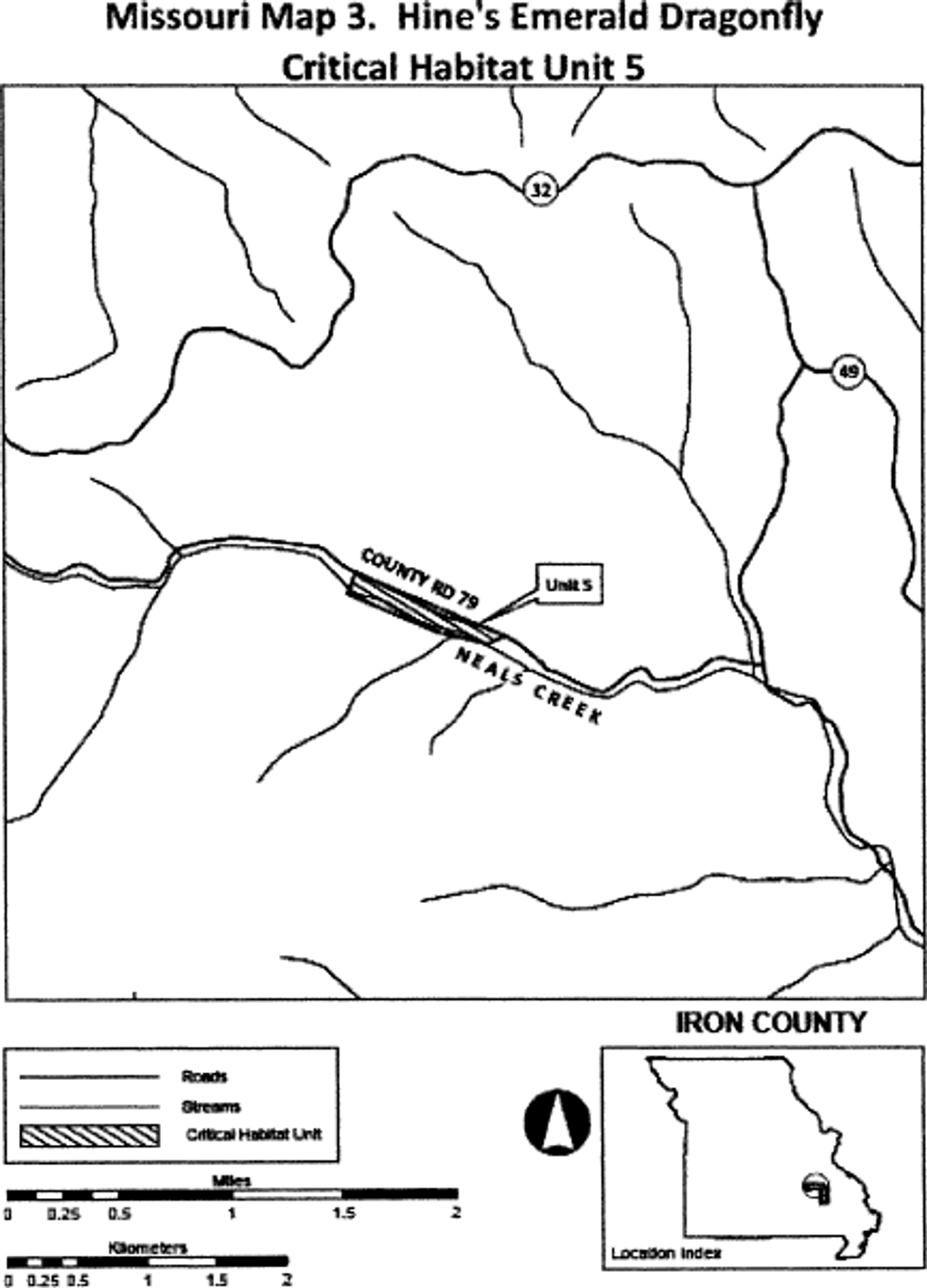
(15) Missouri Unit 7, Phelps County, Missouri.
(i) Missouri Unit 7: Phelps County. Located in T36N, R9W, Sec. 9 of the Kaintuck Hollow 7.5' USGS topographic quadrangle. Missouri Unit 7 is associated with Kaintuck Hollow and a tributary of Mill Creek, and is located approximately 4 miles south southwest of the town of Newburg.
(ii) Note: Map of Missouri Unit 7 (Missouri Map 4) follows:
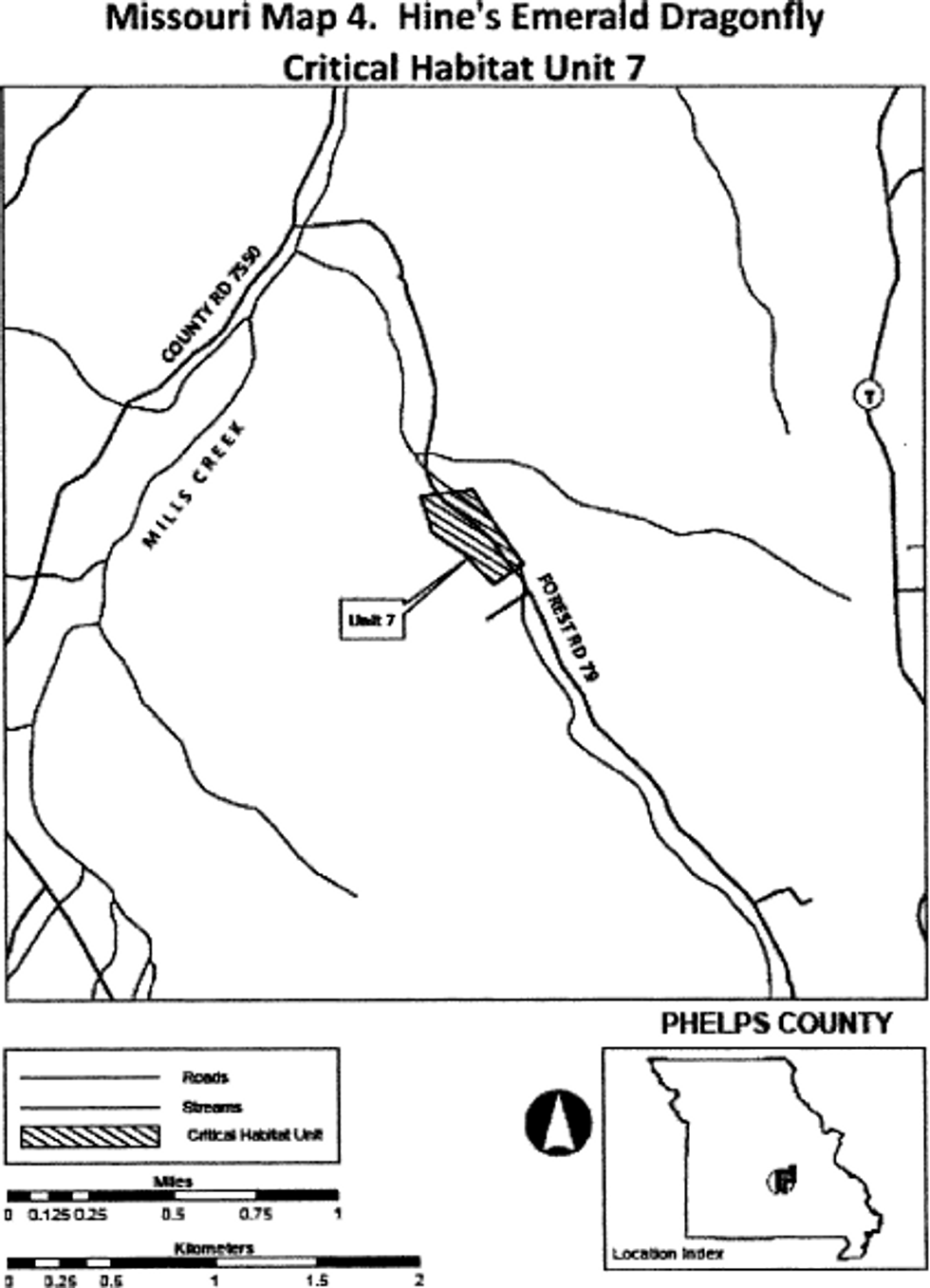
(16) Missouri Units 8and 11a, Reynolds County, Missouri.
(i) Missouri Unit 8: Reynolds County. Located in T32N, R2W, Sec. 22, southeast 1/4, southwest 1/4 of the Bunker 7.5' USGS topographic quadrangle. Missouri Unit 8 is adjacent to Bee Fork Creek and is located approximately 3 miles east of Bunker.
(ii) Missouri Unit 11a: Reynolds County. Located in T32N, R1W, Sec. 30 of the Corridon 7.5' USGS topographic quadrangle. Missouri Unit 11 is located approximately 1 mile east of the intersection of Route TT and Highway 72, extending north to the Bee Fork Church on County Road 854.
(iii) Note: Map of Missouri Units 8 and 11a (Missouri Map 5) follows:
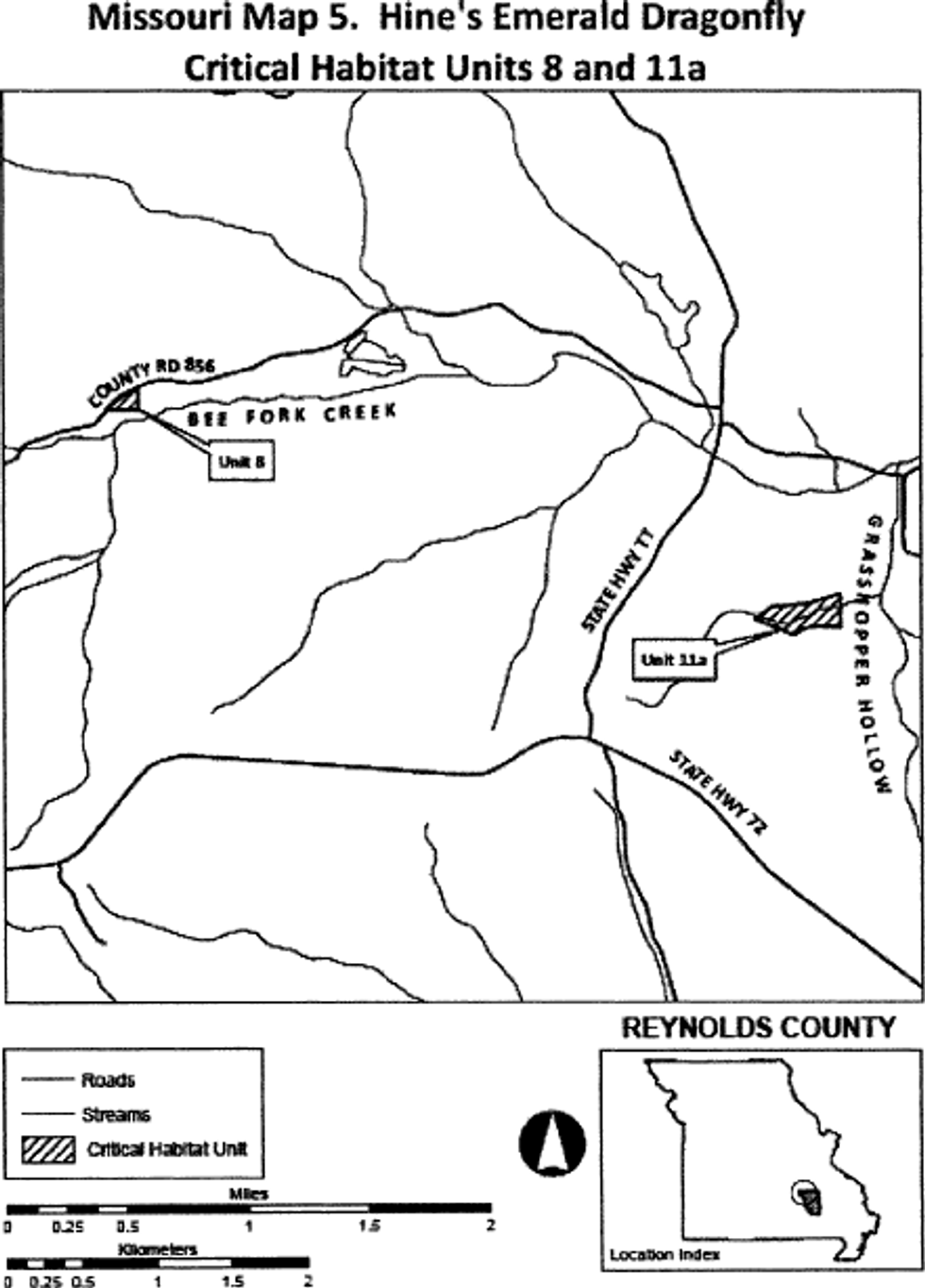
(17) Missouri Unit 21, Ripley County, Missouri.
(i) Missouri Unit 21: Ripley County. Located in T23N, R1W, Sec. 23 of the Bardley 7.5' USGS topographic quadrangle. Missouri Unit 21 is associated with an unnamed tributary of Fourche Creek and is located approximately 12 miles west of Doniphan.
(ii) Note: Map of Missouri Unit 21 (Missouri Map 6) follows:
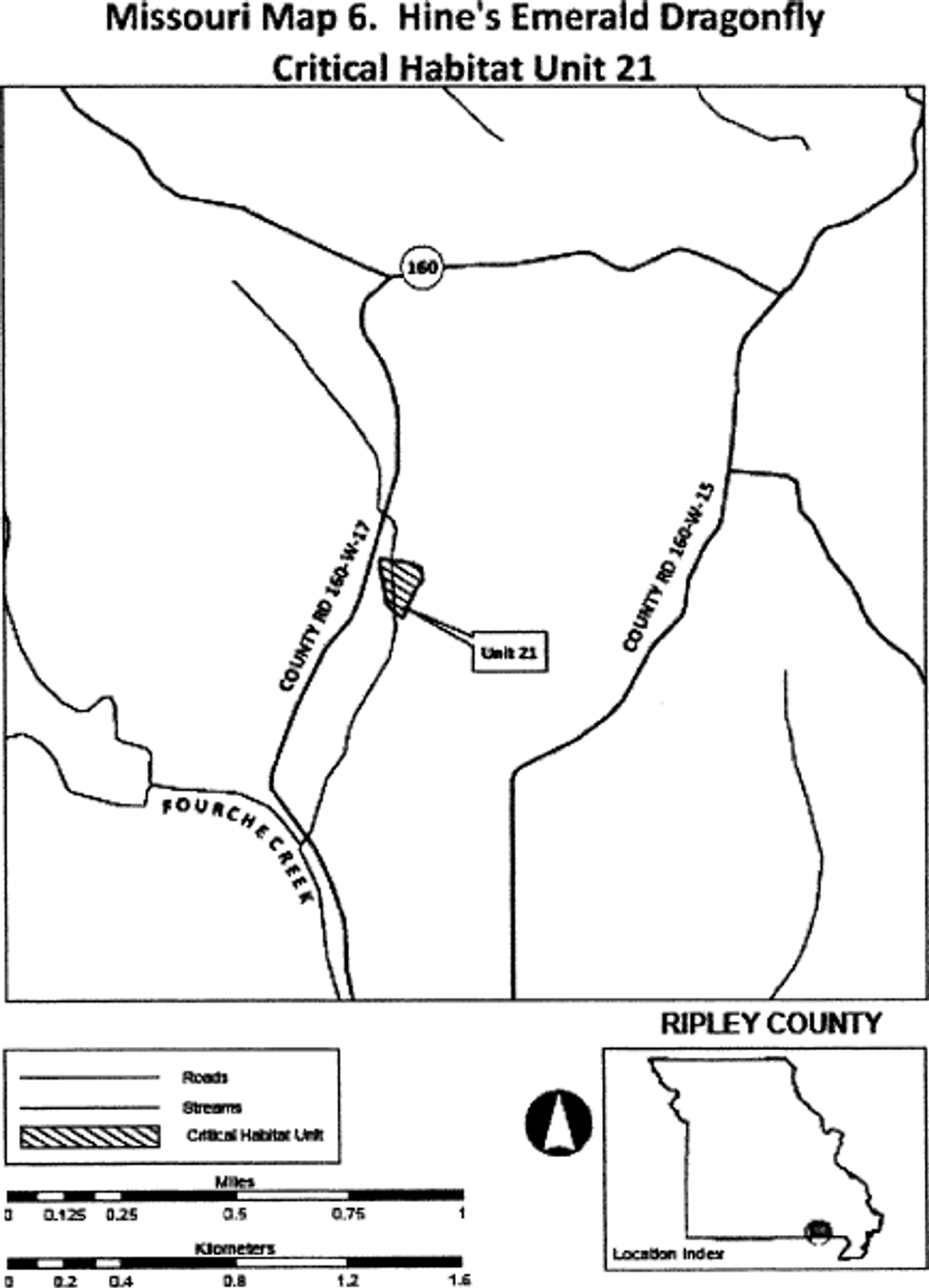
(18) Missouri Units 23 through 25, Washington County, Missouri.
(i) Missouri Units 23 and 24: Washington County. Located in T36N, R1W, Sec. 13 of the Palmer 7.5' USGS topographic quadrangle. Missouri Units 23 and 24 comprise the Towns Branch and Welker Fen complex and are located near the town of Palmer.
(ii) Missouri Unit 25: Washington County. Located in T36N, R1W, Secs. 2 and 11 of the Courtois 7.5' USGS topographic quadrangle. Missouri Unit 25 is associated with a tributary of Hazel Creek and is located approximately 1.5 miles northwest of the town of Palmer.
(iii) Note: Map of Missouri Units 23 through 25 (Missouri Map 7) follows:
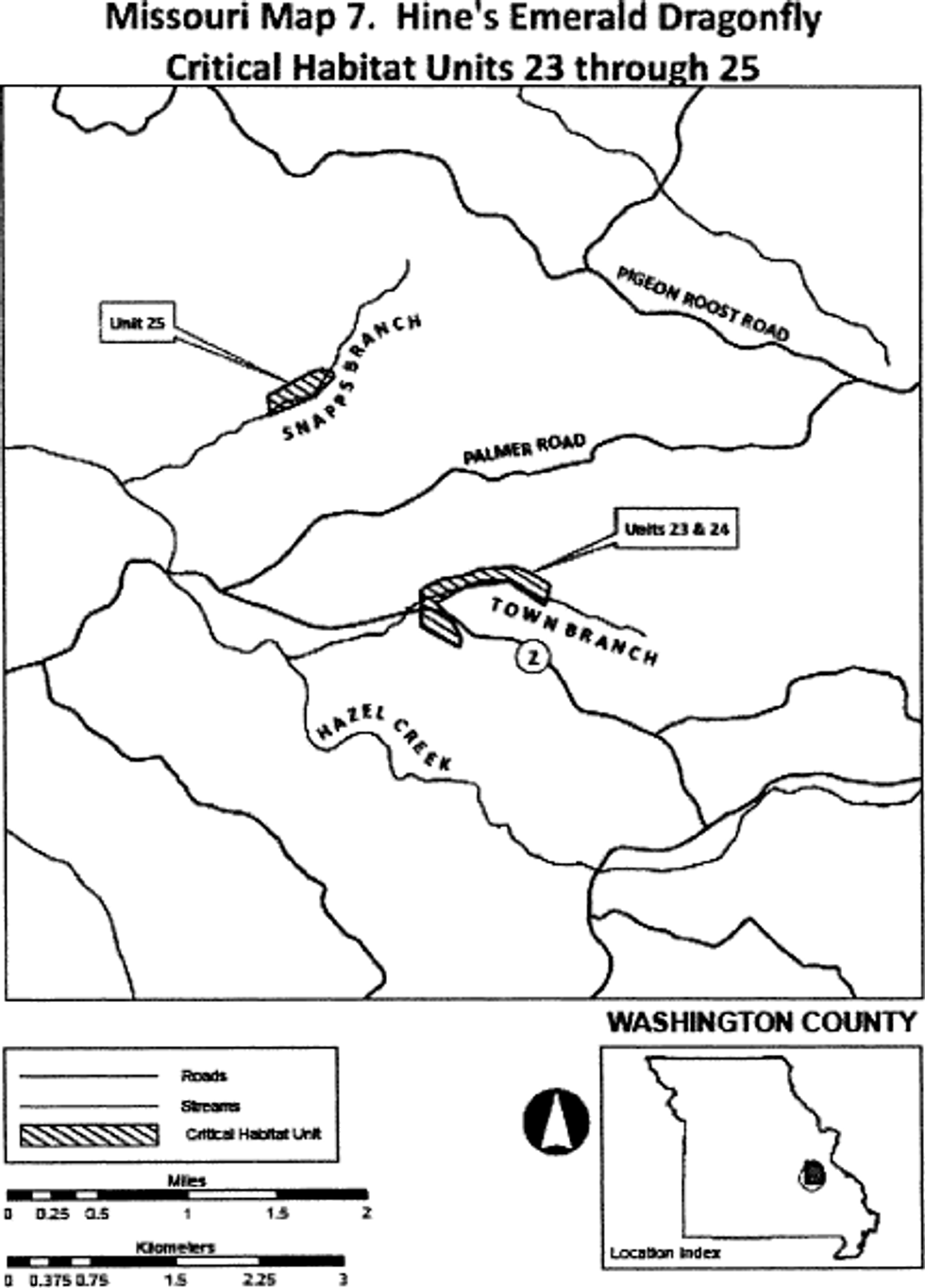
(19) Missouri Unit 26, Wayne County, Missouri
(i) Missouri Unit 26: Wayne County. Located in T27N, R4E, Sec. 33 of the Ellsinore 7.5' USGS topographic quadrangle. Missouri Unit 26 is located near Williamsville and is associated with Brushy Creek.
(ii) Note: Map of Missouri Unit 26 (Missouri Map 8) follows:
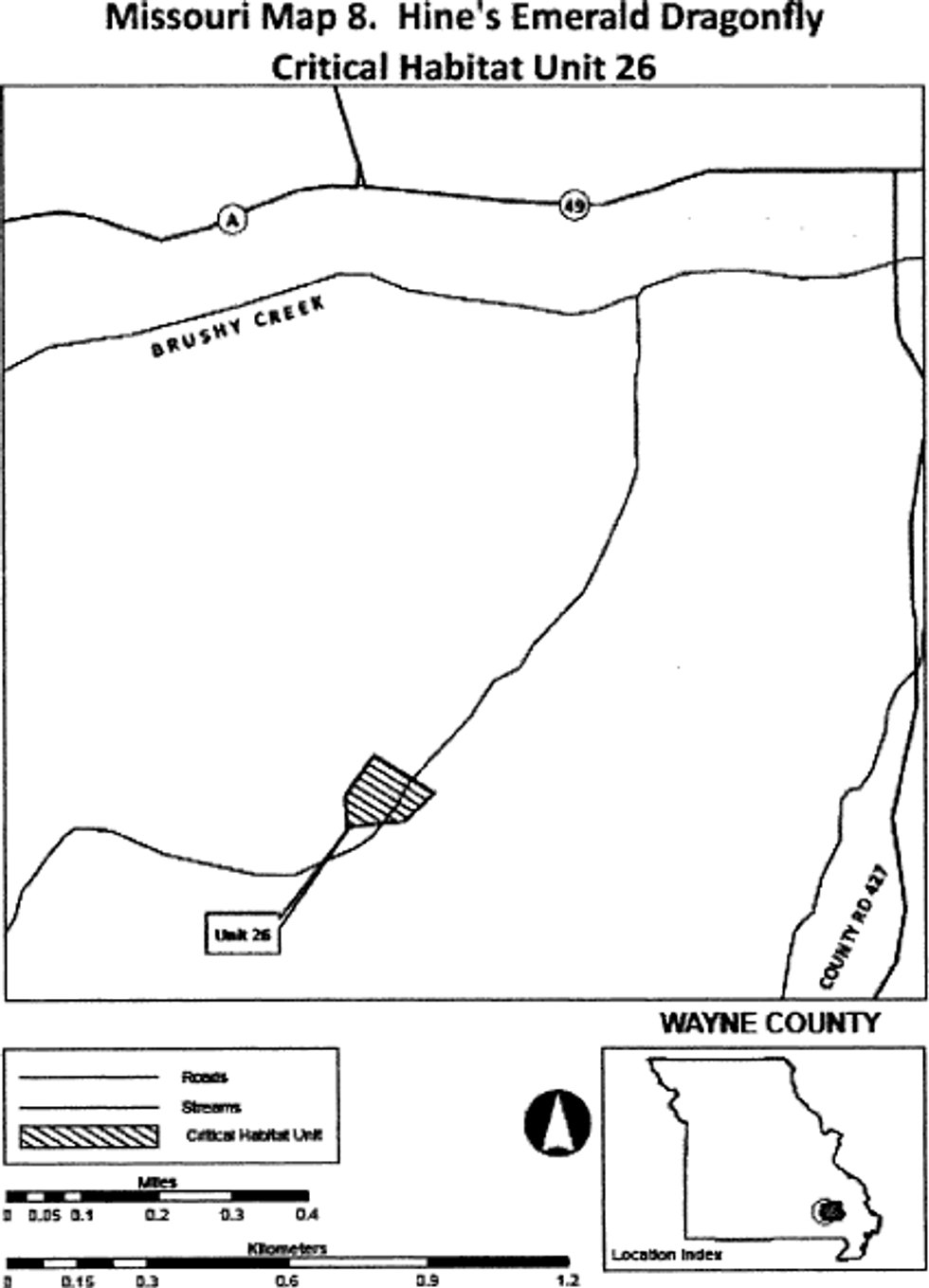
(20) Missouri Unit 27, Crawford County, Missouri.
(i) Missouri Unit 27: Crawford County. Located on the Courtois quadrangle in Township 36 north, Range 2 west, section 14, northeast 1/4, southwest 1/4, northwest 1/4.
(ii) Note: Map of Missouri Unit 27 (Missouri Map 9) follows:
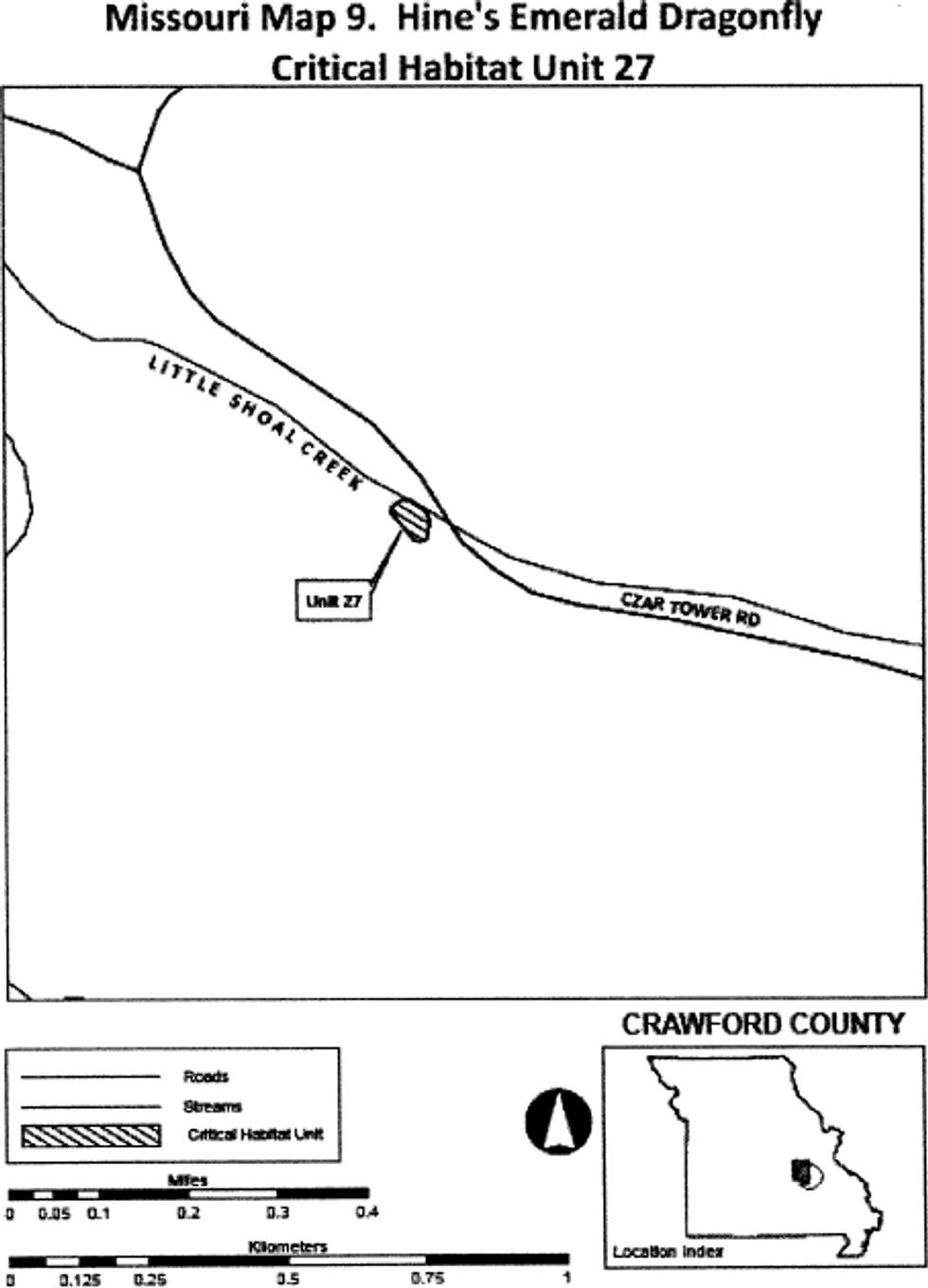
(21) Wisconsin Unit 1, Door County, Wisconsin.
(i) Wisconsin Unit 1: Washington Island, Door County. Located in T33N, R30E, W1/2 and NE1/4 Sec. 4, SE1/4 Sec. 5 of Washington Island SE and Washington Island NE 7.5' USGS topographic quadrangles. Lands included are located adjacent to and west of Wickman Road, south of Town Line Road, East of Deer Lane and East Side Roads, north of Lake View Road and include Big Marsh and Little Marsh.
(ii) Note: Map of Wisconsin Unit 1 (Wisconsin Map 1) follows
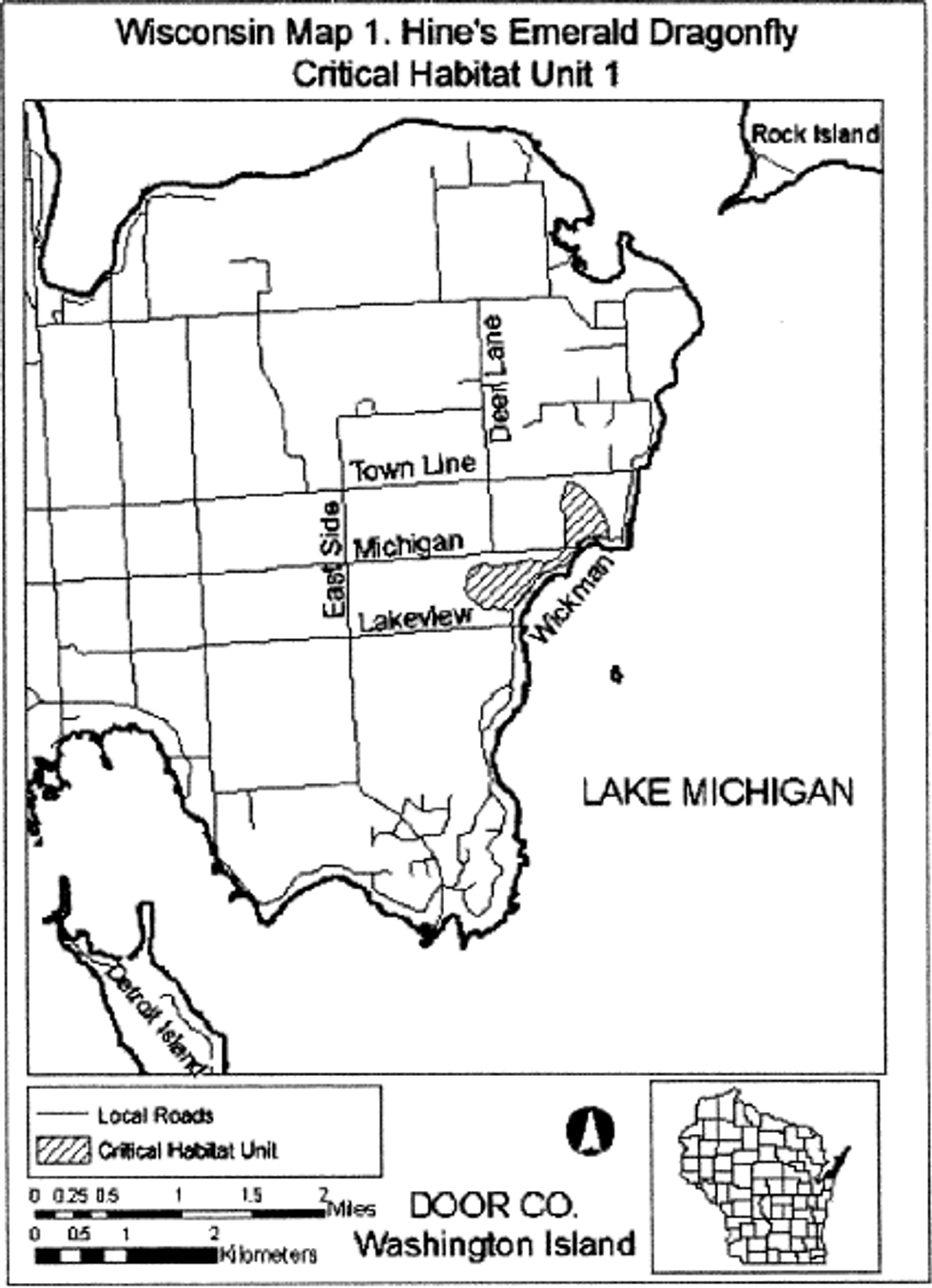
(22) Wisconsin Unit 2, Door County, Wisconsin.
(i) Wisconsin Unit 2: Door County. Located in T32N, R28E, SE 1/4 Sec. 11, NW 1/4 Sec. 13, NE1/4 Sec. 14 of the Ellison Bay 7.5' USGS topographic quadrangle, and in T32N, R28E, W1/2 Sec. 13, E 1/2 Sec. 14, NE1/4 Sec. 23, portions of each 1/4 of Sec. 24, N1/2 Sec. 25, and T32N, R29E, S1/2 Sec. 19, W1/2 Sec. 29, NE1/4 Sec. 30 of Sister Bay 7.5' USGS topographic quadrangle. Lands included are located east of the Village of Ellison Bay, south of Garrett Bay Road and Mink River Roads, North of County Road ZZ, west of Badger Road, County Road NP and Juice Mill Road, and includes the Mink River.
(ii) Note: Map of Wisconsin Unit 2 (Wisconsin Map 2) follows:
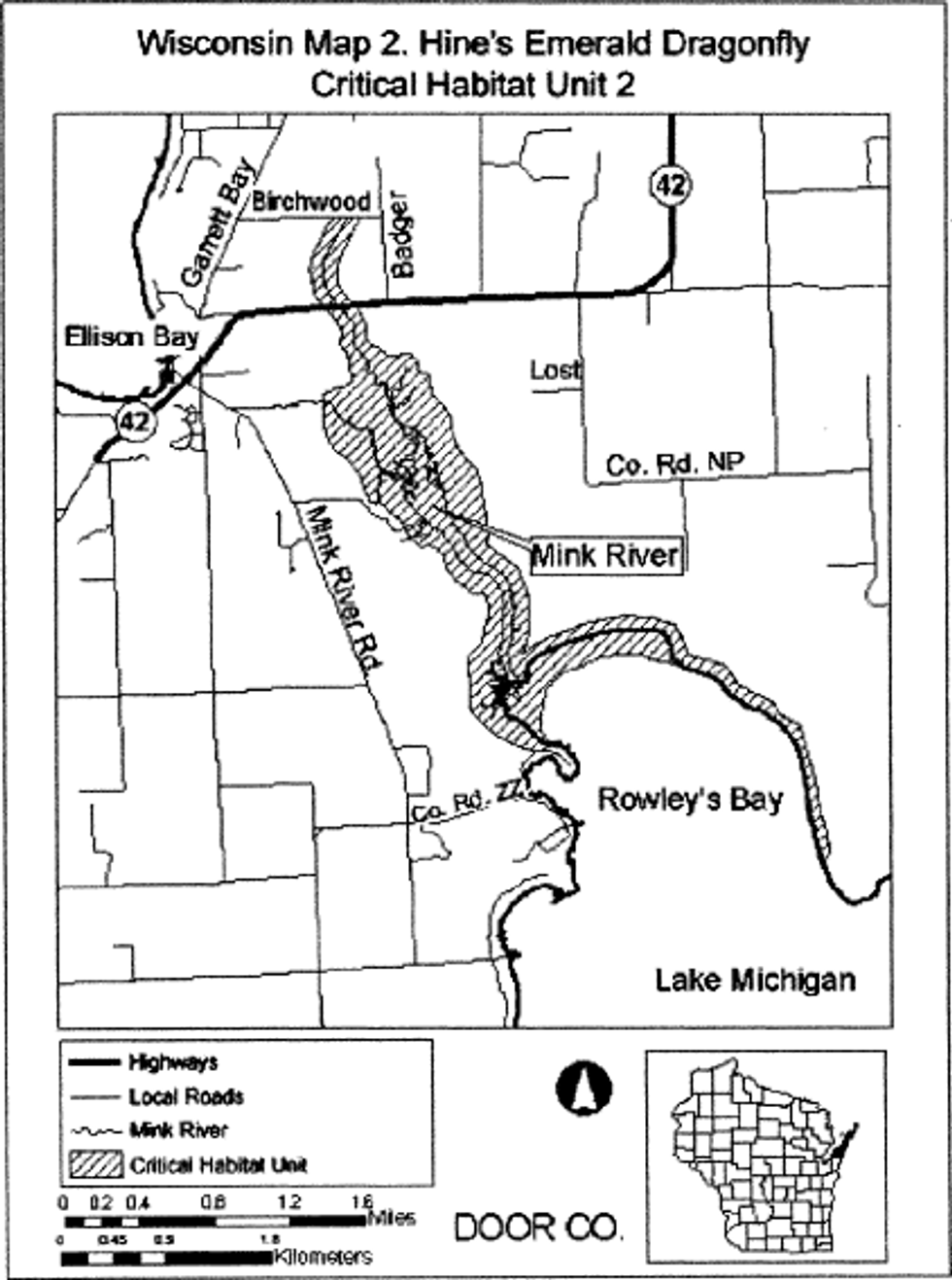
(23) Wisconsin Units 3 through 7, Door County, Wisconsin.
(i) Wisconsin Unit 3: Door County. Located in T31N R28E, S 1/2 S10, NE 1/4 S15 of Sister Bay 7.5' USGS topographic quadrangle. Lands included are located south of County Road ZZ, north of North Bay (Lake Michigan), west of North Bay Road, east of Old Stage Road and about two miles east of the Village of Sister Bay and include a portion of Three-Springs Creek.
(ii) Wisconsin Unit 4: Door County. Located in T31N, R28E, SW1/4 and S1/2 Sec. 15, portions of each 1/4 of Sec. 22, and N1/2 of Sec. 23 of the Sister Bay 7.5' USGS topographic quadrangle. Lands are located along the north and northwest sides of North Bay (Lake Michigan).
(iii) Wisconsin Unit 5: Door County. Located in T31N, R28E, S1/2 Sec. 20, E1/2 Sec. 29, NW1/4 and S1/2 Sec. 28, N1/2 and SE1/4 Sec. 33, and W1/2 Sec. 34. It also is located in T30N, R28E, W1/2 Sec. 3, E1/2 and SW1/4 Sec. 4, SE1/4 Sec. 8, Sec. 9, N1/2 Sec. 10, W1/2 and SE 1/4 Sec.15, Sec. 16, and Sec. 17 of the Baileys Harbor East, and Sister Bay 7.5' USGS topographic quadrangles. Lands located south of German Road, east of State Highway 57, west of North Bay Drive, Sunset Drive and Moonlight Bay (Lake Michigan), north of Ridges Road and Point Drive and include Mud Lake and Reiboldt Creek.
(iv) Wisconsin Unit 6: Door County. Located in T30N, R28E, portions of each 1/4 of Sec. 5 of the Baileys Harbor East 7.5' USGS topographic quadrangle and Baileys Harbor West 7.5' USGS topographic quadrangle. Lands are located about 2 1/4 miles north of the Town of Baileys Harbor, east of State Highway 57, south of Meadow Road and are associated with an unnamed stream.
(v) Wisconsin Unit 7: Door County. Located in T30N, R27E, Sec. 11, SW1/4 Sec. 13, and N1/2 and SE 1/4 Sec. 14 of the Baileys Harbor West 7.5' USGS topographic quadrangle. Lands are located north of County Road EE, east of County Road A and west of South Highland and High Plateau Roads, about two miles northeast of Town of Baileys Harbor and are associated with the headwaters of Piel Creek.
(vi) Note: Map of Wisconsin Units 3 through 7 (Wisconsin Map 3) follows:
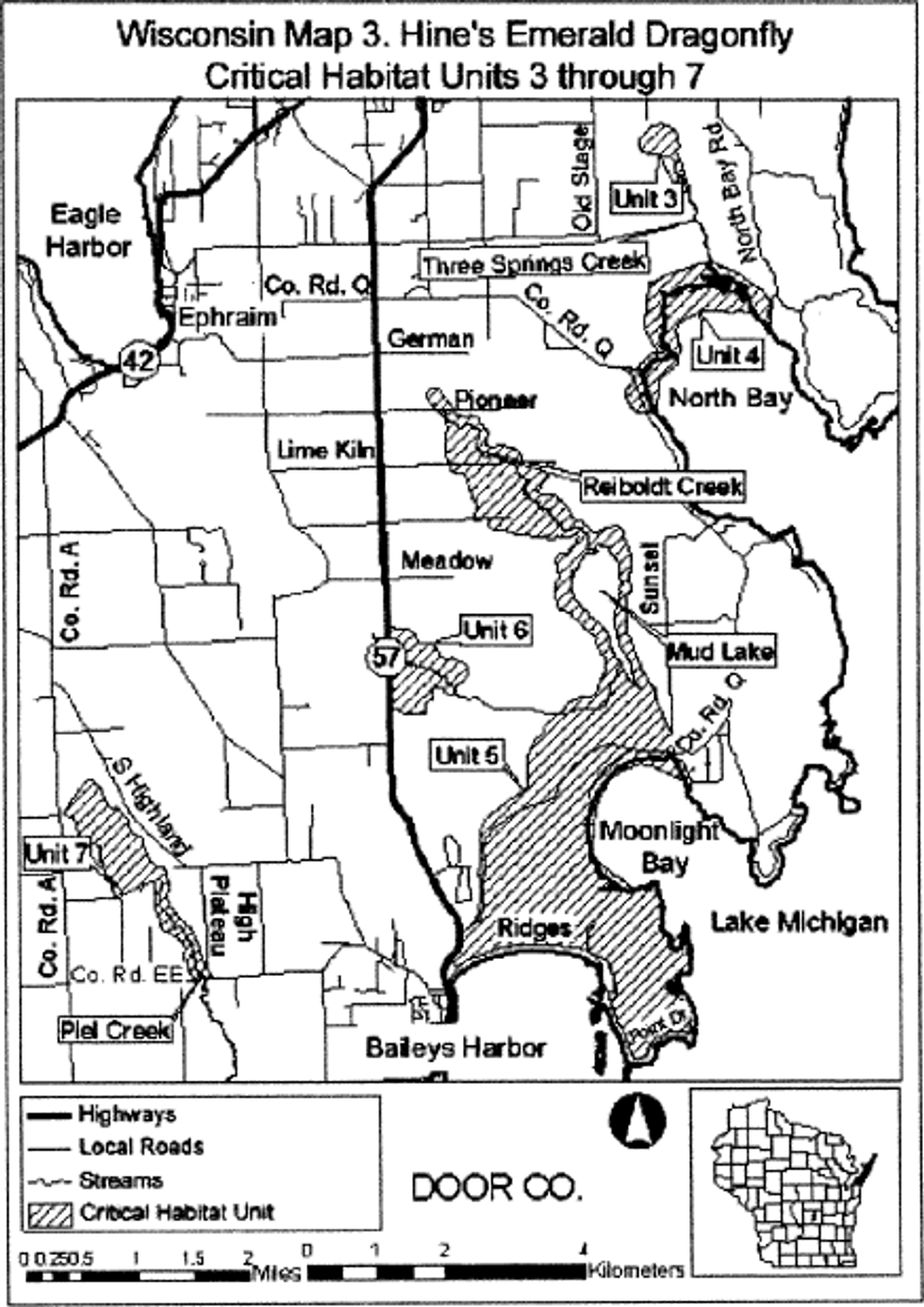
(24) Wisconsin Unit 8, Door County, Wisconsin.
(i) Wisconsin Unit 8: Door County. Located in T28N, R27E, S1/2 Sec. 16, N1/2 Sec. 21 of the Jacksonport 7.5' USGS topographic quadrangle. Lands are located east of Bechtel Road, South of Whitefish Bay Road, west of Glidden Drive and include Arbter Lake.
(ii) Note: Map of Wisconsin Unit 8 (Wisconsin Map 4) follows:
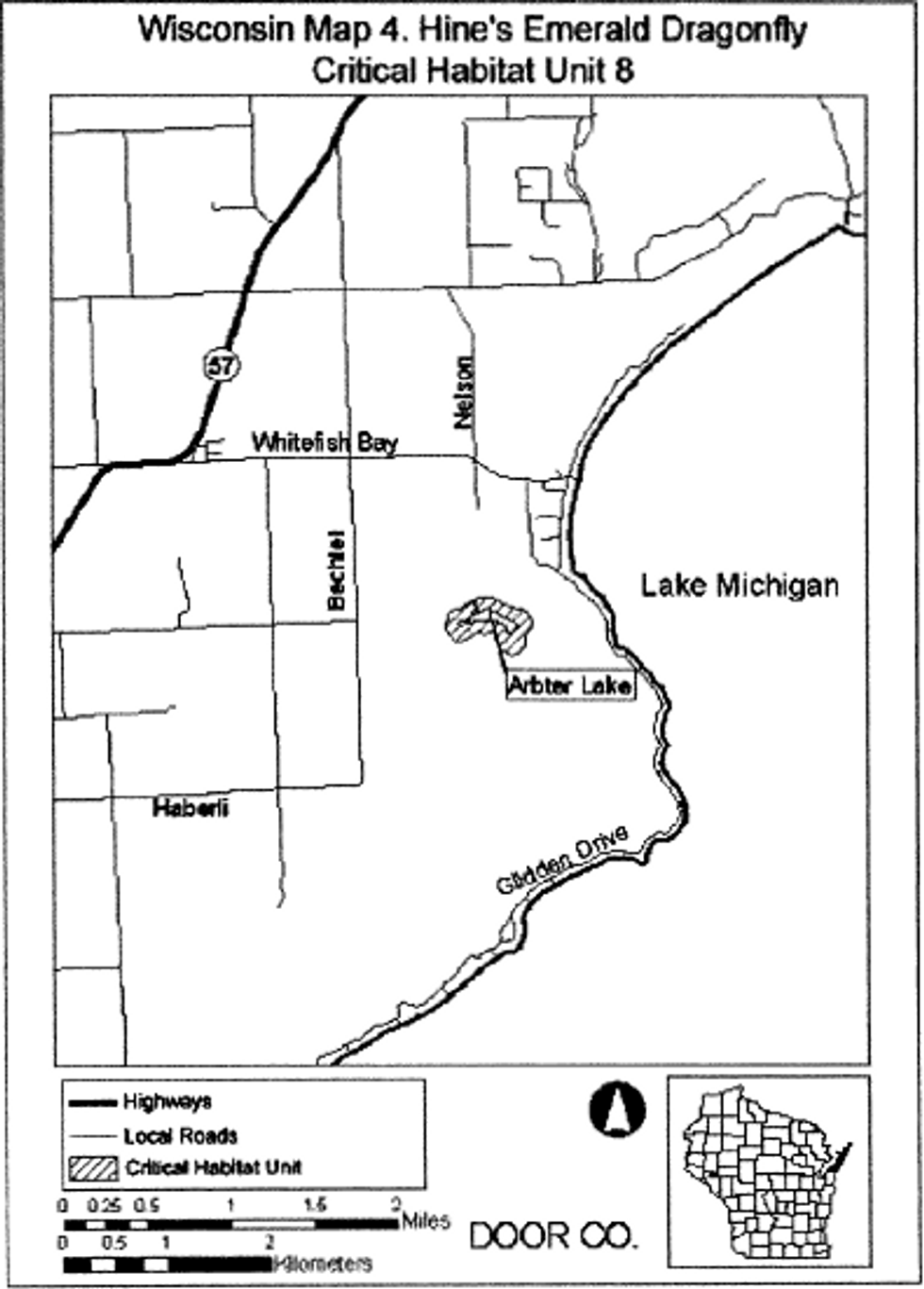
(25) Wisconsin Unit 9, Door County, Wisconsin.
(i) Wisconsin Unit 9: Door County, Wisconsin. Located in T27N, R24E, SE1/4 Sec.16, E1/2 Sec. 20, portions of each 1/4 of Secs. 21, 28 and 33, NW1/4 and S1/2 Sec. 34. Also located in T26N, R24E, NW1/4 Sec. 3 of the Little Sturgeon 7.5' USGS topographic quadrangle. Lands are located west of Pickeral Road and Cedar Lane, north of State Highway 57, east of Hilly Ridge Road and County Road C, south of Fox Lane Road, about 1.5 miles southwest of Little Sturgeon Bay (Lake Michigan) and include portions of Keyes Creek and associated wetlands.
(ii) Note: Map of Wisconsin Unit 9 (Wisconsin Map 5) follows:
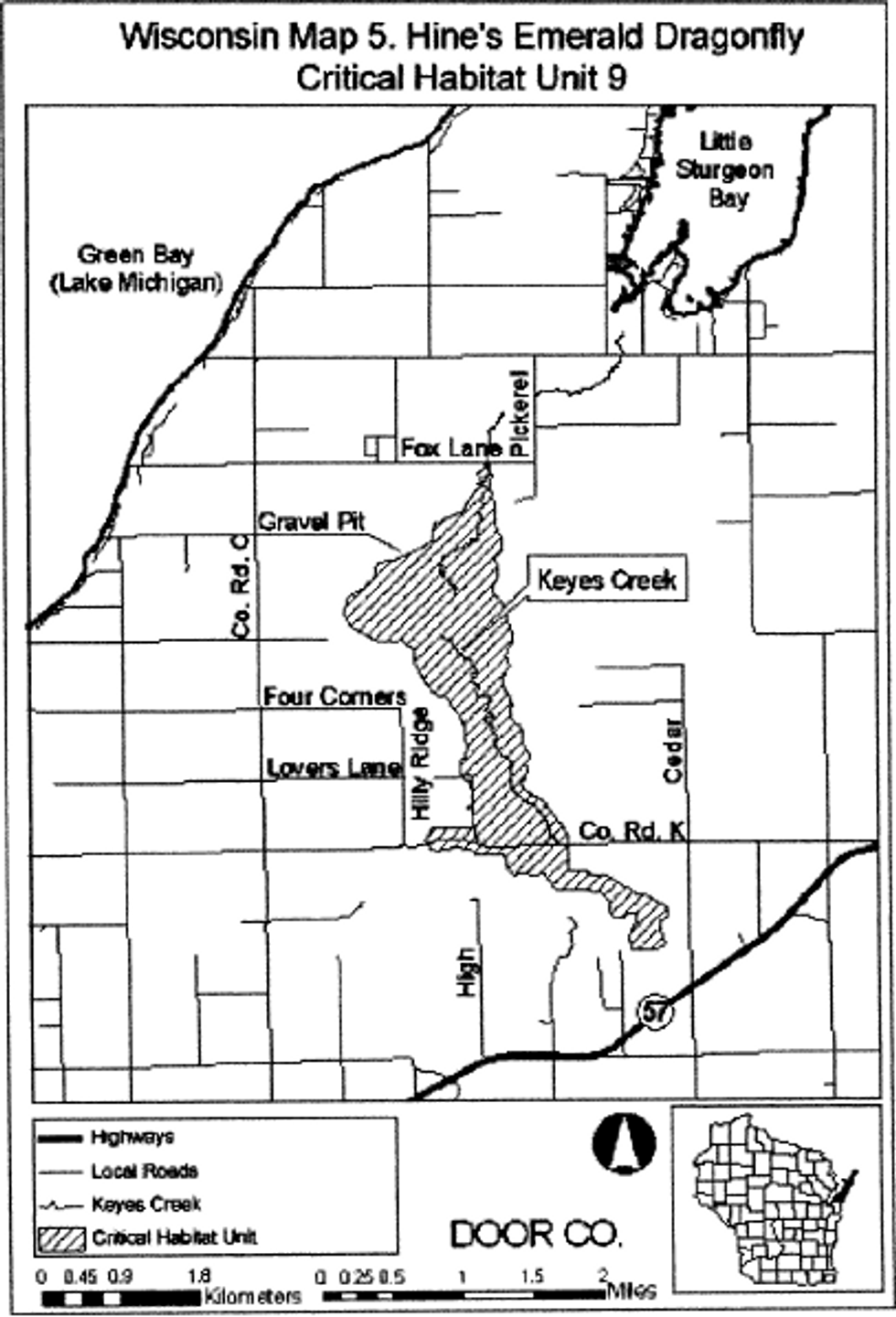
(26) Wisconsin Unit 10, Ozaukee County, Wisconsin.
(i) Wisconsin Unit 10: Ozaukee County. Located in T11N, R21E, E1/2 of Sec. 20, portions of each 1/4 of Sec. 21, W1/2 Sec. 28, Sec. 29, E1/2 Sec. 30, E1/2 and portions of NW1/4 and SW1/4 Sec. 31, Sec. 32, and W1/2 Sec. 33 of the Cedarburg, Five Corners, Newburg, and Port Washington West 7.5' USGS topographic quadrangles. Lands are located south of State Highway 33, east of County Road Y and Birchwood Road, north of Cedar Sauk Road about 2 miles west of Saukville, and includes the majority of Cedarburg Bog.
(ii) Note: Map of Wisconsin Unit 10 (Wisconsin Map 6) follows:
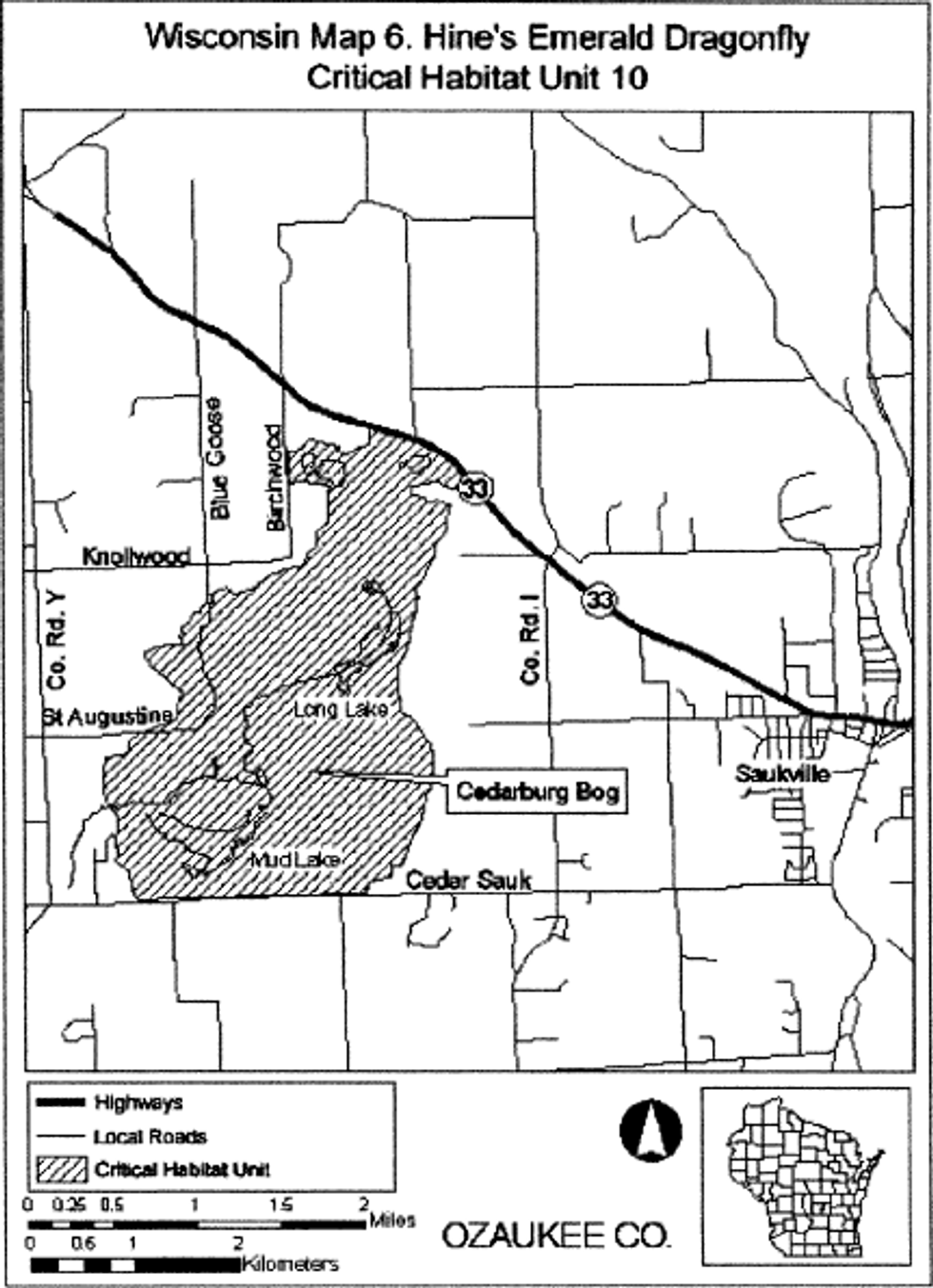
(27) Wisconsin Unit 11, Door County, Wisconsin.
(i) Wisconsin Unit 11: Door County. Located in T27N, R26E, SE 1/4 Sec. 11, Sec. 12, NW 1/4 Sec. 13, and NE 1/4 Sec. 14 of the Sturgeon Bay East 7.5' USGS topographic quadrangle. Lands are located south of County Road TT, east of Mathey Road, north of Buffalo Ridge Trail, west of Lake Forest Park Road (also County Road TT), about 11/2 miles west of the City of Sturgeon Bay, and include portions of Kellner's Fen.
(ii) Note: Map of Wisconsin Unit 11 (Wisconsin Map 7) follows:
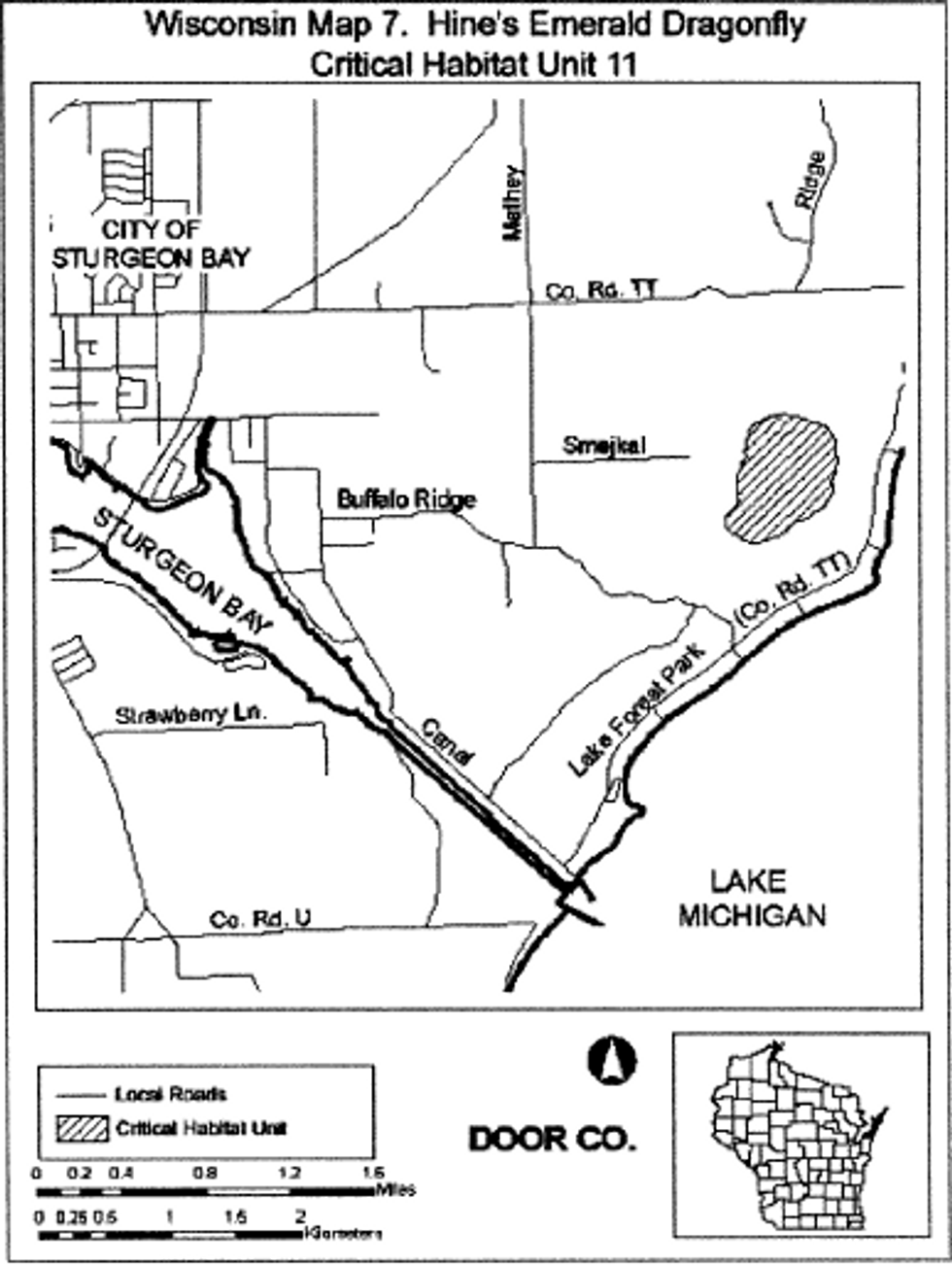
Hawaiian picture-wing fly (Drosophila aglaia)
(1) Critical habitat units are depicted for County of Honolulu, island of Oahu, Hawaii, on the maps below. The maps provided are for informational purposes only.
(2) The primary constituent elements of critical habitat for Drosophila aglaia are:
(i) Dry to mesic, lowland, Diospyros sp., ohia and koa forest between the elevations of 1,865-2,985 ft (568-910 m); and
(ii) The larval host plant Urera glabra, which exhibits one or more life stages (from seedlings to senescent individuals).
(3) Critical habitat does not include manmade structures (such as buildings, aqueducts, airports, and roads) and the land on which they are located existing within the legal boundaries on the effective date of this rule.
(4) Critical habitat map units. Coordinates are in Universal Transverse Mercator (UTM) Zone 4 with units in meters using North American Datum of 1983 (NAD83).
(5) Note: Index map of critical habitat units for Drosophila aglaia follows:
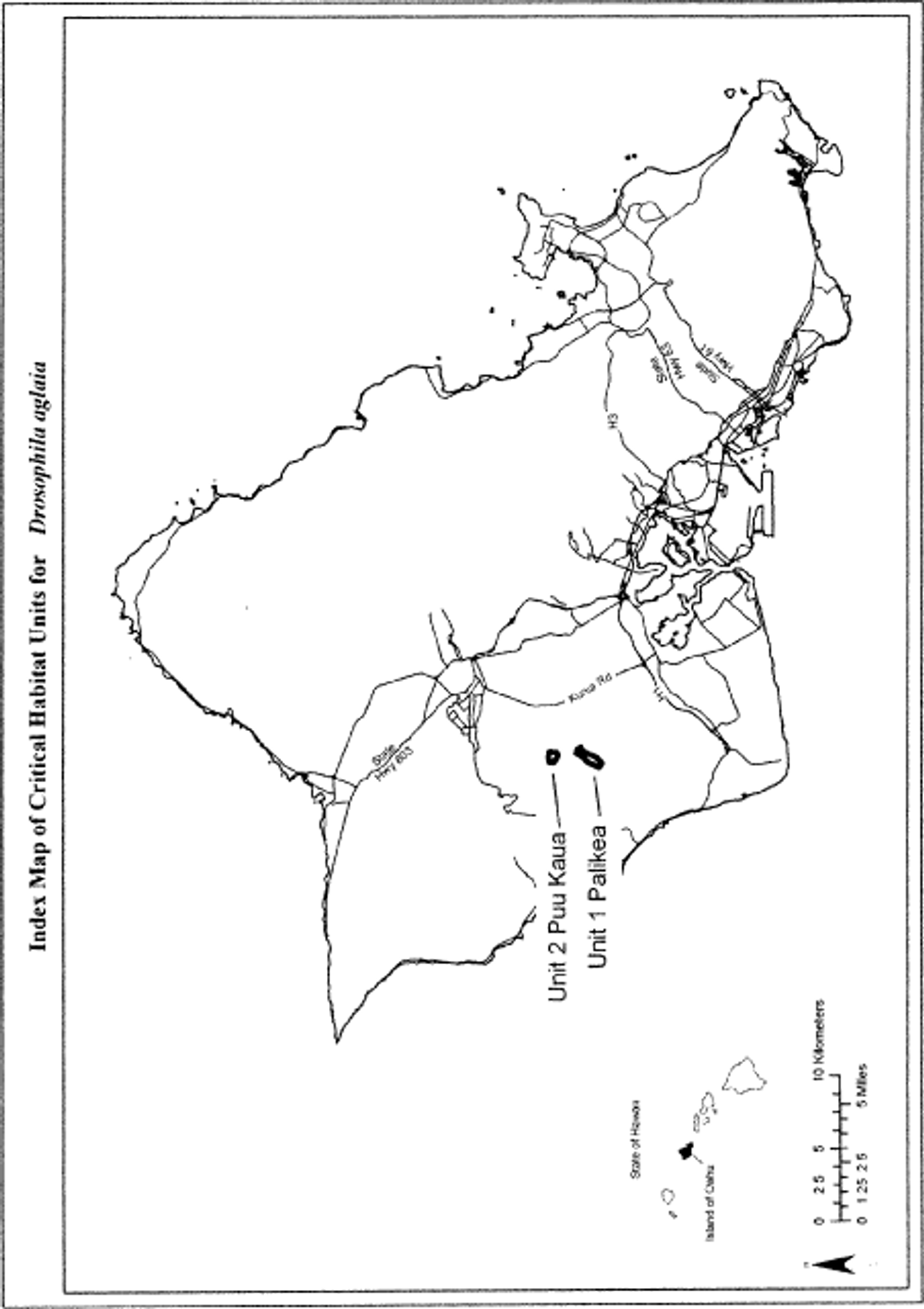
(6) Drosophila aglaia - Unit 1 - Palikea, City and County of Honolulu, island of Oahu, Hawaii.
(i) Land bounded by the following coordinates: 593529, 2367854; 593448, 2367801; 593302, 2367874; 593242, 2367927; 593193, 2367967; 593165, 2368065; 593217, 2368150; 593314, 2368283; 593399, 2368425; 593448, 2368578; 593505, 2368716; 593622, 2368833; 593703, 2368906; 593764, 2368963; 593832, 2369044; 593901, 2369145; 594002, 2369262; 594079, 2369331; 594104, 2369396; 594120, 2369485; 594124, 2369521; 594148, 2369525; 594213, 2369525; 594310, 2369497; 594395, 2369473; 594399, 2369392; 594396, 2369356; 594417, 2369313; 594461, 2369290; 594551, 2369278; 594579, 2369250; 594559, 2369197; 594472, 2369183; 594391, 2369179; 594354, 2369153; 594302, 2369072; 594257, 2369015; 594213, 2368914; 594136, 2368809; 594083, 2368672; 594035, 2368550; 593966, 2368417; 593966, 2368324; 593909, 2368259; 593792, 2368105; 593675, 2368000.
(ii) Note: Map of Drosophila aglaia - Unit 1 - Palikea follows:
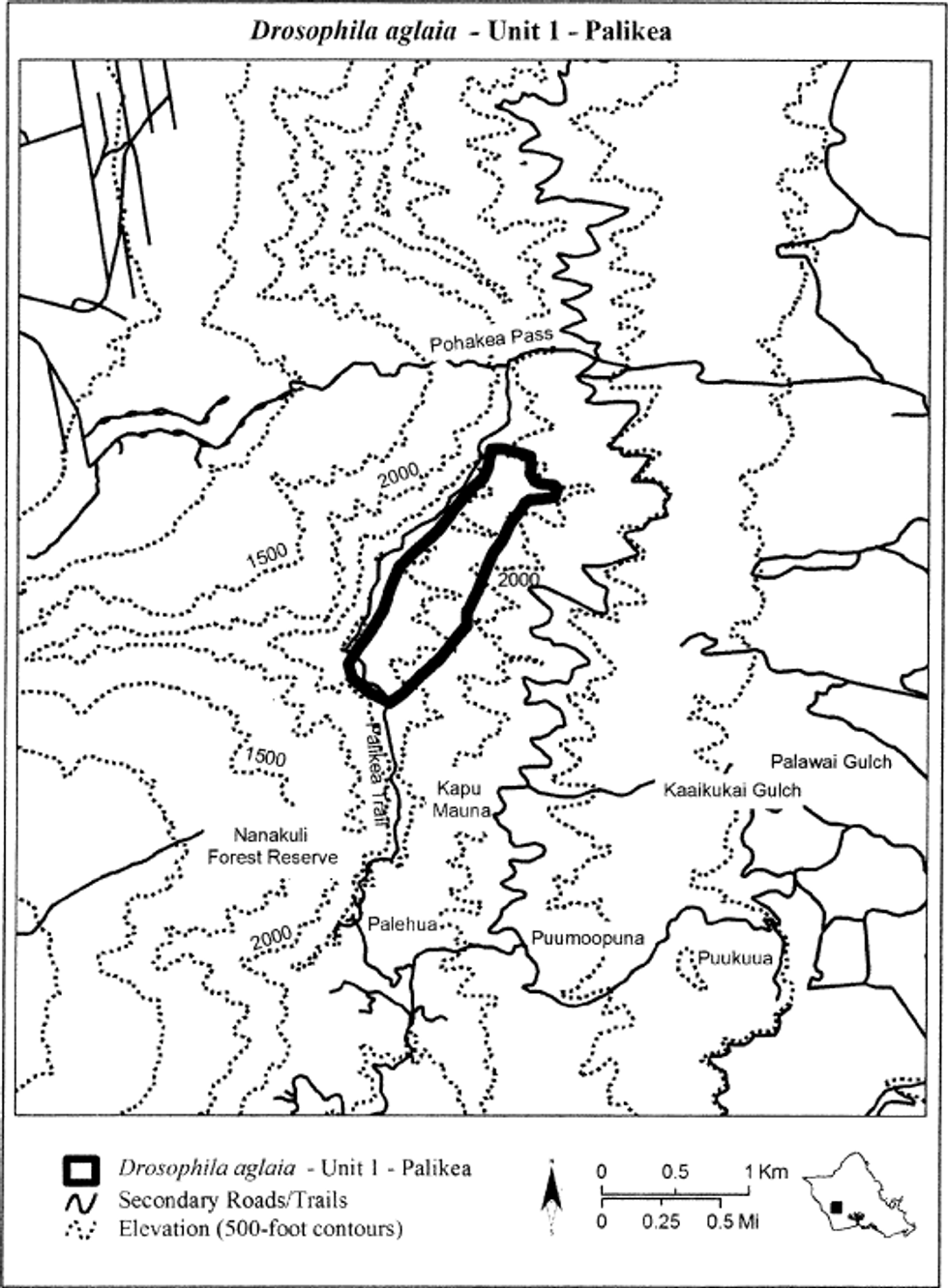
(7) Drosophila aglaia - Unit 2 - Puu Kaua, City and County of Honolulu, island of Oahu, Hawaii.
(i) Land bounded by the following coordinates: 594166, 2370854; 594166, 2370853; 594164, 2370854; 594122, 2370843; 594090, 2370815; 594040, 2370789; 593996, 2370789; 593930, 2370827; 593852, 2370875; 593778, 2370907; 593716, 2370947; 593642, 2370999; 593602, 2371041; 593574, 2371067; 593558, 2371095; 593539, 2371118; 593531, 2371121; 593534, 2371173; 593519, 2371375; 593533, 2371375; 593552, 2371390; 593628, 2371404; 593716, 2371426; 593794, 2371431; 593876, 2371437; 593974, 2371435; 594036, 2371431; 594138, 2371415; 594190, 2371399; 594232, 2371385; 594246, 2371359; 594239, 2371354; 594170, 2370879; 594172, 2370877; 594170, 2370855.
(ii) Note: Map of Drosophila aglaia - Unit 2 - Puu Kaua follows:
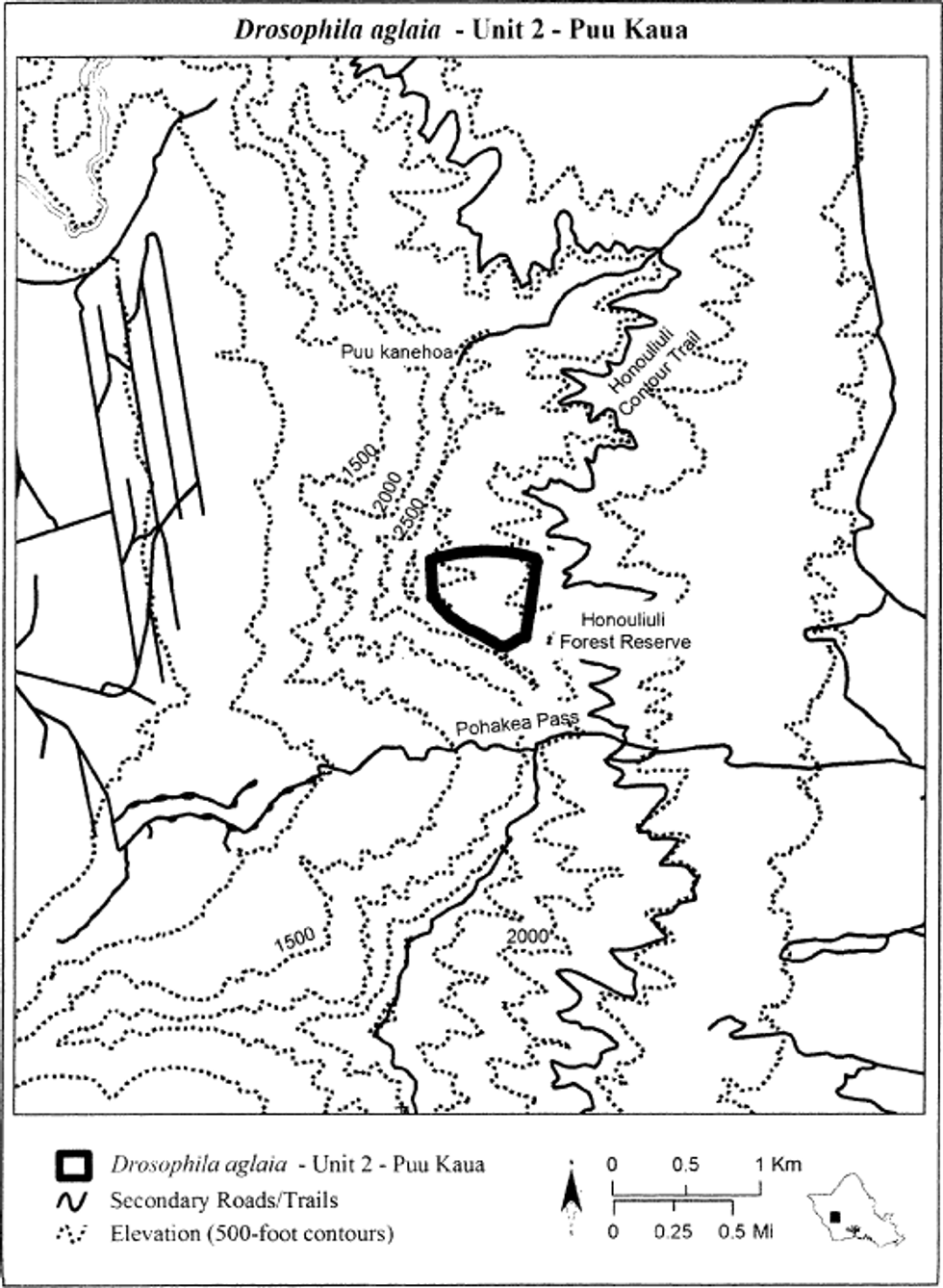
Hawaiian picture-wing fly (Drosophila differens)
(1) Critical habitat is depicted for County of Maui, island of Molokai, Hawaii, on the map below. The map provided is for informational purposes only.
(2) The primary constituent elements of critical habitat for Drosophila differens are:
(i) Wet, montane, ohia forest between the elevations of 3,645-4,495 ft (1,111-1,370 m); and
(ii) The larval host plants Clermontia arborescens ssp. waihiae, C. granidiflora ssp. munroi, C. oblongifolia ssp. brevipes, C. kakeana, and C. pallida, which exhibit one or more life stages (from seedlings to senescent individuals).
(3) Critical habitat does not include manmade structures (such as buildings, aqueducts, airports, and roads) and the land on which they are located existing within the legal boundaries on the effective date of this rule.
(4) Critical habitat map unit. Coordinates are in Universal Transverse Mercator (UTM) Zone 4 with units in meters using North American Datum of 1983 (NAD83).
(5) Drosophila differens - Unit 1 - Puu Kolekole, Maui County, island of Molokai, Hawaii.
(i) Land bounded by the following coordinates: 718527, 2337536; 718533, 2337451; 718538, 2337370; 718543, 2337298; 718547, 2337236; 718551, 2337182; 718555, 2337138; 718560, 2337098; 718571, 2337055; 718586, 2337010; 718607, 2336962; 718632, 2336912; 718662, 2336860; 718698, 2336807; 718739, 2336754; 718784, 2336700; 718835, 2336646; 718892, 2336593; 718958, 2336551; 719034, 2336520; 719119, 2336502; 719215, 2336497; 719320, 2336503; 719420, 2336509; 719506, 2336508; 719579, 2336500; 719639, 2336484; 719685, 2336462; 719675, 2336394; 719613, 2336327; 718980, 2335781; 718332, 2335236; 718002, 2334953; 717930, 2334932; 717877, 2334988; 717855, 2335060; 717846, 2335123; 717848, 2335175; 717862, 2335217; 717888, 2335249; 717921, 2335272; 717946, 2335291; 717961, 2335308; 717965, 2335322; 717958, 2335333; 717942, 2335342; 717928, 2335356; 717919, 2335377; 717915, 2335404; 717916, 2335438; 717923, 2335478; 717935, 2335515; 717952, 2335542; 717974, 2335558; 718001, 2335564; 718034, 2335559; 718070, 2335550; 718107, 2335553; 718144, 2335567; 718182, 2335593; 718221, 2335630; 718257, 2335675; 718280, 2335710; 718286, 2335733; 718277, 2335745; 718253, 2335744; 718213, 2335731; 718166, 2335721; 718115, 2335717; 718060, 2335719; 718001, 2335728; 717937, 2335742; 717873, 2335764; 717812, 2335793; 717753, 2335829; 717697, 2335873; 717643, 2335924; 717591, 2335977; 717543, 2336020; 717499, 2336052; 717458, 2336073; 717420, 2336083; 717385, 2336085; 717351, 2336089; 717319, 2336098; 717288, 2336110; 717258, 2336127; 717230, 2336148; 717204, 2336180; 717183, 2336223; 717165, 2336280; 717151, 2336348; 717140, 2336429; 717130, 2336510; 717118, 2336579; 717103, 2336636; 717085, 2336680; 717065, 2336713; 717041, 2336739; 717009, 2336769; 716968, 2336806; 716919, 2336847; 716862, 2336894; 716800, 2336946; 716745, 2337000; 716702, 2337055; 716669, 2337112; 716647, 2337171; 716635, 2337231; 716632, 2337289; 716634, 2337341; 716644, 2337388; 716660, 2337430; 716683, 2337468; 716713, 2337497; 716751, 2337516; 716797, 2337523; 716850, 2337520; 716912, 2337507; 716976, 2337488; 717031, 2337481; 717077, 2337486; 717126, 2337542; 717183, 2337585; 718403, 2337817; 718484, 2337833; 718487, 2337824; 718499, 2337760; 718510, 2337691; 718519, 2337616.
(ii) Note: Map of Drosophila differens - Unit 1 - Puu Kolekole follows:
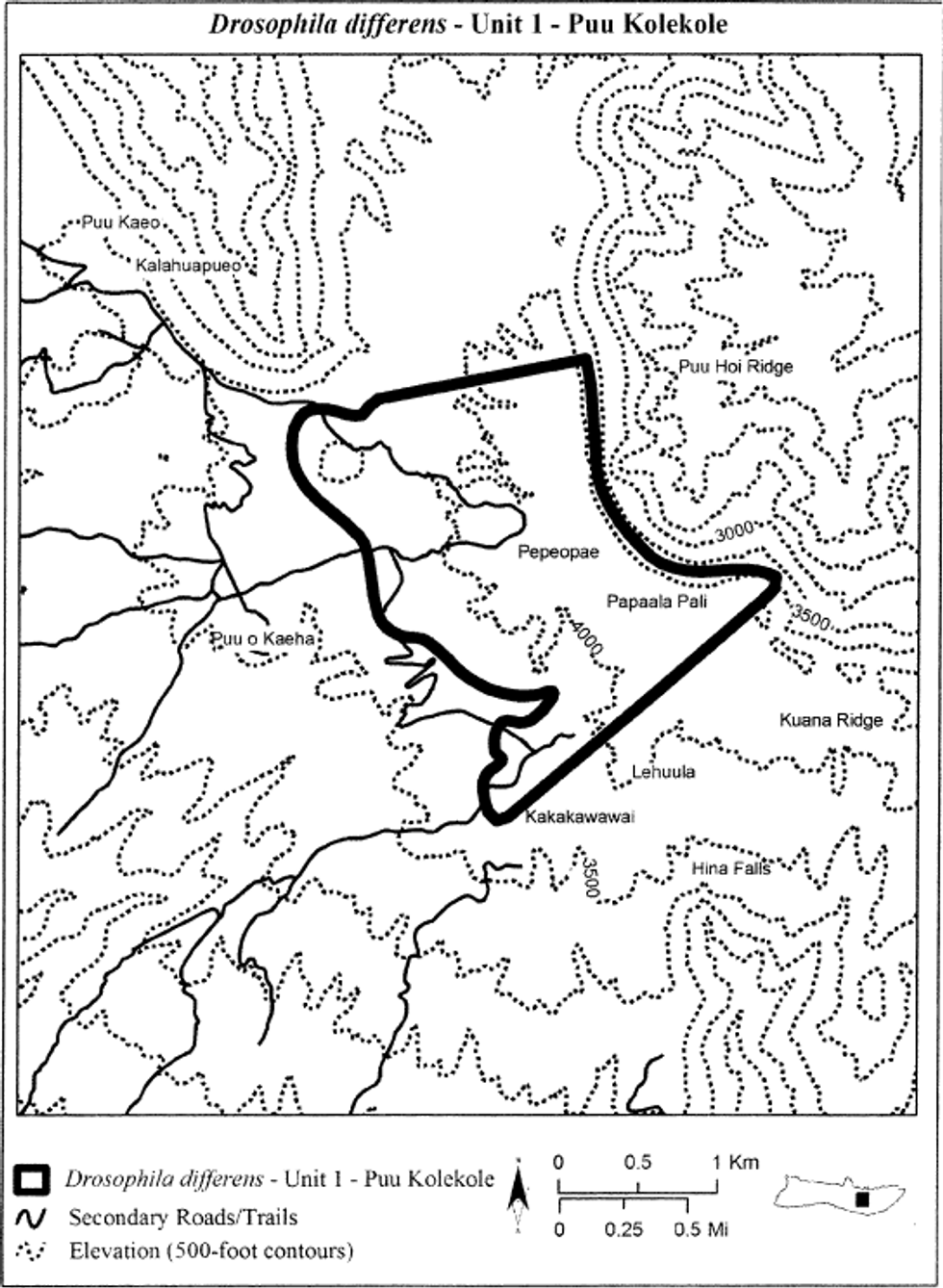
Hawaiian picture-wing fly (Drosophila digressa)
(1) Critical habitat units are depicted for Hawaii County, Hawaii, on the maps in this entry.
(2) Within these areas, the physical or biological features essential to the conservation of Drosophila digressa consist of the following components:
(i) In units 1, 2, 5, 6, 7, 8, and 9, the physical or biological features essential to the conservation of Drosophila digressa are the features of the wet forest ecosystem and consist of:
(A) Elevation of less than 7,218 feet (ft) (2,200 meters (m)).
(B) Annual precipitation that is greater than 98 inches (in) (250 centimeters (cm)).
(C) Substrate of very weathered soils to rocky substrate, basaltic lava, undeveloped soils, or developed soils.
(D) Canopy contains one or more of the following native plant genera: Acacia, Antidesma, Cheirodendron, Ilex, Melicope, Metrosideros, Myrsine, Pittosporum, Psychotria .
(E) Subcanopy contains one or more of the following native plant genera: Cibotium, Clermontia, Coprosma, Cyanea, Freycinetia, Hydrangea, Vaccinium .
(F) Understory contains one or more of the following native plant genera: Adenophorus, Cibotium, Cyrtandra, Dicranopteris, Huperzia, Peperomia, Stenogyne .
(ii) In unit 3, the physical or biological features essential to the conservation of Drosophila digressa are the features of both the wet forest ecosystem and the mesic forest ecosystem and consist of the physical and biological features described in paragraphs (2)(i)(A) through (F) and (2)(iii)(A) through (F) of this entry.
(iii) In unit 4, the physical or biological features essential to the conservation of Drosophila digressa are the features of the mesic forest ecosystem and consist of:
(A) Elevation of less than 6,562 ft (2,000 m).
(B) Annual precipitation of 39 to 150 in (100 to 380 cm).
(C) Substrate of rocky, shallow, organic muck soils; rocky talus soils; shallow soils over weathered rock; deep soils over soft weathered rock; or gravelly alluvium.
(D) Canopy contains one or more of the following native plant genera: Acacia, Antidesma, Charpentiera, Chrysodracon, Metrosideros, Myrsine, Nestegis, Pisonia, Santalum .
(E) Subcanopy contains one or more of the following native plant genera: Coprosma, Freycinetia, Leptecophylla, Myoporum, Pipturus, Rubus, Sadleria, Sophora .
(F) Understory contains one or more of the following native plant genera: Ctenitis, Doodia, Dryopteris, Pelea, Sadleria .
(3) Existing humanmade features and structures, such as buildings, aqueducts, runways, roads, and other paved areas, and the land on which they are located existing within the legal boundaries on April 11, 2024, are not included in the critical habitat designation.
(4) Data layers defining map units were created based on summaries of occurrences and landcover layers including habitat characteristics that indicate the physical or biological features essential to the conservation of Drosophila digressa . Coordinates were created using World Geodetic System 1984 (WGS84). The maps in this entry, as modified by any accompanying regulatory text, establish the boundaries of the critical habitat designation. The coordinates or plot points or both on which each map is based are available to the public at https://www.regulations.gov at Docket No. FWS–R1–ES–2023–0017, and at the field office responsible for this designation. You may obtain field office location information by contacting one of the Service regional offices, the addresses of which are listed at 50 CFR 2.2.
(5) Index map follows:
Figure 1 to Hawaiian picture-wing fly ( Drosophila digressa ) paragraph (5)
Critical Habitat for Drosophila digressa
Hawaii Island, HI
Index Map
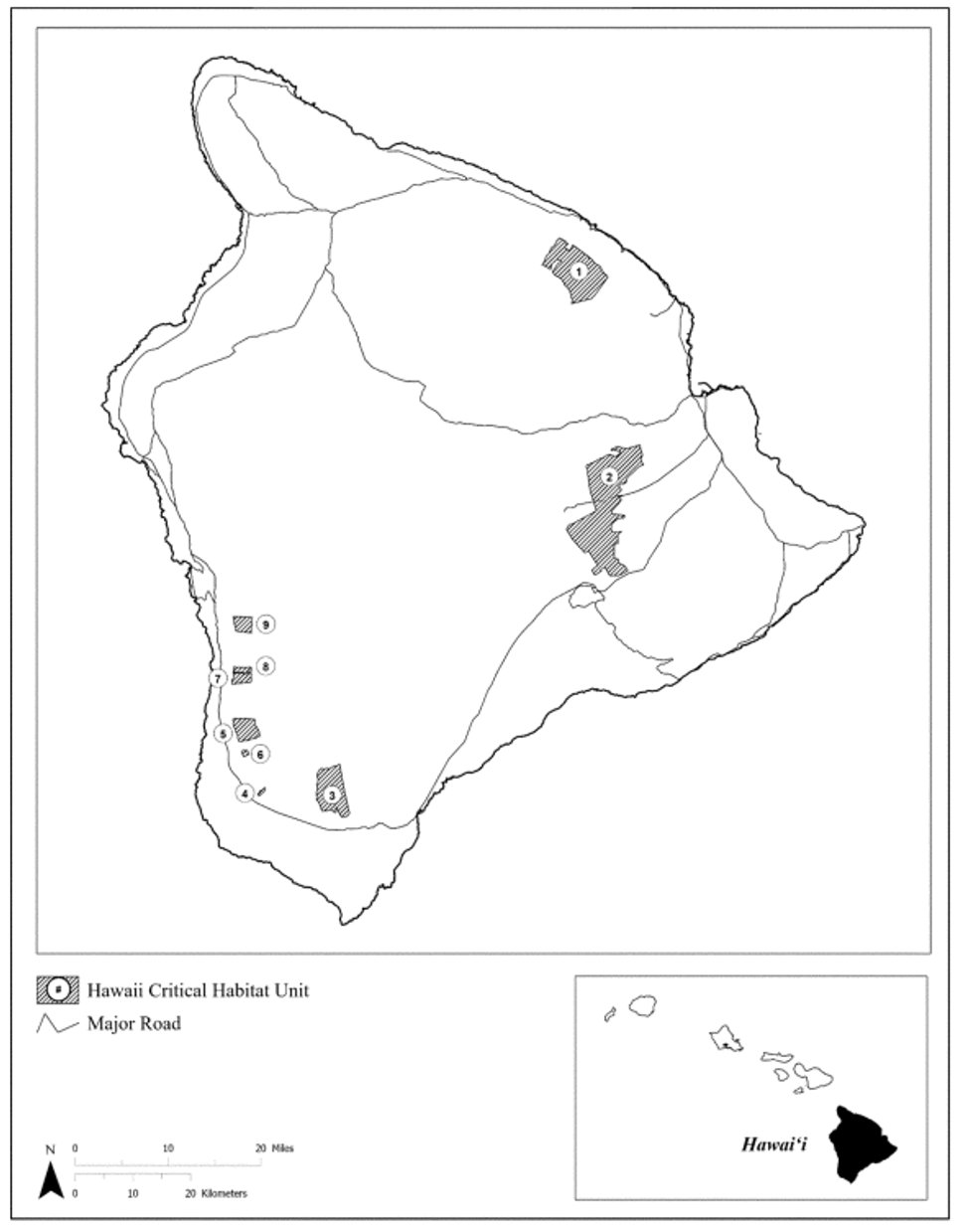
(6) Drosophila digressa —Unit 1; Hawaii County, Hawaii.
(i) Drosophila digressa —Unit 1 consists of 15,714 ac (6,359 ha) of wet forest ecosystem from Ookala to Maulua Nui on the northeastern slope of Maunakea. Lands within this unit include approximately 4,098 ac (1,658 ha) in Federal ownership, 10,644 ac (4,308 ha) in State ownership, and 972 ac (394 ha) in private or other ownership. Federal lands within this unit are within the Hakalau Forest National Wildlife Refuge Hakalau Forest Unit. State lands within this unit are part of the Hilo Forest Reserve Humuula, Laupahoehoe, and Piha Sections; the Laupahoehoe Natural Area Reserve; and the Manowaialee Forest Reserve.
(ii) Map of Drosophila digressa —Unit 1 follows:
Figure 2 to Hawaiian picture-wing fly ( Drosophila digressa ) paragraph (6)(ii)
Critical Habitat for Drosophila digressa
Hawaii Island, HI
Unit 1
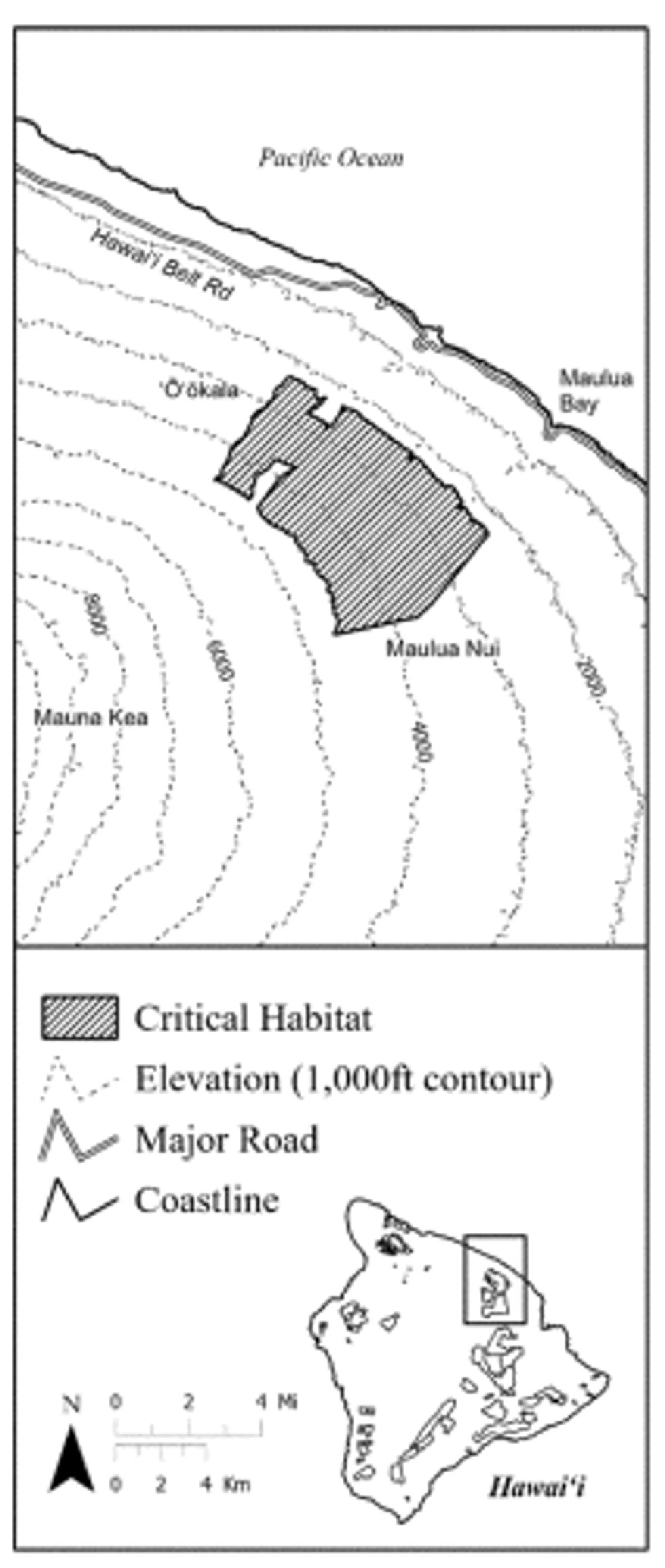
(7) Drosophila digressa —Unit 2; Hawaii County, Hawaii.
(i) Drosophila digressa —Unit 2 consists of 31,998 ac (12,949 ha) of wet forest ecosystem from Olaa to Upper Waiakea on the eastern slope of Mauna Loa and partially on the northern slope of Kilauea Volcano. Lands within this unit include approximately 7,875 ac (3,187 ha) in Federal ownership, 23,897 ac (9,671 ha) in State ownership, and 226 ac (91 ha) in private or other ownership. Federal lands in this unit are within Hawaii Volcanoes National Park. State lands in this unit are part of the Hilo Forest Reserve Kukuau Section, Olaa Forest Reserve Mountain View Section, Upper Waiākea Forest Reserve, Waiākea Forest Reserve, Puu Makaala Natural Area Reserve, and Waiakea 1942 Lava Flow Natural Area Reserve.
(ii) Map of Drosophila digressa —Unit 2 follows:
Figure 3 to Hawaiian picture-wing fly ( Drosophila digressa ) paragraph (7)(ii)
Critical Habitat for Drosophila digressa
Hawaii Island, HI
Unit 2
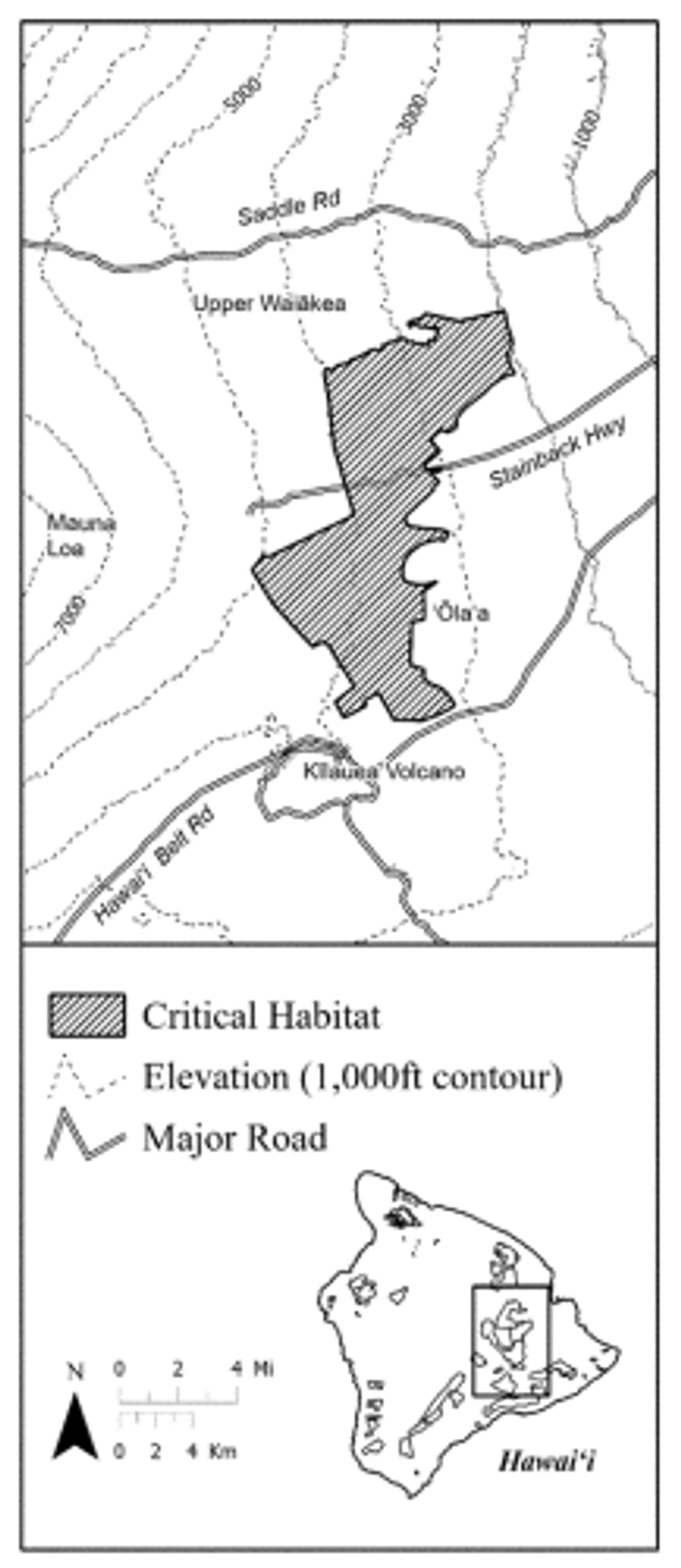
(8) Drosophila digressa —Unit 3; Hawaii County, Hawaii.
(i) Drosophila digressa —Unit 3 consists of 8,781 ac (3,554 ha) of wet and mesic forest ecosystems at Kahuku on the southern slopes of Mauna Loa. Lands within this unit include approximately 8,773 ac (3,550 ha) in Federal ownership and 8 ac (3 ha) in State ownership. Federal lands within this unit are within Hawaii Volcanoes National Park. State-owned lands in this unit are part of the Ka'ū Forest Reserve.
(ii) Map of Drosophila digressa —Unit 3 follows:
Figure 4 to Hawaiian picture-wing fly ( Drosophila digressa ) paragraph (8)(ii)
Critical Habitat for Drosophila digressa
Hawaii Island, HI
Unit 3
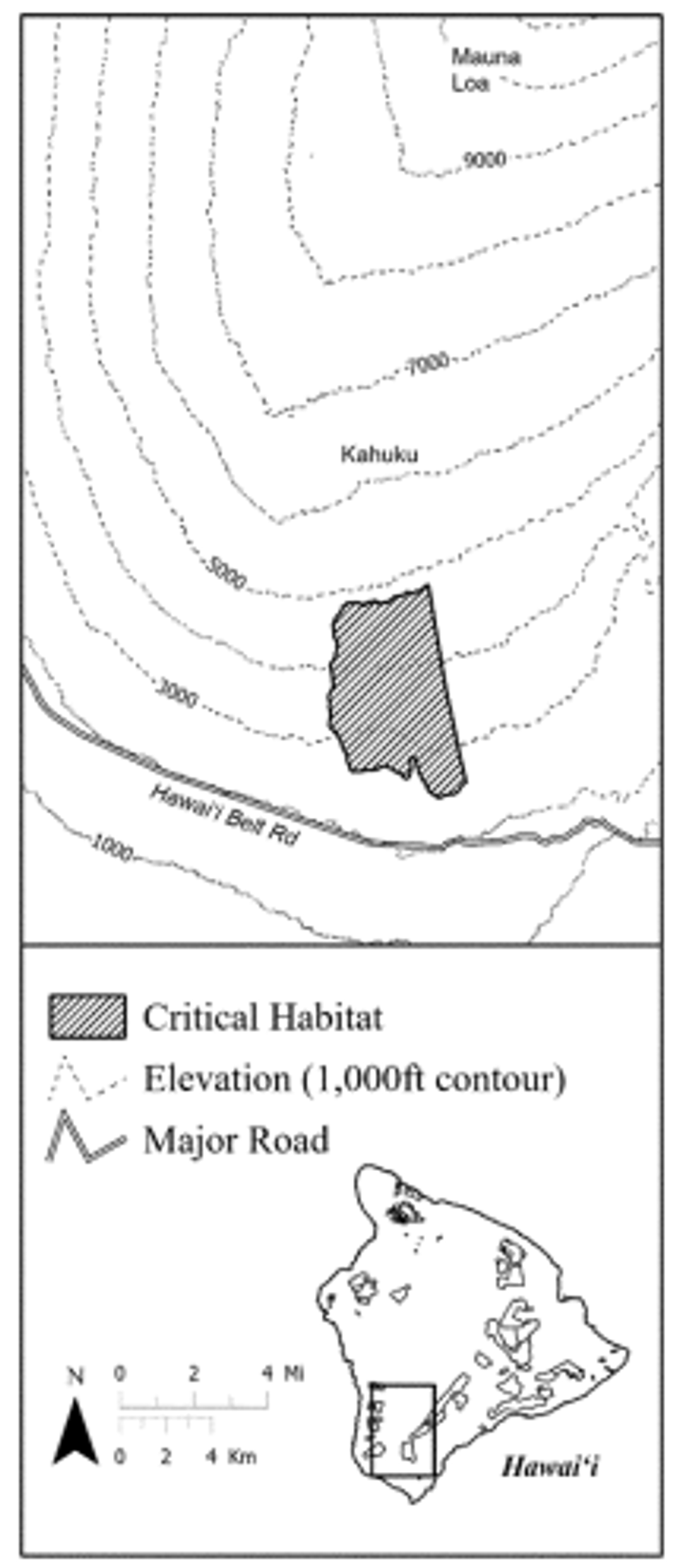
(9) Drosophila digressa —Unit 4; Hawaii County, Hawaii.
(i) Drosophila digressa —Unit 4 consists of 167 ac (67 ha) of mesic forest ecosystem at Manuka on the southern slopes of Mauna Loa. Lands within this unit are entirely in State ownership and are part of the Manuka Natural Area Reserve.
(ii) Map of Drosophila digressa —Unit 4 follows:
Figure 5 to Hawaiian picture-wing fly ( Drosophila digressa ) paragraph (9)(ii)
Critical Habitat for Drosophila digressa
Hawaii Island, HI
Unit 4
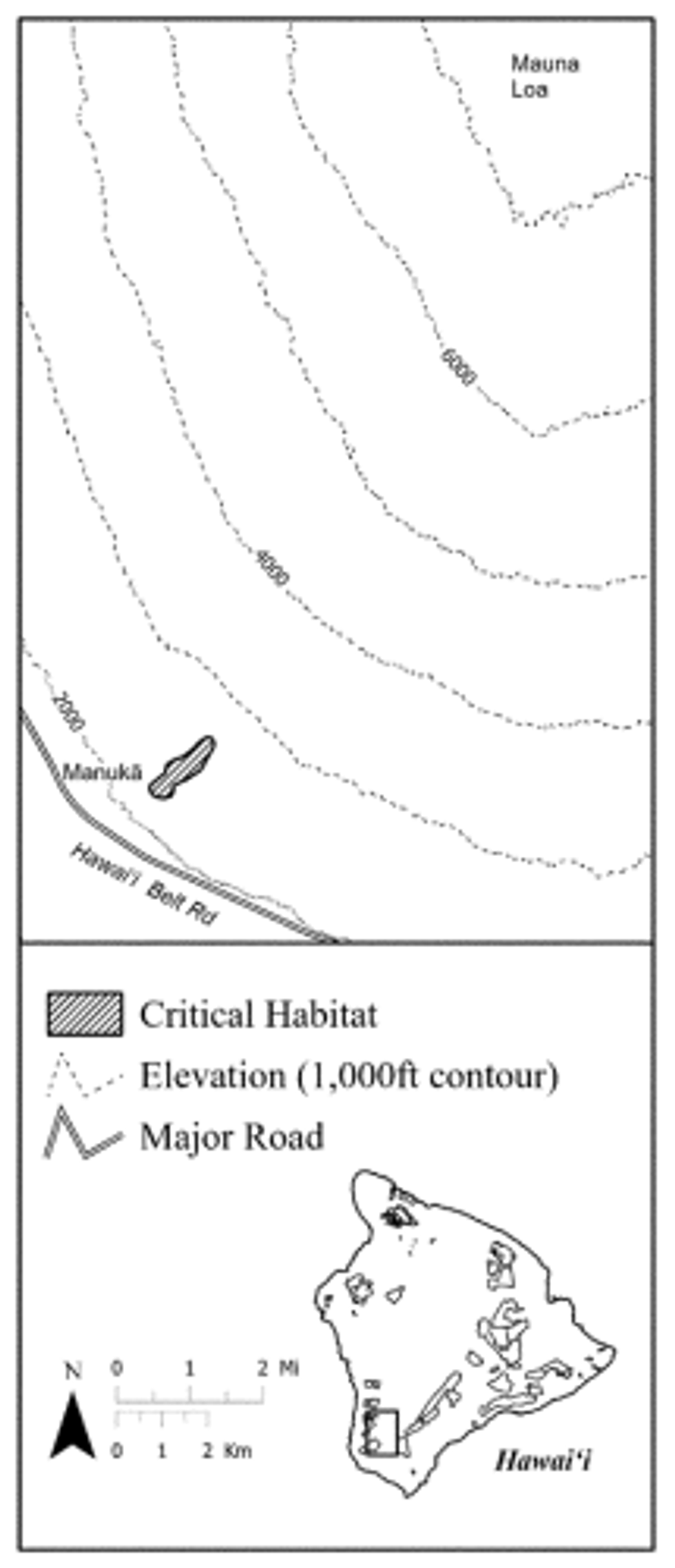
(10) Drosophila digressa —Unit 5; Hawaii County, Hawaii.
(i) Drosophila digressa —Unit 5 consists of 3,412 ac (1,381 ha) of wet forest ecosystem from Kipahoehoe to Honomalino on the southwestern slopes of Mauna Loa. Lands within this unit include approximately 411 ac (166 ha) in State ownership and 3,001 ac (1,214 ha) in private or other ownership. State-owned lands in this unit are part of the Kipahoehoe Natural Area Reserve and South Kona Forest Reserve Kapua-Manukā Section. Some private lands are owned by The Nature Conservancy, within the Kona Hema Preserve.
(ii) Map of Drosophila digressa —Unit 5, Drosophila digressa —Unit 6, Drosophila digressa —Unit 7, Drosophila digressa —Unit 8, and Drosophila digressa —Unit 9 follows:
Figure 6 to Hawaiian picture-wing fly ( Drosophila digressa ) paragraph (10)(ii)
Critical Habitat for Drosophila digressa
Hawaii Island, HI
Unit 5, Unit 6, Unit 7, Unit 8, and Unit 9
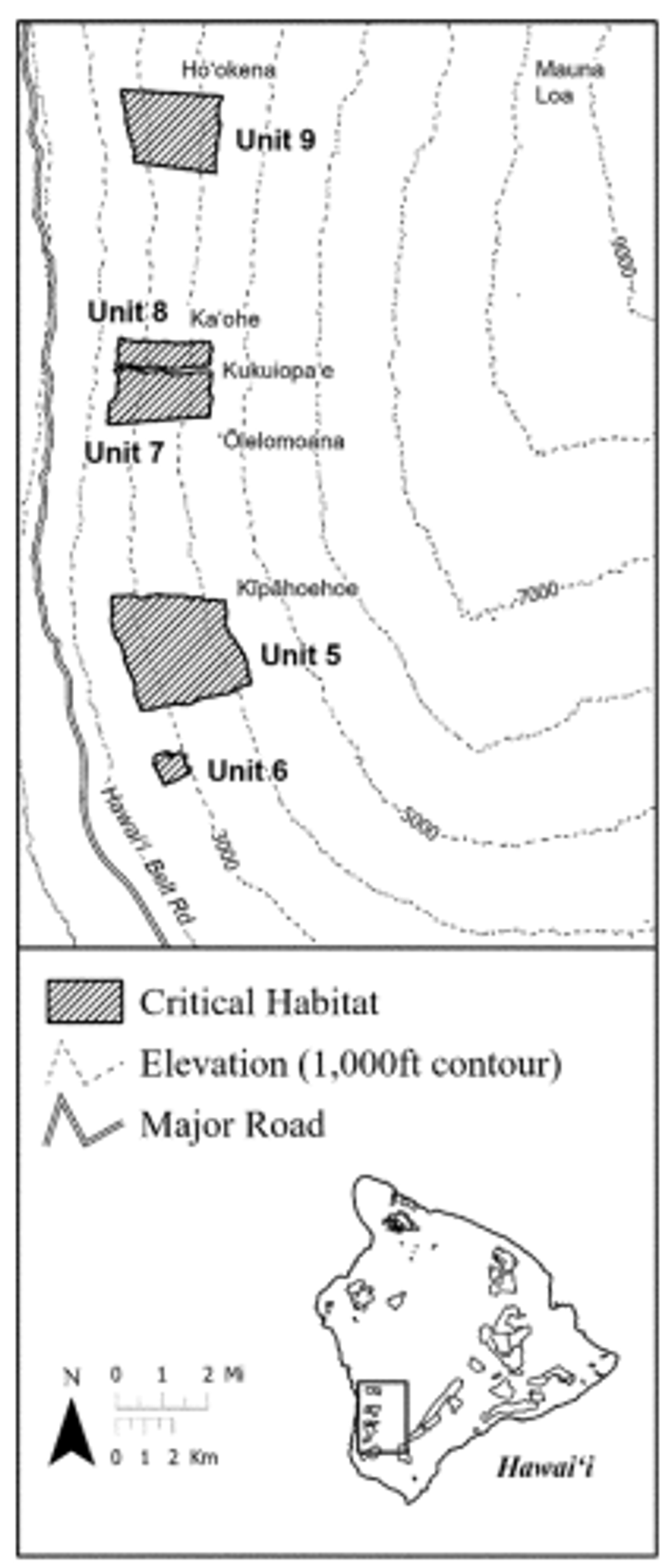
(11) Drosophila digressa —Unit 6; Hawaii County, Hawaii.
(i) Drosophila digressa —Unit 6 consists of 224 ac (91 ha) of wet forest ecosystem from Milolii to Honomalino on the southwestern slopes of Mauna Loa. Lands within this unit are entirely in State ownership and are part of the South Kona Forest Reserve Kapua-Manuka Section.
(ii) Map of Drosophila digressa —Unit 6 is provided at paragraph (10)(ii) of this entry.
(12) Drosophila digressa —Unit 7; Hawaii County, Hawaii.
(i) Drosophila digressa —Unit 7 consists of 1,346 ac (545 ha) of wet forest ecosystem from Kukuiopae to Olelomoana on the southwestern slopes of Mauna Loa. Lands within this unit include approximately 1,179 ac (477 ha) in State ownership and 167 ac (68 ha) in private or other ownership. State-owned lands in this unit are part of the South Kona Forest Reserve Kukuiopae Section.
(ii) Map of Drosophila digressa —Unit 7 is provided at paragraph (10)(ii) of this entry.
(13) Drosophila digressa —Unit 8; Hawaii County, Hawaii.
(i) Drosophila digressa —Unit 8 consists of 661 ac (267 ha) of wet forest ecosystem in Kaohe on the southwestern slopes of Mauna Loa. Lands within this unit include approximately 352 ac (142 ha) in State ownership and 309 ac (125 ha) in private or other ownership. State-owned lands in this unit are part of the South Kona Forest Reserve, Kaohe Section and Kukuiopae Section.
(ii) Map of Drosophila digressa —Unit 8 is provided at paragraph (10)(ii) of this entry.
(14) Drosophila digressa —Unit 9; Hawaii County, Hawaii.
(i) Drosophila digressa —Unit 9 consists of 1,906 ac (771 ha) of wet forest ecosystem in Hookena on the southwestern slopes of Mauna Loa. Lands within this unit include 1,906 ac (771 ha) of Federal land within Hakalau Forest National Wildlife Refuge Kona Forest Unit and less than 1 ac (less than 1 ha) of land that is privately owned or has other ownership.
(ii) Map of Drosophila digressa —Unit 9 is provided at paragraph (10)(ii) of this entry.
Hawaiian picture-wing fly (Drosophila hemipeza)
(1) Critical habitat units are depicted for County of Honolulu, island of Oahu, Hawaii, on the maps below. The maps provided are for informational purposes only.
(2) The primary constituent elements of critical habitat for Drosophila hemipeza are:
(i) Dry to mesic, lowland, ohia and koa forest between the elevations of 1,720-3,005 ft (524-916 m); and
(ii) The larval host plants Cyanea angustifolia, C. calycina, C. grimesiana ssp. grimesiana, C. grimesiana ssp. obatae, C. membranacea, C. pinnatifida, C. superba ssp. superba, Lobelia hypoleuca, L. niihauensis, L. yuccoides, and Urera kaalae, which exhibit one or more life stages (from seedlings to senescent individuals).
(3) Critical habitat does not include manmade structures (such as buildings, aqueducts, airports, and roads) and the land on which they are located existing within the legal boundaries on the effective date of this rule.
(4) Critical habitat map units. Coordinates are in Universal Transverse Mercator (UTM) Zone 4 with units in meters using North American Datum of 1983 (NAD83).
(5) Note: Index map of critical habitat units for Drosophila hemipeza follows:
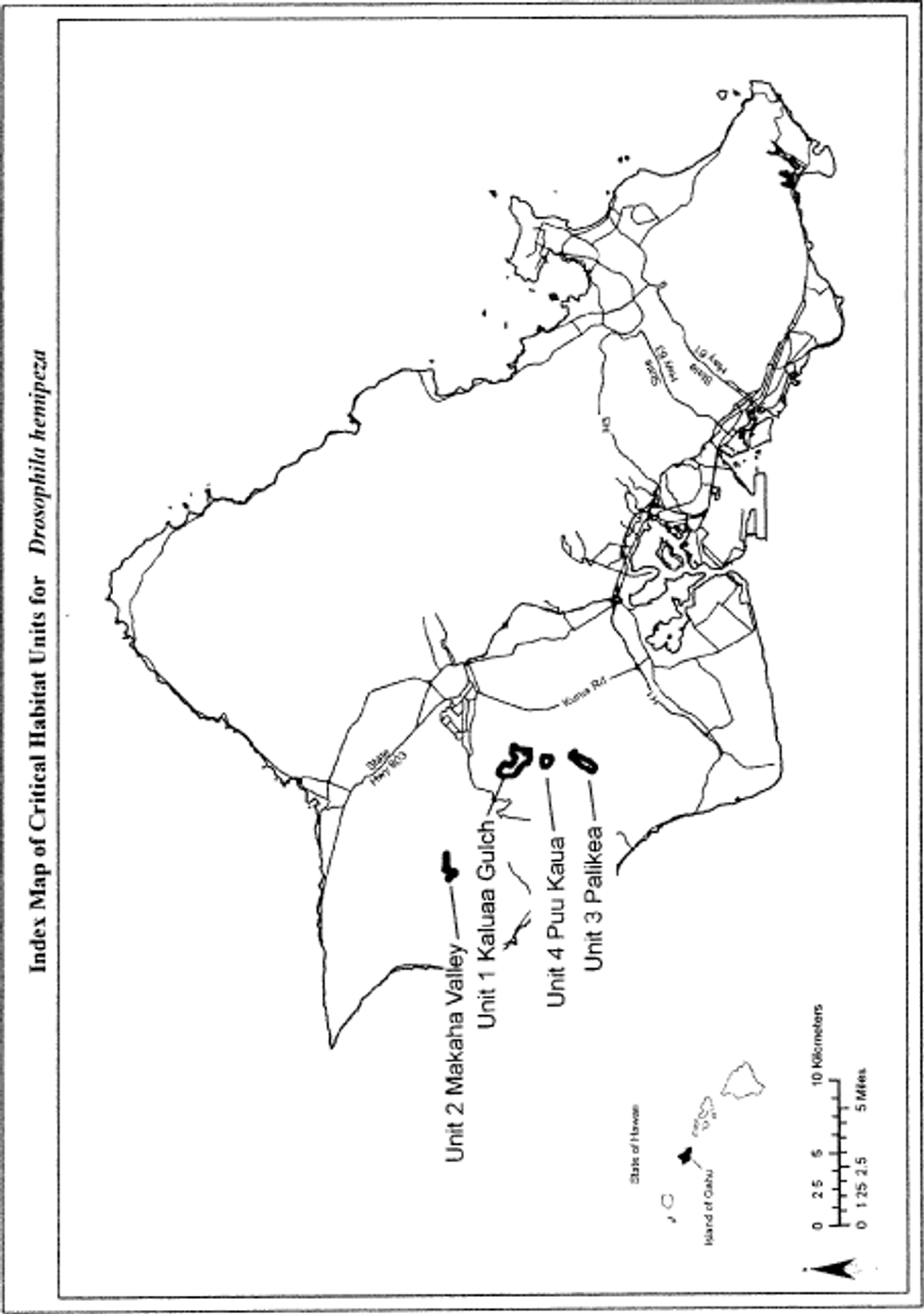
(6) Drosophila hemipeza - Unit 1 - Kaluaa Gulch, City and County of Honolulu, island of Oahu, Hawaii.
(i) Land bounded by the following coordinates: 593240, 2374436; 593231, 2374371; 593281, 2374410; 593315, 2374385; 593612, 2374173; 593656, 2374138; 593621, 2374096; 593641, 2374077; 593676, 2374072; 593703, 2374057; 593734, 2374039; 593758, 2374058; 593793, 2374029; 593779, 2373964; 593731, 2373894; 593660, 2373784; 593609, 2373702; 593592, 2373648; 593592, 2373594; 593598, 2373553; 593657, 2373561; 593770, 2373549; 593792, 2373496; 593797, 2373417; 593842, 2373411; 593842, 2373326; 593905, 2373404; 594053, 2373383; 594103, 2373292; 594134, 2373228; 594156, 2373250; 594194, 2373256; 594178, 2373323; 594196, 2373386; 594229, 2373390; 594312, 2373340; 594341, 2373350; 594339, 2373421; 594383, 2373487; 594381, 2373513; 594460, 2373552; 594496, 2373553; 594497, 2373518; 594526, 2373509; 594572, 2373460; 594632, 2373519; 594649, 2373523; 594699, 2373475; 594728, 2373476; 594762, 2373532; 594791, 2373529; 594828, 2373501; 594852, 2373465; 594903, 2373501; 594933, 2373500; 594952, 2373489; 594974, 2373334; 594800, 2373150; 594718, 2373120; 594718, 2373102; 594744, 2373091; 594710, 2372721; 594720, 2372686; 594716, 2372633; 594678, 2372623; 594566, 2372651; 594536, 2372666; 594506, 2372663; 594467, 2372672; 594395, 2372663; 594406, 2372650; 594546, 2372567; 594558, 2372553; 594551, 2372535; 594389, 2372452; 594395, 2372434; 594415, 2372428; 594511, 2372449; 594603, 2372437; 594614, 2372421; 594607, 2372385; 594593, 2372353; 594591, 2372317; 594618, 2372322; 594661, 2372357; 594700, 2372384; 594696, 2372334; 594697, 2372333; 594697, 2372283; 594652, 2372257; 594541, 2372266; 594454, 2372294; 594400, 2372294; 594293, 2372267; 594231, 2372261; 594168, 2372241; 594126, 2372258; 594075, 2372267; 594030, 2372303; 593999, 2372354; 593948, 2372388; 593889, 2372397; 593812, 2372413; 593781, 2372425; 593756, 2372442; 593742, 2372467; 593742, 2372490; 593736, 2372521; 593736, 2372560; 593757, 2372587; 593790, 2372662; 593663, 2372772; 593543, 2372859; 593558, 2372894; 593555, 2372910; 593526, 2372928; 593476, 2372912; 593422, 2372953; 593420, 2372976; 593403, 2372997; 593400, 2373025; 593373, 2373016; 593352, 2373044; 593328, 2373025; 593215, 2373118; 593230, 2373171; 593214, 2373176; 593163, 2373154; 593095, 2373213; 593091, 2373238; 593064, 2373243; 593019, 2373295; 592937, 2373388; 592889, 2373462; 592897, 2373535; 592908, 2373597; 592923, 2373668; 592914, 2373772; 592889, 2373866; 592868, 2373941; 592867, 2373950; 592894, 2374029; 592908, 2374120; 592894, 2374162; 592860, 2374213; 592854, 2374216; 593151, 2374494.
(ii) Note: Map of Drosophila hemipeza - Unit 1 - Kaluaa Gulch follows:
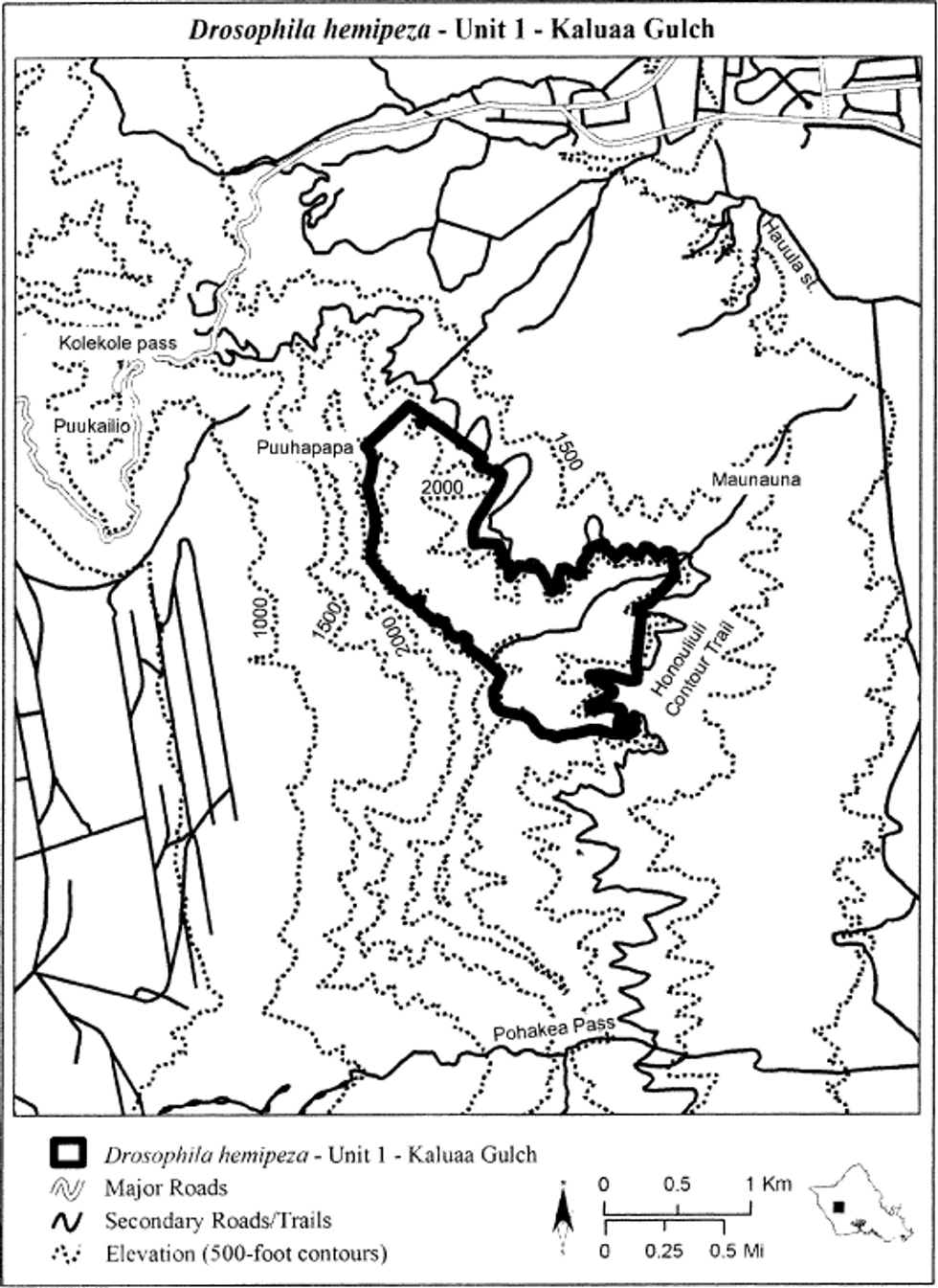
(7) Drosophila hemipeza - Unit 2 - Makaha Valley, City and County of Honolulu, island of Oahu, Hawaii.
(i) Land bounded by the following coordinates: 586712, 2378108; 586877, 2378091; 587049, 2378091; 587173, 2378087; 587333, 2378079; 587506, 2378079; 587592, 2378075; 587641, 2378046; 587641, 2378038; 587666, 2377980; 587543, 2377935; 587399, 2377931; 587243, 2377919; 587090, 2377906; 586794, 2377943; 586696, 2377943; 586597, 2377869; 586507, 2377767; 586449, 2377684; 586449, 2377458; 586408, 2377397; 586305, 2377368; 586206, 2377405; 586054, 2377643; 585968, 2377726; 585869, 2377775; 585803, 2377849; 585803, 2377915; 585869, 2377952; 585894, 2377956; 585956, 2377952; 586050, 2377923; 586120, 2377869; 586194, 2377824; 586317, 2377828; 586383, 2377878; 586391, 2377956; 586420, 2378034; 586461, 2378116; 586482, 2378174; 586552, 2378190; 586630, 2378149; 586655, 2378128.
(ii) Note: Map of Drosophila hemipeza - Unit 2 - Makaha Valley follows:
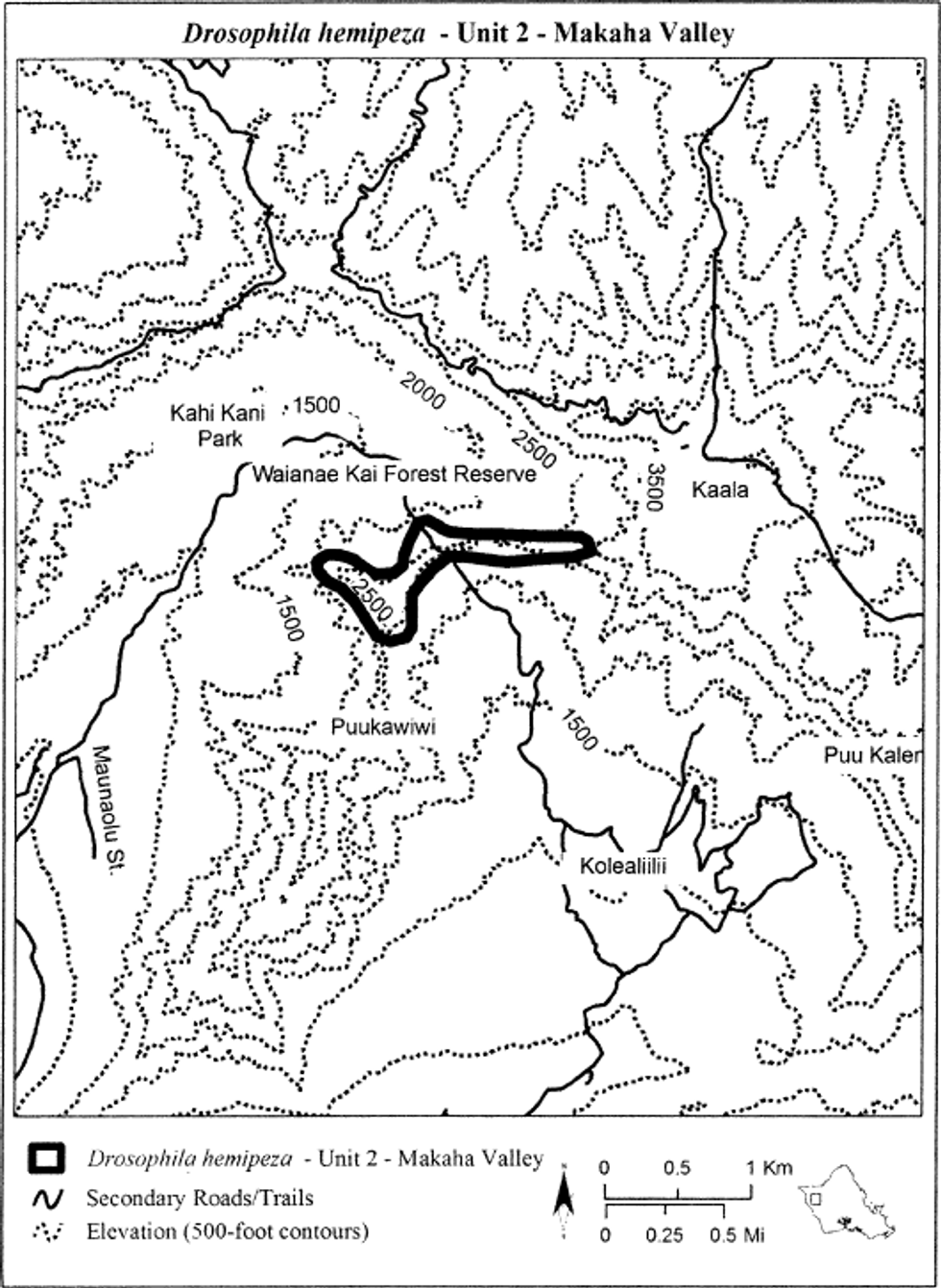
(8) Drosophila hemipeza - Unit 3 - Palikea, City and County of Honolulu, island of Oahu, Hawaii.
(i) Land bounded by the following coordinates: 593529, 2367854; 593448, 2367801; 593302, 2367874; 593242, 2367927; 593193, 2367967; 593165, 2368065; 593217, 2368150; 593314, 2368283; 593399, 2368425; 593448, 2368578; 593505, 2368716; 593622, 2368833; 593703, 2368906; 593764, 2368963; 593832, 2369044; 593901, 2369145; 594002, 2369262; 594079, 2369331; 594104, 2369396; 594120, 2369485; 594124, 2369521; 594148, 2369525; 594213, 2369525; 594310, 2369497; 594395, 2369473; 594399, 2369392; 594396, 2369356; 594417, 2369313; 594461, 2369290; 594551, 2369278; 594579, 2369250; 594559, 2369197; 594472, 2369183; 594391, 2369179; 594354, 2369153; 594302, 2369072; 594257, 2369015; 594213, 2368914; 594136, 2368809; 594083, 2368672; 594035, 2368550; 593966, 2368417; 593966, 2368324; 593909, 2368259; 593792, 2368105; 593675, 2368000.
(ii) Note: Map of Drosophila hemipeza - Unit 3 - Palikea follows:
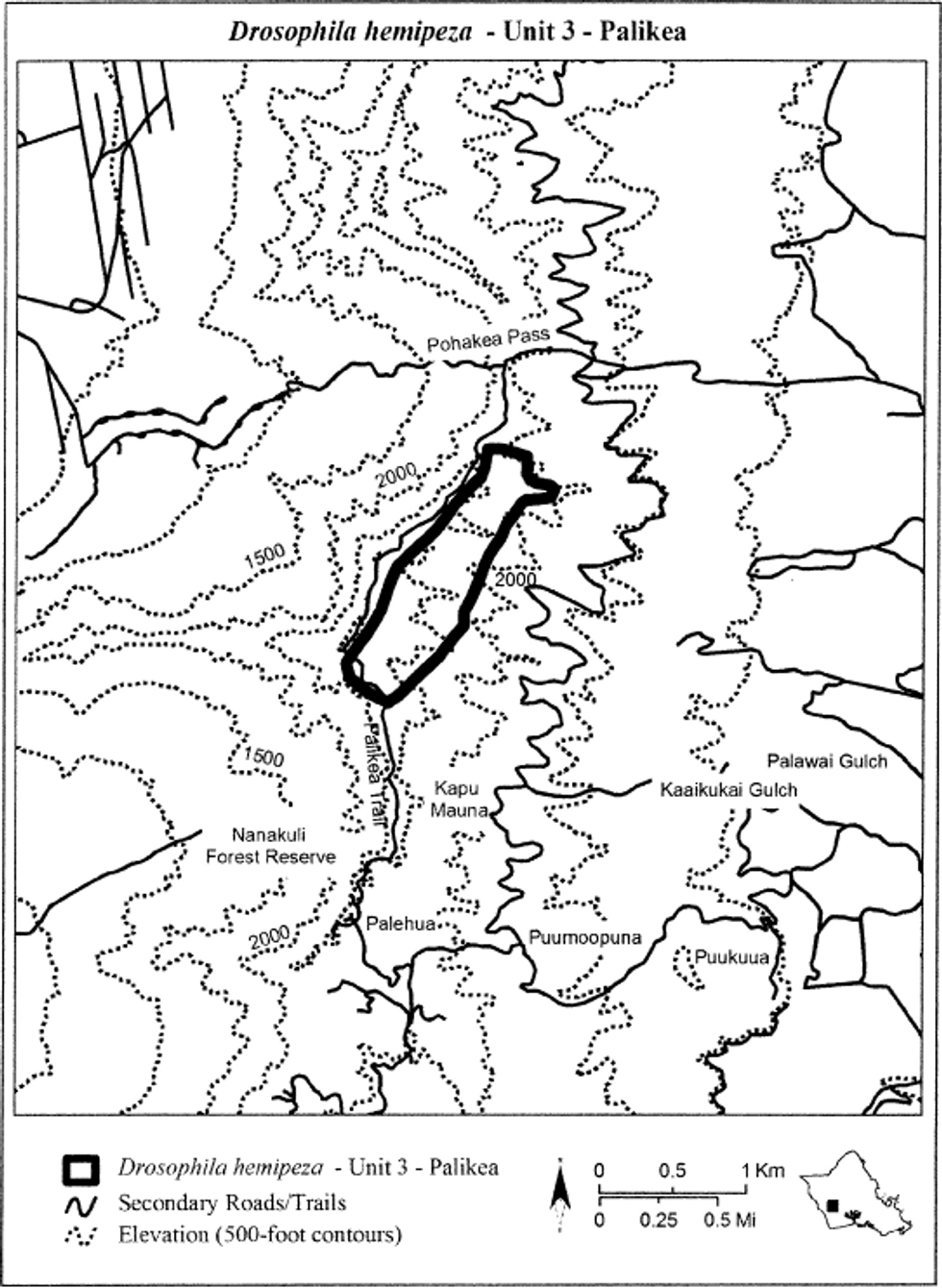
(9) Drosophila hemipeza - Unit 4 - Puu Kaua, City and County of Honolulu, island of Oahu, Hawaii.
(i) Land bounded by the following coordinates: 594166, 2370854; 594166, 2370853; 594164, 2370854; 594122, 2370843; 594090, 2370815; 594040, 2370789; 593996, 2370789; 593930, 2370827; 593852, 2370875; 593778, 2370907; 593716, 2370947; 593642, 2370999; 593602, 2371041; 593574, 2371067; 593558, 2371095; 593539, 2371118; 593531, 2371121; 593534, 2371173; 593519, 2371375; 593533, 2371375; 593552, 2371390; 593628, 2371404; 593716, 2371426; 593794, 2371431; 593876, 2371437; 593974, 2371435; 594036, 2371431; 594138, 2371415; 594190, 2371399; 594232, 2371385; 594246, 2371359; 594239, 2371354; 594170, 2370879; 594172, 2370877; 594170, 2370855.
(ii) Note: Map of Drosophila hemipeza - Unit 4 - Puu Kaua follows:
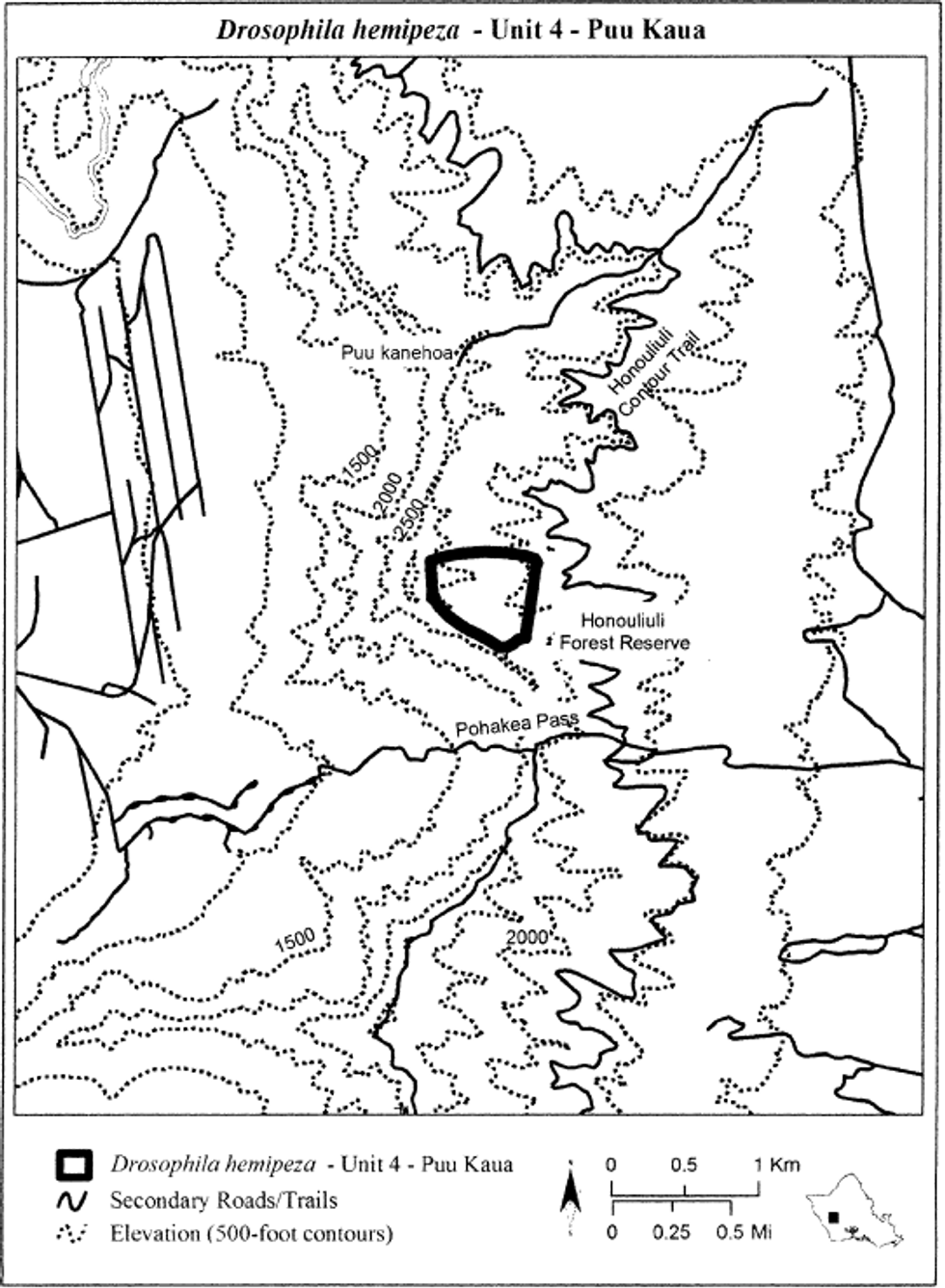
Hawaiian picture-wing fly (Drosophila heteroneura)
(1) Critical habitat units are depicted for County of Hawaii, island of Hawaii, Hawaii, on the maps below. The maps provided are for informational purposes only.
(2) The primary constituent elements of critical habitat for Drosophila heteroneura are:
(i) Mesic to wet, montane, ohia and koa forest between the elevations of 2,908-5,755 ft (908-1,754 m); and
(ii) The larval host plants Cheirodendron trigynum ssp. trigynum, Clermontia clermontioides, C. clermontioides ssp. rockiana, C. hawaiiensis, C. kohalae, C. lindseyana, C. montis-loa, C. parviflora, C. peleana, C. pyrularia, and Delissea parviflora, which exhibit one or more life stages (from seedlings to senescent individuals).
(3) Critical habitat does not include manmade structures (such as buildings, aqueducts, airports, and roads) and the land on which they are located existing within the legal boundaries on the effective date of this rule.
(4) Critical habitat map units. Coordinates are in Universal Transverse Mercator (UTM) Zone 4 with units in meters using North American Datum of 1983 (NAD83).
(5) Note: Index map of critical habitat units for Drosophila heteroneura follows:
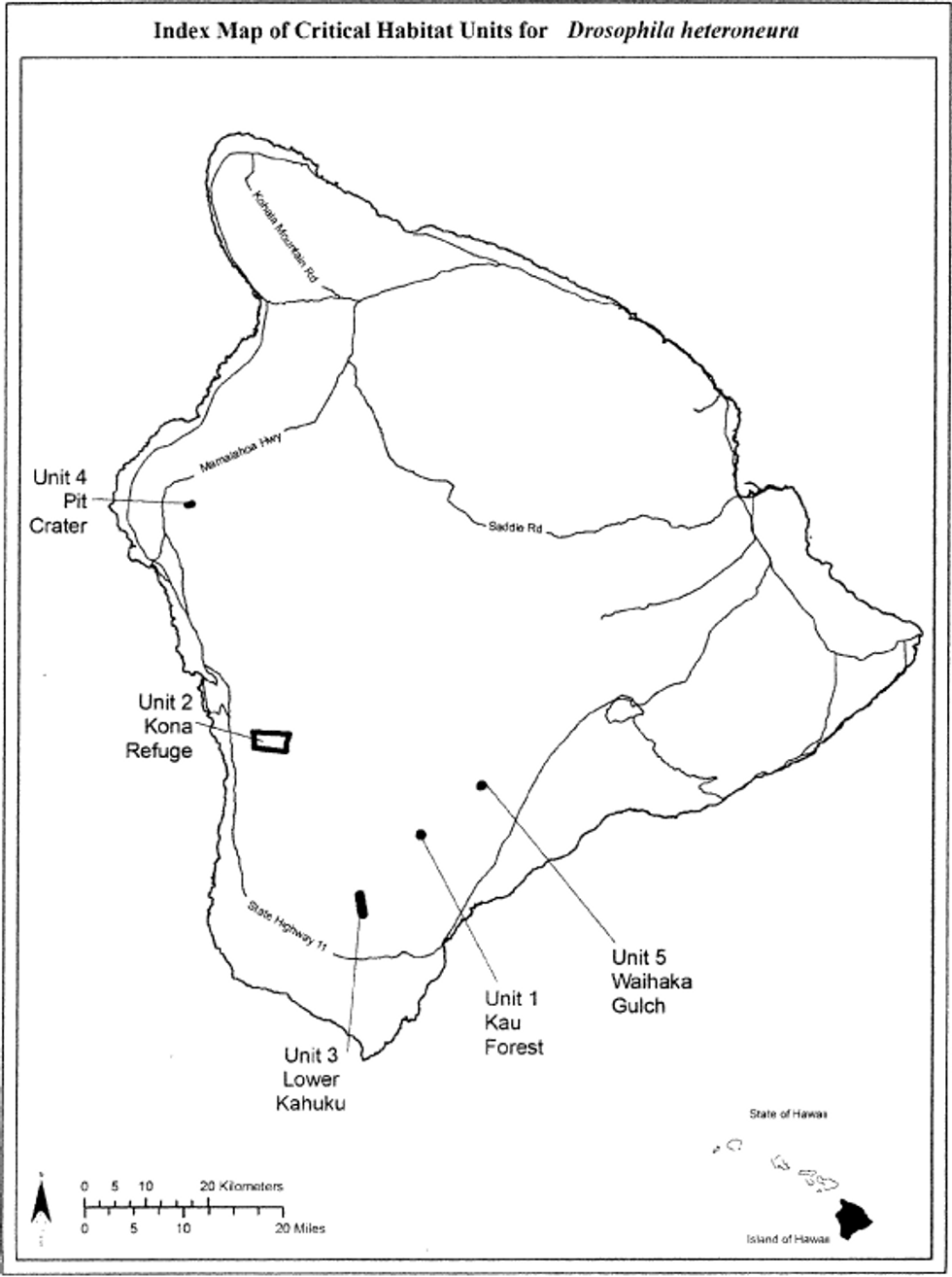
(6) Drosophila heteroneura - Unit 1 - Kau Forest, Hawaii County, island of Hawaii, Hawaii.
(i) Land bounded by the following coordinates: 859357, 2130685; 859117, 2130401; 858810, 2130412; 858577, 2130667; 858596, 2130918; 858800, 2131167; 858976, 2131240; 859117, 2131196; 859416, 2130970.
(ii) Note: Map of Drosophila heteroneura - Unit 1 - Kau Forest follows:
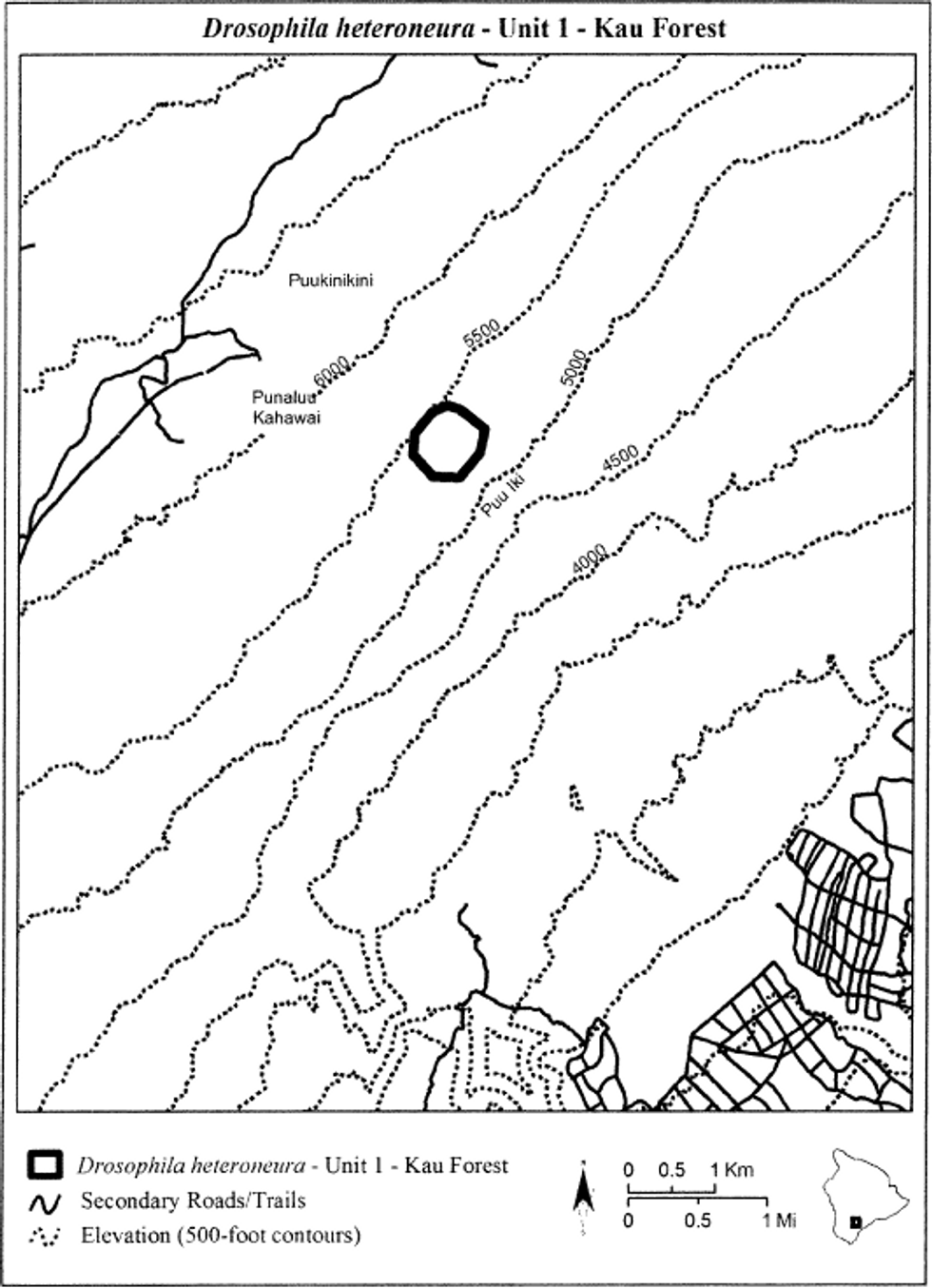
(7) Drosophila heteroneura - Unit 2 - Kona Refuge, Hawaii County, island of Hawaii, Hawaii.
(i) Land bounded by the following coordinates: 836880, 2145492; 836927, 2144316; 836473, 2144373; 835378, 2144516; 831663, 2144980; 31685, 2145029; 831718, 2145184; 831669, 2145289; 831669, 2145387; 831694, 2145557; 31685, 2145727; 831685, 2145882; 831677, 2146020; 831710, 2146149; 831767, 2146247; 31685, 2146482; 831572, 2146766; 831572, 2146953; 831515, 2147156; 831442, 2147391; 31438, 2147486; 837419, 2147183.
(ii) Note: Map of Drosophila heteroneura - Unit 2 - Kona Refuge follows:
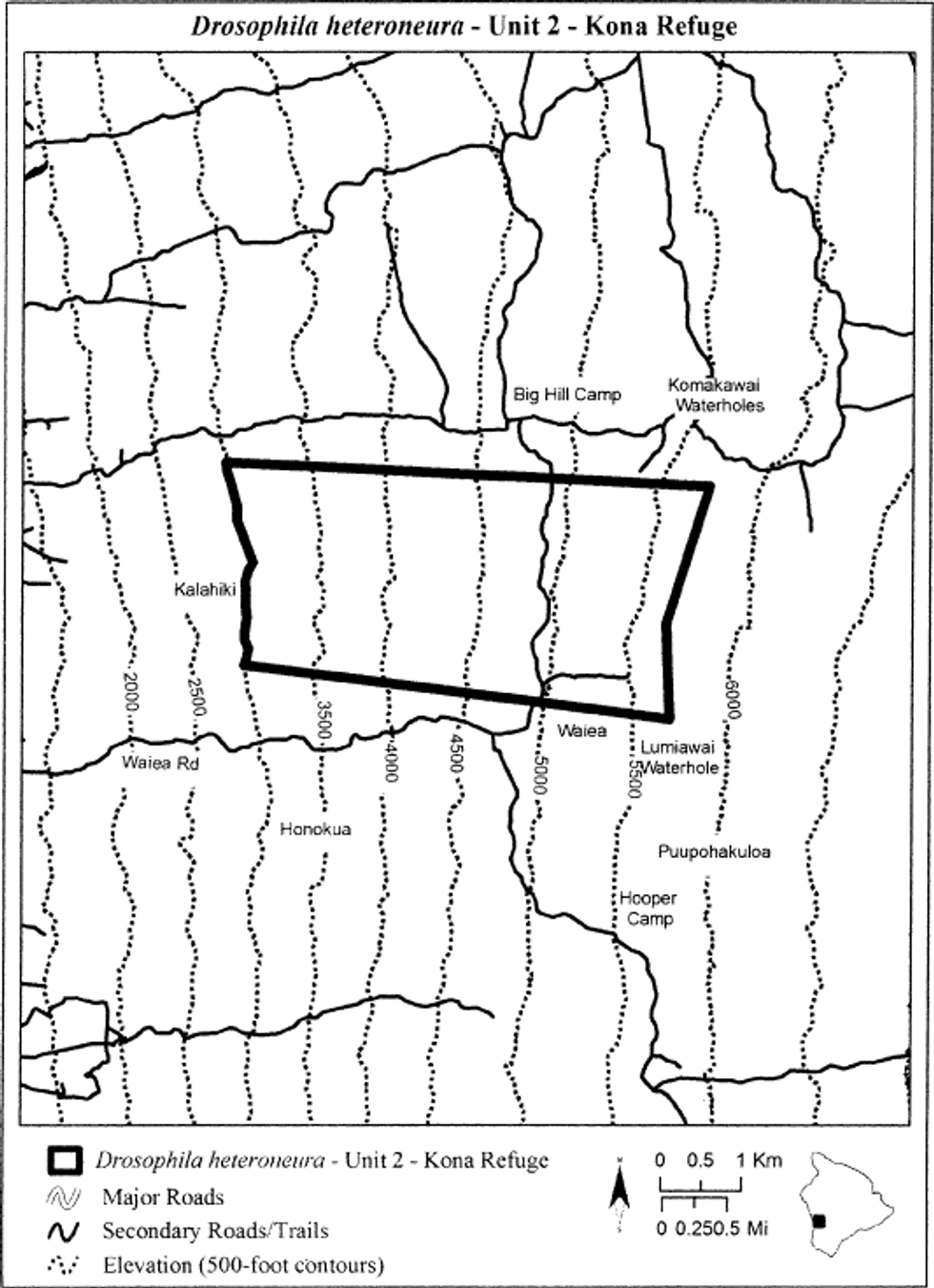
(8) Drosophila heteroneura - Unit 3 - Lower Kahuku, Hawaii County, island of Hawaii, Hawaii.
(i) Land bounded by the following coordinates: 849578, 2119874; 849925, 2117860; 849842, 2117726; 849716, 2117636; 849492, 2117618; 49240, 2117726; 849114, 2118058; 848962, 2118723; 848953, 2119065; 848845, 2119720; 48728, 2120187; 848701, 2120646; 848638, 2120870; 848620, 2121095; 848692, 2121194; 48782, 2121292; 849007, 2121310; 849177, 2121319; 849350, 2121233; 849475, 2120505; 49474, 2120484; 849447, 2120250; 849528, 2120044.
(ii) Note: Map of Drosophila heteroneura - Unit 3 - Lower Kahuku follows:
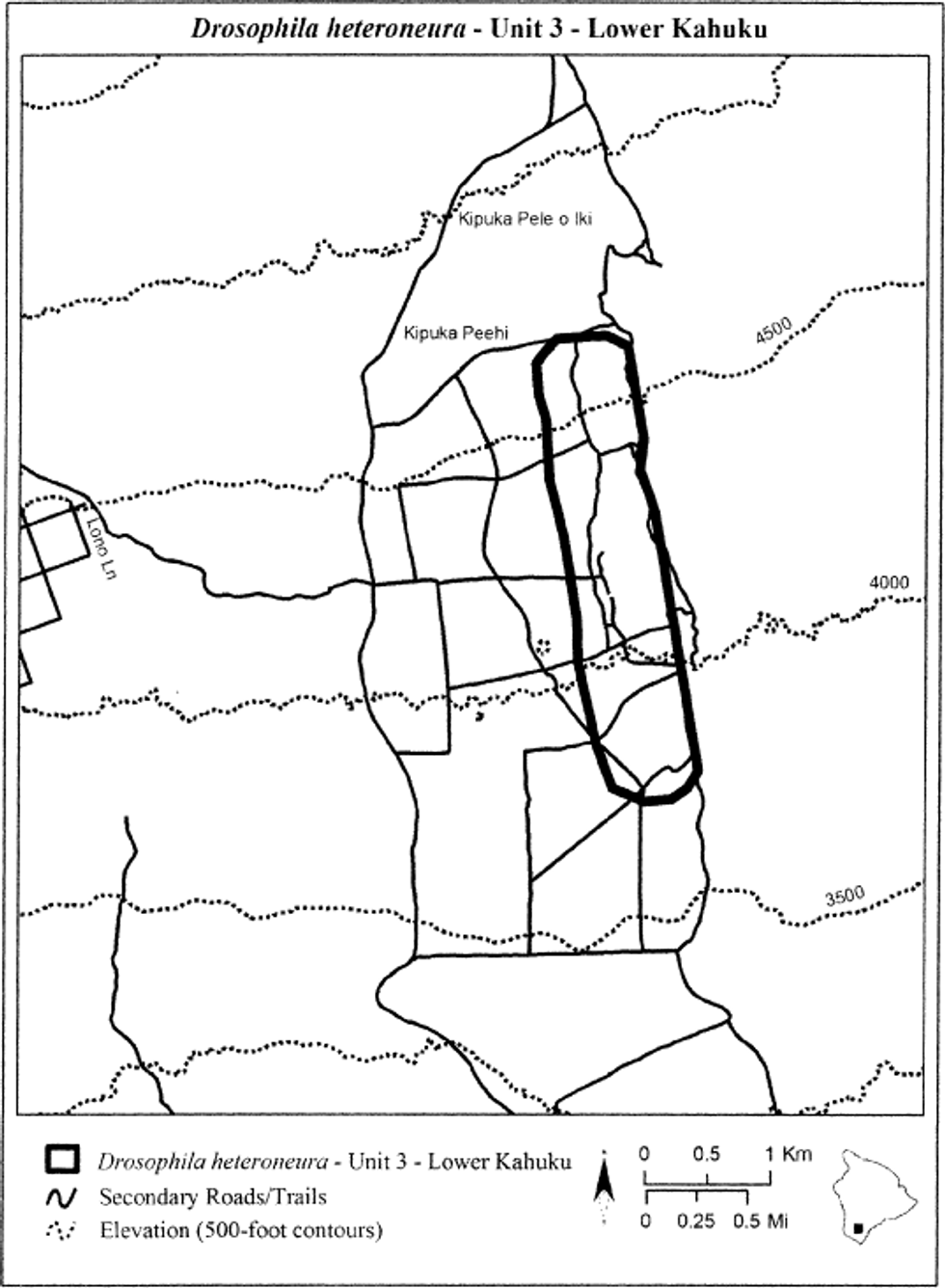
(9) Drosophila heteroneura - Unit 4 - Pit Crater, Hawaii County, island of Hawaii, Hawaii.
(i) Land bounded by the following coordinates: 821660, 2184453; 821670, 2184348; 821617, 2184279; 821490, 2184191; 821428, 2184164; 821304, 2184150; 821131, 2184187; 821052, 2184187; 821012, 2184150; 820889, 2184086; 820850, 2184076; 820824, 2184102; 820778, 2184164; 820705, 2184193; 820626, 2184233; 820610, 2184289; 820657, 2184318; 820673, 2184316; 820707, 2184310; 820723, 2184306; 820747, 2184293; 820790, 2184269; 820818, 2184247; 820832, 2184215; 820861, 2184180; 820905, 2184168; 820929, 2184191; 820939, 2184221; 820974, 2184255; 821024, 2184261; 821109, 2184261; 821206, 2184261; 821264, 2184269; 821282, 2184285; 821292, 2184322; 821254, 2184360; 821232, 2184396; 821276, 2184404; 821341, 2184400; 821369, 2184431; 821363, 2184463; 821333, 2184499; 821345, 2184528; 821426, 2184550; 821531, 2184554; 821619, 2184513.
(ii) Note: Map of Drosophila heteroneura - Unit 4 - Pit Crater follows:
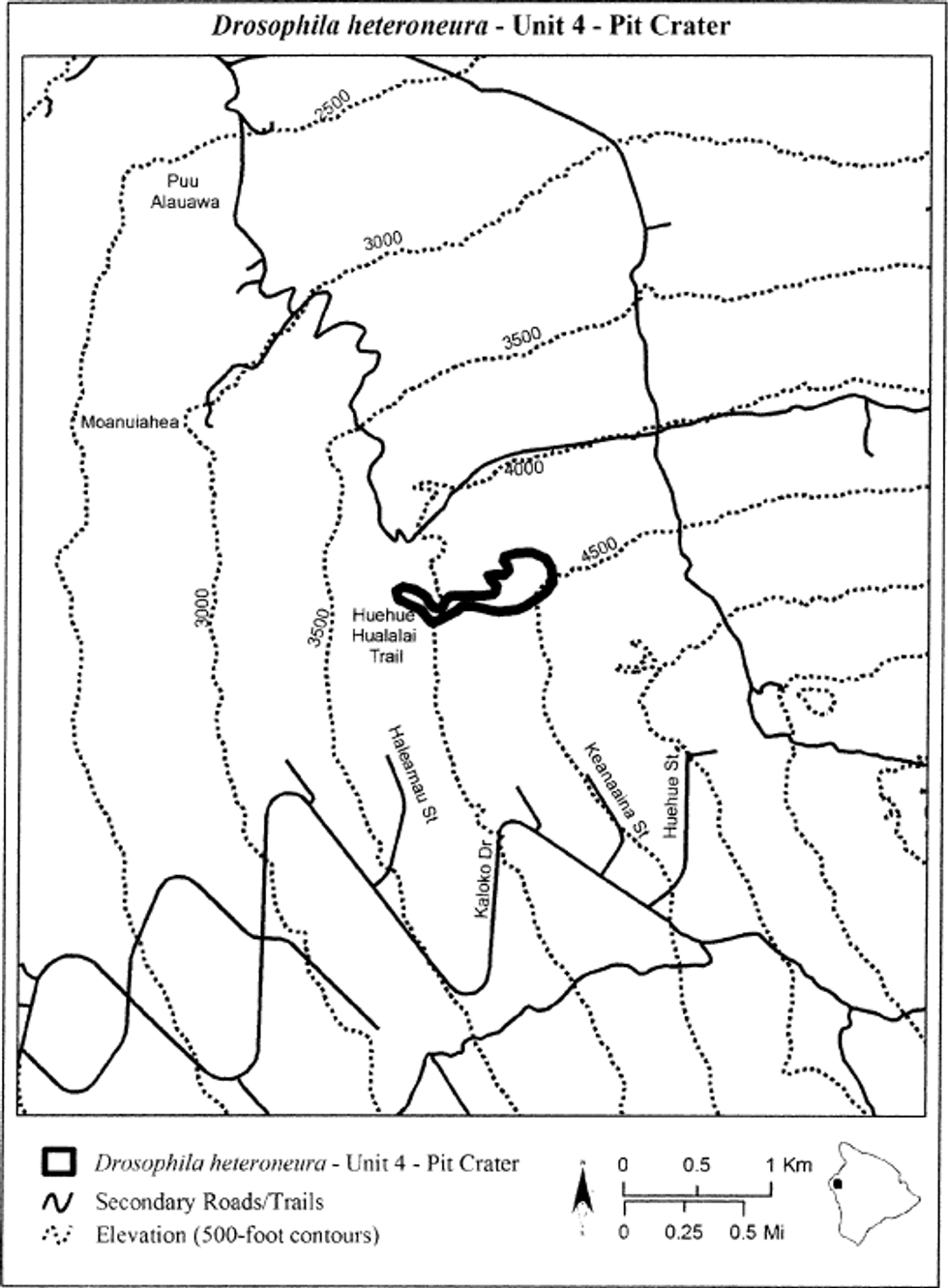
(10) Drosophila heteroneura - Unit 5 - Waihaka Gulch, Hawaii County, island of Hawaii, Hawaii.
(i) Land bounded by the following coordinates: 868924, 2138585; 868686, 2138463; 868564, 2138464; 868434, 2138482; 868325, 2138598; 868350, 2138841; 868378, 2138886; 868503, 2139088; 868720, 2139220; 868946, 2139193; 869076, 2139167; 869160, 2139055; 869238, 2139018; 869248, 2138892.
(ii) Note: Map of Drosophila heteroneura - Unit 5 - Waihaka Gulch follows:
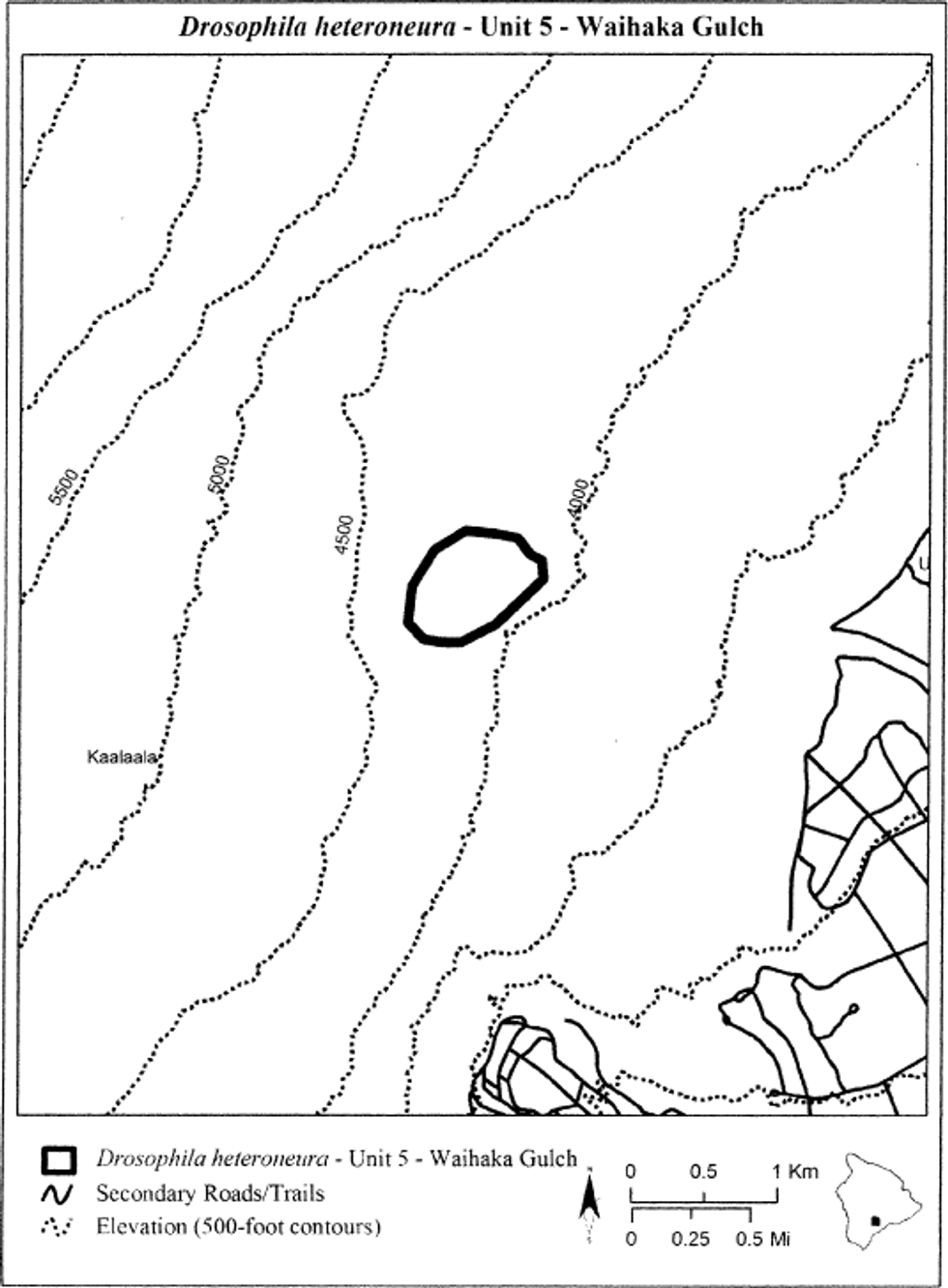
Hawaiian picture-wing fly (Drosophila montgomeryi)
(1) Critical habitat units are depicted for County of Honolulu, Oahu, Hawaii, on the maps below. The maps provided are for informational purposes only.
(2) The primary constituent elements of critical habitat for Drosophila montgomeryi are:
(i) Mesic, lowland, diverse ohia and koa forest between the elevations of 1,720-2,985 ft (524-910 m); and
(ii) The larval host plant Urera kaalae, which exhibits one or more life stages (from seedlings to senescent individuals).
(3) Critical habitat does not include manmade structures (such as buildings, aqueducts, airports, and roads) and the land on which they are located existing within the legal boundaries on the effective date of this rule.
(4) Critical habitat map units. Coordinates are in Universal Transverse Mercator (UTM) Zone 4 with units in meters using North American Datum of 1983 (NAD83).
(5) Note: Index map of critical habitat units for Drosophila montgomeryi follows:
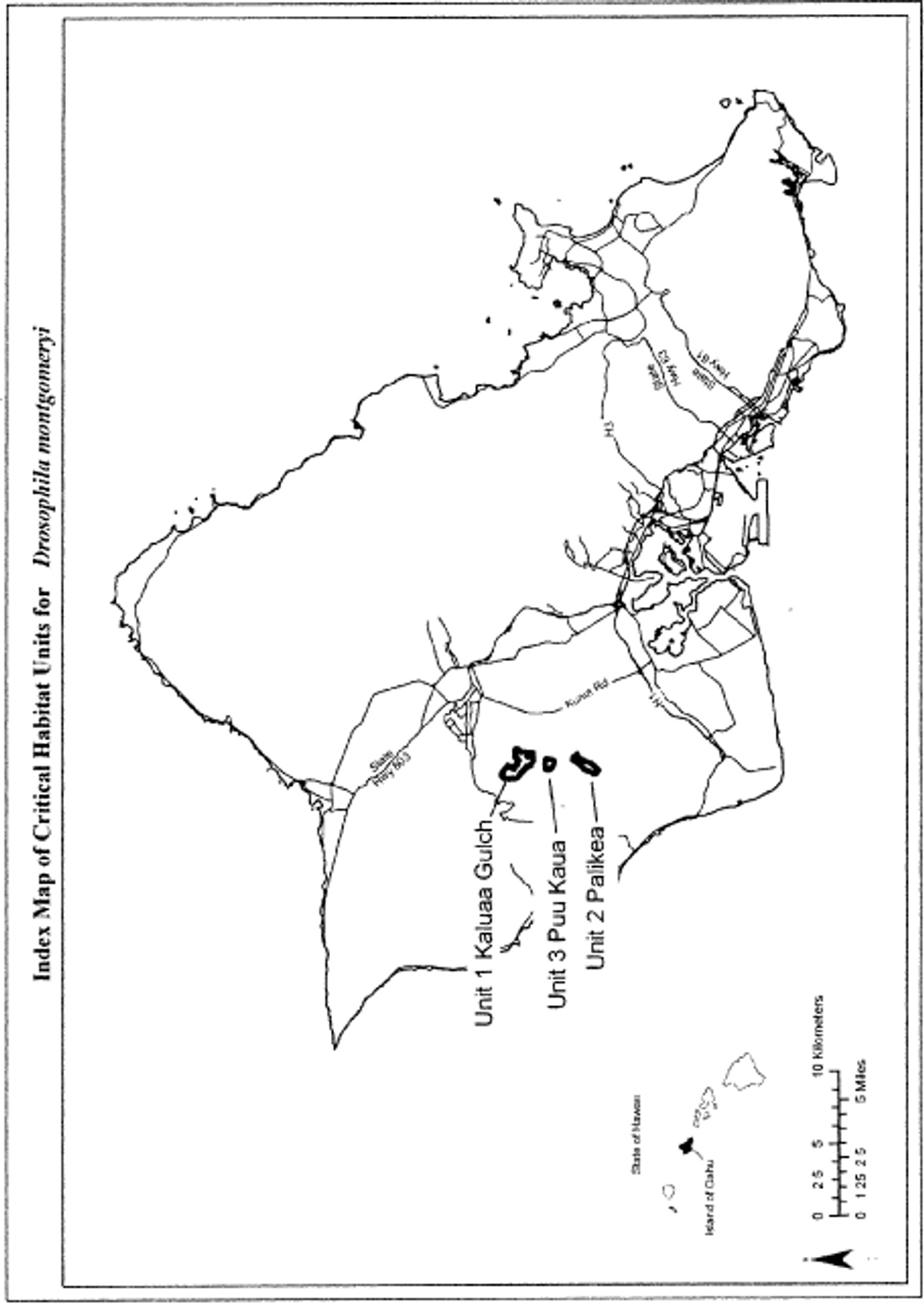
(6) Drosophila montgomeryi - Unit 1 - Kaluaa Gulch, City and County of Honolulu, island of Oahu, Hawaii.
(i) Land bounded by the following coordinates: 593240, 2374436; 593231, 2374371; 593281, 2374410; 593315, 2374385; 593612, 2374173; 593656, 2374138; 593621, 2374096; 593641, 2374077; 593676, 2374072; 593703, 2374057; 593734, 2374039; 593758, 2374058; 593793, 2374029; 593779, 2373964; 593731, 2373894; 593660, 2373784; 593609, 2373702; 593592, 2373648; 593592, 2373594; 593598, 2373553; 593657, 2373561; 593770, 2373549; 593792, 2373496; 593797, 2373417; 593842, 2373411; 593842, 2373326; 593905, 2373404; 594053, 2373383; 594103, 2373292; 594134, 2373228; 594156, 2373250; 594194, 2373256; 594178, 2373323; 594196, 2373386; 594229, 2373390; 594312, 2373340; 594341, 2373350; 594339, 2373421; 594383, 2373487; 594381, 2373513; 594460, 2373552; 594496, 2373553; 594497, 2373518; 594526, 2373509; 594572, 2373460; 594632, 2373519; 594649, 2373523; 594699, 2373475; 594728, 2373476; 594762, 2373532; 594791, 2373529; 594828, 2373501; 594852, 2373465; 594903, 2373501; 594933, 2373500; 594952, 2373489; 594974, 2373334; 594800, 2373150; 594718, 2373120; 594718, 2373102; 594744, 2373091; 594710, 2372721; 594720, 2372686; 594716, 2372633; 594678, 2372623; 594566, 2372651; 594536, 2372666; 594506, 2372663; 594467, 2372672; 594395, 2372663; 594406, 2372650; 594546, 2372567; 594558, 2372553; 594551, 2372535; 594389, 2372452; 594395, 2372434; 594415, 2372428; 594511, 2372449; 594603, 2372437; 594614, 2372421; 594607, 2372385; 594593, 2372353; 594591, 2372317; 594618, 2372322; 594661, 2372357; 594700, 2372384; 594696, 2372334; 594697, 2372333; 594697, 2372283; 594652, 2372257; 594541, 2372266; 594454, 2372294; 594400, 2372294; 594293, 2372267; 594231, 2372261; 594168, 2372241; 594126, 2372258; 594075, 2372267; 594030, 2372303; 593999, 2372354; 593948, 2372388; 593889, 2372397; 593812, 2372413; 593781, 2372425; 593756, 2372442; 593742, 2372467; 593742, 2372490; 593736, 2372521; 593736, 2372560; 593757, 2372587; 593790, 2372662; 593663, 2372772; 593543, 2372859; 593558, 2372894; 593555, 2372910; 593526, 2372928; 593476, 2372912; 593422, 2372953; 593420, 2372976; 593403, 2372997; 593400, 2373025; 593373, 2373016; 593352, 2373044; 593328, 2373025; 593215, 2373118; 593230, 2373171; 593214, 2373176; 593163, 2373154; 593095, 2373213; 593091, 2373238; 593064, 2373243; 593019, 2373295; 592937, 2373388; 592889, 2373462; 592897, 2373535; 592908, 2373597; 592923, 2373668; 592914, 2373772; 592889, 2373866; 592868, 2373941; 592867, 2373950; 592894, 2374029; 592908, 2374120; 592894, 2374162; 592860, 2374213; 592854, 2374216; 593151, 2374494.
(ii) Note: Map of Drosophila montgomery - Unit 1 - Kaluaa Gulch follows:
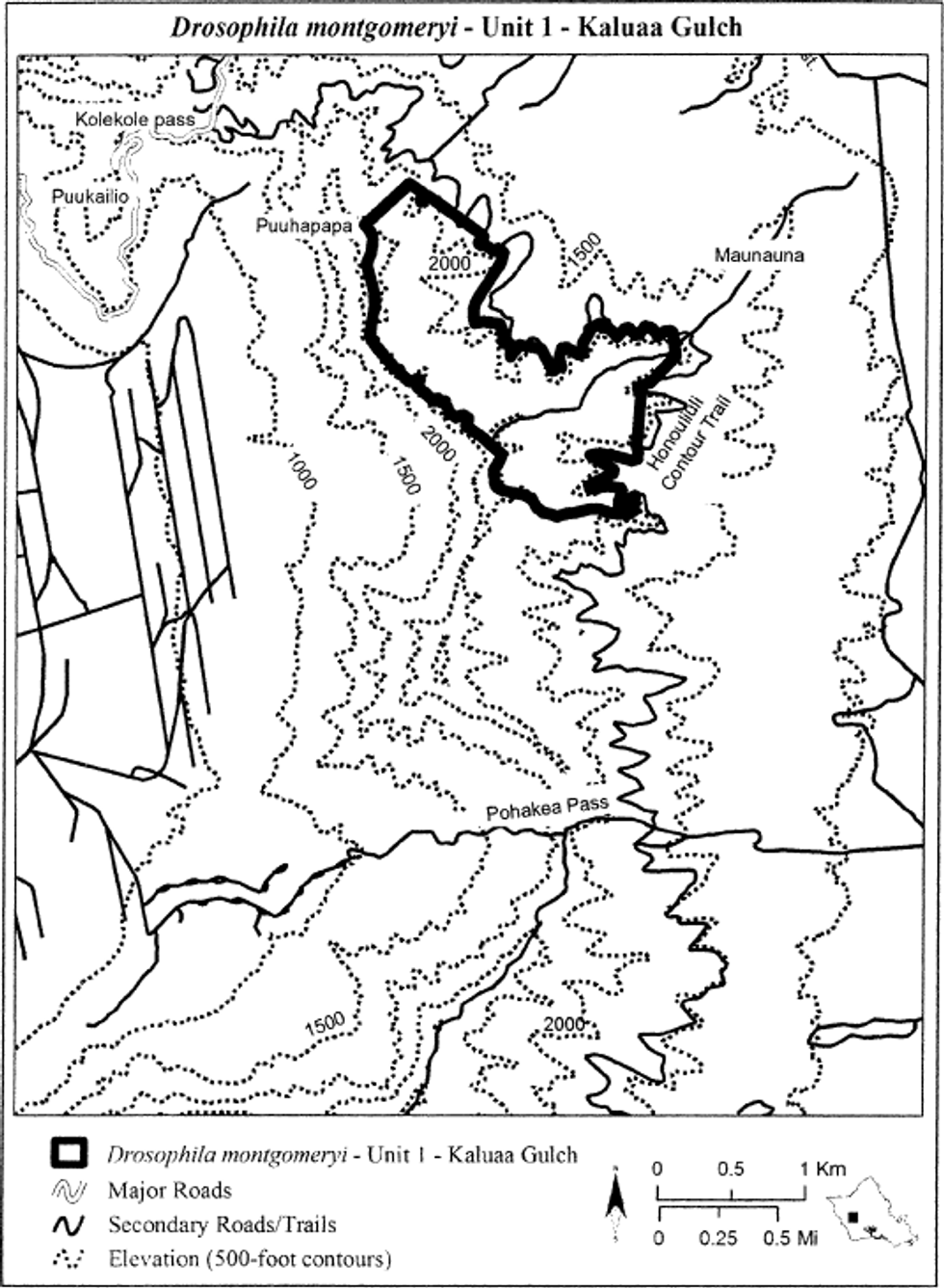
(7) Drosophila montgomeryi - Unit 2 - Palikea, City and County of Honolulu, island of Oahu, Hawaii.
(i) Land bounded by the following coordinates: 593529, 2367854; 593448, 2367801; 593302, 2367874; 593242, 2367927; 593193, 2367967; 593165, 2368065; 593217, 2368150; 593314, 2368283; 593399, 2368425; 593448, 2368578; 593505, 2368716; 593622, 2368833; 593703, 2368906; 593764, 2368963; 593832, 2369044; 593901, 2369145; 594002, 2369262; 594079, 2369331; 594104, 2369396; 594120, 2369485; 594124, 2369521; 594148, 2369525; 594213, 2369525; 594310, 2369497; 594395, 2369473; 594399, 2369392; 594396, 2369356; 594417, 2369313; 594461, 2369290; 594551, 2369278; 594579, 2369250; 594559, 2369197; 594472, 2369183; 594391, 2369179; 594354, 2369153; 594302, 2369072; 594257, 2369015; 594213, 2368914; 594136, 2368809; 594083, 2368672; 594035, 2368550; 593966, 2368417; 593966, 2368324; 593909, 2368259; 593792, 2368105; 593675, 2368000.
(ii) Note: Map of Drosophila montgomeryi - Unit 2 - Palikea follows:
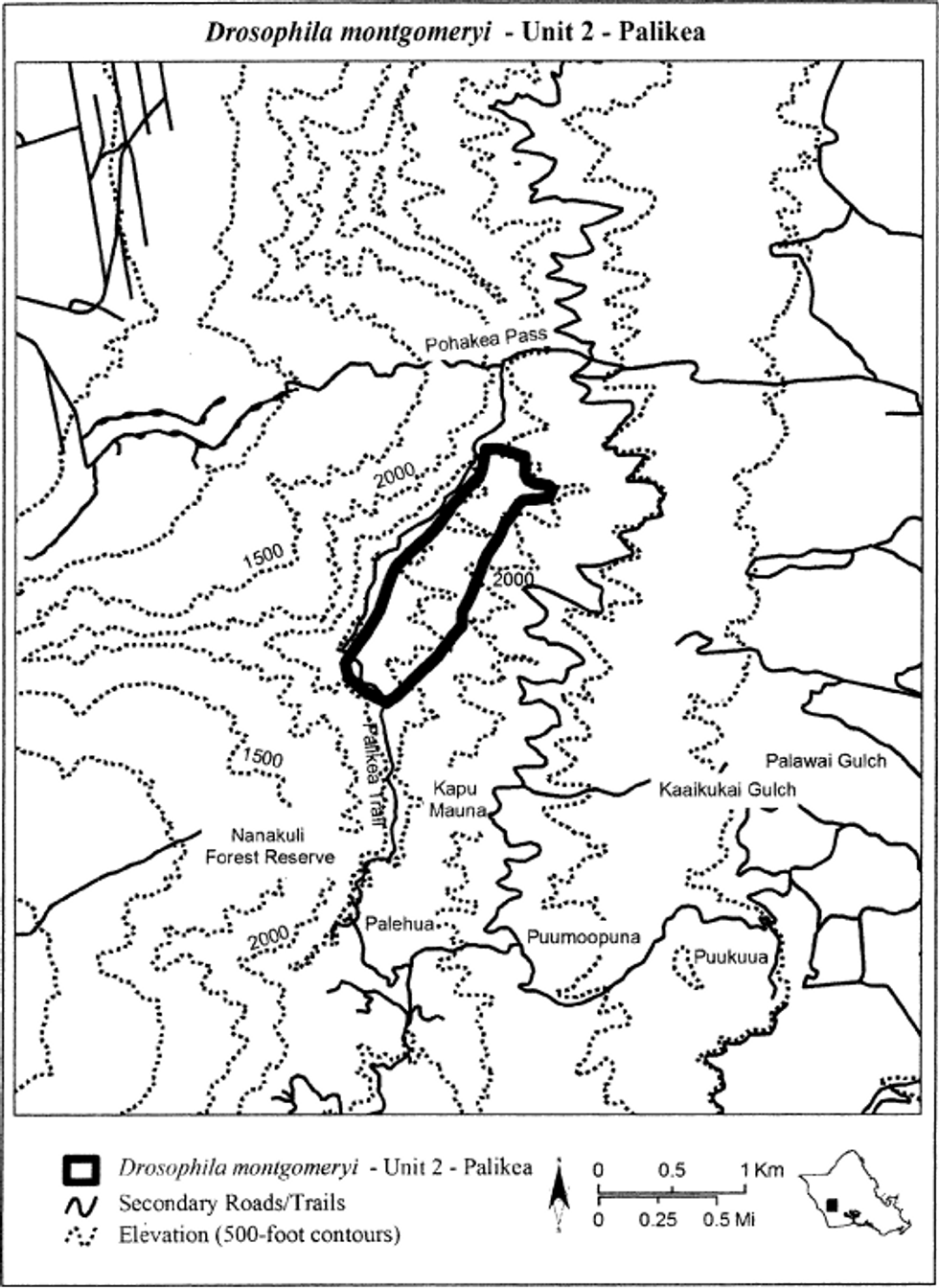
(8) Drosophila montgomeryi - Unit 3 - Puu Kaua, City and County of Honolulu, island of Oahu, Hawaii.
(i) Land bounded by the following coordinates: 594166, 2370854; 594166, 2370853; 594164, 2370854; 594122, 2370843; 594090, 2370815; 594040, 2370789; 593996, 2370789; 593930, 2370827; 593852, 2370875; 593778, 2370907; 593716, 2370947; 593642, 2370999; 593602, 2371041; 593574, 2371067; 593558, 2371095; 593539, 2371118; 593531, 2371121; 593534, 2371173; 593519, 2371375; 593533, 2371375; 593552, 2371390; 593628, 2371404; 593716, 2371426; 593794, 2371431; 593876, 2371437; 593974, 2371435; 594036, 2371431; 594138, 2371415; 594190, 2371399; 594232, 2371385; 594246, 2371359; 594239, 2371354; 594170, 2370879; 594172, 2370877; 594170, 2370855.
(ii) Note: Map of Drosophila montgomeryi - Unit 3 - Puu Kaua follows:
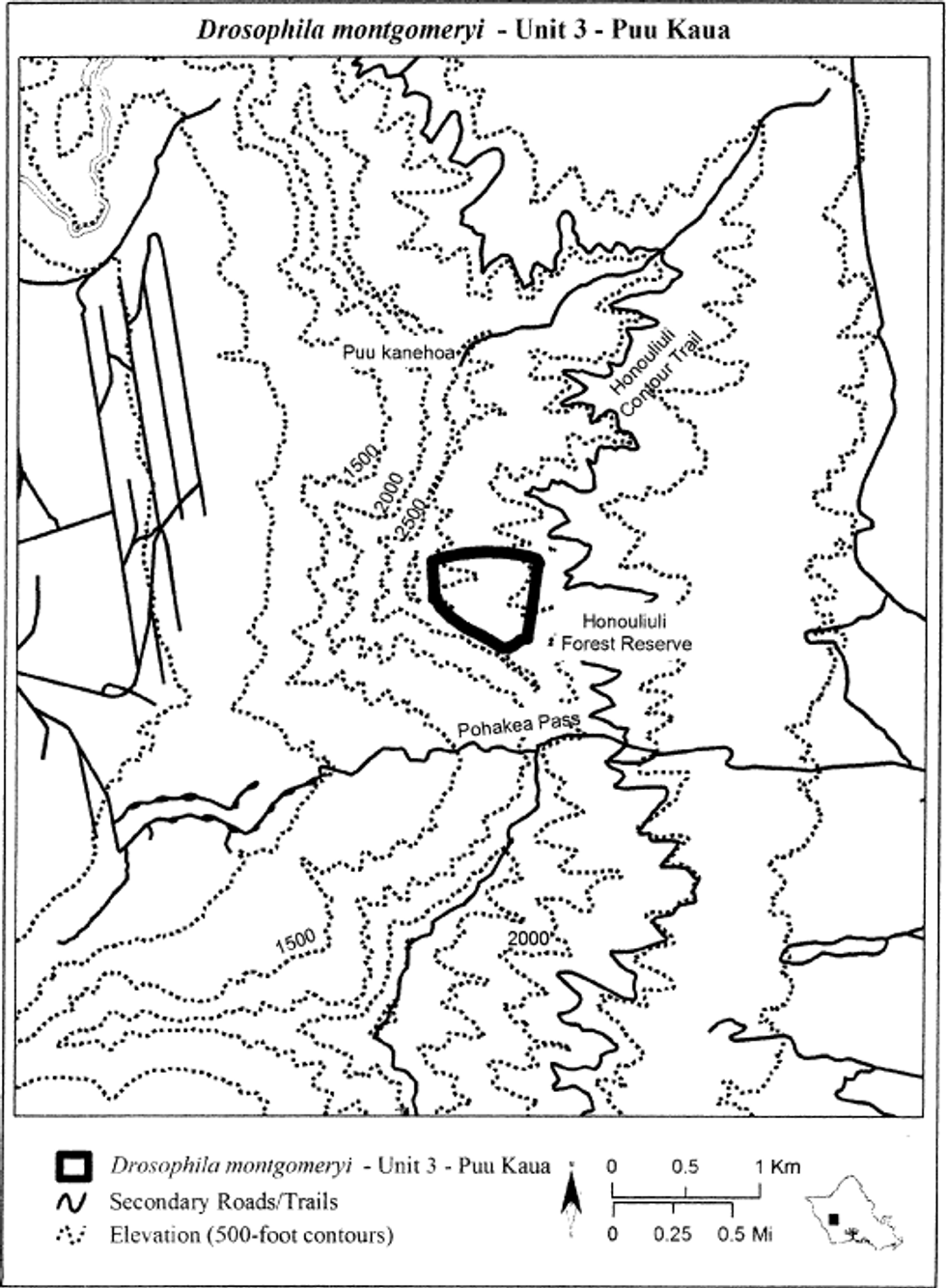
Hawaiian picture-wing fly (Drosophila mulli)
(1) Critical habitat units are depicted for County of Hawaii, island of Hawaii, Hawaii, on the maps below. The maps provided are for informational purposes only.
(2) The primary constituent elements of critical habitat for Drosophila mulli are:
(i) Wet, montane, ohia forest between the elevations of 1,955-3,250 ft (596-1,093 m); and
(ii) The larval host plant Pritchardia beccariana, which exhibits one or more life stages (from seedlings to senescent individuals).
(3) Critical habitat does not include manmade structures (such as buildings, aqueducts, airports, and roads) and the land on which they are located existing within the legal boundaries on the effective date of this rule.
(4) Critical habitat map units. Coordinates are in Universal Transverse Mercator (UTM) Zone 4 with units in meters using North American Datum of 1983 (NAD83).
(5) Note: Index map of critical habitat units for Drosophila mulli follows:
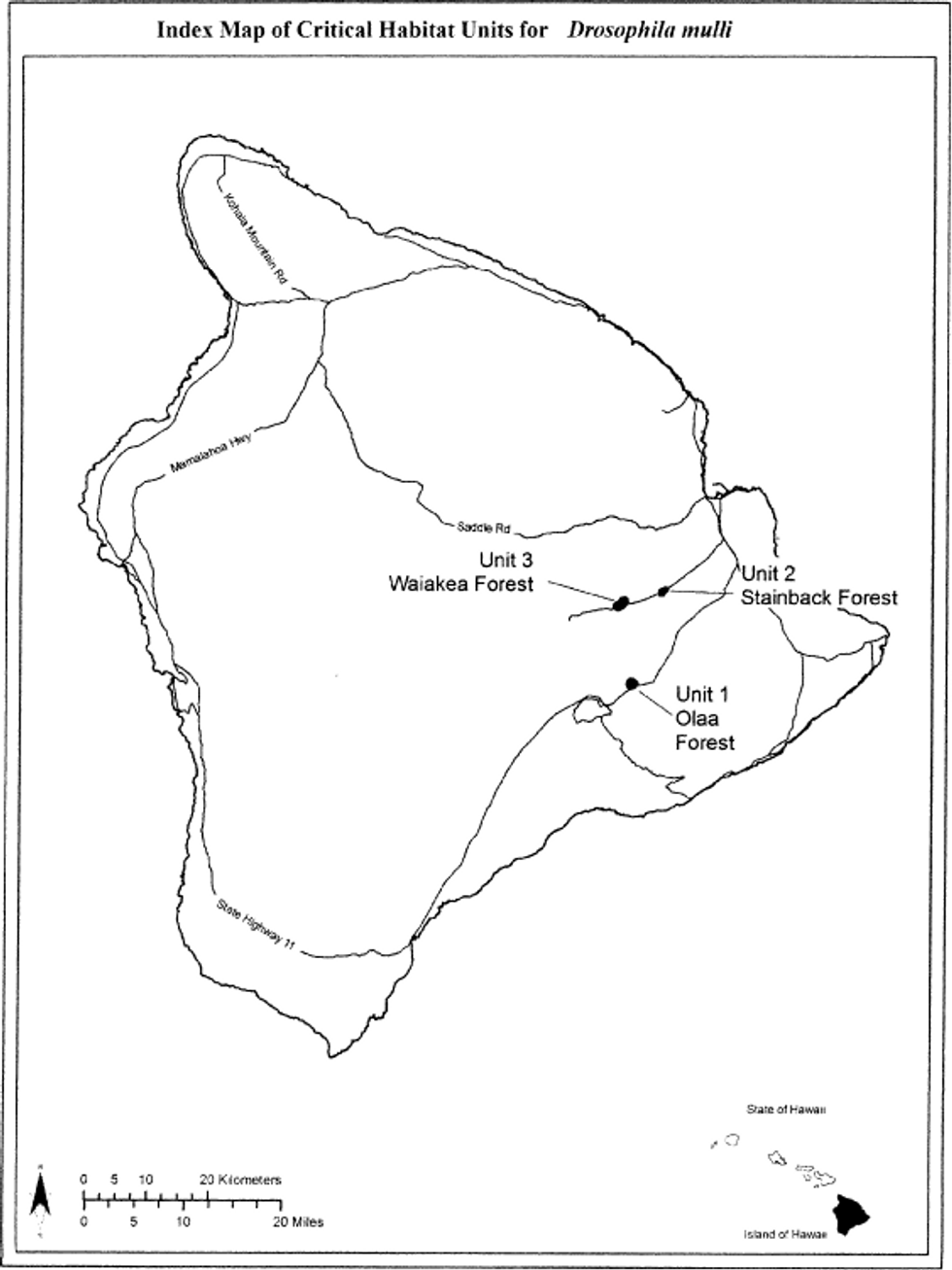
(6) Drosophila mulli - Unit 1 - Olaa Forest, Hawaii County, island of Hawaii, Hawaii.
(i) Land bounded by the following coordinates: 898754, 2154890; 898225, 2154740; 898030, 2154878; 897846, 2155268; 897927, 2155578; 898328, 2155910; 898508, 2155922; 899064, 2155498; 899064, 2155268.
(ii) Note: Map of Drosophila mulli - Unit 1 - Olaa Forest follows:

(7) Drosophila mulli - Unit 2 - Stainback Forest, Hawaii County, island of Hawaii, Hawaii.
(i) Land bounded by the following coordinates: 903259, 2169945; 903159, 2169907; 903080, 2169965; 902974, 2170089; 902953, 2170247; 903012, 2170346; 903101, 2170415; 903166, 2170439; 903245, 2170490; 903324, 2170521; 903420, 2170603; 903509, 2170651; 903636, 2170699; 903732, 2170771; 903849, 2170799; 903914, 2170789; 903955, 2170730; 903869, 2170662; 903866, 2170658; 903718, 2170579; 903653, 2170521; 903622, 2170487; 903441, 2170394; 903386, 2170322; 903399, 2170250; 903451, 2170133; 903403, 2170058.
(ii) Note: Map of Drosophila mulli - Unit 2 - Stainback Forest follows:
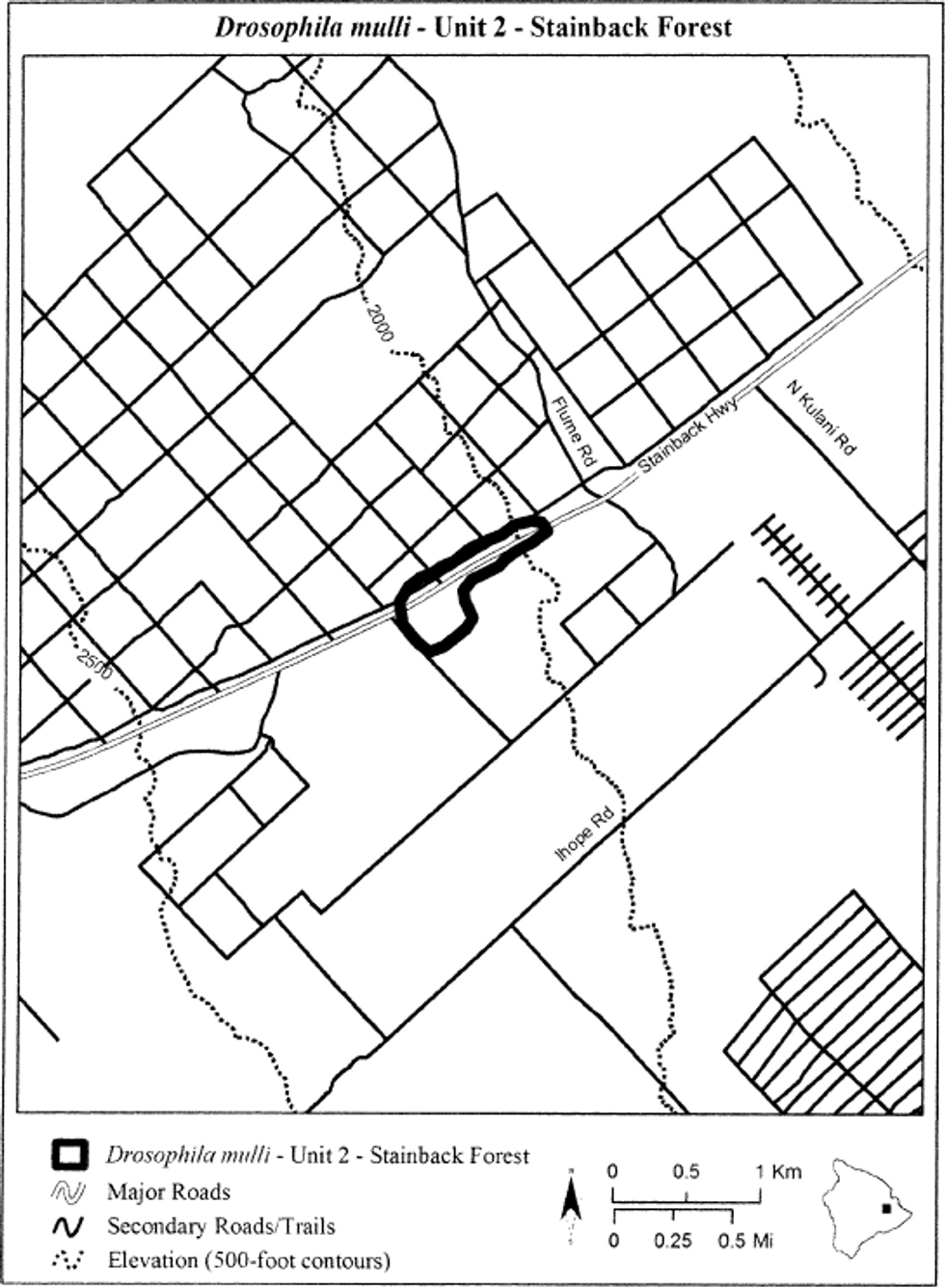
(8) Drosophila mulli - Unit 3 - Waiakea Forest, Hawaii County, island of Hawaii, Hawaii.
(i) Land bounded by the following coordinates: 897021, 2168026; 896225, 2167587; 895745, 2167704; 895687, 2167996; 895745, 2168207; 896014, 2168335; 896480, 2168668; 896841, 2169108; 897302, 2169068; 897522, 2168908; 897482, 2168607.
(ii) Note: Map of Drosophila mulli - Unit 3 - Waiakea Forest follows:
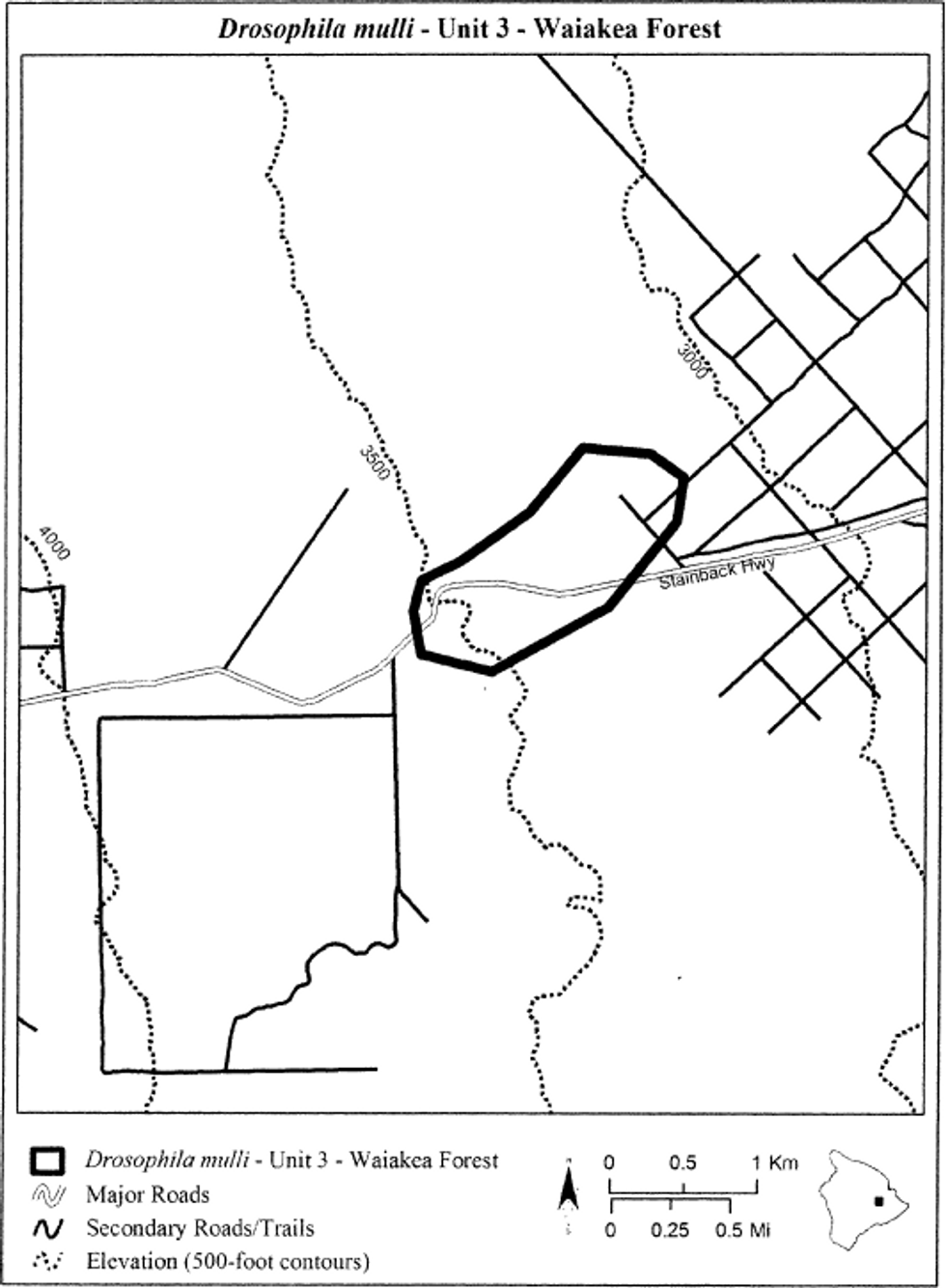
Hawaiian picture-wing fly (Drosophila musaphilia)
(1) Critical habitat is depicted for County of Kauai, island of Kauai, Hawaii, on the map below. The map provided is for informational purposes only.
(2) The primary constituent elements of critical habitat for Drosophila musaphilia are:
(i) Mesic, montane, ohia and koa forest between the elevations of 3,310-3,740 ft (1,009-1,128 m); and
(ii) The larval host plant Acacia koa, which exhibits one or more life stages (from seedlings to senescent individuals).
(3) Critical habitat does not include manmade structures (such as buildings, aqueducts, airports, and roads) and the land on which they are located existing within the legal boundaries on the effective date of this rule.
(4) Critical habitat map unit. Coordinates are in Universal Transverse Mercator (UTM) Zone 4 with units in meters using North American Datum of 1983 (NAD83).
(5) Drosophila musaphilia - Unit 1 - Kokee, Kauai County, island of Kauai, Hawaii.
(i) Land bounded by the following coordinates: 432035, 2448683; 432126, 2448510; 432111, 2448312; 432111, 2448119; 432106, 2447977; 432010, 2447906; 432025, 2447779; 431992, 2447749; 431962, 2447768; 431938, 2447766; 431926, 2447752; 431895, 2447719; 431861, 2447686; 431825, 2447651; 431786, 2447616; 431745, 2447581; 431701, 2447544; 431658, 2447505; 431616, 2447462; 431575, 2447417; 431535, 2447368; 431496, 2447318; 431457, 2447271; 431418, 2447231; 431379, 2447198; 431339, 2447172; 431299, 2447153; 431267, 2447131; 431247, 2447103; 431239, 2447068; 431244, 2447027; 431260, 2446979; 431278, 2446930; 431292, 2446881; 431300, 2446834; 431303, 2446788; 431302, 2446743; 431300, 2446700; 431301, 2446659; 431306, 2446621; 431252, 2446466; 431186, 2446345; 431181, 2446332; 430955, 2445963; 430860, 2445709; 430831, 2445664; 430760, 2445497; 430648, 2445441; 430416, 2445421; 430405, 2445422; 430396, 2445420; 430159, 2445358; 430153, 2445371; 430148, 2445402; 430150, 2445437; 430157, 2445475; 430170, 2445517; 430188, 2445562; 430212, 2445610; 430240, 2445660; 430270, 2445707; 430302, 2445754; 430335, 2445799; 430371, 2445842; 430407, 2445883; 430441, 2445921; 430474, 2445956; 430506, 2445988; 430535, 2446017; 430559, 2446044; 430567, 2446070; 430558, 2446095; 430533, 2446120; 430492, 2446144; 430441, 2446167; 430398, 2446193; 430363, 2446221; 430337, 2446252; 430320, 2446284; 430311, 2446319; 430309, 2446353; 430315, 2446388; 430327, 2446423; 430347, 2446457; 430373, 2446492; 430401, 2446525; 430430, 2446558; 430459, 2446589; 430489, 2446619; 430518, 2446649; 430531, 2446681; 430524, 2446716; 430497, 2446755; 430451, 2446797; 430387, 2446842; 430330, 2446887; 430288, 2446930; 430262, 2446971; 430250, 2447010; 430253, 2447047; 430263, 2447083; 430274, 2447118; 430288, 2447153; 430304, 2447187; 430323, 2447220; 430339, 2447254; 430350, 2447291; 430356, 2447331; 430358, 2447373; 430354, 2447418; 430351, 2447461; 430354, 2447496; 430361, 2447524; 430374, 2447545; 430392, 2447558; 430416, 2447567; 430445, 2447573; 430479, 2447576; 430518, 2447577; 430563, 2447574; 430609, 2447572; 430649, 2447573; 430684, 2447578; 430714, 2447587; 430737, 2447599; 430755, 2447616; 430767, 2447639; 430772, 2447667; 430772, 2447701; 430766, 2447740; 430756, 2447783; 430755, 2447821; 430762, 2447853; 430778, 2447879; 430802, 2447900; 430834, 2447916; 430864, 2447928; 430893, 2447937; 430920, 2447943; 430945, 2447947; 430968, 2447947; 430989, 2447952; 431007, 2447961; 431022, 2447974; 431035, 2447992; 431045, 2448014; 431049, 2448036; 431046, 2448057; 431036, 2448077; 431019, 2448096; 430996, 2448113; 430971, 2448128; 430946, 2448140; 430921, 2448149; 430896, 2448155; 430871, 2448158; 430849, 2448165; 430830, 2448179; 430815, 2448200; 430804, 2448228; 430796, 2448263; 430799, 2448299; 430816, 2448330; 430848, 2448356; 430894, 2448377; 430956, 2448393; 431018, 2448407; 431064, 2448423; 431094, 2448440; 431109, 2448459; 431107, 2448479; 431094, 2448502; 431076, 2448530; 431054, 2448563; 431027, 2448601; 430996, 2448643; 430967, 2448687; 430957, 2448722; 430966, 2448749; 430994, 2448766; 431042, 2448775; 431103, 2448778; 431162, 2448779; 431218, 2448779; 431269, 2448779; 431317, 2448777; 431361, 2448775; 431403, 2448767; 431443, 2448754; 431480, 2448736; 431515, 2448712; 431548, 2448685; 431579, 2448661; 431607, 2448643; 431633, 2448630; 431657, 2448622; 431678, 2448620; 431692, 2448631; 431697, 2448656; 431694, 2448695; 431683, 2448749; 431665, 2448816; 431657, 2448878; 431666, 2448928; 431692, 2448967; 431735, 2448994; 431795, 2449009; 431857, 2449019; 431913, 2449024; 431963, 2449027; 432008, 2449026; 432046, 2449022; 432076, 2449012; 432094, 2448996; 432100, 2448974; 432095, 2448945; 432078, 2448910; 432060, 2448872; 432053, 2448837; 432063, 2448834; 432035, 2448784.
(ii) Note: Map of Drosophila musaphilia - Unit 1 - Kokee follows:
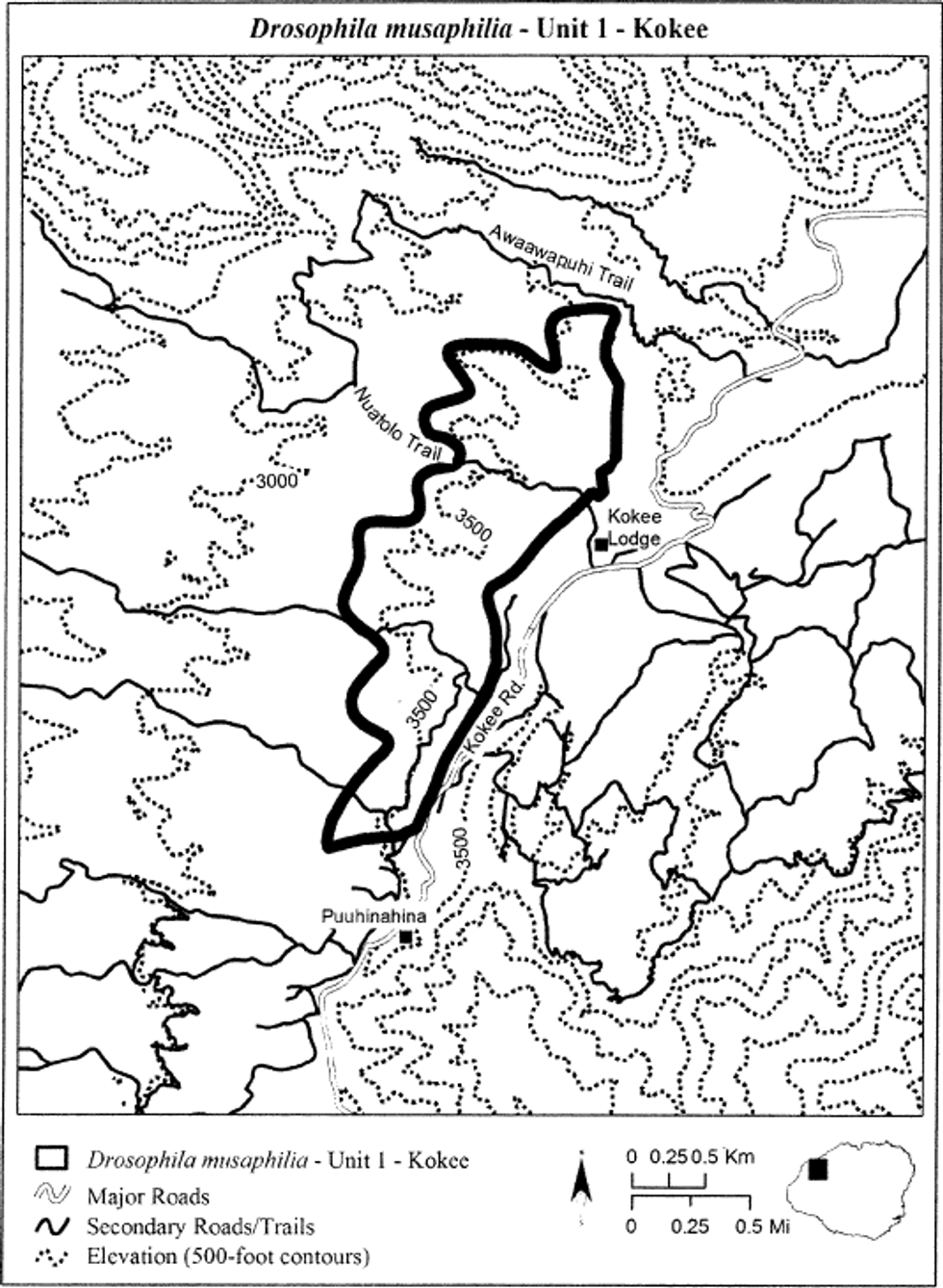
Hawaiian picture-wing fly (Drosophila neoclavisetae)
(1) Critical habitat is depicted for County of Maui, island of Maui, Hawaii, on the map below. The map provided is for informational purposes only.
(2) The primary constituent elements of critical habitat for Drosophila neoclavisetae are:
(i) Wet, montane, ohia forest between the elevations of 3,405-4,590 ft (1,036-1,399 m); and
(ii) The larval host plants Cyanea kunthiana and C. macrostegia ssp. macrostegia, which exhibit one or more life stages (from seedlings to senescent individuals).
(3) Critical habitat does not include manmade structures (such as buildings, aqueducts, airports, and roads) and the land on which they are located existing within the legal boundaries on the effective date of this rule.
(4) Critical habitat map unit. Coordinates are in Universal Transverse Mercator (UTM) Zone 4 with units in meters using North American Datum of 1983 (NAD83).
(5) Drosophila neoclavisetae - Unit 1 - Puu Kukui, Maui County, island of Maui, Hawaii.
(i) Land bounded by the following coordinates: 749957, 2315007; 750017, 2314927; 750054, 2314874; 750054, 2314874; 750070, 2314854; 750070, 2314854; 750070, 2314853; 750070, 2314853; 750095, 2314828; 750095, 2314828; 750095, 2314828; 750118, 2314807; 750118, 2314807; 750118, 2314806; 750119, 2314806; 750119, 2314806; 750137, 2314795; 750137, 2314795; 750137, 2314795; 750137, 2314795; 750138, 2314795; 750138, 2314795; 750172, 2314783; 750197, 2314770; 750214, 2314760; 750222, 2314756; 750222, 2314756; 750222, 2314756; 750231, 2314751; 750244, 2314735; 750244, 2314735; 750244, 2314735; 750245, 2314735; 750263, 2314718; 750263, 2314718; 750263, 2314718; 750283, 2314702; 750381, 2314361; 750381, 2314360; 750421, 2314232; 750421, 2314232; 750421, 2314232; 750421, 2314231; 750421, 2314231; 750421, 2314231; 750422, 2314231; 750422, 2314230; 750422, 2314230; 750402, 2314210; 750397, 2314126; 750357, 2314098; 750329, 2314098; 750312, 2314143; 750290, 2314227; 750239, 2314244; 750194, 2314227; 750133, 2314238; 750076, 2314255; 750009, 2314238; 749958, 2314259; 749885, 2314289; 749773, 2314435; 749721, 2314492; 749520, 2314710; 749515, 2314969; 749509, 2315036; 749509, 2315093; 749565, 2315087; 749649, 2315036; 749739, 2314991; 749756, 2315031; 749655, 2315132; 749599, 2315244; 749554, 2315340; 749458, 2315407; 749368, 2315480; 749254, 2315543; 749183, 2315602; 749145, 2315636; 749117, 2315676; 749125, 2315679; 749125, 2315679; 749125, 2315679; 749125, 2315679; 749125, 2315678; 749125, 2315678; 749126, 2315678; 749126, 2315678; 749126, 2315677; 749138, 2315668; 749138, 2315668; 749172, 2315644; 749172, 2315644; 749172, 2315644; 749172, 2315644; 749172, 2315644; 749186, 2315637; 749203, 2315624; 749221, 2315611; 749221, 2315611; 749221, 2315611; 749222, 2315611; 749222, 2315611; 749222, 2315611; 749243, 2315602; 749331, 2315566; 749351, 2315553; 749351, 2315553; 749383, 2315533; 749383, 2315533; 749383, 2315533; 749403, 2315522; 749419, 2315511; 749468, 2315475; 749476, 2315462; 749483, 2315449; 749483, 2315449; 749484, 2315449; 749484, 2315449; 749498, 2315429; 749498, 2315429; 749498, 2315428; 749522, 2315400; 749522, 2315400; 749522, 2315400; 749522, 2315400; 749523, 2315399; 749523, 2315399; 749523, 2315399; 749548, 2315382; 749548, 2315382; 749548, 2315382; 749570, 2315370; 749570, 2315370; 749570, 2315370; 749616, 2315349; 749626, 2315340; 749626, 2315340; 749627, 2315340; 749650, 2315324; 749664, 2315305; 749675, 2315287; 749679, 2315278; 749679, 2315278; 749679, 2315278; 749679, 2315278; 749680, 2315278; 749698, 2315255; 749698, 2315254; 749698, 2315254; 749718, 2315234; 749718, 2315234; 749718, 2315234; 749718, 2315233; 749718, 2315233; 749734, 2315222; 749779, 2315184; 749779, 2315184; 749780, 2315183; 749780, 2315183; 749780, 2315183; 749802, 2315170; 749831, 2315145; 749872, 2315096; 749872, 2315096; 749872, 2315096; 749872, 2315096; 749873, 2315095; 749873, 2315095; 749886, 2315085; 749931, 2315044; 749957, 2315008.
(ii) Note: Map of Drosophila neoclavisetae - Unit 1 - Puu Kukui follows:
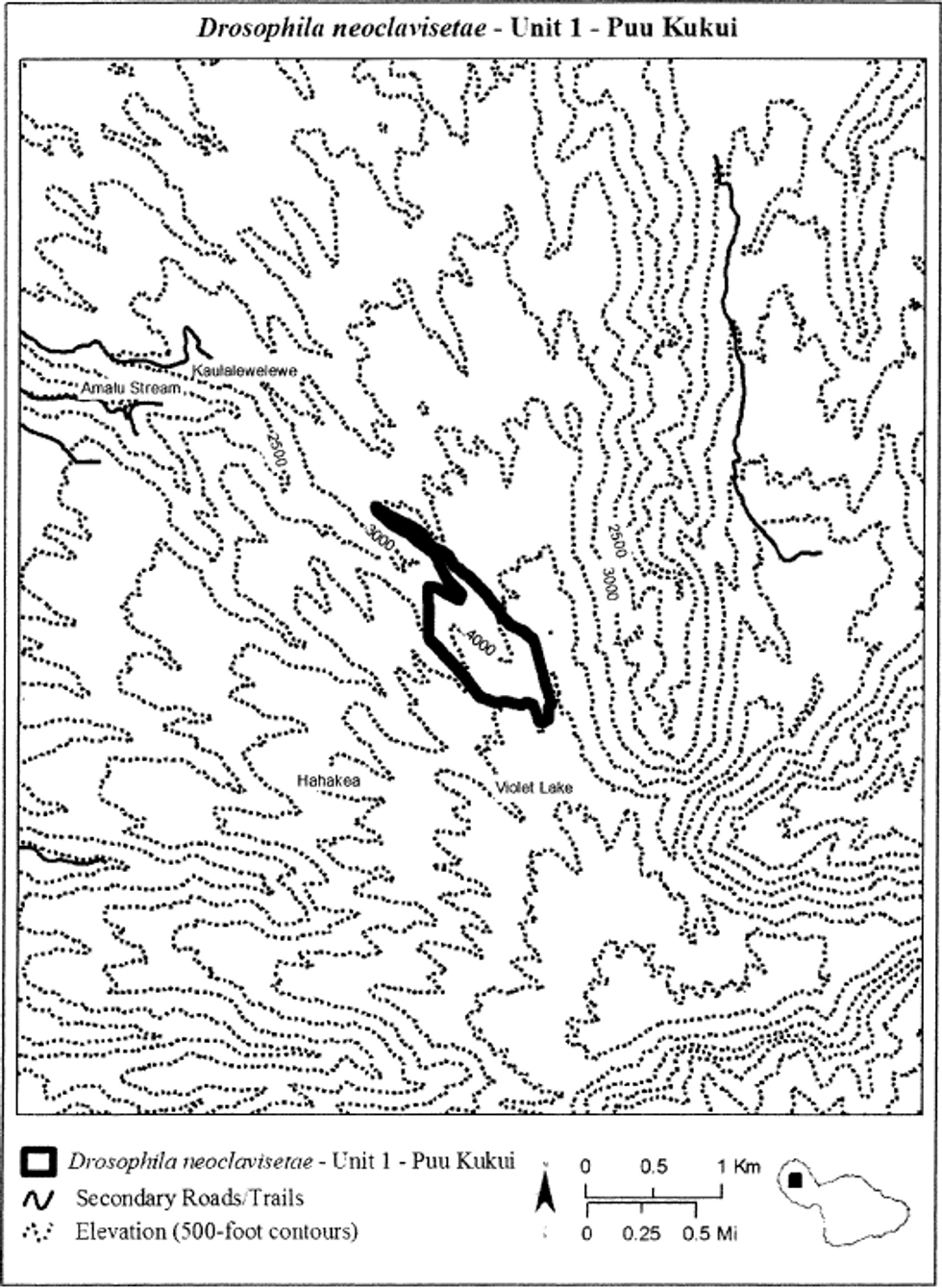
Hawaiian picture-wing fly (Drosophila obatai)
(1) Critical habitat is depicted for County of Honolulu, island of Oahu, Hawaii, on the maps below. The maps provided are for informational purposes only.
(2) The primary constituent elements of critical habitat for Drosophila obatai are:
(i) Dry to mesic, lowland, ohia and koa forest between the elevations of 1,475-2,535 ft (450-773 m); and
(ii) The larval host plant Pleomele forbesii, which exhibits one or more life stages (from seedlings to senescent individuals).
(3) Critical habitat does not include manmade structures (such as buildings, aqueducts, airports, and roads) and the land on which they are located existing within the legal boundaries on the effective date of this rule.
(4) Critical habitat map units. Coordinates are in Universal Transverse Mercator (UTM) Zone 4 with units in meters using North American Datum of 1983 (NAD83).
(5) Note: Index map of the critical habitat units for Drosophila obatai follows:
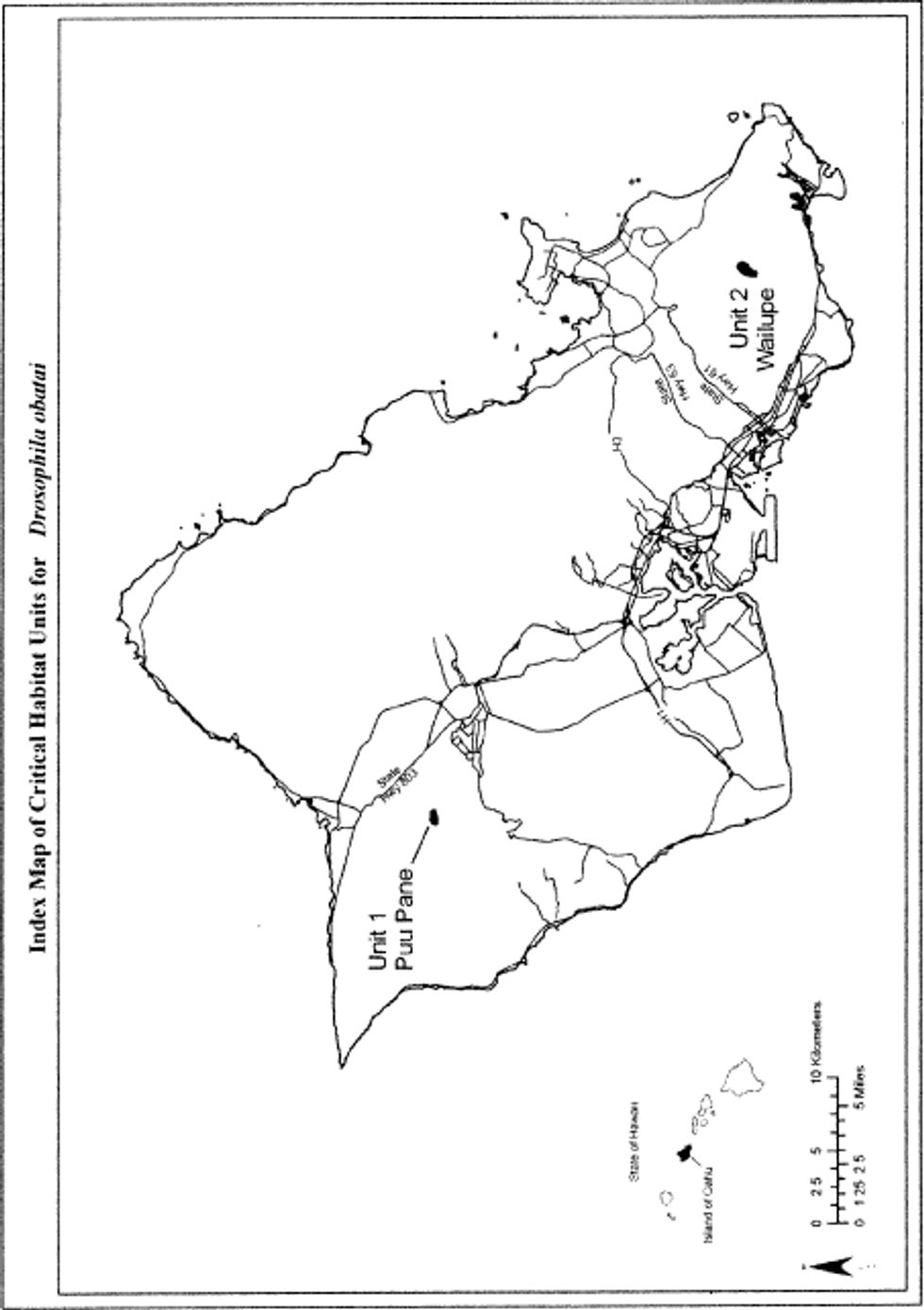
(6) Drosophila obatai - Unit 1 - Puu Pane, City and County of Honolulu, island of Oahu, Hawaii.
(i) Land bounded by the following coordinates: 591489, 2379704; 591662, 2379690; 591807, 2379704; 591822, 2379699; 591901, 2379571; 591871, 2379579; 591830, 2379596; 591830, 2379596; 591830, 2379596; 591830, 2379596; 591830, 2379596; 591830, 2379596; 591830, 2379596; 591791, 2379600; 591791, 2379600; 591791, 2379601; 591791, 2379600; 591791, 2379600; 591791, 2379600; 591766, 2379597; 591766, 2379597; 591766, 2379597; 591766, 2379597; 591766, 2379597; 591766, 2379597; 591766, 2379597; 591741, 2379583; 591741, 2379583; 591710, 2379565; 591672, 2379554; 591672, 2379554; 591635, 2379542; 591614, 2379537; 591614, 2379537; 591614, 2379537; 591582, 2379526; 591582, 2379526; 591582, 2379526; 591582, 2379526; 591582, 2379526; 591545, 2379500; 591523, 2379495; 591496, 2379495; 591461, 2379505; 591461, 2379505; 591461, 2379505; 591461, 2379505; 591461, 2379505; 591461, 2379505; 591461, 2379505; 591461, 2379505; 591461, 2379505; 591444, 2379502; 591444, 2379502; 591444, 2379502; 591444, 2379502; 591444, 2379502; 591432, 2379498; 591421, 2379497; 591421, 2379497; 591421, 2379497; 591421, 2379497; 591421, 2379497; 591420, 2379497; 591420, 2379497; 591420, 2379497; 591420, 2379497; 591420, 2379497; 591405, 2379487; 591405, 2379487; 591405, 2379487; 591405, 2379486; 591405, 2379486; 591405, 2379486; 591403, 2379483; 591354, 2379454; 591283, 2379460; 591240, 2379449; 591113, 2379474; 591116, 2379531; 591169, 2379618; 591284, 2379716; 591345, 2379723.
(ii) Note: Map of Drosophila obatai - Unit 1 - Puu Pane follows:
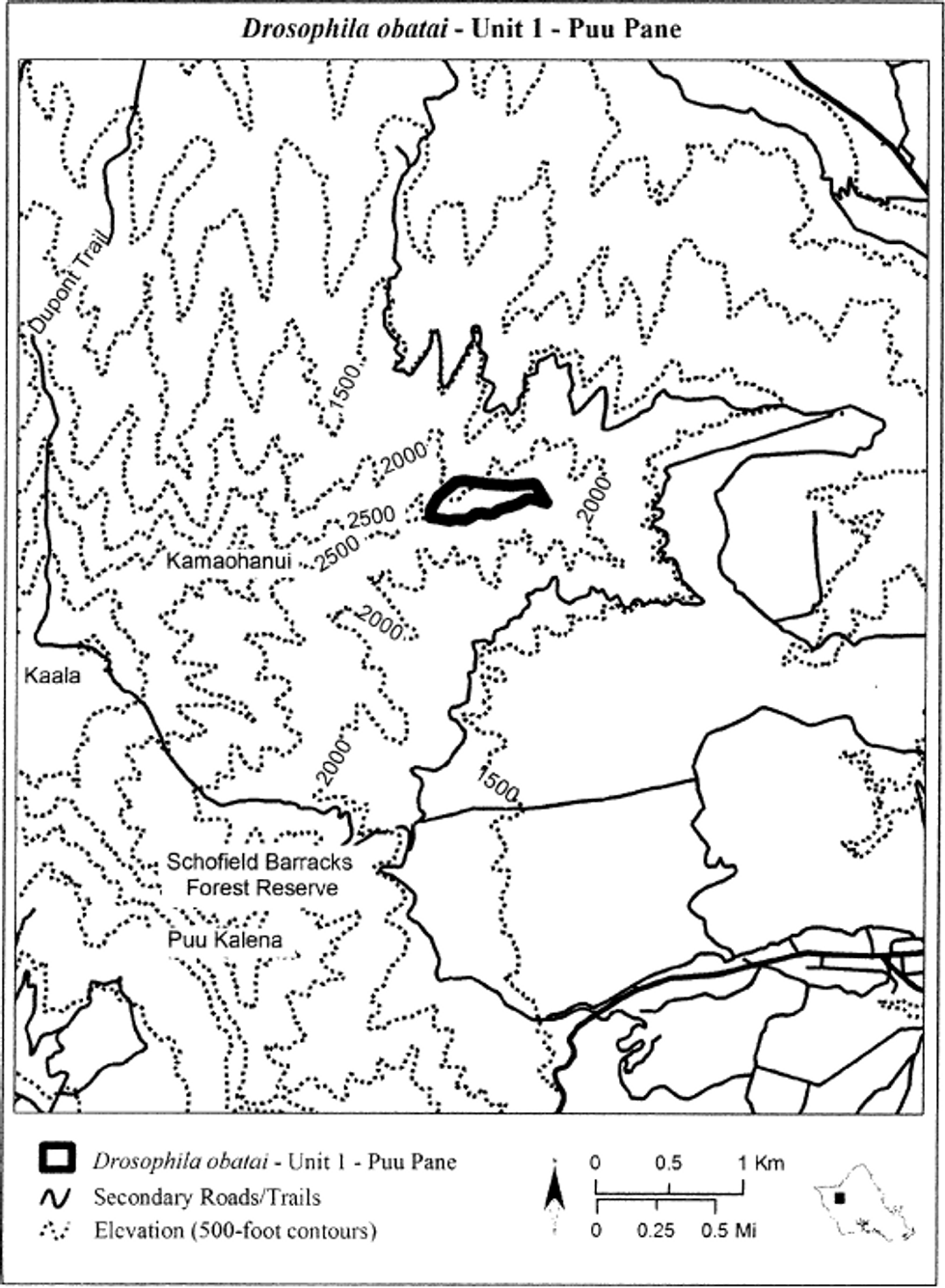
(7) Drosophila obatai - Unit 2 - Wailupe, City and County of Honolulu, island of Oahu, Hawaii.
(i) Land bounded by the following coordinates: 629222, 2358352; 629208, 2358307; 629199, 2358225; 629147, 2358205; 629100, 2358307; 629048, 2358343; 629028, 2358316; 629023, 2358250; 629005, 2358174; 628908, 2358169; 628890, 2358110; 628922, 2358034; 628883, 2358011; 628795, 2358007; 628791, 2357939; 628753, 2357885; 628759, 2357799; 628705, 2357743; 628676, 2357619; 628606, 2357592; 628536, 2357607; 628552, 2357673; 628610, 2357731; 628574, 2357806; 628559, 2357874; 628619, 2357932; 628637, 2357973; 628635, 2358074; 628660, 2358185; 628735, 2358298; 628775, 2358411; 628936, 2358634; 629070, 2358711; 629243, 2358647; 629307, 2358506.
(ii) Note: Map of Drosophila obatai - Unit 2 - Wailupe follows:
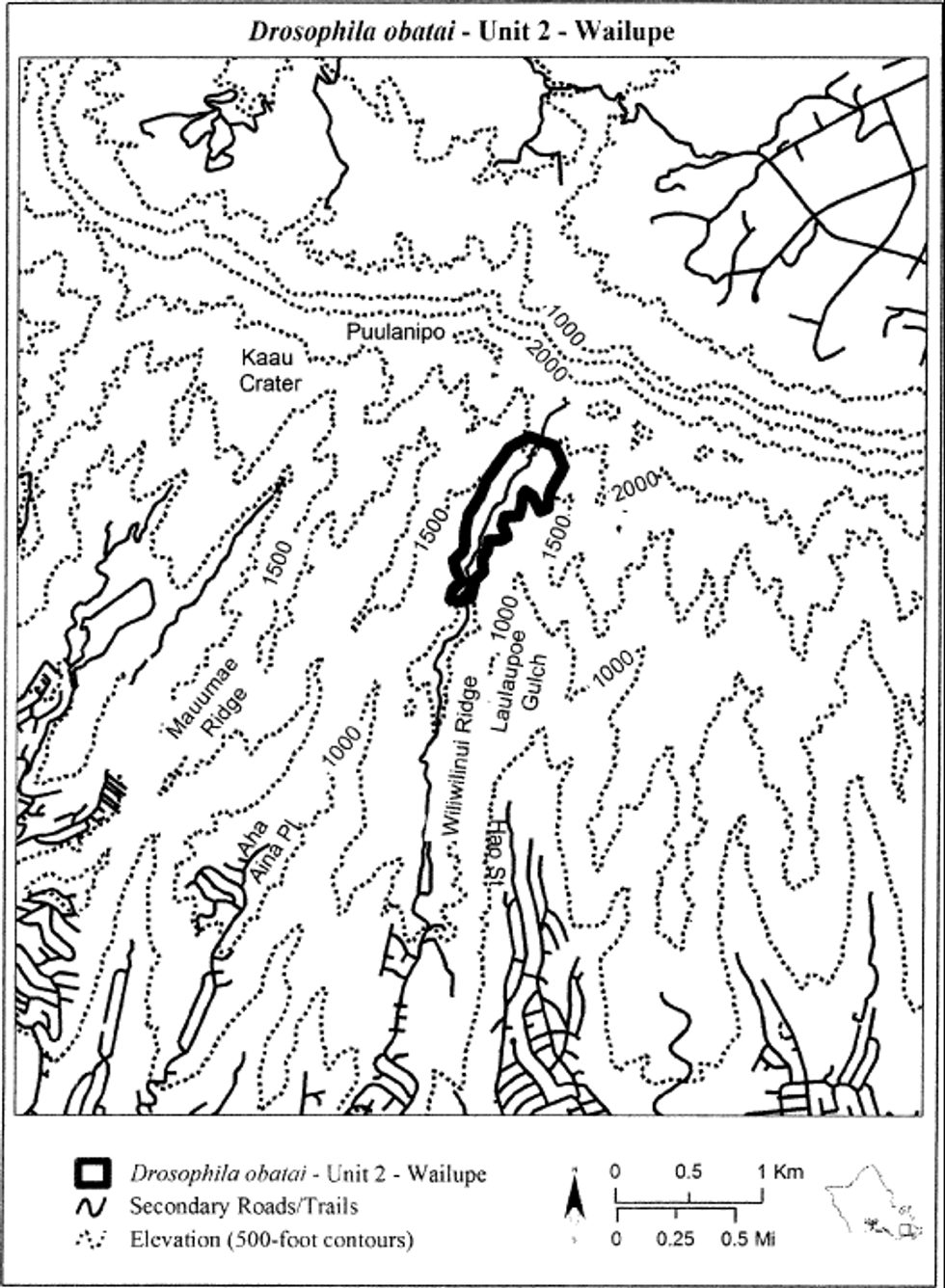
Hawaiian picture-wing fly (Drosophila ochrobasis)
(1) Critical habitat units are depicted for County of Hawaii, island of Hawaii, Hawaii, on the maps below. The maps provided are for informational purposes only.
(2) The primary constituent elements of critical habitat for Drosophila ochrobasis are:
(i) Mesic to wet, montane, ohia, koa, and Cheirodendron sp. forest between the elevations of 3,850-5,390 ft (1,173-1,643 m); and
(ii) The larval host plants Clermontia calophylla, C. clermontioides, C. clermontioides ssp. rockiana, C. drepanomorpha, C. hawaiiensis, C. kohalae, C. lindseyana, C. montis-loa, C. parviflora, C. peleana, C. pyrularia, C. waimeae, Marattia douglasii, Myrsine lanaiensis, M. lessertiana, and M. sandwicensis, which exhibit one or more life stages (from seedlings to senescent individuals).
(3) Critical habitat does not include manmade structures (such as buildings, aqueducts, airports, and roads) and the land on which they are located existing within the legal boundaries on the effective date of this rule.
(4) Critical habitat map units. Coordinates are in Universal Transverse Mercator (UTM) Zone 4 with units in meters using North American Datum of 1983 (NAD83).
(5) Note: Index map of critical habitat units for Drosophila ochrobasis follows:
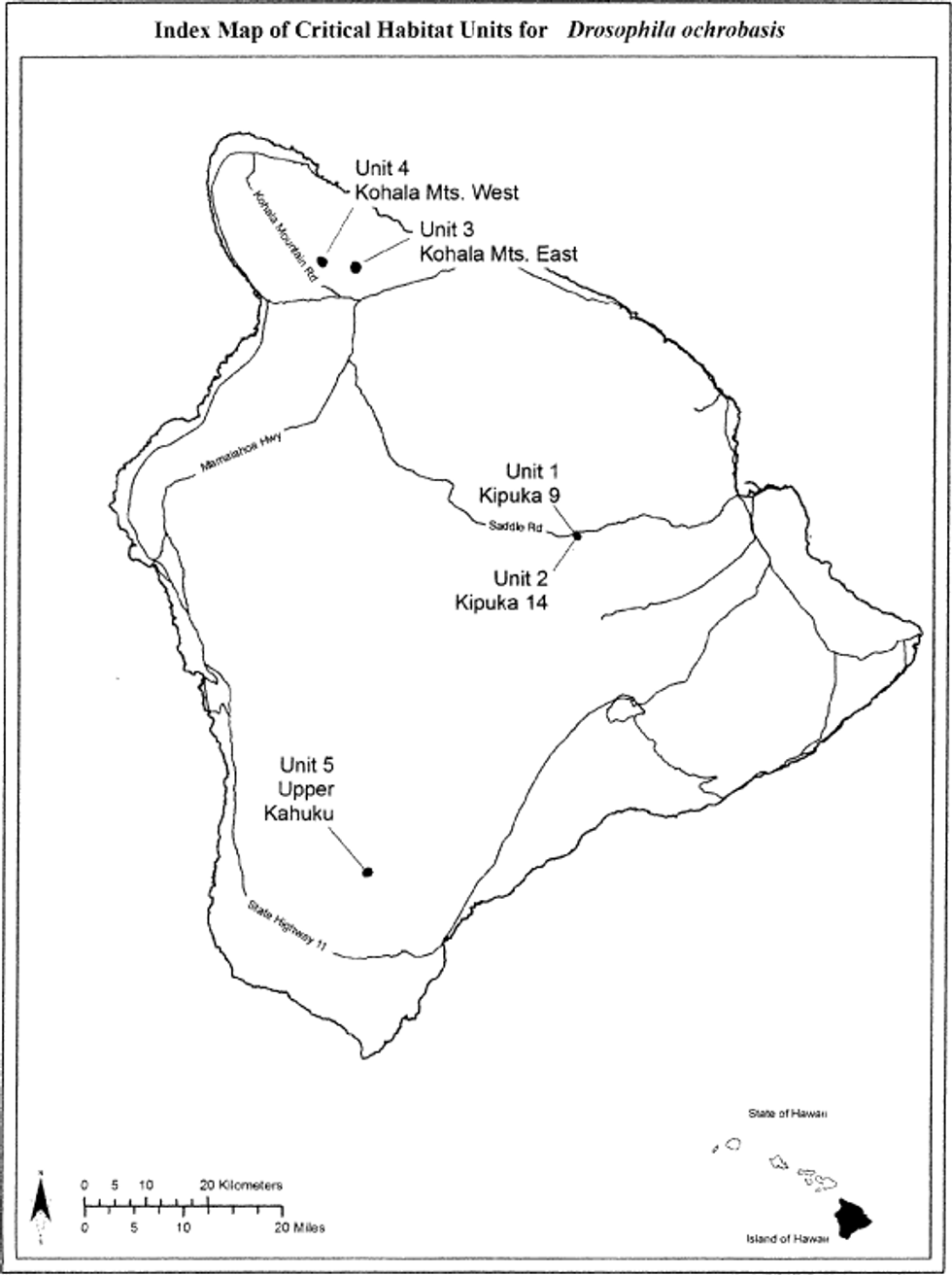
(6) Drosophila ochrobasis - Unit 1 - Kipuka 9, Hawaii County, island of Hawaii, Hawaii.
(i) Land bounded by the following coordinates: 884112, 2179392; 884090, 2179333; 884069, 2179303; 884023, 2179281; 883971, 2179292; 883936, 2179295; 883896, 2179273; 883855, 2179287; 883825, 2179319; 883828, 2179335; 883861, 2179349; 883869, 2179346; 883885, 2179346; 883888, 2179373; 883893, 2179409; 883896, 2179441; 883934, 2179473; 883985, 2179484; 884036, 2179444; 884112, 2179409.
(ii) Note: Map of Drosophila ochrobasis - Unit 1 - Kipuka 9 follows:
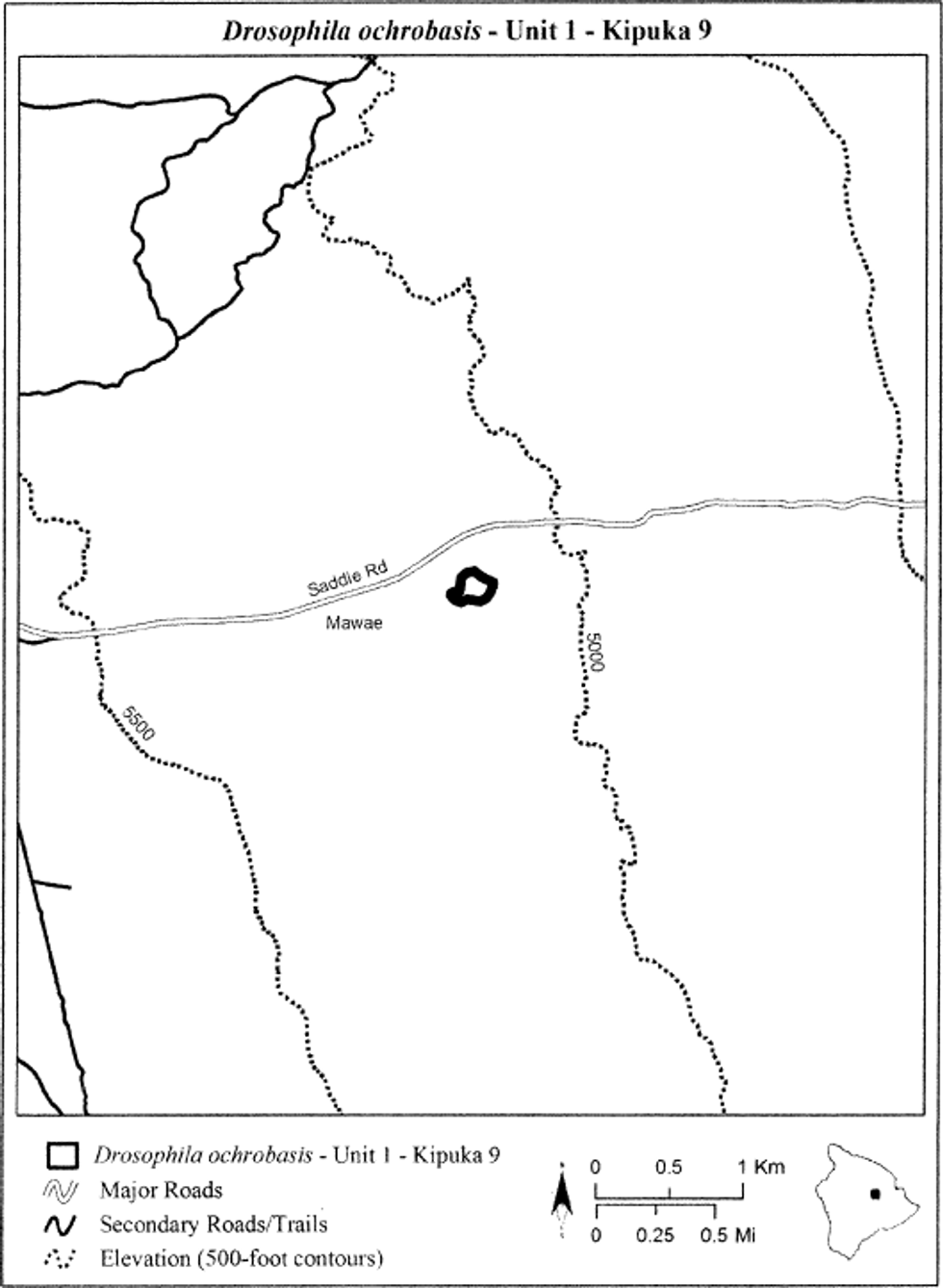
(7) Drosophila ochrobasis - Unit 2 - Kipuka 14, Hawaii County, island of Hawaii, Hawaii.
(i) Land bounded by the following coordinates: 884379, 2179103; 884375, 2179051; 884351, 2178992; 884320, 2178889; 884264, 2178832; 884236, 2178818; 884211, 2178834; 884141, 2178891; 884099, 2178924; 884064, 2178929; 884026, 2178959; 884026, 2178976; 884052, 2178983; 884071, 2179008; 884101, 2179013; 884137, 2179021; 884160, 2179035; 884148, 2179051; 884151, 2179065; 884210, 2179063; 884208, 2179084; 884242, 2179101; 884280, 2179131; 884323, 2179146; 884365, 2179146.
(ii) Note: Map of Drosophila ochrobasis - Unit 2 - Kipuka 14 follows:
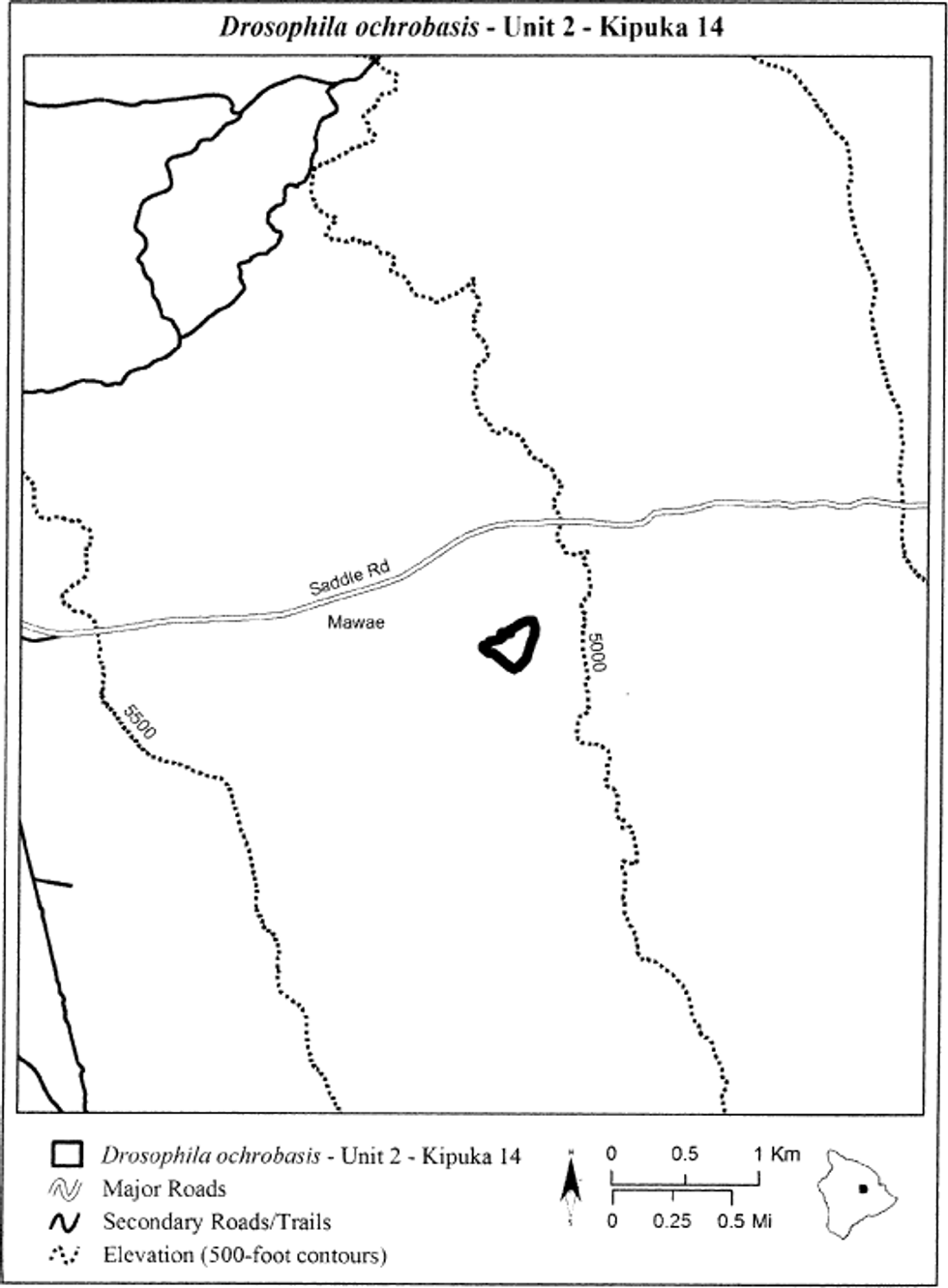
(8) Drosophila ochrobasis - Unit 3 - Kohala Mountains East, Hawaii County, island of Hawaii, Hawaii.
(i) Land bounded by the following coordinates: 848091, 2222077; 847912, 2222077; 847578, 2222142; 847461, 2222323; 847396, 2222654; 847508, 2222900; 847620, 2223146; 847773, 2223179; 848104, 2223079; 848172, 2222934; 848235, 2222798; 848327, 2222764; 848361, 2222693; 848350, 2222595; 848317, 2222476; 848177, 2222184.
(ii) Note: Map of Drosophila ochrobasis - Unit 3 - Kohala Mountains East follows:
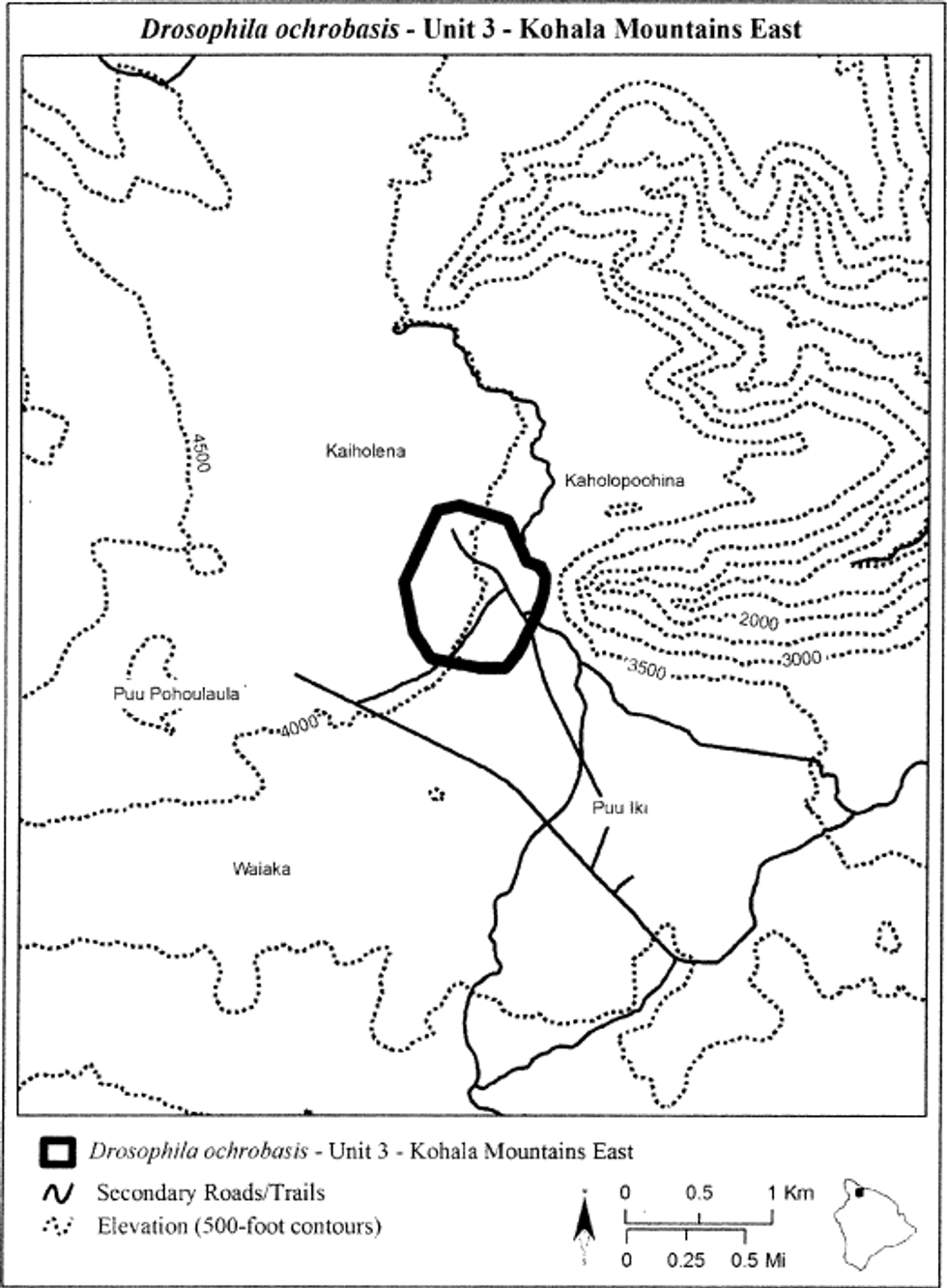
(9) Drosophila ochrobasis - Unit 4 - Kohala Mountains West, Hawaii County, island of Hawaii, Hawaii.
(i) Land bounded by the following coordinates: 841990, 2224000; 842156, 2223966; 842268, 2223966; 842486, 2223897; 842666, 2223757; 842803, 2223586; 842840, 2223426; 842812, 2223314; 842758, 2223157; 842584, 2223047; 842430, 2223096; 842355, 2223157; 842260, 2223278; 842154, 2223345; 842020, 2223634; 841988, 2223746; 841967, 2223882.
(ii) Note: Map of Drosophila ochrobasis - Unit 4 - Kohala Mountains West follows:
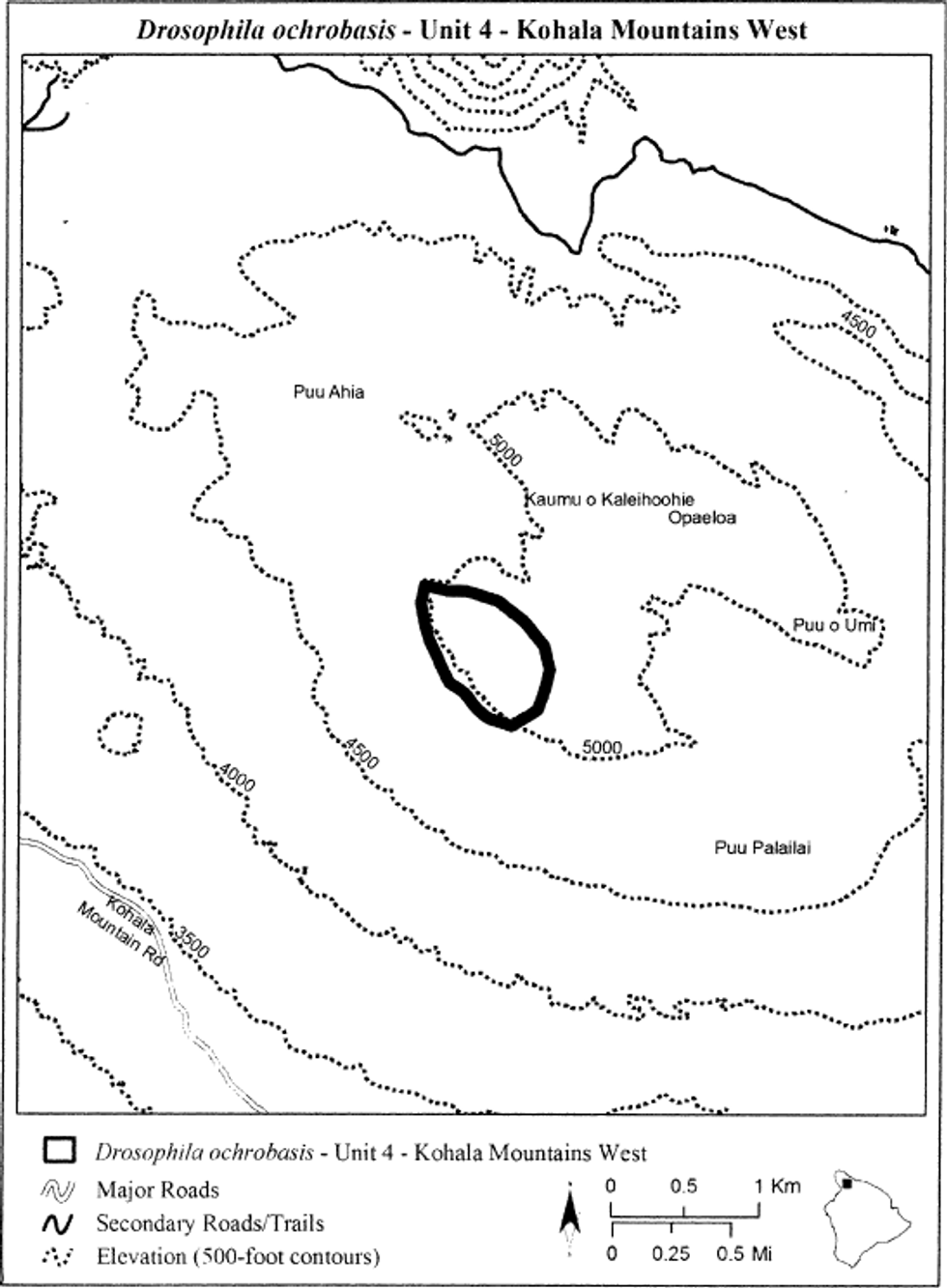
(10) Drosophila ochrobasis - Unit 5 - Upper Kahuku, Hawaii County, island of Hawaii, Hawaii.
(i) Land bounded by the following coordinates: 850211, 2124185; 849989, 2124179; 849874, 2124347; 849874, 2124516; 849975, 2124603; 850177, 2124724; 850332, 2124866; 850474, 2124900; 850589, 2124832; 850669, 2124785; 850690, 2124684; 850669, 2124549; 850508, 2124448; 850339, 2124320.
(ii) Note: Map of Drosophila ochrobasis - Unit 5 - Upper Kahuku follows:
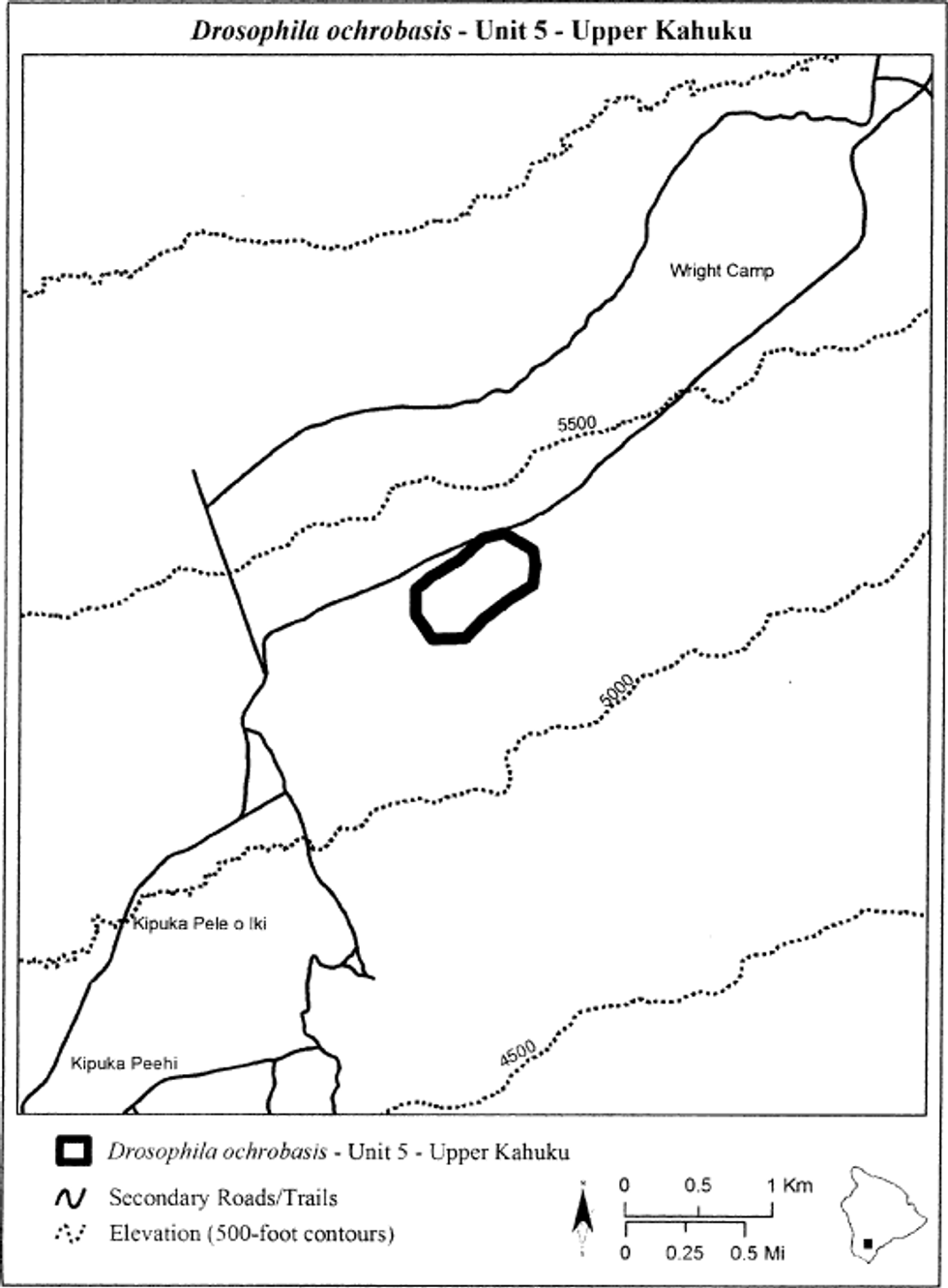
Hawaiian picture-wing fly (Drosophila sharpi)
(1) Critical habitat units are depicted for Kauai County, Hawaii, on the maps below. The maps provided are for informational purposes only.
(2) Primary constituent elements.
(i) In units 1, 2, and 3, the primary constituent elements of critical habitat for Hawaiian picture-wing fly (Drosophila sharpi) are:
(A) Elevation: 3,000 to 5,243 ft (914 to 1,598 m).
(B) Annual precipitation: 50 to 75 inches (127 to 190 centimeters).
(C) Substrate: Weathered aa lava flows, rocky mucks, thin silty loams, deep volcanic ash soils.
(D) Canopy: Acacia, Metrosideros, Psychotria, Tetraplasandra, Zanthoxylum.
(E) Subcanopy: Cheirodendron, Coprosma, Kadua, Ilex, Myoporum, Myrsine.
(F) Understory: Bidens, Dryopteris, Leptecophylla, Poa, Scaevola, Sophora.
(G) Larval host plants (Cheirodendron sp., Tetraplasandra sp.).
(ii) In units 4, 5, and 6, the primary constituent elements of critical habitat for Hawaiian picture-wing fly (Drosophila sharpi) are:
(A) Elevation: 3,000 to 5,243 ft (914 to 1,598 m).
(B) Annual precipitation: Greater than 75 inches (190 centimeters).
(C) Substrate: Well-developed soils, montane bogs.
(D) Canopy: Acacia, Charpentiera, Cheirodendron, Metrosideros.
(E) Subcanopy: Broussaisia, Cibotium, Eurya, Ilex, Myrsine.
(F) Understory: Ferns, Carex, Coprosma, Leptecophylla, Oreobolus, Rhynchospora, Vaccinium.
(G) Larval host plants (Cheirodendron sp., Tetraplasandra sp.).
(3) Manmade features and structures, such as buildings, roads, railroads, airports, runways, other paved areas, lawns, and other urban landscaped areas, existing on the effective date of this rule do not contain one or more of the primary constituent elements.
(4) Critical habitat maps. Maps were created in GIS, with coordinates in UTM Zone 4 with units in meters using North American datum of 1983 (NAD 83).
(5) Index map of critical habitat units for Hawaiian picture-wing fly (Drosophila sharpi) follows:
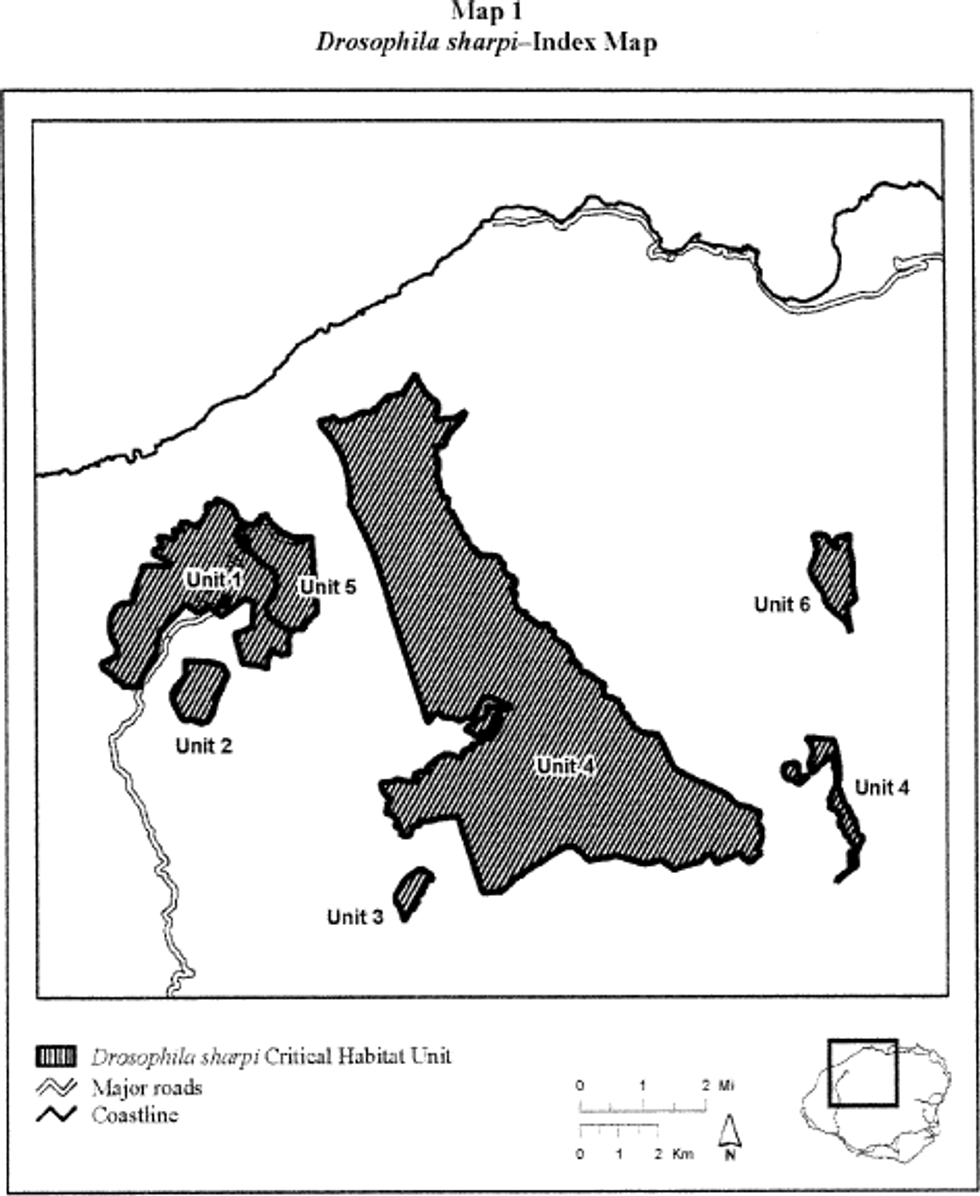
(6) Unit 1-Montane Mesic, Kauai County, Hawaii.
(i) Unit 1-Montane Mesic consists of 2,422.6 ac (980.4 ha) and includes land bounded by the following UTM Zone 4, NAD83 coordinates (E, N): 430107, 2447429; 430242, 2447664; 430073, 2447126; 430793, 2448310; 430124, 2446907; 430393, 2447748; 430690, 2447765; 430671, 2447997; 430764, 2448188; 430886, 2448507; 430903, 2448664; 430985, 2448705; 431560, 2448675; 431414, 2448890; 430291, 2446570; 431058, 2446300; 431200, 2449070; 431362, 2449169; 431171, 2448699; 430854, 2445930; 432530, 2450196; 431391, 2449273; 431323, 2447013; 431211, 2446394; 431101, 2446447; 431112, 2446394; 431069, 2446331; 431007, 2446203; 430944, 2446145; 430902, 2445976; 430191, 2446386; 430826, 2445805; 430857, 2445727; 430824, 2445631; 430442, 2445640; 430323, 2445779; 430204, 2445809; 430191, 2445898; 429898, 2446100; 429871, 2446234; 430939, 2446061; 432796, 2450365; 432504, 2449961; 432579, 2450036; 432552, 2450080; 432551, 2450083; 432001, 2447726; 432534, 2450174; 431629, 2448739; 432565, 2450262; 432531, 2450116; 432740, 2450249; 432441, 2449848; 432808, 2450383; 432882, 2450351; 432904, 2450341; 432827, 2447751; 432932, 2447668; 433014, 2447717; 433109, 2447775; 433094, 2447922; 432560, 2450267; 431875, 2449780; 431322, 2449418; 431403, 2449436; 431727, 2449372; 431769, 2449447; 431705, 2449569; 431720, 2449620; 431805, 2449591; 431919, 2449578; 432498, 2449952; 431904, 2449665; 432486, 2449909; 432046, 2449781; 432052, 2449783; 432113, 2449740; 432217, 2449712; 432251, 2449685; 432259, 2449679; 432344, 2449744; 432419, 2449806; 431322, 2449372; 431905, 2449660; 434486, 2447126; 434073, 2448685; 434228, 2448620; 434292, 2448479; 434318, 2448298; 434279, 2447951; 434163, 2447783; 434086, 2447693; 434073, 2447500; 434623, 2446526; 434357, 2447229; 433545, 2449136; 434627, 2447088; 434686, 2447020; 434682, 2447017; 434657, 2446977; 434652, 2446933; 434612, 2446807; 434641, 2446663; 434631, 2446528; 434202, 2447345; 433399, 2449709; 431205, 2448983; 432073, 2447674; 433046, 2450280; 433196, 2450196; 433287, 2450063; 433353, 2449880; 433467, 2449787; 433429, 2449741; 433880, 2448827; 433407, 2449708; 433725, 2448994; 433401, 2449697; 433339, 2449600; 433313, 2449484; 433339, 2449381; 433368, 2449293; 433368, 2449292; 433369, 2449255; 433389, 2449256; 434254, 2447886; 433408, 2449708; 433527, 2447856; 434086, 2446095; 433862, 2446165; 433606, 2446193; 433449, 2446235; 433397, 2446440; 433257, 2446958; 433577, 2447086; 433706, 2447138; 434090, 2446098; 433562, 2447841; 432639, 2447624; 432918, 2447407; 432672, 2447598; 434620, 2446512; 432609, 2447647; 434318, 2448182; 432195, 2447587; 432136, 2447629; 432133, 2447631; 432081, 2447668; 433746, 2447766; 434500, 2446448; 432320, 2447497; 434103, 2446297; 434618, 2446459; 434582, 2446443; 434558, 2446439; 434514, 2446449; 434471, 2446422; 434457, 2446416; 434447, 2446420; 434392, 2446421; 434423, 2446441; 434416, 2446441; 434625, 2446467; 434201, 2446573; 434403, 2446435; 434628, 2446479; 434400, 2446429; 434434, 2446428; 434386, 2446429; 434533, 2446441.
(ii) Map of Unit 1-Montane Mesic for Hawaiian picture-wing fly (Drosophila sharpi) follows:
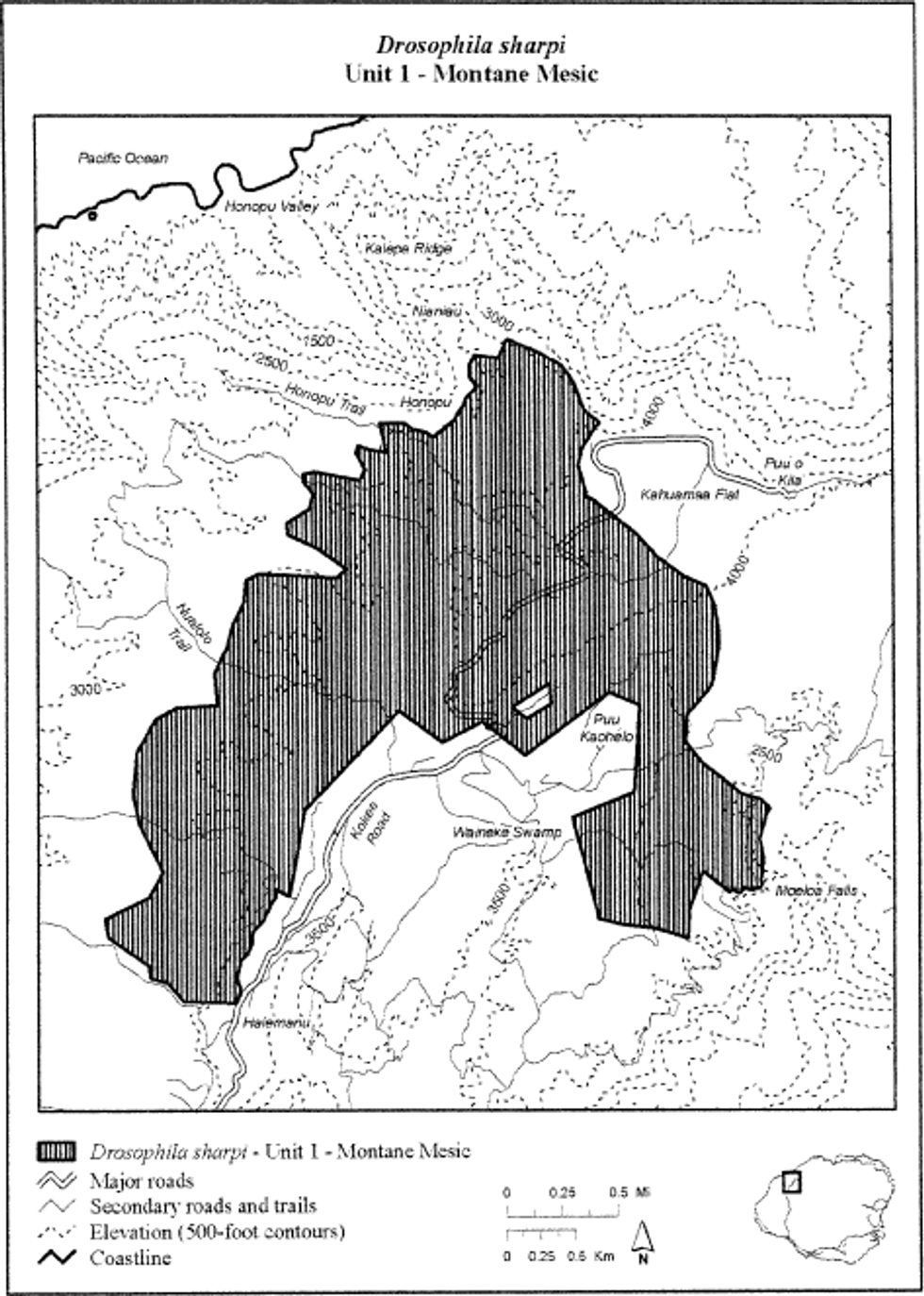
(7) Unit 2-Montane Mesic, Kauai County, Hawaii.
(i) Unit 2-Montane Mesic consists of 375.6 ac (152.0 ha) and includes land bounded by the following UTM Zone 4, NAD83 coordinates (E, N): 431975, 2446280; 432559, 2446255; 432659, 2446240; 432948, 2446150; 433067, 2445928; 432758, 2445304; 432001, 2445941; 431873, 2444849; 432912, 2445580; 432674, 2444970; 431626, 2445435; 431730, 2445114; 431950, 2444792; 432135, 2444807; 432377, 2444722; 432548, 2444752; 431645, 2445326; 431736, 2445617.
(ii) Map of Unit 2-Montane Mesic for Hawaiian picture-wing fly (Drosophila sharpi) follows:
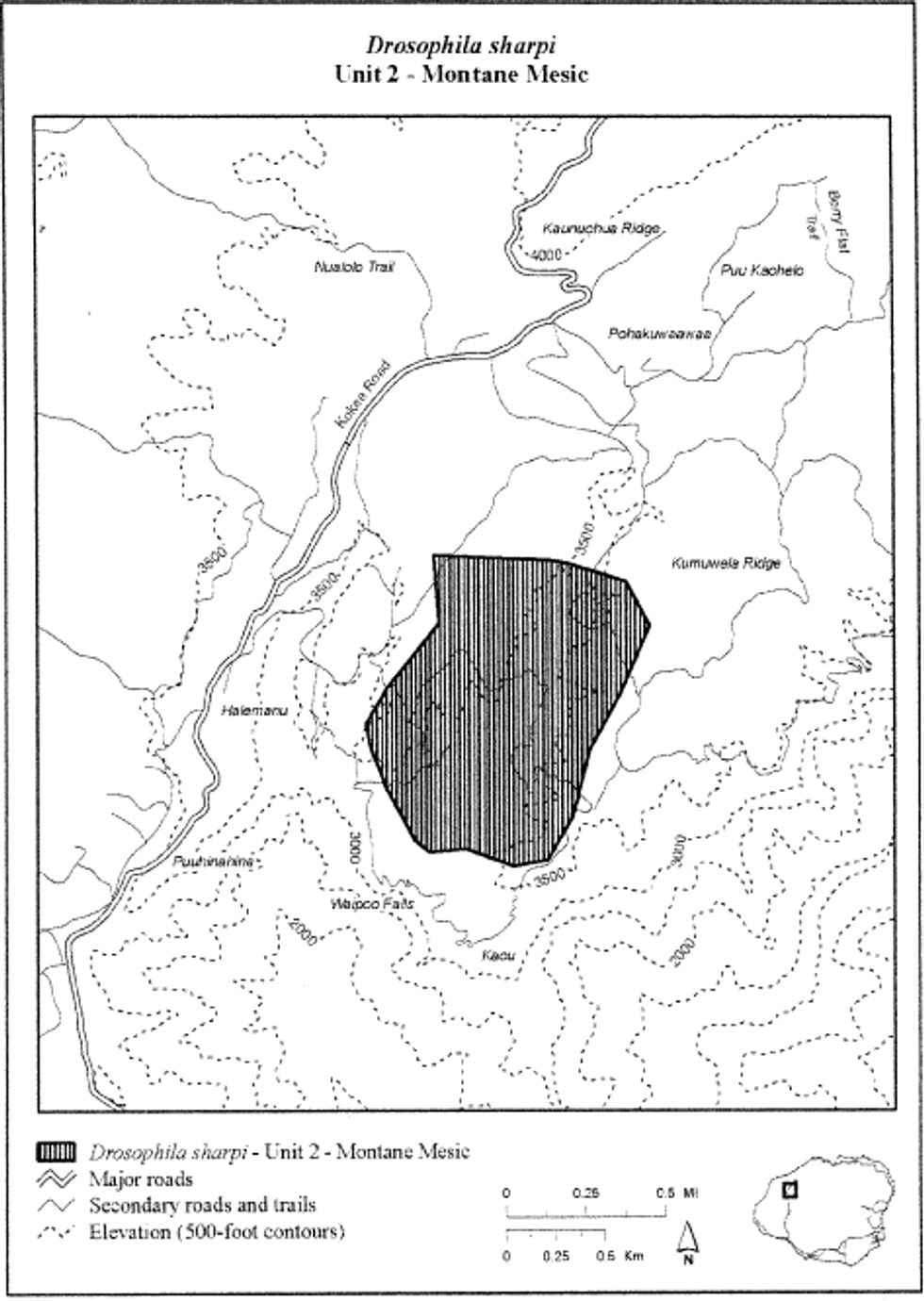
(8) Unit 3-Montane Mesic, Kauai County, Hawaii.
(i) Unit 3-Montane Mesic consists of 138.5 ac (56.0 ha) and includes land bounded by the following UTM Zone 4, NAD83 coordinates (E, N): 438012, 2440389; 438014, 2440437; 438023, 2440484; 438111, 2440652; 438112, 2440588; 437817, 2440071; 438028, 2440577; 437922, 2440355; 437336, 2440335; 437912, 2440201; 437827, 2440132; 437785, 2440013; 437687, 2439960; 437636, 2439819; 437870, 2440140; 437545, 2439761; 438149, 2440714; 437529, 2439721; 437987, 2441027; 437450, 2440047; 437335, 2440180; 437335, 2440329; 438159, 2440914; 438249, 2440857; 438253, 2440854; 438243, 2440830; 438287, 2440738; 437602, 2440771; 438227, 2440730; 437586, 2439743.
(ii) Map of Unit 3-Montane Mesic for Hawaiian picture-wing fly (Drosophila sharpi) follows:
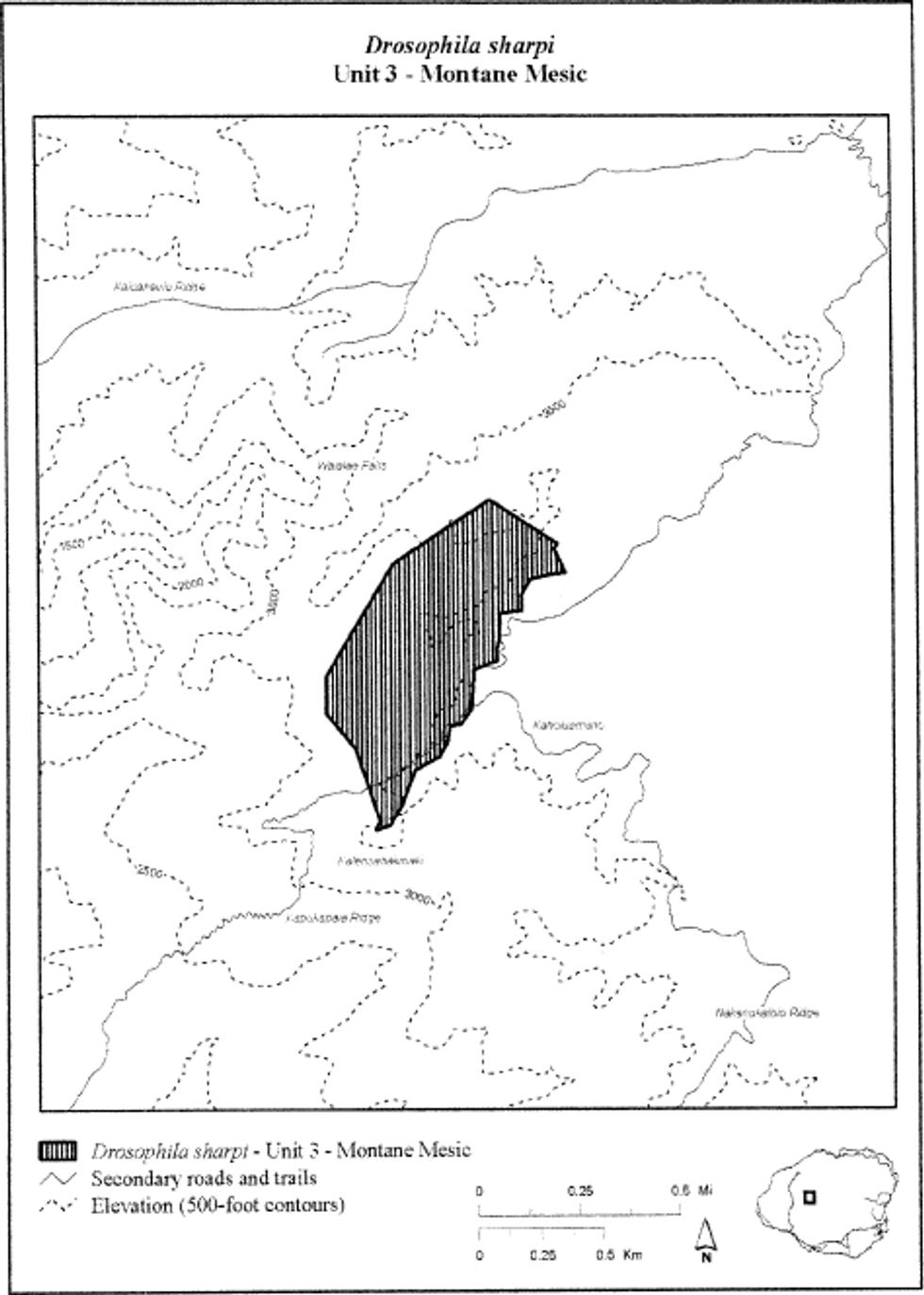
(9) Unit 4-Montane Wet, Kauai County, Hawaii.
(i) Unit 4-Montane Wet consists of 13,055.0 ac (5,283.2 ha) and includes land bounded by the following UTM Zone 4, NAD83 coordinates (E, N): 448638, 2440764; 448601, 2440679; 448606, 2440704; 448612, 2440722; 448615, 2440731; 448619, 2440740; 448630, 2440759; 448650, 2440769; 448600, 2440668; 448622, 2440749; 448599, 2440647; 448601, 2440652; 448678, 2440741; 448777, 2440842; 448663, 2440773; 449006, 2441012; 448764, 2440857; 449068, 2441051; 449121, 2441114; 449121, 2441114; 448887, 2440934; 448811, 2440896; 448954, 2441097; 448943, 2441063; 448943, 2441053; 448943, 2441044; 448941, 2441024; 448940, 2441006; 448918, 2440982; 448877, 2440939; 448861, 2440927; 448735, 2440829; 448837, 2440912; 448678, 2440780; 448802, 2440889; 448788, 2440878; 449115, 2442038; 448745, 2440841; 449111, 2441196; 448727, 2440820; 448720, 2440813; 448711, 2440806; 448691, 2440790; 448841, 2440914; 447374, 2443275; 449244, 2441819; 447623, 2443445; 447616, 2443588; 447603, 2443646; 447556, 2443686; 447325, 2443651; 447295, 2443639; 447247, 2443586; 448634, 2443800; 447287, 2443339; 448657, 2443629; 447481, 2443262; 447636, 2443160; 447645, 2443143; 447645, 2443146; 447894, 2443371; 447865, 2443358; 447712, 2443351; 447631, 2443389; 448948, 2441084; 447249, 2443451; 448917, 2442504; 449106, 2441435; 449173, 2441529; 449201, 2441638; 449249, 2441697; 449275, 2441773; 449148, 2441893; 449090, 2442135; 449064, 2442221; 448614, 2443950; 448983, 2442384; 449078, 2441297; 448880, 2442563; 448861, 2442593; 448805, 2442677; 448765, 2442787; 448696, 2442955; 448653, 2443075; 448651, 2443187; 448674, 2443301; 448669, 2443477; 449024, 2442290; 444824, 2443350; 444161, 2444181; 445808, 2442898; 445681, 2442977; 445559, 2443010; 445437, 2443077; 446100, 2442628; 445045, 2443240; 446256, 2442602; 444659, 2443447; 444532, 2443516; 444456, 2443572; 444423, 2443638; 444334, 2443811; 446499, 2441271; 445254, 2443156; 446686, 2441764; 441856, 2446328; 446673, 2441408; 446651, 2441424; 446641, 2441436; 446587, 2441501; 445966, 2442725; 446640, 2441627; 444075, 2444349; 446694, 2442007; 446591, 2442195; 446650, 2442430; 446675, 2442432; 446482, 2442513; 446373, 2442574; 446587, 2441543; 443497, 2444548; 444237, 2444013; 443579, 2444514; 443571, 2444521; 443557, 2444532; 443553, 2444537; 443610, 2444483; 443516, 2444546; 443617, 2444477; 443483, 2444551; 443478, 2444555; 443464, 2444570; 443459, 2444579; 443452, 2444591; 443447, 2444608; 443534, 2444543; 443722, 2444464; 444016, 2444444; 443984, 2444419; 443985, 2444416; 443769, 2444440; 443760, 2444446; 443598, 2444493; 443732, 2444458; 446375, 2441172; 443703, 2444469; 443685, 2444463; 443677, 2444459; 443666, 2444456; 443647, 2444460; 443628, 2444469; 443740, 2444454; 441656, 2441573; 442568, 2441274; 440114, 2440528; 440464, 2440832; 440528, 2440844; 440586, 2440905; 440110, 2440524; 441650, 2441573; 440014, 2440441; 441659, 2441579; 441727, 2441586; 441774, 2441575; 441900, 2441576; 441968, 2441515; 446610, 2441349; 441637, 2441552; 439096, 2441847; 438866, 2442347; 438934, 2442351; 438960, 2442270; 438967, 2442246; 438976, 2442220; 440113, 2440527; 439088, 2441871; 442723, 2441295; 439491, 2440617; 439551, 2440431; 439556, 2440414; 439832, 2440430; 439931, 2440426; 440002, 2440430; 439037, 2442031; 445551, 2441162; 442287, 2441225; 445235, 2441328; 445344, 2441376; 445380, 2441414; 445392, 2441392; 444560, 2441032; 445510, 2441194; 444480, 2440997; 445886, 2441308; 446122, 2441415; 446214, 2441291; 448944, 2441075; 446300, 2441227; 446357, 2441185; 445395, 2441389; 443889, 2441172; 442843, 2441314; 442924, 2441340; 442982, 2441350; 442977, 2441356; 443016, 2441342; 445124, 2441205; 443707, 2441132; 443440, 2444655; 444062, 2441230; 444083, 2441215; 444109, 2441224; 444113, 2441221; 444124, 2441223; 444455, 2440990; 443023, 2441344; 442711, 2445664; 442430, 2445827; 442668, 2445560; 442666, 2445576; 442668, 2445590; 442674, 2445604; 442672, 2445510; 442713, 2445661; 442668, 2445494; 442501, 2445803; 442492, 2445803; 442467, 2445799; 442448, 2445805; 442444, 2445807; 443444, 2444627; 442710, 2445647; 442709, 2445399; 442804, 2445357; 442798, 2445359; 442785, 2445364; 442765, 2445370; 442747, 2445377; 442673, 2445515; 442727, 2445386; 442430, 2445830; 442694, 2445414; 442689, 2445419; 442682, 2445433; 442675, 2445453; 442671, 2445471; 442667, 2445490; 442743, 2445378; 441897, 2446273; 442435, 2445813; 442019, 2446165; 442005, 2446171; 441982, 2446194; 441963, 2446219; 442059, 2446159; 441929, 2446268; 442071, 2446146; 441879, 2446263; 441852, 2446219; 441838, 2446221; 441834, 2446230; 441848, 2446265; 441855, 2446295; 441943, 2446256; 442202, 2445986; 442428, 2445851; 442381, 2445882; 442372, 2445885; 442317, 2445917; 442301, 2445924; 442039, 2446165; 442261, 2445949; 442858, 2445342; 442175, 2445995; 442100, 2446007; 442082, 2446029; 442072, 2446052; 442067, 2446082; 442073, 2446121; 442273, 2445945; 443240, 2444927; 442821, 2445353; 443294, 2444870; 443290, 2444876; 443281, 2444890; 443271, 2444898; 443307, 2444833; 443252, 2444914; 443309, 2444829; 443234, 2444932; 443215, 2444938; 443196, 2444944; 443193, 2444946; 443177, 2444962; 443175, 2444965; 443260, 2444907; 443352, 2444721; 438757, 2442331; 443435, 2444664; 443423, 2444686; 443403, 2444695; 443385, 2444699; 443301, 2444851; 443366, 2444706; 443156, 2445003; 443346, 2444728; 443341, 2444740; 443333, 2444758; 443327, 2444778; 443320, 2444796; 443313, 2444815; 443373, 2444702; 442952, 2445303; 443029, 2445263; 443009, 2445266; 443006, 2445268; 442990, 2445276; 442981, 2445284; 443163, 2444984; 442956, 2445301; 443068, 2445227; 442934, 2445314; 442915, 2445323; 442898, 2445330; 442877, 2445336; 442862, 2445341; 443443, 2444647; 442972, 2445292; 443122, 2445132; 442842, 2445347; 443153, 2445020; 443153, 2445040; 443152, 2445059; 443150, 2445078; 443144, 2445096; 443047, 2445260; 443135, 2445115; 443065, 2445247; 443103, 2445152; 443083, 2445171; 443066, 2445190; 443066, 2445209; 443067, 2445215; 443158, 2444995; 443140, 2445105; 440025, 2445056; 439668, 2444981; 440214, 2445151; 440216, 2445150; 440347, 2445106; 440289, 2445097; 440078, 2445204; 440124, 2445056; 439994, 2445245; 439910, 2445087; 439796, 2445123; 439719, 2445133; 439696, 2445110; 439681, 2445072; 439364, 2444192; 440216, 2445076; 439480, 2445095; 438927, 2444790; 438982, 2444746; 439037, 2444786; 439157, 2444829; 439238, 2444846; 440165, 2445166; 439434, 2444999; 439643, 2444902; 439484, 2445120; 439501, 2445220; 439598, 2445317; 439699, 2445360; 439794, 2445352; 439883, 2445309; 439360, 2444907; 439945, 2444540; 439673, 2445011; 439890, 2444912; 439948, 2444922; 439994, 2444883; 440052, 2444784; 439859, 2444782; 439996, 2444642; 439859, 2444723; 439876, 2444423; 439825, 2444344; 439759, 2444342; 439685, 2444334; 439583, 2444266; 438838, 2442340; 440032, 2444731; 439254, 2444472; 439571, 2444823; 439485, 2444800; 439386, 2444762; 439258, 2444658; 439172, 2444564; 439864, 2444845; 439156, 2444527; 438580, 2444854; 439413, 2444371; 439522, 2444418; 439617, 2444459; 439747, 2444522; 439800, 2444594; 439843, 2444655; 439145, 2444538; 435698, 2452376; 438807, 2444845; 436003, 2452334; 435955, 2452326; 435902, 2452378; 435838, 2452443; 436579, 2452559; 435719, 2452378; 436804, 2452559; 435477, 2452358; 435478, 2452345; 435479, 2452304; 435517, 2452192; 435519, 2452190; 435540, 2452168; 435810, 2452427; 438006, 2453313; 438476, 2452702; 438465, 2452788; 438430, 2452817; 438386, 2452854; 438269, 2452930; 436189, 2452365; 438110, 2453148; 435895, 2451700; 437935, 2453510; 437933, 2453512; 437797, 2453318; 437592, 2453026; 437202, 2452948; 437201, 2452932; 438116, 2453088; 438263, 2444805; 436811, 2449026; 437237, 2447714; 437230, 2447713; 437248, 2447657; 437232, 2447645; 435631, 2452072; 438179, 2444732; 436566, 2449559; 438343, 2444896; 438406, 2444952; 438475, 2444955; 438523, 2444886; 438536, 2444858; 439298, 2444154; 438168, 2444734; 436235, 2450550; 438677, 2444833; 435961, 2451591; 436027, 2451466; 436103, 2451262; 436162, 2451016; 436212, 2450766; 436739, 2449180; 436234, 2450558; 436706, 2449252; 436250, 2450410; 436234, 2450237; 436386, 2449952; 436472, 2449769; 436566, 2449560; 435779, 2451881; 436230, 2450590; 438030, 2442243; 438130, 2442234; 437996, 2442188; 437998, 2442202; 437998, 2442205; 437999, 2442211; 437973, 2442147; 438012, 2442229; 437954, 2442136; 438049, 2442246; 438065, 2442246; 438088, 2442240; 438095, 2442238; 438098, 2442237; 439456, 2444205; 438000, 2442216; 437826, 2442106; 437754, 2441991; 437758, 2441998; 437766, 2442017; 437777, 2442052; 437791, 2442074; 437984, 2442167; 437806, 2442092; 438157, 2442234; 437839, 2442110; 437873, 2442121; 437887, 2442121; 437912, 2442123; 437926, 2442125; 437939, 2442128; 437799, 2442084; 438656, 2442321; 438114, 2442232; 438535, 2442314; 438536, 2442314; 438561, 2442316; 438577, 2442315; 438517, 2442310; 438626, 2442315; 438496, 2442310; 438668, 2442322; 438679, 2442324; 438694, 2442327; 438704, 2442326; 438721, 2442329; 446348, 2441177; 438609, 2442314; 438392, 2442294; 438219, 2442244; 438238, 2442248; 438254, 2442248; 438305, 2442256; 438355, 2442265; 438523, 2442310; 438376, 2442278; 437745, 2441950; 438418, 2442311; 438433, 2442319; 438436, 2442321; 438453, 2442321; 438453, 2442321; 438460, 2442320; 438373, 2442277; 437363, 2443282; 437751, 2441981; 437981, 2443476; 437808, 2443397; 437928, 2443310; 437950, 2443233; 438143, 2443587; 437364, 2443298; 438183, 2443628; 437277, 2443228; 437144, 2443208; 437065, 2443211; 437060, 2443212; 436974, 2443182; 436997, 2443061; 437657, 2443231; 438835, 2443883; 439282, 2444110; 439268, 2444068; 439181, 2444032; 439094, 2444009; 439048, 2443913; 438208, 2443477; 438964, 2443837; 437226, 2442709; 438723, 2443923; 438608, 2443916; 438453, 2443825; 438438, 2443814; 438318, 2443723; 438201, 2443629; 439043, 2443859; 437697, 2441878; 437601, 2441867; 437602, 2441867; 437617, 2441866; 437635, 2441866; 437647, 2441866; 437052, 2442940; 437689, 2441877; 437522, 2441879; 437705, 2441878; 437711, 2441887; 437717, 2441899; 437736, 2441928; 437740, 2441938; 438821, 2442339; 437674, 2441875; 437294, 2442356; 437747, 2441961; 437088, 2442647; 437103, 2442643; 437156, 2442615; 437159, 2442579; 437120, 2442503; 437566, 2441876; 437174, 2442422; 437532, 2441880; 437425, 2442191; 437307, 2442101; 437476, 2442051; 437493, 2441868; 437495, 2441869; 437182, 2442830; 437105, 2442445; 448431, 2442766; 448447, 2442675; 448469, 2442871; 448462, 2442858; 448442, 2442821; 448437, 2442805; 448481, 2442894; 448432, 2442775; 448486, 2442910; 448428, 2442750; 448428, 2442738; 448432, 2442727; 448437, 2442711; 448443, 2442699; 448671, 2442369; 448435, 2442791; 448579, 2443112; 448582, 2443190; 448582, 2443172; 448582, 2443162; 448583, 2443151; 448585, 2443140; 448477, 2442887; 448585, 2443122; 448447, 2442663; 448562, 2443086; 448545, 2443051; 448529, 2443019; 448507, 2442976; 448498, 2442952; 448490, 2442930; 448586, 2443129; 448642, 2442440; 448447, 2442688; 448602, 2442477; 448615, 2442472; 448623, 2442466; 448634, 2442459; 448566, 2442503; 448640, 2442451; 448550, 2442513; 448642, 2442430; 448642, 2442419; 448643, 2442410; 448648, 2442399; 448657, 2442387; 447996, 2444312; 448637, 2442455; 448464, 2442531; 448443, 2442636; 448443, 2442627; 448440, 2442604; 448438, 2442565; 448441, 2442549; 448587, 2442486; 448455, 2442534; 448589, 2443224; 448474, 2442530; 448488, 2442531; 448505, 2442534; 448515, 2442533; 448530, 2442527; 448536, 2442523; 448449, 2442536; 448502, 2443743; 448586, 2443203; 448512, 2443792; 448512, 2443783; 448513, 2443779; 448513, 2443769; 448473, 2443878; 448504, 2443752; 448470, 2443888; 448504, 2443735; 448507, 2443727; 448522, 2443706; 448538, 2443682; 448546, 2443665; 448552, 2443643; 448509, 2443760; 447932, 2443750; 447925, 2444320; 447843, 2444325; 447864, 2444277; 447942, 2444178; 448003, 2444015; 448500, 2443823; 447967, 2443867; 448549, 2443613; 447904, 2443646; 447921, 2443582; 447949, 2443460; 447939, 2443412; 448458, 2443882; 448470, 2443889; 448008, 2443903; 448590, 2443306; 448578, 2443441; 448572, 2443417; 448576, 2443405; 448584, 2443388; 448590, 2443369; 448552, 2443630; 448593, 2443325; 448591, 2443484; 448591, 2443291; 448592, 2443277; 448592, 2443261; 448592, 2443254; 448591, 2443241; 448673, 2442365; 448595, 2443352; 448553, 2443539; 448587, 2443214; 448544, 2443601; 448533, 2443587; 448527, 2443576; 448523, 2443570; 448518, 2443559; 448585, 2443461; 448528, 2443546; 448588, 2443466; 448560, 2443535; 448569, 2443527; 448577, 2443516; 448582, 2443508; 448589, 2443493; 448551, 2443621; 448518, 2443552; 449003, 2441449; 448936, 2441403; 449064, 2441492; 449060, 2441481; 449053, 2441472; 449049, 2441471; 449066, 2441511; 449032, 2441461; 449061, 2441528; 448971, 2441443; 448964, 2441441; 448952, 2441427; 448948, 2441420; 448945, 2441411; 448665, 2442379; 449040, 2441466; 449012, 2441616; 448972, 2441689; 446228, 2441279; 448995, 2441668; 449000, 2441660; 449004, 2441650; 449065, 2441502; 449009, 2441625; 448930, 2441400; 449017, 2441611; 449030, 2441595; 449037, 2441588; 449043, 2441578; 449046, 2441569; 449050, 2441561; 449006, 2441639; 448967, 2441159; 448940, 2441404; 448926, 2441212; 448930, 2441194; 448933, 2441184; 448941, 2441177; 448940, 2441238; 448961, 2441163; 448944, 2441250; 448972, 2441150; 448973, 2441143; 448972, 2441136; 448971, 2441119; 448969, 2441116; 448964, 2441109; 448949, 2441170; 448928, 2441313; 448922, 2441392; 448918, 2441381; 448916, 2441369; 448917, 2441357; 448919, 2441341; 448934, 2441230; 448925, 2441322; 448933, 2441715; 448935, 2441302; 448944, 2441291; 448948, 2441281; 448948, 2441273; 448948, 2441264; 448946, 2441259; 448920, 2441333; 448677, 2442140; 441868, 2446401; 448673, 2442209; 448671, 2442202; 448674, 2442187; 448680, 2442169; 448684, 2442226; 448682, 2442148; 448692, 2442233; 448675, 2442123; 448677, 2442115; 448683, 2442101; 448694, 2442089; 448710, 2442077; 448718, 2442069; 448684, 2442157; 448722, 2442303; 448677, 2442356; 448682, 2442350; 448697, 2442342; 448711, 2442341; 448721, 2442331; 448678, 2442221; 448723, 2442309; 448736, 2442055; 448718, 2442295; 448712, 2442283; 448707, 2442267; 448706, 2442257; 448705, 2442250; 448699, 2442238; 448724, 2442320; 448915, 2441796; 448850, 2441844; 448877, 2441825; 448884, 2441820; 448890, 2441818; 448892, 2441817; 448723, 2442061; 448910, 2441807; 448820, 2441871; 448913, 2441774; 448914, 2441760; 448913, 2441753; 448915, 2441738; 448925, 2441722; 448957, 2441700; 448900, 2441814; 448787, 2441967; 448939, 2441710; 448746, 2442051; 448755, 2442041; 448764, 2442029; 448768, 2442019; 448773, 2442013; 448840, 2441852; 448781, 2441990; 448831, 2441859; 448789, 2441938; 448803, 2441914; 448813, 2441900; 448814, 2441894; 448817, 2441884; 448728, 2442058; 448777, 2442002; 440375, 2448361; 440198, 2448467; 440421, 2448239; 440415, 2448290; 440416, 2448314; 440411, 2448336; 440401, 2448191; 440391, 2448353; 440384, 2448138; 440350, 2448395; 440331, 2448411; 440307, 2448418; 440254, 2448428; 440237, 2448434; 439526, 2448944; 440402, 2448352; 440409, 2447991; 440377, 2447819; 440378, 2447845; 440384, 2447871; 440395, 2447896; 440436, 2447941; 440413, 2448216; 440426, 2447974; 440190, 2448485; 440343, 2448005; 440329, 2448016; 440325, 2448033; 440331, 2448061; 440341, 2448084; 440374, 2448123; 440435, 2447959; 439678, 2448950; 440218, 2448446; 439853, 2448941; 439830, 2448945; 439788, 2448929; 439761, 2448926; 439900, 2448928; 439697, 2448941; 439922, 2448928; 439656, 2448949; 439633, 2448940; 439611, 2448928; 439578, 2448906; 439553, 2448909; 439539, 2448922; 439733, 2448930; 440089, 2448747; 440179, 2448496; 440157, 2448511; 440136, 2448537; 440120, 2448633; 440125, 2448690; 439875, 2448932; 440112, 2448732; 440451, 2447620; 440073, 2448762; 440036, 2448815; 440000, 2448878; 439982, 2448899; 439961, 2448915; 439941, 2448924; 440121, 2448718; 441363, 2447030; 440383, 2447794; 441405, 2446869; 441402, 2446899; 441403, 2446972; 441399, 2446995; 441455, 2446804; 441373, 2447026; 441476, 2446797; 441317, 2447043; 441283, 2447083; 441268, 2447104; 441240, 2447171; 441231, 2447186; 441219, 2447195; 441398, 2446997; 441674, 2446682; 448141, 2444294; 448986, 2441677; 441864, 2446424; 441847, 2446451; 441836, 2446475; 441434, 2446820; 441829, 2446505; 441148, 2447188; 441648, 2446705; 441620, 2446723; 441584, 2446741; 441549, 2446752; 441532, 2446763; 441521, 2446777; 441829, 2446501; 440674, 2447485; 440710, 2447368; 440699, 2447389; 440693, 2447407; 440695, 2447430; 440703, 2447452; 441201, 2447195; 440693, 2447475; 440800, 2447339; 440599, 2447501; 440579, 2447511; 440540, 2447539; 440487, 2447571; 440468, 2447593; 440124, 2448663; 440703, 2447461; 440941, 2447230; 440413, 2447711; 441133, 2447183; 441113, 2447170; 441095, 2447154; 441083, 2447147; 441058, 2447153; 440722, 2447354; 440969, 2447210; 440740, 2447346; 440888, 2447250; 440873, 2447265; 440865, 2447286; 440858, 2447311; 440842, 2447328; 441172, 2447190; 441039, 2447168; 438599, 2451708; 438434, 2451069; 438440, 2451600; 438425, 2451652; 438429, 2451670; 438442, 2451682; 438419, 2451509; 438529, 2451692; 438410, 2451464; 438657, 2451738; 439516, 2448971; 438675, 2451766; 440125, 2448578; 438680, 2451858; 438715, 2451908; 438484, 2451690; 438467, 2451228; 438455, 2451089; 438463, 2451098; 438475, 2451113; 438484, 2451141; 438486, 2451163; 438435, 2451571; 438472, 2451209; 438888, 2452163; 438472, 2451261; 438481, 2451287; 438485, 2451346; 438478, 2451359; 438454, 2451380; 438422, 2451414; 438481, 2451188; 448609, 2443974; 438669, 2452384; 438605, 2452379; 438540, 2452374; 438510, 2452340; 438449, 2452330; 438761, 2452013; 438490, 2452605; 438816, 2452396; 448591, 2444072; 448566, 2444172; 448548, 2444233; 448510, 2444279; 448464, 2444284; 448299, 2444289; 438431, 2452414; 439138, 2452428; 438670, 2451754; 438936, 2452213; 438977, 2452232; 438979, 2452233; 439031, 2452285; 439037, 2452297; 438716, 2452393; 439083, 2452342; 438779, 2452391; 439171, 2452514; 439201, 2452565; 439114, 2452513; 438954, 2452430; 438851, 2452395; 438833, 2452090; 439061, 2452327; 439044, 2449631; 438944, 2449813; 439167, 2449414; 439146, 2449435; 439114, 2449463; 439102, 2449480; 439220, 2449318; 439065, 2449586; 439230, 2449287; 439037, 2449642; 439025, 2449671; 439016, 2449687; 438999, 2449702; 438974, 2449738; 438965, 2449767; 439076, 2449548; 439382, 2449107; 439508, 2448984; 439451, 2449000; 439437, 2449023; 438680, 2451783; 439433, 2449078; 439200, 2449362; 439399, 2449097; 439421, 2449088; 439361, 2449126; 439330, 2449145; 439307, 2449169; 439277, 2449220; 439260, 2449242; 439244, 2449261; 438425, 2451047; 438554, 2450559; 438737, 2450311; 438736, 2450325; 438731, 2450342; 438715, 2450373; 438690, 2450392; 438621, 2450415; 438732, 2450286; 438578, 2450438; 438501, 2450796; 438488, 2450686; 438472, 2450910; 438435, 2450985; 438427, 2450964; 438919, 2449853; 439437, 2449066; 438581, 2450423; 438816, 2450028; 438717, 2450241; 438894, 2449879; 438884, 2449918; 438904, 2449863; 438831, 2450010; 438850, 2449982; 438791, 2450036; 438765, 2450051; 438744, 2450081; 438730, 2450109; 438717, 2450158; 438716, 2450162; 438713, 2450206.
(ii) Map of Unit 4-Montane Wet for Hawaiian picture-wing fly (Drosophila sharpi) follows:
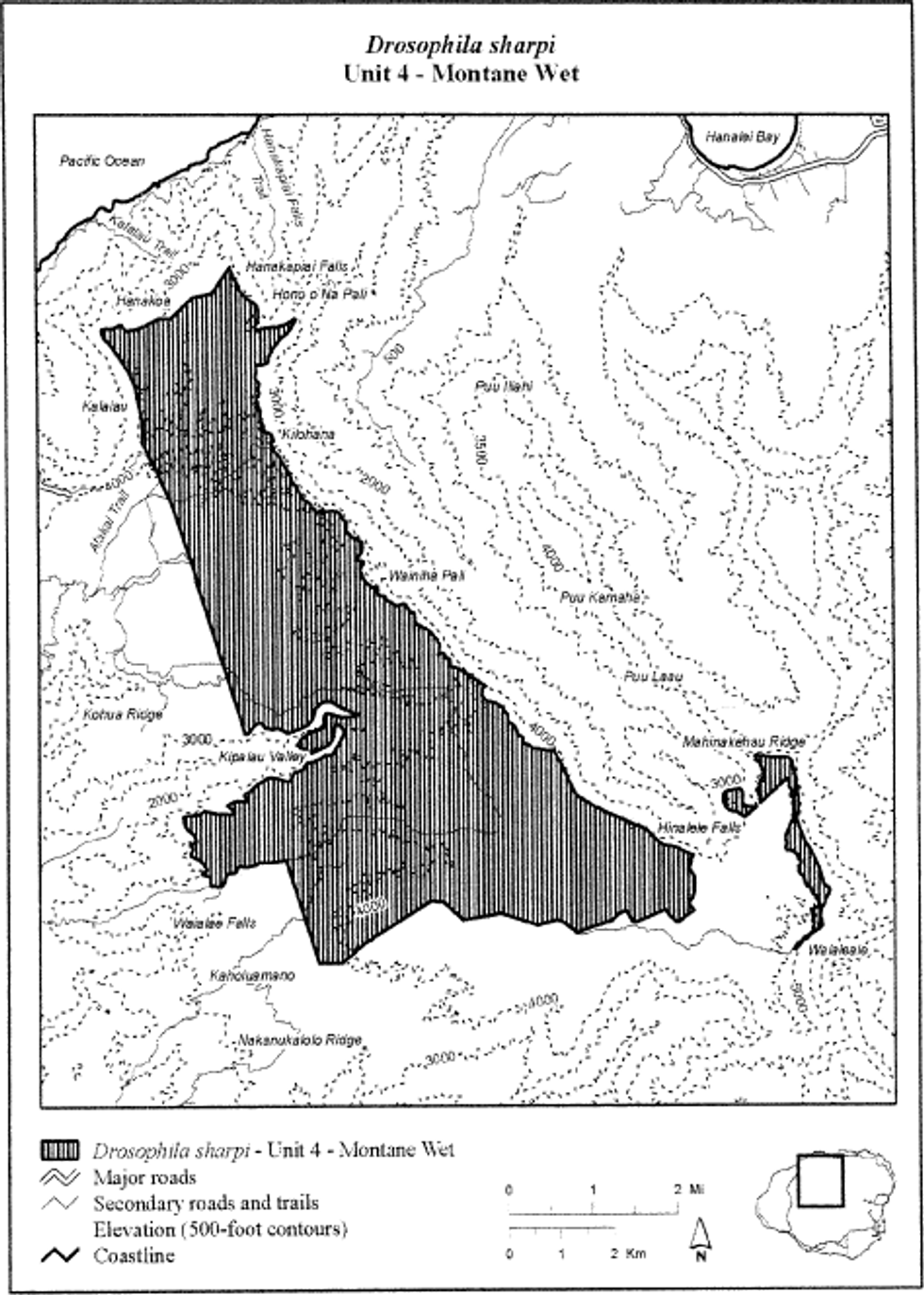
(10) Unit 5-Montane Wet, Kauai County, Hawaii.
(i) Unit 5-Montane Wet consists of 789.9 ac (319.7 ha) and includes land bounded by the following UTM Zone 4, NAD83 coordinates (E, N): 433436, 2449707; 433445, 2449707; 433444, 2449707; 433443, 2449707; 433458, 2449707; 433436, 2449707; 433426, 2449707; 433408, 2449708; 433429, 2449741; 433493, 2449765; 433633, 2449724; 433742, 2449724; 433467, 2449787; 433460, 2449707; 433468, 2449706; 433484, 2449694; 433414, 2449628; 433461, 2449623; 433457, 2449622; 433339, 2449600; 433440, 2449604; 433437, 2449592; 433426, 2449556; 433419, 2449599; 433831, 2449767; 434991, 2449344; 433401, 2449697; 433480, 2449629; 434938, 2449321; 433313, 2449484; 433455, 2449620; 434842, 2449253; 434839, 2449258; 434834, 2449277; 434833, 2449278; 434833, 2449278; 434833, 2449280; 434833, 2449281; 434872, 2449294; 434881, 2449297; 434884, 2449298; 435010, 2449343; 434899, 2449305; 433903, 2449882; 435011, 2449352; 435010, 2449343; 435005, 2449310; 434948, 2449300; 434908, 2449290; 434908, 2449290; 434890, 2449251; 434872, 2449246; 434848, 2449239; 434844, 2449248; 434034, 2449950; 434026, 2449951; 433969, 2449958; 434898, 2449304; 435183, 2449401; 434713, 2447038; 434738, 2447045; 434738, 2447030; 434795, 2447069; 434994, 2447085; 435093, 2447245; 435290, 2447449; 435295, 2447440; 435360, 2447538; 435282, 2448685; 435266, 2448909; 435236, 2449351; 434686, 2447020; 435232, 2449399; 435272, 2448835; 435080, 2449407; 434920, 2449394; 434752, 2449405; 434498, 2449522; 434338, 2449660; 434208, 2449767; 434141, 2449863; 434137, 2449869; 434124, 2449948; 434074, 2449972; 433461, 2449623; 433339, 2449381; 435234, 2449384; 433589, 2449323; 433725, 2448994; 433545, 2449136; 433389, 2449256; 433567, 2449260; 433588, 2449244; 433880, 2448827; 433612, 2449262; 433525, 2449415; 433567, 2449398; 433546, 2449412; 434627, 2447088; 433448, 2449426; 435236, 2449347; 433368, 2449293; 433599, 2449252; 434202, 2447345; 433367, 2449352; 434073, 2448685; 434357, 2447229; 434073, 2447500; 434086, 2447693; 434163, 2447783; 434254, 2447886; 434318, 2448182; 434318, 2448298; 434292, 2448479; 434279, 2447951; 434486, 2447126; 434228, 2448620.
(ii) Map of Unit 5-Montane Wet for Hawaiian picture-wing fly (Drosophila sharpi) follows:
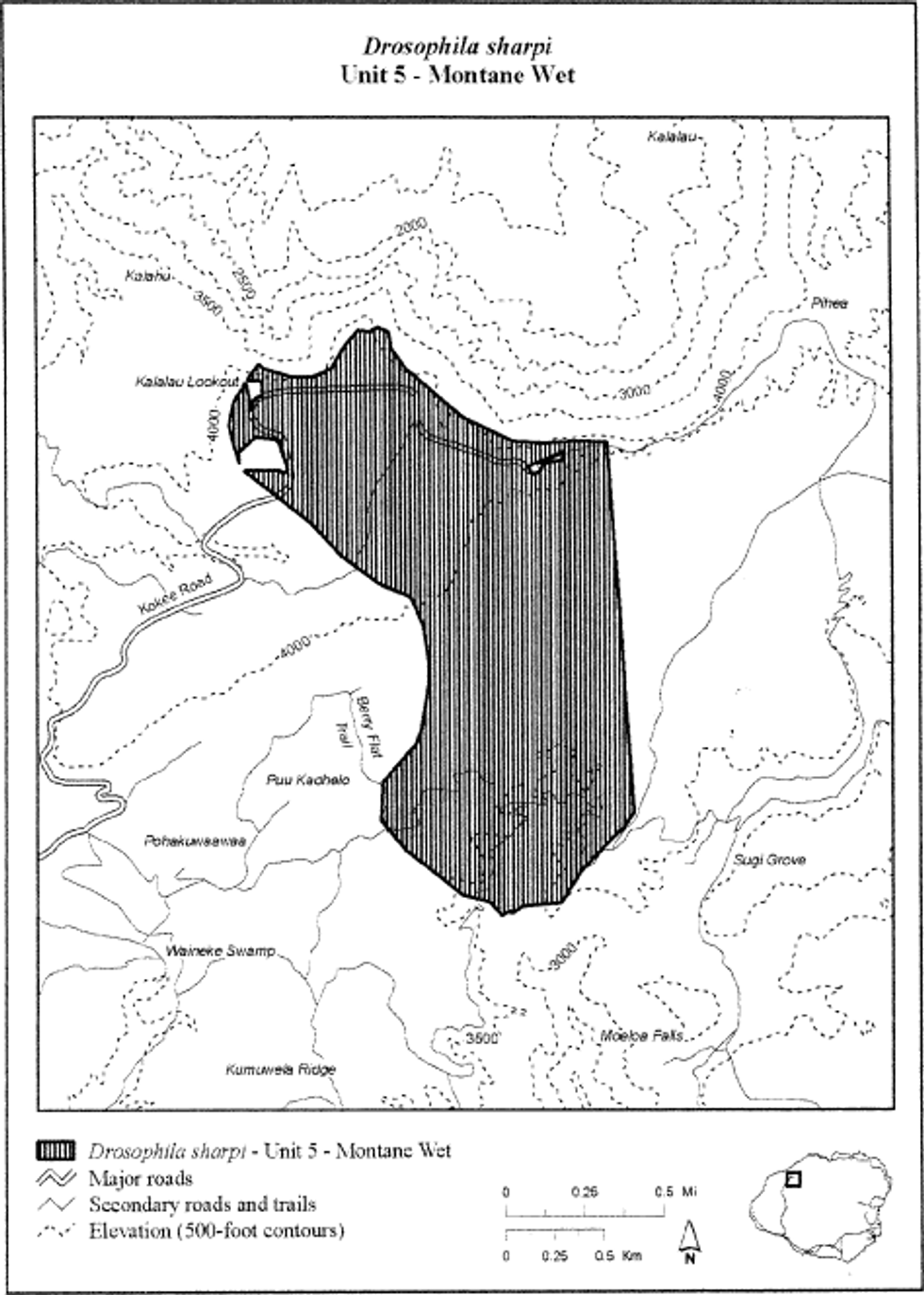
(11) Unit 6-Montane Wet, Kauai County, Hawaii.
(i) Unit 6-Montane Wet consists of 413.5 ac (167.3 ha) and includes land bounded by the following UTM Zone 4, NAD83 coordinates (E, N): 448516, 2447525; 447976, 2448470; 448042, 2448338; 448133, 2448200; 448235, 2448042; 448834, 2447273; 448288, 2447915; 448412, 2447653; 448669, 2447406; 447943, 2448562; 448763, 2447342; 448059, 2449434; 448321, 2447795; 447961, 2448628; 448037, 2448780; 448088, 2448897; 448122, 2449037; 448119, 2449134; 448056, 2449368; 448099, 2449454; 448242, 2449457; 448328, 2449449; 448440, 2449296; 448382, 2449406; 448887, 2447191; 448091, 2449266; 448610, 2449255; 448931, 2447092; 448511, 2449199; 448623, 2449141; 448641, 2449184; 448593, 2449298; 448613, 2449357; 448702, 2449395; 448812, 2449420; 448906, 2449440; 448959, 2449443; 448964, 2449425; 448952, 2449316; 448954, 2449143; 448881, 2447609; 448987, 2448959; 448980, 2446980; 448979, 2446983; 448577, 2449143; 448980, 2446982; 448981, 2446981; 449105, 2447827; 449087, 2447916; 449044, 2448132; 449032, 2448326; 449045, 2448506; 449040, 2448659; 449012, 2448822.
(ii) Map of Unit 6-Montane Wet for Hawaiian picture-wing fly (Drosophila sharpi) follows:

Hawaiian picture-wing fly (Drosophila substenoptera)
(1) Critical habitat is depicted for County of Honolulu, island of Oahu, Hawaii, on the maps below. The maps provided are for informational purposes only.
(2) The primary constituent elements of critical habitat for Drosophila substenoptera are:
(i) Mesic to wet, lowland to montane, ohia and koa forest between the elevations of 1,920-4,030 ft (585-1,228 m); and
(ii) The larval host plants Cheirodendron platyphyllum ssp. platyphyllum, C. trigynum ssp. trigynum, Tetraplasandra kavaiensis, and T. oahuensis, which exhibit one or more life stages (from seedlings to senescent individuals).
(3) Critical habitat does not include manmade structures (such as buildings, aqueducts, airports, and roads) and the land on which they are located existing within the legal boundaries on the effective date of this rule.
(4) Critical habitat map units. Coordinates are in Universal Transverse Mercator (UTM) Zone 4 with units in meters using North American Datum of 1983 (NAD83).
(5) Note: Index map of critical habitat units for Drosophila substenoptera follows:
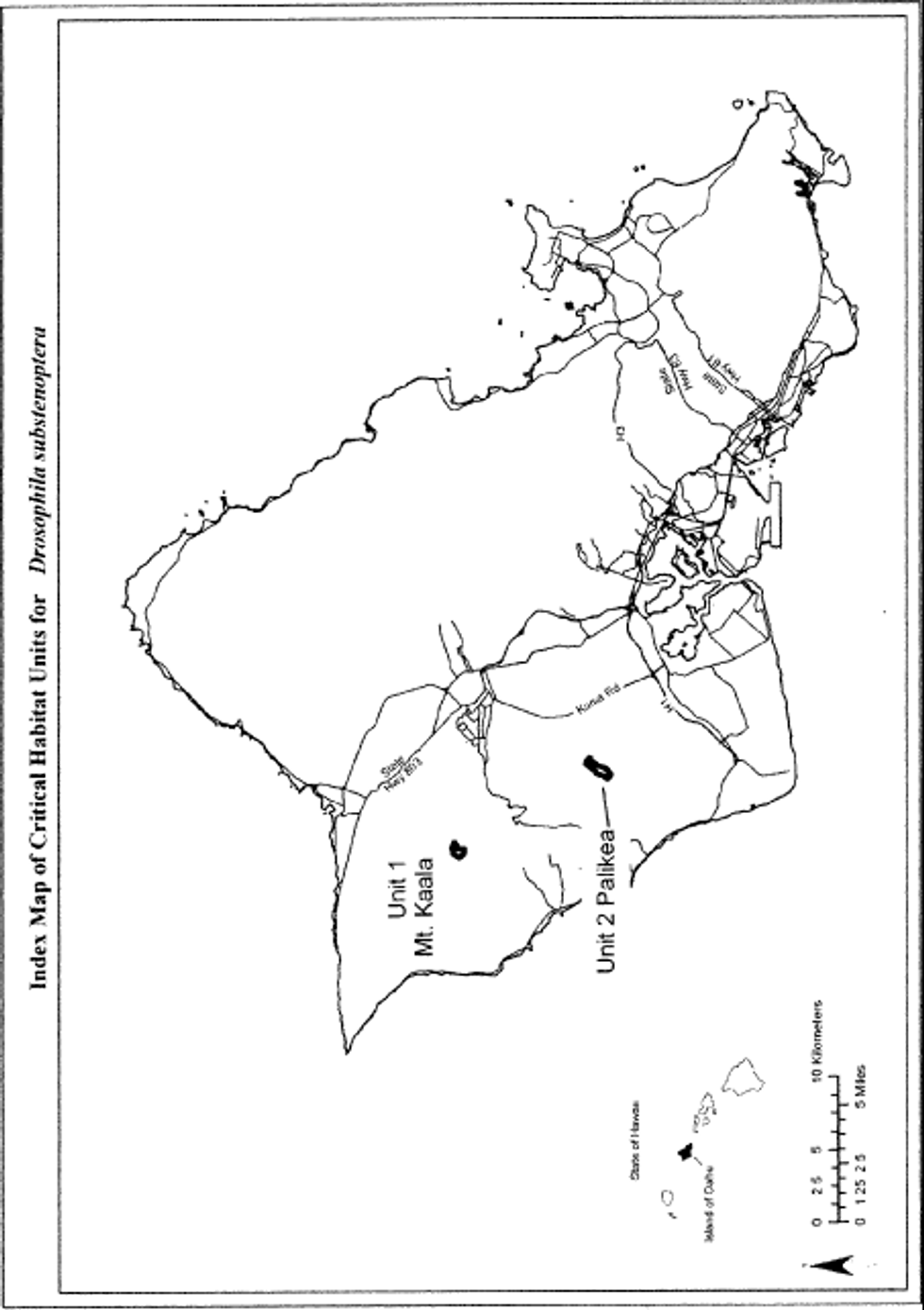
(6) Drosophila substenoptera - Unit 1 - Mt. Kaala, City and County of Honolulu, island of Oahu, Hawaii.
(i) Land bounded by the following coordinates: 588692, 2378661; 588740, 2378622; 588806, 2378595; 588799, 2378573; 588790, 2378564; 588785, 2378562; 588776, 2378565; 588776, 2378565; 588776, 2378565; 588776, 2378565; 588776, 2378565; 588776, 2378565; 588776, 2378566; 588766, 2378566; 588766, 2378566; 588766, 2378566; 588766, 2378566; 588766, 2378566; 588766, 2378566; 588766, 2378566; 588766, 2378566; 588766, 2378566; 588766, 2378566; 588766, 2378566; 588766, 2378566; 588766, 2378566; 588765, 2378566; 588765, 2378566; 588765, 2378566; 588753, 2378551; 588731, 2378529; 588722, 2378520; 588722, 2378520; 588722, 2378520; 588714, 2378509; 588660, 2378470; 588660, 2378470; 588660, 2378470; 588660, 2378470; 588617, 2378429; 588584, 2378412; 588563, 2378405; 588530, 2378398; 588530, 2378398; 588484, 2378387; 588466, 2378384; 588466, 2378384; 588466, 2378384; 588466, 2378384; 588466, 2378384; 588466, 2378384; 588466, 2378384; 588466, 2378384; 588459, 2378380; 588459, 2378380; 588459, 2378380; 588459, 2378380; 588459, 2378379; 588459, 2378379; 588459, 2378379; 588459, 2378379; 588395, 2378293; 588361, 2378254; 588361, 2378254; 588361, 2378254; 588361, 2378254; 588361, 2378254; 588349, 2378234; 588349, 2378234; 588349, 2378234; 588349, 2378234; 588349, 2378234; 588349, 2378234; 588344, 2378210; 588344, 2378210; 588344, 2378210; 588344, 2378210; 588344, 2378210; 588344, 2378210; 588344, 2378186; 588344, 2378186; 588344, 2378186; 588344, 2378186; 588349, 2378161; 588349, 2378161; 588349, 2378161; 588349, 2378161; 588373, 2378097; 588385, 2378041; 588384, 2378026; 588380, 2378003; 588364, 2377972; 588364, 2377972; 588364, 2377972; 588351, 2377941; 588351, 2377941; 588351, 2377941; 588351, 2377941; 588351, 2377941; 588351, 2377941; 588351, 2377941; 588351, 2377941; 588351, 2377941; 588351, 2377941; 588354, 2377924; 588354, 2377924; 588354, 2377923; 588354, 2377923; 588354, 2377923; 588362, 2377904; 588362, 2377904; 588362, 2377904; 588362, 2377904; 588362, 2377904; 588369, 2377893; 588369, 2377893; 588369, 2377893; 588369, 2377893; 588369, 2377893; 588369, 2377893; 588376, 2377888; 588308, 2377906; 588255, 2377885; 588156, 2377924; 588103, 2377905; 588064, 2377903; 587879, 2378062; 587792, 2378228; 587806, 2378342; 587939, 2378515; 588067, 2378659; 588232, 2378655; 588363, 2378748; 588503, 2378737; 588614, 2378668.
(ii) Note: Map of Drosophila substenoptera - Unit 1 - Mt. Kaala follows:
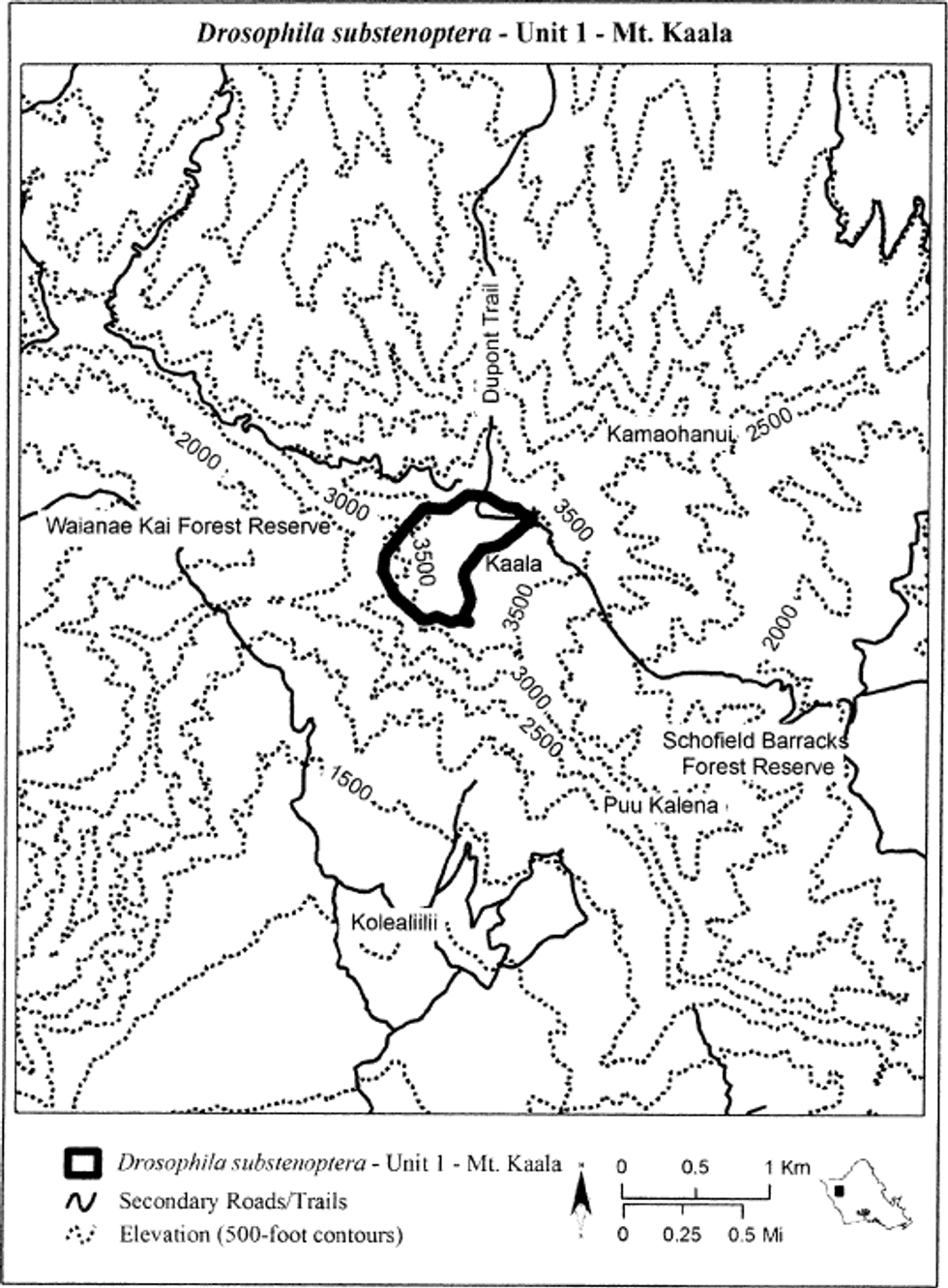
(7) Drosophila substenoptera - Unit 2 - Palikea, City and County of Honolulu, island of Oahu, Hawaii.
(i) Land bounded by the following coordinates: 593529, 2367854; 593448, 2367801; 593302, 2367874; 593242, 2367927; 593193, 2367967; 593165, 2368065; 593217, 2368150; 593314, 2368283; 593399, 2368425; 593448, 2368578; 593505, 2368716; 593622, 2368833; 593703, 2368906; 593764, 2368963; 593832, 2369044; 593901, 2369145; 594002, 2369262; 594079, 2369331; 594104, 2369396; 594120, 2369485; 594124, 2369521; 594148, 2369525; 594213, 2369525; 594310, 2369497; 594395, 2369473; 594399, 2369392; 594396, 2369356; 594417, 2369313; 594461, 2369290; 594551, 2369278; 594579, 2369250; 594559, 2369197; 594472, 2369183; 594391, 2369179; 594354, 2369153; 594302, 2369072; 594257, 2369015; 594213, 2368914; 594136, 2368809; 594083, 2368672; 594035, 2368550; 593966, 2368417; 593966, 2368324; 593909, 2368259; 593792, 2368105; 593675, 2368000.
(ii) Note: Map of Drosophila substenoptera - Unit 2 - Palikea follows:
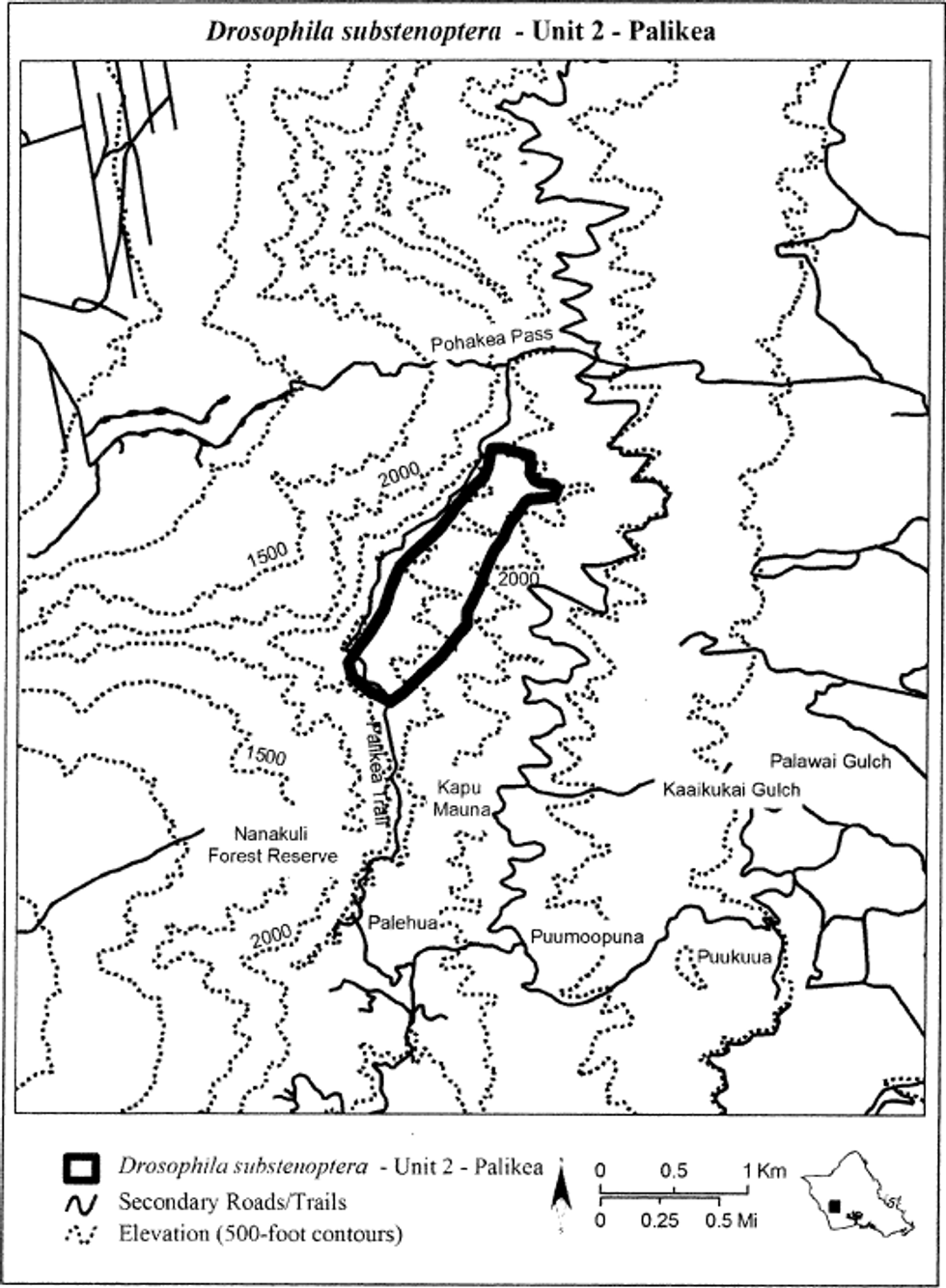
Hawaiian picture-wing fly (Drosophila tarphytrichia)
(1) Critical habitat units are depicted for County of Honolulu, island of Oahu, Hawaii, on the maps below. The maps provided are for informational purposes only.
(2) The primary constituent elements of critical habitat for Drosophila tarphytrichia are:
(i) Dry to mesic, lowland, ohia and koa forest between the elevations of 1,720-2,985 ft (524-910 m); and
(ii) The larval host plant Charpentiera obovata, which exhibits one or more life stages (from seedlings to senescent individuals).
(3) Critical habitat does not include manmade structures (such as buildings, aqueducts, airports, and roads) and the land on which they are located existing within the legal boundaries on the effective date of this rule.
(4) Critical habitat map units. Coordinates are in Universal Transverse Mercator (UTM) Zone 4 with units in meters using North American Datum of 1983 (NAD83).
(5) Note: Index map of critical habitat units for Drosophila tarphytrichia follows:

(6) Drosophila tarphytrichia - Unit 1 - Kaluaa Gulch, City and County of Honolulu, island of Oahu, Hawaii.
(i) Land bounded by the following coordinates: 593240, 2374436; 593231, 2374371; 593281, 2374410; 593315, 2374385; 593612, 2374173; 593656, 2374138; 593621, 2374096; 593641, 2374077; 593676, 2374072; 593703, 2374057; 593734, 2374039; 593758, 2374058; 593793, 2374029; 593779, 2373964; 593731, 2373894; 593660, 2373784; 593609, 2373702; 593592, 2373648; 593592, 2373594; 593598, 2373553; 593657, 2373561; 593770, 2373549; 593792, 2373496; 593797, 2373417; 593842, 2373411; 593842, 2373326; 593905, 2373404; 594053, 2373383; 594103, 2373292; 594134, 2373228; 594156, 2373250; 594194, 2373256; 594178, 2373323; 594196, 2373386; 594229, 2373390; 594312, 2373340; 594341, 2373350; 594339, 2373421; 594383, 2373487; 594381, 2373513; 594460, 2373552; 594496, 2373553; 594497, 2373518; 594526, 2373509; 594572, 2373460; 594632, 2373519; 594649, 2373523; 594699, 2373475; 594728, 2373476; 594762, 2373532; 594791, 2373529; 594828, 2373501; 594852, 2373465; 594903, 2373501; 594933, 2373500; 594952, 2373489; 594974, 2373334; 594800, 2373150; 594718, 2373120; 594718, 2373102; 594744, 2373091; 594710, 2372721; 594720, 2372686; 594716, 2372633; 594678, 2372623; 594566, 2372651; 594536, 2372666; 594506, 2372663; 594467, 2372672; 594395, 2372663; 594406, 2372650; 594546, 2372567; 594558, 2372553; 594551, 2372535; 594389, 2372452; 594395, 2372434; 594415, 2372428; 594511, 2372449; 594603, 2372437; 594614, 2372421; 594607, 2372385; 594593, 2372353; 594591, 2372317; 594618, 2372322; 594661, 2372357; 594700, 2372384; 594696, 2372334; 594697, 2372333; 594697, 2372283; 594652, 2372257; 594541, 2372266; 594454, 2372294; 594400, 2372294; 594293, 2372267; 594231, 2372261; 594168, 2372241; 594126, 2372258; 594075, 2372267; 594030, 2372303; 593999, 2372354; 593948, 2372388; 593889, 2372397; 593812, 2372413; 593781, 2372425; 593756, 2372442; 593742, 2372467; 593742, 2372490; 593736, 2372521; 593736, 2372560; 593757, 2372587; 593790, 2372662; 593663, 2372772; 593543, 2372859; 593558, 2372894; 593555, 2372910; 593526, 2372928; 593476, 2372912; 593422, 2372953; 593420, 2372976; 593403, 2372997; 593400, 2373025; 593373, 2373016; 593352, 2373044; 593328, 2373025; 593215, 2373118; 593230, 2373171; 593214, 2373176; 593163, 2373154; 593095, 2373213; 593091, 2373238; 593064, 2373243; 593019, 2373295; 592937, 2373388; 592889, 2373462; 592897, 2373535; 592908, 2373597; 592923, 2373668; 592914, 2373772; 592889, 2373866; 592868, 2373941; 592867, 2373950; 592894, 2374029; 592908, 2374120; 592894, 2374162; 592860, 2374213; 592854, 2374216; 593151, 2374494.
(ii) Note: Map of Drosophila tarphytrichia - Unit 1 - Kaluaa Gulch follows:
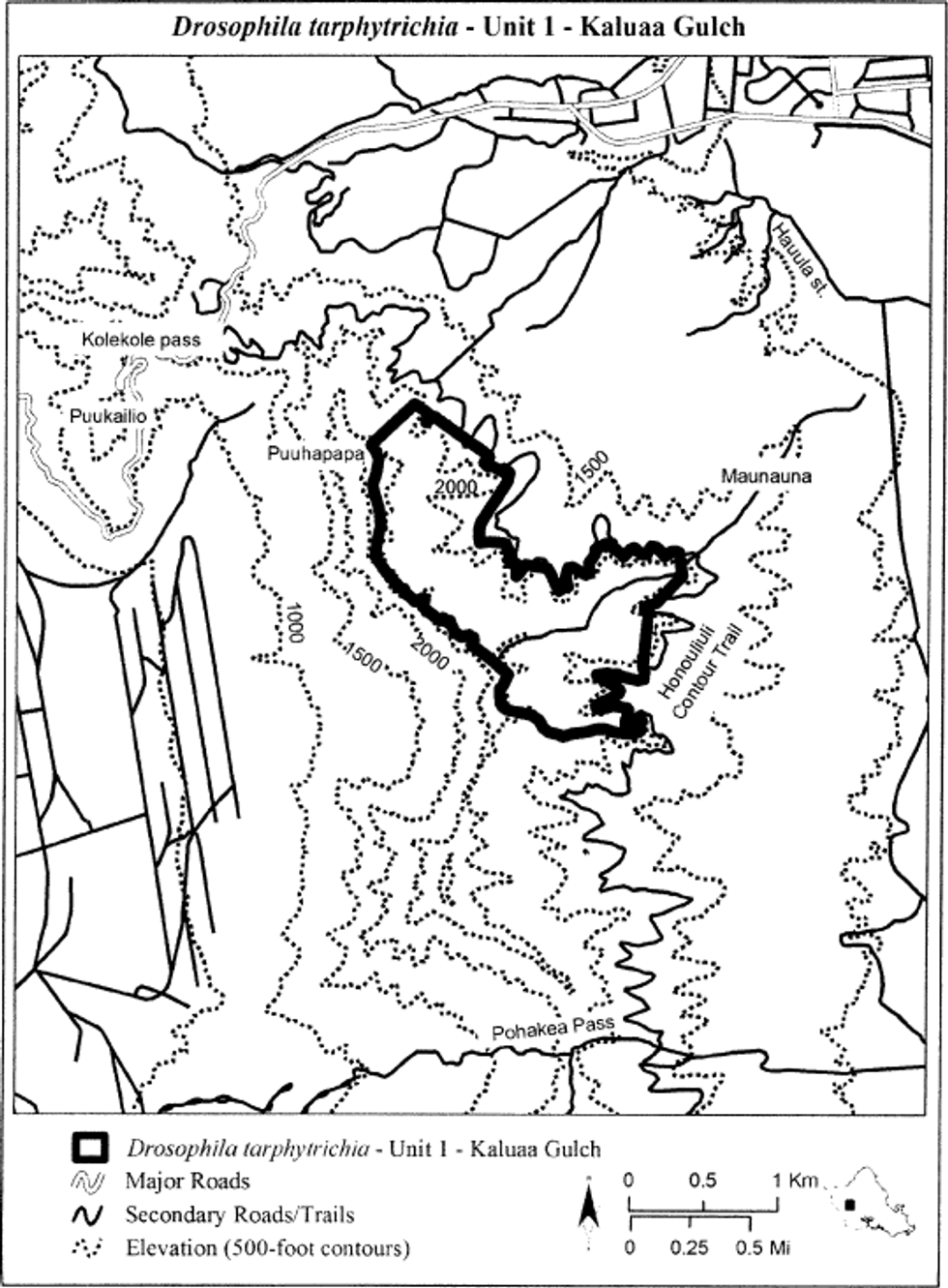
(7) Drosophila tarphytrichia - Unit 2 - Palikea, City and County of Honolulu, island of Oahu, Hawaii.
(i) Land bounded by the following coordinates: 593529, 2367854; 593448, 2367801; 593302, 2367874; 593242, 2367927; 593193, 2367967; 593165, 2368065; 593217, 2368150; 593314, 2368283; 593399, 2368425; 593448, 2368578; 593505, 2368716; 593622, 2368833; 593703, 2368906; 593764, 2368963; 593832, 2369044; 593901, 2369145; 594002, 2369262; 594079, 2369331; 594104, 2369396; 594120, 2369485; 594124, 2369521; 594148, 2369525; 594213, 2369525; 594310, 2369497; 594395, 2369473; 594399, 2369392; 594396, 2369356; 594417, 2369313; 594461, 2369290; 594551, 2369278; 594579, 2369250; 594559, 2369197; 594472, 2369183; 594391, 2369179; 594354, 2369153; 594302, 2369072; 594257, 2369015; 594213, 2368914; 594136, 2368809; 594083, 2368672; 594035, 2368550; 593966, 2368417; 593966, 2368324; 593909, 2368259; 593792, 2368105; 593675, 2368000.
(ii) Note: Map of Drosophila tarphytrichia - Unit 2 - Palikea follows:
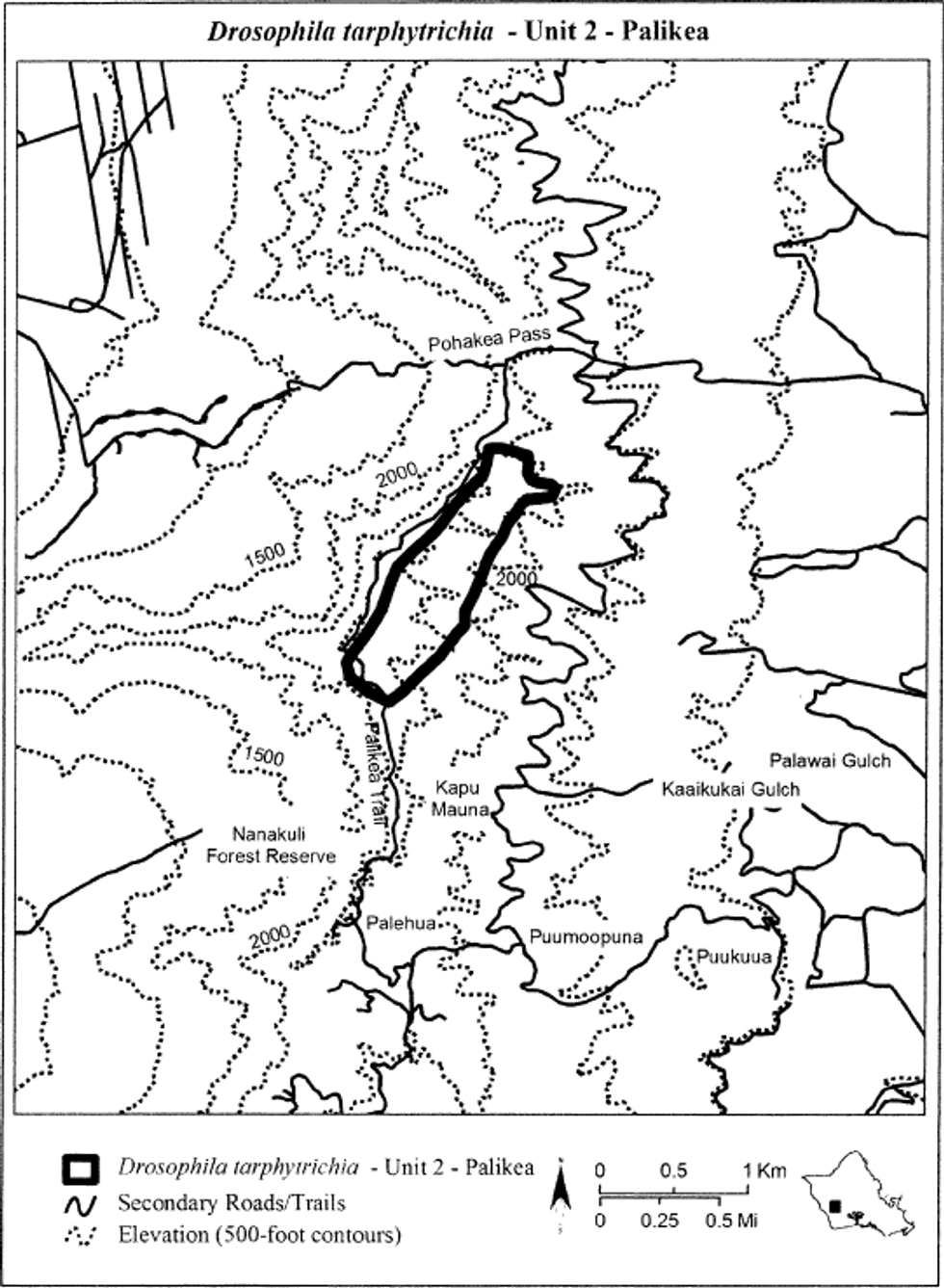
(8) Drosophila tarphytrichia - Unit 3 - Puu Kaua, City and County of Honolulu, island of Oahu, Hawaii.
(i) Land bounded by the following coordinates: 594166, 2370854; 594166, 2370853; 594164, 2370854; 594122, 2370843; 594090, 2370815; 594040, 2370789; 593996, 2370789; 593930, 2370827; 593852, 2370875; 593778, 2370907; 593716, 2370947; 593642, 2370999; 593602, 2371041; 593574, 2371067; 593558, 2371095; 593539, 2371118; 593531, 2371121; 593534, 2371173; 593519, 2371375; 593533, 2371375; 593552, 2371390; 593628, 2371404; 593716, 2371426; 593794, 2371431; 593876, 2371437; 593974, 2371435; 594036, 2371431; 594138, 2371415; 594190, 2371399; 594232, 2371385; 594246, 2371359; 594239, 2371354; 594170, 2370879; 594172, 2370877; 594170, 2370855.
(ii) Note: Map of Drosophila tarphytrichia - Unit 3 - Puu Kaua follows:
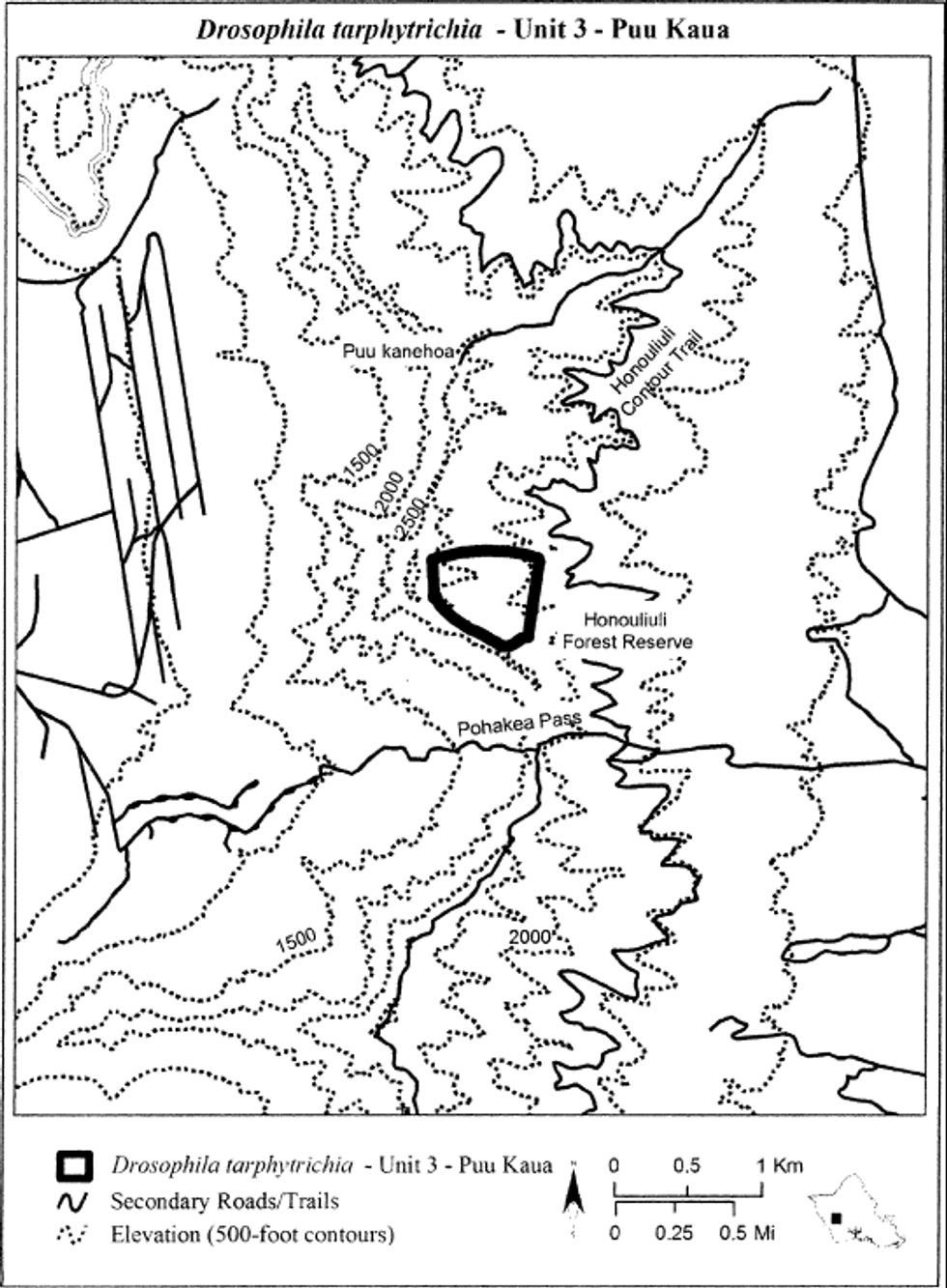
Zayante Band-Winged Grasshopper (Trimerotropis infantilis)
1. The unit of critical habitat is depicted for Santa Cruz County, California, on the map below. The map provided is for informational purposes only.
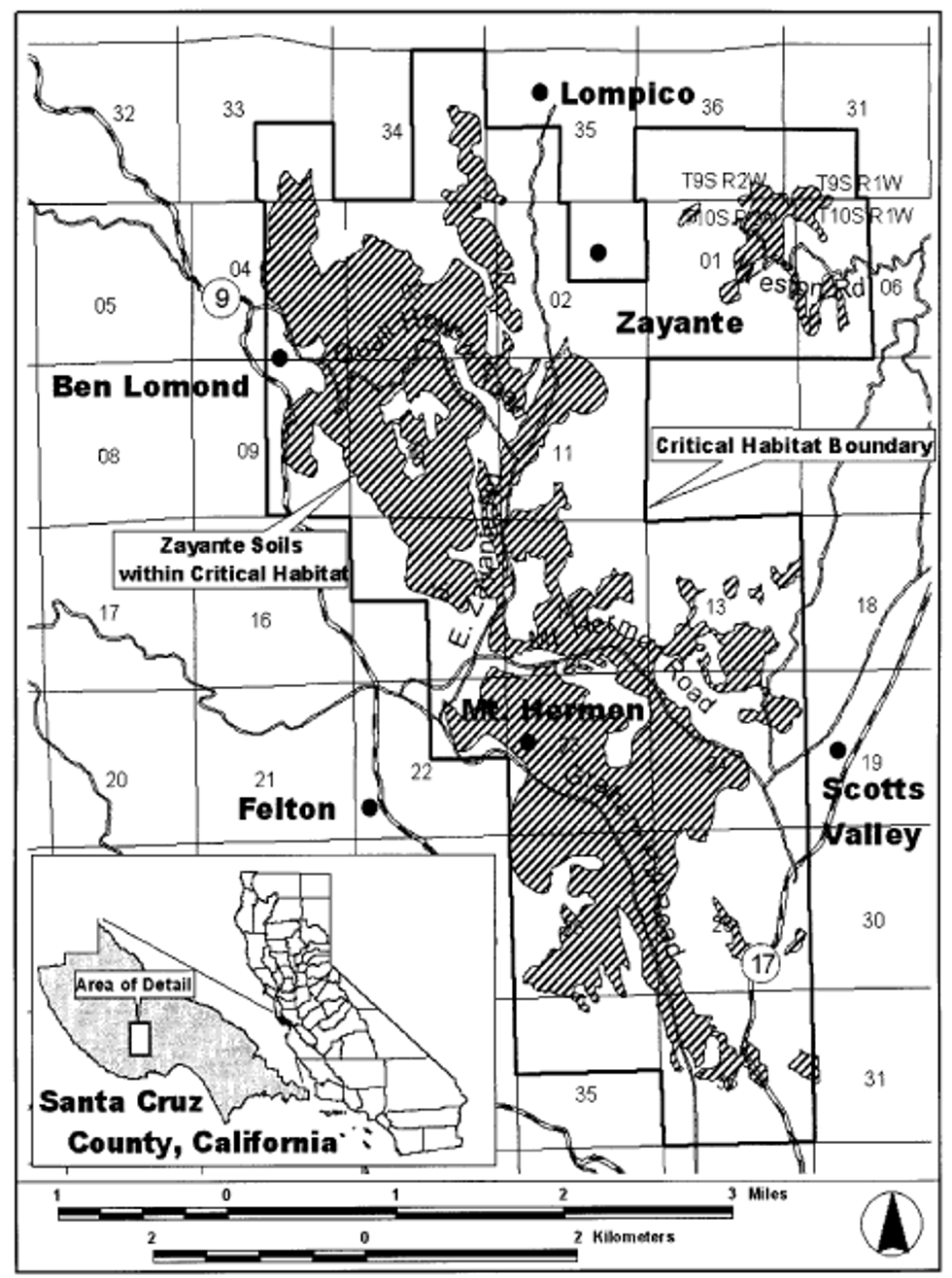
2. Within this area, the primary constituent elements for the Zayante band-winged grasshopper are those physical and biological elements that provide conditions that are essential for the primary biological needs of thermoregulation, foraging, sheltering, reproduction, and dispersal. The primary constituent elements are - (a) the presence of Zayante soils, (b) the occurrence of Zayante sand hills habitat and the associated plant species, and (c) certain microhabitat conditions, including areas that receive large amounts of sunlight, widely scattered tree and shrub cover, bare or sparsely vegetated ground, and loose sand. Zayante sand hills habitat is characterized by plant species associated with ponderosa pine sand parkland and/or silverleaf manzanita mixed chaparral. Plant species that may occur within the boundaries include, but are not limited to - ponderosa pine (Pinus ponderosa), silver-leafed manzanita (Arctostaphylos silvicola), California lilac (Ceonothus sp.), Adenostoma sp., yerba santa (Eriodictyon sp.), sandwort (Minuartia sp.), pussypaws (Calyptridium umbellatum), Ben Lomond spineflower (Erysimum teretifolium), monkeyflower (Mimulus rattanii), miniature lupine (Lupinis bicolor), gilia (Gilia tenuiflora), California aster (Lessingia filaginifolia), Ben Lomond buckwheat (Eriogonum nudum ssp. decurrens), and Ben Lomond spineflower (Chorizanthe pungens var. hartwegiana).
3. Critical habitat does not include existing developed sites consisting of buildings, roads, aquaducts, railroads, airports, paved areas, and similar features and structures.
Santa Cruz County, California. Boundaries are based upon the Public Land Survey System. Within the historical boundaries of the Land Grants of Zayanta, San Augustin, La Carbonera, and Canada Del Rincon En El Rio San Lorenzo De Santa Cruz, boundaries are based upon section lines that are extensions to the Public Land Survey System developed by the California Department of Forestry and obtained by the Service from the State of California's Stephen P. Teale Data Center. Township and Range numbering is derived from the Mount Diablo Base and Meridian. The following lands located within Santa Cruz County are being proposed for critical habitat: T.9 S., R.1 W., SE 1/4 sec. 31; T.9 S., R.2 W., SE 1/4 sec. 33, E 1/2 sec. 34, SW 1/4 sec. 35, S 1/2 sec. 3; T.10 S., R1 W., W 1/2 sec. 6; T.10 S., R.2 W., sec. 1, S 1/2 NW 1/4 sec. 2, sec. 3, W 1/2 sec. 4, W 1/2 sec. 9, sec. 10, sec. 11, sec. 13, sec. 14, N 1/2 SE 1/4 sec. 15, NE 1/4 sec. 22, secs. 23-26, N 1/2 sec. 35, sec. 36, excluding all lands covered under the Revised Habitat Conservation Plan for the Quail Hollow Quarry and the Habitat Conservation Plan for the Hanson Aggregates' Felton Plant.
Blackburn's Sphinx Moth (Manduca blackburni)
(1) Critical habitat units are depicted for the Hawaiian islands of Maui, Kahoolawe, Hawaii, and Molokai on the maps below. The maps provided are for informational purposes only.
(2) The primary constituent elements of critical habitat for Blackburn's sphinx moth include specific habitat components identified as essential for the primary biological needs of foraging, sheltering, maturation, dispersal, breeding, and egg-laying.
(i) Based on our current knowledge of the species, the primary constituent elements required by Blackburn's sphinx moth larvae for foraging and maturation are two larval host plant species in the endemic genus Nothocestrum (N. breviflorum and N. latifolium) and the habitats that support these plants, i.e., dry and mesic habitats between the elevations of sea level and 1,525 m (5,000 ft) that receive between 25 and 250 cm (10 and 100 in) of annual precipitation.
(ii) Based on our current knowledge of the species, the primary constituent elements required by Blackburn's sphinx moth adults for foraging, sheltering, dispersal, breeding, and egg production are native nectar-supplying plants, including, but not limited to, Ipomoea spp., Capparis sandwichiana, and Plumbago zeylanica, and the habitats that support these plants, i.e., dry and mesic habitats between the elevations of sea level and 1,525 m (5,000 ft) that receive between 25 and 250 cm (10 and 100 in) of annual precipitation.
(3) Existing manmade features and structures within the boundaries of the mapped areas do not contain one or more of the primary constituent elements described for the species in paragraph (2) of this section, and therefore, are not included in the critical habitat designations. These features include, but are not limited to: buildings; roads; aqueducts and other water system features such as pumping stations, irrigation ditches, pipelines, siphons, tunnels, water tanks, gauging stations (section in a stream channel equipped with facilities for obtaining streamflow data), intakes, and wells; telecommunications towers and associated structures and equipment; electrical power transmission lines and associated rights-of-way; radars; telemetry antennas; missile launch sites; arboreta and gardens; heiau (indigenous places of worship or shrines); airports; other paved areas; lawns; and other rural residential landscaped areas.
(4) Critical habitat units are described below. Coordinates are in UTM Zone 4 with units in meters using North American Datum of 1983 (NAD83). The following index map shows the general locations of the 9 critical habitat units designated on the islands of Hawaii, Kahoolawe, Maui, and Molokai.
(i) Note:Map 1 - State of Hawaii General Locations of Units for Blackburn's Sphinx Moth on Molokai, Maui, Kahoolawe, and Hawaii follows:
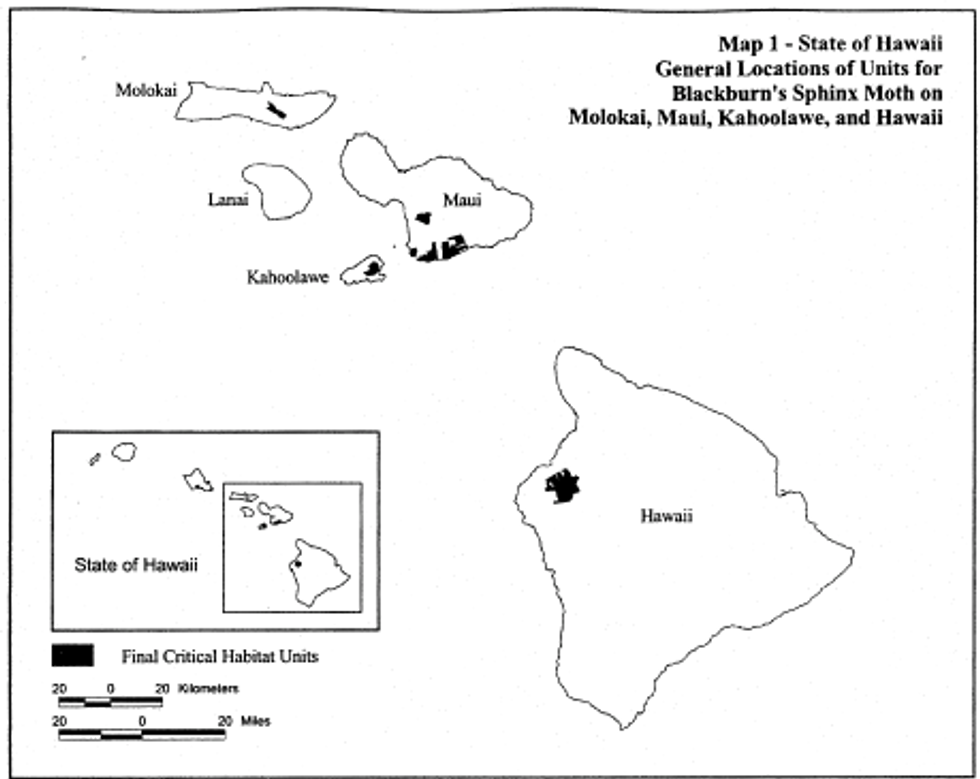
(ii) Unit 1: Island of Maui, Puu O Kali (1,604 ha; 3,965 ac):
(A) Unit 1 consists of the following 38 boundary points: Start at 770230, 2293671; 769969, 2293640; 769876, 2293794; 769523, 2293779; 769444, 2293784; 769146, 2293904; 769358, 2294451; 769492, 2294471; 769569, 2294563; 770123, 2294379; 770384, 2294317; 770707, 2294517; 770169, 2294794; 769629, 2295149; 769732, 2295410; 770032, 2295219; 769985, 2295371; 770360, 2295328; 769892, 2295671; 770362, 2295705; 770578, 2295954; 771492, 2296086; 772138, 2296102; 772522, 2296179; 772876, 2295933; 773384, 2295733; 773324, 2296764; 775265, 2296040; 775041, 2295484; 774484, 2295757; 774033, 2294844; 774654, 2294538; 774448, 2294006; 774392, 2292779; 773825, 2291760; 772032, 2292639; 770772, 2293255; 770524, 2293353; return to starting point.
(B) Note: Unit 1 is depicted below on Map 2 - Units 1, 2, 3, and 4 - Island of Maui.
(iii) Unit 2: Island of Maui, Cape Kinau (603 ha; 1,490 ac):
(A) Unit 2 consists of the following 36 boundary points: 769419, 2281688; 769716, 2281856; 769854, 2281648; 769726, 2281351; 769548, 2281173; 769433, 2280683; 769312, 2280406; 769251, 2280342; 769175, 2280353; 769073, 2280442; 768954, 2280466; 768791, 2280406; 768658, 2280329; 768621, 2280282; 768645, 2279874; 768737, 2279820; 767046, 2281800; 767136, 2281768; 767208, 2281837; 767139, 2281940; 767151, 2281994; 767136, 2282020; 767607, 2282308; 767710, 2282266; 767837, 2282318; 767857, 2282291; 768160, 2282410; 769380, 2282944; 769746, 2282588; 769429, 2282400; 769103, 2282123; 768598, 2281510; 768687, 2281391; 768737, 2281399; 768836, 2281460. 768738, 2279820. Coast.
(B) Note: Unit 2 is depicted below on Map 2 - Units 1, 2, 3, and 4 - Island of Maui.
(iv) Unit 3: Island of Maui, Kanaio (2,420 ha; 5,981 ac):
(A) Unit 3 consists of the following 45 boundary points: 777366, 2282219; 777421, 2281595; 777453, 2281235; 777531, 2280334; 777588, 2279661; 777719, 2278166; 770402, 2278173; 770445, 2278268; 770936, 2279194; 771208, 2279714; 771289, 2279691; 771211, 2279314; 771211, 2278906; 771368, 2278922; 771525, 2279173; 771854, 2279424; 772011, 2279707; 772231, 2279974; 772357, 2280335; 772451, 2280445; 772514, 2280351; 772561, 2280068; 772687, 2279848; 772938, 2279801; 773221, 2279817; 773425, 2280021; 773676, 2280335; 773676, 2280665; 773888, 2280993; 773606, 2281355; 774253, 2281430; 774897, 2280433; 775340, 2281119; 774662, 2281499; 775105, 2281701; 775435, 2282376; 775590, 2284264; 776004, 2284678; 776020, 2285055; 776484, 2284998; 776553, 2285169; 776691, 2285141; 776878, 2283402; 777021, 2282206; 777227, 2278017. Coast.
(B) Unit excludes an area (1 ha; 2 ac) consisting of the following 6 boundary points: 771887, 2277914; 771944, 2277910; 771986, 2277995; 771948, 2277989; 771909, 2277980; 771870, 2277975.
(C) Note: Unit 3 is depicted below on Map 2 - Units 1, 2, 3, and 4 - Island of Maui.
(v) Unit 4: Island of Maui, Kahikinui (4,799 ha; 11,859 ac):
(A) Unit 4 consists of the following 79 boundary points: 786068, 2283893; 786089, 2283760; 782956, 2282353; 783312, 2282399; 784167, 2282606; 784764, 2282682; 785521, 2282878; 786198, 2283068; 786227, 2282882; 786706, 2282953; 786657, 2283206; 787388, 2283424; 787555, 2283500; 788907, 2284087; 789388, 2283321; 789534, 2283053; 788185, 2282559; 786399, 2281761; 785563, 2281400; 785715, 2281039; 786057, 2280754; 786112, 2280548; 779950, 2278500; 779720, 2280135; 779703, 2280237; 779617, 2280887; 779412, 2282307; 779402, 2282377; 779372, 2282585; 779368, 2282602; 779376, 2282933; 779427, 2285142; 779549, 2285133; 779550, 2285007; 780604, 2285092; 781898, 2285373; 781956, 2285061; 781923, 2284848; 781966, 2284607; 781902, 2284320; 782032, 2283672; 782491, 2282783; 782731, 2282340; 783230, 2282514; 783112, 2282850; 782587, 2283565; 782996, 2283744; 783721, 2283912; 784941, 2284106; 784823, 2284611; 785088, 2284724; 785012, 2285109; 784719, 2285271; 784639, 2285526; 784482, 2285613; 784385, 2285910; 786498, 2286367; 787288, 2286710; 787415, 2286765; 787506, 2286804; 787311, 2286772; 782285, 2285909; 782162, 2286366; 781651, 2286291; 781569, 2286457; 782827, 2286695; 786589, 2287817; 787091, 2287913; 787800, 2286248; 787893, 2286297; 787957, 2285636; 788105, 2285388; 788261, 2285257; 788481, 2284803; 788363, 2284742; 786517, 2283943; 786510, 2283966; 786068, 2283893; 779965, 2278394. Coast.
(B) Note: Unit 4 is depicted on Map 2 - Units 1, 2, 3, and 4 - Island of Maui, which follows:
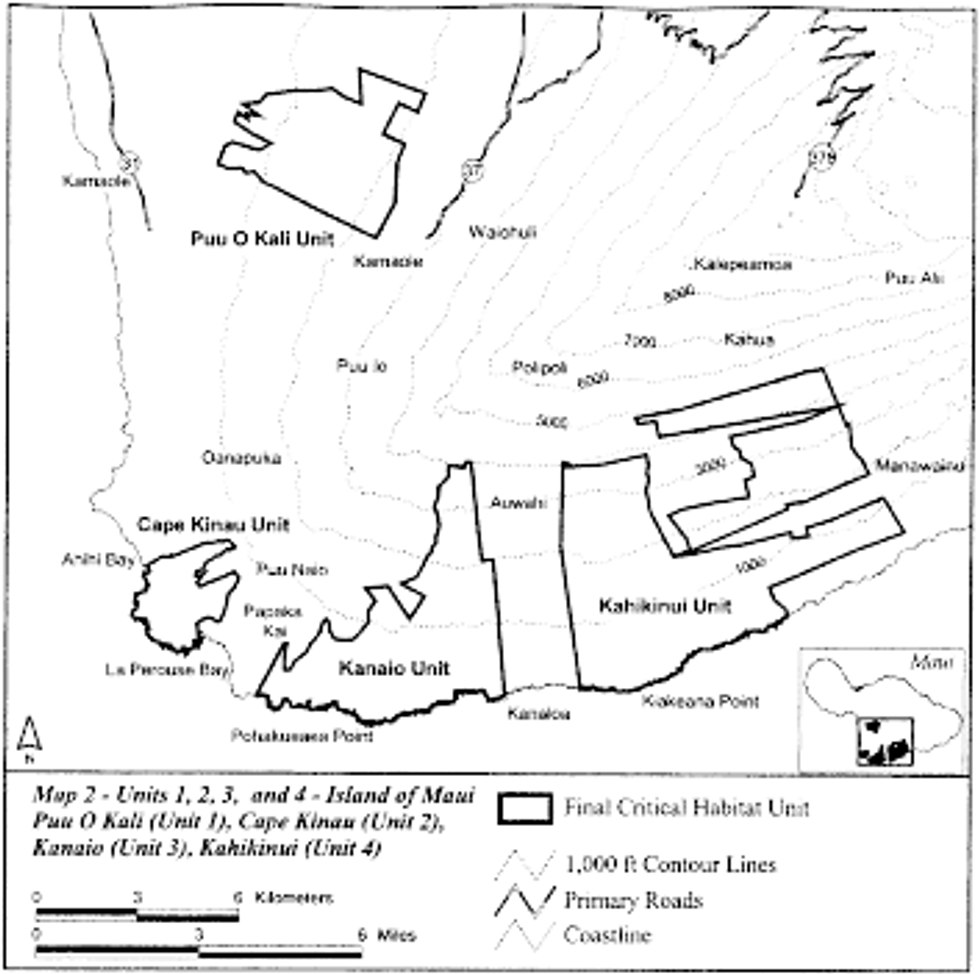
(vi) Unit 5: Island of Maui, Kanaha Pond (56 ha; 139 ac):
(A) Unit 5 consists of the following 35 boundary points: Start at 764695, 2312624; 764849, 2312615; 765062, 2312636; 765174, 2312639; 765226, 2312636; 765201, 2312573; 765221, 2312534; 765223, 2312502; 765259, 2312452; 765291, 2312304; 765287, 2312260; 765291, 2312223; 765281, 2312190; 765356, 2312144; 765352, 2312121; 765325, 2312090; 765284, 2312093; 765213, 2312118; 765183, 2312109; 765157, 2312091; 765106, 2312075; 765069, 2312044; 765036, 2312036; 764954, 2311971; 764872, 2311927; 764845, 2311912; 764588, 2311880; 764530, 2311946; 764474, 2311988; 764424, 2312038; 764390, 2312140; 764336, 2312293; 764397, 2312539; 764542, 2312565; 764615, 2312613; return to starting point.
(B) Note: Unit 5 is depicted below on Map 3 - Units 5 and 6 - Island of Maui.
(vii) Unit 6: Island of Maui, Kanaha Park (25 ha; 62 ac):
(A) Unit 6 consists of the following 7 boundary points: 766783, 2313583; 766781, 2313351; 766330, 2313141; 765776, 2312874; 765717, 2312838; 765689, 2312823; 765557, 2313073. Coast.
(B) Note: Unit 6 is depicted on Map 3 - Units 5 and 6 - Island of Maui, which follows:
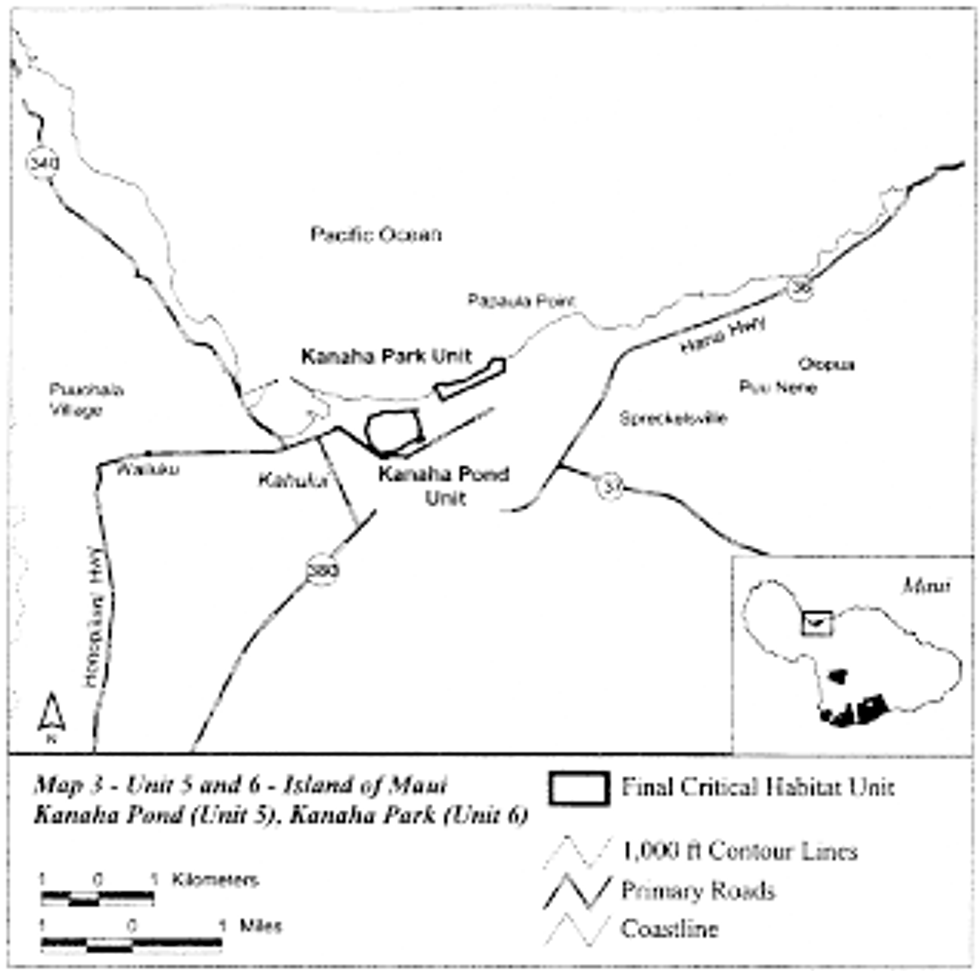
(viii) Unit 7: Island of Kahoolawe, Upper Kahoolawe (1,721 ha; 4,252 ac):
(A) Unit 7 consists of the following 39 boundary points: Start at 751848, 2276600; 751944, 2276801; 752021, 2277051; 752708, 2277402; 752817, 2277444; 752922, 2277482; 753039, 2277468; 754266, 2276996; 754390, 2276868; 754486, 2276715; 754758, 2275711; 754871, 2275319; 754880, 2275141; 754868, 2275021; 754822, 2274844; 754523, 2273789; 754438, 2273635; 754364, 2273546; 754213, 2273418; 753057, 2272446; 752825, 2272362; 750995, 2272184; 750869, 2272206; 750787, 2272247; 749069, 2273302; 749575, 2273659; 750287, 2273729; 750943, 2273970; 751205, 2274403; 751431, 2274927; 751475, 2275037; 751531, 2275180; 751447, 2275330; 751428, 2275366; 751291, 2275543; 751032, 2275938; 751109, 2276062; 751570, 2276254; 751752, 2276408; return to starting point.
(B) Note: Unit 7 is depicted on Map 4 - Unit 7 - Island of Kahoolawe, which follows:
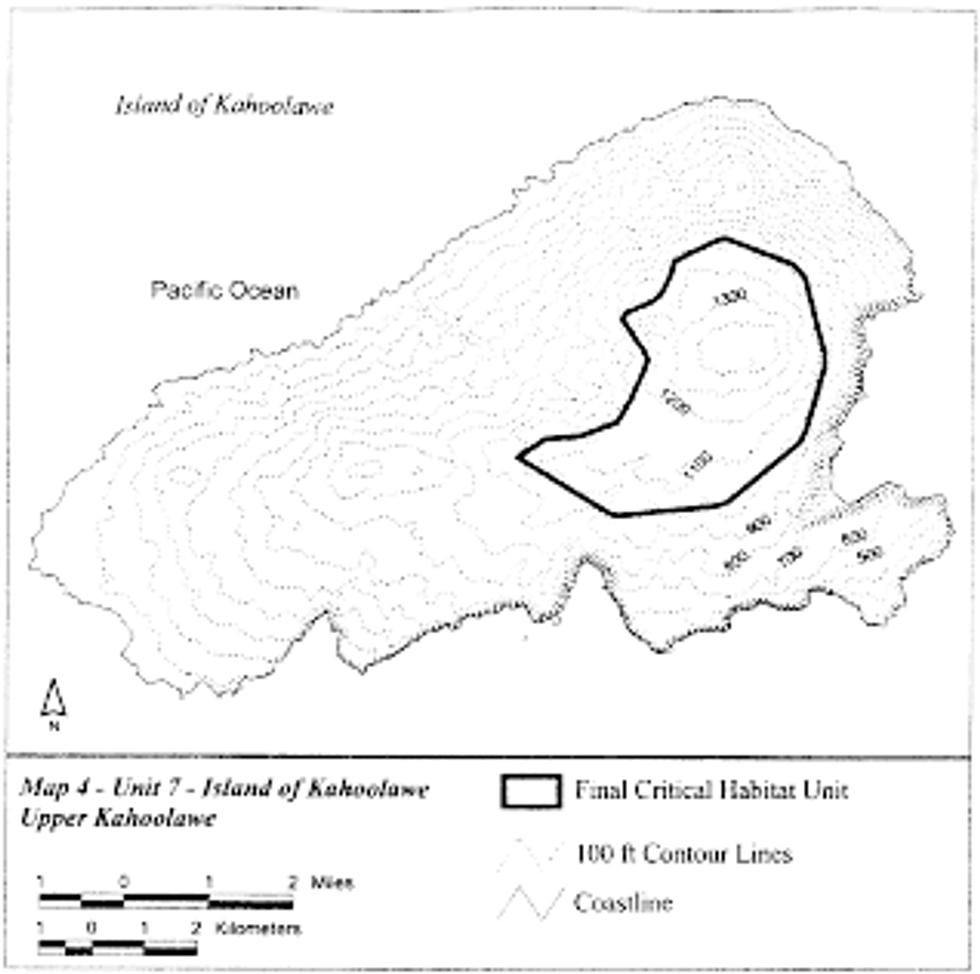
(ix) Unit 8: Island of Hawaii, Puuwaawaa - Hualalai (9,954 ha; 24,598 ac):
(A) Unit 8 consists of the following 449 boundary points: Start at 193748, 2193379; 193979, 2193518; 194022, 2193428; 194091, 2193386; 194109, 2193303; 194145, 2193281; 194185, 2193225; 194212, 2193188; 194225, 2193213; 194201, 2193260; 194232, 2193325; 194227, 2193356; 194266, 2193381; 194290, 2193366; 194306, 2193379; 194301, 2193431; 194281, 2193478; 194292, 2193504; 194286, 2193538; 194291, 2193598; 194328, 2193648; 194331, 2193666; 194320, 2193710; 194969, 2194077; 195027, 2194069; 195065, 2194098; 195121, 2194107; 195172, 2194152; 195231, 2194087; 195235, 2194013; 195256, 2193957; 195324, 2193909; 195378, 2193840; 195441, 2193804; 195564, 2193455; 195558, 2193407; 195590, 2193322; 195588, 2193245; 195641, 2193182; 195659, 2193134; 195645, 2193064; 195682, 2192983; 195722, 2192963; 195793, 2192836; 195838, 2192773; 195829, 2192664; 195844, 2192499; 195907, 2192445; 196009, 2192213; 196079, 2192144; 196061, 2192063; 196077, 2191999; 196121, 2191888; 196184, 2191891; 196196, 2191837; 196250, 2191837; 196287, 2191749; 196280, 2191681; 196331, 2191672; 196361, 2191560; 196379, 2191428; 196414, 2191446; 196473, 2191524; 196497, 2191624; 196494, 2191708; 196593, 2191768; 196656, 2191837; 196644, 2191885; 196593, 2192093; 196576, 2192195; 196596, 2192288; 196581, 2192409; 196566, 2192451; 196506, 2192484; 196397, 2192655; 196367, 2192770; 196427, 2192764; 196452, 2192703; 196581, 2192577; 196614, 2192547; 196623, 2192577; 196605, 2192634; 196608, 2192685; 196679, 2192667; 196749, 2192610; 196804, 2192476; 196831, 2192436; 196879, 2192403; 196885, 2192466; 196815, 2192586; 196717, 2192687; 196614, 2192809; 196241, 2193037; 196094, 2193227; 196003, 2193494; 195985, 2193759; 196088, 2193858; 195949, 2194099; 195958, 2194379; 195865, 2194469; 195811, 2194559; 196050, 2194687; 196076, 2194653; 196055, 2194610; 196109, 2194511; 196184, 2194505; 196223, 2194361; 196256, 2194337; 196322, 2194285; 196334, 2194171; 196370, 2194174; 196348, 2194291; 196379, 2194331; 196367, 2194427; 196363, 2194508; 196372, 2194578; 196427, 2194610; 196385, 2194670; 196314, 2194718; 196304, 2194841; 196831, 2195161; 196944, 2195021; 196930, 2194959; 197092, 2194830; 197104, 2194773; 197179, 2194752; 197273, 2194622; 197279, 2194550; 197361, 2194467; 197477, 2194325; 197573, 2194252; 197613, 2194177; 197654, 2194115; 197640, 2194033; 197654, 2193943; 197697, 2193753; 197750, 2193692; 197778, 2193488; 197871, 2193374; 197922, 2193401; 197995, 2193392; 198304, 2193109; 198362, 2193103; 198518, 2192944; 198584, 2192854; 198620, 2192761; 198680, 2192715; 198716, 2192658; 198731, 2192586; 198801, 2192589; 198879, 2192547; 198921, 2192493; 199051, 2192352; 199101, 2192412; 199177, 2192324; 199171, 2192201; 199246, 2192141; 199252, 2192243; 199294, 2192252; 199303, 2192291; 199225, 2192348; 199243, 2192397; 199186, 2192439; 199156, 2192529; 199084, 2192566; 199047, 2192643; 198948, 2192736; 198956, 2192786; 198949, 2192835; 198931, 2192888; 198913, 2192924; 198819, 2192954; 198760, 2192979; 198741, 2193028; 198777, 2193070; 198746, 2193098; 198718, 2193126; 198730, 2193180; 198683, 2193290; 198609, 2193325; 198679, 2193472; 198648, 2193542; 198669, 2193598; 198623, 2193633; 198602, 2193685; 198553, 2193675; 198480, 2193748; 198442, 2193839; 198494, 2193857; 198550, 2193860; 198819, 2193594; 198819, 2193514; 198882, 2193479; 198872, 2193388; 198872, 2193252; 198861, 2193199; 198844, 2193143; 198935, 2193063; 198981, 2193027; 199010, 2192968; 199103, 2193492; 199103, 2193552; 199015, 2193608; 198931, 2193619; 198910, 2193717; 198753, 2193867; 198735, 2193951; 198805, 2193972; 198889, 2193941; 198942, 2193853; 199005, 2193794; 199050, 2193829; 199001, 2193880; 199029, 2193930; 199092, 2193962; 199110, 2194004; 199025, 2194133; 199012, 2194241; 198896, 2194308; 198861, 2194399; 198799, 2194485; 198862, 2194479; 198938, 2194378; 199015, 2194329; 198987, 2194392; 198934, 2194434; 198931, 2194472; 198798, 2194560; 198795, 2194672; 198749, 2194749; 198623, 2194860; 198553, 2194937; 198550, 2195004; 198637, 2195060; 198683, 2195074; 198746, 2195175; 198714, 2195256; 198707, 2195340; 198588, 2195399; 198497, 2195417; 198402, 2195429; 198344, 2195490; 198302, 2195511; 198274, 2195563; 198179, 2195584; 198172, 2195658; 198127, 2195703; 198641, 2195878; 198662, 2195829; 198714, 2195780; 198732, 2195665; 198809, 2195633; 198970, 2195626; 199047, 2195549; 199075, 2195469; 199141, 2195427; 199087, 2195235; 199101, 2195127; 199124, 2194955; 199208, 2194840; 199267, 2194675; 199270, 2194567; 199260, 2194504; 199263, 2194437; 199310, 2194460; 199347, 2194479; 199306, 2194541; 199326, 2194591; 199424, 2194595; 199508, 2194525; 199522, 2194441; 199582, 2194392; 199598, 2194329; 199643, 2194295; 199662, 2194406; 199599, 2194462; 199596, 2194588; 199515, 2194853; 199368, 2195011; 199260, 2195319; 199312, 2195434; 199235, 2195476; 199274, 2195696; 199169, 2195847; 199138, 2195938; 199071, 2196039; 199663, 2196234; 199977, 2195921; 200985, 2194989; 201320, 2194454; 201268, 2194305; 201289, 2194176; 201150, 2193708; 201809, 2193212; 202487, 2192751; 202713, 2192557; 202794, 2192559; 203007, 2192869; 203088, 2192979; 203136, 2192967; 203139, 2192921; 203197, 2192911; 203224, 2192943; 203218, 2192991; 203264, 2193014; 203275, 2193130; 203278, 2193165; 203253, 2193224; 203277, 2193250; 203296, 2193248; 203321, 2193200; 203355, 2193261; 203340, 2193353; 203398, 2193434; 203487, 2193372; 203534, 2193296; 203580, 2193267; 203611, 2193247; 203631, 2193197; 203661, 2193126; 203650, 2193032; 203644, 2192994; 203649, 2192943; 203665, 2192930; 203692, 2192935; 203681, 2193005; 203695, 2193038; 203743, 2193045; 203751, 2193024; 203738, 2192991; 203747, 2192970; 203800, 2192948; 203810, 2192905; 203819, 2192867; 203833, 2192838; 203878, 2192830; 203916, 2192790; 203944, 2192724; 203935, 2192680; 203951, 2192655; 203968, 2192628; 203952, 2192587; 203978, 2192535; 203975, 2192477; 203992, 2192466; 204025, 2192444; 204044, 2192404; 204086, 2192392; 204133, 2192395; 204170, 2192417; 204186, 2192474; 204162, 2192528; 204130, 2192602; 204129, 2192641; 204081, 2192714; 204046, 2192717; 204022, 2192755; 204021, 2192835; 204057, 2192840; 204076, 2192827; 204105, 2192829; 204151, 2192846; 204218, 2192835; 204283, 2192808; 204311, 2192754; 204327, 2192655; 204350, 2192684; 204434, 2192709; 204459, 2192700; 204478, 2192684; 204469, 2192614; 204482, 2192593; 204485, 2192570; 204478, 2192547; 204485, 2192512; 204523, 2192529; 204540, 2192511; 204553, 2192479; 204294, 2191977; 203325, 2189871; 203670, 2189403; 203884, 2188867; 203876, 2188804; 204461, 2186966; 204241, 2186814; 203491, 2186573; 202905, 2186615; 201914, 2186332; 201935, 2186229; 201876, 2186192; 201969, 2186029; 201914, 2185947; 201962, 2185871; 201921, 2185754; 201866, 2185830; 201776, 2185816; 201838, 2185534; 201270, 2183971; 200424, 2183478; 194641, 2182859; 194391, 2182952; 194378, 2183030; 194326, 2183157; 194456, 2183246; 194375, 2183319; 194389, 2183392; 194641, 2183400; 195006, 2183522; 195441, 2183574; 195719, 2183591; 196066, 2183591; 196362, 2183670; 196372, 2183812; 195923, 2185051; 195805, 2185370; 195527, 2186175; 195324, 2186794; 195333, 2187189; 195544, 2187388; 195515, 2187690; 195450, 2187775; 193517, 2187814; 192035, 2187735; 191436, 2188145; 191395, 2188201; 191330, 2188228; 191183, 2188413; 191053, 2188549; 192020, 2188888; 192202, 2189030; 192137, 2189101; 192046, 2189432; 191945, 2189652; 191926, 2189817; 192000, 2189918; 191994, 2190055; 192009, 2190194; 191926, 2190322; 191954, 2190387; 191972, 2190616; 191961, 2190800; 191953, 2190938; 191917, 2191094; 191981, 2191296; 191943, 2191461; 191923, 2191548; 191871, 2191672; 191850, 2191864; 191834, 2192269; return to starting point.
(B) This unit excludes three areas:
(1) Unit excludes an area (292 ha; 723 ac) consisting of the following 53 boundary points: Start at 194866, 2189663; 194567, 2189462; 194355, 2189326; 194325, 2189306; 194187, 2189261; 193786, 2189183; 193790, 2189211; 193677, 2189413; 193430, 2189605; 193325, 2189528; 192941, 2190012; 192773, 2190361; 192668, 2190673; 192763, 2190854; 192807, 2191149; 192721, 2191436; 192600, 2191671; 192527, 2191928; 192513, 2192089; 192642, 2191999; 192658, 2191915; 192697, 2191881; 192913, 2191886; 193004, 2191923; 193133, 2191855; 193180, 2191784; 193280, 2191621; 193278, 2191563; 193175, 2191653; 193109, 2191763; 193075, 2191789; 192949, 2191779; 192960, 2191622; 193028, 2191556; 193012, 2191490; 193102, 2191393; 193291, 2191346; 193364, 2191272; 193540, 2191230; 193782, 2191099; 193918, 2190994; 193958, 2190933; 193989, 2190799; 193984, 2190718; 194048, 2190643; 194008, 2190547; 194039, 2190466; 194149, 2190358; 194304, 2190298; 194449, 2190177; 194695, 2189967; 194808, 2189833; 194848, 2189683; return to starting point.
(2) Unit excludes an area (15 ha; 38 ac) consisting of the following 12 boundary points: Start at 202034, 2189562; 202141, 2189566; 202153, 2189649; 202308, 2189645; 202298, 2189564; 202339, 2189548; 202329, 2189219; 202193, 2189187; 202230, 2189088; 202042, 2189024; 202020, 2189151; 202024, 2189554; return to starting point.
(3) Unit excludes an area (11 ha; 28 ac) consisting of the following 23 boundary points: Start at 199447, 2195793; 199533, 2195796; 199635, 2195736; 199639, 2195696; 199701, 2195643; 199708, 2195591; 199713, 2195537; 199743, 2195499; 199737, 2195444; 199746, 2195368; 199725, 2195312; 199732, 2195273; 199753, 2195207; 199772, 2195162; 199732, 2195181; 199706, 2195245; 199646, 2195283; 199615, 2195345; 199573, 2195368; 199509, 2195416; 199449, 2195478; 199437, 2195611; 199430, 2195734; return to starting point.
(C) Note: Unit 8 is depicted on Map 5-Unit 8 - Island of Hawaii, which follows:
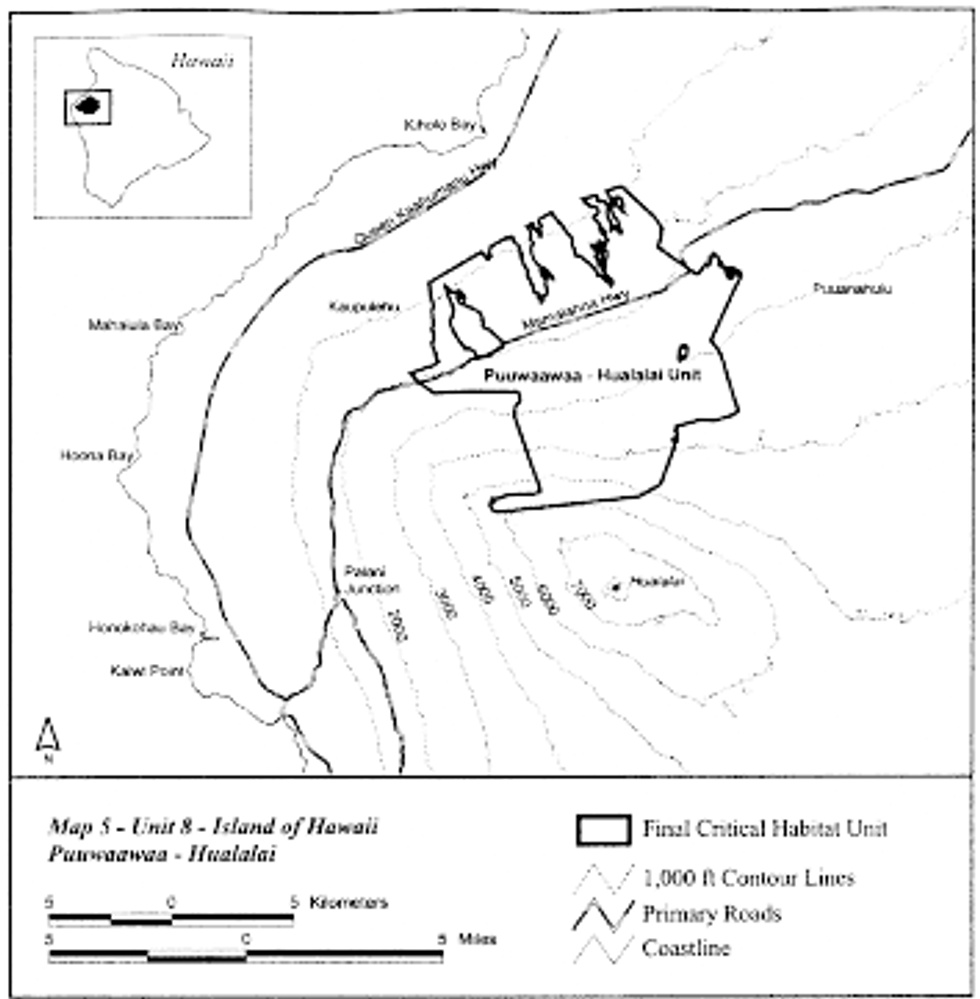
(x) Unit 9: Island of Molokai, Kamoko Flats - Puukolekole (1,256 ha; 3,105 ac):
(A) Unit 9 consists of the following 170 boundary points: Start at 713960, 2337883; 713787, 2337815; 713641, 2337737; 713587, 2337686; 713542, 2337635; 713525, 2337608; 713514, 2337604; 713488, 2337574; 713275, 2337497; 713260, 2337442; 713302, 2337415; 713444, 2337400; 713651, 2337482; 713677, 2337507; 713828, 2337580; 713834, 2337585; 713841, 2337587; 713989, 2337659; 714006, 2337664; 714030, 2337681; 714036, 2337674; 714090, 2337691; 714150, 2337601; 714065, 2337490; 714169, 2337531; 714182, 2337553; 714217, 2337500; 714313, 2337356; 714267, 2337327; 713658, 2336950; 713641, 2336937; 713639, 2336938; 713638, 2336937; 713592, 2336909; 713171, 2337020; 713128, 2337025; 713101, 2337039; 712948, 2337083; 712768, 2337134; 712739, 2337127; 712714, 2337150; 712707, 2337152; 712647, 2337156; 711929, 2337023; 712115, 2336844; 712527, 2336930; 712811, 2336772; 712314, 2336653; 712783, 2336203; 712700, 2336108; 712785, 2336093; 712927, 2336085; 713147, 2336184; 713257, 2336224; 713265, 2336238; 712778, 2336365; 712783, 2336372; 712923, 2336457; 713217, 2336633; 714333, 2337309; 714341, 2337313; 715056, 2336242; 715073, 2336232; 716805, 2335668; 717490, 2335146; 717565, 2335112; 718350, 2334490; 718276, 2333666; 717554, 2332806; 717447, 2332851; 717080, 2333001; 716796, 2333195; 715114, 2334345; 715139, 2334491; 715684, 2334688; 716000, 2334857; 715980, 2334880; 715849, 2335177; 715914, 2335254; 715842, 2335306; 715274, 2335635; 715213, 2335636; 715076, 2335749; 715046, 2335773; 714377, 2335948; 714372, 2335938; 714373, 2335938; 714280, 2335711; 714494, 2335653; 714617, 2335594; 714901, 2335519; 715544, 2335359; 715547, 2335358; 715174, 2335053; 715005, 2334932; 714716, 2334982; 714205, 2335078; 714040, 2335127; 714024, 2335088; 711244, 2336986; 711354, 2337009; 711401, 2337037; 711322, 2337112; 711727, 2337380; 711733, 2337403; 711948, 2337483; 712220, 2337776; 712433, 2338103; 712602, 2338152; 712517, 2338265; 712284, 2338486; 711968, 2338683; 711759, 2338845; 711681, 2338900; 711900, 2338941; 711710, 2339118; 711642, 2339123; 711579, 2339096; 711465, 2339097; 711625, 2339356; 711763, 2339365; 711777, 2339323; 711817, 2339308; 711969, 2339303; 712089, 2339324; 712130, 2339297; 712272, 2339304; 712447, 2339115; 712346, 2339007; 712231, 2338953; 712098, 2338911; 712002, 2338805; 712132, 2338664; 712392, 2338783; 712579, 2338783; 712421, 2338675; 712279, 2338579; 712353, 2338489; 712568, 2338528; 712635, 2338591; 712780, 2338508; 712777, 2338472; 712895, 2338488; 713001, 2338534; 713003, 2338502; 713072, 2338512; 713177, 2338629; 713424, 2338561; 713452, 2338533; 712978, 2338207; 712867, 2337997; 712845, 2337873; 713121, 2337952; 713150, 2337771; 713181, 2337784; 713184, 2337801; 713189, 2337803; 713196, 2337826; 713191, 2337829; 713197, 2337831; 713204, 2337853; 713303, 2337864; 713482, 2338023; 713503, 2338044; 713520, 2338067; 713525, 2338081; 713557, 2338108; 713664, 2338205; 713713, 2338254; 713731, 2338228; return to starting point.
(B) This unit excludes two areas:
(1) Unit excludes an area (2 ha; 4 ac) consisting of the following 5 boundary points: Start at 712804, 2337632; 712923, 2337724; 712990, 2337608; 712917, 2337600; 712748, 2337553; return to starting point.
(2) Unit excludes an area (5 ha; 13 ac) consisting of the following 10 boundary points: Start at 712742, 2337968; 712839, 2337857; 712748, 2337850; 712646, 2337870; 712632, 2337823; 712481, 2337590; 712425, 2337550; 712313, 2337564; 712299, 2337574; 712360, 2337661; return to starting point.
(C) Note: Unit 9 is depicted on Map 6-Unit 9-Island of Molokai, which follows:
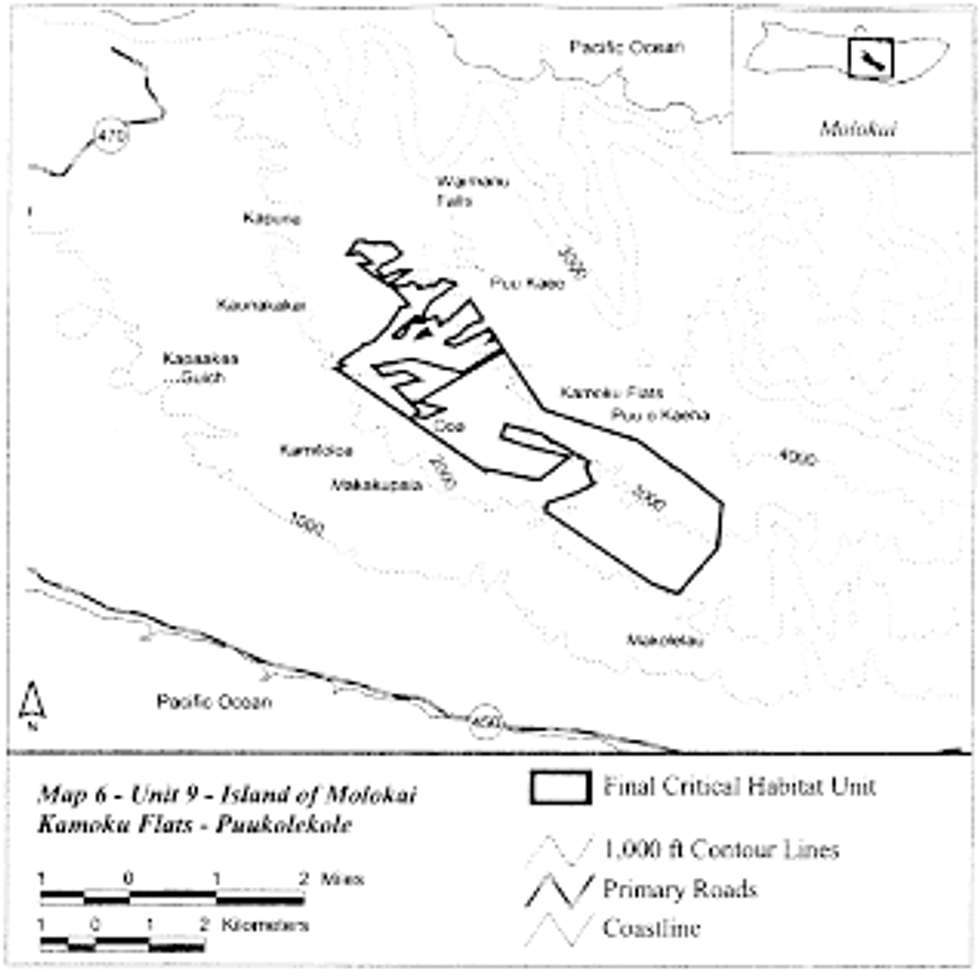
Ash Meadows Naucorid (Ambrysus amargosus)
Nevada, Nye County, Point of Rocks Springs and their immediate outflows in SE 1/4 sec. 7, T18S, R51E.
Known primary constituent elements include flowing warm water over rock and gravel substrate.
Note:
The map provided is for informational purposes only. Map follows:
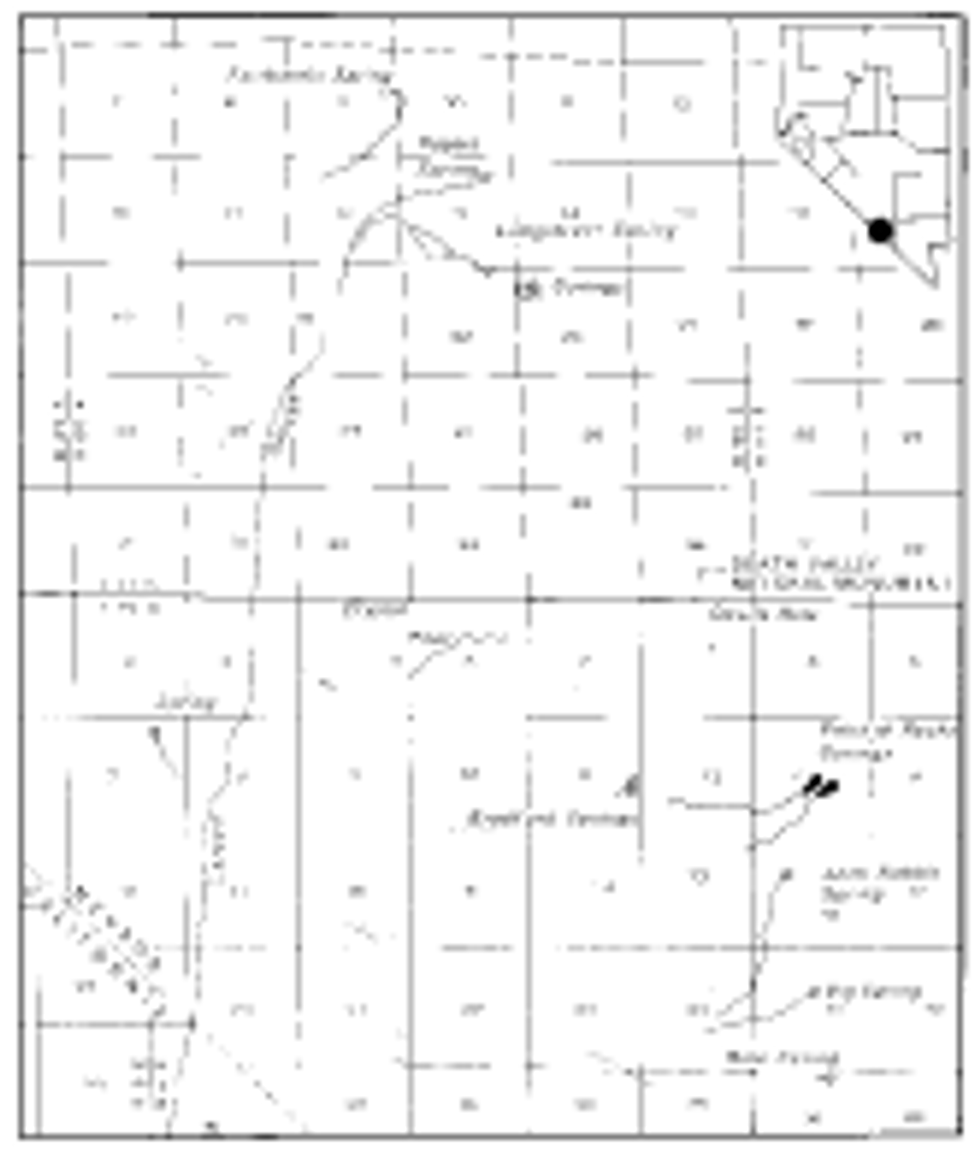
Dakota Skipper (Hesperia dacotae)
(1) Critical habitat units are designated in Chippewa, Clay, Kittson, Lincoln, Murray, Norman, Pipestone, Polk, Pope, and Swift Counties in Minnesota; McHenry, McKenzie, Ransom, Richland, and Rolette Counties in North Dakota; and Brookings, Day, Deuel, Grant, Marshall, and Roberts Counties in South Dakota, on the maps below.
(2) Within these areas, the primary constituent elements of the physical or biological features essential to the conservation of the Dakota skipper consist of three components:
(i) Primary Constituent Element 1 - Wet-mesic tallgrass or mixed-grass remnant untilled prairie that occurs on near-shore glacial lake soil deposits or high-quality dry-mesic remnant untilled prairie on rolling terrain consisting of gravelly glacial moraine soil deposits, containing:
(A) A predominance of native grasses and native flowering forbs;
(B) Glacial soils that provide the soil surface or near surface (between soil surface and 2 cm depth) micro-climate conditions conducive to Dakota skipper larval survival and native-prairie vegetation;
(C) If present, trees or large shrub cover of less than 5 percent of area in dry prairies and less than 25 percent in wet-mesic prairies; and
(D) If present, nonnative invasive plant species occurring in less than 5 percent of area.
(ii) Primary Constituent Element 2 - Native grasses and native flowering forbs for larval and adult food and shelter, specifically:
(A) At least one of the following native grasses to provide food and shelter sources during Dakota skipper larval stages: prairie dropseed (Sporobolus heterolepis) or little bluestem (Schizachyrium scoparium); and
(B) One or more of the following forbs in bloom to provide nectar and water sources during the Dakota skipper flight period: purple coneflower (Echinacea angustifolia), bluebell bellflower (Campanula rotundifolia), white prairie clover (Dalea candida), upright prairie coneflower (Ratibida columnifera), fleabane (Erigeron spp.), blanketflower (Gaillardia spp.), black-eyed Susan (Rudbeckia hirta), yellow sundrops (Calylophus serrulatus), prairie milkvetch (Astragalus adsurgens), or common gaillardia (Gaillardia aristata) .
(iii) Primary Constituent Element 3 - Dispersal grassland habitat that is within 1 km (0.6 mi) of native high-quality remnant prairie (as defined in Primary Constituent Element 1) that connects high-quality wet-mesic to dry tallgrass prairies or moist meadow habitats. Dispersal grassland habitat consists of undeveloped open areas dominated by perennial grassland with limited or no barriers to dispersal including tree or shrub cover less than 25 percent of the area and no row crops such as corn, beans, potatoes, or sunflowers.
(3) Critical habitat does not include manmade structures (such as buildings, aqueducts, runways, roads, and other paved areas) and the land on which they are located existing within the legal boundaries on November 2, 2015.
(4) Critical habitat map units. Data layers defining map units were created and digitized using ESRI's ArcMap (version 10.0) and comparing USGS NAIP/FSA high-resolution orthophotography from 2010 or later and previously mapped skipper habitat polygons submitted by contracted researchers or prairie habitat polygons made available from Minnesota Department of Natural Resources' County Biological Survey. Critical habitat units then were mapped in Geographic Coordinate System WGS84. The maps in this entry, as modified by any accompanying regulatory text, establish the boundaries of the critical habitat designation. The coordinates or plot points or both on which each map is based are available to the public at the Service's internet site (http://www.fws.gov/midwest/Endangered), at http://www.regulations.gov at Docket No. FWS-R3-ES-2013-0017, and at the field office responsible for this designation. You may obtain field office location information by contacting one of the Service regional offices, the addresses of which are listed at 50 CFR 2.2.
(5) Index map follows:
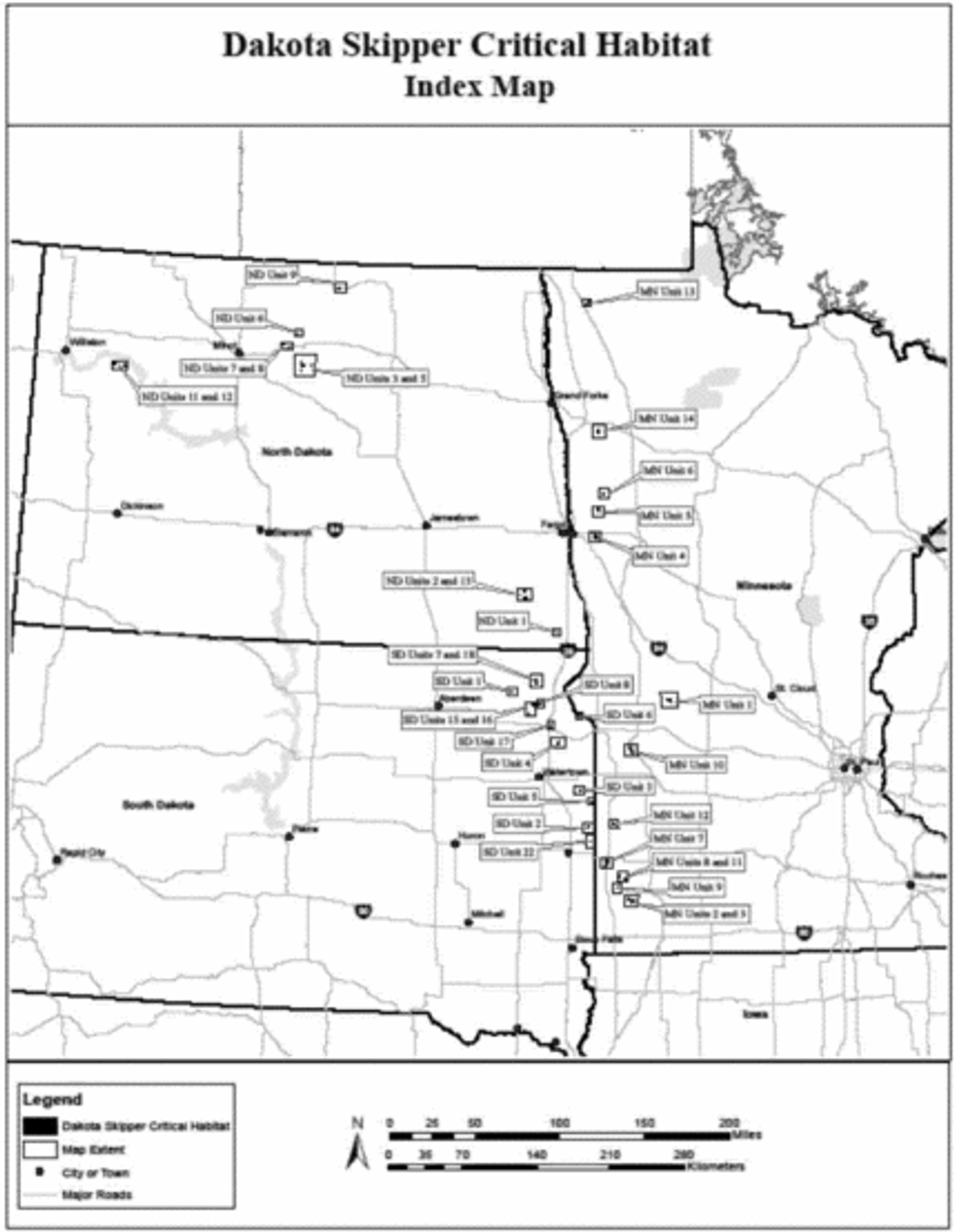
(6) DS Minnesota Unit 1, Pope County, Minnesota. Map of DS Minnesota Unit 1 follows:
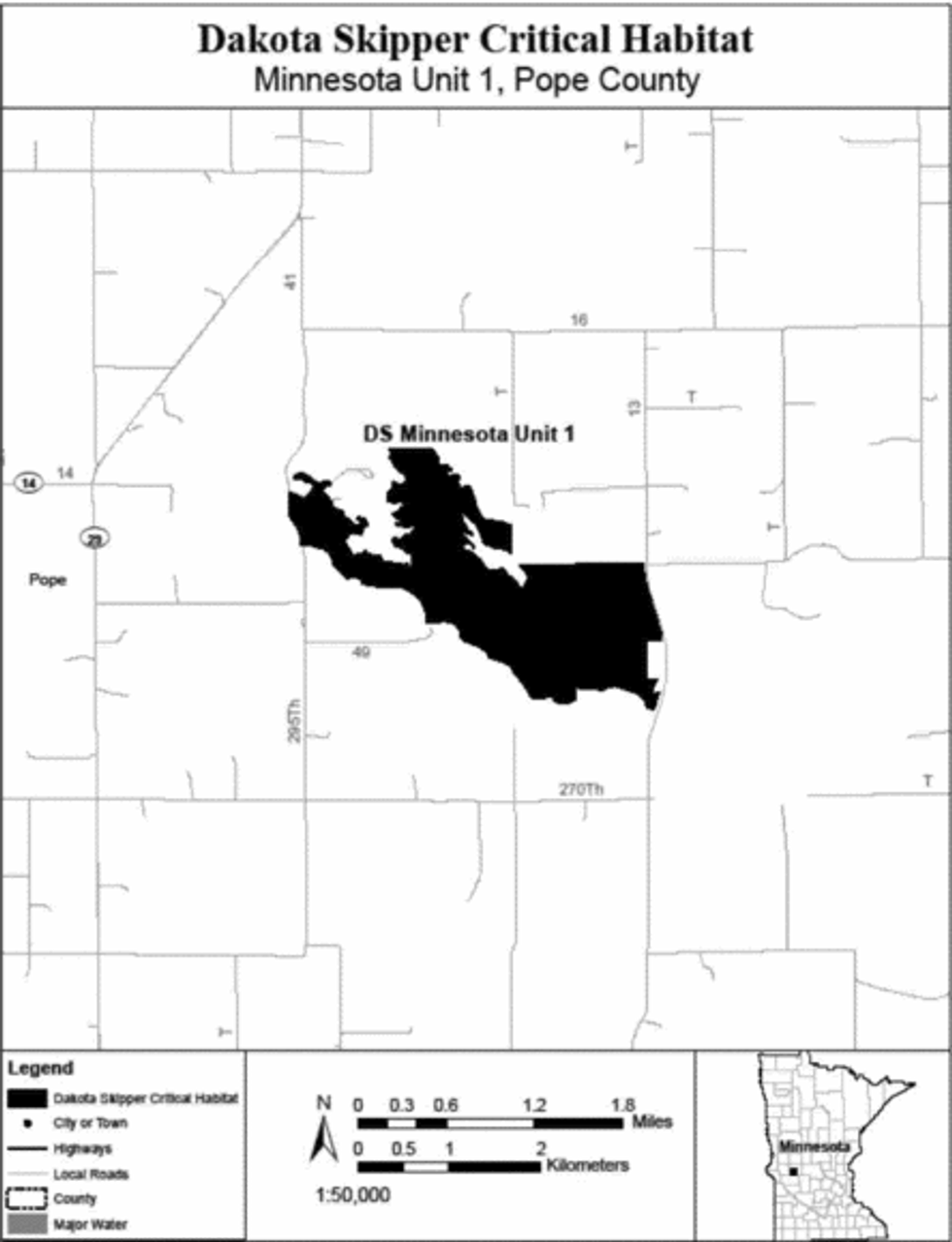
(7) DS Minnesota Units 2 and 3, Murray County, Minnesota. Map of DS Minnesota Units 2 and 3 follows:
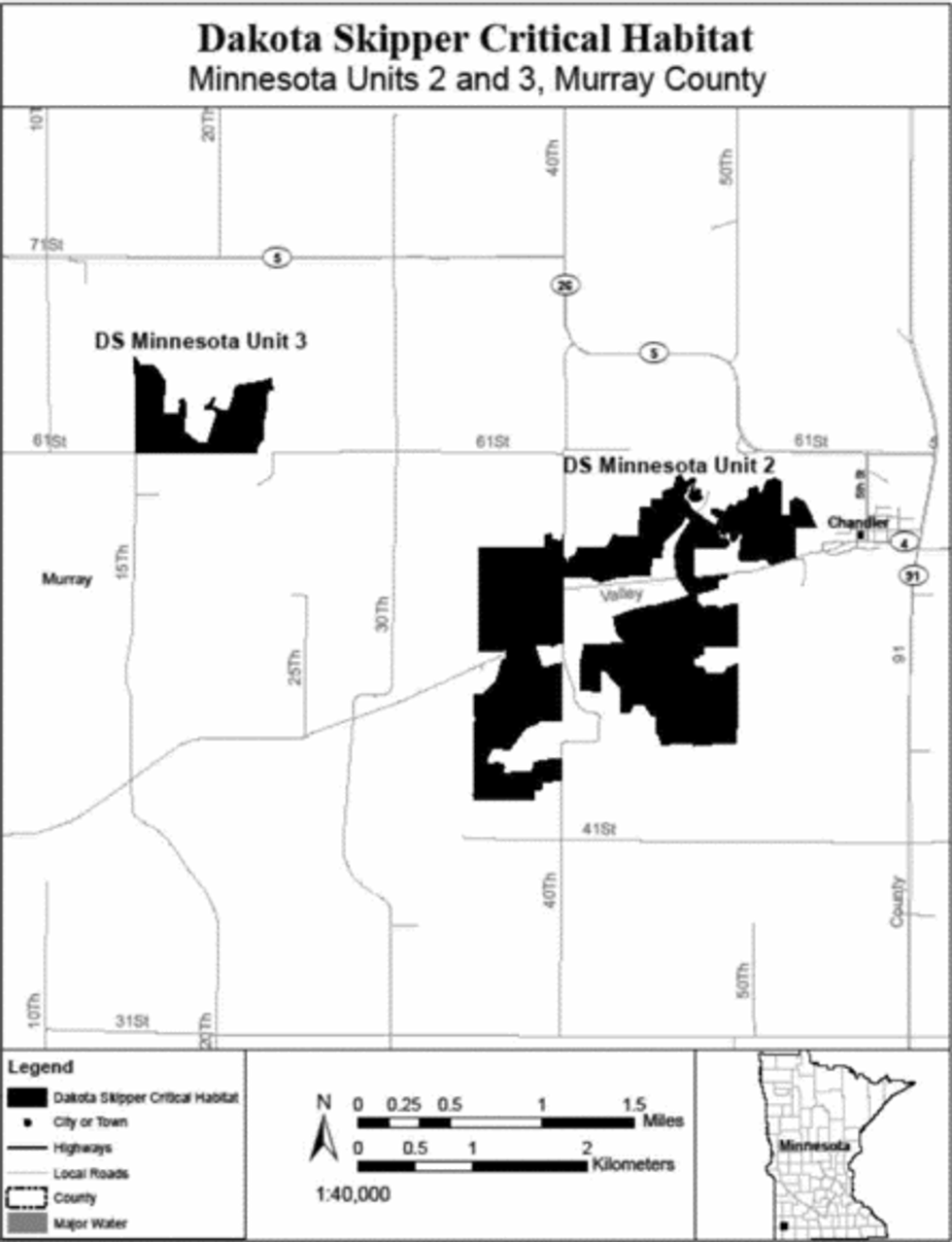
(8) DS Minnesota Unit 4, Clay County, Minnesota. Map of DS Minnesota Unit 4 follows:
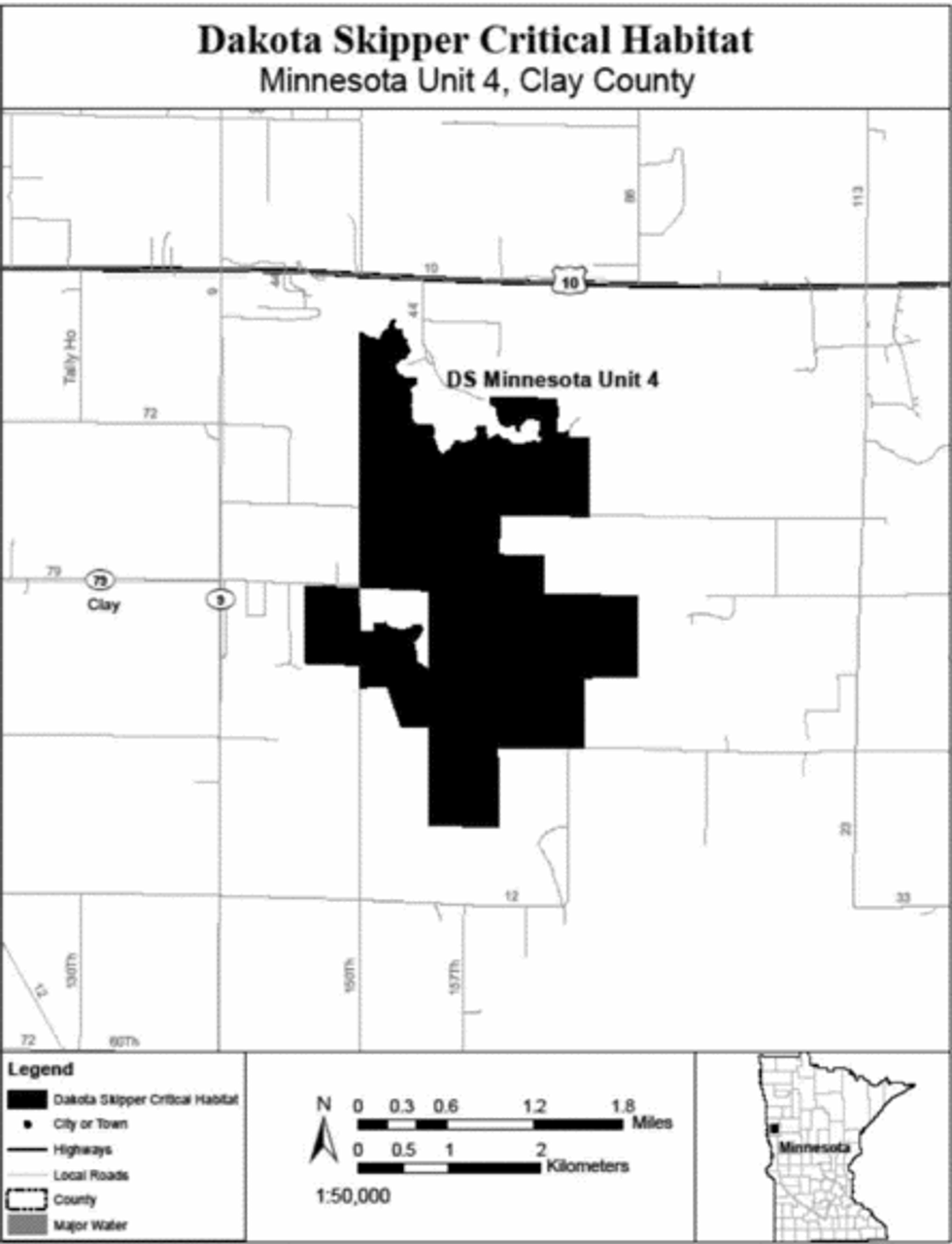
(9) DS Minnesota Unit 5, Clay County, Minnesota. Map of DS Minnesota Unit 5 follows:
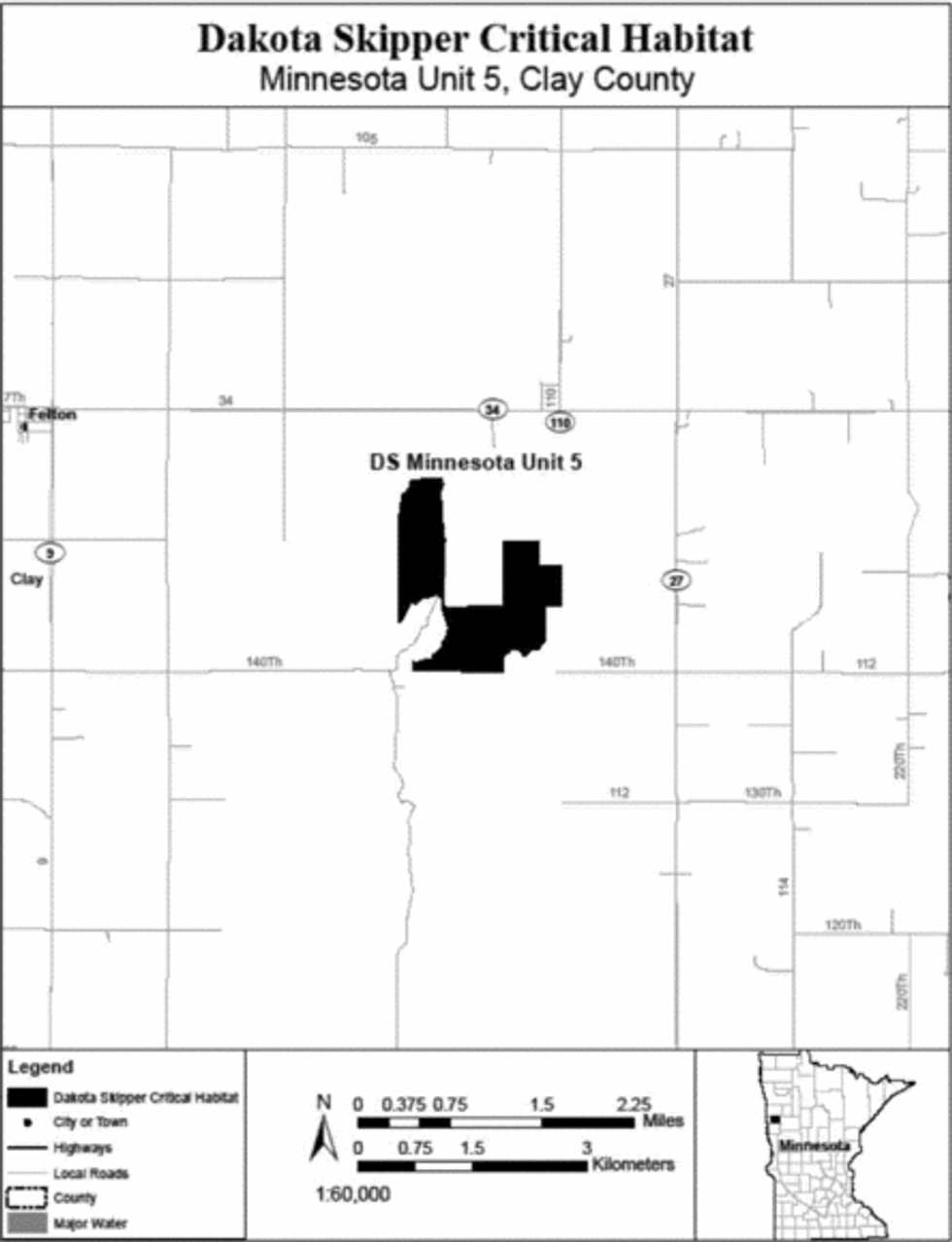
(10) DS Minnesota Unit 6, Norman County, Minnesota. Map of DS Minnesota Unit 6 follows:
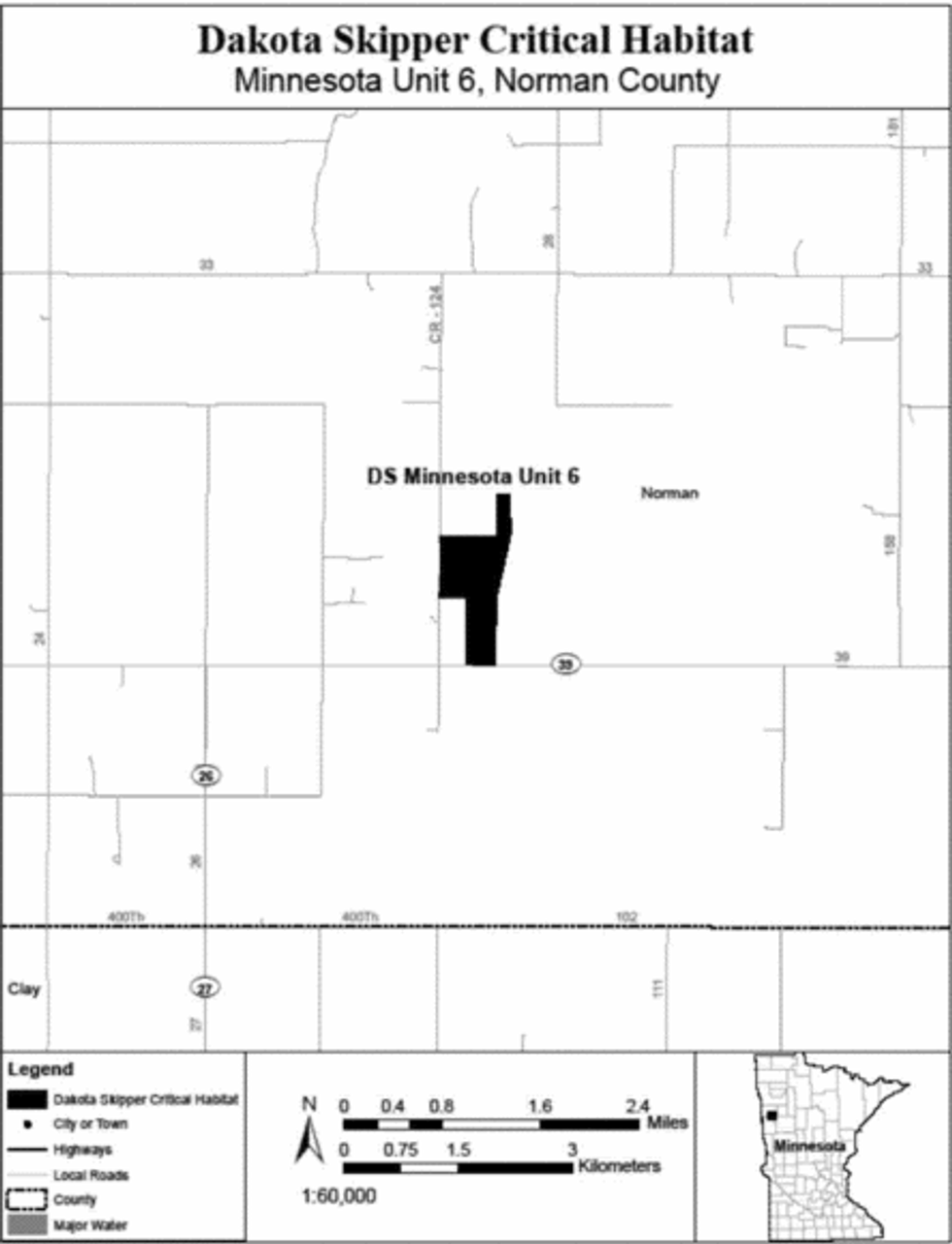
(11) DS Minnesota Unit 7, Lincoln and Pipestone Counties, Minnesota. Map of DS Minnesota Unit 7 follows:
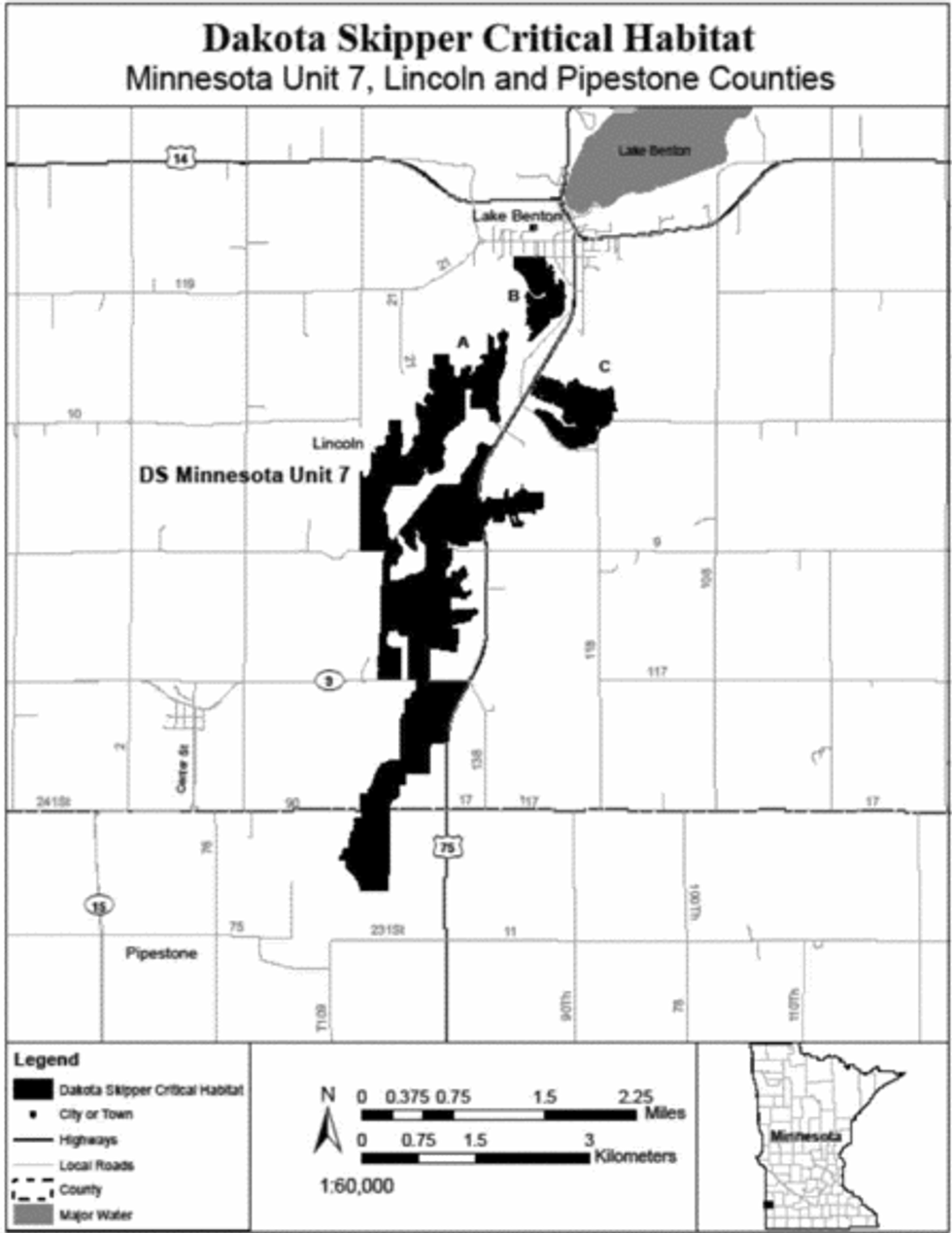
(12) DS Minnesota Units 8 and 11, Pipestone County, Minnesota. Map of DS Minnesota Units 8 and 11 follows:
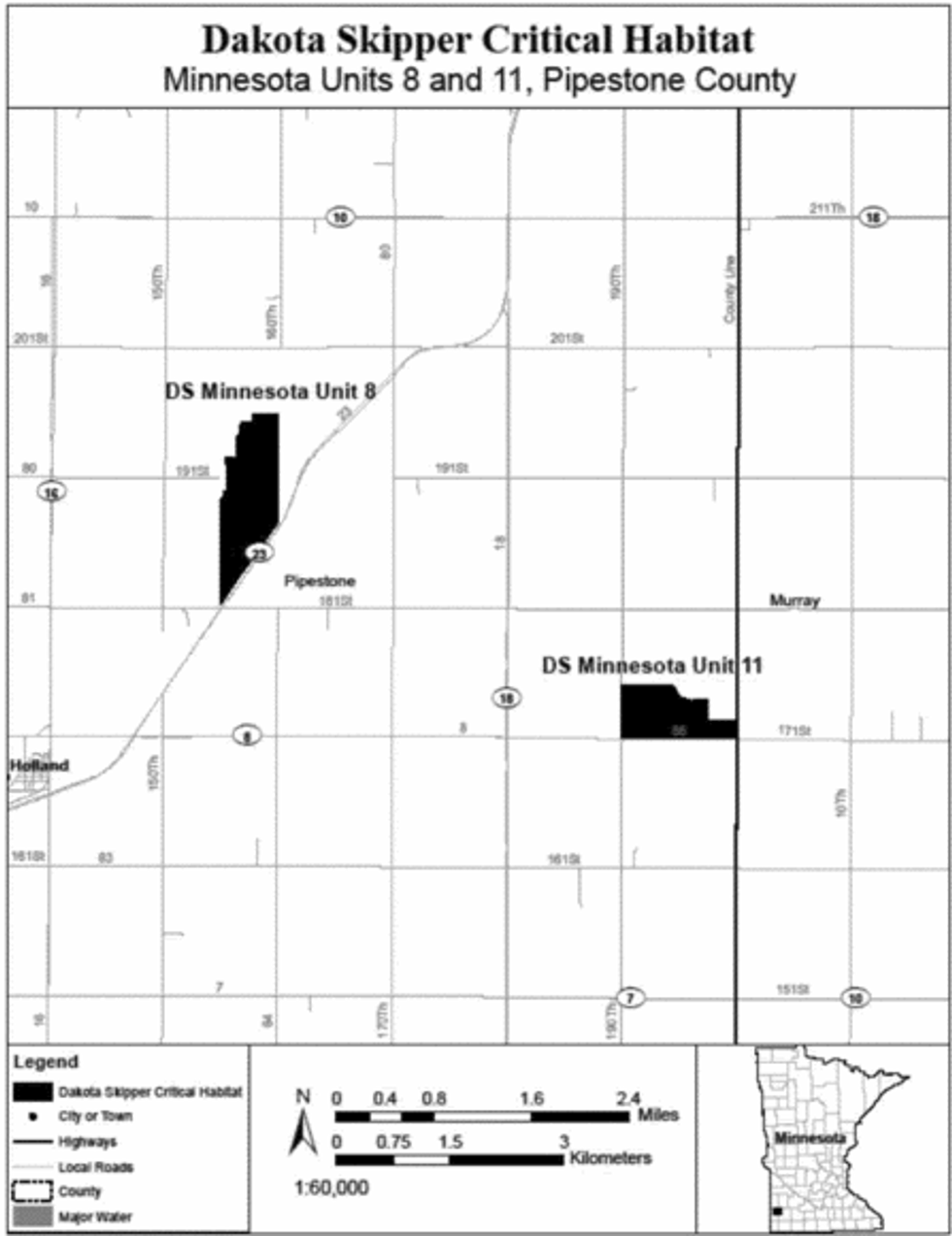
(13) DS Minnesota Unit 9, Pipestone County, Minnesota. Map of DS Minnesota Unit 9 follows:
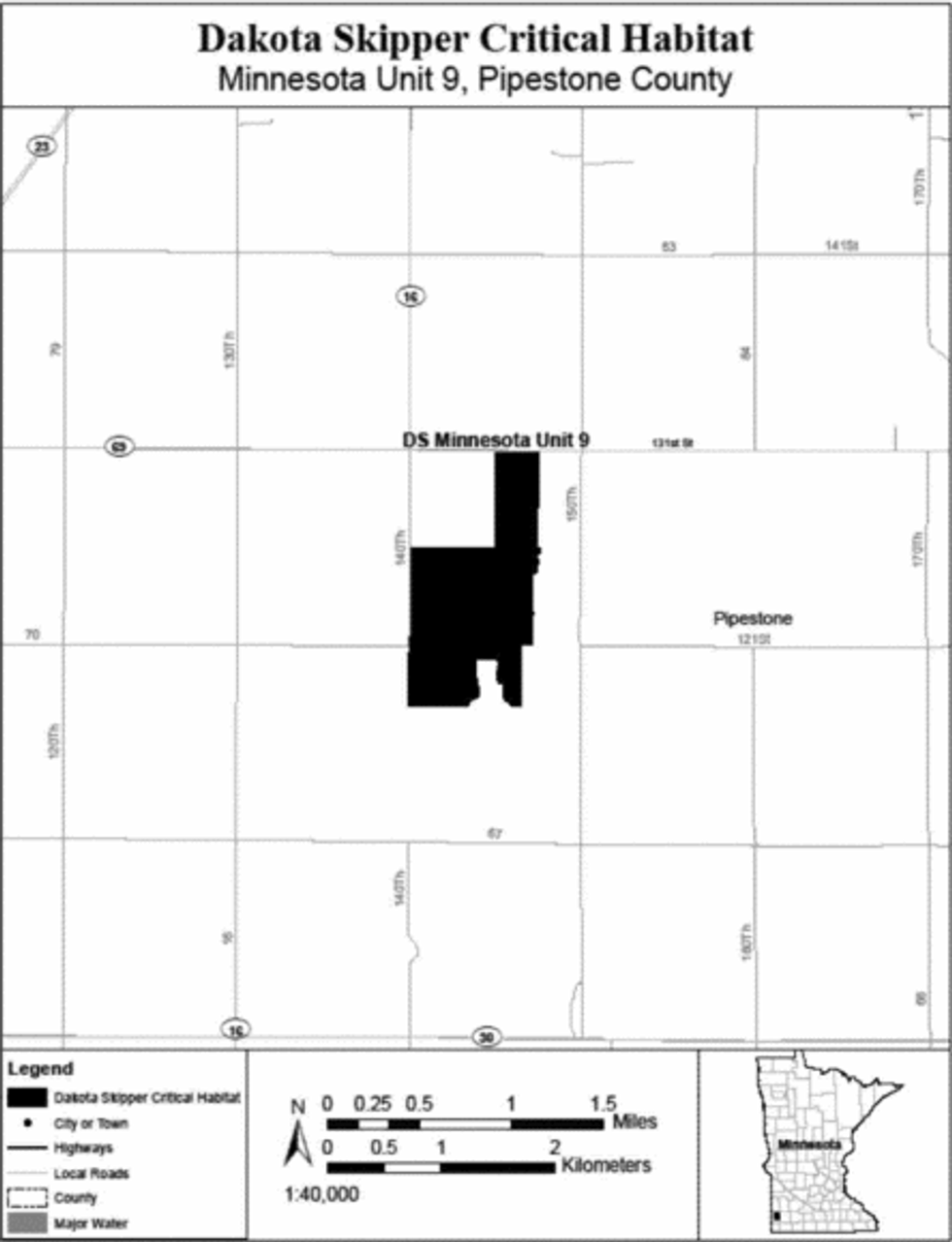
(14) DS Minnesota Unit 10, Swift and Chippewa Counties, Minnesota. Map of DS Minnesota Unit 10 follows:
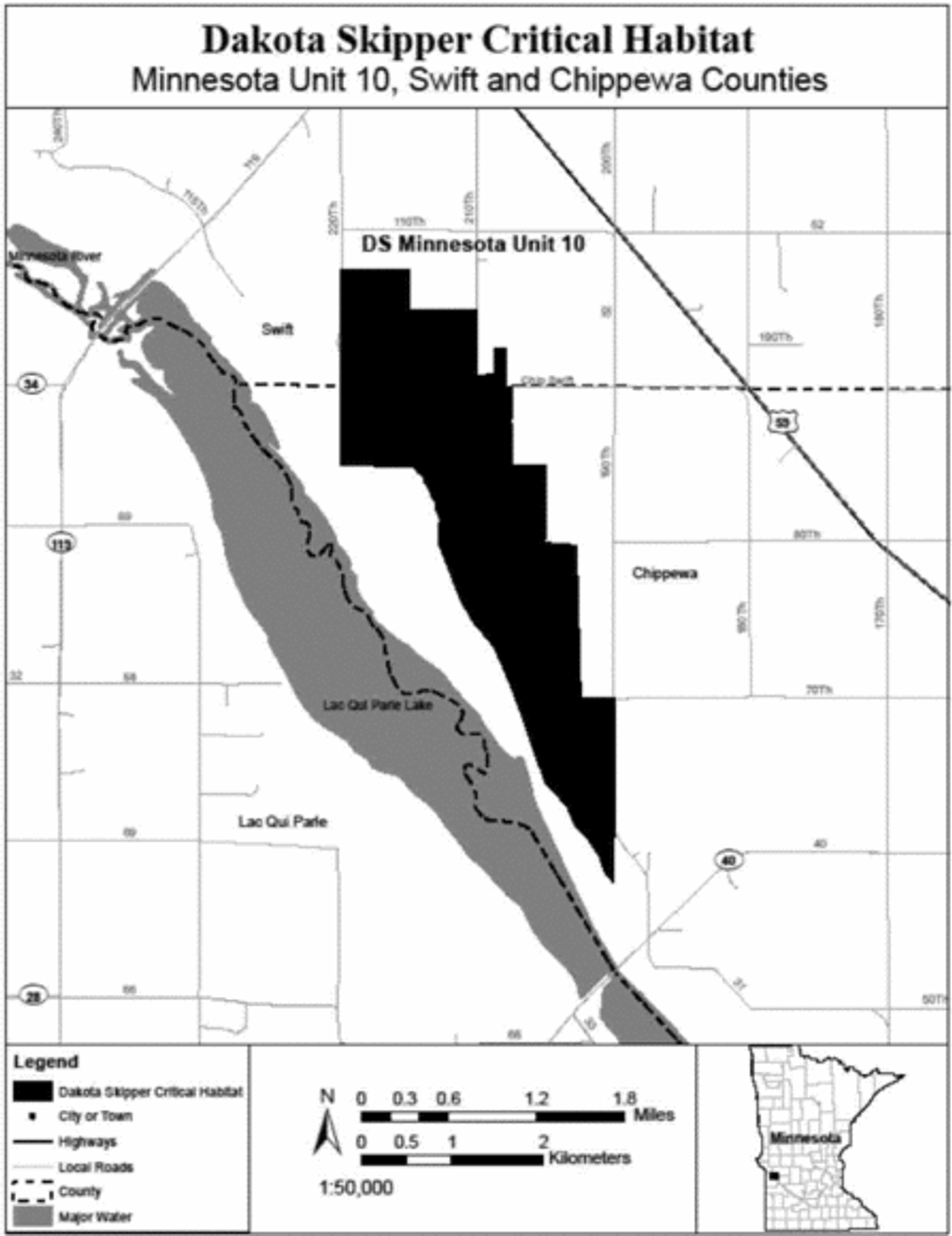
(15) DS Minnesota Unit 12, Lincoln County, Minnesota. Map of DS Minnesota Unit 12 follows:
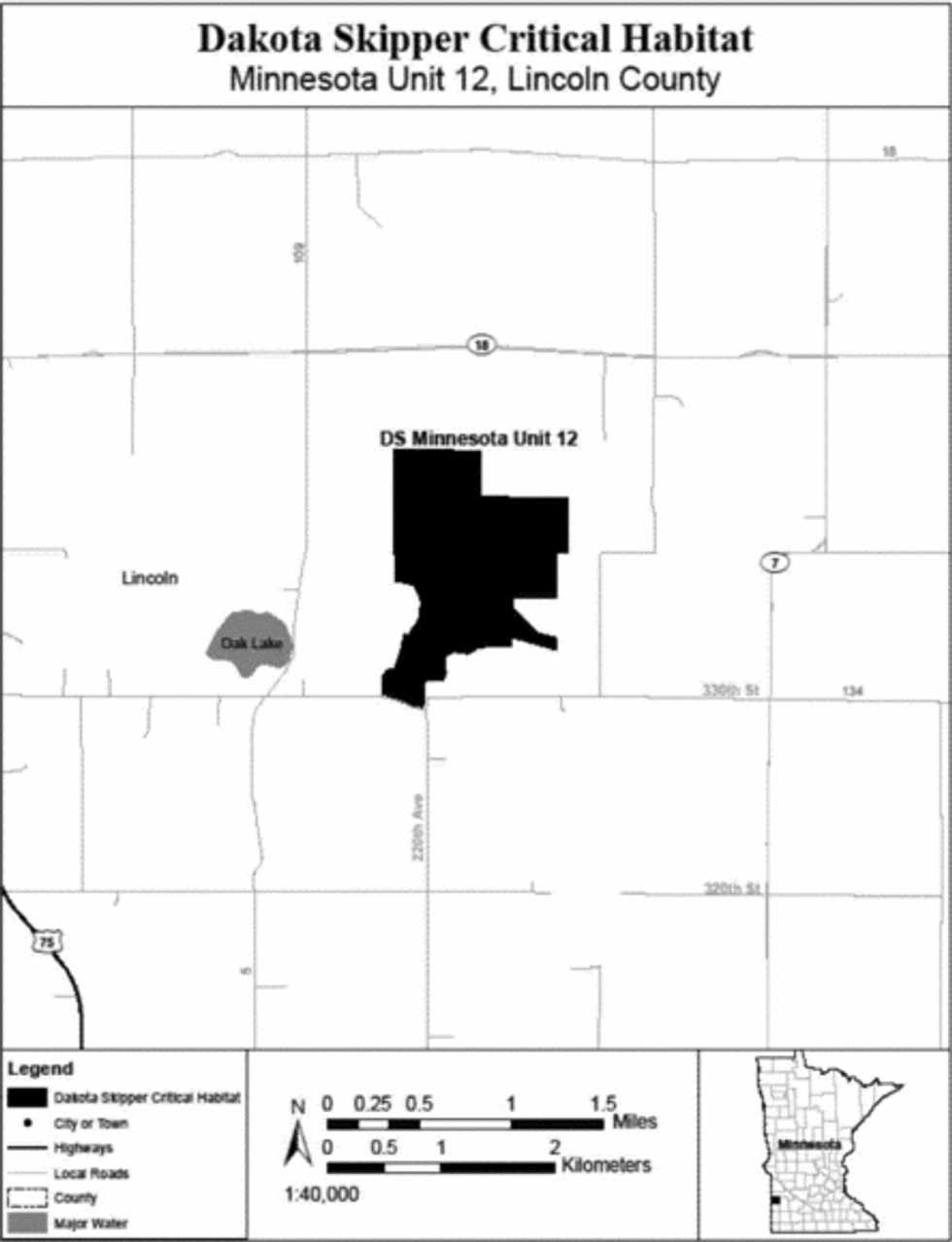
(16) DS Minnesota Unit 13, Kittson County, Minnesota. Map of DS Minnesota Unit 13 follows:
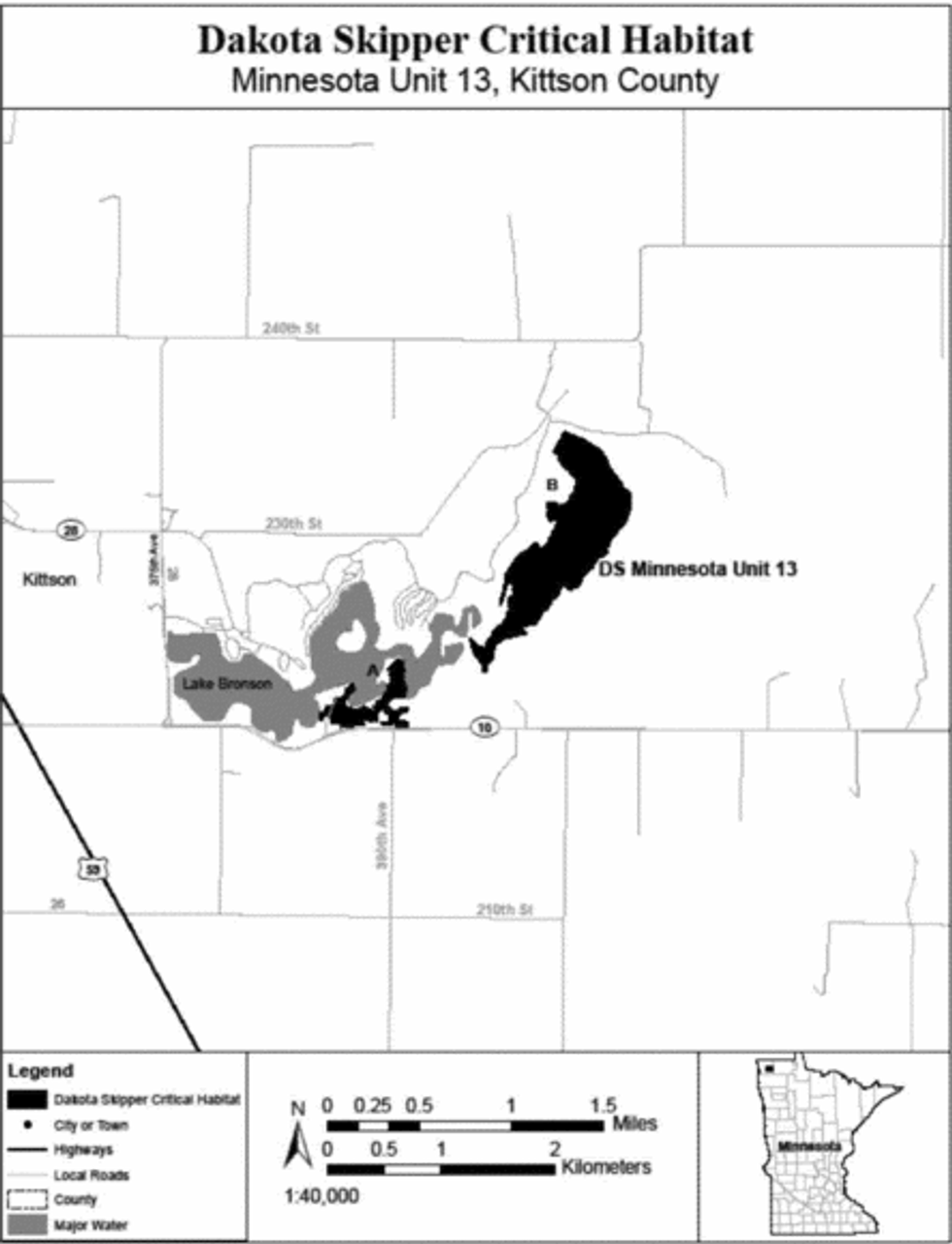
(17) DS Minnesota Unit 14, Polk County, Minnesota. Map of DS Minnesota Unit 14 follows:
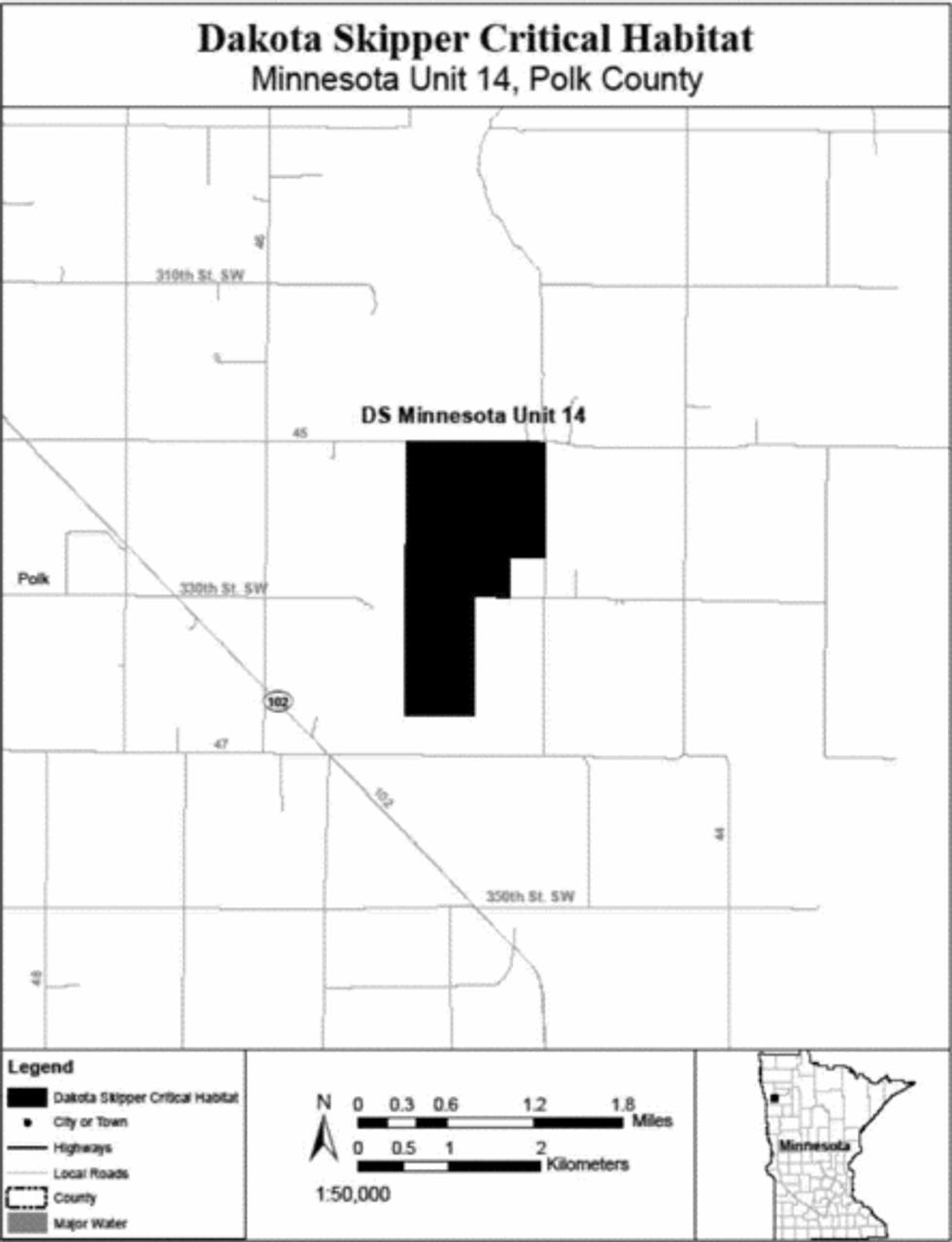
(18) DS North Dakota Unit 1, Richland County, North Dakota. Map of DS North Dakota Unit 1 follows:
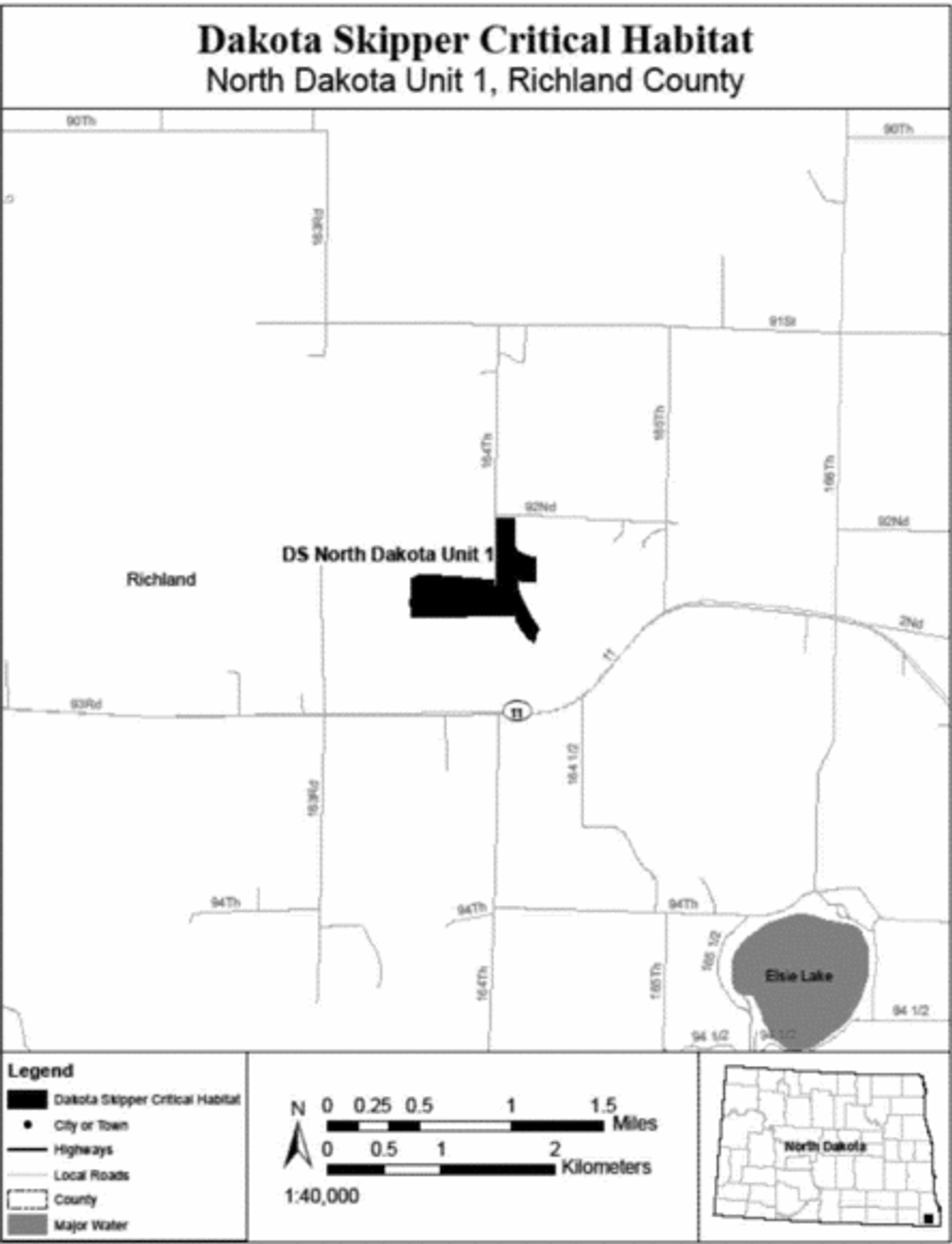
(19) DS North Dakota Units 2 and 13, Ransom County, North Dakota. Map of DS North Dakota Units 2 and 13 follows:
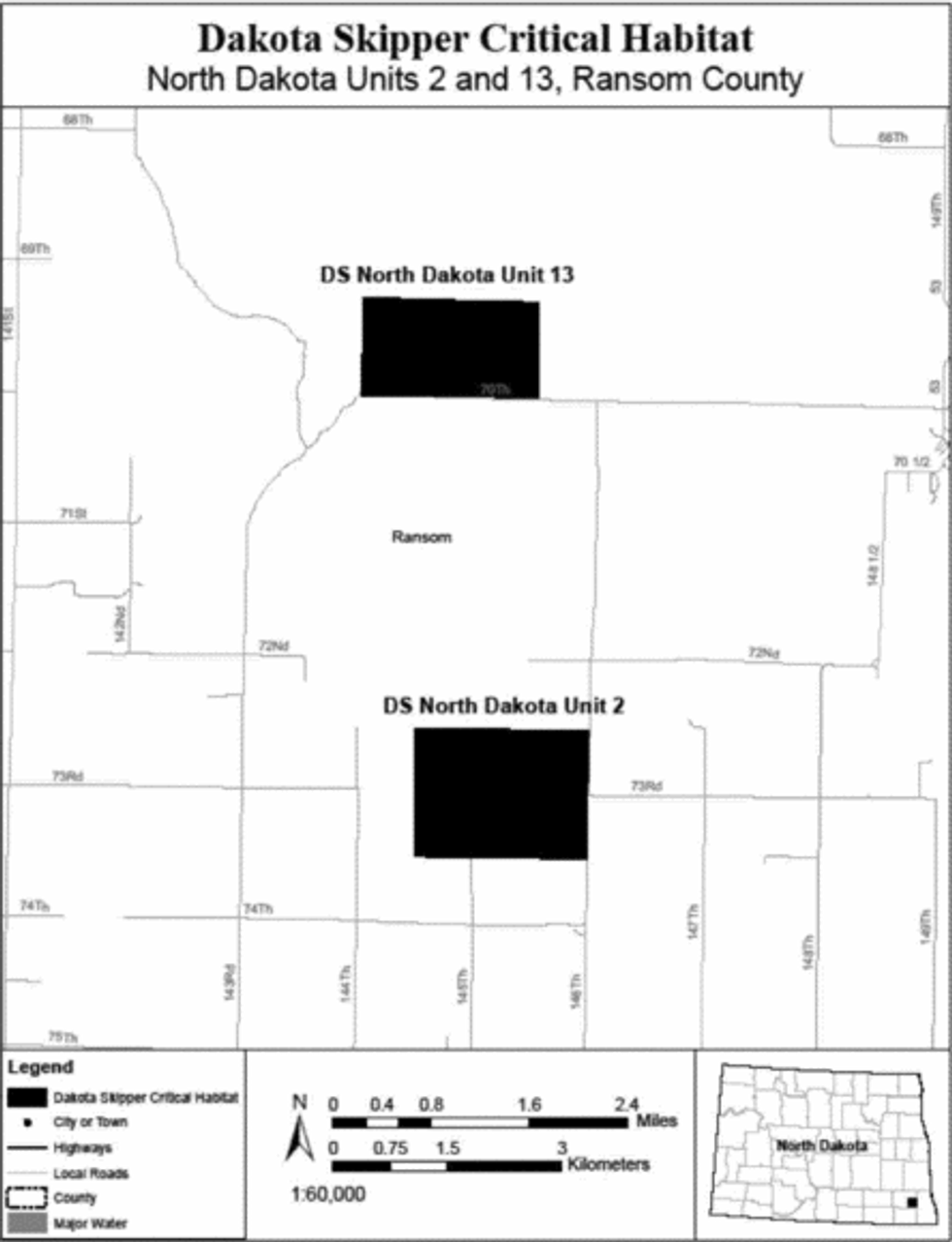
(20) DS North Dakota Units 3 and 5, McHenry County, North Dakota. Map of DS North Dakota Units 3 and 5 follows:
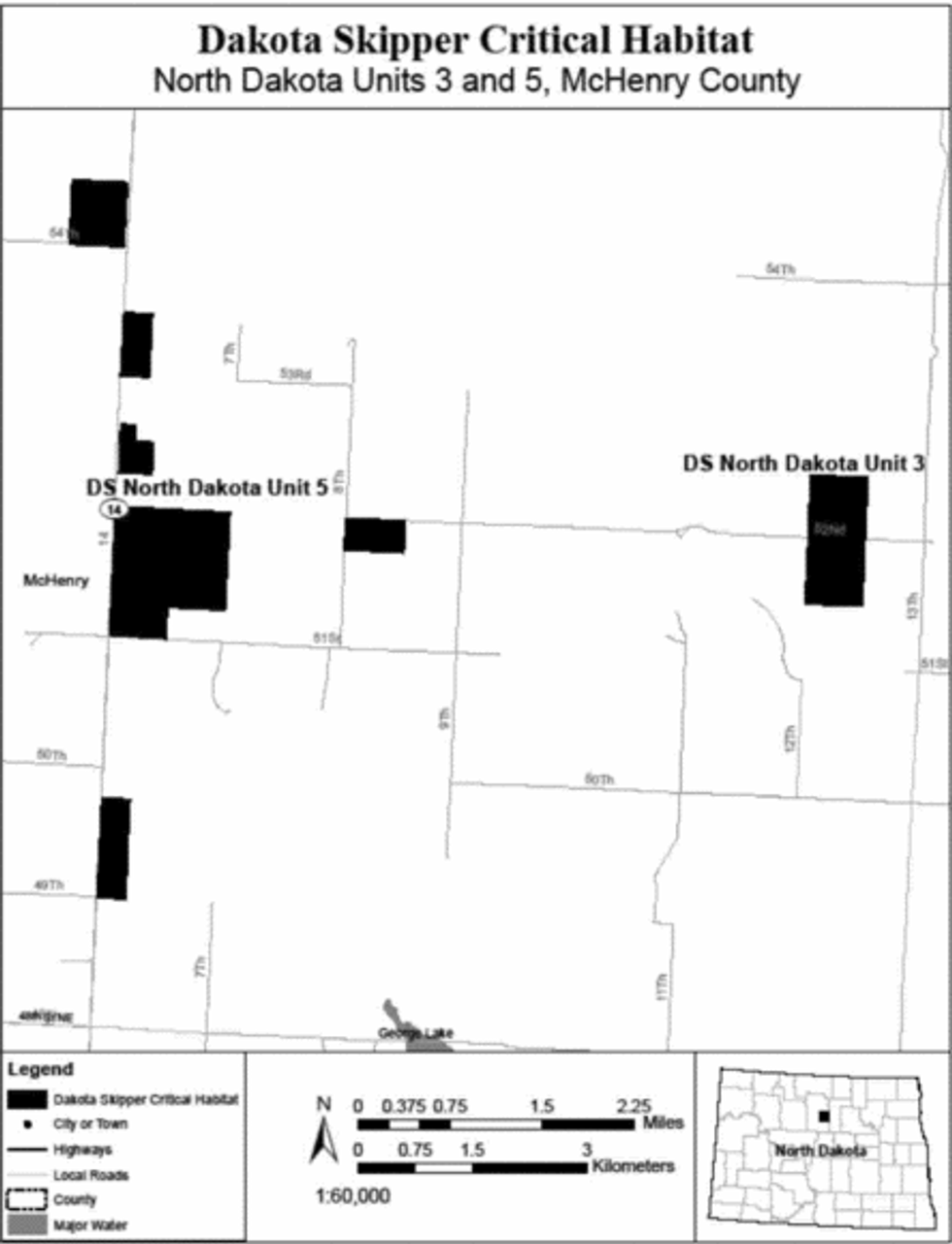
(21) DS North Dakota Unit 6, McHenry County, North Dakota. Map of DS North Dakota Unit 6 follows:
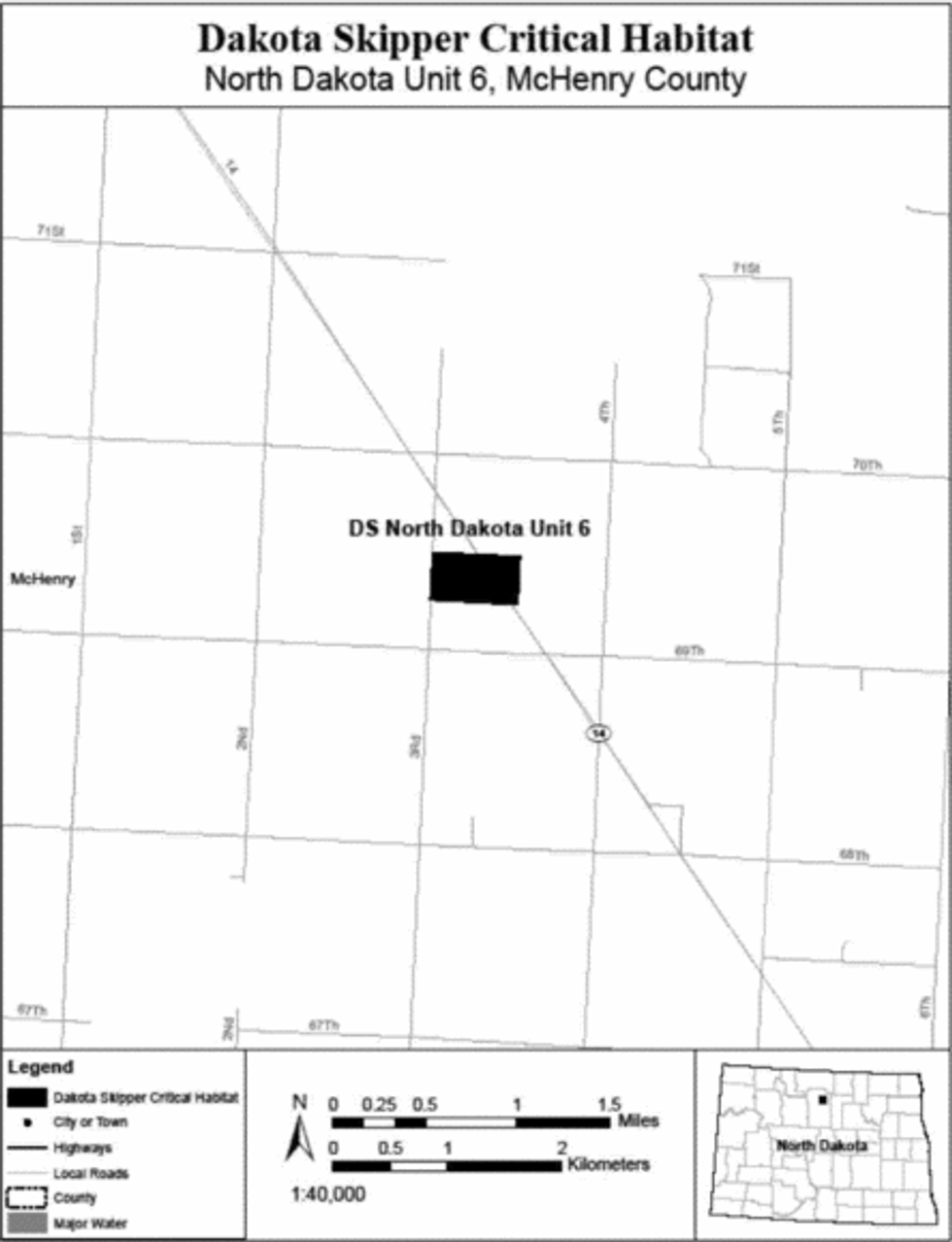
(22) DS North Dakota Units 7 and 8, McHenry County, North Dakota. Map of DS North Dakota Units 7 and 8 follows:
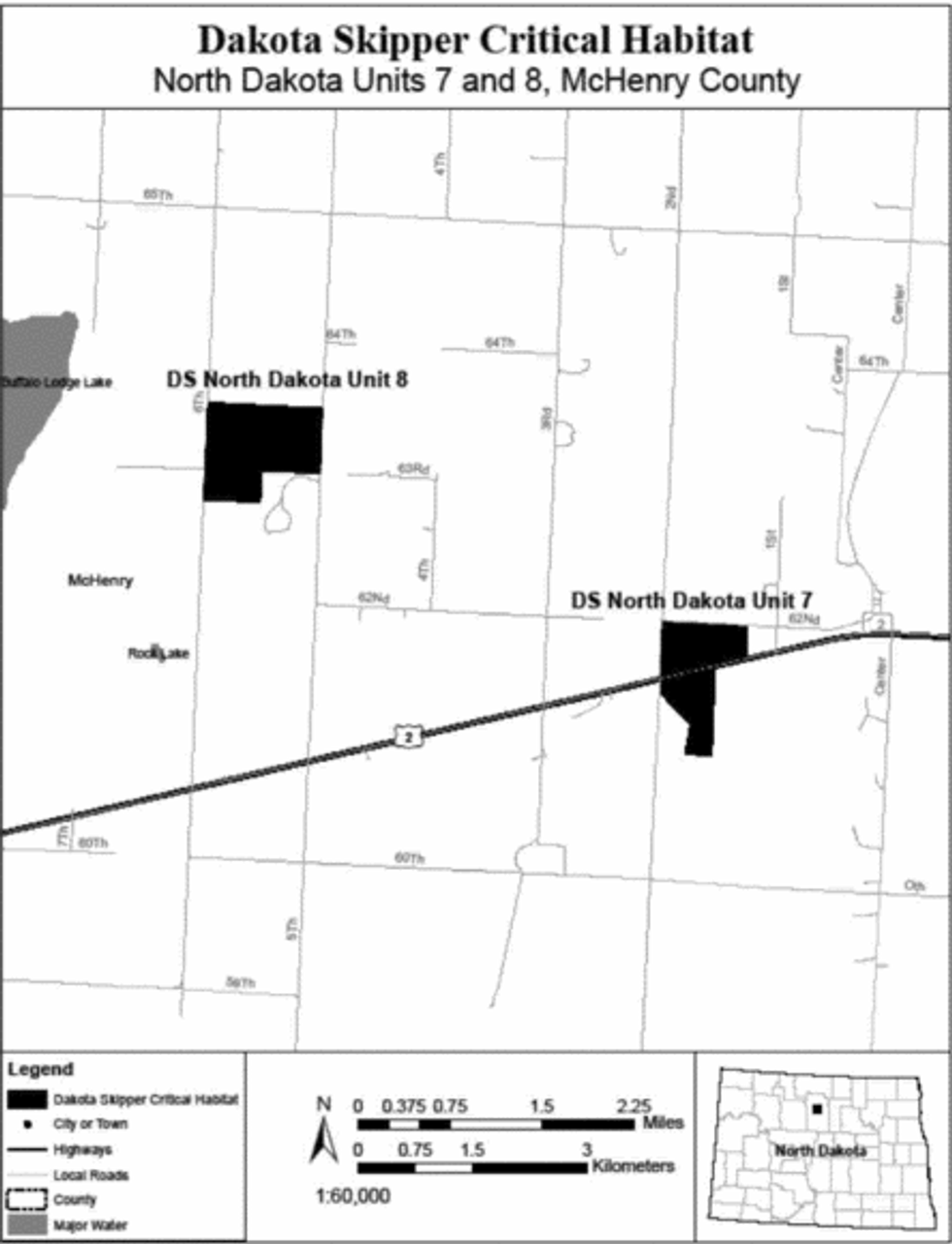
(23) DS North Dakota Unit 9, Rolette County, North Dakota. Map of DS North Dakota Unit 9 follows:
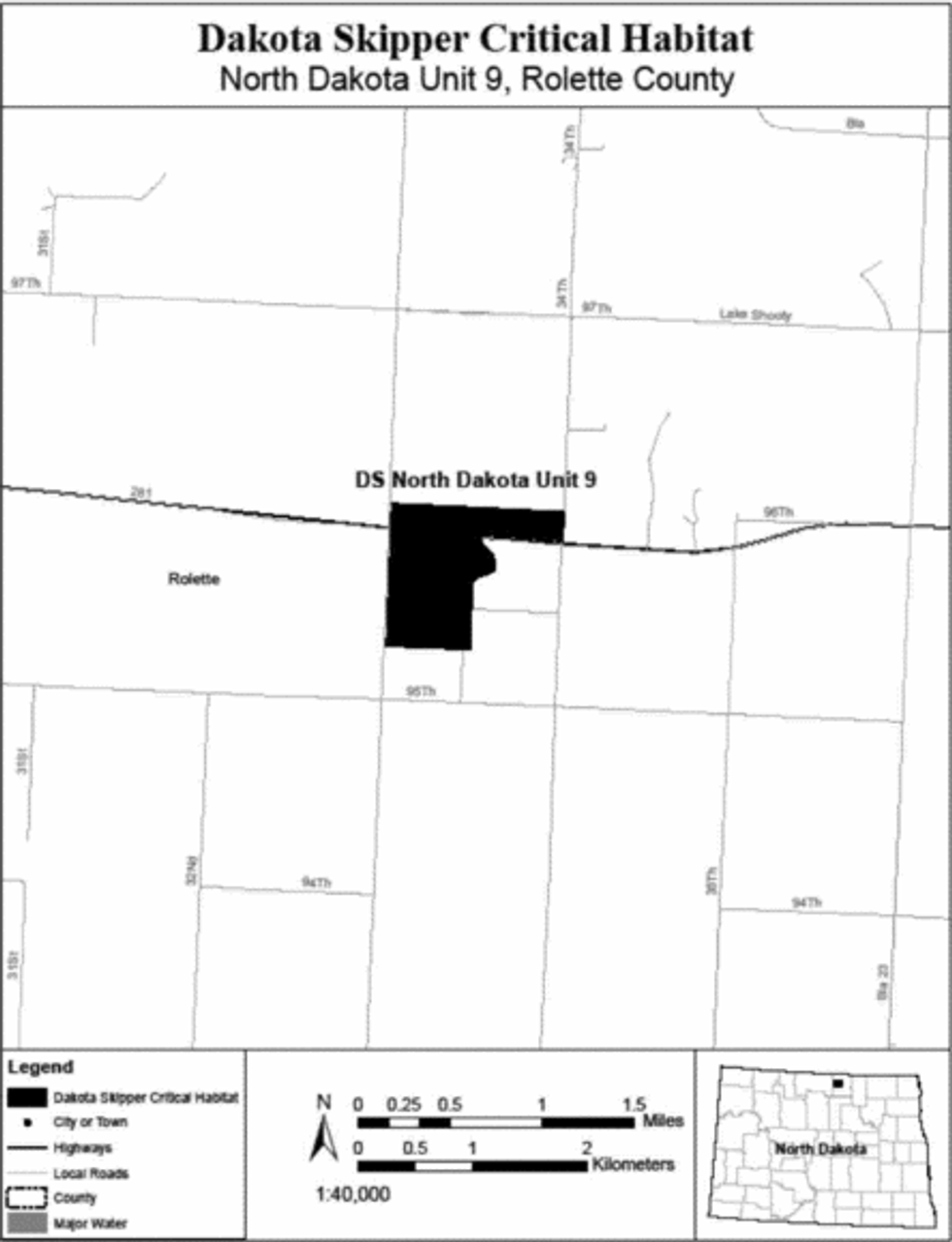
(24) DS North Dakota Unit 11, McKenzie County, North Dakota. Map of DS North Dakota Unit 11 follows:
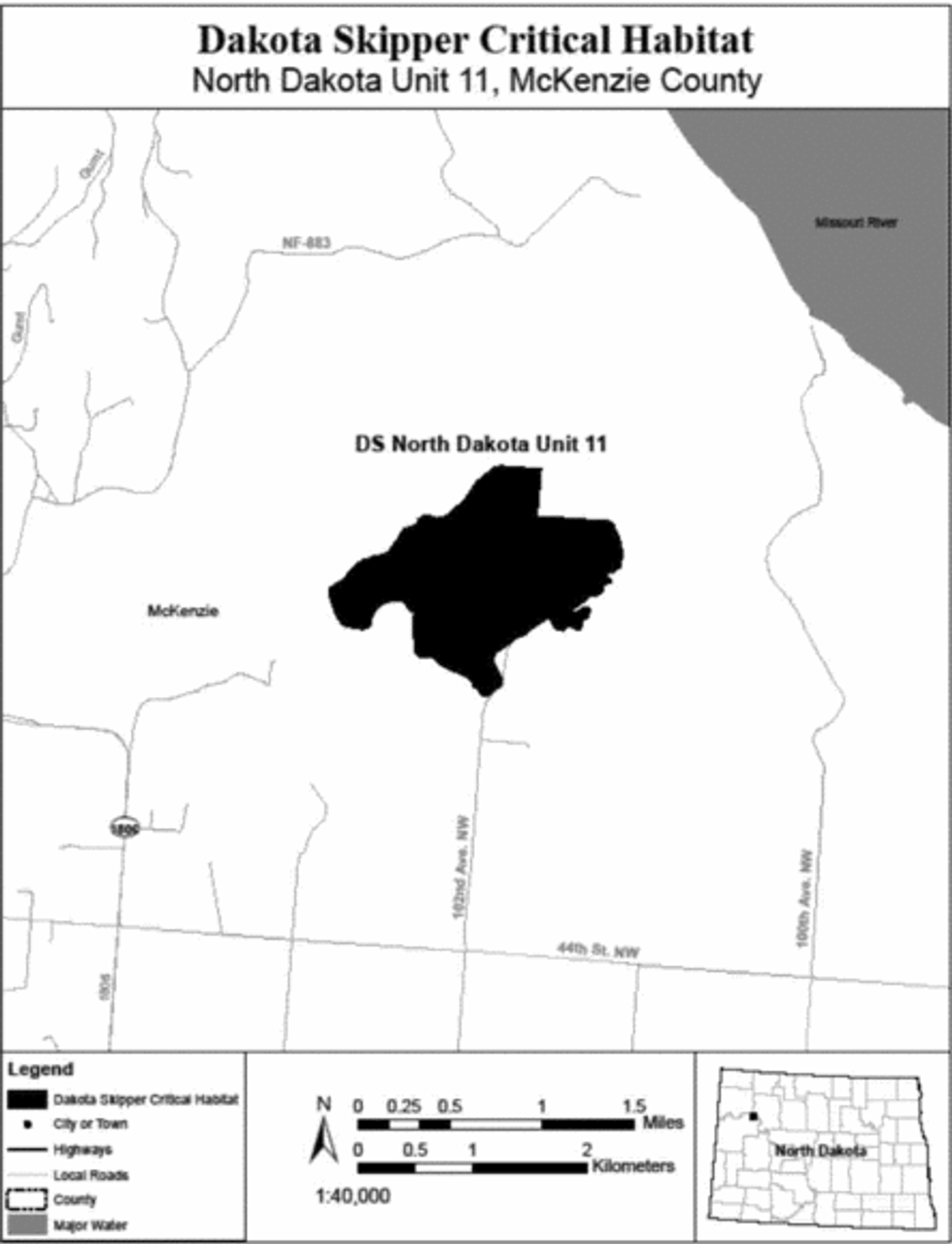
(25) DS North Dakota Unit 12, McKenzie County, North Dakota. Map of DS North Dakota Unit 12 follows:
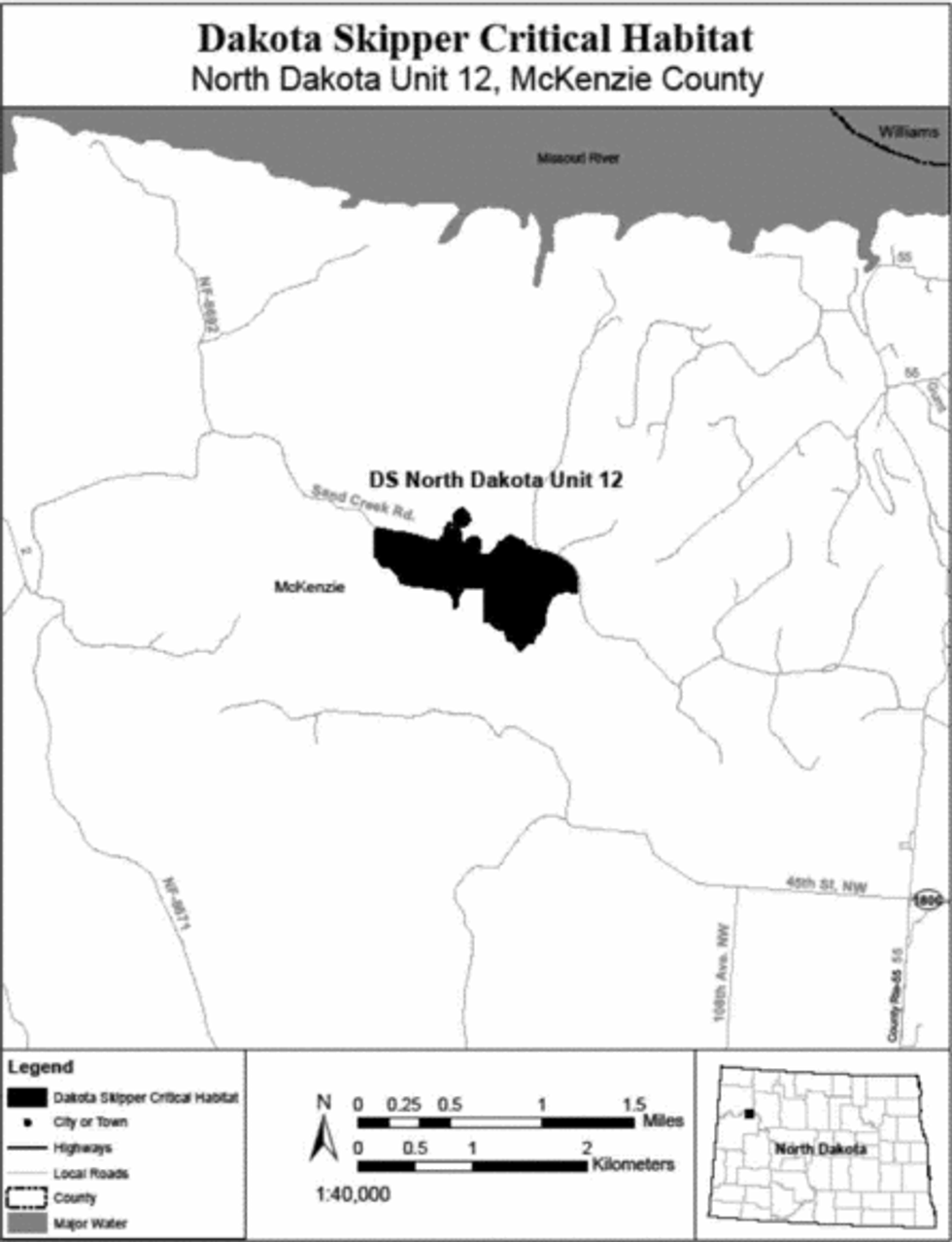
(26) DS South Dakota Unit 1, Marshall County, South Dakota. Map of DS South Dakota Unit 1 follows:
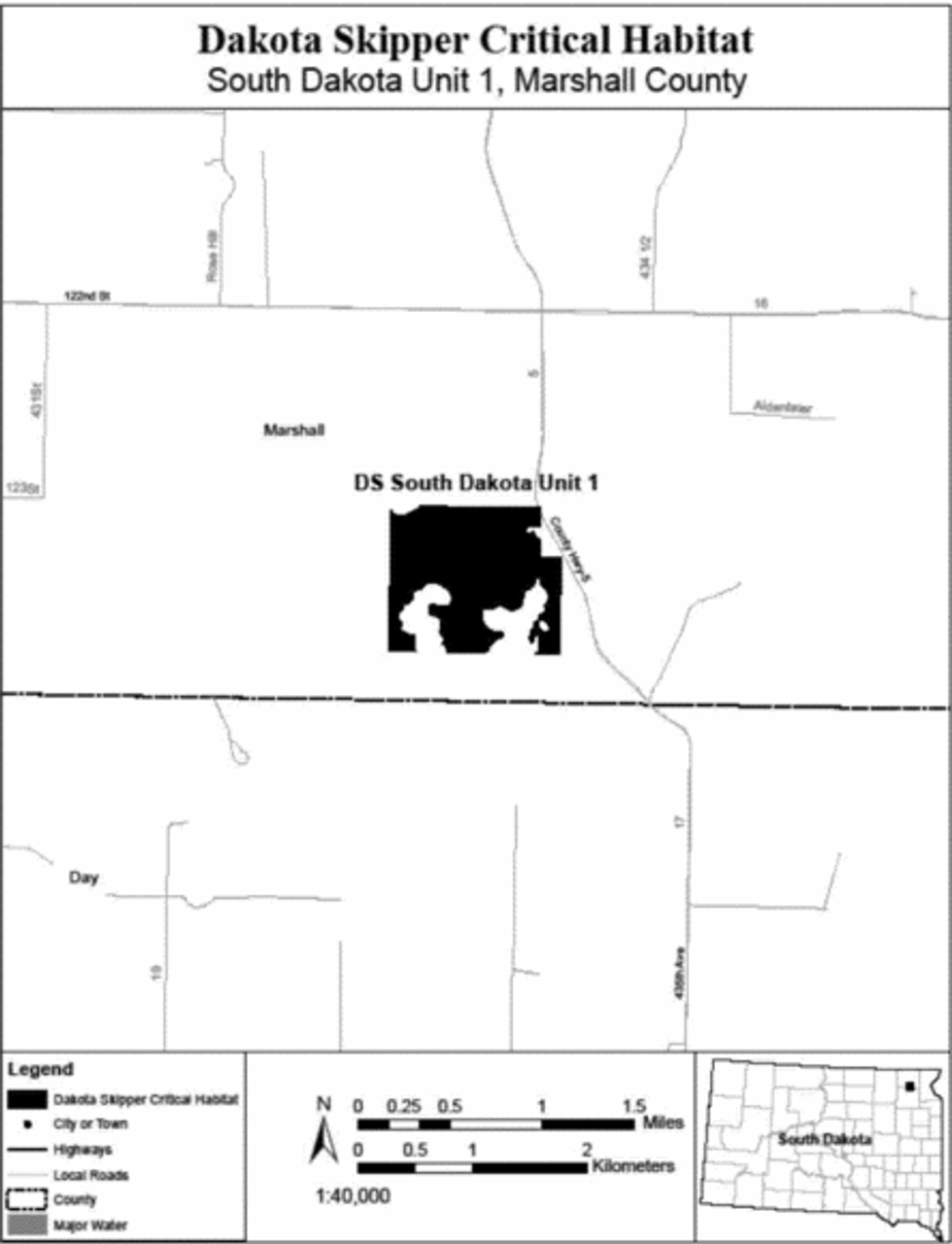
(27) DS South Dakota Unit 2, Brookings County, South Dakota. Map of DS South Dakota Unit 2 follows:
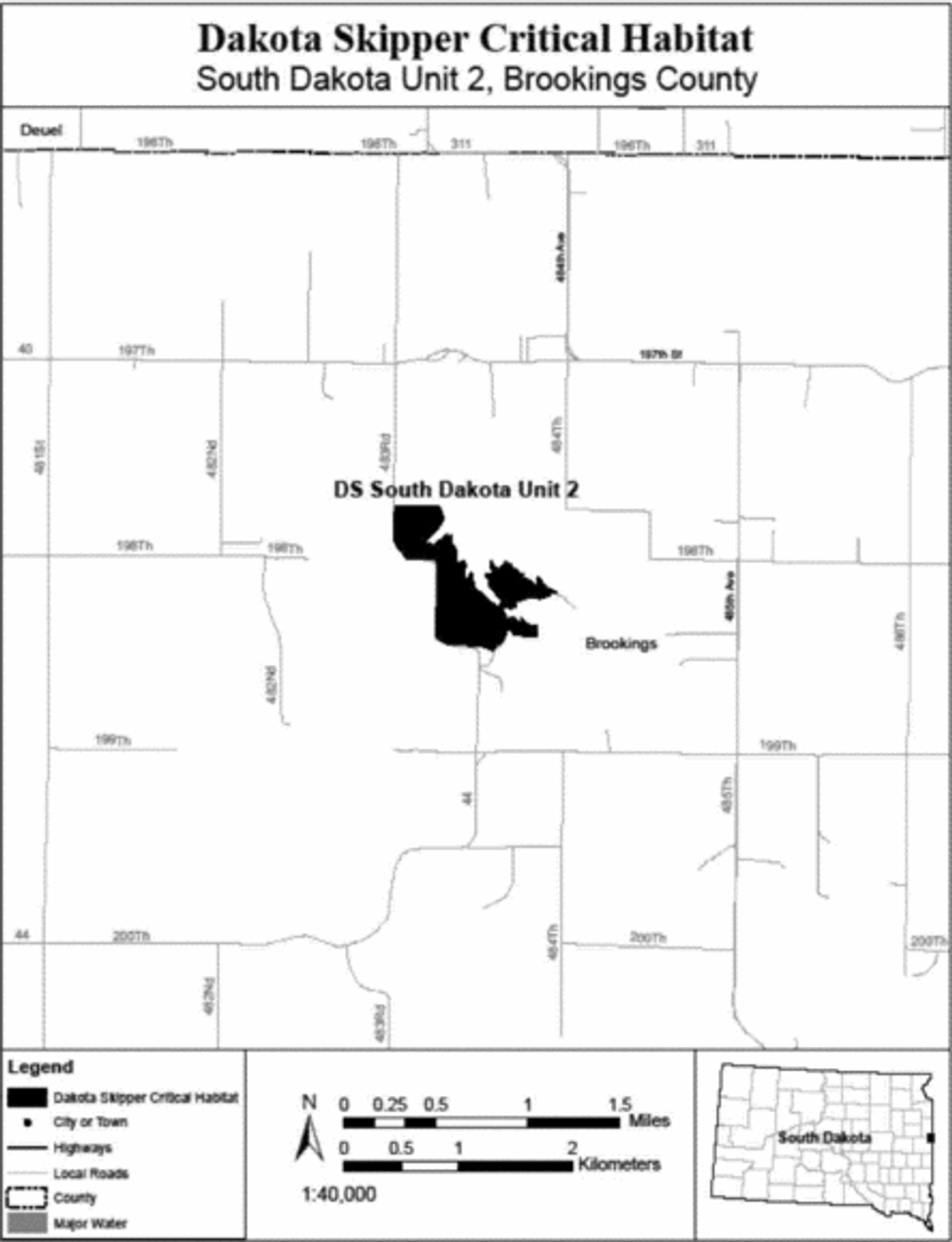
(28) DS South Dakota Unit 3, Deuel County, South Dakota. Map of DS South Dakota Unit 3 follows:
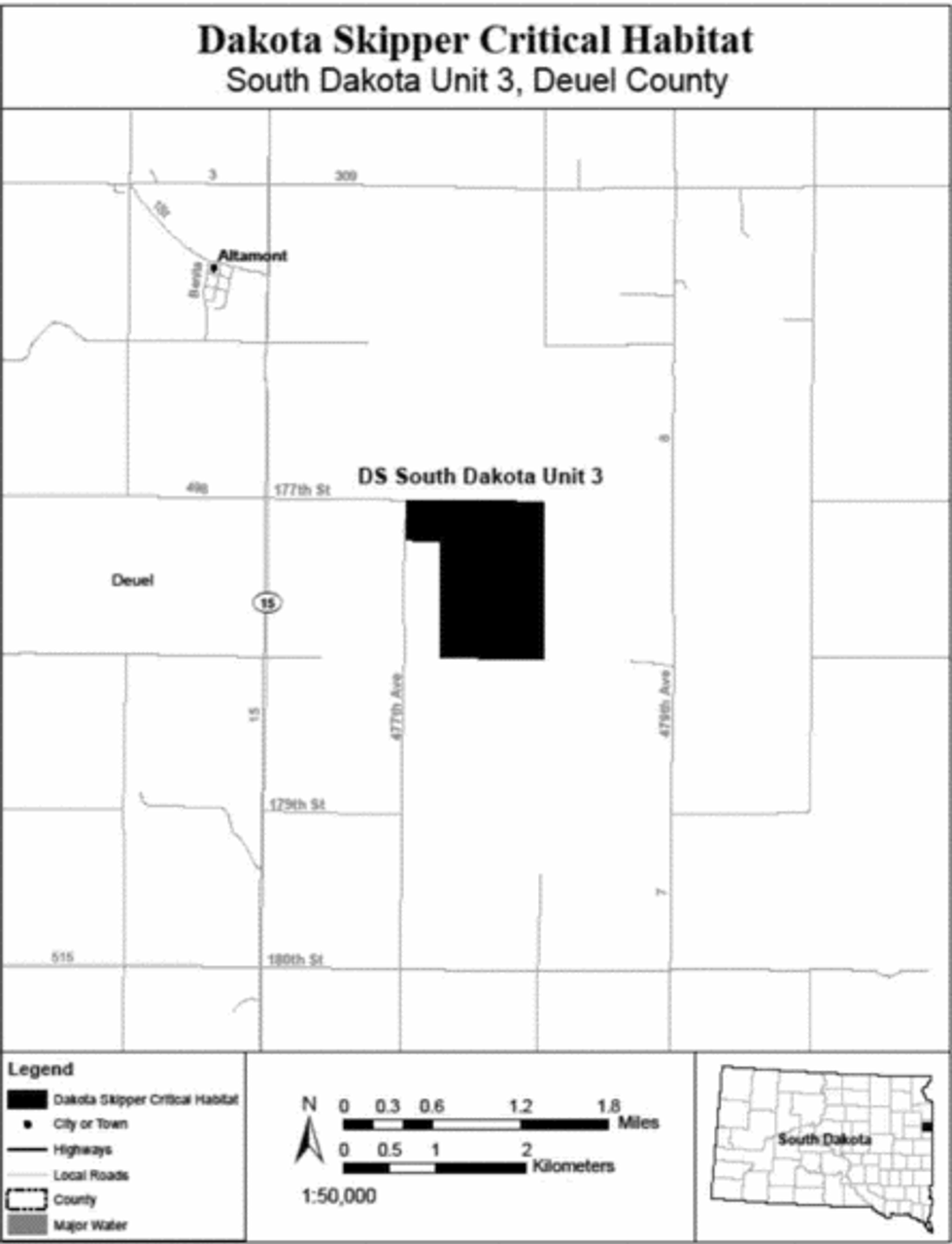
(29) DS South Dakota Unit 4, Grant County, South Dakota. Map of DS South Dakota Unit 4 follows:
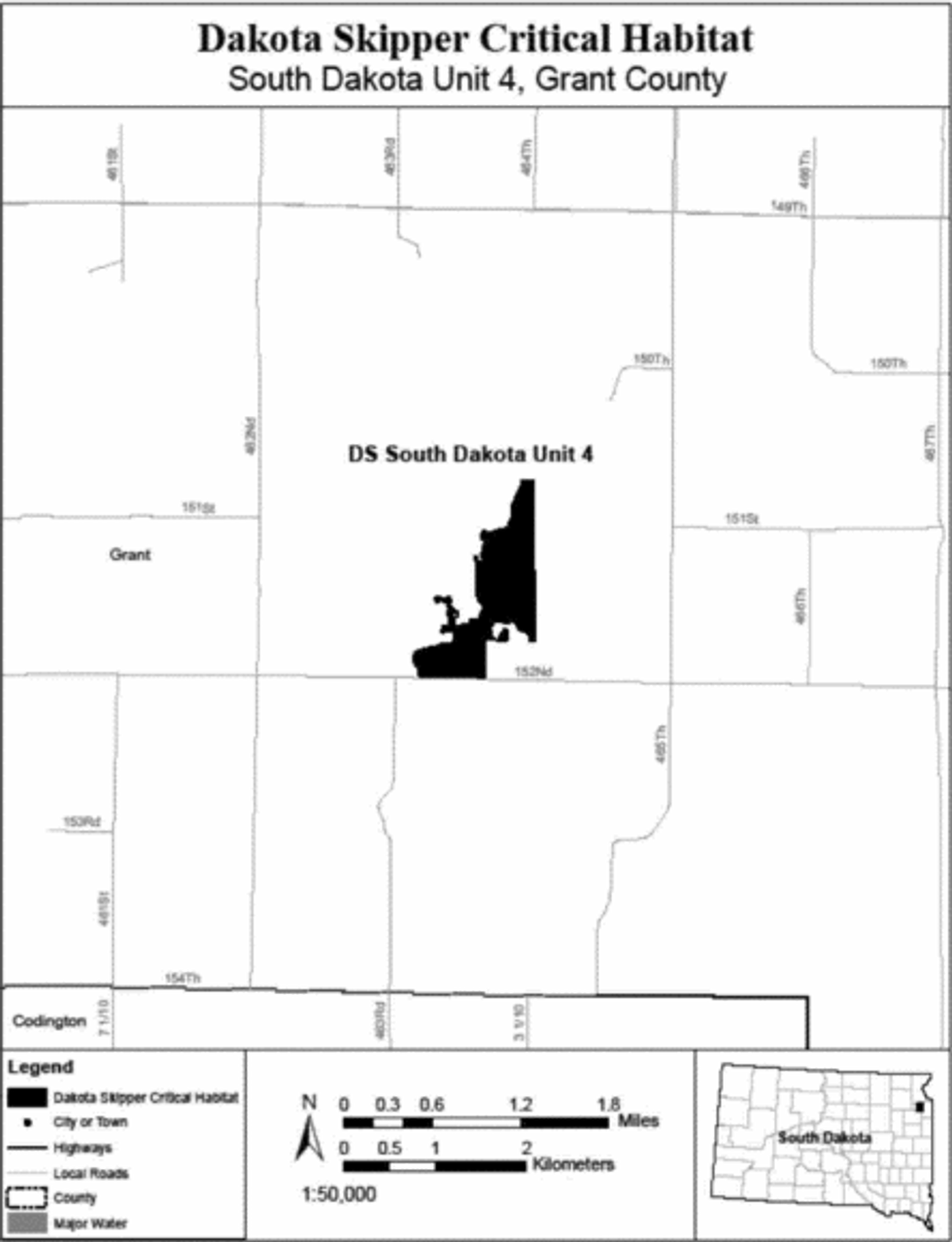
(30) DS South Dakota Unit 5, Deuel County, South Dakota. Map of DS South Dakota Unit 5 follows:
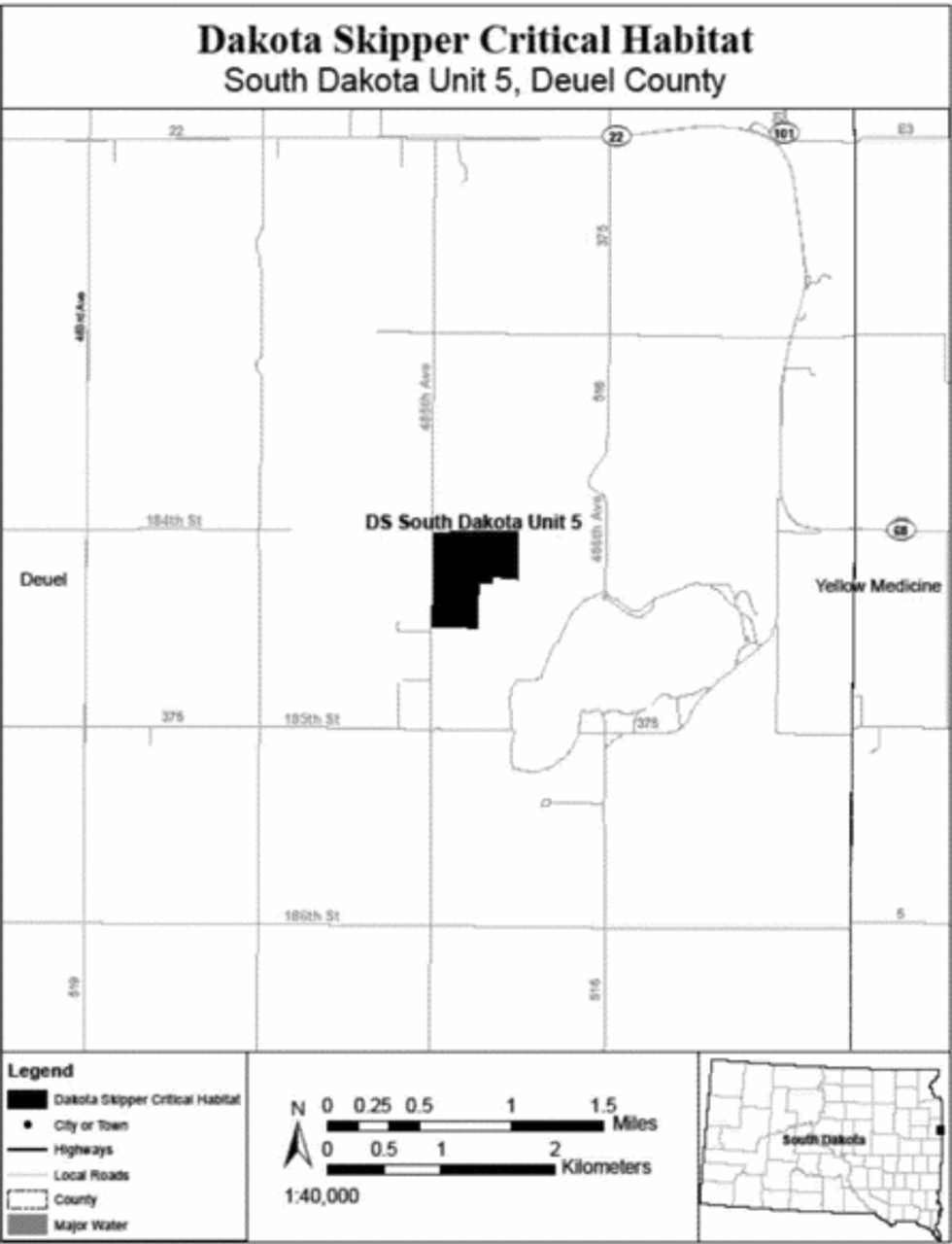
(31) DS South Dakota Unit 6, Roberts County, South Dakota. Map of DS South Dakota Unit 6 follows:
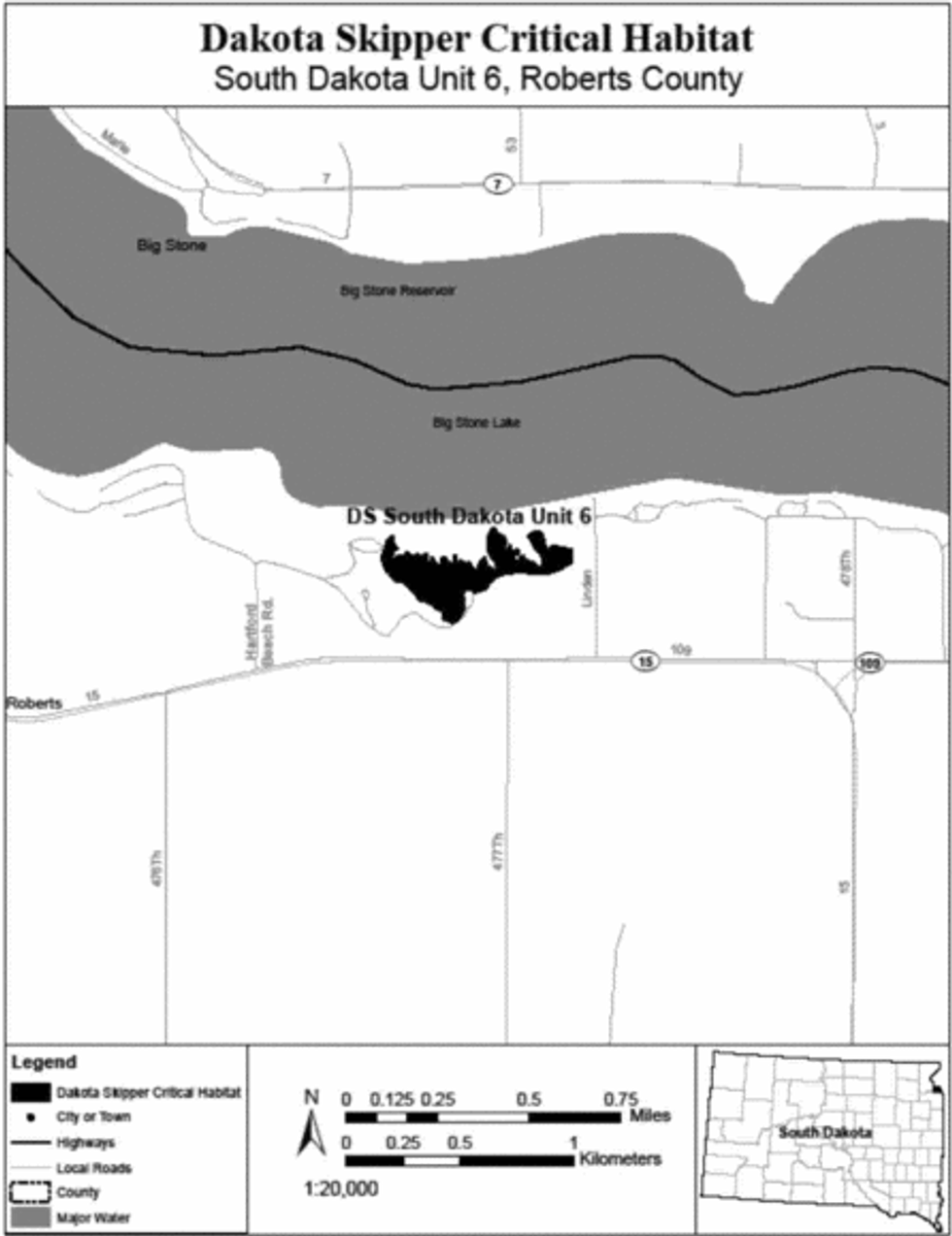
(32) DS South Dakota Units 7 and 18, Roberts County, South Dakota. Map of DS South Dakota Units 7 and 18 follows:
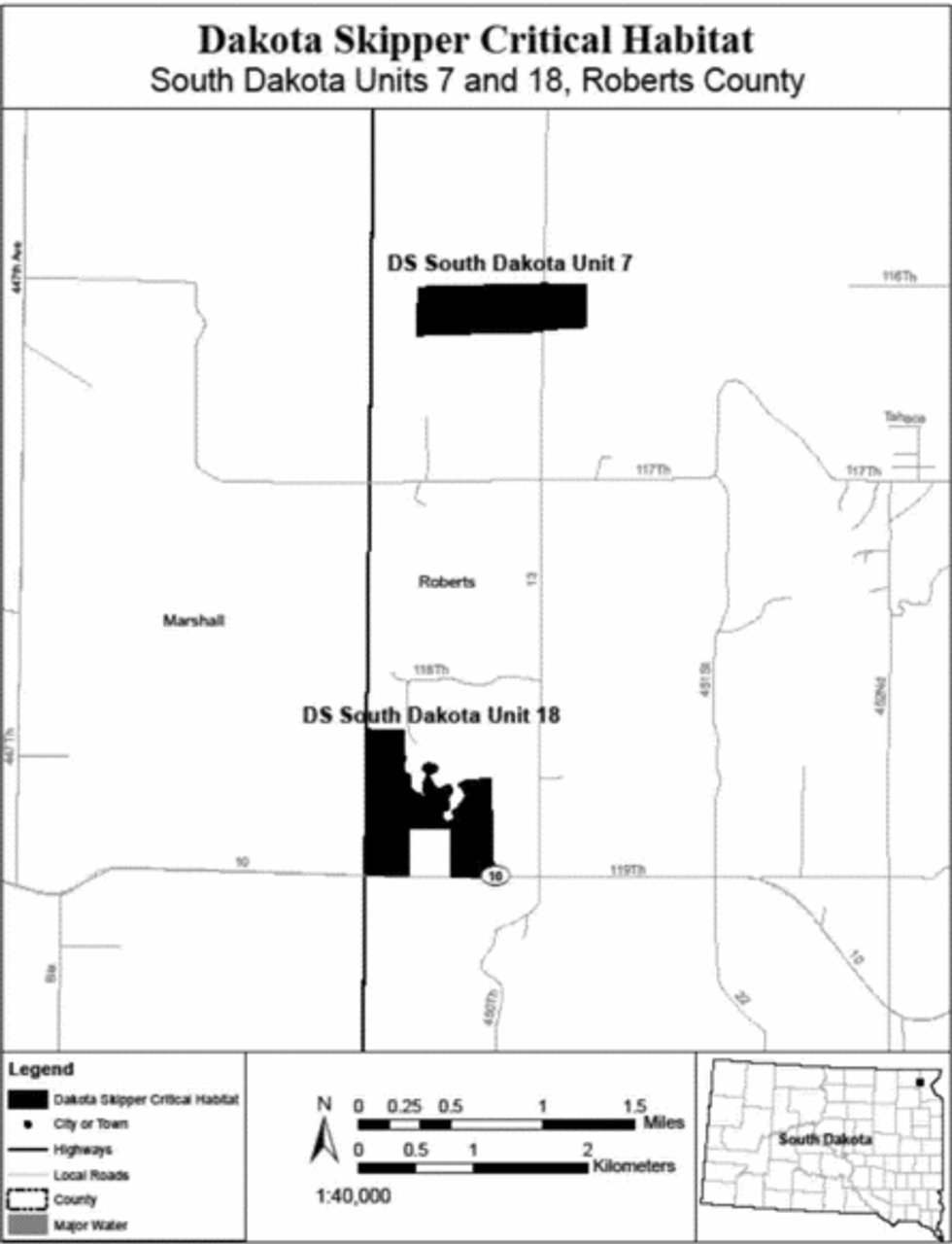
(33) DS South Dakota Unit 8, Roberts County, South Dakota. Map of DS South Dakota Unit 8 follows:
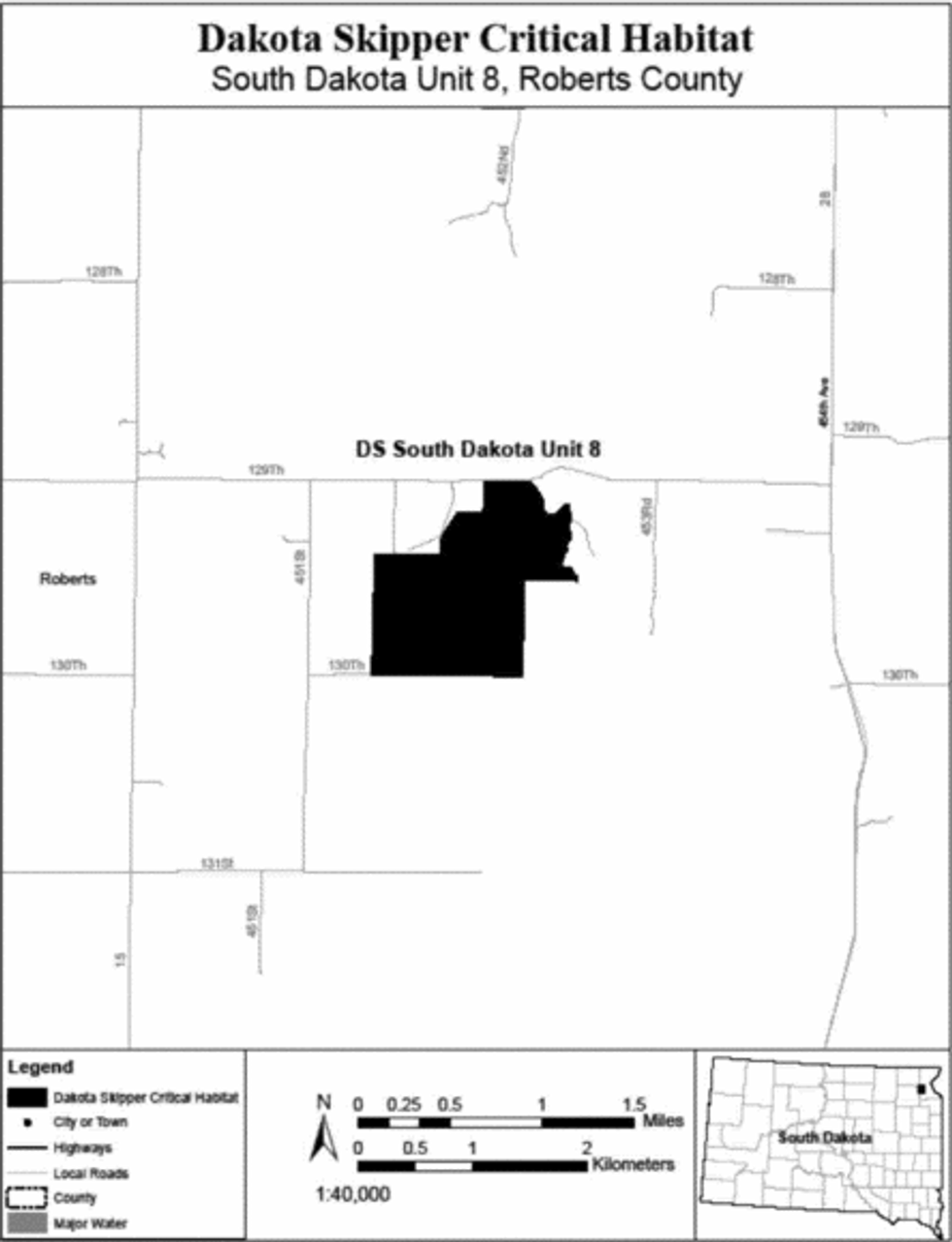
(34) DS South Dakota Units 15 and 16, Day County, South Dakota. Map of DS South Dakota Units 15 and 16 follows:
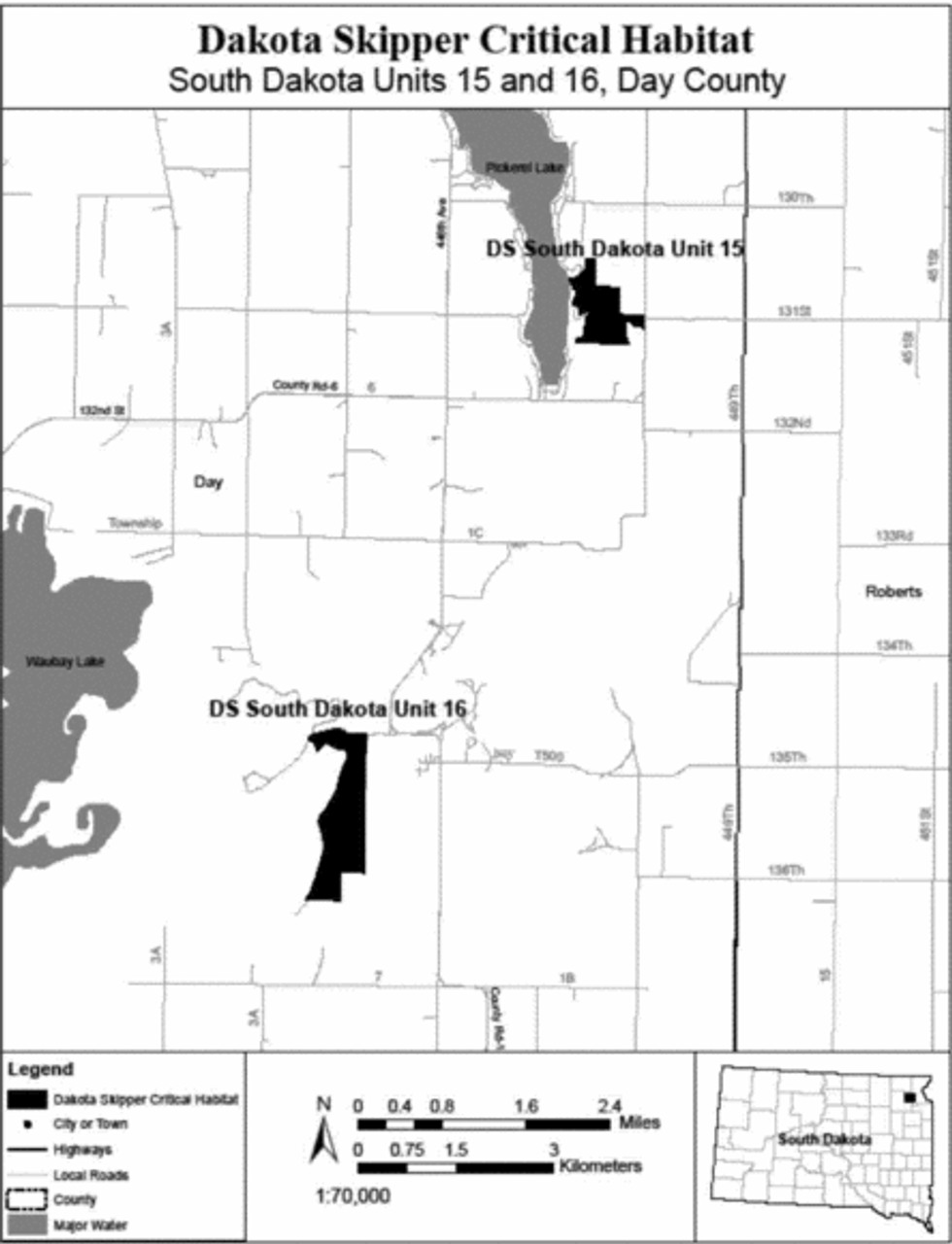
(35) DS South Dakota Unit 17, Roberts County, South Dakota. Map of DS South Dakota Unit 17 follows:
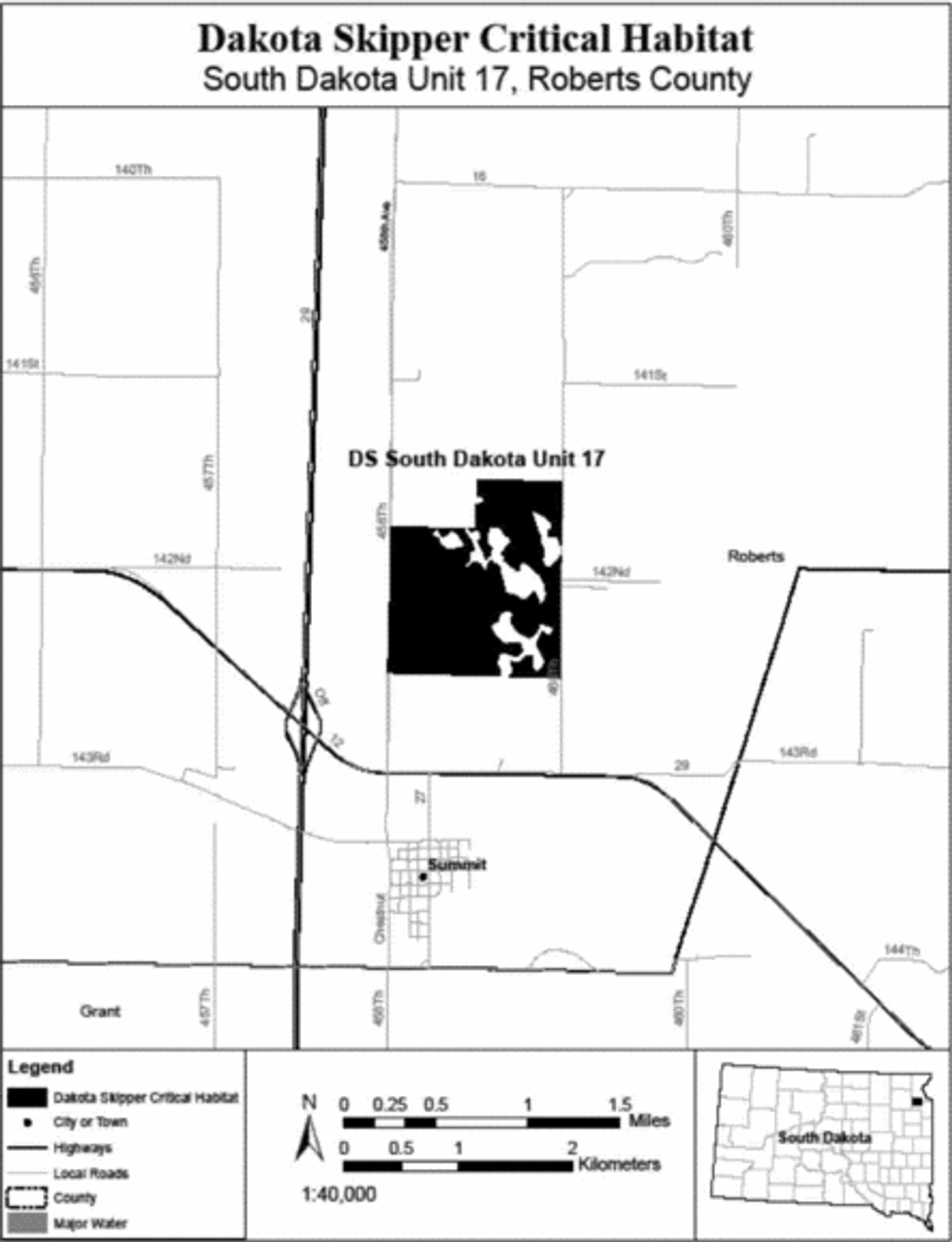
(36) DS South Dakota Unit 22, Brookings County, South Dakota. Map of DS South Dakota Unit 22 follows:
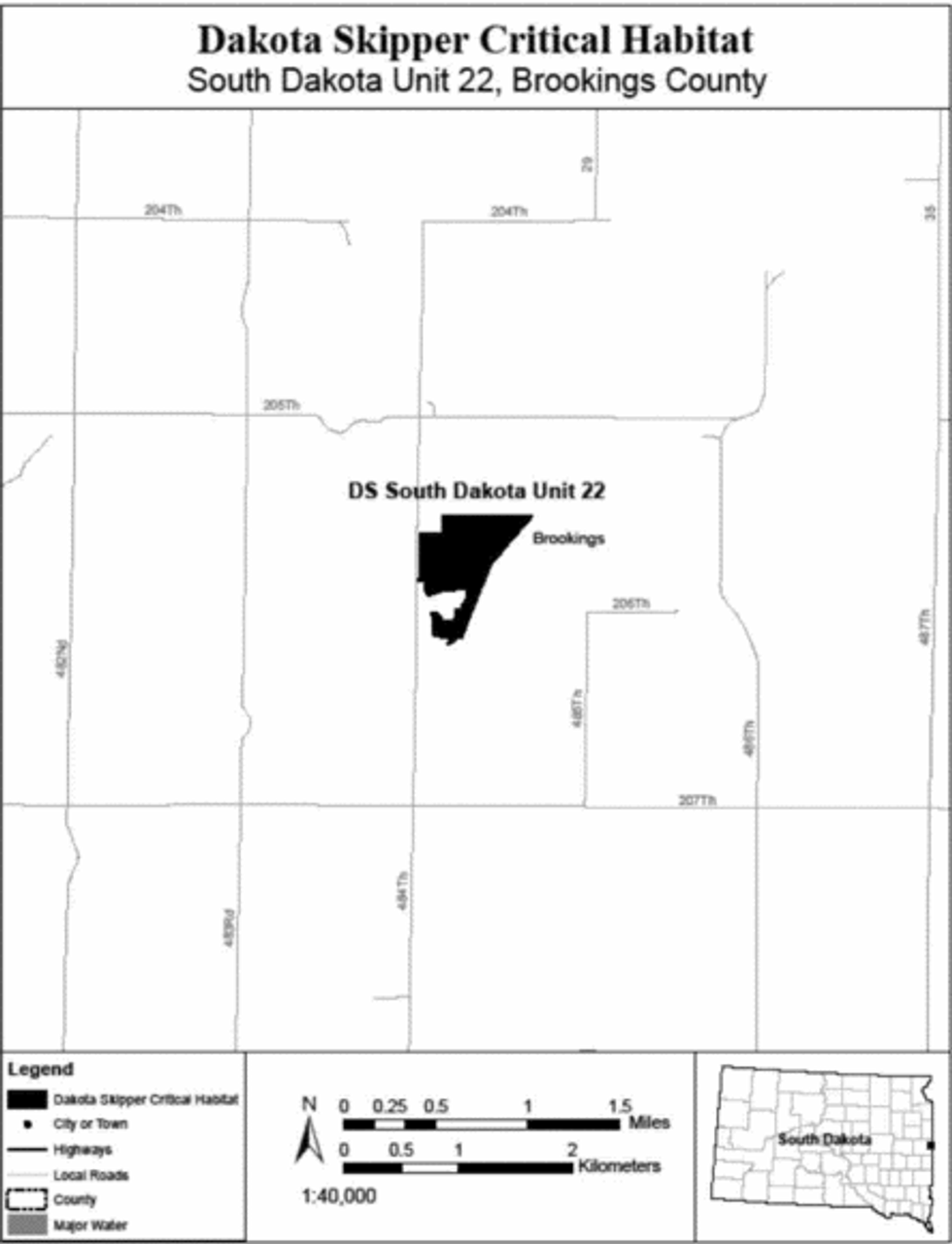
Laguna Mountains Skipper (Pyrgus ruralis lagunae)
(1) Critical habitat units are depicted for San Diego County, California, on the maps below. The maps provided are for informational purposes only.
(2) The primary constituent elements of critical habitat for the Laguna Mountains skipper are the habitat components that provide:
(i) The hostplants, Horkelia clevelandii or Potentilla glandulosa, which are needed for reproduction, in meadows or forest openings.
(ii) Nectar sources suitable for feeding by adult Laguna Mountains skipper, including Lasthenia spp., Pentachaeta aurea, Ranunculus spp., and Sidalcea spp., found in woodlands or meadows.
(iii) Wet soil or standing water associated with features such as seeps, springs, or creeks where water and minerals are obtained during the adult flight season.
(3) Critical habitat does not include man-made structures existing on the effective date of this rule and not containing one or more of the primary constituent elements, such as buildings, aqueducts, airports, and roads, and the land on which such structures are located.
(4) Data layers defining map units were created on a base of USGS 1:24,000 quadrangle maps, and critical habitat units were then mapped using Universal Transverse Mercator (UTM) coordinates.
(5) Note: Map 1 (index map) follows:
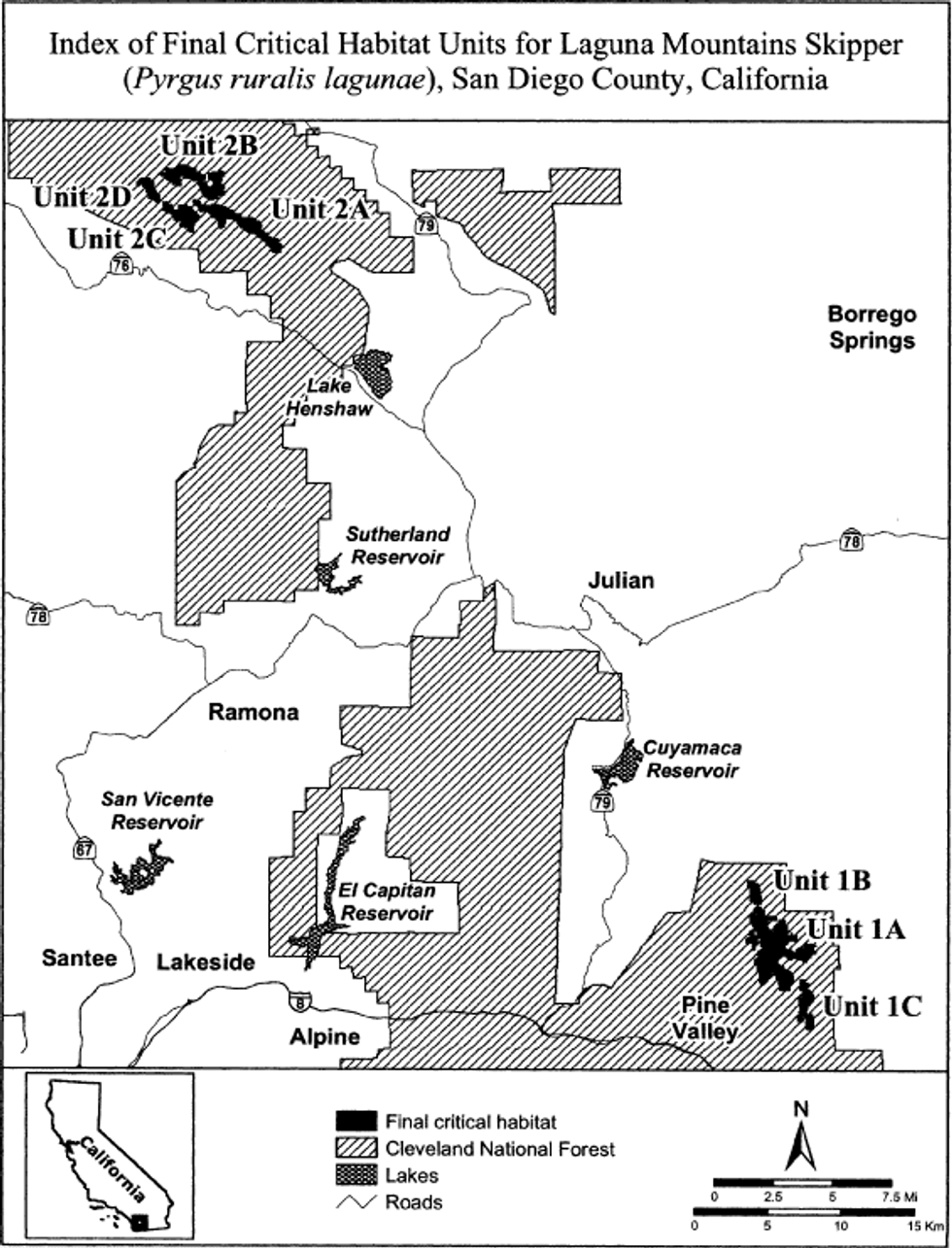
(6) Unit 1: Laguna Mountain, San Diego County, California. From USGS 1:24,000 quadrangle maps Monument Peak and Mount Laguna.
(i) Subunit 1A: lands bounded by the following UTM NAD27 coordinates (E,N): 551900, 3635400; 551900, 3635600; 551800, 3635600; 551800, 3635300; 552000, 3635300; 552000, 3634900; 551800, 3634900; 551800, 3635000; 551600, 3635000; 551600, 3634900; 551400, 3634900; 551400, 3635300; 551300, 3635300; 551300, 3635600; 551200, 3635600; 551200, 3635700; 551100, 3635700; 551100, 3636000; 551000, 3636000; 551000, 3636100; 550900, 3636100; 550900, 3636200; 550800, 3636200; 550800, 3636100; 550700, 3636100; 550700, 3636000; 550800, 3636000; 550800, 3635800; 550600, 3635800; 550600, 3635700; 550500, 3635700; 550500, 3635500; 550400, 3635500; 550400, 3635400; 550300, 3635400; 550300, 3635300; 550100, 3635300; 550100, 3635500; 550000, 3635500; 550000, 3636200; 549800, 3636200; 549800, 3636500; 549900, 3636500; 549900, 3636600; 549800, 3636600; 549800, 3636700; 549700, 3636700; 549700, 3637000; 549800, 3637000; 549800, 3637100; 549900, 3637100; 549900, 3637600; 550200, 3637600; 550200, 3637900; 550100, 3637900; 550100, 3638500; 550000, 3638500; 550000, 3638600; 549900, 3638600; 549900, 3638500; 549800, 3638500; 549800, 3638000; 549700, 3638000; 549700, 3637700; 549500, 3637700; 549500, 3638000; 549600, 3638000; 549600, 3638100; 549500, 3638100; 549500, 3638200; 549100, 3638200; 549100, 3638400; 549200, 3638400; 549200, 3638500; 549300, 3638500; 549300, 3638800; 549400, 3638800; 549400, 3638900; 549300, 3638900; 549300, 3639000; 549600, 3639000; 549600, 3638600; 549700, 3638600; 549700, 3638700; 549800, 3638700; 549800, 3638900; 549900, 3638900; 549900, 3639000; 549700, 3639000; 549700, 3639200; 549600, 3639200; 549600, 3639300; 549500, 3639300; 549500, 3639500; 549400, 3639500; 549400, 3639600; 549300, 3639600; 549300, 3640000; 549400, 3640000; 549400, 3640100; 549700, 3640100; 549700, 3640000; 549800, 3640000; 549800, 3640100; 549900, 3640100; 549900, 3640200; 549700, 3640200; 549700, 3640300; 549600, 3640300; 549600, 3640500; 549800, 3640500; 549800, 3640600; 550100, 3640600; 550100, 3640500; 550200, 3640500; 550200, 3640400; 550300, 3640400; 550300, 3640000; 551000, 3640000; 551000, 3639900; 551100, 3639900; 551100, 3639700; 550500, 3639700; 550500, 3639400; 550400, 3639400; 550400, 3639300; 550500, 3639300; 550500, 3639200; 550600, 3639200; 550600, 3639100; 550700, 3639100; 550700, 3639000; 550800, 3639000; 550800, 3638900; 551000, 3638900; 551000, 3639300; 551100, 3639300; 551100, 3639500; 551300, 3639500; 551300, 3639700; 551700, 3639700; 551700, 3639400; 551800, 3639400; 551800, 3639300; 551900, 3639300; 551900, 3639100; 551800, 3639100; 551800, 3639000; 551900, 3639000; 551900, 3638900; 551800, 3638900; 551800, 3638800; 551900, 3638800; 551900, 3638700; 552100, 3638700; 552100, 3638800; 552200, 3638800; 552200, 3638700; 552500, 3638700; 552500, 3638300; 552300, 3638300; 552300, 3638400; 552200, 3638400; 552200, 3638300; 551900, 3638300; 551900, 3638100; 551500, 3638100; 551500, 3637900; 551700, 3637900; 551700, 3637800; 551800, 3637800; 551800, 3637700; 552100, 3637700; 552100, 3637600; 552200, 3637600; 552200, 3637500; 552500, 3637500; 552500, 3637700; 552600, 3637700; 552600, 3637800; 553000, 3637800; 553000, 3638000; 553100, 3638000; 553100, 3638100; 553600, 3638100; 553600, 3638000; 553800, 3638000; 553800, 3637900; 553700, 3637900; 553700, 3637600; 553800, 3637600; 553800, 3637400; 553700, 3637400; 553700, 3637500; 553500, 3637500; 553500, 3637200; 553100, 3637200; 553100, 3637100; 553200, 3637100; 553200, 3636900; 552900, 3636900; 552900, 3637000; 552800, 3637000; 552800, 3637100; 552700, 3637100; 552700, 3637000; 552600, 3637000; 552600, 3637100; 552400, 3637100; 552400, 3637200; 552300, 3637200; 552300, 3637100; 552200, 3637100; 552200, 3637000; 552000, 3637000; 552000, 3637100; 551900, 3637100; 551900, 3637300; 551500, 3637300; 551500, 3637200; 551400, 3637200; 551400, 3637100; 551200, 3637100; 551200, 3636700; 551300, 3636700; 551300, 3636600; 551400, 3636600; 551400, 3636500; 551600, 3636500; 551600, 3636400; 551700, 3636400; 551700, 3636300; 551800, 3636300; 551800, 3636200; 552000, 3636200; 552000, 3636100; 552100, 3636100; 552100, 3636000; 552200, 3636000; 552200, 3635900; 552300, 3635900; 552300, 3635500; 552200, 3635500; 552200, 3635400; 551900, 3635400.
(ii) Subunit 1B: lands bounded by the following UTM NAD27 coordinates (E,N): 549300, 3642300; 549400, 3642300; 549400, 3642400; 549600, 3642400; 549600, 3642300; 549800, 3642300; 549800, 3642200; 549900, 3642200; 549900, 3641900; 550000, 3641900; 550000, 3641400; 550100, 3641400; 550100, 3640900; 549600, 3640900; 549600, 3641000; 549300, 3641000; 549300, 3642300.
(iii) Subunit 1C: lands bounded by the following UTM NAD27 coordinates (E,N): 553000, 3634400; 553000, 3634500; 552900, 3634500; 552900, 3634900; 552800, 3634900; 552800, 3635600; 553100, 3635600; 553100, 3635400; 553300, 3635400; 553300, 3635300; 553400, 3635300; 553400, 3635200; 553300, 3635200; 553300, 3635100; 553200, 3635100; 553200, 3635000; 553300, 3635000; 553300, 3634900; 553400, 3634900; 553400, 3634800; 553600, 3634800; 553600, 3634600; 553700, 3634600; 553700, 3634200; 553600, 3634200; 553600, 3634100; 553500, 3634100; 553500, 3634000; 553400, 3634000; 553400, 3633800; 553300, 3633800; 553300, 3633600; 553200, 3633600; 553200, 3633300; 553300, 3633300; 553300, 3633200; 553500, 3633200; 553500, 3633300; 553600, 3633300; 553600, 3633000; 553700, 3633000; 553700, 3632300; 553600, 3632300; 553600, 3632200; 553300, 3632200; 553300, 3632300; 553200, 3632300; 553200, 3633000; 553100, 3633000; 553100, 3633200; 553000, 3633200; 553000, 3633300; 552900, 3633300; 552900, 3632800; 552600, 3632800; 552600, 3633000; 552700, 3633000; 552700, 3633400; 552800, 3633400; 552800, 3633800; 552700, 3633800; 552700, 3634300; 552800, 3634300; 552800, 3634400; 553000, 3634400.
(iv) Note: Map of Unit 1 (Map 2, Subunits 1A, 1B, and 1C) follows:
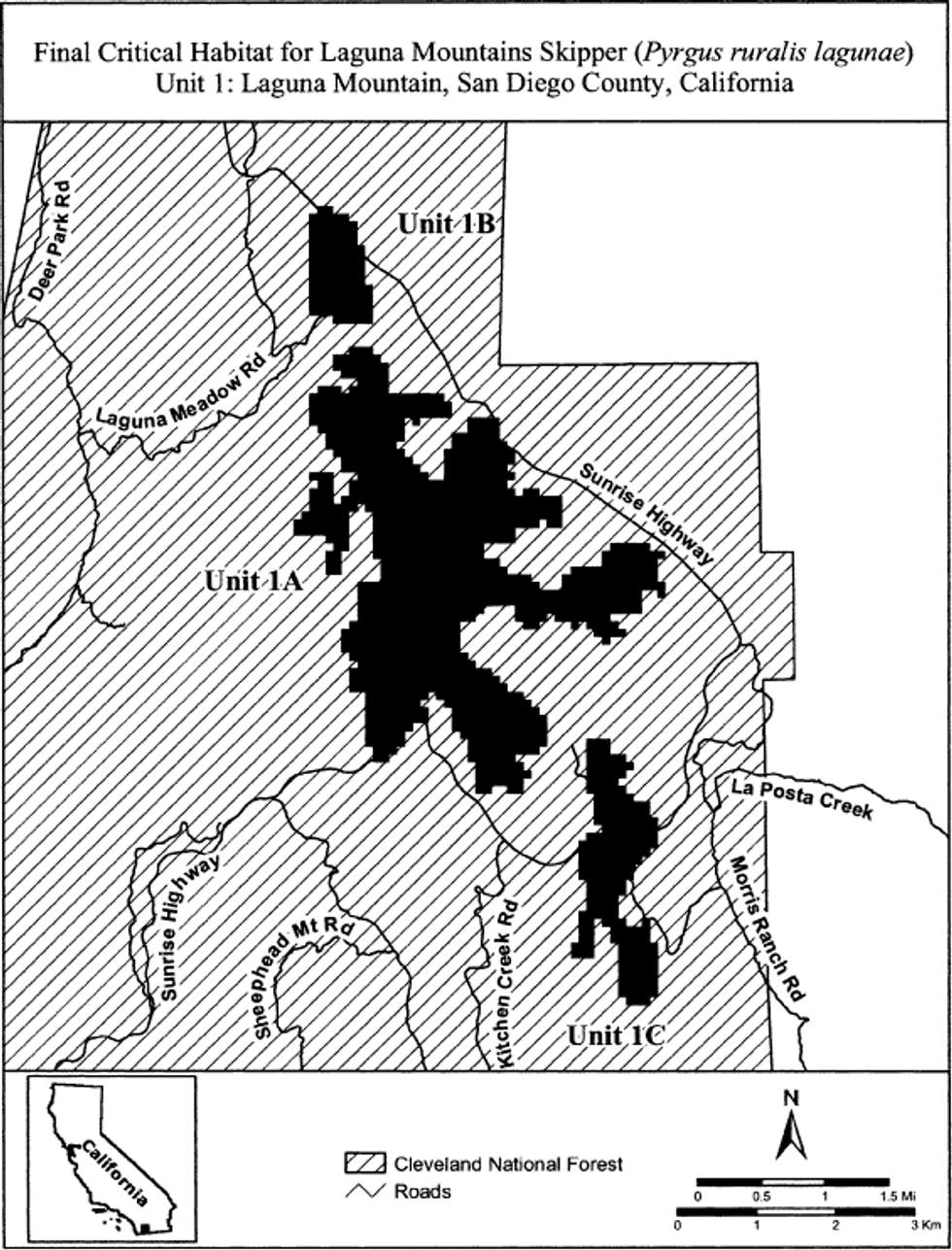
(7) Unit 2: Palomar Mountain, San Diego County, California. From USGS 1:24,000 quadrangle maps Boucher Hill and Palomar Observatory.
(i) Subunit 2A: lands bounded by the following UTM NAD27 coordinates (E, N): 511300, 3689300; 511400, 3689300; 511400, 3689200; 511600, 3689200; 511600, 3689100; 511700, 3689100; 511700, 3689000; 511800, 3689000; 511800, 3688900; 512300, 3688900; 512300, 3688800; 512400, 3688800; 512400, 3689000; 512900, 3689000; 512900, 3688900; 513200, 3688900; 513200, 3688800; 513400, 3688800; 513400, 3688700; 513700, 3688700; 513700, 3688600; 513900, 3688600; 513900, 3688500; 514000, 3688500; 514000, 3688400; 514100, 3688400; 514100, 3688300; 514400, 3688300; 514400, 3688200; 514500, 3688200; 514500, 3688100; 515300, 3688100; 515300, 3688000; 515400, 3688000; 515400, 3687900; 515500, 3687900; 515500, 3687800; 515700, 3687800; 515700, 3687600; 515900, 3687600; 515900, 3687300; 515800, 3687300; 515800, 3687200; 515900, 3687200; 515900, 3687100; 516000, 3687100; 516000, 3687000; 516300, 3687000; 516300, 3686900; 516400, 3686900; 516400, 3686800; 516500, 3686800; 516500, 3686700; 516600, 3686700; 516600, 3686600; 517000, 3686600; 517000, 3686300; 517200, 3686300; 517200, 3686200; 517300, 3686200; 517300, 3686000; 517100, 3686000; 517100, 3685800; 517200, 3685800; 517200, 3685700; 516700, 3685700; 516700, 3685800; 516600, 3685800; 516600, 3686000; 516500, 3686000; 516500, 3686100; 516400, 3686100; 516400, 3686200; 516300, 3686200; 516300, 3686300; 516200, 3686300; 516200, 3686400; 516000, 3686400; 516000, 3686600; 515900, 3686600; 515900, 3686700; 515800, 3686700; 515800, 3686800; 515700, 3686800; 515700, 3686900; 515500, 3686900; 515500, 3687000; 515200, 3687000; 515200, 3687100; 514900, 3687100; 514900, 3687200; 514800, 3687200; 514800, 3687300; 514500, 3687300; 514500, 3687500; 514400, 3687500; 514400, 3687600; 514300, 3687600; 514300, 3687700; 514200, 3687700; 514200, 3687800; 514100, 3687800; 514100, 3687900; 514000, 3687900; 514000, 3688000; 513700, 3688000; 513700, 3688100; 513500, 3688100; 513500, 3688000; 513400, 3688000; 513400, 3687700; 513300, 3687700; 513300, 3687400; 513200, 3687400; 513200, 3687300; 513000, 3687300; 513000, 3687600; 512900, 3687600; 512900, 3688000; 512800, 3688000; 512800, 3688100; 512500, 3688100; 512500, 3688200; 512400, 3688200; 512400, 3688400; 512300, 3688400; 512300, 3688500; 512000, 3688500; 512000, 3688600; 511900, 3688600; 511900, 3688500; 511700, 3688500; 511700, 3688800; 511500, 3688800; 511500, 3688900; 511400, 3688900; 511400, 3689000; 511300, 3689000; 511300, 3689100; 511200, 3689100; 511200, 3689200; 511300, 3689200; 511300, 3689300.
(ii) Subunit 2B: lands bounded by the following UTM NAD27 coordinates (E,N): 513000, 3690900; 513000, 3690800; 513200, 3690800; 513200, 3690600; 513100, 3690600; 513100, 3690400; 513200, 3690400; 513200, 3690300; 513300, 3690300; 513300, 3690000; 513200, 3690000; 513200, 3689900; 513300, 3689900; 513300, 3689600; 512900, 3689600; 512900, 3689400; 512700, 3689400; 512700, 3689500; 512600, 3689500; 512600, 3689300; 512300, 3689300; 512300, 3689400; 512200, 3689400; 512200, 3689500; 512000, 3689500; 512000, 3689700; 511900, 3689700; 511900, 3689900; 511800, 3689900; 511800, 3690200; 511700, 3690200; 511700, 3690300; 511600, 3690300; 511600, 3690500; 511500, 3690500; 511500, 3690600; 511200, 3690600; 511200, 3690700; 511100, 3690700; 511100, 3690800; 510800, 3690800; 510800, 3690900; 510700, 3690900; 510700, 3690800; 510600, 3690800; 510600, 3690900; 510500, 3690900; 510500, 3691000; 510200, 3691000; 510200, 3690900; 510300, 3690900; 510300, 3690600; 510400, 3690600; 510400, 3690300; 510200, 3690300; 510200, 3690400; 509800, 3690400; 509800, 3690500; 509700, 3690500; 509700, 3690600; 509500, 3690600; 509500, 3690700; 509400, 3690700; 509400, 3690800; 509300, 3690800; 509300, 3690900; 509100, 3690900; 509100, 3691000; 509000, 3691000; 509000, 3691200; 509200, 3691200; 509200, 3691100; 509400, 3691100; 509400, 3691300; 509300, 3691300; 509300, 3691500; 509500, 3691500; 509500, 3691400; 510000, 3691400; 510000, 3691500; 510100, 3691500; 510100, 3691600; 510200, 3691600; 510200, 3691700; 510700, 3691700; 510700, 3691600; 511000, 3691600; 511000, 3691500; 511100, 3691500; 511100, 3691400; 511400, 3691400; 511400, 3691200; 511600, 3691200; 511600, 3691100; 511700, 3691100; 511700, 3691000; 511900, 3691000; 511900, 3690900; 512000, 3690900; 512000, 3690700; 511800, 3690700; 511800, 3690600; 511900, 3690600; 511900, 3690500; 512000, 3690500; 512000, 3690400; 512100, 3690400; 512100, 3690300; 512200, 3690300; 512200, 3690200; 512500, 3690200; 512500, 3690300; 512700, 3690300; 512700, 3690400; 512600, 3690400; 512600, 3690600; 512500, 3690600; 512500, 3690700; 512400, 3690700; 512400, 3690800; 512300, 3690800; 512300, 3691100; 512500, 3691100; 512500, 3691200; 513100, 3691200; 513100, 3691300; 513200, 3691300; 513200, 3691200; 513300, 3691200; 513300, 3690900; 513000, 3690900; excluding lands bounded by the following UTM NAD27 coordinates (E,N): 509900, 3691000; 510100, 3691000; 510100, 3690900; 510000, 3690900; 510000, 3690800; 509900, 3690800; 509900, 3691000; and 512800, 3691000; 513000, 3691000; 513000, 3690900; 512800, 3690900; 512800, 3691000.
(iii) Subunit 2C: lands bounded by the following UTM NAD27 coordinates (E, N): 509200, 3689100; 509400, 3689100; 509400, 3689000; 509700, 3689000; 509700, 3688700; 509800, 3688700; 509800, 3688600; 510200, 3688600; 510200, 3688900; 510800, 3688900; 510800, 3688800; 511100, 3688800; 511100, 3688600; 511200, 3688600; 511200, 3688500; 511300, 3688500; 511300, 3688400; 511200, 3688400; 511200, 3688300; 511500, 3688300; 511500, 3688200; 511600, 3688200; 511600, 3687900; 511300, 3687900; 511300, 3687600; 511200, 3687600; 511200, 3687500; 511100, 3687500; 511100, 3687400; 511200, 3687400; 511200, 3687100; 511000, 3687100; 511000, 3687200; 510900, 3687200; 510900, 3687300; 510600, 3687300; 510600, 3687500; 510500, 3687500; 510500, 3687400; 510400, 3687400; 510400, 3687500; 510300, 3687500; 510300, 3687600; 510400, 3687600; 510400, 3687700; 510500, 3687700; 510500, 3687800; 510400, 3687800; 510400, 3687900; 510300, 3687900; 510300, 3687800; 510100, 3687800; 510100, 3687900; 509900, 3687900; 509900, 3688200; 509800, 3688200; 509800, 3688300; 509700, 3688300; 509700, 3688400; 509500, 3688400; 509500, 3688500; 509300, 3688500; 509300, 3688600; 509200, 3688600; 509200, 3689100.
(iv) Subunit 2D: lands bounded by the following UTM NAD27 coordinates (E,N): 507700, 3690800; 508000, 3690800; 508000, 3690700; 508100, 3690700; 508100, 3690800; 508300, 3690800; 508300, 3690600; 508400, 3690600; 508400, 3690500; 508500, 3690500; 508500, 3690300; 508400, 3690300; 508400, 3690100; 508500, 3690100; 508500, 3690000; 508600, 3690000; 508600, 3689900; 508700, 3689900; 508700, 3689700; 508800, 3689700; 508800, 3689600; 508900, 3689600; 508900, 3689100; 508700, 3689100; 508700, 3689200; 508600, 3689200; 508600, 3689300; 508400, 3689300; 508400, 3689400; 508200, 3689400; 508200, 3689800; 508000, 3689800; 508000, 3690000; 507900, 3690000; 507900, 3690200; 507800, 3690200; 507800, 3690400; 507500, 3690400; 507500, 3690300; 507400, 3690300; 507400, 3690500; 507500, 3690500; 507500, 3690700; 507700, 3690700; 507700, 3690800.
(v) Note: Map of Unit 2 (Map 3, Subunits 2A, 2B, 2C, and 2D) follows:
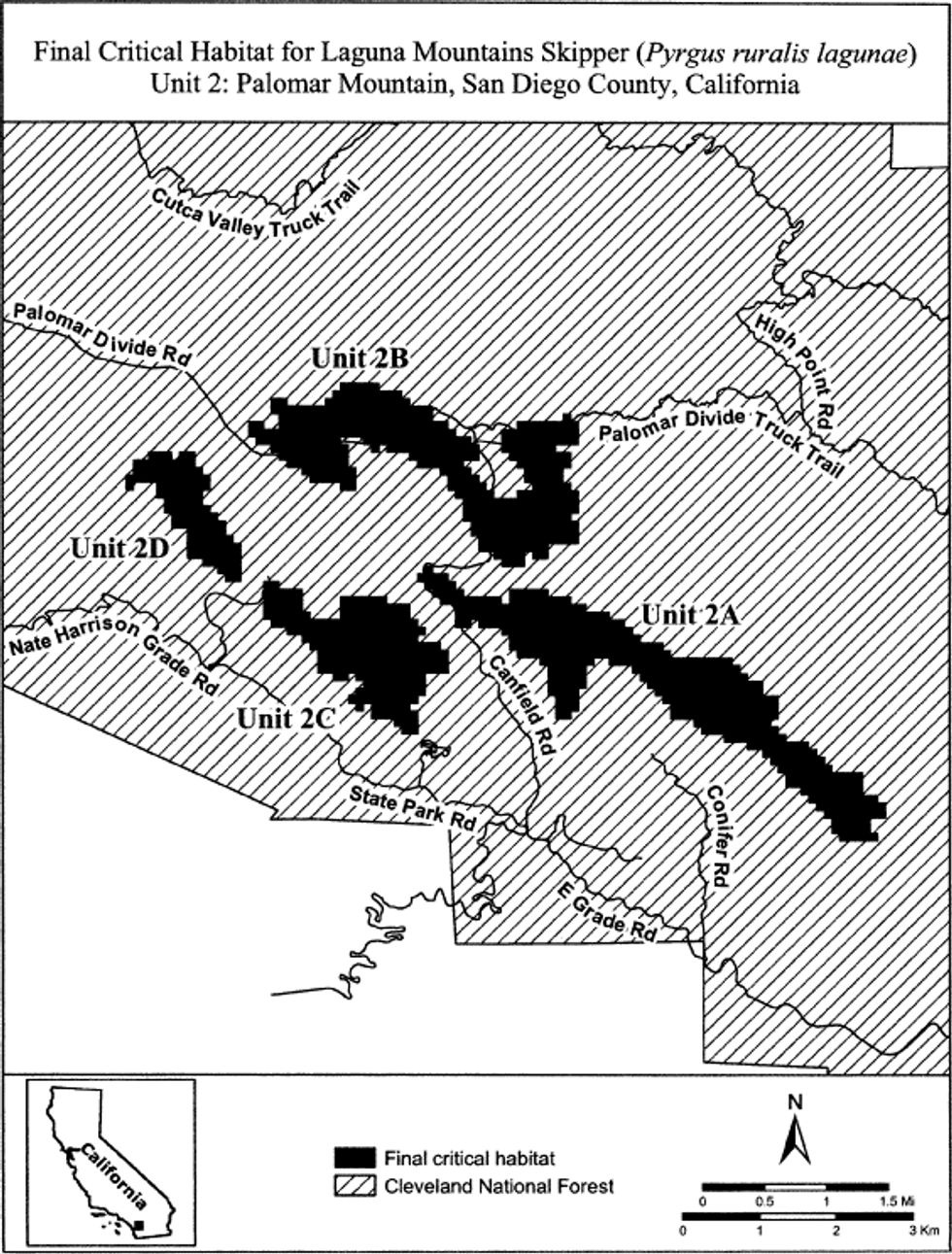
Poweshiek Skipperling (Oarisma Poweshiek)
(1) Critical habitat units are designated for Cerro Gordo, Dickinson, Emmet, Howard, Kossuth, and Osceola Counties in Iowa; in Hilsdale, Jackson, Lenawee, Livingston, Oakland, and Washtenaw Counties in Michigan; Chippewa, Clay, Cottonwood, Douglas, Kittson, Lac Qui Parle, Lincoln, Lyon, Mahnomen, Murray, Norman, Pipestone, Polk, Pope, Swift, and Wilkin Counties in Minnesota; Richland County in North Dakota; Brookings, Day, Deuel, Grant, Marshall, Moody, and Roberts Counties in South Dakota; and Green Lake and Waukesha Counties in Wisconsin, on the maps below.
(2) Within these areas, the primary constituent elements of the physical or biological features essential to the conservation of Poweshiek skipperling consist of four components:
(i) Primary Constituent Element 1 - Wet-mesic to dry tallgrass remnant untilled prairies or remnant moist meadows containing:
(A) A predominance of native grasses and native flowering forbs;
(B) Undisturbed (untilled) glacial soil types including, but not limited to, loam, sandy loam, loamy sand, gravel, organic soils (peat), or marl that provide the edaphic features conducive to Poweshiek skipperling larval survival and native-prairie vegetation;
(C) If present, depressional wetlands or low wet areas, within or adjacent to prairies that provide shelter from high summer temperatures and fire;
(D) If present, trees or large shrub cover less than 5 percent of area in dry prairies and less than 25 percent in wet-mesic prairies and prairie fens; and
(E) If present, nonnative invasive plant species occurring in less than 5 percent of area.
(ii) Primary Constituent Element 2 - Prairie fen habitats containing:
(A) A predominance of native grasses and native flowering forbs;
(B) Undisturbed (untilled) glacial soil types including, but not limited to, organic soils (peat), or marl that provide the edaphic features conducive to Poweshiek skipperling larval survival and native-prairie vegetation;
(C) Depressional wetlands or low wet areas, within or adjacent to prairies that provide shelter from high summer temperatures and fire;
(D) Hydraulic features necessary to maintain prairie fen groundwater flow and prairie fen plant communities;
(E) If present, trees or large shrub cover less than 25 percent of the unit; and
(F) If present, nonnative invasive plant species occurring in less than 5 percent of area.
(iii) Primary Constituent Element 3 - Native grasses and native flowering forbs for larval and adult food and shelter, specifically:
(A) At least one of the following native grasses available to provide larval food and shelter sources during Poweshiek skipperling larval stages: Prairie dropseed (Sporobolus heterolepis), little bluestem (Schizachyrium scoparium), sideoats grama (Bouteloua curtipendula), or mat muhly (Muhlenbergia richardsonis); and
(B) At least one of the following forbs in bloom to provide nectar and water sources during the Poweshiek skipperling flight period: Purple coneflower (Echinacea angustifolia), black-eyed Susan (Rudbeckia hirta), smooth ox-eye (Heliopsis helianthoides), stiff tickseed (Coreopsis palmata), palespike lobelia (Lobelia spicata), sticky tofieldia (Triantha glutinosa), or shrubby cinquefoil (Dasiphora fruticosa ssp. floribunda).
(iv) Primary Constituent Element 4 - Dispersal grassland habitat that is within 1 km (0.6 mi) of native high-quality remnant prairie (as defined in Primary Constituent Element 1) that connects high-quality wet-mesic to dry tallgrass prairies, moist meadows, or prairie fen habitats. Dispersal grassland habitat consists of the following physical characteristics appropriate for supporting Poweshiek skipperling dispersal: Undeveloped open areas dominated by perennial grassland with limited or no barriers to dispersal including tree or shrub cover less than 25 percent of the area and no row crops such as corn, beans, potatoes, or sunflowers.
(3) Critical habitat does not include manmade structures (such as buildings, aqueducts, runways, roads, and other paved areas) and the land on which they are located existing within the legal boundaries on November 2, 2015.
(4) Critical habitat map units. Data layers defining map units were created and digitized using ESRI's ArcMap (version 10.0) and comparing USGS NAIP/FSA high-resolution orthophotography from 2010 or later and previously mapped skipper habitat polygons submitted by contracted researchers or prairie habitat polygons made available from Minnesota Department of Natural Resources' County Biological Survey. Critical habitat units then were mapped in Geographic Coordinate System WGS84. The maps in this entry, as modified by any accompanying regulatory text, establish the boundaries of the critical habitat designation. The coordinates or plot points or both on which each map is based are available to the public at the Service's internet site (http://www.fws.gov/midwest/Endangered/), at http://www.regulations.gov at Docket No. FWS-R3-ES-2013-0017, and at the field office responsible for this designation. You may obtain field office location information by contacting one of the Service regional offices, the addresses of which are listed at 50 CFR 2.2.
(5) Iowa, Minnesota, North Dakota, and South Dakota index map follows:
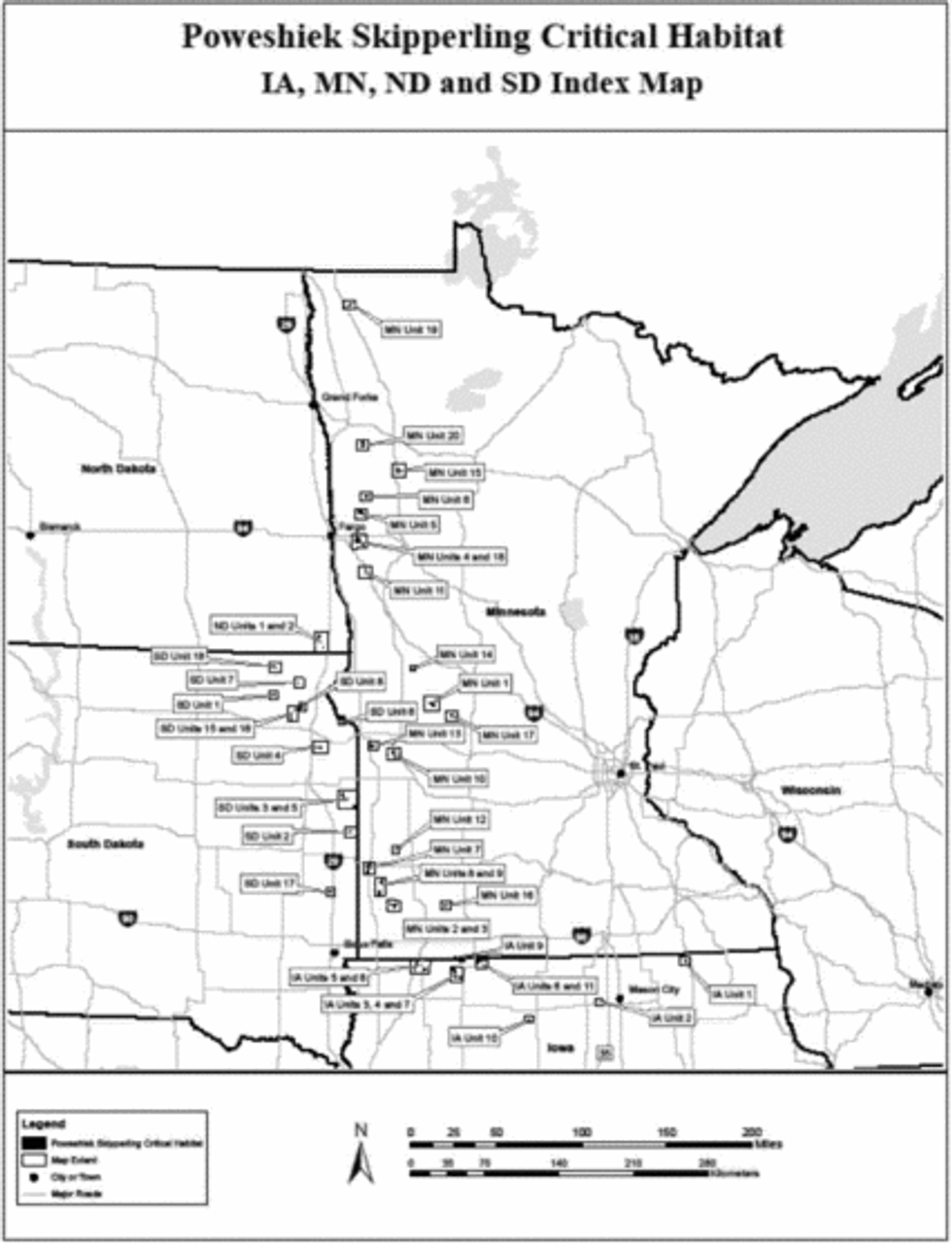
(6) Michigan and Wisconsin index map follows:
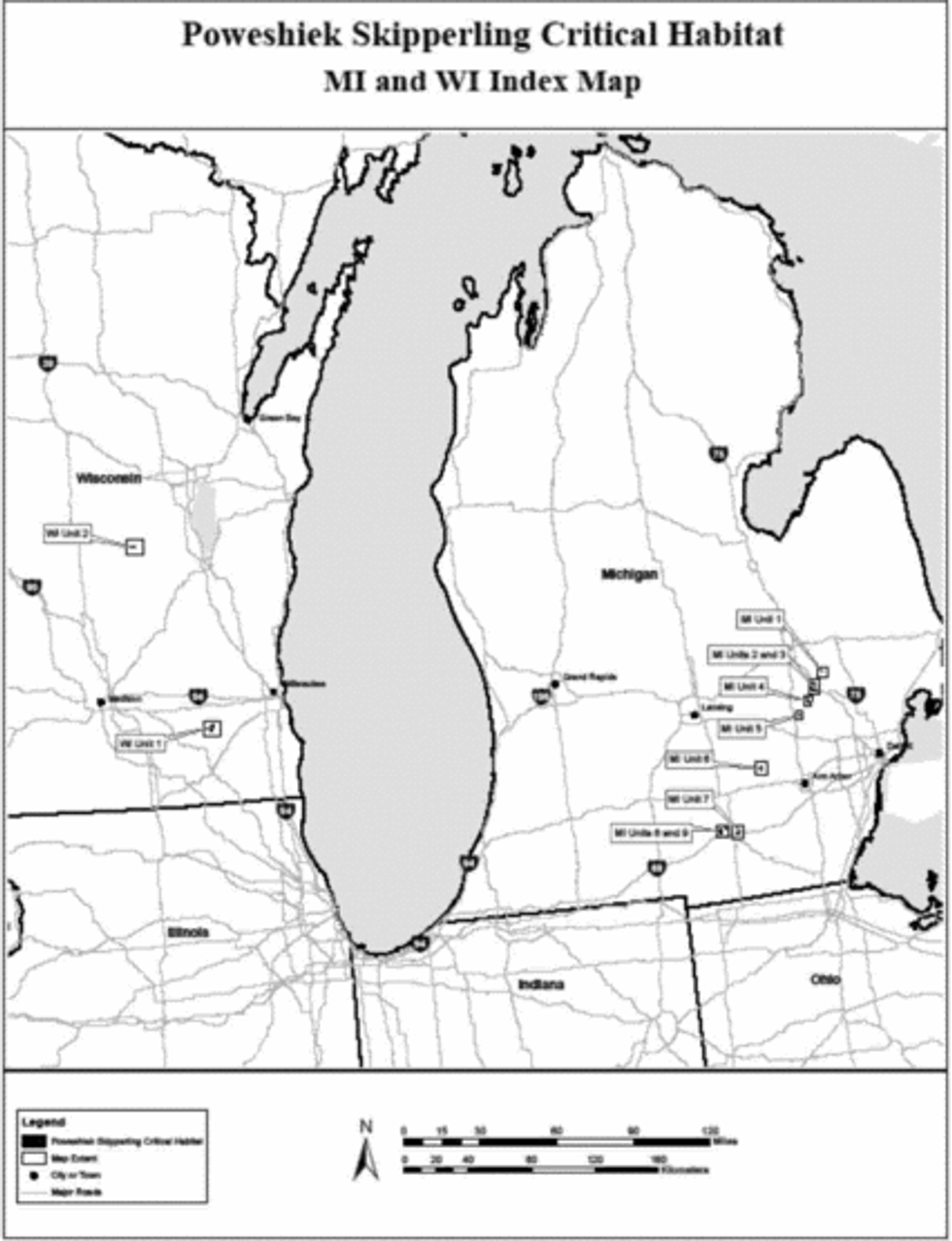
(7) PS Iowa Unit 1, Howard County, Iowa. Map of PS Iowa Unit 1 follows:
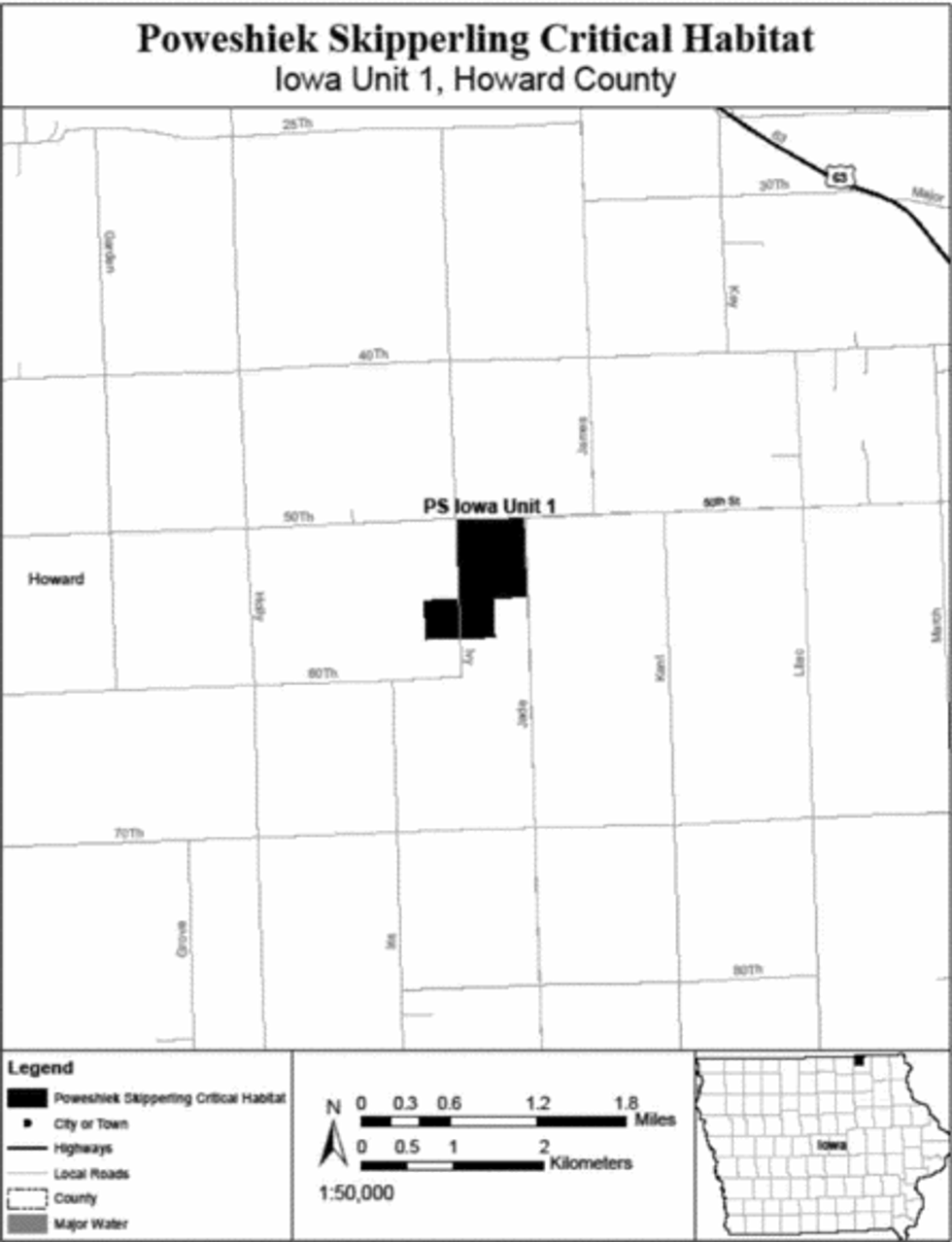
(8) PS Iowa Unit 2, Cerro Gordo County, Iowa. Map of PS Iowa Unit 2 follows:
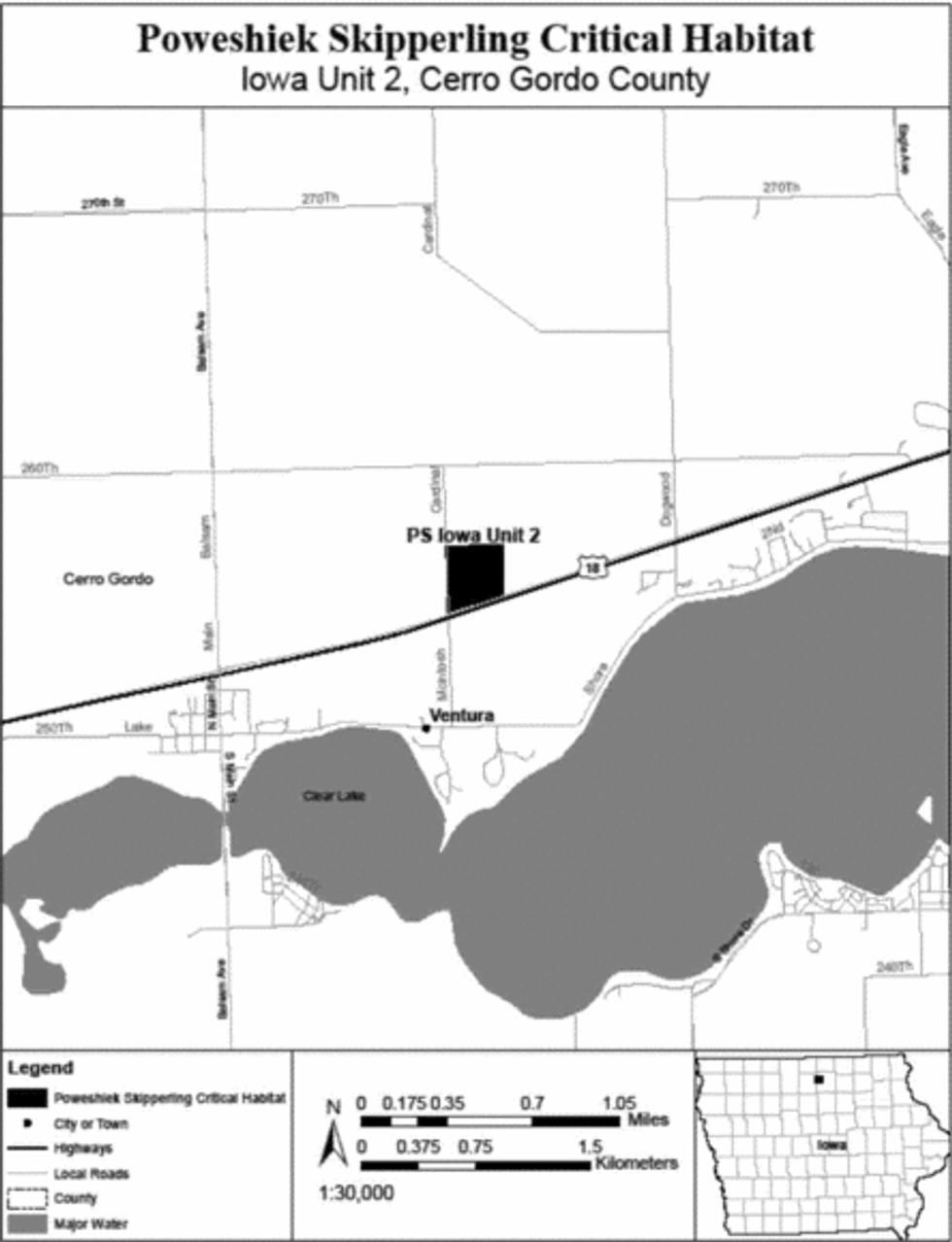
(9) PS Iowa Units 3, 4, and 7, Dickinson County, Iowa. Map of PS Iowa Units 3, 4, and 7 follows:
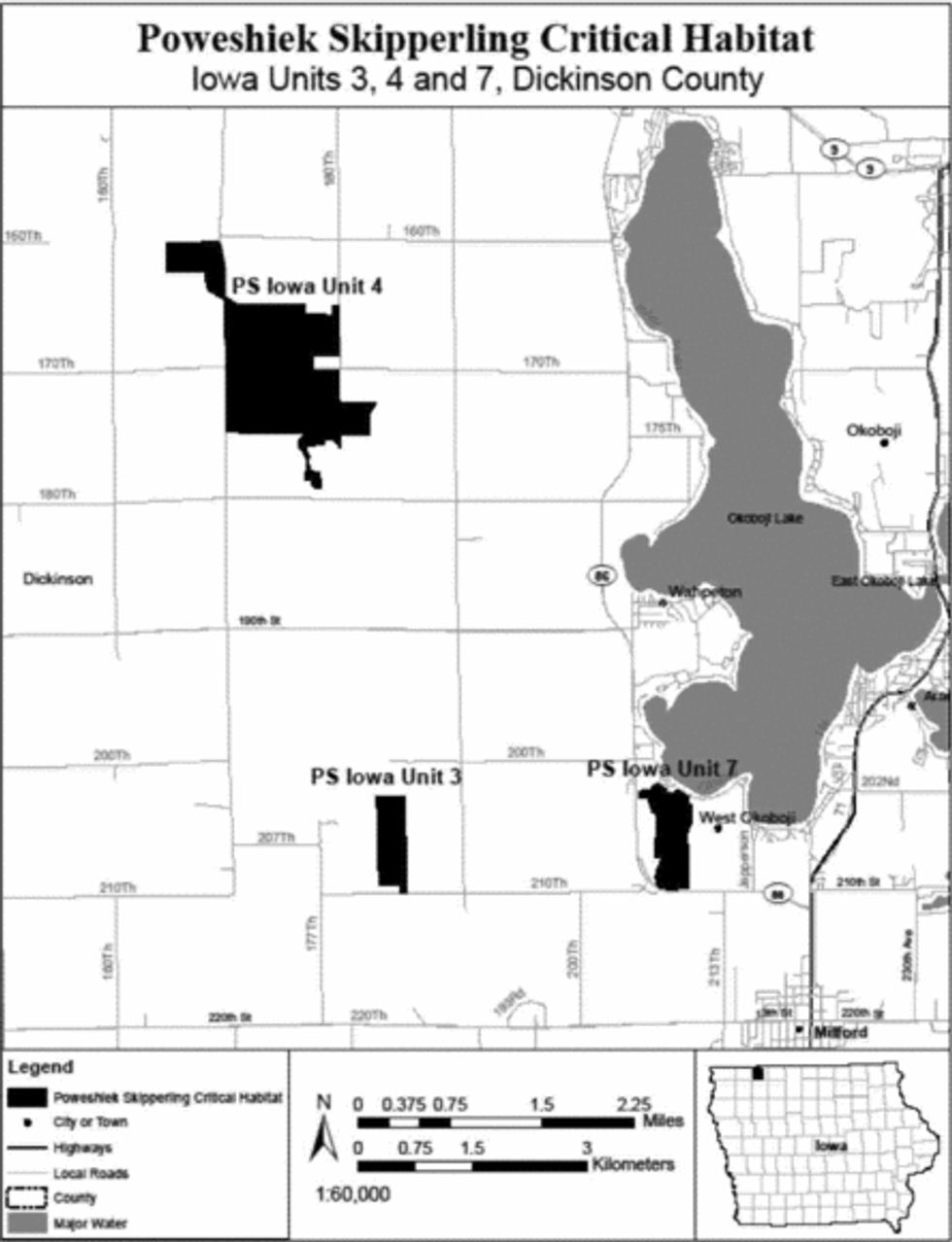
(10) PS Iowa Unit 5, Osceola County, Iowa. Map of PS Iowa Unit 5 follows:
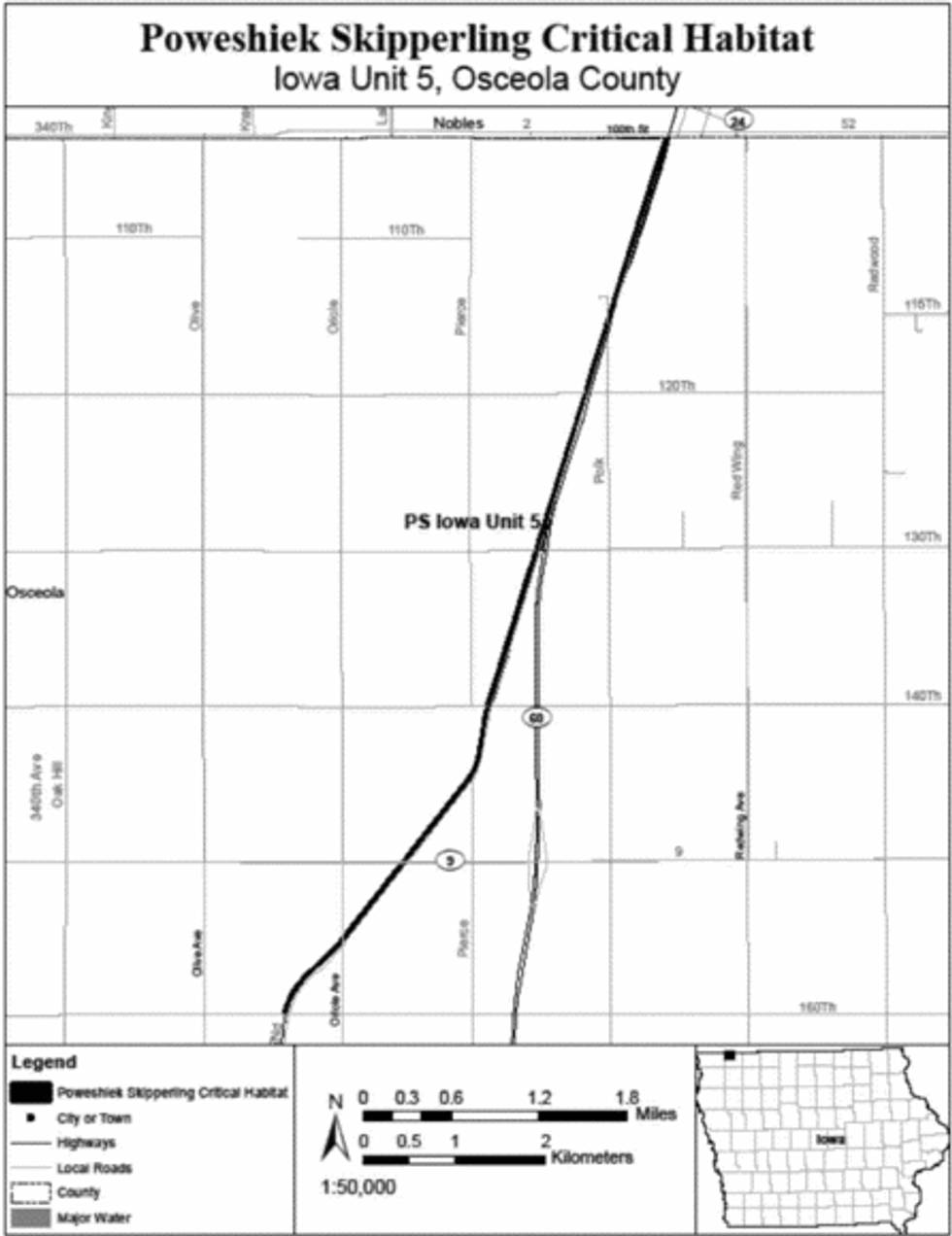
(11) PS Iowa Unit 6, Dickinson County, Iowa. Map of PS Iowa Unit 6 follows:
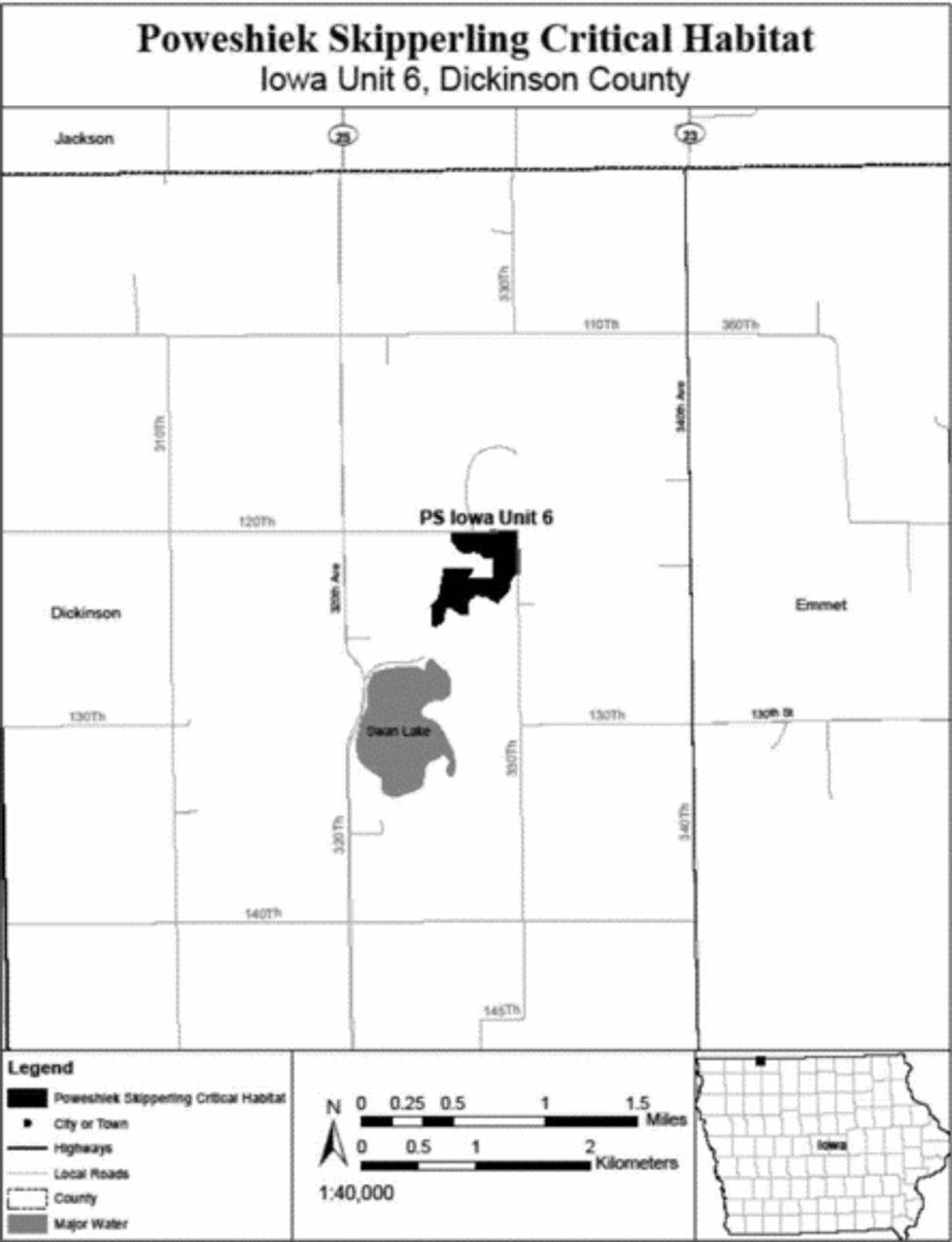
(12) PS Iowa Unit 8, Osceola County, Iowa. Map of PS Iowa Unit 8 follows:
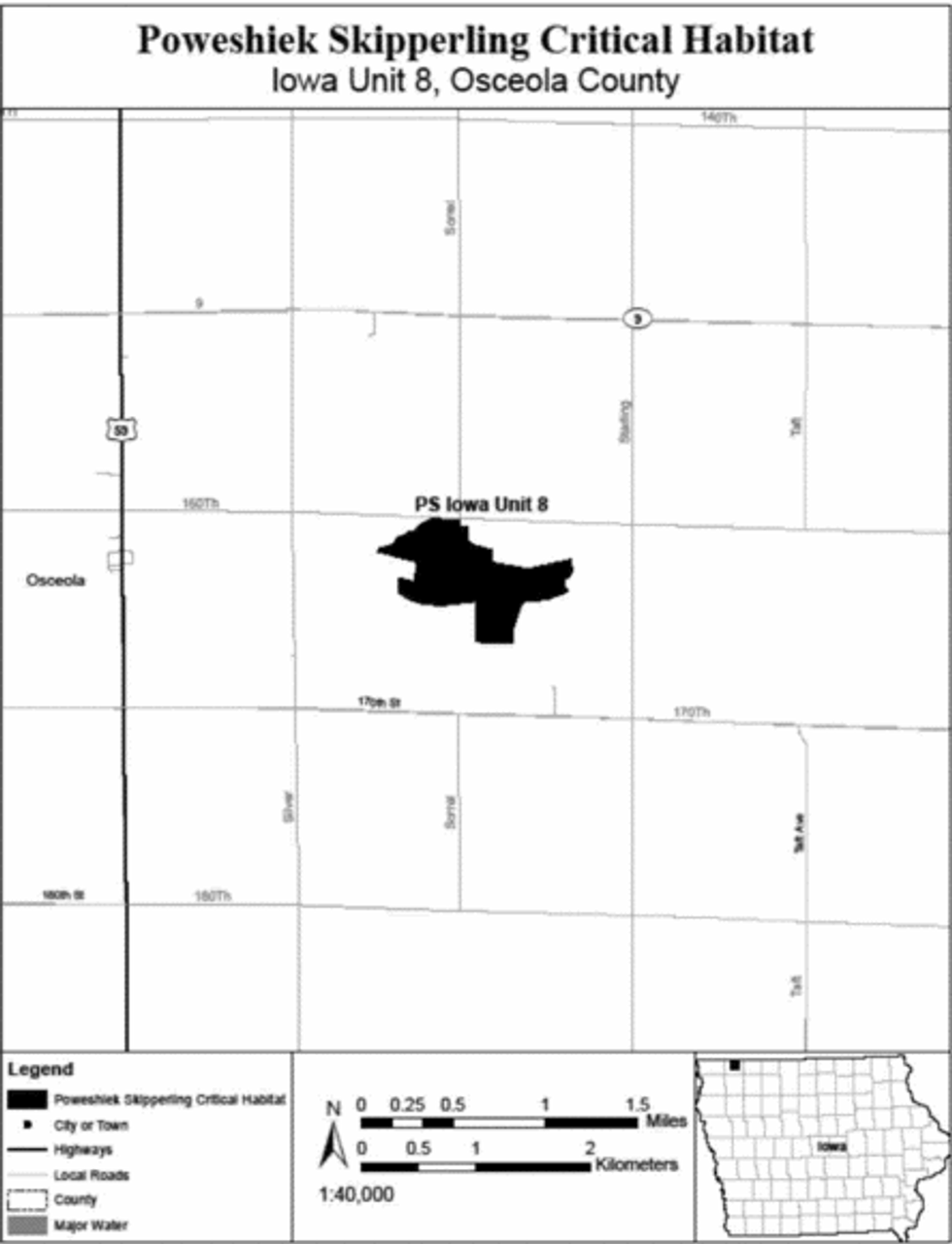
(13) PS Iowa Unit 9, Dickinson County, Iowa. Map of PS Iowa Unit 9 follows:
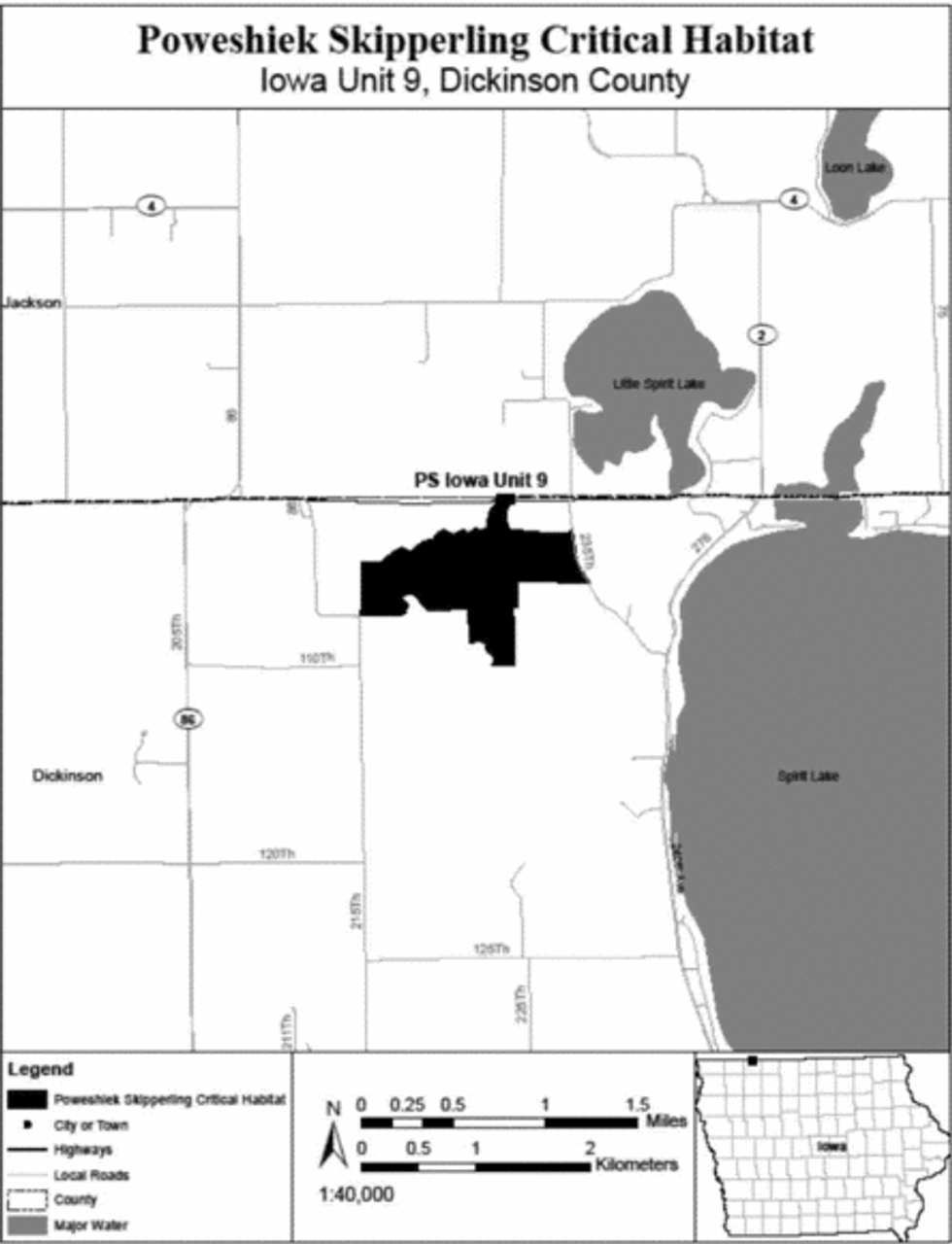
(14) PS Iowa Unit 10, Kossuth County, Iowa. Map of PS Iowa Unit 10 follows:
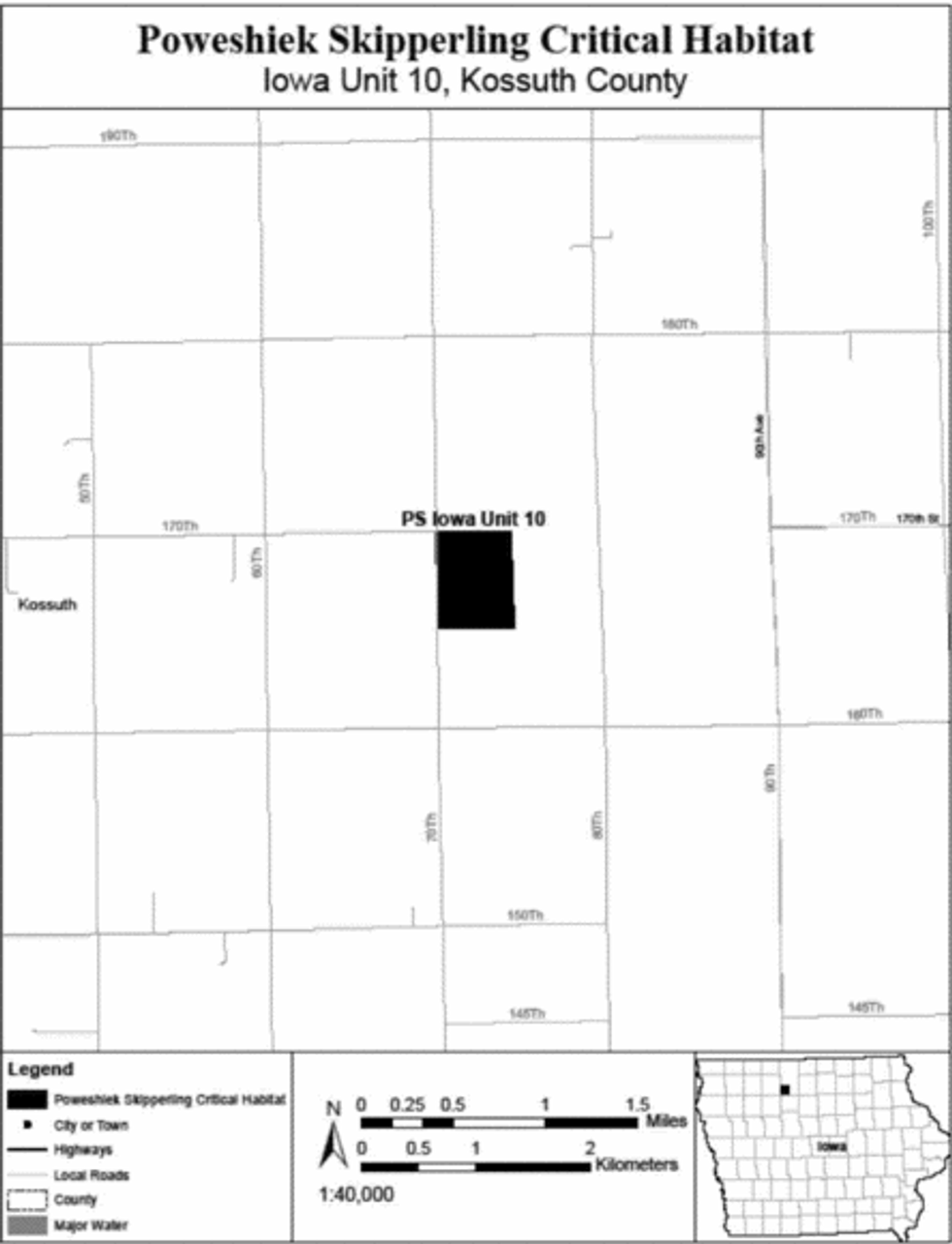
(15) PS Iowa Unit 11, Emmet County, Iowa. Map of PS Iowa Unit 11 follows:
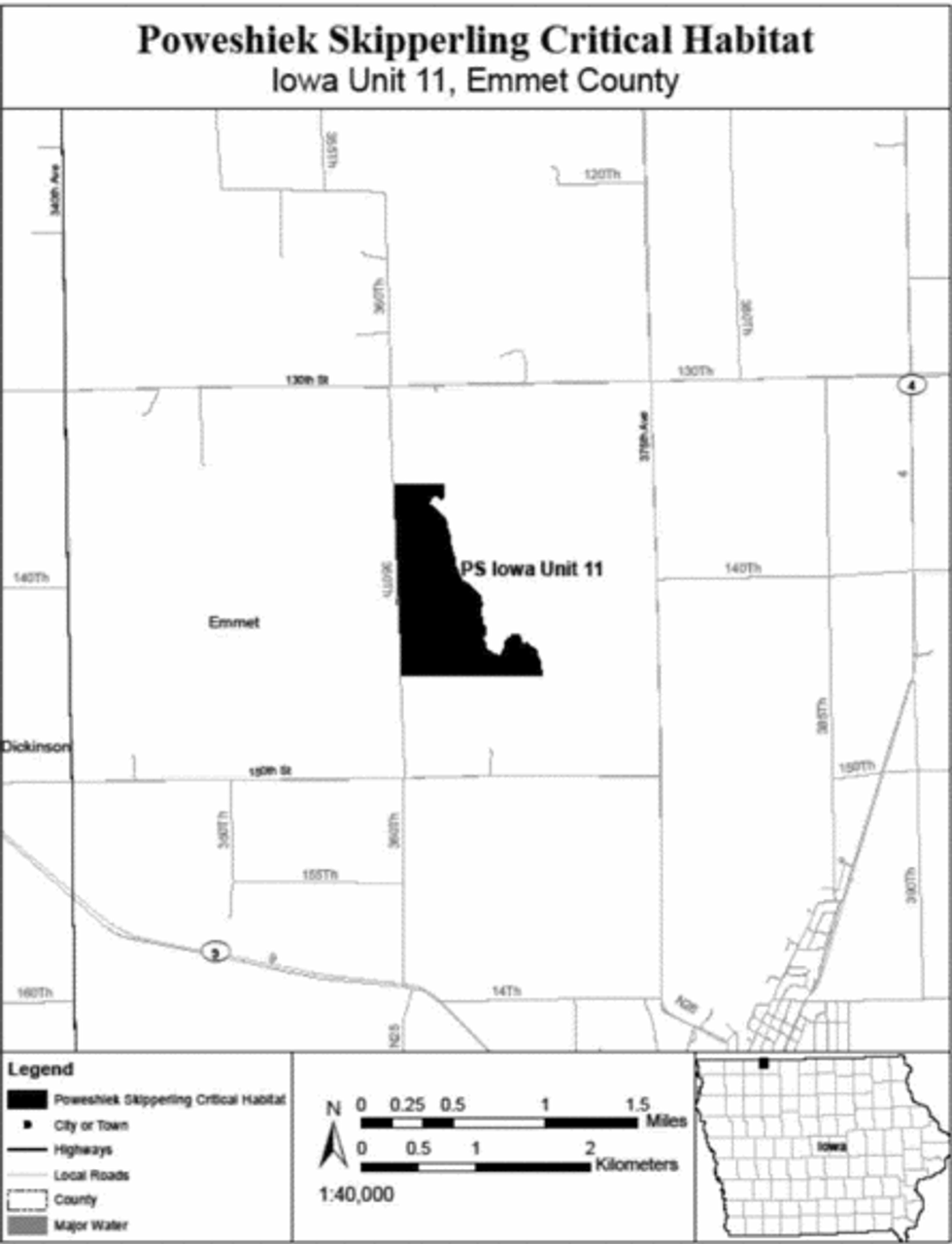
(16) PS Michigan Unit 1, Oakland County, Michigan. Map of PS Michigan Unit 1 follows:
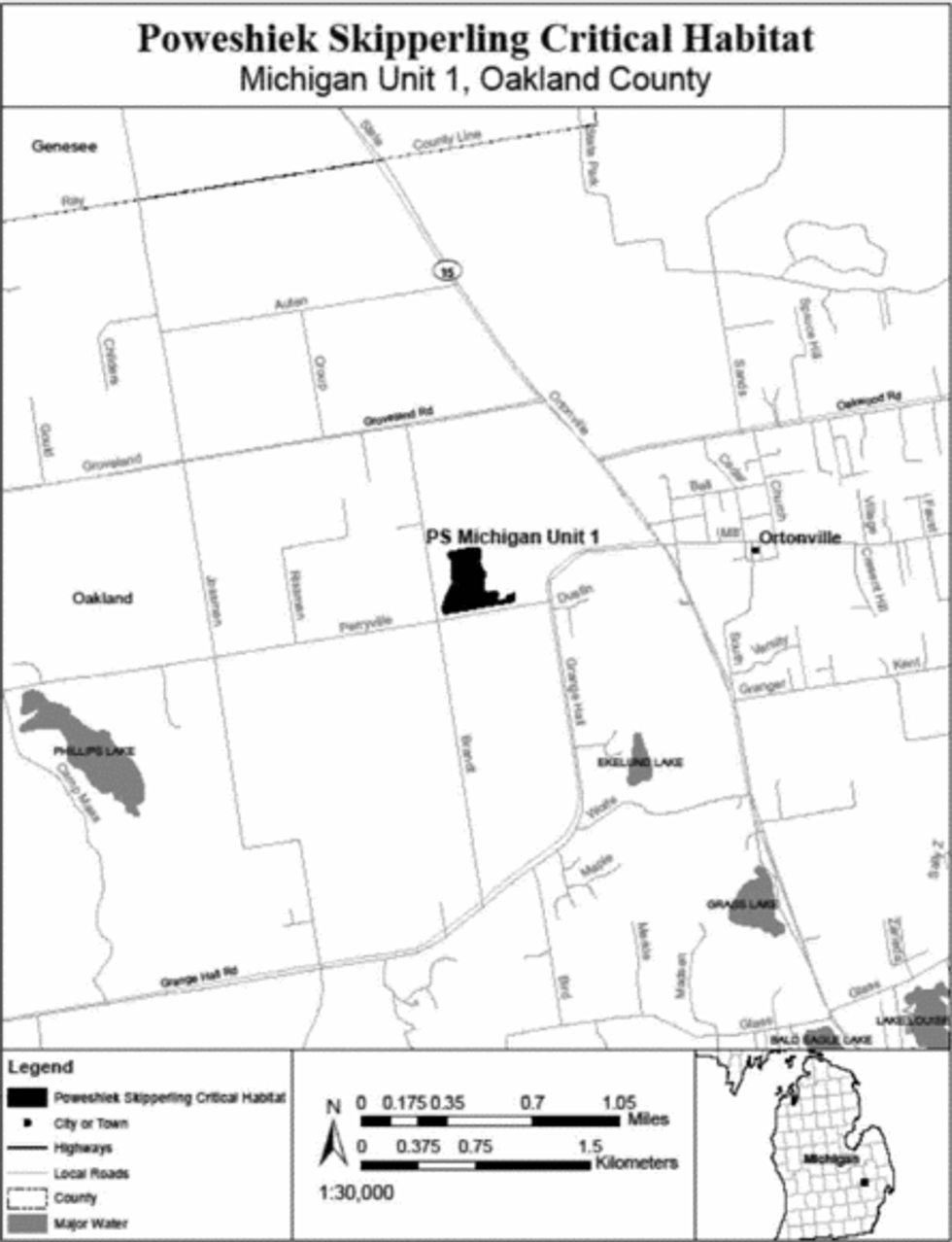
(17) PS Michigan Units 2 and 3, Oakland County, Michigan. Map of PS Michigan Units 2 and 3 follows:
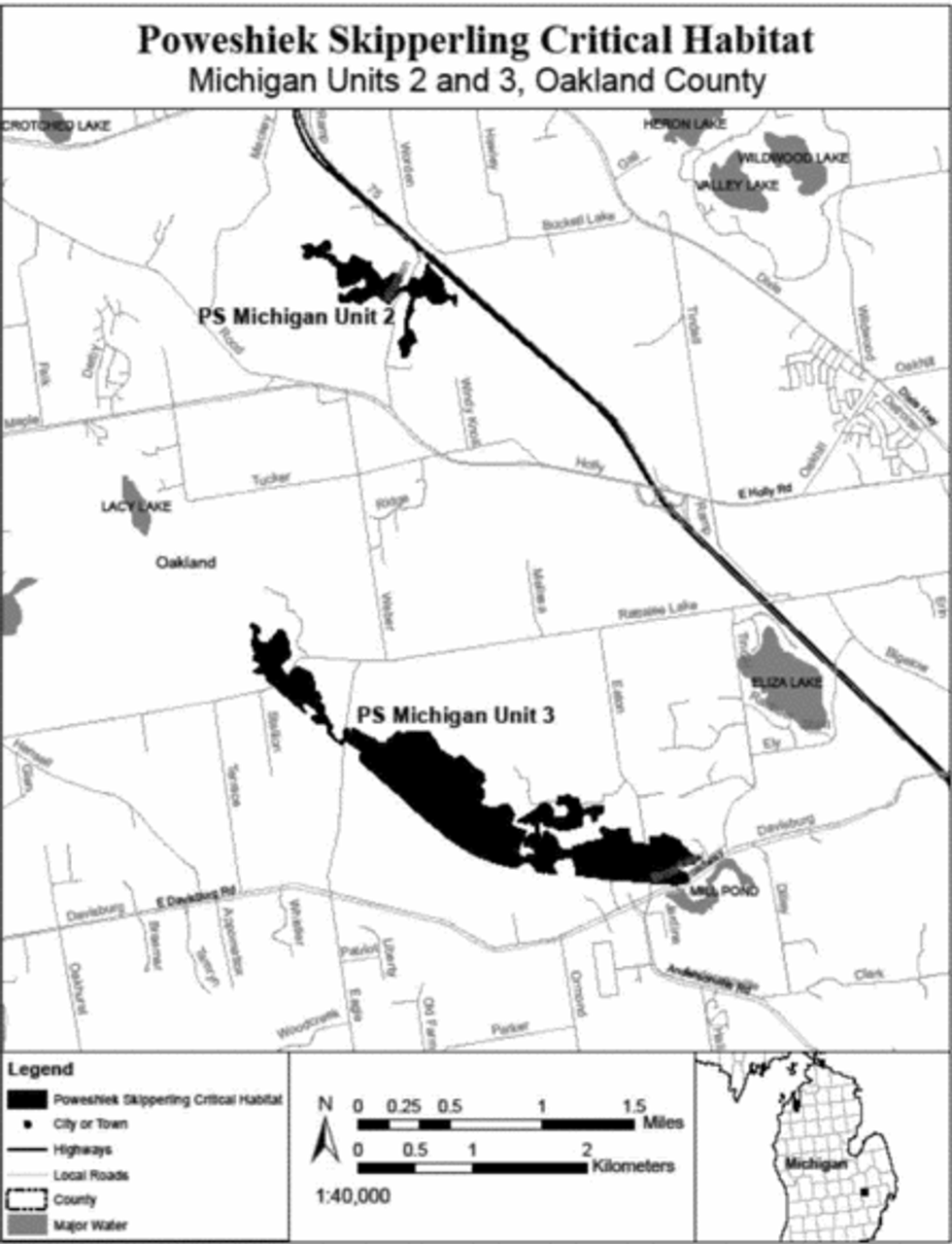
(18) PS Michigan Unit 4, Oakland County, Michigan. Map of PS Michigan Unit 4 follows:
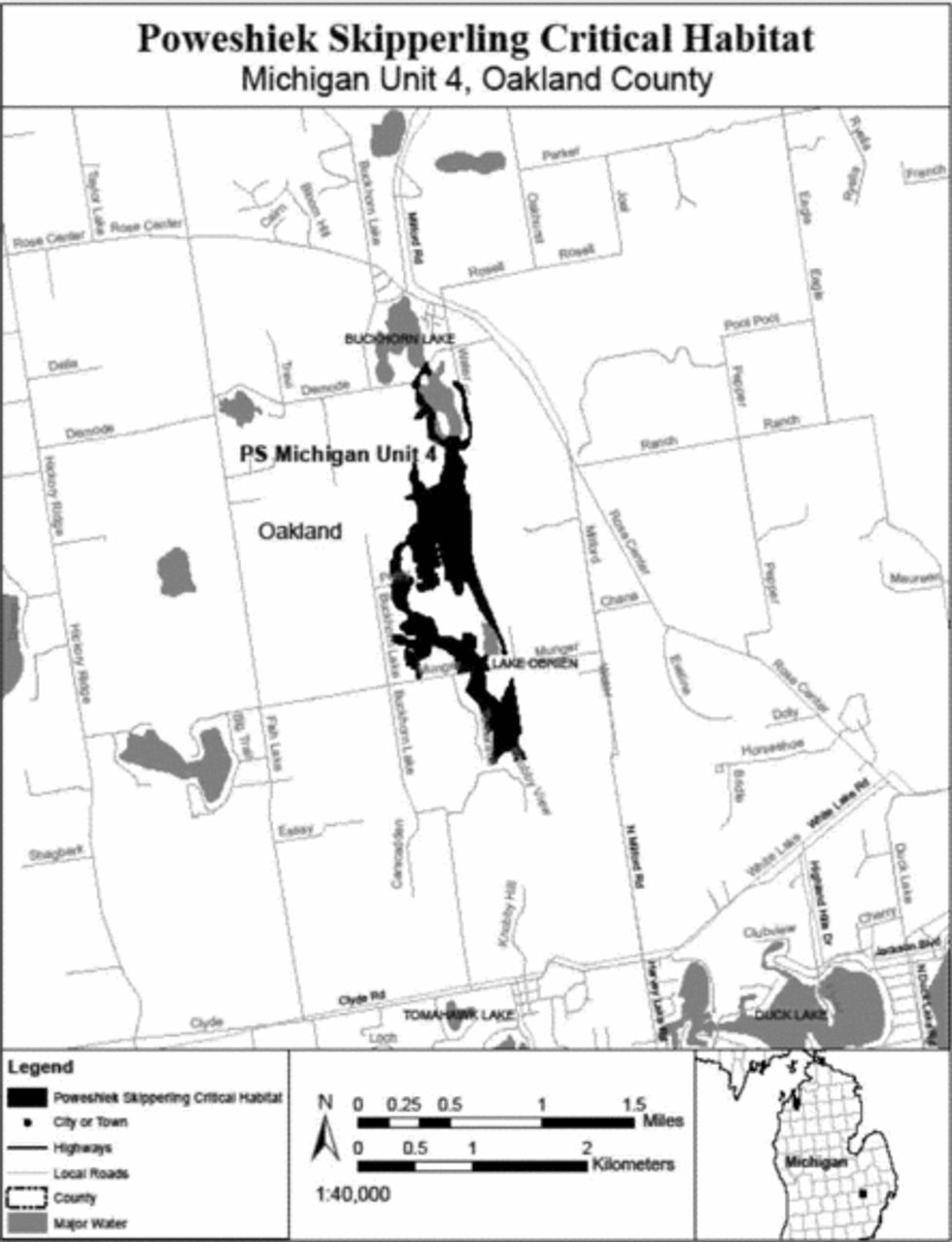
(19) PS Michigan Unit 5, Livingston County, Michigan. Map of PS Michigan Unit 5 follows:
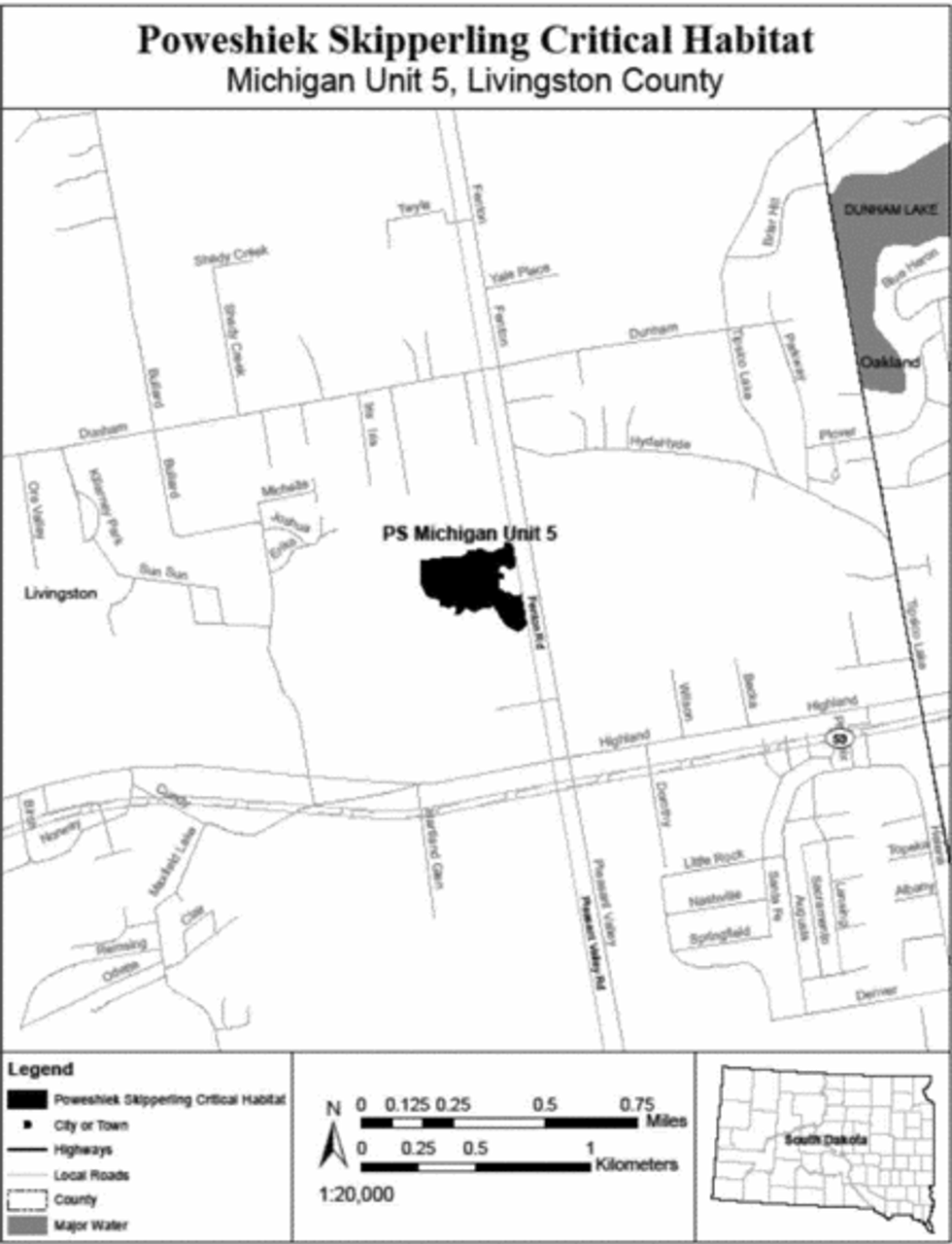
(20) PS Michigan Unit 6, Washtenah County, Michigan. Map of PS Michigan Unit 6 follows:

(21) PS Michigan Unit 7, Lenawee County, Michigan. Map of PS Michigan Unit 7 follows:
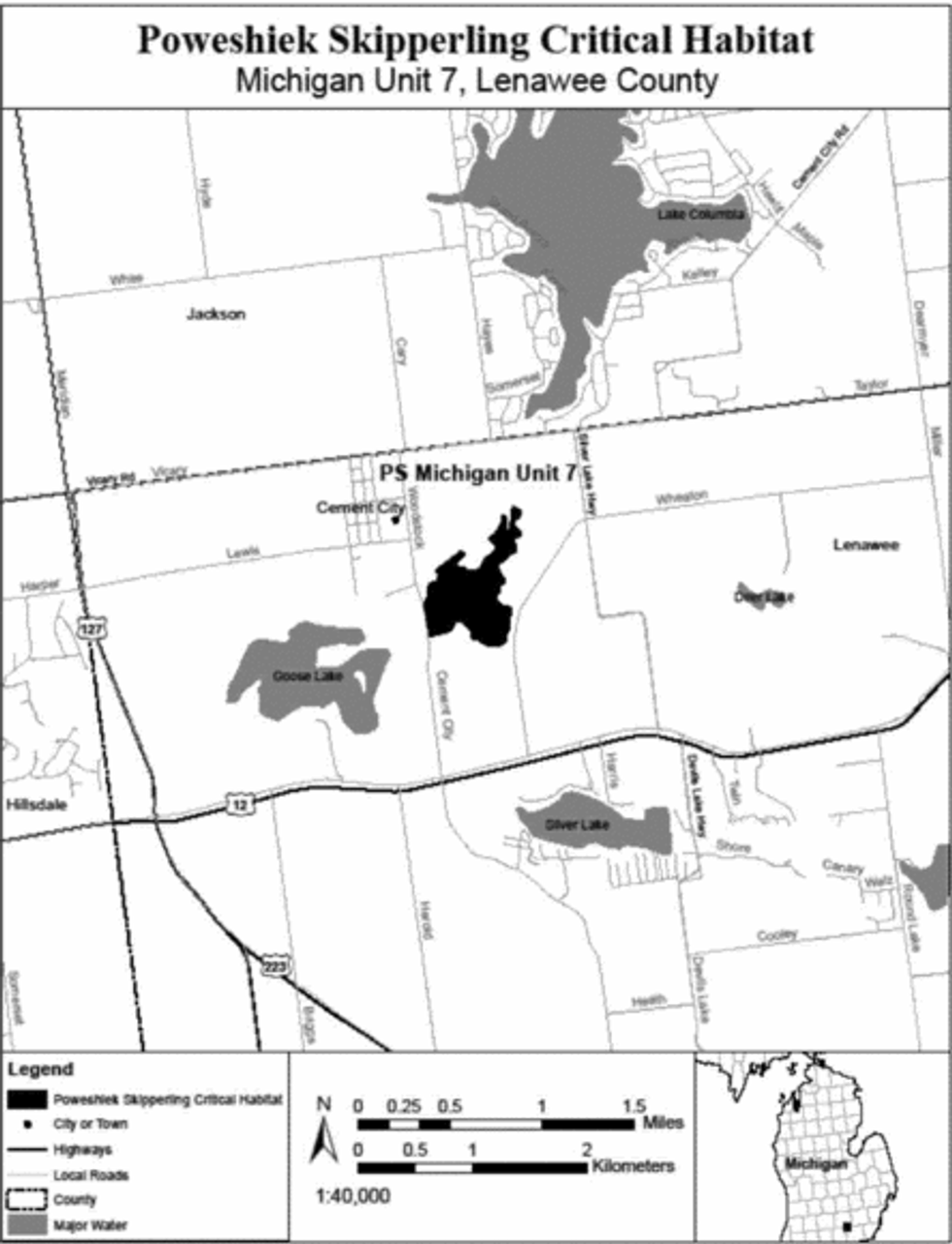
(22) PS Michigan Units 8 and 9, Jackson and Hillsdale Counties, Michigan. Map of PS Michigan Units 8 and 9 follows:
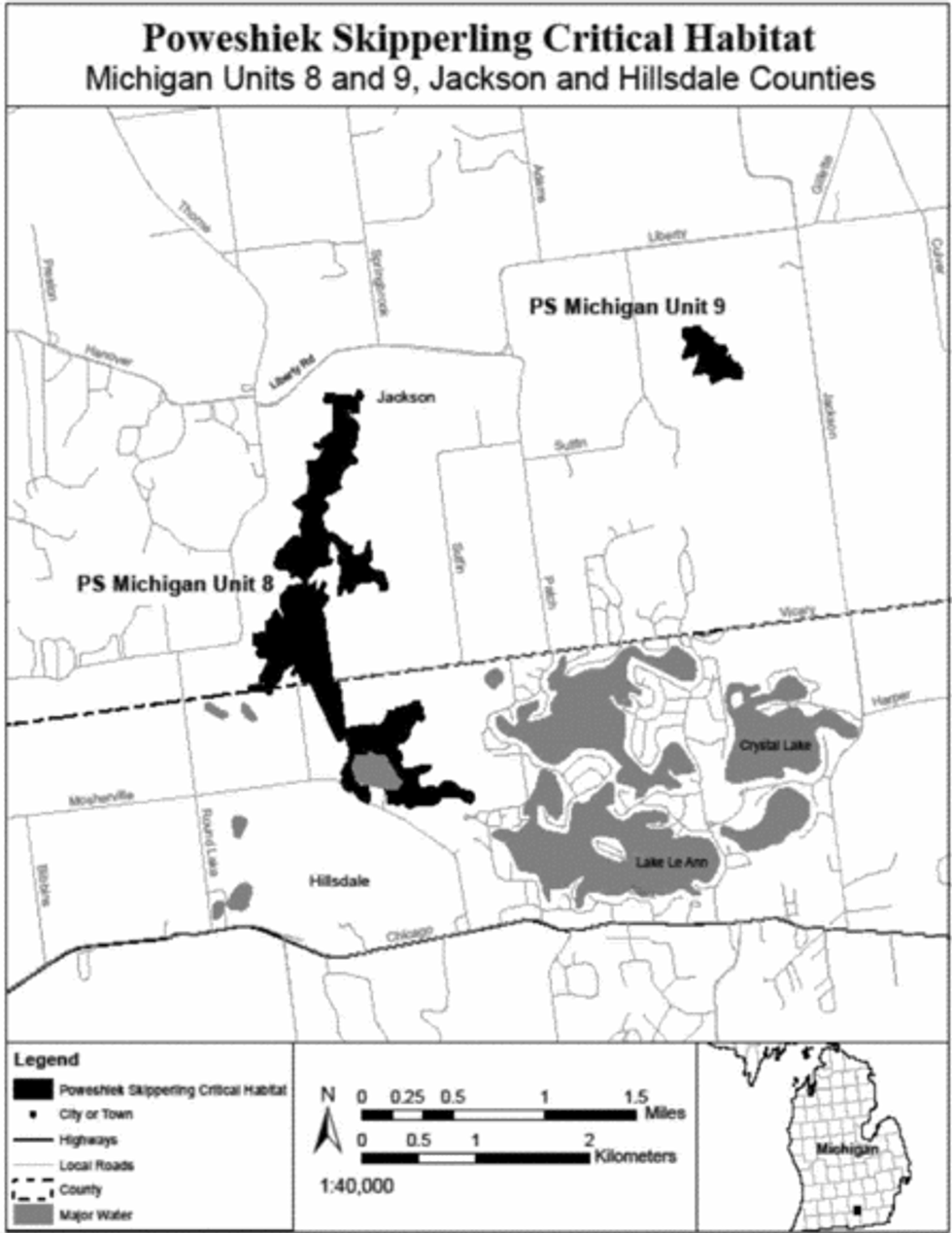
(23) PS Minnesota Unit 1, Pope County, Minnesota. Map of PS Minnesota Unit 1 follows:
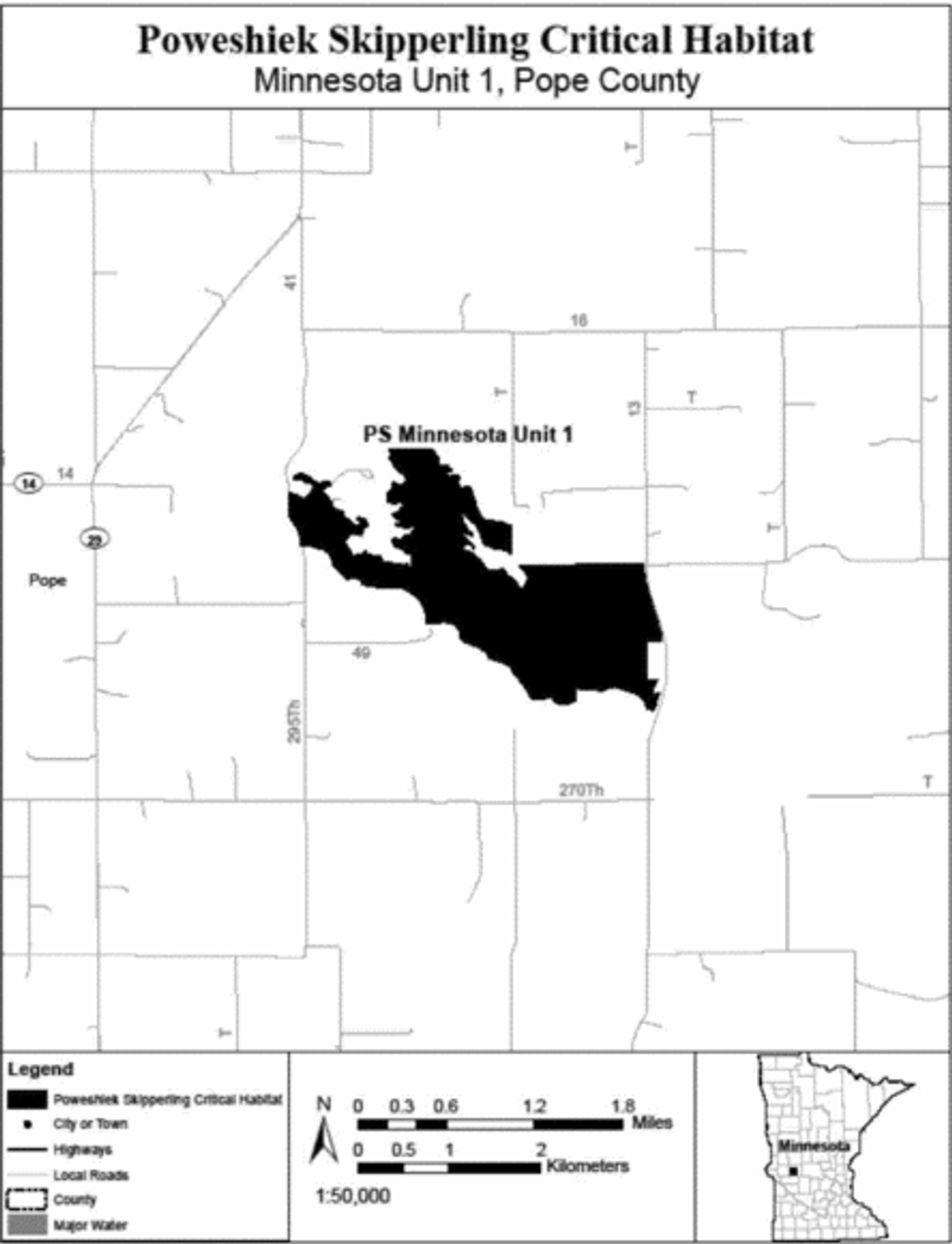
(24) PS Minnesota Units 2 and 3, Murray County, Minnesota. Map of PS Minnesota Units 2 and 3 follows:
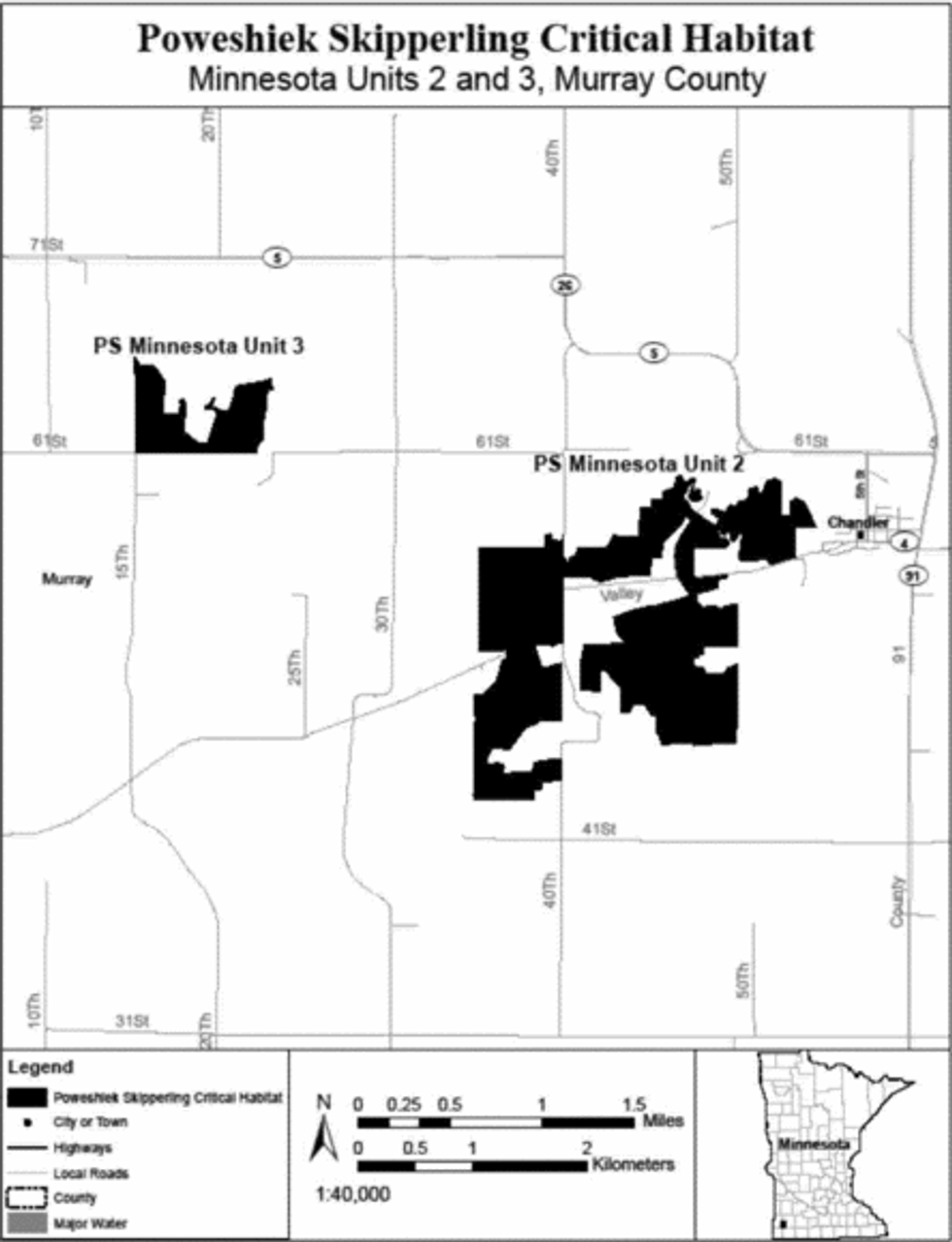
(25) PS Minnesota Units 4 and 18, Clay County, Minnesota. Map of PS Minnesota Units 4 and 18 follows:
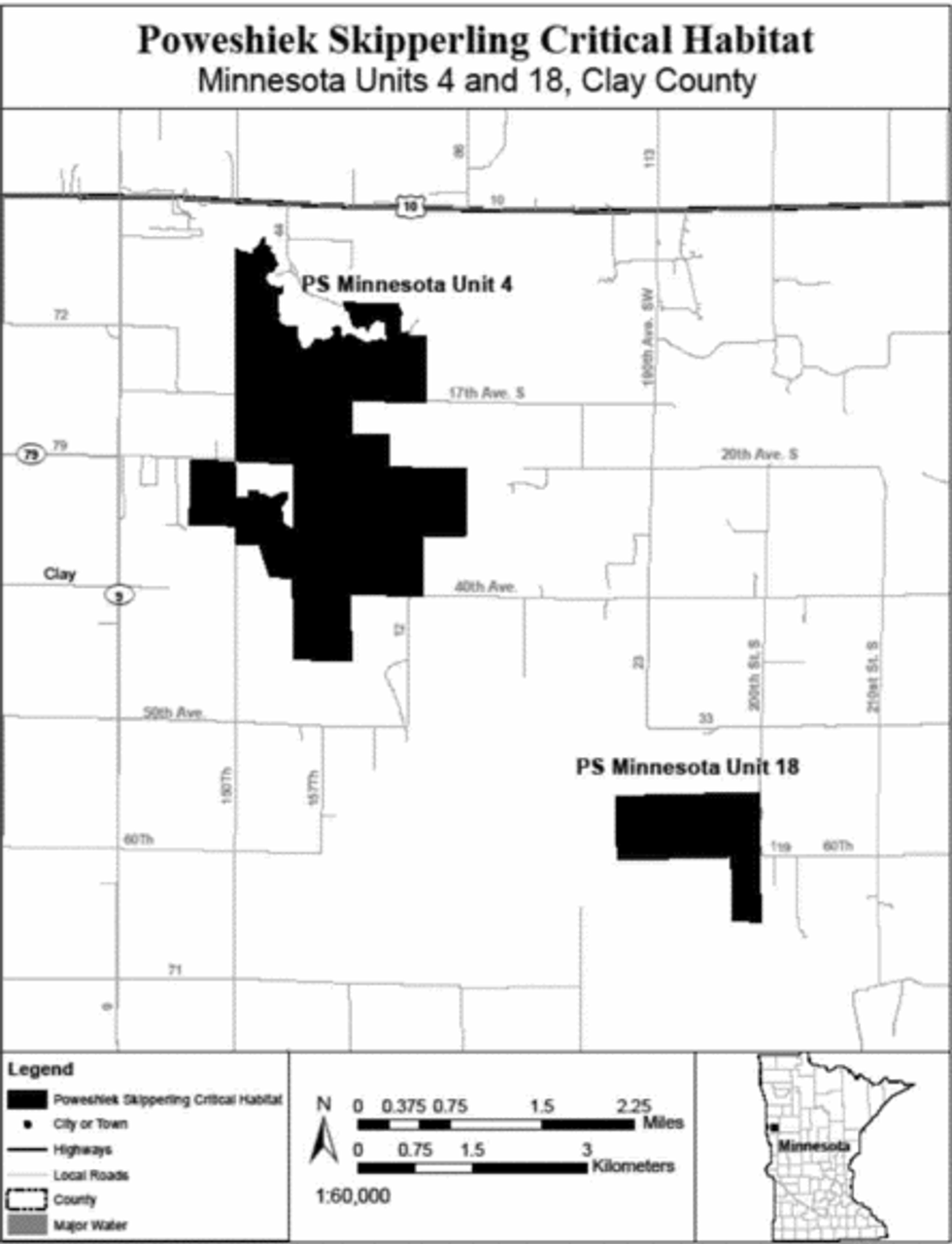
(26) PS Minnesota Unit 5, Clay County, Minnesota. Map of PS Minnesota Unit 5 follows:
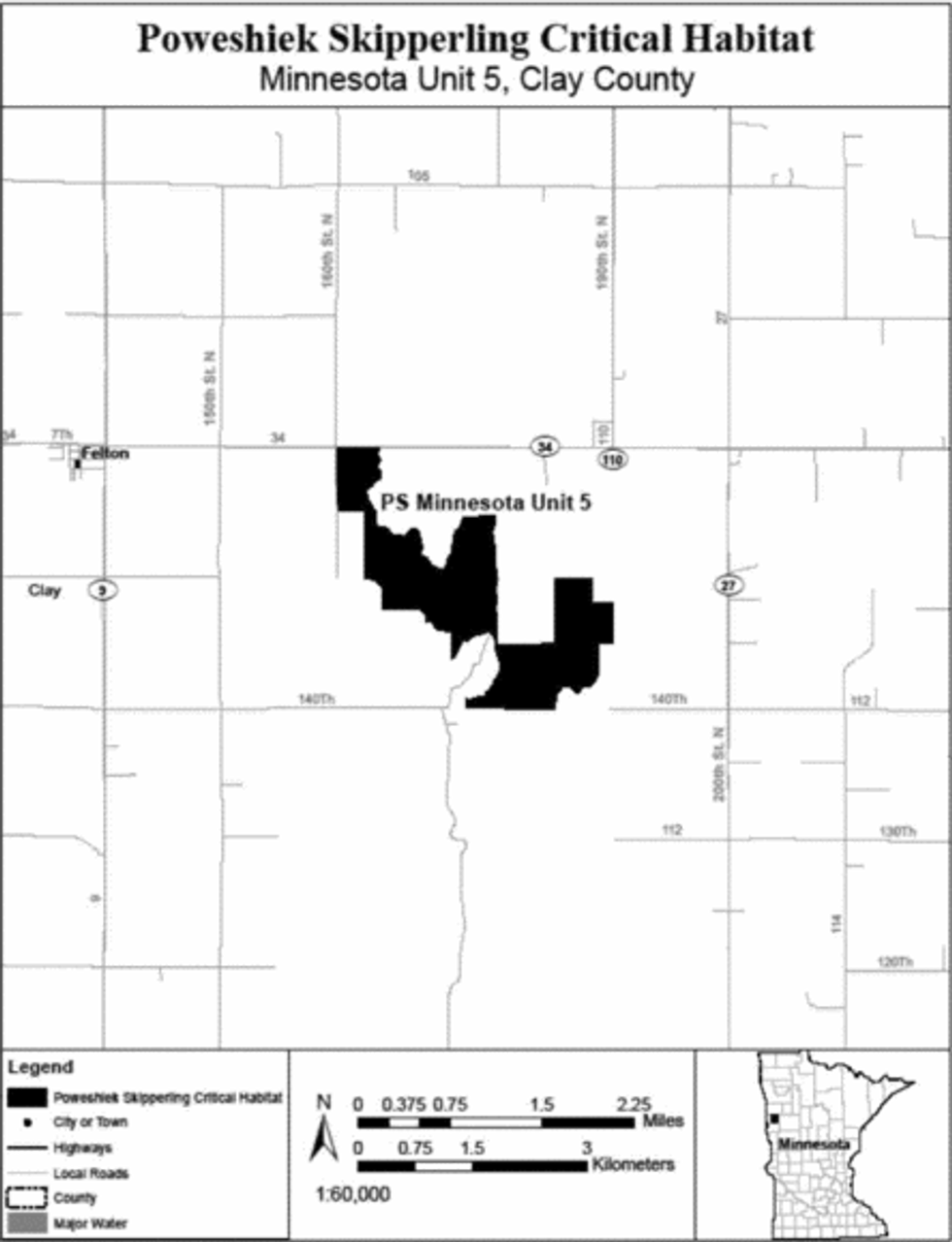
(27) PS Minnesota Unit 6, Norman County, Minnesota. Map of PS Minnesota Unit 6 follows:
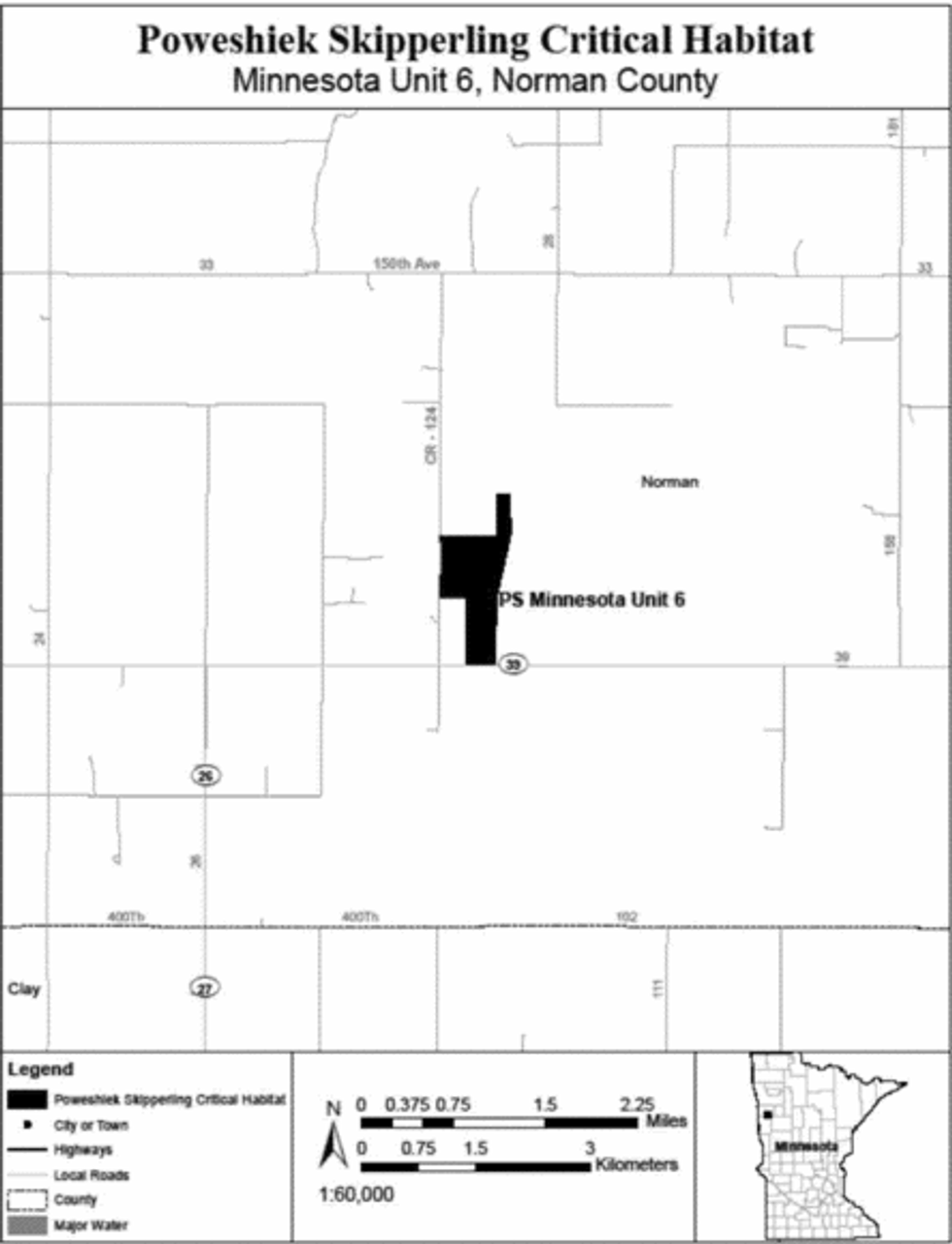
(28) PS Minnesota Unit 7, Lincoln and Pipestone Counties, Minnesota. Map of PS Minnesota Unit 7 follows:
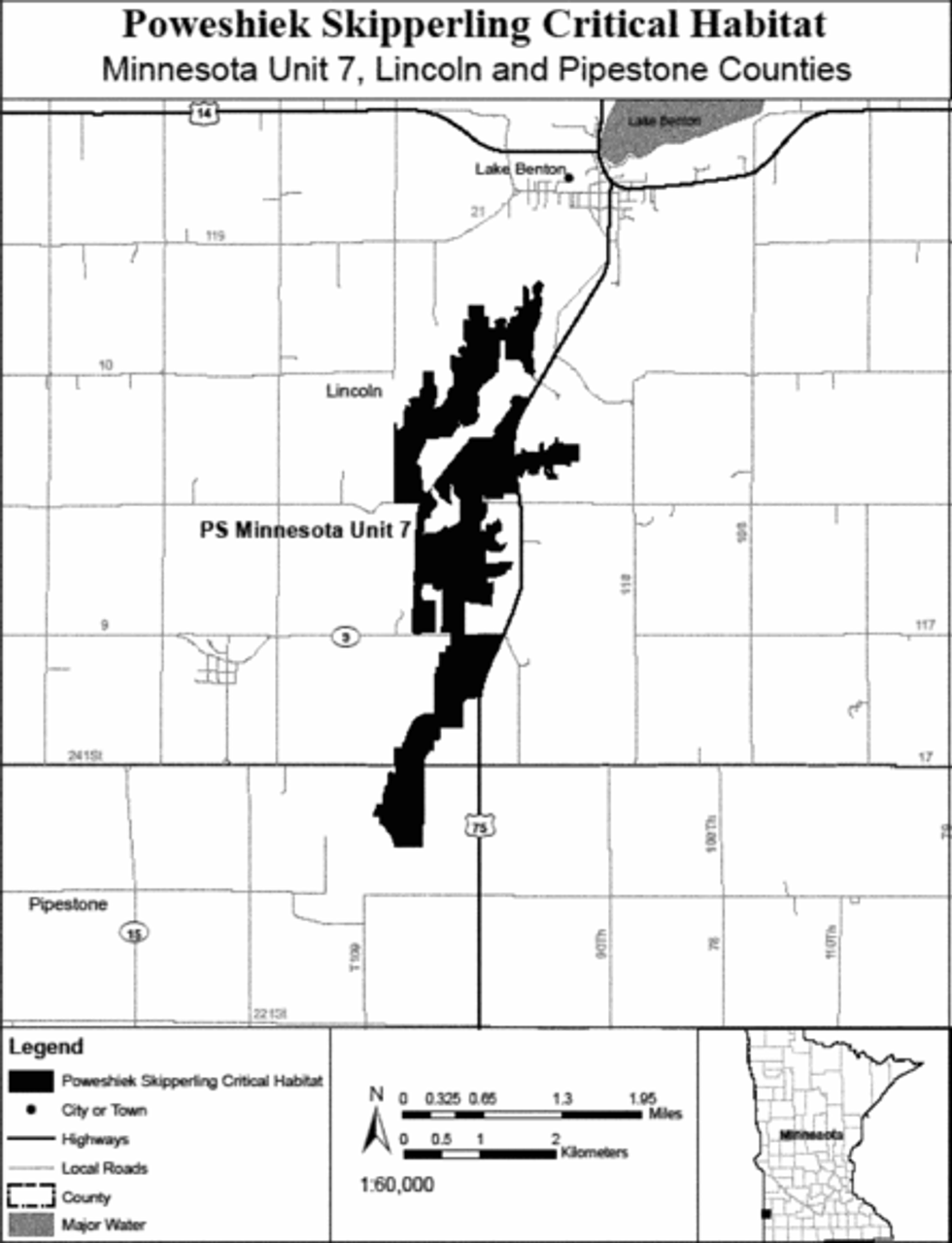
(29) PS Minnesota Units 8 and 9, Pipestone County, Minnesota. Map of PS Minnesota Units 8 and 9 follows:
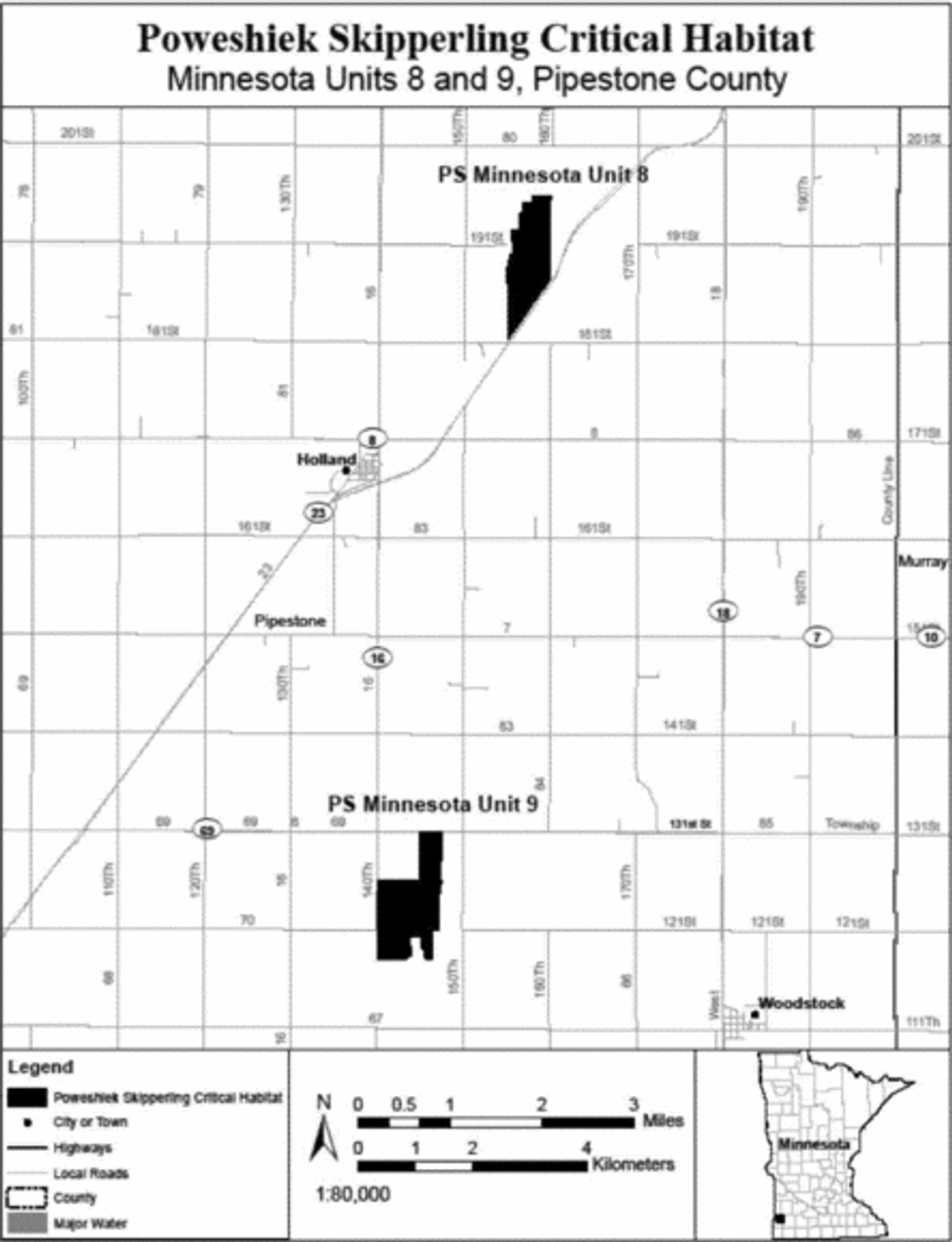
(30) PS Minnesota Unit 10, Swift and Chippewa Counties, Minnesota. Map of PS Minnesota Unit 10 follows:
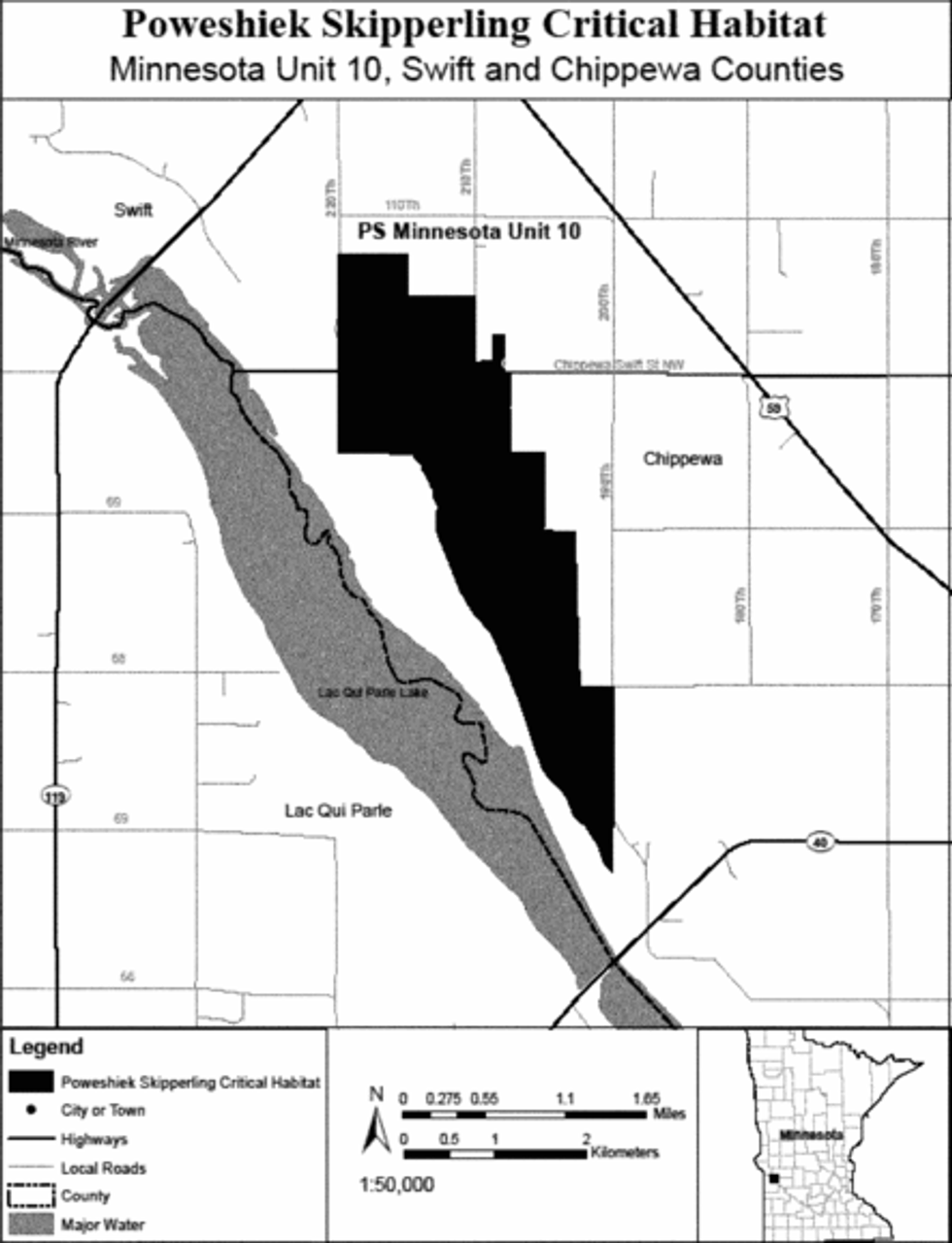
(31) PS Minnesota Unit 11, Wilkin County, Minnesota. Map of PS Minnesota Unit 11 follows:
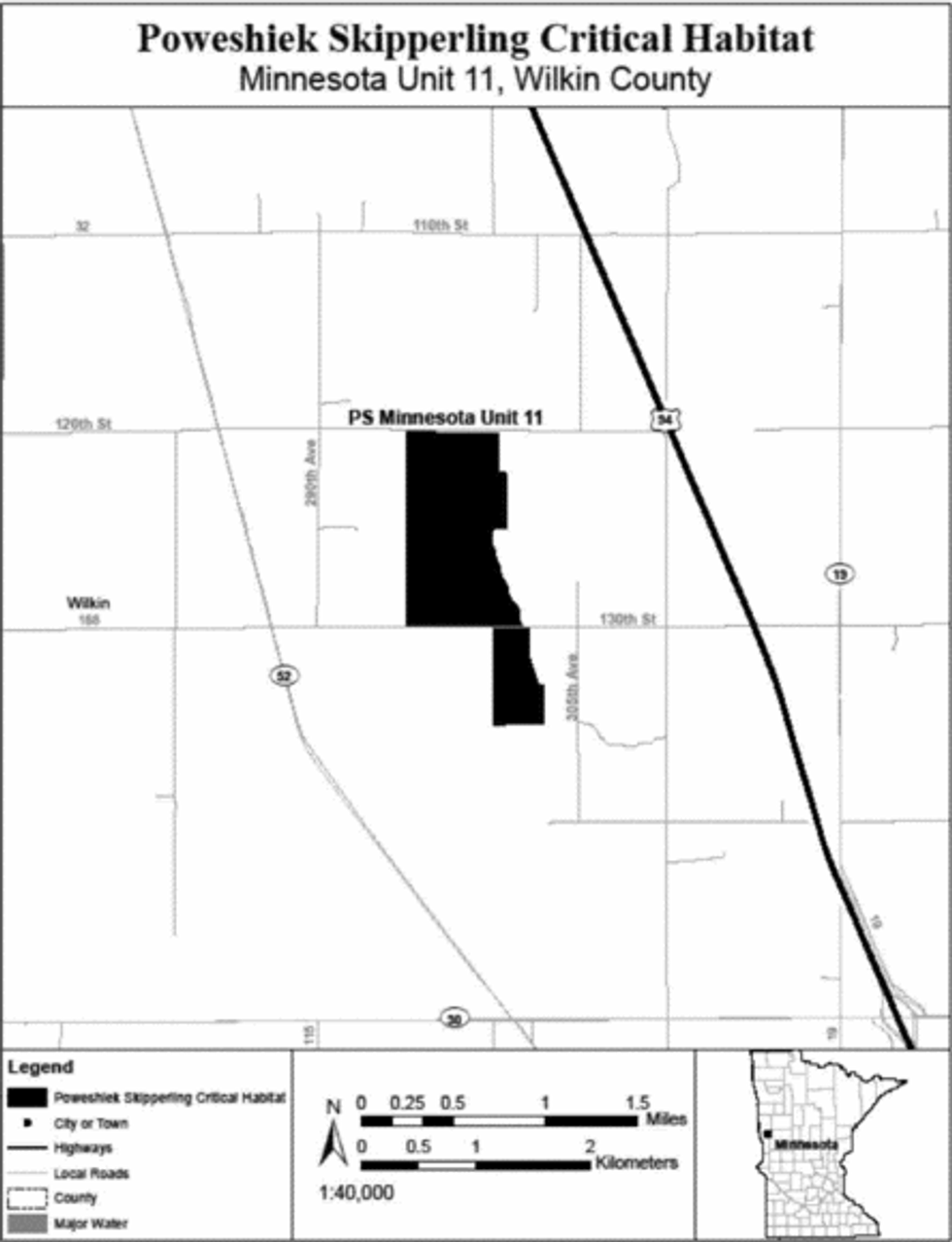
(32) PS Minnesota Unit 12, Lyon County, Minnesota. Map of PS Minnesota Unit 12 follows:
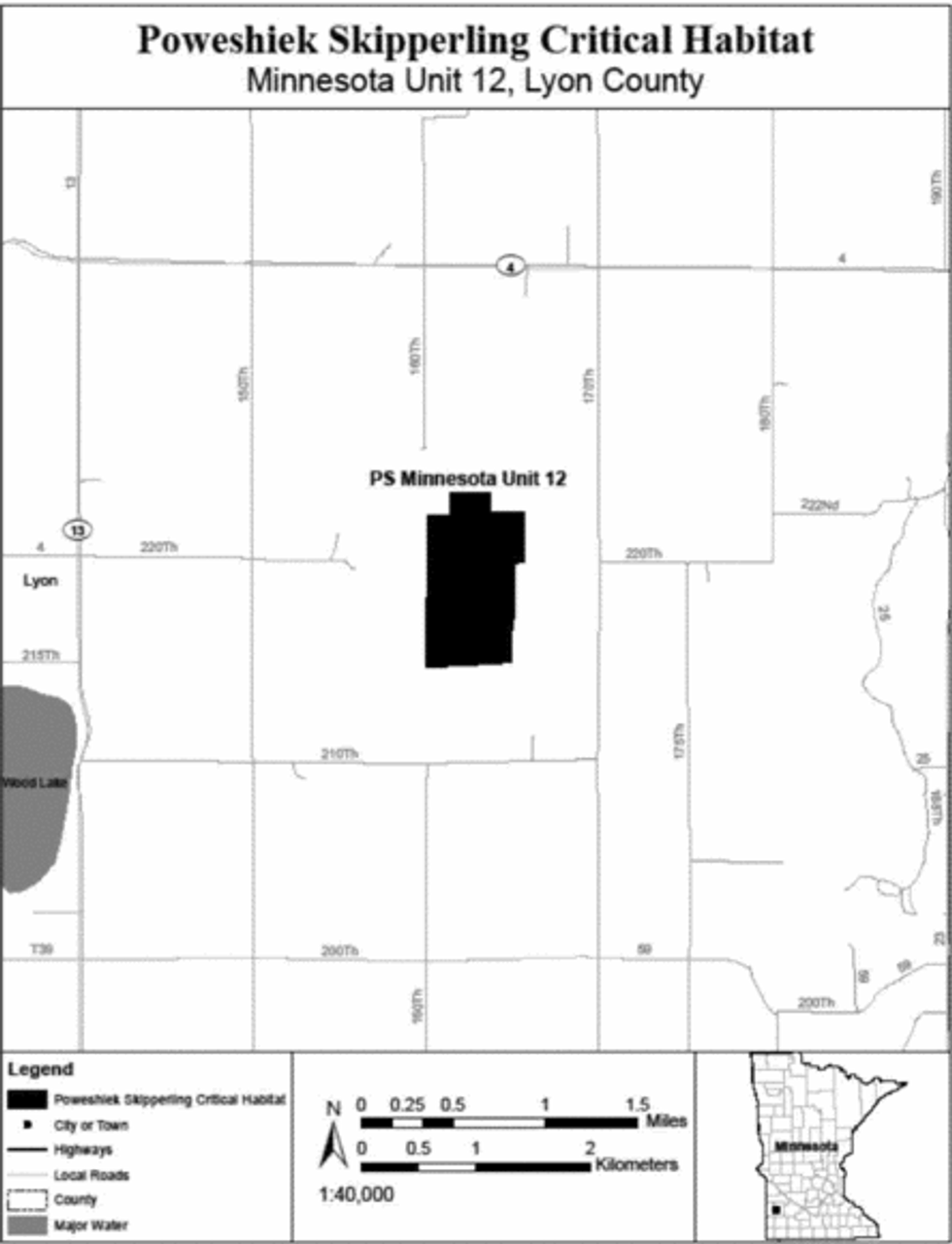
(33) PS Minnesota Unit 13, Lac Qui Parle County, Minnesota. Map of PS Minnesota Unit 13 follows:
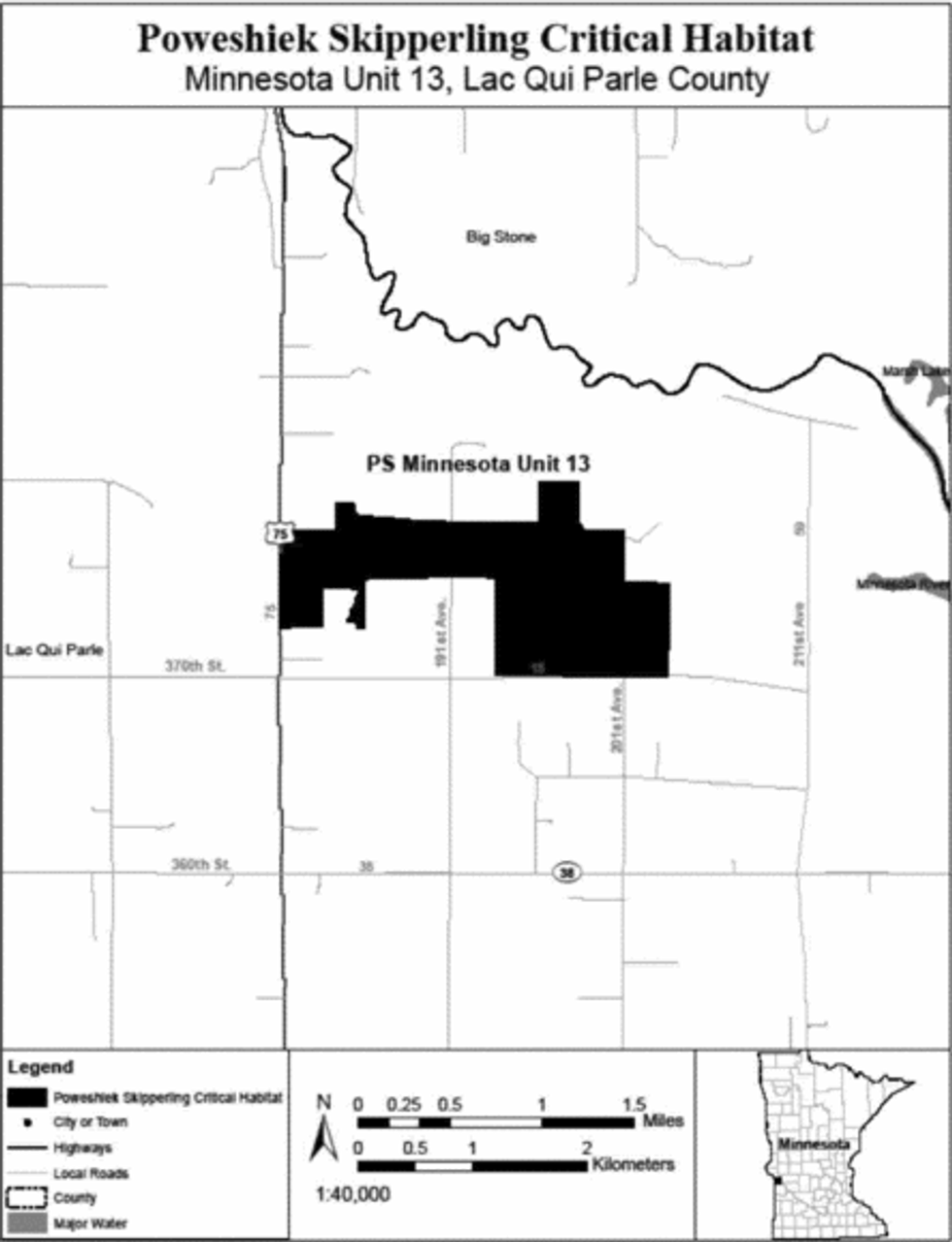
(34) PS Minnesota Unit 14, Douglas County, Minnesota. Map of PS Minnesota Unit 14 follows:
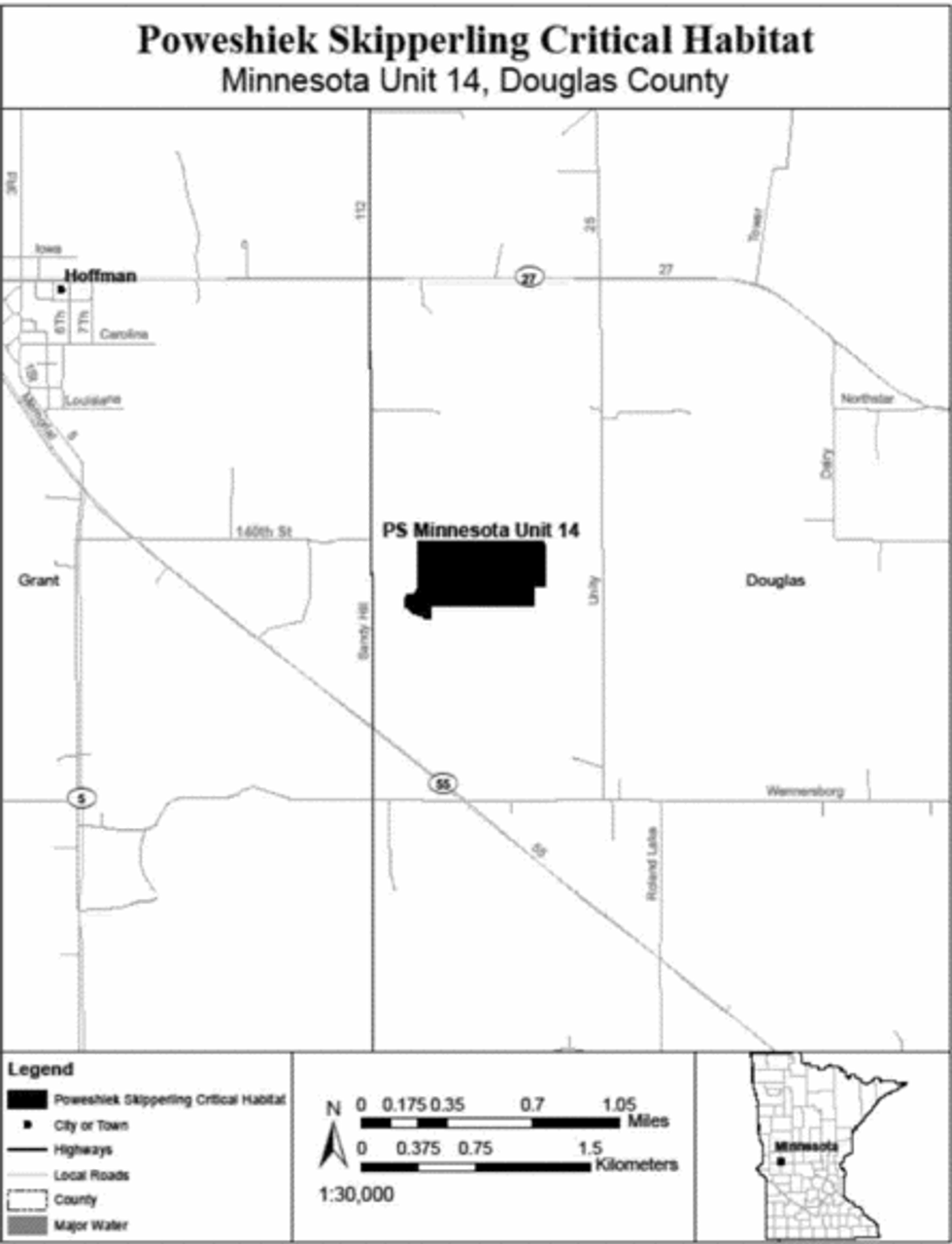
(35) PS Minnesota Unit 15, Mahnomen County, Minnesota. Map of PS Minnesota Unit 15 follows:
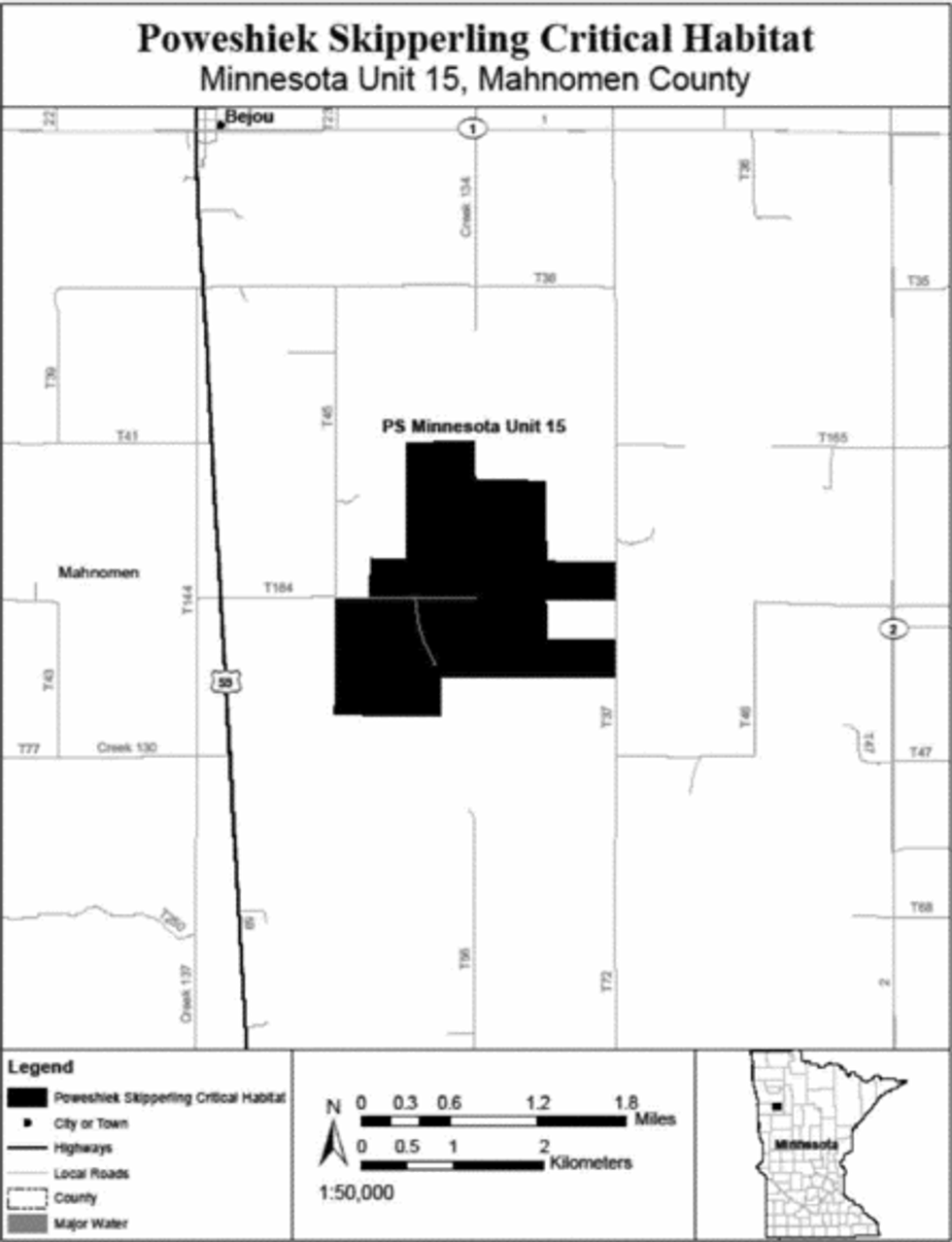
(36) PS Minnesota Unit 16, Cottonwood County, Minnesota. Map of PS Minnesota Unit 16 follows:
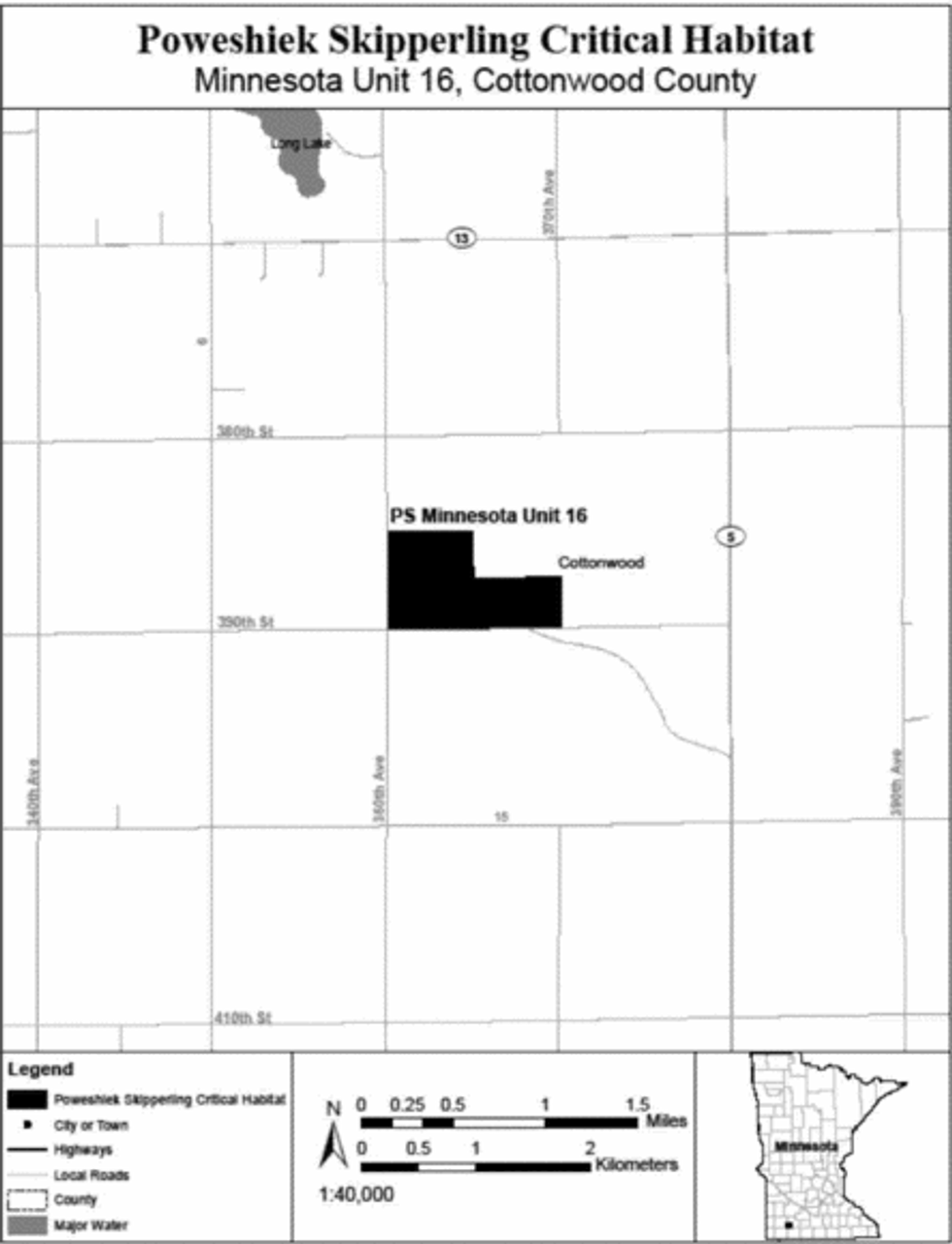
(37) PS Minnesota Unit 17, Pope County, Minnesota. Map of PS Minnesota Unit 17 follows:
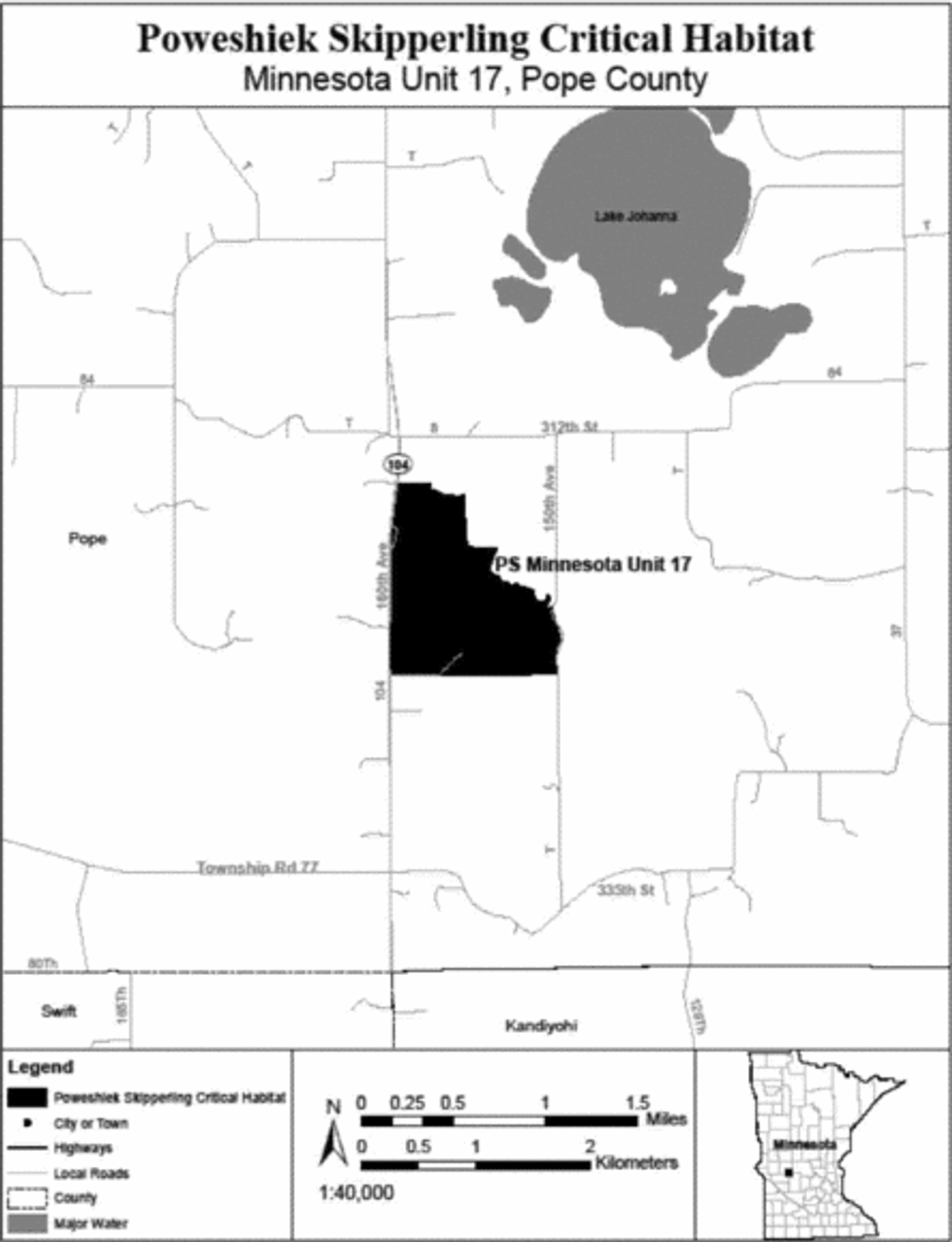
(38) PS Minnesota Unit 19, Kittson County, Minnesota. Map of PS Minnesota Unit 19 follows:
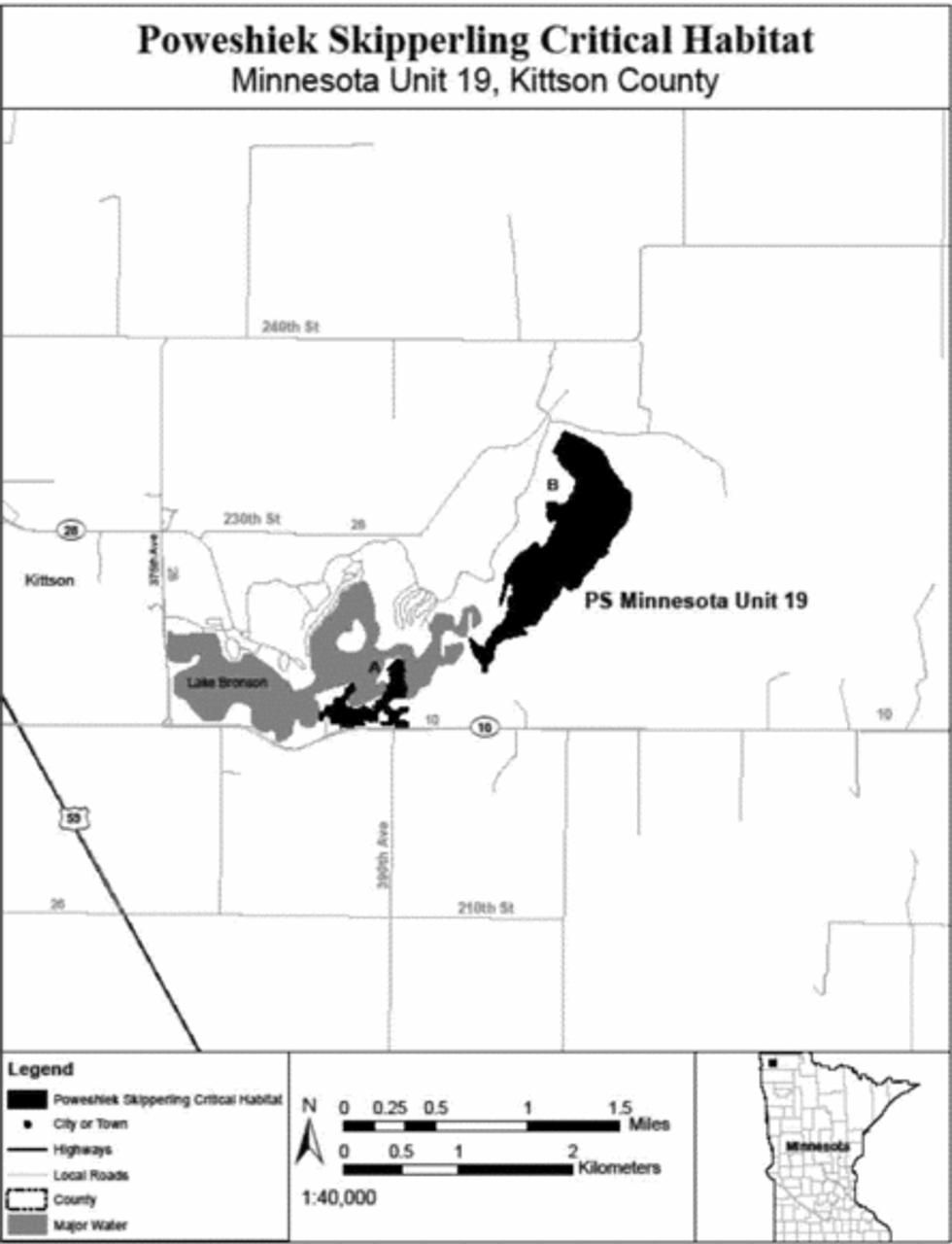
(39) PS Minnesota Unit 20, Polk County, Minnesota. Map of PS Minnesota Unit 20 follows:
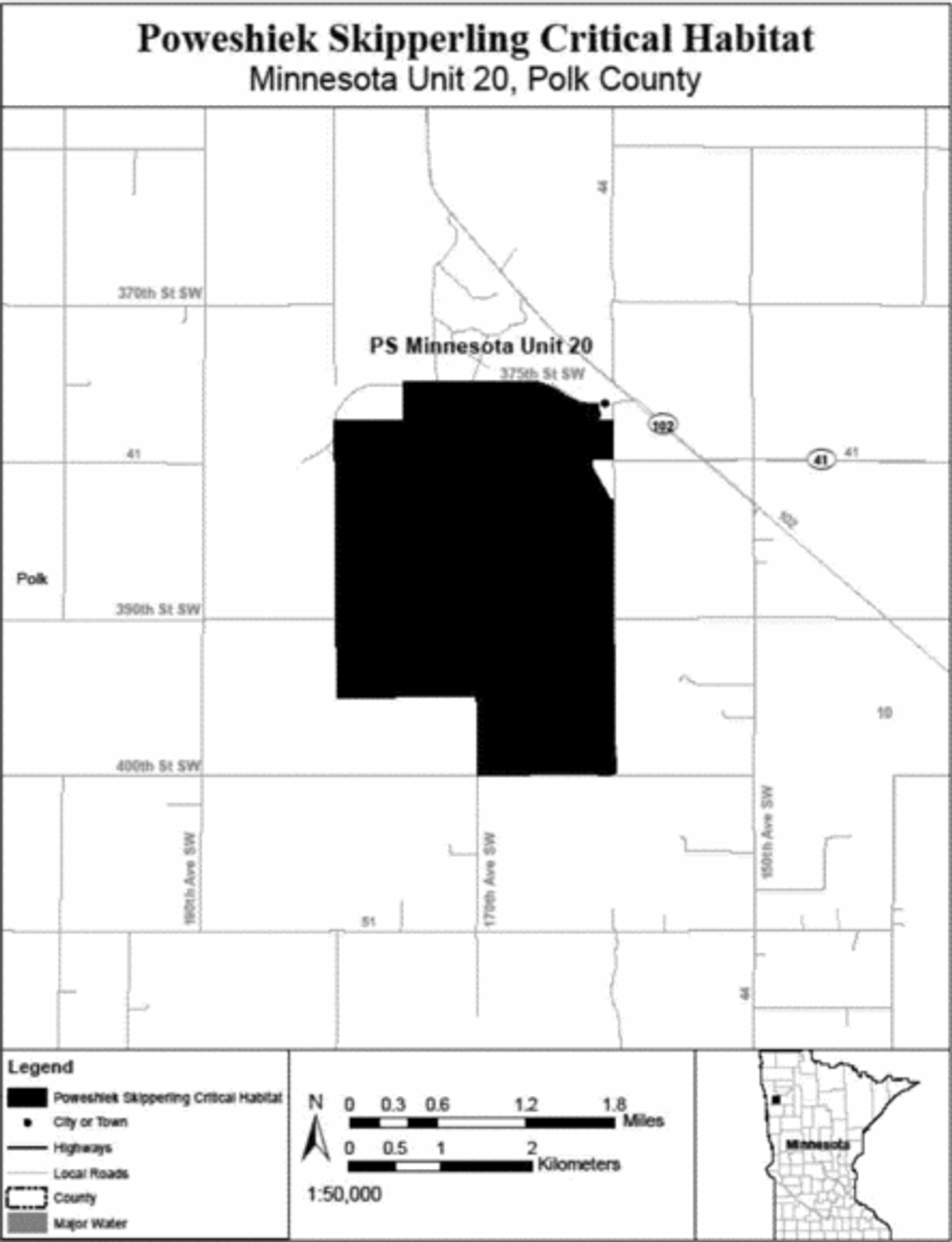
(40) PS North Dakota Units 1 and 2, Richland County, North Dakota. Map of PS North Dakota Units 1 and 2 follows:
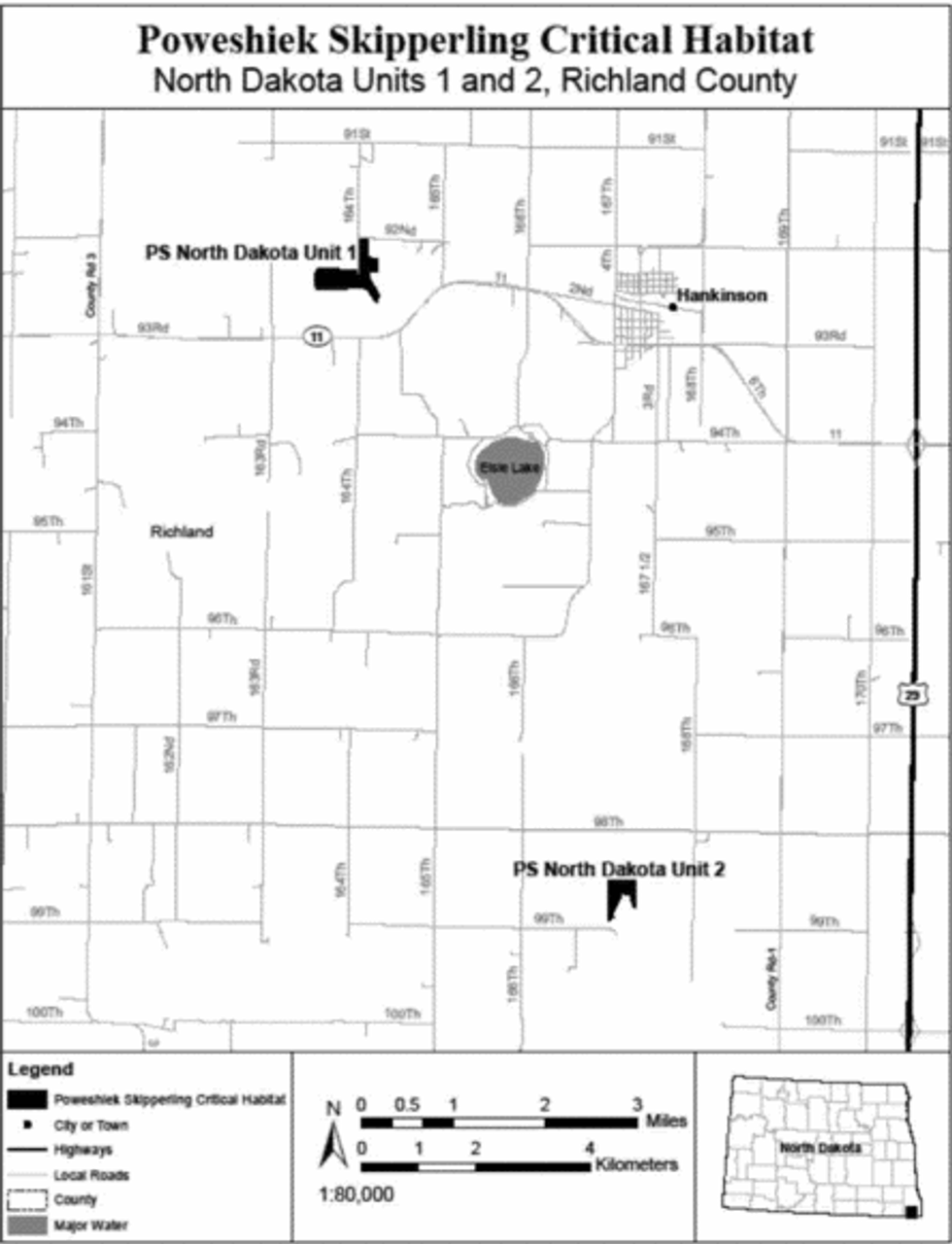
(41) PS South Dakota Unit 1, Marshall County, South Dakota. Map of PS South Dakota Unit 1 follows:
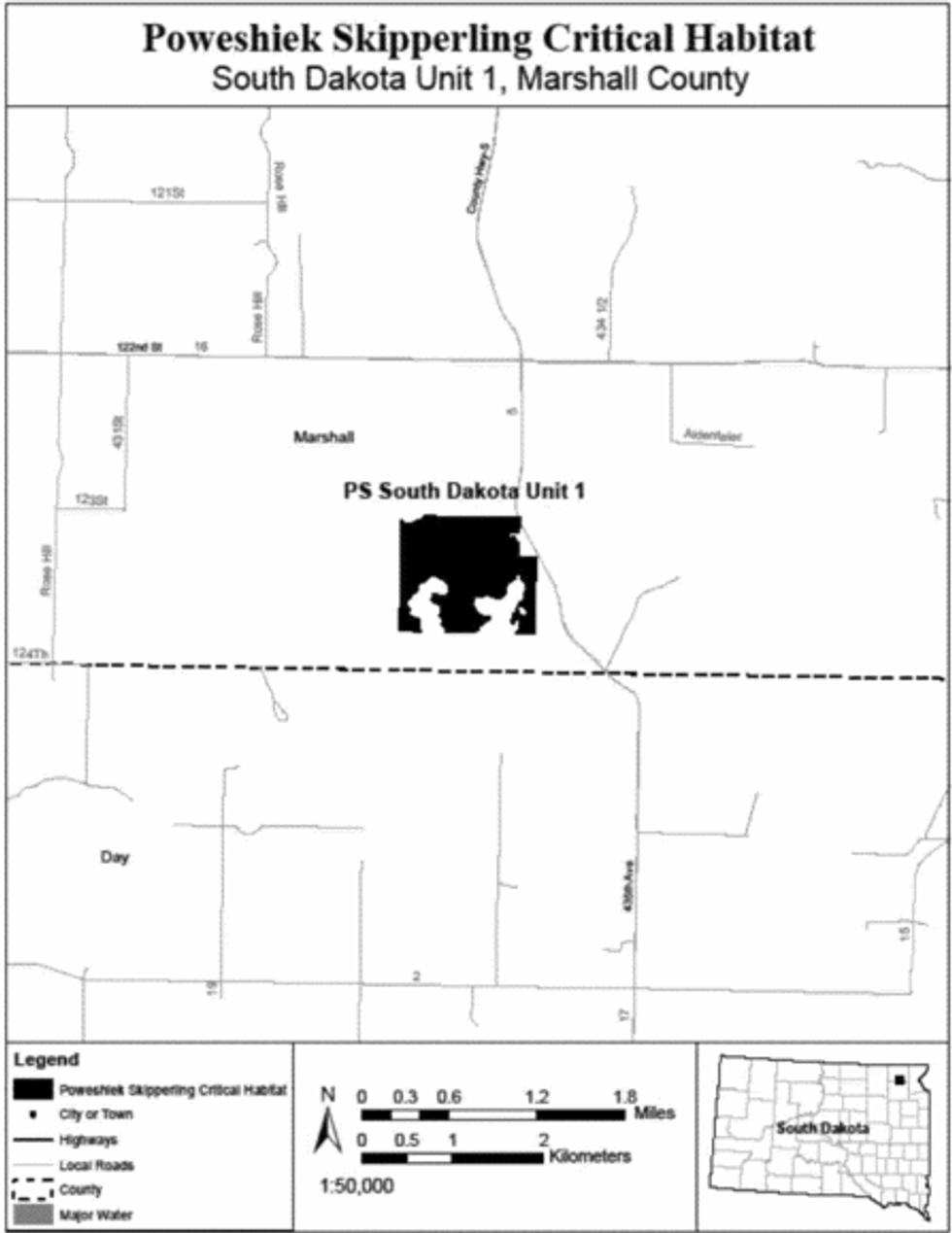
(42) PS South Dakota Unit 2, Brookings County, South Dakota. Map of PS South Dakota Unit 2 follows:
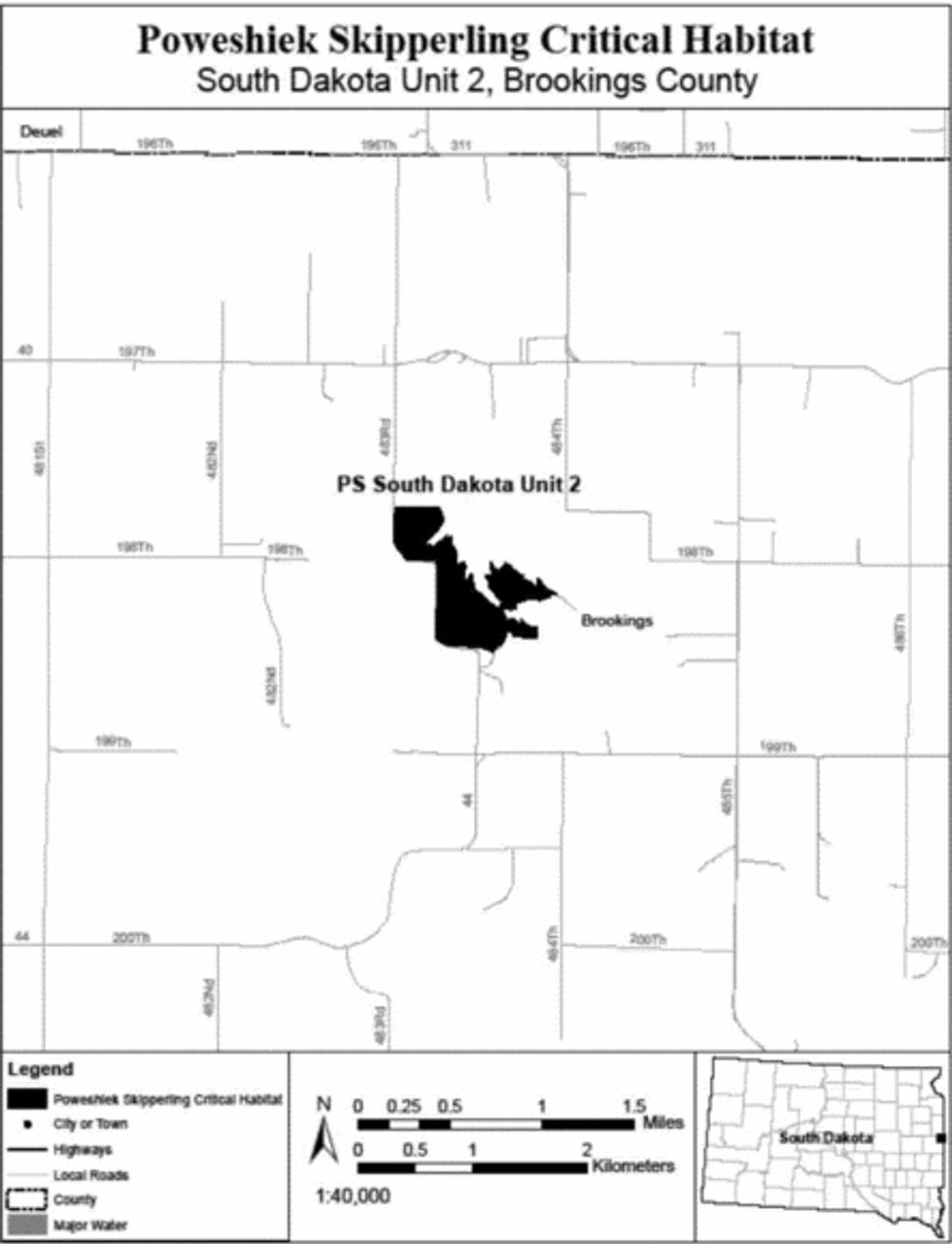
(43) PS South Dakota Units 3 and 5, Deuel County, South Dakota. Map of PS South Dakota Units 3 and 5 follows:
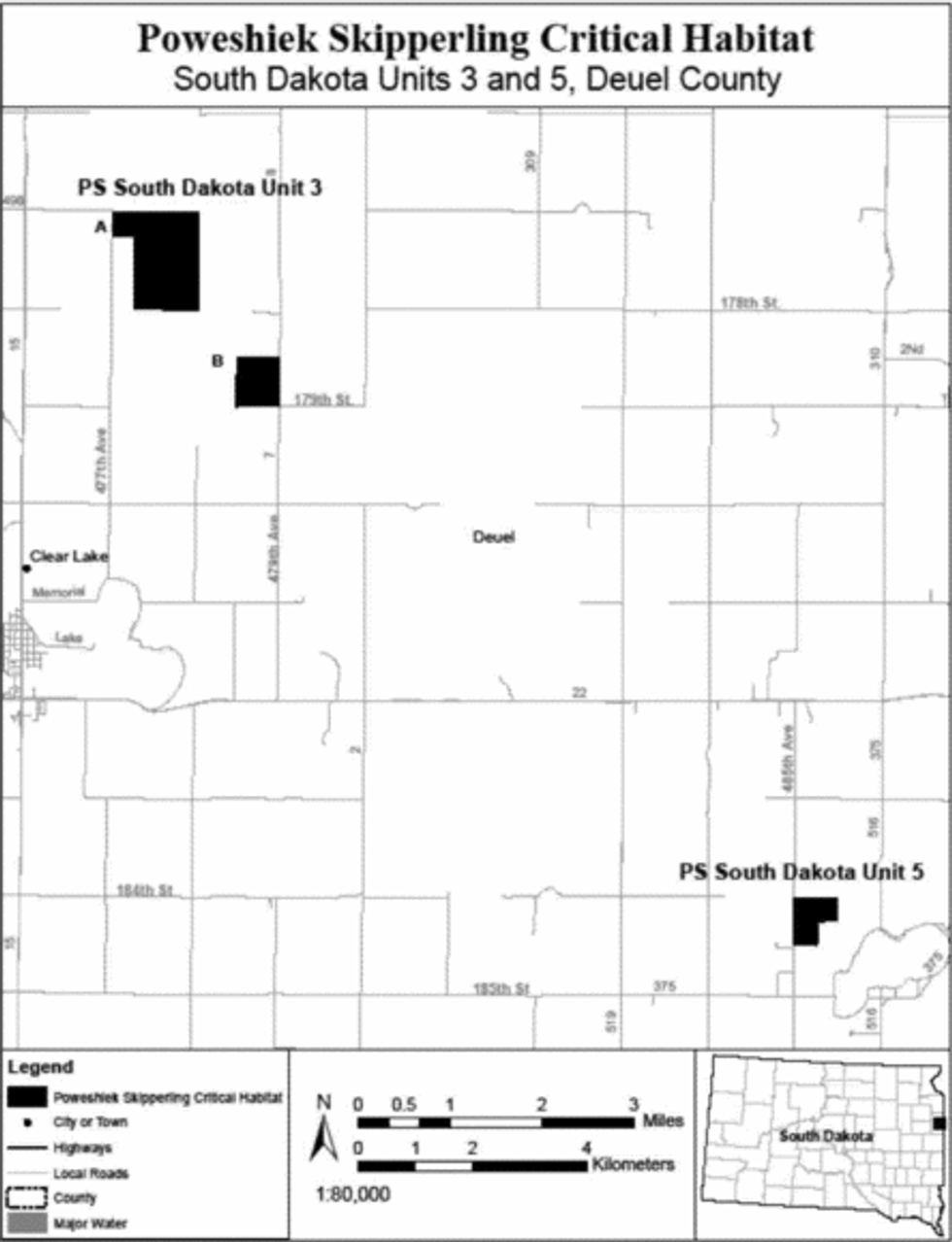
(44) PS South Dakota Unit 4, Grant County, South Dakota. Map of PS South Dakota Unit 4 follows:
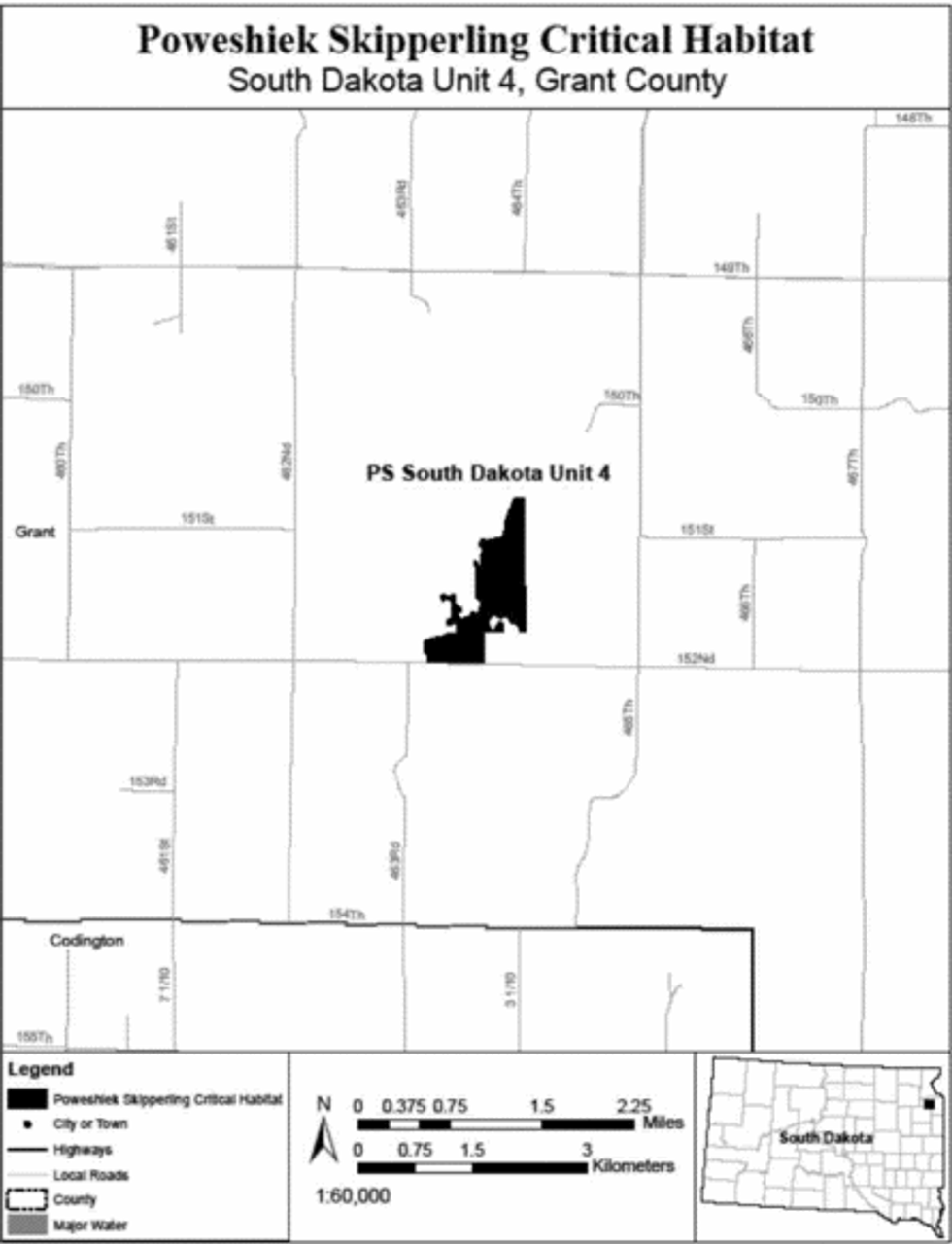
(45) PS South Dakota Unit 6, Roberts County, South Dakota. Map of PS South Dakota Unit 6 follows:
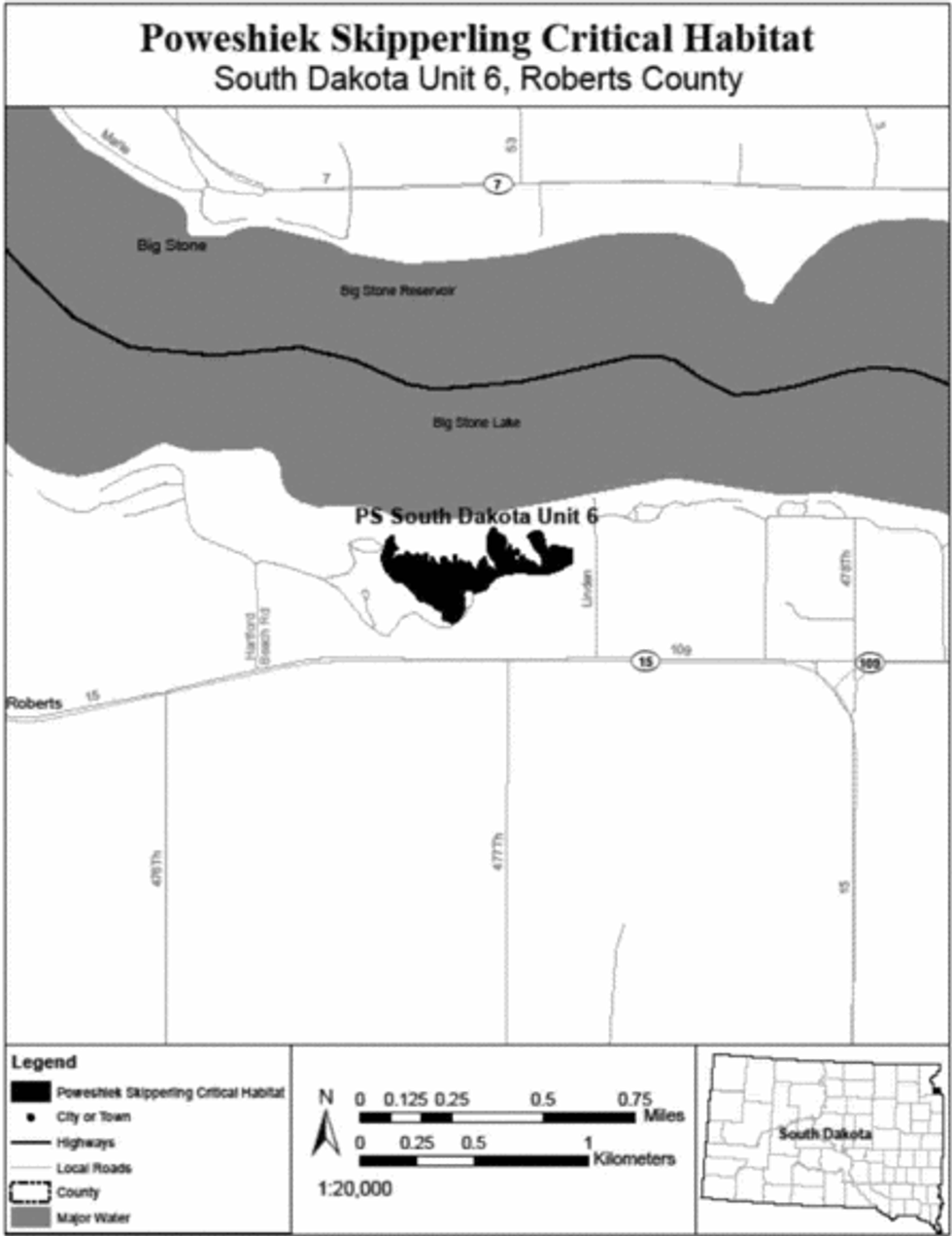
(46) PS South Dakota Unit 7, Roberts County, South Dakota. Map of PS South Dakota Unit 7 follows:
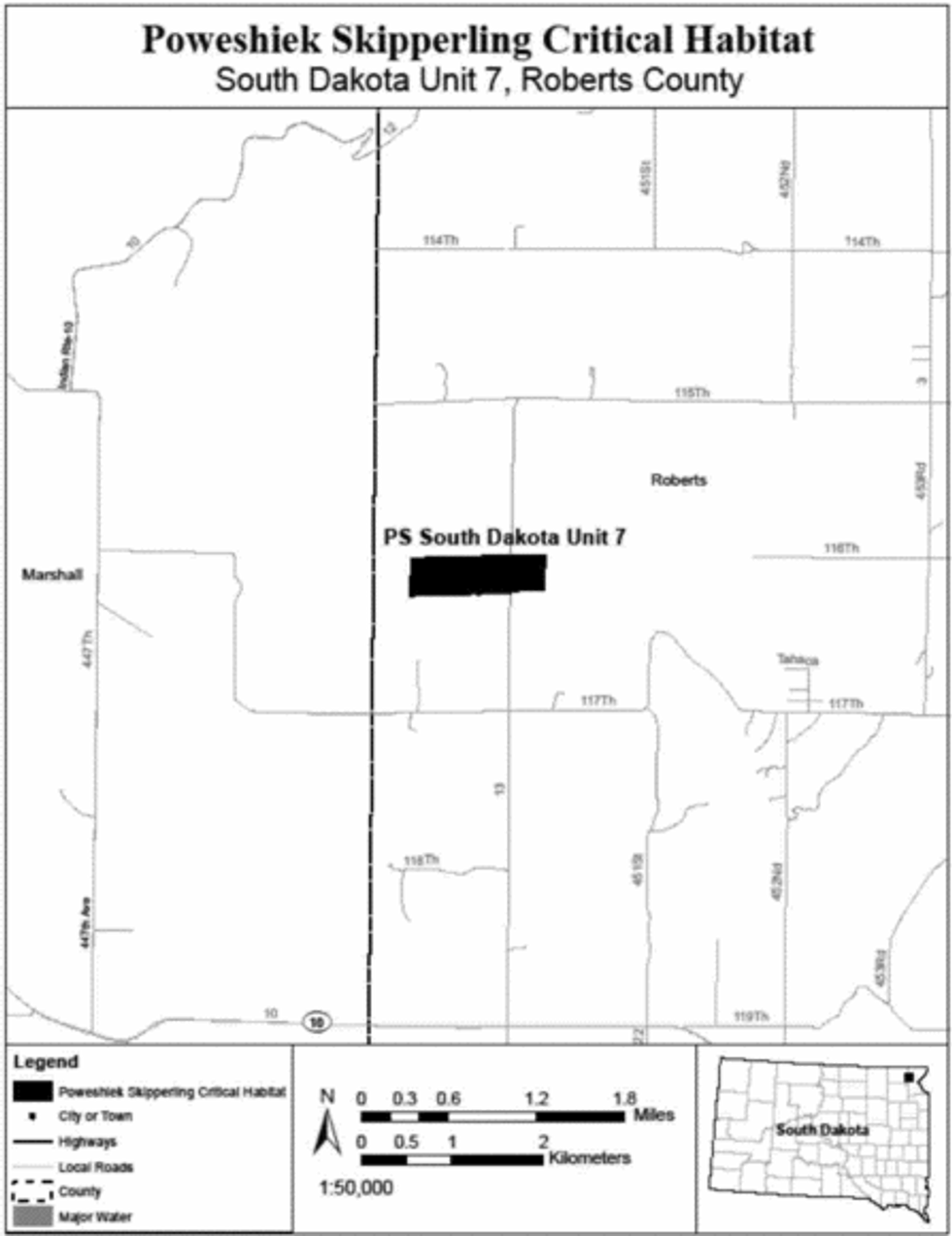
(47) PS South Dakota Unit 8, Roberts County, South Dakota. Map of PS South Dakota Unit 8 follows:
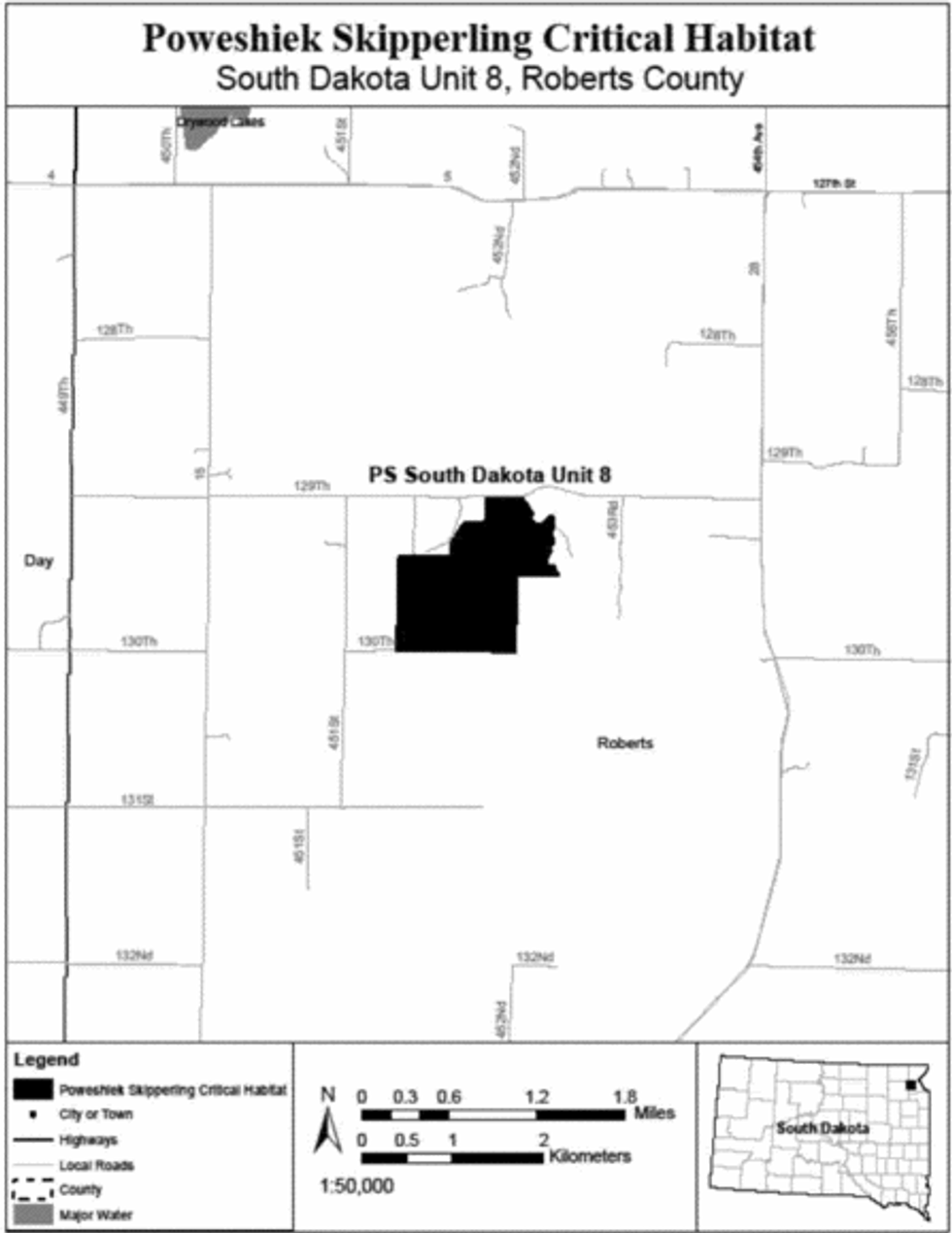
(48) PS South Dakota Units 15 and 16, Day County, South Dakota. Map of PS South Dakota Units 15 and 16 follows:

(49) PS South Dakota Unit 17, Moody County, South Dakota. Map of PS South Dakota Unit 17 follows:
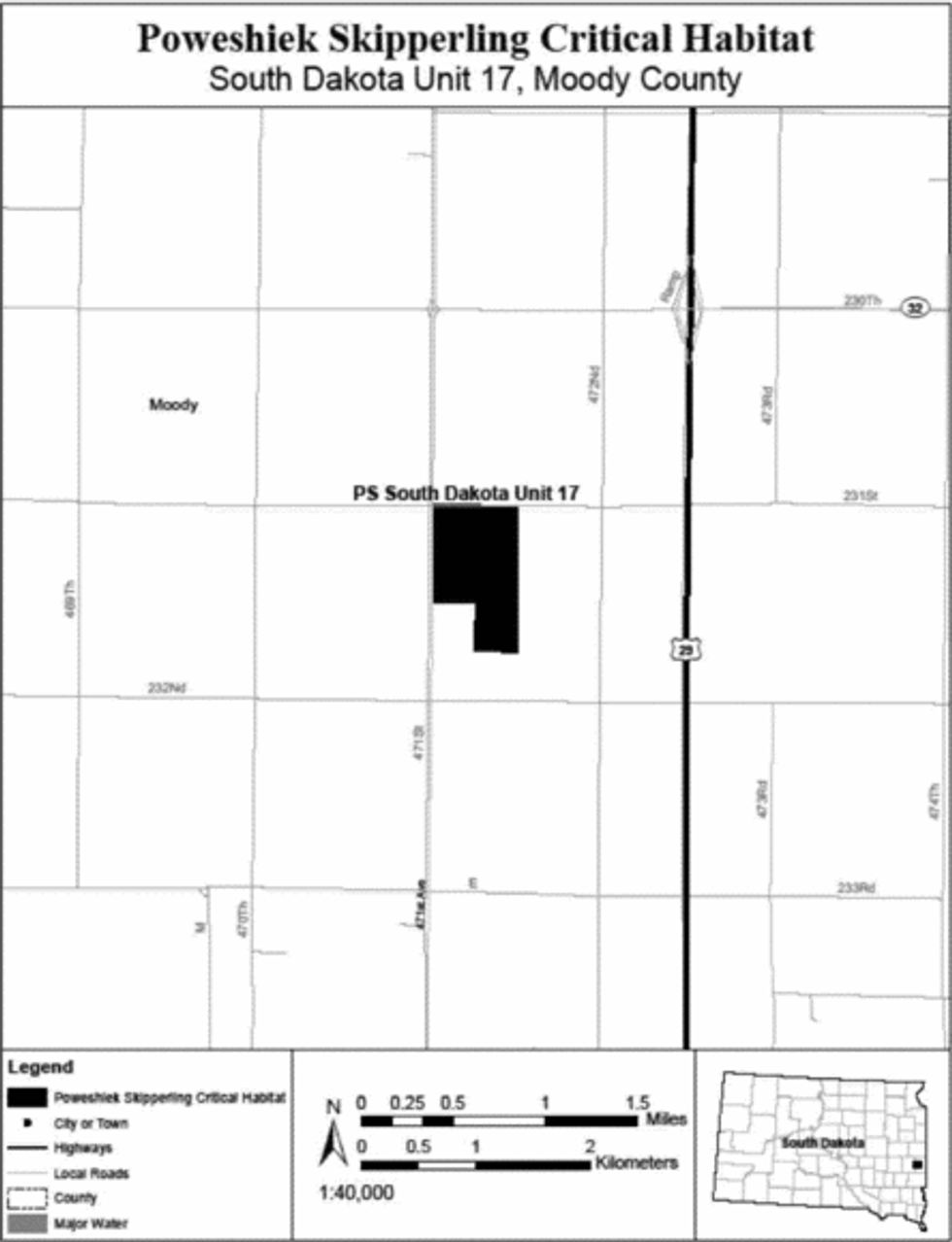
(50) PS South Dakota Unit 18, Marshall County, South Dakota. Map of PS South Dakota Unit 18 follows:
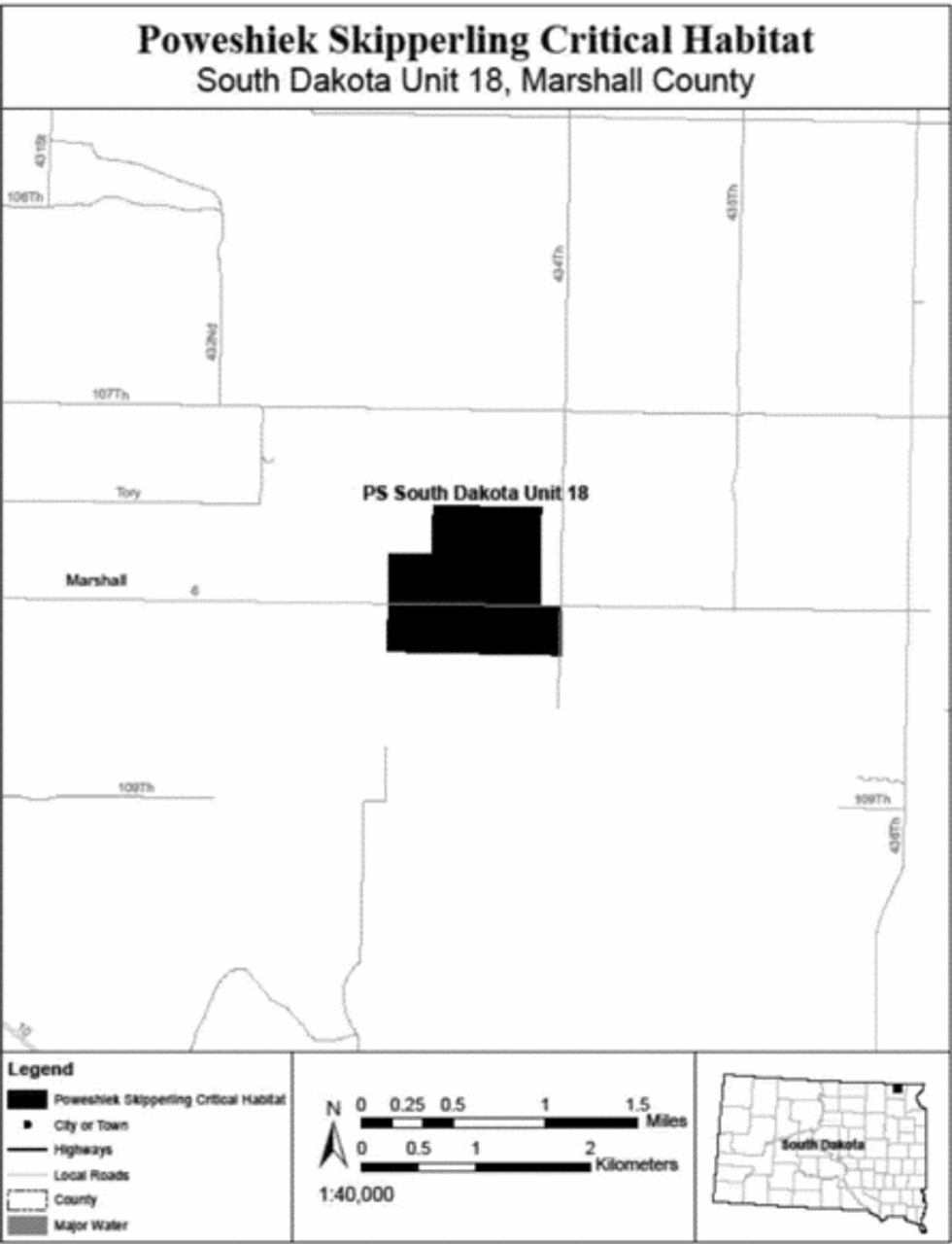
(51) PS Wisconsin Unit 1, Waukesha County, Wisconsin. Map of PS Wisconsin Unit 1 follows:
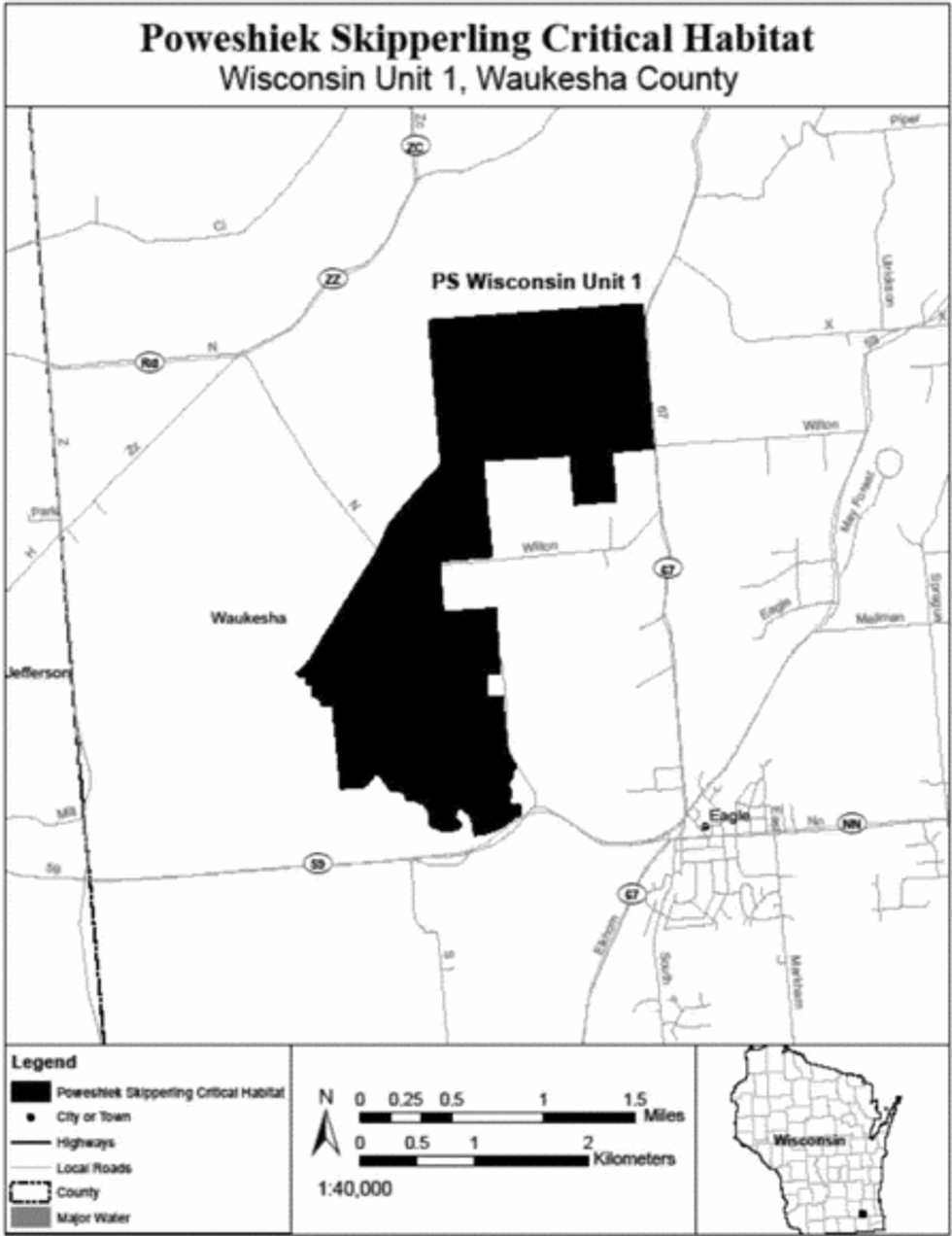
(52) PS Wisconsin Unit 2, Green Lake County, Wisconsin. Map of PS Wisconsin Unit 2 follows:
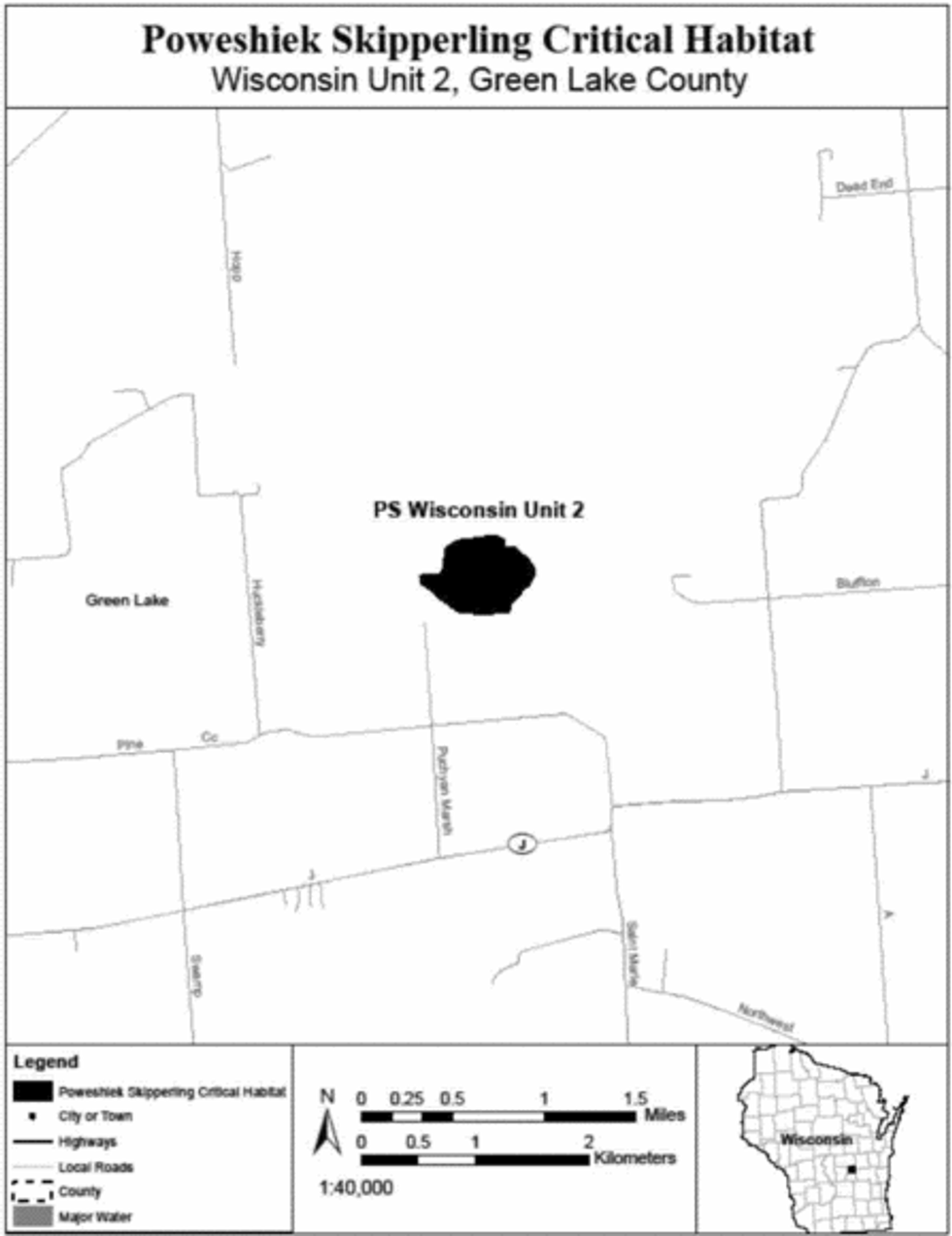
Editorial Note:For Federal Register citations affecting §17.95, see the List of CFR Sections Affected, which appears in the Finding Aids section of the printed volume and at www.govinfo.gov.
[42 FR 47840, Sept. 22, 1977; 86 FR 50281, Sept. 8, 2021; 86 FR 64035, Nov. 16, 2021; 86 FR 72429, Dec. 21, 2022; 87 FR 577, Jan. 5, 2022; 87 FR 8966, Feb. 17, 2022; 87 FR 14690, March 15, 2022; 87 FR 73678. Dec. 1, 2022; 88 FR 14839, March 9, 2023; 88 FR 25538, April 27, 2023; 88 FR 33221, May 23, 2023; 88 FR 56488, Aug. 18, 2023; 88 FR ]71672, Oct. 17, 2023; 89 FR 17956, March 12, 2024; 89 FR 48100, June 4, 2024]
['Species Protection']
['Endangered Species']
UPGRADE TO CONTINUE READING
Load More
J. J. Keller is the trusted source for DOT / Transportation, OSHA / Workplace Safety, Human Resources, Construction Safety and Hazmat / Hazardous Materials regulation compliance products and services. J. J. Keller helps you increase safety awareness, reduce risk, follow best practices, improve safety training, and stay current with changing regulations.
Copyright 2025 J. J. Keller & Associate, Inc. For re-use options please contact copyright@jjkeller.com or call 800-558-5011.
